
Date: 2019-12-25 21:20:11 CET, cola version: 1.3.2
Document is loading... 
All available functions which can be applied to this res_list object:
res_list
#> A 'ConsensusPartitionList' object with 24 methods.
#> On a matrix with 21163 rows and 169 columns.
#> Top rows are extracted by 'SD, CV, MAD, ATC' methods.
#> Subgroups are detected by 'hclust, kmeans, skmeans, pam, mclust, NMF' method.
#> Number of partitions are tried for k = 2, 3, 4, 5, 6.
#> Performed in total 30000 partitions by row resampling.
#>
#> Following methods can be applied to this 'ConsensusPartitionList' object:
#> [1] "cola_report" "collect_classes" "collect_plots" "collect_stats"
#> [5] "colnames" "functional_enrichment" "get_anno_col" "get_anno"
#> [9] "get_classes" "get_matrix" "get_membership" "get_stats"
#> [13] "is_best_k" "is_stable_k" "ncol" "nrow"
#> [17] "rownames" "show" "suggest_best_k" "test_to_known_factors"
#> [21] "top_rows_heatmap" "top_rows_overlap"
#>
#> You can get result for a single method by, e.g. object["SD", "hclust"] or object["SD:hclust"]
#> or a subset of methods by object[c("SD", "CV")], c("hclust", "kmeans")]
The call of run_all_consensus_partition_methods() was:
#> run_all_consensus_partition_methods(data = mat, mc.cores = 4, anno = anno)
Dimension of the input matrix:
mat = get_matrix(res_list)
dim(mat)
#> [1] 21163 169
The density distribution for each sample is visualized as in one column in the following heatmap. The clustering is based on the distance which is the Kolmogorov-Smirnov statistic between two distributions.
library(ComplexHeatmap)
densityHeatmap(mat, top_annotation = HeatmapAnnotation(df = get_anno(res_list),
col = get_anno_col(res_list)), ylab = "value", cluster_columns = TRUE, show_column_names = FALSE,
mc.cores = 4)
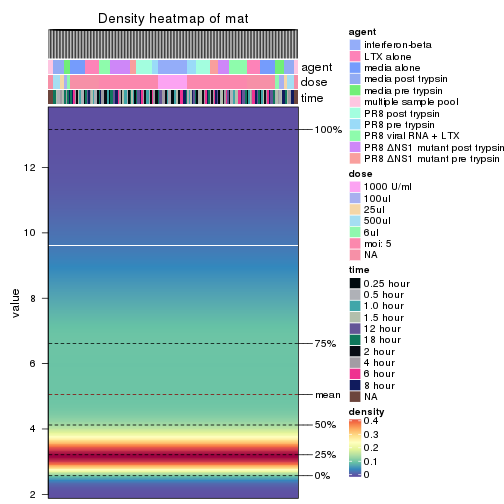
Folowing table shows the best k (number of partitions) for each combination
of top-value methods and partition methods. Clicking on the method name in
the table goes to the section for a single combination of methods.
The cola vignette explains the definition of the metrics used for determining the best number of partitions.
suggest_best_k(res_list)
| The best k | 1-PAC | Mean silhouette | Concordance | Optional k | ||
|---|---|---|---|---|---|---|
| SD:NMF | 2 | 1.000 | 0.969 | 0.988 | ** | |
| MAD:kmeans | 2 | 1.000 | 0.996 | 0.998 | ** | |
| ATC:kmeans | 2 | 1.000 | 1.000 | 1.000 | ** | |
| ATC:pam | 2 | 1.000 | 0.997 | 0.998 | ** | |
| ATC:mclust | 3 | 1.000 | 0.973 | 0.986 | ** | 2 |
| ATC:skmeans | 4 | 0.964 | 0.934 | 0.963 | ** | 2,3 |
| MAD:NMF | 3 | 0.958 | 0.947 | 0.977 | ** | 2 |
| MAD:skmeans | 6 | 0.955 | 0.912 | 0.920 | ** | 2,3,4,5 |
| ATC:NMF | 3 | 0.953 | 0.936 | 0.971 | ** | 2 |
| SD:skmeans | 6 | 0.949 | 0.882 | 0.898 | * | 2,5 |
| CV:skmeans | 6 | 0.941 | 0.916 | 0.924 | * | 2,5 |
| SD:pam | 5 | 0.928 | 0.887 | 0.953 | * | 2,4 |
| CV:NMF | 3 | 0.921 | 0.916 | 0.965 | * | 2 |
| MAD:pam | 5 | 0.919 | 0.846 | 0.938 | * | 2 |
| CV:pam | 5 | 0.918 | 0.899 | 0.955 | * | 2,3,4 |
| MAD:hclust | 3 | 0.910 | 0.887 | 0.961 | * | 2 |
| ATC:hclust | 6 | 0.900 | 0.879 | 0.912 | * | 2,3,4 |
| MAD:mclust | 2 | 0.896 | 0.966 | 0.984 | ||
| SD:hclust | 5 | 0.764 | 0.837 | 0.889 | ||
| CV:mclust | 3 | 0.740 | 0.872 | 0.919 | ||
| CV:hclust | 4 | 0.715 | 0.708 | 0.836 | ||
| SD:mclust | 2 | 0.673 | 0.912 | 0.939 | ||
| SD:kmeans | 2 | 0.548 | 0.947 | 0.939 | ||
| CV:kmeans | 2 | 0.511 | 0.914 | 0.903 |
**: 1-PAC > 0.95, *: 1-PAC > 0.9
Cumulative distribution function curves of consensus matrix for all methods.
collect_plots(res_list, fun = plot_ecdf)
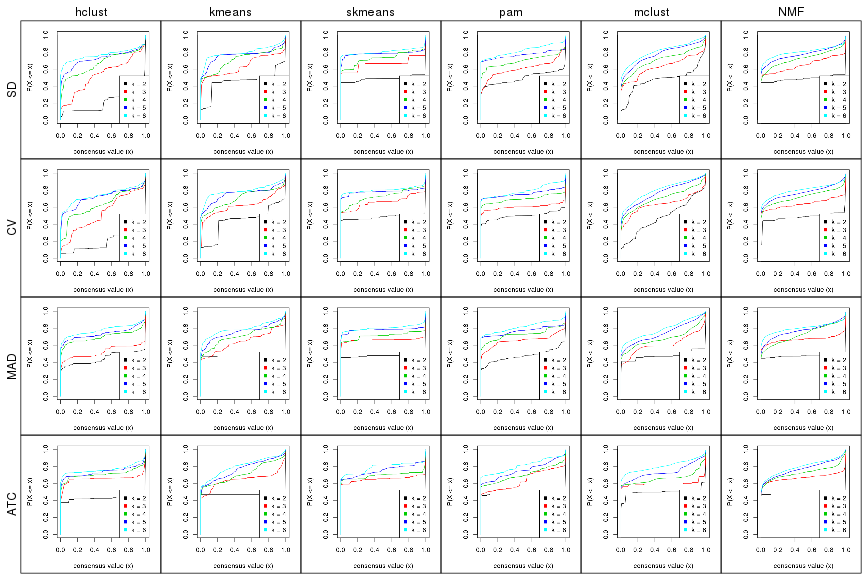
Consensus heatmaps for all methods. (What is a consensus heatmap?)
collect_plots(res_list, k = 2, fun = consensus_heatmap, mc.cores = 4)
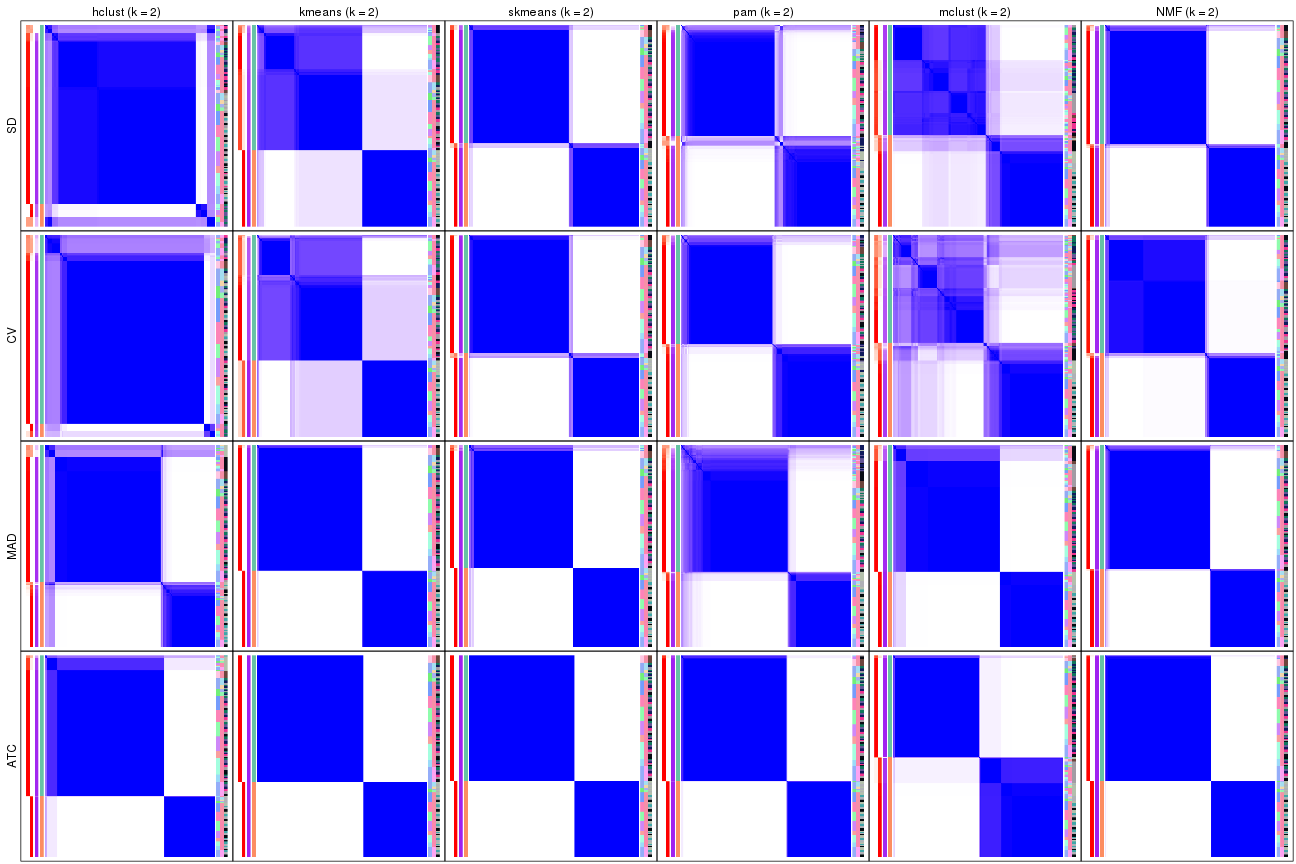
collect_plots(res_list, k = 3, fun = consensus_heatmap, mc.cores = 4)
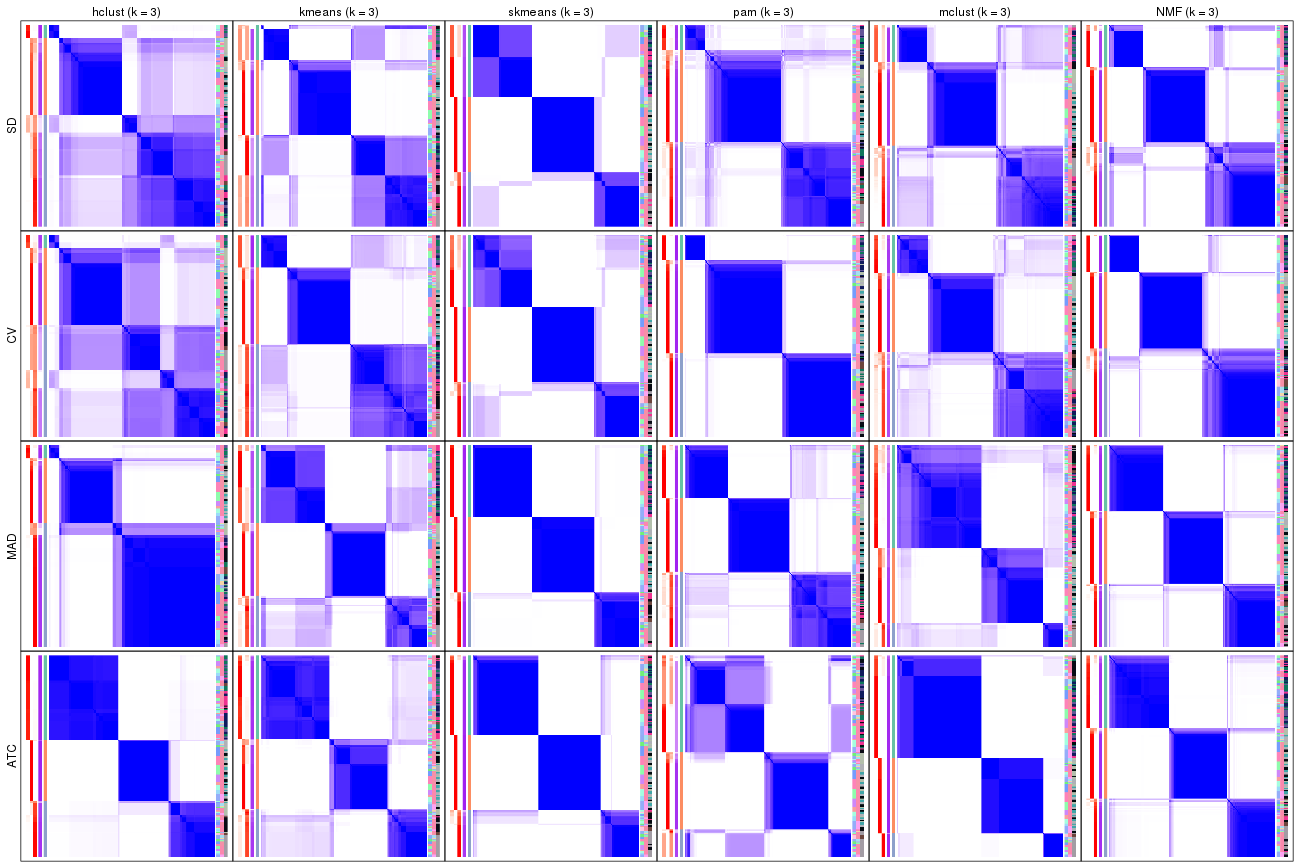
collect_plots(res_list, k = 4, fun = consensus_heatmap, mc.cores = 4)
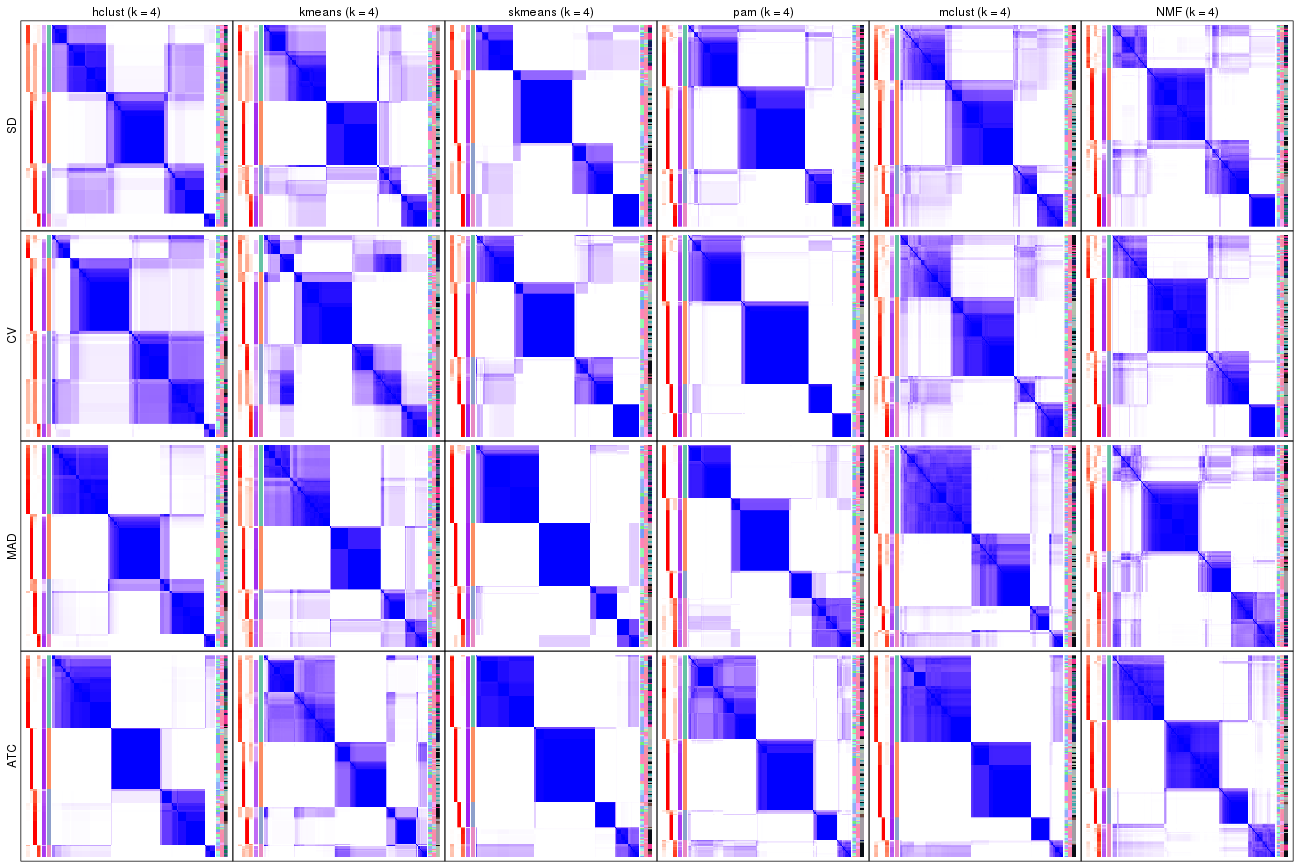
collect_plots(res_list, k = 5, fun = consensus_heatmap, mc.cores = 4)
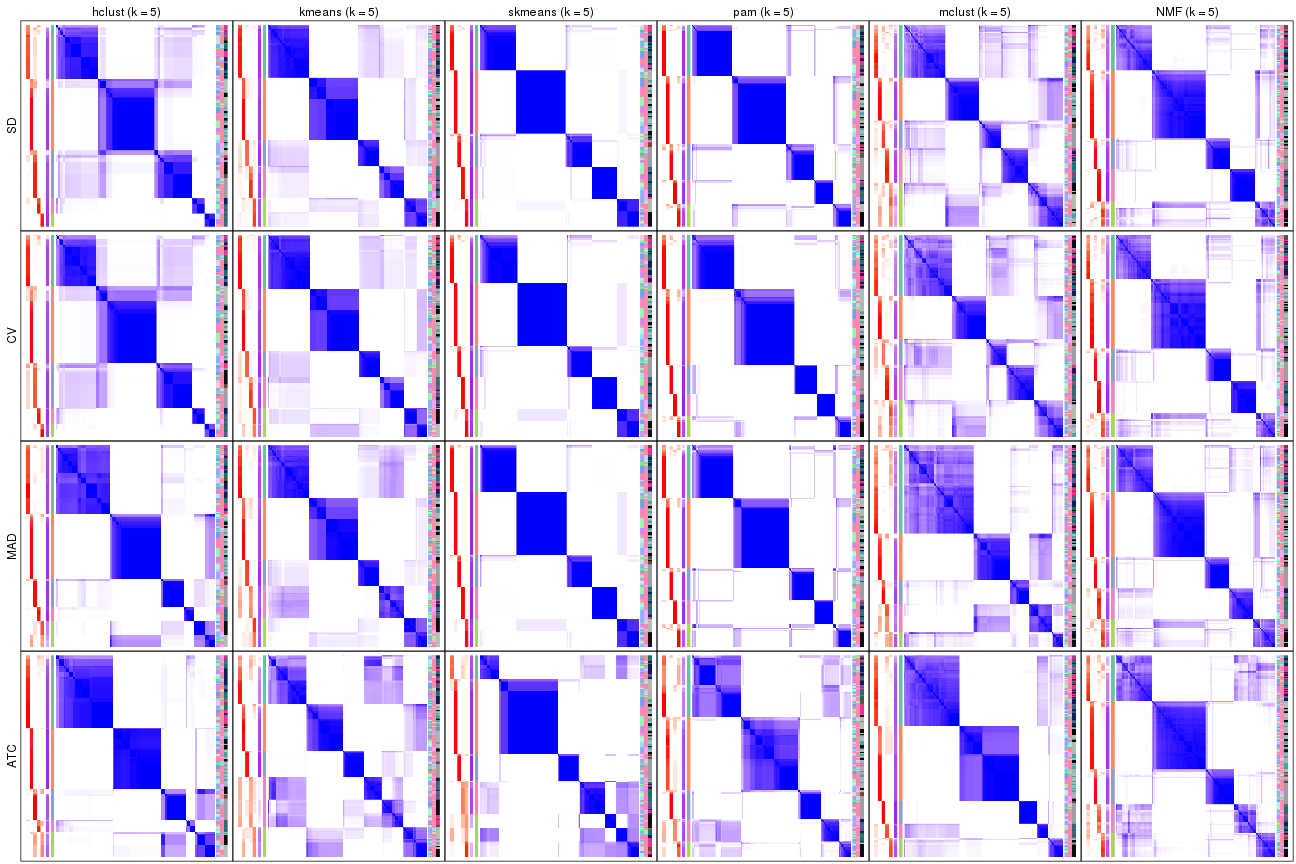
collect_plots(res_list, k = 6, fun = consensus_heatmap, mc.cores = 4)
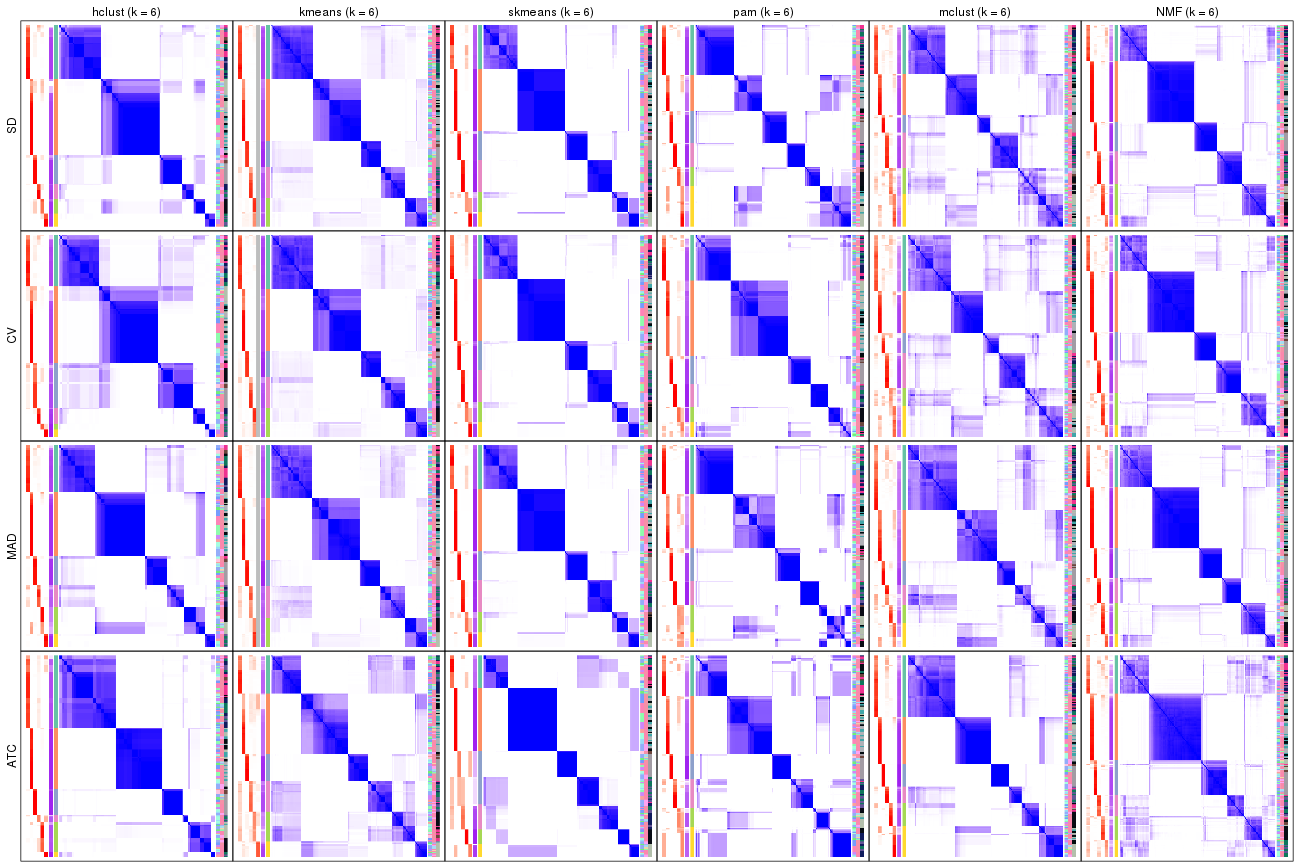
Membership heatmaps for all methods. (What is a membership heatmap?)
collect_plots(res_list, k = 2, fun = membership_heatmap, mc.cores = 4)
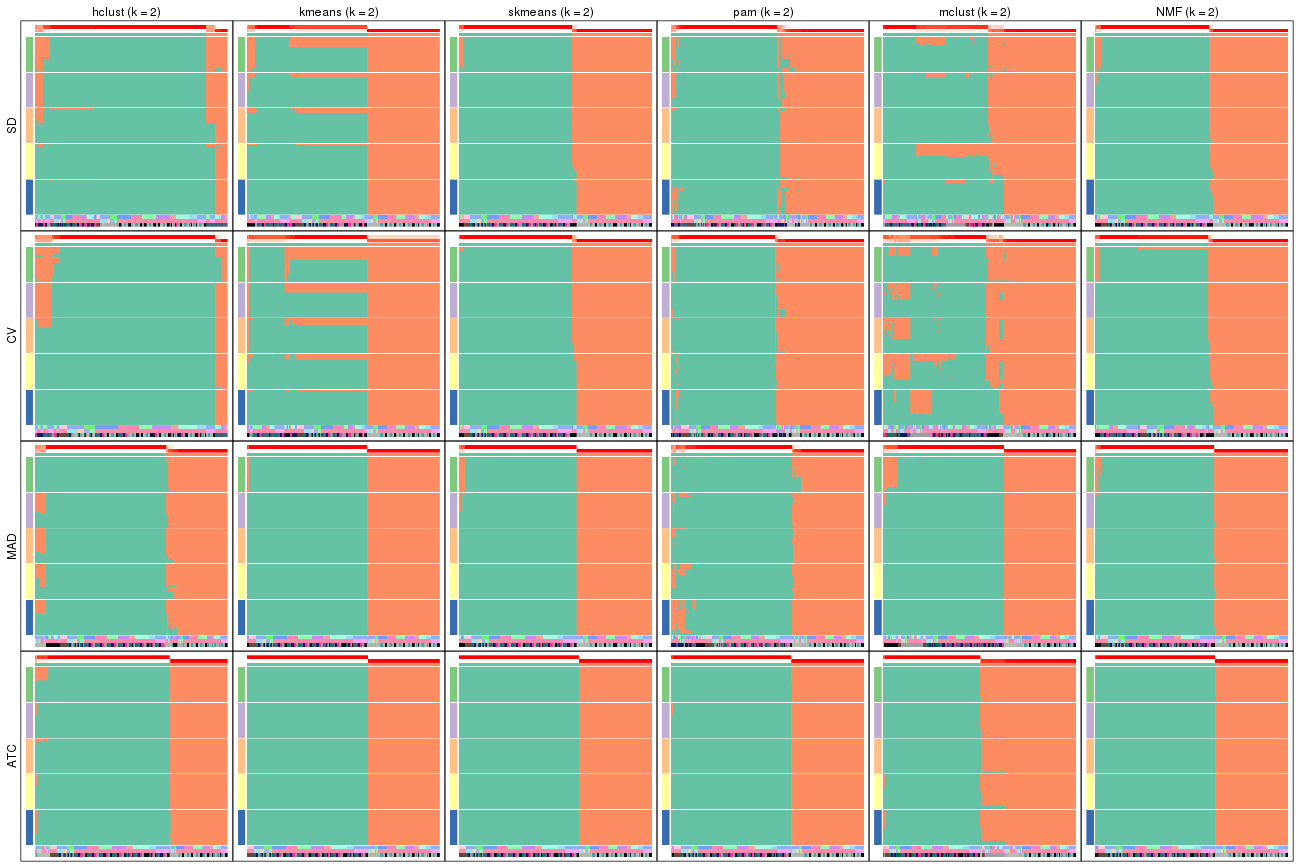
collect_plots(res_list, k = 3, fun = membership_heatmap, mc.cores = 4)
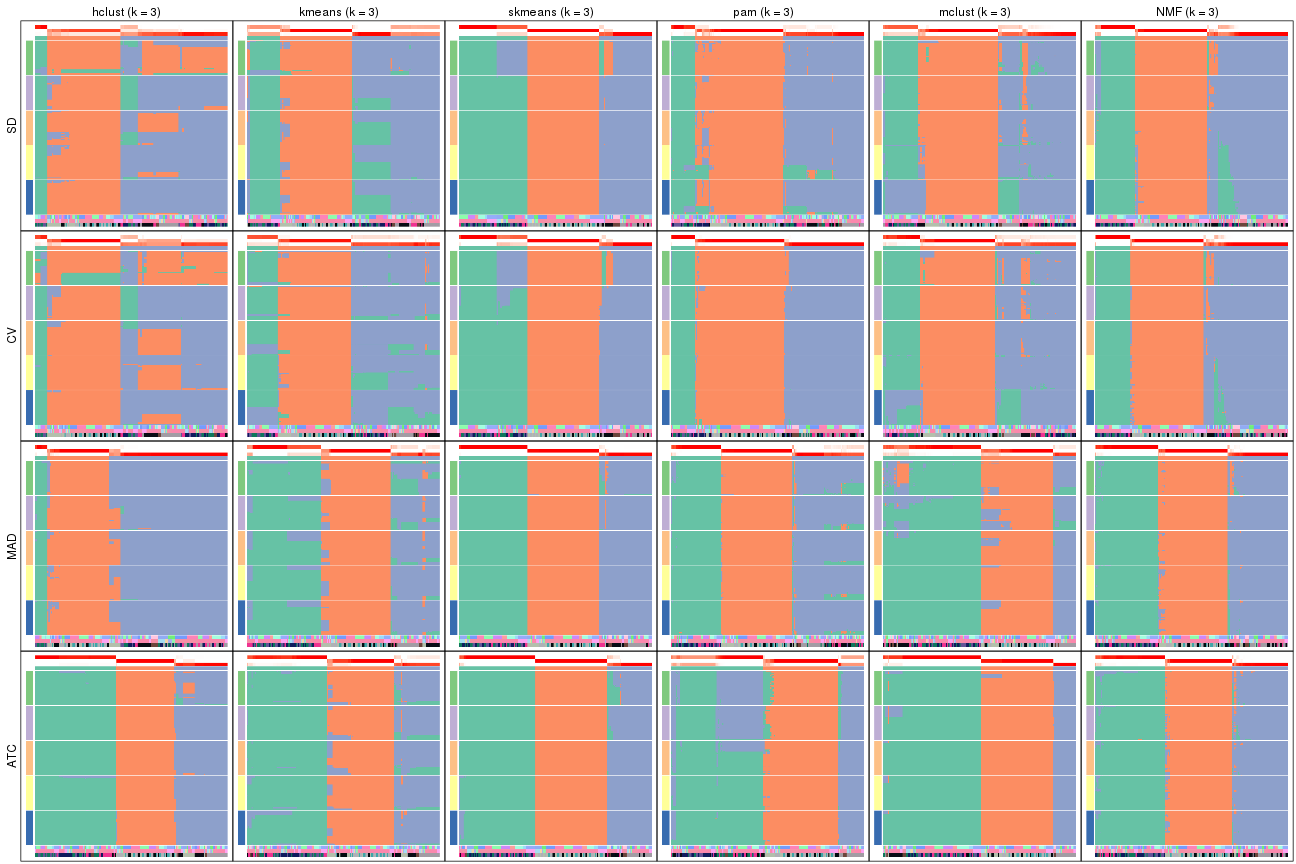
collect_plots(res_list, k = 4, fun = membership_heatmap, mc.cores = 4)
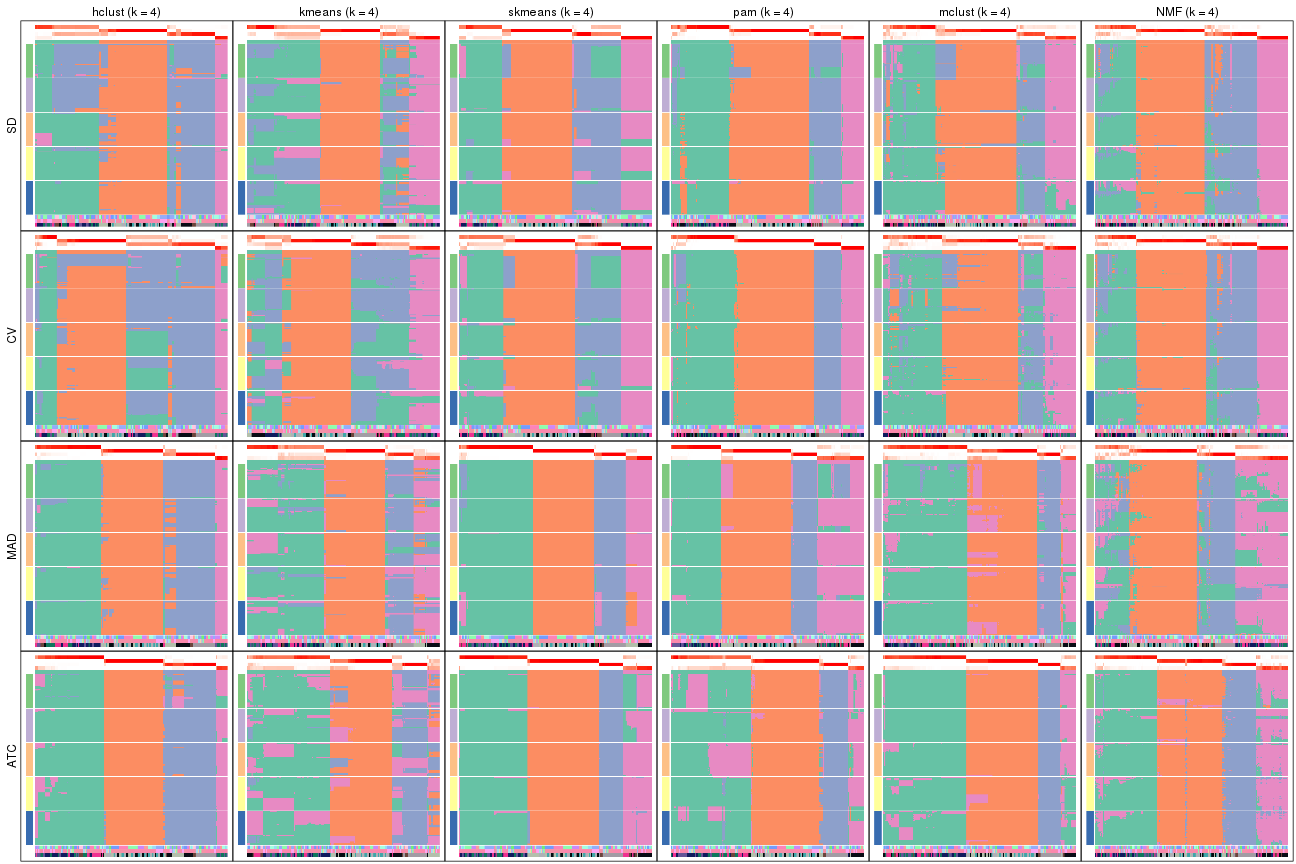
collect_plots(res_list, k = 5, fun = membership_heatmap, mc.cores = 4)
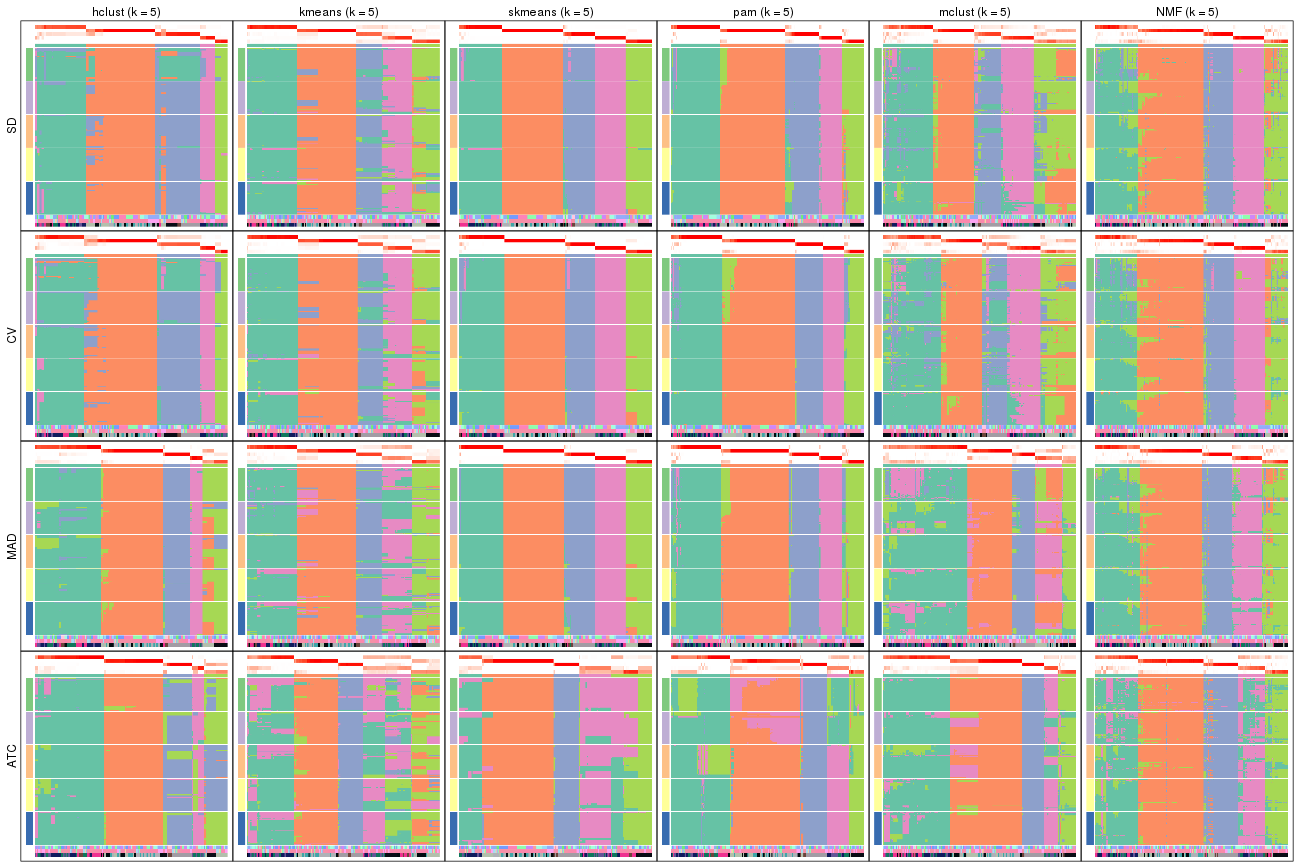
collect_plots(res_list, k = 6, fun = membership_heatmap, mc.cores = 4)
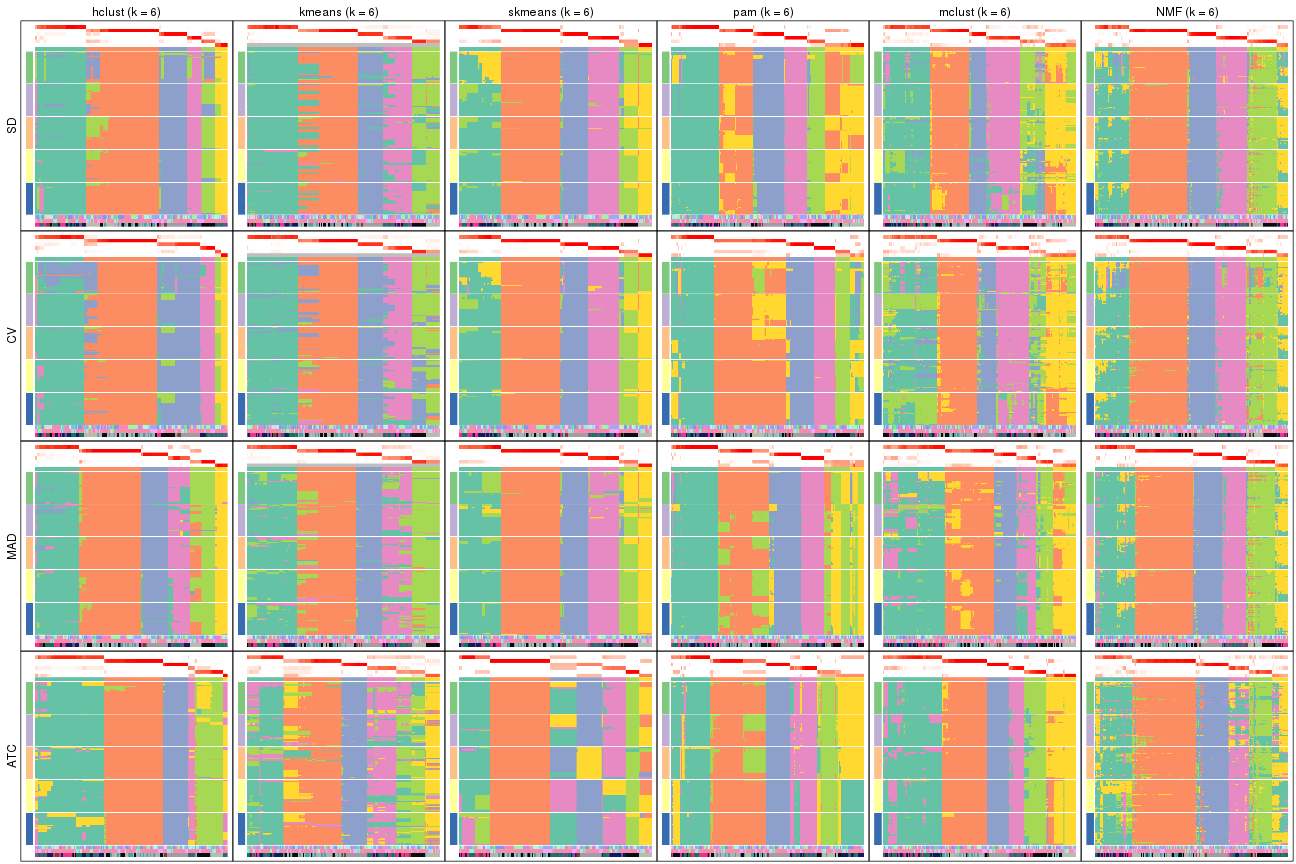
Signature heatmaps for all methods. (What is a signature heatmap?)
Note in following heatmaps, rows are scaled.
collect_plots(res_list, k = 2, fun = get_signatures, mc.cores = 4)
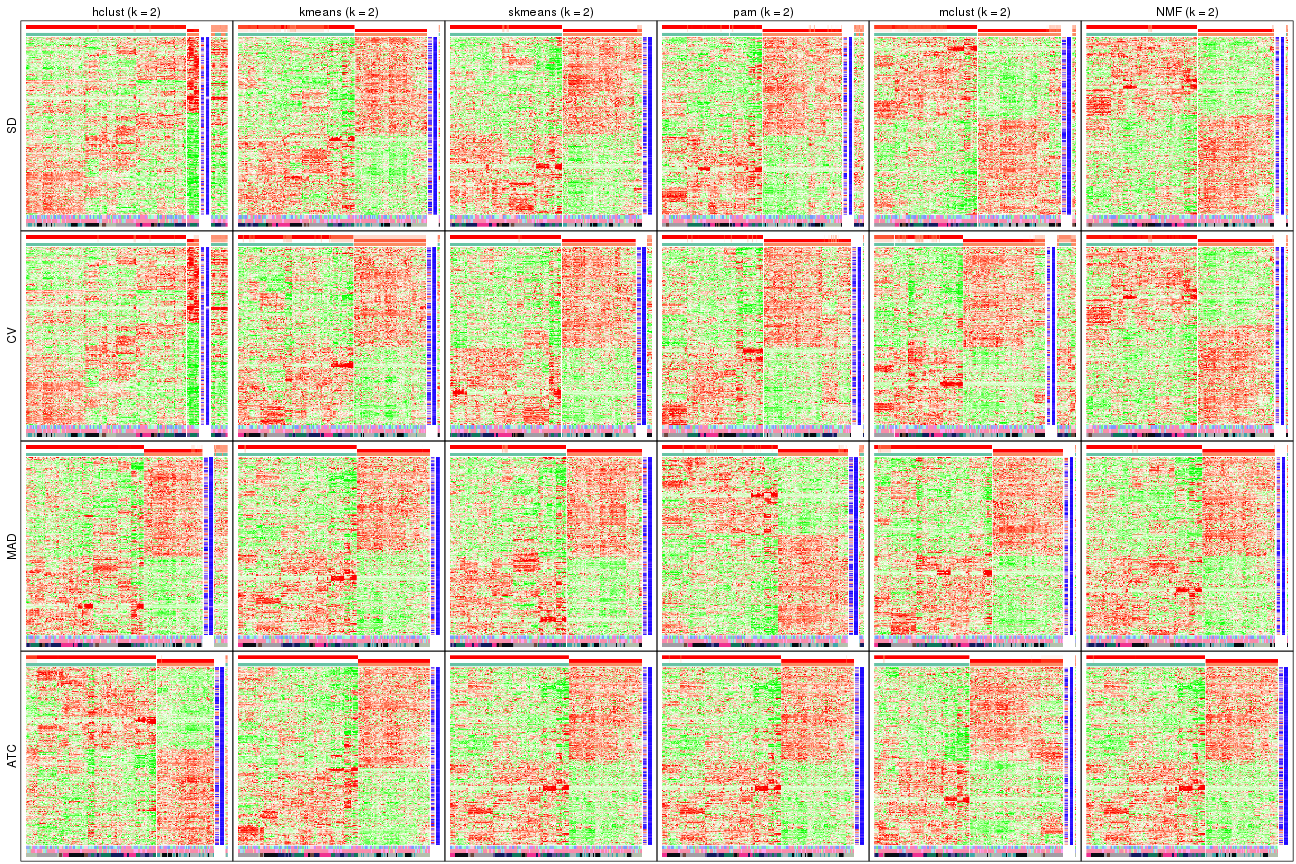
collect_plots(res_list, k = 3, fun = get_signatures, mc.cores = 4)
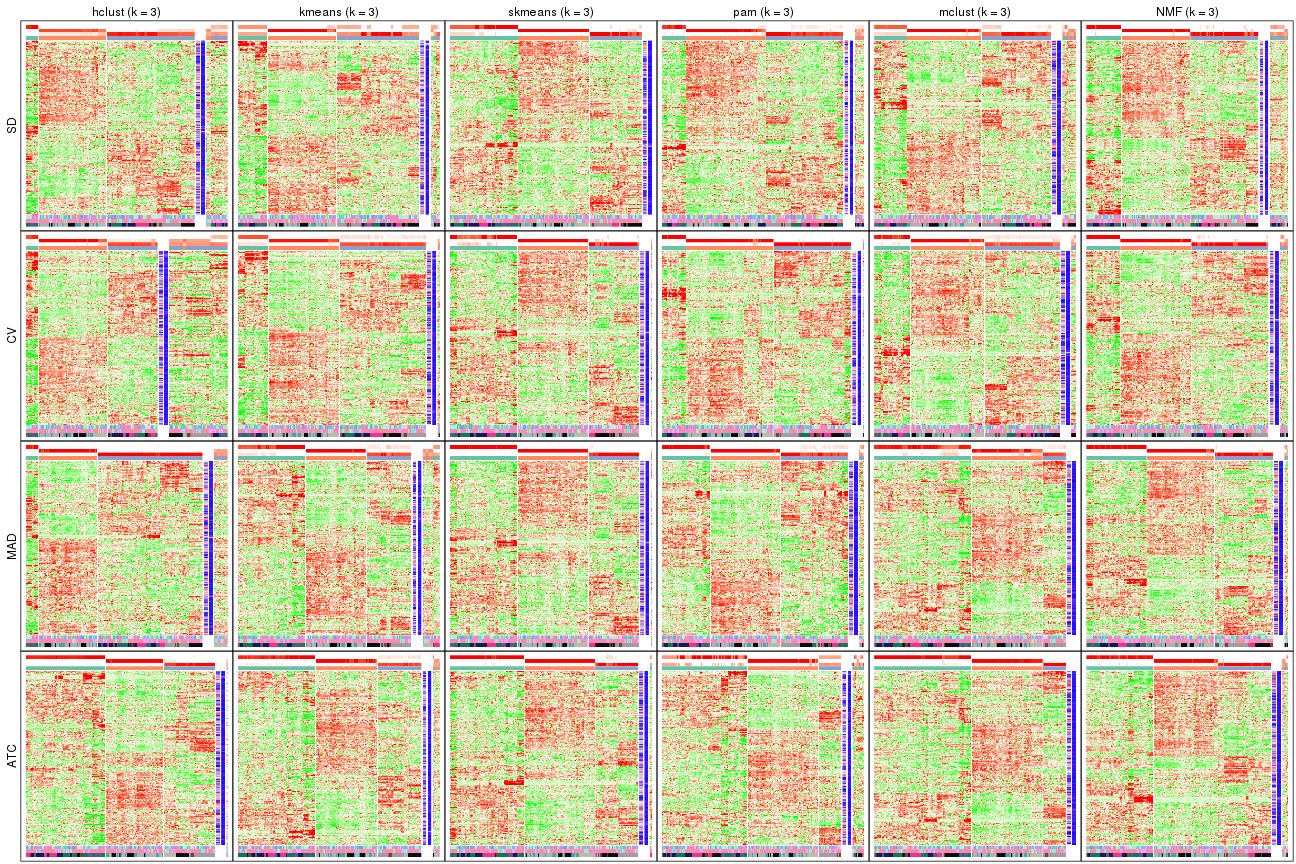
collect_plots(res_list, k = 4, fun = get_signatures, mc.cores = 4)
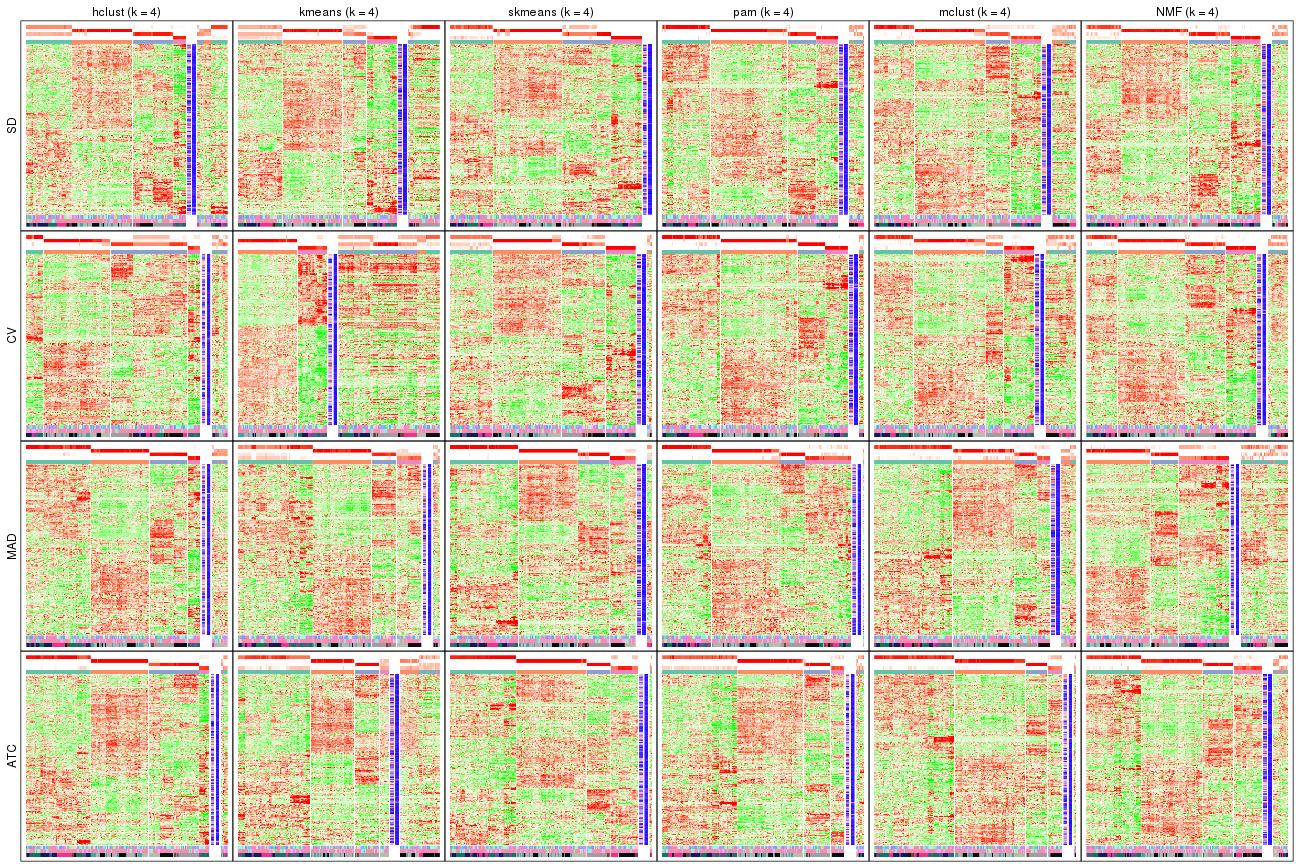
collect_plots(res_list, k = 5, fun = get_signatures, mc.cores = 4)
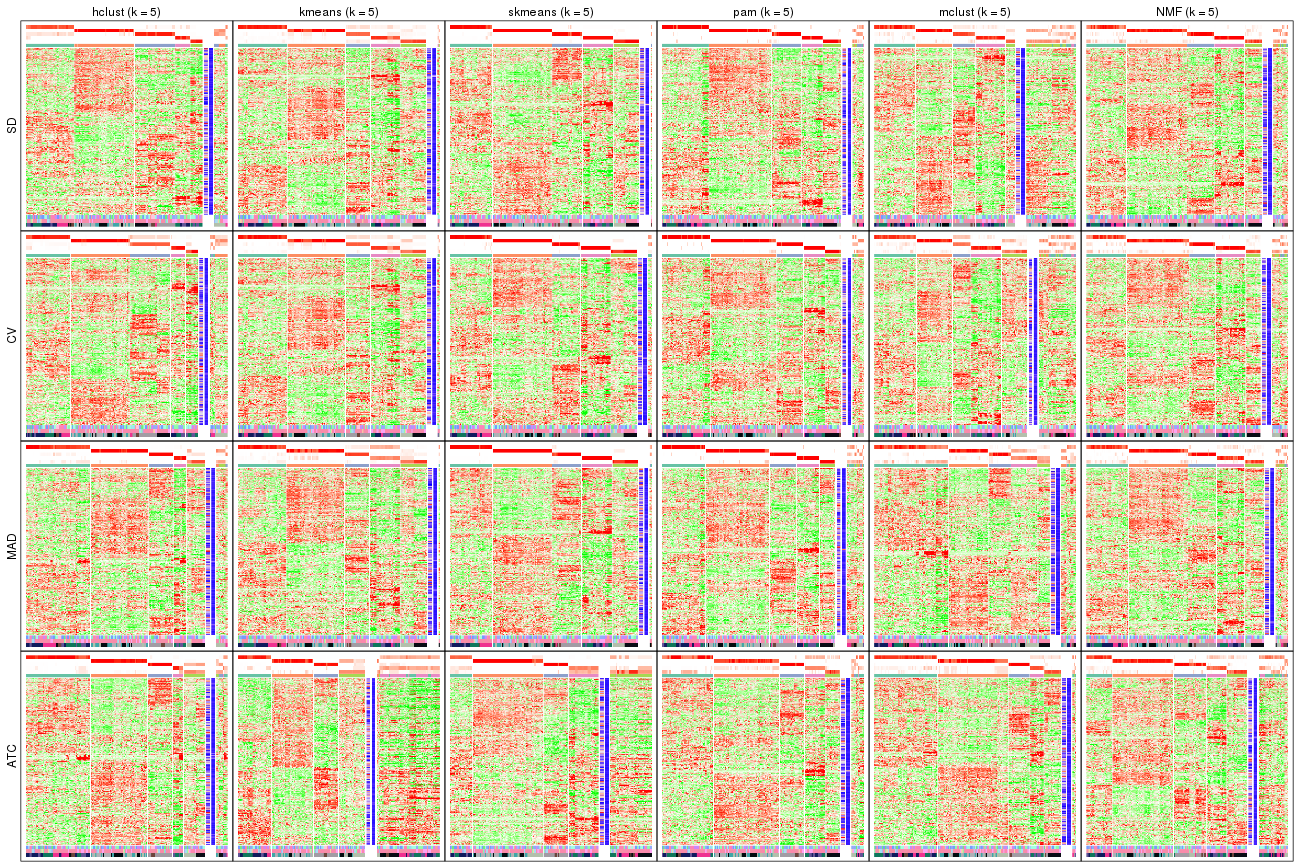
collect_plots(res_list, k = 6, fun = get_signatures, mc.cores = 4)
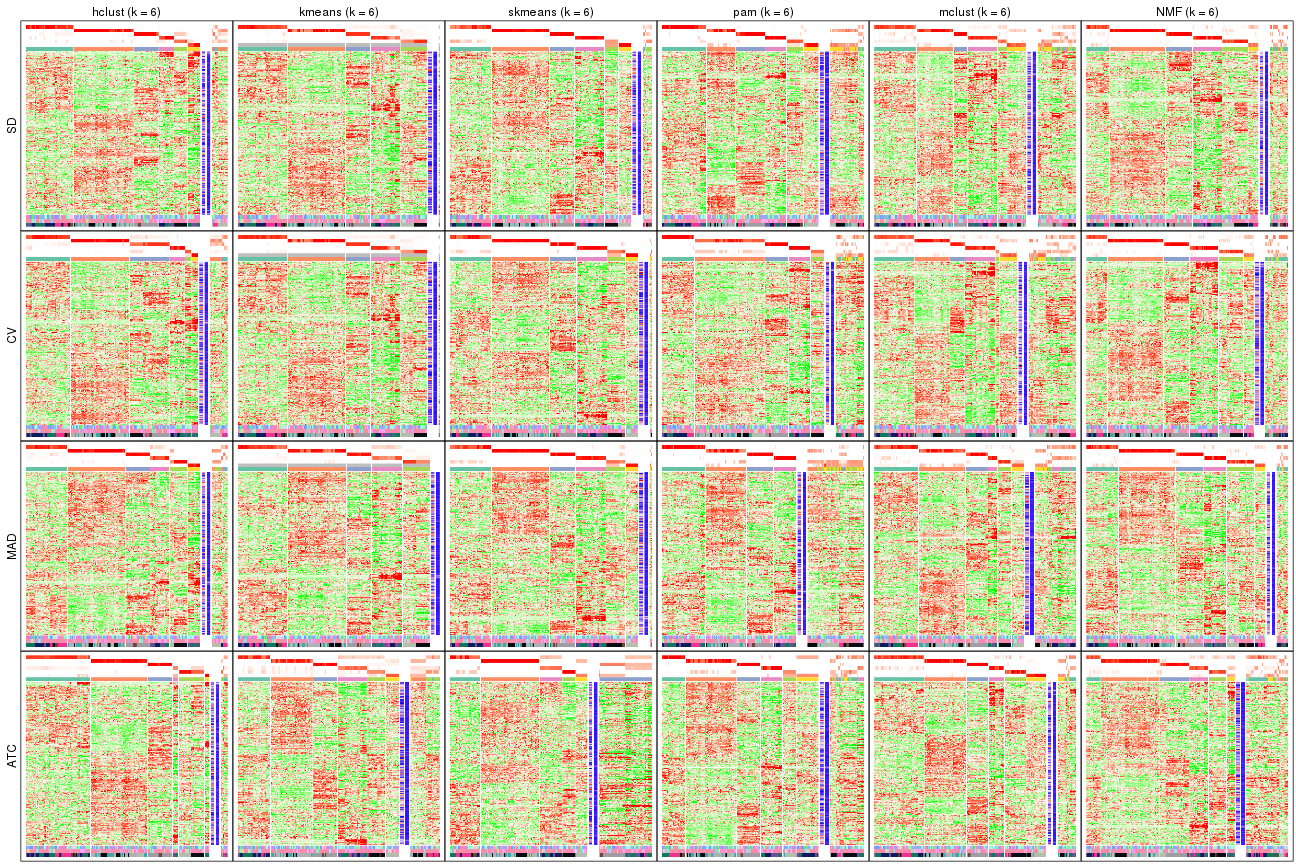
The statistics used for measuring the stability of consensus partitioning. (How are they defined?)
get_stats(res_list, k = 2)
#> k 1-PAC mean_silhouette concordance area_increased Rand Jaccard
#> SD:NMF 2 1.000 0.969 0.988 0.487 0.514 0.514
#> CV:NMF 2 1.000 0.965 0.982 0.485 0.512 0.512
#> MAD:NMF 2 1.000 0.982 0.993 0.479 0.524 0.524
#> ATC:NMF 2 1.000 0.998 0.999 0.474 0.527 0.527
#> SD:skmeans 2 1.000 0.977 0.990 0.488 0.512 0.512
#> CV:skmeans 2 1.000 0.971 0.989 0.485 0.512 0.512
#> MAD:skmeans 2 1.000 0.984 0.993 0.482 0.521 0.521
#> ATC:skmeans 2 1.000 1.000 1.000 0.474 0.527 0.527
#> SD:mclust 2 0.673 0.912 0.939 0.478 0.501 0.501
#> CV:mclust 2 0.434 0.796 0.897 0.486 0.499 0.499
#> MAD:mclust 2 0.896 0.966 0.984 0.477 0.530 0.530
#> ATC:mclust 2 1.000 0.976 0.988 0.501 0.497 0.497
#> SD:kmeans 2 0.548 0.947 0.939 0.456 0.527 0.527
#> CV:kmeans 2 0.511 0.914 0.903 0.442 0.527 0.527
#> MAD:kmeans 2 1.000 0.996 0.998 0.475 0.527 0.527
#> ATC:kmeans 2 1.000 1.000 1.000 0.471 0.530 0.530
#> SD:pam 2 0.936 0.909 0.965 0.496 0.502 0.502
#> CV:pam 2 0.998 0.961 0.983 0.501 0.500 0.500
#> MAD:pam 2 0.922 0.930 0.969 0.477 0.530 0.530
#> ATC:pam 2 1.000 0.997 0.998 0.474 0.527 0.527
#> SD:hclust 2 0.837 0.858 0.948 0.199 0.799 0.799
#> CV:hclust 2 0.837 0.878 0.952 0.184 0.878 0.878
#> MAD:hclust 2 0.905 0.901 0.964 0.447 0.563 0.563
#> ATC:hclust 2 1.000 0.976 0.989 0.431 0.576 0.576
get_stats(res_list, k = 3)
#> k 1-PAC mean_silhouette concordance area_increased Rand Jaccard
#> SD:NMF 3 0.832 0.844 0.938 0.334 0.786 0.604
#> CV:NMF 3 0.921 0.916 0.965 0.324 0.796 0.622
#> MAD:NMF 3 0.958 0.947 0.977 0.398 0.765 0.568
#> ATC:NMF 3 0.953 0.936 0.971 0.408 0.775 0.584
#> SD:skmeans 3 0.835 0.927 0.953 0.357 0.785 0.595
#> CV:skmeans 3 0.804 0.901 0.940 0.363 0.785 0.595
#> MAD:skmeans 3 1.000 0.985 0.992 0.377 0.796 0.615
#> ATC:skmeans 3 0.950 0.959 0.981 0.374 0.814 0.648
#> SD:mclust 3 0.726 0.832 0.893 0.319 0.802 0.628
#> CV:mclust 3 0.740 0.872 0.919 0.314 0.756 0.558
#> MAD:mclust 3 0.671 0.865 0.911 0.284 0.879 0.771
#> ATC:mclust 3 1.000 0.973 0.986 0.193 0.899 0.800
#> SD:kmeans 3 0.779 0.742 0.865 0.402 0.842 0.701
#> CV:kmeans 3 0.711 0.882 0.883 0.411 0.852 0.718
#> MAD:kmeans 3 0.667 0.817 0.893 0.357 0.796 0.618
#> ATC:kmeans 3 0.778 0.909 0.931 0.369 0.796 0.622
#> SD:pam 3 0.808 0.876 0.934 0.227 0.850 0.714
#> CV:pam 3 1.000 0.965 0.986 0.206 0.896 0.793
#> MAD:pam 3 0.843 0.924 0.953 0.381 0.799 0.624
#> ATC:pam 3 0.748 0.719 0.837 0.347 0.857 0.731
#> SD:hclust 3 0.378 0.771 0.835 1.675 0.558 0.478
#> CV:hclust 3 0.374 0.646 0.765 1.891 0.576 0.517
#> MAD:hclust 3 0.910 0.887 0.961 0.174 0.919 0.857
#> ATC:hclust 3 0.989 0.969 0.979 0.523 0.765 0.592
get_stats(res_list, k = 4)
#> k 1-PAC mean_silhouette concordance area_increased Rand Jaccard
#> SD:NMF 4 0.786 0.810 0.897 0.1178 0.862 0.637
#> CV:NMF 4 0.840 0.811 0.910 0.1289 0.868 0.655
#> MAD:NMF 4 0.724 0.638 0.795 0.0896 0.899 0.709
#> ATC:NMF 4 0.851 0.848 0.913 0.0875 0.898 0.711
#> SD:skmeans 4 0.795 0.880 0.895 0.1031 0.897 0.707
#> CV:skmeans 4 0.819 0.847 0.890 0.1004 0.906 0.732
#> MAD:skmeans 4 0.935 0.926 0.962 0.0745 0.881 0.679
#> ATC:skmeans 4 0.964 0.934 0.963 0.0656 0.935 0.816
#> SD:mclust 4 0.706 0.756 0.864 0.1227 0.902 0.740
#> CV:mclust 4 0.693 0.735 0.847 0.1078 0.915 0.770
#> MAD:mclust 4 0.720 0.786 0.878 0.1149 0.927 0.822
#> ATC:mclust 4 0.856 0.894 0.933 0.1086 0.931 0.831
#> SD:kmeans 4 0.697 0.724 0.784 0.1137 0.883 0.697
#> CV:kmeans 4 0.714 0.551 0.743 0.1353 0.878 0.685
#> MAD:kmeans 4 0.732 0.797 0.830 0.1026 0.913 0.759
#> ATC:kmeans 4 0.716 0.657 0.755 0.1124 0.943 0.843
#> SD:pam 4 0.905 0.855 0.935 0.1488 0.787 0.531
#> CV:pam 4 0.937 0.921 0.965 0.1580 0.809 0.572
#> MAD:pam 4 0.858 0.895 0.928 0.1074 0.931 0.795
#> ATC:pam 4 0.799 0.779 0.879 0.1008 0.916 0.789
#> SD:hclust 4 0.713 0.752 0.838 0.2572 0.822 0.618
#> CV:hclust 4 0.715 0.708 0.836 0.1909 0.871 0.725
#> MAD:hclust 4 0.893 0.863 0.943 0.3326 0.812 0.610
#> ATC:hclust 4 0.911 0.906 0.951 0.0814 0.957 0.874
get_stats(res_list, k = 5)
#> k 1-PAC mean_silhouette concordance area_increased Rand Jaccard
#> SD:NMF 5 0.815 0.804 0.890 0.0653 0.919 0.716
#> CV:NMF 5 0.807 0.789 0.884 0.0667 0.921 0.725
#> MAD:NMF 5 0.794 0.801 0.885 0.0615 0.876 0.592
#> ATC:NMF 5 0.771 0.719 0.845 0.0614 0.909 0.690
#> SD:skmeans 5 0.997 0.961 0.978 0.0720 0.923 0.725
#> CV:skmeans 5 0.956 0.951 0.976 0.0732 0.909 0.685
#> MAD:skmeans 5 0.990 0.963 0.981 0.0956 0.923 0.736
#> ATC:skmeans 5 0.813 0.776 0.840 0.0832 0.891 0.663
#> SD:mclust 5 0.680 0.679 0.809 0.0961 0.881 0.615
#> CV:mclust 5 0.658 0.648 0.790 0.0899 0.918 0.719
#> MAD:mclust 5 0.685 0.703 0.796 0.0928 0.923 0.779
#> ATC:mclust 5 0.761 0.847 0.880 0.1084 0.938 0.820
#> SD:kmeans 5 0.814 0.905 0.891 0.0734 0.920 0.728
#> CV:kmeans 5 0.767 0.888 0.881 0.0693 0.864 0.569
#> MAD:kmeans 5 0.762 0.869 0.844 0.0678 0.903 0.685
#> ATC:kmeans 5 0.686 0.557 0.691 0.0697 0.818 0.489
#> SD:pam 5 0.928 0.887 0.953 0.0970 0.909 0.708
#> CV:pam 5 0.918 0.899 0.955 0.0832 0.907 0.715
#> MAD:pam 5 0.919 0.846 0.938 0.0549 0.882 0.622
#> ATC:pam 5 0.737 0.756 0.816 0.0733 0.926 0.774
#> SD:hclust 5 0.764 0.837 0.889 0.0844 0.949 0.832
#> CV:hclust 5 0.769 0.835 0.877 0.1384 0.851 0.613
#> MAD:hclust 5 0.837 0.859 0.913 0.0546 0.963 0.874
#> ATC:hclust 5 0.893 0.834 0.868 0.0397 0.962 0.871
get_stats(res_list, k = 6)
#> k 1-PAC mean_silhouette concordance area_increased Rand Jaccard
#> SD:NMF 6 0.861 0.814 0.895 0.0371 0.933 0.722
#> CV:NMF 6 0.830 0.785 0.877 0.0366 0.922 0.687
#> MAD:NMF 6 0.870 0.826 0.911 0.0369 0.922 0.684
#> ATC:NMF 6 0.773 0.675 0.797 0.0307 0.958 0.823
#> SD:skmeans 6 0.949 0.882 0.898 0.0292 0.972 0.875
#> CV:skmeans 6 0.941 0.916 0.924 0.0296 0.970 0.867
#> MAD:skmeans 6 0.955 0.912 0.920 0.0285 0.971 0.871
#> ATC:skmeans 6 0.871 0.732 0.755 0.0478 0.891 0.612
#> SD:mclust 6 0.708 0.681 0.802 0.0446 0.942 0.734
#> CV:mclust 6 0.682 0.627 0.741 0.0438 0.961 0.821
#> MAD:mclust 6 0.713 0.595 0.800 0.0599 0.898 0.654
#> ATC:mclust 6 0.839 0.806 0.905 0.0962 0.896 0.644
#> SD:kmeans 6 0.859 0.843 0.855 0.0432 0.995 0.978
#> CV:kmeans 6 0.868 0.848 0.848 0.0495 1.000 1.000
#> MAD:kmeans 6 0.794 0.838 0.840 0.0499 1.000 1.000
#> ATC:kmeans 6 0.715 0.684 0.757 0.0447 0.891 0.572
#> SD:pam 6 0.838 0.734 0.843 0.0670 0.906 0.625
#> CV:pam 6 0.832 0.767 0.865 0.0467 0.969 0.880
#> MAD:pam 6 0.829 0.607 0.816 0.0631 0.922 0.692
#> ATC:pam 6 0.806 0.689 0.821 0.0709 0.863 0.529
#> SD:hclust 6 0.862 0.836 0.902 0.0568 0.953 0.828
#> CV:hclust 6 0.790 0.821 0.887 0.0326 0.998 0.992
#> MAD:hclust 6 0.852 0.829 0.914 0.0568 0.948 0.797
#> ATC:hclust 6 0.900 0.879 0.912 0.0386 0.986 0.948
Following heatmap plots the partition for each combination of methods and the lightness correspond to the silhouette scores for samples in each method. On top the consensus subgroup is inferred from all methods by taking the mean silhouette scores as weight.
collect_stats(res_list, k = 2)
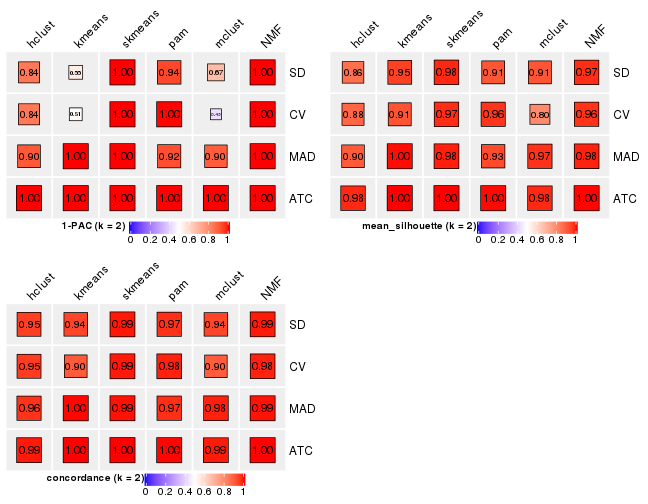
collect_stats(res_list, k = 3)
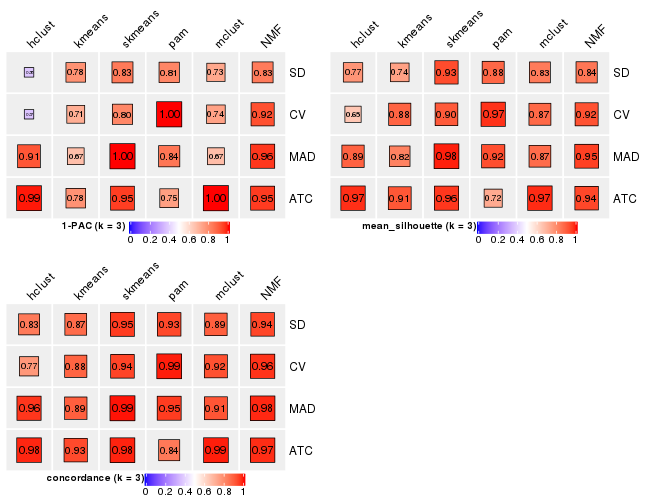
collect_stats(res_list, k = 4)
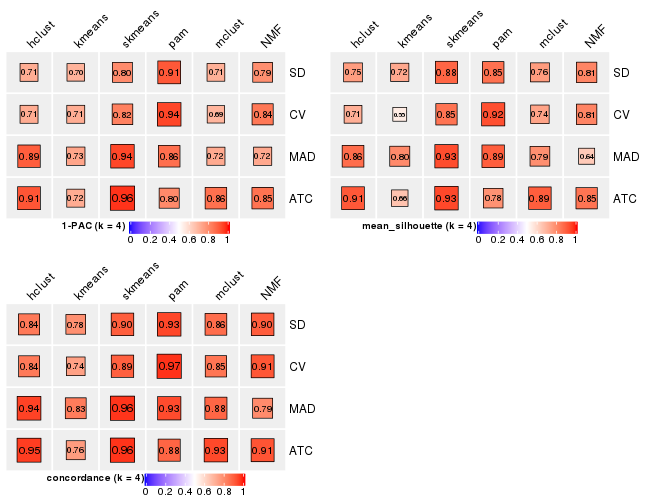
collect_stats(res_list, k = 5)
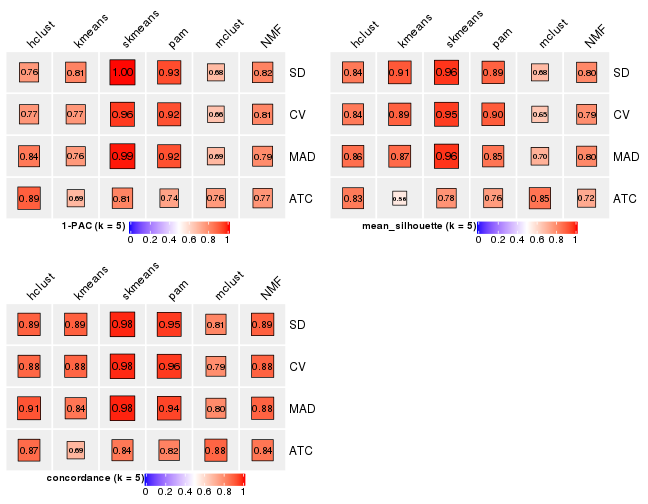
collect_stats(res_list, k = 6)
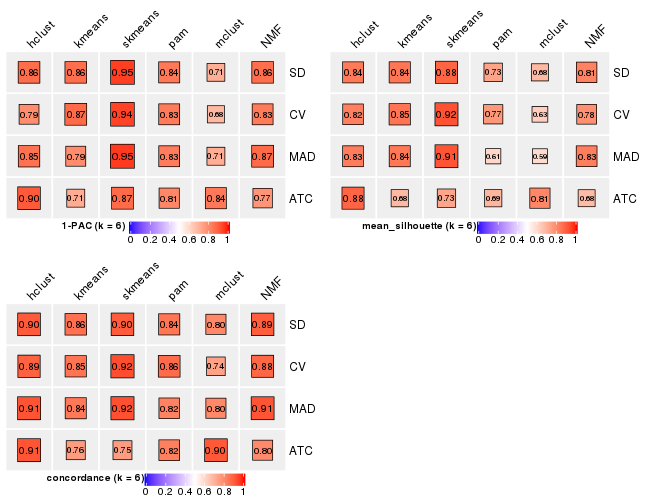
Collect partitions from all methods:
collect_classes(res_list, k = 2)
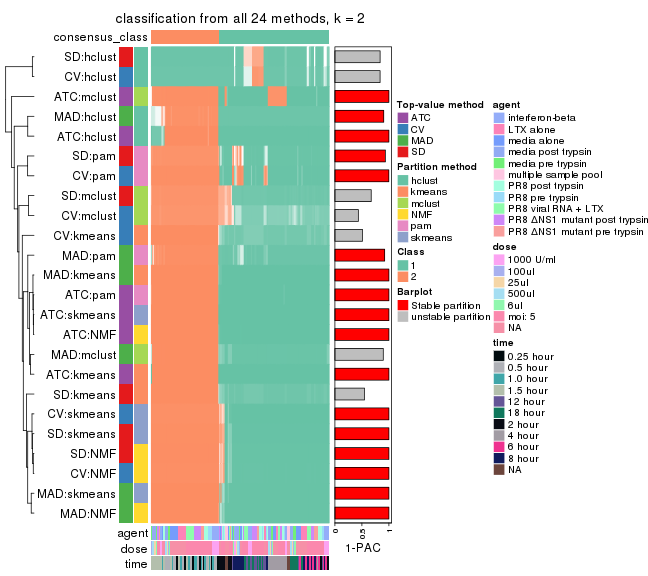
collect_classes(res_list, k = 3)
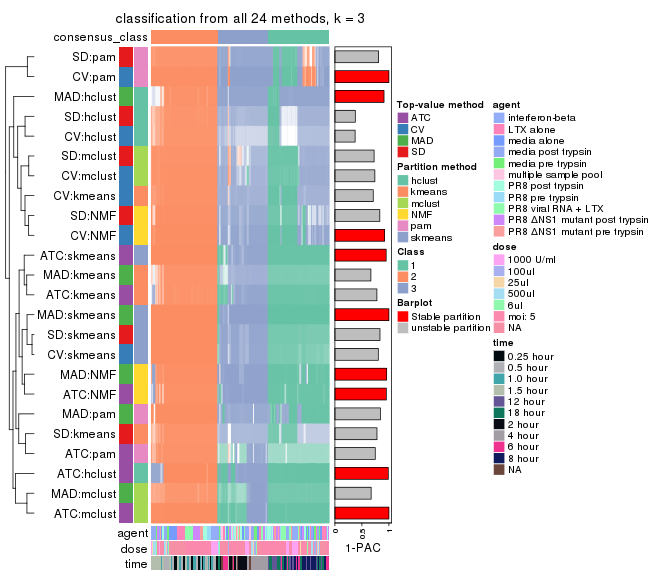
collect_classes(res_list, k = 4)
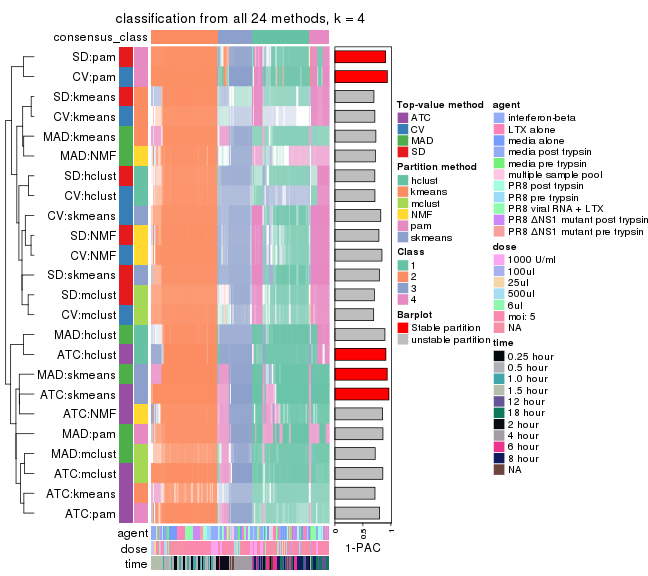
collect_classes(res_list, k = 5)
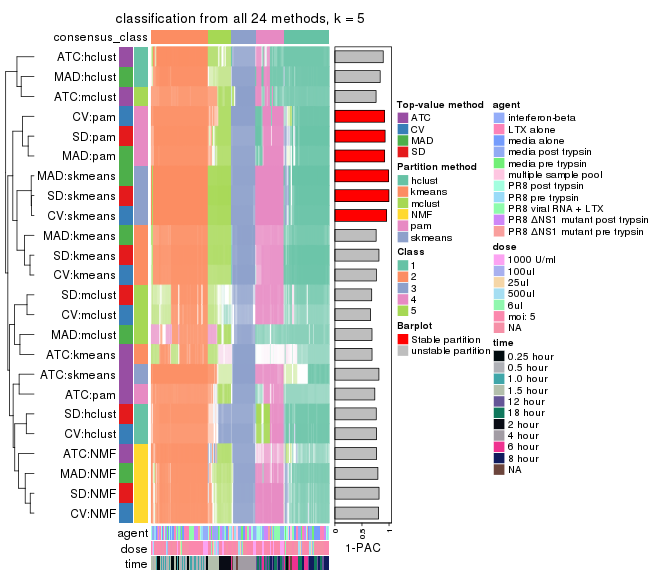
collect_classes(res_list, k = 6)
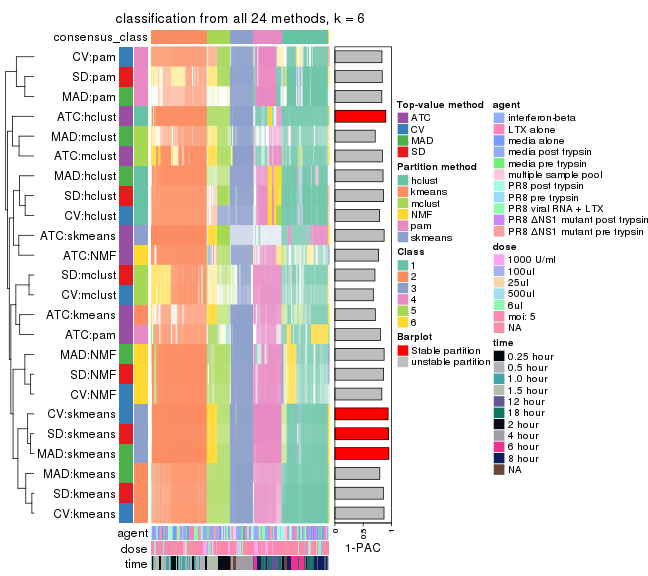
Overlap of top rows from different top-row methods:
top_rows_overlap(res_list, top_n = 1000, method = "euler")
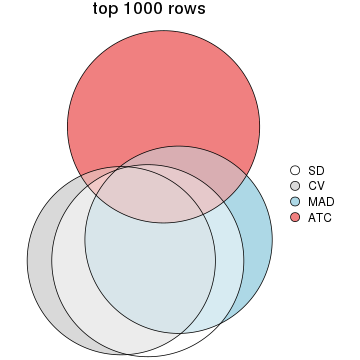
top_rows_overlap(res_list, top_n = 2000, method = "euler")
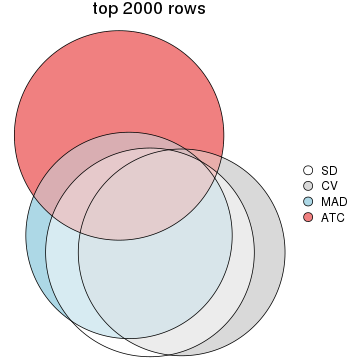
top_rows_overlap(res_list, top_n = 3000, method = "euler")
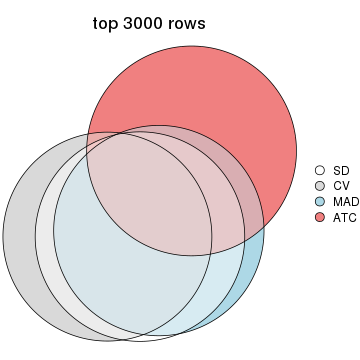
top_rows_overlap(res_list, top_n = 4000, method = "euler")
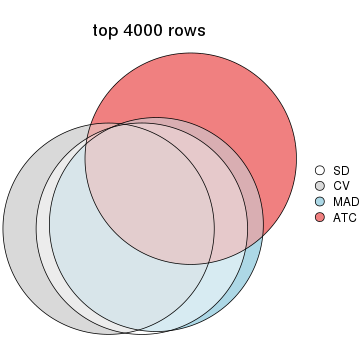
top_rows_overlap(res_list, top_n = 5000, method = "euler")
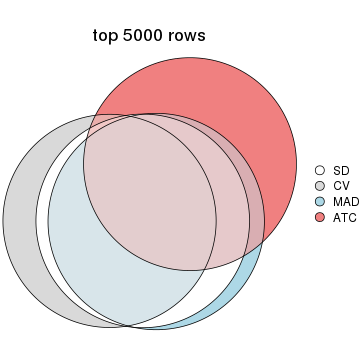
Also visualize the correspondance of rankings between different top-row methods:
top_rows_overlap(res_list, top_n = 1000, method = "correspondance")
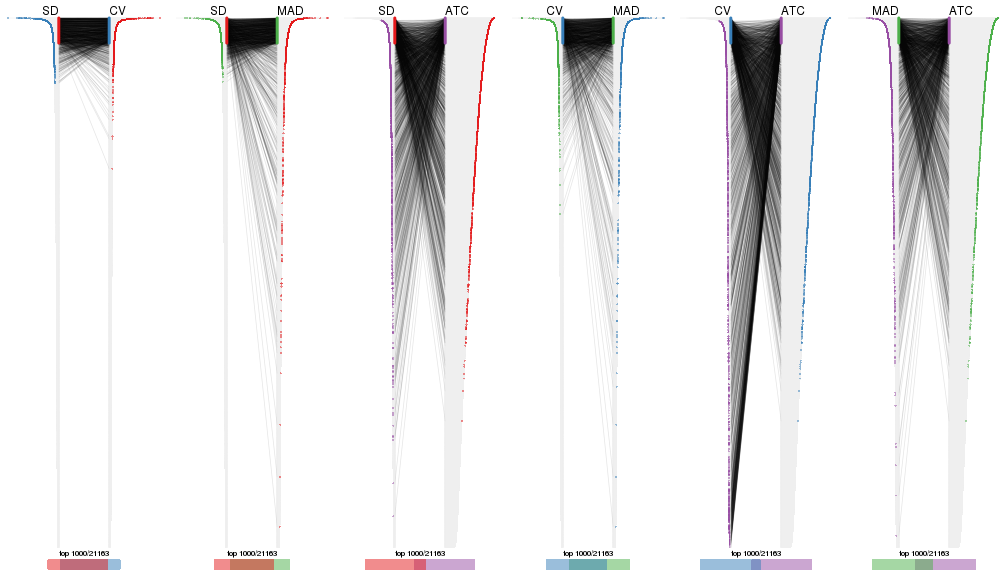
top_rows_overlap(res_list, top_n = 2000, method = "correspondance")
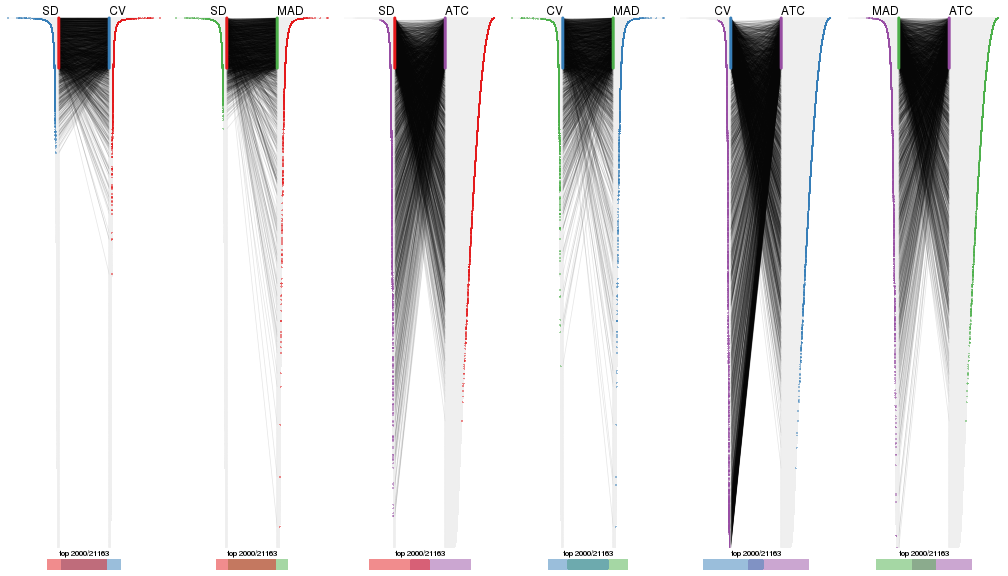
top_rows_overlap(res_list, top_n = 3000, method = "correspondance")
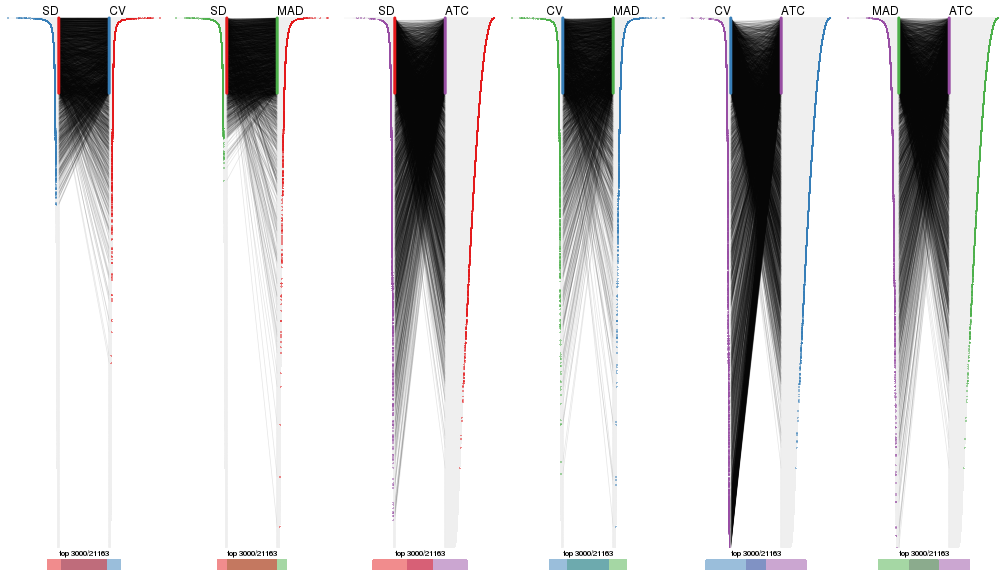
top_rows_overlap(res_list, top_n = 4000, method = "correspondance")
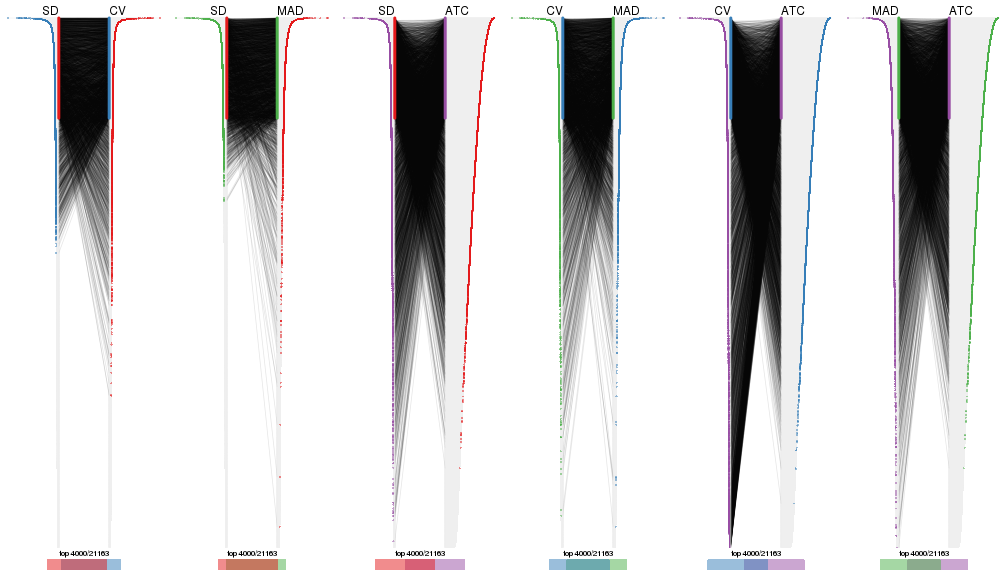
top_rows_overlap(res_list, top_n = 5000, method = "correspondance")
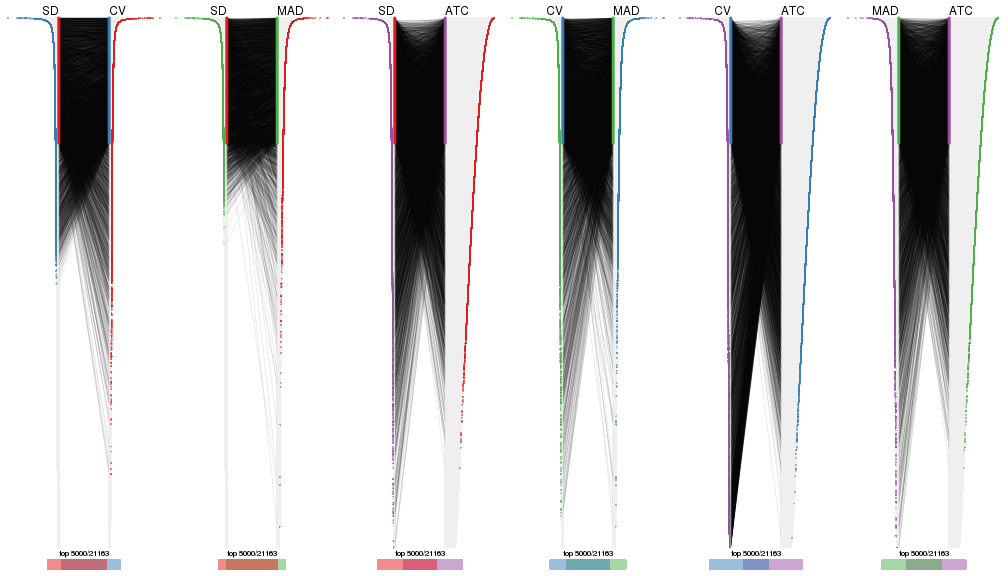
Heatmaps of the top rows:
top_rows_heatmap(res_list, top_n = 1000)

top_rows_heatmap(res_list, top_n = 2000)

top_rows_heatmap(res_list, top_n = 3000)

top_rows_heatmap(res_list, top_n = 4000)

top_rows_heatmap(res_list, top_n = 5000)

Test correlation between subgroups and known annotations. If the known annotation is numeric, one-way ANOVA test is applied, and if the known annotation is discrete, chi-squared contingency table test is applied.
test_to_known_factors(res_list, k = 2)
#> n agent(p) dose(p) time(p) k
#> SD:NMF 167 0.860 0.9988 3.81e-27 2
#> CV:NMF 167 0.860 0.9988 3.81e-27 2
#> MAD:NMF 168 0.866 0.9999 1.39e-28 2
#> ATC:NMF 169 0.907 1.0000 1.43e-29 2
#> SD:skmeans 169 0.863 0.9992 4.57e-27 2
#> CV:skmeans 165 0.861 0.9998 1.74e-27 2
#> MAD:skmeans 169 0.832 0.9999 3.84e-28 2
#> ATC:skmeans 169 0.907 1.0000 1.43e-29 2
#> SD:mclust 166 0.997 0.9971 4.95e-27 2
#> CV:mclust 152 0.845 0.9698 8.25e-25 2
#> MAD:mclust 168 0.903 0.9989 2.34e-29 2
#> ATC:mclust 168 0.986 0.9756 1.43e-27 2
#> SD:kmeans 168 0.901 1.0000 2.29e-29 2
#> CV:kmeans 167 0.891 1.0000 3.65e-29 2
#> MAD:kmeans 169 0.907 1.0000 1.43e-29 2
#> ATC:kmeans 169 0.891 0.9925 1.01e-28 2
#> SD:pam 160 0.578 0.9280 7.77e-24 2
#> CV:pam 168 0.523 0.9108 4.51e-23 2
#> MAD:pam 165 0.890 0.9912 6.56e-28 2
#> ATC:pam 169 0.907 1.0000 1.43e-29 2
#> SD:hclust 154 0.025 0.0408 1.49e-09 2
#> CV:hclust 154 0.025 0.0408 1.49e-09 2
#> MAD:hclust 157 0.759 0.9919 5.29e-27 2
#> ATC:hclust 167 0.627 0.9420 7.59e-25 2
test_to_known_factors(res_list, k = 3)
#> n agent(p) dose(p) time(p) k
#> SD:NMF 153 1.04e-02 3.67e-03 5.55e-36 3
#> CV:NMF 162 6.40e-03 1.14e-03 4.41e-35 3
#> MAD:NMF 166 2.48e-01 5.29e-01 1.09e-43 3
#> ATC:NMF 164 8.88e-01 9.80e-01 1.06e-43 3
#> SD:skmeans 169 4.50e-01 9.79e-01 1.40e-51 3
#> CV:skmeans 168 4.34e-01 9.85e-01 2.35e-52 3
#> MAD:skmeans 168 4.34e-01 9.85e-01 2.35e-52 3
#> ATC:skmeans 167 9.58e-01 1.00e+00 1.87e-50 3
#> SD:mclust 157 8.34e-04 3.85e-04 2.54e-29 3
#> CV:mclust 165 2.14e-05 6.60e-06 1.06e-29 3
#> MAD:mclust 169 9.73e-01 9.92e-01 3.35e-52 3
#> ATC:mclust 169 9.73e-01 9.92e-01 3.35e-52 3
#> SD:kmeans 161 8.72e-03 1.70e-03 4.50e-33 3
#> CV:kmeans 167 1.25e-02 2.90e-03 4.32e-35 3
#> MAD:kmeans 154 4.26e-01 9.95e-01 1.03e-48 3
#> ATC:kmeans 163 9.60e-01 9.83e-01 3.71e-47 3
#> SD:pam 161 7.28e-04 1.21e-02 3.02e-29 3
#> CV:pam 168 3.89e-04 9.94e-03 7.96e-27 3
#> MAD:pam 165 3.76e-01 9.99e-01 3.99e-41 3
#> ATC:pam 159 8.52e-01 9.80e-01 8.38e-51 3
#> SD:hclust 150 4.48e-02 8.14e-02 3.21e-31 3
#> CV:hclust 117 1.15e-02 1.44e-02 5.97e-23 3
#> MAD:hclust 157 6.28e-02 2.79e-01 1.48e-29 3
#> ATC:hclust 168 9.27e-01 9.91e-01 4.45e-49 3
test_to_known_factors(res_list, k = 4)
#> n agent(p) dose(p) time(p) k
#> SD:NMF 155 4.77e-03 6.82e-03 2.43e-44 4
#> CV:NMF 151 1.86e-02 1.27e-02 8.31e-43 4
#> MAD:NMF 127 2.40e-01 4.09e-01 1.35e-39 4
#> ATC:NMF 156 5.53e-01 7.66e-01 4.47e-56 4
#> SD:skmeans 169 6.77e-04 3.95e-03 7.82e-53 4
#> CV:skmeans 165 1.53e-03 5.27e-03 4.77e-53 4
#> MAD:skmeans 165 1.50e-01 9.51e-01 1.65e-69 4
#> ATC:skmeans 167 8.24e-01 9.83e-01 1.59e-71 4
#> SD:mclust 148 8.30e-03 2.89e-03 8.30e-49 4
#> CV:mclust 142 7.48e-03 1.74e-03 8.79e-48 4
#> MAD:mclust 156 9.83e-01 9.63e-01 1.00e-72 4
#> ATC:mclust 167 9.71e-01 9.88e-01 7.41e-70 4
#> SD:kmeans 141 4.35e-03 5.42e-04 1.21e-40 4
#> CV:kmeans 79 5.55e-02 1.81e-02 2.20e-14 4
#> MAD:kmeans 163 8.92e-01 9.91e-01 4.01e-73 4
#> ATC:kmeans 134 8.58e-01 8.09e-01 6.91e-54 4
#> SD:pam 156 9.31e-03 1.08e-01 1.90e-44 4
#> CV:pam 165 5.16e-03 4.44e-02 2.47e-48 4
#> MAD:pam 168 5.04e-01 9.03e-01 5.13e-60 4
#> ATC:pam 162 9.06e-01 8.55e-01 9.21e-73 4
#> SD:hclust 142 1.02e-01 1.41e-01 7.18e-45 4
#> CV:hclust 155 1.63e-06 3.84e-05 1.20e-31 4
#> MAD:hclust 155 2.62e-01 5.95e-01 1.32e-50 4
#> ATC:hclust 163 2.80e-01 6.08e-01 5.96e-48 4
test_to_known_factors(res_list, k = 5)
#> n agent(p) dose(p) time(p) k
#> SD:NMF 156 0.065070 0.006887 8.68e-68 5
#> CV:NMF 155 0.098750 0.005262 1.15e-72 5
#> MAD:NMF 158 0.096740 0.012159 2.11e-67 5
#> ATC:NMF 143 0.006525 0.007805 1.54e-52 5
#> SD:skmeans 168 0.006087 0.007486 4.13e-70 5
#> CV:skmeans 166 0.017273 0.007149 2.85e-70 5
#> MAD:skmeans 167 0.006077 0.006998 7.01e-71 5
#> ATC:skmeans 132 0.007831 0.016954 7.76e-46 5
#> SD:mclust 125 0.002360 0.000322 9.63e-53 5
#> CV:mclust 136 0.001926 0.000903 1.68e-48 5
#> MAD:mclust 156 0.871463 0.806175 1.84e-78 5
#> ATC:mclust 166 0.609630 0.538668 3.89e-77 5
#> SD:kmeans 167 0.028730 0.013444 3.09e-73 5
#> CV:kmeans 167 0.028730 0.013444 3.09e-73 5
#> MAD:kmeans 168 0.029279 0.009465 4.90e-75 5
#> ATC:kmeans 113 0.390721 0.781013 1.22e-43 5
#> SD:pam 159 0.028560 0.089409 3.09e-63 5
#> CV:pam 159 0.014721 0.203329 1.38e-71 5
#> MAD:pam 154 0.004959 0.077587 1.00e-67 5
#> ATC:pam 158 0.063179 0.153754 2.35e-74 5
#> SD:hclust 157 0.000129 0.002124 9.14e-47 5
#> CV:hclust 153 0.000135 0.002900 2.68e-45 5
#> MAD:hclust 159 0.319465 0.583974 3.15e-71 5
#> ATC:hclust 159 0.285840 0.785550 1.56e-67 5
test_to_known_factors(res_list, k = 6)
#> n agent(p) dose(p) time(p) k
#> SD:NMF 153 4.86e-03 0.008168 4.93e-63 6
#> CV:NMF 149 5.14e-03 0.011968 5.89e-63 6
#> MAD:NMF 159 4.73e-02 0.122463 8.23e-66 6
#> ATC:NMF 132 1.29e-02 0.091922 2.49e-58 6
#> SD:skmeans 161 7.27e-03 0.009337 5.37e-95 6
#> CV:skmeans 167 2.43e-03 0.006795 5.64e-88 6
#> MAD:skmeans 167 1.90e-03 0.005420 5.56e-88 6
#> ATC:skmeans 122 3.07e-01 0.395844 2.32e-54 6
#> SD:mclust 135 6.79e-03 0.000571 2.65e-57 6
#> CV:mclust 127 3.12e-03 0.000273 1.68e-50 6
#> MAD:mclust 133 4.55e-01 0.412777 2.96e-69 6
#> ATC:mclust 153 4.41e-01 0.410997 1.46e-73 6
#> SD:kmeans 168 2.56e-02 0.012512 9.35e-74 6
#> CV:kmeans 168 2.56e-02 0.012512 9.35e-74 6
#> MAD:kmeans 169 2.88e-02 0.011448 9.45e-75 6
#> ATC:kmeans 143 1.69e-02 0.017196 1.05e-76 6
#> SD:pam 139 1.24e-02 0.186113 5.05e-76 6
#> CV:pam 144 5.15e-02 0.152973 3.25e-73 6
#> MAD:pam 119 1.86e-03 0.047984 4.75e-35 6
#> ATC:pam 139 2.29e-02 0.166285 2.87e-65 6
#> SD:hclust 155 4.44e-04 0.004757 5.47e-73 6
#> CV:hclust 153 1.08e-06 0.022166 4.52e-41 6
#> MAD:hclust 155 8.10e-03 0.029113 6.66e-70 6
#> ATC:hclust 163 3.07e-02 0.932710 3.98e-66 6
The object with results only for a single top-value method and a single partition method can be extracted as:
res = res_list["SD", "hclust"]
# you can also extract it by
# res = res_list["SD:hclust"]
A summary of res and all the functions that can be applied to it:
res
#> A 'ConsensusPartition' object with k = 2, 3, 4, 5, 6.
#> On a matrix with 21163 rows and 169 columns.
#> Top rows (1000, 2000, 3000, 4000, 5000) are extracted by 'SD' method.
#> Subgroups are detected by 'hclust' method.
#> Performed in total 1250 partitions by row resampling.
#> Best k for subgroups seems to be 5.
#>
#> Following methods can be applied to this 'ConsensusPartition' object:
#> [1] "cola_report" "collect_classes" "collect_plots"
#> [4] "collect_stats" "colnames" "compare_signatures"
#> [7] "consensus_heatmap" "dimension_reduction" "functional_enrichment"
#> [10] "get_anno_col" "get_anno" "get_classes"
#> [13] "get_consensus" "get_matrix" "get_membership"
#> [16] "get_param" "get_signatures" "get_stats"
#> [19] "is_best_k" "is_stable_k" "membership_heatmap"
#> [22] "ncol" "nrow" "plot_ecdf"
#> [25] "rownames" "select_partition_number" "show"
#> [28] "suggest_best_k" "test_to_known_factors"
collect_plots() function collects all the plots made from res for all k (number of partitions)
into one single page to provide an easy and fast comparison between different k.
collect_plots(res)
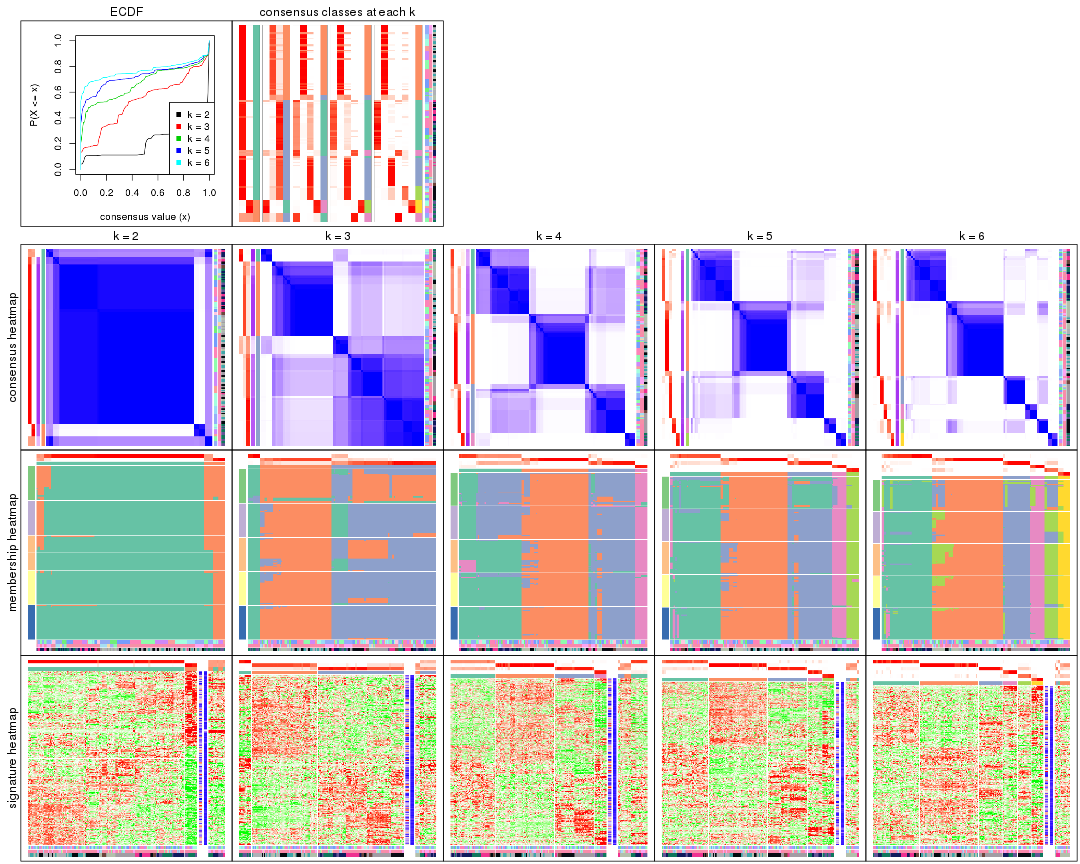
The plots are:
k and the heatmap of
predicted classes for each k.k.k.k.All the plots in panels can be made by individual functions and they are plotted later in this section.
select_partition_number() produces several plots showing different
statistics for choosing “optimized” k. There are following statistics:
k;k, the area increased is defined as \(A_k - A_{k-1}\).The detailed explanations of these statistics can be found in the cola vignette.
Generally speaking, lower PAC score, higher mean silhouette score or higher
concordance corresponds to better partition. Rand index and Jaccard index
measure how similar the current partition is compared to partition with k-1.
If they are too similar, we won't accept k is better than k-1.
select_partition_number(res)
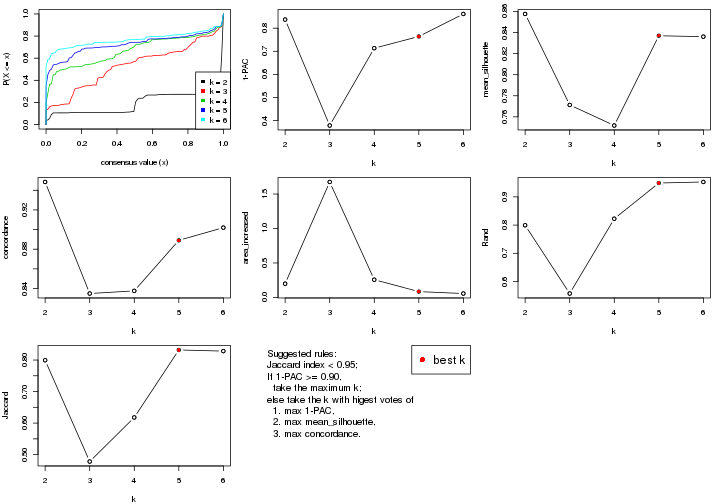
The numeric values for all these statistics can be obtained by get_stats().
get_stats(res)
#> k 1-PAC mean_silhouette concordance area_increased Rand Jaccard
#> 2 2 0.837 0.858 0.948 0.1994 0.799 0.799
#> 3 3 0.378 0.771 0.835 1.6748 0.558 0.478
#> 4 4 0.713 0.752 0.838 0.2572 0.822 0.618
#> 5 5 0.764 0.837 0.889 0.0844 0.949 0.832
#> 6 6 0.862 0.836 0.902 0.0568 0.953 0.828
suggest_best_k() suggests the best \(k\) based on these statistics. The rules are as follows:
suggest_best_k(res)
#> [1] 5
Following shows the table of the partitions (You need to click the show/hide
code output link to see it). The membership matrix (columns with name p*)
is inferred by
clue::cl_consensus()
function with the SE method. Basically the value in the membership matrix
represents the probability to belong to a certain group. The finall class
label for an item is determined with the group with highest probability it
belongs to.
In get_classes() function, the entropy is calculated from the membership
matrix and the silhouette score is calculated from the consensus matrix.
cbind(get_classes(res, k = 2), get_membership(res, k = 2))
#> class entropy silhouette p1 p2
#> GSM528681 1 0.0000 0.959 1.000 0.000
#> GSM528682 1 0.0000 0.959 1.000 0.000
#> GSM528683 1 0.0000 0.959 1.000 0.000
#> GSM528684 1 0.0000 0.959 1.000 0.000
#> GSM528687 1 0.0000 0.959 1.000 0.000
#> GSM528688 1 0.0000 0.959 1.000 0.000
#> GSM528685 1 0.0000 0.959 1.000 0.000
#> GSM528686 1 0.0000 0.959 1.000 0.000
#> GSM528693 1 0.5408 0.796 0.876 0.124
#> GSM528694 1 0.5408 0.796 0.876 0.124
#> GSM528695 1 0.5737 0.776 0.864 0.136
#> GSM528696 1 0.5737 0.776 0.864 0.136
#> GSM528697 1 0.9933 -0.208 0.548 0.452
#> GSM528698 1 0.9933 -0.208 0.548 0.452
#> GSM528699 1 1.0000 -0.364 0.504 0.496
#> GSM528700 1 1.0000 -0.364 0.504 0.496
#> GSM528689 2 1.0000 0.352 0.496 0.504
#> GSM528690 2 1.0000 0.352 0.496 0.504
#> GSM528691 2 1.0000 0.352 0.496 0.504
#> GSM528692 2 1.0000 0.352 0.496 0.504
#> GSM528779 1 0.0000 0.959 1.000 0.000
#> GSM528780 1 0.0000 0.959 1.000 0.000
#> GSM528782 1 0.0000 0.959 1.000 0.000
#> GSM528781 1 0.0000 0.959 1.000 0.000
#> GSM528785 1 0.0000 0.959 1.000 0.000
#> GSM528786 1 0.0000 0.959 1.000 0.000
#> GSM528787 1 0.0000 0.959 1.000 0.000
#> GSM528788 1 0.0938 0.953 0.988 0.012
#> GSM528783 1 0.2423 0.925 0.960 0.040
#> GSM528784 2 0.1633 0.753 0.024 0.976
#> GSM528759 1 0.0938 0.953 0.988 0.012
#> GSM528760 1 0.0938 0.953 0.988 0.012
#> GSM528761 1 0.0000 0.959 1.000 0.000
#> GSM528762 1 0.0000 0.959 1.000 0.000
#> GSM528765 1 0.0000 0.959 1.000 0.000
#> GSM528766 1 0.0000 0.959 1.000 0.000
#> GSM528763 1 0.0000 0.959 1.000 0.000
#> GSM528764 1 0.0000 0.959 1.000 0.000
#> GSM528771 1 0.0000 0.959 1.000 0.000
#> GSM528772 1 0.0000 0.959 1.000 0.000
#> GSM528773 1 0.0000 0.959 1.000 0.000
#> GSM528774 1 0.0000 0.959 1.000 0.000
#> GSM528775 1 0.0000 0.959 1.000 0.000
#> GSM528776 1 0.0938 0.953 0.988 0.012
#> GSM528777 1 0.0938 0.953 0.988 0.012
#> GSM528778 1 0.0938 0.953 0.988 0.012
#> GSM528767 2 0.1633 0.753 0.024 0.976
#> GSM528768 2 0.1633 0.753 0.024 0.976
#> GSM528769 2 0.1633 0.753 0.024 0.976
#> GSM528770 2 0.1633 0.753 0.024 0.976
#> GSM528671 1 0.0000 0.959 1.000 0.000
#> GSM528672 1 0.0000 0.959 1.000 0.000
#> GSM528674 1 0.0000 0.959 1.000 0.000
#> GSM528673 1 0.0000 0.959 1.000 0.000
#> GSM528677 1 0.0000 0.959 1.000 0.000
#> GSM528678 1 0.0000 0.959 1.000 0.000
#> GSM528679 1 0.0938 0.953 0.988 0.012
#> GSM528680 1 0.9896 -0.161 0.560 0.440
#> GSM528675 2 0.0000 0.751 0.000 1.000
#> GSM528676 2 0.0000 0.751 0.000 1.000
#> GSM528651 1 0.0000 0.959 1.000 0.000
#> GSM528652 1 0.0000 0.959 1.000 0.000
#> GSM528653 1 0.0000 0.959 1.000 0.000
#> GSM528654 1 0.0000 0.959 1.000 0.000
#> GSM528657 1 0.0000 0.959 1.000 0.000
#> GSM528658 1 0.0000 0.959 1.000 0.000
#> GSM528655 1 0.0000 0.959 1.000 0.000
#> GSM528656 1 0.0000 0.959 1.000 0.000
#> GSM528663 1 0.0000 0.959 1.000 0.000
#> GSM528664 1 0.0000 0.959 1.000 0.000
#> GSM528665 1 0.0000 0.959 1.000 0.000
#> GSM528666 1 0.0000 0.959 1.000 0.000
#> GSM528667 1 0.0938 0.953 0.988 0.012
#> GSM528668 1 0.0938 0.953 0.988 0.012
#> GSM528669 1 0.0938 0.953 0.988 0.012
#> GSM528670 1 0.0938 0.953 0.988 0.012
#> GSM528659 2 0.0000 0.751 0.000 1.000
#> GSM528660 2 0.0000 0.751 0.000 1.000
#> GSM528661 2 0.0000 0.751 0.000 1.000
#> GSM528662 2 0.0000 0.751 0.000 1.000
#> GSM528701 1 0.0000 0.959 1.000 0.000
#> GSM528702 1 0.0000 0.959 1.000 0.000
#> GSM528703 1 0.0000 0.959 1.000 0.000
#> GSM528704 1 0.0000 0.959 1.000 0.000
#> GSM528707 1 0.0000 0.959 1.000 0.000
#> GSM528708 1 0.0000 0.959 1.000 0.000
#> GSM528705 1 0.0000 0.959 1.000 0.000
#> GSM528706 1 0.0000 0.959 1.000 0.000
#> GSM528713 1 0.0000 0.959 1.000 0.000
#> GSM528714 1 0.0000 0.959 1.000 0.000
#> GSM528715 1 0.0000 0.959 1.000 0.000
#> GSM528716 1 0.0000 0.959 1.000 0.000
#> GSM528717 1 0.5737 0.785 0.864 0.136
#> GSM528718 1 0.5737 0.785 0.864 0.136
#> GSM528719 1 1.0000 -0.364 0.504 0.496
#> GSM528720 1 1.0000 -0.364 0.504 0.496
#> GSM528709 2 1.0000 0.352 0.496 0.504
#> GSM528710 2 1.0000 0.352 0.496 0.504
#> GSM528711 2 1.0000 0.352 0.496 0.504
#> GSM528712 2 1.0000 0.352 0.496 0.504
#> GSM528721 1 0.0000 0.959 1.000 0.000
#> GSM528722 1 0.0000 0.959 1.000 0.000
#> GSM528723 1 0.0000 0.959 1.000 0.000
#> GSM528724 1 0.0000 0.959 1.000 0.000
#> GSM528727 1 0.0000 0.959 1.000 0.000
#> GSM528728 1 0.0000 0.959 1.000 0.000
#> GSM528725 1 0.0000 0.959 1.000 0.000
#> GSM528726 1 0.0000 0.959 1.000 0.000
#> GSM528733 1 0.0000 0.959 1.000 0.000
#> GSM528734 1 0.0000 0.959 1.000 0.000
#> GSM528735 1 0.0938 0.953 0.988 0.012
#> GSM528736 1 0.0938 0.953 0.988 0.012
#> GSM528737 1 0.0938 0.953 0.988 0.012
#> GSM528738 1 0.0938 0.953 0.988 0.012
#> GSM528729 1 0.0938 0.953 0.988 0.012
#> GSM528730 1 0.0938 0.953 0.988 0.012
#> GSM528731 1 0.0938 0.953 0.988 0.012
#> GSM528732 1 0.0938 0.953 0.988 0.012
#> GSM528739 1 0.0000 0.959 1.000 0.000
#> GSM528740 1 0.0000 0.959 1.000 0.000
#> GSM528741 1 0.0000 0.959 1.000 0.000
#> GSM528742 1 0.0000 0.959 1.000 0.000
#> GSM528745 1 0.0000 0.959 1.000 0.000
#> GSM528746 1 0.0000 0.959 1.000 0.000
#> GSM528743 1 0.0000 0.959 1.000 0.000
#> GSM528744 1 0.0000 0.959 1.000 0.000
#> GSM528751 1 0.0000 0.959 1.000 0.000
#> GSM528752 1 0.0000 0.959 1.000 0.000
#> GSM528753 1 0.0000 0.959 1.000 0.000
#> GSM528754 1 0.0000 0.959 1.000 0.000
#> GSM528755 1 0.0376 0.957 0.996 0.004
#> GSM528756 1 0.0376 0.957 0.996 0.004
#> GSM528757 1 0.0938 0.953 0.988 0.012
#> GSM528758 1 0.0938 0.953 0.988 0.012
#> GSM528747 1 0.0938 0.953 0.988 0.012
#> GSM528748 1 0.0938 0.953 0.988 0.012
#> GSM528749 1 0.0938 0.953 0.988 0.012
#> GSM528750 1 0.0938 0.953 0.988 0.012
#> GSM528640 1 0.0000 0.959 1.000 0.000
#> GSM528641 1 0.0000 0.959 1.000 0.000
#> GSM528643 1 0.0000 0.959 1.000 0.000
#> GSM528644 1 0.0938 0.953 0.988 0.012
#> GSM528642 1 0.0938 0.953 0.988 0.012
#> GSM528620 1 0.0000 0.959 1.000 0.000
#> GSM528621 1 0.0000 0.959 1.000 0.000
#> GSM528623 1 0.0000 0.959 1.000 0.000
#> GSM528624 1 0.0938 0.953 0.988 0.012
#> GSM528622 1 0.0938 0.953 0.988 0.012
#> GSM528625 1 0.0000 0.959 1.000 0.000
#> GSM528626 1 0.0000 0.959 1.000 0.000
#> GSM528628 1 0.0000 0.959 1.000 0.000
#> GSM528629 1 0.0938 0.953 0.988 0.012
#> GSM528627 1 0.0938 0.953 0.988 0.012
#> GSM528630 1 0.0000 0.959 1.000 0.000
#> GSM528631 1 0.0000 0.959 1.000 0.000
#> GSM528632 1 0.0000 0.959 1.000 0.000
#> GSM528633 1 0.0000 0.959 1.000 0.000
#> GSM528636 1 0.0000 0.959 1.000 0.000
#> GSM528637 1 0.0000 0.959 1.000 0.000
#> GSM528638 1 0.0938 0.953 0.988 0.012
#> GSM528639 1 0.0938 0.953 0.988 0.012
#> GSM528634 1 0.0938 0.953 0.988 0.012
#> GSM528635 1 0.0938 0.953 0.988 0.012
#> GSM528645 1 0.0000 0.959 1.000 0.000
#> GSM528646 1 0.0000 0.959 1.000 0.000
#> GSM528647 1 0.0000 0.959 1.000 0.000
#> GSM528648 1 0.0938 0.953 0.988 0.012
#> GSM528649 1 0.0938 0.953 0.988 0.012
#> GSM528650 1 0.0938 0.953 0.988 0.012
cbind(get_classes(res, k = 3), get_membership(res, k = 3))
#> class entropy silhouette p1 p2 p3
#> GSM528681 2 0.3412 0.931 0.000 0.876 0.124
#> GSM528682 2 0.3412 0.931 0.000 0.876 0.124
#> GSM528683 2 0.3412 0.931 0.000 0.876 0.124
#> GSM528684 2 0.3412 0.931 0.000 0.876 0.124
#> GSM528687 2 0.3412 0.931 0.000 0.876 0.124
#> GSM528688 2 0.3412 0.931 0.000 0.876 0.124
#> GSM528685 2 0.5760 0.706 0.000 0.672 0.328
#> GSM528686 2 0.5760 0.706 0.000 0.672 0.328
#> GSM528693 3 0.5465 0.727 0.000 0.288 0.712
#> GSM528694 3 0.5465 0.727 0.000 0.288 0.712
#> GSM528695 3 0.5848 0.724 0.012 0.268 0.720
#> GSM528696 3 0.5848 0.724 0.012 0.268 0.720
#> GSM528697 3 0.8625 0.263 0.316 0.124 0.560
#> GSM528698 3 0.8625 0.263 0.316 0.124 0.560
#> GSM528699 3 0.8772 0.178 0.364 0.120 0.516
#> GSM528700 3 0.8772 0.178 0.364 0.120 0.516
#> GSM528689 3 0.8796 0.165 0.372 0.120 0.508
#> GSM528690 3 0.8796 0.165 0.372 0.120 0.508
#> GSM528691 3 0.8796 0.165 0.372 0.120 0.508
#> GSM528692 3 0.8796 0.165 0.372 0.120 0.508
#> GSM528779 2 0.3412 0.931 0.000 0.876 0.124
#> GSM528780 2 0.3412 0.931 0.000 0.876 0.124
#> GSM528782 2 0.3412 0.931 0.000 0.876 0.124
#> GSM528781 2 0.4504 0.877 0.000 0.804 0.196
#> GSM528785 3 0.4654 0.695 0.000 0.208 0.792
#> GSM528786 3 0.4002 0.748 0.000 0.160 0.840
#> GSM528787 3 0.3551 0.766 0.000 0.132 0.868
#> GSM528788 3 0.1289 0.810 0.000 0.032 0.968
#> GSM528783 3 0.2443 0.801 0.028 0.032 0.940
#> GSM528784 1 0.1267 0.985 0.972 0.004 0.024
#> GSM528759 3 0.0424 0.812 0.000 0.008 0.992
#> GSM528760 3 0.0424 0.812 0.000 0.008 0.992
#> GSM528761 2 0.3412 0.931 0.000 0.876 0.124
#> GSM528762 2 0.3412 0.931 0.000 0.876 0.124
#> GSM528765 2 0.3412 0.931 0.000 0.876 0.124
#> GSM528766 2 0.3412 0.931 0.000 0.876 0.124
#> GSM528763 2 0.5363 0.783 0.000 0.724 0.276
#> GSM528764 2 0.5621 0.737 0.000 0.692 0.308
#> GSM528771 3 0.4654 0.695 0.000 0.208 0.792
#> GSM528772 3 0.4654 0.695 0.000 0.208 0.792
#> GSM528773 3 0.4002 0.748 0.000 0.160 0.840
#> GSM528774 3 0.4002 0.748 0.000 0.160 0.840
#> GSM528775 3 0.3551 0.766 0.000 0.132 0.868
#> GSM528776 3 0.0000 0.809 0.000 0.000 1.000
#> GSM528777 3 0.1031 0.809 0.000 0.024 0.976
#> GSM528778 3 0.1031 0.809 0.000 0.024 0.976
#> GSM528767 1 0.1267 0.985 0.972 0.004 0.024
#> GSM528768 1 0.1267 0.985 0.972 0.004 0.024
#> GSM528769 1 0.1267 0.985 0.972 0.004 0.024
#> GSM528770 1 0.1267 0.985 0.972 0.004 0.024
#> GSM528671 2 0.4235 0.896 0.000 0.824 0.176
#> GSM528672 2 0.3412 0.931 0.000 0.876 0.124
#> GSM528674 2 0.3412 0.931 0.000 0.876 0.124
#> GSM528673 2 0.5760 0.706 0.000 0.672 0.328
#> GSM528677 3 0.4654 0.695 0.000 0.208 0.792
#> GSM528678 3 0.4002 0.748 0.000 0.160 0.840
#> GSM528679 3 0.0424 0.812 0.000 0.008 0.992
#> GSM528680 3 0.8526 0.275 0.308 0.120 0.572
#> GSM528675 1 0.0000 0.988 1.000 0.000 0.000
#> GSM528676 1 0.0000 0.988 1.000 0.000 0.000
#> GSM528651 2 0.4235 0.896 0.000 0.824 0.176
#> GSM528652 2 0.4235 0.896 0.000 0.824 0.176
#> GSM528653 2 0.3412 0.931 0.000 0.876 0.124
#> GSM528654 2 0.3412 0.931 0.000 0.876 0.124
#> GSM528657 2 0.3412 0.931 0.000 0.876 0.124
#> GSM528658 2 0.3412 0.931 0.000 0.876 0.124
#> GSM528655 2 0.5760 0.706 0.000 0.672 0.328
#> GSM528656 2 0.5760 0.706 0.000 0.672 0.328
#> GSM528663 3 0.4654 0.695 0.000 0.208 0.792
#> GSM528664 3 0.4654 0.695 0.000 0.208 0.792
#> GSM528665 3 0.4002 0.748 0.000 0.160 0.840
#> GSM528666 3 0.4002 0.748 0.000 0.160 0.840
#> GSM528667 3 0.0424 0.812 0.000 0.008 0.992
#> GSM528668 3 0.0424 0.812 0.000 0.008 0.992
#> GSM528669 3 0.1031 0.809 0.000 0.024 0.976
#> GSM528670 3 0.1031 0.809 0.000 0.024 0.976
#> GSM528659 1 0.0000 0.988 1.000 0.000 0.000
#> GSM528660 1 0.0000 0.988 1.000 0.000 0.000
#> GSM528661 1 0.0000 0.988 1.000 0.000 0.000
#> GSM528662 1 0.0000 0.988 1.000 0.000 0.000
#> GSM528701 2 0.3412 0.931 0.000 0.876 0.124
#> GSM528702 2 0.3412 0.931 0.000 0.876 0.124
#> GSM528703 2 0.3412 0.931 0.000 0.876 0.124
#> GSM528704 2 0.3412 0.931 0.000 0.876 0.124
#> GSM528707 2 0.3412 0.931 0.000 0.876 0.124
#> GSM528708 2 0.3412 0.931 0.000 0.876 0.124
#> GSM528705 2 0.3482 0.929 0.000 0.872 0.128
#> GSM528706 2 0.3482 0.929 0.000 0.872 0.128
#> GSM528713 3 0.4654 0.695 0.000 0.208 0.792
#> GSM528714 3 0.4654 0.695 0.000 0.208 0.792
#> GSM528715 3 0.4002 0.748 0.000 0.160 0.840
#> GSM528716 3 0.4002 0.748 0.000 0.160 0.840
#> GSM528717 3 0.3412 0.691 0.000 0.124 0.876
#> GSM528718 3 0.3412 0.691 0.000 0.124 0.876
#> GSM528719 3 0.8772 0.178 0.364 0.120 0.516
#> GSM528720 3 0.8772 0.178 0.364 0.120 0.516
#> GSM528709 3 0.8796 0.165 0.372 0.120 0.508
#> GSM528710 3 0.8796 0.165 0.372 0.120 0.508
#> GSM528711 3 0.8796 0.165 0.372 0.120 0.508
#> GSM528712 3 0.8796 0.165 0.372 0.120 0.508
#> GSM528721 2 0.3412 0.931 0.000 0.876 0.124
#> GSM528722 2 0.3412 0.931 0.000 0.876 0.124
#> GSM528723 2 0.3412 0.931 0.000 0.876 0.124
#> GSM528724 2 0.3412 0.931 0.000 0.876 0.124
#> GSM528727 2 0.3412 0.931 0.000 0.876 0.124
#> GSM528728 2 0.3412 0.931 0.000 0.876 0.124
#> GSM528725 2 0.3482 0.929 0.000 0.872 0.128
#> GSM528726 2 0.3482 0.929 0.000 0.872 0.128
#> GSM528733 3 0.4002 0.748 0.000 0.160 0.840
#> GSM528734 3 0.4002 0.748 0.000 0.160 0.840
#> GSM528735 3 0.0424 0.812 0.000 0.008 0.992
#> GSM528736 3 0.0424 0.812 0.000 0.008 0.992
#> GSM528737 3 0.0424 0.812 0.000 0.008 0.992
#> GSM528738 3 0.0424 0.812 0.000 0.008 0.992
#> GSM528729 3 0.1031 0.809 0.000 0.024 0.976
#> GSM528730 3 0.1031 0.809 0.000 0.024 0.976
#> GSM528731 3 0.1289 0.810 0.000 0.032 0.968
#> GSM528732 3 0.1289 0.810 0.000 0.032 0.968
#> GSM528739 2 0.3412 0.931 0.000 0.876 0.124
#> GSM528740 2 0.3412 0.931 0.000 0.876 0.124
#> GSM528741 2 0.3412 0.931 0.000 0.876 0.124
#> GSM528742 2 0.3412 0.931 0.000 0.876 0.124
#> GSM528745 2 0.4235 0.896 0.000 0.824 0.176
#> GSM528746 2 0.3412 0.931 0.000 0.876 0.124
#> GSM528743 2 0.4121 0.902 0.000 0.832 0.168
#> GSM528744 2 0.3619 0.925 0.000 0.864 0.136
#> GSM528751 3 0.4654 0.695 0.000 0.208 0.792
#> GSM528752 3 0.4654 0.695 0.000 0.208 0.792
#> GSM528753 3 0.4002 0.748 0.000 0.160 0.840
#> GSM528754 3 0.4002 0.748 0.000 0.160 0.840
#> GSM528755 3 0.1289 0.809 0.000 0.032 0.968
#> GSM528756 3 0.1289 0.809 0.000 0.032 0.968
#> GSM528757 3 0.1289 0.810 0.000 0.032 0.968
#> GSM528758 3 0.1289 0.810 0.000 0.032 0.968
#> GSM528747 3 0.1289 0.810 0.000 0.032 0.968
#> GSM528748 3 0.1289 0.810 0.000 0.032 0.968
#> GSM528749 3 0.1289 0.810 0.000 0.032 0.968
#> GSM528750 3 0.1289 0.810 0.000 0.032 0.968
#> GSM528640 2 0.3412 0.931 0.000 0.876 0.124
#> GSM528641 2 0.5760 0.706 0.000 0.672 0.328
#> GSM528643 3 0.4002 0.748 0.000 0.160 0.840
#> GSM528644 3 0.1289 0.810 0.000 0.032 0.968
#> GSM528642 3 0.1289 0.810 0.000 0.032 0.968
#> GSM528620 2 0.3412 0.931 0.000 0.876 0.124
#> GSM528621 2 0.6244 0.463 0.000 0.560 0.440
#> GSM528623 3 0.4002 0.748 0.000 0.160 0.840
#> GSM528624 3 0.1031 0.809 0.000 0.024 0.976
#> GSM528622 3 0.0424 0.812 0.000 0.008 0.992
#> GSM528625 2 0.3412 0.931 0.000 0.876 0.124
#> GSM528626 2 0.6244 0.463 0.000 0.560 0.440
#> GSM528628 3 0.4002 0.748 0.000 0.160 0.840
#> GSM528629 3 0.1289 0.810 0.000 0.032 0.968
#> GSM528627 3 0.0424 0.812 0.000 0.008 0.992
#> GSM528630 2 0.3412 0.931 0.000 0.876 0.124
#> GSM528631 2 0.4504 0.877 0.000 0.804 0.196
#> GSM528632 2 0.6244 0.463 0.000 0.560 0.440
#> GSM528633 2 0.6244 0.463 0.000 0.560 0.440
#> GSM528636 3 0.4002 0.748 0.000 0.160 0.840
#> GSM528637 3 0.4002 0.748 0.000 0.160 0.840
#> GSM528638 3 0.1031 0.809 0.000 0.024 0.976
#> GSM528639 3 0.1031 0.809 0.000 0.024 0.976
#> GSM528634 3 0.0424 0.812 0.000 0.008 0.992
#> GSM528635 3 0.0424 0.812 0.000 0.008 0.992
#> GSM528645 3 0.4002 0.748 0.000 0.160 0.840
#> GSM528646 3 0.4002 0.748 0.000 0.160 0.840
#> GSM528647 3 0.4002 0.748 0.000 0.160 0.840
#> GSM528648 3 0.0424 0.812 0.000 0.008 0.992
#> GSM528649 3 0.0424 0.812 0.000 0.008 0.992
#> GSM528650 3 0.0424 0.812 0.000 0.008 0.992
cbind(get_classes(res, k = 4), get_membership(res, k = 4))
#> class entropy silhouette p1 p2 p3 p4
#> GSM528681 2 0.0000 0.9234 0.000 1.000 0.000 0.000
#> GSM528682 2 0.0000 0.9234 0.000 1.000 0.000 0.000
#> GSM528683 2 0.0000 0.9234 0.000 1.000 0.000 0.000
#> GSM528684 2 0.0000 0.9234 0.000 1.000 0.000 0.000
#> GSM528687 2 0.0000 0.9234 0.000 1.000 0.000 0.000
#> GSM528688 2 0.0000 0.9234 0.000 1.000 0.000 0.000
#> GSM528685 2 0.4888 0.3183 0.000 0.588 0.412 0.000
#> GSM528686 2 0.4888 0.3183 0.000 0.588 0.412 0.000
#> GSM528693 3 0.3544 0.6995 0.128 0.008 0.852 0.012
#> GSM528694 3 0.3544 0.6995 0.128 0.008 0.852 0.012
#> GSM528695 3 0.3208 0.6878 0.148 0.000 0.848 0.004
#> GSM528696 3 0.3208 0.6878 0.148 0.000 0.848 0.004
#> GSM528697 1 0.2443 0.4724 0.916 0.000 0.024 0.060
#> GSM528698 1 0.2443 0.4724 0.916 0.000 0.024 0.060
#> GSM528699 1 0.2149 0.4264 0.912 0.000 0.000 0.088
#> GSM528700 1 0.2149 0.4264 0.912 0.000 0.000 0.088
#> GSM528689 1 0.2480 0.4184 0.904 0.000 0.008 0.088
#> GSM528690 1 0.2480 0.4184 0.904 0.000 0.008 0.088
#> GSM528691 1 0.2480 0.4184 0.904 0.000 0.008 0.088
#> GSM528692 1 0.2480 0.4184 0.904 0.000 0.008 0.088
#> GSM528779 2 0.0000 0.9234 0.000 1.000 0.000 0.000
#> GSM528780 2 0.0000 0.9234 0.000 1.000 0.000 0.000
#> GSM528782 2 0.0000 0.9234 0.000 1.000 0.000 0.000
#> GSM528781 2 0.2589 0.8369 0.000 0.884 0.116 0.000
#> GSM528785 3 0.1557 0.8219 0.000 0.056 0.944 0.000
#> GSM528786 3 0.0657 0.8371 0.004 0.012 0.984 0.000
#> GSM528787 3 0.3377 0.6243 0.140 0.012 0.848 0.000
#> GSM528788 1 0.5781 0.7503 0.584 0.036 0.380 0.000
#> GSM528783 1 0.6517 0.7332 0.580 0.036 0.356 0.028
#> GSM528784 4 0.0657 0.9835 0.012 0.000 0.004 0.984
#> GSM528759 1 0.5119 0.7045 0.556 0.004 0.440 0.000
#> GSM528760 1 0.5119 0.7045 0.556 0.004 0.440 0.000
#> GSM528761 2 0.0000 0.9234 0.000 1.000 0.000 0.000
#> GSM528762 2 0.0000 0.9234 0.000 1.000 0.000 0.000
#> GSM528765 2 0.0000 0.9234 0.000 1.000 0.000 0.000
#> GSM528766 2 0.0000 0.9234 0.000 1.000 0.000 0.000
#> GSM528763 2 0.4222 0.6281 0.000 0.728 0.272 0.000
#> GSM528764 2 0.4431 0.5766 0.000 0.696 0.304 0.000
#> GSM528771 3 0.1557 0.8219 0.000 0.056 0.944 0.000
#> GSM528772 3 0.1557 0.8219 0.000 0.056 0.944 0.000
#> GSM528773 3 0.0657 0.8371 0.004 0.012 0.984 0.000
#> GSM528774 3 0.0657 0.8371 0.004 0.012 0.984 0.000
#> GSM528775 3 0.3377 0.6243 0.140 0.012 0.848 0.000
#> GSM528776 1 0.5183 0.7362 0.584 0.008 0.408 0.000
#> GSM528777 1 0.5686 0.7520 0.592 0.032 0.376 0.000
#> GSM528778 1 0.5686 0.7520 0.592 0.032 0.376 0.000
#> GSM528767 4 0.0657 0.9835 0.012 0.000 0.004 0.984
#> GSM528768 4 0.0657 0.9835 0.012 0.000 0.004 0.984
#> GSM528769 4 0.0657 0.9835 0.012 0.000 0.004 0.984
#> GSM528770 4 0.0657 0.9835 0.012 0.000 0.004 0.984
#> GSM528671 2 0.1867 0.8758 0.000 0.928 0.072 0.000
#> GSM528672 2 0.0000 0.9234 0.000 1.000 0.000 0.000
#> GSM528674 2 0.0000 0.9234 0.000 1.000 0.000 0.000
#> GSM528673 2 0.4888 0.3183 0.000 0.588 0.412 0.000
#> GSM528677 3 0.1557 0.8219 0.000 0.056 0.944 0.000
#> GSM528678 3 0.0657 0.8371 0.004 0.012 0.984 0.000
#> GSM528679 1 0.5080 0.7301 0.576 0.004 0.420 0.000
#> GSM528680 1 0.3308 0.4668 0.872 0.000 0.036 0.092
#> GSM528675 4 0.0817 0.9862 0.024 0.000 0.000 0.976
#> GSM528676 4 0.0817 0.9862 0.024 0.000 0.000 0.976
#> GSM528651 2 0.1867 0.8758 0.000 0.928 0.072 0.000
#> GSM528652 2 0.1867 0.8758 0.000 0.928 0.072 0.000
#> GSM528653 2 0.0000 0.9234 0.000 1.000 0.000 0.000
#> GSM528654 2 0.0000 0.9234 0.000 1.000 0.000 0.000
#> GSM528657 2 0.0000 0.9234 0.000 1.000 0.000 0.000
#> GSM528658 2 0.0000 0.9234 0.000 1.000 0.000 0.000
#> GSM528655 2 0.4888 0.3183 0.000 0.588 0.412 0.000
#> GSM528656 2 0.4888 0.3183 0.000 0.588 0.412 0.000
#> GSM528663 3 0.1557 0.8219 0.000 0.056 0.944 0.000
#> GSM528664 3 0.1557 0.8219 0.000 0.056 0.944 0.000
#> GSM528665 3 0.0657 0.8371 0.004 0.012 0.984 0.000
#> GSM528666 3 0.0657 0.8371 0.004 0.012 0.984 0.000
#> GSM528667 1 0.5080 0.7301 0.576 0.004 0.420 0.000
#> GSM528668 1 0.5080 0.7301 0.576 0.004 0.420 0.000
#> GSM528669 1 0.5686 0.7520 0.592 0.032 0.376 0.000
#> GSM528670 1 0.5686 0.7520 0.592 0.032 0.376 0.000
#> GSM528659 4 0.0817 0.9862 0.024 0.000 0.000 0.976
#> GSM528660 4 0.0817 0.9862 0.024 0.000 0.000 0.976
#> GSM528661 4 0.0817 0.9862 0.024 0.000 0.000 0.976
#> GSM528662 4 0.0817 0.9862 0.024 0.000 0.000 0.976
#> GSM528701 2 0.0000 0.9234 0.000 1.000 0.000 0.000
#> GSM528702 2 0.0000 0.9234 0.000 1.000 0.000 0.000
#> GSM528703 2 0.0000 0.9234 0.000 1.000 0.000 0.000
#> GSM528704 2 0.0000 0.9234 0.000 1.000 0.000 0.000
#> GSM528707 2 0.0000 0.9234 0.000 1.000 0.000 0.000
#> GSM528708 2 0.0000 0.9234 0.000 1.000 0.000 0.000
#> GSM528705 2 0.0188 0.9213 0.000 0.996 0.004 0.000
#> GSM528706 2 0.0188 0.9213 0.000 0.996 0.004 0.000
#> GSM528713 3 0.1557 0.8219 0.000 0.056 0.944 0.000
#> GSM528714 3 0.1557 0.8219 0.000 0.056 0.944 0.000
#> GSM528715 3 0.0657 0.8371 0.004 0.012 0.984 0.000
#> GSM528716 3 0.0657 0.8371 0.004 0.012 0.984 0.000
#> GSM528717 1 0.4744 0.6735 0.704 0.000 0.284 0.012
#> GSM528718 1 0.4744 0.6735 0.704 0.000 0.284 0.012
#> GSM528719 1 0.2149 0.4264 0.912 0.000 0.000 0.088
#> GSM528720 1 0.2149 0.4264 0.912 0.000 0.000 0.088
#> GSM528709 1 0.2480 0.4184 0.904 0.000 0.008 0.088
#> GSM528710 1 0.2480 0.4184 0.904 0.000 0.008 0.088
#> GSM528711 1 0.2480 0.4184 0.904 0.000 0.008 0.088
#> GSM528712 1 0.2480 0.4184 0.904 0.000 0.008 0.088
#> GSM528721 2 0.0000 0.9234 0.000 1.000 0.000 0.000
#> GSM528722 2 0.0000 0.9234 0.000 1.000 0.000 0.000
#> GSM528723 2 0.0000 0.9234 0.000 1.000 0.000 0.000
#> GSM528724 2 0.0000 0.9234 0.000 1.000 0.000 0.000
#> GSM528727 2 0.0000 0.9234 0.000 1.000 0.000 0.000
#> GSM528728 2 0.0000 0.9234 0.000 1.000 0.000 0.000
#> GSM528725 2 0.0188 0.9213 0.000 0.996 0.004 0.000
#> GSM528726 2 0.0188 0.9213 0.000 0.996 0.004 0.000
#> GSM528733 3 0.0657 0.8371 0.004 0.012 0.984 0.000
#> GSM528734 3 0.0657 0.8371 0.004 0.012 0.984 0.000
#> GSM528735 1 0.5080 0.7301 0.576 0.004 0.420 0.000
#> GSM528736 1 0.5080 0.7301 0.576 0.004 0.420 0.000
#> GSM528737 1 0.5080 0.7301 0.576 0.004 0.420 0.000
#> GSM528738 1 0.5080 0.7301 0.576 0.004 0.420 0.000
#> GSM528729 1 0.5686 0.7520 0.592 0.032 0.376 0.000
#> GSM528730 1 0.5686 0.7520 0.592 0.032 0.376 0.000
#> GSM528731 1 0.5781 0.7503 0.584 0.036 0.380 0.000
#> GSM528732 1 0.5781 0.7503 0.584 0.036 0.380 0.000
#> GSM528739 2 0.0000 0.9234 0.000 1.000 0.000 0.000
#> GSM528740 2 0.0000 0.9234 0.000 1.000 0.000 0.000
#> GSM528741 2 0.0000 0.9234 0.000 1.000 0.000 0.000
#> GSM528742 2 0.0000 0.9234 0.000 1.000 0.000 0.000
#> GSM528745 2 0.2216 0.8583 0.000 0.908 0.092 0.000
#> GSM528746 2 0.0000 0.9234 0.000 1.000 0.000 0.000
#> GSM528743 2 0.2081 0.8648 0.000 0.916 0.084 0.000
#> GSM528744 2 0.0707 0.9115 0.000 0.980 0.020 0.000
#> GSM528751 3 0.1557 0.8219 0.000 0.056 0.944 0.000
#> GSM528752 3 0.1557 0.8219 0.000 0.056 0.944 0.000
#> GSM528753 3 0.0657 0.8371 0.004 0.012 0.984 0.000
#> GSM528754 3 0.0657 0.8371 0.004 0.012 0.984 0.000
#> GSM528755 3 0.4950 -0.2304 0.376 0.004 0.620 0.000
#> GSM528756 3 0.4950 -0.2304 0.376 0.004 0.620 0.000
#> GSM528757 1 0.5781 0.7503 0.584 0.036 0.380 0.000
#> GSM528758 1 0.5781 0.7503 0.584 0.036 0.380 0.000
#> GSM528747 1 0.5769 0.7506 0.588 0.036 0.376 0.000
#> GSM528748 1 0.5769 0.7506 0.588 0.036 0.376 0.000
#> GSM528749 1 0.5781 0.7503 0.584 0.036 0.380 0.000
#> GSM528750 1 0.5781 0.7503 0.584 0.036 0.380 0.000
#> GSM528640 2 0.0000 0.9234 0.000 1.000 0.000 0.000
#> GSM528641 2 0.4888 0.3183 0.000 0.588 0.412 0.000
#> GSM528643 3 0.0657 0.8371 0.004 0.012 0.984 0.000
#> GSM528644 1 0.5781 0.7503 0.584 0.036 0.380 0.000
#> GSM528642 1 0.5742 0.7484 0.596 0.036 0.368 0.000
#> GSM528620 2 0.0000 0.9234 0.000 1.000 0.000 0.000
#> GSM528621 3 0.4989 0.1064 0.000 0.472 0.528 0.000
#> GSM528623 3 0.0657 0.8371 0.004 0.012 0.984 0.000
#> GSM528624 1 0.5686 0.7520 0.592 0.032 0.376 0.000
#> GSM528622 1 0.5080 0.7301 0.576 0.004 0.420 0.000
#> GSM528625 2 0.0000 0.9234 0.000 1.000 0.000 0.000
#> GSM528626 3 0.4992 0.0923 0.000 0.476 0.524 0.000
#> GSM528628 3 0.0657 0.8371 0.004 0.012 0.984 0.000
#> GSM528629 1 0.5781 0.7503 0.584 0.036 0.380 0.000
#> GSM528627 1 0.5080 0.7301 0.576 0.004 0.420 0.000
#> GSM528630 2 0.0000 0.9234 0.000 1.000 0.000 0.000
#> GSM528631 2 0.2589 0.8375 0.000 0.884 0.116 0.000
#> GSM528632 3 0.4989 0.1064 0.000 0.472 0.528 0.000
#> GSM528633 3 0.4989 0.1064 0.000 0.472 0.528 0.000
#> GSM528636 3 0.0657 0.8371 0.004 0.012 0.984 0.000
#> GSM528637 3 0.0657 0.8371 0.004 0.012 0.984 0.000
#> GSM528638 1 0.5686 0.7520 0.592 0.032 0.376 0.000
#> GSM528639 1 0.5686 0.7520 0.592 0.032 0.376 0.000
#> GSM528634 1 0.5080 0.7301 0.576 0.004 0.420 0.000
#> GSM528635 1 0.5080 0.7301 0.576 0.004 0.420 0.000
#> GSM528645 3 0.0657 0.8371 0.004 0.012 0.984 0.000
#> GSM528646 3 0.0657 0.8371 0.004 0.012 0.984 0.000
#> GSM528647 3 0.0657 0.8371 0.004 0.012 0.984 0.000
#> GSM528648 1 0.5119 0.7045 0.556 0.004 0.440 0.000
#> GSM528649 1 0.5119 0.7045 0.556 0.004 0.440 0.000
#> GSM528650 1 0.5119 0.7045 0.556 0.004 0.440 0.000
cbind(get_classes(res, k = 5), get_membership(res, k = 5))
#> class entropy silhouette p1 p2 p3 p4 p5
#> GSM528681 2 0.0000 0.921 0.000 1.000 0.000 0.000 0.000
#> GSM528682 2 0.0000 0.921 0.000 1.000 0.000 0.000 0.000
#> GSM528683 2 0.0000 0.921 0.000 1.000 0.000 0.000 0.000
#> GSM528684 2 0.0000 0.921 0.000 1.000 0.000 0.000 0.000
#> GSM528687 2 0.0000 0.921 0.000 1.000 0.000 0.000 0.000
#> GSM528688 2 0.0000 0.921 0.000 1.000 0.000 0.000 0.000
#> GSM528685 2 0.4249 0.277 0.000 0.568 0.432 0.000 0.000
#> GSM528686 2 0.4249 0.277 0.000 0.568 0.432 0.000 0.000
#> GSM528693 3 0.2516 0.739 0.140 0.000 0.860 0.000 0.000
#> GSM528694 3 0.2516 0.739 0.140 0.000 0.860 0.000 0.000
#> GSM528695 3 0.3093 0.737 0.168 0.000 0.824 0.008 0.000
#> GSM528696 3 0.3093 0.737 0.168 0.000 0.824 0.008 0.000
#> GSM528697 1 0.4192 -0.102 0.596 0.000 0.000 0.404 0.000
#> GSM528698 1 0.4192 -0.102 0.596 0.000 0.000 0.404 0.000
#> GSM528699 4 0.2605 0.906 0.148 0.000 0.000 0.852 0.000
#> GSM528700 4 0.2605 0.906 0.148 0.000 0.000 0.852 0.000
#> GSM528689 4 0.0510 0.942 0.016 0.000 0.000 0.984 0.000
#> GSM528690 4 0.0510 0.942 0.016 0.000 0.000 0.984 0.000
#> GSM528691 4 0.0510 0.942 0.016 0.000 0.000 0.984 0.000
#> GSM528692 4 0.0510 0.942 0.016 0.000 0.000 0.984 0.000
#> GSM528779 2 0.0000 0.921 0.000 1.000 0.000 0.000 0.000
#> GSM528780 2 0.0000 0.921 0.000 1.000 0.000 0.000 0.000
#> GSM528782 2 0.0000 0.921 0.000 1.000 0.000 0.000 0.000
#> GSM528781 2 0.2280 0.832 0.000 0.880 0.120 0.000 0.000
#> GSM528785 3 0.0963 0.872 0.000 0.036 0.964 0.000 0.000
#> GSM528786 3 0.0703 0.886 0.024 0.000 0.976 0.000 0.000
#> GSM528787 3 0.2891 0.690 0.176 0.000 0.824 0.000 0.000
#> GSM528788 1 0.2660 0.907 0.864 0.008 0.128 0.000 0.000
#> GSM528783 1 0.6197 0.689 0.624 0.008 0.128 0.224 0.016
#> GSM528784 5 0.1419 0.972 0.016 0.000 0.012 0.016 0.956
#> GSM528759 1 0.3074 0.893 0.804 0.000 0.196 0.000 0.000
#> GSM528760 1 0.3074 0.893 0.804 0.000 0.196 0.000 0.000
#> GSM528761 2 0.0000 0.921 0.000 1.000 0.000 0.000 0.000
#> GSM528762 2 0.0000 0.921 0.000 1.000 0.000 0.000 0.000
#> GSM528765 2 0.0000 0.921 0.000 1.000 0.000 0.000 0.000
#> GSM528766 2 0.0000 0.921 0.000 1.000 0.000 0.000 0.000
#> GSM528763 2 0.3730 0.602 0.000 0.712 0.288 0.000 0.000
#> GSM528764 2 0.3895 0.546 0.000 0.680 0.320 0.000 0.000
#> GSM528771 3 0.0963 0.872 0.000 0.036 0.964 0.000 0.000
#> GSM528772 3 0.0963 0.872 0.000 0.036 0.964 0.000 0.000
#> GSM528773 3 0.0703 0.886 0.024 0.000 0.976 0.000 0.000
#> GSM528774 3 0.0703 0.886 0.024 0.000 0.976 0.000 0.000
#> GSM528775 3 0.2891 0.690 0.176 0.000 0.824 0.000 0.000
#> GSM528776 1 0.2848 0.906 0.840 0.004 0.156 0.000 0.000
#> GSM528777 1 0.2488 0.906 0.872 0.004 0.124 0.000 0.000
#> GSM528778 1 0.2488 0.906 0.872 0.004 0.124 0.000 0.000
#> GSM528767 5 0.1419 0.972 0.016 0.000 0.012 0.016 0.956
#> GSM528768 5 0.1419 0.972 0.016 0.000 0.012 0.016 0.956
#> GSM528769 5 0.1419 0.972 0.016 0.000 0.012 0.016 0.956
#> GSM528770 5 0.1419 0.972 0.016 0.000 0.012 0.016 0.956
#> GSM528671 2 0.1671 0.871 0.000 0.924 0.076 0.000 0.000
#> GSM528672 2 0.0000 0.921 0.000 1.000 0.000 0.000 0.000
#> GSM528674 2 0.0000 0.921 0.000 1.000 0.000 0.000 0.000
#> GSM528673 2 0.4249 0.277 0.000 0.568 0.432 0.000 0.000
#> GSM528677 3 0.0963 0.872 0.000 0.036 0.964 0.000 0.000
#> GSM528678 3 0.0703 0.886 0.024 0.000 0.976 0.000 0.000
#> GSM528679 1 0.2891 0.905 0.824 0.000 0.176 0.000 0.000
#> GSM528680 4 0.3630 0.845 0.204 0.000 0.016 0.780 0.000
#> GSM528675 5 0.0510 0.977 0.000 0.000 0.000 0.016 0.984
#> GSM528676 5 0.0510 0.977 0.000 0.000 0.000 0.016 0.984
#> GSM528651 2 0.1671 0.871 0.000 0.924 0.076 0.000 0.000
#> GSM528652 2 0.1671 0.871 0.000 0.924 0.076 0.000 0.000
#> GSM528653 2 0.0000 0.921 0.000 1.000 0.000 0.000 0.000
#> GSM528654 2 0.0000 0.921 0.000 1.000 0.000 0.000 0.000
#> GSM528657 2 0.0000 0.921 0.000 1.000 0.000 0.000 0.000
#> GSM528658 2 0.0000 0.921 0.000 1.000 0.000 0.000 0.000
#> GSM528655 2 0.4249 0.277 0.000 0.568 0.432 0.000 0.000
#> GSM528656 2 0.4249 0.277 0.000 0.568 0.432 0.000 0.000
#> GSM528663 3 0.0963 0.872 0.000 0.036 0.964 0.000 0.000
#> GSM528664 3 0.0963 0.872 0.000 0.036 0.964 0.000 0.000
#> GSM528665 3 0.0703 0.886 0.024 0.000 0.976 0.000 0.000
#> GSM528666 3 0.0703 0.886 0.024 0.000 0.976 0.000 0.000
#> GSM528667 1 0.2891 0.905 0.824 0.000 0.176 0.000 0.000
#> GSM528668 1 0.2891 0.905 0.824 0.000 0.176 0.000 0.000
#> GSM528669 1 0.2488 0.906 0.872 0.004 0.124 0.000 0.000
#> GSM528670 1 0.2488 0.906 0.872 0.004 0.124 0.000 0.000
#> GSM528659 5 0.0510 0.977 0.000 0.000 0.000 0.016 0.984
#> GSM528660 5 0.0510 0.977 0.000 0.000 0.000 0.016 0.984
#> GSM528661 5 0.0510 0.977 0.000 0.000 0.000 0.016 0.984
#> GSM528662 5 0.0510 0.977 0.000 0.000 0.000 0.016 0.984
#> GSM528701 2 0.0000 0.921 0.000 1.000 0.000 0.000 0.000
#> GSM528702 2 0.0000 0.921 0.000 1.000 0.000 0.000 0.000
#> GSM528703 2 0.0000 0.921 0.000 1.000 0.000 0.000 0.000
#> GSM528704 2 0.0000 0.921 0.000 1.000 0.000 0.000 0.000
#> GSM528707 2 0.0000 0.921 0.000 1.000 0.000 0.000 0.000
#> GSM528708 2 0.0000 0.921 0.000 1.000 0.000 0.000 0.000
#> GSM528705 2 0.0162 0.919 0.000 0.996 0.004 0.000 0.000
#> GSM528706 2 0.0162 0.919 0.000 0.996 0.004 0.000 0.000
#> GSM528713 3 0.0963 0.872 0.000 0.036 0.964 0.000 0.000
#> GSM528714 3 0.0963 0.872 0.000 0.036 0.964 0.000 0.000
#> GSM528715 3 0.0703 0.886 0.024 0.000 0.976 0.000 0.000
#> GSM528716 3 0.0703 0.886 0.024 0.000 0.976 0.000 0.000
#> GSM528717 1 0.1671 0.759 0.924 0.000 0.076 0.000 0.000
#> GSM528718 1 0.1671 0.759 0.924 0.000 0.076 0.000 0.000
#> GSM528719 4 0.2605 0.906 0.148 0.000 0.000 0.852 0.000
#> GSM528720 4 0.2605 0.906 0.148 0.000 0.000 0.852 0.000
#> GSM528709 4 0.0510 0.942 0.016 0.000 0.000 0.984 0.000
#> GSM528710 4 0.0510 0.942 0.016 0.000 0.000 0.984 0.000
#> GSM528711 4 0.0510 0.942 0.016 0.000 0.000 0.984 0.000
#> GSM528712 4 0.0510 0.942 0.016 0.000 0.000 0.984 0.000
#> GSM528721 2 0.0000 0.921 0.000 1.000 0.000 0.000 0.000
#> GSM528722 2 0.0000 0.921 0.000 1.000 0.000 0.000 0.000
#> GSM528723 2 0.0000 0.921 0.000 1.000 0.000 0.000 0.000
#> GSM528724 2 0.0000 0.921 0.000 1.000 0.000 0.000 0.000
#> GSM528727 2 0.0000 0.921 0.000 1.000 0.000 0.000 0.000
#> GSM528728 2 0.0000 0.921 0.000 1.000 0.000 0.000 0.000
#> GSM528725 2 0.0162 0.919 0.000 0.996 0.004 0.000 0.000
#> GSM528726 2 0.0162 0.919 0.000 0.996 0.004 0.000 0.000
#> GSM528733 3 0.0703 0.886 0.024 0.000 0.976 0.000 0.000
#> GSM528734 3 0.0703 0.886 0.024 0.000 0.976 0.000 0.000
#> GSM528735 1 0.2891 0.905 0.824 0.000 0.176 0.000 0.000
#> GSM528736 1 0.2891 0.905 0.824 0.000 0.176 0.000 0.000
#> GSM528737 1 0.2891 0.905 0.824 0.000 0.176 0.000 0.000
#> GSM528738 1 0.2891 0.905 0.824 0.000 0.176 0.000 0.000
#> GSM528729 1 0.2488 0.906 0.872 0.004 0.124 0.000 0.000
#> GSM528730 1 0.2488 0.906 0.872 0.004 0.124 0.000 0.000
#> GSM528731 1 0.2660 0.907 0.864 0.008 0.128 0.000 0.000
#> GSM528732 1 0.2660 0.907 0.864 0.008 0.128 0.000 0.000
#> GSM528739 2 0.0000 0.921 0.000 1.000 0.000 0.000 0.000
#> GSM528740 2 0.0000 0.921 0.000 1.000 0.000 0.000 0.000
#> GSM528741 2 0.0000 0.921 0.000 1.000 0.000 0.000 0.000
#> GSM528742 2 0.0000 0.921 0.000 1.000 0.000 0.000 0.000
#> GSM528745 2 0.1965 0.854 0.000 0.904 0.096 0.000 0.000
#> GSM528746 2 0.0000 0.921 0.000 1.000 0.000 0.000 0.000
#> GSM528743 2 0.1851 0.860 0.000 0.912 0.088 0.000 0.000
#> GSM528744 2 0.0609 0.909 0.000 0.980 0.020 0.000 0.000
#> GSM528751 3 0.0963 0.872 0.000 0.036 0.964 0.000 0.000
#> GSM528752 3 0.0963 0.872 0.000 0.036 0.964 0.000 0.000
#> GSM528753 3 0.0703 0.886 0.024 0.000 0.976 0.000 0.000
#> GSM528754 3 0.0703 0.886 0.024 0.000 0.976 0.000 0.000
#> GSM528755 1 0.4114 0.644 0.624 0.000 0.376 0.000 0.000
#> GSM528756 1 0.4114 0.644 0.624 0.000 0.376 0.000 0.000
#> GSM528757 1 0.2660 0.907 0.864 0.008 0.128 0.000 0.000
#> GSM528758 1 0.2660 0.907 0.864 0.008 0.128 0.000 0.000
#> GSM528747 1 0.5157 0.790 0.712 0.008 0.128 0.152 0.000
#> GSM528748 1 0.5157 0.790 0.712 0.008 0.128 0.152 0.000
#> GSM528749 1 0.2660 0.907 0.864 0.008 0.128 0.000 0.000
#> GSM528750 1 0.2660 0.907 0.864 0.008 0.128 0.000 0.000
#> GSM528640 2 0.0000 0.921 0.000 1.000 0.000 0.000 0.000
#> GSM528641 2 0.4249 0.277 0.000 0.568 0.432 0.000 0.000
#> GSM528643 3 0.0703 0.886 0.024 0.000 0.976 0.000 0.000
#> GSM528644 1 0.2660 0.907 0.864 0.008 0.128 0.000 0.000
#> GSM528642 1 0.5623 0.720 0.656 0.008 0.128 0.208 0.000
#> GSM528620 2 0.0000 0.921 0.000 1.000 0.000 0.000 0.000
#> GSM528621 3 0.4278 0.122 0.000 0.452 0.548 0.000 0.000
#> GSM528623 3 0.0703 0.886 0.024 0.000 0.976 0.000 0.000
#> GSM528624 1 0.2488 0.906 0.872 0.004 0.124 0.000 0.000
#> GSM528622 1 0.2891 0.905 0.824 0.000 0.176 0.000 0.000
#> GSM528625 2 0.0000 0.921 0.000 1.000 0.000 0.000 0.000
#> GSM528626 3 0.4283 0.108 0.000 0.456 0.544 0.000 0.000
#> GSM528628 3 0.0703 0.886 0.024 0.000 0.976 0.000 0.000
#> GSM528629 1 0.2660 0.907 0.864 0.008 0.128 0.000 0.000
#> GSM528627 1 0.2891 0.905 0.824 0.000 0.176 0.000 0.000
#> GSM528630 2 0.0000 0.921 0.000 1.000 0.000 0.000 0.000
#> GSM528631 2 0.2280 0.833 0.000 0.880 0.120 0.000 0.000
#> GSM528632 3 0.4278 0.122 0.000 0.452 0.548 0.000 0.000
#> GSM528633 3 0.4278 0.122 0.000 0.452 0.548 0.000 0.000
#> GSM528636 3 0.0703 0.886 0.024 0.000 0.976 0.000 0.000
#> GSM528637 3 0.0703 0.886 0.024 0.000 0.976 0.000 0.000
#> GSM528638 1 0.2488 0.906 0.872 0.004 0.124 0.000 0.000
#> GSM528639 1 0.2488 0.906 0.872 0.004 0.124 0.000 0.000
#> GSM528634 1 0.2891 0.905 0.824 0.000 0.176 0.000 0.000
#> GSM528635 1 0.2891 0.905 0.824 0.000 0.176 0.000 0.000
#> GSM528645 3 0.0703 0.886 0.024 0.000 0.976 0.000 0.000
#> GSM528646 3 0.0703 0.886 0.024 0.000 0.976 0.000 0.000
#> GSM528647 3 0.0703 0.886 0.024 0.000 0.976 0.000 0.000
#> GSM528648 1 0.3074 0.893 0.804 0.000 0.196 0.000 0.000
#> GSM528649 1 0.3074 0.893 0.804 0.000 0.196 0.000 0.000
#> GSM528650 1 0.3074 0.893 0.804 0.000 0.196 0.000 0.000
cbind(get_classes(res, k = 6), get_membership(res, k = 6))
#> class entropy silhouette p1 p2 p3 p4 p5 p6
#> GSM528681 2 0.0000 0.8937 0.000 1.000 0.000 0.000 0.000 0.000
#> GSM528682 2 0.0000 0.8937 0.000 1.000 0.000 0.000 0.000 0.000
#> GSM528683 2 0.0000 0.8937 0.000 1.000 0.000 0.000 0.000 0.000
#> GSM528684 2 0.0000 0.8937 0.000 1.000 0.000 0.000 0.000 0.000
#> GSM528687 2 0.0000 0.8937 0.000 1.000 0.000 0.000 0.000 0.000
#> GSM528688 2 0.0000 0.8937 0.000 1.000 0.000 0.000 0.000 0.000
#> GSM528685 2 0.5466 0.3272 0.000 0.556 0.164 0.000 0.280 0.000
#> GSM528686 2 0.5466 0.3272 0.000 0.556 0.164 0.000 0.280 0.000
#> GSM528693 5 0.2593 0.7701 0.008 0.000 0.148 0.000 0.844 0.000
#> GSM528694 5 0.2593 0.7701 0.008 0.000 0.148 0.000 0.844 0.000
#> GSM528695 3 0.2695 0.7447 0.004 0.000 0.844 0.008 0.144 0.000
#> GSM528696 3 0.2695 0.7447 0.004 0.000 0.844 0.008 0.144 0.000
#> GSM528697 1 0.5604 -0.0459 0.452 0.000 0.000 0.404 0.144 0.000
#> GSM528698 1 0.5604 -0.0459 0.452 0.000 0.000 0.404 0.144 0.000
#> GSM528699 4 0.2278 0.9027 0.004 0.000 0.000 0.868 0.128 0.000
#> GSM528700 4 0.2278 0.9027 0.004 0.000 0.000 0.868 0.128 0.000
#> GSM528689 4 0.0000 0.9404 0.000 0.000 0.000 1.000 0.000 0.000
#> GSM528690 4 0.0000 0.9404 0.000 0.000 0.000 1.000 0.000 0.000
#> GSM528691 4 0.0000 0.9404 0.000 0.000 0.000 1.000 0.000 0.000
#> GSM528692 4 0.0000 0.9404 0.000 0.000 0.000 1.000 0.000 0.000
#> GSM528779 2 0.0000 0.8937 0.000 1.000 0.000 0.000 0.000 0.000
#> GSM528780 2 0.0000 0.8937 0.000 1.000 0.000 0.000 0.000 0.000
#> GSM528782 2 0.0000 0.8937 0.000 1.000 0.000 0.000 0.000 0.000
#> GSM528781 2 0.2048 0.8137 0.000 0.880 0.000 0.000 0.120 0.000
#> GSM528785 5 0.3812 0.9533 0.000 0.024 0.264 0.000 0.712 0.000
#> GSM528786 3 0.0146 0.9418 0.004 0.000 0.996 0.000 0.000 0.000
#> GSM528787 3 0.4603 0.4776 0.156 0.000 0.696 0.000 0.148 0.000
#> GSM528788 1 0.0000 0.9092 1.000 0.000 0.000 0.000 0.000 0.000
#> GSM528783 1 0.3602 0.6896 0.760 0.000 0.000 0.208 0.032 0.000
#> GSM528784 6 0.2595 0.9281 0.000 0.000 0.004 0.000 0.160 0.836
#> GSM528759 1 0.1686 0.9009 0.924 0.000 0.064 0.000 0.012 0.000
#> GSM528760 1 0.1686 0.9009 0.924 0.000 0.064 0.000 0.012 0.000
#> GSM528761 2 0.0000 0.8937 0.000 1.000 0.000 0.000 0.000 0.000
#> GSM528762 2 0.0000 0.8937 0.000 1.000 0.000 0.000 0.000 0.000
#> GSM528765 2 0.0000 0.8937 0.000 1.000 0.000 0.000 0.000 0.000
#> GSM528766 2 0.0000 0.8937 0.000 1.000 0.000 0.000 0.000 0.000
#> GSM528763 2 0.4223 0.6060 0.000 0.704 0.060 0.000 0.236 0.000
#> GSM528764 2 0.4402 0.5588 0.000 0.672 0.060 0.000 0.268 0.000
#> GSM528771 5 0.3812 0.9533 0.000 0.024 0.264 0.000 0.712 0.000
#> GSM528772 5 0.3812 0.9533 0.000 0.024 0.264 0.000 0.712 0.000
#> GSM528773 3 0.0146 0.9418 0.004 0.000 0.996 0.000 0.000 0.000
#> GSM528774 3 0.0146 0.9418 0.004 0.000 0.996 0.000 0.000 0.000
#> GSM528775 3 0.4603 0.4776 0.156 0.000 0.696 0.000 0.148 0.000
#> GSM528776 1 0.1196 0.9094 0.952 0.000 0.040 0.000 0.008 0.000
#> GSM528777 1 0.0260 0.9092 0.992 0.000 0.000 0.000 0.008 0.000
#> GSM528778 1 0.0260 0.9092 0.992 0.000 0.000 0.000 0.008 0.000
#> GSM528767 6 0.2595 0.9281 0.000 0.000 0.004 0.000 0.160 0.836
#> GSM528768 6 0.2595 0.9281 0.000 0.000 0.004 0.000 0.160 0.836
#> GSM528769 6 0.2595 0.9281 0.000 0.000 0.004 0.000 0.160 0.836
#> GSM528770 6 0.2595 0.9281 0.000 0.000 0.004 0.000 0.160 0.836
#> GSM528671 2 0.1501 0.8491 0.000 0.924 0.000 0.000 0.076 0.000
#> GSM528672 2 0.0000 0.8937 0.000 1.000 0.000 0.000 0.000 0.000
#> GSM528674 2 0.0000 0.8937 0.000 1.000 0.000 0.000 0.000 0.000
#> GSM528673 2 0.5466 0.3272 0.000 0.556 0.164 0.000 0.280 0.000
#> GSM528677 5 0.3812 0.9533 0.000 0.024 0.264 0.000 0.712 0.000
#> GSM528678 3 0.0146 0.9418 0.004 0.000 0.996 0.000 0.000 0.000
#> GSM528679 1 0.1204 0.9079 0.944 0.000 0.056 0.000 0.000 0.000
#> GSM528680 4 0.3717 0.8233 0.072 0.000 0.000 0.780 0.148 0.000
#> GSM528675 6 0.0000 0.9406 0.000 0.000 0.000 0.000 0.000 1.000
#> GSM528676 6 0.0000 0.9406 0.000 0.000 0.000 0.000 0.000 1.000
#> GSM528651 2 0.1501 0.8491 0.000 0.924 0.000 0.000 0.076 0.000
#> GSM528652 2 0.1501 0.8491 0.000 0.924 0.000 0.000 0.076 0.000
#> GSM528653 2 0.0000 0.8937 0.000 1.000 0.000 0.000 0.000 0.000
#> GSM528654 2 0.0000 0.8937 0.000 1.000 0.000 0.000 0.000 0.000
#> GSM528657 2 0.0000 0.8937 0.000 1.000 0.000 0.000 0.000 0.000
#> GSM528658 2 0.0000 0.8937 0.000 1.000 0.000 0.000 0.000 0.000
#> GSM528655 2 0.5466 0.3272 0.000 0.556 0.164 0.000 0.280 0.000
#> GSM528656 2 0.5466 0.3272 0.000 0.556 0.164 0.000 0.280 0.000
#> GSM528663 5 0.3812 0.9533 0.000 0.024 0.264 0.000 0.712 0.000
#> GSM528664 5 0.3812 0.9533 0.000 0.024 0.264 0.000 0.712 0.000
#> GSM528665 3 0.0146 0.9418 0.004 0.000 0.996 0.000 0.000 0.000
#> GSM528666 3 0.0146 0.9418 0.004 0.000 0.996 0.000 0.000 0.000
#> GSM528667 1 0.1204 0.9079 0.944 0.000 0.056 0.000 0.000 0.000
#> GSM528668 1 0.1204 0.9079 0.944 0.000 0.056 0.000 0.000 0.000
#> GSM528669 1 0.0260 0.9092 0.992 0.000 0.000 0.000 0.008 0.000
#> GSM528670 1 0.0260 0.9092 0.992 0.000 0.000 0.000 0.008 0.000
#> GSM528659 6 0.0000 0.9406 0.000 0.000 0.000 0.000 0.000 1.000
#> GSM528660 6 0.0000 0.9406 0.000 0.000 0.000 0.000 0.000 1.000
#> GSM528661 6 0.0000 0.9406 0.000 0.000 0.000 0.000 0.000 1.000
#> GSM528662 6 0.0000 0.9406 0.000 0.000 0.000 0.000 0.000 1.000
#> GSM528701 2 0.0000 0.8937 0.000 1.000 0.000 0.000 0.000 0.000
#> GSM528702 2 0.0000 0.8937 0.000 1.000 0.000 0.000 0.000 0.000
#> GSM528703 2 0.0000 0.8937 0.000 1.000 0.000 0.000 0.000 0.000
#> GSM528704 2 0.0000 0.8937 0.000 1.000 0.000 0.000 0.000 0.000
#> GSM528707 2 0.0000 0.8937 0.000 1.000 0.000 0.000 0.000 0.000
#> GSM528708 2 0.0000 0.8937 0.000 1.000 0.000 0.000 0.000 0.000
#> GSM528705 2 0.0146 0.8920 0.000 0.996 0.000 0.000 0.004 0.000
#> GSM528706 2 0.0146 0.8920 0.000 0.996 0.000 0.000 0.004 0.000
#> GSM528713 5 0.3812 0.9533 0.000 0.024 0.264 0.000 0.712 0.000
#> GSM528714 5 0.3812 0.9533 0.000 0.024 0.264 0.000 0.712 0.000
#> GSM528715 3 0.0146 0.9418 0.004 0.000 0.996 0.000 0.000 0.000
#> GSM528716 3 0.0146 0.9418 0.004 0.000 0.996 0.000 0.000 0.000
#> GSM528717 1 0.3700 0.7846 0.780 0.000 0.068 0.000 0.152 0.000
#> GSM528718 1 0.3700 0.7846 0.780 0.000 0.068 0.000 0.152 0.000
#> GSM528719 4 0.2278 0.9027 0.004 0.000 0.000 0.868 0.128 0.000
#> GSM528720 4 0.2278 0.9027 0.004 0.000 0.000 0.868 0.128 0.000
#> GSM528709 4 0.0000 0.9404 0.000 0.000 0.000 1.000 0.000 0.000
#> GSM528710 4 0.0000 0.9404 0.000 0.000 0.000 1.000 0.000 0.000
#> GSM528711 4 0.0000 0.9404 0.000 0.000 0.000 1.000 0.000 0.000
#> GSM528712 4 0.0000 0.9404 0.000 0.000 0.000 1.000 0.000 0.000
#> GSM528721 2 0.0000 0.8937 0.000 1.000 0.000 0.000 0.000 0.000
#> GSM528722 2 0.0000 0.8937 0.000 1.000 0.000 0.000 0.000 0.000
#> GSM528723 2 0.0000 0.8937 0.000 1.000 0.000 0.000 0.000 0.000
#> GSM528724 2 0.0000 0.8937 0.000 1.000 0.000 0.000 0.000 0.000
#> GSM528727 2 0.0000 0.8937 0.000 1.000 0.000 0.000 0.000 0.000
#> GSM528728 2 0.0000 0.8937 0.000 1.000 0.000 0.000 0.000 0.000
#> GSM528725 2 0.0146 0.8920 0.000 0.996 0.000 0.000 0.004 0.000
#> GSM528726 2 0.0146 0.8920 0.000 0.996 0.000 0.000 0.004 0.000
#> GSM528733 3 0.0146 0.9418 0.004 0.000 0.996 0.000 0.000 0.000
#> GSM528734 3 0.0146 0.9418 0.004 0.000 0.996 0.000 0.000 0.000
#> GSM528735 1 0.1204 0.9079 0.944 0.000 0.056 0.000 0.000 0.000
#> GSM528736 1 0.1204 0.9079 0.944 0.000 0.056 0.000 0.000 0.000
#> GSM528737 1 0.1204 0.9079 0.944 0.000 0.056 0.000 0.000 0.000
#> GSM528738 1 0.1204 0.9079 0.944 0.000 0.056 0.000 0.000 0.000
#> GSM528729 1 0.0260 0.9092 0.992 0.000 0.000 0.000 0.008 0.000
#> GSM528730 1 0.0260 0.9092 0.992 0.000 0.000 0.000 0.008 0.000
#> GSM528731 1 0.0000 0.9092 1.000 0.000 0.000 0.000 0.000 0.000
#> GSM528732 1 0.0000 0.9092 1.000 0.000 0.000 0.000 0.000 0.000
#> GSM528739 2 0.0000 0.8937 0.000 1.000 0.000 0.000 0.000 0.000
#> GSM528740 2 0.0000 0.8937 0.000 1.000 0.000 0.000 0.000 0.000
#> GSM528741 2 0.0000 0.8937 0.000 1.000 0.000 0.000 0.000 0.000
#> GSM528742 2 0.0000 0.8937 0.000 1.000 0.000 0.000 0.000 0.000
#> GSM528745 2 0.1765 0.8332 0.000 0.904 0.000 0.000 0.096 0.000
#> GSM528746 2 0.0000 0.8937 0.000 1.000 0.000 0.000 0.000 0.000
#> GSM528743 2 0.1663 0.8391 0.000 0.912 0.000 0.000 0.088 0.000
#> GSM528744 2 0.0547 0.8830 0.000 0.980 0.000 0.000 0.020 0.000
#> GSM528751 5 0.3812 0.9533 0.000 0.024 0.264 0.000 0.712 0.000
#> GSM528752 5 0.3812 0.9533 0.000 0.024 0.264 0.000 0.712 0.000
#> GSM528753 3 0.0146 0.9418 0.004 0.000 0.996 0.000 0.000 0.000
#> GSM528754 3 0.0146 0.9418 0.004 0.000 0.996 0.000 0.000 0.000
#> GSM528755 1 0.4140 0.7431 0.744 0.000 0.104 0.000 0.152 0.000
#> GSM528756 1 0.4140 0.7431 0.744 0.000 0.104 0.000 0.152 0.000
#> GSM528757 1 0.0000 0.9092 1.000 0.000 0.000 0.000 0.000 0.000
#> GSM528758 1 0.0000 0.9092 1.000 0.000 0.000 0.000 0.000 0.000
#> GSM528747 1 0.2378 0.7947 0.848 0.000 0.000 0.152 0.000 0.000
#> GSM528748 1 0.2378 0.7947 0.848 0.000 0.000 0.152 0.000 0.000
#> GSM528749 1 0.0000 0.9092 1.000 0.000 0.000 0.000 0.000 0.000
#> GSM528750 1 0.0000 0.9092 1.000 0.000 0.000 0.000 0.000 0.000
#> GSM528640 2 0.0000 0.8937 0.000 1.000 0.000 0.000 0.000 0.000
#> GSM528641 2 0.5466 0.3272 0.000 0.556 0.164 0.000 0.280 0.000
#> GSM528643 3 0.0146 0.9418 0.004 0.000 0.996 0.000 0.000 0.000
#> GSM528644 1 0.0000 0.9092 1.000 0.000 0.000 0.000 0.000 0.000
#> GSM528642 1 0.2854 0.7248 0.792 0.000 0.000 0.208 0.000 0.000
#> GSM528620 2 0.0000 0.8937 0.000 1.000 0.000 0.000 0.000 0.000
#> GSM528621 2 0.5940 -0.0543 0.000 0.440 0.228 0.000 0.332 0.000
#> GSM528623 3 0.0146 0.9418 0.004 0.000 0.996 0.000 0.000 0.000
#> GSM528624 1 0.0260 0.9092 0.992 0.000 0.000 0.000 0.008 0.000
#> GSM528622 1 0.1204 0.9079 0.944 0.000 0.056 0.000 0.000 0.000
#> GSM528625 2 0.0000 0.8937 0.000 1.000 0.000 0.000 0.000 0.000
#> GSM528626 2 0.5925 -0.0409 0.000 0.444 0.224 0.000 0.332 0.000
#> GSM528628 3 0.0146 0.9418 0.004 0.000 0.996 0.000 0.000 0.000
#> GSM528629 1 0.0000 0.9092 1.000 0.000 0.000 0.000 0.000 0.000
#> GSM528627 1 0.1204 0.9079 0.944 0.000 0.056 0.000 0.000 0.000
#> GSM528630 2 0.0000 0.8937 0.000 1.000 0.000 0.000 0.000 0.000
#> GSM528631 2 0.2146 0.8143 0.000 0.880 0.004 0.000 0.116 0.000
#> GSM528632 2 0.5940 -0.0543 0.000 0.440 0.228 0.000 0.332 0.000
#> GSM528633 2 0.5940 -0.0543 0.000 0.440 0.228 0.000 0.332 0.000
#> GSM528636 3 0.0146 0.9418 0.004 0.000 0.996 0.000 0.000 0.000
#> GSM528637 3 0.0146 0.9418 0.004 0.000 0.996 0.000 0.000 0.000
#> GSM528638 1 0.0260 0.9092 0.992 0.000 0.000 0.000 0.008 0.000
#> GSM528639 1 0.0260 0.9092 0.992 0.000 0.000 0.000 0.008 0.000
#> GSM528634 1 0.1204 0.9079 0.944 0.000 0.056 0.000 0.000 0.000
#> GSM528635 1 0.1204 0.9079 0.944 0.000 0.056 0.000 0.000 0.000
#> GSM528645 3 0.0146 0.9418 0.004 0.000 0.996 0.000 0.000 0.000
#> GSM528646 3 0.0146 0.9418 0.004 0.000 0.996 0.000 0.000 0.000
#> GSM528647 3 0.0146 0.9418 0.004 0.000 0.996 0.000 0.000 0.000
#> GSM528648 1 0.1686 0.9009 0.924 0.000 0.064 0.000 0.012 0.000
#> GSM528649 1 0.1686 0.9009 0.924 0.000 0.064 0.000 0.012 0.000
#> GSM528650 1 0.1686 0.9009 0.924 0.000 0.064 0.000 0.012 0.000
Heatmaps for the consensus matrix. It visualizes the probability of two samples to be in a same group.
consensus_heatmap(res, k = 2)
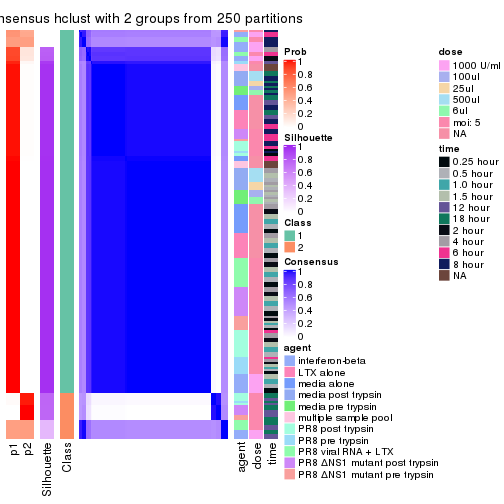
consensus_heatmap(res, k = 3)
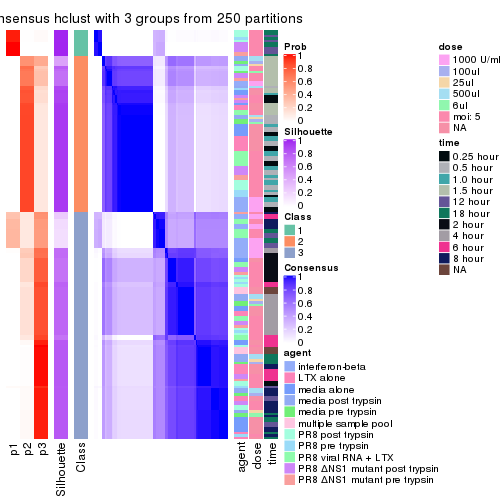
consensus_heatmap(res, k = 4)
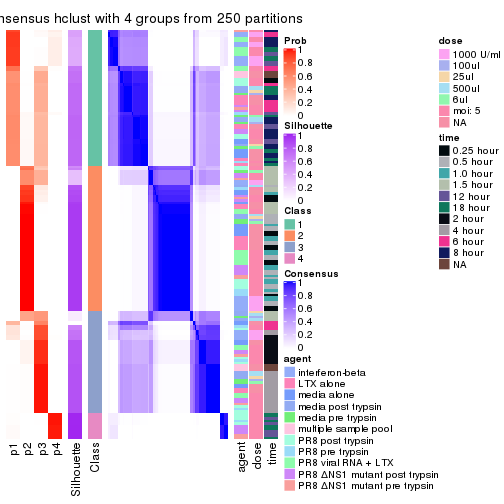
consensus_heatmap(res, k = 5)
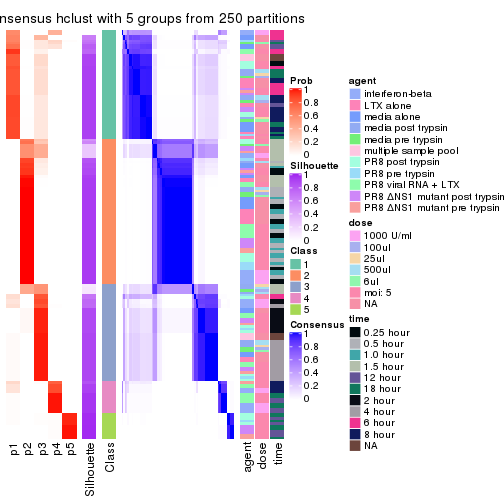
consensus_heatmap(res, k = 6)
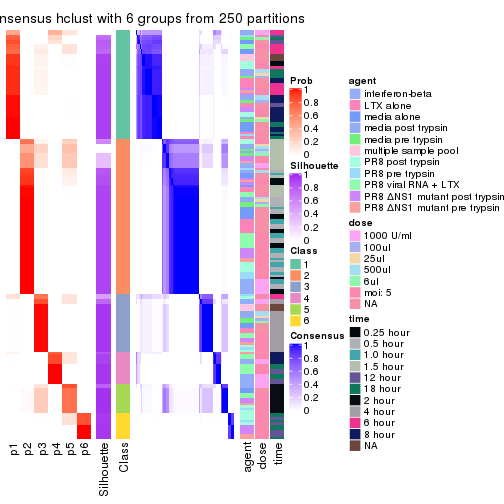
Heatmaps for the membership of samples in all partitions to see how consistent they are:
membership_heatmap(res, k = 2)
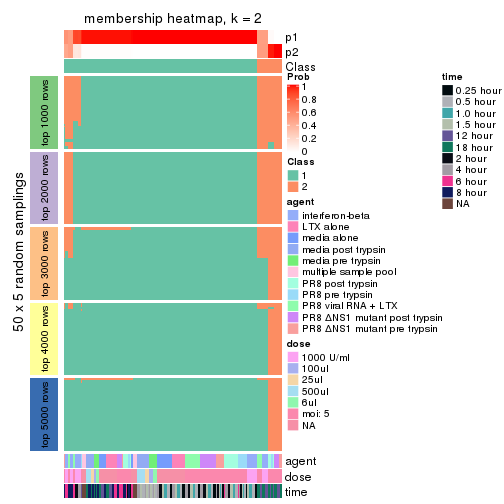
membership_heatmap(res, k = 3)
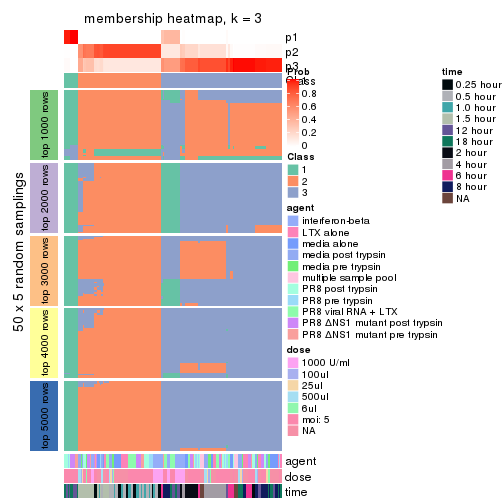
membership_heatmap(res, k = 4)
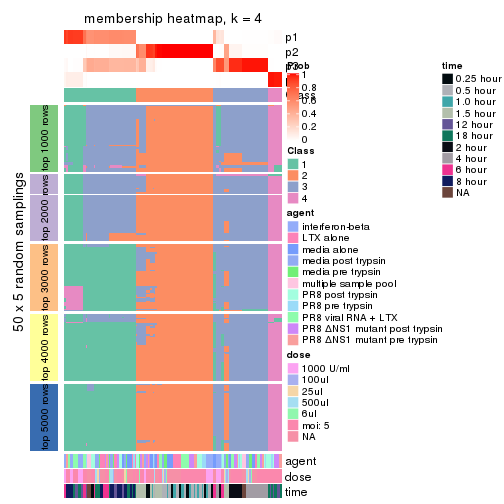
membership_heatmap(res, k = 5)
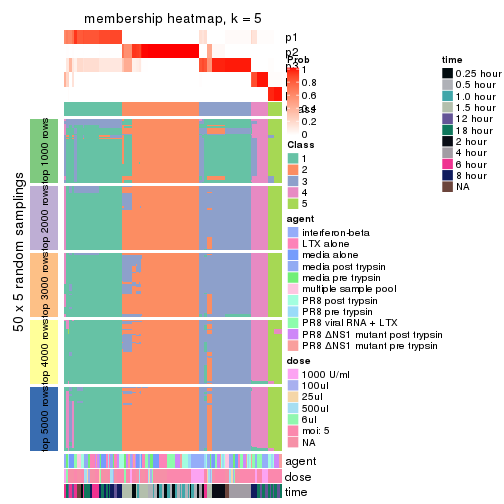
membership_heatmap(res, k = 6)
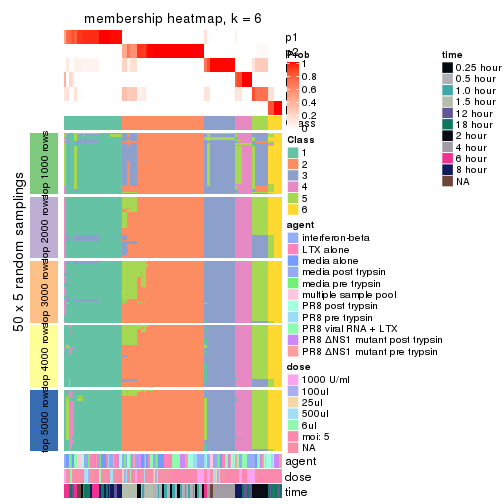
As soon as we have had the classes for columns, we can look for signatures which are significantly different between classes which can be candidate marks for certain classes. Following are the heatmaps for signatures.
Signature heatmaps where rows are scaled:
get_signatures(res, k = 2)
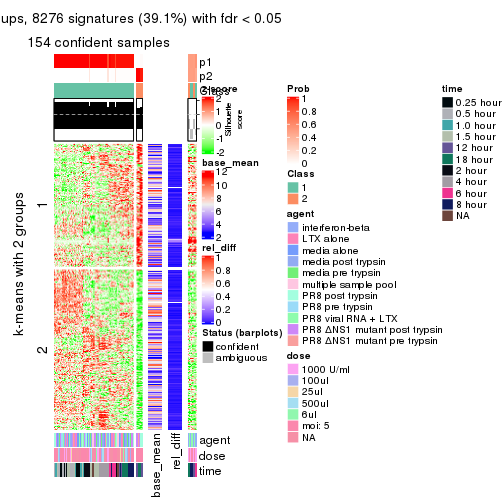
get_signatures(res, k = 3)

get_signatures(res, k = 4)
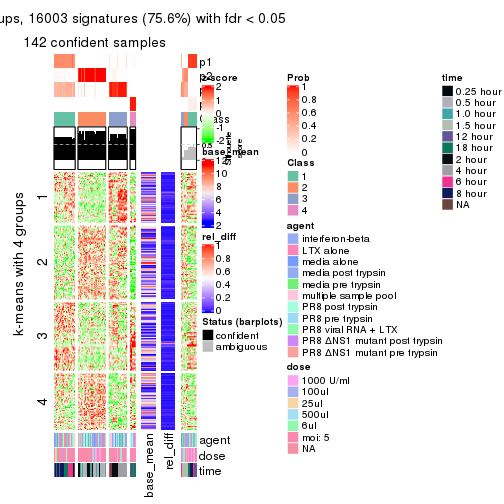
get_signatures(res, k = 5)
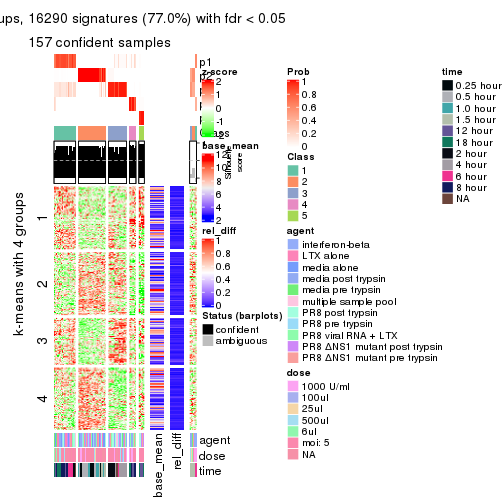
get_signatures(res, k = 6)
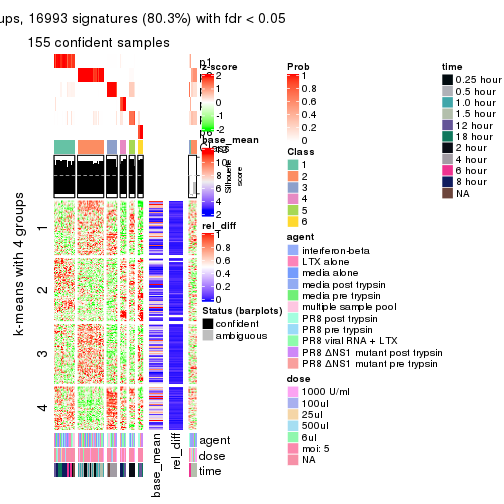
Signature heatmaps where rows are not scaled:
get_signatures(res, k = 2, scale_rows = FALSE)
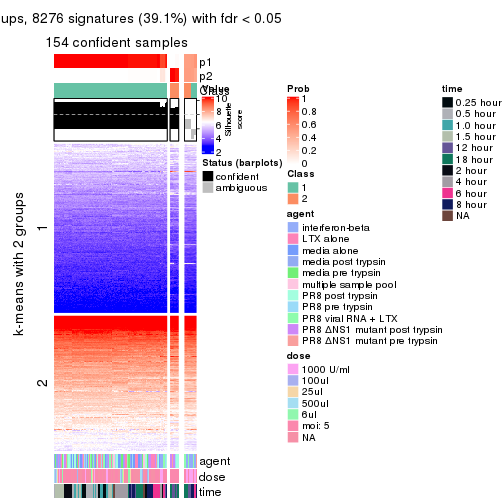
get_signatures(res, k = 3, scale_rows = FALSE)
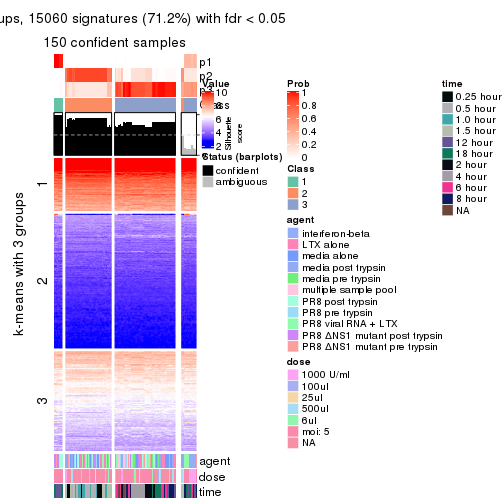
get_signatures(res, k = 4, scale_rows = FALSE)
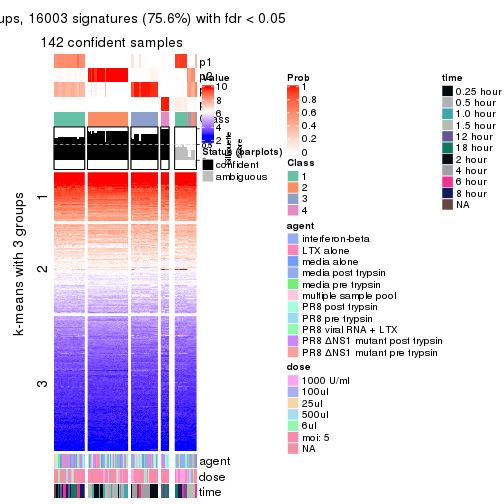
get_signatures(res, k = 5, scale_rows = FALSE)
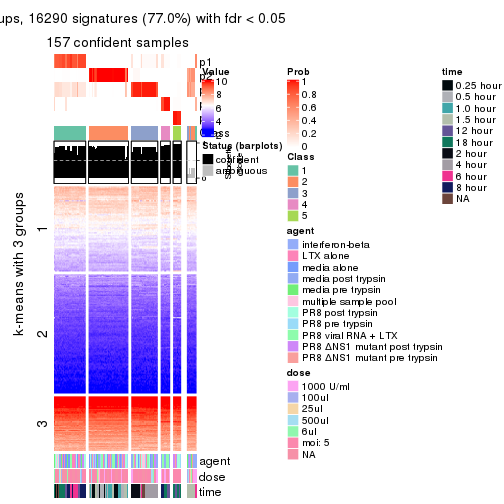
get_signatures(res, k = 6, scale_rows = FALSE)
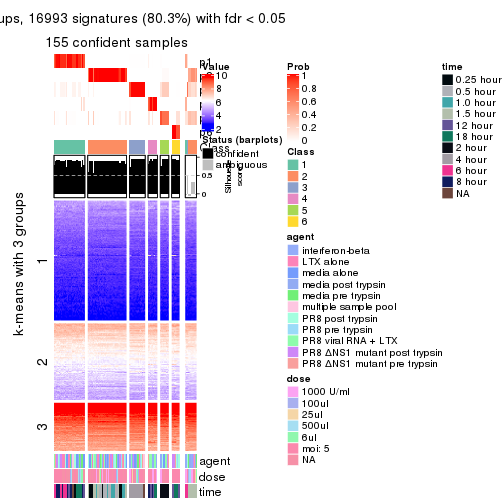
Compare the overlap of signatures from different k:
compare_signatures(res)
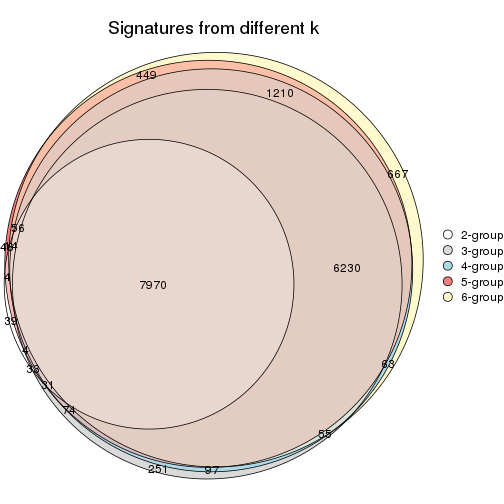
get_signature() returns a data frame invisibly. TO get the list of signatures, the function
call should be assigned to a variable explicitly. In following code, if plot argument is set
to FALSE, no heatmap is plotted while only the differential analysis is performed.
# code only for demonstration
tb = get_signature(res, k = ..., plot = FALSE)
An example of the output of tb is:
#> which_row fdr mean_1 mean_2 scaled_mean_1 scaled_mean_2 km
#> 1 38 0.042760348 8.373488 9.131774 -0.5533452 0.5164555 1
#> 2 40 0.018707592 7.106213 8.469186 -0.6173731 0.5762149 1
#> 3 55 0.019134737 10.221463 11.207825 -0.6159697 0.5749050 1
#> 4 59 0.006059896 5.921854 7.869574 -0.6899429 0.6439467 1
#> 5 60 0.018055526 8.928898 10.211722 -0.6204761 0.5791110 1
#> 6 98 0.009384629 15.714769 14.887706 0.6635654 -0.6193277 2
...
The columns in tb are:
which_row: row indices corresponding to the input matrix.fdr: FDR for the differential test. mean_x: The mean value in group x.scaled_mean_x: The mean value in group x after rows are scaled.km: Row groups if k-means clustering is applied to rows.UMAP plot which shows how samples are separated.
dimension_reduction(res, k = 2, method = "UMAP")
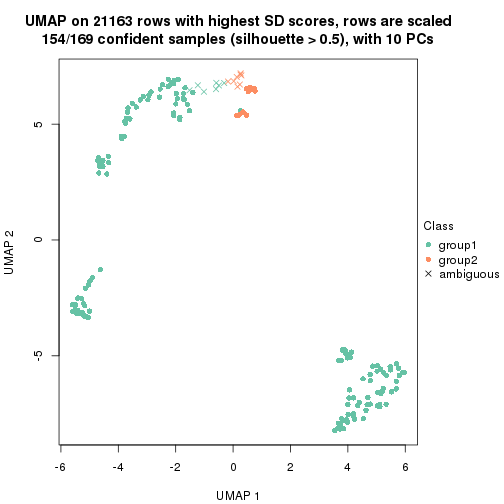
dimension_reduction(res, k = 3, method = "UMAP")
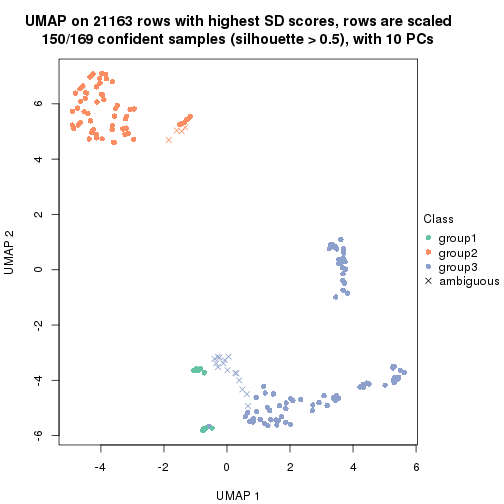
dimension_reduction(res, k = 4, method = "UMAP")
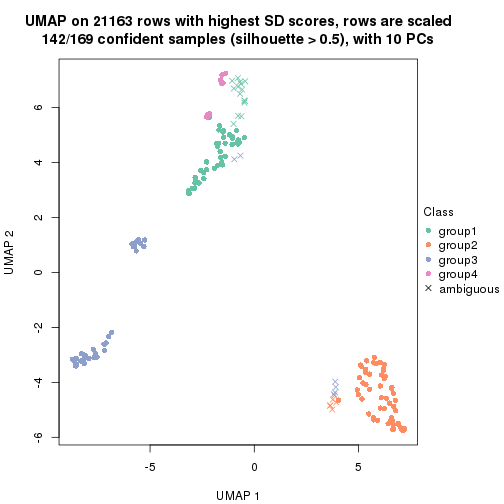
dimension_reduction(res, k = 5, method = "UMAP")
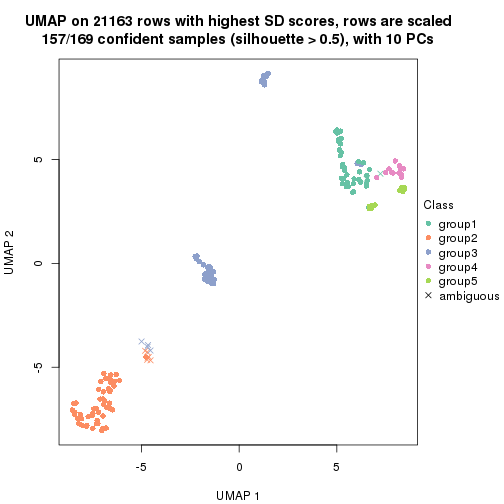
dimension_reduction(res, k = 6, method = "UMAP")
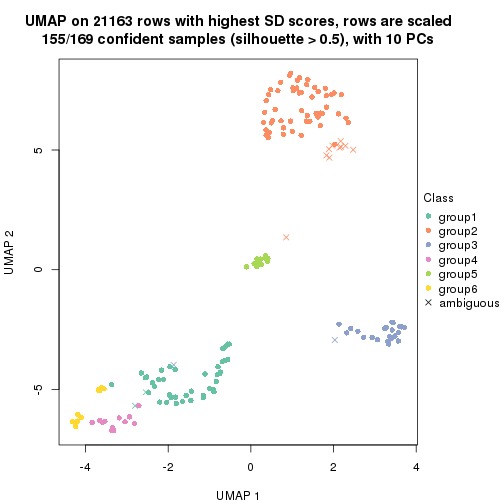
Following heatmap shows how subgroups are split when increasing k:
collect_classes(res)
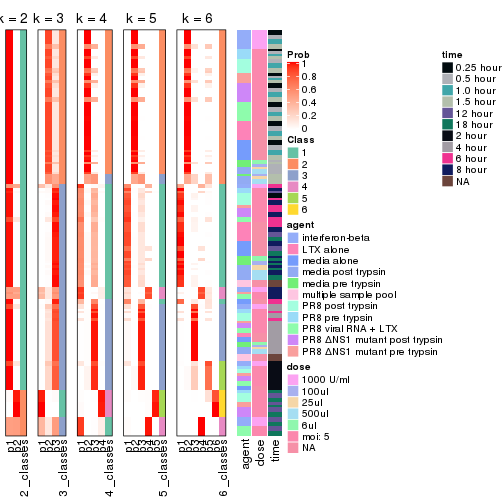
Test correlation between subgroups and known annotations. If the known annotation is numeric, one-way ANOVA test is applied, and if the known annotation is discrete, chi-squared contingency table test is applied.
test_to_known_factors(res)
#> n agent(p) dose(p) time(p) k
#> SD:hclust 154 0.024981 0.04080 1.49e-09 2
#> SD:hclust 150 0.044756 0.08137 3.21e-31 3
#> SD:hclust 142 0.101854 0.14131 7.18e-45 4
#> SD:hclust 157 0.000129 0.00212 9.14e-47 5
#> SD:hclust 155 0.000444 0.00476 5.47e-73 6
If matrix rows can be associated to genes, consider to use functional_enrichment(res,
...) to perform function enrichment for the signature genes. See this vignette for more detailed explanations.
The object with results only for a single top-value method and a single partition method can be extracted as:
res = res_list["SD", "kmeans"]
# you can also extract it by
# res = res_list["SD:kmeans"]
A summary of res and all the functions that can be applied to it:
res
#> A 'ConsensusPartition' object with k = 2, 3, 4, 5, 6.
#> On a matrix with 21163 rows and 169 columns.
#> Top rows (1000, 2000, 3000, 4000, 5000) are extracted by 'SD' method.
#> Subgroups are detected by 'kmeans' method.
#> Performed in total 1250 partitions by row resampling.
#> Best k for subgroups seems to be 2.
#>
#> Following methods can be applied to this 'ConsensusPartition' object:
#> [1] "cola_report" "collect_classes" "collect_plots"
#> [4] "collect_stats" "colnames" "compare_signatures"
#> [7] "consensus_heatmap" "dimension_reduction" "functional_enrichment"
#> [10] "get_anno_col" "get_anno" "get_classes"
#> [13] "get_consensus" "get_matrix" "get_membership"
#> [16] "get_param" "get_signatures" "get_stats"
#> [19] "is_best_k" "is_stable_k" "membership_heatmap"
#> [22] "ncol" "nrow" "plot_ecdf"
#> [25] "rownames" "select_partition_number" "show"
#> [28] "suggest_best_k" "test_to_known_factors"
collect_plots() function collects all the plots made from res for all k (number of partitions)
into one single page to provide an easy and fast comparison between different k.
collect_plots(res)
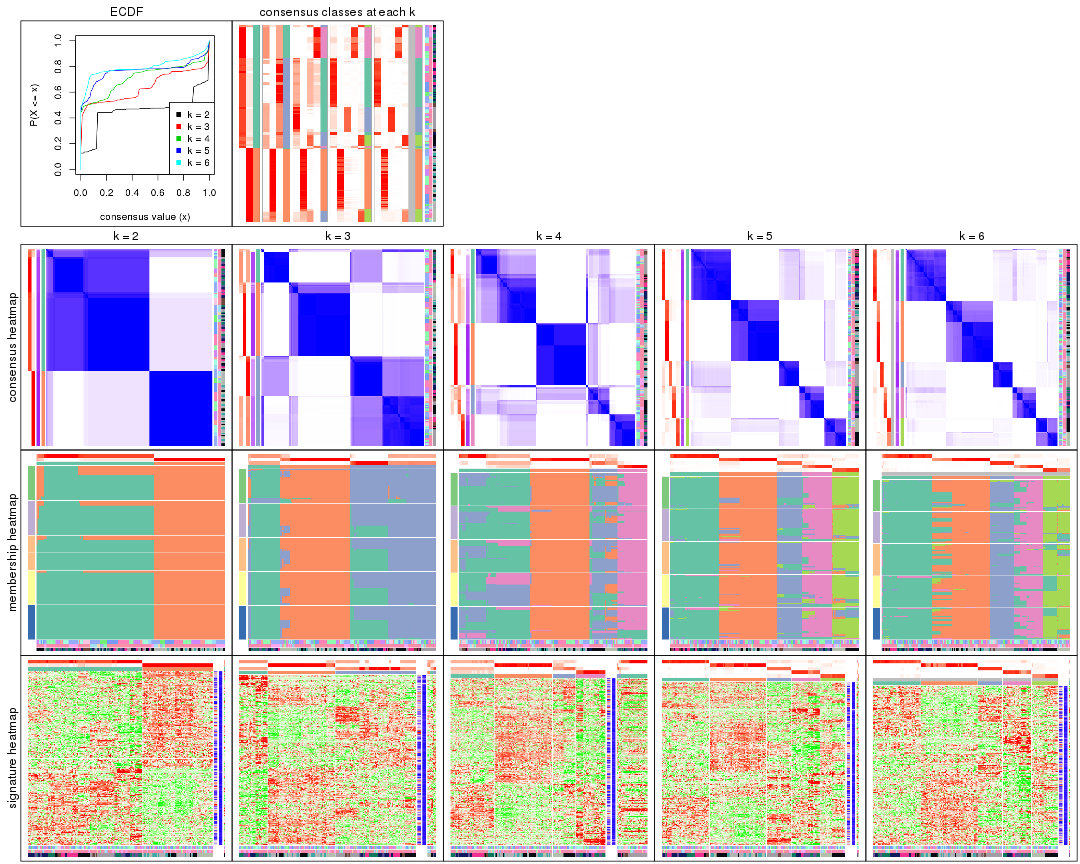
The plots are:
k and the heatmap of
predicted classes for each k.k.k.k.All the plots in panels can be made by individual functions and they are plotted later in this section.
select_partition_number() produces several plots showing different
statistics for choosing “optimized” k. There are following statistics:
k;k, the area increased is defined as \(A_k - A_{k-1}\).The detailed explanations of these statistics can be found in the cola vignette.
Generally speaking, lower PAC score, higher mean silhouette score or higher
concordance corresponds to better partition. Rand index and Jaccard index
measure how similar the current partition is compared to partition with k-1.
If they are too similar, we won't accept k is better than k-1.
select_partition_number(res)
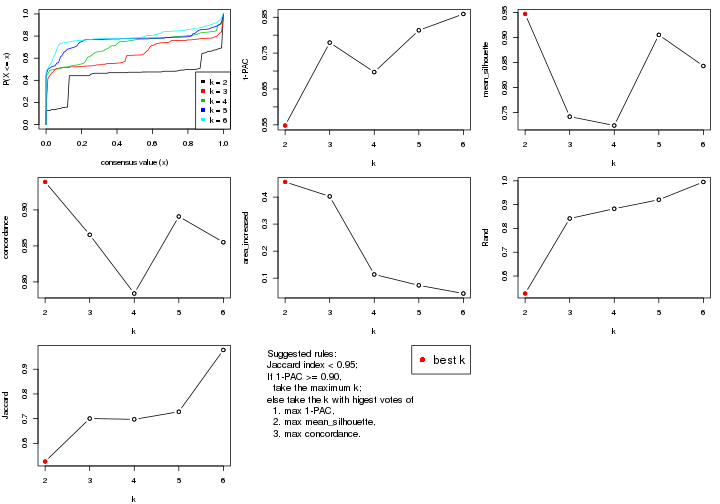
The numeric values for all these statistics can be obtained by get_stats().
get_stats(res)
#> k 1-PAC mean_silhouette concordance area_increased Rand Jaccard
#> 2 2 0.548 0.947 0.939 0.4559 0.527 0.527
#> 3 3 0.779 0.742 0.865 0.4025 0.842 0.701
#> 4 4 0.697 0.724 0.784 0.1137 0.883 0.697
#> 5 5 0.814 0.905 0.891 0.0734 0.920 0.728
#> 6 6 0.859 0.843 0.855 0.0432 0.995 0.978
suggest_best_k() suggests the best \(k\) based on these statistics. The rules are as follows:
suggest_best_k(res)
#> [1] 2
Following shows the table of the partitions (You need to click the show/hide
code output link to see it). The membership matrix (columns with name p*)
is inferred by
clue::cl_consensus()
function with the SE method. Basically the value in the membership matrix
represents the probability to belong to a certain group. The finall class
label for an item is determined with the group with highest probability it
belongs to.
In get_classes() function, the entropy is calculated from the membership
matrix and the silhouette score is calculated from the consensus matrix.
cbind(get_classes(res, k = 2), get_membership(res, k = 2))
#> class entropy silhouette p1 p2
#> GSM528681 2 0.000 1.000 0.000 1.000
#> GSM528682 2 0.000 1.000 0.000 1.000
#> GSM528683 2 0.000 1.000 0.000 1.000
#> GSM528684 2 0.000 1.000 0.000 1.000
#> GSM528687 2 0.000 1.000 0.000 1.000
#> GSM528688 2 0.000 1.000 0.000 1.000
#> GSM528685 2 0.000 1.000 0.000 1.000
#> GSM528686 2 0.000 1.000 0.000 1.000
#> GSM528693 1 0.541 0.944 0.876 0.124
#> GSM528694 1 0.541 0.944 0.876 0.124
#> GSM528695 1 0.184 0.907 0.972 0.028
#> GSM528696 1 0.184 0.907 0.972 0.028
#> GSM528697 1 0.000 0.895 1.000 0.000
#> GSM528698 1 0.000 0.895 1.000 0.000
#> GSM528699 1 0.000 0.895 1.000 0.000
#> GSM528700 1 0.000 0.895 1.000 0.000
#> GSM528689 1 0.000 0.895 1.000 0.000
#> GSM528690 1 0.000 0.895 1.000 0.000
#> GSM528691 1 0.000 0.895 1.000 0.000
#> GSM528692 1 0.000 0.895 1.000 0.000
#> GSM528779 2 0.000 1.000 0.000 1.000
#> GSM528780 2 0.000 1.000 0.000 1.000
#> GSM528782 2 0.000 1.000 0.000 1.000
#> GSM528781 2 0.000 1.000 0.000 1.000
#> GSM528785 1 0.839 0.785 0.732 0.268
#> GSM528786 1 0.541 0.944 0.876 0.124
#> GSM528787 1 0.541 0.944 0.876 0.124
#> GSM528788 1 0.541 0.944 0.876 0.124
#> GSM528783 1 0.311 0.920 0.944 0.056
#> GSM528784 1 0.000 0.895 1.000 0.000
#> GSM528759 1 0.541 0.944 0.876 0.124
#> GSM528760 1 0.541 0.944 0.876 0.124
#> GSM528761 2 0.000 1.000 0.000 1.000
#> GSM528762 2 0.000 1.000 0.000 1.000
#> GSM528765 2 0.000 1.000 0.000 1.000
#> GSM528766 2 0.000 1.000 0.000 1.000
#> GSM528763 2 0.000 1.000 0.000 1.000
#> GSM528764 2 0.000 1.000 0.000 1.000
#> GSM528771 1 0.827 0.796 0.740 0.260
#> GSM528772 1 0.808 0.813 0.752 0.248
#> GSM528773 1 0.541 0.944 0.876 0.124
#> GSM528774 1 0.541 0.944 0.876 0.124
#> GSM528775 1 0.541 0.944 0.876 0.124
#> GSM528776 1 0.482 0.938 0.896 0.104
#> GSM528777 1 0.430 0.932 0.912 0.088
#> GSM528778 1 0.430 0.932 0.912 0.088
#> GSM528767 1 0.000 0.895 1.000 0.000
#> GSM528768 1 0.000 0.895 1.000 0.000
#> GSM528769 1 0.000 0.895 1.000 0.000
#> GSM528770 1 0.000 0.895 1.000 0.000
#> GSM528671 2 0.000 1.000 0.000 1.000
#> GSM528672 2 0.000 1.000 0.000 1.000
#> GSM528674 2 0.000 1.000 0.000 1.000
#> GSM528673 2 0.000 1.000 0.000 1.000
#> GSM528677 1 0.541 0.944 0.876 0.124
#> GSM528678 1 0.541 0.944 0.876 0.124
#> GSM528679 1 0.358 0.924 0.932 0.068
#> GSM528680 1 0.000 0.895 1.000 0.000
#> GSM528675 1 0.000 0.895 1.000 0.000
#> GSM528676 1 0.000 0.895 1.000 0.000
#> GSM528651 2 0.000 1.000 0.000 1.000
#> GSM528652 2 0.000 1.000 0.000 1.000
#> GSM528653 2 0.000 1.000 0.000 1.000
#> GSM528654 2 0.000 1.000 0.000 1.000
#> GSM528657 2 0.000 1.000 0.000 1.000
#> GSM528658 2 0.000 1.000 0.000 1.000
#> GSM528655 2 0.000 1.000 0.000 1.000
#> GSM528656 2 0.000 1.000 0.000 1.000
#> GSM528663 1 0.929 0.656 0.656 0.344
#> GSM528664 1 0.995 0.381 0.540 0.460
#> GSM528665 1 0.541 0.944 0.876 0.124
#> GSM528666 1 0.541 0.944 0.876 0.124
#> GSM528667 1 0.541 0.944 0.876 0.124
#> GSM528668 1 0.541 0.944 0.876 0.124
#> GSM528669 1 0.541 0.944 0.876 0.124
#> GSM528670 1 0.541 0.944 0.876 0.124
#> GSM528659 1 0.000 0.895 1.000 0.000
#> GSM528660 1 0.000 0.895 1.000 0.000
#> GSM528661 1 0.000 0.895 1.000 0.000
#> GSM528662 1 0.000 0.895 1.000 0.000
#> GSM528701 2 0.000 1.000 0.000 1.000
#> GSM528702 2 0.000 1.000 0.000 1.000
#> GSM528703 2 0.000 1.000 0.000 1.000
#> GSM528704 2 0.000 1.000 0.000 1.000
#> GSM528707 2 0.000 1.000 0.000 1.000
#> GSM528708 2 0.000 1.000 0.000 1.000
#> GSM528705 2 0.000 1.000 0.000 1.000
#> GSM528706 2 0.000 1.000 0.000 1.000
#> GSM528713 1 0.541 0.944 0.876 0.124
#> GSM528714 1 0.541 0.944 0.876 0.124
#> GSM528715 1 0.541 0.944 0.876 0.124
#> GSM528716 1 0.541 0.944 0.876 0.124
#> GSM528717 1 0.000 0.895 1.000 0.000
#> GSM528718 1 0.000 0.895 1.000 0.000
#> GSM528719 1 0.000 0.895 1.000 0.000
#> GSM528720 1 0.000 0.895 1.000 0.000
#> GSM528709 1 0.000 0.895 1.000 0.000
#> GSM528710 1 0.000 0.895 1.000 0.000
#> GSM528711 1 0.000 0.895 1.000 0.000
#> GSM528712 1 0.000 0.895 1.000 0.000
#> GSM528721 2 0.000 1.000 0.000 1.000
#> GSM528722 2 0.000 1.000 0.000 1.000
#> GSM528723 2 0.000 1.000 0.000 1.000
#> GSM528724 2 0.000 1.000 0.000 1.000
#> GSM528727 2 0.000 1.000 0.000 1.000
#> GSM528728 2 0.000 1.000 0.000 1.000
#> GSM528725 2 0.000 1.000 0.000 1.000
#> GSM528726 2 0.000 1.000 0.000 1.000
#> GSM528733 1 0.541 0.944 0.876 0.124
#> GSM528734 1 0.541 0.944 0.876 0.124
#> GSM528735 1 0.541 0.944 0.876 0.124
#> GSM528736 1 0.541 0.944 0.876 0.124
#> GSM528737 1 0.541 0.944 0.876 0.124
#> GSM528738 1 0.541 0.944 0.876 0.124
#> GSM528729 1 0.541 0.944 0.876 0.124
#> GSM528730 1 0.541 0.944 0.876 0.124
#> GSM528731 1 0.541 0.944 0.876 0.124
#> GSM528732 1 0.541 0.944 0.876 0.124
#> GSM528739 2 0.000 1.000 0.000 1.000
#> GSM528740 2 0.000 1.000 0.000 1.000
#> GSM528741 2 0.000 1.000 0.000 1.000
#> GSM528742 2 0.000 1.000 0.000 1.000
#> GSM528745 2 0.000 1.000 0.000 1.000
#> GSM528746 2 0.000 1.000 0.000 1.000
#> GSM528743 2 0.000 1.000 0.000 1.000
#> GSM528744 2 0.000 1.000 0.000 1.000
#> GSM528751 1 0.808 0.813 0.752 0.248
#> GSM528752 1 0.802 0.818 0.756 0.244
#> GSM528753 1 0.541 0.944 0.876 0.124
#> GSM528754 1 0.541 0.944 0.876 0.124
#> GSM528755 1 0.541 0.944 0.876 0.124
#> GSM528756 1 0.541 0.944 0.876 0.124
#> GSM528757 1 0.541 0.944 0.876 0.124
#> GSM528758 1 0.541 0.944 0.876 0.124
#> GSM528747 1 0.541 0.944 0.876 0.124
#> GSM528748 1 0.541 0.944 0.876 0.124
#> GSM528749 1 0.541 0.944 0.876 0.124
#> GSM528750 1 0.541 0.944 0.876 0.124
#> GSM528640 2 0.000 1.000 0.000 1.000
#> GSM528641 2 0.000 1.000 0.000 1.000
#> GSM528643 1 0.541 0.944 0.876 0.124
#> GSM528644 1 0.541 0.944 0.876 0.124
#> GSM528642 1 0.541 0.944 0.876 0.124
#> GSM528620 2 0.000 1.000 0.000 1.000
#> GSM528621 2 0.000 1.000 0.000 1.000
#> GSM528623 1 0.541 0.944 0.876 0.124
#> GSM528624 1 0.541 0.944 0.876 0.124
#> GSM528622 1 0.541 0.944 0.876 0.124
#> GSM528625 2 0.000 1.000 0.000 1.000
#> GSM528626 2 0.000 1.000 0.000 1.000
#> GSM528628 1 0.541 0.944 0.876 0.124
#> GSM528629 1 0.541 0.944 0.876 0.124
#> GSM528627 1 0.541 0.944 0.876 0.124
#> GSM528630 2 0.000 1.000 0.000 1.000
#> GSM528631 2 0.000 1.000 0.000 1.000
#> GSM528632 2 0.000 1.000 0.000 1.000
#> GSM528633 2 0.000 1.000 0.000 1.000
#> GSM528636 1 0.541 0.944 0.876 0.124
#> GSM528637 1 0.541 0.944 0.876 0.124
#> GSM528638 1 0.541 0.944 0.876 0.124
#> GSM528639 1 0.541 0.944 0.876 0.124
#> GSM528634 1 0.541 0.944 0.876 0.124
#> GSM528635 1 0.541 0.944 0.876 0.124
#> GSM528645 1 0.541 0.944 0.876 0.124
#> GSM528646 1 0.541 0.944 0.876 0.124
#> GSM528647 1 0.541 0.944 0.876 0.124
#> GSM528648 1 0.541 0.944 0.876 0.124
#> GSM528649 1 0.541 0.944 0.876 0.124
#> GSM528650 1 0.541 0.944 0.876 0.124
cbind(get_classes(res, k = 3), get_membership(res, k = 3))
#> class entropy silhouette p1 p2 p3
#> GSM528681 2 0.0000 0.947 0.000 1.000 0.000
#> GSM528682 2 0.0000 0.947 0.000 1.000 0.000
#> GSM528683 2 0.0000 0.947 0.000 1.000 0.000
#> GSM528684 2 0.0000 0.947 0.000 1.000 0.000
#> GSM528687 2 0.0000 0.947 0.000 1.000 0.000
#> GSM528688 2 0.0000 0.947 0.000 1.000 0.000
#> GSM528685 2 0.1267 0.928 0.024 0.972 0.004
#> GSM528686 2 0.6633 0.660 0.260 0.700 0.040
#> GSM528693 3 0.6442 0.721 0.432 0.004 0.564
#> GSM528694 3 0.6442 0.721 0.432 0.004 0.564
#> GSM528695 3 0.6252 0.713 0.444 0.000 0.556
#> GSM528696 3 0.6252 0.713 0.444 0.000 0.556
#> GSM528697 1 0.6267 0.879 0.548 0.000 0.452
#> GSM528698 1 0.6267 0.879 0.548 0.000 0.452
#> GSM528699 1 0.6267 0.879 0.548 0.000 0.452
#> GSM528700 1 0.6267 0.879 0.548 0.000 0.452
#> GSM528689 1 0.6267 0.879 0.548 0.000 0.452
#> GSM528690 1 0.6267 0.879 0.548 0.000 0.452
#> GSM528691 1 0.6267 0.879 0.548 0.000 0.452
#> GSM528692 1 0.6267 0.879 0.548 0.000 0.452
#> GSM528779 2 0.0000 0.947 0.000 1.000 0.000
#> GSM528780 2 0.0237 0.946 0.004 0.996 0.000
#> GSM528782 2 0.0000 0.947 0.000 1.000 0.000
#> GSM528781 2 0.0237 0.946 0.004 0.996 0.000
#> GSM528785 3 0.8260 0.648 0.432 0.076 0.492
#> GSM528786 3 0.6468 0.715 0.444 0.004 0.552
#> GSM528787 3 0.6373 0.728 0.408 0.004 0.588
#> GSM528788 3 0.0237 0.537 0.000 0.004 0.996
#> GSM528783 3 0.6264 -0.594 0.380 0.004 0.616
#> GSM528784 1 0.6267 0.875 0.548 0.000 0.452
#> GSM528759 3 0.6373 0.728 0.408 0.004 0.588
#> GSM528760 3 0.6373 0.728 0.408 0.004 0.588
#> GSM528761 2 0.0237 0.946 0.004 0.996 0.000
#> GSM528762 2 0.0000 0.947 0.000 1.000 0.000
#> GSM528765 2 0.0237 0.946 0.004 0.996 0.000
#> GSM528766 2 0.0237 0.946 0.004 0.996 0.000
#> GSM528763 2 0.0237 0.945 0.004 0.996 0.000
#> GSM528764 2 0.6633 0.660 0.260 0.700 0.040
#> GSM528771 3 0.7013 0.709 0.432 0.020 0.548
#> GSM528772 3 0.6754 0.716 0.432 0.012 0.556
#> GSM528773 3 0.6468 0.715 0.444 0.004 0.552
#> GSM528774 3 0.6410 0.728 0.420 0.004 0.576
#> GSM528775 3 0.6314 0.727 0.392 0.004 0.604
#> GSM528776 3 0.0237 0.537 0.000 0.004 0.996
#> GSM528777 3 0.3851 0.199 0.136 0.004 0.860
#> GSM528778 3 0.3851 0.199 0.136 0.004 0.860
#> GSM528767 1 0.6267 0.875 0.548 0.000 0.452
#> GSM528768 1 0.6267 0.875 0.548 0.000 0.452
#> GSM528769 1 0.6267 0.875 0.548 0.000 0.452
#> GSM528770 1 0.6267 0.875 0.548 0.000 0.452
#> GSM528671 2 0.0237 0.946 0.004 0.996 0.000
#> GSM528672 2 0.0000 0.947 0.000 1.000 0.000
#> GSM528674 2 0.0237 0.946 0.004 0.996 0.000
#> GSM528673 2 0.6633 0.660 0.260 0.700 0.040
#> GSM528677 3 0.6442 0.721 0.432 0.004 0.564
#> GSM528678 3 0.6468 0.715 0.444 0.004 0.552
#> GSM528679 3 0.0237 0.537 0.000 0.004 0.996
#> GSM528680 1 0.6267 0.879 0.548 0.000 0.452
#> GSM528675 1 0.6260 0.878 0.552 0.000 0.448
#> GSM528676 1 0.6260 0.878 0.552 0.000 0.448
#> GSM528651 2 0.0237 0.946 0.004 0.996 0.000
#> GSM528652 2 0.0237 0.946 0.004 0.996 0.000
#> GSM528653 2 0.0000 0.947 0.000 1.000 0.000
#> GSM528654 2 0.0000 0.947 0.000 1.000 0.000
#> GSM528657 2 0.0237 0.946 0.004 0.996 0.000
#> GSM528658 2 0.0000 0.947 0.000 1.000 0.000
#> GSM528655 2 0.6633 0.660 0.260 0.700 0.040
#> GSM528656 2 0.4834 0.762 0.204 0.792 0.004
#> GSM528663 1 0.8984 -0.595 0.436 0.128 0.436
#> GSM528664 1 0.9070 -0.585 0.436 0.136 0.428
#> GSM528665 3 0.6410 0.728 0.420 0.004 0.576
#> GSM528666 3 0.6410 0.728 0.420 0.004 0.576
#> GSM528667 3 0.0237 0.537 0.000 0.004 0.996
#> GSM528668 3 0.0237 0.537 0.000 0.004 0.996
#> GSM528669 3 0.0237 0.537 0.000 0.004 0.996
#> GSM528670 3 0.0237 0.537 0.000 0.004 0.996
#> GSM528659 1 0.6260 0.878 0.552 0.000 0.448
#> GSM528660 1 0.6260 0.878 0.552 0.000 0.448
#> GSM528661 1 0.6260 0.878 0.552 0.000 0.448
#> GSM528662 1 0.6260 0.878 0.552 0.000 0.448
#> GSM528701 2 0.0000 0.947 0.000 1.000 0.000
#> GSM528702 2 0.0000 0.947 0.000 1.000 0.000
#> GSM528703 2 0.0000 0.947 0.000 1.000 0.000
#> GSM528704 2 0.0000 0.947 0.000 1.000 0.000
#> GSM528707 2 0.0000 0.947 0.000 1.000 0.000
#> GSM528708 2 0.0000 0.947 0.000 1.000 0.000
#> GSM528705 2 0.0000 0.947 0.000 1.000 0.000
#> GSM528706 2 0.0000 0.947 0.000 1.000 0.000
#> GSM528713 3 0.6442 0.721 0.432 0.004 0.564
#> GSM528714 3 0.6442 0.721 0.432 0.004 0.564
#> GSM528715 3 0.6410 0.728 0.420 0.004 0.576
#> GSM528716 3 0.6410 0.728 0.420 0.004 0.576
#> GSM528717 3 0.0000 0.530 0.000 0.000 1.000
#> GSM528718 3 0.0000 0.530 0.000 0.000 1.000
#> GSM528719 1 0.6267 0.879 0.548 0.000 0.452
#> GSM528720 1 0.6267 0.879 0.548 0.000 0.452
#> GSM528709 1 0.6267 0.879 0.548 0.000 0.452
#> GSM528710 1 0.6267 0.879 0.548 0.000 0.452
#> GSM528711 1 0.6267 0.879 0.548 0.000 0.452
#> GSM528712 1 0.6267 0.879 0.548 0.000 0.452
#> GSM528721 2 0.0000 0.947 0.000 1.000 0.000
#> GSM528722 2 0.0000 0.947 0.000 1.000 0.000
#> GSM528723 2 0.0000 0.947 0.000 1.000 0.000
#> GSM528724 2 0.0000 0.947 0.000 1.000 0.000
#> GSM528727 2 0.0237 0.946 0.004 0.996 0.000
#> GSM528728 2 0.0000 0.947 0.000 1.000 0.000
#> GSM528725 2 0.0000 0.947 0.000 1.000 0.000
#> GSM528726 2 0.0000 0.947 0.000 1.000 0.000
#> GSM528733 3 0.6410 0.728 0.420 0.004 0.576
#> GSM528734 3 0.6410 0.728 0.420 0.004 0.576
#> GSM528735 3 0.6314 0.727 0.392 0.004 0.604
#> GSM528736 3 0.6314 0.727 0.392 0.004 0.604
#> GSM528737 3 0.0237 0.537 0.000 0.004 0.996
#> GSM528738 3 0.0237 0.537 0.000 0.004 0.996
#> GSM528729 3 0.0237 0.537 0.000 0.004 0.996
#> GSM528730 3 0.0237 0.537 0.000 0.004 0.996
#> GSM528731 3 0.0237 0.537 0.000 0.004 0.996
#> GSM528732 3 0.0237 0.537 0.000 0.004 0.996
#> GSM528739 2 0.0000 0.947 0.000 1.000 0.000
#> GSM528740 2 0.0000 0.947 0.000 1.000 0.000
#> GSM528741 2 0.0237 0.946 0.004 0.996 0.000
#> GSM528742 2 0.0000 0.947 0.000 1.000 0.000
#> GSM528745 2 0.0237 0.946 0.004 0.996 0.000
#> GSM528746 2 0.0000 0.947 0.000 1.000 0.000
#> GSM528743 2 0.0237 0.946 0.004 0.996 0.000
#> GSM528744 2 0.0237 0.946 0.004 0.996 0.000
#> GSM528751 3 0.6754 0.716 0.432 0.012 0.556
#> GSM528752 3 0.6608 0.718 0.432 0.008 0.560
#> GSM528753 3 0.6410 0.728 0.420 0.004 0.576
#> GSM528754 3 0.6410 0.728 0.420 0.004 0.576
#> GSM528755 3 0.6298 0.726 0.388 0.004 0.608
#> GSM528756 3 0.6314 0.727 0.392 0.004 0.604
#> GSM528757 3 0.0237 0.537 0.000 0.004 0.996
#> GSM528758 3 0.0237 0.537 0.000 0.004 0.996
#> GSM528747 3 0.0237 0.537 0.000 0.004 0.996
#> GSM528748 3 0.0237 0.537 0.000 0.004 0.996
#> GSM528749 3 0.0237 0.537 0.000 0.004 0.996
#> GSM528750 3 0.0237 0.537 0.000 0.004 0.996
#> GSM528640 2 0.0000 0.947 0.000 1.000 0.000
#> GSM528641 2 0.6633 0.660 0.260 0.700 0.040
#> GSM528643 3 0.6410 0.728 0.420 0.004 0.576
#> GSM528644 3 0.0237 0.537 0.000 0.004 0.996
#> GSM528642 3 0.2096 0.568 0.052 0.004 0.944
#> GSM528620 2 0.0237 0.946 0.004 0.996 0.000
#> GSM528621 1 0.9698 -0.328 0.436 0.336 0.228
#> GSM528623 3 0.6410 0.728 0.420 0.004 0.576
#> GSM528624 3 0.0237 0.537 0.000 0.004 0.996
#> GSM528622 3 0.0237 0.537 0.000 0.004 0.996
#> GSM528625 2 0.0000 0.947 0.000 1.000 0.000
#> GSM528626 2 0.7116 0.568 0.324 0.636 0.040
#> GSM528628 3 0.6410 0.728 0.420 0.004 0.576
#> GSM528629 3 0.0237 0.537 0.000 0.004 0.996
#> GSM528627 3 0.0475 0.539 0.004 0.004 0.992
#> GSM528630 2 0.0237 0.946 0.004 0.996 0.000
#> GSM528631 2 0.0000 0.947 0.000 1.000 0.000
#> GSM528632 2 0.7508 0.402 0.416 0.544 0.040
#> GSM528633 2 0.7508 0.402 0.416 0.544 0.040
#> GSM528636 3 0.6410 0.728 0.420 0.004 0.576
#> GSM528637 3 0.6410 0.728 0.420 0.004 0.576
#> GSM528638 3 0.0237 0.537 0.000 0.004 0.996
#> GSM528639 3 0.0237 0.537 0.000 0.004 0.996
#> GSM528634 3 0.2301 0.572 0.060 0.004 0.936
#> GSM528635 3 0.0237 0.537 0.000 0.004 0.996
#> GSM528645 3 0.6468 0.715 0.444 0.004 0.552
#> GSM528646 3 0.6468 0.715 0.444 0.004 0.552
#> GSM528647 3 0.6468 0.715 0.444 0.004 0.552
#> GSM528648 3 0.6373 0.728 0.408 0.004 0.588
#> GSM528649 3 0.6373 0.728 0.408 0.004 0.588
#> GSM528650 3 0.6373 0.728 0.408 0.004 0.588
cbind(get_classes(res, k = 4), get_membership(res, k = 4))
#> class entropy silhouette p1 p2 p3 p4
#> GSM528681 2 0.0000 0.9825 0.000 1.000 0.000 0.000
#> GSM528682 2 0.0000 0.9825 0.000 1.000 0.000 0.000
#> GSM528683 2 0.0000 0.9825 0.000 1.000 0.000 0.000
#> GSM528684 2 0.0000 0.9825 0.000 1.000 0.000 0.000
#> GSM528687 2 0.0000 0.9825 0.000 1.000 0.000 0.000
#> GSM528688 2 0.0000 0.9825 0.000 1.000 0.000 0.000
#> GSM528685 3 0.5408 0.2170 0.012 0.488 0.500 0.000
#> GSM528686 3 0.7228 0.5672 0.156 0.340 0.504 0.000
#> GSM528693 3 0.4103 0.5658 0.256 0.000 0.744 0.000
#> GSM528694 3 0.4103 0.5658 0.256 0.000 0.744 0.000
#> GSM528695 1 0.0336 0.4153 0.992 0.000 0.000 0.008
#> GSM528696 1 0.0336 0.4153 0.992 0.000 0.000 0.008
#> GSM528697 4 0.0188 0.9478 0.000 0.000 0.004 0.996
#> GSM528698 4 0.0188 0.9478 0.000 0.000 0.004 0.996
#> GSM528699 4 0.0000 0.9488 0.000 0.000 0.000 1.000
#> GSM528700 4 0.0000 0.9488 0.000 0.000 0.000 1.000
#> GSM528689 4 0.0000 0.9488 0.000 0.000 0.000 1.000
#> GSM528690 4 0.0000 0.9488 0.000 0.000 0.000 1.000
#> GSM528691 4 0.0000 0.9488 0.000 0.000 0.000 1.000
#> GSM528692 4 0.0000 0.9488 0.000 0.000 0.000 1.000
#> GSM528779 2 0.0000 0.9825 0.000 1.000 0.000 0.000
#> GSM528780 2 0.1022 0.9722 0.000 0.968 0.032 0.000
#> GSM528782 2 0.0000 0.9825 0.000 1.000 0.000 0.000
#> GSM528781 2 0.1022 0.9722 0.000 0.968 0.032 0.000
#> GSM528785 3 0.3760 0.4864 0.136 0.028 0.836 0.000
#> GSM528786 1 0.3024 0.1568 0.852 0.000 0.148 0.000
#> GSM528787 1 0.3764 0.4649 0.784 0.000 0.216 0.000
#> GSM528788 1 0.7714 0.6643 0.400 0.000 0.376 0.224
#> GSM528783 4 0.5874 0.5780 0.124 0.000 0.176 0.700
#> GSM528784 4 0.3266 0.8608 0.000 0.000 0.168 0.832
#> GSM528759 1 0.6462 0.5956 0.580 0.000 0.332 0.088
#> GSM528760 1 0.4088 0.4549 0.764 0.000 0.232 0.004
#> GSM528761 2 0.1022 0.9722 0.000 0.968 0.032 0.000
#> GSM528762 2 0.0000 0.9825 0.000 1.000 0.000 0.000
#> GSM528765 2 0.1022 0.9722 0.000 0.968 0.032 0.000
#> GSM528766 2 0.1022 0.9722 0.000 0.968 0.032 0.000
#> GSM528763 2 0.4193 0.5470 0.000 0.732 0.268 0.000
#> GSM528764 3 0.7165 0.5469 0.144 0.356 0.500 0.000
#> GSM528771 3 0.4535 0.5831 0.240 0.016 0.744 0.000
#> GSM528772 3 0.4535 0.5831 0.240 0.016 0.744 0.000
#> GSM528773 1 0.1792 0.3157 0.932 0.000 0.068 0.000
#> GSM528774 1 0.0000 0.4218 1.000 0.000 0.000 0.000
#> GSM528775 1 0.6766 0.6294 0.520 0.000 0.380 0.100
#> GSM528776 1 0.7714 0.6647 0.400 0.000 0.376 0.224
#> GSM528777 3 0.7758 -0.6569 0.368 0.000 0.396 0.236
#> GSM528778 3 0.7758 -0.6569 0.368 0.000 0.396 0.236
#> GSM528767 4 0.3266 0.8608 0.000 0.000 0.168 0.832
#> GSM528768 4 0.3266 0.8608 0.000 0.000 0.168 0.832
#> GSM528769 4 0.3266 0.8608 0.000 0.000 0.168 0.832
#> GSM528770 4 0.3266 0.8608 0.000 0.000 0.168 0.832
#> GSM528671 2 0.1022 0.9722 0.000 0.968 0.032 0.000
#> GSM528672 2 0.0000 0.9825 0.000 1.000 0.000 0.000
#> GSM528674 2 0.1022 0.9722 0.000 0.968 0.032 0.000
#> GSM528673 3 0.7165 0.5469 0.144 0.356 0.500 0.000
#> GSM528677 3 0.4134 0.5667 0.260 0.000 0.740 0.000
#> GSM528678 1 0.2921 0.1746 0.860 0.000 0.140 0.000
#> GSM528679 1 0.7710 0.6673 0.408 0.000 0.368 0.224
#> GSM528680 4 0.1118 0.9313 0.000 0.000 0.036 0.964
#> GSM528675 4 0.1211 0.9409 0.000 0.000 0.040 0.960
#> GSM528676 4 0.1211 0.9409 0.000 0.000 0.040 0.960
#> GSM528651 2 0.1022 0.9722 0.000 0.968 0.032 0.000
#> GSM528652 2 0.1022 0.9722 0.000 0.968 0.032 0.000
#> GSM528653 2 0.0000 0.9825 0.000 1.000 0.000 0.000
#> GSM528654 2 0.0000 0.9825 0.000 1.000 0.000 0.000
#> GSM528657 2 0.1022 0.9722 0.000 0.968 0.032 0.000
#> GSM528658 2 0.0000 0.9825 0.000 1.000 0.000 0.000
#> GSM528655 3 0.7165 0.5469 0.144 0.356 0.500 0.000
#> GSM528656 3 0.7139 0.5377 0.140 0.360 0.500 0.000
#> GSM528663 3 0.5787 0.6215 0.244 0.076 0.680 0.000
#> GSM528664 3 0.5851 0.6248 0.236 0.084 0.680 0.000
#> GSM528665 1 0.0000 0.4218 1.000 0.000 0.000 0.000
#> GSM528666 1 0.0000 0.4218 1.000 0.000 0.000 0.000
#> GSM528667 1 0.7710 0.6673 0.408 0.000 0.368 0.224
#> GSM528668 1 0.7710 0.6673 0.408 0.000 0.368 0.224
#> GSM528669 1 0.7732 0.6565 0.388 0.000 0.384 0.228
#> GSM528670 1 0.7717 0.6599 0.392 0.000 0.384 0.224
#> GSM528659 4 0.1211 0.9409 0.000 0.000 0.040 0.960
#> GSM528660 4 0.1211 0.9409 0.000 0.000 0.040 0.960
#> GSM528661 4 0.1211 0.9409 0.000 0.000 0.040 0.960
#> GSM528662 4 0.1211 0.9409 0.000 0.000 0.040 0.960
#> GSM528701 2 0.0000 0.9825 0.000 1.000 0.000 0.000
#> GSM528702 2 0.0000 0.9825 0.000 1.000 0.000 0.000
#> GSM528703 2 0.0000 0.9825 0.000 1.000 0.000 0.000
#> GSM528704 2 0.0000 0.9825 0.000 1.000 0.000 0.000
#> GSM528707 2 0.0000 0.9825 0.000 1.000 0.000 0.000
#> GSM528708 2 0.0000 0.9825 0.000 1.000 0.000 0.000
#> GSM528705 2 0.0000 0.9825 0.000 1.000 0.000 0.000
#> GSM528706 2 0.0000 0.9825 0.000 1.000 0.000 0.000
#> GSM528713 3 0.4103 0.5658 0.256 0.000 0.744 0.000
#> GSM528714 3 0.4250 0.5672 0.276 0.000 0.724 0.000
#> GSM528715 1 0.0000 0.4218 1.000 0.000 0.000 0.000
#> GSM528716 1 0.0000 0.4218 1.000 0.000 0.000 0.000
#> GSM528717 1 0.7710 0.6666 0.408 0.000 0.368 0.224
#> GSM528718 1 0.7665 0.6637 0.424 0.000 0.360 0.216
#> GSM528719 4 0.0000 0.9488 0.000 0.000 0.000 1.000
#> GSM528720 4 0.0000 0.9488 0.000 0.000 0.000 1.000
#> GSM528709 4 0.0000 0.9488 0.000 0.000 0.000 1.000
#> GSM528710 4 0.0000 0.9488 0.000 0.000 0.000 1.000
#> GSM528711 4 0.0000 0.9488 0.000 0.000 0.000 1.000
#> GSM528712 4 0.0000 0.9488 0.000 0.000 0.000 1.000
#> GSM528721 2 0.0000 0.9825 0.000 1.000 0.000 0.000
#> GSM528722 2 0.0000 0.9825 0.000 1.000 0.000 0.000
#> GSM528723 2 0.0000 0.9825 0.000 1.000 0.000 0.000
#> GSM528724 2 0.0000 0.9825 0.000 1.000 0.000 0.000
#> GSM528727 2 0.1022 0.9722 0.000 0.968 0.032 0.000
#> GSM528728 2 0.0000 0.9825 0.000 1.000 0.000 0.000
#> GSM528725 2 0.0000 0.9825 0.000 1.000 0.000 0.000
#> GSM528726 2 0.0000 0.9825 0.000 1.000 0.000 0.000
#> GSM528733 1 0.0000 0.4218 1.000 0.000 0.000 0.000
#> GSM528734 1 0.0000 0.4218 1.000 0.000 0.000 0.000
#> GSM528735 1 0.6798 0.6339 0.504 0.000 0.396 0.100
#> GSM528736 1 0.6791 0.6328 0.508 0.000 0.392 0.100
#> GSM528737 1 0.7714 0.6647 0.400 0.000 0.376 0.224
#> GSM528738 1 0.7699 0.6644 0.400 0.000 0.380 0.220
#> GSM528729 1 0.7714 0.6643 0.400 0.000 0.376 0.224
#> GSM528730 1 0.7714 0.6643 0.400 0.000 0.376 0.224
#> GSM528731 1 0.7714 0.6643 0.400 0.000 0.376 0.224
#> GSM528732 1 0.7710 0.6673 0.408 0.000 0.368 0.224
#> GSM528739 2 0.0000 0.9825 0.000 1.000 0.000 0.000
#> GSM528740 2 0.0000 0.9825 0.000 1.000 0.000 0.000
#> GSM528741 2 0.1022 0.9722 0.000 0.968 0.032 0.000
#> GSM528742 2 0.0000 0.9825 0.000 1.000 0.000 0.000
#> GSM528745 2 0.1022 0.9722 0.000 0.968 0.032 0.000
#> GSM528746 2 0.0000 0.9825 0.000 1.000 0.000 0.000
#> GSM528743 2 0.1022 0.9722 0.000 0.968 0.032 0.000
#> GSM528744 2 0.1022 0.9722 0.000 0.968 0.032 0.000
#> GSM528751 3 0.4502 0.5806 0.236 0.016 0.748 0.000
#> GSM528752 3 0.4502 0.5806 0.236 0.016 0.748 0.000
#> GSM528753 1 0.0000 0.4218 1.000 0.000 0.000 0.000
#> GSM528754 1 0.0000 0.4218 1.000 0.000 0.000 0.000
#> GSM528755 1 0.7113 0.6416 0.484 0.000 0.384 0.132
#> GSM528756 1 0.6775 0.6305 0.516 0.000 0.384 0.100
#> GSM528757 1 0.7714 0.6643 0.400 0.000 0.376 0.224
#> GSM528758 1 0.7714 0.6643 0.400 0.000 0.376 0.224
#> GSM528747 1 0.7710 0.6673 0.408 0.000 0.368 0.224
#> GSM528748 1 0.7710 0.6673 0.408 0.000 0.368 0.224
#> GSM528749 1 0.7710 0.6673 0.408 0.000 0.368 0.224
#> GSM528750 1 0.7710 0.6673 0.408 0.000 0.368 0.224
#> GSM528640 2 0.0000 0.9825 0.000 1.000 0.000 0.000
#> GSM528641 3 0.7165 0.5469 0.144 0.356 0.500 0.000
#> GSM528643 1 0.0000 0.4218 1.000 0.000 0.000 0.000
#> GSM528644 1 0.7712 0.6659 0.404 0.000 0.372 0.224
#> GSM528642 1 0.7468 0.6620 0.464 0.000 0.352 0.184
#> GSM528620 2 0.1022 0.9722 0.000 0.968 0.032 0.000
#> GSM528621 3 0.7227 0.6494 0.224 0.228 0.548 0.000
#> GSM528623 1 0.0000 0.4218 1.000 0.000 0.000 0.000
#> GSM528624 1 0.7714 0.6643 0.400 0.000 0.376 0.224
#> GSM528622 1 0.7710 0.6673 0.408 0.000 0.368 0.224
#> GSM528625 2 0.0000 0.9825 0.000 1.000 0.000 0.000
#> GSM528626 3 0.7359 0.6011 0.188 0.304 0.508 0.000
#> GSM528628 1 0.0000 0.4218 1.000 0.000 0.000 0.000
#> GSM528629 1 0.7710 0.6673 0.408 0.000 0.368 0.224
#> GSM528627 1 0.7710 0.6673 0.408 0.000 0.368 0.224
#> GSM528630 2 0.1022 0.9722 0.000 0.968 0.032 0.000
#> GSM528631 2 0.0921 0.9734 0.000 0.972 0.028 0.000
#> GSM528632 3 0.7408 0.6218 0.212 0.276 0.512 0.000
#> GSM528633 3 0.7425 0.6192 0.212 0.280 0.508 0.000
#> GSM528636 1 0.0000 0.4218 1.000 0.000 0.000 0.000
#> GSM528637 1 0.0000 0.4218 1.000 0.000 0.000 0.000
#> GSM528638 1 0.7714 0.6643 0.400 0.000 0.376 0.224
#> GSM528639 1 0.7716 0.6622 0.396 0.000 0.380 0.224
#> GSM528634 1 0.7495 0.6627 0.448 0.000 0.368 0.184
#> GSM528635 1 0.7710 0.6673 0.408 0.000 0.368 0.224
#> GSM528645 1 0.3528 0.0500 0.808 0.000 0.192 0.000
#> GSM528646 1 0.3528 0.0500 0.808 0.000 0.192 0.000
#> GSM528647 1 0.3837 0.0205 0.776 0.000 0.224 0.000
#> GSM528648 1 0.7033 0.6252 0.508 0.000 0.364 0.128
#> GSM528649 1 0.5970 0.5290 0.668 0.000 0.244 0.088
#> GSM528650 1 0.7060 0.6300 0.496 0.000 0.376 0.128
cbind(get_classes(res, k = 5), get_membership(res, k = 5))
#> class entropy silhouette p1 p2 p3 p4 p5
#> GSM528681 2 0.0000 0.946 0.000 1.000 0.000 0.000 0.000
#> GSM528682 2 0.0000 0.946 0.000 1.000 0.000 0.000 0.000
#> GSM528683 2 0.0000 0.946 0.000 1.000 0.000 0.000 0.000
#> GSM528684 2 0.0000 0.946 0.000 1.000 0.000 0.000 0.000
#> GSM528687 2 0.0162 0.945 0.000 0.996 0.004 0.000 0.000
#> GSM528688 2 0.0000 0.946 0.000 1.000 0.000 0.000 0.000
#> GSM528685 5 0.4627 0.778 0.004 0.184 0.032 0.024 0.756
#> GSM528686 5 0.3949 0.861 0.004 0.100 0.044 0.024 0.828
#> GSM528693 5 0.2325 0.860 0.068 0.000 0.028 0.000 0.904
#> GSM528694 5 0.2325 0.860 0.068 0.000 0.028 0.000 0.904
#> GSM528695 3 0.4648 0.956 0.172 0.000 0.748 0.008 0.072
#> GSM528696 3 0.4648 0.956 0.172 0.000 0.748 0.008 0.072
#> GSM528697 4 0.1544 0.902 0.068 0.000 0.000 0.932 0.000
#> GSM528698 4 0.1478 0.903 0.064 0.000 0.000 0.936 0.000
#> GSM528699 4 0.1410 0.903 0.060 0.000 0.000 0.940 0.000
#> GSM528700 4 0.1410 0.903 0.060 0.000 0.000 0.940 0.000
#> GSM528689 4 0.1410 0.903 0.060 0.000 0.000 0.940 0.000
#> GSM528690 4 0.1410 0.903 0.060 0.000 0.000 0.940 0.000
#> GSM528691 4 0.1410 0.903 0.060 0.000 0.000 0.940 0.000
#> GSM528692 4 0.1410 0.903 0.060 0.000 0.000 0.940 0.000
#> GSM528779 2 0.0162 0.945 0.000 0.996 0.004 0.000 0.000
#> GSM528780 2 0.3142 0.898 0.000 0.856 0.108 0.032 0.004
#> GSM528782 2 0.0000 0.946 0.000 1.000 0.000 0.000 0.000
#> GSM528781 2 0.3904 0.879 0.000 0.820 0.116 0.044 0.020
#> GSM528785 5 0.2929 0.814 0.128 0.012 0.004 0.000 0.856
#> GSM528786 3 0.4406 0.900 0.108 0.000 0.764 0.000 0.128
#> GSM528787 1 0.3704 0.750 0.820 0.000 0.088 0.000 0.092
#> GSM528788 1 0.0671 0.958 0.980 0.000 0.000 0.016 0.004
#> GSM528783 4 0.6981 0.361 0.416 0.000 0.092 0.428 0.064
#> GSM528784 4 0.6565 0.777 0.200 0.000 0.108 0.616 0.076
#> GSM528759 1 0.1830 0.911 0.932 0.000 0.040 0.000 0.028
#> GSM528760 1 0.4800 0.539 0.716 0.000 0.196 0.000 0.088
#> GSM528761 2 0.3222 0.896 0.000 0.852 0.108 0.036 0.004
#> GSM528762 2 0.0000 0.946 0.000 1.000 0.000 0.000 0.000
#> GSM528765 2 0.3299 0.895 0.000 0.848 0.108 0.040 0.004
#> GSM528766 2 0.3142 0.898 0.000 0.856 0.108 0.032 0.004
#> GSM528763 5 0.5208 0.371 0.000 0.420 0.012 0.024 0.544
#> GSM528764 5 0.3952 0.856 0.004 0.112 0.036 0.024 0.824
#> GSM528771 5 0.2429 0.865 0.068 0.008 0.020 0.000 0.904
#> GSM528772 5 0.2429 0.865 0.068 0.008 0.020 0.000 0.904
#> GSM528773 3 0.4394 0.929 0.136 0.000 0.764 0.000 0.100
#> GSM528774 3 0.4297 0.951 0.164 0.000 0.764 0.000 0.072
#> GSM528775 1 0.1661 0.918 0.940 0.000 0.036 0.000 0.024
#> GSM528776 1 0.0693 0.958 0.980 0.000 0.000 0.012 0.008
#> GSM528777 1 0.1471 0.939 0.952 0.000 0.004 0.020 0.024
#> GSM528778 1 0.1471 0.939 0.952 0.000 0.004 0.020 0.024
#> GSM528767 4 0.6565 0.777 0.200 0.000 0.108 0.616 0.076
#> GSM528768 4 0.6565 0.777 0.200 0.000 0.108 0.616 0.076
#> GSM528769 4 0.6565 0.777 0.200 0.000 0.108 0.616 0.076
#> GSM528770 4 0.6565 0.777 0.200 0.000 0.108 0.616 0.076
#> GSM528671 2 0.3904 0.879 0.000 0.820 0.116 0.044 0.020
#> GSM528672 2 0.0000 0.946 0.000 1.000 0.000 0.000 0.000
#> GSM528674 2 0.3222 0.896 0.000 0.852 0.108 0.036 0.004
#> GSM528673 5 0.3952 0.856 0.004 0.112 0.036 0.024 0.824
#> GSM528677 5 0.2300 0.858 0.072 0.000 0.024 0.000 0.904
#> GSM528678 3 0.4406 0.900 0.108 0.000 0.764 0.000 0.128
#> GSM528679 1 0.0671 0.959 0.980 0.000 0.000 0.016 0.004
#> GSM528680 4 0.1991 0.898 0.076 0.000 0.004 0.916 0.004
#> GSM528675 4 0.4336 0.880 0.060 0.000 0.096 0.804 0.040
#> GSM528676 4 0.4336 0.880 0.060 0.000 0.096 0.804 0.040
#> GSM528651 2 0.3904 0.879 0.000 0.820 0.116 0.044 0.020
#> GSM528652 2 0.3904 0.879 0.000 0.820 0.116 0.044 0.020
#> GSM528653 2 0.0000 0.946 0.000 1.000 0.000 0.000 0.000
#> GSM528654 2 0.0000 0.946 0.000 1.000 0.000 0.000 0.000
#> GSM528657 2 0.3299 0.895 0.000 0.848 0.108 0.040 0.004
#> GSM528658 2 0.0000 0.946 0.000 1.000 0.000 0.000 0.000
#> GSM528655 5 0.3952 0.856 0.004 0.112 0.036 0.024 0.824
#> GSM528656 5 0.3952 0.856 0.004 0.112 0.036 0.024 0.824
#> GSM528663 5 0.2502 0.867 0.060 0.012 0.024 0.000 0.904
#> GSM528664 5 0.2610 0.869 0.060 0.020 0.020 0.000 0.900
#> GSM528665 3 0.4479 0.962 0.184 0.000 0.744 0.000 0.072
#> GSM528666 3 0.4479 0.962 0.184 0.000 0.744 0.000 0.072
#> GSM528667 1 0.0798 0.958 0.976 0.000 0.000 0.016 0.008
#> GSM528668 1 0.0798 0.958 0.976 0.000 0.000 0.016 0.008
#> GSM528669 1 0.1059 0.955 0.968 0.000 0.004 0.020 0.008
#> GSM528670 1 0.1059 0.955 0.968 0.000 0.004 0.020 0.008
#> GSM528659 4 0.4336 0.880 0.060 0.000 0.096 0.804 0.040
#> GSM528660 4 0.4336 0.880 0.060 0.000 0.096 0.804 0.040
#> GSM528661 4 0.4336 0.880 0.060 0.000 0.096 0.804 0.040
#> GSM528662 4 0.4336 0.880 0.060 0.000 0.096 0.804 0.040
#> GSM528701 2 0.0162 0.945 0.000 0.996 0.004 0.000 0.000
#> GSM528702 2 0.0162 0.945 0.000 0.996 0.004 0.000 0.000
#> GSM528703 2 0.0000 0.946 0.000 1.000 0.000 0.000 0.000
#> GSM528704 2 0.0000 0.946 0.000 1.000 0.000 0.000 0.000
#> GSM528707 2 0.0000 0.946 0.000 1.000 0.000 0.000 0.000
#> GSM528708 2 0.0000 0.946 0.000 1.000 0.000 0.000 0.000
#> GSM528705 2 0.0000 0.946 0.000 1.000 0.000 0.000 0.000
#> GSM528706 2 0.0162 0.945 0.000 0.996 0.004 0.000 0.000
#> GSM528713 5 0.2300 0.858 0.072 0.000 0.024 0.000 0.904
#> GSM528714 5 0.2388 0.858 0.072 0.000 0.028 0.000 0.900
#> GSM528715 3 0.4479 0.962 0.184 0.000 0.744 0.000 0.072
#> GSM528716 3 0.4479 0.962 0.184 0.000 0.744 0.000 0.072
#> GSM528717 1 0.0968 0.956 0.972 0.000 0.004 0.012 0.012
#> GSM528718 1 0.0798 0.946 0.976 0.000 0.008 0.000 0.016
#> GSM528719 4 0.1410 0.903 0.060 0.000 0.000 0.940 0.000
#> GSM528720 4 0.1410 0.903 0.060 0.000 0.000 0.940 0.000
#> GSM528709 4 0.1571 0.903 0.060 0.000 0.004 0.936 0.000
#> GSM528710 4 0.1571 0.903 0.060 0.000 0.004 0.936 0.000
#> GSM528711 4 0.1571 0.903 0.060 0.000 0.004 0.936 0.000
#> GSM528712 4 0.1571 0.903 0.060 0.000 0.004 0.936 0.000
#> GSM528721 2 0.0000 0.946 0.000 1.000 0.000 0.000 0.000
#> GSM528722 2 0.0000 0.946 0.000 1.000 0.000 0.000 0.000
#> GSM528723 2 0.0000 0.946 0.000 1.000 0.000 0.000 0.000
#> GSM528724 2 0.0000 0.946 0.000 1.000 0.000 0.000 0.000
#> GSM528727 2 0.3299 0.895 0.000 0.848 0.108 0.040 0.004
#> GSM528728 2 0.0000 0.946 0.000 1.000 0.000 0.000 0.000
#> GSM528725 2 0.0162 0.945 0.000 0.996 0.004 0.000 0.000
#> GSM528726 2 0.0162 0.945 0.000 0.996 0.004 0.000 0.000
#> GSM528733 3 0.4479 0.962 0.184 0.000 0.744 0.000 0.072
#> GSM528734 3 0.4479 0.962 0.184 0.000 0.744 0.000 0.072
#> GSM528735 1 0.1399 0.925 0.952 0.000 0.028 0.000 0.020
#> GSM528736 1 0.1399 0.925 0.952 0.000 0.028 0.000 0.020
#> GSM528737 1 0.0798 0.958 0.976 0.000 0.000 0.016 0.008
#> GSM528738 1 0.0290 0.953 0.992 0.000 0.000 0.000 0.008
#> GSM528729 1 0.0671 0.958 0.980 0.000 0.000 0.016 0.004
#> GSM528730 1 0.0671 0.958 0.980 0.000 0.000 0.016 0.004
#> GSM528731 1 0.0833 0.959 0.976 0.000 0.004 0.016 0.004
#> GSM528732 1 0.0833 0.959 0.976 0.000 0.004 0.016 0.004
#> GSM528739 2 0.0162 0.945 0.000 0.996 0.004 0.000 0.000
#> GSM528740 2 0.0162 0.945 0.000 0.996 0.004 0.000 0.000
#> GSM528741 2 0.3222 0.896 0.000 0.852 0.108 0.036 0.004
#> GSM528742 2 0.0162 0.945 0.000 0.996 0.004 0.000 0.000
#> GSM528745 2 0.3904 0.879 0.000 0.820 0.116 0.044 0.020
#> GSM528746 2 0.0000 0.946 0.000 1.000 0.000 0.000 0.000
#> GSM528743 2 0.3904 0.879 0.000 0.820 0.116 0.044 0.020
#> GSM528744 2 0.3904 0.879 0.000 0.820 0.116 0.044 0.020
#> GSM528751 5 0.2492 0.863 0.072 0.008 0.020 0.000 0.900
#> GSM528752 5 0.2492 0.863 0.072 0.008 0.020 0.000 0.900
#> GSM528753 3 0.4479 0.962 0.184 0.000 0.744 0.000 0.072
#> GSM528754 3 0.4479 0.962 0.184 0.000 0.744 0.000 0.072
#> GSM528755 1 0.1310 0.932 0.956 0.000 0.020 0.000 0.024
#> GSM528756 1 0.1579 0.922 0.944 0.000 0.032 0.000 0.024
#> GSM528757 1 0.0671 0.958 0.980 0.000 0.000 0.016 0.004
#> GSM528758 1 0.0671 0.958 0.980 0.000 0.000 0.016 0.004
#> GSM528747 1 0.0833 0.959 0.976 0.000 0.004 0.016 0.004
#> GSM528748 1 0.0833 0.959 0.976 0.000 0.004 0.016 0.004
#> GSM528749 1 0.0671 0.958 0.980 0.000 0.004 0.016 0.000
#> GSM528750 1 0.0671 0.958 0.980 0.000 0.004 0.016 0.000
#> GSM528640 2 0.0000 0.946 0.000 1.000 0.000 0.000 0.000
#> GSM528641 5 0.3952 0.856 0.004 0.112 0.036 0.024 0.824
#> GSM528643 3 0.4479 0.962 0.184 0.000 0.744 0.000 0.072
#> GSM528644 1 0.0833 0.959 0.976 0.000 0.004 0.016 0.004
#> GSM528642 1 0.1211 0.951 0.960 0.000 0.024 0.016 0.000
#> GSM528620 2 0.3222 0.896 0.000 0.852 0.108 0.036 0.004
#> GSM528621 5 0.3433 0.865 0.004 0.060 0.048 0.024 0.864
#> GSM528623 3 0.4479 0.962 0.184 0.000 0.744 0.000 0.072
#> GSM528624 1 0.0671 0.958 0.980 0.000 0.000 0.016 0.004
#> GSM528622 1 0.0960 0.958 0.972 0.000 0.004 0.016 0.008
#> GSM528625 2 0.0000 0.946 0.000 1.000 0.000 0.000 0.000
#> GSM528626 5 0.3928 0.863 0.004 0.088 0.052 0.024 0.832
#> GSM528628 3 0.4479 0.962 0.184 0.000 0.744 0.000 0.072
#> GSM528629 1 0.0833 0.959 0.976 0.000 0.004 0.016 0.004
#> GSM528627 1 0.0960 0.958 0.972 0.000 0.004 0.016 0.008
#> GSM528630 2 0.3299 0.895 0.000 0.848 0.108 0.040 0.004
#> GSM528631 2 0.3809 0.881 0.000 0.824 0.116 0.044 0.016
#> GSM528632 5 0.3872 0.863 0.004 0.084 0.052 0.024 0.836
#> GSM528633 5 0.3928 0.863 0.004 0.088 0.052 0.024 0.832
#> GSM528636 3 0.4479 0.962 0.184 0.000 0.744 0.000 0.072
#> GSM528637 3 0.4479 0.962 0.184 0.000 0.744 0.000 0.072
#> GSM528638 1 0.0671 0.958 0.980 0.000 0.000 0.016 0.004
#> GSM528639 1 0.0833 0.959 0.976 0.000 0.004 0.016 0.004
#> GSM528634 1 0.1405 0.951 0.956 0.000 0.020 0.016 0.008
#> GSM528635 1 0.0960 0.958 0.972 0.000 0.004 0.016 0.008
#> GSM528645 3 0.4376 0.878 0.092 0.000 0.764 0.000 0.144
#> GSM528646 3 0.4376 0.878 0.092 0.000 0.764 0.000 0.144
#> GSM528647 3 0.4648 0.865 0.104 0.000 0.740 0.000 0.156
#> GSM528648 1 0.1582 0.924 0.944 0.000 0.028 0.000 0.028
#> GSM528649 1 0.3291 0.798 0.848 0.000 0.064 0.000 0.088
#> GSM528650 1 0.1582 0.924 0.944 0.000 0.028 0.000 0.028
cbind(get_classes(res, k = 6), get_membership(res, k = 6))
#> class entropy silhouette p1 p2 p3 p4 p5 p6
#> GSM528681 2 0.0146 0.862 0.000 0.996 0.000 0.004 0.000 NA
#> GSM528682 2 0.0405 0.861 0.000 0.988 0.004 0.008 0.000 NA
#> GSM528683 2 0.0146 0.862 0.000 0.996 0.000 0.004 0.000 NA
#> GSM528684 2 0.0000 0.862 0.000 1.000 0.000 0.000 0.000 NA
#> GSM528687 2 0.0603 0.860 0.000 0.980 0.016 0.004 0.000 NA
#> GSM528688 2 0.0603 0.860 0.000 0.980 0.016 0.004 0.000 NA
#> GSM528685 5 0.6142 0.803 0.000 0.068 0.044 0.036 0.592 NA
#> GSM528686 5 0.6156 0.812 0.000 0.056 0.056 0.036 0.592 NA
#> GSM528693 5 0.1334 0.817 0.020 0.000 0.032 0.000 0.948 NA
#> GSM528694 5 0.1334 0.817 0.020 0.000 0.032 0.000 0.948 NA
#> GSM528695 3 0.1745 0.970 0.068 0.000 0.920 0.000 0.000 NA
#> GSM528696 3 0.1745 0.970 0.068 0.000 0.920 0.000 0.000 NA
#> GSM528697 4 0.2595 0.851 0.056 0.000 0.004 0.888 0.008 NA
#> GSM528698 4 0.2100 0.859 0.048 0.000 0.004 0.916 0.008 NA
#> GSM528699 4 0.1760 0.861 0.048 0.000 0.000 0.928 0.004 NA
#> GSM528700 4 0.1672 0.862 0.048 0.000 0.000 0.932 0.004 NA
#> GSM528689 4 0.1075 0.864 0.048 0.000 0.000 0.952 0.000 NA
#> GSM528690 4 0.1075 0.864 0.048 0.000 0.000 0.952 0.000 NA
#> GSM528691 4 0.1333 0.864 0.048 0.000 0.000 0.944 0.008 NA
#> GSM528692 4 0.1333 0.864 0.048 0.000 0.000 0.944 0.008 NA
#> GSM528779 2 0.0748 0.860 0.000 0.976 0.016 0.004 0.000 NA
#> GSM528780 2 0.3894 0.733 0.000 0.664 0.004 0.008 0.000 NA
#> GSM528782 2 0.0000 0.862 0.000 1.000 0.000 0.000 0.000 NA
#> GSM528781 2 0.3857 0.624 0.000 0.532 0.000 0.000 0.000 NA
#> GSM528785 5 0.1341 0.816 0.024 0.000 0.028 0.000 0.948 NA
#> GSM528786 3 0.1736 0.949 0.032 0.000 0.936 0.004 0.008 NA
#> GSM528787 1 0.4315 0.804 0.788 0.000 0.080 0.008 0.064 NA
#> GSM528788 1 0.1501 0.911 0.924 0.000 0.000 0.000 0.000 NA
#> GSM528783 1 0.6414 -0.126 0.460 0.000 0.012 0.316 0.012 NA
#> GSM528784 4 0.6553 0.644 0.216 0.000 0.016 0.472 0.016 NA
#> GSM528759 1 0.3308 0.849 0.844 0.000 0.044 0.000 0.080 NA
#> GSM528760 1 0.5123 0.648 0.688 0.000 0.192 0.004 0.080 NA
#> GSM528761 2 0.3940 0.729 0.000 0.652 0.004 0.008 0.000 NA
#> GSM528762 2 0.0146 0.862 0.000 0.996 0.000 0.004 0.000 NA
#> GSM528765 2 0.3918 0.716 0.000 0.632 0.004 0.004 0.000 NA
#> GSM528766 2 0.3925 0.731 0.000 0.656 0.004 0.008 0.000 NA
#> GSM528763 5 0.6995 0.572 0.000 0.264 0.016 0.036 0.420 NA
#> GSM528764 5 0.6354 0.805 0.000 0.056 0.072 0.036 0.576 NA
#> GSM528771 5 0.1334 0.817 0.020 0.000 0.032 0.000 0.948 NA
#> GSM528772 5 0.1334 0.817 0.020 0.000 0.032 0.000 0.948 NA
#> GSM528773 3 0.1552 0.954 0.036 0.000 0.940 0.000 0.004 NA
#> GSM528774 3 0.1226 0.960 0.040 0.000 0.952 0.000 0.004 NA
#> GSM528775 1 0.3178 0.869 0.860 0.000 0.020 0.008 0.056 NA
#> GSM528776 1 0.1908 0.908 0.900 0.000 0.000 0.000 0.004 NA
#> GSM528777 1 0.2101 0.904 0.892 0.000 0.004 0.000 0.004 NA
#> GSM528778 1 0.2101 0.904 0.892 0.000 0.004 0.000 0.004 NA
#> GSM528767 4 0.6553 0.644 0.216 0.000 0.016 0.472 0.016 NA
#> GSM528768 4 0.6553 0.644 0.216 0.000 0.016 0.472 0.016 NA
#> GSM528769 4 0.6553 0.644 0.216 0.000 0.016 0.472 0.016 NA
#> GSM528770 4 0.6553 0.644 0.216 0.000 0.016 0.472 0.016 NA
#> GSM528671 2 0.3823 0.659 0.000 0.564 0.000 0.000 0.000 NA
#> GSM528672 2 0.0000 0.862 0.000 1.000 0.000 0.000 0.000 NA
#> GSM528674 2 0.3728 0.728 0.000 0.652 0.004 0.000 0.000 NA
#> GSM528673 5 0.6156 0.812 0.000 0.056 0.056 0.036 0.592 NA
#> GSM528677 5 0.1592 0.815 0.020 0.000 0.032 0.000 0.940 NA
#> GSM528678 3 0.1736 0.949 0.032 0.000 0.936 0.004 0.008 NA
#> GSM528679 1 0.1806 0.912 0.908 0.000 0.000 0.000 0.004 NA
#> GSM528680 4 0.3079 0.842 0.060 0.000 0.008 0.860 0.008 NA
#> GSM528675 4 0.4733 0.824 0.052 0.000 0.012 0.732 0.032 NA
#> GSM528676 4 0.4733 0.824 0.052 0.000 0.012 0.732 0.032 NA
#> GSM528651 2 0.3823 0.659 0.000 0.564 0.000 0.000 0.000 NA
#> GSM528652 2 0.3823 0.659 0.000 0.564 0.000 0.000 0.000 NA
#> GSM528653 2 0.0000 0.862 0.000 1.000 0.000 0.000 0.000 NA
#> GSM528654 2 0.0000 0.862 0.000 1.000 0.000 0.000 0.000 NA
#> GSM528657 2 0.3918 0.716 0.000 0.632 0.004 0.004 0.000 NA
#> GSM528658 2 0.0000 0.862 0.000 1.000 0.000 0.000 0.000 NA
#> GSM528655 5 0.6156 0.812 0.000 0.056 0.056 0.036 0.592 NA
#> GSM528656 5 0.6156 0.812 0.000 0.056 0.056 0.036 0.592 NA
#> GSM528663 5 0.2190 0.819 0.008 0.012 0.032 0.000 0.916 NA
#> GSM528664 5 0.2190 0.819 0.008 0.012 0.032 0.000 0.916 NA
#> GSM528665 3 0.1531 0.977 0.068 0.000 0.928 0.000 0.004 NA
#> GSM528666 3 0.1531 0.977 0.068 0.000 0.928 0.000 0.004 NA
#> GSM528667 1 0.1908 0.908 0.900 0.000 0.000 0.000 0.004 NA
#> GSM528668 1 0.1908 0.908 0.900 0.000 0.000 0.000 0.004 NA
#> GSM528669 1 0.1949 0.908 0.904 0.000 0.004 0.000 0.004 NA
#> GSM528670 1 0.2001 0.908 0.900 0.000 0.004 0.000 0.004 NA
#> GSM528659 4 0.4733 0.824 0.052 0.000 0.012 0.732 0.032 NA
#> GSM528660 4 0.4733 0.824 0.052 0.000 0.012 0.732 0.032 NA
#> GSM528661 4 0.4673 0.825 0.048 0.000 0.012 0.736 0.032 NA
#> GSM528662 4 0.4673 0.825 0.048 0.000 0.012 0.736 0.032 NA
#> GSM528701 2 0.0603 0.860 0.000 0.980 0.016 0.004 0.000 NA
#> GSM528702 2 0.0603 0.860 0.000 0.980 0.016 0.004 0.000 NA
#> GSM528703 2 0.0405 0.861 0.000 0.988 0.004 0.008 0.000 NA
#> GSM528704 2 0.0146 0.862 0.000 0.996 0.000 0.004 0.000 NA
#> GSM528707 2 0.0000 0.862 0.000 1.000 0.000 0.000 0.000 NA
#> GSM528708 2 0.0000 0.862 0.000 1.000 0.000 0.000 0.000 NA
#> GSM528705 2 0.0603 0.860 0.000 0.980 0.016 0.004 0.000 NA
#> GSM528706 2 0.0748 0.860 0.000 0.976 0.016 0.004 0.000 NA
#> GSM528713 5 0.1334 0.817 0.020 0.000 0.032 0.000 0.948 NA
#> GSM528714 5 0.1787 0.817 0.020 0.000 0.032 0.000 0.932 NA
#> GSM528715 3 0.1531 0.977 0.068 0.000 0.928 0.000 0.004 NA
#> GSM528716 3 0.1531 0.977 0.068 0.000 0.928 0.000 0.004 NA
#> GSM528717 1 0.2701 0.900 0.864 0.000 0.004 0.000 0.028 NA
#> GSM528718 1 0.3059 0.897 0.848 0.000 0.004 0.004 0.040 NA
#> GSM528719 4 0.1988 0.860 0.048 0.000 0.004 0.920 0.004 NA
#> GSM528720 4 0.1988 0.860 0.048 0.000 0.004 0.920 0.004 NA
#> GSM528709 4 0.1219 0.864 0.048 0.000 0.000 0.948 0.000 NA
#> GSM528710 4 0.1219 0.864 0.048 0.000 0.000 0.948 0.000 NA
#> GSM528711 4 0.1477 0.864 0.048 0.000 0.000 0.940 0.008 NA
#> GSM528712 4 0.1477 0.864 0.048 0.000 0.000 0.940 0.008 NA
#> GSM528721 2 0.0000 0.862 0.000 1.000 0.000 0.000 0.000 NA
#> GSM528722 2 0.0603 0.861 0.000 0.980 0.016 0.000 0.000 NA
#> GSM528723 2 0.0146 0.862 0.000 0.996 0.000 0.004 0.000 NA
#> GSM528724 2 0.0146 0.862 0.000 0.996 0.000 0.004 0.000 NA
#> GSM528727 2 0.3918 0.716 0.000 0.632 0.004 0.004 0.000 NA
#> GSM528728 2 0.0000 0.862 0.000 1.000 0.000 0.000 0.000 NA
#> GSM528725 2 0.0603 0.860 0.000 0.980 0.016 0.004 0.000 NA
#> GSM528726 2 0.0748 0.860 0.000 0.976 0.016 0.004 0.000 NA
#> GSM528733 3 0.1531 0.977 0.068 0.000 0.928 0.000 0.004 NA
#> GSM528734 3 0.1531 0.977 0.068 0.000 0.928 0.000 0.004 NA
#> GSM528735 1 0.3099 0.894 0.848 0.000 0.012 0.000 0.044 NA
#> GSM528736 1 0.3099 0.894 0.848 0.000 0.012 0.000 0.044 NA
#> GSM528737 1 0.1908 0.908 0.900 0.000 0.000 0.000 0.004 NA
#> GSM528738 1 0.2214 0.908 0.888 0.000 0.000 0.000 0.016 NA
#> GSM528729 1 0.1501 0.911 0.924 0.000 0.000 0.000 0.000 NA
#> GSM528730 1 0.1444 0.912 0.928 0.000 0.000 0.000 0.000 NA
#> GSM528731 1 0.0547 0.913 0.980 0.000 0.000 0.000 0.000 NA
#> GSM528732 1 0.0922 0.911 0.968 0.000 0.000 0.004 0.004 NA
#> GSM528739 2 0.0603 0.860 0.000 0.980 0.016 0.004 0.000 NA
#> GSM528740 2 0.0603 0.860 0.000 0.980 0.016 0.004 0.000 NA
#> GSM528741 2 0.3925 0.731 0.000 0.656 0.004 0.008 0.000 NA
#> GSM528742 2 0.0405 0.861 0.000 0.988 0.004 0.008 0.000 NA
#> GSM528745 2 0.3851 0.633 0.000 0.540 0.000 0.000 0.000 NA
#> GSM528746 2 0.0000 0.862 0.000 1.000 0.000 0.000 0.000 NA
#> GSM528743 2 0.3828 0.655 0.000 0.560 0.000 0.000 0.000 NA
#> GSM528744 2 0.3828 0.655 0.000 0.560 0.000 0.000 0.000 NA
#> GSM528751 5 0.1341 0.816 0.024 0.000 0.028 0.000 0.948 NA
#> GSM528752 5 0.1341 0.816 0.024 0.000 0.028 0.000 0.948 NA
#> GSM528753 3 0.1531 0.977 0.068 0.000 0.928 0.000 0.004 NA
#> GSM528754 3 0.1531 0.977 0.068 0.000 0.928 0.000 0.004 NA
#> GSM528755 1 0.2628 0.883 0.888 0.000 0.012 0.004 0.056 NA
#> GSM528756 1 0.2720 0.881 0.884 0.000 0.016 0.004 0.056 NA
#> GSM528757 1 0.1444 0.911 0.928 0.000 0.000 0.000 0.000 NA
#> GSM528758 1 0.1327 0.913 0.936 0.000 0.000 0.000 0.000 NA
#> GSM528747 1 0.0922 0.911 0.968 0.000 0.000 0.004 0.004 NA
#> GSM528748 1 0.1116 0.910 0.960 0.000 0.000 0.008 0.004 NA
#> GSM528749 1 0.0922 0.911 0.968 0.000 0.000 0.004 0.004 NA
#> GSM528750 1 0.0603 0.913 0.980 0.000 0.000 0.000 0.004 NA
#> GSM528640 2 0.0146 0.862 0.000 0.996 0.000 0.004 0.000 NA
#> GSM528641 5 0.6156 0.812 0.000 0.056 0.056 0.036 0.592 NA
#> GSM528643 3 0.1531 0.977 0.068 0.000 0.928 0.000 0.004 NA
#> GSM528644 1 0.0922 0.911 0.968 0.000 0.000 0.004 0.004 NA
#> GSM528642 1 0.1425 0.907 0.952 0.000 0.012 0.008 0.008 NA
#> GSM528620 2 0.3940 0.729 0.000 0.652 0.004 0.008 0.000 NA
#> GSM528621 5 0.5751 0.808 0.000 0.020 0.064 0.036 0.608 NA
#> GSM528623 3 0.1531 0.977 0.068 0.000 0.928 0.000 0.004 NA
#> GSM528624 1 0.1501 0.911 0.924 0.000 0.000 0.000 0.000 NA
#> GSM528622 1 0.0000 0.915 1.000 0.000 0.000 0.000 0.000 NA
#> GSM528625 2 0.0000 0.862 0.000 1.000 0.000 0.000 0.000 NA
#> GSM528626 5 0.6186 0.811 0.000 0.048 0.064 0.036 0.584 NA
#> GSM528628 3 0.1531 0.977 0.068 0.000 0.928 0.000 0.004 NA
#> GSM528629 1 0.0922 0.911 0.968 0.000 0.000 0.004 0.004 NA
#> GSM528627 1 0.0405 0.912 0.988 0.000 0.000 0.004 0.000 NA
#> GSM528630 2 0.3918 0.716 0.000 0.632 0.004 0.004 0.000 NA
#> GSM528631 2 0.4080 0.630 0.000 0.536 0.008 0.000 0.000 NA
#> GSM528632 5 0.6203 0.810 0.000 0.048 0.064 0.036 0.580 NA
#> GSM528633 5 0.6247 0.810 0.000 0.048 0.064 0.040 0.580 NA
#> GSM528636 3 0.1531 0.977 0.068 0.000 0.928 0.000 0.004 NA
#> GSM528637 3 0.1531 0.977 0.068 0.000 0.928 0.000 0.004 NA
#> GSM528638 1 0.1444 0.911 0.928 0.000 0.000 0.000 0.000 NA
#> GSM528639 1 0.1285 0.915 0.944 0.000 0.000 0.004 0.000 NA
#> GSM528634 1 0.0405 0.912 0.988 0.000 0.000 0.004 0.000 NA
#> GSM528635 1 0.0000 0.915 1.000 0.000 0.000 0.000 0.000 NA
#> GSM528645 3 0.1736 0.949 0.032 0.000 0.936 0.004 0.008 NA
#> GSM528646 3 0.1736 0.949 0.032 0.000 0.936 0.004 0.008 NA
#> GSM528647 3 0.2699 0.916 0.032 0.000 0.888 0.004 0.048 NA
#> GSM528648 1 0.3373 0.857 0.840 0.000 0.032 0.000 0.080 NA
#> GSM528649 1 0.4006 0.821 0.804 0.000 0.072 0.004 0.080 NA
#> GSM528650 1 0.3351 0.857 0.840 0.000 0.028 0.000 0.084 NA
Heatmaps for the consensus matrix. It visualizes the probability of two samples to be in a same group.
consensus_heatmap(res, k = 2)
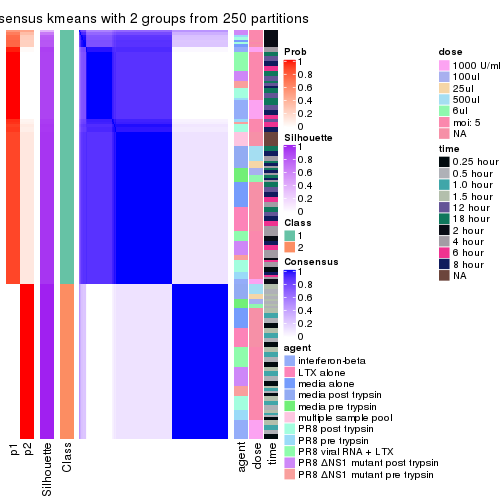
consensus_heatmap(res, k = 3)
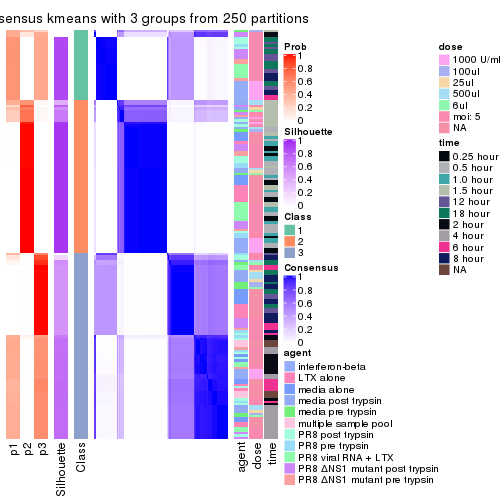
consensus_heatmap(res, k = 4)
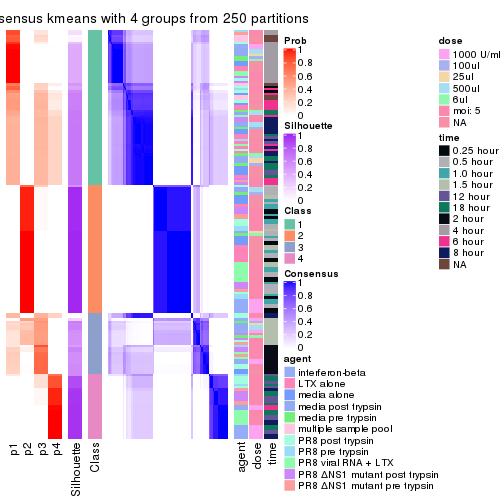
consensus_heatmap(res, k = 5)
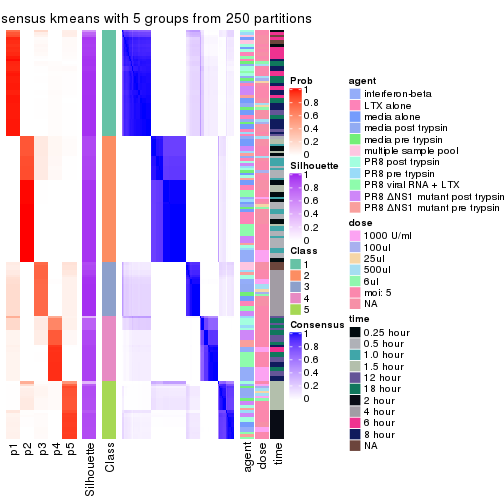
consensus_heatmap(res, k = 6)
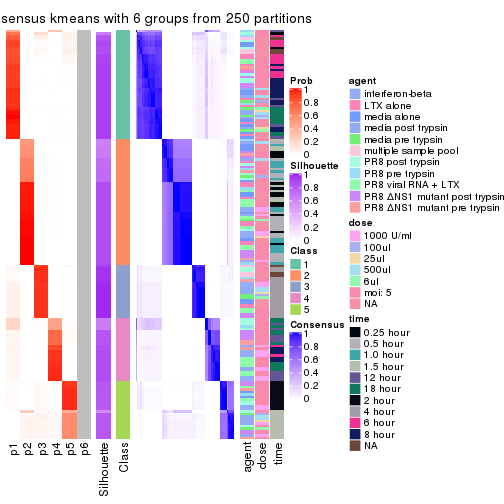
Heatmaps for the membership of samples in all partitions to see how consistent they are:
membership_heatmap(res, k = 2)
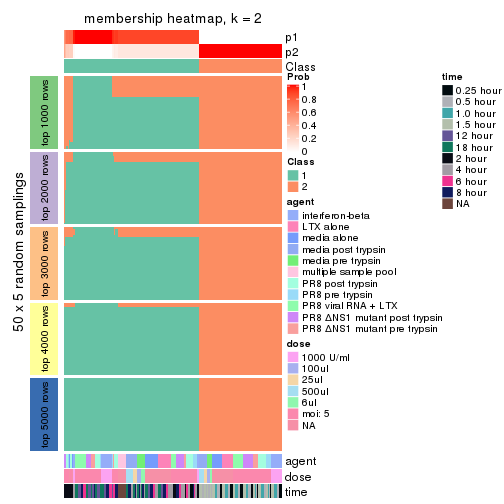
membership_heatmap(res, k = 3)
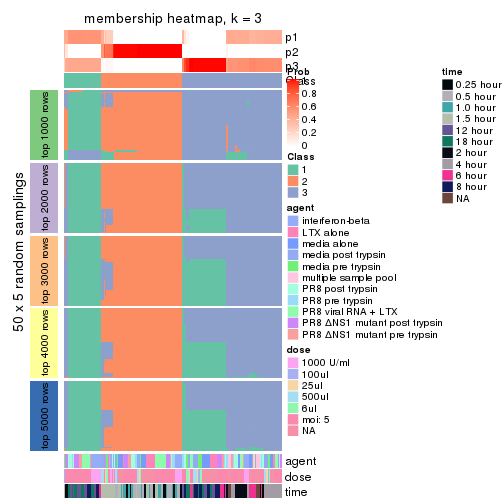
membership_heatmap(res, k = 4)
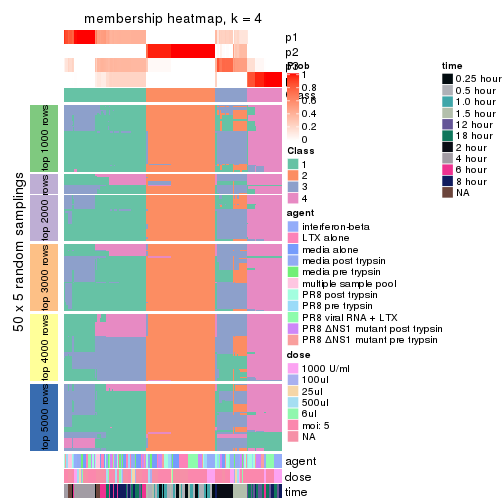
membership_heatmap(res, k = 5)
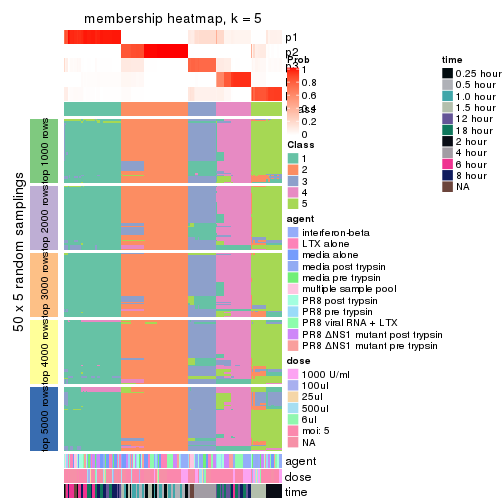
membership_heatmap(res, k = 6)
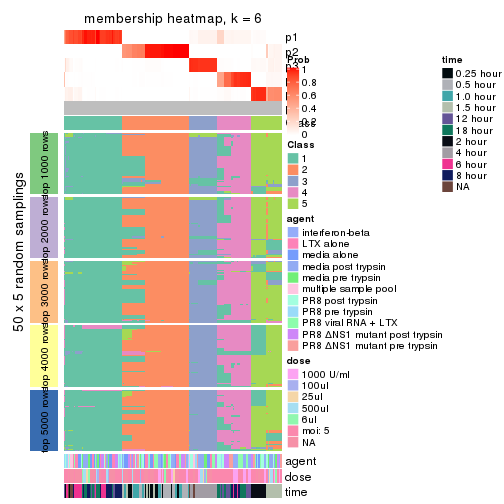
As soon as we have had the classes for columns, we can look for signatures which are significantly different between classes which can be candidate marks for certain classes. Following are the heatmaps for signatures.
Signature heatmaps where rows are scaled:
get_signatures(res, k = 2)
#> Error in mat[ceiling(1:nr/h_ratio), ceiling(1:nc/w_ratio), drop = FALSE]: subscript out of bounds
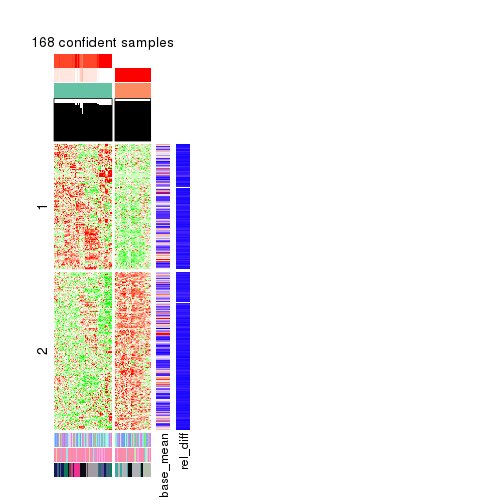
get_signatures(res, k = 3)
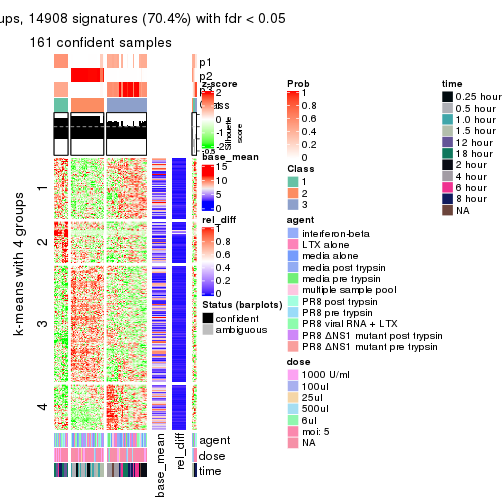
get_signatures(res, k = 4)
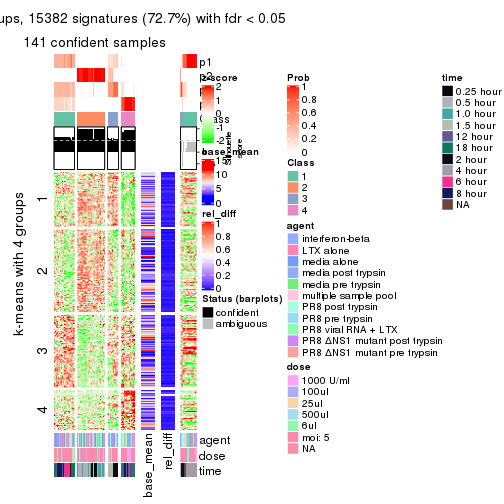
get_signatures(res, k = 5)
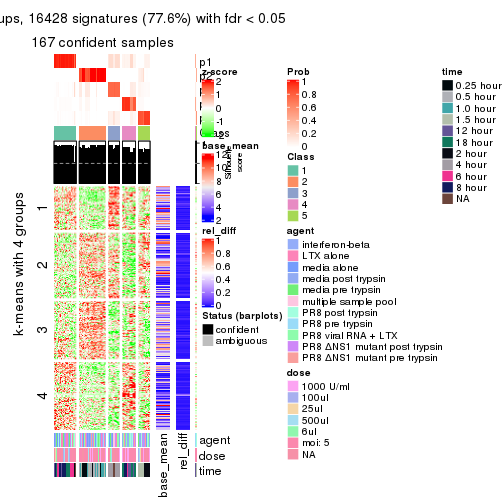
get_signatures(res, k = 6)
#> Error in mat[ceiling(1:nr/h_ratio), ceiling(1:nc/w_ratio), drop = FALSE]: subscript out of bounds
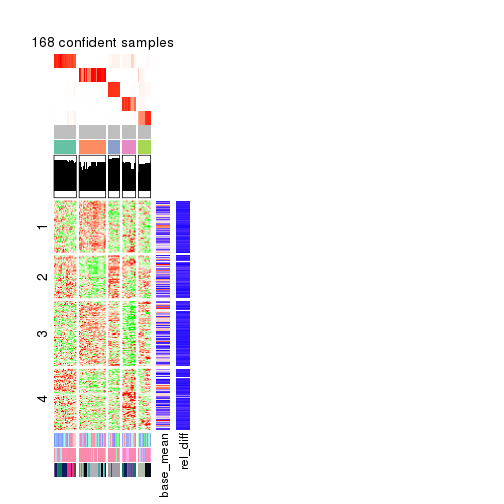
Signature heatmaps where rows are not scaled:
get_signatures(res, k = 2, scale_rows = FALSE)
#> Error in mat[ceiling(1:nr/h_ratio), ceiling(1:nc/w_ratio), drop = FALSE]: subscript out of bounds
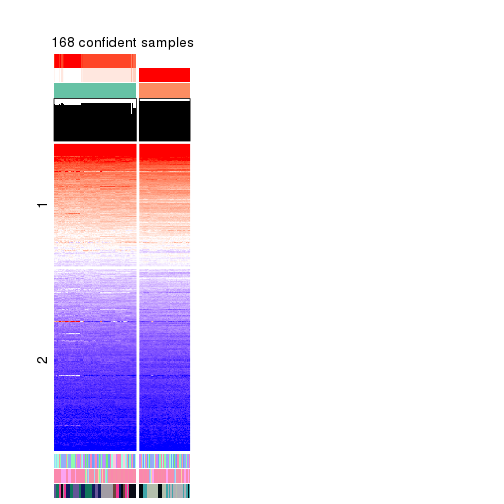
get_signatures(res, k = 3, scale_rows = FALSE)
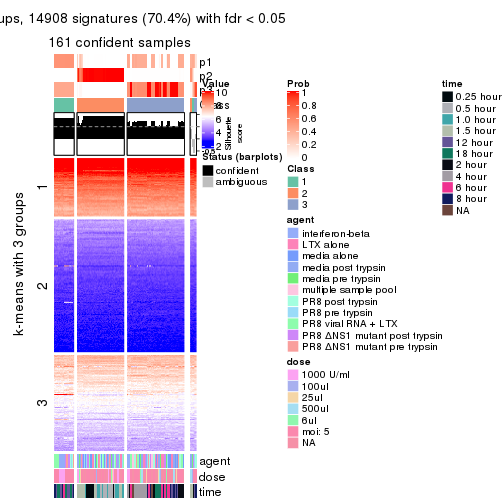
get_signatures(res, k = 4, scale_rows = FALSE)

get_signatures(res, k = 5, scale_rows = FALSE)
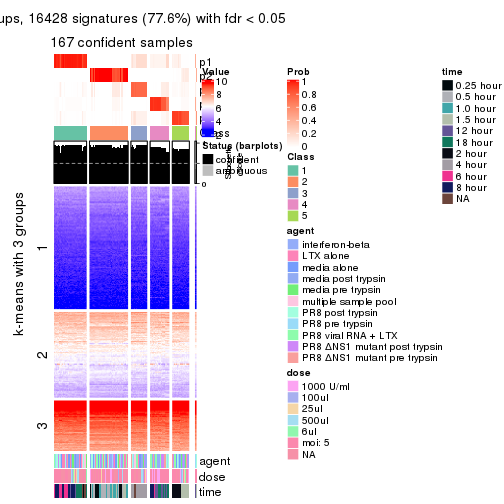
get_signatures(res, k = 6, scale_rows = FALSE)
#> Error in mat[ceiling(1:nr/h_ratio), ceiling(1:nc/w_ratio), drop = FALSE]: subscript out of bounds
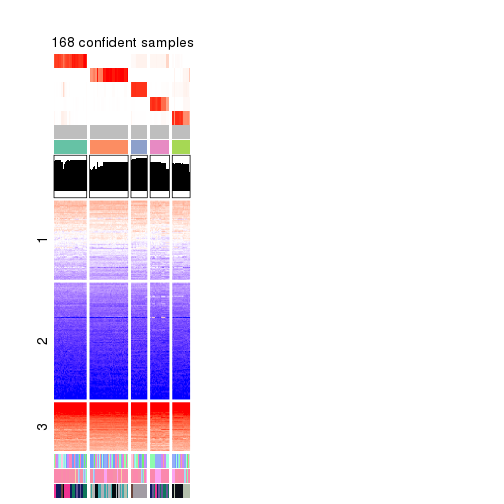
Compare the overlap of signatures from different k:
compare_signatures(res)
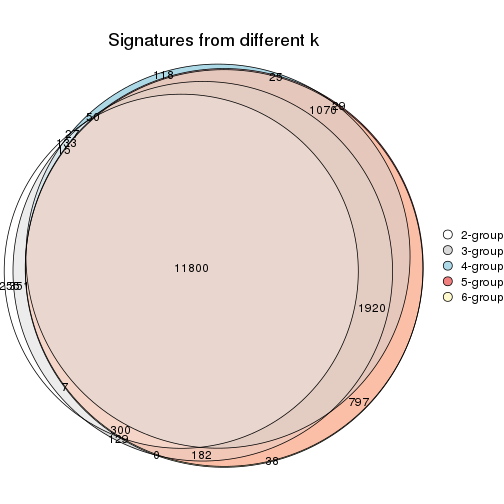
get_signature() returns a data frame invisibly. TO get the list of signatures, the function
call should be assigned to a variable explicitly. In following code, if plot argument is set
to FALSE, no heatmap is plotted while only the differential analysis is performed.
# code only for demonstration
tb = get_signature(res, k = ..., plot = FALSE)
An example of the output of tb is:
#> which_row fdr mean_1 mean_2 scaled_mean_1 scaled_mean_2 km
#> 1 38 0.042760348 8.373488 9.131774 -0.5533452 0.5164555 1
#> 2 40 0.018707592 7.106213 8.469186 -0.6173731 0.5762149 1
#> 3 55 0.019134737 10.221463 11.207825 -0.6159697 0.5749050 1
#> 4 59 0.006059896 5.921854 7.869574 -0.6899429 0.6439467 1
#> 5 60 0.018055526 8.928898 10.211722 -0.6204761 0.5791110 1
#> 6 98 0.009384629 15.714769 14.887706 0.6635654 -0.6193277 2
...
The columns in tb are:
which_row: row indices corresponding to the input matrix.fdr: FDR for the differential test. mean_x: The mean value in group x.scaled_mean_x: The mean value in group x after rows are scaled.km: Row groups if k-means clustering is applied to rows.UMAP plot which shows how samples are separated.
dimension_reduction(res, k = 2, method = "UMAP")
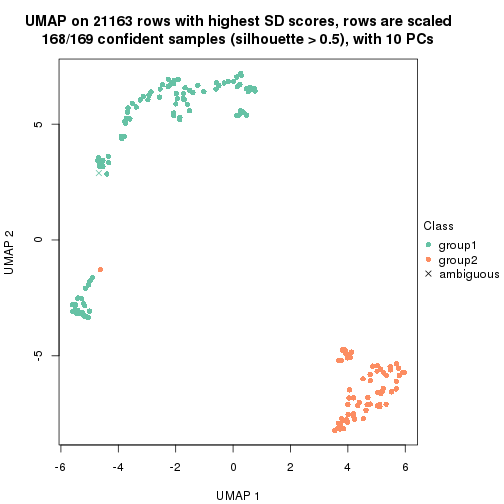
dimension_reduction(res, k = 3, method = "UMAP")
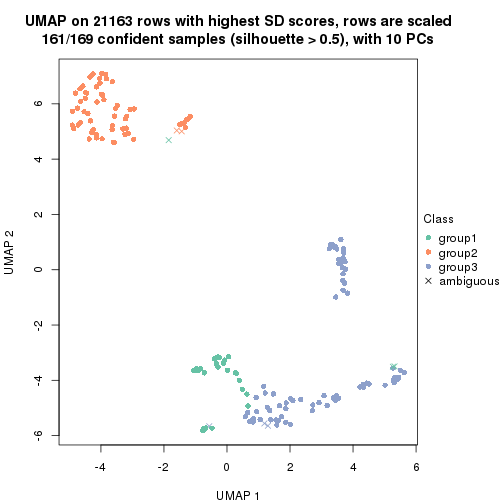
dimension_reduction(res, k = 4, method = "UMAP")
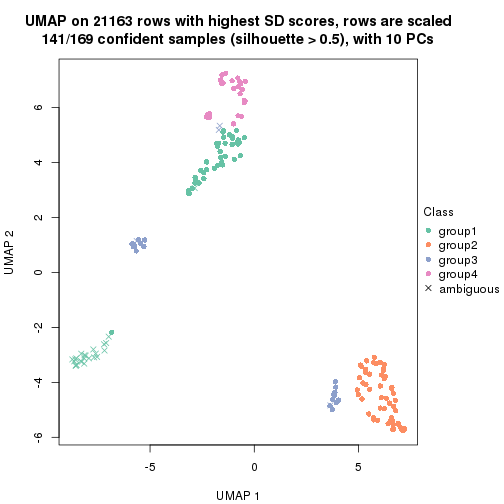
dimension_reduction(res, k = 5, method = "UMAP")
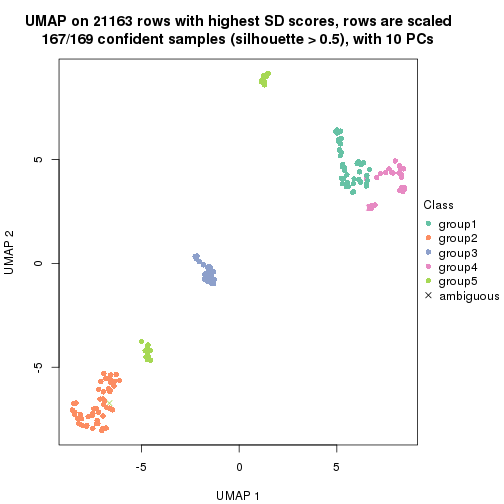
dimension_reduction(res, k = 6, method = "UMAP")
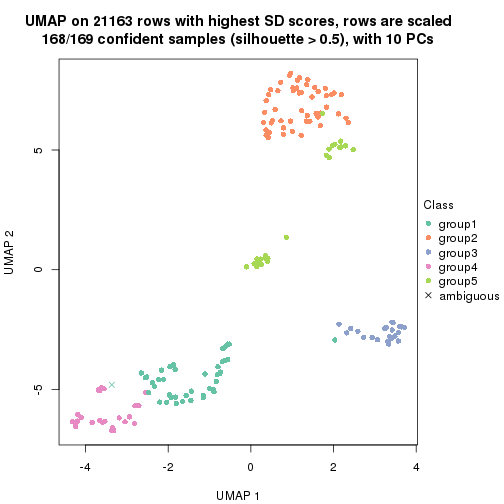
Following heatmap shows how subgroups are split when increasing k:
collect_classes(res)
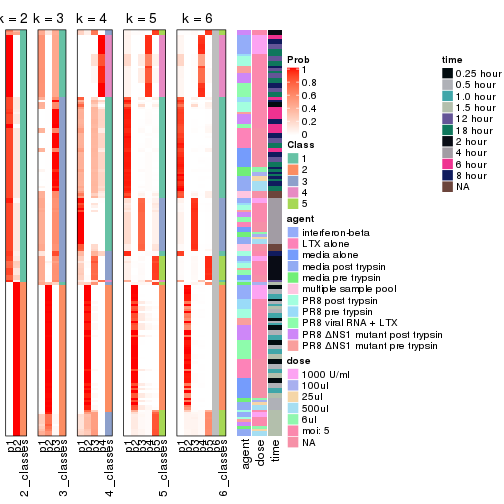
Test correlation between subgroups and known annotations. If the known annotation is numeric, one-way ANOVA test is applied, and if the known annotation is discrete, chi-squared contingency table test is applied.
test_to_known_factors(res)
#> n agent(p) dose(p) time(p) k
#> SD:kmeans 168 0.90117 0.999961 2.29e-29 2
#> SD:kmeans 161 0.00872 0.001702 4.50e-33 3
#> SD:kmeans 141 0.00435 0.000542 1.21e-40 4
#> SD:kmeans 167 0.02873 0.013444 3.09e-73 5
#> SD:kmeans 168 0.02563 0.012512 9.35e-74 6
If matrix rows can be associated to genes, consider to use functional_enrichment(res,
...) to perform function enrichment for the signature genes. See this vignette for more detailed explanations.
The object with results only for a single top-value method and a single partition method can be extracted as:
res = res_list["SD", "skmeans"]
# you can also extract it by
# res = res_list["SD:skmeans"]
A summary of res and all the functions that can be applied to it:
res
#> A 'ConsensusPartition' object with k = 2, 3, 4, 5, 6.
#> On a matrix with 21163 rows and 169 columns.
#> Top rows (1000, 2000, 3000, 4000, 5000) are extracted by 'SD' method.
#> Subgroups are detected by 'skmeans' method.
#> Performed in total 1250 partitions by row resampling.
#> Best k for subgroups seems to be 6.
#>
#> Following methods can be applied to this 'ConsensusPartition' object:
#> [1] "cola_report" "collect_classes" "collect_plots"
#> [4] "collect_stats" "colnames" "compare_signatures"
#> [7] "consensus_heatmap" "dimension_reduction" "functional_enrichment"
#> [10] "get_anno_col" "get_anno" "get_classes"
#> [13] "get_consensus" "get_matrix" "get_membership"
#> [16] "get_param" "get_signatures" "get_stats"
#> [19] "is_best_k" "is_stable_k" "membership_heatmap"
#> [22] "ncol" "nrow" "plot_ecdf"
#> [25] "rownames" "select_partition_number" "show"
#> [28] "suggest_best_k" "test_to_known_factors"
collect_plots() function collects all the plots made from res for all k (number of partitions)
into one single page to provide an easy and fast comparison between different k.
collect_plots(res)
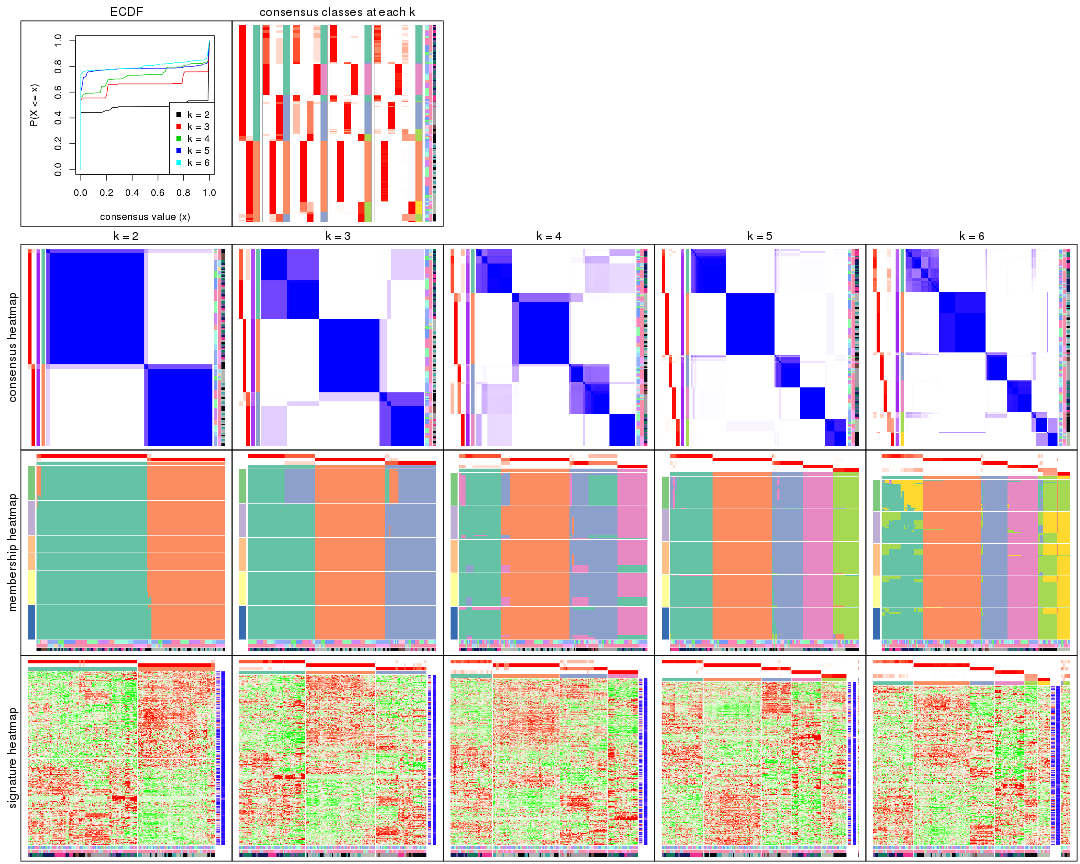
The plots are:
k and the heatmap of
predicted classes for each k.k.k.k.All the plots in panels can be made by individual functions and they are plotted later in this section.
select_partition_number() produces several plots showing different
statistics for choosing “optimized” k. There are following statistics:
k;k, the area increased is defined as \(A_k - A_{k-1}\).The detailed explanations of these statistics can be found in the cola vignette.
Generally speaking, lower PAC score, higher mean silhouette score or higher
concordance corresponds to better partition. Rand index and Jaccard index
measure how similar the current partition is compared to partition with k-1.
If they are too similar, we won't accept k is better than k-1.
select_partition_number(res)
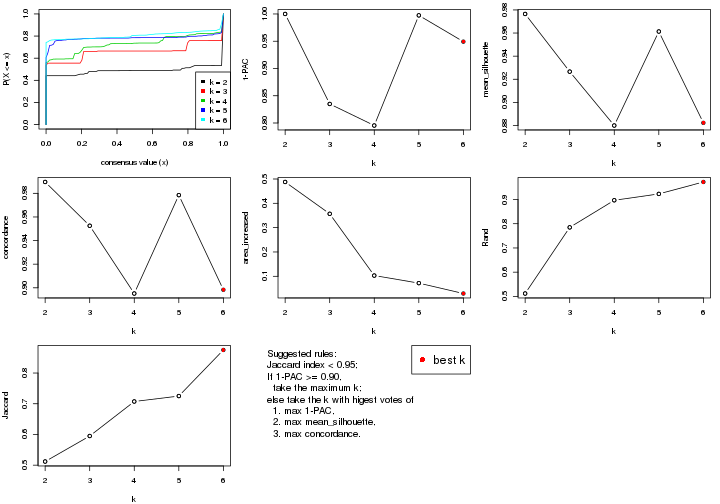
The numeric values for all these statistics can be obtained by get_stats().
get_stats(res)
#> k 1-PAC mean_silhouette concordance area_increased Rand Jaccard
#> 2 2 1.000 0.977 0.990 0.4878 0.512 0.512
#> 3 3 0.835 0.927 0.953 0.3569 0.785 0.595
#> 4 4 0.795 0.880 0.895 0.1031 0.897 0.707
#> 5 5 0.997 0.961 0.978 0.0720 0.923 0.725
#> 6 6 0.949 0.882 0.898 0.0292 0.972 0.875
suggest_best_k() suggests the best \(k\) based on these statistics. The rules are as follows:
suggest_best_k(res)
#> [1] 6
#> attr(,"optional")
#> [1] 2 5
There is also optional best \(k\) = 2 5 that is worth to check.
Following shows the table of the partitions (You need to click the show/hide
code output link to see it). The membership matrix (columns with name p*)
is inferred by
clue::cl_consensus()
function with the SE method. Basically the value in the membership matrix
represents the probability to belong to a certain group. The finall class
label for an item is determined with the group with highest probability it
belongs to.
In get_classes() function, the entropy is calculated from the membership
matrix and the silhouette score is calculated from the consensus matrix.
cbind(get_classes(res, k = 2), get_membership(res, k = 2))
#> class entropy silhouette p1 p2
#> GSM528681 2 0.000 0.985 0.000 1.000
#> GSM528682 2 0.000 0.985 0.000 1.000
#> GSM528683 2 0.000 0.985 0.000 1.000
#> GSM528684 2 0.000 0.985 0.000 1.000
#> GSM528687 2 0.000 0.985 0.000 1.000
#> GSM528688 2 0.000 0.985 0.000 1.000
#> GSM528685 2 0.000 0.985 0.000 1.000
#> GSM528686 2 0.000 0.985 0.000 1.000
#> GSM528693 1 0.000 0.992 1.000 0.000
#> GSM528694 1 0.000 0.992 1.000 0.000
#> GSM528695 1 0.000 0.992 1.000 0.000
#> GSM528696 1 0.000 0.992 1.000 0.000
#> GSM528697 1 0.000 0.992 1.000 0.000
#> GSM528698 1 0.000 0.992 1.000 0.000
#> GSM528699 1 0.000 0.992 1.000 0.000
#> GSM528700 1 0.000 0.992 1.000 0.000
#> GSM528689 1 0.000 0.992 1.000 0.000
#> GSM528690 1 0.000 0.992 1.000 0.000
#> GSM528691 1 0.000 0.992 1.000 0.000
#> GSM528692 1 0.000 0.992 1.000 0.000
#> GSM528779 2 0.000 0.985 0.000 1.000
#> GSM528780 2 0.000 0.985 0.000 1.000
#> GSM528782 2 0.000 0.985 0.000 1.000
#> GSM528781 2 0.000 0.985 0.000 1.000
#> GSM528785 2 0.795 0.691 0.240 0.760
#> GSM528786 1 0.000 0.992 1.000 0.000
#> GSM528787 1 0.000 0.992 1.000 0.000
#> GSM528788 1 0.000 0.992 1.000 0.000
#> GSM528783 1 0.000 0.992 1.000 0.000
#> GSM528784 1 0.000 0.992 1.000 0.000
#> GSM528759 1 0.000 0.992 1.000 0.000
#> GSM528760 1 0.000 0.992 1.000 0.000
#> GSM528761 2 0.000 0.985 0.000 1.000
#> GSM528762 2 0.000 0.985 0.000 1.000
#> GSM528765 2 0.000 0.985 0.000 1.000
#> GSM528766 2 0.000 0.985 0.000 1.000
#> GSM528763 2 0.000 0.985 0.000 1.000
#> GSM528764 2 0.000 0.985 0.000 1.000
#> GSM528771 2 0.753 0.729 0.216 0.784
#> GSM528772 2 0.795 0.691 0.240 0.760
#> GSM528773 1 0.000 0.992 1.000 0.000
#> GSM528774 1 0.000 0.992 1.000 0.000
#> GSM528775 1 0.000 0.992 1.000 0.000
#> GSM528776 1 0.000 0.992 1.000 0.000
#> GSM528777 1 0.000 0.992 1.000 0.000
#> GSM528778 1 0.000 0.992 1.000 0.000
#> GSM528767 1 0.000 0.992 1.000 0.000
#> GSM528768 1 0.000 0.992 1.000 0.000
#> GSM528769 1 0.000 0.992 1.000 0.000
#> GSM528770 1 0.000 0.992 1.000 0.000
#> GSM528671 2 0.000 0.985 0.000 1.000
#> GSM528672 2 0.000 0.985 0.000 1.000
#> GSM528674 2 0.000 0.985 0.000 1.000
#> GSM528673 2 0.000 0.985 0.000 1.000
#> GSM528677 1 0.689 0.775 0.816 0.184
#> GSM528678 1 0.000 0.992 1.000 0.000
#> GSM528679 1 0.000 0.992 1.000 0.000
#> GSM528680 1 0.000 0.992 1.000 0.000
#> GSM528675 1 0.000 0.992 1.000 0.000
#> GSM528676 1 0.000 0.992 1.000 0.000
#> GSM528651 2 0.000 0.985 0.000 1.000
#> GSM528652 2 0.000 0.985 0.000 1.000
#> GSM528653 2 0.000 0.985 0.000 1.000
#> GSM528654 2 0.000 0.985 0.000 1.000
#> GSM528657 2 0.000 0.985 0.000 1.000
#> GSM528658 2 0.000 0.985 0.000 1.000
#> GSM528655 2 0.000 0.985 0.000 1.000
#> GSM528656 2 0.000 0.985 0.000 1.000
#> GSM528663 2 0.000 0.985 0.000 1.000
#> GSM528664 2 0.000 0.985 0.000 1.000
#> GSM528665 1 0.000 0.992 1.000 0.000
#> GSM528666 1 0.000 0.992 1.000 0.000
#> GSM528667 1 0.000 0.992 1.000 0.000
#> GSM528668 1 0.000 0.992 1.000 0.000
#> GSM528669 1 0.000 0.992 1.000 0.000
#> GSM528670 1 0.000 0.992 1.000 0.000
#> GSM528659 1 0.000 0.992 1.000 0.000
#> GSM528660 1 0.000 0.992 1.000 0.000
#> GSM528661 1 0.000 0.992 1.000 0.000
#> GSM528662 1 0.000 0.992 1.000 0.000
#> GSM528701 2 0.000 0.985 0.000 1.000
#> GSM528702 2 0.000 0.985 0.000 1.000
#> GSM528703 2 0.000 0.985 0.000 1.000
#> GSM528704 2 0.000 0.985 0.000 1.000
#> GSM528707 2 0.000 0.985 0.000 1.000
#> GSM528708 2 0.000 0.985 0.000 1.000
#> GSM528705 2 0.000 0.985 0.000 1.000
#> GSM528706 2 0.000 0.985 0.000 1.000
#> GSM528713 1 0.653 0.798 0.832 0.168
#> GSM528714 1 0.671 0.786 0.824 0.176
#> GSM528715 1 0.000 0.992 1.000 0.000
#> GSM528716 1 0.000 0.992 1.000 0.000
#> GSM528717 1 0.000 0.992 1.000 0.000
#> GSM528718 1 0.000 0.992 1.000 0.000
#> GSM528719 1 0.000 0.992 1.000 0.000
#> GSM528720 1 0.000 0.992 1.000 0.000
#> GSM528709 1 0.000 0.992 1.000 0.000
#> GSM528710 1 0.000 0.992 1.000 0.000
#> GSM528711 1 0.000 0.992 1.000 0.000
#> GSM528712 1 0.000 0.992 1.000 0.000
#> GSM528721 2 0.000 0.985 0.000 1.000
#> GSM528722 2 0.000 0.985 0.000 1.000
#> GSM528723 2 0.000 0.985 0.000 1.000
#> GSM528724 2 0.000 0.985 0.000 1.000
#> GSM528727 2 0.000 0.985 0.000 1.000
#> GSM528728 2 0.000 0.985 0.000 1.000
#> GSM528725 2 0.000 0.985 0.000 1.000
#> GSM528726 2 0.000 0.985 0.000 1.000
#> GSM528733 1 0.000 0.992 1.000 0.000
#> GSM528734 1 0.000 0.992 1.000 0.000
#> GSM528735 1 0.000 0.992 1.000 0.000
#> GSM528736 1 0.000 0.992 1.000 0.000
#> GSM528737 1 0.000 0.992 1.000 0.000
#> GSM528738 1 0.000 0.992 1.000 0.000
#> GSM528729 1 0.000 0.992 1.000 0.000
#> GSM528730 1 0.000 0.992 1.000 0.000
#> GSM528731 1 0.000 0.992 1.000 0.000
#> GSM528732 1 0.000 0.992 1.000 0.000
#> GSM528739 2 0.000 0.985 0.000 1.000
#> GSM528740 2 0.000 0.985 0.000 1.000
#> GSM528741 2 0.000 0.985 0.000 1.000
#> GSM528742 2 0.000 0.985 0.000 1.000
#> GSM528745 2 0.000 0.985 0.000 1.000
#> GSM528746 2 0.000 0.985 0.000 1.000
#> GSM528743 2 0.000 0.985 0.000 1.000
#> GSM528744 2 0.000 0.985 0.000 1.000
#> GSM528751 2 0.866 0.604 0.288 0.712
#> GSM528752 1 0.795 0.684 0.760 0.240
#> GSM528753 1 0.000 0.992 1.000 0.000
#> GSM528754 1 0.000 0.992 1.000 0.000
#> GSM528755 1 0.000 0.992 1.000 0.000
#> GSM528756 1 0.000 0.992 1.000 0.000
#> GSM528757 1 0.000 0.992 1.000 0.000
#> GSM528758 1 0.000 0.992 1.000 0.000
#> GSM528747 1 0.000 0.992 1.000 0.000
#> GSM528748 1 0.000 0.992 1.000 0.000
#> GSM528749 1 0.000 0.992 1.000 0.000
#> GSM528750 1 0.000 0.992 1.000 0.000
#> GSM528640 2 0.000 0.985 0.000 1.000
#> GSM528641 2 0.000 0.985 0.000 1.000
#> GSM528643 1 0.000 0.992 1.000 0.000
#> GSM528644 1 0.000 0.992 1.000 0.000
#> GSM528642 1 0.000 0.992 1.000 0.000
#> GSM528620 2 0.000 0.985 0.000 1.000
#> GSM528621 2 0.000 0.985 0.000 1.000
#> GSM528623 1 0.000 0.992 1.000 0.000
#> GSM528624 1 0.000 0.992 1.000 0.000
#> GSM528622 1 0.000 0.992 1.000 0.000
#> GSM528625 2 0.000 0.985 0.000 1.000
#> GSM528626 2 0.000 0.985 0.000 1.000
#> GSM528628 1 0.000 0.992 1.000 0.000
#> GSM528629 1 0.000 0.992 1.000 0.000
#> GSM528627 1 0.000 0.992 1.000 0.000
#> GSM528630 2 0.000 0.985 0.000 1.000
#> GSM528631 2 0.000 0.985 0.000 1.000
#> GSM528632 2 0.000 0.985 0.000 1.000
#> GSM528633 2 0.000 0.985 0.000 1.000
#> GSM528636 1 0.000 0.992 1.000 0.000
#> GSM528637 1 0.000 0.992 1.000 0.000
#> GSM528638 1 0.000 0.992 1.000 0.000
#> GSM528639 1 0.000 0.992 1.000 0.000
#> GSM528634 1 0.000 0.992 1.000 0.000
#> GSM528635 1 0.000 0.992 1.000 0.000
#> GSM528645 1 0.000 0.992 1.000 0.000
#> GSM528646 1 0.000 0.992 1.000 0.000
#> GSM528647 1 0.000 0.992 1.000 0.000
#> GSM528648 1 0.000 0.992 1.000 0.000
#> GSM528649 1 0.000 0.992 1.000 0.000
#> GSM528650 1 0.000 0.992 1.000 0.000
cbind(get_classes(res, k = 3), get_membership(res, k = 3))
#> class entropy silhouette p1 p2 p3
#> GSM528681 2 0.0000 1.000 0.000 1.000 0.000
#> GSM528682 2 0.0000 1.000 0.000 1.000 0.000
#> GSM528683 2 0.0000 1.000 0.000 1.000 0.000
#> GSM528684 2 0.0000 1.000 0.000 1.000 0.000
#> GSM528687 2 0.0000 1.000 0.000 1.000 0.000
#> GSM528688 2 0.0000 1.000 0.000 1.000 0.000
#> GSM528685 2 0.0000 1.000 0.000 1.000 0.000
#> GSM528686 2 0.0000 1.000 0.000 1.000 0.000
#> GSM528693 3 0.4555 0.764 0.200 0.000 0.800
#> GSM528694 3 0.4555 0.764 0.200 0.000 0.800
#> GSM528695 3 0.4605 0.760 0.204 0.000 0.796
#> GSM528696 3 0.4605 0.760 0.204 0.000 0.796
#> GSM528697 1 0.0000 0.897 1.000 0.000 0.000
#> GSM528698 1 0.0000 0.897 1.000 0.000 0.000
#> GSM528699 1 0.0000 0.897 1.000 0.000 0.000
#> GSM528700 1 0.0000 0.897 1.000 0.000 0.000
#> GSM528689 1 0.0000 0.897 1.000 0.000 0.000
#> GSM528690 1 0.0000 0.897 1.000 0.000 0.000
#> GSM528691 1 0.0000 0.897 1.000 0.000 0.000
#> GSM528692 1 0.0000 0.897 1.000 0.000 0.000
#> GSM528779 2 0.0000 1.000 0.000 1.000 0.000
#> GSM528780 2 0.0000 1.000 0.000 1.000 0.000
#> GSM528782 2 0.0000 1.000 0.000 1.000 0.000
#> GSM528781 2 0.0000 1.000 0.000 1.000 0.000
#> GSM528785 3 0.4555 0.767 0.000 0.200 0.800
#> GSM528786 3 0.0000 0.931 0.000 0.000 1.000
#> GSM528787 3 0.0000 0.931 0.000 0.000 1.000
#> GSM528788 1 0.4605 0.863 0.796 0.000 0.204
#> GSM528783 1 0.0000 0.897 1.000 0.000 0.000
#> GSM528784 1 0.0000 0.897 1.000 0.000 0.000
#> GSM528759 3 0.0000 0.931 0.000 0.000 1.000
#> GSM528760 3 0.0000 0.931 0.000 0.000 1.000
#> GSM528761 2 0.0000 1.000 0.000 1.000 0.000
#> GSM528762 2 0.0000 1.000 0.000 1.000 0.000
#> GSM528765 2 0.0000 1.000 0.000 1.000 0.000
#> GSM528766 2 0.0000 1.000 0.000 1.000 0.000
#> GSM528763 2 0.0000 1.000 0.000 1.000 0.000
#> GSM528764 2 0.0000 1.000 0.000 1.000 0.000
#> GSM528771 3 0.4555 0.767 0.000 0.200 0.800
#> GSM528772 3 0.4504 0.772 0.000 0.196 0.804
#> GSM528773 3 0.0000 0.931 0.000 0.000 1.000
#> GSM528774 3 0.0000 0.931 0.000 0.000 1.000
#> GSM528775 3 0.0000 0.931 0.000 0.000 1.000
#> GSM528776 1 0.4605 0.863 0.796 0.000 0.204
#> GSM528777 1 0.0000 0.897 1.000 0.000 0.000
#> GSM528778 1 0.0000 0.897 1.000 0.000 0.000
#> GSM528767 1 0.0000 0.897 1.000 0.000 0.000
#> GSM528768 1 0.0000 0.897 1.000 0.000 0.000
#> GSM528769 1 0.0000 0.897 1.000 0.000 0.000
#> GSM528770 1 0.0000 0.897 1.000 0.000 0.000
#> GSM528671 2 0.0000 1.000 0.000 1.000 0.000
#> GSM528672 2 0.0000 1.000 0.000 1.000 0.000
#> GSM528674 2 0.0000 1.000 0.000 1.000 0.000
#> GSM528673 2 0.0000 1.000 0.000 1.000 0.000
#> GSM528677 3 0.0000 0.931 0.000 0.000 1.000
#> GSM528678 3 0.0000 0.931 0.000 0.000 1.000
#> GSM528679 1 0.4605 0.863 0.796 0.000 0.204
#> GSM528680 1 0.0000 0.897 1.000 0.000 0.000
#> GSM528675 1 0.0000 0.897 1.000 0.000 0.000
#> GSM528676 1 0.0000 0.897 1.000 0.000 0.000
#> GSM528651 2 0.0000 1.000 0.000 1.000 0.000
#> GSM528652 2 0.0000 1.000 0.000 1.000 0.000
#> GSM528653 2 0.0000 1.000 0.000 1.000 0.000
#> GSM528654 2 0.0000 1.000 0.000 1.000 0.000
#> GSM528657 2 0.0000 1.000 0.000 1.000 0.000
#> GSM528658 2 0.0000 1.000 0.000 1.000 0.000
#> GSM528655 2 0.0000 1.000 0.000 1.000 0.000
#> GSM528656 2 0.0000 1.000 0.000 1.000 0.000
#> GSM528663 3 0.4605 0.761 0.000 0.204 0.796
#> GSM528664 3 0.4605 0.761 0.000 0.204 0.796
#> GSM528665 3 0.0000 0.931 0.000 0.000 1.000
#> GSM528666 3 0.0000 0.931 0.000 0.000 1.000
#> GSM528667 1 0.4605 0.863 0.796 0.000 0.204
#> GSM528668 1 0.4605 0.863 0.796 0.000 0.204
#> GSM528669 1 0.0000 0.897 1.000 0.000 0.000
#> GSM528670 1 0.0000 0.897 1.000 0.000 0.000
#> GSM528659 1 0.0000 0.897 1.000 0.000 0.000
#> GSM528660 1 0.0000 0.897 1.000 0.000 0.000
#> GSM528661 1 0.0000 0.897 1.000 0.000 0.000
#> GSM528662 1 0.0000 0.897 1.000 0.000 0.000
#> GSM528701 2 0.0000 1.000 0.000 1.000 0.000
#> GSM528702 2 0.0000 1.000 0.000 1.000 0.000
#> GSM528703 2 0.0000 1.000 0.000 1.000 0.000
#> GSM528704 2 0.0000 1.000 0.000 1.000 0.000
#> GSM528707 2 0.0000 1.000 0.000 1.000 0.000
#> GSM528708 2 0.0000 1.000 0.000 1.000 0.000
#> GSM528705 2 0.0000 1.000 0.000 1.000 0.000
#> GSM528706 2 0.0000 1.000 0.000 1.000 0.000
#> GSM528713 3 0.0000 0.931 0.000 0.000 1.000
#> GSM528714 3 0.0000 0.931 0.000 0.000 1.000
#> GSM528715 3 0.0000 0.931 0.000 0.000 1.000
#> GSM528716 3 0.0000 0.931 0.000 0.000 1.000
#> GSM528717 1 0.0237 0.897 0.996 0.000 0.004
#> GSM528718 1 0.0424 0.896 0.992 0.000 0.008
#> GSM528719 1 0.0000 0.897 1.000 0.000 0.000
#> GSM528720 1 0.0000 0.897 1.000 0.000 0.000
#> GSM528709 1 0.0000 0.897 1.000 0.000 0.000
#> GSM528710 1 0.0000 0.897 1.000 0.000 0.000
#> GSM528711 1 0.0000 0.897 1.000 0.000 0.000
#> GSM528712 1 0.0000 0.897 1.000 0.000 0.000
#> GSM528721 2 0.0000 1.000 0.000 1.000 0.000
#> GSM528722 2 0.0000 1.000 0.000 1.000 0.000
#> GSM528723 2 0.0000 1.000 0.000 1.000 0.000
#> GSM528724 2 0.0000 1.000 0.000 1.000 0.000
#> GSM528727 2 0.0000 1.000 0.000 1.000 0.000
#> GSM528728 2 0.0000 1.000 0.000 1.000 0.000
#> GSM528725 2 0.0000 1.000 0.000 1.000 0.000
#> GSM528726 2 0.0000 1.000 0.000 1.000 0.000
#> GSM528733 3 0.0000 0.931 0.000 0.000 1.000
#> GSM528734 3 0.0000 0.931 0.000 0.000 1.000
#> GSM528735 3 0.0000 0.931 0.000 0.000 1.000
#> GSM528736 3 0.0000 0.931 0.000 0.000 1.000
#> GSM528737 1 0.4605 0.863 0.796 0.000 0.204
#> GSM528738 1 0.4605 0.863 0.796 0.000 0.204
#> GSM528729 1 0.4605 0.863 0.796 0.000 0.204
#> GSM528730 1 0.4605 0.863 0.796 0.000 0.204
#> GSM528731 1 0.4605 0.863 0.796 0.000 0.204
#> GSM528732 1 0.4605 0.863 0.796 0.000 0.204
#> GSM528739 2 0.0000 1.000 0.000 1.000 0.000
#> GSM528740 2 0.0000 1.000 0.000 1.000 0.000
#> GSM528741 2 0.0000 1.000 0.000 1.000 0.000
#> GSM528742 2 0.0000 1.000 0.000 1.000 0.000
#> GSM528745 2 0.0000 1.000 0.000 1.000 0.000
#> GSM528746 2 0.0000 1.000 0.000 1.000 0.000
#> GSM528743 2 0.0000 1.000 0.000 1.000 0.000
#> GSM528744 2 0.0000 1.000 0.000 1.000 0.000
#> GSM528751 3 0.4504 0.772 0.000 0.196 0.804
#> GSM528752 3 0.4504 0.772 0.000 0.196 0.804
#> GSM528753 3 0.0000 0.931 0.000 0.000 1.000
#> GSM528754 3 0.0000 0.931 0.000 0.000 1.000
#> GSM528755 3 0.0000 0.931 0.000 0.000 1.000
#> GSM528756 3 0.0000 0.931 0.000 0.000 1.000
#> GSM528757 1 0.4605 0.863 0.796 0.000 0.204
#> GSM528758 1 0.4605 0.863 0.796 0.000 0.204
#> GSM528747 1 0.4605 0.863 0.796 0.000 0.204
#> GSM528748 1 0.4605 0.863 0.796 0.000 0.204
#> GSM528749 1 0.4605 0.863 0.796 0.000 0.204
#> GSM528750 1 0.4605 0.863 0.796 0.000 0.204
#> GSM528640 2 0.0000 1.000 0.000 1.000 0.000
#> GSM528641 2 0.0000 1.000 0.000 1.000 0.000
#> GSM528643 3 0.0000 0.931 0.000 0.000 1.000
#> GSM528644 1 0.4605 0.863 0.796 0.000 0.204
#> GSM528642 1 0.4605 0.863 0.796 0.000 0.204
#> GSM528620 2 0.0000 1.000 0.000 1.000 0.000
#> GSM528621 3 0.5465 0.637 0.000 0.288 0.712
#> GSM528623 3 0.0000 0.931 0.000 0.000 1.000
#> GSM528624 1 0.4605 0.863 0.796 0.000 0.204
#> GSM528622 1 0.4605 0.863 0.796 0.000 0.204
#> GSM528625 2 0.0000 1.000 0.000 1.000 0.000
#> GSM528626 2 0.0000 1.000 0.000 1.000 0.000
#> GSM528628 3 0.0000 0.931 0.000 0.000 1.000
#> GSM528629 1 0.4605 0.863 0.796 0.000 0.204
#> GSM528627 1 0.4605 0.863 0.796 0.000 0.204
#> GSM528630 2 0.0000 1.000 0.000 1.000 0.000
#> GSM528631 2 0.0000 1.000 0.000 1.000 0.000
#> GSM528632 2 0.0000 1.000 0.000 1.000 0.000
#> GSM528633 2 0.0000 1.000 0.000 1.000 0.000
#> GSM528636 3 0.0000 0.931 0.000 0.000 1.000
#> GSM528637 3 0.0000 0.931 0.000 0.000 1.000
#> GSM528638 1 0.4605 0.863 0.796 0.000 0.204
#> GSM528639 1 0.4605 0.863 0.796 0.000 0.204
#> GSM528634 1 0.4702 0.855 0.788 0.000 0.212
#> GSM528635 1 0.4605 0.863 0.796 0.000 0.204
#> GSM528645 3 0.0000 0.931 0.000 0.000 1.000
#> GSM528646 3 0.0000 0.931 0.000 0.000 1.000
#> GSM528647 3 0.0000 0.931 0.000 0.000 1.000
#> GSM528648 3 0.0000 0.931 0.000 0.000 1.000
#> GSM528649 3 0.0000 0.931 0.000 0.000 1.000
#> GSM528650 3 0.0000 0.931 0.000 0.000 1.000
cbind(get_classes(res, k = 4), get_membership(res, k = 4))
#> class entropy silhouette p1 p2 p3 p4
#> GSM528681 2 0.0000 0.958 0.000 1.000 0.000 0.000
#> GSM528682 2 0.0000 0.958 0.000 1.000 0.000 0.000
#> GSM528683 2 0.0000 0.958 0.000 1.000 0.000 0.000
#> GSM528684 2 0.0000 0.958 0.000 1.000 0.000 0.000
#> GSM528687 2 0.0000 0.958 0.000 1.000 0.000 0.000
#> GSM528688 2 0.0000 0.958 0.000 1.000 0.000 0.000
#> GSM528685 2 0.4543 0.658 0.000 0.676 0.324 0.000
#> GSM528686 2 0.4605 0.642 0.000 0.664 0.336 0.000
#> GSM528693 3 0.0000 0.744 0.000 0.000 1.000 0.000
#> GSM528694 3 0.0000 0.744 0.000 0.000 1.000 0.000
#> GSM528695 3 0.6602 0.678 0.164 0.000 0.628 0.208
#> GSM528696 3 0.6602 0.678 0.164 0.000 0.628 0.208
#> GSM528697 4 0.0000 1.000 0.000 0.000 0.000 1.000
#> GSM528698 4 0.0000 1.000 0.000 0.000 0.000 1.000
#> GSM528699 4 0.0000 1.000 0.000 0.000 0.000 1.000
#> GSM528700 4 0.0000 1.000 0.000 0.000 0.000 1.000
#> GSM528689 4 0.0000 1.000 0.000 0.000 0.000 1.000
#> GSM528690 4 0.0000 1.000 0.000 0.000 0.000 1.000
#> GSM528691 4 0.0000 1.000 0.000 0.000 0.000 1.000
#> GSM528692 4 0.0000 1.000 0.000 0.000 0.000 1.000
#> GSM528779 2 0.0000 0.958 0.000 1.000 0.000 0.000
#> GSM528780 2 0.0000 0.958 0.000 1.000 0.000 0.000
#> GSM528782 2 0.0000 0.958 0.000 1.000 0.000 0.000
#> GSM528781 2 0.0000 0.958 0.000 1.000 0.000 0.000
#> GSM528785 3 0.0469 0.739 0.012 0.000 0.988 0.000
#> GSM528786 3 0.4713 0.826 0.360 0.000 0.640 0.000
#> GSM528787 3 0.4543 0.818 0.324 0.000 0.676 0.000
#> GSM528788 1 0.3172 0.915 0.840 0.000 0.000 0.160
#> GSM528783 4 0.0000 1.000 0.000 0.000 0.000 1.000
#> GSM528784 4 0.0000 1.000 0.000 0.000 0.000 1.000
#> GSM528759 3 0.4605 0.810 0.336 0.000 0.664 0.000
#> GSM528760 3 0.4543 0.818 0.324 0.000 0.676 0.000
#> GSM528761 2 0.0000 0.958 0.000 1.000 0.000 0.000
#> GSM528762 2 0.0000 0.958 0.000 1.000 0.000 0.000
#> GSM528765 2 0.0000 0.958 0.000 1.000 0.000 0.000
#> GSM528766 2 0.0000 0.958 0.000 1.000 0.000 0.000
#> GSM528763 2 0.0000 0.958 0.000 1.000 0.000 0.000
#> GSM528764 2 0.4605 0.642 0.000 0.664 0.336 0.000
#> GSM528771 3 0.0000 0.744 0.000 0.000 1.000 0.000
#> GSM528772 3 0.0000 0.744 0.000 0.000 1.000 0.000
#> GSM528773 3 0.4713 0.826 0.360 0.000 0.640 0.000
#> GSM528774 3 0.4713 0.826 0.360 0.000 0.640 0.000
#> GSM528775 1 0.1211 0.755 0.960 0.000 0.040 0.000
#> GSM528776 1 0.3123 0.916 0.844 0.000 0.000 0.156
#> GSM528777 1 0.4713 0.646 0.640 0.000 0.000 0.360
#> GSM528778 1 0.4713 0.646 0.640 0.000 0.000 0.360
#> GSM528767 4 0.0000 1.000 0.000 0.000 0.000 1.000
#> GSM528768 4 0.0000 1.000 0.000 0.000 0.000 1.000
#> GSM528769 4 0.0000 1.000 0.000 0.000 0.000 1.000
#> GSM528770 4 0.0000 1.000 0.000 0.000 0.000 1.000
#> GSM528671 2 0.0000 0.958 0.000 1.000 0.000 0.000
#> GSM528672 2 0.0000 0.958 0.000 1.000 0.000 0.000
#> GSM528674 2 0.0000 0.958 0.000 1.000 0.000 0.000
#> GSM528673 2 0.4605 0.642 0.000 0.664 0.336 0.000
#> GSM528677 3 0.0000 0.744 0.000 0.000 1.000 0.000
#> GSM528678 3 0.4713 0.826 0.360 0.000 0.640 0.000
#> GSM528679 1 0.3123 0.916 0.844 0.000 0.000 0.156
#> GSM528680 4 0.0000 1.000 0.000 0.000 0.000 1.000
#> GSM528675 4 0.0000 1.000 0.000 0.000 0.000 1.000
#> GSM528676 4 0.0000 1.000 0.000 0.000 0.000 1.000
#> GSM528651 2 0.0000 0.958 0.000 1.000 0.000 0.000
#> GSM528652 2 0.0000 0.958 0.000 1.000 0.000 0.000
#> GSM528653 2 0.0000 0.958 0.000 1.000 0.000 0.000
#> GSM528654 2 0.0000 0.958 0.000 1.000 0.000 0.000
#> GSM528657 2 0.0000 0.958 0.000 1.000 0.000 0.000
#> GSM528658 2 0.0000 0.958 0.000 1.000 0.000 0.000
#> GSM528655 2 0.4605 0.642 0.000 0.664 0.336 0.000
#> GSM528656 2 0.4605 0.642 0.000 0.664 0.336 0.000
#> GSM528663 3 0.0000 0.744 0.000 0.000 1.000 0.000
#> GSM528664 3 0.0000 0.744 0.000 0.000 1.000 0.000
#> GSM528665 3 0.4713 0.826 0.360 0.000 0.640 0.000
#> GSM528666 3 0.4713 0.826 0.360 0.000 0.640 0.000
#> GSM528667 1 0.3123 0.916 0.844 0.000 0.000 0.156
#> GSM528668 1 0.3123 0.916 0.844 0.000 0.000 0.156
#> GSM528669 1 0.4713 0.646 0.640 0.000 0.000 0.360
#> GSM528670 1 0.4713 0.646 0.640 0.000 0.000 0.360
#> GSM528659 4 0.0000 1.000 0.000 0.000 0.000 1.000
#> GSM528660 4 0.0000 1.000 0.000 0.000 0.000 1.000
#> GSM528661 4 0.0000 1.000 0.000 0.000 0.000 1.000
#> GSM528662 4 0.0000 1.000 0.000 0.000 0.000 1.000
#> GSM528701 2 0.0000 0.958 0.000 1.000 0.000 0.000
#> GSM528702 2 0.0000 0.958 0.000 1.000 0.000 0.000
#> GSM528703 2 0.0000 0.958 0.000 1.000 0.000 0.000
#> GSM528704 2 0.0000 0.958 0.000 1.000 0.000 0.000
#> GSM528707 2 0.0000 0.958 0.000 1.000 0.000 0.000
#> GSM528708 2 0.0000 0.958 0.000 1.000 0.000 0.000
#> GSM528705 2 0.0000 0.958 0.000 1.000 0.000 0.000
#> GSM528706 2 0.0000 0.958 0.000 1.000 0.000 0.000
#> GSM528713 3 0.0000 0.744 0.000 0.000 1.000 0.000
#> GSM528714 3 0.0000 0.744 0.000 0.000 1.000 0.000
#> GSM528715 3 0.4713 0.826 0.360 0.000 0.640 0.000
#> GSM528716 3 0.4713 0.826 0.360 0.000 0.640 0.000
#> GSM528717 1 0.4697 0.655 0.644 0.000 0.000 0.356
#> GSM528718 1 0.4605 0.691 0.664 0.000 0.000 0.336
#> GSM528719 4 0.0000 1.000 0.000 0.000 0.000 1.000
#> GSM528720 4 0.0000 1.000 0.000 0.000 0.000 1.000
#> GSM528709 4 0.0000 1.000 0.000 0.000 0.000 1.000
#> GSM528710 4 0.0000 1.000 0.000 0.000 0.000 1.000
#> GSM528711 4 0.0000 1.000 0.000 0.000 0.000 1.000
#> GSM528712 4 0.0000 1.000 0.000 0.000 0.000 1.000
#> GSM528721 2 0.0000 0.958 0.000 1.000 0.000 0.000
#> GSM528722 2 0.0000 0.958 0.000 1.000 0.000 0.000
#> GSM528723 2 0.0000 0.958 0.000 1.000 0.000 0.000
#> GSM528724 2 0.0000 0.958 0.000 1.000 0.000 0.000
#> GSM528727 2 0.0000 0.958 0.000 1.000 0.000 0.000
#> GSM528728 2 0.0000 0.958 0.000 1.000 0.000 0.000
#> GSM528725 2 0.0000 0.958 0.000 1.000 0.000 0.000
#> GSM528726 2 0.0000 0.958 0.000 1.000 0.000 0.000
#> GSM528733 3 0.4713 0.826 0.360 0.000 0.640 0.000
#> GSM528734 3 0.4713 0.826 0.360 0.000 0.640 0.000
#> GSM528735 1 0.1118 0.760 0.964 0.000 0.036 0.000
#> GSM528736 1 0.1118 0.760 0.964 0.000 0.036 0.000
#> GSM528737 1 0.3123 0.916 0.844 0.000 0.000 0.156
#> GSM528738 1 0.3123 0.916 0.844 0.000 0.000 0.156
#> GSM528729 1 0.3172 0.915 0.840 0.000 0.000 0.160
#> GSM528730 1 0.3172 0.915 0.840 0.000 0.000 0.160
#> GSM528731 1 0.3172 0.915 0.840 0.000 0.000 0.160
#> GSM528732 1 0.3123 0.916 0.844 0.000 0.000 0.156
#> GSM528739 2 0.0000 0.958 0.000 1.000 0.000 0.000
#> GSM528740 2 0.0000 0.958 0.000 1.000 0.000 0.000
#> GSM528741 2 0.0000 0.958 0.000 1.000 0.000 0.000
#> GSM528742 2 0.0000 0.958 0.000 1.000 0.000 0.000
#> GSM528745 2 0.0000 0.958 0.000 1.000 0.000 0.000
#> GSM528746 2 0.0000 0.958 0.000 1.000 0.000 0.000
#> GSM528743 2 0.0000 0.958 0.000 1.000 0.000 0.000
#> GSM528744 2 0.0000 0.958 0.000 1.000 0.000 0.000
#> GSM528751 3 0.0000 0.744 0.000 0.000 1.000 0.000
#> GSM528752 3 0.0000 0.744 0.000 0.000 1.000 0.000
#> GSM528753 3 0.4713 0.826 0.360 0.000 0.640 0.000
#> GSM528754 3 0.4713 0.826 0.360 0.000 0.640 0.000
#> GSM528755 1 0.1305 0.765 0.960 0.000 0.036 0.004
#> GSM528756 1 0.1118 0.760 0.964 0.000 0.036 0.000
#> GSM528757 1 0.3172 0.915 0.840 0.000 0.000 0.160
#> GSM528758 1 0.3172 0.915 0.840 0.000 0.000 0.160
#> GSM528747 1 0.3172 0.915 0.840 0.000 0.000 0.160
#> GSM528748 1 0.3123 0.916 0.844 0.000 0.000 0.156
#> GSM528749 1 0.3123 0.916 0.844 0.000 0.000 0.156
#> GSM528750 1 0.3123 0.916 0.844 0.000 0.000 0.156
#> GSM528640 2 0.0000 0.958 0.000 1.000 0.000 0.000
#> GSM528641 2 0.4605 0.642 0.000 0.664 0.336 0.000
#> GSM528643 3 0.4713 0.826 0.360 0.000 0.640 0.000
#> GSM528644 1 0.3172 0.915 0.840 0.000 0.000 0.160
#> GSM528642 1 0.0592 0.772 0.984 0.000 0.000 0.016
#> GSM528620 2 0.0000 0.958 0.000 1.000 0.000 0.000
#> GSM528621 3 0.0000 0.744 0.000 0.000 1.000 0.000
#> GSM528623 3 0.4713 0.826 0.360 0.000 0.640 0.000
#> GSM528624 1 0.3172 0.915 0.840 0.000 0.000 0.160
#> GSM528622 1 0.3123 0.916 0.844 0.000 0.000 0.156
#> GSM528625 2 0.0000 0.958 0.000 1.000 0.000 0.000
#> GSM528626 2 0.4624 0.636 0.000 0.660 0.340 0.000
#> GSM528628 3 0.4713 0.826 0.360 0.000 0.640 0.000
#> GSM528629 1 0.3172 0.915 0.840 0.000 0.000 0.160
#> GSM528627 1 0.3123 0.916 0.844 0.000 0.000 0.156
#> GSM528630 2 0.0000 0.958 0.000 1.000 0.000 0.000
#> GSM528631 2 0.0000 0.958 0.000 1.000 0.000 0.000
#> GSM528632 3 0.4418 0.569 0.032 0.184 0.784 0.000
#> GSM528633 3 0.4418 0.569 0.032 0.184 0.784 0.000
#> GSM528636 3 0.4713 0.826 0.360 0.000 0.640 0.000
#> GSM528637 3 0.4713 0.826 0.360 0.000 0.640 0.000
#> GSM528638 1 0.3172 0.915 0.840 0.000 0.000 0.160
#> GSM528639 1 0.3172 0.915 0.840 0.000 0.000 0.160
#> GSM528634 1 0.2408 0.873 0.896 0.000 0.000 0.104
#> GSM528635 1 0.3123 0.916 0.844 0.000 0.000 0.156
#> GSM528645 3 0.4661 0.826 0.348 0.000 0.652 0.000
#> GSM528646 3 0.4661 0.826 0.348 0.000 0.652 0.000
#> GSM528647 3 0.4661 0.826 0.348 0.000 0.652 0.000
#> GSM528648 3 0.4605 0.810 0.336 0.000 0.664 0.000
#> GSM528649 3 0.4543 0.818 0.324 0.000 0.676 0.000
#> GSM528650 3 0.4661 0.799 0.348 0.000 0.652 0.000
cbind(get_classes(res, k = 5), get_membership(res, k = 5))
#> class entropy silhouette p1 p2 p3 p4 p5
#> GSM528681 2 0.0000 0.9998 0.000 1.000 0.000 0.000 0.000
#> GSM528682 2 0.0000 0.9998 0.000 1.000 0.000 0.000 0.000
#> GSM528683 2 0.0000 0.9998 0.000 1.000 0.000 0.000 0.000
#> GSM528684 2 0.0000 0.9998 0.000 1.000 0.000 0.000 0.000
#> GSM528687 2 0.0000 0.9998 0.000 1.000 0.000 0.000 0.000
#> GSM528688 2 0.0000 0.9998 0.000 1.000 0.000 0.000 0.000
#> GSM528685 5 0.1569 0.9575 0.000 0.044 0.004 0.008 0.944
#> GSM528686 5 0.1569 0.9575 0.000 0.044 0.004 0.008 0.944
#> GSM528693 5 0.0162 0.9711 0.004 0.000 0.000 0.000 0.996
#> GSM528694 5 0.0162 0.9711 0.004 0.000 0.000 0.000 0.996
#> GSM528695 3 0.2280 0.8338 0.000 0.000 0.880 0.120 0.000
#> GSM528696 3 0.2280 0.8338 0.000 0.000 0.880 0.120 0.000
#> GSM528697 4 0.0290 1.0000 0.008 0.000 0.000 0.992 0.000
#> GSM528698 4 0.0290 1.0000 0.008 0.000 0.000 0.992 0.000
#> GSM528699 4 0.0290 1.0000 0.008 0.000 0.000 0.992 0.000
#> GSM528700 4 0.0290 1.0000 0.008 0.000 0.000 0.992 0.000
#> GSM528689 4 0.0290 1.0000 0.008 0.000 0.000 0.992 0.000
#> GSM528690 4 0.0290 1.0000 0.008 0.000 0.000 0.992 0.000
#> GSM528691 4 0.0290 1.0000 0.008 0.000 0.000 0.992 0.000
#> GSM528692 4 0.0290 1.0000 0.008 0.000 0.000 0.992 0.000
#> GSM528779 2 0.0000 0.9998 0.000 1.000 0.000 0.000 0.000
#> GSM528780 2 0.0000 0.9998 0.000 1.000 0.000 0.000 0.000
#> GSM528782 2 0.0000 0.9998 0.000 1.000 0.000 0.000 0.000
#> GSM528781 2 0.0000 0.9998 0.000 1.000 0.000 0.000 0.000
#> GSM528785 5 0.0162 0.9711 0.004 0.000 0.000 0.000 0.996
#> GSM528786 3 0.0162 0.9406 0.004 0.000 0.996 0.000 0.000
#> GSM528787 3 0.0693 0.9315 0.008 0.000 0.980 0.000 0.012
#> GSM528788 1 0.0162 0.9691 0.996 0.000 0.000 0.004 0.000
#> GSM528783 4 0.0290 1.0000 0.008 0.000 0.000 0.992 0.000
#> GSM528784 4 0.0290 1.0000 0.008 0.000 0.000 0.992 0.000
#> GSM528759 3 0.4844 0.5765 0.280 0.000 0.668 0.000 0.052
#> GSM528760 3 0.2300 0.8869 0.040 0.000 0.908 0.000 0.052
#> GSM528761 2 0.0000 0.9998 0.000 1.000 0.000 0.000 0.000
#> GSM528762 2 0.0000 0.9998 0.000 1.000 0.000 0.000 0.000
#> GSM528765 2 0.0000 0.9998 0.000 1.000 0.000 0.000 0.000
#> GSM528766 2 0.0000 0.9998 0.000 1.000 0.000 0.000 0.000
#> GSM528763 2 0.0451 0.9886 0.000 0.988 0.000 0.008 0.004
#> GSM528764 5 0.1569 0.9575 0.000 0.044 0.004 0.008 0.944
#> GSM528771 5 0.0162 0.9711 0.004 0.000 0.000 0.000 0.996
#> GSM528772 5 0.0162 0.9711 0.004 0.000 0.000 0.000 0.996
#> GSM528773 3 0.0162 0.9406 0.004 0.000 0.996 0.000 0.000
#> GSM528774 3 0.0162 0.9406 0.004 0.000 0.996 0.000 0.000
#> GSM528775 1 0.3427 0.7528 0.796 0.000 0.192 0.000 0.012
#> GSM528776 1 0.0162 0.9691 0.996 0.000 0.000 0.004 0.000
#> GSM528777 1 0.0290 0.9663 0.992 0.000 0.000 0.008 0.000
#> GSM528778 1 0.0290 0.9663 0.992 0.000 0.000 0.008 0.000
#> GSM528767 4 0.0290 1.0000 0.008 0.000 0.000 0.992 0.000
#> GSM528768 4 0.0290 1.0000 0.008 0.000 0.000 0.992 0.000
#> GSM528769 4 0.0290 1.0000 0.008 0.000 0.000 0.992 0.000
#> GSM528770 4 0.0290 1.0000 0.008 0.000 0.000 0.992 0.000
#> GSM528671 2 0.0000 0.9998 0.000 1.000 0.000 0.000 0.000
#> GSM528672 2 0.0000 0.9998 0.000 1.000 0.000 0.000 0.000
#> GSM528674 2 0.0000 0.9998 0.000 1.000 0.000 0.000 0.000
#> GSM528673 5 0.1569 0.9575 0.000 0.044 0.004 0.008 0.944
#> GSM528677 5 0.0162 0.9711 0.004 0.000 0.000 0.000 0.996
#> GSM528678 3 0.0162 0.9406 0.004 0.000 0.996 0.000 0.000
#> GSM528679 1 0.0162 0.9691 0.996 0.000 0.000 0.004 0.000
#> GSM528680 4 0.0290 1.0000 0.008 0.000 0.000 0.992 0.000
#> GSM528675 4 0.0290 1.0000 0.008 0.000 0.000 0.992 0.000
#> GSM528676 4 0.0290 1.0000 0.008 0.000 0.000 0.992 0.000
#> GSM528651 2 0.0000 0.9998 0.000 1.000 0.000 0.000 0.000
#> GSM528652 2 0.0000 0.9998 0.000 1.000 0.000 0.000 0.000
#> GSM528653 2 0.0000 0.9998 0.000 1.000 0.000 0.000 0.000
#> GSM528654 2 0.0000 0.9998 0.000 1.000 0.000 0.000 0.000
#> GSM528657 2 0.0000 0.9998 0.000 1.000 0.000 0.000 0.000
#> GSM528658 2 0.0000 0.9998 0.000 1.000 0.000 0.000 0.000
#> GSM528655 5 0.1569 0.9575 0.000 0.044 0.004 0.008 0.944
#> GSM528656 5 0.1569 0.9575 0.000 0.044 0.004 0.008 0.944
#> GSM528663 5 0.0162 0.9711 0.004 0.000 0.000 0.000 0.996
#> GSM528664 5 0.0162 0.9711 0.004 0.000 0.000 0.000 0.996
#> GSM528665 3 0.0162 0.9406 0.004 0.000 0.996 0.000 0.000
#> GSM528666 3 0.0162 0.9406 0.004 0.000 0.996 0.000 0.000
#> GSM528667 1 0.0162 0.9691 0.996 0.000 0.000 0.004 0.000
#> GSM528668 1 0.0162 0.9691 0.996 0.000 0.000 0.004 0.000
#> GSM528669 1 0.0290 0.9663 0.992 0.000 0.000 0.008 0.000
#> GSM528670 1 0.0290 0.9663 0.992 0.000 0.000 0.008 0.000
#> GSM528659 4 0.0290 1.0000 0.008 0.000 0.000 0.992 0.000
#> GSM528660 4 0.0290 1.0000 0.008 0.000 0.000 0.992 0.000
#> GSM528661 4 0.0290 1.0000 0.008 0.000 0.000 0.992 0.000
#> GSM528662 4 0.0290 1.0000 0.008 0.000 0.000 0.992 0.000
#> GSM528701 2 0.0000 0.9998 0.000 1.000 0.000 0.000 0.000
#> GSM528702 2 0.0000 0.9998 0.000 1.000 0.000 0.000 0.000
#> GSM528703 2 0.0000 0.9998 0.000 1.000 0.000 0.000 0.000
#> GSM528704 2 0.0000 0.9998 0.000 1.000 0.000 0.000 0.000
#> GSM528707 2 0.0000 0.9998 0.000 1.000 0.000 0.000 0.000
#> GSM528708 2 0.0000 0.9998 0.000 1.000 0.000 0.000 0.000
#> GSM528705 2 0.0000 0.9998 0.000 1.000 0.000 0.000 0.000
#> GSM528706 2 0.0000 0.9998 0.000 1.000 0.000 0.000 0.000
#> GSM528713 5 0.0162 0.9711 0.004 0.000 0.000 0.000 0.996
#> GSM528714 5 0.0162 0.9711 0.004 0.000 0.000 0.000 0.996
#> GSM528715 3 0.0162 0.9406 0.004 0.000 0.996 0.000 0.000
#> GSM528716 3 0.0162 0.9406 0.004 0.000 0.996 0.000 0.000
#> GSM528717 1 0.3143 0.7609 0.796 0.000 0.000 0.204 0.000
#> GSM528718 1 0.3695 0.7845 0.800 0.000 0.036 0.164 0.000
#> GSM528719 4 0.0290 1.0000 0.008 0.000 0.000 0.992 0.000
#> GSM528720 4 0.0290 1.0000 0.008 0.000 0.000 0.992 0.000
#> GSM528709 4 0.0290 1.0000 0.008 0.000 0.000 0.992 0.000
#> GSM528710 4 0.0290 1.0000 0.008 0.000 0.000 0.992 0.000
#> GSM528711 4 0.0290 1.0000 0.008 0.000 0.000 0.992 0.000
#> GSM528712 4 0.0290 1.0000 0.008 0.000 0.000 0.992 0.000
#> GSM528721 2 0.0000 0.9998 0.000 1.000 0.000 0.000 0.000
#> GSM528722 2 0.0000 0.9998 0.000 1.000 0.000 0.000 0.000
#> GSM528723 2 0.0000 0.9998 0.000 1.000 0.000 0.000 0.000
#> GSM528724 2 0.0000 0.9998 0.000 1.000 0.000 0.000 0.000
#> GSM528727 2 0.0000 0.9998 0.000 1.000 0.000 0.000 0.000
#> GSM528728 2 0.0000 0.9998 0.000 1.000 0.000 0.000 0.000
#> GSM528725 2 0.0000 0.9998 0.000 1.000 0.000 0.000 0.000
#> GSM528726 2 0.0000 0.9998 0.000 1.000 0.000 0.000 0.000
#> GSM528733 3 0.0162 0.9406 0.004 0.000 0.996 0.000 0.000
#> GSM528734 3 0.0162 0.9406 0.004 0.000 0.996 0.000 0.000
#> GSM528735 1 0.0290 0.9598 0.992 0.000 0.000 0.000 0.008
#> GSM528736 1 0.0290 0.9598 0.992 0.000 0.000 0.000 0.008
#> GSM528737 1 0.0162 0.9691 0.996 0.000 0.000 0.004 0.000
#> GSM528738 1 0.0000 0.9663 1.000 0.000 0.000 0.000 0.000
#> GSM528729 1 0.0162 0.9691 0.996 0.000 0.000 0.004 0.000
#> GSM528730 1 0.0162 0.9691 0.996 0.000 0.000 0.004 0.000
#> GSM528731 1 0.0162 0.9691 0.996 0.000 0.000 0.004 0.000
#> GSM528732 1 0.0162 0.9691 0.996 0.000 0.000 0.004 0.000
#> GSM528739 2 0.0000 0.9998 0.000 1.000 0.000 0.000 0.000
#> GSM528740 2 0.0000 0.9998 0.000 1.000 0.000 0.000 0.000
#> GSM528741 2 0.0000 0.9998 0.000 1.000 0.000 0.000 0.000
#> GSM528742 2 0.0000 0.9998 0.000 1.000 0.000 0.000 0.000
#> GSM528745 2 0.0000 0.9998 0.000 1.000 0.000 0.000 0.000
#> GSM528746 2 0.0000 0.9998 0.000 1.000 0.000 0.000 0.000
#> GSM528743 2 0.0000 0.9998 0.000 1.000 0.000 0.000 0.000
#> GSM528744 2 0.0000 0.9998 0.000 1.000 0.000 0.000 0.000
#> GSM528751 5 0.0162 0.9711 0.004 0.000 0.000 0.000 0.996
#> GSM528752 5 0.0162 0.9711 0.004 0.000 0.000 0.000 0.996
#> GSM528753 3 0.0162 0.9406 0.004 0.000 0.996 0.000 0.000
#> GSM528754 3 0.0162 0.9406 0.004 0.000 0.996 0.000 0.000
#> GSM528755 1 0.2077 0.8908 0.908 0.000 0.084 0.000 0.008
#> GSM528756 1 0.2017 0.8948 0.912 0.000 0.080 0.000 0.008
#> GSM528757 1 0.0162 0.9691 0.996 0.000 0.000 0.004 0.000
#> GSM528758 1 0.0162 0.9691 0.996 0.000 0.000 0.004 0.000
#> GSM528747 1 0.0162 0.9691 0.996 0.000 0.000 0.004 0.000
#> GSM528748 1 0.0162 0.9691 0.996 0.000 0.000 0.004 0.000
#> GSM528749 1 0.0162 0.9691 0.996 0.000 0.000 0.004 0.000
#> GSM528750 1 0.0162 0.9691 0.996 0.000 0.000 0.004 0.000
#> GSM528640 2 0.0000 0.9998 0.000 1.000 0.000 0.000 0.000
#> GSM528641 5 0.1569 0.9575 0.000 0.044 0.004 0.008 0.944
#> GSM528643 3 0.0162 0.9406 0.004 0.000 0.996 0.000 0.000
#> GSM528644 1 0.0162 0.9691 0.996 0.000 0.000 0.004 0.000
#> GSM528642 3 0.2763 0.8147 0.148 0.000 0.848 0.004 0.000
#> GSM528620 2 0.0000 0.9998 0.000 1.000 0.000 0.000 0.000
#> GSM528621 5 0.0451 0.9681 0.000 0.000 0.004 0.008 0.988
#> GSM528623 3 0.0162 0.9406 0.004 0.000 0.996 0.000 0.000
#> GSM528624 1 0.0162 0.9691 0.996 0.000 0.000 0.004 0.000
#> GSM528622 1 0.0162 0.9691 0.996 0.000 0.000 0.004 0.000
#> GSM528625 2 0.0000 0.9998 0.000 1.000 0.000 0.000 0.000
#> GSM528626 5 0.1569 0.9575 0.000 0.044 0.004 0.008 0.944
#> GSM528628 3 0.0162 0.9406 0.004 0.000 0.996 0.000 0.000
#> GSM528629 1 0.0162 0.9691 0.996 0.000 0.000 0.004 0.000
#> GSM528627 1 0.0162 0.9691 0.996 0.000 0.000 0.004 0.000
#> GSM528630 2 0.0000 0.9998 0.000 1.000 0.000 0.000 0.000
#> GSM528631 2 0.0000 0.9998 0.000 1.000 0.000 0.000 0.000
#> GSM528632 5 0.1651 0.9548 0.000 0.012 0.036 0.008 0.944
#> GSM528633 5 0.1651 0.9548 0.000 0.012 0.036 0.008 0.944
#> GSM528636 3 0.0162 0.9406 0.004 0.000 0.996 0.000 0.000
#> GSM528637 3 0.0162 0.9406 0.004 0.000 0.996 0.000 0.000
#> GSM528638 1 0.0162 0.9691 0.996 0.000 0.000 0.004 0.000
#> GSM528639 1 0.0162 0.9691 0.996 0.000 0.000 0.004 0.000
#> GSM528634 1 0.0865 0.9522 0.972 0.000 0.024 0.004 0.000
#> GSM528635 1 0.0162 0.9691 0.996 0.000 0.000 0.004 0.000
#> GSM528645 3 0.0000 0.9379 0.000 0.000 1.000 0.000 0.000
#> GSM528646 3 0.0000 0.9379 0.000 0.000 1.000 0.000 0.000
#> GSM528647 3 0.0000 0.9379 0.000 0.000 1.000 0.000 0.000
#> GSM528648 3 0.5353 0.0291 0.472 0.000 0.476 0.000 0.052
#> GSM528649 3 0.3201 0.8402 0.096 0.000 0.852 0.000 0.052
#> GSM528650 1 0.4305 0.6987 0.748 0.000 0.200 0.000 0.052
cbind(get_classes(res, k = 6), get_membership(res, k = 6))
#> class entropy silhouette p1 p2 p3 p4 p5 p6
#> GSM528681 2 0.0000 0.993581 0.000 1.000 0.000 0.000 0.000 0.00
#> GSM528682 2 0.0000 0.993581 0.000 1.000 0.000 0.000 0.000 0.00
#> GSM528683 2 0.0000 0.993581 0.000 1.000 0.000 0.000 0.000 0.00
#> GSM528684 2 0.0000 0.993581 0.000 1.000 0.000 0.000 0.000 0.00
#> GSM528687 2 0.0000 0.993581 0.000 1.000 0.000 0.000 0.000 0.00
#> GSM528688 2 0.0000 0.993581 0.000 1.000 0.000 0.000 0.000 0.00
#> GSM528685 6 0.0000 0.882135 0.000 0.000 0.000 0.000 0.000 1.00
#> GSM528686 6 0.0000 0.882135 0.000 0.000 0.000 0.000 0.000 1.00
#> GSM528693 5 0.3864 0.669936 0.000 0.000 0.000 0.000 0.520 0.48
#> GSM528694 5 0.3864 0.669936 0.000 0.000 0.000 0.000 0.520 0.48
#> GSM528695 3 0.0632 0.930582 0.000 0.000 0.976 0.024 0.000 0.00
#> GSM528696 3 0.0632 0.930582 0.000 0.000 0.976 0.024 0.000 0.00
#> GSM528697 4 0.0000 0.989851 0.000 0.000 0.000 1.000 0.000 0.00
#> GSM528698 4 0.0000 0.989851 0.000 0.000 0.000 1.000 0.000 0.00
#> GSM528699 4 0.0000 0.989851 0.000 0.000 0.000 1.000 0.000 0.00
#> GSM528700 4 0.0000 0.989851 0.000 0.000 0.000 1.000 0.000 0.00
#> GSM528689 4 0.0000 0.989851 0.000 0.000 0.000 1.000 0.000 0.00
#> GSM528690 4 0.0000 0.989851 0.000 0.000 0.000 1.000 0.000 0.00
#> GSM528691 4 0.0000 0.989851 0.000 0.000 0.000 1.000 0.000 0.00
#> GSM528692 4 0.0000 0.989851 0.000 0.000 0.000 1.000 0.000 0.00
#> GSM528779 2 0.0000 0.993581 0.000 1.000 0.000 0.000 0.000 0.00
#> GSM528780 2 0.0458 0.988743 0.000 0.984 0.000 0.000 0.016 0.00
#> GSM528782 2 0.0000 0.993581 0.000 1.000 0.000 0.000 0.000 0.00
#> GSM528781 2 0.0547 0.987399 0.000 0.980 0.000 0.000 0.020 0.00
#> GSM528785 5 0.3864 0.669936 0.000 0.000 0.000 0.000 0.520 0.48
#> GSM528786 3 0.0000 0.952850 0.000 0.000 1.000 0.000 0.000 0.00
#> GSM528787 3 0.5187 0.460066 0.244 0.000 0.608 0.000 0.148 0.00
#> GSM528788 1 0.3266 0.815739 0.728 0.000 0.000 0.000 0.272 0.00
#> GSM528783 4 0.1327 0.957306 0.000 0.000 0.000 0.936 0.064 0.00
#> GSM528784 4 0.0790 0.982659 0.000 0.000 0.000 0.968 0.032 0.00
#> GSM528759 5 0.5492 0.393598 0.192 0.000 0.244 0.000 0.564 0.00
#> GSM528760 5 0.5296 0.320796 0.128 0.000 0.308 0.000 0.564 0.00
#> GSM528761 2 0.0547 0.987399 0.000 0.980 0.000 0.000 0.020 0.00
#> GSM528762 2 0.0000 0.993581 0.000 1.000 0.000 0.000 0.000 0.00
#> GSM528765 2 0.0547 0.987399 0.000 0.980 0.000 0.000 0.020 0.00
#> GSM528766 2 0.0458 0.988743 0.000 0.984 0.000 0.000 0.016 0.00
#> GSM528763 6 0.3864 0.000642 0.000 0.480 0.000 0.000 0.000 0.52
#> GSM528764 6 0.0000 0.882135 0.000 0.000 0.000 0.000 0.000 1.00
#> GSM528771 5 0.3864 0.669936 0.000 0.000 0.000 0.000 0.520 0.48
#> GSM528772 5 0.3864 0.669936 0.000 0.000 0.000 0.000 0.520 0.48
#> GSM528773 3 0.0000 0.952850 0.000 0.000 1.000 0.000 0.000 0.00
#> GSM528774 3 0.0000 0.952850 0.000 0.000 1.000 0.000 0.000 0.00
#> GSM528775 1 0.2744 0.767670 0.840 0.000 0.016 0.000 0.144 0.00
#> GSM528776 1 0.0458 0.810716 0.984 0.000 0.000 0.000 0.016 0.00
#> GSM528777 1 0.3221 0.816217 0.736 0.000 0.000 0.000 0.264 0.00
#> GSM528778 1 0.3221 0.816217 0.736 0.000 0.000 0.000 0.264 0.00
#> GSM528767 4 0.0790 0.982659 0.000 0.000 0.000 0.968 0.032 0.00
#> GSM528768 4 0.0790 0.982659 0.000 0.000 0.000 0.968 0.032 0.00
#> GSM528769 4 0.0790 0.982659 0.000 0.000 0.000 0.968 0.032 0.00
#> GSM528770 4 0.0790 0.982659 0.000 0.000 0.000 0.968 0.032 0.00
#> GSM528671 2 0.0547 0.987399 0.000 0.980 0.000 0.000 0.020 0.00
#> GSM528672 2 0.0000 0.993581 0.000 1.000 0.000 0.000 0.000 0.00
#> GSM528674 2 0.0547 0.987399 0.000 0.980 0.000 0.000 0.020 0.00
#> GSM528673 6 0.0000 0.882135 0.000 0.000 0.000 0.000 0.000 1.00
#> GSM528677 5 0.3864 0.669936 0.000 0.000 0.000 0.000 0.520 0.48
#> GSM528678 3 0.0000 0.952850 0.000 0.000 1.000 0.000 0.000 0.00
#> GSM528679 1 0.0632 0.810497 0.976 0.000 0.000 0.000 0.024 0.00
#> GSM528680 4 0.0000 0.989851 0.000 0.000 0.000 1.000 0.000 0.00
#> GSM528675 4 0.0547 0.986951 0.000 0.000 0.000 0.980 0.020 0.00
#> GSM528676 4 0.0547 0.986951 0.000 0.000 0.000 0.980 0.020 0.00
#> GSM528651 2 0.0547 0.987399 0.000 0.980 0.000 0.000 0.020 0.00
#> GSM528652 2 0.0547 0.987399 0.000 0.980 0.000 0.000 0.020 0.00
#> GSM528653 2 0.0000 0.993581 0.000 1.000 0.000 0.000 0.000 0.00
#> GSM528654 2 0.0000 0.993581 0.000 1.000 0.000 0.000 0.000 0.00
#> GSM528657 2 0.0547 0.987399 0.000 0.980 0.000 0.000 0.020 0.00
#> GSM528658 2 0.0000 0.993581 0.000 1.000 0.000 0.000 0.000 0.00
#> GSM528655 6 0.0000 0.882135 0.000 0.000 0.000 0.000 0.000 1.00
#> GSM528656 6 0.0000 0.882135 0.000 0.000 0.000 0.000 0.000 1.00
#> GSM528663 5 0.3864 0.669936 0.000 0.000 0.000 0.000 0.520 0.48
#> GSM528664 5 0.3864 0.669936 0.000 0.000 0.000 0.000 0.520 0.48
#> GSM528665 3 0.0000 0.952850 0.000 0.000 1.000 0.000 0.000 0.00
#> GSM528666 3 0.0000 0.952850 0.000 0.000 1.000 0.000 0.000 0.00
#> GSM528667 1 0.0458 0.810716 0.984 0.000 0.000 0.000 0.016 0.00
#> GSM528668 1 0.0458 0.810716 0.984 0.000 0.000 0.000 0.016 0.00
#> GSM528669 1 0.2340 0.832104 0.852 0.000 0.000 0.000 0.148 0.00
#> GSM528670 1 0.2340 0.832104 0.852 0.000 0.000 0.000 0.148 0.00
#> GSM528659 4 0.0547 0.986951 0.000 0.000 0.000 0.980 0.020 0.00
#> GSM528660 4 0.0547 0.986951 0.000 0.000 0.000 0.980 0.020 0.00
#> GSM528661 4 0.0547 0.986951 0.000 0.000 0.000 0.980 0.020 0.00
#> GSM528662 4 0.0547 0.986951 0.000 0.000 0.000 0.980 0.020 0.00
#> GSM528701 2 0.0000 0.993581 0.000 1.000 0.000 0.000 0.000 0.00
#> GSM528702 2 0.0000 0.993581 0.000 1.000 0.000 0.000 0.000 0.00
#> GSM528703 2 0.0000 0.993581 0.000 1.000 0.000 0.000 0.000 0.00
#> GSM528704 2 0.0000 0.993581 0.000 1.000 0.000 0.000 0.000 0.00
#> GSM528707 2 0.0000 0.993581 0.000 1.000 0.000 0.000 0.000 0.00
#> GSM528708 2 0.0000 0.993581 0.000 1.000 0.000 0.000 0.000 0.00
#> GSM528705 2 0.0000 0.993581 0.000 1.000 0.000 0.000 0.000 0.00
#> GSM528706 2 0.0000 0.993581 0.000 1.000 0.000 0.000 0.000 0.00
#> GSM528713 5 0.3864 0.669936 0.000 0.000 0.000 0.000 0.520 0.48
#> GSM528714 5 0.3864 0.669936 0.000 0.000 0.000 0.000 0.520 0.48
#> GSM528715 3 0.0000 0.952850 0.000 0.000 1.000 0.000 0.000 0.00
#> GSM528716 3 0.0000 0.952850 0.000 0.000 1.000 0.000 0.000 0.00
#> GSM528717 1 0.1088 0.800649 0.960 0.000 0.000 0.024 0.016 0.00
#> GSM528718 1 0.1262 0.801316 0.956 0.000 0.008 0.016 0.020 0.00
#> GSM528719 4 0.0000 0.989851 0.000 0.000 0.000 1.000 0.000 0.00
#> GSM528720 4 0.0000 0.989851 0.000 0.000 0.000 1.000 0.000 0.00
#> GSM528709 4 0.0000 0.989851 0.000 0.000 0.000 1.000 0.000 0.00
#> GSM528710 4 0.0000 0.989851 0.000 0.000 0.000 1.000 0.000 0.00
#> GSM528711 4 0.0000 0.989851 0.000 0.000 0.000 1.000 0.000 0.00
#> GSM528712 4 0.0000 0.989851 0.000 0.000 0.000 1.000 0.000 0.00
#> GSM528721 2 0.0000 0.993581 0.000 1.000 0.000 0.000 0.000 0.00
#> GSM528722 2 0.0000 0.993581 0.000 1.000 0.000 0.000 0.000 0.00
#> GSM528723 2 0.0000 0.993581 0.000 1.000 0.000 0.000 0.000 0.00
#> GSM528724 2 0.0000 0.993581 0.000 1.000 0.000 0.000 0.000 0.00
#> GSM528727 2 0.0547 0.987399 0.000 0.980 0.000 0.000 0.020 0.00
#> GSM528728 2 0.0000 0.993581 0.000 1.000 0.000 0.000 0.000 0.00
#> GSM528725 2 0.0000 0.993581 0.000 1.000 0.000 0.000 0.000 0.00
#> GSM528726 2 0.0000 0.993581 0.000 1.000 0.000 0.000 0.000 0.00
#> GSM528733 3 0.0000 0.952850 0.000 0.000 1.000 0.000 0.000 0.00
#> GSM528734 3 0.0000 0.952850 0.000 0.000 1.000 0.000 0.000 0.00
#> GSM528735 1 0.0458 0.810716 0.984 0.000 0.000 0.000 0.016 0.00
#> GSM528736 1 0.0458 0.810716 0.984 0.000 0.000 0.000 0.016 0.00
#> GSM528737 1 0.0458 0.810716 0.984 0.000 0.000 0.000 0.016 0.00
#> GSM528738 1 0.0458 0.810716 0.984 0.000 0.000 0.000 0.016 0.00
#> GSM528729 1 0.3050 0.822886 0.764 0.000 0.000 0.000 0.236 0.00
#> GSM528730 1 0.2664 0.830129 0.816 0.000 0.000 0.000 0.184 0.00
#> GSM528731 1 0.3747 0.798748 0.604 0.000 0.000 0.000 0.396 0.00
#> GSM528732 1 0.3782 0.793395 0.588 0.000 0.000 0.000 0.412 0.00
#> GSM528739 2 0.0000 0.993581 0.000 1.000 0.000 0.000 0.000 0.00
#> GSM528740 2 0.0000 0.993581 0.000 1.000 0.000 0.000 0.000 0.00
#> GSM528741 2 0.0547 0.987399 0.000 0.980 0.000 0.000 0.020 0.00
#> GSM528742 2 0.0000 0.993581 0.000 1.000 0.000 0.000 0.000 0.00
#> GSM528745 2 0.0547 0.987399 0.000 0.980 0.000 0.000 0.020 0.00
#> GSM528746 2 0.0000 0.993581 0.000 1.000 0.000 0.000 0.000 0.00
#> GSM528743 2 0.0547 0.987399 0.000 0.980 0.000 0.000 0.020 0.00
#> GSM528744 2 0.0547 0.987399 0.000 0.980 0.000 0.000 0.020 0.00
#> GSM528751 5 0.3864 0.669936 0.000 0.000 0.000 0.000 0.520 0.48
#> GSM528752 5 0.3864 0.669936 0.000 0.000 0.000 0.000 0.520 0.48
#> GSM528753 3 0.0000 0.952850 0.000 0.000 1.000 0.000 0.000 0.00
#> GSM528754 3 0.0000 0.952850 0.000 0.000 1.000 0.000 0.000 0.00
#> GSM528755 1 0.2613 0.773652 0.848 0.000 0.012 0.000 0.140 0.00
#> GSM528756 1 0.2653 0.770568 0.844 0.000 0.012 0.000 0.144 0.00
#> GSM528757 1 0.3266 0.815739 0.728 0.000 0.000 0.000 0.272 0.00
#> GSM528758 1 0.3409 0.812309 0.700 0.000 0.000 0.000 0.300 0.00
#> GSM528747 1 0.3782 0.793395 0.588 0.000 0.000 0.000 0.412 0.00
#> GSM528748 1 0.3782 0.793395 0.588 0.000 0.000 0.000 0.412 0.00
#> GSM528749 1 0.3782 0.793395 0.588 0.000 0.000 0.000 0.412 0.00
#> GSM528750 1 0.3756 0.797767 0.600 0.000 0.000 0.000 0.400 0.00
#> GSM528640 2 0.0000 0.993581 0.000 1.000 0.000 0.000 0.000 0.00
#> GSM528641 6 0.0000 0.882135 0.000 0.000 0.000 0.000 0.000 1.00
#> GSM528643 3 0.0000 0.952850 0.000 0.000 1.000 0.000 0.000 0.00
#> GSM528644 1 0.3737 0.801413 0.608 0.000 0.000 0.000 0.392 0.00
#> GSM528642 3 0.5775 0.060769 0.328 0.000 0.480 0.000 0.192 0.00
#> GSM528620 2 0.0547 0.987399 0.000 0.980 0.000 0.000 0.020 0.00
#> GSM528621 6 0.0000 0.882135 0.000 0.000 0.000 0.000 0.000 1.00
#> GSM528623 3 0.0000 0.952850 0.000 0.000 1.000 0.000 0.000 0.00
#> GSM528624 1 0.3050 0.822886 0.764 0.000 0.000 0.000 0.236 0.00
#> GSM528622 1 0.2219 0.790159 0.864 0.000 0.000 0.000 0.136 0.00
#> GSM528625 2 0.0000 0.993581 0.000 1.000 0.000 0.000 0.000 0.00
#> GSM528626 6 0.0000 0.882135 0.000 0.000 0.000 0.000 0.000 1.00
#> GSM528628 3 0.0000 0.952850 0.000 0.000 1.000 0.000 0.000 0.00
#> GSM528629 1 0.3737 0.801413 0.608 0.000 0.000 0.000 0.392 0.00
#> GSM528627 1 0.2340 0.786724 0.852 0.000 0.000 0.000 0.148 0.00
#> GSM528630 2 0.0547 0.987399 0.000 0.980 0.000 0.000 0.020 0.00
#> GSM528631 2 0.0547 0.987399 0.000 0.980 0.000 0.000 0.020 0.00
#> GSM528632 6 0.0000 0.882135 0.000 0.000 0.000 0.000 0.000 1.00
#> GSM528633 6 0.0000 0.882135 0.000 0.000 0.000 0.000 0.000 1.00
#> GSM528636 3 0.0000 0.952850 0.000 0.000 1.000 0.000 0.000 0.00
#> GSM528637 3 0.0000 0.952850 0.000 0.000 1.000 0.000 0.000 0.00
#> GSM528638 1 0.3151 0.818771 0.748 0.000 0.000 0.000 0.252 0.00
#> GSM528639 1 0.3076 0.825671 0.760 0.000 0.000 0.000 0.240 0.00
#> GSM528634 1 0.2595 0.782318 0.836 0.000 0.004 0.000 0.160 0.00
#> GSM528635 1 0.2219 0.790159 0.864 0.000 0.000 0.000 0.136 0.00
#> GSM528645 3 0.0000 0.952850 0.000 0.000 1.000 0.000 0.000 0.00
#> GSM528646 3 0.0000 0.952850 0.000 0.000 1.000 0.000 0.000 0.00
#> GSM528647 3 0.0146 0.949350 0.000 0.000 0.996 0.000 0.004 0.00
#> GSM528648 5 0.4972 0.428477 0.272 0.000 0.108 0.000 0.620 0.00
#> GSM528649 5 0.5468 0.396600 0.188 0.000 0.244 0.000 0.568 0.00
#> GSM528650 5 0.4408 0.410321 0.320 0.000 0.044 0.000 0.636 0.00
Heatmaps for the consensus matrix. It visualizes the probability of two samples to be in a same group.
consensus_heatmap(res, k = 2)
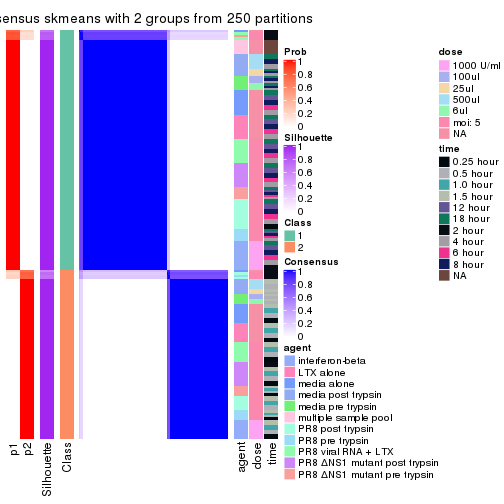
consensus_heatmap(res, k = 3)
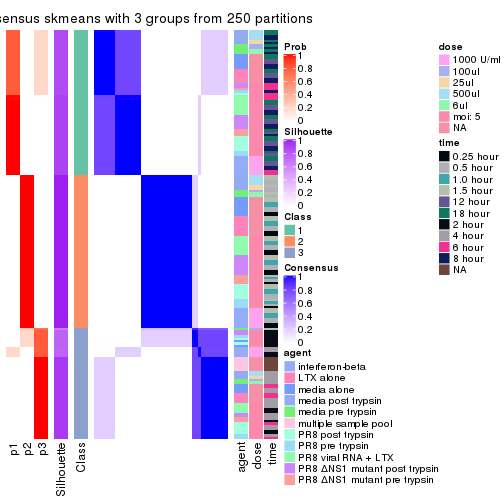
consensus_heatmap(res, k = 4)
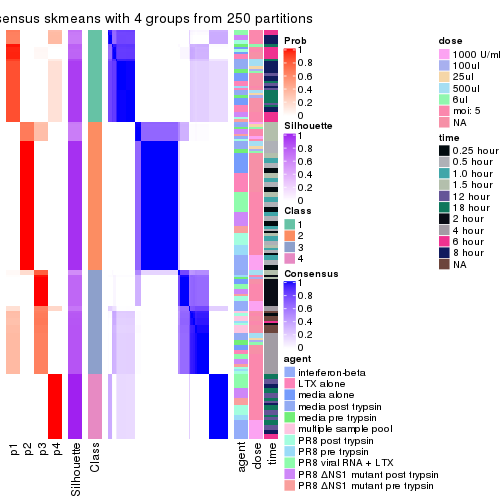
consensus_heatmap(res, k = 5)
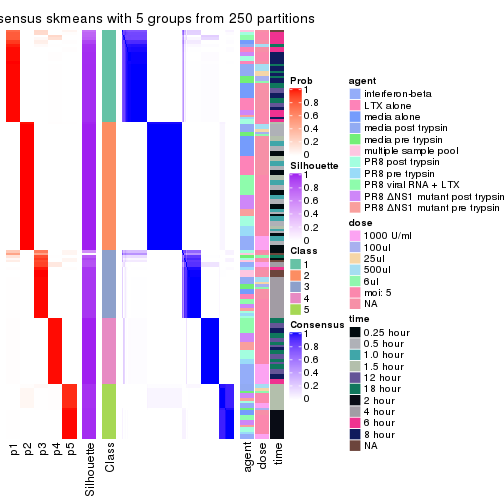
consensus_heatmap(res, k = 6)
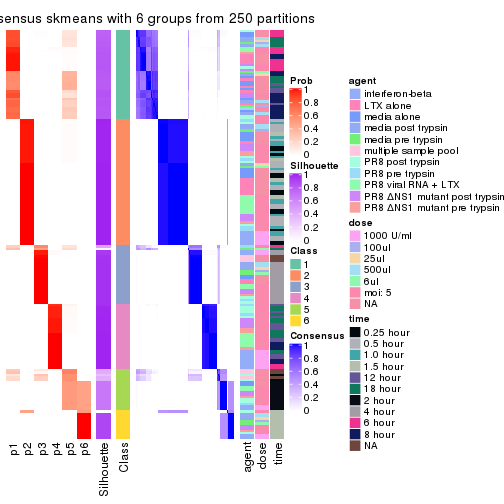
Heatmaps for the membership of samples in all partitions to see how consistent they are:
membership_heatmap(res, k = 2)
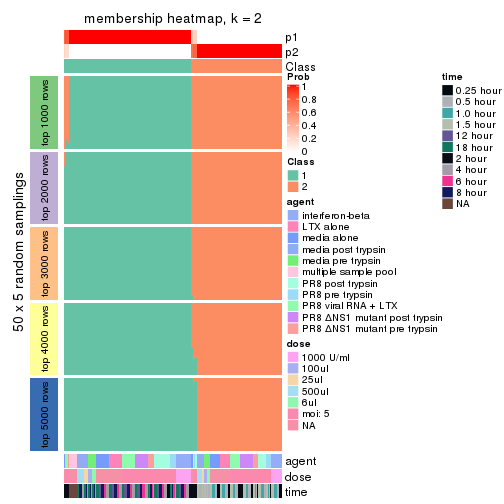
membership_heatmap(res, k = 3)
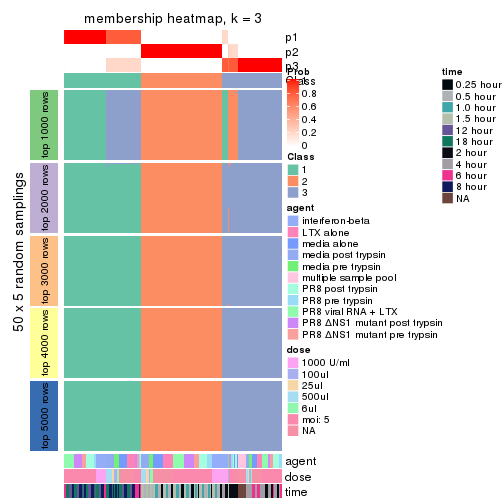
membership_heatmap(res, k = 4)
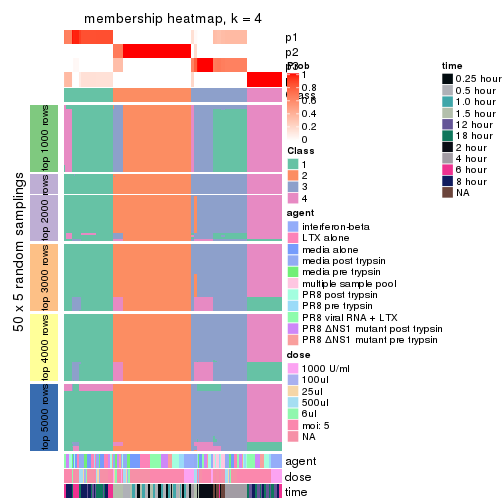
membership_heatmap(res, k = 5)
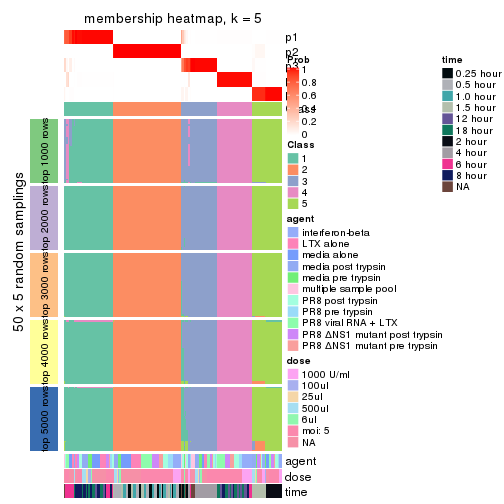
membership_heatmap(res, k = 6)
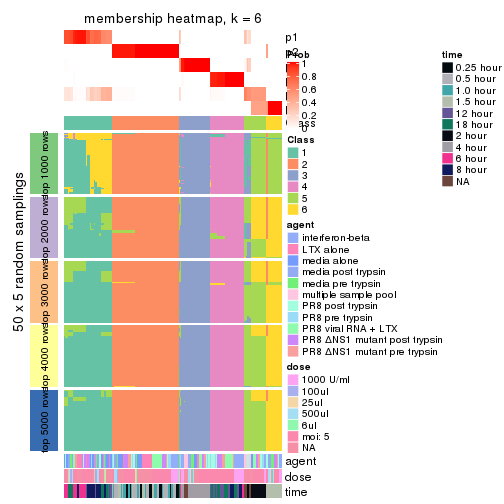
As soon as we have had the classes for columns, we can look for signatures which are significantly different between classes which can be candidate marks for certain classes. Following are the heatmaps for signatures.
Signature heatmaps where rows are scaled:
get_signatures(res, k = 2)
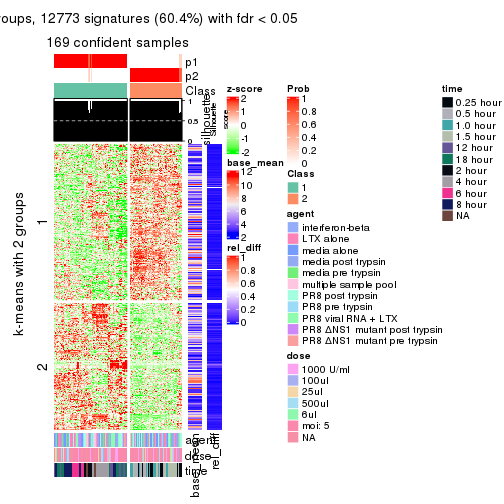
get_signatures(res, k = 3)
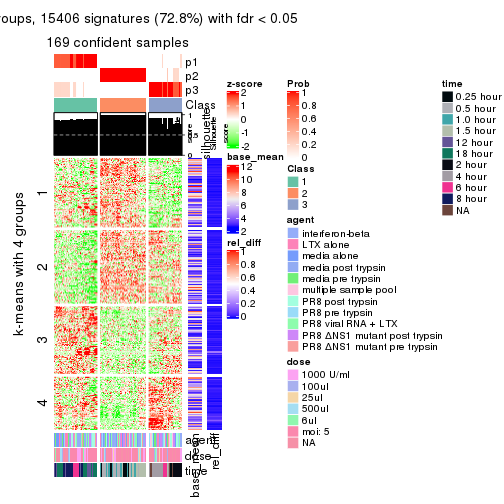
get_signatures(res, k = 4)
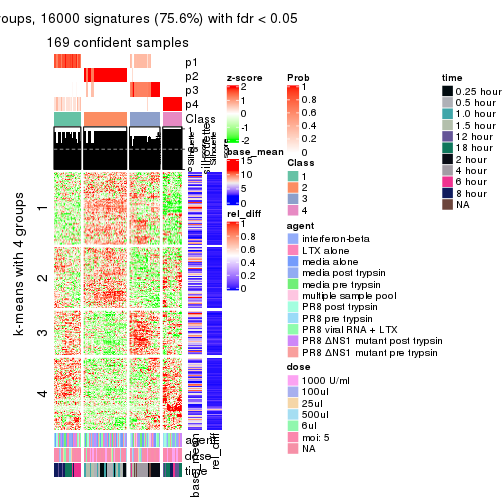
get_signatures(res, k = 5)
#> Error in mat[ceiling(1:nr/h_ratio), ceiling(1:nc/w_ratio), drop = FALSE]: subscript out of bounds
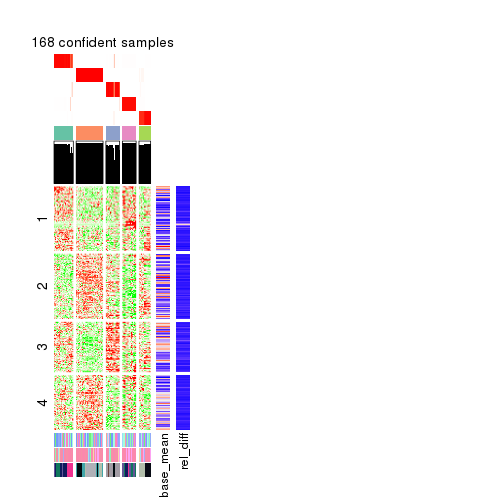
get_signatures(res, k = 6)
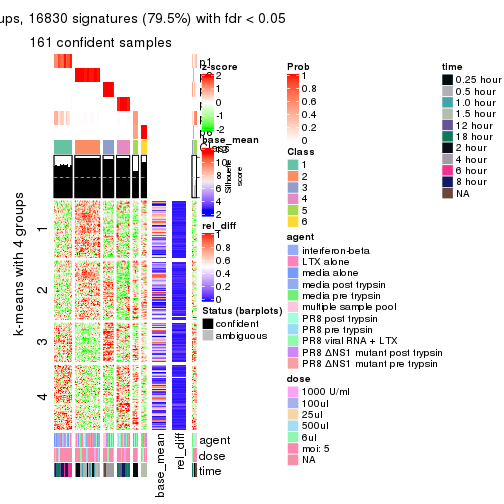
Signature heatmaps where rows are not scaled:
get_signatures(res, k = 2, scale_rows = FALSE)
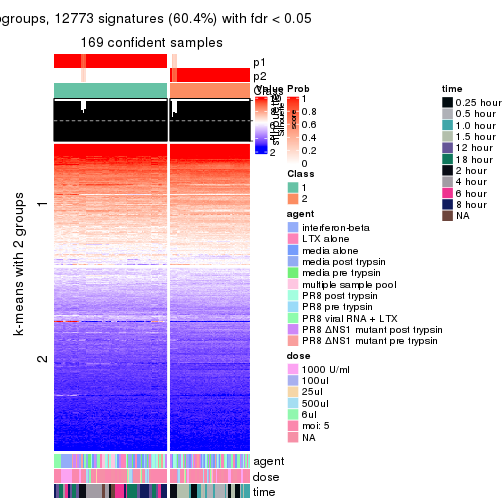
get_signatures(res, k = 3, scale_rows = FALSE)
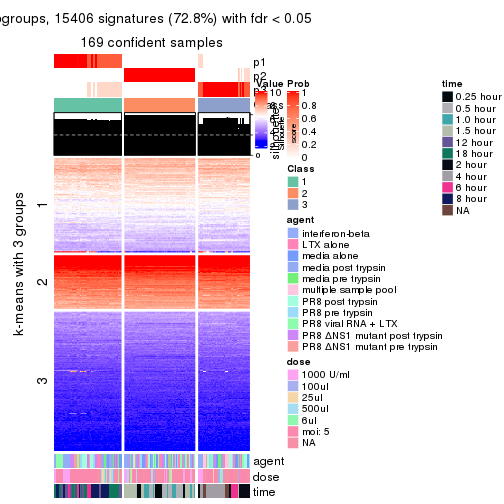
get_signatures(res, k = 4, scale_rows = FALSE)
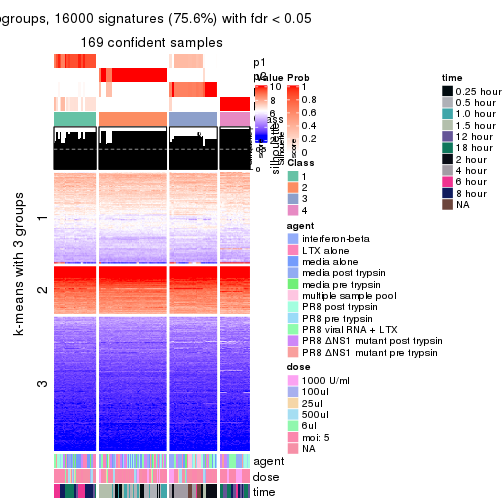
get_signatures(res, k = 5, scale_rows = FALSE)
#> Error in mat[ceiling(1:nr/h_ratio), ceiling(1:nc/w_ratio), drop = FALSE]: subscript out of bounds
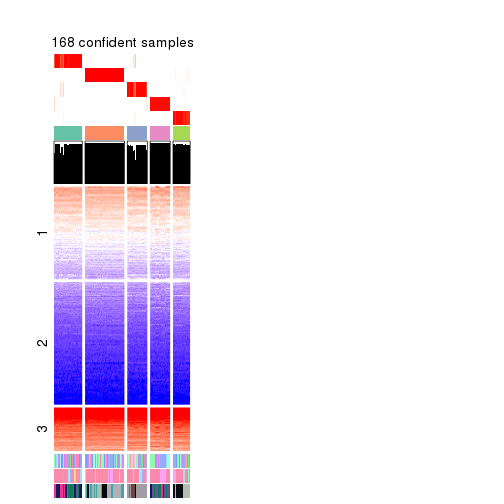
get_signatures(res, k = 6, scale_rows = FALSE)
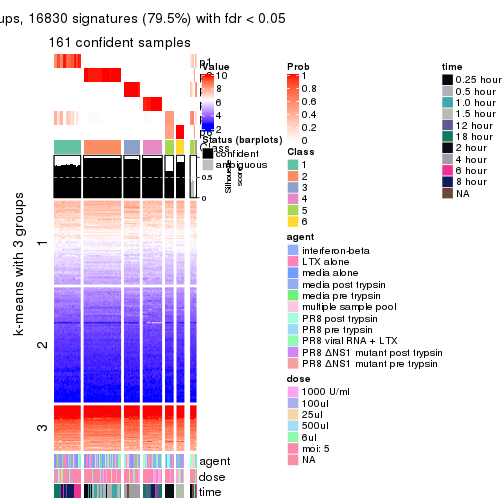
Compare the overlap of signatures from different k:
compare_signatures(res)
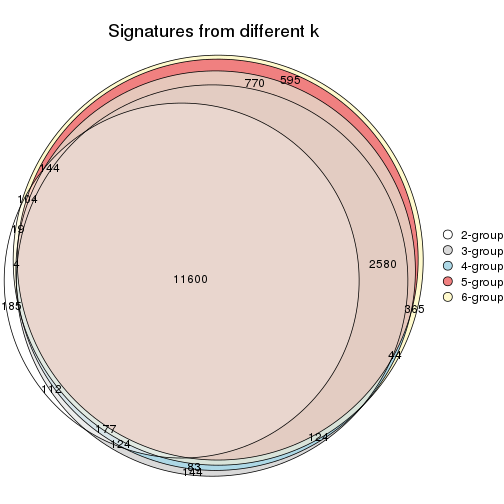
get_signature() returns a data frame invisibly. TO get the list of signatures, the function
call should be assigned to a variable explicitly. In following code, if plot argument is set
to FALSE, no heatmap is plotted while only the differential analysis is performed.
# code only for demonstration
tb = get_signature(res, k = ..., plot = FALSE)
An example of the output of tb is:
#> which_row fdr mean_1 mean_2 scaled_mean_1 scaled_mean_2 km
#> 1 38 0.042760348 8.373488 9.131774 -0.5533452 0.5164555 1
#> 2 40 0.018707592 7.106213 8.469186 -0.6173731 0.5762149 1
#> 3 55 0.019134737 10.221463 11.207825 -0.6159697 0.5749050 1
#> 4 59 0.006059896 5.921854 7.869574 -0.6899429 0.6439467 1
#> 5 60 0.018055526 8.928898 10.211722 -0.6204761 0.5791110 1
#> 6 98 0.009384629 15.714769 14.887706 0.6635654 -0.6193277 2
...
The columns in tb are:
which_row: row indices corresponding to the input matrix.fdr: FDR for the differential test. mean_x: The mean value in group x.scaled_mean_x: The mean value in group x after rows are scaled.km: Row groups if k-means clustering is applied to rows.UMAP plot which shows how samples are separated.
dimension_reduction(res, k = 2, method = "UMAP")
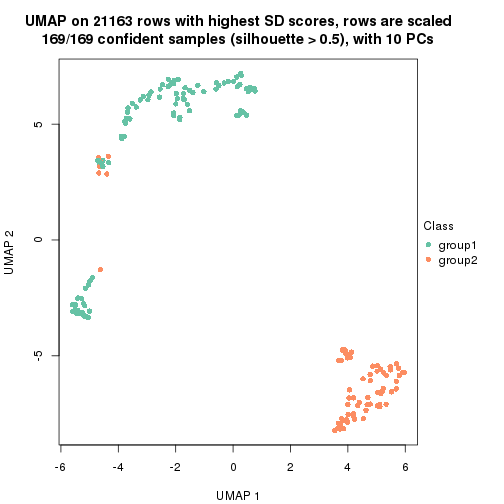
dimension_reduction(res, k = 3, method = "UMAP")
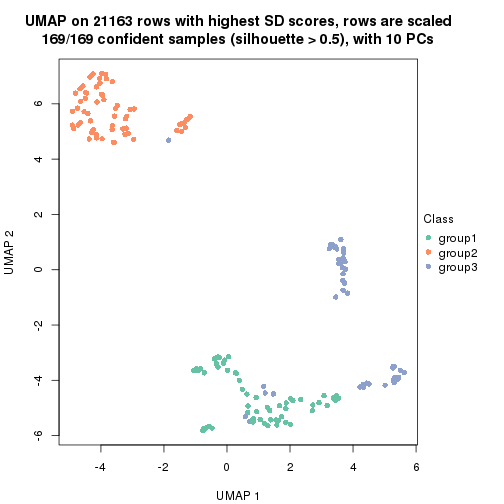
dimension_reduction(res, k = 4, method = "UMAP")
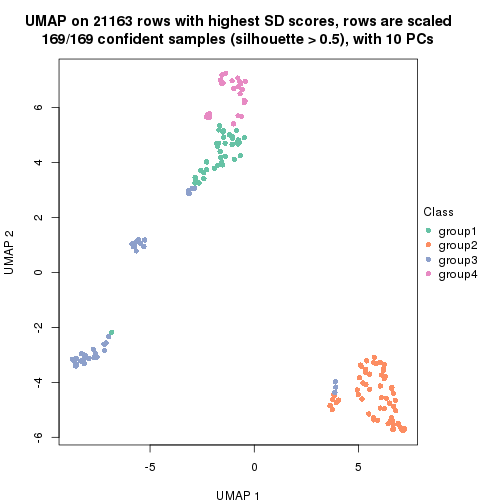
dimension_reduction(res, k = 5, method = "UMAP")
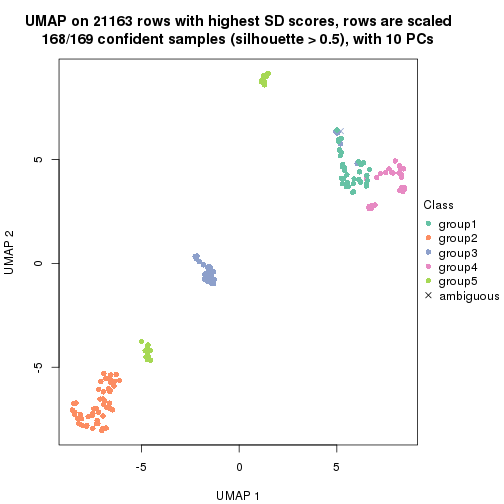
dimension_reduction(res, k = 6, method = "UMAP")
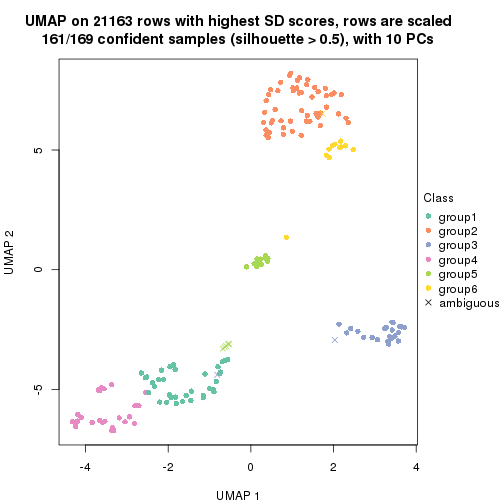
Following heatmap shows how subgroups are split when increasing k:
collect_classes(res)
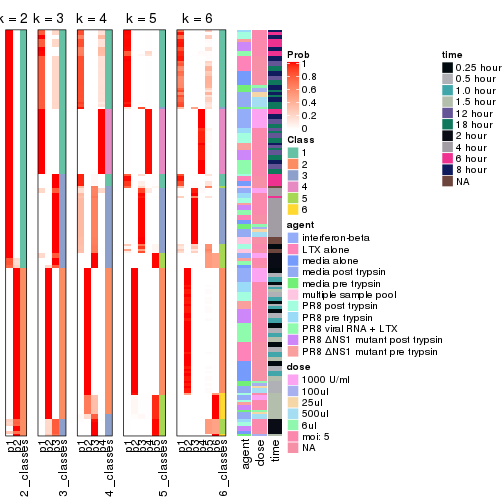
Test correlation between subgroups and known annotations. If the known annotation is numeric, one-way ANOVA test is applied, and if the known annotation is discrete, chi-squared contingency table test is applied.
test_to_known_factors(res)
#> n agent(p) dose(p) time(p) k
#> SD:skmeans 169 0.862532 0.99917 4.57e-27 2
#> SD:skmeans 169 0.450467 0.97873 1.40e-51 3
#> SD:skmeans 169 0.000677 0.00395 7.82e-53 4
#> SD:skmeans 168 0.006087 0.00749 4.13e-70 5
#> SD:skmeans 161 0.007267 0.00934 5.37e-95 6
If matrix rows can be associated to genes, consider to use functional_enrichment(res,
...) to perform function enrichment for the signature genes. See this vignette for more detailed explanations.
The object with results only for a single top-value method and a single partition method can be extracted as:
res = res_list["SD", "pam"]
# you can also extract it by
# res = res_list["SD:pam"]
A summary of res and all the functions that can be applied to it:
res
#> A 'ConsensusPartition' object with k = 2, 3, 4, 5, 6.
#> On a matrix with 21163 rows and 169 columns.
#> Top rows (1000, 2000, 3000, 4000, 5000) are extracted by 'SD' method.
#> Subgroups are detected by 'pam' method.
#> Performed in total 1250 partitions by row resampling.
#> Best k for subgroups seems to be 5.
#>
#> Following methods can be applied to this 'ConsensusPartition' object:
#> [1] "cola_report" "collect_classes" "collect_plots"
#> [4] "collect_stats" "colnames" "compare_signatures"
#> [7] "consensus_heatmap" "dimension_reduction" "functional_enrichment"
#> [10] "get_anno_col" "get_anno" "get_classes"
#> [13] "get_consensus" "get_matrix" "get_membership"
#> [16] "get_param" "get_signatures" "get_stats"
#> [19] "is_best_k" "is_stable_k" "membership_heatmap"
#> [22] "ncol" "nrow" "plot_ecdf"
#> [25] "rownames" "select_partition_number" "show"
#> [28] "suggest_best_k" "test_to_known_factors"
collect_plots() function collects all the plots made from res for all k (number of partitions)
into one single page to provide an easy and fast comparison between different k.
collect_plots(res)
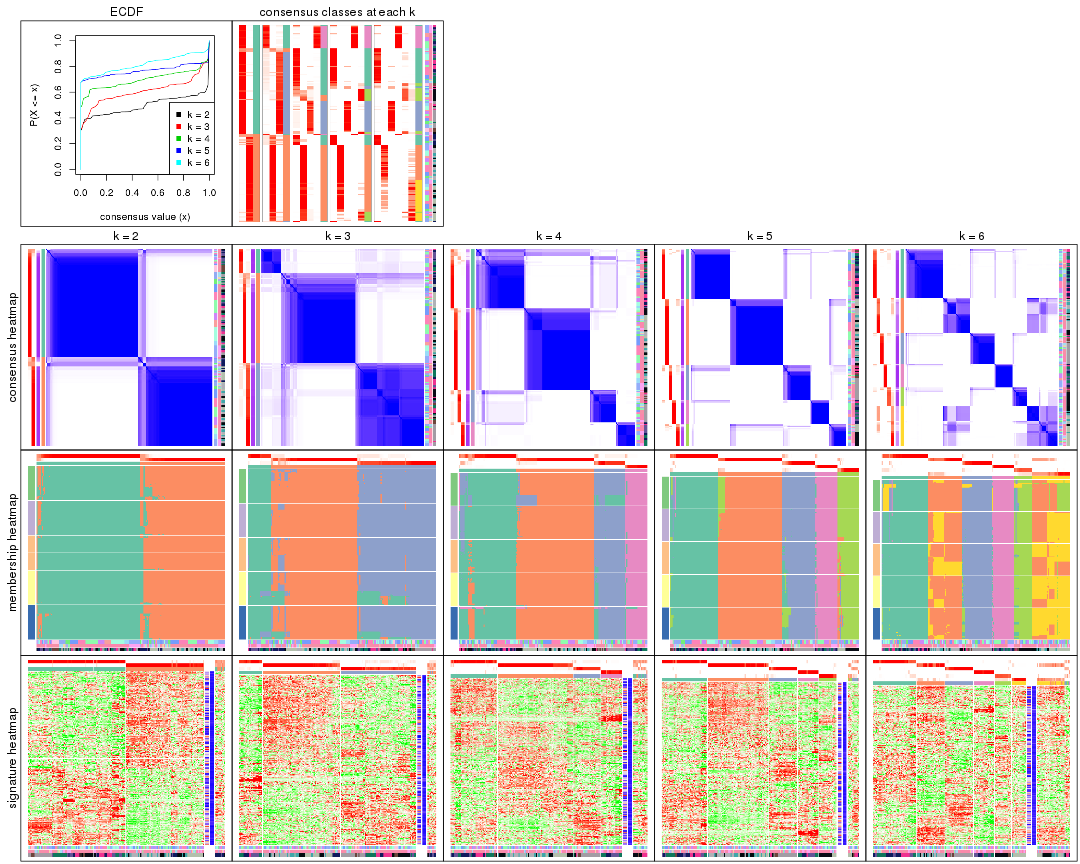
The plots are:
k and the heatmap of
predicted classes for each k.k.k.k.All the plots in panels can be made by individual functions and they are plotted later in this section.
select_partition_number() produces several plots showing different
statistics for choosing “optimized” k. There are following statistics:
k;k, the area increased is defined as \(A_k - A_{k-1}\).The detailed explanations of these statistics can be found in the cola vignette.
Generally speaking, lower PAC score, higher mean silhouette score or higher
concordance corresponds to better partition. Rand index and Jaccard index
measure how similar the current partition is compared to partition with k-1.
If they are too similar, we won't accept k is better than k-1.
select_partition_number(res)
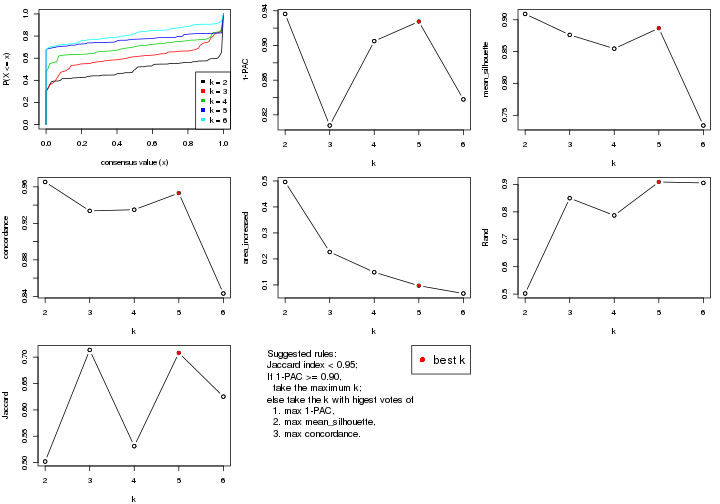
The numeric values for all these statistics can be obtained by get_stats().
get_stats(res)
#> k 1-PAC mean_silhouette concordance area_increased Rand Jaccard
#> 2 2 0.936 0.909 0.965 0.496 0.502 0.502
#> 3 3 0.808 0.876 0.934 0.227 0.850 0.714
#> 4 4 0.905 0.855 0.935 0.149 0.787 0.531
#> 5 5 0.928 0.887 0.953 0.097 0.909 0.708
#> 6 6 0.838 0.734 0.843 0.067 0.906 0.625
suggest_best_k() suggests the best \(k\) based on these statistics. The rules are as follows:
suggest_best_k(res)
#> [1] 5
#> attr(,"optional")
#> [1] 2 4
There is also optional best \(k\) = 2 4 that is worth to check.
Following shows the table of the partitions (You need to click the show/hide
code output link to see it). The membership matrix (columns with name p*)
is inferred by
clue::cl_consensus()
function with the SE method. Basically the value in the membership matrix
represents the probability to belong to a certain group. The finall class
label for an item is determined with the group with highest probability it
belongs to.
In get_classes() function, the entropy is calculated from the membership
matrix and the silhouette score is calculated from the consensus matrix.
cbind(get_classes(res, k = 2), get_membership(res, k = 2))
#> class entropy silhouette p1 p2
#> GSM528681 2 0.0000 0.9498 0.000 1.000
#> GSM528682 2 0.0000 0.9498 0.000 1.000
#> GSM528683 2 0.0000 0.9498 0.000 1.000
#> GSM528684 2 0.0000 0.9498 0.000 1.000
#> GSM528687 2 0.0000 0.9498 0.000 1.000
#> GSM528688 2 0.0000 0.9498 0.000 1.000
#> GSM528685 2 0.1184 0.9401 0.016 0.984
#> GSM528686 2 0.1843 0.9323 0.028 0.972
#> GSM528693 1 0.0000 0.9738 1.000 0.000
#> GSM528694 1 0.0000 0.9738 1.000 0.000
#> GSM528695 1 0.0000 0.9738 1.000 0.000
#> GSM528696 1 0.0000 0.9738 1.000 0.000
#> GSM528697 1 0.0000 0.9738 1.000 0.000
#> GSM528698 1 0.0000 0.9738 1.000 0.000
#> GSM528699 2 1.0000 0.0674 0.496 0.504
#> GSM528700 1 0.0000 0.9738 1.000 0.000
#> GSM528689 1 0.0000 0.9738 1.000 0.000
#> GSM528690 1 0.1633 0.9526 0.976 0.024
#> GSM528691 1 0.0000 0.9738 1.000 0.000
#> GSM528692 1 0.0000 0.9738 1.000 0.000
#> GSM528779 2 0.0000 0.9498 0.000 1.000
#> GSM528780 2 0.0000 0.9498 0.000 1.000
#> GSM528782 2 0.0000 0.9498 0.000 1.000
#> GSM528781 2 0.0000 0.9498 0.000 1.000
#> GSM528785 1 0.4161 0.8895 0.916 0.084
#> GSM528786 1 0.0000 0.9738 1.000 0.000
#> GSM528787 1 0.0000 0.9738 1.000 0.000
#> GSM528788 1 0.9909 0.1708 0.556 0.444
#> GSM528783 1 0.0000 0.9738 1.000 0.000
#> GSM528784 1 0.0000 0.9738 1.000 0.000
#> GSM528759 1 0.0000 0.9738 1.000 0.000
#> GSM528760 1 0.0000 0.9738 1.000 0.000
#> GSM528761 2 0.0000 0.9498 0.000 1.000
#> GSM528762 2 0.0000 0.9498 0.000 1.000
#> GSM528765 2 0.0000 0.9498 0.000 1.000
#> GSM528766 2 0.0000 0.9498 0.000 1.000
#> GSM528763 2 0.0000 0.9498 0.000 1.000
#> GSM528764 2 0.0672 0.9452 0.008 0.992
#> GSM528771 1 0.0000 0.9738 1.000 0.000
#> GSM528772 1 0.0000 0.9738 1.000 0.000
#> GSM528773 1 0.0000 0.9738 1.000 0.000
#> GSM528774 1 0.0000 0.9738 1.000 0.000
#> GSM528775 1 0.0000 0.9738 1.000 0.000
#> GSM528776 1 0.0000 0.9738 1.000 0.000
#> GSM528777 2 0.9998 0.0324 0.492 0.508
#> GSM528778 1 0.9686 0.3217 0.604 0.396
#> GSM528767 1 0.0000 0.9738 1.000 0.000
#> GSM528768 1 0.0000 0.9738 1.000 0.000
#> GSM528769 1 0.0000 0.9738 1.000 0.000
#> GSM528770 1 0.0000 0.9738 1.000 0.000
#> GSM528671 2 0.0000 0.9498 0.000 1.000
#> GSM528672 2 0.0000 0.9498 0.000 1.000
#> GSM528674 2 0.0000 0.9498 0.000 1.000
#> GSM528673 2 0.1414 0.9374 0.020 0.980
#> GSM528677 1 0.0000 0.9738 1.000 0.000
#> GSM528678 1 0.0000 0.9738 1.000 0.000
#> GSM528679 1 0.0000 0.9738 1.000 0.000
#> GSM528680 1 0.0000 0.9738 1.000 0.000
#> GSM528675 1 0.0000 0.9738 1.000 0.000
#> GSM528676 1 0.0000 0.9738 1.000 0.000
#> GSM528651 2 0.0000 0.9498 0.000 1.000
#> GSM528652 2 0.0000 0.9498 0.000 1.000
#> GSM528653 2 0.0000 0.9498 0.000 1.000
#> GSM528654 2 0.0000 0.9498 0.000 1.000
#> GSM528657 2 0.0000 0.9498 0.000 1.000
#> GSM528658 2 0.0000 0.9498 0.000 1.000
#> GSM528655 2 0.1633 0.9347 0.024 0.976
#> GSM528656 2 0.0000 0.9498 0.000 1.000
#> GSM528663 1 0.9998 -0.0455 0.508 0.492
#> GSM528664 2 0.7674 0.7120 0.224 0.776
#> GSM528665 1 0.0000 0.9738 1.000 0.000
#> GSM528666 1 0.0000 0.9738 1.000 0.000
#> GSM528667 1 0.0000 0.9738 1.000 0.000
#> GSM528668 1 0.0000 0.9738 1.000 0.000
#> GSM528669 2 0.9998 0.0324 0.492 0.508
#> GSM528670 1 0.2423 0.9360 0.960 0.040
#> GSM528659 1 0.1184 0.9599 0.984 0.016
#> GSM528660 1 0.0376 0.9705 0.996 0.004
#> GSM528661 1 0.0000 0.9738 1.000 0.000
#> GSM528662 1 0.0000 0.9738 1.000 0.000
#> GSM528701 2 0.0000 0.9498 0.000 1.000
#> GSM528702 2 0.0000 0.9498 0.000 1.000
#> GSM528703 2 0.0000 0.9498 0.000 1.000
#> GSM528704 2 0.0000 0.9498 0.000 1.000
#> GSM528707 2 0.0000 0.9498 0.000 1.000
#> GSM528708 2 0.0000 0.9498 0.000 1.000
#> GSM528705 2 0.0000 0.9498 0.000 1.000
#> GSM528706 2 0.0000 0.9498 0.000 1.000
#> GSM528713 1 0.0000 0.9738 1.000 0.000
#> GSM528714 1 0.0000 0.9738 1.000 0.000
#> GSM528715 1 0.0000 0.9738 1.000 0.000
#> GSM528716 1 0.0000 0.9738 1.000 0.000
#> GSM528717 1 0.0000 0.9738 1.000 0.000
#> GSM528718 1 0.0000 0.9738 1.000 0.000
#> GSM528719 1 0.0000 0.9738 1.000 0.000
#> GSM528720 1 0.0000 0.9738 1.000 0.000
#> GSM528709 1 0.0000 0.9738 1.000 0.000
#> GSM528710 1 0.1184 0.9599 0.984 0.016
#> GSM528711 1 0.0000 0.9738 1.000 0.000
#> GSM528712 1 0.0000 0.9738 1.000 0.000
#> GSM528721 2 0.0000 0.9498 0.000 1.000
#> GSM528722 2 0.0000 0.9498 0.000 1.000
#> GSM528723 2 0.0000 0.9498 0.000 1.000
#> GSM528724 2 0.0000 0.9498 0.000 1.000
#> GSM528727 2 0.0000 0.9498 0.000 1.000
#> GSM528728 2 0.0000 0.9498 0.000 1.000
#> GSM528725 2 0.0000 0.9498 0.000 1.000
#> GSM528726 2 0.0000 0.9498 0.000 1.000
#> GSM528733 1 0.0000 0.9738 1.000 0.000
#> GSM528734 1 0.0000 0.9738 1.000 0.000
#> GSM528735 1 0.0000 0.9738 1.000 0.000
#> GSM528736 1 0.0000 0.9738 1.000 0.000
#> GSM528737 1 0.0000 0.9738 1.000 0.000
#> GSM528738 1 0.0000 0.9738 1.000 0.000
#> GSM528729 1 0.9710 0.3119 0.600 0.400
#> GSM528730 1 0.6712 0.7685 0.824 0.176
#> GSM528731 1 0.0672 0.9670 0.992 0.008
#> GSM528732 1 0.0000 0.9738 1.000 0.000
#> GSM528739 2 0.0000 0.9498 0.000 1.000
#> GSM528740 2 0.0000 0.9498 0.000 1.000
#> GSM528741 2 0.0000 0.9498 0.000 1.000
#> GSM528742 2 0.0000 0.9498 0.000 1.000
#> GSM528745 2 0.0000 0.9498 0.000 1.000
#> GSM528746 2 0.0000 0.9498 0.000 1.000
#> GSM528743 2 0.0000 0.9498 0.000 1.000
#> GSM528744 2 0.0000 0.9498 0.000 1.000
#> GSM528751 1 0.0000 0.9738 1.000 0.000
#> GSM528752 1 0.0000 0.9738 1.000 0.000
#> GSM528753 1 0.0000 0.9738 1.000 0.000
#> GSM528754 1 0.0000 0.9738 1.000 0.000
#> GSM528755 1 0.0000 0.9738 1.000 0.000
#> GSM528756 1 0.0000 0.9738 1.000 0.000
#> GSM528757 2 0.0672 0.9454 0.008 0.992
#> GSM528758 2 0.1414 0.9379 0.020 0.980
#> GSM528747 1 0.6048 0.8094 0.852 0.148
#> GSM528748 2 0.8144 0.6688 0.252 0.748
#> GSM528749 1 0.0000 0.9738 1.000 0.000
#> GSM528750 1 0.0376 0.9705 0.996 0.004
#> GSM528640 2 0.0000 0.9498 0.000 1.000
#> GSM528641 2 0.1414 0.9384 0.020 0.980
#> GSM528643 1 0.0000 0.9738 1.000 0.000
#> GSM528644 2 0.4298 0.8781 0.088 0.912
#> GSM528642 1 0.0000 0.9738 1.000 0.000
#> GSM528620 2 0.0000 0.9498 0.000 1.000
#> GSM528621 2 0.4298 0.8780 0.088 0.912
#> GSM528623 1 0.0000 0.9738 1.000 0.000
#> GSM528624 2 0.9998 0.0324 0.492 0.508
#> GSM528622 1 0.0000 0.9738 1.000 0.000
#> GSM528625 2 0.0000 0.9498 0.000 1.000
#> GSM528626 2 0.0938 0.9431 0.012 0.988
#> GSM528628 1 0.0000 0.9738 1.000 0.000
#> GSM528629 2 0.9608 0.4038 0.384 0.616
#> GSM528627 1 0.0000 0.9738 1.000 0.000
#> GSM528630 2 0.0000 0.9498 0.000 1.000
#> GSM528631 2 0.0000 0.9498 0.000 1.000
#> GSM528632 2 0.1633 0.9346 0.024 0.976
#> GSM528633 2 0.3879 0.8890 0.076 0.924
#> GSM528636 1 0.0000 0.9738 1.000 0.000
#> GSM528637 1 0.0000 0.9738 1.000 0.000
#> GSM528638 2 0.1843 0.9323 0.028 0.972
#> GSM528639 2 0.8955 0.5632 0.312 0.688
#> GSM528634 1 0.0000 0.9738 1.000 0.000
#> GSM528635 1 0.0000 0.9738 1.000 0.000
#> GSM528645 1 0.0000 0.9738 1.000 0.000
#> GSM528646 1 0.0000 0.9738 1.000 0.000
#> GSM528647 1 0.0000 0.9738 1.000 0.000
#> GSM528648 1 0.0000 0.9738 1.000 0.000
#> GSM528649 1 0.0000 0.9738 1.000 0.000
#> GSM528650 1 0.0000 0.9738 1.000 0.000
cbind(get_classes(res, k = 3), get_membership(res, k = 3))
#> class entropy silhouette p1 p2 p3
#> GSM528681 2 0.0000 0.9260 0.000 1.000 0.000
#> GSM528682 2 0.0000 0.9260 0.000 1.000 0.000
#> GSM528683 2 0.0000 0.9260 0.000 1.000 0.000
#> GSM528684 2 0.0000 0.9260 0.000 1.000 0.000
#> GSM528687 2 0.0000 0.9260 0.000 1.000 0.000
#> GSM528688 2 0.0000 0.9260 0.000 1.000 0.000
#> GSM528685 2 0.0592 0.9184 0.000 0.988 0.012
#> GSM528686 2 0.0892 0.9130 0.000 0.980 0.020
#> GSM528693 3 0.2356 0.9195 0.072 0.000 0.928
#> GSM528694 3 0.1878 0.9230 0.044 0.004 0.952
#> GSM528695 3 0.0000 0.9182 0.000 0.000 1.000
#> GSM528696 3 0.0000 0.9182 0.000 0.000 1.000
#> GSM528697 1 0.3192 0.8489 0.888 0.000 0.112
#> GSM528698 1 0.2066 0.9523 0.940 0.000 0.060
#> GSM528699 1 0.1031 0.9383 0.976 0.024 0.000
#> GSM528700 1 0.0000 0.9513 1.000 0.000 0.000
#> GSM528689 1 0.0000 0.9513 1.000 0.000 0.000
#> GSM528690 1 0.0000 0.9513 1.000 0.000 0.000
#> GSM528691 1 0.2066 0.9523 0.940 0.000 0.060
#> GSM528692 1 0.2625 0.9353 0.916 0.000 0.084
#> GSM528779 2 0.0000 0.9260 0.000 1.000 0.000
#> GSM528780 2 0.0000 0.9260 0.000 1.000 0.000
#> GSM528782 2 0.0000 0.9260 0.000 1.000 0.000
#> GSM528781 2 0.0000 0.9260 0.000 1.000 0.000
#> GSM528785 3 0.4779 0.8259 0.036 0.124 0.840
#> GSM528786 3 0.0000 0.9182 0.000 0.000 1.000
#> GSM528787 3 0.0000 0.9182 0.000 0.000 1.000
#> GSM528788 2 0.8278 0.4899 0.132 0.620 0.248
#> GSM528783 3 0.3551 0.8970 0.132 0.000 0.868
#> GSM528784 3 0.2537 0.9181 0.080 0.000 0.920
#> GSM528759 3 0.2165 0.9208 0.064 0.000 0.936
#> GSM528760 3 0.0747 0.9207 0.016 0.000 0.984
#> GSM528761 2 0.0000 0.9260 0.000 1.000 0.000
#> GSM528762 2 0.0000 0.9260 0.000 1.000 0.000
#> GSM528765 2 0.0000 0.9260 0.000 1.000 0.000
#> GSM528766 2 0.0000 0.9260 0.000 1.000 0.000
#> GSM528763 2 0.0000 0.9260 0.000 1.000 0.000
#> GSM528764 2 0.0424 0.9211 0.000 0.992 0.008
#> GSM528771 3 0.2496 0.8944 0.004 0.068 0.928
#> GSM528772 3 0.2496 0.8944 0.004 0.068 0.928
#> GSM528773 3 0.0000 0.9182 0.000 0.000 1.000
#> GSM528774 3 0.0000 0.9182 0.000 0.000 1.000
#> GSM528775 3 0.1411 0.9225 0.036 0.000 0.964
#> GSM528776 3 0.3551 0.8970 0.132 0.000 0.868
#> GSM528777 2 0.7680 0.5775 0.132 0.680 0.188
#> GSM528778 2 0.8857 0.2605 0.132 0.524 0.344
#> GSM528767 3 0.3551 0.8970 0.132 0.000 0.868
#> GSM528768 3 0.2448 0.9189 0.076 0.000 0.924
#> GSM528769 3 0.3267 0.9053 0.116 0.000 0.884
#> GSM528770 3 0.2356 0.9195 0.072 0.000 0.928
#> GSM528671 2 0.0000 0.9260 0.000 1.000 0.000
#> GSM528672 2 0.0000 0.9260 0.000 1.000 0.000
#> GSM528674 2 0.0000 0.9260 0.000 1.000 0.000
#> GSM528673 2 0.0747 0.9156 0.000 0.984 0.016
#> GSM528677 3 0.2496 0.8944 0.004 0.068 0.928
#> GSM528678 3 0.0000 0.9182 0.000 0.000 1.000
#> GSM528679 3 0.2356 0.9195 0.072 0.000 0.928
#> GSM528680 1 0.1643 0.9292 0.956 0.000 0.044
#> GSM528675 1 0.0000 0.9513 1.000 0.000 0.000
#> GSM528676 1 0.2066 0.9523 0.940 0.000 0.060
#> GSM528651 2 0.0000 0.9260 0.000 1.000 0.000
#> GSM528652 2 0.0000 0.9260 0.000 1.000 0.000
#> GSM528653 2 0.0000 0.9260 0.000 1.000 0.000
#> GSM528654 2 0.0000 0.9260 0.000 1.000 0.000
#> GSM528657 2 0.0000 0.9260 0.000 1.000 0.000
#> GSM528658 2 0.0000 0.9260 0.000 1.000 0.000
#> GSM528655 2 0.0892 0.9128 0.000 0.980 0.020
#> GSM528656 2 0.0000 0.9260 0.000 1.000 0.000
#> GSM528663 3 0.5178 0.6323 0.000 0.256 0.744
#> GSM528664 2 0.5948 0.4557 0.000 0.640 0.360
#> GSM528665 3 0.0000 0.9182 0.000 0.000 1.000
#> GSM528666 3 0.0000 0.9182 0.000 0.000 1.000
#> GSM528667 3 0.3551 0.8970 0.132 0.000 0.868
#> GSM528668 3 0.3551 0.8970 0.132 0.000 0.868
#> GSM528669 2 0.7680 0.5775 0.132 0.680 0.188
#> GSM528670 3 0.4915 0.8726 0.132 0.036 0.832
#> GSM528659 1 0.0000 0.9513 1.000 0.000 0.000
#> GSM528660 1 0.0000 0.9513 1.000 0.000 0.000
#> GSM528661 1 0.2066 0.9523 0.940 0.000 0.060
#> GSM528662 1 0.2066 0.9523 0.940 0.000 0.060
#> GSM528701 2 0.0000 0.9260 0.000 1.000 0.000
#> GSM528702 2 0.0000 0.9260 0.000 1.000 0.000
#> GSM528703 2 0.0000 0.9260 0.000 1.000 0.000
#> GSM528704 2 0.0000 0.9260 0.000 1.000 0.000
#> GSM528707 2 0.0000 0.9260 0.000 1.000 0.000
#> GSM528708 2 0.0000 0.9260 0.000 1.000 0.000
#> GSM528705 2 0.0000 0.9260 0.000 1.000 0.000
#> GSM528706 2 0.0000 0.9260 0.000 1.000 0.000
#> GSM528713 3 0.2773 0.9089 0.024 0.048 0.928
#> GSM528714 3 0.2496 0.8944 0.004 0.068 0.928
#> GSM528715 3 0.0000 0.9182 0.000 0.000 1.000
#> GSM528716 3 0.0000 0.9182 0.000 0.000 1.000
#> GSM528717 3 0.3551 0.8970 0.132 0.000 0.868
#> GSM528718 3 0.2356 0.9195 0.072 0.000 0.928
#> GSM528719 1 0.2066 0.9523 0.940 0.000 0.060
#> GSM528720 1 0.2066 0.9523 0.940 0.000 0.060
#> GSM528709 1 0.0000 0.9513 1.000 0.000 0.000
#> GSM528710 1 0.0000 0.9513 1.000 0.000 0.000
#> GSM528711 1 0.2066 0.9523 0.940 0.000 0.060
#> GSM528712 1 0.2947 0.9371 0.920 0.020 0.060
#> GSM528721 2 0.0000 0.9260 0.000 1.000 0.000
#> GSM528722 2 0.0000 0.9260 0.000 1.000 0.000
#> GSM528723 2 0.0000 0.9260 0.000 1.000 0.000
#> GSM528724 2 0.0000 0.9260 0.000 1.000 0.000
#> GSM528727 2 0.0000 0.9260 0.000 1.000 0.000
#> GSM528728 2 0.0000 0.9260 0.000 1.000 0.000
#> GSM528725 2 0.0000 0.9260 0.000 1.000 0.000
#> GSM528726 2 0.0000 0.9260 0.000 1.000 0.000
#> GSM528733 3 0.0000 0.9182 0.000 0.000 1.000
#> GSM528734 3 0.0000 0.9182 0.000 0.000 1.000
#> GSM528735 3 0.3551 0.8970 0.132 0.000 0.868
#> GSM528736 3 0.3551 0.8970 0.132 0.000 0.868
#> GSM528737 3 0.3551 0.8970 0.132 0.000 0.868
#> GSM528738 3 0.3551 0.8970 0.132 0.000 0.868
#> GSM528729 2 0.9018 0.0140 0.132 0.456 0.412
#> GSM528730 3 0.8520 0.4869 0.132 0.280 0.588
#> GSM528731 3 0.3965 0.8929 0.132 0.008 0.860
#> GSM528732 3 0.3607 0.9057 0.112 0.008 0.880
#> GSM528739 2 0.0000 0.9260 0.000 1.000 0.000
#> GSM528740 2 0.0000 0.9260 0.000 1.000 0.000
#> GSM528741 2 0.0000 0.9260 0.000 1.000 0.000
#> GSM528742 2 0.0000 0.9260 0.000 1.000 0.000
#> GSM528745 2 0.0000 0.9260 0.000 1.000 0.000
#> GSM528746 2 0.0000 0.9260 0.000 1.000 0.000
#> GSM528743 2 0.0000 0.9260 0.000 1.000 0.000
#> GSM528744 2 0.0000 0.9260 0.000 1.000 0.000
#> GSM528751 3 0.2793 0.9182 0.044 0.028 0.928
#> GSM528752 3 0.2703 0.9037 0.016 0.056 0.928
#> GSM528753 3 0.0000 0.9182 0.000 0.000 1.000
#> GSM528754 3 0.0000 0.9182 0.000 0.000 1.000
#> GSM528755 3 0.2356 0.9195 0.072 0.000 0.928
#> GSM528756 3 0.2356 0.9195 0.072 0.000 0.928
#> GSM528757 2 0.3482 0.8143 0.128 0.872 0.000
#> GSM528758 2 0.4349 0.7992 0.128 0.852 0.020
#> GSM528747 3 0.6981 0.7463 0.132 0.136 0.732
#> GSM528748 2 0.8720 0.0597 0.108 0.480 0.412
#> GSM528749 3 0.2356 0.9195 0.072 0.000 0.928
#> GSM528750 3 0.3551 0.8970 0.132 0.000 0.868
#> GSM528640 2 0.0000 0.9260 0.000 1.000 0.000
#> GSM528641 2 0.0747 0.9160 0.000 0.984 0.016
#> GSM528643 3 0.0000 0.9182 0.000 0.000 1.000
#> GSM528644 2 0.5304 0.7757 0.108 0.824 0.068
#> GSM528642 3 0.0237 0.9188 0.004 0.000 0.996
#> GSM528620 2 0.0000 0.9260 0.000 1.000 0.000
#> GSM528621 2 0.3686 0.8010 0.000 0.860 0.140
#> GSM528623 3 0.0000 0.9182 0.000 0.000 1.000
#> GSM528624 2 0.7680 0.5775 0.132 0.680 0.188
#> GSM528622 3 0.3551 0.8970 0.132 0.000 0.868
#> GSM528625 2 0.0000 0.9260 0.000 1.000 0.000
#> GSM528626 2 0.1643 0.8939 0.000 0.956 0.044
#> GSM528628 3 0.1860 0.9058 0.052 0.000 0.948
#> GSM528629 3 0.8719 0.4289 0.128 0.324 0.548
#> GSM528627 3 0.2356 0.9195 0.072 0.000 0.928
#> GSM528630 2 0.0000 0.9260 0.000 1.000 0.000
#> GSM528631 2 0.0000 0.9260 0.000 1.000 0.000
#> GSM528632 2 0.2711 0.8549 0.000 0.912 0.088
#> GSM528633 2 0.3192 0.8300 0.000 0.888 0.112
#> GSM528636 3 0.0000 0.9182 0.000 0.000 1.000
#> GSM528637 3 0.0000 0.9182 0.000 0.000 1.000
#> GSM528638 2 0.4731 0.7886 0.128 0.840 0.032
#> GSM528639 2 0.8983 -0.0579 0.128 0.444 0.428
#> GSM528634 3 0.2356 0.9195 0.072 0.000 0.928
#> GSM528635 3 0.3551 0.8970 0.132 0.000 0.868
#> GSM528645 3 0.0000 0.9182 0.000 0.000 1.000
#> GSM528646 3 0.0000 0.9182 0.000 0.000 1.000
#> GSM528647 3 0.0000 0.9182 0.000 0.000 1.000
#> GSM528648 3 0.2356 0.9195 0.072 0.000 0.928
#> GSM528649 3 0.1031 0.9216 0.024 0.000 0.976
#> GSM528650 3 0.2356 0.9195 0.072 0.000 0.928
cbind(get_classes(res, k = 4), get_membership(res, k = 4))
#> class entropy silhouette p1 p2 p3 p4
#> GSM528681 2 0.0000 0.9657 0.000 1.000 0.000 0.000
#> GSM528682 2 0.0000 0.9657 0.000 1.000 0.000 0.000
#> GSM528683 2 0.0000 0.9657 0.000 1.000 0.000 0.000
#> GSM528684 2 0.0000 0.9657 0.000 1.000 0.000 0.000
#> GSM528687 2 0.0000 0.9657 0.000 1.000 0.000 0.000
#> GSM528688 2 0.0000 0.9657 0.000 1.000 0.000 0.000
#> GSM528685 2 0.1716 0.9330 0.000 0.936 0.064 0.000
#> GSM528686 2 0.1716 0.9330 0.000 0.936 0.064 0.000
#> GSM528693 1 0.4012 0.7180 0.800 0.000 0.184 0.016
#> GSM528694 3 0.5364 0.3244 0.392 0.000 0.592 0.016
#> GSM528695 3 0.1716 0.9135 0.064 0.000 0.936 0.000
#> GSM528696 3 0.1716 0.9135 0.064 0.000 0.936 0.000
#> GSM528697 1 0.3907 0.6235 0.768 0.000 0.000 0.232
#> GSM528698 4 0.4679 0.4264 0.352 0.000 0.000 0.648
#> GSM528699 4 0.0592 0.9491 0.016 0.000 0.000 0.984
#> GSM528700 4 0.0592 0.9491 0.016 0.000 0.000 0.984
#> GSM528689 4 0.0592 0.9491 0.016 0.000 0.000 0.984
#> GSM528690 4 0.0592 0.9491 0.016 0.000 0.000 0.984
#> GSM528691 4 0.0000 0.9485 0.000 0.000 0.000 1.000
#> GSM528692 4 0.0000 0.9485 0.000 0.000 0.000 1.000
#> GSM528779 2 0.0000 0.9657 0.000 1.000 0.000 0.000
#> GSM528780 2 0.0000 0.9657 0.000 1.000 0.000 0.000
#> GSM528782 2 0.0000 0.9657 0.000 1.000 0.000 0.000
#> GSM528781 2 0.0000 0.9657 0.000 1.000 0.000 0.000
#> GSM528785 1 0.6879 0.1390 0.496 0.424 0.064 0.016
#> GSM528786 3 0.0000 0.8611 0.000 0.000 1.000 0.000
#> GSM528787 3 0.2376 0.9020 0.068 0.000 0.916 0.016
#> GSM528788 1 0.0000 0.8732 1.000 0.000 0.000 0.000
#> GSM528783 1 0.0000 0.8732 1.000 0.000 0.000 0.000
#> GSM528784 1 0.0592 0.8658 0.984 0.000 0.000 0.016
#> GSM528759 1 0.5444 0.0767 0.560 0.000 0.424 0.016
#> GSM528760 3 0.4720 0.6819 0.264 0.000 0.720 0.016
#> GSM528761 2 0.0000 0.9657 0.000 1.000 0.000 0.000
#> GSM528762 2 0.0000 0.9657 0.000 1.000 0.000 0.000
#> GSM528765 2 0.0000 0.9657 0.000 1.000 0.000 0.000
#> GSM528766 2 0.0000 0.9657 0.000 1.000 0.000 0.000
#> GSM528763 2 0.1716 0.9330 0.000 0.936 0.064 0.000
#> GSM528764 2 0.1716 0.9330 0.000 0.936 0.064 0.000
#> GSM528771 2 0.6869 0.1339 0.416 0.504 0.064 0.016
#> GSM528772 2 0.6078 0.6090 0.236 0.684 0.064 0.016
#> GSM528773 3 0.0817 0.8836 0.024 0.000 0.976 0.000
#> GSM528774 3 0.1716 0.9135 0.064 0.000 0.936 0.000
#> GSM528775 3 0.5483 0.2900 0.448 0.000 0.536 0.016
#> GSM528776 1 0.0000 0.8732 1.000 0.000 0.000 0.000
#> GSM528777 1 0.0000 0.8732 1.000 0.000 0.000 0.000
#> GSM528778 1 0.0000 0.8732 1.000 0.000 0.000 0.000
#> GSM528767 1 0.0188 0.8709 0.996 0.000 0.000 0.004
#> GSM528768 1 0.0707 0.8651 0.980 0.000 0.000 0.020
#> GSM528769 1 0.0336 0.8698 0.992 0.000 0.000 0.008
#> GSM528770 1 0.0592 0.8658 0.984 0.000 0.000 0.016
#> GSM528671 2 0.0000 0.9657 0.000 1.000 0.000 0.000
#> GSM528672 2 0.0000 0.9657 0.000 1.000 0.000 0.000
#> GSM528674 2 0.0000 0.9657 0.000 1.000 0.000 0.000
#> GSM528673 2 0.1716 0.9330 0.000 0.936 0.064 0.000
#> GSM528677 2 0.4619 0.8106 0.036 0.804 0.144 0.016
#> GSM528678 3 0.0188 0.8653 0.004 0.000 0.996 0.000
#> GSM528679 1 0.0592 0.8658 0.984 0.000 0.000 0.016
#> GSM528680 4 0.4304 0.6115 0.284 0.000 0.000 0.716
#> GSM528675 4 0.0592 0.9491 0.016 0.000 0.000 0.984
#> GSM528676 4 0.0000 0.9485 0.000 0.000 0.000 1.000
#> GSM528651 2 0.0000 0.9657 0.000 1.000 0.000 0.000
#> GSM528652 2 0.0000 0.9657 0.000 1.000 0.000 0.000
#> GSM528653 2 0.0000 0.9657 0.000 1.000 0.000 0.000
#> GSM528654 2 0.0000 0.9657 0.000 1.000 0.000 0.000
#> GSM528657 2 0.0000 0.9657 0.000 1.000 0.000 0.000
#> GSM528658 2 0.0000 0.9657 0.000 1.000 0.000 0.000
#> GSM528655 2 0.1716 0.9330 0.000 0.936 0.064 0.000
#> GSM528656 2 0.1716 0.9330 0.000 0.936 0.064 0.000
#> GSM528663 2 0.2923 0.9043 0.008 0.896 0.080 0.016
#> GSM528664 2 0.2761 0.9133 0.012 0.908 0.064 0.016
#> GSM528665 3 0.1716 0.9135 0.064 0.000 0.936 0.000
#> GSM528666 3 0.1716 0.9135 0.064 0.000 0.936 0.000
#> GSM528667 1 0.0000 0.8732 1.000 0.000 0.000 0.000
#> GSM528668 1 0.0000 0.8732 1.000 0.000 0.000 0.000
#> GSM528669 1 0.0000 0.8732 1.000 0.000 0.000 0.000
#> GSM528670 1 0.0000 0.8732 1.000 0.000 0.000 0.000
#> GSM528659 4 0.0592 0.9491 0.016 0.000 0.000 0.984
#> GSM528660 4 0.0592 0.9491 0.016 0.000 0.000 0.984
#> GSM528661 4 0.0000 0.9485 0.000 0.000 0.000 1.000
#> GSM528662 4 0.0000 0.9485 0.000 0.000 0.000 1.000
#> GSM528701 2 0.0188 0.9638 0.000 0.996 0.004 0.000
#> GSM528702 2 0.0000 0.9657 0.000 1.000 0.000 0.000
#> GSM528703 2 0.0000 0.9657 0.000 1.000 0.000 0.000
#> GSM528704 2 0.0000 0.9657 0.000 1.000 0.000 0.000
#> GSM528707 2 0.0000 0.9657 0.000 1.000 0.000 0.000
#> GSM528708 2 0.0000 0.9657 0.000 1.000 0.000 0.000
#> GSM528705 2 0.0000 0.9657 0.000 1.000 0.000 0.000
#> GSM528706 2 0.0000 0.9657 0.000 1.000 0.000 0.000
#> GSM528713 1 0.6843 0.2180 0.520 0.400 0.064 0.016
#> GSM528714 2 0.5271 0.6000 0.008 0.676 0.300 0.016
#> GSM528715 3 0.1716 0.9135 0.064 0.000 0.936 0.000
#> GSM528716 3 0.1716 0.9135 0.064 0.000 0.936 0.000
#> GSM528717 1 0.0000 0.8732 1.000 0.000 0.000 0.000
#> GSM528718 1 0.5167 0.3402 0.644 0.000 0.340 0.016
#> GSM528719 4 0.0000 0.9485 0.000 0.000 0.000 1.000
#> GSM528720 4 0.0000 0.9485 0.000 0.000 0.000 1.000
#> GSM528709 4 0.0592 0.9491 0.016 0.000 0.000 0.984
#> GSM528710 4 0.0592 0.9491 0.016 0.000 0.000 0.984
#> GSM528711 4 0.0000 0.9485 0.000 0.000 0.000 1.000
#> GSM528712 4 0.0000 0.9485 0.000 0.000 0.000 1.000
#> GSM528721 2 0.0000 0.9657 0.000 1.000 0.000 0.000
#> GSM528722 2 0.0000 0.9657 0.000 1.000 0.000 0.000
#> GSM528723 2 0.0000 0.9657 0.000 1.000 0.000 0.000
#> GSM528724 2 0.0000 0.9657 0.000 1.000 0.000 0.000
#> GSM528727 2 0.0000 0.9657 0.000 1.000 0.000 0.000
#> GSM528728 2 0.0000 0.9657 0.000 1.000 0.000 0.000
#> GSM528725 2 0.0000 0.9657 0.000 1.000 0.000 0.000
#> GSM528726 2 0.0000 0.9657 0.000 1.000 0.000 0.000
#> GSM528733 3 0.1716 0.9135 0.064 0.000 0.936 0.000
#> GSM528734 3 0.1716 0.9135 0.064 0.000 0.936 0.000
#> GSM528735 1 0.0000 0.8732 1.000 0.000 0.000 0.000
#> GSM528736 1 0.0000 0.8732 1.000 0.000 0.000 0.000
#> GSM528737 1 0.0000 0.8732 1.000 0.000 0.000 0.000
#> GSM528738 1 0.0000 0.8732 1.000 0.000 0.000 0.000
#> GSM528729 1 0.0000 0.8732 1.000 0.000 0.000 0.000
#> GSM528730 1 0.0000 0.8732 1.000 0.000 0.000 0.000
#> GSM528731 1 0.0000 0.8732 1.000 0.000 0.000 0.000
#> GSM528732 1 0.1389 0.8308 0.952 0.048 0.000 0.000
#> GSM528739 2 0.0000 0.9657 0.000 1.000 0.000 0.000
#> GSM528740 2 0.0000 0.9657 0.000 1.000 0.000 0.000
#> GSM528741 2 0.0000 0.9657 0.000 1.000 0.000 0.000
#> GSM528742 2 0.0000 0.9657 0.000 1.000 0.000 0.000
#> GSM528745 2 0.0000 0.9657 0.000 1.000 0.000 0.000
#> GSM528746 2 0.0000 0.9657 0.000 1.000 0.000 0.000
#> GSM528743 2 0.0000 0.9657 0.000 1.000 0.000 0.000
#> GSM528744 2 0.0000 0.9657 0.000 1.000 0.000 0.000
#> GSM528751 1 0.6530 0.4545 0.612 0.308 0.064 0.016
#> GSM528752 1 0.6893 0.0829 0.480 0.440 0.064 0.016
#> GSM528753 3 0.1716 0.9135 0.064 0.000 0.936 0.000
#> GSM528754 3 0.1716 0.9135 0.064 0.000 0.936 0.000
#> GSM528755 1 0.5408 0.1348 0.576 0.000 0.408 0.016
#> GSM528756 1 0.5427 0.1071 0.568 0.000 0.416 0.016
#> GSM528757 1 0.0188 0.8706 0.996 0.004 0.000 0.000
#> GSM528758 1 0.0000 0.8732 1.000 0.000 0.000 0.000
#> GSM528747 1 0.0000 0.8732 1.000 0.000 0.000 0.000
#> GSM528748 1 0.4277 0.5536 0.720 0.280 0.000 0.000
#> GSM528749 1 0.0592 0.8658 0.984 0.000 0.000 0.016
#> GSM528750 1 0.0000 0.8732 1.000 0.000 0.000 0.000
#> GSM528640 2 0.0000 0.9657 0.000 1.000 0.000 0.000
#> GSM528641 2 0.1716 0.9330 0.000 0.936 0.064 0.000
#> GSM528643 3 0.1716 0.9135 0.064 0.000 0.936 0.000
#> GSM528644 1 0.4250 0.5580 0.724 0.276 0.000 0.000
#> GSM528642 3 0.2662 0.8919 0.084 0.000 0.900 0.016
#> GSM528620 2 0.0000 0.9657 0.000 1.000 0.000 0.000
#> GSM528621 2 0.2485 0.9194 0.004 0.916 0.064 0.016
#> GSM528623 3 0.1716 0.9135 0.064 0.000 0.936 0.000
#> GSM528624 1 0.0000 0.8732 1.000 0.000 0.000 0.000
#> GSM528622 1 0.0000 0.8732 1.000 0.000 0.000 0.000
#> GSM528625 2 0.0000 0.9657 0.000 1.000 0.000 0.000
#> GSM528626 2 0.2048 0.9281 0.000 0.928 0.064 0.008
#> GSM528628 3 0.1716 0.9135 0.064 0.000 0.936 0.000
#> GSM528629 1 0.0000 0.8732 1.000 0.000 0.000 0.000
#> GSM528627 1 0.0592 0.8658 0.984 0.000 0.000 0.016
#> GSM528630 2 0.0000 0.9657 0.000 1.000 0.000 0.000
#> GSM528631 2 0.1716 0.9330 0.000 0.936 0.064 0.000
#> GSM528632 2 0.2149 0.9180 0.000 0.912 0.088 0.000
#> GSM528633 2 0.2011 0.9237 0.000 0.920 0.080 0.000
#> GSM528636 3 0.1716 0.9135 0.064 0.000 0.936 0.000
#> GSM528637 3 0.1716 0.9135 0.064 0.000 0.936 0.000
#> GSM528638 1 0.0000 0.8732 1.000 0.000 0.000 0.000
#> GSM528639 1 0.0000 0.8732 1.000 0.000 0.000 0.000
#> GSM528634 1 0.3443 0.7293 0.848 0.000 0.136 0.016
#> GSM528635 1 0.0000 0.8732 1.000 0.000 0.000 0.000
#> GSM528645 3 0.0000 0.8611 0.000 0.000 1.000 0.000
#> GSM528646 3 0.0000 0.8611 0.000 0.000 1.000 0.000
#> GSM528647 3 0.0592 0.8571 0.000 0.000 0.984 0.016
#> GSM528648 1 0.2222 0.8169 0.924 0.000 0.060 0.016
#> GSM528649 3 0.5444 0.3577 0.424 0.000 0.560 0.016
#> GSM528650 1 0.0592 0.8658 0.984 0.000 0.000 0.016
cbind(get_classes(res, k = 5), get_membership(res, k = 5))
#> class entropy silhouette p1 p2 p3 p4 p5
#> GSM528681 2 0.0000 0.969 0.000 1.000 0.000 0.000 0.000
#> GSM528682 2 0.0000 0.969 0.000 1.000 0.000 0.000 0.000
#> GSM528683 2 0.0000 0.969 0.000 1.000 0.000 0.000 0.000
#> GSM528684 2 0.0000 0.969 0.000 1.000 0.000 0.000 0.000
#> GSM528687 2 0.0000 0.969 0.000 1.000 0.000 0.000 0.000
#> GSM528688 2 0.0000 0.969 0.000 1.000 0.000 0.000 0.000
#> GSM528685 2 0.3586 0.628 0.000 0.736 0.000 0.000 0.264
#> GSM528686 5 0.1341 0.841 0.000 0.056 0.000 0.000 0.944
#> GSM528693 5 0.0000 0.880 0.000 0.000 0.000 0.000 1.000
#> GSM528694 5 0.0000 0.880 0.000 0.000 0.000 0.000 1.000
#> GSM528695 3 0.0000 0.897 0.000 0.000 1.000 0.000 0.000
#> GSM528696 3 0.0000 0.897 0.000 0.000 1.000 0.000 0.000
#> GSM528697 1 0.3336 0.697 0.772 0.000 0.000 0.228 0.000
#> GSM528698 4 0.2929 0.731 0.180 0.000 0.000 0.820 0.000
#> GSM528699 4 0.0000 0.960 0.000 0.000 0.000 1.000 0.000
#> GSM528700 4 0.0000 0.960 0.000 0.000 0.000 1.000 0.000
#> GSM528689 4 0.0000 0.960 0.000 0.000 0.000 1.000 0.000
#> GSM528690 4 0.0000 0.960 0.000 0.000 0.000 1.000 0.000
#> GSM528691 4 0.0000 0.960 0.000 0.000 0.000 1.000 0.000
#> GSM528692 4 0.0000 0.960 0.000 0.000 0.000 1.000 0.000
#> GSM528779 2 0.0000 0.969 0.000 1.000 0.000 0.000 0.000
#> GSM528780 2 0.0000 0.969 0.000 1.000 0.000 0.000 0.000
#> GSM528782 2 0.0000 0.969 0.000 1.000 0.000 0.000 0.000
#> GSM528781 2 0.0000 0.969 0.000 1.000 0.000 0.000 0.000
#> GSM528785 5 0.0000 0.880 0.000 0.000 0.000 0.000 1.000
#> GSM528786 3 0.0000 0.897 0.000 0.000 1.000 0.000 0.000
#> GSM528787 3 0.1270 0.860 0.000 0.000 0.948 0.000 0.052
#> GSM528788 1 0.0000 0.966 1.000 0.000 0.000 0.000 0.000
#> GSM528783 1 0.0000 0.966 1.000 0.000 0.000 0.000 0.000
#> GSM528784 1 0.0000 0.966 1.000 0.000 0.000 0.000 0.000
#> GSM528759 3 0.5948 0.247 0.408 0.000 0.484 0.000 0.108
#> GSM528760 3 0.4094 0.731 0.084 0.000 0.788 0.000 0.128
#> GSM528761 2 0.0000 0.969 0.000 1.000 0.000 0.000 0.000
#> GSM528762 2 0.0000 0.969 0.000 1.000 0.000 0.000 0.000
#> GSM528765 2 0.0000 0.969 0.000 1.000 0.000 0.000 0.000
#> GSM528766 2 0.0000 0.969 0.000 1.000 0.000 0.000 0.000
#> GSM528763 2 0.3305 0.698 0.000 0.776 0.000 0.000 0.224
#> GSM528764 2 0.3305 0.698 0.000 0.776 0.000 0.000 0.224
#> GSM528771 5 0.0000 0.880 0.000 0.000 0.000 0.000 1.000
#> GSM528772 5 0.0000 0.880 0.000 0.000 0.000 0.000 1.000
#> GSM528773 3 0.0000 0.897 0.000 0.000 1.000 0.000 0.000
#> GSM528774 3 0.0000 0.897 0.000 0.000 1.000 0.000 0.000
#> GSM528775 3 0.5464 0.582 0.224 0.000 0.648 0.000 0.128
#> GSM528776 1 0.0000 0.966 1.000 0.000 0.000 0.000 0.000
#> GSM528777 1 0.0000 0.966 1.000 0.000 0.000 0.000 0.000
#> GSM528778 1 0.0000 0.966 1.000 0.000 0.000 0.000 0.000
#> GSM528767 1 0.0000 0.966 1.000 0.000 0.000 0.000 0.000
#> GSM528768 1 0.0000 0.966 1.000 0.000 0.000 0.000 0.000
#> GSM528769 1 0.0000 0.966 1.000 0.000 0.000 0.000 0.000
#> GSM528770 1 0.0000 0.966 1.000 0.000 0.000 0.000 0.000
#> GSM528671 2 0.0000 0.969 0.000 1.000 0.000 0.000 0.000
#> GSM528672 2 0.0000 0.969 0.000 1.000 0.000 0.000 0.000
#> GSM528674 2 0.0000 0.969 0.000 1.000 0.000 0.000 0.000
#> GSM528673 5 0.4192 0.334 0.000 0.404 0.000 0.000 0.596
#> GSM528677 5 0.0000 0.880 0.000 0.000 0.000 0.000 1.000
#> GSM528678 3 0.0000 0.897 0.000 0.000 1.000 0.000 0.000
#> GSM528679 1 0.0000 0.966 1.000 0.000 0.000 0.000 0.000
#> GSM528680 4 0.4150 0.367 0.388 0.000 0.000 0.612 0.000
#> GSM528675 4 0.0000 0.960 0.000 0.000 0.000 1.000 0.000
#> GSM528676 4 0.0000 0.960 0.000 0.000 0.000 1.000 0.000
#> GSM528651 2 0.0162 0.965 0.000 0.996 0.000 0.000 0.004
#> GSM528652 2 0.0000 0.969 0.000 1.000 0.000 0.000 0.000
#> GSM528653 2 0.0000 0.969 0.000 1.000 0.000 0.000 0.000
#> GSM528654 2 0.0000 0.969 0.000 1.000 0.000 0.000 0.000
#> GSM528657 2 0.0000 0.969 0.000 1.000 0.000 0.000 0.000
#> GSM528658 2 0.0000 0.969 0.000 1.000 0.000 0.000 0.000
#> GSM528655 2 0.4126 0.356 0.000 0.620 0.000 0.000 0.380
#> GSM528656 5 0.2773 0.734 0.000 0.164 0.000 0.000 0.836
#> GSM528663 5 0.0000 0.880 0.000 0.000 0.000 0.000 1.000
#> GSM528664 5 0.0000 0.880 0.000 0.000 0.000 0.000 1.000
#> GSM528665 3 0.0000 0.897 0.000 0.000 1.000 0.000 0.000
#> GSM528666 3 0.0000 0.897 0.000 0.000 1.000 0.000 0.000
#> GSM528667 1 0.0000 0.966 1.000 0.000 0.000 0.000 0.000
#> GSM528668 1 0.0000 0.966 1.000 0.000 0.000 0.000 0.000
#> GSM528669 1 0.0000 0.966 1.000 0.000 0.000 0.000 0.000
#> GSM528670 1 0.0000 0.966 1.000 0.000 0.000 0.000 0.000
#> GSM528659 4 0.0000 0.960 0.000 0.000 0.000 1.000 0.000
#> GSM528660 4 0.0000 0.960 0.000 0.000 0.000 1.000 0.000
#> GSM528661 4 0.0000 0.960 0.000 0.000 0.000 1.000 0.000
#> GSM528662 4 0.0000 0.960 0.000 0.000 0.000 1.000 0.000
#> GSM528701 2 0.0290 0.962 0.000 0.992 0.000 0.000 0.008
#> GSM528702 2 0.0000 0.969 0.000 1.000 0.000 0.000 0.000
#> GSM528703 2 0.0000 0.969 0.000 1.000 0.000 0.000 0.000
#> GSM528704 2 0.0000 0.969 0.000 1.000 0.000 0.000 0.000
#> GSM528707 2 0.0000 0.969 0.000 1.000 0.000 0.000 0.000
#> GSM528708 2 0.0000 0.969 0.000 1.000 0.000 0.000 0.000
#> GSM528705 2 0.0000 0.969 0.000 1.000 0.000 0.000 0.000
#> GSM528706 2 0.0000 0.969 0.000 1.000 0.000 0.000 0.000
#> GSM528713 5 0.0000 0.880 0.000 0.000 0.000 0.000 1.000
#> GSM528714 5 0.0000 0.880 0.000 0.000 0.000 0.000 1.000
#> GSM528715 3 0.0000 0.897 0.000 0.000 1.000 0.000 0.000
#> GSM528716 3 0.0000 0.897 0.000 0.000 1.000 0.000 0.000
#> GSM528717 1 0.0000 0.966 1.000 0.000 0.000 0.000 0.000
#> GSM528718 1 0.4736 0.207 0.576 0.000 0.404 0.000 0.020
#> GSM528719 4 0.0000 0.960 0.000 0.000 0.000 1.000 0.000
#> GSM528720 4 0.0000 0.960 0.000 0.000 0.000 1.000 0.000
#> GSM528709 4 0.0000 0.960 0.000 0.000 0.000 1.000 0.000
#> GSM528710 4 0.0000 0.960 0.000 0.000 0.000 1.000 0.000
#> GSM528711 4 0.0000 0.960 0.000 0.000 0.000 1.000 0.000
#> GSM528712 4 0.0000 0.960 0.000 0.000 0.000 1.000 0.000
#> GSM528721 2 0.0000 0.969 0.000 1.000 0.000 0.000 0.000
#> GSM528722 2 0.0000 0.969 0.000 1.000 0.000 0.000 0.000
#> GSM528723 2 0.0000 0.969 0.000 1.000 0.000 0.000 0.000
#> GSM528724 2 0.0000 0.969 0.000 1.000 0.000 0.000 0.000
#> GSM528727 2 0.0000 0.969 0.000 1.000 0.000 0.000 0.000
#> GSM528728 2 0.0000 0.969 0.000 1.000 0.000 0.000 0.000
#> GSM528725 2 0.0000 0.969 0.000 1.000 0.000 0.000 0.000
#> GSM528726 2 0.0000 0.969 0.000 1.000 0.000 0.000 0.000
#> GSM528733 3 0.0000 0.897 0.000 0.000 1.000 0.000 0.000
#> GSM528734 3 0.0000 0.897 0.000 0.000 1.000 0.000 0.000
#> GSM528735 1 0.0000 0.966 1.000 0.000 0.000 0.000 0.000
#> GSM528736 1 0.0000 0.966 1.000 0.000 0.000 0.000 0.000
#> GSM528737 1 0.0000 0.966 1.000 0.000 0.000 0.000 0.000
#> GSM528738 1 0.0000 0.966 1.000 0.000 0.000 0.000 0.000
#> GSM528729 1 0.0000 0.966 1.000 0.000 0.000 0.000 0.000
#> GSM528730 1 0.0000 0.966 1.000 0.000 0.000 0.000 0.000
#> GSM528731 1 0.0000 0.966 1.000 0.000 0.000 0.000 0.000
#> GSM528732 1 0.0000 0.966 1.000 0.000 0.000 0.000 0.000
#> GSM528739 2 0.0000 0.969 0.000 1.000 0.000 0.000 0.000
#> GSM528740 2 0.0000 0.969 0.000 1.000 0.000 0.000 0.000
#> GSM528741 2 0.0000 0.969 0.000 1.000 0.000 0.000 0.000
#> GSM528742 2 0.0000 0.969 0.000 1.000 0.000 0.000 0.000
#> GSM528745 2 0.0000 0.969 0.000 1.000 0.000 0.000 0.000
#> GSM528746 2 0.0000 0.969 0.000 1.000 0.000 0.000 0.000
#> GSM528743 2 0.0000 0.969 0.000 1.000 0.000 0.000 0.000
#> GSM528744 2 0.0000 0.969 0.000 1.000 0.000 0.000 0.000
#> GSM528751 5 0.0000 0.880 0.000 0.000 0.000 0.000 1.000
#> GSM528752 5 0.0000 0.880 0.000 0.000 0.000 0.000 1.000
#> GSM528753 3 0.0000 0.897 0.000 0.000 1.000 0.000 0.000
#> GSM528754 3 0.0000 0.897 0.000 0.000 1.000 0.000 0.000
#> GSM528755 3 0.6110 0.262 0.396 0.000 0.476 0.000 0.128
#> GSM528756 3 0.6158 0.286 0.384 0.000 0.480 0.000 0.136
#> GSM528757 1 0.0000 0.966 1.000 0.000 0.000 0.000 0.000
#> GSM528758 1 0.0000 0.966 1.000 0.000 0.000 0.000 0.000
#> GSM528747 1 0.0000 0.966 1.000 0.000 0.000 0.000 0.000
#> GSM528748 1 0.0000 0.966 1.000 0.000 0.000 0.000 0.000
#> GSM528749 1 0.0000 0.966 1.000 0.000 0.000 0.000 0.000
#> GSM528750 1 0.0000 0.966 1.000 0.000 0.000 0.000 0.000
#> GSM528640 2 0.0000 0.969 0.000 1.000 0.000 0.000 0.000
#> GSM528641 2 0.3461 0.693 0.004 0.772 0.000 0.000 0.224
#> GSM528643 3 0.0000 0.897 0.000 0.000 1.000 0.000 0.000
#> GSM528644 1 0.0000 0.966 1.000 0.000 0.000 0.000 0.000
#> GSM528642 3 0.0609 0.881 0.020 0.000 0.980 0.000 0.000
#> GSM528620 2 0.0000 0.969 0.000 1.000 0.000 0.000 0.000
#> GSM528621 5 0.0162 0.878 0.000 0.004 0.000 0.000 0.996
#> GSM528623 3 0.0000 0.897 0.000 0.000 1.000 0.000 0.000
#> GSM528624 1 0.0000 0.966 1.000 0.000 0.000 0.000 0.000
#> GSM528622 1 0.0000 0.966 1.000 0.000 0.000 0.000 0.000
#> GSM528625 2 0.0000 0.969 0.000 1.000 0.000 0.000 0.000
#> GSM528626 5 0.5173 0.133 0.000 0.460 0.040 0.000 0.500
#> GSM528628 3 0.0000 0.897 0.000 0.000 1.000 0.000 0.000
#> GSM528629 1 0.0000 0.966 1.000 0.000 0.000 0.000 0.000
#> GSM528627 1 0.0000 0.966 1.000 0.000 0.000 0.000 0.000
#> GSM528630 2 0.0000 0.969 0.000 1.000 0.000 0.000 0.000
#> GSM528631 2 0.3305 0.698 0.000 0.776 0.000 0.000 0.224
#> GSM528632 5 0.2616 0.815 0.000 0.036 0.076 0.000 0.888
#> GSM528633 5 0.6011 0.374 0.000 0.128 0.344 0.000 0.528
#> GSM528636 3 0.0000 0.897 0.000 0.000 1.000 0.000 0.000
#> GSM528637 3 0.0000 0.897 0.000 0.000 1.000 0.000 0.000
#> GSM528638 1 0.0000 0.966 1.000 0.000 0.000 0.000 0.000
#> GSM528639 1 0.0000 0.966 1.000 0.000 0.000 0.000 0.000
#> GSM528634 1 0.3109 0.718 0.800 0.000 0.200 0.000 0.000
#> GSM528635 1 0.0000 0.966 1.000 0.000 0.000 0.000 0.000
#> GSM528645 3 0.0000 0.897 0.000 0.000 1.000 0.000 0.000
#> GSM528646 3 0.0000 0.897 0.000 0.000 1.000 0.000 0.000
#> GSM528647 3 0.1270 0.860 0.000 0.000 0.948 0.000 0.052
#> GSM528648 1 0.4113 0.678 0.740 0.000 0.028 0.000 0.232
#> GSM528649 3 0.6148 0.451 0.180 0.000 0.552 0.000 0.268
#> GSM528650 1 0.3586 0.657 0.736 0.000 0.000 0.000 0.264
cbind(get_classes(res, k = 6), get_membership(res, k = 6))
#> class entropy silhouette p1 p2 p3 p4 p5 p6
#> GSM528681 2 0.0000 0.7337 0.000 1.000 0.000 0.000 0.000 0.000
#> GSM528682 2 0.0000 0.7337 0.000 1.000 0.000 0.000 0.000 0.000
#> GSM528683 2 0.0000 0.7337 0.000 1.000 0.000 0.000 0.000 0.000
#> GSM528684 2 0.2003 0.5976 0.000 0.884 0.000 0.000 0.000 0.116
#> GSM528687 6 0.3867 0.4057 0.000 0.488 0.000 0.000 0.000 0.512
#> GSM528688 6 0.3868 0.4013 0.000 0.492 0.000 0.000 0.000 0.508
#> GSM528685 6 0.0146 0.5877 0.000 0.004 0.000 0.000 0.000 0.996
#> GSM528686 6 0.0363 0.5825 0.000 0.000 0.000 0.000 0.012 0.988
#> GSM528693 5 0.2378 0.8960 0.000 0.000 0.000 0.000 0.848 0.152
#> GSM528694 5 0.2378 0.8960 0.000 0.000 0.000 0.000 0.848 0.152
#> GSM528695 3 0.0000 0.9461 0.000 0.000 1.000 0.000 0.000 0.000
#> GSM528696 3 0.0000 0.9461 0.000 0.000 1.000 0.000 0.000 0.000
#> GSM528697 1 0.2996 0.7164 0.772 0.000 0.000 0.228 0.000 0.000
#> GSM528698 4 0.1387 0.8771 0.068 0.000 0.000 0.932 0.000 0.000
#> GSM528699 4 0.0000 0.9654 0.000 0.000 0.000 1.000 0.000 0.000
#> GSM528700 4 0.0000 0.9654 0.000 0.000 0.000 1.000 0.000 0.000
#> GSM528689 4 0.0000 0.9654 0.000 0.000 0.000 1.000 0.000 0.000
#> GSM528690 4 0.0000 0.9654 0.000 0.000 0.000 1.000 0.000 0.000
#> GSM528691 4 0.0000 0.9654 0.000 0.000 0.000 1.000 0.000 0.000
#> GSM528692 4 0.0000 0.9654 0.000 0.000 0.000 1.000 0.000 0.000
#> GSM528779 6 0.3868 0.4002 0.000 0.492 0.000 0.000 0.000 0.508
#> GSM528780 2 0.0000 0.7337 0.000 1.000 0.000 0.000 0.000 0.000
#> GSM528782 6 0.3868 0.3951 0.000 0.496 0.000 0.000 0.000 0.504
#> GSM528781 6 0.3804 0.1865 0.000 0.424 0.000 0.000 0.000 0.576
#> GSM528785 5 0.2631 0.9021 0.000 0.000 0.000 0.000 0.820 0.180
#> GSM528786 3 0.0000 0.9461 0.000 0.000 1.000 0.000 0.000 0.000
#> GSM528787 3 0.0858 0.9286 0.000 0.000 0.968 0.000 0.028 0.004
#> GSM528788 1 0.0000 0.9355 1.000 0.000 0.000 0.000 0.000 0.000
#> GSM528783 1 0.2597 0.8341 0.824 0.000 0.000 0.000 0.176 0.000
#> GSM528784 1 0.2772 0.8294 0.816 0.000 0.000 0.000 0.180 0.004
#> GSM528759 3 0.6143 0.0963 0.316 0.000 0.420 0.000 0.260 0.004
#> GSM528760 3 0.3852 0.6994 0.052 0.000 0.764 0.000 0.180 0.004
#> GSM528761 2 0.3428 0.5169 0.000 0.696 0.000 0.000 0.000 0.304
#> GSM528762 2 0.0000 0.7337 0.000 1.000 0.000 0.000 0.000 0.000
#> GSM528765 2 0.3446 0.5131 0.000 0.692 0.000 0.000 0.000 0.308
#> GSM528766 2 0.3390 0.5250 0.000 0.704 0.000 0.000 0.000 0.296
#> GSM528763 6 0.0547 0.5871 0.000 0.020 0.000 0.000 0.000 0.980
#> GSM528764 6 0.0146 0.5877 0.000 0.004 0.000 0.000 0.000 0.996
#> GSM528771 5 0.2631 0.9021 0.000 0.000 0.000 0.000 0.820 0.180
#> GSM528772 5 0.2631 0.9021 0.000 0.000 0.000 0.000 0.820 0.180
#> GSM528773 3 0.0000 0.9461 0.000 0.000 1.000 0.000 0.000 0.000
#> GSM528774 3 0.0000 0.9461 0.000 0.000 1.000 0.000 0.000 0.000
#> GSM528775 3 0.4720 0.5974 0.128 0.000 0.692 0.000 0.176 0.004
#> GSM528776 1 0.0000 0.9355 1.000 0.000 0.000 0.000 0.000 0.000
#> GSM528777 1 0.0000 0.9355 1.000 0.000 0.000 0.000 0.000 0.000
#> GSM528778 1 0.0000 0.9355 1.000 0.000 0.000 0.000 0.000 0.000
#> GSM528767 1 0.2378 0.8464 0.848 0.000 0.000 0.000 0.152 0.000
#> GSM528768 1 0.2772 0.8294 0.816 0.000 0.000 0.000 0.180 0.004
#> GSM528769 1 0.2772 0.8294 0.816 0.000 0.000 0.000 0.180 0.004
#> GSM528770 1 0.2772 0.8294 0.816 0.000 0.000 0.000 0.180 0.004
#> GSM528671 6 0.3823 0.1232 0.000 0.436 0.000 0.000 0.000 0.564
#> GSM528672 2 0.0458 0.7245 0.000 0.984 0.000 0.000 0.000 0.016
#> GSM528674 2 0.2300 0.6494 0.000 0.856 0.000 0.000 0.000 0.144
#> GSM528673 6 0.0146 0.5877 0.000 0.004 0.000 0.000 0.000 0.996
#> GSM528677 5 0.2378 0.8960 0.000 0.000 0.000 0.000 0.848 0.152
#> GSM528678 3 0.0547 0.9362 0.000 0.000 0.980 0.000 0.020 0.000
#> GSM528679 1 0.0858 0.9191 0.968 0.000 0.000 0.000 0.028 0.004
#> GSM528680 4 0.5574 0.2550 0.344 0.000 0.000 0.504 0.152 0.000
#> GSM528675 4 0.0000 0.9654 0.000 0.000 0.000 1.000 0.000 0.000
#> GSM528676 4 0.0000 0.9654 0.000 0.000 0.000 1.000 0.000 0.000
#> GSM528651 6 0.3563 0.3456 0.000 0.336 0.000 0.000 0.000 0.664
#> GSM528652 2 0.3446 0.5131 0.000 0.692 0.000 0.000 0.000 0.308
#> GSM528653 2 0.3330 0.2516 0.000 0.716 0.000 0.000 0.000 0.284
#> GSM528654 6 0.3868 0.3951 0.000 0.496 0.000 0.000 0.000 0.504
#> GSM528657 2 0.3446 0.5131 0.000 0.692 0.000 0.000 0.000 0.308
#> GSM528658 6 0.3868 0.3951 0.000 0.496 0.000 0.000 0.000 0.504
#> GSM528655 6 0.0692 0.5827 0.000 0.004 0.000 0.000 0.020 0.976
#> GSM528656 6 0.0146 0.5864 0.000 0.000 0.000 0.000 0.004 0.996
#> GSM528663 5 0.2631 0.9021 0.000 0.000 0.000 0.000 0.820 0.180
#> GSM528664 5 0.2631 0.9021 0.000 0.000 0.000 0.000 0.820 0.180
#> GSM528665 3 0.0000 0.9461 0.000 0.000 1.000 0.000 0.000 0.000
#> GSM528666 3 0.0000 0.9461 0.000 0.000 1.000 0.000 0.000 0.000
#> GSM528667 1 0.0000 0.9355 1.000 0.000 0.000 0.000 0.000 0.000
#> GSM528668 1 0.0000 0.9355 1.000 0.000 0.000 0.000 0.000 0.000
#> GSM528669 1 0.0000 0.9355 1.000 0.000 0.000 0.000 0.000 0.000
#> GSM528670 1 0.0000 0.9355 1.000 0.000 0.000 0.000 0.000 0.000
#> GSM528659 4 0.0000 0.9654 0.000 0.000 0.000 1.000 0.000 0.000
#> GSM528660 4 0.0000 0.9654 0.000 0.000 0.000 1.000 0.000 0.000
#> GSM528661 4 0.0000 0.9654 0.000 0.000 0.000 1.000 0.000 0.000
#> GSM528662 4 0.0000 0.9654 0.000 0.000 0.000 1.000 0.000 0.000
#> GSM528701 6 0.3864 0.4099 0.000 0.480 0.000 0.000 0.000 0.520
#> GSM528702 6 0.3867 0.4057 0.000 0.488 0.000 0.000 0.000 0.512
#> GSM528703 2 0.0000 0.7337 0.000 1.000 0.000 0.000 0.000 0.000
#> GSM528704 2 0.0000 0.7337 0.000 1.000 0.000 0.000 0.000 0.000
#> GSM528707 2 0.3050 0.3725 0.000 0.764 0.000 0.000 0.000 0.236
#> GSM528708 6 0.3868 0.4013 0.000 0.492 0.000 0.000 0.000 0.508
#> GSM528705 6 0.3868 0.4013 0.000 0.492 0.000 0.000 0.000 0.508
#> GSM528706 6 0.2664 0.5241 0.000 0.184 0.000 0.000 0.000 0.816
#> GSM528713 5 0.2597 0.9027 0.000 0.000 0.000 0.000 0.824 0.176
#> GSM528714 5 0.2597 0.9027 0.000 0.000 0.000 0.000 0.824 0.176
#> GSM528715 3 0.0000 0.9461 0.000 0.000 1.000 0.000 0.000 0.000
#> GSM528716 3 0.0000 0.9461 0.000 0.000 1.000 0.000 0.000 0.000
#> GSM528717 1 0.0713 0.9211 0.972 0.000 0.000 0.000 0.028 0.000
#> GSM528718 1 0.4989 0.3409 0.568 0.000 0.360 0.000 0.068 0.004
#> GSM528719 4 0.0000 0.9654 0.000 0.000 0.000 1.000 0.000 0.000
#> GSM528720 4 0.0000 0.9654 0.000 0.000 0.000 1.000 0.000 0.000
#> GSM528709 4 0.0000 0.9654 0.000 0.000 0.000 1.000 0.000 0.000
#> GSM528710 4 0.0000 0.9654 0.000 0.000 0.000 1.000 0.000 0.000
#> GSM528711 4 0.0000 0.9654 0.000 0.000 0.000 1.000 0.000 0.000
#> GSM528712 4 0.0000 0.9654 0.000 0.000 0.000 1.000 0.000 0.000
#> GSM528721 2 0.0458 0.7245 0.000 0.984 0.000 0.000 0.000 0.016
#> GSM528722 2 0.3867 -0.4015 0.000 0.512 0.000 0.000 0.000 0.488
#> GSM528723 2 0.0000 0.7337 0.000 1.000 0.000 0.000 0.000 0.000
#> GSM528724 2 0.0000 0.7337 0.000 1.000 0.000 0.000 0.000 0.000
#> GSM528727 2 0.3446 0.5131 0.000 0.692 0.000 0.000 0.000 0.308
#> GSM528728 2 0.0632 0.7176 0.000 0.976 0.000 0.000 0.000 0.024
#> GSM528725 6 0.3868 0.4013 0.000 0.492 0.000 0.000 0.000 0.508
#> GSM528726 6 0.3804 0.1865 0.000 0.424 0.000 0.000 0.000 0.576
#> GSM528733 3 0.0000 0.9461 0.000 0.000 1.000 0.000 0.000 0.000
#> GSM528734 3 0.0000 0.9461 0.000 0.000 1.000 0.000 0.000 0.000
#> GSM528735 1 0.0000 0.9355 1.000 0.000 0.000 0.000 0.000 0.000
#> GSM528736 1 0.0363 0.9285 0.988 0.000 0.012 0.000 0.000 0.000
#> GSM528737 1 0.0000 0.9355 1.000 0.000 0.000 0.000 0.000 0.000
#> GSM528738 1 0.0000 0.9355 1.000 0.000 0.000 0.000 0.000 0.000
#> GSM528729 1 0.0000 0.9355 1.000 0.000 0.000 0.000 0.000 0.000
#> GSM528730 1 0.0000 0.9355 1.000 0.000 0.000 0.000 0.000 0.000
#> GSM528731 1 0.0000 0.9355 1.000 0.000 0.000 0.000 0.000 0.000
#> GSM528732 1 0.0260 0.9301 0.992 0.000 0.000 0.000 0.000 0.008
#> GSM528739 6 0.3867 0.4057 0.000 0.488 0.000 0.000 0.000 0.512
#> GSM528740 6 0.3867 0.4057 0.000 0.488 0.000 0.000 0.000 0.512
#> GSM528741 2 0.3371 0.5287 0.000 0.708 0.000 0.000 0.000 0.292
#> GSM528742 2 0.0000 0.7337 0.000 1.000 0.000 0.000 0.000 0.000
#> GSM528745 6 0.2664 0.5241 0.000 0.184 0.000 0.000 0.000 0.816
#> GSM528746 2 0.0000 0.7337 0.000 1.000 0.000 0.000 0.000 0.000
#> GSM528743 6 0.3804 0.1865 0.000 0.424 0.000 0.000 0.000 0.576
#> GSM528744 6 0.3804 0.1865 0.000 0.424 0.000 0.000 0.000 0.576
#> GSM528751 5 0.2631 0.9021 0.000 0.000 0.000 0.000 0.820 0.180
#> GSM528752 5 0.2597 0.9027 0.000 0.000 0.000 0.000 0.824 0.176
#> GSM528753 3 0.0000 0.9461 0.000 0.000 1.000 0.000 0.000 0.000
#> GSM528754 3 0.0000 0.9461 0.000 0.000 1.000 0.000 0.000 0.000
#> GSM528755 1 0.5929 -0.0540 0.412 0.000 0.404 0.000 0.180 0.004
#> GSM528756 5 0.5190 0.1955 0.080 0.000 0.392 0.000 0.524 0.004
#> GSM528757 1 0.0000 0.9355 1.000 0.000 0.000 0.000 0.000 0.000
#> GSM528758 1 0.0000 0.9355 1.000 0.000 0.000 0.000 0.000 0.000
#> GSM528747 1 0.0000 0.9355 1.000 0.000 0.000 0.000 0.000 0.000
#> GSM528748 1 0.0363 0.9273 0.988 0.000 0.000 0.000 0.000 0.012
#> GSM528749 1 0.0291 0.9321 0.992 0.000 0.000 0.000 0.004 0.004
#> GSM528750 1 0.0000 0.9355 1.000 0.000 0.000 0.000 0.000 0.000
#> GSM528640 2 0.1204 0.6842 0.000 0.944 0.000 0.000 0.000 0.056
#> GSM528641 6 0.0146 0.5877 0.000 0.004 0.000 0.000 0.000 0.996
#> GSM528643 3 0.0000 0.9461 0.000 0.000 1.000 0.000 0.000 0.000
#> GSM528644 1 0.0146 0.9330 0.996 0.000 0.000 0.000 0.000 0.004
#> GSM528642 3 0.1565 0.9056 0.028 0.000 0.940 0.000 0.028 0.004
#> GSM528620 2 0.3446 0.5131 0.000 0.692 0.000 0.000 0.000 0.308
#> GSM528621 6 0.3428 0.0569 0.000 0.000 0.000 0.000 0.304 0.696
#> GSM528623 3 0.0000 0.9461 0.000 0.000 1.000 0.000 0.000 0.000
#> GSM528624 1 0.0000 0.9355 1.000 0.000 0.000 0.000 0.000 0.000
#> GSM528622 1 0.0000 0.9355 1.000 0.000 0.000 0.000 0.000 0.000
#> GSM528625 2 0.3050 0.3725 0.000 0.764 0.000 0.000 0.000 0.236
#> GSM528626 6 0.0000 0.5863 0.000 0.000 0.000 0.000 0.000 1.000
#> GSM528628 3 0.0000 0.9461 0.000 0.000 1.000 0.000 0.000 0.000
#> GSM528629 1 0.0000 0.9355 1.000 0.000 0.000 0.000 0.000 0.000
#> GSM528627 1 0.0858 0.9191 0.968 0.000 0.000 0.000 0.028 0.004
#> GSM528630 2 0.3446 0.5131 0.000 0.692 0.000 0.000 0.000 0.308
#> GSM528631 6 0.3023 0.3674 0.000 0.232 0.000 0.000 0.000 0.768
#> GSM528632 6 0.0146 0.5864 0.000 0.000 0.000 0.000 0.004 0.996
#> GSM528633 6 0.0146 0.5863 0.000 0.000 0.004 0.000 0.000 0.996
#> GSM528636 3 0.0000 0.9461 0.000 0.000 1.000 0.000 0.000 0.000
#> GSM528637 3 0.0000 0.9461 0.000 0.000 1.000 0.000 0.000 0.000
#> GSM528638 1 0.0000 0.9355 1.000 0.000 0.000 0.000 0.000 0.000
#> GSM528639 1 0.0000 0.9355 1.000 0.000 0.000 0.000 0.000 0.000
#> GSM528634 1 0.3419 0.7495 0.792 0.000 0.176 0.000 0.028 0.004
#> GSM528635 1 0.0000 0.9355 1.000 0.000 0.000 0.000 0.000 0.000
#> GSM528645 3 0.0547 0.9362 0.000 0.000 0.980 0.000 0.020 0.000
#> GSM528646 3 0.0632 0.9338 0.000 0.000 0.976 0.000 0.024 0.000
#> GSM528647 3 0.0858 0.9286 0.000 0.000 0.968 0.000 0.028 0.004
#> GSM528648 5 0.4225 0.8022 0.116 0.000 0.016 0.000 0.764 0.104
#> GSM528649 5 0.4141 0.6489 0.068 0.000 0.188 0.000 0.740 0.004
#> GSM528650 5 0.3217 0.6926 0.224 0.000 0.000 0.000 0.768 0.008
Heatmaps for the consensus matrix. It visualizes the probability of two samples to be in a same group.
consensus_heatmap(res, k = 2)
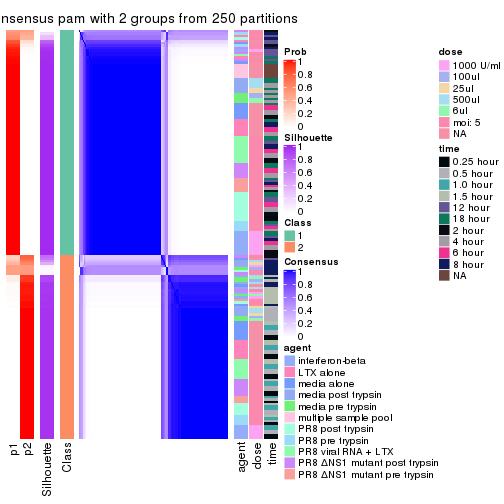
consensus_heatmap(res, k = 3)
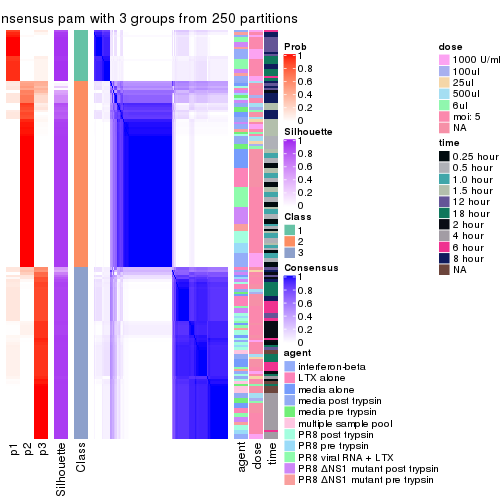
consensus_heatmap(res, k = 4)
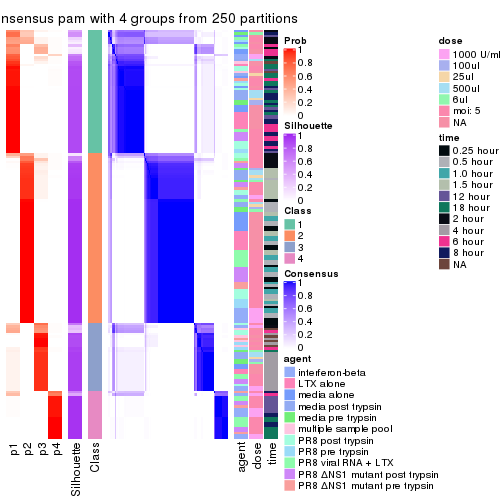
consensus_heatmap(res, k = 5)
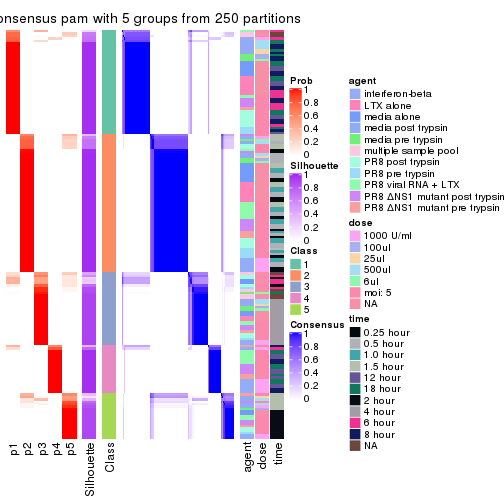
consensus_heatmap(res, k = 6)
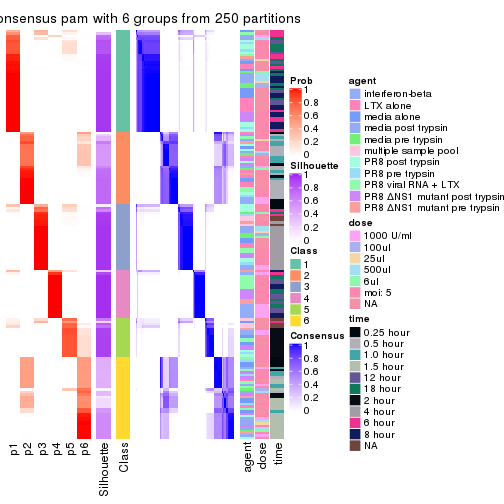
Heatmaps for the membership of samples in all partitions to see how consistent they are:
membership_heatmap(res, k = 2)
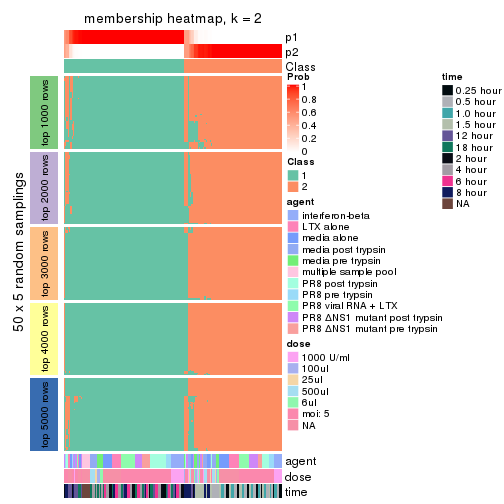
membership_heatmap(res, k = 3)
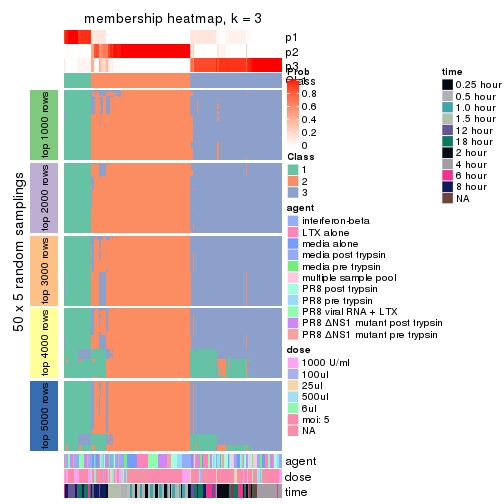
membership_heatmap(res, k = 4)
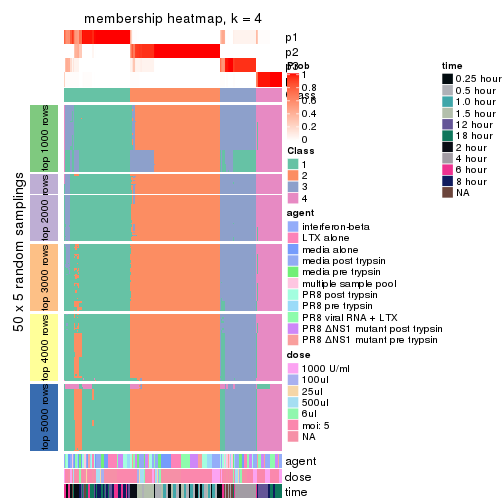
membership_heatmap(res, k = 5)
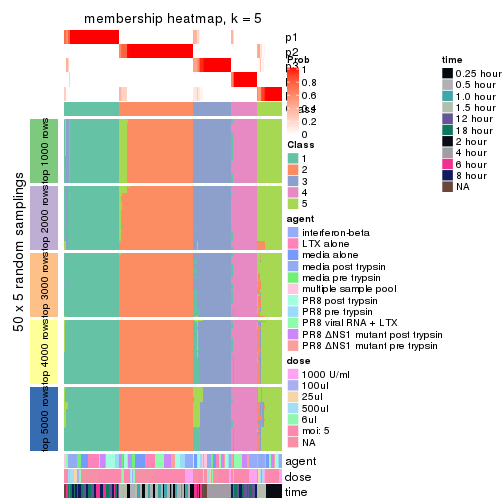
membership_heatmap(res, k = 6)
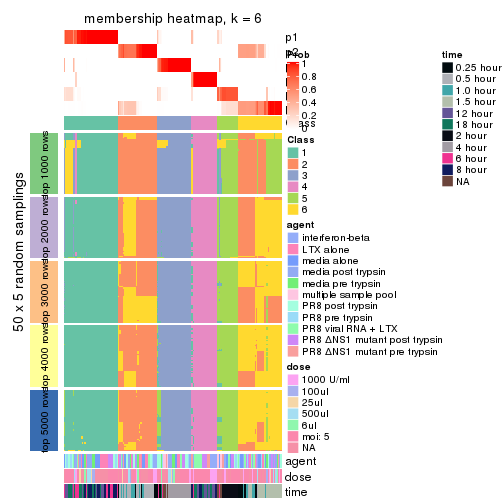
As soon as we have had the classes for columns, we can look for signatures which are significantly different between classes which can be candidate marks for certain classes. Following are the heatmaps for signatures.
Signature heatmaps where rows are scaled:
get_signatures(res, k = 2)
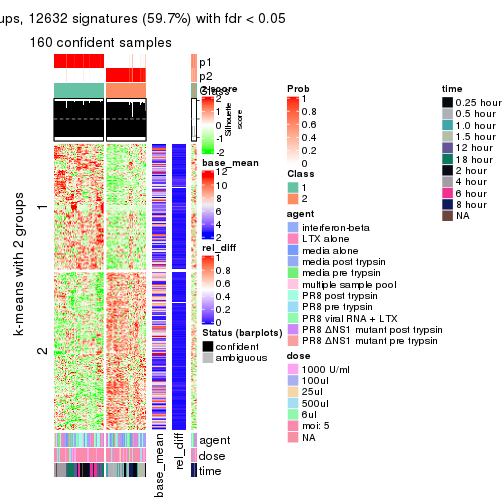
get_signatures(res, k = 3)
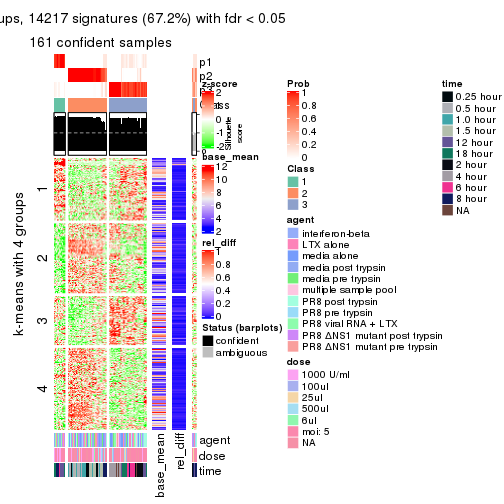
get_signatures(res, k = 4)
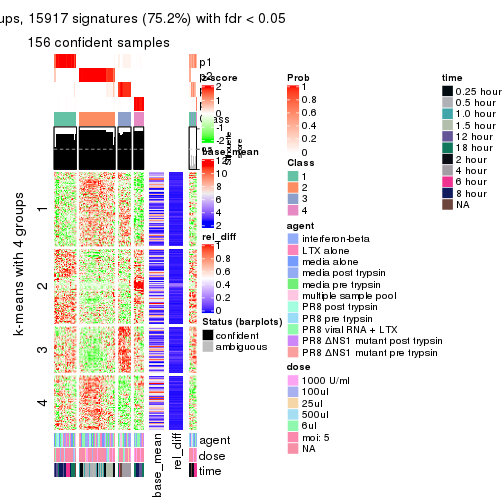
get_signatures(res, k = 5)
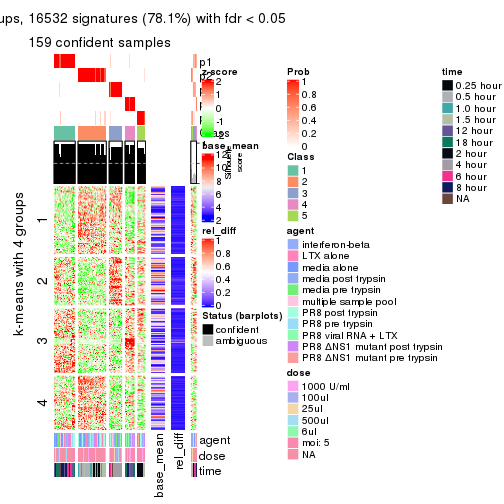
get_signatures(res, k = 6)
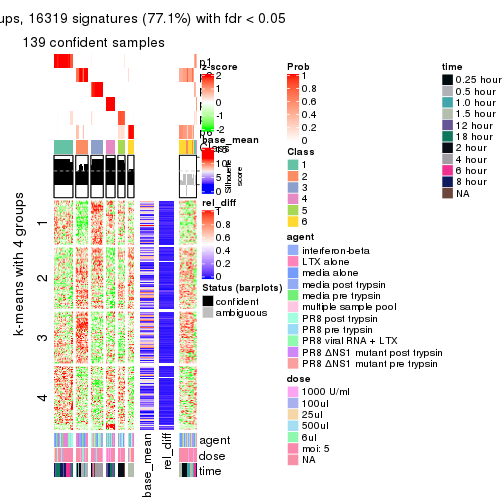
Signature heatmaps where rows are not scaled:
get_signatures(res, k = 2, scale_rows = FALSE)
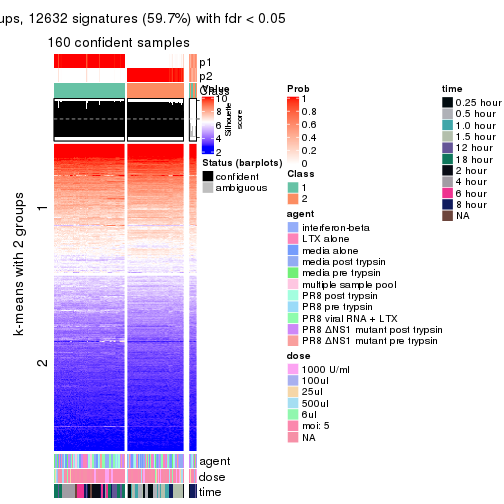
get_signatures(res, k = 3, scale_rows = FALSE)
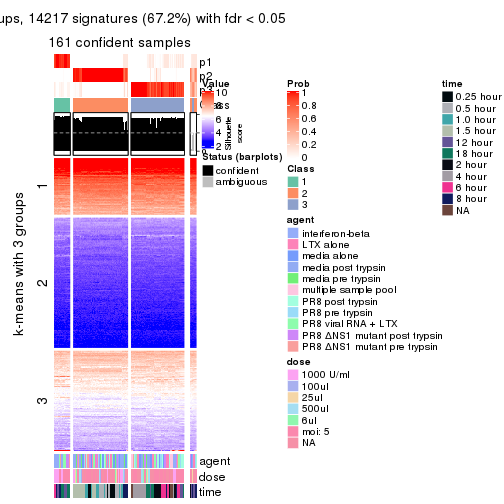
get_signatures(res, k = 4, scale_rows = FALSE)
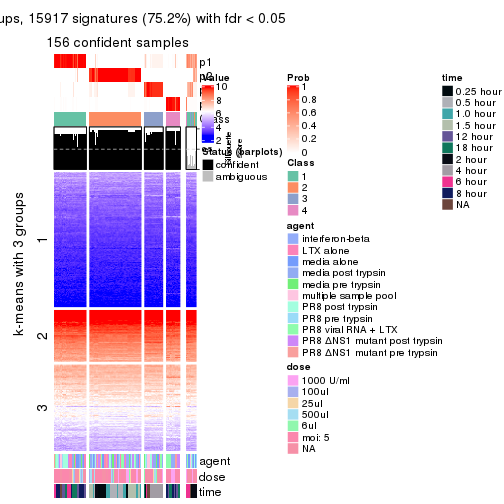
get_signatures(res, k = 5, scale_rows = FALSE)
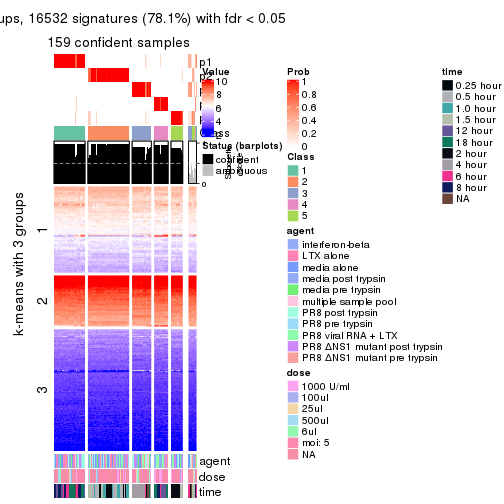
get_signatures(res, k = 6, scale_rows = FALSE)
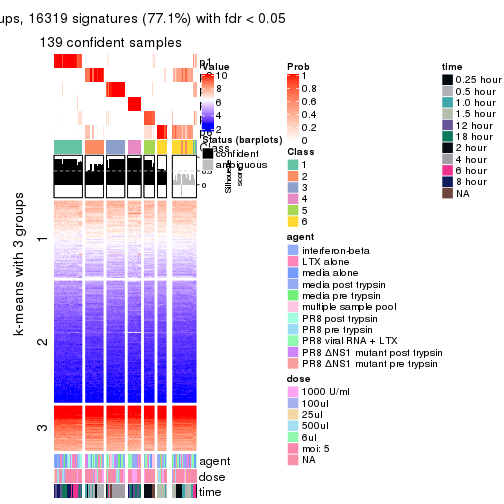
Compare the overlap of signatures from different k:
compare_signatures(res)
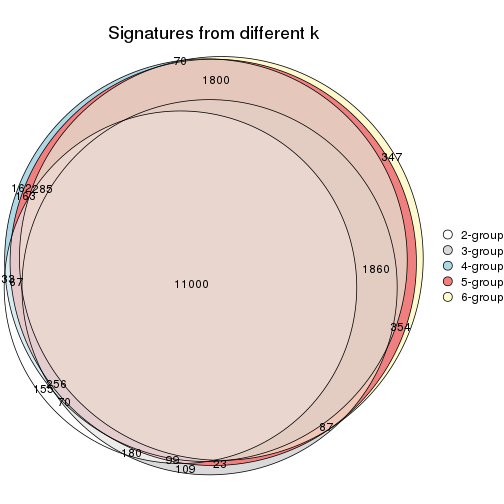
get_signature() returns a data frame invisibly. TO get the list of signatures, the function
call should be assigned to a variable explicitly. In following code, if plot argument is set
to FALSE, no heatmap is plotted while only the differential analysis is performed.
# code only for demonstration
tb = get_signature(res, k = ..., plot = FALSE)
An example of the output of tb is:
#> which_row fdr mean_1 mean_2 scaled_mean_1 scaled_mean_2 km
#> 1 38 0.042760348 8.373488 9.131774 -0.5533452 0.5164555 1
#> 2 40 0.018707592 7.106213 8.469186 -0.6173731 0.5762149 1
#> 3 55 0.019134737 10.221463 11.207825 -0.6159697 0.5749050 1
#> 4 59 0.006059896 5.921854 7.869574 -0.6899429 0.6439467 1
#> 5 60 0.018055526 8.928898 10.211722 -0.6204761 0.5791110 1
#> 6 98 0.009384629 15.714769 14.887706 0.6635654 -0.6193277 2
...
The columns in tb are:
which_row: row indices corresponding to the input matrix.fdr: FDR for the differential test. mean_x: The mean value in group x.scaled_mean_x: The mean value in group x after rows are scaled.km: Row groups if k-means clustering is applied to rows.UMAP plot which shows how samples are separated.
dimension_reduction(res, k = 2, method = "UMAP")
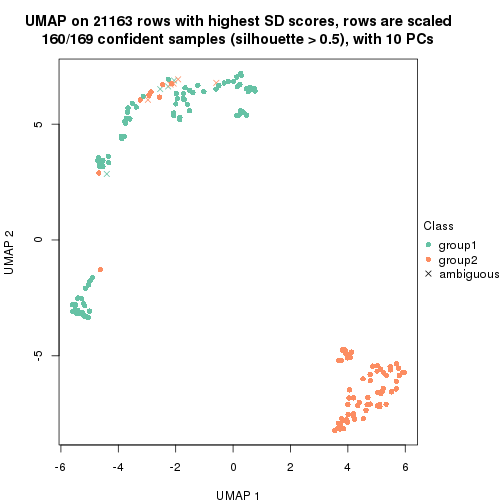
dimension_reduction(res, k = 3, method = "UMAP")
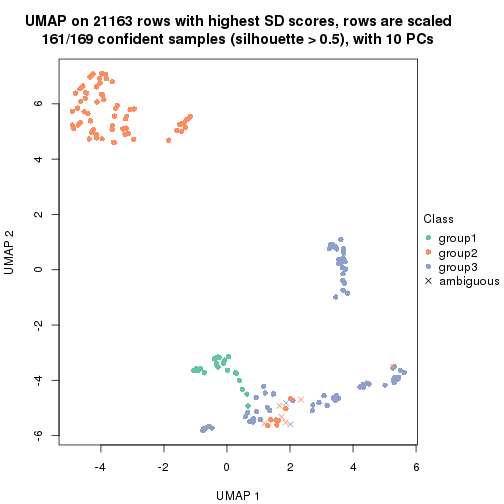
dimension_reduction(res, k = 4, method = "UMAP")
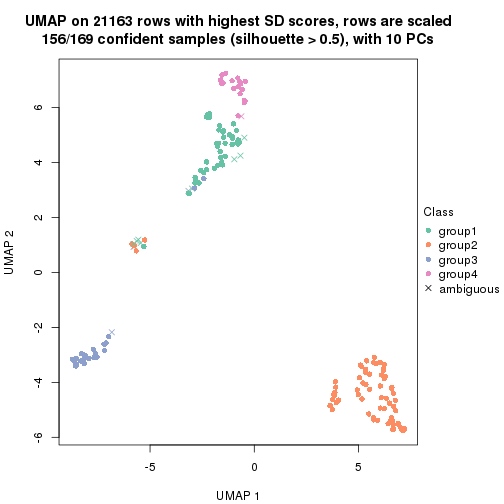
dimension_reduction(res, k = 5, method = "UMAP")
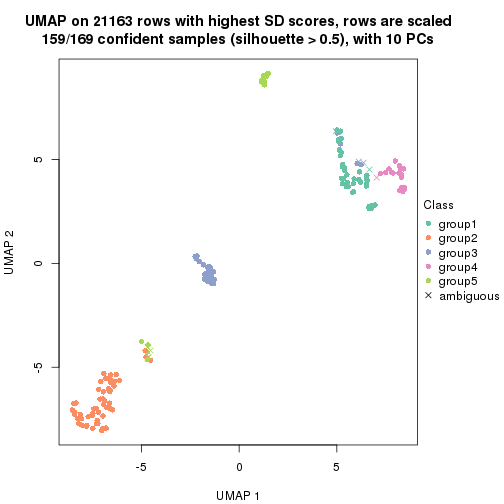
dimension_reduction(res, k = 6, method = "UMAP")
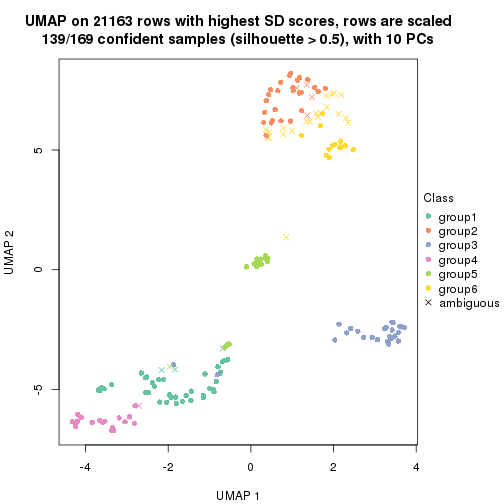
Following heatmap shows how subgroups are split when increasing k:
collect_classes(res)
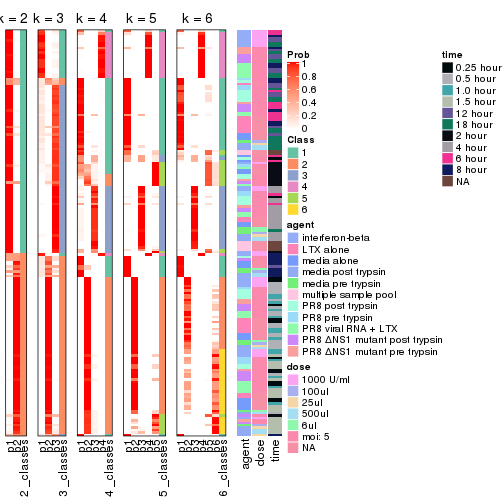
Test correlation between subgroups and known annotations. If the known annotation is numeric, one-way ANOVA test is applied, and if the known annotation is discrete, chi-squared contingency table test is applied.
test_to_known_factors(res)
#> n agent(p) dose(p) time(p) k
#> SD:pam 160 0.577858 0.9280 7.77e-24 2
#> SD:pam 161 0.000728 0.0121 3.02e-29 3
#> SD:pam 156 0.009309 0.1075 1.90e-44 4
#> SD:pam 159 0.028560 0.0894 3.09e-63 5
#> SD:pam 139 0.012382 0.1861 5.05e-76 6
If matrix rows can be associated to genes, consider to use functional_enrichment(res,
...) to perform function enrichment for the signature genes. See this vignette for more detailed explanations.
The object with results only for a single top-value method and a single partition method can be extracted as:
res = res_list["SD", "mclust"]
# you can also extract it by
# res = res_list["SD:mclust"]
A summary of res and all the functions that can be applied to it:
res
#> A 'ConsensusPartition' object with k = 2, 3, 4, 5, 6.
#> On a matrix with 21163 rows and 169 columns.
#> Top rows (1000, 2000, 3000, 4000, 5000) are extracted by 'SD' method.
#> Subgroups are detected by 'mclust' method.
#> Performed in total 1250 partitions by row resampling.
#> Best k for subgroups seems to be 2.
#>
#> Following methods can be applied to this 'ConsensusPartition' object:
#> [1] "cola_report" "collect_classes" "collect_plots"
#> [4] "collect_stats" "colnames" "compare_signatures"
#> [7] "consensus_heatmap" "dimension_reduction" "functional_enrichment"
#> [10] "get_anno_col" "get_anno" "get_classes"
#> [13] "get_consensus" "get_matrix" "get_membership"
#> [16] "get_param" "get_signatures" "get_stats"
#> [19] "is_best_k" "is_stable_k" "membership_heatmap"
#> [22] "ncol" "nrow" "plot_ecdf"
#> [25] "rownames" "select_partition_number" "show"
#> [28] "suggest_best_k" "test_to_known_factors"
collect_plots() function collects all the plots made from res for all k (number of partitions)
into one single page to provide an easy and fast comparison between different k.
collect_plots(res)
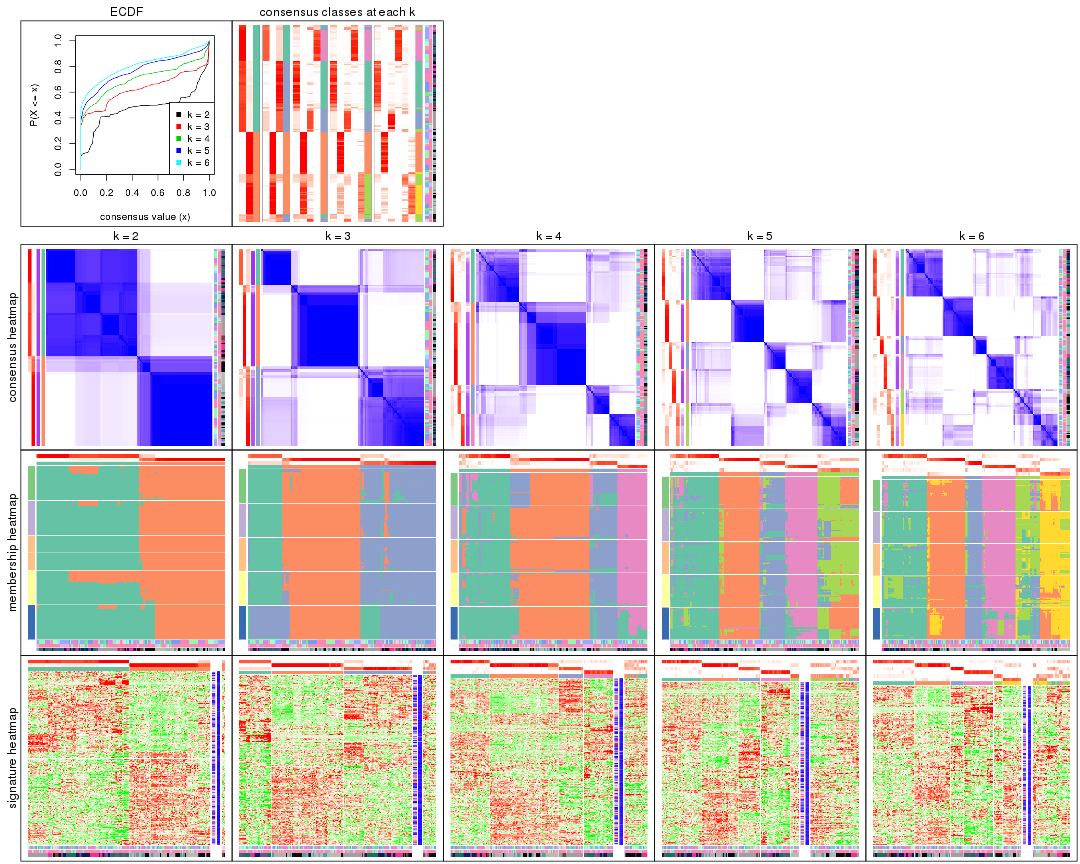
The plots are:
k and the heatmap of
predicted classes for each k.k.k.k.All the plots in panels can be made by individual functions and they are plotted later in this section.
select_partition_number() produces several plots showing different
statistics for choosing “optimized” k. There are following statistics:
k;k, the area increased is defined as \(A_k - A_{k-1}\).The detailed explanations of these statistics can be found in the cola vignette.
Generally speaking, lower PAC score, higher mean silhouette score or higher
concordance corresponds to better partition. Rand index and Jaccard index
measure how similar the current partition is compared to partition with k-1.
If they are too similar, we won't accept k is better than k-1.
select_partition_number(res)
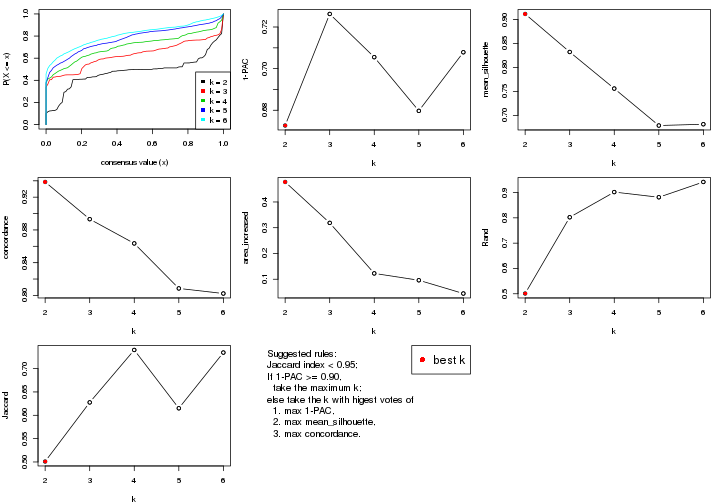
The numeric values for all these statistics can be obtained by get_stats().
get_stats(res)
#> k 1-PAC mean_silhouette concordance area_increased Rand Jaccard
#> 2 2 0.673 0.912 0.939 0.4775 0.501 0.501
#> 3 3 0.726 0.832 0.893 0.3187 0.802 0.628
#> 4 4 0.706 0.756 0.864 0.1227 0.902 0.740
#> 5 5 0.680 0.679 0.809 0.0961 0.881 0.615
#> 6 6 0.708 0.681 0.802 0.0446 0.942 0.734
suggest_best_k() suggests the best \(k\) based on these statistics. The rules are as follows:
suggest_best_k(res)
#> [1] 2
Following shows the table of the partitions (You need to click the show/hide
code output link to see it). The membership matrix (columns with name p*)
is inferred by
clue::cl_consensus()
function with the SE method. Basically the value in the membership matrix
represents the probability to belong to a certain group. The finall class
label for an item is determined with the group with highest probability it
belongs to.
In get_classes() function, the entropy is calculated from the membership
matrix and the silhouette score is calculated from the consensus matrix.
cbind(get_classes(res, k = 2), get_membership(res, k = 2))
#> class entropy silhouette p1 p2
#> GSM528681 2 0.0000 0.945 0.000 1.000
#> GSM528682 2 0.0000 0.945 0.000 1.000
#> GSM528683 2 0.0000 0.945 0.000 1.000
#> GSM528684 2 0.0000 0.945 0.000 1.000
#> GSM528687 2 0.0000 0.945 0.000 1.000
#> GSM528688 2 0.0000 0.945 0.000 1.000
#> GSM528685 2 0.2043 0.922 0.032 0.968
#> GSM528686 2 0.2043 0.922 0.032 0.968
#> GSM528693 1 0.3584 0.944 0.932 0.068
#> GSM528694 1 0.3584 0.944 0.932 0.068
#> GSM528695 1 0.1414 0.922 0.980 0.020
#> GSM528696 1 0.1414 0.922 0.980 0.020
#> GSM528697 1 0.0000 0.924 1.000 0.000
#> GSM528698 1 0.0000 0.924 1.000 0.000
#> GSM528699 1 0.0000 0.924 1.000 0.000
#> GSM528700 1 0.0000 0.924 1.000 0.000
#> GSM528689 1 0.0000 0.924 1.000 0.000
#> GSM528690 1 0.0000 0.924 1.000 0.000
#> GSM528691 1 0.0000 0.924 1.000 0.000
#> GSM528692 1 0.0000 0.924 1.000 0.000
#> GSM528779 2 0.0000 0.945 0.000 1.000
#> GSM528780 2 0.0000 0.945 0.000 1.000
#> GSM528782 2 0.0000 0.945 0.000 1.000
#> GSM528781 2 0.0000 0.945 0.000 1.000
#> GSM528785 2 0.7745 0.714 0.228 0.772
#> GSM528786 1 0.4562 0.941 0.904 0.096
#> GSM528787 1 0.4161 0.944 0.916 0.084
#> GSM528788 1 0.5629 0.921 0.868 0.132
#> GSM528783 1 0.0000 0.924 1.000 0.000
#> GSM528784 1 0.0000 0.924 1.000 0.000
#> GSM528759 1 0.4562 0.940 0.904 0.096
#> GSM528760 1 0.3879 0.944 0.924 0.076
#> GSM528761 2 0.0000 0.945 0.000 1.000
#> GSM528762 2 0.0000 0.945 0.000 1.000
#> GSM528765 2 0.0000 0.945 0.000 1.000
#> GSM528766 2 0.0000 0.945 0.000 1.000
#> GSM528763 2 0.0000 0.945 0.000 1.000
#> GSM528764 2 0.0376 0.943 0.004 0.996
#> GSM528771 2 0.7745 0.714 0.228 0.772
#> GSM528772 2 0.7745 0.714 0.228 0.772
#> GSM528773 1 0.4562 0.941 0.904 0.096
#> GSM528774 1 0.4562 0.941 0.904 0.096
#> GSM528775 1 0.4298 0.943 0.912 0.088
#> GSM528776 1 0.4431 0.942 0.908 0.092
#> GSM528777 1 0.3274 0.943 0.940 0.060
#> GSM528778 1 0.3114 0.942 0.944 0.056
#> GSM528767 1 0.0000 0.924 1.000 0.000
#> GSM528768 1 0.0000 0.924 1.000 0.000
#> GSM528769 1 0.0000 0.924 1.000 0.000
#> GSM528770 1 0.0000 0.924 1.000 0.000
#> GSM528671 2 0.0000 0.945 0.000 1.000
#> GSM528672 2 0.0000 0.945 0.000 1.000
#> GSM528674 2 0.0000 0.945 0.000 1.000
#> GSM528673 2 0.0376 0.943 0.004 0.996
#> GSM528677 2 0.7745 0.714 0.228 0.772
#> GSM528678 1 0.4562 0.941 0.904 0.096
#> GSM528679 1 0.3584 0.944 0.932 0.068
#> GSM528680 1 0.0000 0.924 1.000 0.000
#> GSM528675 1 0.0000 0.924 1.000 0.000
#> GSM528676 1 0.0000 0.924 1.000 0.000
#> GSM528651 2 0.0000 0.945 0.000 1.000
#> GSM528652 2 0.0000 0.945 0.000 1.000
#> GSM528653 2 0.0000 0.945 0.000 1.000
#> GSM528654 2 0.0000 0.945 0.000 1.000
#> GSM528657 2 0.0000 0.945 0.000 1.000
#> GSM528658 2 0.0000 0.945 0.000 1.000
#> GSM528655 2 0.0376 0.943 0.004 0.996
#> GSM528656 2 0.0376 0.943 0.004 0.996
#> GSM528663 2 0.7745 0.714 0.228 0.772
#> GSM528664 2 0.7745 0.714 0.228 0.772
#> GSM528665 1 0.4562 0.941 0.904 0.096
#> GSM528666 1 0.4562 0.941 0.904 0.096
#> GSM528667 1 0.5178 0.931 0.884 0.116
#> GSM528668 1 0.5178 0.931 0.884 0.116
#> GSM528669 1 0.3584 0.944 0.932 0.068
#> GSM528670 1 0.3584 0.944 0.932 0.068
#> GSM528659 1 0.0000 0.924 1.000 0.000
#> GSM528660 1 0.0000 0.924 1.000 0.000
#> GSM528661 1 0.0000 0.924 1.000 0.000
#> GSM528662 1 0.0000 0.924 1.000 0.000
#> GSM528701 2 0.0000 0.945 0.000 1.000
#> GSM528702 2 0.0000 0.945 0.000 1.000
#> GSM528703 2 0.0000 0.945 0.000 1.000
#> GSM528704 2 0.0000 0.945 0.000 1.000
#> GSM528707 2 0.0000 0.945 0.000 1.000
#> GSM528708 2 0.0000 0.945 0.000 1.000
#> GSM528705 2 0.0000 0.945 0.000 1.000
#> GSM528706 2 0.0000 0.945 0.000 1.000
#> GSM528713 2 0.9710 0.316 0.400 0.600
#> GSM528714 2 0.7745 0.714 0.228 0.772
#> GSM528715 1 0.4690 0.940 0.900 0.100
#> GSM528716 1 0.4690 0.940 0.900 0.100
#> GSM528717 1 0.3584 0.944 0.932 0.068
#> GSM528718 1 0.3584 0.944 0.932 0.068
#> GSM528719 1 0.0000 0.924 1.000 0.000
#> GSM528720 1 0.0000 0.924 1.000 0.000
#> GSM528709 1 0.0000 0.924 1.000 0.000
#> GSM528710 1 0.0000 0.924 1.000 0.000
#> GSM528711 1 0.0000 0.924 1.000 0.000
#> GSM528712 1 0.0000 0.924 1.000 0.000
#> GSM528721 2 0.0000 0.945 0.000 1.000
#> GSM528722 2 0.0000 0.945 0.000 1.000
#> GSM528723 2 0.0000 0.945 0.000 1.000
#> GSM528724 2 0.0000 0.945 0.000 1.000
#> GSM528727 2 0.0000 0.945 0.000 1.000
#> GSM528728 2 0.0000 0.945 0.000 1.000
#> GSM528725 2 0.0000 0.945 0.000 1.000
#> GSM528726 2 0.0000 0.945 0.000 1.000
#> GSM528733 1 0.4562 0.941 0.904 0.096
#> GSM528734 1 0.4562 0.941 0.904 0.096
#> GSM528735 1 0.4161 0.944 0.916 0.084
#> GSM528736 1 0.4022 0.944 0.920 0.080
#> GSM528737 1 0.5178 0.931 0.884 0.116
#> GSM528738 1 0.5178 0.931 0.884 0.116
#> GSM528729 1 0.5946 0.912 0.856 0.144
#> GSM528730 1 0.5946 0.912 0.856 0.144
#> GSM528731 1 0.5946 0.912 0.856 0.144
#> GSM528732 1 0.5946 0.912 0.856 0.144
#> GSM528739 2 0.0000 0.945 0.000 1.000
#> GSM528740 2 0.0000 0.945 0.000 1.000
#> GSM528741 2 0.0000 0.945 0.000 1.000
#> GSM528742 2 0.0000 0.945 0.000 1.000
#> GSM528745 2 0.0000 0.945 0.000 1.000
#> GSM528746 2 0.0000 0.945 0.000 1.000
#> GSM528743 2 0.0000 0.945 0.000 1.000
#> GSM528744 2 0.0000 0.945 0.000 1.000
#> GSM528751 2 0.7745 0.714 0.228 0.772
#> GSM528752 2 0.8267 0.660 0.260 0.740
#> GSM528753 1 0.4562 0.941 0.904 0.096
#> GSM528754 1 0.4562 0.941 0.904 0.096
#> GSM528755 1 0.3733 0.944 0.928 0.072
#> GSM528756 1 0.3584 0.944 0.932 0.068
#> GSM528757 1 0.5946 0.912 0.856 0.144
#> GSM528758 1 0.5946 0.912 0.856 0.144
#> GSM528747 1 0.5946 0.912 0.856 0.144
#> GSM528748 1 0.5946 0.912 0.856 0.144
#> GSM528749 1 0.5178 0.931 0.884 0.116
#> GSM528750 1 0.5946 0.912 0.856 0.144
#> GSM528640 2 0.0000 0.945 0.000 1.000
#> GSM528641 2 0.0376 0.943 0.004 0.996
#> GSM528643 1 0.4562 0.941 0.904 0.096
#> GSM528644 1 0.5946 0.912 0.856 0.144
#> GSM528642 1 0.5629 0.920 0.868 0.132
#> GSM528620 2 0.0000 0.945 0.000 1.000
#> GSM528621 2 0.6887 0.765 0.184 0.816
#> GSM528623 1 0.4562 0.941 0.904 0.096
#> GSM528624 1 0.5946 0.912 0.856 0.144
#> GSM528622 1 0.5946 0.912 0.856 0.144
#> GSM528625 2 0.0000 0.945 0.000 1.000
#> GSM528626 2 0.0376 0.943 0.004 0.996
#> GSM528628 1 0.4562 0.941 0.904 0.096
#> GSM528629 1 0.5946 0.912 0.856 0.144
#> GSM528627 1 0.5629 0.921 0.868 0.132
#> GSM528630 2 0.0000 0.945 0.000 1.000
#> GSM528631 2 0.0000 0.945 0.000 1.000
#> GSM528632 2 0.0376 0.943 0.004 0.996
#> GSM528633 2 0.0376 0.943 0.004 0.996
#> GSM528636 1 0.4562 0.941 0.904 0.096
#> GSM528637 1 0.4562 0.941 0.904 0.096
#> GSM528638 1 0.5946 0.912 0.856 0.144
#> GSM528639 1 0.5946 0.912 0.856 0.144
#> GSM528634 1 0.4815 0.937 0.896 0.104
#> GSM528635 1 0.5629 0.921 0.868 0.132
#> GSM528645 2 0.9248 0.493 0.340 0.660
#> GSM528646 2 0.9460 0.430 0.364 0.636
#> GSM528647 2 0.8207 0.670 0.256 0.744
#> GSM528648 1 0.4562 0.940 0.904 0.096
#> GSM528649 1 0.4022 0.944 0.920 0.080
#> GSM528650 1 0.4562 0.940 0.904 0.096
cbind(get_classes(res, k = 3), get_membership(res, k = 3))
#> class entropy silhouette p1 p2 p3
#> GSM528681 2 0.0000 0.95466 0.000 1.000 0.000
#> GSM528682 2 0.0000 0.95466 0.000 1.000 0.000
#> GSM528683 2 0.0000 0.95466 0.000 1.000 0.000
#> GSM528684 2 0.0000 0.95466 0.000 1.000 0.000
#> GSM528687 2 0.0000 0.95466 0.000 1.000 0.000
#> GSM528688 2 0.0000 0.95466 0.000 1.000 0.000
#> GSM528685 2 0.3359 0.86867 0.084 0.900 0.016
#> GSM528686 2 0.3359 0.86867 0.084 0.900 0.016
#> GSM528693 3 0.5325 0.54583 0.248 0.004 0.748
#> GSM528694 3 0.5404 0.52815 0.256 0.004 0.740
#> GSM528695 1 0.5810 0.13233 0.664 0.000 0.336
#> GSM528696 1 0.6008 0.13977 0.664 0.004 0.332
#> GSM528697 1 0.4504 0.95912 0.804 0.000 0.196
#> GSM528698 1 0.4555 0.95621 0.800 0.000 0.200
#> GSM528699 1 0.4555 0.95621 0.800 0.000 0.200
#> GSM528700 1 0.4504 0.95912 0.804 0.000 0.196
#> GSM528689 1 0.4504 0.95912 0.804 0.000 0.196
#> GSM528690 1 0.4504 0.95912 0.804 0.000 0.196
#> GSM528691 1 0.4504 0.95912 0.804 0.000 0.196
#> GSM528692 1 0.4504 0.95912 0.804 0.000 0.196
#> GSM528779 2 0.0000 0.95466 0.000 1.000 0.000
#> GSM528780 2 0.0000 0.95466 0.000 1.000 0.000
#> GSM528782 2 0.0000 0.95466 0.000 1.000 0.000
#> GSM528781 2 0.0000 0.95466 0.000 1.000 0.000
#> GSM528785 3 0.6308 0.00188 0.000 0.492 0.508
#> GSM528786 3 0.5431 0.71046 0.284 0.000 0.716
#> GSM528787 3 0.2165 0.80643 0.064 0.000 0.936
#> GSM528788 3 0.0000 0.82898 0.000 0.000 1.000
#> GSM528783 1 0.4654 0.94712 0.792 0.000 0.208
#> GSM528784 1 0.4504 0.95912 0.804 0.000 0.196
#> GSM528759 3 0.1031 0.82482 0.024 0.000 0.976
#> GSM528760 3 0.0892 0.82588 0.020 0.000 0.980
#> GSM528761 2 0.0000 0.95466 0.000 1.000 0.000
#> GSM528762 2 0.0000 0.95466 0.000 1.000 0.000
#> GSM528765 2 0.0000 0.95466 0.000 1.000 0.000
#> GSM528766 2 0.0000 0.95466 0.000 1.000 0.000
#> GSM528763 2 0.0237 0.95204 0.000 0.996 0.004
#> GSM528764 2 0.0747 0.94377 0.000 0.984 0.016
#> GSM528771 2 0.6008 0.41762 0.000 0.628 0.372
#> GSM528772 2 0.6045 0.39779 0.000 0.620 0.380
#> GSM528773 3 0.5178 0.72544 0.256 0.000 0.744
#> GSM528774 3 0.4974 0.72975 0.236 0.000 0.764
#> GSM528775 3 0.3482 0.74658 0.128 0.000 0.872
#> GSM528776 3 0.1860 0.80835 0.052 0.000 0.948
#> GSM528777 3 0.1411 0.81664 0.036 0.000 0.964
#> GSM528778 3 0.1411 0.81664 0.036 0.000 0.964
#> GSM528767 1 0.4504 0.95912 0.804 0.000 0.196
#> GSM528768 1 0.4504 0.95912 0.804 0.000 0.196
#> GSM528769 1 0.4504 0.95912 0.804 0.000 0.196
#> GSM528770 1 0.4504 0.95912 0.804 0.000 0.196
#> GSM528671 2 0.0000 0.95466 0.000 1.000 0.000
#> GSM528672 2 0.0000 0.95466 0.000 1.000 0.000
#> GSM528674 2 0.0000 0.95466 0.000 1.000 0.000
#> GSM528673 2 0.0747 0.94377 0.000 0.984 0.016
#> GSM528677 2 0.6647 0.16126 0.008 0.540 0.452
#> GSM528678 3 0.2796 0.80321 0.092 0.000 0.908
#> GSM528679 3 0.5882 0.18091 0.348 0.000 0.652
#> GSM528680 1 0.4555 0.95621 0.800 0.000 0.200
#> GSM528675 1 0.4504 0.95912 0.804 0.000 0.196
#> GSM528676 1 0.4504 0.95912 0.804 0.000 0.196
#> GSM528651 2 0.0000 0.95466 0.000 1.000 0.000
#> GSM528652 2 0.0000 0.95466 0.000 1.000 0.000
#> GSM528653 2 0.0000 0.95466 0.000 1.000 0.000
#> GSM528654 2 0.0000 0.95466 0.000 1.000 0.000
#> GSM528657 2 0.0000 0.95466 0.000 1.000 0.000
#> GSM528658 2 0.0000 0.95466 0.000 1.000 0.000
#> GSM528655 2 0.0747 0.94377 0.000 0.984 0.016
#> GSM528656 2 0.0747 0.94377 0.000 0.984 0.016
#> GSM528663 2 0.5988 0.54882 0.008 0.688 0.304
#> GSM528664 2 0.5958 0.55641 0.008 0.692 0.300
#> GSM528665 3 0.4931 0.73006 0.232 0.000 0.768
#> GSM528666 3 0.4931 0.73006 0.232 0.000 0.768
#> GSM528667 3 0.0747 0.82623 0.016 0.000 0.984
#> GSM528668 3 0.0424 0.82850 0.008 0.000 0.992
#> GSM528669 3 0.2448 0.79047 0.076 0.000 0.924
#> GSM528670 3 0.1860 0.80814 0.052 0.000 0.948
#> GSM528659 1 0.4504 0.95912 0.804 0.000 0.196
#> GSM528660 1 0.4504 0.95912 0.804 0.000 0.196
#> GSM528661 1 0.4504 0.95912 0.804 0.000 0.196
#> GSM528662 1 0.4504 0.95912 0.804 0.000 0.196
#> GSM528701 2 0.0000 0.95466 0.000 1.000 0.000
#> GSM528702 2 0.0000 0.95466 0.000 1.000 0.000
#> GSM528703 2 0.0000 0.95466 0.000 1.000 0.000
#> GSM528704 2 0.0000 0.95466 0.000 1.000 0.000
#> GSM528707 2 0.0000 0.95466 0.000 1.000 0.000
#> GSM528708 2 0.0000 0.95466 0.000 1.000 0.000
#> GSM528705 2 0.0000 0.95466 0.000 1.000 0.000
#> GSM528706 2 0.0000 0.95466 0.000 1.000 0.000
#> GSM528713 3 0.5285 0.56226 0.004 0.244 0.752
#> GSM528714 2 0.6451 0.36958 0.008 0.608 0.384
#> GSM528715 3 0.5178 0.72359 0.256 0.000 0.744
#> GSM528716 3 0.5178 0.72359 0.256 0.000 0.744
#> GSM528717 1 0.4796 0.93491 0.780 0.000 0.220
#> GSM528718 1 0.5098 0.90455 0.752 0.000 0.248
#> GSM528719 1 0.4555 0.95621 0.800 0.000 0.200
#> GSM528720 1 0.4555 0.95621 0.800 0.000 0.200
#> GSM528709 1 0.4504 0.95912 0.804 0.000 0.196
#> GSM528710 1 0.4504 0.95912 0.804 0.000 0.196
#> GSM528711 1 0.4504 0.95912 0.804 0.000 0.196
#> GSM528712 1 0.4504 0.95912 0.804 0.000 0.196
#> GSM528721 2 0.0000 0.95466 0.000 1.000 0.000
#> GSM528722 2 0.0000 0.95466 0.000 1.000 0.000
#> GSM528723 2 0.0000 0.95466 0.000 1.000 0.000
#> GSM528724 2 0.0000 0.95466 0.000 1.000 0.000
#> GSM528727 2 0.0000 0.95466 0.000 1.000 0.000
#> GSM528728 2 0.0000 0.95466 0.000 1.000 0.000
#> GSM528725 2 0.0000 0.95466 0.000 1.000 0.000
#> GSM528726 2 0.0000 0.95466 0.000 1.000 0.000
#> GSM528733 3 0.4931 0.73006 0.232 0.000 0.768
#> GSM528734 3 0.4931 0.73006 0.232 0.000 0.768
#> GSM528735 3 0.2448 0.77921 0.076 0.000 0.924
#> GSM528736 3 0.0892 0.82370 0.020 0.000 0.980
#> GSM528737 3 0.0000 0.82898 0.000 0.000 1.000
#> GSM528738 3 0.0592 0.82669 0.012 0.000 0.988
#> GSM528729 3 0.0000 0.82898 0.000 0.000 1.000
#> GSM528730 3 0.0000 0.82898 0.000 0.000 1.000
#> GSM528731 3 0.0000 0.82898 0.000 0.000 1.000
#> GSM528732 3 0.0237 0.82880 0.004 0.000 0.996
#> GSM528739 2 0.0000 0.95466 0.000 1.000 0.000
#> GSM528740 2 0.0000 0.95466 0.000 1.000 0.000
#> GSM528741 2 0.0000 0.95466 0.000 1.000 0.000
#> GSM528742 2 0.0000 0.95466 0.000 1.000 0.000
#> GSM528745 2 0.0000 0.95466 0.000 1.000 0.000
#> GSM528746 2 0.0000 0.95466 0.000 1.000 0.000
#> GSM528743 2 0.0000 0.95466 0.000 1.000 0.000
#> GSM528744 2 0.0000 0.95466 0.000 1.000 0.000
#> GSM528751 3 0.6305 0.03310 0.000 0.484 0.516
#> GSM528752 3 0.5760 0.43757 0.000 0.328 0.672
#> GSM528753 3 0.4931 0.73006 0.232 0.000 0.768
#> GSM528754 3 0.4931 0.73006 0.232 0.000 0.768
#> GSM528755 3 0.2448 0.78248 0.076 0.000 0.924
#> GSM528756 3 0.2711 0.76879 0.088 0.000 0.912
#> GSM528757 3 0.0000 0.82898 0.000 0.000 1.000
#> GSM528758 3 0.0000 0.82898 0.000 0.000 1.000
#> GSM528747 3 0.0000 0.82898 0.000 0.000 1.000
#> GSM528748 3 0.0475 0.82866 0.004 0.004 0.992
#> GSM528749 3 0.0000 0.82898 0.000 0.000 1.000
#> GSM528750 3 0.0000 0.82898 0.000 0.000 1.000
#> GSM528640 2 0.0000 0.95466 0.000 1.000 0.000
#> GSM528641 2 0.0747 0.94377 0.000 0.984 0.016
#> GSM528643 3 0.4931 0.73006 0.232 0.000 0.768
#> GSM528644 3 0.0475 0.82866 0.004 0.004 0.992
#> GSM528642 3 0.1031 0.82563 0.024 0.000 0.976
#> GSM528620 2 0.0000 0.95466 0.000 1.000 0.000
#> GSM528621 2 0.4504 0.71689 0.000 0.804 0.196
#> GSM528623 3 0.4931 0.73006 0.232 0.000 0.768
#> GSM528624 3 0.0000 0.82898 0.000 0.000 1.000
#> GSM528622 3 0.0237 0.82863 0.004 0.000 0.996
#> GSM528625 2 0.0000 0.95466 0.000 1.000 0.000
#> GSM528626 2 0.0747 0.94377 0.000 0.984 0.016
#> GSM528628 3 0.4974 0.72975 0.236 0.000 0.764
#> GSM528629 3 0.0237 0.82880 0.004 0.000 0.996
#> GSM528627 3 0.1031 0.82285 0.024 0.000 0.976
#> GSM528630 2 0.0000 0.95466 0.000 1.000 0.000
#> GSM528631 2 0.0000 0.95466 0.000 1.000 0.000
#> GSM528632 2 0.0747 0.94377 0.000 0.984 0.016
#> GSM528633 2 0.0747 0.94377 0.000 0.984 0.016
#> GSM528636 3 0.4931 0.73006 0.232 0.000 0.768
#> GSM528637 3 0.4931 0.73006 0.232 0.000 0.768
#> GSM528638 3 0.0000 0.82898 0.000 0.000 1.000
#> GSM528639 3 0.0237 0.82880 0.004 0.000 0.996
#> GSM528634 3 0.1031 0.82285 0.024 0.000 0.976
#> GSM528635 3 0.0000 0.82898 0.000 0.000 1.000
#> GSM528645 3 0.9379 0.48166 0.276 0.216 0.508
#> GSM528646 3 0.9098 0.52767 0.276 0.184 0.540
#> GSM528647 3 0.8067 0.42346 0.100 0.284 0.616
#> GSM528648 3 0.2796 0.78568 0.092 0.000 0.908
#> GSM528649 3 0.2959 0.77655 0.100 0.000 0.900
#> GSM528650 3 0.2537 0.79320 0.080 0.000 0.920
cbind(get_classes(res, k = 4), get_membership(res, k = 4))
#> class entropy silhouette p1 p2 p3 p4
#> GSM528681 2 0.0000 0.89195 0.000 1.000 0.000 0.000
#> GSM528682 2 0.0000 0.89195 0.000 1.000 0.000 0.000
#> GSM528683 2 0.0000 0.89195 0.000 1.000 0.000 0.000
#> GSM528684 2 0.0000 0.89195 0.000 1.000 0.000 0.000
#> GSM528687 2 0.0000 0.89195 0.000 1.000 0.000 0.000
#> GSM528688 2 0.0000 0.89195 0.000 1.000 0.000 0.000
#> GSM528685 2 0.4122 0.75079 0.004 0.760 0.236 0.000
#> GSM528686 2 0.4368 0.74054 0.004 0.748 0.244 0.004
#> GSM528693 1 0.7613 -0.00660 0.448 0.004 0.372 0.176
#> GSM528694 3 0.7463 0.18085 0.364 0.000 0.456 0.180
#> GSM528695 3 0.6267 0.53586 0.112 0.000 0.648 0.240
#> GSM528696 3 0.6267 0.53586 0.112 0.000 0.648 0.240
#> GSM528697 4 0.3356 0.86890 0.176 0.000 0.000 0.824
#> GSM528698 4 0.4679 0.83244 0.184 0.000 0.044 0.772
#> GSM528699 4 0.3751 0.84169 0.196 0.000 0.004 0.800
#> GSM528700 4 0.3024 0.88731 0.148 0.000 0.000 0.852
#> GSM528689 4 0.2281 0.91286 0.096 0.000 0.000 0.904
#> GSM528690 4 0.1867 0.91626 0.072 0.000 0.000 0.928
#> GSM528691 4 0.3444 0.85596 0.184 0.000 0.000 0.816
#> GSM528692 4 0.4079 0.86110 0.180 0.000 0.020 0.800
#> GSM528779 2 0.0707 0.89102 0.000 0.980 0.020 0.000
#> GSM528780 2 0.0921 0.89009 0.000 0.972 0.028 0.000
#> GSM528782 2 0.0000 0.89195 0.000 1.000 0.000 0.000
#> GSM528781 2 0.1722 0.88277 0.000 0.944 0.048 0.008
#> GSM528785 1 0.8309 0.08171 0.408 0.356 0.212 0.024
#> GSM528786 3 0.3306 0.83908 0.156 0.000 0.840 0.004
#> GSM528787 3 0.5097 0.37546 0.428 0.000 0.568 0.004
#> GSM528788 1 0.0000 0.80325 1.000 0.000 0.000 0.000
#> GSM528783 4 0.3626 0.86269 0.184 0.000 0.004 0.812
#> GSM528784 4 0.1576 0.90524 0.048 0.000 0.004 0.948
#> GSM528759 1 0.2760 0.71550 0.872 0.000 0.128 0.000
#> GSM528760 3 0.5158 0.29300 0.472 0.000 0.524 0.004
#> GSM528761 2 0.1118 0.88898 0.000 0.964 0.036 0.000
#> GSM528762 2 0.0000 0.89195 0.000 1.000 0.000 0.000
#> GSM528765 2 0.1118 0.88898 0.000 0.964 0.036 0.000
#> GSM528766 2 0.0921 0.89009 0.000 0.972 0.028 0.000
#> GSM528763 2 0.1474 0.88323 0.000 0.948 0.052 0.000
#> GSM528764 2 0.4122 0.75079 0.004 0.760 0.236 0.000
#> GSM528771 2 0.8568 0.14683 0.256 0.404 0.308 0.032
#> GSM528772 2 0.8569 0.13231 0.248 0.396 0.324 0.032
#> GSM528773 3 0.2760 0.84407 0.128 0.000 0.872 0.000
#> GSM528774 3 0.3024 0.84714 0.148 0.000 0.852 0.000
#> GSM528775 1 0.7002 0.18616 0.520 0.000 0.352 0.128
#> GSM528776 1 0.3051 0.76990 0.884 0.000 0.028 0.088
#> GSM528777 1 0.2773 0.74699 0.880 0.000 0.004 0.116
#> GSM528778 1 0.2773 0.74699 0.880 0.000 0.004 0.116
#> GSM528767 4 0.1902 0.91541 0.064 0.000 0.004 0.932
#> GSM528768 4 0.1902 0.91541 0.064 0.000 0.004 0.932
#> GSM528769 4 0.1305 0.89831 0.036 0.000 0.004 0.960
#> GSM528770 4 0.1824 0.91148 0.060 0.000 0.004 0.936
#> GSM528671 2 0.1118 0.88898 0.000 0.964 0.036 0.000
#> GSM528672 2 0.0000 0.89195 0.000 1.000 0.000 0.000
#> GSM528674 2 0.0817 0.89053 0.000 0.976 0.024 0.000
#> GSM528673 2 0.4302 0.74828 0.004 0.756 0.236 0.004
#> GSM528677 2 0.8646 0.01426 0.272 0.360 0.336 0.032
#> GSM528678 3 0.5040 0.53789 0.364 0.000 0.628 0.008
#> GSM528679 1 0.5035 0.65014 0.748 0.000 0.056 0.196
#> GSM528680 4 0.3257 0.88465 0.152 0.000 0.004 0.844
#> GSM528675 4 0.1118 0.89829 0.036 0.000 0.000 0.964
#> GSM528676 4 0.1118 0.89829 0.036 0.000 0.000 0.964
#> GSM528651 2 0.1452 0.88732 0.000 0.956 0.036 0.008
#> GSM528652 2 0.1305 0.88813 0.000 0.960 0.036 0.004
#> GSM528653 2 0.0000 0.89195 0.000 1.000 0.000 0.000
#> GSM528654 2 0.0000 0.89195 0.000 1.000 0.000 0.000
#> GSM528657 2 0.1118 0.88898 0.000 0.964 0.036 0.000
#> GSM528658 2 0.0000 0.89195 0.000 1.000 0.000 0.000
#> GSM528655 2 0.4122 0.75079 0.004 0.760 0.236 0.000
#> GSM528656 2 0.4302 0.74828 0.004 0.756 0.236 0.004
#> GSM528663 2 0.8327 0.26674 0.196 0.448 0.324 0.032
#> GSM528664 2 0.8318 0.27611 0.196 0.452 0.320 0.032
#> GSM528665 3 0.2973 0.84887 0.144 0.000 0.856 0.000
#> GSM528666 3 0.2973 0.84887 0.144 0.000 0.856 0.000
#> GSM528667 1 0.1151 0.79938 0.968 0.000 0.024 0.008
#> GSM528668 1 0.1004 0.79998 0.972 0.000 0.024 0.004
#> GSM528669 1 0.2888 0.74117 0.872 0.000 0.004 0.124
#> GSM528670 1 0.2714 0.75188 0.884 0.000 0.004 0.112
#> GSM528659 4 0.1118 0.89829 0.036 0.000 0.000 0.964
#> GSM528660 4 0.1118 0.89829 0.036 0.000 0.000 0.964
#> GSM528661 4 0.1118 0.89829 0.036 0.000 0.000 0.964
#> GSM528662 4 0.1637 0.91516 0.060 0.000 0.000 0.940
#> GSM528701 2 0.0000 0.89195 0.000 1.000 0.000 0.000
#> GSM528702 2 0.0000 0.89195 0.000 1.000 0.000 0.000
#> GSM528703 2 0.0000 0.89195 0.000 1.000 0.000 0.000
#> GSM528704 2 0.0000 0.89195 0.000 1.000 0.000 0.000
#> GSM528707 2 0.0000 0.89195 0.000 1.000 0.000 0.000
#> GSM528708 2 0.0000 0.89195 0.000 1.000 0.000 0.000
#> GSM528705 2 0.0000 0.89195 0.000 1.000 0.000 0.000
#> GSM528706 2 0.1118 0.88898 0.000 0.964 0.036 0.000
#> GSM528713 1 0.8660 -0.04733 0.360 0.284 0.324 0.032
#> GSM528714 2 0.8431 0.14419 0.204 0.400 0.364 0.032
#> GSM528715 3 0.2868 0.84812 0.136 0.000 0.864 0.000
#> GSM528716 3 0.2814 0.84806 0.132 0.000 0.868 0.000
#> GSM528717 1 0.6197 0.37568 0.604 0.000 0.072 0.324
#> GSM528718 1 0.6746 0.35614 0.568 0.000 0.116 0.316
#> GSM528719 4 0.4679 0.83244 0.184 0.000 0.044 0.772
#> GSM528720 4 0.4679 0.83244 0.184 0.000 0.044 0.772
#> GSM528709 4 0.2281 0.91286 0.096 0.000 0.000 0.904
#> GSM528710 4 0.1716 0.91503 0.064 0.000 0.000 0.936
#> GSM528711 4 0.1637 0.91516 0.060 0.000 0.000 0.940
#> GSM528712 4 0.2149 0.91445 0.088 0.000 0.000 0.912
#> GSM528721 2 0.0000 0.89195 0.000 1.000 0.000 0.000
#> GSM528722 2 0.0000 0.89195 0.000 1.000 0.000 0.000
#> GSM528723 2 0.0000 0.89195 0.000 1.000 0.000 0.000
#> GSM528724 2 0.0000 0.89195 0.000 1.000 0.000 0.000
#> GSM528727 2 0.1118 0.88898 0.000 0.964 0.036 0.000
#> GSM528728 2 0.0000 0.89195 0.000 1.000 0.000 0.000
#> GSM528725 2 0.0000 0.89195 0.000 1.000 0.000 0.000
#> GSM528726 2 0.1118 0.88898 0.000 0.964 0.036 0.000
#> GSM528733 3 0.2973 0.84887 0.144 0.000 0.856 0.000
#> GSM528734 3 0.2973 0.84887 0.144 0.000 0.856 0.000
#> GSM528735 1 0.2111 0.78869 0.932 0.000 0.044 0.024
#> GSM528736 1 0.1677 0.79355 0.948 0.000 0.040 0.012
#> GSM528737 1 0.0817 0.79923 0.976 0.000 0.024 0.000
#> GSM528738 1 0.1284 0.79925 0.964 0.000 0.024 0.012
#> GSM528729 1 0.0000 0.80325 1.000 0.000 0.000 0.000
#> GSM528730 1 0.0188 0.80307 0.996 0.000 0.004 0.000
#> GSM528731 1 0.0000 0.80325 1.000 0.000 0.000 0.000
#> GSM528732 1 0.0188 0.80307 0.996 0.000 0.004 0.000
#> GSM528739 2 0.0000 0.89195 0.000 1.000 0.000 0.000
#> GSM528740 2 0.0000 0.89195 0.000 1.000 0.000 0.000
#> GSM528741 2 0.1118 0.88898 0.000 0.964 0.036 0.000
#> GSM528742 2 0.0000 0.89195 0.000 1.000 0.000 0.000
#> GSM528745 2 0.1118 0.88898 0.000 0.964 0.036 0.000
#> GSM528746 2 0.0000 0.89195 0.000 1.000 0.000 0.000
#> GSM528743 2 0.1118 0.88898 0.000 0.964 0.036 0.000
#> GSM528744 2 0.1118 0.88898 0.000 0.964 0.036 0.000
#> GSM528751 2 0.8478 -0.03827 0.356 0.360 0.260 0.024
#> GSM528752 1 0.8624 0.00655 0.356 0.352 0.260 0.032
#> GSM528753 3 0.2704 0.84472 0.124 0.000 0.876 0.000
#> GSM528754 3 0.2704 0.84472 0.124 0.000 0.876 0.000
#> GSM528755 1 0.4797 0.50462 0.720 0.000 0.260 0.020
#> GSM528756 1 0.5013 0.42810 0.688 0.000 0.292 0.020
#> GSM528757 1 0.0188 0.80238 0.996 0.000 0.004 0.000
#> GSM528758 1 0.0000 0.80325 1.000 0.000 0.000 0.000
#> GSM528747 1 0.0000 0.80325 1.000 0.000 0.000 0.000
#> GSM528748 1 0.2089 0.76386 0.932 0.048 0.020 0.000
#> GSM528749 1 0.0336 0.80290 0.992 0.000 0.008 0.000
#> GSM528750 1 0.0188 0.80307 0.996 0.000 0.004 0.000
#> GSM528640 2 0.0000 0.89195 0.000 1.000 0.000 0.000
#> GSM528641 2 0.4122 0.75079 0.004 0.760 0.236 0.000
#> GSM528643 3 0.2704 0.84472 0.124 0.000 0.876 0.000
#> GSM528644 1 0.2245 0.76876 0.932 0.040 0.020 0.008
#> GSM528642 1 0.4372 0.46336 0.728 0.004 0.268 0.000
#> GSM528620 2 0.1118 0.88898 0.000 0.964 0.036 0.000
#> GSM528621 2 0.7631 0.46680 0.172 0.552 0.256 0.020
#> GSM528623 3 0.2973 0.84887 0.144 0.000 0.856 0.000
#> GSM528624 1 0.0000 0.80325 1.000 0.000 0.000 0.000
#> GSM528622 1 0.1004 0.79998 0.972 0.000 0.024 0.004
#> GSM528625 2 0.0000 0.89195 0.000 1.000 0.000 0.000
#> GSM528626 2 0.4368 0.74054 0.004 0.748 0.244 0.004
#> GSM528628 3 0.3172 0.84092 0.160 0.000 0.840 0.000
#> GSM528629 1 0.0188 0.80307 0.996 0.000 0.004 0.000
#> GSM528627 1 0.1388 0.79898 0.960 0.000 0.028 0.012
#> GSM528630 2 0.1118 0.88898 0.000 0.964 0.036 0.000
#> GSM528631 2 0.1452 0.88732 0.000 0.956 0.036 0.008
#> GSM528632 2 0.4431 0.73199 0.004 0.740 0.252 0.004
#> GSM528633 2 0.4368 0.74054 0.004 0.748 0.244 0.004
#> GSM528636 3 0.2704 0.84472 0.124 0.000 0.876 0.000
#> GSM528637 3 0.2973 0.84887 0.144 0.000 0.856 0.000
#> GSM528638 1 0.0000 0.80325 1.000 0.000 0.000 0.000
#> GSM528639 1 0.0657 0.79964 0.984 0.000 0.004 0.012
#> GSM528634 1 0.2741 0.75657 0.892 0.000 0.096 0.012
#> GSM528635 1 0.0921 0.79866 0.972 0.000 0.028 0.000
#> GSM528645 3 0.3134 0.76101 0.088 0.024 0.884 0.004
#> GSM528646 3 0.2843 0.76613 0.088 0.020 0.892 0.000
#> GSM528647 3 0.5793 0.52885 0.248 0.056 0.688 0.008
#> GSM528648 1 0.3899 0.73395 0.840 0.000 0.052 0.108
#> GSM528649 1 0.6963 -0.00259 0.464 0.000 0.424 0.112
#> GSM528650 1 0.4114 0.73197 0.828 0.000 0.060 0.112
cbind(get_classes(res, k = 5), get_membership(res, k = 5))
#> class entropy silhouette p1 p2 p3 p4 p5
#> GSM528681 2 0.0000 0.9216 0.000 1.000 0.000 0.000 0.000
#> GSM528682 2 0.0000 0.9216 0.000 1.000 0.000 0.000 0.000
#> GSM528683 2 0.0000 0.9216 0.000 1.000 0.000 0.000 0.000
#> GSM528684 2 0.0000 0.9216 0.000 1.000 0.000 0.000 0.000
#> GSM528687 2 0.0771 0.9089 0.000 0.976 0.004 0.000 0.020
#> GSM528688 2 0.0162 0.9200 0.000 0.996 0.000 0.000 0.004
#> GSM528685 5 0.3876 0.5868 0.000 0.192 0.032 0.000 0.776
#> GSM528686 5 0.3994 0.5867 0.000 0.188 0.040 0.000 0.772
#> GSM528693 1 0.7986 0.1893 0.400 0.000 0.312 0.124 0.164
#> GSM528694 3 0.8149 0.0359 0.296 0.000 0.372 0.120 0.212
#> GSM528695 3 0.6913 0.3763 0.128 0.000 0.540 0.276 0.056
#> GSM528696 3 0.6913 0.3763 0.128 0.000 0.540 0.276 0.056
#> GSM528697 4 0.1270 0.9126 0.052 0.000 0.000 0.948 0.000
#> GSM528698 4 0.3174 0.8548 0.132 0.000 0.004 0.844 0.020
#> GSM528699 4 0.4043 0.8079 0.168 0.000 0.012 0.788 0.032
#> GSM528700 4 0.1671 0.8990 0.076 0.000 0.000 0.924 0.000
#> GSM528689 4 0.1197 0.9123 0.048 0.000 0.000 0.952 0.000
#> GSM528690 4 0.0963 0.9146 0.036 0.000 0.000 0.964 0.000
#> GSM528691 4 0.1608 0.9026 0.072 0.000 0.000 0.928 0.000
#> GSM528692 4 0.3891 0.8433 0.136 0.000 0.016 0.812 0.036
#> GSM528779 2 0.1608 0.8559 0.000 0.928 0.000 0.000 0.072
#> GSM528780 2 0.4235 -0.1191 0.000 0.576 0.000 0.000 0.424
#> GSM528782 2 0.0000 0.9216 0.000 1.000 0.000 0.000 0.000
#> GSM528781 5 0.4455 0.4743 0.000 0.404 0.008 0.000 0.588
#> GSM528785 1 0.6829 0.2665 0.452 0.024 0.084 0.020 0.420
#> GSM528786 3 0.4693 0.8009 0.132 0.000 0.768 0.024 0.076
#> GSM528787 1 0.6387 0.1108 0.436 0.000 0.416 0.004 0.144
#> GSM528788 1 0.0162 0.8220 0.996 0.000 0.000 0.004 0.000
#> GSM528783 4 0.3086 0.8879 0.068 0.000 0.020 0.876 0.036
#> GSM528784 4 0.0703 0.9095 0.024 0.000 0.000 0.976 0.000
#> GSM528759 1 0.2295 0.8136 0.900 0.000 0.088 0.008 0.004
#> GSM528760 1 0.4997 0.3258 0.568 0.000 0.404 0.008 0.020
#> GSM528761 5 0.4294 0.3978 0.000 0.468 0.000 0.000 0.532
#> GSM528762 2 0.0000 0.9216 0.000 1.000 0.000 0.000 0.000
#> GSM528765 5 0.4517 0.4468 0.000 0.436 0.008 0.000 0.556
#> GSM528766 2 0.4304 -0.3197 0.000 0.516 0.000 0.000 0.484
#> GSM528763 5 0.4641 0.3717 0.000 0.456 0.012 0.000 0.532
#> GSM528764 5 0.3929 0.5822 0.000 0.208 0.028 0.000 0.764
#> GSM528771 5 0.6775 0.2373 0.152 0.040 0.180 0.016 0.612
#> GSM528772 5 0.6978 0.1851 0.144 0.040 0.220 0.016 0.580
#> GSM528773 3 0.3909 0.8191 0.124 0.000 0.808 0.004 0.064
#> GSM528774 3 0.2835 0.8441 0.112 0.000 0.868 0.004 0.016
#> GSM528775 1 0.7257 0.3402 0.476 0.000 0.312 0.056 0.156
#> GSM528776 1 0.3692 0.7577 0.812 0.000 0.052 0.136 0.000
#> GSM528777 1 0.3455 0.6875 0.784 0.000 0.008 0.208 0.000
#> GSM528778 1 0.3519 0.6800 0.776 0.000 0.008 0.216 0.000
#> GSM528767 4 0.0794 0.9120 0.028 0.000 0.000 0.972 0.000
#> GSM528768 4 0.0880 0.9135 0.032 0.000 0.000 0.968 0.000
#> GSM528769 4 0.0609 0.9069 0.020 0.000 0.000 0.980 0.000
#> GSM528770 4 0.0794 0.9118 0.028 0.000 0.000 0.972 0.000
#> GSM528671 5 0.4291 0.3844 0.000 0.464 0.000 0.000 0.536
#> GSM528672 2 0.0000 0.9216 0.000 1.000 0.000 0.000 0.000
#> GSM528674 2 0.3336 0.5374 0.000 0.772 0.000 0.000 0.228
#> GSM528673 5 0.3724 0.5850 0.000 0.204 0.020 0.000 0.776
#> GSM528677 5 0.7167 -0.0766 0.160 0.020 0.320 0.016 0.484
#> GSM528678 3 0.4975 0.6847 0.204 0.000 0.712 0.008 0.076
#> GSM528679 1 0.5224 0.1203 0.532 0.000 0.036 0.428 0.004
#> GSM528680 4 0.1851 0.8936 0.088 0.000 0.000 0.912 0.000
#> GSM528675 4 0.0510 0.9066 0.016 0.000 0.000 0.984 0.000
#> GSM528676 4 0.0510 0.9066 0.016 0.000 0.000 0.984 0.000
#> GSM528651 5 0.4430 0.3958 0.000 0.456 0.004 0.000 0.540
#> GSM528652 5 0.4359 0.4657 0.000 0.412 0.004 0.000 0.584
#> GSM528653 2 0.0000 0.9216 0.000 1.000 0.000 0.000 0.000
#> GSM528654 2 0.0000 0.9216 0.000 1.000 0.000 0.000 0.000
#> GSM528657 5 0.4538 0.4243 0.000 0.452 0.008 0.000 0.540
#> GSM528658 2 0.0000 0.9216 0.000 1.000 0.000 0.000 0.000
#> GSM528655 5 0.3724 0.5850 0.000 0.204 0.020 0.000 0.776
#> GSM528656 5 0.3586 0.5869 0.000 0.188 0.020 0.000 0.792
#> GSM528663 5 0.6371 0.1445 0.092 0.016 0.292 0.016 0.584
#> GSM528664 5 0.6354 0.1533 0.092 0.016 0.288 0.016 0.588
#> GSM528665 3 0.2074 0.8477 0.104 0.000 0.896 0.000 0.000
#> GSM528666 3 0.2179 0.8458 0.112 0.000 0.888 0.000 0.000
#> GSM528667 1 0.1197 0.8255 0.952 0.000 0.048 0.000 0.000
#> GSM528668 1 0.1197 0.8255 0.952 0.000 0.048 0.000 0.000
#> GSM528669 1 0.3525 0.7383 0.816 0.000 0.024 0.156 0.004
#> GSM528670 1 0.2921 0.7425 0.844 0.000 0.004 0.148 0.004
#> GSM528659 4 0.0510 0.9066 0.016 0.000 0.000 0.984 0.000
#> GSM528660 4 0.0510 0.9066 0.016 0.000 0.000 0.984 0.000
#> GSM528661 4 0.0510 0.9066 0.016 0.000 0.000 0.984 0.000
#> GSM528662 4 0.0794 0.9138 0.028 0.000 0.000 0.972 0.000
#> GSM528701 2 0.1043 0.8912 0.000 0.960 0.000 0.000 0.040
#> GSM528702 2 0.0510 0.9128 0.000 0.984 0.000 0.000 0.016
#> GSM528703 2 0.0404 0.9141 0.000 0.988 0.000 0.000 0.012
#> GSM528704 2 0.0000 0.9216 0.000 1.000 0.000 0.000 0.000
#> GSM528707 2 0.0000 0.9216 0.000 1.000 0.000 0.000 0.000
#> GSM528708 2 0.1270 0.8725 0.000 0.948 0.000 0.000 0.052
#> GSM528705 2 0.0162 0.9200 0.000 0.996 0.000 0.000 0.004
#> GSM528706 2 0.4367 -0.0293 0.000 0.580 0.004 0.000 0.416
#> GSM528713 5 0.7276 -0.1095 0.320 0.012 0.208 0.016 0.444
#> GSM528714 5 0.6302 -0.0286 0.092 0.004 0.364 0.016 0.524
#> GSM528715 3 0.2389 0.8442 0.116 0.000 0.880 0.000 0.004
#> GSM528716 3 0.2513 0.8445 0.116 0.000 0.876 0.000 0.008
#> GSM528717 4 0.5948 0.2200 0.416 0.000 0.060 0.504 0.020
#> GSM528718 4 0.6846 0.2000 0.376 0.000 0.116 0.468 0.040
#> GSM528719 4 0.3219 0.8519 0.136 0.000 0.004 0.840 0.020
#> GSM528720 4 0.3174 0.8548 0.132 0.000 0.004 0.844 0.020
#> GSM528709 4 0.1121 0.9130 0.044 0.000 0.000 0.956 0.000
#> GSM528710 4 0.0880 0.9140 0.032 0.000 0.000 0.968 0.000
#> GSM528711 4 0.0794 0.9138 0.028 0.000 0.000 0.972 0.000
#> GSM528712 4 0.1282 0.9132 0.044 0.000 0.004 0.952 0.000
#> GSM528721 2 0.0000 0.9216 0.000 1.000 0.000 0.000 0.000
#> GSM528722 2 0.1197 0.8842 0.000 0.952 0.000 0.000 0.048
#> GSM528723 2 0.0000 0.9216 0.000 1.000 0.000 0.000 0.000
#> GSM528724 2 0.0000 0.9216 0.000 1.000 0.000 0.000 0.000
#> GSM528727 5 0.4538 0.4243 0.000 0.452 0.008 0.000 0.540
#> GSM528728 2 0.0000 0.9216 0.000 1.000 0.000 0.000 0.000
#> GSM528725 2 0.0510 0.9128 0.000 0.984 0.000 0.000 0.016
#> GSM528726 5 0.4452 0.3189 0.000 0.496 0.004 0.000 0.500
#> GSM528733 3 0.2074 0.8477 0.104 0.000 0.896 0.000 0.000
#> GSM528734 3 0.2127 0.8472 0.108 0.000 0.892 0.000 0.000
#> GSM528735 1 0.3247 0.7679 0.840 0.000 0.136 0.016 0.008
#> GSM528736 1 0.2956 0.7684 0.848 0.000 0.140 0.004 0.008
#> GSM528737 1 0.1197 0.8255 0.952 0.000 0.048 0.000 0.000
#> GSM528738 1 0.1518 0.8254 0.944 0.000 0.048 0.004 0.004
#> GSM528729 1 0.0324 0.8229 0.992 0.000 0.004 0.004 0.000
#> GSM528730 1 0.0451 0.8239 0.988 0.000 0.008 0.004 0.000
#> GSM528731 1 0.0324 0.8229 0.992 0.000 0.004 0.004 0.000
#> GSM528732 1 0.1041 0.8271 0.964 0.000 0.032 0.004 0.000
#> GSM528739 2 0.0510 0.9128 0.000 0.984 0.000 0.000 0.016
#> GSM528740 2 0.0510 0.9128 0.000 0.984 0.000 0.000 0.016
#> GSM528741 5 0.4304 0.3633 0.000 0.484 0.000 0.000 0.516
#> GSM528742 2 0.0290 0.9166 0.000 0.992 0.000 0.000 0.008
#> GSM528745 5 0.4321 0.4805 0.000 0.396 0.004 0.000 0.600
#> GSM528746 2 0.0000 0.9216 0.000 1.000 0.000 0.000 0.000
#> GSM528743 5 0.4455 0.4743 0.000 0.404 0.008 0.000 0.588
#> GSM528744 5 0.4455 0.4743 0.000 0.404 0.008 0.000 0.588
#> GSM528751 5 0.7169 -0.1875 0.384 0.024 0.124 0.020 0.448
#> GSM528752 5 0.7211 -0.1383 0.360 0.024 0.144 0.016 0.456
#> GSM528753 3 0.2020 0.8480 0.100 0.000 0.900 0.000 0.000
#> GSM528754 3 0.2020 0.8480 0.100 0.000 0.900 0.000 0.000
#> GSM528755 1 0.5393 0.6439 0.692 0.000 0.176 0.012 0.120
#> GSM528756 1 0.5557 0.6291 0.680 0.000 0.184 0.016 0.120
#> GSM528757 1 0.0324 0.8221 0.992 0.000 0.000 0.004 0.004
#> GSM528758 1 0.0324 0.8221 0.992 0.000 0.000 0.004 0.004
#> GSM528747 1 0.1041 0.8271 0.964 0.000 0.032 0.004 0.000
#> GSM528748 1 0.1885 0.8246 0.932 0.000 0.044 0.004 0.020
#> GSM528749 1 0.1124 0.8272 0.960 0.000 0.036 0.000 0.004
#> GSM528750 1 0.0833 0.8263 0.976 0.000 0.016 0.004 0.004
#> GSM528640 2 0.0000 0.9216 0.000 1.000 0.000 0.000 0.000
#> GSM528641 5 0.3724 0.5850 0.000 0.204 0.020 0.000 0.776
#> GSM528643 3 0.2020 0.8480 0.100 0.000 0.900 0.000 0.000
#> GSM528644 1 0.2283 0.8177 0.916 0.000 0.036 0.008 0.040
#> GSM528642 1 0.4476 0.6871 0.744 0.000 0.204 0.008 0.044
#> GSM528620 5 0.4397 0.4522 0.000 0.432 0.004 0.000 0.564
#> GSM528621 5 0.6357 0.1951 0.068 0.032 0.284 0.016 0.600
#> GSM528623 3 0.2127 0.8472 0.108 0.000 0.892 0.000 0.000
#> GSM528624 1 0.0324 0.8221 0.992 0.000 0.000 0.004 0.004
#> GSM528622 1 0.1121 0.8259 0.956 0.000 0.044 0.000 0.000
#> GSM528625 2 0.0000 0.9216 0.000 1.000 0.000 0.000 0.000
#> GSM528626 5 0.4190 0.5838 0.000 0.172 0.060 0.000 0.768
#> GSM528628 3 0.2694 0.8363 0.128 0.000 0.864 0.004 0.004
#> GSM528629 1 0.0955 0.8272 0.968 0.000 0.028 0.004 0.000
#> GSM528627 1 0.1704 0.8243 0.928 0.000 0.068 0.004 0.000
#> GSM528630 5 0.4504 0.4561 0.000 0.428 0.008 0.000 0.564
#> GSM528631 5 0.4383 0.4521 0.000 0.424 0.004 0.000 0.572
#> GSM528632 5 0.5906 0.4105 0.000 0.140 0.284 0.000 0.576
#> GSM528633 5 0.5929 0.4563 0.000 0.156 0.260 0.000 0.584
#> GSM528636 3 0.2020 0.8480 0.100 0.000 0.900 0.000 0.000
#> GSM528637 3 0.2020 0.8480 0.100 0.000 0.900 0.000 0.000
#> GSM528638 1 0.0324 0.8221 0.992 0.000 0.000 0.004 0.004
#> GSM528639 1 0.2674 0.7948 0.888 0.000 0.020 0.008 0.084
#> GSM528634 1 0.2848 0.7740 0.840 0.000 0.156 0.004 0.000
#> GSM528635 1 0.1357 0.8261 0.948 0.000 0.048 0.000 0.004
#> GSM528645 3 0.3906 0.6039 0.016 0.000 0.744 0.000 0.240
#> GSM528646 3 0.3912 0.6265 0.020 0.000 0.752 0.000 0.228
#> GSM528647 3 0.5554 0.5383 0.108 0.000 0.640 0.004 0.248
#> GSM528648 1 0.4454 0.7615 0.800 0.000 0.084 0.060 0.056
#> GSM528649 1 0.6058 0.4118 0.556 0.000 0.352 0.036 0.056
#> GSM528650 1 0.4442 0.7617 0.800 0.000 0.088 0.060 0.052
cbind(get_classes(res, k = 6), get_membership(res, k = 6))
#> class entropy silhouette p1 p2 p3 p4 p5 p6
#> GSM528681 2 0.0000 0.89168 0.000 1.000 0.000 0.000 0.000 0.000
#> GSM528682 2 0.0000 0.89168 0.000 1.000 0.000 0.000 0.000 0.000
#> GSM528683 2 0.0000 0.89168 0.000 1.000 0.000 0.000 0.000 0.000
#> GSM528684 2 0.0000 0.89168 0.000 1.000 0.000 0.000 0.000 0.000
#> GSM528687 2 0.2730 0.80214 0.000 0.808 0.000 0.000 0.000 0.192
#> GSM528688 2 0.1556 0.87469 0.000 0.920 0.000 0.000 0.000 0.080
#> GSM528685 6 0.3714 0.41865 0.000 0.004 0.000 0.000 0.340 0.656
#> GSM528686 6 0.3819 0.37673 0.000 0.004 0.000 0.000 0.372 0.624
#> GSM528693 5 0.6398 0.39976 0.324 0.000 0.092 0.088 0.496 0.000
#> GSM528694 5 0.6611 0.49433 0.252 0.000 0.152 0.084 0.512 0.000
#> GSM528695 5 0.6781 0.07556 0.040 0.000 0.360 0.212 0.384 0.004
#> GSM528696 5 0.6781 0.07556 0.040 0.000 0.360 0.212 0.384 0.004
#> GSM528697 4 0.1225 0.89283 0.036 0.000 0.000 0.952 0.012 0.000
#> GSM528698 4 0.1732 0.88514 0.072 0.000 0.000 0.920 0.004 0.004
#> GSM528699 4 0.1765 0.86955 0.096 0.000 0.000 0.904 0.000 0.000
#> GSM528700 4 0.1327 0.88834 0.064 0.000 0.000 0.936 0.000 0.000
#> GSM528689 4 0.1204 0.89110 0.056 0.000 0.000 0.944 0.000 0.000
#> GSM528690 4 0.1010 0.89355 0.036 0.000 0.000 0.960 0.004 0.000
#> GSM528691 4 0.1349 0.89157 0.056 0.000 0.000 0.940 0.004 0.000
#> GSM528692 4 0.2378 0.80547 0.152 0.000 0.000 0.848 0.000 0.000
#> GSM528779 2 0.2912 0.76111 0.000 0.784 0.000 0.000 0.000 0.216
#> GSM528780 2 0.3833 -0.17309 0.000 0.556 0.000 0.000 0.000 0.444
#> GSM528782 2 0.1814 0.85168 0.000 0.900 0.000 0.000 0.000 0.100
#> GSM528781 6 0.2145 0.66358 0.000 0.072 0.000 0.000 0.028 0.900
#> GSM528785 5 0.6088 0.36257 0.388 0.008 0.012 0.004 0.468 0.120
#> GSM528786 5 0.5875 0.14105 0.092 0.000 0.420 0.024 0.460 0.004
#> GSM528787 1 0.6369 -0.29166 0.348 0.000 0.316 0.004 0.328 0.004
#> GSM528788 1 0.1700 0.77112 0.916 0.000 0.000 0.004 0.080 0.000
#> GSM528783 4 0.2509 0.84869 0.088 0.000 0.000 0.876 0.036 0.000
#> GSM528784 4 0.0909 0.88491 0.012 0.000 0.000 0.968 0.020 0.000
#> GSM528759 1 0.3448 0.76882 0.828 0.000 0.096 0.008 0.064 0.004
#> GSM528760 1 0.4908 0.52425 0.628 0.000 0.296 0.004 0.068 0.004
#> GSM528761 6 0.3672 0.57954 0.000 0.368 0.000 0.000 0.000 0.632
#> GSM528762 2 0.0000 0.89168 0.000 1.000 0.000 0.000 0.000 0.000
#> GSM528765 6 0.3023 0.66425 0.000 0.232 0.000 0.000 0.000 0.768
#> GSM528766 6 0.3838 0.44204 0.000 0.448 0.000 0.000 0.000 0.552
#> GSM528763 6 0.4834 0.55085 0.000 0.128 0.000 0.000 0.212 0.660
#> GSM528764 6 0.3756 0.40343 0.000 0.004 0.000 0.000 0.352 0.644
#> GSM528771 5 0.6157 0.44912 0.224 0.000 0.020 0.000 0.508 0.248
#> GSM528772 5 0.6045 0.51923 0.220 0.000 0.028 0.000 0.552 0.200
#> GSM528773 3 0.5022 -0.05625 0.072 0.000 0.496 0.000 0.432 0.000
#> GSM528774 3 0.5044 0.09007 0.080 0.000 0.536 0.000 0.384 0.000
#> GSM528775 1 0.6802 -0.17937 0.404 0.000 0.180 0.044 0.364 0.008
#> GSM528776 1 0.4664 0.68787 0.744 0.000 0.048 0.144 0.060 0.004
#> GSM528777 1 0.4639 0.52788 0.660 0.000 0.000 0.256 0.084 0.000
#> GSM528778 1 0.4659 0.52191 0.656 0.000 0.000 0.260 0.084 0.000
#> GSM528767 4 0.0806 0.89036 0.020 0.000 0.000 0.972 0.008 0.000
#> GSM528768 4 0.0806 0.89036 0.020 0.000 0.000 0.972 0.008 0.000
#> GSM528769 4 0.1765 0.85381 0.000 0.000 0.000 0.904 0.096 0.000
#> GSM528770 4 0.1003 0.88731 0.016 0.000 0.000 0.964 0.020 0.000
#> GSM528671 6 0.3023 0.64743 0.000 0.232 0.000 0.000 0.000 0.768
#> GSM528672 2 0.0363 0.89189 0.000 0.988 0.000 0.000 0.000 0.012
#> GSM528674 2 0.2941 0.59534 0.000 0.780 0.000 0.000 0.000 0.220
#> GSM528673 6 0.3742 0.40633 0.000 0.004 0.000 0.000 0.348 0.648
#> GSM528677 5 0.5095 0.62241 0.228 0.000 0.044 0.000 0.668 0.060
#> GSM528678 5 0.6058 0.40068 0.248 0.000 0.292 0.004 0.456 0.000
#> GSM528679 4 0.5936 0.00929 0.428 0.000 0.044 0.456 0.068 0.004
#> GSM528680 4 0.1387 0.88703 0.068 0.000 0.000 0.932 0.000 0.000
#> GSM528675 4 0.1908 0.85234 0.000 0.000 0.000 0.900 0.096 0.004
#> GSM528676 4 0.1908 0.85234 0.000 0.000 0.000 0.900 0.096 0.004
#> GSM528651 6 0.3161 0.65411 0.000 0.216 0.000 0.000 0.008 0.776
#> GSM528652 6 0.2491 0.69150 0.000 0.164 0.000 0.000 0.000 0.836
#> GSM528653 2 0.0363 0.89189 0.000 0.988 0.000 0.000 0.000 0.012
#> GSM528654 2 0.1267 0.87737 0.000 0.940 0.000 0.000 0.000 0.060
#> GSM528657 6 0.3076 0.65888 0.000 0.240 0.000 0.000 0.000 0.760
#> GSM528658 2 0.0790 0.88385 0.000 0.968 0.000 0.000 0.000 0.032
#> GSM528655 6 0.3742 0.40633 0.000 0.004 0.000 0.000 0.348 0.648
#> GSM528656 6 0.3795 0.38655 0.000 0.004 0.000 0.000 0.364 0.632
#> GSM528663 5 0.4146 0.61279 0.120 0.000 0.024 0.000 0.776 0.080
#> GSM528664 5 0.4146 0.61258 0.120 0.000 0.024 0.000 0.776 0.080
#> GSM528665 3 0.0363 0.86212 0.012 0.000 0.988 0.000 0.000 0.000
#> GSM528666 3 0.0000 0.86814 0.000 0.000 1.000 0.000 0.000 0.000
#> GSM528667 1 0.2279 0.79511 0.900 0.000 0.048 0.000 0.048 0.004
#> GSM528668 1 0.2279 0.79511 0.900 0.000 0.048 0.000 0.048 0.004
#> GSM528669 1 0.4235 0.61198 0.724 0.000 0.000 0.192 0.084 0.000
#> GSM528670 1 0.3996 0.64302 0.752 0.000 0.000 0.168 0.080 0.000
#> GSM528659 4 0.1765 0.85381 0.000 0.000 0.000 0.904 0.096 0.000
#> GSM528660 4 0.1765 0.85381 0.000 0.000 0.000 0.904 0.096 0.000
#> GSM528661 4 0.1908 0.85234 0.000 0.000 0.000 0.900 0.096 0.004
#> GSM528662 4 0.0922 0.89098 0.024 0.000 0.000 0.968 0.004 0.004
#> GSM528701 2 0.2730 0.79024 0.000 0.808 0.000 0.000 0.000 0.192
#> GSM528702 2 0.2562 0.81000 0.000 0.828 0.000 0.000 0.000 0.172
#> GSM528703 2 0.0260 0.89072 0.000 0.992 0.000 0.000 0.000 0.008
#> GSM528704 2 0.0000 0.89168 0.000 1.000 0.000 0.000 0.000 0.000
#> GSM528707 2 0.1075 0.87933 0.000 0.952 0.000 0.000 0.000 0.048
#> GSM528708 2 0.2416 0.81740 0.000 0.844 0.000 0.000 0.000 0.156
#> GSM528705 2 0.1610 0.87300 0.000 0.916 0.000 0.000 0.000 0.084
#> GSM528706 6 0.3266 0.59604 0.000 0.272 0.000 0.000 0.000 0.728
#> GSM528713 5 0.4584 0.59856 0.248 0.000 0.024 0.000 0.688 0.040
#> GSM528714 5 0.4334 0.62031 0.136 0.000 0.052 0.000 0.764 0.048
#> GSM528715 3 0.0865 0.83835 0.036 0.000 0.964 0.000 0.000 0.000
#> GSM528716 3 0.0458 0.86083 0.016 0.000 0.984 0.000 0.000 0.000
#> GSM528717 4 0.5433 0.48142 0.284 0.000 0.044 0.608 0.064 0.000
#> GSM528718 4 0.6607 0.19612 0.284 0.000 0.048 0.464 0.204 0.000
#> GSM528719 4 0.1732 0.88542 0.072 0.000 0.000 0.920 0.004 0.004
#> GSM528720 4 0.1732 0.88514 0.072 0.000 0.000 0.920 0.004 0.004
#> GSM528709 4 0.0935 0.89313 0.032 0.000 0.000 0.964 0.004 0.000
#> GSM528710 4 0.0692 0.89015 0.020 0.000 0.000 0.976 0.004 0.000
#> GSM528711 4 0.1010 0.89359 0.036 0.000 0.000 0.960 0.004 0.000
#> GSM528712 4 0.1285 0.89185 0.052 0.000 0.000 0.944 0.004 0.000
#> GSM528721 2 0.0547 0.89053 0.000 0.980 0.000 0.000 0.000 0.020
#> GSM528722 2 0.2664 0.80145 0.000 0.816 0.000 0.000 0.000 0.184
#> GSM528723 2 0.0000 0.89168 0.000 1.000 0.000 0.000 0.000 0.000
#> GSM528724 2 0.0000 0.89168 0.000 1.000 0.000 0.000 0.000 0.000
#> GSM528727 6 0.3076 0.65888 0.000 0.240 0.000 0.000 0.000 0.760
#> GSM528728 2 0.0146 0.89192 0.000 0.996 0.000 0.000 0.000 0.004
#> GSM528725 2 0.2730 0.79817 0.000 0.808 0.000 0.000 0.000 0.192
#> GSM528726 6 0.3620 0.57660 0.000 0.352 0.000 0.000 0.000 0.648
#> GSM528733 3 0.0260 0.86643 0.008 0.000 0.992 0.000 0.000 0.000
#> GSM528734 3 0.0260 0.86643 0.008 0.000 0.992 0.000 0.000 0.000
#> GSM528735 1 0.2643 0.78136 0.868 0.000 0.108 0.004 0.016 0.004
#> GSM528736 1 0.2779 0.77481 0.856 0.000 0.120 0.004 0.016 0.004
#> GSM528737 1 0.2213 0.79553 0.904 0.000 0.044 0.000 0.048 0.004
#> GSM528738 1 0.2278 0.79541 0.900 0.000 0.052 0.000 0.044 0.004
#> GSM528729 1 0.1700 0.77112 0.916 0.000 0.000 0.004 0.080 0.000
#> GSM528730 1 0.1897 0.77220 0.908 0.000 0.004 0.004 0.084 0.000
#> GSM528731 1 0.1897 0.77220 0.908 0.000 0.004 0.004 0.084 0.000
#> GSM528732 1 0.1226 0.79528 0.952 0.000 0.004 0.004 0.040 0.000
#> GSM528739 2 0.2562 0.81000 0.000 0.828 0.000 0.000 0.000 0.172
#> GSM528740 2 0.2562 0.81000 0.000 0.828 0.000 0.000 0.000 0.172
#> GSM528741 6 0.3817 0.49389 0.000 0.432 0.000 0.000 0.000 0.568
#> GSM528742 2 0.0363 0.88944 0.000 0.988 0.000 0.000 0.000 0.012
#> GSM528745 6 0.3602 0.67449 0.000 0.160 0.000 0.000 0.056 0.784
#> GSM528746 2 0.0000 0.89168 0.000 1.000 0.000 0.000 0.000 0.000
#> GSM528743 6 0.1910 0.67806 0.000 0.108 0.000 0.000 0.000 0.892
#> GSM528744 6 0.2730 0.67791 0.000 0.192 0.000 0.000 0.000 0.808
#> GSM528751 5 0.6100 0.43781 0.348 0.000 0.020 0.004 0.488 0.140
#> GSM528752 5 0.5995 0.45338 0.340 0.000 0.024 0.000 0.500 0.136
#> GSM528753 3 0.0000 0.86814 0.000 0.000 1.000 0.000 0.000 0.000
#> GSM528754 3 0.0000 0.86814 0.000 0.000 1.000 0.000 0.000 0.000
#> GSM528755 1 0.3817 0.74865 0.796 0.000 0.124 0.008 0.068 0.004
#> GSM528756 1 0.3803 0.74791 0.796 0.000 0.128 0.008 0.064 0.004
#> GSM528757 1 0.1812 0.77061 0.912 0.000 0.000 0.008 0.080 0.000
#> GSM528758 1 0.1812 0.77061 0.912 0.000 0.000 0.008 0.080 0.000
#> GSM528747 1 0.2164 0.79635 0.908 0.000 0.028 0.008 0.056 0.000
#> GSM528748 1 0.2754 0.75854 0.860 0.000 0.012 0.004 0.116 0.008
#> GSM528749 1 0.1984 0.79530 0.912 0.000 0.032 0.000 0.056 0.000
#> GSM528750 1 0.1493 0.78369 0.936 0.000 0.004 0.004 0.056 0.000
#> GSM528640 2 0.0713 0.88732 0.000 0.972 0.000 0.000 0.000 0.028
#> GSM528641 6 0.3742 0.40633 0.000 0.004 0.000 0.000 0.348 0.648
#> GSM528643 3 0.0000 0.86814 0.000 0.000 1.000 0.000 0.000 0.000
#> GSM528644 1 0.2044 0.79037 0.908 0.000 0.004 0.004 0.076 0.008
#> GSM528642 1 0.4642 0.64994 0.732 0.000 0.080 0.008 0.164 0.016
#> GSM528620 6 0.3390 0.63348 0.000 0.296 0.000 0.000 0.000 0.704
#> GSM528621 5 0.5058 0.55988 0.128 0.000 0.012 0.004 0.680 0.176
#> GSM528623 3 0.0000 0.86814 0.000 0.000 1.000 0.000 0.000 0.000
#> GSM528624 1 0.1753 0.77163 0.912 0.000 0.000 0.004 0.084 0.000
#> GSM528622 1 0.2272 0.79306 0.900 0.000 0.040 0.000 0.056 0.004
#> GSM528625 2 0.0260 0.89194 0.000 0.992 0.000 0.000 0.000 0.008
#> GSM528626 6 0.3795 0.38577 0.000 0.004 0.000 0.000 0.364 0.632
#> GSM528628 3 0.4675 0.37788 0.284 0.000 0.656 0.016 0.044 0.000
#> GSM528629 1 0.1080 0.79375 0.960 0.000 0.004 0.004 0.032 0.000
#> GSM528627 1 0.2796 0.78855 0.872 0.000 0.056 0.004 0.064 0.004
#> GSM528630 6 0.3023 0.66425 0.000 0.232 0.000 0.000 0.000 0.768
#> GSM528631 6 0.2562 0.68232 0.000 0.172 0.000 0.000 0.000 0.828
#> GSM528632 5 0.3912 0.28845 0.000 0.000 0.012 0.000 0.648 0.340
#> GSM528633 5 0.3965 0.19225 0.000 0.000 0.008 0.000 0.604 0.388
#> GSM528636 3 0.0000 0.86814 0.000 0.000 1.000 0.000 0.000 0.000
#> GSM528637 3 0.0000 0.86814 0.000 0.000 1.000 0.000 0.000 0.000
#> GSM528638 1 0.1753 0.77163 0.912 0.000 0.000 0.004 0.084 0.000
#> GSM528639 1 0.1674 0.78710 0.924 0.000 0.004 0.004 0.068 0.000
#> GSM528634 1 0.3110 0.78278 0.848 0.000 0.092 0.004 0.052 0.004
#> GSM528635 1 0.2340 0.79377 0.896 0.000 0.044 0.000 0.056 0.004
#> GSM528645 5 0.4833 0.23442 0.036 0.000 0.396 0.000 0.556 0.012
#> GSM528646 5 0.4930 0.22570 0.048 0.000 0.404 0.000 0.540 0.008
#> GSM528647 5 0.5711 0.51165 0.184 0.000 0.224 0.004 0.580 0.008
#> GSM528648 1 0.4827 0.67950 0.728 0.000 0.096 0.048 0.128 0.000
#> GSM528649 1 0.6187 0.37900 0.568 0.000 0.188 0.032 0.204 0.008
#> GSM528650 1 0.4904 0.68130 0.728 0.000 0.096 0.044 0.128 0.004
Heatmaps for the consensus matrix. It visualizes the probability of two samples to be in a same group.
consensus_heatmap(res, k = 2)
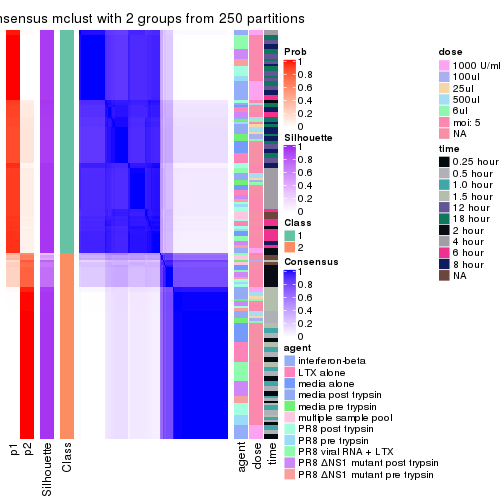
consensus_heatmap(res, k = 3)
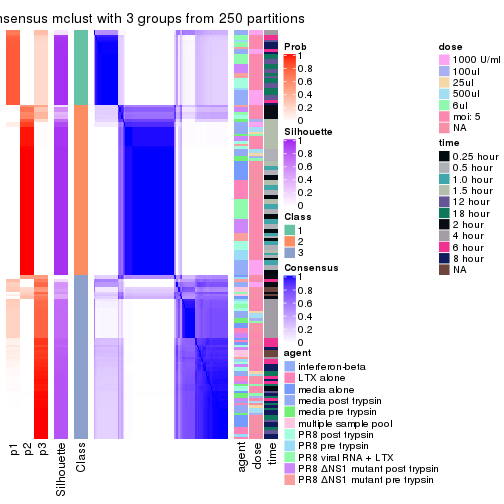
consensus_heatmap(res, k = 4)
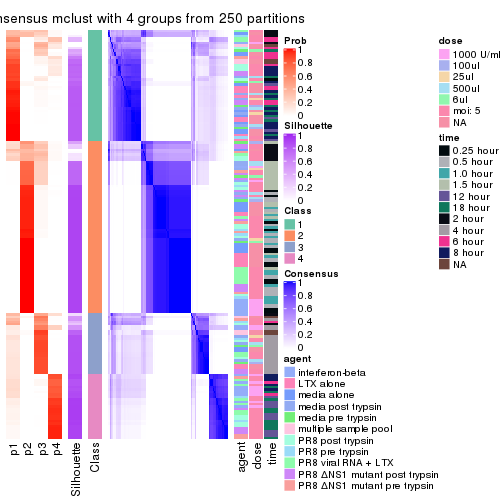
consensus_heatmap(res, k = 5)
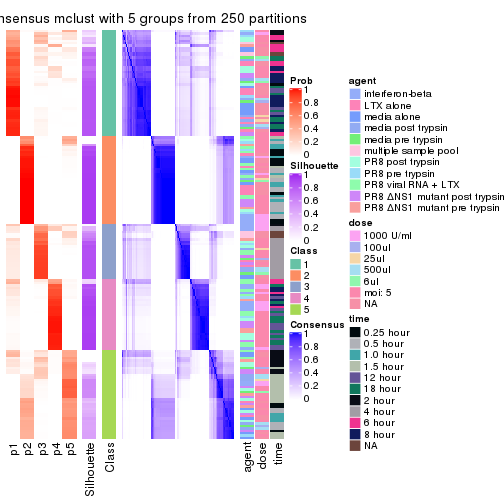
consensus_heatmap(res, k = 6)
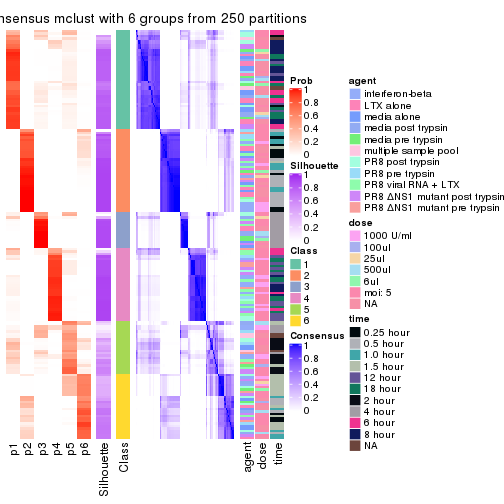
Heatmaps for the membership of samples in all partitions to see how consistent they are:
membership_heatmap(res, k = 2)
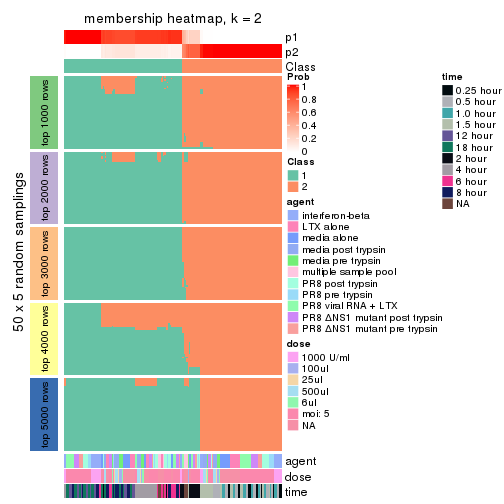
membership_heatmap(res, k = 3)
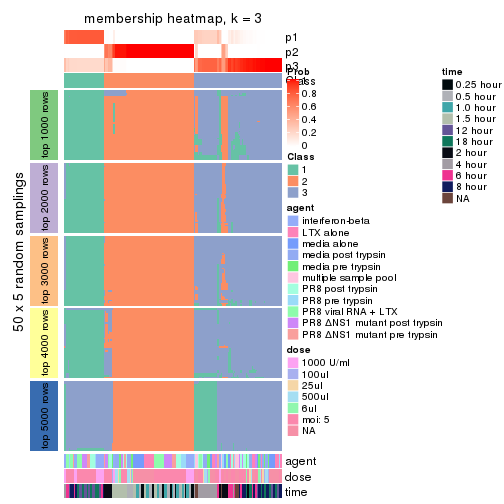
membership_heatmap(res, k = 4)
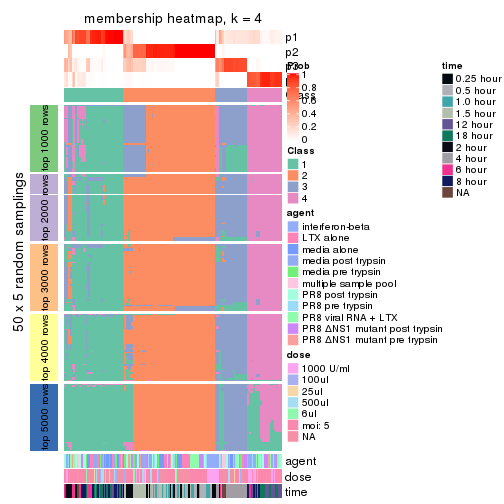
membership_heatmap(res, k = 5)
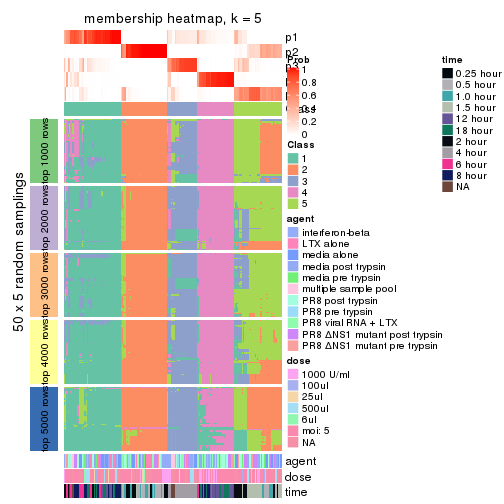
membership_heatmap(res, k = 6)
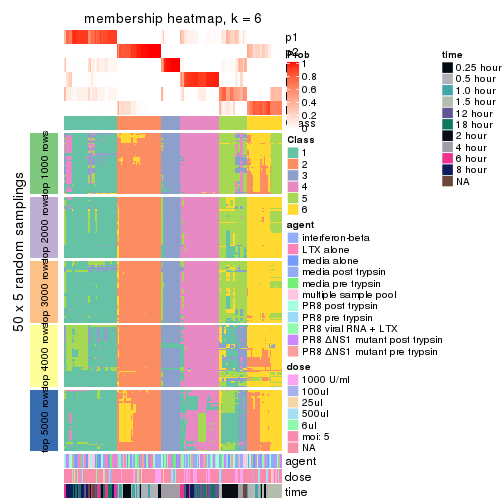
As soon as we have had the classes for columns, we can look for signatures which are significantly different between classes which can be candidate marks for certain classes. Following are the heatmaps for signatures.
Signature heatmaps where rows are scaled:
get_signatures(res, k = 2)
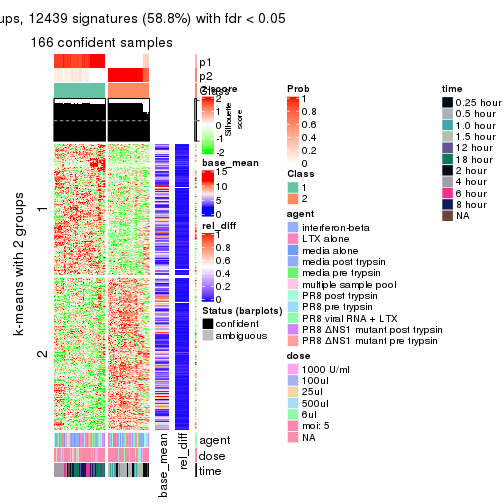
get_signatures(res, k = 3)
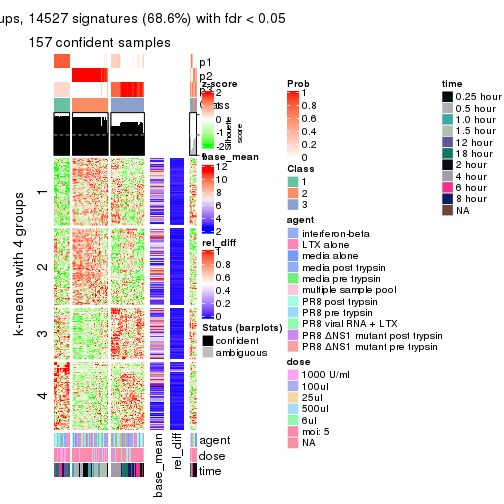
get_signatures(res, k = 4)
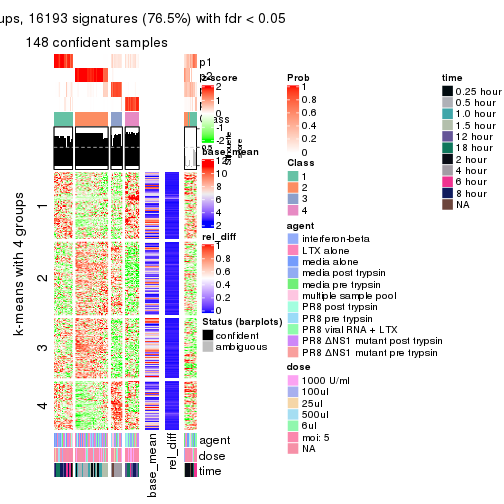
get_signatures(res, k = 5)
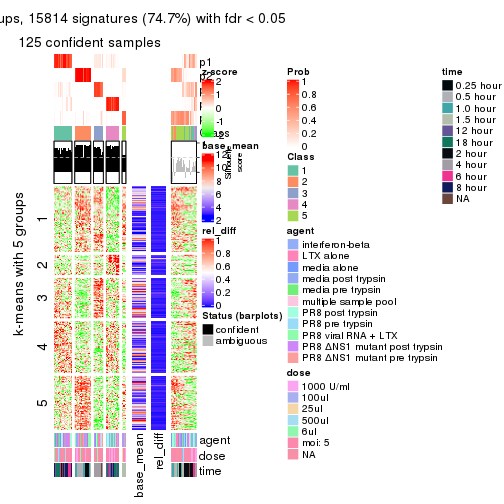
get_signatures(res, k = 6)
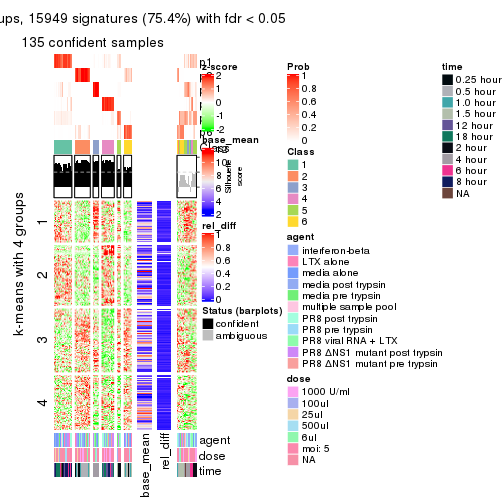
Signature heatmaps where rows are not scaled:
get_signatures(res, k = 2, scale_rows = FALSE)
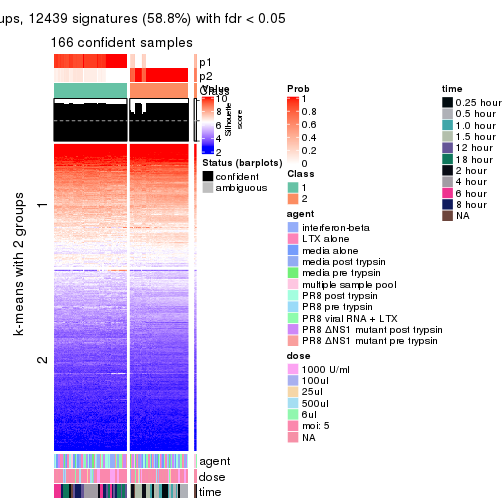
get_signatures(res, k = 3, scale_rows = FALSE)
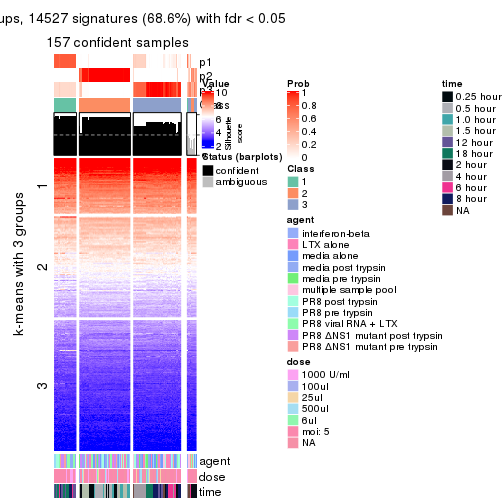
get_signatures(res, k = 4, scale_rows = FALSE)
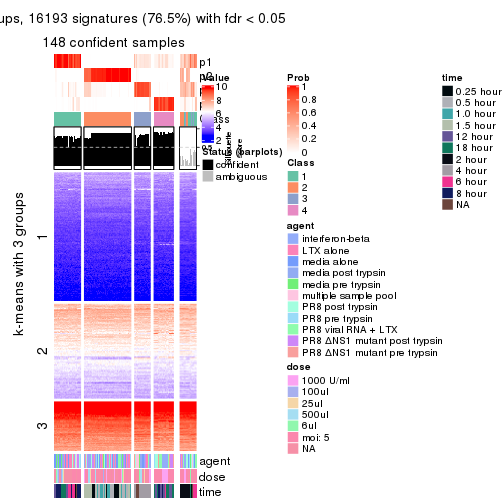
get_signatures(res, k = 5, scale_rows = FALSE)
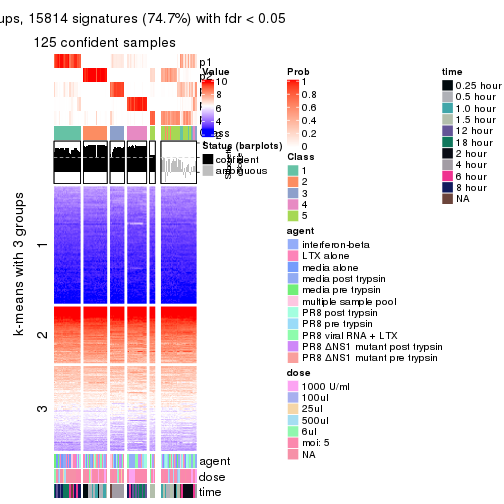
get_signatures(res, k = 6, scale_rows = FALSE)
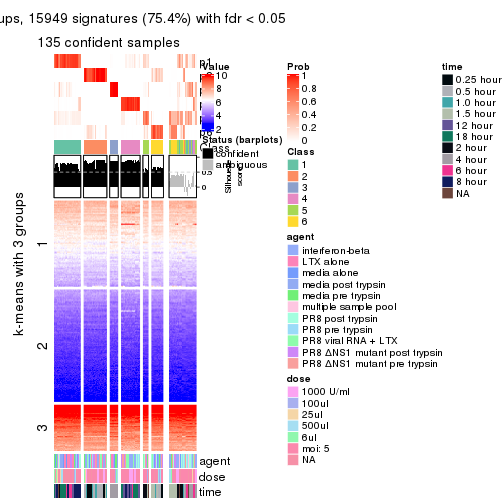
Compare the overlap of signatures from different k:
compare_signatures(res)
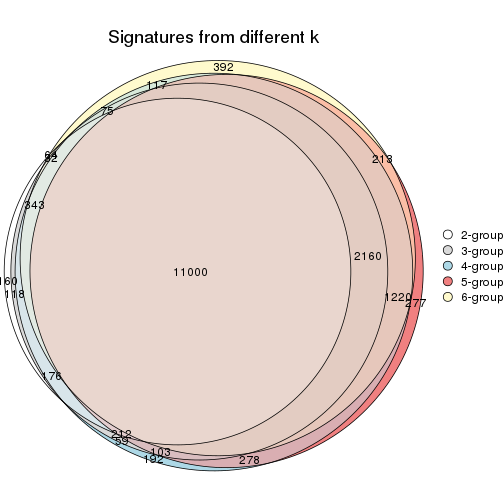
get_signature() returns a data frame invisibly. TO get the list of signatures, the function
call should be assigned to a variable explicitly. In following code, if plot argument is set
to FALSE, no heatmap is plotted while only the differential analysis is performed.
# code only for demonstration
tb = get_signature(res, k = ..., plot = FALSE)
An example of the output of tb is:
#> which_row fdr mean_1 mean_2 scaled_mean_1 scaled_mean_2 km
#> 1 38 0.042760348 8.373488 9.131774 -0.5533452 0.5164555 1
#> 2 40 0.018707592 7.106213 8.469186 -0.6173731 0.5762149 1
#> 3 55 0.019134737 10.221463 11.207825 -0.6159697 0.5749050 1
#> 4 59 0.006059896 5.921854 7.869574 -0.6899429 0.6439467 1
#> 5 60 0.018055526 8.928898 10.211722 -0.6204761 0.5791110 1
#> 6 98 0.009384629 15.714769 14.887706 0.6635654 -0.6193277 2
...
The columns in tb are:
which_row: row indices corresponding to the input matrix.fdr: FDR for the differential test. mean_x: The mean value in group x.scaled_mean_x: The mean value in group x after rows are scaled.km: Row groups if k-means clustering is applied to rows.UMAP plot which shows how samples are separated.
dimension_reduction(res, k = 2, method = "UMAP")
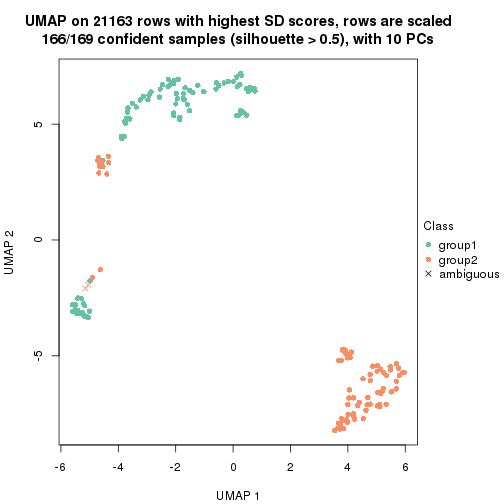
dimension_reduction(res, k = 3, method = "UMAP")
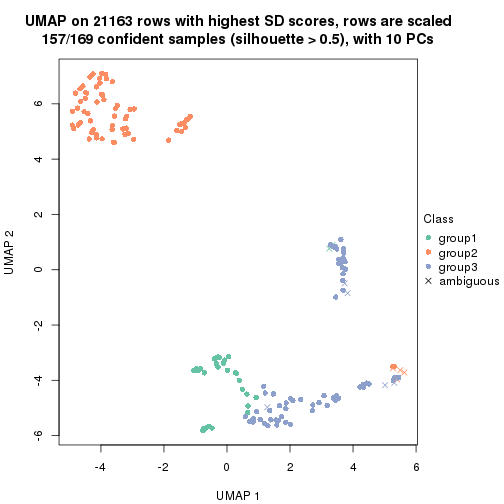
dimension_reduction(res, k = 4, method = "UMAP")
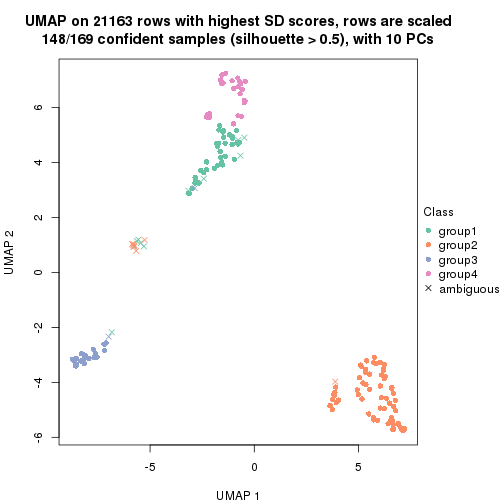
dimension_reduction(res, k = 5, method = "UMAP")
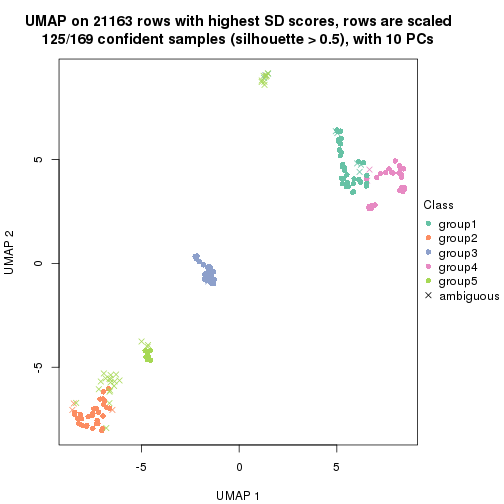
dimension_reduction(res, k = 6, method = "UMAP")
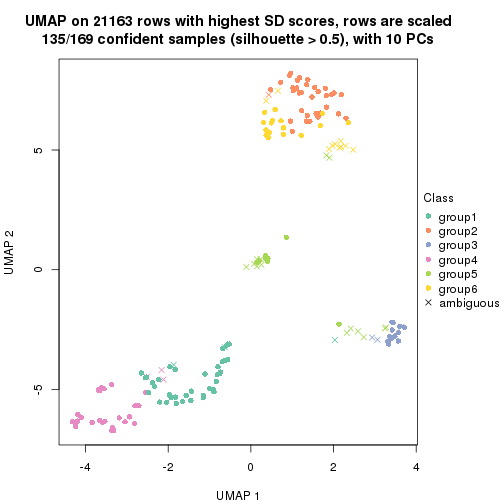
Following heatmap shows how subgroups are split when increasing k:
collect_classes(res)
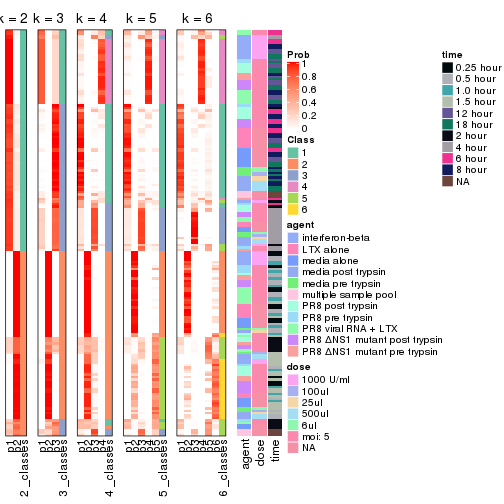
Test correlation between subgroups and known annotations. If the known annotation is numeric, one-way ANOVA test is applied, and if the known annotation is discrete, chi-squared contingency table test is applied.
test_to_known_factors(res)
#> n agent(p) dose(p) time(p) k
#> SD:mclust 166 0.996738 0.997146 4.95e-27 2
#> SD:mclust 157 0.000834 0.000385 2.54e-29 3
#> SD:mclust 148 0.008301 0.002895 8.30e-49 4
#> SD:mclust 125 0.002360 0.000322 9.63e-53 5
#> SD:mclust 135 0.006786 0.000571 2.65e-57 6
If matrix rows can be associated to genes, consider to use functional_enrichment(res,
...) to perform function enrichment for the signature genes. See this vignette for more detailed explanations.
The object with results only for a single top-value method and a single partition method can be extracted as:
res = res_list["SD", "NMF"]
# you can also extract it by
# res = res_list["SD:NMF"]
A summary of res and all the functions that can be applied to it:
res
#> A 'ConsensusPartition' object with k = 2, 3, 4, 5, 6.
#> On a matrix with 21163 rows and 169 columns.
#> Top rows (1000, 2000, 3000, 4000, 5000) are extracted by 'SD' method.
#> Subgroups are detected by 'NMF' method.
#> Performed in total 1250 partitions by row resampling.
#> Best k for subgroups seems to be 2.
#>
#> Following methods can be applied to this 'ConsensusPartition' object:
#> [1] "cola_report" "collect_classes" "collect_plots"
#> [4] "collect_stats" "colnames" "compare_signatures"
#> [7] "consensus_heatmap" "dimension_reduction" "functional_enrichment"
#> [10] "get_anno_col" "get_anno" "get_classes"
#> [13] "get_consensus" "get_matrix" "get_membership"
#> [16] "get_param" "get_signatures" "get_stats"
#> [19] "is_best_k" "is_stable_k" "membership_heatmap"
#> [22] "ncol" "nrow" "plot_ecdf"
#> [25] "rownames" "select_partition_number" "show"
#> [28] "suggest_best_k" "test_to_known_factors"
collect_plots() function collects all the plots made from res for all k (number of partitions)
into one single page to provide an easy and fast comparison between different k.
collect_plots(res)
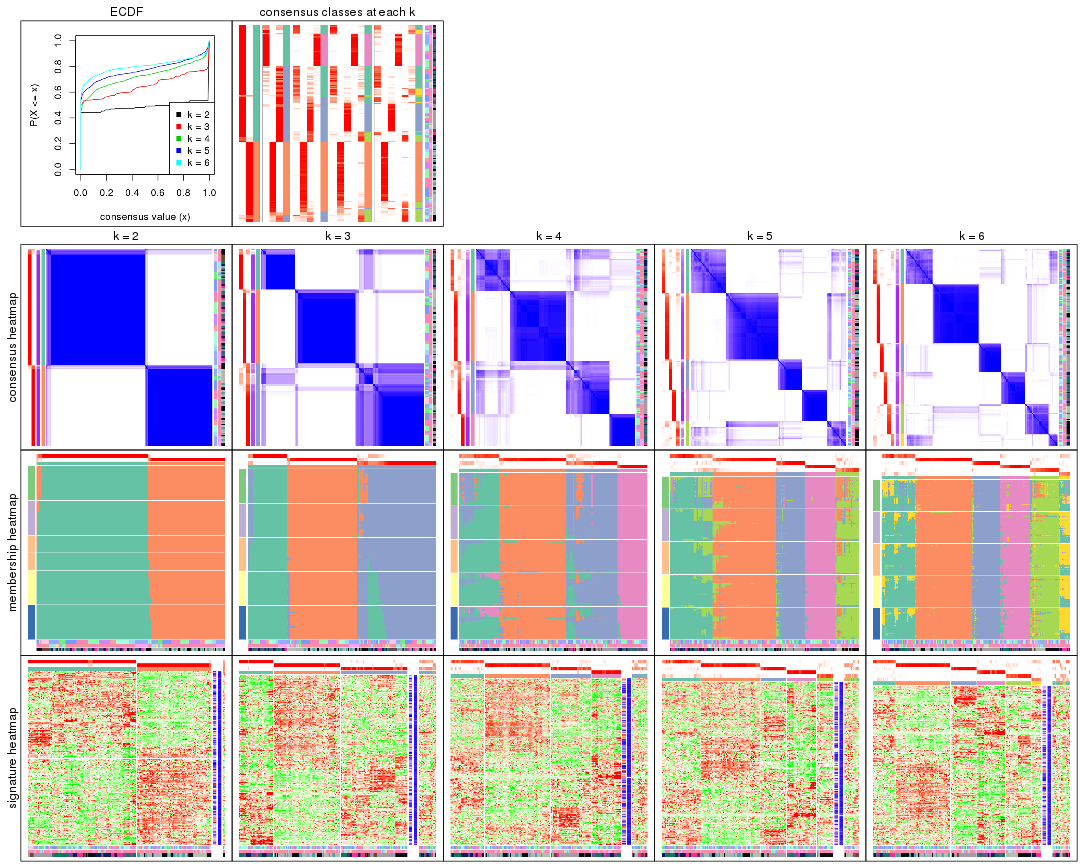
The plots are:
k and the heatmap of
predicted classes for each k.k.k.k.All the plots in panels can be made by individual functions and they are plotted later in this section.
select_partition_number() produces several plots showing different
statistics for choosing “optimized” k. There are following statistics:
k;k, the area increased is defined as \(A_k - A_{k-1}\).The detailed explanations of these statistics can be found in the cola vignette.
Generally speaking, lower PAC score, higher mean silhouette score or higher
concordance corresponds to better partition. Rand index and Jaccard index
measure how similar the current partition is compared to partition with k-1.
If they are too similar, we won't accept k is better than k-1.
select_partition_number(res)
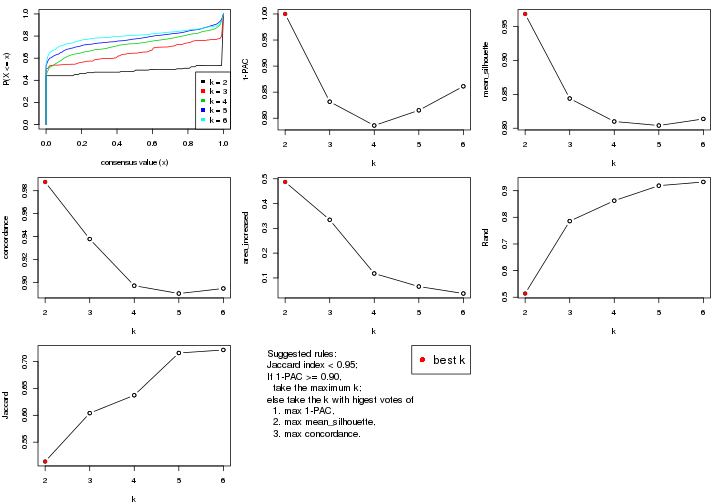
The numeric values for all these statistics can be obtained by get_stats().
get_stats(res)
#> k 1-PAC mean_silhouette concordance area_increased Rand Jaccard
#> 2 2 1.000 0.969 0.988 0.4871 0.514 0.514
#> 3 3 0.832 0.844 0.938 0.3345 0.786 0.604
#> 4 4 0.786 0.810 0.897 0.1178 0.862 0.637
#> 5 5 0.815 0.804 0.890 0.0653 0.919 0.716
#> 6 6 0.861 0.814 0.895 0.0371 0.933 0.722
suggest_best_k() suggests the best \(k\) based on these statistics. The rules are as follows:
suggest_best_k(res)
#> [1] 2
Following shows the table of the partitions (You need to click the show/hide
code output link to see it). The membership matrix (columns with name p*)
is inferred by
clue::cl_consensus()
function with the SE method. Basically the value in the membership matrix
represents the probability to belong to a certain group. The finall class
label for an item is determined with the group with highest probability it
belongs to.
In get_classes() function, the entropy is calculated from the membership
matrix and the silhouette score is calculated from the consensus matrix.
cbind(get_classes(res, k = 2), get_membership(res, k = 2))
#> class entropy silhouette p1 p2
#> GSM528681 2 0.000 0.9879 0.000 1.000
#> GSM528682 2 0.000 0.9879 0.000 1.000
#> GSM528683 2 0.000 0.9879 0.000 1.000
#> GSM528684 2 0.000 0.9879 0.000 1.000
#> GSM528687 2 0.000 0.9879 0.000 1.000
#> GSM528688 2 0.000 0.9879 0.000 1.000
#> GSM528685 2 0.000 0.9879 0.000 1.000
#> GSM528686 2 0.000 0.9879 0.000 1.000
#> GSM528693 1 0.000 0.9867 1.000 0.000
#> GSM528694 1 0.000 0.9867 1.000 0.000
#> GSM528695 1 0.000 0.9867 1.000 0.000
#> GSM528696 1 0.000 0.9867 1.000 0.000
#> GSM528697 1 0.000 0.9867 1.000 0.000
#> GSM528698 1 0.000 0.9867 1.000 0.000
#> GSM528699 1 0.000 0.9867 1.000 0.000
#> GSM528700 1 0.000 0.9867 1.000 0.000
#> GSM528689 1 0.000 0.9867 1.000 0.000
#> GSM528690 1 0.000 0.9867 1.000 0.000
#> GSM528691 1 0.000 0.9867 1.000 0.000
#> GSM528692 1 0.000 0.9867 1.000 0.000
#> GSM528779 2 0.000 0.9879 0.000 1.000
#> GSM528780 2 0.000 0.9879 0.000 1.000
#> GSM528782 2 0.000 0.9879 0.000 1.000
#> GSM528781 2 0.000 0.9879 0.000 1.000
#> GSM528785 2 0.775 0.7000 0.228 0.772
#> GSM528786 1 0.000 0.9867 1.000 0.000
#> GSM528787 1 0.000 0.9867 1.000 0.000
#> GSM528788 1 0.000 0.9867 1.000 0.000
#> GSM528783 1 0.000 0.9867 1.000 0.000
#> GSM528784 1 0.000 0.9867 1.000 0.000
#> GSM528759 1 0.000 0.9867 1.000 0.000
#> GSM528760 1 0.000 0.9867 1.000 0.000
#> GSM528761 2 0.000 0.9879 0.000 1.000
#> GSM528762 2 0.000 0.9879 0.000 1.000
#> GSM528765 2 0.000 0.9879 0.000 1.000
#> GSM528766 2 0.000 0.9879 0.000 1.000
#> GSM528763 2 0.000 0.9879 0.000 1.000
#> GSM528764 2 0.000 0.9879 0.000 1.000
#> GSM528771 2 0.625 0.8091 0.156 0.844
#> GSM528772 2 0.981 0.2648 0.420 0.580
#> GSM528773 1 0.000 0.9867 1.000 0.000
#> GSM528774 1 0.000 0.9867 1.000 0.000
#> GSM528775 1 0.000 0.9867 1.000 0.000
#> GSM528776 1 0.000 0.9867 1.000 0.000
#> GSM528777 1 0.000 0.9867 1.000 0.000
#> GSM528778 1 0.000 0.9867 1.000 0.000
#> GSM528767 1 0.000 0.9867 1.000 0.000
#> GSM528768 1 0.000 0.9867 1.000 0.000
#> GSM528769 1 0.000 0.9867 1.000 0.000
#> GSM528770 1 0.000 0.9867 1.000 0.000
#> GSM528671 2 0.000 0.9879 0.000 1.000
#> GSM528672 2 0.000 0.9879 0.000 1.000
#> GSM528674 2 0.000 0.9879 0.000 1.000
#> GSM528673 2 0.000 0.9879 0.000 1.000
#> GSM528677 1 0.697 0.7673 0.812 0.188
#> GSM528678 1 0.000 0.9867 1.000 0.000
#> GSM528679 1 0.000 0.9867 1.000 0.000
#> GSM528680 1 0.000 0.9867 1.000 0.000
#> GSM528675 1 0.000 0.9867 1.000 0.000
#> GSM528676 1 0.000 0.9867 1.000 0.000
#> GSM528651 2 0.000 0.9879 0.000 1.000
#> GSM528652 2 0.000 0.9879 0.000 1.000
#> GSM528653 2 0.000 0.9879 0.000 1.000
#> GSM528654 2 0.000 0.9879 0.000 1.000
#> GSM528657 2 0.000 0.9879 0.000 1.000
#> GSM528658 2 0.000 0.9879 0.000 1.000
#> GSM528655 2 0.000 0.9879 0.000 1.000
#> GSM528656 2 0.000 0.9879 0.000 1.000
#> GSM528663 2 0.000 0.9879 0.000 1.000
#> GSM528664 2 0.000 0.9879 0.000 1.000
#> GSM528665 1 0.000 0.9867 1.000 0.000
#> GSM528666 1 0.000 0.9867 1.000 0.000
#> GSM528667 1 0.000 0.9867 1.000 0.000
#> GSM528668 1 0.000 0.9867 1.000 0.000
#> GSM528669 1 0.000 0.9867 1.000 0.000
#> GSM528670 1 0.000 0.9867 1.000 0.000
#> GSM528659 1 0.000 0.9867 1.000 0.000
#> GSM528660 1 0.000 0.9867 1.000 0.000
#> GSM528661 1 0.000 0.9867 1.000 0.000
#> GSM528662 1 0.000 0.9867 1.000 0.000
#> GSM528701 2 0.000 0.9879 0.000 1.000
#> GSM528702 2 0.000 0.9879 0.000 1.000
#> GSM528703 2 0.000 0.9879 0.000 1.000
#> GSM528704 2 0.000 0.9879 0.000 1.000
#> GSM528707 2 0.000 0.9879 0.000 1.000
#> GSM528708 2 0.000 0.9879 0.000 1.000
#> GSM528705 2 0.000 0.9879 0.000 1.000
#> GSM528706 2 0.000 0.9879 0.000 1.000
#> GSM528713 1 0.697 0.7673 0.812 0.188
#> GSM528714 1 0.625 0.8117 0.844 0.156
#> GSM528715 1 0.000 0.9867 1.000 0.000
#> GSM528716 1 0.000 0.9867 1.000 0.000
#> GSM528717 1 0.000 0.9867 1.000 0.000
#> GSM528718 1 0.000 0.9867 1.000 0.000
#> GSM528719 1 0.000 0.9867 1.000 0.000
#> GSM528720 1 0.000 0.9867 1.000 0.000
#> GSM528709 1 0.000 0.9867 1.000 0.000
#> GSM528710 1 0.000 0.9867 1.000 0.000
#> GSM528711 1 0.000 0.9867 1.000 0.000
#> GSM528712 1 0.000 0.9867 1.000 0.000
#> GSM528721 2 0.000 0.9879 0.000 1.000
#> GSM528722 2 0.000 0.9879 0.000 1.000
#> GSM528723 2 0.000 0.9879 0.000 1.000
#> GSM528724 2 0.000 0.9879 0.000 1.000
#> GSM528727 2 0.000 0.9879 0.000 1.000
#> GSM528728 2 0.000 0.9879 0.000 1.000
#> GSM528725 2 0.000 0.9879 0.000 1.000
#> GSM528726 2 0.000 0.9879 0.000 1.000
#> GSM528733 1 0.000 0.9867 1.000 0.000
#> GSM528734 1 0.000 0.9867 1.000 0.000
#> GSM528735 1 0.000 0.9867 1.000 0.000
#> GSM528736 1 0.000 0.9867 1.000 0.000
#> GSM528737 1 0.000 0.9867 1.000 0.000
#> GSM528738 1 0.000 0.9867 1.000 0.000
#> GSM528729 1 0.000 0.9867 1.000 0.000
#> GSM528730 1 0.000 0.9867 1.000 0.000
#> GSM528731 1 0.000 0.9867 1.000 0.000
#> GSM528732 1 0.000 0.9867 1.000 0.000
#> GSM528739 2 0.000 0.9879 0.000 1.000
#> GSM528740 2 0.000 0.9879 0.000 1.000
#> GSM528741 2 0.000 0.9879 0.000 1.000
#> GSM528742 2 0.000 0.9879 0.000 1.000
#> GSM528745 2 0.000 0.9879 0.000 1.000
#> GSM528746 2 0.000 0.9879 0.000 1.000
#> GSM528743 2 0.000 0.9879 0.000 1.000
#> GSM528744 2 0.000 0.9879 0.000 1.000
#> GSM528751 1 1.000 0.0128 0.504 0.496
#> GSM528752 1 0.833 0.6426 0.736 0.264
#> GSM528753 1 0.000 0.9867 1.000 0.000
#> GSM528754 1 0.000 0.9867 1.000 0.000
#> GSM528755 1 0.000 0.9867 1.000 0.000
#> GSM528756 1 0.000 0.9867 1.000 0.000
#> GSM528757 1 0.000 0.9867 1.000 0.000
#> GSM528758 1 0.000 0.9867 1.000 0.000
#> GSM528747 1 0.000 0.9867 1.000 0.000
#> GSM528748 1 0.000 0.9867 1.000 0.000
#> GSM528749 1 0.000 0.9867 1.000 0.000
#> GSM528750 1 0.000 0.9867 1.000 0.000
#> GSM528640 2 0.000 0.9879 0.000 1.000
#> GSM528641 2 0.000 0.9879 0.000 1.000
#> GSM528643 1 0.000 0.9867 1.000 0.000
#> GSM528644 1 0.000 0.9867 1.000 0.000
#> GSM528642 1 0.000 0.9867 1.000 0.000
#> GSM528620 2 0.000 0.9879 0.000 1.000
#> GSM528621 2 0.000 0.9879 0.000 1.000
#> GSM528623 1 0.000 0.9867 1.000 0.000
#> GSM528624 1 0.000 0.9867 1.000 0.000
#> GSM528622 1 0.000 0.9867 1.000 0.000
#> GSM528625 2 0.000 0.9879 0.000 1.000
#> GSM528626 2 0.000 0.9879 0.000 1.000
#> GSM528628 1 0.000 0.9867 1.000 0.000
#> GSM528629 1 0.000 0.9867 1.000 0.000
#> GSM528627 1 0.000 0.9867 1.000 0.000
#> GSM528630 2 0.000 0.9879 0.000 1.000
#> GSM528631 2 0.000 0.9879 0.000 1.000
#> GSM528632 2 0.000 0.9879 0.000 1.000
#> GSM528633 2 0.000 0.9879 0.000 1.000
#> GSM528636 1 0.000 0.9867 1.000 0.000
#> GSM528637 1 0.000 0.9867 1.000 0.000
#> GSM528638 1 0.000 0.9867 1.000 0.000
#> GSM528639 1 0.000 0.9867 1.000 0.000
#> GSM528634 1 0.000 0.9867 1.000 0.000
#> GSM528635 1 0.000 0.9867 1.000 0.000
#> GSM528645 1 0.000 0.9867 1.000 0.000
#> GSM528646 1 0.000 0.9867 1.000 0.000
#> GSM528647 1 0.000 0.9867 1.000 0.000
#> GSM528648 1 0.000 0.9867 1.000 0.000
#> GSM528649 1 0.000 0.9867 1.000 0.000
#> GSM528650 1 0.000 0.9867 1.000 0.000
cbind(get_classes(res, k = 3), get_membership(res, k = 3))
#> class entropy silhouette p1 p2 p3
#> GSM528681 2 0.0000 0.9788 0.000 1.000 0.000
#> GSM528682 2 0.0000 0.9788 0.000 1.000 0.000
#> GSM528683 2 0.0000 0.9788 0.000 1.000 0.000
#> GSM528684 2 0.0000 0.9788 0.000 1.000 0.000
#> GSM528687 2 0.0000 0.9788 0.000 1.000 0.000
#> GSM528688 2 0.0000 0.9788 0.000 1.000 0.000
#> GSM528685 2 0.0000 0.9788 0.000 1.000 0.000
#> GSM528686 2 0.0892 0.9613 0.000 0.980 0.020
#> GSM528693 3 0.0000 0.8755 0.000 0.000 1.000
#> GSM528694 3 0.0000 0.8755 0.000 0.000 1.000
#> GSM528695 3 0.4842 0.6628 0.224 0.000 0.776
#> GSM528696 3 0.4750 0.6738 0.216 0.000 0.784
#> GSM528697 1 0.0000 0.9296 1.000 0.000 0.000
#> GSM528698 1 0.0000 0.9296 1.000 0.000 0.000
#> GSM528699 1 0.0000 0.9296 1.000 0.000 0.000
#> GSM528700 1 0.0000 0.9296 1.000 0.000 0.000
#> GSM528689 1 0.0000 0.9296 1.000 0.000 0.000
#> GSM528690 1 0.0000 0.9296 1.000 0.000 0.000
#> GSM528691 1 0.0000 0.9296 1.000 0.000 0.000
#> GSM528692 1 0.0000 0.9296 1.000 0.000 0.000
#> GSM528779 2 0.0000 0.9788 0.000 1.000 0.000
#> GSM528780 2 0.0000 0.9788 0.000 1.000 0.000
#> GSM528782 2 0.0000 0.9788 0.000 1.000 0.000
#> GSM528781 2 0.0000 0.9788 0.000 1.000 0.000
#> GSM528785 3 0.6225 0.2273 0.000 0.432 0.568
#> GSM528786 3 0.0000 0.8755 0.000 0.000 1.000
#> GSM528787 3 0.0000 0.8755 0.000 0.000 1.000
#> GSM528788 1 0.6168 0.2638 0.588 0.000 0.412
#> GSM528783 1 0.0000 0.9296 1.000 0.000 0.000
#> GSM528784 1 0.0000 0.9296 1.000 0.000 0.000
#> GSM528759 3 0.0000 0.8755 0.000 0.000 1.000
#> GSM528760 3 0.0000 0.8755 0.000 0.000 1.000
#> GSM528761 2 0.0000 0.9788 0.000 1.000 0.000
#> GSM528762 2 0.0000 0.9788 0.000 1.000 0.000
#> GSM528765 2 0.0000 0.9788 0.000 1.000 0.000
#> GSM528766 2 0.0000 0.9788 0.000 1.000 0.000
#> GSM528763 2 0.0000 0.9788 0.000 1.000 0.000
#> GSM528764 2 0.0892 0.9612 0.000 0.980 0.020
#> GSM528771 3 0.5327 0.5997 0.000 0.272 0.728
#> GSM528772 3 0.4062 0.7317 0.000 0.164 0.836
#> GSM528773 3 0.0000 0.8755 0.000 0.000 1.000
#> GSM528774 3 0.0000 0.8755 0.000 0.000 1.000
#> GSM528775 3 0.0000 0.8755 0.000 0.000 1.000
#> GSM528776 3 0.5529 0.5628 0.296 0.000 0.704
#> GSM528777 1 0.0000 0.9296 1.000 0.000 0.000
#> GSM528778 1 0.0000 0.9296 1.000 0.000 0.000
#> GSM528767 1 0.0000 0.9296 1.000 0.000 0.000
#> GSM528768 1 0.0000 0.9296 1.000 0.000 0.000
#> GSM528769 1 0.0000 0.9296 1.000 0.000 0.000
#> GSM528770 1 0.0000 0.9296 1.000 0.000 0.000
#> GSM528671 2 0.0000 0.9788 0.000 1.000 0.000
#> GSM528672 2 0.0000 0.9788 0.000 1.000 0.000
#> GSM528674 2 0.0000 0.9788 0.000 1.000 0.000
#> GSM528673 2 0.0747 0.9650 0.000 0.984 0.016
#> GSM528677 3 0.0000 0.8755 0.000 0.000 1.000
#> GSM528678 3 0.0000 0.8755 0.000 0.000 1.000
#> GSM528679 3 0.6111 0.3596 0.396 0.000 0.604
#> GSM528680 1 0.0000 0.9296 1.000 0.000 0.000
#> GSM528675 1 0.0000 0.9296 1.000 0.000 0.000
#> GSM528676 1 0.0000 0.9296 1.000 0.000 0.000
#> GSM528651 2 0.0000 0.9788 0.000 1.000 0.000
#> GSM528652 2 0.0000 0.9788 0.000 1.000 0.000
#> GSM528653 2 0.0000 0.9788 0.000 1.000 0.000
#> GSM528654 2 0.0000 0.9788 0.000 1.000 0.000
#> GSM528657 2 0.0000 0.9788 0.000 1.000 0.000
#> GSM528658 2 0.0000 0.9788 0.000 1.000 0.000
#> GSM528655 2 0.0000 0.9788 0.000 1.000 0.000
#> GSM528656 2 0.0747 0.9650 0.000 0.984 0.016
#> GSM528663 3 0.4399 0.7058 0.000 0.188 0.812
#> GSM528664 3 0.5397 0.5851 0.000 0.280 0.720
#> GSM528665 3 0.0000 0.8755 0.000 0.000 1.000
#> GSM528666 3 0.0000 0.8755 0.000 0.000 1.000
#> GSM528667 3 0.4842 0.6732 0.224 0.000 0.776
#> GSM528668 3 0.4605 0.6993 0.204 0.000 0.796
#> GSM528669 1 0.0000 0.9296 1.000 0.000 0.000
#> GSM528670 1 0.5621 0.5142 0.692 0.000 0.308
#> GSM528659 1 0.0000 0.9296 1.000 0.000 0.000
#> GSM528660 1 0.0000 0.9296 1.000 0.000 0.000
#> GSM528661 1 0.0000 0.9296 1.000 0.000 0.000
#> GSM528662 1 0.0000 0.9296 1.000 0.000 0.000
#> GSM528701 2 0.0000 0.9788 0.000 1.000 0.000
#> GSM528702 2 0.0000 0.9788 0.000 1.000 0.000
#> GSM528703 2 0.0000 0.9788 0.000 1.000 0.000
#> GSM528704 2 0.0000 0.9788 0.000 1.000 0.000
#> GSM528707 2 0.0000 0.9788 0.000 1.000 0.000
#> GSM528708 2 0.0000 0.9788 0.000 1.000 0.000
#> GSM528705 2 0.0000 0.9788 0.000 1.000 0.000
#> GSM528706 2 0.0000 0.9788 0.000 1.000 0.000
#> GSM528713 3 0.0000 0.8755 0.000 0.000 1.000
#> GSM528714 3 0.0000 0.8755 0.000 0.000 1.000
#> GSM528715 3 0.0000 0.8755 0.000 0.000 1.000
#> GSM528716 3 0.0000 0.8755 0.000 0.000 1.000
#> GSM528717 1 0.6286 0.0370 0.536 0.000 0.464
#> GSM528718 3 0.0892 0.8662 0.020 0.000 0.980
#> GSM528719 1 0.0000 0.9296 1.000 0.000 0.000
#> GSM528720 1 0.0000 0.9296 1.000 0.000 0.000
#> GSM528709 1 0.0000 0.9296 1.000 0.000 0.000
#> GSM528710 1 0.0000 0.9296 1.000 0.000 0.000
#> GSM528711 1 0.0000 0.9296 1.000 0.000 0.000
#> GSM528712 1 0.0000 0.9296 1.000 0.000 0.000
#> GSM528721 2 0.0000 0.9788 0.000 1.000 0.000
#> GSM528722 2 0.0000 0.9788 0.000 1.000 0.000
#> GSM528723 2 0.0000 0.9788 0.000 1.000 0.000
#> GSM528724 2 0.0000 0.9788 0.000 1.000 0.000
#> GSM528727 2 0.0000 0.9788 0.000 1.000 0.000
#> GSM528728 2 0.0000 0.9788 0.000 1.000 0.000
#> GSM528725 2 0.0000 0.9788 0.000 1.000 0.000
#> GSM528726 2 0.0000 0.9788 0.000 1.000 0.000
#> GSM528733 3 0.0000 0.8755 0.000 0.000 1.000
#> GSM528734 3 0.0000 0.8755 0.000 0.000 1.000
#> GSM528735 3 0.0000 0.8755 0.000 0.000 1.000
#> GSM528736 3 0.0000 0.8755 0.000 0.000 1.000
#> GSM528737 3 0.4346 0.7234 0.184 0.000 0.816
#> GSM528738 3 0.0000 0.8755 0.000 0.000 1.000
#> GSM528729 1 0.6204 0.2273 0.576 0.000 0.424
#> GSM528730 3 0.6192 0.2951 0.420 0.000 0.580
#> GSM528731 3 0.6302 0.0965 0.480 0.000 0.520
#> GSM528732 3 0.2537 0.8229 0.080 0.000 0.920
#> GSM528739 2 0.0000 0.9788 0.000 1.000 0.000
#> GSM528740 2 0.0000 0.9788 0.000 1.000 0.000
#> GSM528741 2 0.0000 0.9788 0.000 1.000 0.000
#> GSM528742 2 0.0000 0.9788 0.000 1.000 0.000
#> GSM528745 2 0.0000 0.9788 0.000 1.000 0.000
#> GSM528746 2 0.0000 0.9788 0.000 1.000 0.000
#> GSM528743 2 0.0000 0.9788 0.000 1.000 0.000
#> GSM528744 2 0.0000 0.9788 0.000 1.000 0.000
#> GSM528751 3 0.4178 0.7234 0.000 0.172 0.828
#> GSM528752 3 0.2796 0.8022 0.000 0.092 0.908
#> GSM528753 3 0.0000 0.8755 0.000 0.000 1.000
#> GSM528754 3 0.0000 0.8755 0.000 0.000 1.000
#> GSM528755 3 0.0000 0.8755 0.000 0.000 1.000
#> GSM528756 3 0.0000 0.8755 0.000 0.000 1.000
#> GSM528757 1 0.6793 0.1157 0.536 0.012 0.452
#> GSM528758 3 0.6126 0.3497 0.400 0.000 0.600
#> GSM528747 3 0.6111 0.3596 0.396 0.000 0.604
#> GSM528748 3 0.0000 0.8755 0.000 0.000 1.000
#> GSM528749 3 0.0000 0.8755 0.000 0.000 1.000
#> GSM528750 3 0.6126 0.3497 0.400 0.000 0.600
#> GSM528640 2 0.0000 0.9788 0.000 1.000 0.000
#> GSM528641 2 0.0892 0.9612 0.000 0.980 0.020
#> GSM528643 3 0.0000 0.8755 0.000 0.000 1.000
#> GSM528644 3 0.0000 0.8755 0.000 0.000 1.000
#> GSM528642 3 0.0000 0.8755 0.000 0.000 1.000
#> GSM528620 2 0.0000 0.9788 0.000 1.000 0.000
#> GSM528621 3 0.5327 0.6000 0.000 0.272 0.728
#> GSM528623 3 0.0000 0.8755 0.000 0.000 1.000
#> GSM528624 3 0.6126 0.3497 0.400 0.000 0.600
#> GSM528622 3 0.6045 0.3970 0.380 0.000 0.620
#> GSM528625 2 0.0000 0.9788 0.000 1.000 0.000
#> GSM528626 2 0.5327 0.6213 0.000 0.728 0.272
#> GSM528628 3 0.0000 0.8755 0.000 0.000 1.000
#> GSM528629 3 0.1411 0.8550 0.036 0.000 0.964
#> GSM528627 3 0.0237 0.8735 0.004 0.000 0.996
#> GSM528630 2 0.0000 0.9788 0.000 1.000 0.000
#> GSM528631 2 0.0000 0.9788 0.000 1.000 0.000
#> GSM528632 2 0.6180 0.3001 0.000 0.584 0.416
#> GSM528633 2 0.6111 0.3539 0.000 0.604 0.396
#> GSM528636 3 0.0000 0.8755 0.000 0.000 1.000
#> GSM528637 3 0.0000 0.8755 0.000 0.000 1.000
#> GSM528638 3 0.6140 0.3392 0.404 0.000 0.596
#> GSM528639 3 0.4235 0.7323 0.176 0.000 0.824
#> GSM528634 3 0.0000 0.8755 0.000 0.000 1.000
#> GSM528635 3 0.1529 0.8523 0.040 0.000 0.960
#> GSM528645 3 0.0000 0.8755 0.000 0.000 1.000
#> GSM528646 3 0.0000 0.8755 0.000 0.000 1.000
#> GSM528647 3 0.0000 0.8755 0.000 0.000 1.000
#> GSM528648 3 0.0000 0.8755 0.000 0.000 1.000
#> GSM528649 3 0.0000 0.8755 0.000 0.000 1.000
#> GSM528650 3 0.0000 0.8755 0.000 0.000 1.000
cbind(get_classes(res, k = 4), get_membership(res, k = 4))
#> class entropy silhouette p1 p2 p3 p4
#> GSM528681 2 0.0469 0.9701 0.012 0.988 0.000 0.000
#> GSM528682 2 0.0469 0.9701 0.012 0.988 0.000 0.000
#> GSM528683 2 0.0469 0.9701 0.012 0.988 0.000 0.000
#> GSM528684 2 0.0469 0.9701 0.012 0.988 0.000 0.000
#> GSM528687 2 0.0469 0.9701 0.012 0.988 0.000 0.000
#> GSM528688 2 0.0469 0.9701 0.012 0.988 0.000 0.000
#> GSM528685 2 0.0336 0.9683 0.000 0.992 0.008 0.000
#> GSM528686 2 0.4671 0.6851 0.028 0.752 0.220 0.000
#> GSM528693 3 0.2918 0.7602 0.116 0.000 0.876 0.008
#> GSM528694 3 0.2704 0.7589 0.124 0.000 0.876 0.000
#> GSM528695 3 0.4222 0.5463 0.000 0.000 0.728 0.272
#> GSM528696 3 0.4072 0.5704 0.000 0.000 0.748 0.252
#> GSM528697 4 0.0000 0.9840 0.000 0.000 0.000 1.000
#> GSM528698 4 0.3024 0.7930 0.148 0.000 0.000 0.852
#> GSM528699 4 0.1302 0.9397 0.044 0.000 0.000 0.956
#> GSM528700 4 0.0000 0.9840 0.000 0.000 0.000 1.000
#> GSM528689 4 0.0000 0.9840 0.000 0.000 0.000 1.000
#> GSM528690 4 0.0000 0.9840 0.000 0.000 0.000 1.000
#> GSM528691 4 0.0000 0.9840 0.000 0.000 0.000 1.000
#> GSM528692 4 0.0000 0.9840 0.000 0.000 0.000 1.000
#> GSM528779 2 0.0336 0.9703 0.008 0.992 0.000 0.000
#> GSM528780 2 0.0000 0.9697 0.000 1.000 0.000 0.000
#> GSM528782 2 0.1211 0.9562 0.040 0.960 0.000 0.000
#> GSM528781 2 0.1706 0.9412 0.036 0.948 0.016 0.000
#> GSM528785 1 0.3587 0.7219 0.860 0.088 0.052 0.000
#> GSM528786 3 0.0188 0.7927 0.000 0.004 0.996 0.000
#> GSM528787 3 0.2814 0.7555 0.132 0.000 0.868 0.000
#> GSM528788 1 0.2593 0.7702 0.892 0.004 0.000 0.104
#> GSM528783 4 0.0000 0.9840 0.000 0.000 0.000 1.000
#> GSM528784 4 0.0000 0.9840 0.000 0.000 0.000 1.000
#> GSM528759 3 0.3837 0.5637 0.224 0.000 0.776 0.000
#> GSM528760 3 0.1792 0.7793 0.068 0.000 0.932 0.000
#> GSM528761 2 0.0336 0.9683 0.000 0.992 0.008 0.000
#> GSM528762 2 0.0817 0.9655 0.024 0.976 0.000 0.000
#> GSM528765 2 0.0336 0.9683 0.000 0.992 0.008 0.000
#> GSM528766 2 0.0000 0.9697 0.000 1.000 0.000 0.000
#> GSM528763 2 0.0336 0.9683 0.000 0.992 0.008 0.000
#> GSM528764 2 0.3726 0.7433 0.000 0.788 0.212 0.000
#> GSM528771 3 0.7648 0.2914 0.216 0.348 0.436 0.000
#> GSM528772 3 0.6215 0.5883 0.140 0.192 0.668 0.000
#> GSM528773 3 0.0188 0.7949 0.004 0.000 0.996 0.000
#> GSM528774 3 0.0336 0.7957 0.008 0.000 0.992 0.000
#> GSM528775 3 0.4431 0.5303 0.304 0.000 0.696 0.000
#> GSM528776 1 0.3301 0.7864 0.876 0.000 0.076 0.048
#> GSM528777 1 0.2976 0.7535 0.872 0.008 0.000 0.120
#> GSM528778 1 0.2976 0.7535 0.872 0.008 0.000 0.120
#> GSM528767 4 0.0000 0.9840 0.000 0.000 0.000 1.000
#> GSM528768 4 0.0000 0.9840 0.000 0.000 0.000 1.000
#> GSM528769 4 0.0000 0.9840 0.000 0.000 0.000 1.000
#> GSM528770 4 0.0000 0.9840 0.000 0.000 0.000 1.000
#> GSM528671 2 0.0336 0.9683 0.000 0.992 0.008 0.000
#> GSM528672 2 0.0921 0.9635 0.028 0.972 0.000 0.000
#> GSM528674 2 0.0188 0.9701 0.004 0.996 0.000 0.000
#> GSM528673 2 0.1978 0.9182 0.004 0.928 0.068 0.000
#> GSM528677 3 0.2647 0.7589 0.120 0.000 0.880 0.000
#> GSM528678 3 0.0707 0.7948 0.020 0.000 0.980 0.000
#> GSM528679 1 0.6111 0.6967 0.652 0.000 0.256 0.092
#> GSM528680 4 0.2921 0.8068 0.140 0.000 0.000 0.860
#> GSM528675 4 0.0000 0.9840 0.000 0.000 0.000 1.000
#> GSM528676 4 0.0000 0.9840 0.000 0.000 0.000 1.000
#> GSM528651 2 0.0672 0.9654 0.008 0.984 0.008 0.000
#> GSM528652 2 0.0524 0.9669 0.004 0.988 0.008 0.000
#> GSM528653 2 0.0592 0.9689 0.016 0.984 0.000 0.000
#> GSM528654 2 0.1211 0.9561 0.040 0.960 0.000 0.000
#> GSM528657 2 0.0336 0.9683 0.000 0.992 0.008 0.000
#> GSM528658 2 0.0469 0.9701 0.012 0.988 0.000 0.000
#> GSM528655 2 0.2216 0.8950 0.000 0.908 0.092 0.000
#> GSM528656 2 0.3790 0.7907 0.016 0.820 0.164 0.000
#> GSM528663 3 0.5428 0.6659 0.120 0.140 0.740 0.000
#> GSM528664 3 0.6366 0.5541 0.120 0.240 0.640 0.000
#> GSM528665 3 0.0336 0.7957 0.008 0.000 0.992 0.000
#> GSM528666 3 0.0336 0.7957 0.008 0.000 0.992 0.000
#> GSM528667 1 0.3840 0.7848 0.844 0.000 0.104 0.052
#> GSM528668 1 0.3758 0.7842 0.848 0.000 0.104 0.048
#> GSM528669 1 0.2737 0.7677 0.888 0.008 0.000 0.104
#> GSM528670 1 0.1474 0.7853 0.948 0.000 0.000 0.052
#> GSM528659 4 0.0000 0.9840 0.000 0.000 0.000 1.000
#> GSM528660 4 0.0000 0.9840 0.000 0.000 0.000 1.000
#> GSM528661 4 0.0000 0.9840 0.000 0.000 0.000 1.000
#> GSM528662 4 0.0000 0.9840 0.000 0.000 0.000 1.000
#> GSM528701 2 0.1022 0.9614 0.032 0.968 0.000 0.000
#> GSM528702 2 0.0921 0.9635 0.028 0.972 0.000 0.000
#> GSM528703 2 0.0000 0.9697 0.000 1.000 0.000 0.000
#> GSM528704 2 0.0469 0.9701 0.012 0.988 0.000 0.000
#> GSM528707 2 0.0469 0.9701 0.012 0.988 0.000 0.000
#> GSM528708 2 0.1867 0.9294 0.072 0.928 0.000 0.000
#> GSM528705 2 0.0336 0.9703 0.008 0.992 0.000 0.000
#> GSM528706 2 0.0336 0.9683 0.000 0.992 0.008 0.000
#> GSM528713 3 0.3610 0.6874 0.200 0.000 0.800 0.000
#> GSM528714 3 0.2976 0.7582 0.120 0.008 0.872 0.000
#> GSM528715 3 0.0336 0.7957 0.008 0.000 0.992 0.000
#> GSM528716 3 0.0336 0.7957 0.008 0.000 0.992 0.000
#> GSM528717 1 0.6378 0.6608 0.628 0.000 0.108 0.264
#> GSM528718 1 0.7006 0.4946 0.528 0.000 0.340 0.132
#> GSM528719 4 0.0000 0.9840 0.000 0.000 0.000 1.000
#> GSM528720 4 0.0336 0.9766 0.008 0.000 0.000 0.992
#> GSM528709 4 0.0000 0.9840 0.000 0.000 0.000 1.000
#> GSM528710 4 0.0000 0.9840 0.000 0.000 0.000 1.000
#> GSM528711 4 0.0000 0.9840 0.000 0.000 0.000 1.000
#> GSM528712 4 0.0000 0.9840 0.000 0.000 0.000 1.000
#> GSM528721 2 0.0469 0.9701 0.012 0.988 0.000 0.000
#> GSM528722 2 0.0336 0.9703 0.008 0.992 0.000 0.000
#> GSM528723 2 0.0469 0.9701 0.012 0.988 0.000 0.000
#> GSM528724 2 0.0469 0.9701 0.012 0.988 0.000 0.000
#> GSM528727 2 0.0336 0.9683 0.000 0.992 0.008 0.000
#> GSM528728 2 0.0817 0.9655 0.024 0.976 0.000 0.000
#> GSM528725 2 0.0707 0.9673 0.020 0.980 0.000 0.000
#> GSM528726 2 0.0336 0.9683 0.000 0.992 0.008 0.000
#> GSM528733 3 0.0336 0.7957 0.008 0.000 0.992 0.000
#> GSM528734 3 0.0336 0.7957 0.008 0.000 0.992 0.000
#> GSM528735 1 0.4761 0.5582 0.628 0.000 0.372 0.000
#> GSM528736 1 0.4948 0.4671 0.560 0.000 0.440 0.000
#> GSM528737 1 0.3156 0.7912 0.884 0.000 0.048 0.068
#> GSM528738 1 0.3048 0.7686 0.876 0.000 0.108 0.016
#> GSM528729 1 0.2216 0.7802 0.908 0.000 0.000 0.092
#> GSM528730 1 0.2149 0.7822 0.912 0.000 0.000 0.088
#> GSM528731 1 0.2149 0.7822 0.912 0.000 0.000 0.088
#> GSM528732 1 0.4677 0.7448 0.776 0.000 0.176 0.048
#> GSM528739 2 0.1211 0.9561 0.040 0.960 0.000 0.000
#> GSM528740 2 0.1118 0.9587 0.036 0.964 0.000 0.000
#> GSM528741 2 0.0336 0.9683 0.000 0.992 0.008 0.000
#> GSM528742 2 0.0000 0.9697 0.000 1.000 0.000 0.000
#> GSM528745 2 0.0592 0.9649 0.000 0.984 0.016 0.000
#> GSM528746 2 0.0469 0.9701 0.012 0.988 0.000 0.000
#> GSM528743 2 0.0336 0.9683 0.000 0.992 0.008 0.000
#> GSM528744 2 0.0336 0.9683 0.000 0.992 0.008 0.000
#> GSM528751 1 0.4356 0.7061 0.812 0.064 0.124 0.000
#> GSM528752 1 0.6764 0.1387 0.500 0.096 0.404 0.000
#> GSM528753 3 0.0336 0.7957 0.008 0.000 0.992 0.000
#> GSM528754 3 0.0336 0.7957 0.008 0.000 0.992 0.000
#> GSM528755 3 0.4996 -0.0431 0.484 0.000 0.516 0.000
#> GSM528756 3 0.4985 0.0119 0.468 0.000 0.532 0.000
#> GSM528757 1 0.2546 0.7759 0.900 0.008 0.000 0.092
#> GSM528758 1 0.1902 0.7855 0.932 0.004 0.000 0.064
#> GSM528747 1 0.5732 0.6756 0.672 0.000 0.264 0.064
#> GSM528748 3 0.4713 0.3152 0.360 0.000 0.640 0.000
#> GSM528749 1 0.4866 0.5091 0.596 0.000 0.404 0.000
#> GSM528750 1 0.2654 0.7689 0.888 0.000 0.004 0.108
#> GSM528640 2 0.0469 0.9701 0.012 0.988 0.000 0.000
#> GSM528641 2 0.3486 0.7755 0.000 0.812 0.188 0.000
#> GSM528643 3 0.0336 0.7957 0.008 0.000 0.992 0.000
#> GSM528644 1 0.4817 0.4151 0.612 0.000 0.388 0.000
#> GSM528642 3 0.0817 0.7887 0.024 0.000 0.976 0.000
#> GSM528620 2 0.0000 0.9697 0.000 1.000 0.000 0.000
#> GSM528621 3 0.5369 0.6671 0.112 0.144 0.744 0.000
#> GSM528623 3 0.0336 0.7957 0.008 0.000 0.992 0.000
#> GSM528624 1 0.2125 0.7853 0.920 0.004 0.000 0.076
#> GSM528622 1 0.4710 0.7800 0.792 0.000 0.120 0.088
#> GSM528625 2 0.0469 0.9701 0.012 0.988 0.000 0.000
#> GSM528626 3 0.5161 0.3392 0.008 0.400 0.592 0.000
#> GSM528628 3 0.0592 0.7924 0.016 0.000 0.984 0.000
#> GSM528629 1 0.5090 0.5646 0.660 0.000 0.324 0.016
#> GSM528627 1 0.5659 0.5332 0.600 0.000 0.368 0.032
#> GSM528630 2 0.0336 0.9683 0.000 0.992 0.008 0.000
#> GSM528631 2 0.0804 0.9633 0.012 0.980 0.008 0.000
#> GSM528632 3 0.5913 0.4303 0.048 0.352 0.600 0.000
#> GSM528633 3 0.5452 0.4125 0.024 0.360 0.616 0.000
#> GSM528636 3 0.0336 0.7957 0.008 0.000 0.992 0.000
#> GSM528637 3 0.0336 0.7957 0.008 0.000 0.992 0.000
#> GSM528638 1 0.2125 0.7853 0.920 0.004 0.000 0.076
#> GSM528639 1 0.1489 0.7739 0.952 0.000 0.044 0.004
#> GSM528634 3 0.4985 -0.0888 0.468 0.000 0.532 0.000
#> GSM528635 1 0.4608 0.6699 0.692 0.000 0.304 0.004
#> GSM528645 3 0.0336 0.7910 0.000 0.008 0.992 0.000
#> GSM528646 3 0.0188 0.7927 0.000 0.004 0.996 0.000
#> GSM528647 3 0.1474 0.7845 0.052 0.000 0.948 0.000
#> GSM528648 3 0.4543 0.3501 0.324 0.000 0.676 0.000
#> GSM528649 3 0.2647 0.7607 0.120 0.000 0.880 0.000
#> GSM528650 1 0.4961 0.2391 0.552 0.000 0.448 0.000
cbind(get_classes(res, k = 5), get_membership(res, k = 5))
#> class entropy silhouette p1 p2 p3 p4 p5
#> GSM528681 2 0.0000 0.9281 0.000 1.000 0.000 0.000 0.000
#> GSM528682 2 0.0000 0.9281 0.000 1.000 0.000 0.000 0.000
#> GSM528683 2 0.0000 0.9281 0.000 1.000 0.000 0.000 0.000
#> GSM528684 2 0.0162 0.9273 0.004 0.996 0.000 0.000 0.000
#> GSM528687 2 0.0000 0.9281 0.000 1.000 0.000 0.000 0.000
#> GSM528688 2 0.0000 0.9281 0.000 1.000 0.000 0.000 0.000
#> GSM528685 2 0.2516 0.8244 0.000 0.860 0.000 0.000 0.140
#> GSM528686 5 0.4302 0.1340 0.000 0.480 0.000 0.000 0.520
#> GSM528693 5 0.5083 0.5496 0.016 0.000 0.192 0.076 0.716
#> GSM528694 5 0.2628 0.6486 0.028 0.000 0.088 0.000 0.884
#> GSM528695 3 0.1851 0.8409 0.000 0.000 0.912 0.088 0.000
#> GSM528696 3 0.1671 0.8542 0.000 0.000 0.924 0.076 0.000
#> GSM528697 4 0.0162 0.9846 0.004 0.000 0.000 0.996 0.000
#> GSM528698 4 0.1965 0.8789 0.096 0.000 0.000 0.904 0.000
#> GSM528699 4 0.0324 0.9816 0.004 0.000 0.000 0.992 0.004
#> GSM528700 4 0.0000 0.9870 0.000 0.000 0.000 1.000 0.000
#> GSM528689 4 0.0000 0.9870 0.000 0.000 0.000 1.000 0.000
#> GSM528690 4 0.0000 0.9870 0.000 0.000 0.000 1.000 0.000
#> GSM528691 4 0.0000 0.9870 0.000 0.000 0.000 1.000 0.000
#> GSM528692 4 0.0000 0.9870 0.000 0.000 0.000 1.000 0.000
#> GSM528779 2 0.0162 0.9277 0.000 0.996 0.000 0.000 0.004
#> GSM528780 2 0.0290 0.9268 0.000 0.992 0.000 0.000 0.008
#> GSM528782 2 0.0566 0.9225 0.012 0.984 0.000 0.000 0.004
#> GSM528781 5 0.4302 0.1342 0.000 0.480 0.000 0.000 0.520
#> GSM528785 5 0.4636 0.6517 0.124 0.132 0.000 0.000 0.744
#> GSM528786 3 0.0000 0.9213 0.000 0.000 1.000 0.000 0.000
#> GSM528787 5 0.4215 0.5045 0.064 0.000 0.168 0.000 0.768
#> GSM528788 1 0.0703 0.7923 0.976 0.000 0.000 0.000 0.024
#> GSM528783 4 0.0162 0.9846 0.004 0.000 0.000 0.996 0.000
#> GSM528784 4 0.0290 0.9827 0.000 0.000 0.000 0.992 0.008
#> GSM528759 3 0.3003 0.6980 0.188 0.000 0.812 0.000 0.000
#> GSM528760 3 0.2660 0.8039 0.008 0.000 0.864 0.000 0.128
#> GSM528761 2 0.0703 0.9211 0.000 0.976 0.000 0.000 0.024
#> GSM528762 2 0.0451 0.9244 0.008 0.988 0.000 0.000 0.004
#> GSM528765 2 0.1732 0.8841 0.000 0.920 0.000 0.000 0.080
#> GSM528766 2 0.0162 0.9277 0.000 0.996 0.000 0.000 0.004
#> GSM528763 2 0.0880 0.9186 0.000 0.968 0.000 0.000 0.032
#> GSM528764 3 0.4436 0.2574 0.000 0.396 0.596 0.000 0.008
#> GSM528771 5 0.2740 0.6946 0.028 0.096 0.000 0.000 0.876
#> GSM528772 5 0.1251 0.6538 0.036 0.008 0.000 0.000 0.956
#> GSM528773 3 0.0000 0.9213 0.000 0.000 1.000 0.000 0.000
#> GSM528774 3 0.0000 0.9213 0.000 0.000 1.000 0.000 0.000
#> GSM528775 5 0.5216 0.1320 0.248 0.000 0.092 0.000 0.660
#> GSM528776 1 0.3684 0.7415 0.720 0.000 0.000 0.000 0.280
#> GSM528777 1 0.0703 0.7925 0.976 0.000 0.000 0.000 0.024
#> GSM528778 1 0.0880 0.7892 0.968 0.000 0.000 0.000 0.032
#> GSM528767 4 0.0000 0.9870 0.000 0.000 0.000 1.000 0.000
#> GSM528768 4 0.0162 0.9850 0.000 0.000 0.000 0.996 0.004
#> GSM528769 4 0.0703 0.9709 0.000 0.000 0.000 0.976 0.024
#> GSM528770 4 0.0703 0.9709 0.000 0.000 0.000 0.976 0.024
#> GSM528671 2 0.1341 0.9025 0.000 0.944 0.000 0.000 0.056
#> GSM528672 2 0.0693 0.9204 0.012 0.980 0.000 0.000 0.008
#> GSM528674 2 0.0290 0.9268 0.000 0.992 0.000 0.000 0.008
#> GSM528673 2 0.3421 0.7299 0.000 0.788 0.008 0.000 0.204
#> GSM528677 5 0.1808 0.6674 0.012 0.008 0.044 0.000 0.936
#> GSM528678 3 0.2377 0.8077 0.000 0.000 0.872 0.000 0.128
#> GSM528679 1 0.3058 0.7979 0.860 0.000 0.096 0.000 0.044
#> GSM528680 4 0.2462 0.8485 0.112 0.000 0.000 0.880 0.008
#> GSM528675 4 0.0000 0.9870 0.000 0.000 0.000 1.000 0.000
#> GSM528676 4 0.0000 0.9870 0.000 0.000 0.000 1.000 0.000
#> GSM528651 2 0.3336 0.6969 0.000 0.772 0.000 0.000 0.228
#> GSM528652 2 0.3983 0.4521 0.000 0.660 0.000 0.000 0.340
#> GSM528653 2 0.0566 0.9225 0.012 0.984 0.000 0.000 0.004
#> GSM528654 2 0.0798 0.9180 0.016 0.976 0.000 0.000 0.008
#> GSM528657 2 0.1270 0.9052 0.000 0.948 0.000 0.000 0.052
#> GSM528658 2 0.0000 0.9281 0.000 1.000 0.000 0.000 0.000
#> GSM528655 2 0.3639 0.7775 0.000 0.812 0.044 0.000 0.144
#> GSM528656 2 0.4291 0.0412 0.000 0.536 0.000 0.000 0.464
#> GSM528663 5 0.3612 0.6901 0.000 0.172 0.028 0.000 0.800
#> GSM528664 5 0.3427 0.6821 0.000 0.192 0.012 0.000 0.796
#> GSM528665 3 0.0162 0.9204 0.000 0.000 0.996 0.000 0.004
#> GSM528666 3 0.0000 0.9213 0.000 0.000 1.000 0.000 0.000
#> GSM528667 1 0.0898 0.8021 0.972 0.000 0.008 0.000 0.020
#> GSM528668 1 0.0992 0.8010 0.968 0.000 0.008 0.000 0.024
#> GSM528669 1 0.1851 0.8029 0.912 0.000 0.000 0.000 0.088
#> GSM528670 1 0.3274 0.7726 0.780 0.000 0.000 0.000 0.220
#> GSM528659 4 0.0000 0.9870 0.000 0.000 0.000 1.000 0.000
#> GSM528660 4 0.0000 0.9870 0.000 0.000 0.000 1.000 0.000
#> GSM528661 4 0.0000 0.9870 0.000 0.000 0.000 1.000 0.000
#> GSM528662 4 0.0000 0.9870 0.000 0.000 0.000 1.000 0.000
#> GSM528701 2 0.1106 0.9090 0.024 0.964 0.000 0.000 0.012
#> GSM528702 2 0.0566 0.9225 0.012 0.984 0.000 0.000 0.004
#> GSM528703 2 0.0000 0.9281 0.000 1.000 0.000 0.000 0.000
#> GSM528704 2 0.0162 0.9273 0.000 0.996 0.000 0.000 0.004
#> GSM528707 2 0.0000 0.9281 0.000 1.000 0.000 0.000 0.000
#> GSM528708 2 0.0865 0.9157 0.024 0.972 0.000 0.000 0.004
#> GSM528705 2 0.0324 0.9260 0.004 0.992 0.000 0.000 0.004
#> GSM528706 2 0.0510 0.9242 0.000 0.984 0.000 0.000 0.016
#> GSM528713 5 0.1502 0.6319 0.056 0.000 0.004 0.000 0.940
#> GSM528714 5 0.1682 0.6638 0.012 0.004 0.044 0.000 0.940
#> GSM528715 3 0.0162 0.9204 0.000 0.000 0.996 0.000 0.004
#> GSM528716 3 0.0162 0.9204 0.000 0.000 0.996 0.000 0.004
#> GSM528717 1 0.3693 0.7362 0.808 0.000 0.004 0.156 0.032
#> GSM528718 1 0.6461 0.6405 0.568 0.000 0.036 0.108 0.288
#> GSM528719 4 0.0000 0.9870 0.000 0.000 0.000 1.000 0.000
#> GSM528720 4 0.0000 0.9870 0.000 0.000 0.000 1.000 0.000
#> GSM528709 4 0.0000 0.9870 0.000 0.000 0.000 1.000 0.000
#> GSM528710 4 0.0000 0.9870 0.000 0.000 0.000 1.000 0.000
#> GSM528711 4 0.0000 0.9870 0.000 0.000 0.000 1.000 0.000
#> GSM528712 4 0.0000 0.9870 0.000 0.000 0.000 1.000 0.000
#> GSM528721 2 0.0000 0.9281 0.000 1.000 0.000 0.000 0.000
#> GSM528722 2 0.0000 0.9281 0.000 1.000 0.000 0.000 0.000
#> GSM528723 2 0.0000 0.9281 0.000 1.000 0.000 0.000 0.000
#> GSM528724 2 0.0162 0.9273 0.000 0.996 0.000 0.000 0.004
#> GSM528727 2 0.1410 0.8997 0.000 0.940 0.000 0.000 0.060
#> GSM528728 2 0.0162 0.9274 0.004 0.996 0.000 0.000 0.000
#> GSM528725 2 0.0807 0.9194 0.012 0.976 0.000 0.000 0.012
#> GSM528726 2 0.0609 0.9230 0.000 0.980 0.000 0.000 0.020
#> GSM528733 3 0.0162 0.9204 0.000 0.000 0.996 0.000 0.004
#> GSM528734 3 0.0162 0.9204 0.000 0.000 0.996 0.000 0.004
#> GSM528735 1 0.3002 0.7870 0.856 0.000 0.116 0.000 0.028
#> GSM528736 1 0.4138 0.7617 0.776 0.000 0.160 0.000 0.064
#> GSM528737 1 0.0794 0.8051 0.972 0.000 0.000 0.000 0.028
#> GSM528738 1 0.3039 0.7828 0.808 0.000 0.000 0.000 0.192
#> GSM528729 1 0.0000 0.7997 1.000 0.000 0.000 0.000 0.000
#> GSM528730 1 0.0880 0.8057 0.968 0.000 0.000 0.000 0.032
#> GSM528731 1 0.0609 0.7978 0.980 0.000 0.000 0.000 0.020
#> GSM528732 1 0.3910 0.7667 0.772 0.000 0.032 0.000 0.196
#> GSM528739 2 0.0898 0.9152 0.020 0.972 0.000 0.000 0.008
#> GSM528740 2 0.0898 0.9152 0.020 0.972 0.000 0.000 0.008
#> GSM528741 2 0.0404 0.9256 0.000 0.988 0.000 0.000 0.012
#> GSM528742 2 0.0000 0.9281 0.000 1.000 0.000 0.000 0.000
#> GSM528745 2 0.1908 0.8739 0.000 0.908 0.000 0.000 0.092
#> GSM528746 2 0.0000 0.9281 0.000 1.000 0.000 0.000 0.000
#> GSM528743 2 0.3210 0.7253 0.000 0.788 0.000 0.000 0.212
#> GSM528744 2 0.2179 0.8541 0.000 0.888 0.000 0.000 0.112
#> GSM528751 5 0.3970 0.6690 0.096 0.104 0.000 0.000 0.800
#> GSM528752 5 0.1942 0.6302 0.068 0.012 0.000 0.000 0.920
#> GSM528753 3 0.0000 0.9213 0.000 0.000 1.000 0.000 0.000
#> GSM528754 3 0.0000 0.9213 0.000 0.000 1.000 0.000 0.000
#> GSM528755 1 0.5906 0.5454 0.492 0.000 0.104 0.000 0.404
#> GSM528756 1 0.5399 0.5296 0.496 0.000 0.056 0.000 0.448
#> GSM528757 1 0.0609 0.7939 0.980 0.000 0.000 0.000 0.020
#> GSM528758 1 0.1124 0.8074 0.960 0.000 0.004 0.000 0.036
#> GSM528747 1 0.5059 0.7262 0.668 0.000 0.076 0.000 0.256
#> GSM528748 1 0.6672 0.4843 0.440 0.000 0.272 0.000 0.288
#> GSM528749 1 0.5264 0.7191 0.676 0.000 0.196 0.000 0.128
#> GSM528750 1 0.1701 0.7850 0.944 0.016 0.012 0.000 0.028
#> GSM528640 2 0.0000 0.9281 0.000 1.000 0.000 0.000 0.000
#> GSM528641 2 0.4847 0.5840 0.000 0.704 0.216 0.000 0.080
#> GSM528643 3 0.0000 0.9213 0.000 0.000 1.000 0.000 0.000
#> GSM528644 1 0.5314 0.5804 0.528 0.000 0.052 0.000 0.420
#> GSM528642 3 0.2286 0.8170 0.004 0.000 0.888 0.000 0.108
#> GSM528620 2 0.0880 0.9171 0.000 0.968 0.000 0.000 0.032
#> GSM528621 5 0.2850 0.6990 0.000 0.092 0.036 0.000 0.872
#> GSM528623 3 0.0000 0.9213 0.000 0.000 1.000 0.000 0.000
#> GSM528624 1 0.0000 0.7997 1.000 0.000 0.000 0.000 0.000
#> GSM528622 1 0.2209 0.8094 0.912 0.000 0.032 0.000 0.056
#> GSM528625 2 0.0000 0.9281 0.000 1.000 0.000 0.000 0.000
#> GSM528626 5 0.5689 0.2275 0.000 0.440 0.080 0.000 0.480
#> GSM528628 3 0.0162 0.9204 0.000 0.000 0.996 0.000 0.004
#> GSM528629 1 0.5037 0.6829 0.616 0.000 0.048 0.000 0.336
#> GSM528627 1 0.5053 0.6915 0.624 0.000 0.052 0.000 0.324
#> GSM528630 2 0.1608 0.8905 0.000 0.928 0.000 0.000 0.072
#> GSM528631 2 0.4242 0.1850 0.000 0.572 0.000 0.000 0.428
#> GSM528632 5 0.5461 0.4659 0.000 0.344 0.076 0.000 0.580
#> GSM528633 5 0.6366 0.5070 0.000 0.284 0.204 0.000 0.512
#> GSM528636 3 0.0000 0.9213 0.000 0.000 1.000 0.000 0.000
#> GSM528637 3 0.0000 0.9213 0.000 0.000 1.000 0.000 0.000
#> GSM528638 1 0.0880 0.8060 0.968 0.000 0.000 0.000 0.032
#> GSM528639 1 0.4415 0.6496 0.604 0.000 0.008 0.000 0.388
#> GSM528634 1 0.5990 0.6503 0.568 0.000 0.152 0.000 0.280
#> GSM528635 1 0.2208 0.8031 0.908 0.000 0.072 0.000 0.020
#> GSM528645 3 0.0290 0.9171 0.000 0.000 0.992 0.000 0.008
#> GSM528646 3 0.0000 0.9213 0.000 0.000 1.000 0.000 0.000
#> GSM528647 5 0.4287 0.1011 0.000 0.000 0.460 0.000 0.540
#> GSM528648 1 0.4958 0.4326 0.568 0.000 0.400 0.000 0.032
#> GSM528649 3 0.5322 0.3812 0.072 0.000 0.608 0.000 0.320
#> GSM528650 1 0.6176 0.5534 0.548 0.000 0.268 0.000 0.184
cbind(get_classes(res, k = 6), get_membership(res, k = 6))
#> class entropy silhouette p1 p2 p3 p4 p5 p6
#> GSM528681 2 0.0000 0.981 0.000 1.000 0.000 0.000 0.000 0.000
#> GSM528682 2 0.0000 0.981 0.000 1.000 0.000 0.000 0.000 0.000
#> GSM528683 2 0.0000 0.981 0.000 1.000 0.000 0.000 0.000 0.000
#> GSM528684 2 0.0146 0.980 0.000 0.996 0.000 0.000 0.000 0.004
#> GSM528687 2 0.0000 0.981 0.000 1.000 0.000 0.000 0.000 0.000
#> GSM528688 2 0.0000 0.981 0.000 1.000 0.000 0.000 0.000 0.000
#> GSM528685 5 0.4428 0.617 0.000 0.268 0.004 0.000 0.676 0.052
#> GSM528686 5 0.2501 0.827 0.028 0.056 0.004 0.000 0.896 0.016
#> GSM528693 5 0.1074 0.828 0.000 0.000 0.012 0.000 0.960 0.028
#> GSM528694 5 0.0881 0.830 0.012 0.000 0.008 0.000 0.972 0.008
#> GSM528695 3 0.0458 0.942 0.000 0.000 0.984 0.016 0.000 0.000
#> GSM528696 3 0.0547 0.939 0.000 0.000 0.980 0.020 0.000 0.000
#> GSM528697 4 0.0146 0.923 0.000 0.000 0.000 0.996 0.000 0.004
#> GSM528698 4 0.3499 0.501 0.320 0.000 0.000 0.680 0.000 0.000
#> GSM528699 4 0.3774 0.339 0.408 0.000 0.000 0.592 0.000 0.000
#> GSM528700 4 0.0000 0.924 0.000 0.000 0.000 1.000 0.000 0.000
#> GSM528689 4 0.0000 0.924 0.000 0.000 0.000 1.000 0.000 0.000
#> GSM528690 4 0.0000 0.924 0.000 0.000 0.000 1.000 0.000 0.000
#> GSM528691 4 0.1910 0.856 0.108 0.000 0.000 0.892 0.000 0.000
#> GSM528692 4 0.1910 0.857 0.108 0.000 0.000 0.892 0.000 0.000
#> GSM528779 2 0.0000 0.981 0.000 1.000 0.000 0.000 0.000 0.000
#> GSM528780 2 0.0146 0.981 0.000 0.996 0.000 0.000 0.004 0.000
#> GSM528782 2 0.0146 0.980 0.000 0.996 0.000 0.000 0.000 0.004
#> GSM528781 5 0.3215 0.687 0.004 0.240 0.000 0.000 0.756 0.000
#> GSM528785 5 0.1075 0.823 0.000 0.000 0.000 0.000 0.952 0.048
#> GSM528786 3 0.0000 0.954 0.000 0.000 1.000 0.000 0.000 0.000
#> GSM528787 1 0.3992 0.450 0.756 0.000 0.064 0.000 0.176 0.004
#> GSM528788 1 0.3862 0.372 0.608 0.004 0.000 0.000 0.000 0.388
#> GSM528783 4 0.3198 0.761 0.188 0.000 0.000 0.796 0.008 0.008
#> GSM528784 4 0.1003 0.914 0.000 0.000 0.000 0.964 0.020 0.016
#> GSM528759 3 0.1082 0.916 0.000 0.000 0.956 0.000 0.004 0.040
#> GSM528760 3 0.2020 0.856 0.008 0.000 0.896 0.000 0.096 0.000
#> GSM528761 2 0.0260 0.979 0.000 0.992 0.000 0.000 0.008 0.000
#> GSM528762 2 0.0000 0.981 0.000 1.000 0.000 0.000 0.000 0.000
#> GSM528765 2 0.0363 0.977 0.000 0.988 0.000 0.000 0.012 0.000
#> GSM528766 2 0.0146 0.981 0.000 0.996 0.000 0.000 0.004 0.000
#> GSM528763 2 0.4707 0.255 0.000 0.584 0.000 0.000 0.360 0.056
#> GSM528764 3 0.3960 0.758 0.000 0.072 0.804 0.000 0.060 0.064
#> GSM528771 5 0.0748 0.830 0.004 0.000 0.004 0.000 0.976 0.016
#> GSM528772 5 0.0777 0.830 0.024 0.000 0.000 0.000 0.972 0.004
#> GSM528773 3 0.0146 0.952 0.004 0.000 0.996 0.000 0.000 0.000
#> GSM528774 3 0.0000 0.954 0.000 0.000 1.000 0.000 0.000 0.000
#> GSM528775 1 0.2398 0.631 0.888 0.000 0.028 0.000 0.080 0.004
#> GSM528776 1 0.3645 0.473 0.740 0.000 0.000 0.000 0.024 0.236
#> GSM528777 6 0.3151 0.753 0.252 0.000 0.000 0.000 0.000 0.748
#> GSM528778 6 0.2941 0.748 0.220 0.000 0.000 0.000 0.000 0.780
#> GSM528767 4 0.0603 0.920 0.000 0.000 0.000 0.980 0.016 0.004
#> GSM528768 4 0.0603 0.920 0.000 0.000 0.000 0.980 0.016 0.004
#> GSM528769 4 0.2688 0.850 0.000 0.000 0.000 0.868 0.064 0.068
#> GSM528770 4 0.2499 0.857 0.000 0.000 0.000 0.880 0.072 0.048
#> GSM528671 2 0.0405 0.977 0.008 0.988 0.000 0.000 0.004 0.000
#> GSM528672 2 0.0146 0.980 0.000 0.996 0.000 0.000 0.000 0.004
#> GSM528674 2 0.0146 0.981 0.000 0.996 0.000 0.000 0.004 0.000
#> GSM528673 5 0.3473 0.769 0.000 0.144 0.004 0.000 0.804 0.048
#> GSM528677 5 0.0951 0.830 0.020 0.000 0.004 0.000 0.968 0.008
#> GSM528678 3 0.0692 0.938 0.004 0.000 0.976 0.000 0.020 0.000
#> GSM528679 1 0.4003 0.659 0.756 0.000 0.092 0.000 0.000 0.152
#> GSM528680 4 0.3050 0.658 0.236 0.000 0.000 0.764 0.000 0.000
#> GSM528675 4 0.0405 0.923 0.000 0.000 0.000 0.988 0.008 0.004
#> GSM528676 4 0.0405 0.923 0.000 0.000 0.000 0.988 0.008 0.004
#> GSM528651 2 0.0865 0.957 0.000 0.964 0.000 0.000 0.036 0.000
#> GSM528652 2 0.0806 0.967 0.008 0.972 0.000 0.000 0.020 0.000
#> GSM528653 2 0.0146 0.980 0.000 0.996 0.000 0.000 0.000 0.004
#> GSM528654 2 0.0146 0.980 0.000 0.996 0.000 0.000 0.000 0.004
#> GSM528657 2 0.0260 0.979 0.000 0.992 0.000 0.000 0.008 0.000
#> GSM528658 2 0.0000 0.981 0.000 1.000 0.000 0.000 0.000 0.000
#> GSM528655 5 0.4749 0.687 0.000 0.176 0.032 0.000 0.716 0.076
#> GSM528656 5 0.2149 0.818 0.000 0.080 0.004 0.000 0.900 0.016
#> GSM528663 5 0.1218 0.833 0.028 0.012 0.000 0.000 0.956 0.004
#> GSM528664 5 0.1053 0.834 0.020 0.012 0.000 0.000 0.964 0.004
#> GSM528665 3 0.0000 0.954 0.000 0.000 1.000 0.000 0.000 0.000
#> GSM528666 3 0.0000 0.954 0.000 0.000 1.000 0.000 0.000 0.000
#> GSM528667 6 0.3528 0.715 0.296 0.000 0.000 0.000 0.004 0.700
#> GSM528668 6 0.3398 0.757 0.252 0.000 0.008 0.000 0.000 0.740
#> GSM528669 6 0.4057 0.623 0.388 0.000 0.000 0.000 0.012 0.600
#> GSM528670 1 0.4124 0.220 0.644 0.000 0.000 0.000 0.024 0.332
#> GSM528659 4 0.0146 0.924 0.000 0.000 0.000 0.996 0.000 0.004
#> GSM528660 4 0.0405 0.923 0.000 0.000 0.000 0.988 0.008 0.004
#> GSM528661 4 0.0405 0.923 0.000 0.000 0.000 0.988 0.008 0.004
#> GSM528662 4 0.0146 0.924 0.000 0.000 0.000 0.996 0.000 0.004
#> GSM528701 2 0.0146 0.980 0.000 0.996 0.000 0.000 0.000 0.004
#> GSM528702 2 0.0146 0.980 0.000 0.996 0.000 0.000 0.000 0.004
#> GSM528703 2 0.0146 0.981 0.000 0.996 0.000 0.000 0.004 0.000
#> GSM528704 2 0.0000 0.981 0.000 1.000 0.000 0.000 0.000 0.000
#> GSM528707 2 0.0146 0.981 0.000 0.996 0.000 0.000 0.004 0.000
#> GSM528708 2 0.0000 0.981 0.000 1.000 0.000 0.000 0.000 0.000
#> GSM528705 2 0.0260 0.978 0.000 0.992 0.000 0.000 0.000 0.008
#> GSM528706 2 0.0632 0.968 0.000 0.976 0.000 0.000 0.024 0.000
#> GSM528713 5 0.0806 0.830 0.020 0.000 0.000 0.000 0.972 0.008
#> GSM528714 5 0.1700 0.816 0.080 0.000 0.000 0.000 0.916 0.004
#> GSM528715 3 0.0000 0.954 0.000 0.000 1.000 0.000 0.000 0.000
#> GSM528716 3 0.0000 0.954 0.000 0.000 1.000 0.000 0.000 0.000
#> GSM528717 6 0.5330 0.669 0.244 0.000 0.000 0.108 0.020 0.628
#> GSM528718 1 0.5044 0.566 0.724 0.000 0.008 0.112 0.048 0.108
#> GSM528719 4 0.0146 0.923 0.004 0.000 0.000 0.996 0.000 0.000
#> GSM528720 4 0.0458 0.917 0.016 0.000 0.000 0.984 0.000 0.000
#> GSM528709 4 0.0000 0.924 0.000 0.000 0.000 1.000 0.000 0.000
#> GSM528710 4 0.0000 0.924 0.000 0.000 0.000 1.000 0.000 0.000
#> GSM528711 4 0.0000 0.924 0.000 0.000 0.000 1.000 0.000 0.000
#> GSM528712 4 0.0000 0.924 0.000 0.000 0.000 1.000 0.000 0.000
#> GSM528721 2 0.0000 0.981 0.000 1.000 0.000 0.000 0.000 0.000
#> GSM528722 2 0.0000 0.981 0.000 1.000 0.000 0.000 0.000 0.000
#> GSM528723 2 0.0000 0.981 0.000 1.000 0.000 0.000 0.000 0.000
#> GSM528724 2 0.0000 0.981 0.000 1.000 0.000 0.000 0.000 0.000
#> GSM528727 2 0.0363 0.977 0.000 0.988 0.000 0.000 0.012 0.000
#> GSM528728 2 0.0000 0.981 0.000 1.000 0.000 0.000 0.000 0.000
#> GSM528725 2 0.0713 0.965 0.000 0.972 0.000 0.000 0.000 0.028
#> GSM528726 2 0.0632 0.968 0.000 0.976 0.000 0.000 0.024 0.000
#> GSM528733 3 0.0000 0.954 0.000 0.000 1.000 0.000 0.000 0.000
#> GSM528734 3 0.0000 0.954 0.000 0.000 1.000 0.000 0.000 0.000
#> GSM528735 6 0.4719 0.737 0.248 0.000 0.060 0.000 0.016 0.676
#> GSM528736 6 0.5709 0.629 0.224 0.000 0.156 0.000 0.024 0.596
#> GSM528737 6 0.4084 0.523 0.400 0.000 0.000 0.000 0.012 0.588
#> GSM528738 1 0.3956 0.438 0.684 0.000 0.000 0.000 0.024 0.292
#> GSM528729 1 0.3383 0.587 0.728 0.000 0.000 0.000 0.004 0.268
#> GSM528730 1 0.3136 0.630 0.768 0.000 0.000 0.000 0.004 0.228
#> GSM528731 1 0.3426 0.588 0.720 0.004 0.000 0.000 0.000 0.276
#> GSM528732 1 0.2094 0.701 0.900 0.000 0.020 0.000 0.000 0.080
#> GSM528739 2 0.0260 0.977 0.000 0.992 0.000 0.000 0.000 0.008
#> GSM528740 2 0.0260 0.977 0.000 0.992 0.000 0.000 0.000 0.008
#> GSM528741 2 0.0146 0.981 0.000 0.996 0.000 0.000 0.004 0.000
#> GSM528742 2 0.0146 0.981 0.000 0.996 0.000 0.000 0.004 0.000
#> GSM528745 2 0.0260 0.979 0.000 0.992 0.000 0.000 0.008 0.000
#> GSM528746 2 0.0000 0.981 0.000 1.000 0.000 0.000 0.000 0.000
#> GSM528743 2 0.1910 0.873 0.000 0.892 0.000 0.000 0.108 0.000
#> GSM528744 2 0.1556 0.908 0.000 0.920 0.000 0.000 0.080 0.000
#> GSM528751 5 0.1082 0.825 0.000 0.000 0.004 0.000 0.956 0.040
#> GSM528752 5 0.0725 0.828 0.012 0.000 0.000 0.000 0.976 0.012
#> GSM528753 3 0.0000 0.954 0.000 0.000 1.000 0.000 0.000 0.000
#> GSM528754 3 0.0000 0.954 0.000 0.000 1.000 0.000 0.000 0.000
#> GSM528755 1 0.3054 0.681 0.852 0.000 0.096 0.000 0.036 0.016
#> GSM528756 1 0.2458 0.671 0.892 0.000 0.016 0.000 0.068 0.024
#> GSM528757 1 0.3965 0.364 0.604 0.008 0.000 0.000 0.000 0.388
#> GSM528758 1 0.2482 0.682 0.848 0.004 0.000 0.000 0.000 0.148
#> GSM528747 1 0.1926 0.698 0.912 0.000 0.068 0.000 0.000 0.020
#> GSM528748 1 0.2872 0.621 0.832 0.000 0.152 0.000 0.012 0.004
#> GSM528749 1 0.3088 0.621 0.808 0.000 0.172 0.000 0.000 0.020
#> GSM528750 1 0.4161 0.378 0.612 0.008 0.008 0.000 0.000 0.372
#> GSM528640 2 0.0146 0.981 0.000 0.996 0.000 0.000 0.004 0.000
#> GSM528641 3 0.5837 -0.120 0.000 0.164 0.448 0.000 0.384 0.004
#> GSM528643 3 0.0000 0.954 0.000 0.000 1.000 0.000 0.000 0.000
#> GSM528644 1 0.0862 0.681 0.972 0.000 0.008 0.000 0.016 0.004
#> GSM528642 1 0.3659 0.346 0.636 0.000 0.364 0.000 0.000 0.000
#> GSM528620 2 0.0260 0.979 0.000 0.992 0.000 0.000 0.008 0.000
#> GSM528621 5 0.2669 0.810 0.108 0.024 0.000 0.000 0.864 0.004
#> GSM528623 3 0.0146 0.952 0.004 0.000 0.996 0.000 0.000 0.000
#> GSM528624 1 0.3890 0.296 0.596 0.000 0.000 0.000 0.004 0.400
#> GSM528622 1 0.3175 0.677 0.808 0.000 0.028 0.000 0.000 0.164
#> GSM528625 2 0.0000 0.981 0.000 1.000 0.000 0.000 0.000 0.000
#> GSM528626 5 0.4037 0.710 0.000 0.200 0.064 0.000 0.736 0.000
#> GSM528628 3 0.0000 0.954 0.000 0.000 1.000 0.000 0.000 0.000
#> GSM528629 1 0.0551 0.685 0.984 0.000 0.004 0.000 0.008 0.004
#> GSM528627 1 0.1594 0.702 0.932 0.000 0.052 0.000 0.000 0.016
#> GSM528630 2 0.0260 0.979 0.000 0.992 0.000 0.000 0.008 0.000
#> GSM528631 5 0.2730 0.739 0.000 0.192 0.000 0.000 0.808 0.000
#> GSM528632 5 0.2709 0.824 0.020 0.064 0.028 0.000 0.884 0.004
#> GSM528633 5 0.3265 0.790 0.004 0.056 0.112 0.000 0.828 0.000
#> GSM528636 3 0.0000 0.954 0.000 0.000 1.000 0.000 0.000 0.000
#> GSM528637 3 0.0000 0.954 0.000 0.000 1.000 0.000 0.000 0.000
#> GSM528638 1 0.2980 0.658 0.800 0.008 0.000 0.000 0.000 0.192
#> GSM528639 1 0.0820 0.683 0.972 0.000 0.000 0.000 0.016 0.012
#> GSM528634 1 0.1910 0.676 0.892 0.000 0.108 0.000 0.000 0.000
#> GSM528635 1 0.3735 0.659 0.784 0.000 0.124 0.000 0.000 0.092
#> GSM528645 3 0.0260 0.950 0.008 0.000 0.992 0.000 0.000 0.000
#> GSM528646 3 0.0146 0.952 0.004 0.000 0.996 0.000 0.000 0.000
#> GSM528647 5 0.4289 0.430 0.028 0.000 0.360 0.000 0.612 0.000
#> GSM528648 6 0.4979 0.411 0.008 0.000 0.156 0.000 0.164 0.672
#> GSM528649 5 0.5124 0.130 0.060 0.000 0.444 0.000 0.488 0.008
#> GSM528650 5 0.4829 0.489 0.016 0.000 0.056 0.000 0.648 0.280
Heatmaps for the consensus matrix. It visualizes the probability of two samples to be in a same group.
consensus_heatmap(res, k = 2)
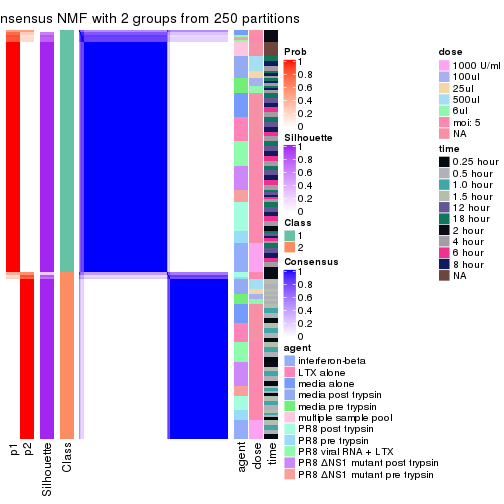
consensus_heatmap(res, k = 3)
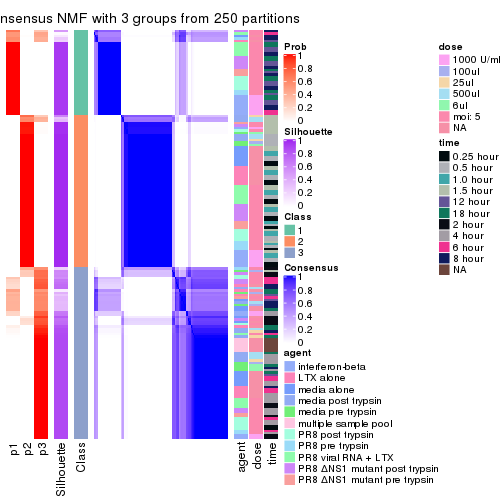
consensus_heatmap(res, k = 4)
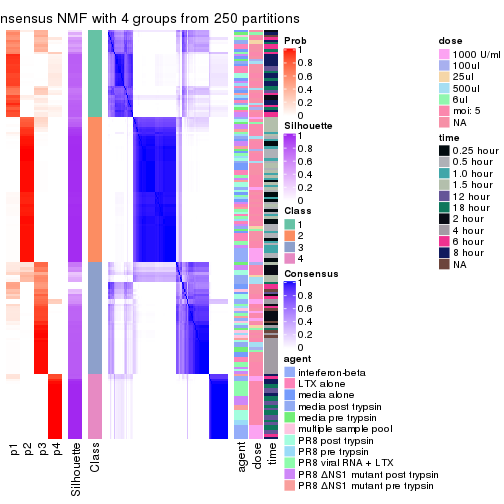
consensus_heatmap(res, k = 5)
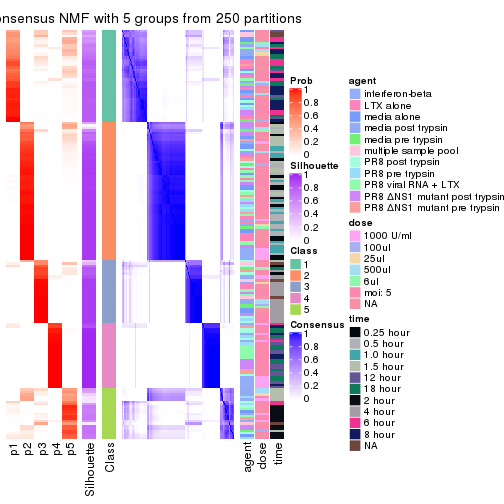
consensus_heatmap(res, k = 6)
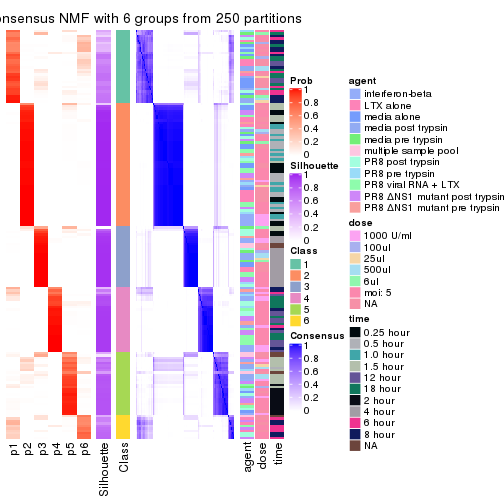
Heatmaps for the membership of samples in all partitions to see how consistent they are:
membership_heatmap(res, k = 2)
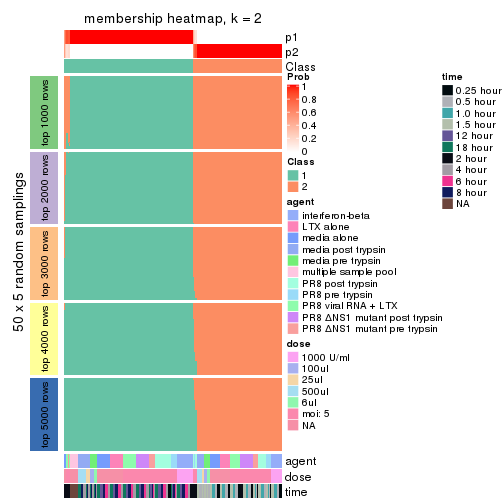
membership_heatmap(res, k = 3)
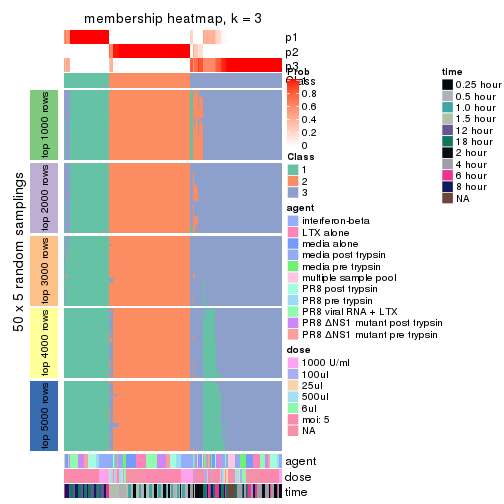
membership_heatmap(res, k = 4)
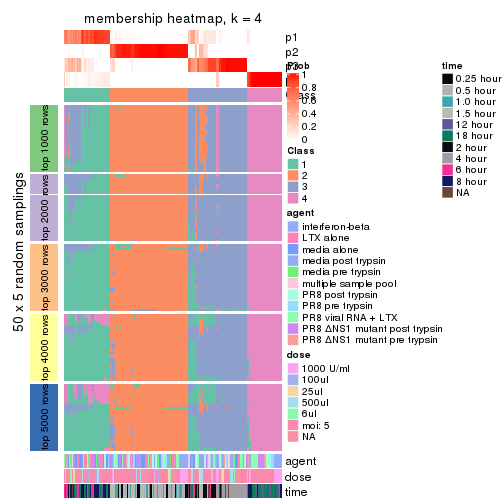
membership_heatmap(res, k = 5)
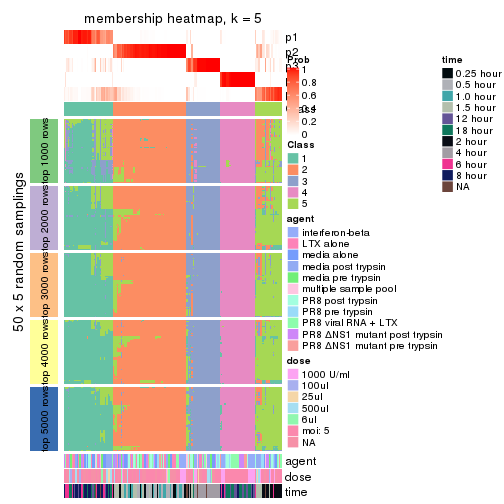
membership_heatmap(res, k = 6)
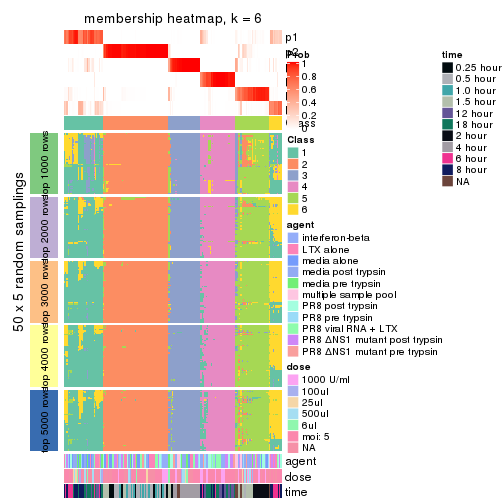
As soon as we have had the classes for columns, we can look for signatures which are significantly different between classes which can be candidate marks for certain classes. Following are the heatmaps for signatures.
Signature heatmaps where rows are scaled:
get_signatures(res, k = 2)
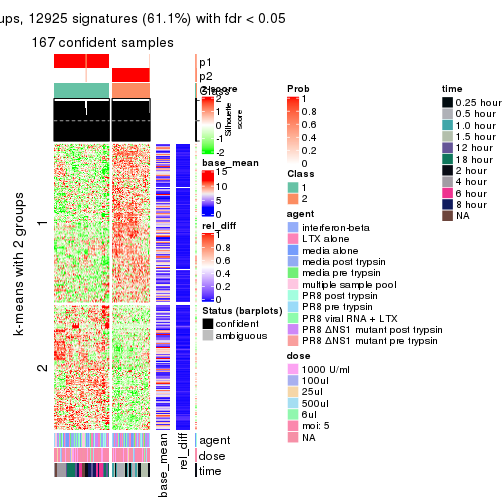
get_signatures(res, k = 3)
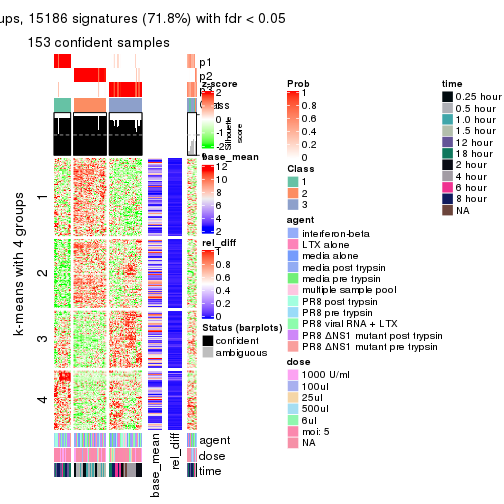
get_signatures(res, k = 4)
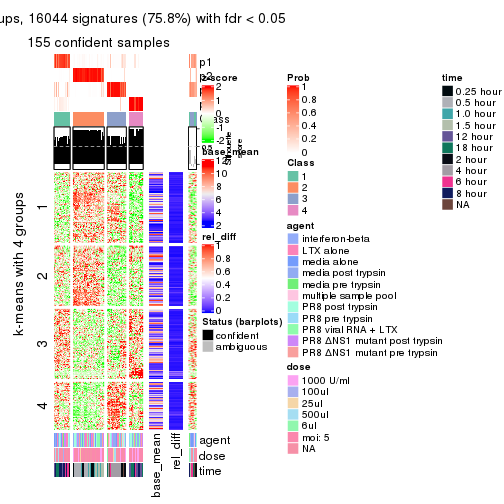
get_signatures(res, k = 5)
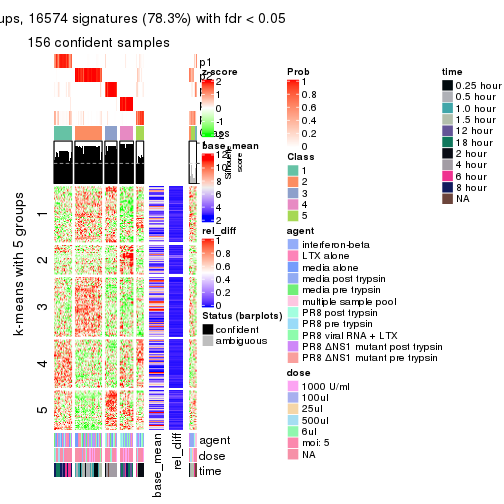
get_signatures(res, k = 6)
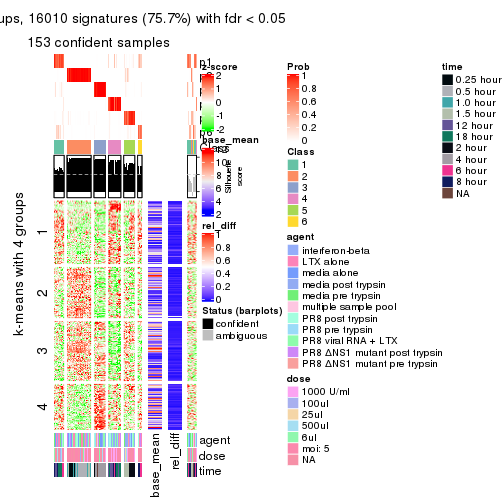
Signature heatmaps where rows are not scaled:
get_signatures(res, k = 2, scale_rows = FALSE)
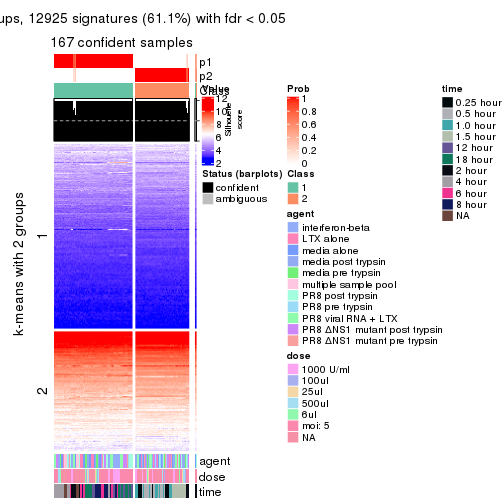
get_signatures(res, k = 3, scale_rows = FALSE)
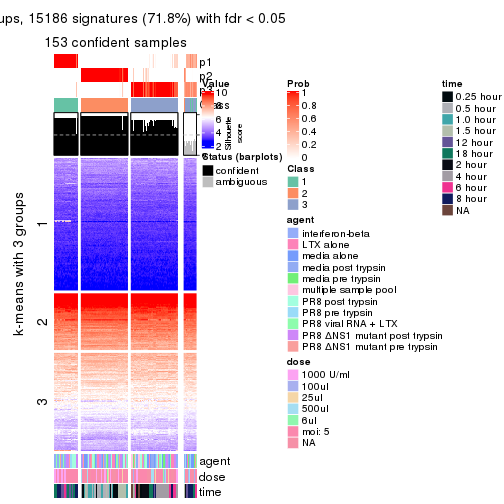
get_signatures(res, k = 4, scale_rows = FALSE)
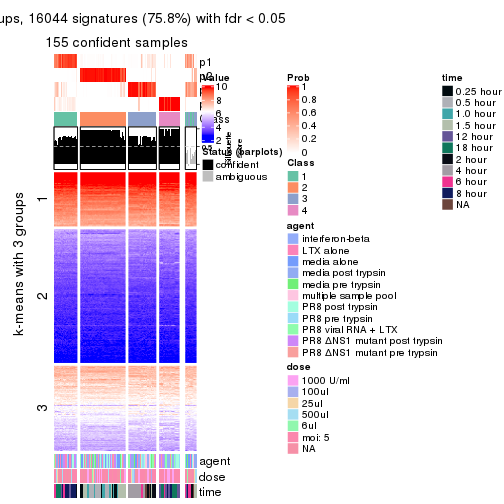
get_signatures(res, k = 5, scale_rows = FALSE)
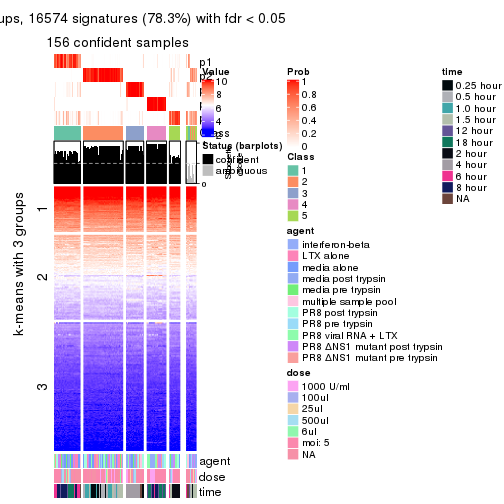
get_signatures(res, k = 6, scale_rows = FALSE)
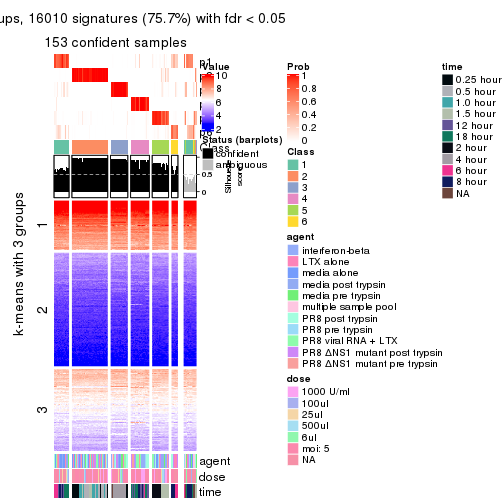
Compare the overlap of signatures from different k:
compare_signatures(res)
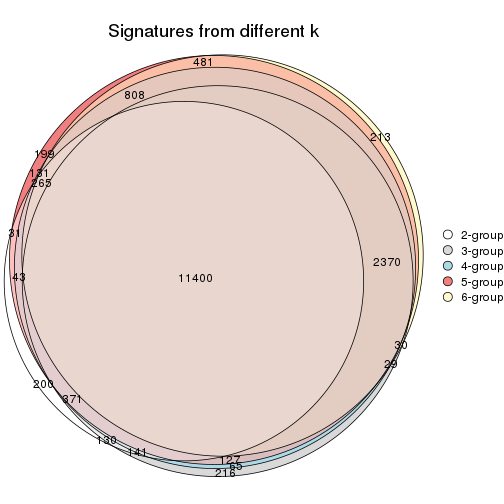
get_signature() returns a data frame invisibly. TO get the list of signatures, the function
call should be assigned to a variable explicitly. In following code, if plot argument is set
to FALSE, no heatmap is plotted while only the differential analysis is performed.
# code only for demonstration
tb = get_signature(res, k = ..., plot = FALSE)
An example of the output of tb is:
#> which_row fdr mean_1 mean_2 scaled_mean_1 scaled_mean_2 km
#> 1 38 0.042760348 8.373488 9.131774 -0.5533452 0.5164555 1
#> 2 40 0.018707592 7.106213 8.469186 -0.6173731 0.5762149 1
#> 3 55 0.019134737 10.221463 11.207825 -0.6159697 0.5749050 1
#> 4 59 0.006059896 5.921854 7.869574 -0.6899429 0.6439467 1
#> 5 60 0.018055526 8.928898 10.211722 -0.6204761 0.5791110 1
#> 6 98 0.009384629 15.714769 14.887706 0.6635654 -0.6193277 2
...
The columns in tb are:
which_row: row indices corresponding to the input matrix.fdr: FDR for the differential test. mean_x: The mean value in group x.scaled_mean_x: The mean value in group x after rows are scaled.km: Row groups if k-means clustering is applied to rows.UMAP plot which shows how samples are separated.
dimension_reduction(res, k = 2, method = "UMAP")
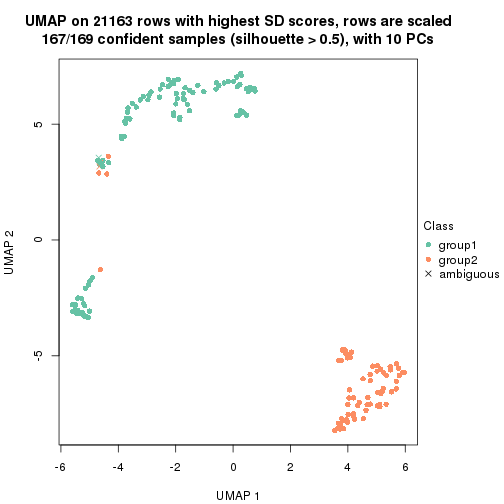
dimension_reduction(res, k = 3, method = "UMAP")
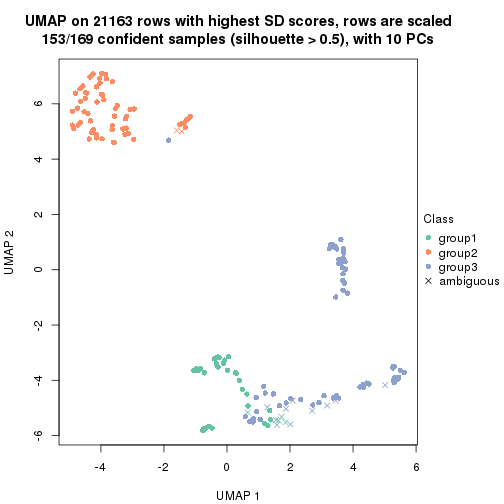
dimension_reduction(res, k = 4, method = "UMAP")
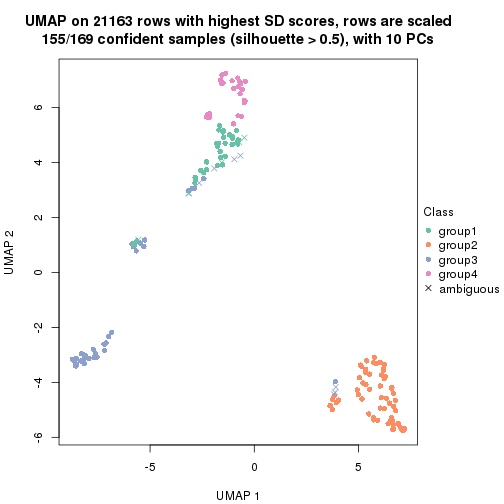
dimension_reduction(res, k = 5, method = "UMAP")
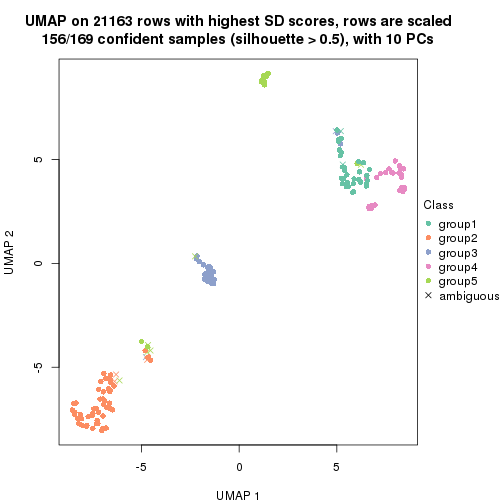
dimension_reduction(res, k = 6, method = "UMAP")
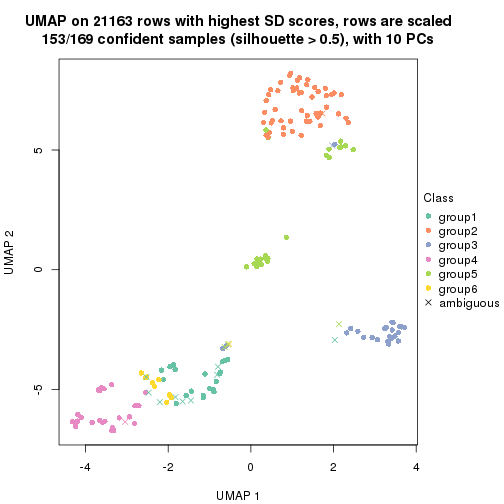
Following heatmap shows how subgroups are split when increasing k:
collect_classes(res)
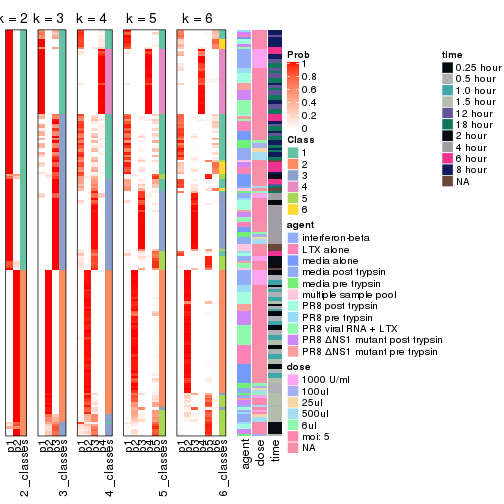
Test correlation between subgroups and known annotations. If the known annotation is numeric, one-way ANOVA test is applied, and if the known annotation is discrete, chi-squared contingency table test is applied.
test_to_known_factors(res)
#> n agent(p) dose(p) time(p) k
#> SD:NMF 167 0.85955 0.99881 3.81e-27 2
#> SD:NMF 153 0.01043 0.00367 5.55e-36 3
#> SD:NMF 155 0.00477 0.00682 2.43e-44 4
#> SD:NMF 156 0.06507 0.00689 8.68e-68 5
#> SD:NMF 153 0.00486 0.00817 4.93e-63 6
If matrix rows can be associated to genes, consider to use functional_enrichment(res,
...) to perform function enrichment for the signature genes. See this vignette for more detailed explanations.
The object with results only for a single top-value method and a single partition method can be extracted as:
res = res_list["CV", "hclust"]
# you can also extract it by
# res = res_list["CV:hclust"]
A summary of res and all the functions that can be applied to it:
res
#> A 'ConsensusPartition' object with k = 2, 3, 4, 5, 6.
#> On a matrix with 21163 rows and 169 columns.
#> Top rows (1000, 2000, 3000, 4000, 5000) are extracted by 'CV' method.
#> Subgroups are detected by 'hclust' method.
#> Performed in total 1250 partitions by row resampling.
#> Best k for subgroups seems to be 4.
#>
#> Following methods can be applied to this 'ConsensusPartition' object:
#> [1] "cola_report" "collect_classes" "collect_plots"
#> [4] "collect_stats" "colnames" "compare_signatures"
#> [7] "consensus_heatmap" "dimension_reduction" "functional_enrichment"
#> [10] "get_anno_col" "get_anno" "get_classes"
#> [13] "get_consensus" "get_matrix" "get_membership"
#> [16] "get_param" "get_signatures" "get_stats"
#> [19] "is_best_k" "is_stable_k" "membership_heatmap"
#> [22] "ncol" "nrow" "plot_ecdf"
#> [25] "rownames" "select_partition_number" "show"
#> [28] "suggest_best_k" "test_to_known_factors"
collect_plots() function collects all the plots made from res for all k (number of partitions)
into one single page to provide an easy and fast comparison between different k.
collect_plots(res)
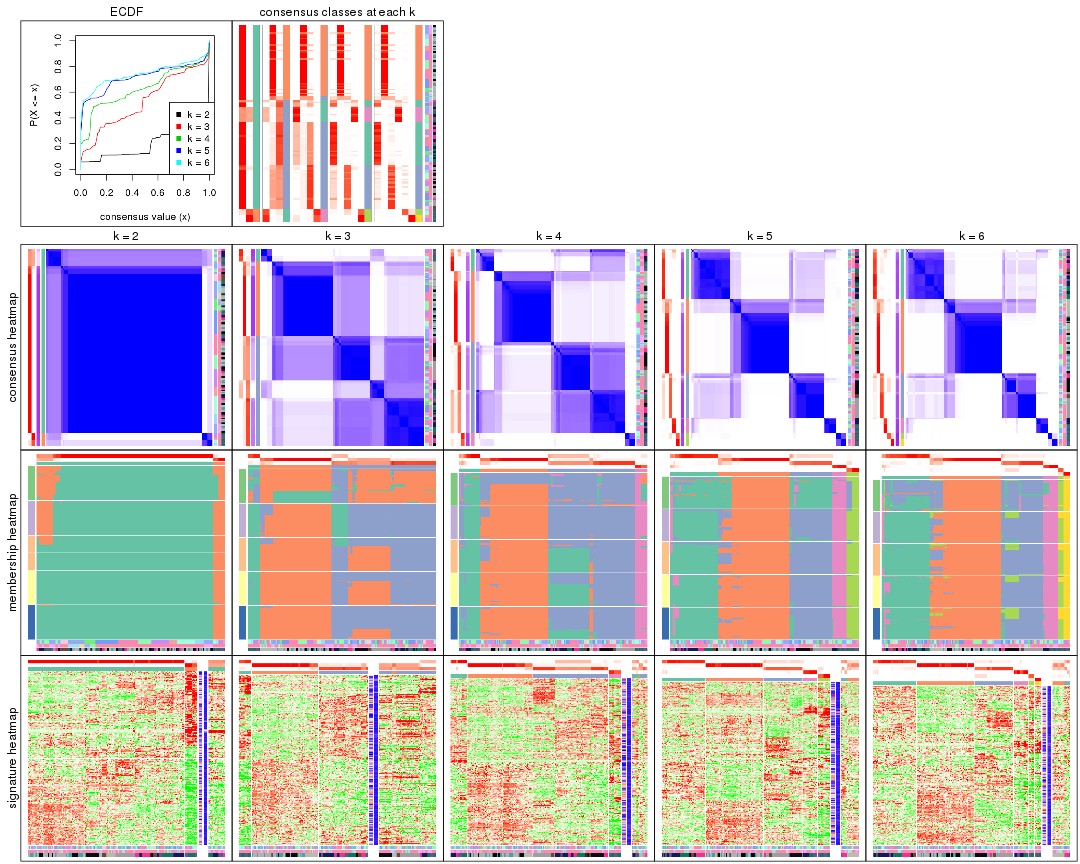
The plots are:
k and the heatmap of
predicted classes for each k.k.k.k.All the plots in panels can be made by individual functions and they are plotted later in this section.
select_partition_number() produces several plots showing different
statistics for choosing “optimized” k. There are following statistics:
k;k, the area increased is defined as \(A_k - A_{k-1}\).The detailed explanations of these statistics can be found in the cola vignette.
Generally speaking, lower PAC score, higher mean silhouette score or higher
concordance corresponds to better partition. Rand index and Jaccard index
measure how similar the current partition is compared to partition with k-1.
If they are too similar, we won't accept k is better than k-1.
select_partition_number(res)
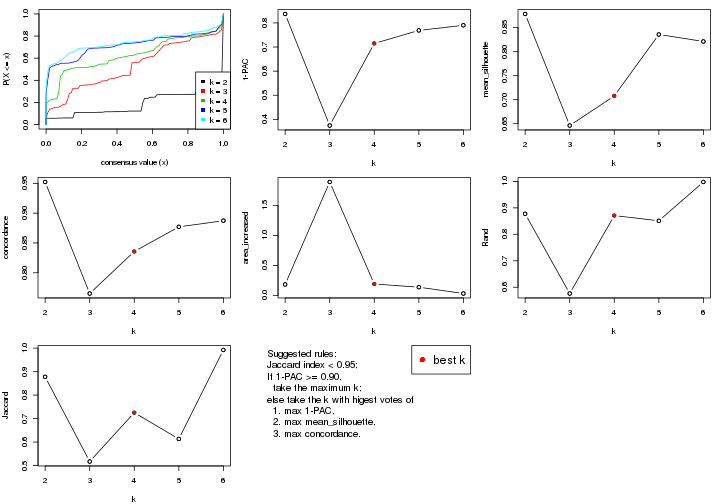
The numeric values for all these statistics can be obtained by get_stats().
get_stats(res)
#> k 1-PAC mean_silhouette concordance area_increased Rand Jaccard
#> 2 2 0.837 0.878 0.952 0.1836 0.878 0.878
#> 3 3 0.374 0.646 0.765 1.8914 0.576 0.517
#> 4 4 0.715 0.708 0.836 0.1909 0.871 0.725
#> 5 5 0.769 0.835 0.877 0.1384 0.851 0.613
#> 6 6 0.790 0.821 0.887 0.0326 0.998 0.992
suggest_best_k() suggests the best \(k\) based on these statistics. The rules are as follows:
suggest_best_k(res)
#> [1] 4
Following shows the table of the partitions (You need to click the show/hide
code output link to see it). The membership matrix (columns with name p*)
is inferred by
clue::cl_consensus()
function with the SE method. Basically the value in the membership matrix
represents the probability to belong to a certain group. The finall class
label for an item is determined with the group with highest probability it
belongs to.
In get_classes() function, the entropy is calculated from the membership
matrix and the silhouette score is calculated from the consensus matrix.
cbind(get_classes(res, k = 2), get_membership(res, k = 2))
#> class entropy silhouette p1 p2
#> GSM528681 1 0.000 0.949 1.000 0.000
#> GSM528682 1 0.000 0.949 1.000 0.000
#> GSM528683 1 0.000 0.949 1.000 0.000
#> GSM528684 1 0.000 0.949 1.000 0.000
#> GSM528687 1 0.000 0.949 1.000 0.000
#> GSM528688 1 0.000 0.949 1.000 0.000
#> GSM528685 1 0.000 0.949 1.000 0.000
#> GSM528686 1 0.000 0.949 1.000 0.000
#> GSM528693 1 0.358 0.886 0.932 0.068
#> GSM528694 1 0.358 0.886 0.932 0.068
#> GSM528695 1 0.634 0.779 0.840 0.160
#> GSM528696 1 0.634 0.779 0.840 0.160
#> GSM528697 1 0.958 0.391 0.620 0.380
#> GSM528698 1 0.958 0.391 0.620 0.380
#> GSM528699 1 0.992 0.216 0.552 0.448
#> GSM528700 1 0.992 0.216 0.552 0.448
#> GSM528689 1 0.994 0.191 0.544 0.456
#> GSM528690 1 0.994 0.191 0.544 0.456
#> GSM528691 1 0.994 0.191 0.544 0.456
#> GSM528692 1 0.994 0.191 0.544 0.456
#> GSM528779 1 0.000 0.949 1.000 0.000
#> GSM528780 1 0.000 0.949 1.000 0.000
#> GSM528782 1 0.000 0.949 1.000 0.000
#> GSM528781 1 0.000 0.949 1.000 0.000
#> GSM528785 1 0.000 0.949 1.000 0.000
#> GSM528786 1 0.000 0.949 1.000 0.000
#> GSM528787 1 0.000 0.949 1.000 0.000
#> GSM528788 1 0.000 0.949 1.000 0.000
#> GSM528783 1 0.343 0.890 0.936 0.064
#> GSM528784 2 0.625 0.882 0.156 0.844
#> GSM528759 1 0.000 0.949 1.000 0.000
#> GSM528760 1 0.000 0.949 1.000 0.000
#> GSM528761 1 0.000 0.949 1.000 0.000
#> GSM528762 1 0.000 0.949 1.000 0.000
#> GSM528765 1 0.000 0.949 1.000 0.000
#> GSM528766 1 0.000 0.949 1.000 0.000
#> GSM528763 1 0.000 0.949 1.000 0.000
#> GSM528764 1 0.000 0.949 1.000 0.000
#> GSM528771 1 0.000 0.949 1.000 0.000
#> GSM528772 1 0.000 0.949 1.000 0.000
#> GSM528773 1 0.000 0.949 1.000 0.000
#> GSM528774 1 0.000 0.949 1.000 0.000
#> GSM528775 1 0.000 0.949 1.000 0.000
#> GSM528776 1 0.000 0.949 1.000 0.000
#> GSM528777 1 0.000 0.949 1.000 0.000
#> GSM528778 1 0.000 0.949 1.000 0.000
#> GSM528767 2 0.625 0.882 0.156 0.844
#> GSM528768 2 0.625 0.882 0.156 0.844
#> GSM528769 2 0.625 0.882 0.156 0.844
#> GSM528770 2 0.625 0.882 0.156 0.844
#> GSM528671 1 0.000 0.949 1.000 0.000
#> GSM528672 1 0.000 0.949 1.000 0.000
#> GSM528674 1 0.000 0.949 1.000 0.000
#> GSM528673 1 0.000 0.949 1.000 0.000
#> GSM528677 1 0.000 0.949 1.000 0.000
#> GSM528678 1 0.000 0.949 1.000 0.000
#> GSM528679 1 0.000 0.949 1.000 0.000
#> GSM528680 1 0.983 0.281 0.576 0.424
#> GSM528675 2 0.000 0.916 0.000 1.000
#> GSM528676 2 0.000 0.916 0.000 1.000
#> GSM528651 1 0.000 0.949 1.000 0.000
#> GSM528652 1 0.000 0.949 1.000 0.000
#> GSM528653 1 0.000 0.949 1.000 0.000
#> GSM528654 1 0.000 0.949 1.000 0.000
#> GSM528657 1 0.000 0.949 1.000 0.000
#> GSM528658 1 0.000 0.949 1.000 0.000
#> GSM528655 1 0.000 0.949 1.000 0.000
#> GSM528656 1 0.000 0.949 1.000 0.000
#> GSM528663 1 0.000 0.949 1.000 0.000
#> GSM528664 1 0.000 0.949 1.000 0.000
#> GSM528665 1 0.000 0.949 1.000 0.000
#> GSM528666 1 0.000 0.949 1.000 0.000
#> GSM528667 1 0.000 0.949 1.000 0.000
#> GSM528668 1 0.000 0.949 1.000 0.000
#> GSM528669 1 0.000 0.949 1.000 0.000
#> GSM528670 1 0.000 0.949 1.000 0.000
#> GSM528659 2 0.000 0.916 0.000 1.000
#> GSM528660 2 0.000 0.916 0.000 1.000
#> GSM528661 2 0.000 0.916 0.000 1.000
#> GSM528662 2 0.000 0.916 0.000 1.000
#> GSM528701 1 0.000 0.949 1.000 0.000
#> GSM528702 1 0.000 0.949 1.000 0.000
#> GSM528703 1 0.000 0.949 1.000 0.000
#> GSM528704 1 0.000 0.949 1.000 0.000
#> GSM528707 1 0.000 0.949 1.000 0.000
#> GSM528708 1 0.000 0.949 1.000 0.000
#> GSM528705 1 0.000 0.949 1.000 0.000
#> GSM528706 1 0.000 0.949 1.000 0.000
#> GSM528713 1 0.000 0.949 1.000 0.000
#> GSM528714 1 0.000 0.949 1.000 0.000
#> GSM528715 1 0.000 0.949 1.000 0.000
#> GSM528716 1 0.000 0.949 1.000 0.000
#> GSM528717 1 0.358 0.886 0.932 0.068
#> GSM528718 1 0.358 0.886 0.932 0.068
#> GSM528719 1 0.992 0.216 0.552 0.448
#> GSM528720 1 0.992 0.216 0.552 0.448
#> GSM528709 1 0.994 0.191 0.544 0.456
#> GSM528710 1 0.994 0.191 0.544 0.456
#> GSM528711 1 0.994 0.191 0.544 0.456
#> GSM528712 1 0.994 0.191 0.544 0.456
#> GSM528721 1 0.000 0.949 1.000 0.000
#> GSM528722 1 0.000 0.949 1.000 0.000
#> GSM528723 1 0.000 0.949 1.000 0.000
#> GSM528724 1 0.000 0.949 1.000 0.000
#> GSM528727 1 0.000 0.949 1.000 0.000
#> GSM528728 1 0.000 0.949 1.000 0.000
#> GSM528725 1 0.000 0.949 1.000 0.000
#> GSM528726 1 0.000 0.949 1.000 0.000
#> GSM528733 1 0.000 0.949 1.000 0.000
#> GSM528734 1 0.000 0.949 1.000 0.000
#> GSM528735 1 0.000 0.949 1.000 0.000
#> GSM528736 1 0.000 0.949 1.000 0.000
#> GSM528737 1 0.000 0.949 1.000 0.000
#> GSM528738 1 0.000 0.949 1.000 0.000
#> GSM528729 1 0.000 0.949 1.000 0.000
#> GSM528730 1 0.000 0.949 1.000 0.000
#> GSM528731 1 0.000 0.949 1.000 0.000
#> GSM528732 1 0.000 0.949 1.000 0.000
#> GSM528739 1 0.000 0.949 1.000 0.000
#> GSM528740 1 0.000 0.949 1.000 0.000
#> GSM528741 1 0.000 0.949 1.000 0.000
#> GSM528742 1 0.000 0.949 1.000 0.000
#> GSM528745 1 0.000 0.949 1.000 0.000
#> GSM528746 1 0.000 0.949 1.000 0.000
#> GSM528743 1 0.000 0.949 1.000 0.000
#> GSM528744 1 0.000 0.949 1.000 0.000
#> GSM528751 1 0.000 0.949 1.000 0.000
#> GSM528752 1 0.000 0.949 1.000 0.000
#> GSM528753 1 0.000 0.949 1.000 0.000
#> GSM528754 1 0.000 0.949 1.000 0.000
#> GSM528755 1 0.000 0.949 1.000 0.000
#> GSM528756 1 0.000 0.949 1.000 0.000
#> GSM528757 1 0.000 0.949 1.000 0.000
#> GSM528758 1 0.000 0.949 1.000 0.000
#> GSM528747 1 0.000 0.949 1.000 0.000
#> GSM528748 1 0.000 0.949 1.000 0.000
#> GSM528749 1 0.000 0.949 1.000 0.000
#> GSM528750 1 0.000 0.949 1.000 0.000
#> GSM528640 1 0.000 0.949 1.000 0.000
#> GSM528641 1 0.000 0.949 1.000 0.000
#> GSM528643 1 0.000 0.949 1.000 0.000
#> GSM528644 1 0.000 0.949 1.000 0.000
#> GSM528642 1 0.000 0.949 1.000 0.000
#> GSM528620 1 0.000 0.949 1.000 0.000
#> GSM528621 1 0.000 0.949 1.000 0.000
#> GSM528623 1 0.000 0.949 1.000 0.000
#> GSM528624 1 0.000 0.949 1.000 0.000
#> GSM528622 1 0.000 0.949 1.000 0.000
#> GSM528625 1 0.000 0.949 1.000 0.000
#> GSM528626 1 0.000 0.949 1.000 0.000
#> GSM528628 1 0.000 0.949 1.000 0.000
#> GSM528629 1 0.000 0.949 1.000 0.000
#> GSM528627 1 0.000 0.949 1.000 0.000
#> GSM528630 1 0.000 0.949 1.000 0.000
#> GSM528631 1 0.000 0.949 1.000 0.000
#> GSM528632 1 0.000 0.949 1.000 0.000
#> GSM528633 1 0.000 0.949 1.000 0.000
#> GSM528636 1 0.000 0.949 1.000 0.000
#> GSM528637 1 0.000 0.949 1.000 0.000
#> GSM528638 1 0.000 0.949 1.000 0.000
#> GSM528639 1 0.000 0.949 1.000 0.000
#> GSM528634 1 0.000 0.949 1.000 0.000
#> GSM528635 1 0.000 0.949 1.000 0.000
#> GSM528645 1 0.000 0.949 1.000 0.000
#> GSM528646 1 0.000 0.949 1.000 0.000
#> GSM528647 1 0.000 0.949 1.000 0.000
#> GSM528648 1 0.000 0.949 1.000 0.000
#> GSM528649 1 0.000 0.949 1.000 0.000
#> GSM528650 1 0.000 0.949 1.000 0.000
cbind(get_classes(res, k = 3), get_membership(res, k = 3))
#> class entropy silhouette p1 p2 p3
#> GSM528681 2 0.0000 0.93678 0.000 1.000 0.000
#> GSM528682 2 0.0000 0.93678 0.000 1.000 0.000
#> GSM528683 2 0.0000 0.93678 0.000 1.000 0.000
#> GSM528684 2 0.0000 0.93678 0.000 1.000 0.000
#> GSM528687 2 0.0000 0.93678 0.000 1.000 0.000
#> GSM528688 2 0.0000 0.93678 0.000 1.000 0.000
#> GSM528685 2 0.4346 0.69806 0.000 0.816 0.184
#> GSM528686 2 0.4346 0.69806 0.000 0.816 0.184
#> GSM528693 3 0.6079 0.44355 0.000 0.388 0.612
#> GSM528694 3 0.6079 0.44355 0.000 0.388 0.612
#> GSM528695 3 0.7806 0.39499 0.064 0.352 0.584
#> GSM528696 3 0.7806 0.39499 0.064 0.352 0.584
#> GSM528697 3 0.5831 0.10778 0.284 0.008 0.708
#> GSM528698 3 0.5831 0.10778 0.284 0.008 0.708
#> GSM528699 3 0.6126 -0.03979 0.352 0.004 0.644
#> GSM528700 3 0.6126 -0.03979 0.352 0.004 0.644
#> GSM528689 3 0.6247 -0.05714 0.376 0.004 0.620
#> GSM528690 3 0.6247 -0.05714 0.376 0.004 0.620
#> GSM528691 3 0.6247 -0.05714 0.376 0.004 0.620
#> GSM528692 3 0.6247 -0.05714 0.376 0.004 0.620
#> GSM528779 2 0.0000 0.93678 0.000 1.000 0.000
#> GSM528780 2 0.0000 0.93678 0.000 1.000 0.000
#> GSM528782 2 0.0000 0.93678 0.000 1.000 0.000
#> GSM528781 2 0.0237 0.93323 0.000 0.996 0.004
#> GSM528785 3 0.6302 0.41455 0.000 0.480 0.520
#> GSM528786 3 0.6299 0.41937 0.000 0.476 0.524
#> GSM528787 3 0.6154 0.50278 0.000 0.408 0.592
#> GSM528788 3 0.3752 0.67258 0.000 0.144 0.856
#> GSM528783 3 0.4544 0.55087 0.084 0.056 0.860
#> GSM528784 1 0.4068 0.90353 0.864 0.016 0.120
#> GSM528759 3 0.3412 0.67338 0.000 0.124 0.876
#> GSM528760 3 0.3412 0.67338 0.000 0.124 0.876
#> GSM528761 2 0.0000 0.93678 0.000 1.000 0.000
#> GSM528762 2 0.0000 0.93678 0.000 1.000 0.000
#> GSM528765 2 0.0000 0.93678 0.000 1.000 0.000
#> GSM528766 2 0.0000 0.93678 0.000 1.000 0.000
#> GSM528763 2 0.4062 0.73121 0.000 0.836 0.164
#> GSM528764 2 0.4346 0.69806 0.000 0.816 0.184
#> GSM528771 3 0.6302 0.41455 0.000 0.480 0.520
#> GSM528772 3 0.6302 0.41455 0.000 0.480 0.520
#> GSM528773 3 0.6299 0.41937 0.000 0.476 0.524
#> GSM528774 3 0.6299 0.41937 0.000 0.476 0.524
#> GSM528775 3 0.6154 0.50278 0.000 0.408 0.592
#> GSM528776 3 0.3192 0.66506 0.000 0.112 0.888
#> GSM528777 3 0.3267 0.66313 0.000 0.116 0.884
#> GSM528778 3 0.3267 0.66313 0.000 0.116 0.884
#> GSM528767 1 0.4068 0.90353 0.864 0.016 0.120
#> GSM528768 1 0.4068 0.90353 0.864 0.016 0.120
#> GSM528769 1 0.4068 0.90353 0.864 0.016 0.120
#> GSM528770 1 0.4068 0.90353 0.864 0.016 0.120
#> GSM528671 2 0.0000 0.93678 0.000 1.000 0.000
#> GSM528672 2 0.0000 0.93678 0.000 1.000 0.000
#> GSM528674 2 0.0000 0.93678 0.000 1.000 0.000
#> GSM528673 2 0.4346 0.69806 0.000 0.816 0.184
#> GSM528677 3 0.6302 0.41455 0.000 0.480 0.520
#> GSM528678 3 0.6299 0.41937 0.000 0.476 0.524
#> GSM528679 3 0.3412 0.67338 0.000 0.124 0.876
#> GSM528680 3 0.6333 -0.00156 0.332 0.012 0.656
#> GSM528675 1 0.1529 0.92659 0.960 0.000 0.040
#> GSM528676 1 0.1529 0.92659 0.960 0.000 0.040
#> GSM528651 2 0.0000 0.93678 0.000 1.000 0.000
#> GSM528652 2 0.0000 0.93678 0.000 1.000 0.000
#> GSM528653 2 0.0000 0.93678 0.000 1.000 0.000
#> GSM528654 2 0.0000 0.93678 0.000 1.000 0.000
#> GSM528657 2 0.0000 0.93678 0.000 1.000 0.000
#> GSM528658 2 0.0000 0.93678 0.000 1.000 0.000
#> GSM528655 2 0.4346 0.69806 0.000 0.816 0.184
#> GSM528656 2 0.4346 0.69806 0.000 0.816 0.184
#> GSM528663 3 0.6302 0.41455 0.000 0.480 0.520
#> GSM528664 3 0.6302 0.41455 0.000 0.480 0.520
#> GSM528665 3 0.6299 0.41937 0.000 0.476 0.524
#> GSM528666 3 0.6299 0.41937 0.000 0.476 0.524
#> GSM528667 3 0.3412 0.67338 0.000 0.124 0.876
#> GSM528668 3 0.3412 0.67338 0.000 0.124 0.876
#> GSM528669 3 0.3267 0.66313 0.000 0.116 0.884
#> GSM528670 3 0.3267 0.66313 0.000 0.116 0.884
#> GSM528659 1 0.1529 0.92659 0.960 0.000 0.040
#> GSM528660 1 0.1529 0.92659 0.960 0.000 0.040
#> GSM528661 1 0.1529 0.92659 0.960 0.000 0.040
#> GSM528662 1 0.1529 0.92659 0.960 0.000 0.040
#> GSM528701 2 0.0000 0.93678 0.000 1.000 0.000
#> GSM528702 2 0.0000 0.93678 0.000 1.000 0.000
#> GSM528703 2 0.0000 0.93678 0.000 1.000 0.000
#> GSM528704 2 0.0000 0.93678 0.000 1.000 0.000
#> GSM528707 2 0.0000 0.93678 0.000 1.000 0.000
#> GSM528708 2 0.0000 0.93678 0.000 1.000 0.000
#> GSM528705 2 0.0000 0.93678 0.000 1.000 0.000
#> GSM528706 2 0.0000 0.93678 0.000 1.000 0.000
#> GSM528713 3 0.6302 0.41455 0.000 0.480 0.520
#> GSM528714 3 0.6302 0.41455 0.000 0.480 0.520
#> GSM528715 3 0.6299 0.41937 0.000 0.476 0.524
#> GSM528716 3 0.6299 0.41937 0.000 0.476 0.524
#> GSM528717 3 0.1411 0.58421 0.000 0.036 0.964
#> GSM528718 3 0.1411 0.58421 0.000 0.036 0.964
#> GSM528719 3 0.6126 -0.03979 0.352 0.004 0.644
#> GSM528720 3 0.6126 -0.03979 0.352 0.004 0.644
#> GSM528709 3 0.6247 -0.05714 0.376 0.004 0.620
#> GSM528710 3 0.6247 -0.05714 0.376 0.004 0.620
#> GSM528711 3 0.6247 -0.05714 0.376 0.004 0.620
#> GSM528712 3 0.6247 -0.05714 0.376 0.004 0.620
#> GSM528721 2 0.0000 0.93678 0.000 1.000 0.000
#> GSM528722 2 0.0000 0.93678 0.000 1.000 0.000
#> GSM528723 2 0.0000 0.93678 0.000 1.000 0.000
#> GSM528724 2 0.0000 0.93678 0.000 1.000 0.000
#> GSM528727 2 0.0000 0.93678 0.000 1.000 0.000
#> GSM528728 2 0.0000 0.93678 0.000 1.000 0.000
#> GSM528725 2 0.0000 0.93678 0.000 1.000 0.000
#> GSM528726 2 0.0000 0.93678 0.000 1.000 0.000
#> GSM528733 3 0.6299 0.41937 0.000 0.476 0.524
#> GSM528734 3 0.6299 0.41937 0.000 0.476 0.524
#> GSM528735 3 0.3412 0.67338 0.000 0.124 0.876
#> GSM528736 3 0.3412 0.67338 0.000 0.124 0.876
#> GSM528737 3 0.3412 0.67338 0.000 0.124 0.876
#> GSM528738 3 0.3412 0.67338 0.000 0.124 0.876
#> GSM528729 3 0.3267 0.66313 0.000 0.116 0.884
#> GSM528730 3 0.3267 0.66313 0.000 0.116 0.884
#> GSM528731 3 0.3752 0.67258 0.000 0.144 0.856
#> GSM528732 3 0.3752 0.67258 0.000 0.144 0.856
#> GSM528739 2 0.0000 0.93678 0.000 1.000 0.000
#> GSM528740 2 0.0000 0.93678 0.000 1.000 0.000
#> GSM528741 2 0.0000 0.93678 0.000 1.000 0.000
#> GSM528742 2 0.0000 0.93678 0.000 1.000 0.000
#> GSM528745 2 0.0237 0.93323 0.000 0.996 0.004
#> GSM528746 2 0.0000 0.93678 0.000 1.000 0.000
#> GSM528743 2 0.0237 0.93323 0.000 0.996 0.004
#> GSM528744 2 0.0000 0.93678 0.000 1.000 0.000
#> GSM528751 3 0.6302 0.41455 0.000 0.480 0.520
#> GSM528752 3 0.6302 0.41455 0.000 0.480 0.520
#> GSM528753 3 0.6299 0.41937 0.000 0.476 0.524
#> GSM528754 3 0.6299 0.41937 0.000 0.476 0.524
#> GSM528755 3 0.5905 0.55788 0.000 0.352 0.648
#> GSM528756 3 0.5905 0.55788 0.000 0.352 0.648
#> GSM528757 3 0.3752 0.67258 0.000 0.144 0.856
#> GSM528758 3 0.3752 0.67258 0.000 0.144 0.856
#> GSM528747 3 0.3752 0.66986 0.000 0.144 0.856
#> GSM528748 3 0.3752 0.66986 0.000 0.144 0.856
#> GSM528749 3 0.3752 0.67258 0.000 0.144 0.856
#> GSM528750 3 0.3752 0.67258 0.000 0.144 0.856
#> GSM528640 2 0.0000 0.93678 0.000 1.000 0.000
#> GSM528641 2 0.4346 0.69806 0.000 0.816 0.184
#> GSM528643 3 0.6299 0.41937 0.000 0.476 0.524
#> GSM528644 3 0.3752 0.66986 0.000 0.144 0.856
#> GSM528642 3 0.3551 0.66984 0.000 0.132 0.868
#> GSM528620 2 0.0000 0.93678 0.000 1.000 0.000
#> GSM528621 2 0.5621 0.38489 0.000 0.692 0.308
#> GSM528623 3 0.6299 0.41937 0.000 0.476 0.524
#> GSM528624 3 0.3267 0.66313 0.000 0.116 0.884
#> GSM528622 3 0.3482 0.67398 0.000 0.128 0.872
#> GSM528625 2 0.0000 0.93678 0.000 1.000 0.000
#> GSM528626 2 0.5098 0.55454 0.000 0.752 0.248
#> GSM528628 3 0.6299 0.41937 0.000 0.476 0.524
#> GSM528629 3 0.3752 0.66986 0.000 0.144 0.856
#> GSM528627 3 0.3482 0.67398 0.000 0.128 0.872
#> GSM528630 2 0.0000 0.93678 0.000 1.000 0.000
#> GSM528631 2 0.0892 0.91741 0.000 0.980 0.020
#> GSM528632 2 0.5621 0.38489 0.000 0.692 0.308
#> GSM528633 2 0.5621 0.38489 0.000 0.692 0.308
#> GSM528636 3 0.6299 0.41937 0.000 0.476 0.524
#> GSM528637 3 0.6299 0.41937 0.000 0.476 0.524
#> GSM528638 3 0.3267 0.66313 0.000 0.116 0.884
#> GSM528639 3 0.3267 0.66313 0.000 0.116 0.884
#> GSM528634 3 0.3482 0.67398 0.000 0.128 0.872
#> GSM528635 3 0.3482 0.67398 0.000 0.128 0.872
#> GSM528645 3 0.6299 0.41937 0.000 0.476 0.524
#> GSM528646 3 0.6299 0.41937 0.000 0.476 0.524
#> GSM528647 3 0.6299 0.41937 0.000 0.476 0.524
#> GSM528648 3 0.3412 0.67338 0.000 0.124 0.876
#> GSM528649 3 0.3412 0.67338 0.000 0.124 0.876
#> GSM528650 3 0.3412 0.67338 0.000 0.124 0.876
cbind(get_classes(res, k = 4), get_membership(res, k = 4))
#> class entropy silhouette p1 p2 p3 p4
#> GSM528681 2 0.0000 0.92791 0.000 1.000 0.000 0.000
#> GSM528682 2 0.0000 0.92791 0.000 1.000 0.000 0.000
#> GSM528683 2 0.0000 0.92791 0.000 1.000 0.000 0.000
#> GSM528684 2 0.0000 0.92791 0.000 1.000 0.000 0.000
#> GSM528687 2 0.0000 0.92791 0.000 1.000 0.000 0.000
#> GSM528688 2 0.0000 0.92791 0.000 1.000 0.000 0.000
#> GSM528685 2 0.4500 0.54236 0.000 0.684 0.316 0.000
#> GSM528686 2 0.4500 0.54236 0.000 0.684 0.316 0.000
#> GSM528693 3 0.1722 0.61152 0.048 0.000 0.944 0.008
#> GSM528694 3 0.1722 0.61152 0.048 0.000 0.944 0.008
#> GSM528695 3 0.3495 0.47794 0.140 0.000 0.844 0.016
#> GSM528696 3 0.3495 0.47794 0.140 0.000 0.844 0.016
#> GSM528697 1 0.4831 0.50202 0.704 0.000 0.280 0.016
#> GSM528698 1 0.4831 0.50202 0.704 0.000 0.280 0.016
#> GSM528699 1 0.1042 0.73096 0.972 0.000 0.020 0.008
#> GSM528700 1 0.1042 0.73096 0.972 0.000 0.020 0.008
#> GSM528689 1 0.0000 0.73185 1.000 0.000 0.000 0.000
#> GSM528690 1 0.0000 0.73185 1.000 0.000 0.000 0.000
#> GSM528691 1 0.0000 0.73185 1.000 0.000 0.000 0.000
#> GSM528692 1 0.0000 0.73185 1.000 0.000 0.000 0.000
#> GSM528779 2 0.0592 0.91899 0.000 0.984 0.016 0.000
#> GSM528780 2 0.0000 0.92791 0.000 1.000 0.000 0.000
#> GSM528782 2 0.0000 0.92791 0.000 1.000 0.000 0.000
#> GSM528781 2 0.1867 0.87626 0.000 0.928 0.072 0.000
#> GSM528785 3 0.2011 0.69473 0.000 0.080 0.920 0.000
#> GSM528786 3 0.1940 0.69510 0.000 0.076 0.924 0.000
#> GSM528787 3 0.3691 0.68895 0.068 0.076 0.856 0.000
#> GSM528788 3 0.6561 0.58557 0.344 0.092 0.564 0.000
#> GSM528783 1 0.7651 0.40587 0.540 0.016 0.260 0.184
#> GSM528784 4 0.1174 0.90327 0.012 0.000 0.020 0.968
#> GSM528759 3 0.6234 0.60025 0.348 0.068 0.584 0.000
#> GSM528760 3 0.6234 0.60025 0.348 0.068 0.584 0.000
#> GSM528761 2 0.0000 0.92791 0.000 1.000 0.000 0.000
#> GSM528762 2 0.0000 0.92791 0.000 1.000 0.000 0.000
#> GSM528765 2 0.0000 0.92791 0.000 1.000 0.000 0.000
#> GSM528766 2 0.0000 0.92791 0.000 1.000 0.000 0.000
#> GSM528763 2 0.4250 0.61511 0.000 0.724 0.276 0.000
#> GSM528764 2 0.4431 0.56614 0.000 0.696 0.304 0.000
#> GSM528771 3 0.2011 0.69473 0.000 0.080 0.920 0.000
#> GSM528772 3 0.2011 0.69473 0.000 0.080 0.920 0.000
#> GSM528773 3 0.1940 0.69510 0.000 0.076 0.924 0.000
#> GSM528774 3 0.1940 0.69510 0.000 0.076 0.924 0.000
#> GSM528775 3 0.3691 0.68895 0.068 0.076 0.856 0.000
#> GSM528776 3 0.6329 0.58639 0.344 0.064 0.588 0.004
#> GSM528777 3 0.6585 0.57731 0.344 0.072 0.576 0.008
#> GSM528778 3 0.6585 0.57731 0.344 0.072 0.576 0.008
#> GSM528767 4 0.1174 0.90327 0.012 0.000 0.020 0.968
#> GSM528768 4 0.1174 0.90327 0.012 0.000 0.020 0.968
#> GSM528769 4 0.1174 0.90327 0.012 0.000 0.020 0.968
#> GSM528770 4 0.1174 0.90327 0.012 0.000 0.020 0.968
#> GSM528671 2 0.1211 0.90172 0.000 0.960 0.040 0.000
#> GSM528672 2 0.0000 0.92791 0.000 1.000 0.000 0.000
#> GSM528674 2 0.0336 0.92382 0.000 0.992 0.008 0.000
#> GSM528673 2 0.4500 0.54236 0.000 0.684 0.316 0.000
#> GSM528677 3 0.2011 0.69473 0.000 0.080 0.920 0.000
#> GSM528678 3 0.1940 0.69510 0.000 0.076 0.924 0.000
#> GSM528679 3 0.6219 0.60314 0.344 0.068 0.588 0.000
#> GSM528680 1 0.3232 0.69125 0.872 0.004 0.108 0.016
#> GSM528675 4 0.4174 0.91717 0.140 0.000 0.044 0.816
#> GSM528676 4 0.4174 0.91717 0.140 0.000 0.044 0.816
#> GSM528651 2 0.1211 0.90172 0.000 0.960 0.040 0.000
#> GSM528652 2 0.1211 0.90172 0.000 0.960 0.040 0.000
#> GSM528653 2 0.0000 0.92791 0.000 1.000 0.000 0.000
#> GSM528654 2 0.0000 0.92791 0.000 1.000 0.000 0.000
#> GSM528657 2 0.0000 0.92791 0.000 1.000 0.000 0.000
#> GSM528658 2 0.0000 0.92791 0.000 1.000 0.000 0.000
#> GSM528655 2 0.4500 0.54236 0.000 0.684 0.316 0.000
#> GSM528656 2 0.4500 0.54236 0.000 0.684 0.316 0.000
#> GSM528663 3 0.2011 0.69473 0.000 0.080 0.920 0.000
#> GSM528664 3 0.2011 0.69473 0.000 0.080 0.920 0.000
#> GSM528665 3 0.1940 0.69510 0.000 0.076 0.924 0.000
#> GSM528666 3 0.1940 0.69510 0.000 0.076 0.924 0.000
#> GSM528667 3 0.6219 0.60314 0.344 0.068 0.588 0.000
#> GSM528668 3 0.6219 0.60314 0.344 0.068 0.588 0.000
#> GSM528669 3 0.6585 0.57731 0.344 0.072 0.576 0.008
#> GSM528670 3 0.6585 0.57731 0.344 0.072 0.576 0.008
#> GSM528659 4 0.4174 0.91717 0.140 0.000 0.044 0.816
#> GSM528660 4 0.4174 0.91717 0.140 0.000 0.044 0.816
#> GSM528661 4 0.4174 0.91717 0.140 0.000 0.044 0.816
#> GSM528662 4 0.4174 0.91717 0.140 0.000 0.044 0.816
#> GSM528701 2 0.0000 0.92791 0.000 1.000 0.000 0.000
#> GSM528702 2 0.0000 0.92791 0.000 1.000 0.000 0.000
#> GSM528703 2 0.0000 0.92791 0.000 1.000 0.000 0.000
#> GSM528704 2 0.0000 0.92791 0.000 1.000 0.000 0.000
#> GSM528707 2 0.0000 0.92791 0.000 1.000 0.000 0.000
#> GSM528708 2 0.0000 0.92791 0.000 1.000 0.000 0.000
#> GSM528705 2 0.0000 0.92791 0.000 1.000 0.000 0.000
#> GSM528706 2 0.0000 0.92791 0.000 1.000 0.000 0.000
#> GSM528713 3 0.2011 0.69473 0.000 0.080 0.920 0.000
#> GSM528714 3 0.2011 0.69473 0.000 0.080 0.920 0.000
#> GSM528715 3 0.1940 0.69510 0.000 0.076 0.924 0.000
#> GSM528716 3 0.1940 0.69510 0.000 0.076 0.924 0.000
#> GSM528717 3 0.5364 0.44379 0.392 0.000 0.592 0.016
#> GSM528718 3 0.5364 0.44379 0.392 0.000 0.592 0.016
#> GSM528719 1 0.1042 0.73096 0.972 0.000 0.020 0.008
#> GSM528720 1 0.1042 0.73096 0.972 0.000 0.020 0.008
#> GSM528709 1 0.0000 0.73185 1.000 0.000 0.000 0.000
#> GSM528710 1 0.0000 0.73185 1.000 0.000 0.000 0.000
#> GSM528711 1 0.0000 0.73185 1.000 0.000 0.000 0.000
#> GSM528712 1 0.0000 0.73185 1.000 0.000 0.000 0.000
#> GSM528721 2 0.0000 0.92791 0.000 1.000 0.000 0.000
#> GSM528722 2 0.0000 0.92791 0.000 1.000 0.000 0.000
#> GSM528723 2 0.0000 0.92791 0.000 1.000 0.000 0.000
#> GSM528724 2 0.0000 0.92791 0.000 1.000 0.000 0.000
#> GSM528727 2 0.0000 0.92791 0.000 1.000 0.000 0.000
#> GSM528728 2 0.0000 0.92791 0.000 1.000 0.000 0.000
#> GSM528725 2 0.0000 0.92791 0.000 1.000 0.000 0.000
#> GSM528726 2 0.0000 0.92791 0.000 1.000 0.000 0.000
#> GSM528733 3 0.1940 0.69510 0.000 0.076 0.924 0.000
#> GSM528734 3 0.1940 0.69510 0.000 0.076 0.924 0.000
#> GSM528735 3 0.6219 0.60314 0.344 0.068 0.588 0.000
#> GSM528736 3 0.6219 0.60314 0.344 0.068 0.588 0.000
#> GSM528737 3 0.6219 0.60314 0.344 0.068 0.588 0.000
#> GSM528738 3 0.6219 0.60314 0.344 0.068 0.588 0.000
#> GSM528729 3 0.6585 0.57731 0.344 0.072 0.576 0.008
#> GSM528730 3 0.6585 0.57731 0.344 0.072 0.576 0.008
#> GSM528731 3 0.6523 0.58603 0.348 0.088 0.564 0.000
#> GSM528732 3 0.6523 0.58603 0.348 0.088 0.564 0.000
#> GSM528739 2 0.0000 0.92791 0.000 1.000 0.000 0.000
#> GSM528740 2 0.0000 0.92791 0.000 1.000 0.000 0.000
#> GSM528741 2 0.0000 0.92791 0.000 1.000 0.000 0.000
#> GSM528742 2 0.0000 0.92791 0.000 1.000 0.000 0.000
#> GSM528745 2 0.1557 0.89048 0.000 0.944 0.056 0.000
#> GSM528746 2 0.0000 0.92791 0.000 1.000 0.000 0.000
#> GSM528743 2 0.1867 0.87626 0.000 0.928 0.072 0.000
#> GSM528744 2 0.0469 0.92102 0.000 0.988 0.012 0.000
#> GSM528751 3 0.2011 0.69473 0.000 0.080 0.920 0.000
#> GSM528752 3 0.2011 0.69473 0.000 0.080 0.920 0.000
#> GSM528753 3 0.1940 0.69510 0.000 0.076 0.924 0.000
#> GSM528754 3 0.1940 0.69510 0.000 0.076 0.924 0.000
#> GSM528755 3 0.4318 0.67767 0.116 0.068 0.816 0.000
#> GSM528756 3 0.4318 0.67767 0.116 0.068 0.816 0.000
#> GSM528757 3 0.6561 0.58557 0.344 0.092 0.564 0.000
#> GSM528758 3 0.6561 0.58557 0.344 0.092 0.564 0.000
#> GSM528747 1 0.6755 -0.38797 0.456 0.092 0.452 0.000
#> GSM528748 1 0.6755 -0.38797 0.456 0.092 0.452 0.000
#> GSM528749 3 0.6523 0.58603 0.348 0.088 0.564 0.000
#> GSM528750 3 0.6523 0.58603 0.348 0.088 0.564 0.000
#> GSM528640 2 0.0000 0.92791 0.000 1.000 0.000 0.000
#> GSM528641 2 0.4500 0.54236 0.000 0.684 0.316 0.000
#> GSM528643 3 0.1940 0.69510 0.000 0.076 0.924 0.000
#> GSM528644 3 0.6755 0.36921 0.448 0.092 0.460 0.000
#> GSM528642 1 0.6500 -0.15489 0.544 0.080 0.376 0.000
#> GSM528620 2 0.0469 0.92102 0.000 0.988 0.012 0.000
#> GSM528621 3 0.5000 -0.00614 0.000 0.496 0.504 0.000
#> GSM528623 3 0.1940 0.69510 0.000 0.076 0.924 0.000
#> GSM528624 3 0.6585 0.57731 0.344 0.072 0.576 0.008
#> GSM528622 3 0.6295 0.59955 0.348 0.072 0.580 0.000
#> GSM528625 2 0.0000 0.92791 0.000 1.000 0.000 0.000
#> GSM528626 2 0.4790 0.36936 0.000 0.620 0.380 0.000
#> GSM528628 3 0.1940 0.69510 0.000 0.076 0.924 0.000
#> GSM528629 3 0.6755 0.36921 0.448 0.092 0.460 0.000
#> GSM528627 3 0.6295 0.59955 0.348 0.072 0.580 0.000
#> GSM528630 2 0.0000 0.92791 0.000 1.000 0.000 0.000
#> GSM528631 2 0.1940 0.87471 0.000 0.924 0.076 0.000
#> GSM528632 3 0.5000 -0.00614 0.000 0.496 0.504 0.000
#> GSM528633 3 0.5000 -0.00614 0.000 0.496 0.504 0.000
#> GSM528636 3 0.1940 0.69510 0.000 0.076 0.924 0.000
#> GSM528637 3 0.1940 0.69510 0.000 0.076 0.924 0.000
#> GSM528638 3 0.6585 0.57731 0.344 0.072 0.576 0.008
#> GSM528639 3 0.6600 0.57243 0.348 0.072 0.572 0.008
#> GSM528634 3 0.6295 0.59955 0.348 0.072 0.580 0.000
#> GSM528635 3 0.6295 0.59955 0.348 0.072 0.580 0.000
#> GSM528645 3 0.1940 0.69510 0.000 0.076 0.924 0.000
#> GSM528646 3 0.1940 0.69510 0.000 0.076 0.924 0.000
#> GSM528647 3 0.1940 0.69510 0.000 0.076 0.924 0.000
#> GSM528648 3 0.6234 0.60025 0.348 0.068 0.584 0.000
#> GSM528649 3 0.6234 0.60025 0.348 0.068 0.584 0.000
#> GSM528650 3 0.6234 0.60025 0.348 0.068 0.584 0.000
cbind(get_classes(res, k = 5), get_membership(res, k = 5))
#> class entropy silhouette p1 p2 p3 p4 p5
#> GSM528681 2 0.0000 0.887 0.000 1.000 0.000 0.000 0.000
#> GSM528682 2 0.0000 0.887 0.000 1.000 0.000 0.000 0.000
#> GSM528683 2 0.0000 0.887 0.000 1.000 0.000 0.000 0.000
#> GSM528684 2 0.0000 0.887 0.000 1.000 0.000 0.000 0.000
#> GSM528687 2 0.0000 0.887 0.000 1.000 0.000 0.000 0.000
#> GSM528688 2 0.0000 0.887 0.000 1.000 0.000 0.000 0.000
#> GSM528685 2 0.5831 0.423 0.172 0.608 0.220 0.000 0.000
#> GSM528686 2 0.5831 0.423 0.172 0.608 0.220 0.000 0.000
#> GSM528693 3 0.3921 0.854 0.172 0.000 0.784 0.044 0.000
#> GSM528694 3 0.3921 0.854 0.172 0.000 0.784 0.044 0.000
#> GSM528695 3 0.4127 0.704 0.080 0.000 0.784 0.136 0.000
#> GSM528696 3 0.4127 0.704 0.080 0.000 0.784 0.136 0.000
#> GSM528697 1 0.4736 0.175 0.576 0.000 0.020 0.404 0.000
#> GSM528698 1 0.4736 0.175 0.576 0.000 0.020 0.404 0.000
#> GSM528699 4 0.1216 0.954 0.020 0.000 0.020 0.960 0.000
#> GSM528700 4 0.1216 0.954 0.020 0.000 0.020 0.960 0.000
#> GSM528689 4 0.0290 0.964 0.008 0.000 0.000 0.992 0.000
#> GSM528690 4 0.0290 0.964 0.008 0.000 0.000 0.992 0.000
#> GSM528691 4 0.0290 0.964 0.008 0.000 0.000 0.992 0.000
#> GSM528692 4 0.0290 0.964 0.008 0.000 0.000 0.992 0.000
#> GSM528779 2 0.0510 0.879 0.000 0.984 0.016 0.000 0.000
#> GSM528780 2 0.0000 0.887 0.000 1.000 0.000 0.000 0.000
#> GSM528782 2 0.0000 0.887 0.000 1.000 0.000 0.000 0.000
#> GSM528781 2 0.1608 0.838 0.000 0.928 0.072 0.000 0.000
#> GSM528785 3 0.3333 0.930 0.208 0.004 0.788 0.000 0.000
#> GSM528786 3 0.3003 0.938 0.188 0.000 0.812 0.000 0.000
#> GSM528787 3 0.4045 0.724 0.356 0.000 0.644 0.000 0.000
#> GSM528788 1 0.1216 0.913 0.960 0.020 0.020 0.000 0.000
#> GSM528783 1 0.6577 0.230 0.516 0.008 0.204 0.272 0.000
#> GSM528784 5 0.4082 0.897 0.032 0.000 0.184 0.008 0.776
#> GSM528759 1 0.1412 0.911 0.952 0.004 0.036 0.008 0.000
#> GSM528760 1 0.1412 0.911 0.952 0.004 0.036 0.008 0.000
#> GSM528761 2 0.0000 0.887 0.000 1.000 0.000 0.000 0.000
#> GSM528762 2 0.0000 0.887 0.000 1.000 0.000 0.000 0.000
#> GSM528765 2 0.0000 0.887 0.000 1.000 0.000 0.000 0.000
#> GSM528766 2 0.0000 0.887 0.000 1.000 0.000 0.000 0.000
#> GSM528763 2 0.5502 0.503 0.156 0.652 0.192 0.000 0.000
#> GSM528764 2 0.5699 0.456 0.156 0.624 0.220 0.000 0.000
#> GSM528771 3 0.3333 0.930 0.208 0.004 0.788 0.000 0.000
#> GSM528772 3 0.3333 0.930 0.208 0.004 0.788 0.000 0.000
#> GSM528773 3 0.3003 0.938 0.188 0.000 0.812 0.000 0.000
#> GSM528774 3 0.3003 0.938 0.188 0.000 0.812 0.000 0.000
#> GSM528775 3 0.4045 0.724 0.356 0.000 0.644 0.000 0.000
#> GSM528776 1 0.0807 0.913 0.976 0.012 0.012 0.000 0.000
#> GSM528777 1 0.0404 0.911 0.988 0.012 0.000 0.000 0.000
#> GSM528778 1 0.0404 0.911 0.988 0.012 0.000 0.000 0.000
#> GSM528767 5 0.4082 0.897 0.032 0.000 0.184 0.008 0.776
#> GSM528768 5 0.4082 0.897 0.032 0.000 0.184 0.008 0.776
#> GSM528769 5 0.4082 0.897 0.032 0.000 0.184 0.008 0.776
#> GSM528770 5 0.4082 0.897 0.032 0.000 0.184 0.008 0.776
#> GSM528671 2 0.1043 0.863 0.000 0.960 0.040 0.000 0.000
#> GSM528672 2 0.0000 0.887 0.000 1.000 0.000 0.000 0.000
#> GSM528674 2 0.0290 0.883 0.000 0.992 0.008 0.000 0.000
#> GSM528673 2 0.5831 0.423 0.172 0.608 0.220 0.000 0.000
#> GSM528677 3 0.3333 0.930 0.208 0.004 0.788 0.000 0.000
#> GSM528678 3 0.3003 0.938 0.188 0.000 0.812 0.000 0.000
#> GSM528679 1 0.1124 0.911 0.960 0.004 0.036 0.000 0.000
#> GSM528680 4 0.3812 0.700 0.196 0.004 0.020 0.780 0.000
#> GSM528675 5 0.0000 0.916 0.000 0.000 0.000 0.000 1.000
#> GSM528676 5 0.0000 0.916 0.000 0.000 0.000 0.000 1.000
#> GSM528651 2 0.1043 0.863 0.000 0.960 0.040 0.000 0.000
#> GSM528652 2 0.1043 0.863 0.000 0.960 0.040 0.000 0.000
#> GSM528653 2 0.0000 0.887 0.000 1.000 0.000 0.000 0.000
#> GSM528654 2 0.0000 0.887 0.000 1.000 0.000 0.000 0.000
#> GSM528657 2 0.0000 0.887 0.000 1.000 0.000 0.000 0.000
#> GSM528658 2 0.0000 0.887 0.000 1.000 0.000 0.000 0.000
#> GSM528655 2 0.5831 0.423 0.172 0.608 0.220 0.000 0.000
#> GSM528656 2 0.5831 0.423 0.172 0.608 0.220 0.000 0.000
#> GSM528663 3 0.3333 0.930 0.208 0.004 0.788 0.000 0.000
#> GSM528664 3 0.3333 0.930 0.208 0.004 0.788 0.000 0.000
#> GSM528665 3 0.3003 0.938 0.188 0.000 0.812 0.000 0.000
#> GSM528666 3 0.3003 0.938 0.188 0.000 0.812 0.000 0.000
#> GSM528667 1 0.1124 0.911 0.960 0.004 0.036 0.000 0.000
#> GSM528668 1 0.1124 0.911 0.960 0.004 0.036 0.000 0.000
#> GSM528669 1 0.0404 0.911 0.988 0.012 0.000 0.000 0.000
#> GSM528670 1 0.0404 0.911 0.988 0.012 0.000 0.000 0.000
#> GSM528659 5 0.0000 0.916 0.000 0.000 0.000 0.000 1.000
#> GSM528660 5 0.0000 0.916 0.000 0.000 0.000 0.000 1.000
#> GSM528661 5 0.0000 0.916 0.000 0.000 0.000 0.000 1.000
#> GSM528662 5 0.0000 0.916 0.000 0.000 0.000 0.000 1.000
#> GSM528701 2 0.0000 0.887 0.000 1.000 0.000 0.000 0.000
#> GSM528702 2 0.0000 0.887 0.000 1.000 0.000 0.000 0.000
#> GSM528703 2 0.0000 0.887 0.000 1.000 0.000 0.000 0.000
#> GSM528704 2 0.0000 0.887 0.000 1.000 0.000 0.000 0.000
#> GSM528707 2 0.0000 0.887 0.000 1.000 0.000 0.000 0.000
#> GSM528708 2 0.0000 0.887 0.000 1.000 0.000 0.000 0.000
#> GSM528705 2 0.0000 0.887 0.000 1.000 0.000 0.000 0.000
#> GSM528706 2 0.0000 0.887 0.000 1.000 0.000 0.000 0.000
#> GSM528713 3 0.3333 0.930 0.208 0.004 0.788 0.000 0.000
#> GSM528714 3 0.3333 0.930 0.208 0.004 0.788 0.000 0.000
#> GSM528715 3 0.3003 0.938 0.188 0.000 0.812 0.000 0.000
#> GSM528716 3 0.3003 0.938 0.188 0.000 0.812 0.000 0.000
#> GSM528717 1 0.1992 0.851 0.924 0.000 0.032 0.044 0.000
#> GSM528718 1 0.1992 0.851 0.924 0.000 0.032 0.044 0.000
#> GSM528719 4 0.1216 0.954 0.020 0.000 0.020 0.960 0.000
#> GSM528720 4 0.1216 0.954 0.020 0.000 0.020 0.960 0.000
#> GSM528709 4 0.0290 0.964 0.008 0.000 0.000 0.992 0.000
#> GSM528710 4 0.0290 0.964 0.008 0.000 0.000 0.992 0.000
#> GSM528711 4 0.0290 0.964 0.008 0.000 0.000 0.992 0.000
#> GSM528712 4 0.0290 0.964 0.008 0.000 0.000 0.992 0.000
#> GSM528721 2 0.0000 0.887 0.000 1.000 0.000 0.000 0.000
#> GSM528722 2 0.0000 0.887 0.000 1.000 0.000 0.000 0.000
#> GSM528723 2 0.0000 0.887 0.000 1.000 0.000 0.000 0.000
#> GSM528724 2 0.0000 0.887 0.000 1.000 0.000 0.000 0.000
#> GSM528727 2 0.0000 0.887 0.000 1.000 0.000 0.000 0.000
#> GSM528728 2 0.0000 0.887 0.000 1.000 0.000 0.000 0.000
#> GSM528725 2 0.0000 0.887 0.000 1.000 0.000 0.000 0.000
#> GSM528726 2 0.0000 0.887 0.000 1.000 0.000 0.000 0.000
#> GSM528733 3 0.3003 0.938 0.188 0.000 0.812 0.000 0.000
#> GSM528734 3 0.3003 0.938 0.188 0.000 0.812 0.000 0.000
#> GSM528735 1 0.1124 0.911 0.960 0.004 0.036 0.000 0.000
#> GSM528736 1 0.1124 0.911 0.960 0.004 0.036 0.000 0.000
#> GSM528737 1 0.1124 0.911 0.960 0.004 0.036 0.000 0.000
#> GSM528738 1 0.1124 0.911 0.960 0.004 0.036 0.000 0.000
#> GSM528729 1 0.0404 0.911 0.988 0.012 0.000 0.000 0.000
#> GSM528730 1 0.0404 0.911 0.988 0.012 0.000 0.000 0.000
#> GSM528731 1 0.1405 0.914 0.956 0.016 0.020 0.008 0.000
#> GSM528732 1 0.1405 0.914 0.956 0.016 0.020 0.008 0.000
#> GSM528739 2 0.0000 0.887 0.000 1.000 0.000 0.000 0.000
#> GSM528740 2 0.0000 0.887 0.000 1.000 0.000 0.000 0.000
#> GSM528741 2 0.0000 0.887 0.000 1.000 0.000 0.000 0.000
#> GSM528742 2 0.0000 0.887 0.000 1.000 0.000 0.000 0.000
#> GSM528745 2 0.1341 0.852 0.000 0.944 0.056 0.000 0.000
#> GSM528746 2 0.0000 0.887 0.000 1.000 0.000 0.000 0.000
#> GSM528743 2 0.1608 0.838 0.000 0.928 0.072 0.000 0.000
#> GSM528744 2 0.0404 0.881 0.000 0.988 0.012 0.000 0.000
#> GSM528751 3 0.3333 0.930 0.208 0.004 0.788 0.000 0.000
#> GSM528752 3 0.3333 0.930 0.208 0.004 0.788 0.000 0.000
#> GSM528753 3 0.3003 0.938 0.188 0.000 0.812 0.000 0.000
#> GSM528754 3 0.3003 0.938 0.188 0.000 0.812 0.000 0.000
#> GSM528755 3 0.4305 0.421 0.488 0.000 0.512 0.000 0.000
#> GSM528756 3 0.4305 0.421 0.488 0.000 0.512 0.000 0.000
#> GSM528757 1 0.1216 0.913 0.960 0.020 0.020 0.000 0.000
#> GSM528758 1 0.1216 0.913 0.960 0.020 0.020 0.000 0.000
#> GSM528747 1 0.4062 0.807 0.804 0.020 0.040 0.136 0.000
#> GSM528748 1 0.4062 0.807 0.804 0.020 0.040 0.136 0.000
#> GSM528749 1 0.1405 0.914 0.956 0.016 0.020 0.008 0.000
#> GSM528750 1 0.1405 0.914 0.956 0.016 0.020 0.008 0.000
#> GSM528640 2 0.0000 0.887 0.000 1.000 0.000 0.000 0.000
#> GSM528641 2 0.5831 0.423 0.172 0.608 0.220 0.000 0.000
#> GSM528643 3 0.3003 0.938 0.188 0.000 0.812 0.000 0.000
#> GSM528644 1 0.3972 0.815 0.812 0.020 0.040 0.128 0.000
#> GSM528642 1 0.4893 0.638 0.684 0.008 0.044 0.264 0.000
#> GSM528620 2 0.0404 0.881 0.000 0.988 0.012 0.000 0.000
#> GSM528621 2 0.6532 -0.125 0.196 0.420 0.384 0.000 0.000
#> GSM528623 3 0.3003 0.938 0.188 0.000 0.812 0.000 0.000
#> GSM528624 1 0.0404 0.911 0.988 0.012 0.000 0.000 0.000
#> GSM528622 1 0.1455 0.912 0.952 0.008 0.032 0.008 0.000
#> GSM528625 2 0.0000 0.887 0.000 1.000 0.000 0.000 0.000
#> GSM528626 2 0.6193 0.269 0.184 0.544 0.272 0.000 0.000
#> GSM528628 3 0.3003 0.938 0.188 0.000 0.812 0.000 0.000
#> GSM528629 1 0.3972 0.815 0.812 0.020 0.040 0.128 0.000
#> GSM528627 1 0.1455 0.912 0.952 0.008 0.032 0.008 0.000
#> GSM528630 2 0.0000 0.887 0.000 1.000 0.000 0.000 0.000
#> GSM528631 2 0.1943 0.837 0.020 0.924 0.056 0.000 0.000
#> GSM528632 2 0.6532 -0.125 0.196 0.420 0.384 0.000 0.000
#> GSM528633 2 0.6532 -0.125 0.196 0.420 0.384 0.000 0.000
#> GSM528636 3 0.3003 0.938 0.188 0.000 0.812 0.000 0.000
#> GSM528637 3 0.3003 0.938 0.188 0.000 0.812 0.000 0.000
#> GSM528638 1 0.0404 0.911 0.988 0.012 0.000 0.000 0.000
#> GSM528639 1 0.0693 0.911 0.980 0.012 0.000 0.008 0.000
#> GSM528634 1 0.1455 0.912 0.952 0.008 0.032 0.008 0.000
#> GSM528635 1 0.1455 0.912 0.952 0.008 0.032 0.008 0.000
#> GSM528645 3 0.3003 0.938 0.188 0.000 0.812 0.000 0.000
#> GSM528646 3 0.3003 0.938 0.188 0.000 0.812 0.000 0.000
#> GSM528647 3 0.3003 0.938 0.188 0.000 0.812 0.000 0.000
#> GSM528648 1 0.1412 0.911 0.952 0.004 0.036 0.008 0.000
#> GSM528649 1 0.1412 0.911 0.952 0.004 0.036 0.008 0.000
#> GSM528650 1 0.1412 0.911 0.952 0.004 0.036 0.008 0.000
cbind(get_classes(res, k = 6), get_membership(res, k = 6))
#> class entropy silhouette p1 p2 p3 p4 p5 p6
#> GSM528681 2 0.0000 0.8900 0.000 1.000 0.000 0.000 0.000 0.00
#> GSM528682 2 0.0000 0.8900 0.000 1.000 0.000 0.000 0.000 0.00
#> GSM528683 2 0.0000 0.8900 0.000 1.000 0.000 0.000 0.000 0.00
#> GSM528684 2 0.0000 0.8900 0.000 1.000 0.000 0.000 0.000 0.00
#> GSM528687 2 0.0000 0.8900 0.000 1.000 0.000 0.000 0.000 0.00
#> GSM528688 2 0.0000 0.8900 0.000 1.000 0.000 0.000 0.000 0.00
#> GSM528685 2 0.5585 0.4441 0.096 0.604 0.264 0.000 0.036 0.00
#> GSM528686 2 0.5585 0.4441 0.096 0.604 0.264 0.000 0.036 0.00
#> GSM528693 3 0.4358 0.6986 0.100 0.000 0.716 0.000 0.184 0.00
#> GSM528694 3 0.4358 0.6986 0.100 0.000 0.716 0.000 0.184 0.00
#> GSM528695 3 0.2687 0.6730 0.024 0.000 0.872 0.092 0.012 0.00
#> GSM528696 3 0.2687 0.6730 0.024 0.000 0.872 0.092 0.012 0.00
#> GSM528697 1 0.5134 0.2575 0.564 0.000 0.064 0.360 0.012 0.00
#> GSM528698 1 0.5134 0.2575 0.564 0.000 0.064 0.360 0.012 0.00
#> GSM528699 4 0.1728 0.9187 0.004 0.000 0.064 0.924 0.008 0.00
#> GSM528700 4 0.1728 0.9187 0.004 0.000 0.064 0.924 0.008 0.00
#> GSM528689 4 0.0000 0.9444 0.000 0.000 0.000 1.000 0.000 0.00
#> GSM528690 4 0.0000 0.9444 0.000 0.000 0.000 1.000 0.000 0.00
#> GSM528691 4 0.0000 0.9444 0.000 0.000 0.000 1.000 0.000 0.00
#> GSM528692 4 0.0000 0.9444 0.000 0.000 0.000 1.000 0.000 0.00
#> GSM528779 2 0.0508 0.8818 0.000 0.984 0.012 0.000 0.004 0.00
#> GSM528780 2 0.0000 0.8900 0.000 1.000 0.000 0.000 0.000 0.00
#> GSM528782 2 0.0000 0.8900 0.000 1.000 0.000 0.000 0.000 0.00
#> GSM528781 2 0.1713 0.8439 0.000 0.928 0.044 0.000 0.028 0.00
#> GSM528785 3 0.4466 0.8019 0.116 0.000 0.708 0.000 0.176 0.00
#> GSM528786 3 0.1387 0.8693 0.068 0.000 0.932 0.000 0.000 0.00
#> GSM528787 3 0.3720 0.7254 0.236 0.000 0.736 0.000 0.028 0.00
#> GSM528788 1 0.0820 0.8972 0.972 0.012 0.016 0.000 0.000 0.00
#> GSM528783 1 0.6272 0.2893 0.504 0.004 0.020 0.264 0.208 0.00
#> GSM528784 5 0.2772 1.0000 0.004 0.000 0.000 0.000 0.816 0.18
#> GSM528759 1 0.2261 0.8731 0.884 0.004 0.104 0.008 0.000 0.00
#> GSM528760 1 0.2261 0.8731 0.884 0.004 0.104 0.008 0.000 0.00
#> GSM528761 2 0.0000 0.8900 0.000 1.000 0.000 0.000 0.000 0.00
#> GSM528762 2 0.0000 0.8900 0.000 1.000 0.000 0.000 0.000 0.00
#> GSM528765 2 0.0000 0.8900 0.000 1.000 0.000 0.000 0.000 0.00
#> GSM528766 2 0.0000 0.8900 0.000 1.000 0.000 0.000 0.000 0.00
#> GSM528763 2 0.5097 0.5168 0.084 0.648 0.248 0.000 0.020 0.00
#> GSM528764 2 0.5438 0.4752 0.084 0.620 0.260 0.000 0.036 0.00
#> GSM528771 3 0.4466 0.8019 0.116 0.000 0.708 0.000 0.176 0.00
#> GSM528772 3 0.4466 0.8019 0.116 0.000 0.708 0.000 0.176 0.00
#> GSM528773 3 0.1387 0.8693 0.068 0.000 0.932 0.000 0.000 0.00
#> GSM528774 3 0.1387 0.8693 0.068 0.000 0.932 0.000 0.000 0.00
#> GSM528775 3 0.3720 0.7254 0.236 0.000 0.736 0.000 0.028 0.00
#> GSM528776 1 0.0405 0.8958 0.988 0.004 0.008 0.000 0.000 0.00
#> GSM528777 1 0.0291 0.8925 0.992 0.004 0.000 0.000 0.004 0.00
#> GSM528778 1 0.0291 0.8925 0.992 0.004 0.000 0.000 0.004 0.00
#> GSM528767 5 0.2772 1.0000 0.004 0.000 0.000 0.000 0.816 0.18
#> GSM528768 5 0.2772 1.0000 0.004 0.000 0.000 0.000 0.816 0.18
#> GSM528769 5 0.2772 1.0000 0.004 0.000 0.000 0.000 0.816 0.18
#> GSM528770 5 0.2772 1.0000 0.004 0.000 0.000 0.000 0.816 0.18
#> GSM528671 2 0.1074 0.8660 0.000 0.960 0.028 0.000 0.012 0.00
#> GSM528672 2 0.0000 0.8900 0.000 1.000 0.000 0.000 0.000 0.00
#> GSM528674 2 0.0260 0.8861 0.000 0.992 0.008 0.000 0.000 0.00
#> GSM528673 2 0.5585 0.4441 0.096 0.604 0.264 0.000 0.036 0.00
#> GSM528677 3 0.4466 0.8019 0.116 0.000 0.708 0.000 0.176 0.00
#> GSM528678 3 0.1387 0.8693 0.068 0.000 0.932 0.000 0.000 0.00
#> GSM528679 1 0.1908 0.8784 0.900 0.004 0.096 0.000 0.000 0.00
#> GSM528680 4 0.4229 0.6543 0.180 0.000 0.064 0.744 0.012 0.00
#> GSM528675 6 0.0000 1.0000 0.000 0.000 0.000 0.000 0.000 1.00
#> GSM528676 6 0.0000 1.0000 0.000 0.000 0.000 0.000 0.000 1.00
#> GSM528651 2 0.1074 0.8660 0.000 0.960 0.028 0.000 0.012 0.00
#> GSM528652 2 0.1074 0.8660 0.000 0.960 0.028 0.000 0.012 0.00
#> GSM528653 2 0.0000 0.8900 0.000 1.000 0.000 0.000 0.000 0.00
#> GSM528654 2 0.0000 0.8900 0.000 1.000 0.000 0.000 0.000 0.00
#> GSM528657 2 0.0000 0.8900 0.000 1.000 0.000 0.000 0.000 0.00
#> GSM528658 2 0.0000 0.8900 0.000 1.000 0.000 0.000 0.000 0.00
#> GSM528655 2 0.5585 0.4441 0.096 0.604 0.264 0.000 0.036 0.00
#> GSM528656 2 0.5585 0.4441 0.096 0.604 0.264 0.000 0.036 0.00
#> GSM528663 3 0.4466 0.8019 0.116 0.000 0.708 0.000 0.176 0.00
#> GSM528664 3 0.4466 0.8019 0.116 0.000 0.708 0.000 0.176 0.00
#> GSM528665 3 0.1387 0.8693 0.068 0.000 0.932 0.000 0.000 0.00
#> GSM528666 3 0.1387 0.8693 0.068 0.000 0.932 0.000 0.000 0.00
#> GSM528667 1 0.1908 0.8784 0.900 0.004 0.096 0.000 0.000 0.00
#> GSM528668 1 0.1908 0.8784 0.900 0.004 0.096 0.000 0.000 0.00
#> GSM528669 1 0.0291 0.8925 0.992 0.004 0.000 0.000 0.004 0.00
#> GSM528670 1 0.0291 0.8925 0.992 0.004 0.000 0.000 0.004 0.00
#> GSM528659 6 0.0000 1.0000 0.000 0.000 0.000 0.000 0.000 1.00
#> GSM528660 6 0.0000 1.0000 0.000 0.000 0.000 0.000 0.000 1.00
#> GSM528661 6 0.0000 1.0000 0.000 0.000 0.000 0.000 0.000 1.00
#> GSM528662 6 0.0000 1.0000 0.000 0.000 0.000 0.000 0.000 1.00
#> GSM528701 2 0.0000 0.8900 0.000 1.000 0.000 0.000 0.000 0.00
#> GSM528702 2 0.0000 0.8900 0.000 1.000 0.000 0.000 0.000 0.00
#> GSM528703 2 0.0000 0.8900 0.000 1.000 0.000 0.000 0.000 0.00
#> GSM528704 2 0.0000 0.8900 0.000 1.000 0.000 0.000 0.000 0.00
#> GSM528707 2 0.0000 0.8900 0.000 1.000 0.000 0.000 0.000 0.00
#> GSM528708 2 0.0000 0.8900 0.000 1.000 0.000 0.000 0.000 0.00
#> GSM528705 2 0.0000 0.8900 0.000 1.000 0.000 0.000 0.000 0.00
#> GSM528706 2 0.0000 0.8900 0.000 1.000 0.000 0.000 0.000 0.00
#> GSM528713 3 0.4466 0.8019 0.116 0.000 0.708 0.000 0.176 0.00
#> GSM528714 3 0.4466 0.8019 0.116 0.000 0.708 0.000 0.176 0.00
#> GSM528715 3 0.1387 0.8693 0.068 0.000 0.932 0.000 0.000 0.00
#> GSM528716 3 0.1387 0.8693 0.068 0.000 0.932 0.000 0.000 0.00
#> GSM528717 1 0.2170 0.8331 0.888 0.000 0.100 0.000 0.012 0.00
#> GSM528718 1 0.2170 0.8331 0.888 0.000 0.100 0.000 0.012 0.00
#> GSM528719 4 0.1728 0.9187 0.004 0.000 0.064 0.924 0.008 0.00
#> GSM528720 4 0.1728 0.9187 0.004 0.000 0.064 0.924 0.008 0.00
#> GSM528709 4 0.0000 0.9444 0.000 0.000 0.000 1.000 0.000 0.00
#> GSM528710 4 0.0000 0.9444 0.000 0.000 0.000 1.000 0.000 0.00
#> GSM528711 4 0.0000 0.9444 0.000 0.000 0.000 1.000 0.000 0.00
#> GSM528712 4 0.0000 0.9444 0.000 0.000 0.000 1.000 0.000 0.00
#> GSM528721 2 0.0000 0.8900 0.000 1.000 0.000 0.000 0.000 0.00
#> GSM528722 2 0.0000 0.8900 0.000 1.000 0.000 0.000 0.000 0.00
#> GSM528723 2 0.0000 0.8900 0.000 1.000 0.000 0.000 0.000 0.00
#> GSM528724 2 0.0000 0.8900 0.000 1.000 0.000 0.000 0.000 0.00
#> GSM528727 2 0.0000 0.8900 0.000 1.000 0.000 0.000 0.000 0.00
#> GSM528728 2 0.0000 0.8900 0.000 1.000 0.000 0.000 0.000 0.00
#> GSM528725 2 0.0000 0.8900 0.000 1.000 0.000 0.000 0.000 0.00
#> GSM528726 2 0.0000 0.8900 0.000 1.000 0.000 0.000 0.000 0.00
#> GSM528733 3 0.1387 0.8693 0.068 0.000 0.932 0.000 0.000 0.00
#> GSM528734 3 0.1387 0.8693 0.068 0.000 0.932 0.000 0.000 0.00
#> GSM528735 1 0.1700 0.8862 0.916 0.004 0.080 0.000 0.000 0.00
#> GSM528736 1 0.1700 0.8862 0.916 0.004 0.080 0.000 0.000 0.00
#> GSM528737 1 0.1700 0.8862 0.916 0.004 0.080 0.000 0.000 0.00
#> GSM528738 1 0.1700 0.8862 0.916 0.004 0.080 0.000 0.000 0.00
#> GSM528729 1 0.0291 0.8925 0.992 0.004 0.000 0.000 0.004 0.00
#> GSM528730 1 0.0291 0.8925 0.992 0.004 0.000 0.000 0.004 0.00
#> GSM528731 1 0.1167 0.8978 0.960 0.012 0.020 0.008 0.000 0.00
#> GSM528732 1 0.1167 0.8978 0.960 0.012 0.020 0.008 0.000 0.00
#> GSM528739 2 0.0000 0.8900 0.000 1.000 0.000 0.000 0.000 0.00
#> GSM528740 2 0.0000 0.8900 0.000 1.000 0.000 0.000 0.000 0.00
#> GSM528741 2 0.0000 0.8900 0.000 1.000 0.000 0.000 0.000 0.00
#> GSM528742 2 0.0000 0.8900 0.000 1.000 0.000 0.000 0.000 0.00
#> GSM528745 2 0.1408 0.8564 0.000 0.944 0.036 0.000 0.020 0.00
#> GSM528746 2 0.0000 0.8900 0.000 1.000 0.000 0.000 0.000 0.00
#> GSM528743 2 0.1713 0.8439 0.000 0.928 0.044 0.000 0.028 0.00
#> GSM528744 2 0.0363 0.8833 0.000 0.988 0.012 0.000 0.000 0.00
#> GSM528751 3 0.4466 0.8019 0.116 0.000 0.708 0.000 0.176 0.00
#> GSM528752 3 0.4466 0.8019 0.116 0.000 0.708 0.000 0.176 0.00
#> GSM528753 3 0.1387 0.8693 0.068 0.000 0.932 0.000 0.000 0.00
#> GSM528754 3 0.1387 0.8693 0.068 0.000 0.932 0.000 0.000 0.00
#> GSM528755 3 0.4410 0.3843 0.412 0.000 0.560 0.000 0.028 0.00
#> GSM528756 3 0.4410 0.3843 0.412 0.000 0.560 0.000 0.028 0.00
#> GSM528757 1 0.0820 0.8972 0.972 0.012 0.016 0.000 0.000 0.00
#> GSM528758 1 0.0820 0.8972 0.972 0.012 0.016 0.000 0.000 0.00
#> GSM528747 1 0.3405 0.8018 0.816 0.012 0.036 0.136 0.000 0.00
#> GSM528748 1 0.3405 0.8018 0.816 0.012 0.036 0.136 0.000 0.00
#> GSM528749 1 0.1167 0.8978 0.960 0.012 0.020 0.008 0.000 0.00
#> GSM528750 1 0.1167 0.8978 0.960 0.012 0.020 0.008 0.000 0.00
#> GSM528640 2 0.0000 0.8900 0.000 1.000 0.000 0.000 0.000 0.00
#> GSM528641 2 0.5585 0.4441 0.096 0.604 0.264 0.000 0.036 0.00
#> GSM528643 3 0.1387 0.8693 0.068 0.000 0.932 0.000 0.000 0.00
#> GSM528644 1 0.3323 0.8094 0.824 0.012 0.036 0.128 0.000 0.00
#> GSM528642 1 0.4518 0.6222 0.672 0.004 0.060 0.264 0.000 0.00
#> GSM528620 2 0.0363 0.8833 0.000 0.988 0.012 0.000 0.000 0.00
#> GSM528621 2 0.6654 -0.0511 0.108 0.416 0.384 0.000 0.092 0.00
#> GSM528623 3 0.1387 0.8693 0.068 0.000 0.932 0.000 0.000 0.00
#> GSM528624 1 0.0291 0.8925 0.992 0.004 0.000 0.000 0.004 0.00
#> GSM528622 1 0.1477 0.8973 0.940 0.004 0.048 0.008 0.000 0.00
#> GSM528625 2 0.0000 0.8900 0.000 1.000 0.000 0.000 0.000 0.00
#> GSM528626 2 0.6009 0.3006 0.104 0.540 0.308 0.000 0.048 0.00
#> GSM528628 3 0.1387 0.8693 0.068 0.000 0.932 0.000 0.000 0.00
#> GSM528629 1 0.3323 0.8094 0.824 0.012 0.036 0.128 0.000 0.00
#> GSM528627 1 0.1477 0.8973 0.940 0.004 0.048 0.008 0.000 0.00
#> GSM528630 2 0.0000 0.8900 0.000 1.000 0.000 0.000 0.000 0.00
#> GSM528631 2 0.1908 0.8432 0.012 0.924 0.044 0.000 0.020 0.00
#> GSM528632 2 0.6654 -0.0511 0.108 0.416 0.384 0.000 0.092 0.00
#> GSM528633 2 0.6654 -0.0511 0.108 0.416 0.384 0.000 0.092 0.00
#> GSM528636 3 0.1387 0.8693 0.068 0.000 0.932 0.000 0.000 0.00
#> GSM528637 3 0.1387 0.8693 0.068 0.000 0.932 0.000 0.000 0.00
#> GSM528638 1 0.0291 0.8925 0.992 0.004 0.000 0.000 0.004 0.00
#> GSM528639 1 0.0551 0.8926 0.984 0.004 0.000 0.008 0.004 0.00
#> GSM528634 1 0.1477 0.8973 0.940 0.004 0.048 0.008 0.000 0.00
#> GSM528635 1 0.1477 0.8973 0.940 0.004 0.048 0.008 0.000 0.00
#> GSM528645 3 0.1387 0.8693 0.068 0.000 0.932 0.000 0.000 0.00
#> GSM528646 3 0.1387 0.8693 0.068 0.000 0.932 0.000 0.000 0.00
#> GSM528647 3 0.1387 0.8693 0.068 0.000 0.932 0.000 0.000 0.00
#> GSM528648 1 0.2261 0.8731 0.884 0.004 0.104 0.008 0.000 0.00
#> GSM528649 1 0.2261 0.8731 0.884 0.004 0.104 0.008 0.000 0.00
#> GSM528650 1 0.2261 0.8731 0.884 0.004 0.104 0.008 0.000 0.00
Heatmaps for the consensus matrix. It visualizes the probability of two samples to be in a same group.
consensus_heatmap(res, k = 2)
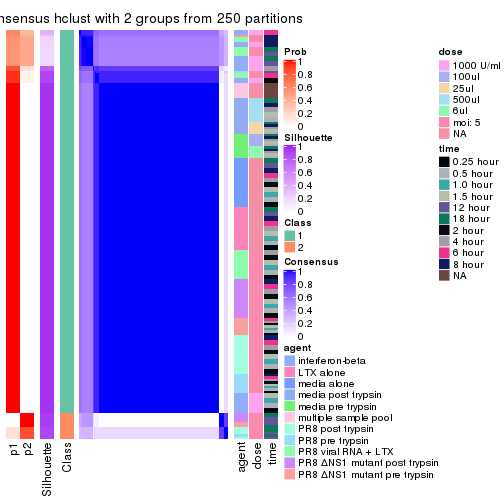
consensus_heatmap(res, k = 3)
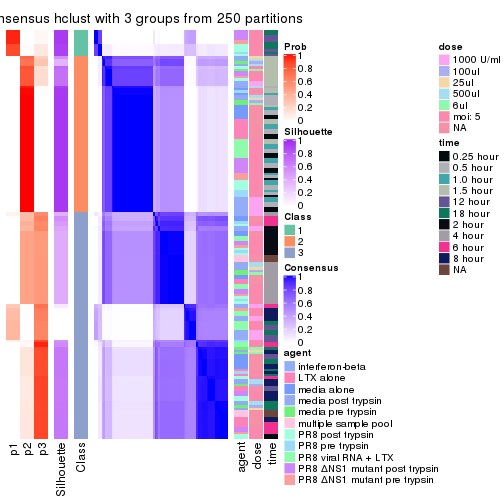
consensus_heatmap(res, k = 4)
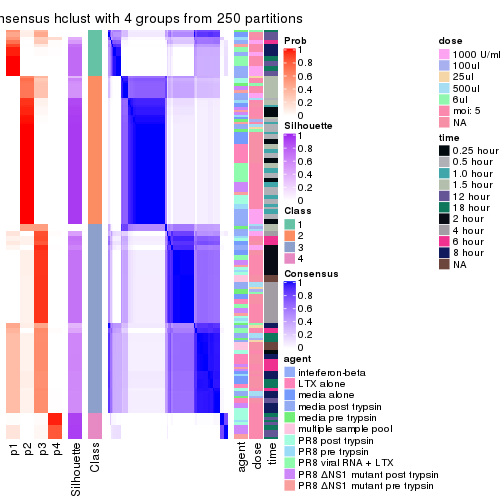
consensus_heatmap(res, k = 5)
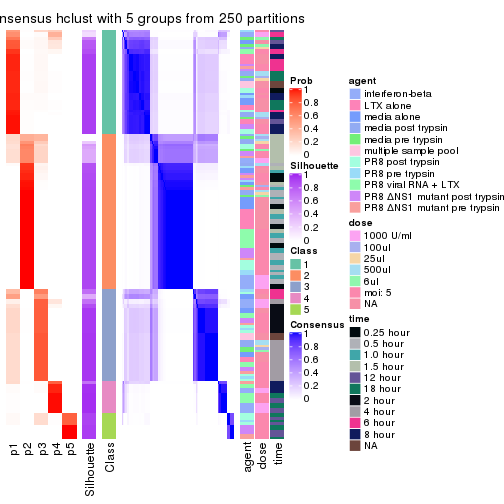
consensus_heatmap(res, k = 6)
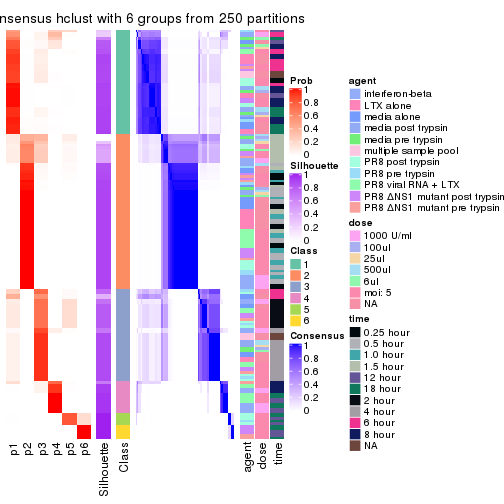
Heatmaps for the membership of samples in all partitions to see how consistent they are:
membership_heatmap(res, k = 2)
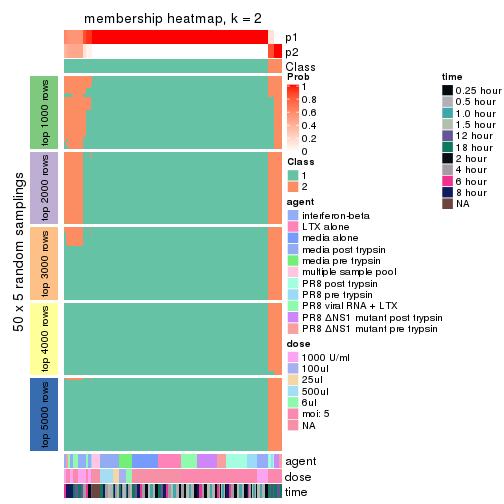
membership_heatmap(res, k = 3)
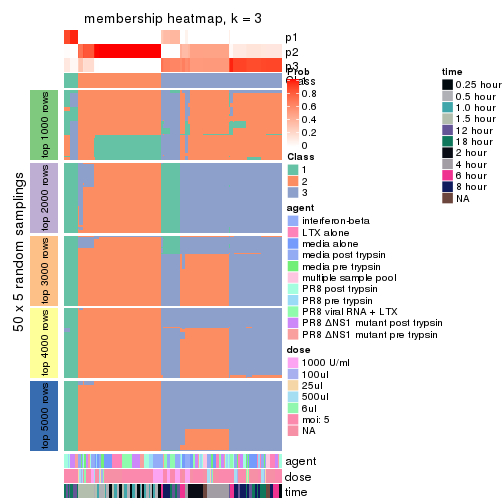
membership_heatmap(res, k = 4)
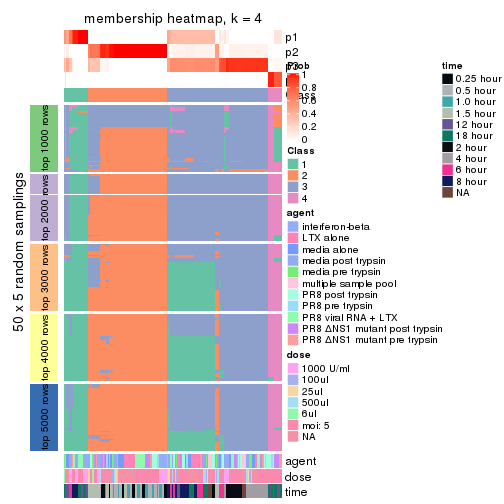
membership_heatmap(res, k = 5)
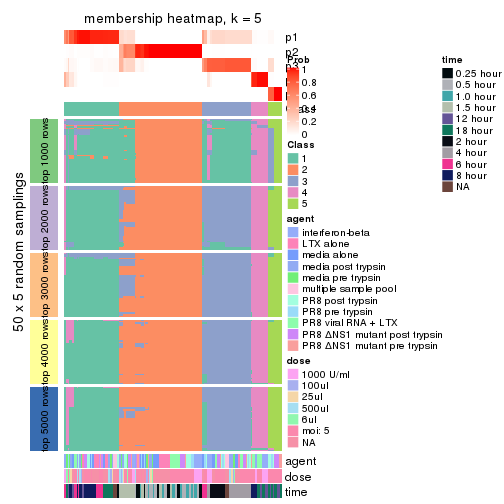
membership_heatmap(res, k = 6)
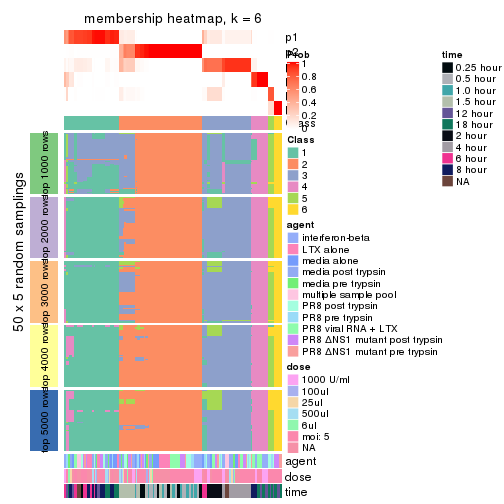
As soon as we have had the classes for columns, we can look for signatures which are significantly different between classes which can be candidate marks for certain classes. Following are the heatmaps for signatures.
Signature heatmaps where rows are scaled:
get_signatures(res, k = 2)
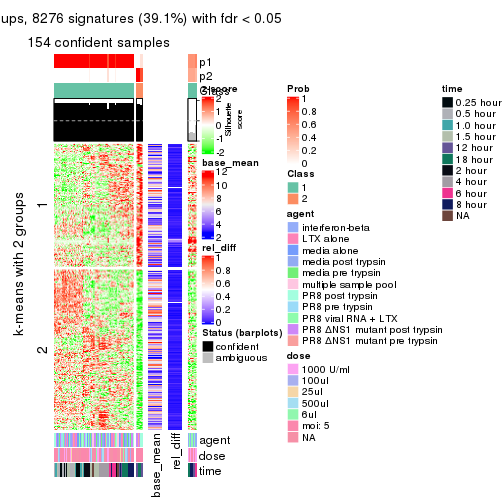
get_signatures(res, k = 3)
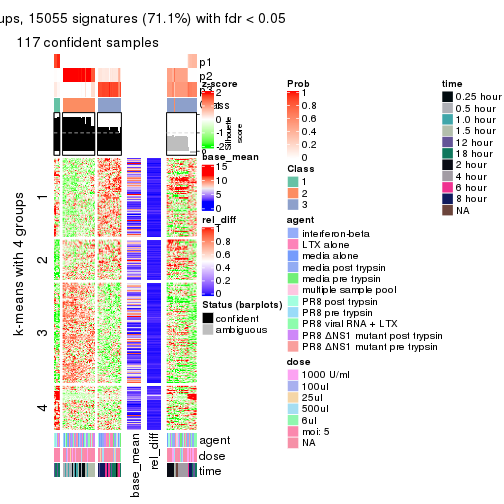
get_signatures(res, k = 4)
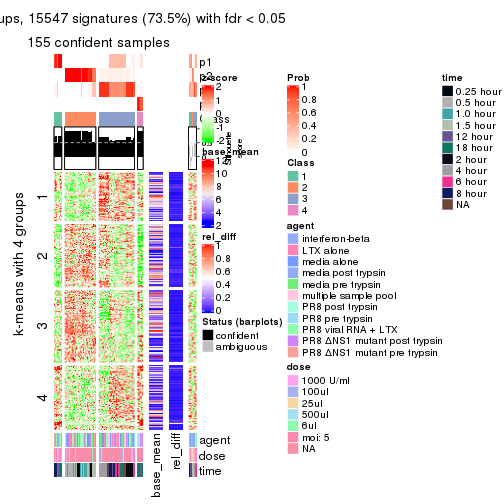
get_signatures(res, k = 5)
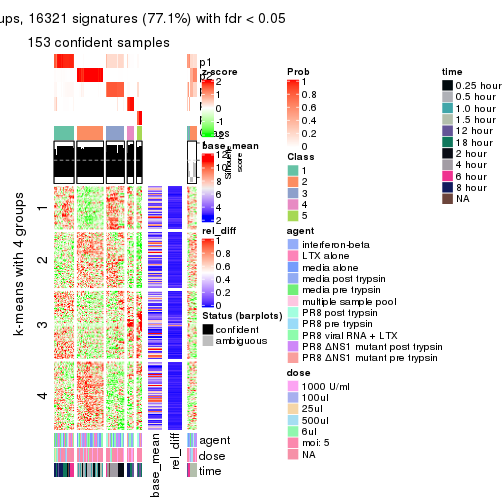
get_signatures(res, k = 6)
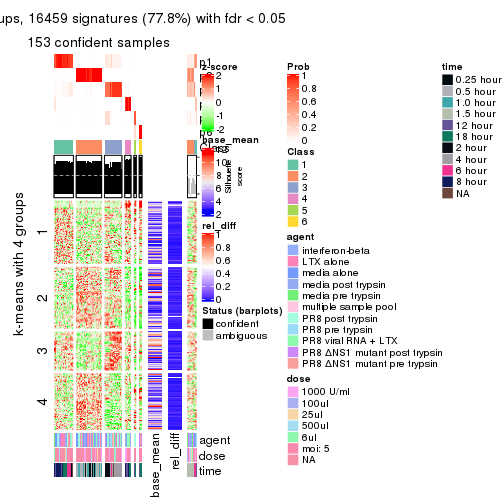
Signature heatmaps where rows are not scaled:
get_signatures(res, k = 2, scale_rows = FALSE)
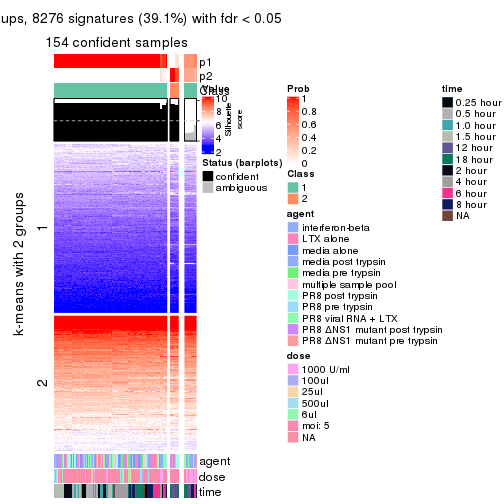
get_signatures(res, k = 3, scale_rows = FALSE)
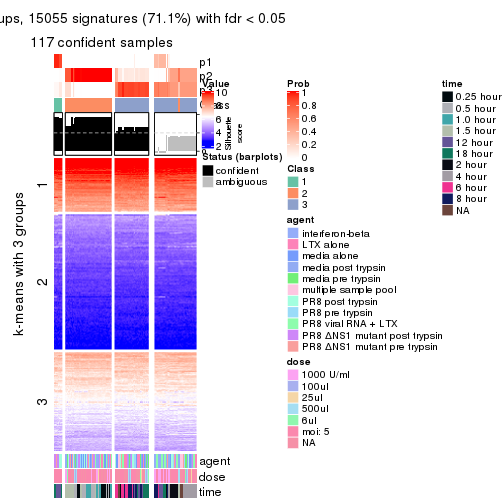
get_signatures(res, k = 4, scale_rows = FALSE)
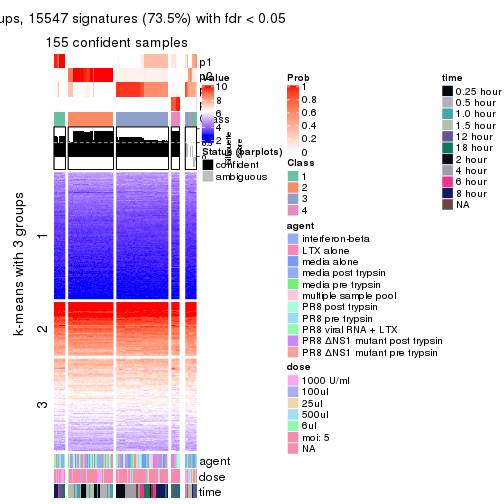
get_signatures(res, k = 5, scale_rows = FALSE)

get_signatures(res, k = 6, scale_rows = FALSE)
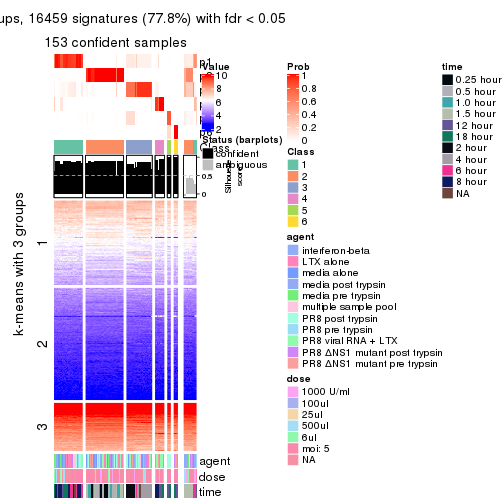
Compare the overlap of signatures from different k:
compare_signatures(res)
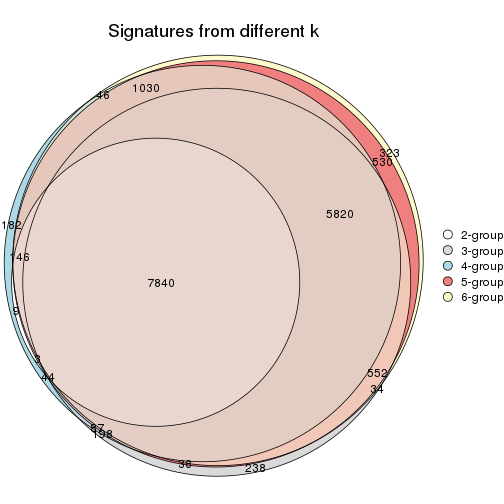
get_signature() returns a data frame invisibly. TO get the list of signatures, the function
call should be assigned to a variable explicitly. In following code, if plot argument is set
to FALSE, no heatmap is plotted while only the differential analysis is performed.
# code only for demonstration
tb = get_signature(res, k = ..., plot = FALSE)
An example of the output of tb is:
#> which_row fdr mean_1 mean_2 scaled_mean_1 scaled_mean_2 km
#> 1 38 0.042760348 8.373488 9.131774 -0.5533452 0.5164555 1
#> 2 40 0.018707592 7.106213 8.469186 -0.6173731 0.5762149 1
#> 3 55 0.019134737 10.221463 11.207825 -0.6159697 0.5749050 1
#> 4 59 0.006059896 5.921854 7.869574 -0.6899429 0.6439467 1
#> 5 60 0.018055526 8.928898 10.211722 -0.6204761 0.5791110 1
#> 6 98 0.009384629 15.714769 14.887706 0.6635654 -0.6193277 2
...
The columns in tb are:
which_row: row indices corresponding to the input matrix.fdr: FDR for the differential test. mean_x: The mean value in group x.scaled_mean_x: The mean value in group x after rows are scaled.km: Row groups if k-means clustering is applied to rows.UMAP plot which shows how samples are separated.
dimension_reduction(res, k = 2, method = "UMAP")
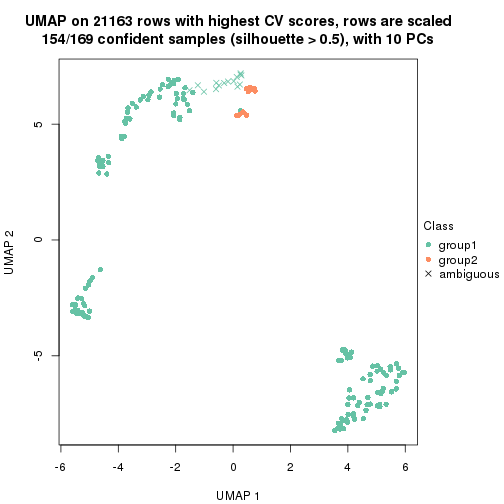
dimension_reduction(res, k = 3, method = "UMAP")
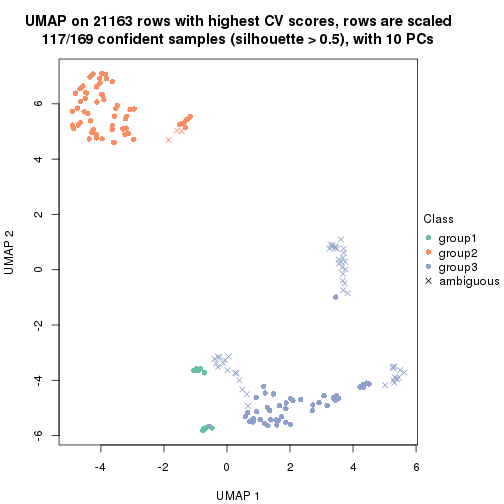
dimension_reduction(res, k = 4, method = "UMAP")
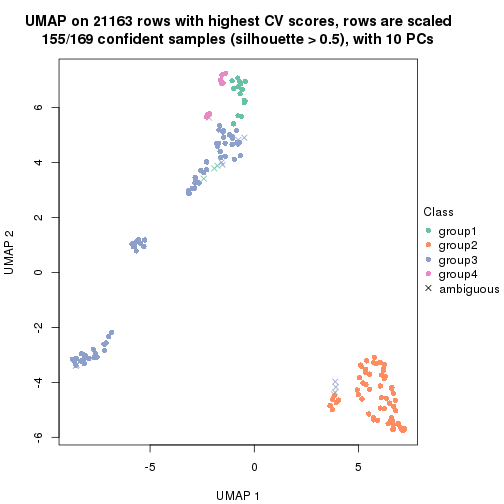
dimension_reduction(res, k = 5, method = "UMAP")
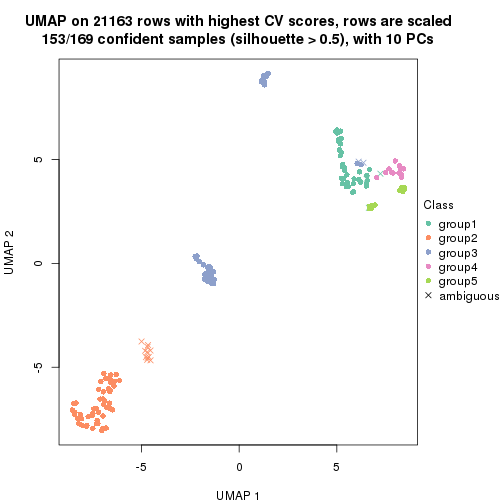
dimension_reduction(res, k = 6, method = "UMAP")
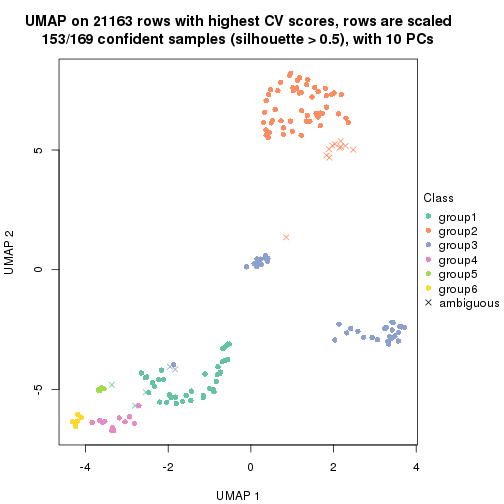
Following heatmap shows how subgroups are split when increasing k:
collect_classes(res)
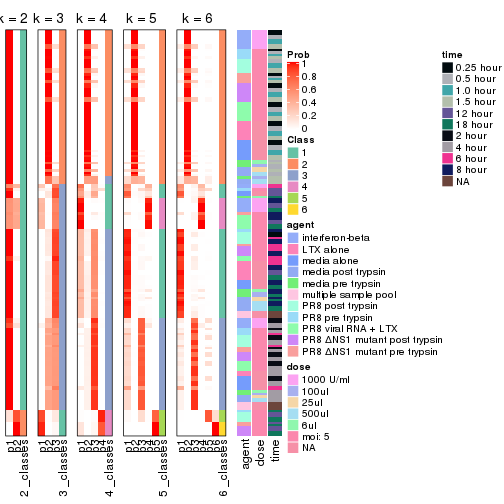
Test correlation between subgroups and known annotations. If the known annotation is numeric, one-way ANOVA test is applied, and if the known annotation is discrete, chi-squared contingency table test is applied.
test_to_known_factors(res)
#> n agent(p) dose(p) time(p) k
#> CV:hclust 154 2.50e-02 4.08e-02 1.49e-09 2
#> CV:hclust 117 1.15e-02 1.44e-02 5.97e-23 3
#> CV:hclust 155 1.63e-06 3.84e-05 1.20e-31 4
#> CV:hclust 153 1.35e-04 2.90e-03 2.68e-45 5
#> CV:hclust 153 1.08e-06 2.22e-02 4.52e-41 6
If matrix rows can be associated to genes, consider to use functional_enrichment(res,
...) to perform function enrichment for the signature genes. See this vignette for more detailed explanations.
The object with results only for a single top-value method and a single partition method can be extracted as:
res = res_list["CV", "kmeans"]
# you can also extract it by
# res = res_list["CV:kmeans"]
A summary of res and all the functions that can be applied to it:
res
#> A 'ConsensusPartition' object with k = 2, 3, 4, 5, 6.
#> On a matrix with 21163 rows and 169 columns.
#> Top rows (1000, 2000, 3000, 4000, 5000) are extracted by 'CV' method.
#> Subgroups are detected by 'kmeans' method.
#> Performed in total 1250 partitions by row resampling.
#> Best k for subgroups seems to be 2.
#>
#> Following methods can be applied to this 'ConsensusPartition' object:
#> [1] "cola_report" "collect_classes" "collect_plots"
#> [4] "collect_stats" "colnames" "compare_signatures"
#> [7] "consensus_heatmap" "dimension_reduction" "functional_enrichment"
#> [10] "get_anno_col" "get_anno" "get_classes"
#> [13] "get_consensus" "get_matrix" "get_membership"
#> [16] "get_param" "get_signatures" "get_stats"
#> [19] "is_best_k" "is_stable_k" "membership_heatmap"
#> [22] "ncol" "nrow" "plot_ecdf"
#> [25] "rownames" "select_partition_number" "show"
#> [28] "suggest_best_k" "test_to_known_factors"
collect_plots() function collects all the plots made from res for all k (number of partitions)
into one single page to provide an easy and fast comparison between different k.
collect_plots(res)
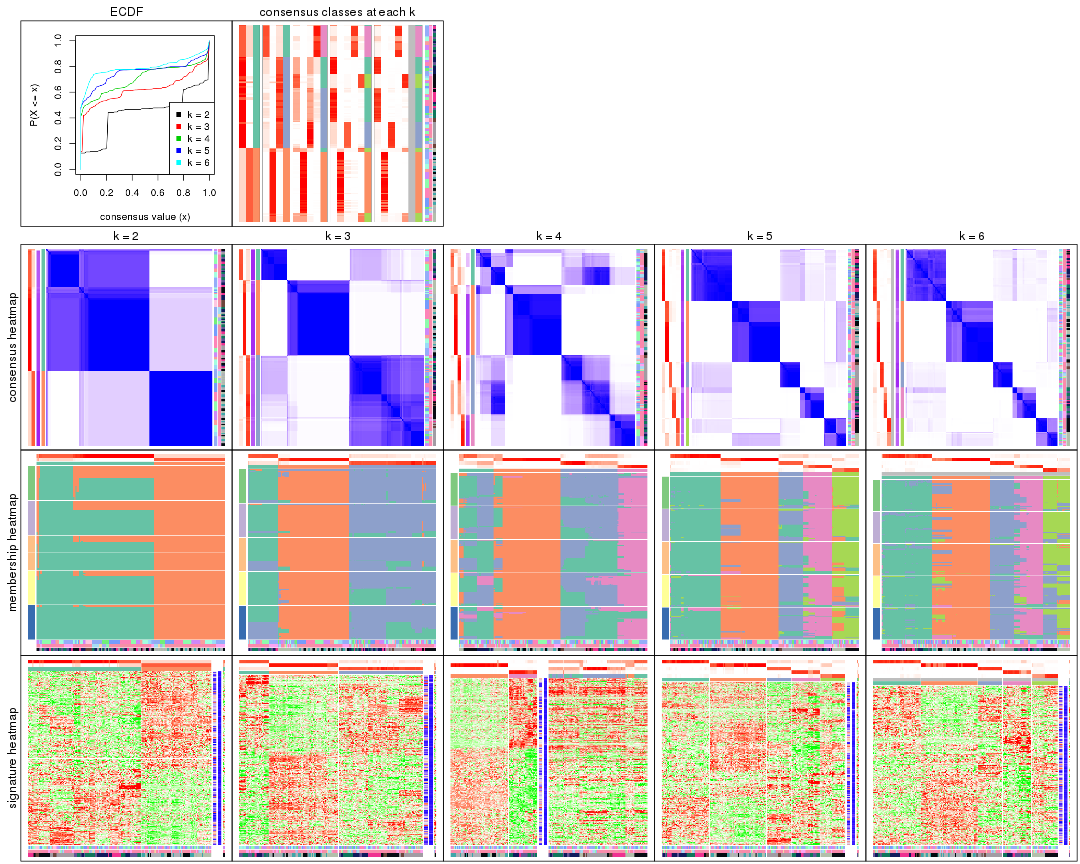
The plots are:
k and the heatmap of
predicted classes for each k.k.k.k.All the plots in panels can be made by individual functions and they are plotted later in this section.
select_partition_number() produces several plots showing different
statistics for choosing “optimized” k. There are following statistics:
k;k, the area increased is defined as \(A_k - A_{k-1}\).The detailed explanations of these statistics can be found in the cola vignette.
Generally speaking, lower PAC score, higher mean silhouette score or higher
concordance corresponds to better partition. Rand index and Jaccard index
measure how similar the current partition is compared to partition with k-1.
If they are too similar, we won't accept k is better than k-1.
select_partition_number(res)
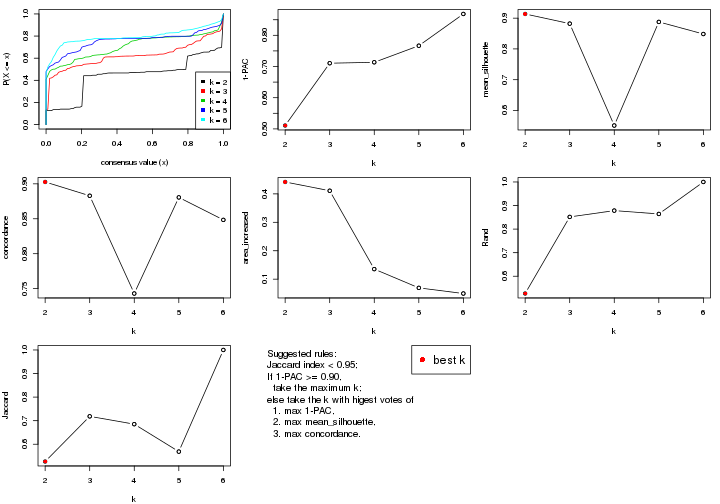
The numeric values for all these statistics can be obtained by get_stats().
get_stats(res)
#> k 1-PAC mean_silhouette concordance area_increased Rand Jaccard
#> 2 2 0.511 0.914 0.903 0.4419 0.527 0.527
#> 3 3 0.711 0.882 0.883 0.4110 0.852 0.718
#> 4 4 0.714 0.551 0.743 0.1353 0.878 0.685
#> 5 5 0.767 0.888 0.881 0.0693 0.864 0.569
#> 6 6 0.868 0.848 0.848 0.0495 1.000 1.000
suggest_best_k() suggests the best \(k\) based on these statistics. The rules are as follows:
suggest_best_k(res)
#> [1] 2
Following shows the table of the partitions (You need to click the show/hide
code output link to see it). The membership matrix (columns with name p*)
is inferred by
clue::cl_consensus()
function with the SE method. Basically the value in the membership matrix
represents the probability to belong to a certain group. The finall class
label for an item is determined with the group with highest probability it
belongs to.
In get_classes() function, the entropy is calculated from the membership
matrix and the silhouette score is calculated from the consensus matrix.
cbind(get_classes(res, k = 2), get_membership(res, k = 2))
#> class entropy silhouette p1 p2
#> GSM528681 2 0.7376 1.000 0.208 0.792
#> GSM528682 2 0.7376 1.000 0.208 0.792
#> GSM528683 2 0.7376 1.000 0.208 0.792
#> GSM528684 2 0.7376 1.000 0.208 0.792
#> GSM528687 2 0.7376 1.000 0.208 0.792
#> GSM528688 2 0.7376 1.000 0.208 0.792
#> GSM528685 2 0.7376 1.000 0.208 0.792
#> GSM528686 2 0.7376 1.000 0.208 0.792
#> GSM528693 1 0.0000 0.907 1.000 0.000
#> GSM528694 1 0.0000 0.907 1.000 0.000
#> GSM528695 1 0.6712 0.834 0.824 0.176
#> GSM528696 1 0.6712 0.834 0.824 0.176
#> GSM528697 1 0.7376 0.820 0.792 0.208
#> GSM528698 1 0.7376 0.820 0.792 0.208
#> GSM528699 1 0.7376 0.820 0.792 0.208
#> GSM528700 1 0.7376 0.820 0.792 0.208
#> GSM528689 1 0.7376 0.820 0.792 0.208
#> GSM528690 1 0.7376 0.820 0.792 0.208
#> GSM528691 1 0.7376 0.820 0.792 0.208
#> GSM528692 1 0.7376 0.820 0.792 0.208
#> GSM528779 2 0.7376 1.000 0.208 0.792
#> GSM528780 2 0.7376 1.000 0.208 0.792
#> GSM528782 2 0.7376 1.000 0.208 0.792
#> GSM528781 2 0.7376 1.000 0.208 0.792
#> GSM528785 1 0.5519 0.749 0.872 0.128
#> GSM528786 1 0.0000 0.907 1.000 0.000
#> GSM528787 1 0.0000 0.907 1.000 0.000
#> GSM528788 1 0.0000 0.907 1.000 0.000
#> GSM528783 1 0.5737 0.852 0.864 0.136
#> GSM528784 1 0.7376 0.820 0.792 0.208
#> GSM528759 1 0.0000 0.907 1.000 0.000
#> GSM528760 1 0.0000 0.907 1.000 0.000
#> GSM528761 2 0.7376 1.000 0.208 0.792
#> GSM528762 2 0.7376 1.000 0.208 0.792
#> GSM528765 2 0.7376 1.000 0.208 0.792
#> GSM528766 2 0.7376 1.000 0.208 0.792
#> GSM528763 2 0.7376 1.000 0.208 0.792
#> GSM528764 2 0.7376 1.000 0.208 0.792
#> GSM528771 1 0.5059 0.774 0.888 0.112
#> GSM528772 1 0.4022 0.820 0.920 0.080
#> GSM528773 1 0.0000 0.907 1.000 0.000
#> GSM528774 1 0.0000 0.907 1.000 0.000
#> GSM528775 1 0.0000 0.907 1.000 0.000
#> GSM528776 1 0.2423 0.893 0.960 0.040
#> GSM528777 1 0.2778 0.890 0.952 0.048
#> GSM528778 1 0.2778 0.890 0.952 0.048
#> GSM528767 1 0.7376 0.820 0.792 0.208
#> GSM528768 1 0.7376 0.820 0.792 0.208
#> GSM528769 1 0.7376 0.820 0.792 0.208
#> GSM528770 1 0.7376 0.820 0.792 0.208
#> GSM528671 2 0.7376 1.000 0.208 0.792
#> GSM528672 2 0.7376 1.000 0.208 0.792
#> GSM528674 2 0.7376 1.000 0.208 0.792
#> GSM528673 2 0.7376 1.000 0.208 0.792
#> GSM528677 1 0.0000 0.907 1.000 0.000
#> GSM528678 1 0.0000 0.907 1.000 0.000
#> GSM528679 1 0.3879 0.878 0.924 0.076
#> GSM528680 1 0.7376 0.820 0.792 0.208
#> GSM528675 1 0.7376 0.820 0.792 0.208
#> GSM528676 1 0.7376 0.820 0.792 0.208
#> GSM528651 2 0.7376 1.000 0.208 0.792
#> GSM528652 2 0.7376 1.000 0.208 0.792
#> GSM528653 2 0.7376 1.000 0.208 0.792
#> GSM528654 2 0.7376 1.000 0.208 0.792
#> GSM528657 2 0.7376 1.000 0.208 0.792
#> GSM528658 2 0.7376 1.000 0.208 0.792
#> GSM528655 2 0.7376 1.000 0.208 0.792
#> GSM528656 2 0.7376 1.000 0.208 0.792
#> GSM528663 1 0.8327 0.459 0.736 0.264
#> GSM528664 1 0.9909 -0.234 0.556 0.444
#> GSM528665 1 0.0000 0.907 1.000 0.000
#> GSM528666 1 0.0000 0.907 1.000 0.000
#> GSM528667 1 0.0000 0.907 1.000 0.000
#> GSM528668 1 0.0000 0.907 1.000 0.000
#> GSM528669 1 0.0938 0.903 0.988 0.012
#> GSM528670 1 0.0672 0.904 0.992 0.008
#> GSM528659 1 0.7376 0.820 0.792 0.208
#> GSM528660 1 0.7376 0.820 0.792 0.208
#> GSM528661 1 0.7376 0.820 0.792 0.208
#> GSM528662 1 0.7376 0.820 0.792 0.208
#> GSM528701 2 0.7376 1.000 0.208 0.792
#> GSM528702 2 0.7376 1.000 0.208 0.792
#> GSM528703 2 0.7376 1.000 0.208 0.792
#> GSM528704 2 0.7376 1.000 0.208 0.792
#> GSM528707 2 0.7376 1.000 0.208 0.792
#> GSM528708 2 0.7376 1.000 0.208 0.792
#> GSM528705 2 0.7376 1.000 0.208 0.792
#> GSM528706 2 0.7376 1.000 0.208 0.792
#> GSM528713 1 0.0000 0.907 1.000 0.000
#> GSM528714 1 0.0000 0.907 1.000 0.000
#> GSM528715 1 0.0000 0.907 1.000 0.000
#> GSM528716 1 0.0000 0.907 1.000 0.000
#> GSM528717 1 0.7376 0.820 0.792 0.208
#> GSM528718 1 0.7376 0.820 0.792 0.208
#> GSM528719 1 0.7376 0.820 0.792 0.208
#> GSM528720 1 0.7376 0.820 0.792 0.208
#> GSM528709 1 0.7376 0.820 0.792 0.208
#> GSM528710 1 0.7376 0.820 0.792 0.208
#> GSM528711 1 0.7376 0.820 0.792 0.208
#> GSM528712 1 0.7376 0.820 0.792 0.208
#> GSM528721 2 0.7376 1.000 0.208 0.792
#> GSM528722 2 0.7376 1.000 0.208 0.792
#> GSM528723 2 0.7376 1.000 0.208 0.792
#> GSM528724 2 0.7376 1.000 0.208 0.792
#> GSM528727 2 0.7376 1.000 0.208 0.792
#> GSM528728 2 0.7376 1.000 0.208 0.792
#> GSM528725 2 0.7376 1.000 0.208 0.792
#> GSM528726 2 0.7376 1.000 0.208 0.792
#> GSM528733 1 0.0000 0.907 1.000 0.000
#> GSM528734 1 0.0000 0.907 1.000 0.000
#> GSM528735 1 0.0000 0.907 1.000 0.000
#> GSM528736 1 0.0000 0.907 1.000 0.000
#> GSM528737 1 0.0000 0.907 1.000 0.000
#> GSM528738 1 0.0000 0.907 1.000 0.000
#> GSM528729 1 0.0000 0.907 1.000 0.000
#> GSM528730 1 0.0000 0.907 1.000 0.000
#> GSM528731 1 0.0000 0.907 1.000 0.000
#> GSM528732 1 0.0000 0.907 1.000 0.000
#> GSM528739 2 0.7376 1.000 0.208 0.792
#> GSM528740 2 0.7376 1.000 0.208 0.792
#> GSM528741 2 0.7376 1.000 0.208 0.792
#> GSM528742 2 0.7376 1.000 0.208 0.792
#> GSM528745 2 0.7376 1.000 0.208 0.792
#> GSM528746 2 0.7376 1.000 0.208 0.792
#> GSM528743 2 0.7376 1.000 0.208 0.792
#> GSM528744 2 0.7376 1.000 0.208 0.792
#> GSM528751 1 0.4022 0.820 0.920 0.080
#> GSM528752 1 0.2778 0.858 0.952 0.048
#> GSM528753 1 0.0000 0.907 1.000 0.000
#> GSM528754 1 0.0000 0.907 1.000 0.000
#> GSM528755 1 0.0000 0.907 1.000 0.000
#> GSM528756 1 0.0000 0.907 1.000 0.000
#> GSM528757 1 0.0000 0.907 1.000 0.000
#> GSM528758 1 0.0000 0.907 1.000 0.000
#> GSM528747 1 0.0000 0.907 1.000 0.000
#> GSM528748 1 0.0000 0.907 1.000 0.000
#> GSM528749 1 0.0000 0.907 1.000 0.000
#> GSM528750 1 0.0000 0.907 1.000 0.000
#> GSM528640 2 0.7376 1.000 0.208 0.792
#> GSM528641 2 0.7376 1.000 0.208 0.792
#> GSM528643 1 0.0000 0.907 1.000 0.000
#> GSM528644 1 0.0000 0.907 1.000 0.000
#> GSM528642 1 0.0000 0.907 1.000 0.000
#> GSM528620 2 0.7376 1.000 0.208 0.792
#> GSM528621 2 0.7376 1.000 0.208 0.792
#> GSM528623 1 0.0000 0.907 1.000 0.000
#> GSM528624 1 0.0000 0.907 1.000 0.000
#> GSM528622 1 0.0000 0.907 1.000 0.000
#> GSM528625 2 0.7376 1.000 0.208 0.792
#> GSM528626 2 0.7376 1.000 0.208 0.792
#> GSM528628 1 0.0000 0.907 1.000 0.000
#> GSM528629 1 0.0000 0.907 1.000 0.000
#> GSM528627 1 0.0000 0.907 1.000 0.000
#> GSM528630 2 0.7376 1.000 0.208 0.792
#> GSM528631 2 0.7376 1.000 0.208 0.792
#> GSM528632 2 0.7376 1.000 0.208 0.792
#> GSM528633 2 0.7376 1.000 0.208 0.792
#> GSM528636 1 0.0000 0.907 1.000 0.000
#> GSM528637 1 0.0000 0.907 1.000 0.000
#> GSM528638 1 0.0000 0.907 1.000 0.000
#> GSM528639 1 0.0000 0.907 1.000 0.000
#> GSM528634 1 0.0000 0.907 1.000 0.000
#> GSM528635 1 0.0000 0.907 1.000 0.000
#> GSM528645 1 0.0000 0.907 1.000 0.000
#> GSM528646 1 0.0000 0.907 1.000 0.000
#> GSM528647 1 0.0000 0.907 1.000 0.000
#> GSM528648 1 0.0000 0.907 1.000 0.000
#> GSM528649 1 0.0000 0.907 1.000 0.000
#> GSM528650 1 0.0000 0.907 1.000 0.000
cbind(get_classes(res, k = 3), get_membership(res, k = 3))
#> class entropy silhouette p1 p2 p3
#> GSM528681 2 0.0747 0.973 0.000 0.984 0.016
#> GSM528682 2 0.0747 0.973 0.000 0.984 0.016
#> GSM528683 2 0.0747 0.973 0.000 0.984 0.016
#> GSM528684 2 0.0747 0.973 0.000 0.984 0.016
#> GSM528687 2 0.0747 0.973 0.000 0.984 0.016
#> GSM528688 2 0.0747 0.973 0.000 0.984 0.016
#> GSM528685 2 0.2599 0.937 0.052 0.932 0.016
#> GSM528686 2 0.4609 0.876 0.052 0.856 0.092
#> GSM528693 3 0.2261 0.825 0.068 0.000 0.932
#> GSM528694 3 0.2261 0.825 0.068 0.000 0.932
#> GSM528695 3 0.4605 0.733 0.204 0.000 0.796
#> GSM528696 3 0.4605 0.733 0.204 0.000 0.796
#> GSM528697 1 0.3816 0.984 0.852 0.000 0.148
#> GSM528698 1 0.3816 0.984 0.852 0.000 0.148
#> GSM528699 1 0.3816 0.984 0.852 0.000 0.148
#> GSM528700 1 0.3816 0.984 0.852 0.000 0.148
#> GSM528689 1 0.3816 0.984 0.852 0.000 0.148
#> GSM528690 1 0.3816 0.984 0.852 0.000 0.148
#> GSM528691 1 0.3816 0.984 0.852 0.000 0.148
#> GSM528692 1 0.3816 0.984 0.852 0.000 0.148
#> GSM528779 2 0.0747 0.973 0.000 0.984 0.016
#> GSM528780 2 0.0747 0.973 0.000 0.984 0.016
#> GSM528782 2 0.0747 0.973 0.000 0.984 0.016
#> GSM528781 2 0.0747 0.973 0.000 0.984 0.016
#> GSM528785 3 0.4288 0.782 0.068 0.060 0.872
#> GSM528786 3 0.3816 0.780 0.148 0.000 0.852
#> GSM528787 3 0.3038 0.806 0.104 0.000 0.896
#> GSM528788 3 0.4121 0.803 0.168 0.000 0.832
#> GSM528783 1 0.6180 0.675 0.660 0.008 0.332
#> GSM528784 1 0.4514 0.978 0.832 0.012 0.156
#> GSM528759 3 0.0747 0.835 0.016 0.000 0.984
#> GSM528760 3 0.1163 0.832 0.028 0.000 0.972
#> GSM528761 2 0.0747 0.973 0.000 0.984 0.016
#> GSM528762 2 0.0747 0.973 0.000 0.984 0.016
#> GSM528765 2 0.0747 0.973 0.000 0.984 0.016
#> GSM528766 2 0.0747 0.973 0.000 0.984 0.016
#> GSM528763 2 0.0983 0.970 0.004 0.980 0.016
#> GSM528764 2 0.4609 0.876 0.052 0.856 0.092
#> GSM528771 3 0.2261 0.825 0.068 0.000 0.932
#> GSM528772 3 0.2261 0.825 0.068 0.000 0.932
#> GSM528773 3 0.3941 0.777 0.156 0.000 0.844
#> GSM528774 3 0.3752 0.786 0.144 0.000 0.856
#> GSM528775 3 0.1964 0.835 0.056 0.000 0.944
#> GSM528776 3 0.4121 0.803 0.168 0.000 0.832
#> GSM528777 3 0.5216 0.671 0.260 0.000 0.740
#> GSM528778 3 0.5216 0.671 0.260 0.000 0.740
#> GSM528767 1 0.4575 0.977 0.828 0.012 0.160
#> GSM528768 1 0.4575 0.977 0.828 0.012 0.160
#> GSM528769 1 0.4514 0.978 0.832 0.012 0.156
#> GSM528770 1 0.4514 0.978 0.832 0.012 0.156
#> GSM528671 2 0.0747 0.973 0.000 0.984 0.016
#> GSM528672 2 0.0747 0.973 0.000 0.984 0.016
#> GSM528674 2 0.0747 0.973 0.000 0.984 0.016
#> GSM528673 2 0.4527 0.879 0.052 0.860 0.088
#> GSM528677 3 0.1964 0.822 0.056 0.000 0.944
#> GSM528678 3 0.3816 0.780 0.148 0.000 0.852
#> GSM528679 3 0.4178 0.799 0.172 0.000 0.828
#> GSM528680 1 0.4002 0.975 0.840 0.000 0.160
#> GSM528675 1 0.4539 0.981 0.836 0.016 0.148
#> GSM528676 1 0.4539 0.981 0.836 0.016 0.148
#> GSM528651 2 0.0747 0.973 0.000 0.984 0.016
#> GSM528652 2 0.0747 0.973 0.000 0.984 0.016
#> GSM528653 2 0.0747 0.973 0.000 0.984 0.016
#> GSM528654 2 0.0747 0.973 0.000 0.984 0.016
#> GSM528657 2 0.0747 0.973 0.000 0.984 0.016
#> GSM528658 2 0.0747 0.973 0.000 0.984 0.016
#> GSM528655 2 0.4443 0.883 0.052 0.864 0.084
#> GSM528656 2 0.3993 0.901 0.052 0.884 0.064
#> GSM528663 3 0.5166 0.720 0.056 0.116 0.828
#> GSM528664 3 0.7124 0.484 0.056 0.272 0.672
#> GSM528665 3 0.3116 0.806 0.108 0.000 0.892
#> GSM528666 3 0.3116 0.806 0.108 0.000 0.892
#> GSM528667 3 0.4121 0.803 0.168 0.000 0.832
#> GSM528668 3 0.4121 0.803 0.168 0.000 0.832
#> GSM528669 3 0.4121 0.803 0.168 0.000 0.832
#> GSM528670 3 0.4121 0.803 0.168 0.000 0.832
#> GSM528659 1 0.4539 0.981 0.836 0.016 0.148
#> GSM528660 1 0.4539 0.981 0.836 0.016 0.148
#> GSM528661 1 0.4539 0.981 0.836 0.016 0.148
#> GSM528662 1 0.4539 0.981 0.836 0.016 0.148
#> GSM528701 2 0.0747 0.973 0.000 0.984 0.016
#> GSM528702 2 0.0747 0.973 0.000 0.984 0.016
#> GSM528703 2 0.0747 0.973 0.000 0.984 0.016
#> GSM528704 2 0.0747 0.973 0.000 0.984 0.016
#> GSM528707 2 0.0747 0.973 0.000 0.984 0.016
#> GSM528708 2 0.0747 0.973 0.000 0.984 0.016
#> GSM528705 2 0.0747 0.973 0.000 0.984 0.016
#> GSM528706 2 0.0747 0.973 0.000 0.984 0.016
#> GSM528713 3 0.2261 0.825 0.068 0.000 0.932
#> GSM528714 3 0.1964 0.822 0.056 0.000 0.944
#> GSM528715 3 0.3116 0.806 0.108 0.000 0.892
#> GSM528716 3 0.3116 0.806 0.108 0.000 0.892
#> GSM528717 3 0.4346 0.786 0.184 0.000 0.816
#> GSM528718 3 0.4178 0.801 0.172 0.000 0.828
#> GSM528719 1 0.3816 0.984 0.852 0.000 0.148
#> GSM528720 1 0.3816 0.984 0.852 0.000 0.148
#> GSM528709 1 0.3816 0.984 0.852 0.000 0.148
#> GSM528710 1 0.3816 0.984 0.852 0.000 0.148
#> GSM528711 1 0.3816 0.984 0.852 0.000 0.148
#> GSM528712 1 0.3816 0.984 0.852 0.000 0.148
#> GSM528721 2 0.0747 0.973 0.000 0.984 0.016
#> GSM528722 2 0.0747 0.973 0.000 0.984 0.016
#> GSM528723 2 0.0747 0.973 0.000 0.984 0.016
#> GSM528724 2 0.0747 0.973 0.000 0.984 0.016
#> GSM528727 2 0.0747 0.973 0.000 0.984 0.016
#> GSM528728 2 0.0747 0.973 0.000 0.984 0.016
#> GSM528725 2 0.0747 0.973 0.000 0.984 0.016
#> GSM528726 2 0.0747 0.973 0.000 0.984 0.016
#> GSM528733 3 0.3116 0.806 0.108 0.000 0.892
#> GSM528734 3 0.3116 0.806 0.108 0.000 0.892
#> GSM528735 3 0.1964 0.835 0.056 0.000 0.944
#> GSM528736 3 0.1964 0.835 0.056 0.000 0.944
#> GSM528737 3 0.4121 0.803 0.168 0.000 0.832
#> GSM528738 3 0.3941 0.809 0.156 0.000 0.844
#> GSM528729 3 0.4121 0.803 0.168 0.000 0.832
#> GSM528730 3 0.4121 0.803 0.168 0.000 0.832
#> GSM528731 3 0.4121 0.803 0.168 0.000 0.832
#> GSM528732 3 0.4002 0.807 0.160 0.000 0.840
#> GSM528739 2 0.0747 0.973 0.000 0.984 0.016
#> GSM528740 2 0.0747 0.973 0.000 0.984 0.016
#> GSM528741 2 0.0747 0.973 0.000 0.984 0.016
#> GSM528742 2 0.0747 0.973 0.000 0.984 0.016
#> GSM528745 2 0.0747 0.973 0.000 0.984 0.016
#> GSM528746 2 0.0747 0.973 0.000 0.984 0.016
#> GSM528743 2 0.0747 0.973 0.000 0.984 0.016
#> GSM528744 2 0.0747 0.973 0.000 0.984 0.016
#> GSM528751 3 0.2261 0.825 0.068 0.000 0.932
#> GSM528752 3 0.2261 0.825 0.068 0.000 0.932
#> GSM528753 3 0.3116 0.806 0.108 0.000 0.892
#> GSM528754 3 0.3116 0.806 0.108 0.000 0.892
#> GSM528755 3 0.1964 0.835 0.056 0.000 0.944
#> GSM528756 3 0.1964 0.835 0.056 0.000 0.944
#> GSM528757 3 0.4121 0.803 0.168 0.000 0.832
#> GSM528758 3 0.4121 0.803 0.168 0.000 0.832
#> GSM528747 3 0.4121 0.803 0.168 0.000 0.832
#> GSM528748 3 0.4002 0.807 0.160 0.000 0.840
#> GSM528749 3 0.3941 0.809 0.156 0.000 0.844
#> GSM528750 3 0.4121 0.803 0.168 0.000 0.832
#> GSM528640 2 0.0747 0.973 0.000 0.984 0.016
#> GSM528641 2 0.4609 0.876 0.052 0.856 0.092
#> GSM528643 3 0.3116 0.806 0.108 0.000 0.892
#> GSM528644 3 0.4062 0.805 0.164 0.000 0.836
#> GSM528642 3 0.3879 0.822 0.152 0.000 0.848
#> GSM528620 2 0.0747 0.973 0.000 0.984 0.016
#> GSM528621 2 0.7736 0.354 0.052 0.548 0.400
#> GSM528623 3 0.3116 0.806 0.108 0.000 0.892
#> GSM528624 3 0.4121 0.803 0.168 0.000 0.832
#> GSM528622 3 0.4121 0.803 0.168 0.000 0.832
#> GSM528625 2 0.0747 0.973 0.000 0.984 0.016
#> GSM528626 2 0.4609 0.876 0.052 0.856 0.092
#> GSM528628 3 0.3116 0.806 0.108 0.000 0.892
#> GSM528629 3 0.4121 0.803 0.168 0.000 0.832
#> GSM528627 3 0.3879 0.810 0.152 0.000 0.848
#> GSM528630 2 0.0747 0.973 0.000 0.984 0.016
#> GSM528631 2 0.0747 0.973 0.000 0.984 0.016
#> GSM528632 2 0.5536 0.822 0.052 0.804 0.144
#> GSM528633 2 0.5536 0.822 0.052 0.804 0.144
#> GSM528636 3 0.3116 0.806 0.108 0.000 0.892
#> GSM528637 3 0.3116 0.806 0.108 0.000 0.892
#> GSM528638 3 0.4121 0.803 0.168 0.000 0.832
#> GSM528639 3 0.4121 0.803 0.168 0.000 0.832
#> GSM528634 3 0.3340 0.821 0.120 0.000 0.880
#> GSM528635 3 0.3941 0.809 0.156 0.000 0.844
#> GSM528645 3 0.3941 0.777 0.156 0.000 0.844
#> GSM528646 3 0.3941 0.777 0.156 0.000 0.844
#> GSM528647 3 0.3816 0.780 0.148 0.000 0.852
#> GSM528648 3 0.0747 0.835 0.016 0.000 0.984
#> GSM528649 3 0.0747 0.835 0.016 0.000 0.984
#> GSM528650 3 0.2066 0.834 0.060 0.000 0.940
cbind(get_classes(res, k = 4), get_membership(res, k = 4))
#> class entropy silhouette p1 p2 p3 p4
#> GSM528681 2 0.0000 0.9277 0.000 1.000 0.000 0.000
#> GSM528682 2 0.0000 0.9277 0.000 1.000 0.000 0.000
#> GSM528683 2 0.0000 0.9277 0.000 1.000 0.000 0.000
#> GSM528684 2 0.0000 0.9277 0.000 1.000 0.000 0.000
#> GSM528687 2 0.0000 0.9277 0.000 1.000 0.000 0.000
#> GSM528688 2 0.0000 0.9277 0.000 1.000 0.000 0.000
#> GSM528685 2 0.4972 0.4289 0.456 0.544 0.000 0.000
#> GSM528686 2 0.6452 0.3066 0.460 0.472 0.068 0.000
#> GSM528693 1 0.3764 0.3386 0.784 0.000 0.216 0.000
#> GSM528694 1 0.3764 0.3386 0.784 0.000 0.216 0.000
#> GSM528695 3 0.0592 0.4774 0.000 0.000 0.984 0.016
#> GSM528696 3 0.0592 0.4774 0.000 0.000 0.984 0.016
#> GSM528697 4 0.0657 0.9405 0.004 0.000 0.012 0.984
#> GSM528698 4 0.0657 0.9405 0.004 0.000 0.012 0.984
#> GSM528699 4 0.0657 0.9405 0.004 0.000 0.012 0.984
#> GSM528700 4 0.0657 0.9405 0.004 0.000 0.012 0.984
#> GSM528689 4 0.0657 0.9405 0.004 0.000 0.012 0.984
#> GSM528690 4 0.0657 0.9405 0.004 0.000 0.012 0.984
#> GSM528691 4 0.0657 0.9405 0.004 0.000 0.012 0.984
#> GSM528692 4 0.0657 0.9405 0.004 0.000 0.012 0.984
#> GSM528779 2 0.0336 0.9264 0.008 0.992 0.000 0.000
#> GSM528780 2 0.0804 0.9239 0.008 0.980 0.000 0.012
#> GSM528782 2 0.0000 0.9277 0.000 1.000 0.000 0.000
#> GSM528781 2 0.0937 0.9230 0.012 0.976 0.000 0.012
#> GSM528785 1 0.3367 0.3176 0.864 0.028 0.108 0.000
#> GSM528786 3 0.1557 0.4381 0.056 0.000 0.944 0.000
#> GSM528787 3 0.4585 0.3498 0.332 0.000 0.668 0.000
#> GSM528788 1 0.7188 -0.2447 0.436 0.000 0.428 0.136
#> GSM528783 4 0.7065 0.3472 0.212 0.000 0.216 0.572
#> GSM528784 4 0.4050 0.8457 0.168 0.000 0.024 0.808
#> GSM528759 3 0.6079 0.3393 0.408 0.000 0.544 0.048
#> GSM528760 3 0.5619 0.3482 0.320 0.000 0.640 0.040
#> GSM528761 2 0.0804 0.9239 0.008 0.980 0.000 0.012
#> GSM528762 2 0.0000 0.9277 0.000 1.000 0.000 0.000
#> GSM528765 2 0.0937 0.9230 0.012 0.976 0.000 0.012
#> GSM528766 2 0.0804 0.9239 0.008 0.980 0.000 0.012
#> GSM528763 2 0.4713 0.5610 0.360 0.640 0.000 0.000
#> GSM528764 2 0.6452 0.3066 0.460 0.472 0.068 0.000
#> GSM528771 1 0.3764 0.3386 0.784 0.000 0.216 0.000
#> GSM528772 1 0.3764 0.3386 0.784 0.000 0.216 0.000
#> GSM528773 3 0.0707 0.4744 0.020 0.000 0.980 0.000
#> GSM528774 3 0.0592 0.4781 0.016 0.000 0.984 0.000
#> GSM528775 3 0.6310 0.3375 0.428 0.000 0.512 0.060
#> GSM528776 3 0.7187 0.2350 0.424 0.000 0.440 0.136
#> GSM528777 1 0.7179 -0.2369 0.456 0.000 0.408 0.136
#> GSM528778 1 0.7179 -0.2369 0.456 0.000 0.408 0.136
#> GSM528767 4 0.4050 0.8457 0.168 0.000 0.024 0.808
#> GSM528768 4 0.4050 0.8457 0.168 0.000 0.024 0.808
#> GSM528769 4 0.4050 0.8457 0.168 0.000 0.024 0.808
#> GSM528770 4 0.4050 0.8457 0.168 0.000 0.024 0.808
#> GSM528671 2 0.0937 0.9230 0.012 0.976 0.000 0.012
#> GSM528672 2 0.0000 0.9277 0.000 1.000 0.000 0.000
#> GSM528674 2 0.0804 0.9239 0.008 0.980 0.000 0.012
#> GSM528673 2 0.6452 0.3066 0.460 0.472 0.068 0.000
#> GSM528677 1 0.3649 0.3360 0.796 0.000 0.204 0.000
#> GSM528678 3 0.1557 0.4381 0.056 0.000 0.944 0.000
#> GSM528679 3 0.7184 0.2532 0.416 0.000 0.448 0.136
#> GSM528680 4 0.1284 0.9317 0.024 0.000 0.012 0.964
#> GSM528675 4 0.1938 0.9305 0.052 0.000 0.012 0.936
#> GSM528676 4 0.1938 0.9305 0.052 0.000 0.012 0.936
#> GSM528651 2 0.0937 0.9230 0.012 0.976 0.000 0.012
#> GSM528652 2 0.0937 0.9230 0.012 0.976 0.000 0.012
#> GSM528653 2 0.0000 0.9277 0.000 1.000 0.000 0.000
#> GSM528654 2 0.0000 0.9277 0.000 1.000 0.000 0.000
#> GSM528657 2 0.0937 0.9230 0.012 0.976 0.000 0.012
#> GSM528658 2 0.0000 0.9277 0.000 1.000 0.000 0.000
#> GSM528655 2 0.6452 0.3066 0.460 0.472 0.068 0.000
#> GSM528656 2 0.6334 0.3303 0.456 0.484 0.060 0.000
#> GSM528663 1 0.4549 0.3285 0.776 0.036 0.188 0.000
#> GSM528664 1 0.5100 0.3157 0.756 0.076 0.168 0.000
#> GSM528665 3 0.0000 0.4878 0.000 0.000 1.000 0.000
#> GSM528666 3 0.0000 0.4878 0.000 0.000 1.000 0.000
#> GSM528667 3 0.7184 0.2532 0.416 0.000 0.448 0.136
#> GSM528668 3 0.7184 0.2532 0.416 0.000 0.448 0.136
#> GSM528669 1 0.7187 -0.2408 0.440 0.000 0.424 0.136
#> GSM528670 1 0.7187 -0.2408 0.440 0.000 0.424 0.136
#> GSM528659 4 0.1938 0.9305 0.052 0.000 0.012 0.936
#> GSM528660 4 0.1938 0.9305 0.052 0.000 0.012 0.936
#> GSM528661 4 0.1938 0.9305 0.052 0.000 0.012 0.936
#> GSM528662 4 0.1938 0.9305 0.052 0.000 0.012 0.936
#> GSM528701 2 0.0000 0.9277 0.000 1.000 0.000 0.000
#> GSM528702 2 0.0000 0.9277 0.000 1.000 0.000 0.000
#> GSM528703 2 0.0000 0.9277 0.000 1.000 0.000 0.000
#> GSM528704 2 0.0000 0.9277 0.000 1.000 0.000 0.000
#> GSM528707 2 0.0000 0.9277 0.000 1.000 0.000 0.000
#> GSM528708 2 0.0000 0.9277 0.000 1.000 0.000 0.000
#> GSM528705 2 0.0000 0.9277 0.000 1.000 0.000 0.000
#> GSM528706 2 0.0000 0.9277 0.000 1.000 0.000 0.000
#> GSM528713 1 0.3764 0.3386 0.784 0.000 0.216 0.000
#> GSM528714 1 0.3649 0.3360 0.796 0.000 0.204 0.000
#> GSM528715 3 0.0000 0.4878 0.000 0.000 1.000 0.000
#> GSM528716 3 0.0000 0.4878 0.000 0.000 1.000 0.000
#> GSM528717 3 0.7179 0.2632 0.408 0.000 0.456 0.136
#> GSM528718 3 0.6921 0.2856 0.424 0.000 0.468 0.108
#> GSM528719 4 0.0657 0.9405 0.004 0.000 0.012 0.984
#> GSM528720 4 0.0657 0.9405 0.004 0.000 0.012 0.984
#> GSM528709 4 0.0804 0.9399 0.008 0.000 0.012 0.980
#> GSM528710 4 0.0804 0.9399 0.008 0.000 0.012 0.980
#> GSM528711 4 0.0804 0.9399 0.008 0.000 0.012 0.980
#> GSM528712 4 0.0804 0.9399 0.008 0.000 0.012 0.980
#> GSM528721 2 0.0336 0.9264 0.008 0.992 0.000 0.000
#> GSM528722 2 0.0336 0.9264 0.008 0.992 0.000 0.000
#> GSM528723 2 0.0000 0.9277 0.000 1.000 0.000 0.000
#> GSM528724 2 0.0000 0.9277 0.000 1.000 0.000 0.000
#> GSM528727 2 0.0937 0.9230 0.012 0.976 0.000 0.012
#> GSM528728 2 0.0000 0.9277 0.000 1.000 0.000 0.000
#> GSM528725 2 0.0000 0.9277 0.000 1.000 0.000 0.000
#> GSM528726 2 0.0000 0.9277 0.000 1.000 0.000 0.000
#> GSM528733 3 0.0000 0.4878 0.000 0.000 1.000 0.000
#> GSM528734 3 0.0000 0.4878 0.000 0.000 1.000 0.000
#> GSM528735 3 0.6305 0.3356 0.424 0.000 0.516 0.060
#> GSM528736 3 0.6305 0.3356 0.424 0.000 0.516 0.060
#> GSM528737 3 0.7187 0.2350 0.424 0.000 0.440 0.136
#> GSM528738 3 0.7084 0.2434 0.436 0.000 0.440 0.124
#> GSM528729 1 0.7188 -0.2447 0.436 0.000 0.428 0.136
#> GSM528730 1 0.7188 -0.2447 0.436 0.000 0.428 0.136
#> GSM528731 1 0.7188 -0.2447 0.436 0.000 0.428 0.136
#> GSM528732 3 0.7187 0.2371 0.424 0.000 0.440 0.136
#> GSM528739 2 0.0000 0.9277 0.000 1.000 0.000 0.000
#> GSM528740 2 0.0000 0.9277 0.000 1.000 0.000 0.000
#> GSM528741 2 0.0804 0.9239 0.008 0.980 0.000 0.012
#> GSM528742 2 0.0000 0.9277 0.000 1.000 0.000 0.000
#> GSM528745 2 0.0937 0.9230 0.012 0.976 0.000 0.012
#> GSM528746 2 0.0000 0.9277 0.000 1.000 0.000 0.000
#> GSM528743 2 0.0937 0.9230 0.012 0.976 0.000 0.012
#> GSM528744 2 0.0937 0.9230 0.012 0.976 0.000 0.012
#> GSM528751 1 0.3764 0.3386 0.784 0.000 0.216 0.000
#> GSM528752 1 0.3764 0.3386 0.784 0.000 0.216 0.000
#> GSM528753 3 0.0000 0.4878 0.000 0.000 1.000 0.000
#> GSM528754 3 0.0000 0.4878 0.000 0.000 1.000 0.000
#> GSM528755 3 0.6591 0.3180 0.424 0.000 0.496 0.080
#> GSM528756 3 0.6305 0.3356 0.424 0.000 0.516 0.060
#> GSM528757 1 0.7188 -0.2447 0.436 0.000 0.428 0.136
#> GSM528758 1 0.7188 -0.2447 0.436 0.000 0.428 0.136
#> GSM528747 3 0.7188 0.2351 0.432 0.000 0.432 0.136
#> GSM528748 3 0.7119 0.2585 0.432 0.000 0.440 0.128
#> GSM528749 3 0.7115 0.2614 0.420 0.000 0.452 0.128
#> GSM528750 3 0.7187 0.2371 0.424 0.000 0.440 0.136
#> GSM528640 2 0.0000 0.9277 0.000 1.000 0.000 0.000
#> GSM528641 2 0.6452 0.3066 0.460 0.472 0.068 0.000
#> GSM528643 3 0.0000 0.4878 0.000 0.000 1.000 0.000
#> GSM528644 1 0.7186 -0.2568 0.444 0.000 0.420 0.136
#> GSM528642 3 0.6780 0.3178 0.416 0.000 0.488 0.096
#> GSM528620 2 0.0804 0.9239 0.008 0.980 0.000 0.012
#> GSM528621 1 0.7108 -0.0726 0.512 0.348 0.140 0.000
#> GSM528623 3 0.0469 0.4811 0.012 0.000 0.988 0.000
#> GSM528624 1 0.7188 -0.2447 0.436 0.000 0.428 0.136
#> GSM528622 3 0.7184 0.2532 0.416 0.000 0.448 0.136
#> GSM528625 2 0.0000 0.9277 0.000 1.000 0.000 0.000
#> GSM528626 1 0.6795 -0.2589 0.472 0.432 0.096 0.000
#> GSM528628 3 0.0000 0.4878 0.000 0.000 1.000 0.000
#> GSM528629 1 0.7188 -0.2743 0.432 0.000 0.432 0.136
#> GSM528627 3 0.7113 0.2668 0.416 0.000 0.456 0.128
#> GSM528630 2 0.0937 0.9230 0.012 0.976 0.000 0.012
#> GSM528631 2 0.0937 0.9230 0.012 0.976 0.000 0.012
#> GSM528632 1 0.7030 -0.2067 0.472 0.408 0.120 0.000
#> GSM528633 1 0.7030 -0.2067 0.472 0.408 0.120 0.000
#> GSM528636 3 0.0000 0.4878 0.000 0.000 1.000 0.000
#> GSM528637 3 0.0000 0.4878 0.000 0.000 1.000 0.000
#> GSM528638 1 0.7188 -0.2447 0.436 0.000 0.428 0.136
#> GSM528639 1 0.7188 -0.2447 0.436 0.000 0.428 0.136
#> GSM528634 3 0.7076 0.2724 0.416 0.000 0.460 0.124
#> GSM528635 3 0.7113 0.2668 0.416 0.000 0.456 0.128
#> GSM528645 3 0.3266 0.2889 0.168 0.000 0.832 0.000
#> GSM528646 3 0.2589 0.3621 0.116 0.000 0.884 0.000
#> GSM528647 3 0.3688 0.2542 0.208 0.000 0.792 0.000
#> GSM528648 3 0.6586 0.3049 0.420 0.000 0.500 0.080
#> GSM528649 3 0.5793 0.3433 0.324 0.000 0.628 0.048
#> GSM528650 3 0.6797 0.2791 0.436 0.000 0.468 0.096
cbind(get_classes(res, k = 5), get_membership(res, k = 5))
#> class entropy silhouette p1 p2 p3 p4 p5
#> GSM528681 2 0.0000 0.941 0.000 1.000 0.000 0.000 0.000
#> GSM528682 2 0.0000 0.941 0.000 1.000 0.000 0.000 0.000
#> GSM528683 2 0.0000 0.941 0.000 1.000 0.000 0.000 0.000
#> GSM528684 2 0.0000 0.941 0.000 1.000 0.000 0.000 0.000
#> GSM528687 2 0.0000 0.941 0.000 1.000 0.000 0.000 0.000
#> GSM528688 2 0.0000 0.941 0.000 1.000 0.000 0.000 0.000
#> GSM528685 5 0.5142 0.702 0.000 0.296 0.020 0.032 0.652
#> GSM528686 5 0.5258 0.735 0.000 0.272 0.032 0.032 0.664
#> GSM528693 5 0.3051 0.761 0.120 0.000 0.028 0.000 0.852
#> GSM528694 5 0.3051 0.761 0.120 0.000 0.028 0.000 0.852
#> GSM528695 3 0.3474 0.979 0.192 0.000 0.796 0.004 0.008
#> GSM528696 3 0.3474 0.979 0.192 0.000 0.796 0.004 0.008
#> GSM528697 4 0.1892 0.903 0.080 0.000 0.000 0.916 0.004
#> GSM528698 4 0.1732 0.904 0.080 0.000 0.000 0.920 0.000
#> GSM528699 4 0.1732 0.904 0.080 0.000 0.000 0.920 0.000
#> GSM528700 4 0.1732 0.904 0.080 0.000 0.000 0.920 0.000
#> GSM528689 4 0.1732 0.904 0.080 0.000 0.000 0.920 0.000
#> GSM528690 4 0.1732 0.904 0.080 0.000 0.000 0.920 0.000
#> GSM528691 4 0.1732 0.904 0.080 0.000 0.000 0.920 0.000
#> GSM528692 4 0.1732 0.904 0.080 0.000 0.000 0.920 0.000
#> GSM528779 2 0.0290 0.939 0.000 0.992 0.008 0.000 0.000
#> GSM528780 2 0.3115 0.887 0.000 0.852 0.112 0.036 0.000
#> GSM528782 2 0.0000 0.941 0.000 1.000 0.000 0.000 0.000
#> GSM528781 2 0.3507 0.874 0.000 0.828 0.120 0.052 0.000
#> GSM528785 5 0.3060 0.756 0.128 0.000 0.024 0.000 0.848
#> GSM528786 3 0.3476 0.967 0.176 0.000 0.804 0.000 0.020
#> GSM528787 1 0.3459 0.791 0.832 0.000 0.116 0.000 0.052
#> GSM528788 1 0.0162 0.949 0.996 0.000 0.000 0.004 0.000
#> GSM528783 1 0.6502 0.258 0.592 0.000 0.044 0.244 0.120
#> GSM528784 4 0.6968 0.660 0.276 0.000 0.060 0.536 0.128
#> GSM528759 1 0.2378 0.890 0.904 0.000 0.048 0.000 0.048
#> GSM528760 1 0.3281 0.824 0.848 0.000 0.092 0.000 0.060
#> GSM528761 2 0.3115 0.887 0.000 0.852 0.112 0.036 0.000
#> GSM528762 2 0.0000 0.941 0.000 1.000 0.000 0.000 0.000
#> GSM528765 2 0.3437 0.877 0.000 0.832 0.120 0.048 0.000
#> GSM528766 2 0.3115 0.887 0.000 0.852 0.112 0.036 0.000
#> GSM528763 5 0.5327 0.499 0.000 0.404 0.012 0.032 0.552
#> GSM528764 5 0.5258 0.735 0.000 0.272 0.032 0.032 0.664
#> GSM528771 5 0.3051 0.761 0.120 0.000 0.028 0.000 0.852
#> GSM528772 5 0.3051 0.761 0.120 0.000 0.028 0.000 0.852
#> GSM528773 3 0.3282 0.977 0.188 0.000 0.804 0.000 0.008
#> GSM528774 3 0.3282 0.977 0.188 0.000 0.804 0.000 0.008
#> GSM528775 1 0.2230 0.896 0.912 0.000 0.044 0.000 0.044
#> GSM528776 1 0.0162 0.948 0.996 0.000 0.000 0.000 0.004
#> GSM528777 1 0.2157 0.887 0.920 0.000 0.036 0.004 0.040
#> GSM528778 1 0.2157 0.887 0.920 0.000 0.036 0.004 0.040
#> GSM528767 4 0.6968 0.660 0.276 0.000 0.060 0.536 0.128
#> GSM528768 4 0.6968 0.660 0.276 0.000 0.060 0.536 0.128
#> GSM528769 4 0.6968 0.660 0.276 0.000 0.060 0.536 0.128
#> GSM528770 4 0.6968 0.660 0.276 0.000 0.060 0.536 0.128
#> GSM528671 2 0.3437 0.877 0.000 0.832 0.120 0.048 0.000
#> GSM528672 2 0.0000 0.941 0.000 1.000 0.000 0.000 0.000
#> GSM528674 2 0.3115 0.887 0.000 0.852 0.112 0.036 0.000
#> GSM528673 5 0.5258 0.735 0.000 0.272 0.032 0.032 0.664
#> GSM528677 5 0.3002 0.761 0.116 0.000 0.028 0.000 0.856
#> GSM528678 3 0.3565 0.966 0.176 0.000 0.800 0.000 0.024
#> GSM528679 1 0.0324 0.948 0.992 0.000 0.000 0.004 0.004
#> GSM528680 4 0.2124 0.896 0.096 0.000 0.000 0.900 0.004
#> GSM528675 4 0.4000 0.878 0.068 0.000 0.040 0.828 0.064
#> GSM528676 4 0.4000 0.878 0.068 0.000 0.040 0.828 0.064
#> GSM528651 2 0.3437 0.877 0.000 0.832 0.120 0.048 0.000
#> GSM528652 2 0.3437 0.877 0.000 0.832 0.120 0.048 0.000
#> GSM528653 2 0.0000 0.941 0.000 1.000 0.000 0.000 0.000
#> GSM528654 2 0.0000 0.941 0.000 1.000 0.000 0.000 0.000
#> GSM528657 2 0.3437 0.877 0.000 0.832 0.120 0.048 0.000
#> GSM528658 2 0.0000 0.941 0.000 1.000 0.000 0.000 0.000
#> GSM528655 5 0.5258 0.735 0.000 0.272 0.032 0.032 0.664
#> GSM528656 5 0.5203 0.729 0.000 0.276 0.028 0.032 0.664
#> GSM528663 5 0.3110 0.762 0.112 0.004 0.028 0.000 0.856
#> GSM528664 5 0.3241 0.764 0.104 0.012 0.028 0.000 0.856
#> GSM528665 3 0.3353 0.981 0.196 0.000 0.796 0.000 0.008
#> GSM528666 3 0.3353 0.981 0.196 0.000 0.796 0.000 0.008
#> GSM528667 1 0.0324 0.948 0.992 0.000 0.000 0.004 0.004
#> GSM528668 1 0.0324 0.948 0.992 0.000 0.000 0.004 0.004
#> GSM528669 1 0.0324 0.948 0.992 0.000 0.000 0.004 0.004
#> GSM528670 1 0.0324 0.948 0.992 0.000 0.000 0.004 0.004
#> GSM528659 4 0.4000 0.878 0.068 0.000 0.040 0.828 0.064
#> GSM528660 4 0.4000 0.878 0.068 0.000 0.040 0.828 0.064
#> GSM528661 4 0.4000 0.878 0.068 0.000 0.040 0.828 0.064
#> GSM528662 4 0.4000 0.878 0.068 0.000 0.040 0.828 0.064
#> GSM528701 2 0.0000 0.941 0.000 1.000 0.000 0.000 0.000
#> GSM528702 2 0.0000 0.941 0.000 1.000 0.000 0.000 0.000
#> GSM528703 2 0.0000 0.941 0.000 1.000 0.000 0.000 0.000
#> GSM528704 2 0.0000 0.941 0.000 1.000 0.000 0.000 0.000
#> GSM528707 2 0.0000 0.941 0.000 1.000 0.000 0.000 0.000
#> GSM528708 2 0.0000 0.941 0.000 1.000 0.000 0.000 0.000
#> GSM528705 2 0.0000 0.941 0.000 1.000 0.000 0.000 0.000
#> GSM528706 2 0.0162 0.939 0.000 0.996 0.000 0.004 0.000
#> GSM528713 5 0.3051 0.761 0.120 0.000 0.028 0.000 0.852
#> GSM528714 5 0.3002 0.761 0.116 0.000 0.028 0.000 0.856
#> GSM528715 3 0.3353 0.981 0.196 0.000 0.796 0.000 0.008
#> GSM528716 3 0.3353 0.981 0.196 0.000 0.796 0.000 0.008
#> GSM528717 1 0.0162 0.948 0.996 0.000 0.000 0.000 0.004
#> GSM528718 1 0.0865 0.938 0.972 0.000 0.004 0.000 0.024
#> GSM528719 4 0.1732 0.904 0.080 0.000 0.000 0.920 0.000
#> GSM528720 4 0.1732 0.904 0.080 0.000 0.000 0.920 0.000
#> GSM528709 4 0.1732 0.904 0.080 0.000 0.000 0.920 0.000
#> GSM528710 4 0.1732 0.904 0.080 0.000 0.000 0.920 0.000
#> GSM528711 4 0.1732 0.904 0.080 0.000 0.000 0.920 0.000
#> GSM528712 4 0.1732 0.904 0.080 0.000 0.000 0.920 0.000
#> GSM528721 2 0.0290 0.939 0.000 0.992 0.008 0.000 0.000
#> GSM528722 2 0.0290 0.939 0.000 0.992 0.008 0.000 0.000
#> GSM528723 2 0.0000 0.941 0.000 1.000 0.000 0.000 0.000
#> GSM528724 2 0.0000 0.941 0.000 1.000 0.000 0.000 0.000
#> GSM528727 2 0.3437 0.877 0.000 0.832 0.120 0.048 0.000
#> GSM528728 2 0.0000 0.941 0.000 1.000 0.000 0.000 0.000
#> GSM528725 2 0.0000 0.941 0.000 1.000 0.000 0.000 0.000
#> GSM528726 2 0.0000 0.941 0.000 1.000 0.000 0.000 0.000
#> GSM528733 3 0.3353 0.981 0.196 0.000 0.796 0.000 0.008
#> GSM528734 3 0.3353 0.981 0.196 0.000 0.796 0.000 0.008
#> GSM528735 1 0.1661 0.917 0.940 0.000 0.036 0.000 0.024
#> GSM528736 1 0.1661 0.917 0.940 0.000 0.036 0.000 0.024
#> GSM528737 1 0.0324 0.948 0.992 0.000 0.000 0.004 0.004
#> GSM528738 1 0.0703 0.939 0.976 0.000 0.000 0.000 0.024
#> GSM528729 1 0.0162 0.949 0.996 0.000 0.000 0.004 0.000
#> GSM528730 1 0.0162 0.949 0.996 0.000 0.000 0.004 0.000
#> GSM528731 1 0.0324 0.949 0.992 0.000 0.000 0.004 0.004
#> GSM528732 1 0.0324 0.949 0.992 0.000 0.000 0.004 0.004
#> GSM528739 2 0.0000 0.941 0.000 1.000 0.000 0.000 0.000
#> GSM528740 2 0.0000 0.941 0.000 1.000 0.000 0.000 0.000
#> GSM528741 2 0.3115 0.887 0.000 0.852 0.112 0.036 0.000
#> GSM528742 2 0.0000 0.941 0.000 1.000 0.000 0.000 0.000
#> GSM528745 2 0.3507 0.874 0.000 0.828 0.120 0.052 0.000
#> GSM528746 2 0.0000 0.941 0.000 1.000 0.000 0.000 0.000
#> GSM528743 2 0.3507 0.874 0.000 0.828 0.120 0.052 0.000
#> GSM528744 2 0.3507 0.874 0.000 0.828 0.120 0.052 0.000
#> GSM528751 5 0.3051 0.761 0.120 0.000 0.028 0.000 0.852
#> GSM528752 5 0.3051 0.761 0.120 0.000 0.028 0.000 0.852
#> GSM528753 3 0.3353 0.981 0.196 0.000 0.796 0.000 0.008
#> GSM528754 3 0.3353 0.981 0.196 0.000 0.796 0.000 0.008
#> GSM528755 1 0.2230 0.896 0.912 0.000 0.044 0.000 0.044
#> GSM528756 1 0.2153 0.898 0.916 0.000 0.044 0.000 0.040
#> GSM528757 1 0.0162 0.949 0.996 0.000 0.000 0.004 0.000
#> GSM528758 1 0.0162 0.949 0.996 0.000 0.000 0.004 0.000
#> GSM528747 1 0.0451 0.948 0.988 0.000 0.000 0.004 0.008
#> GSM528748 1 0.0740 0.946 0.980 0.000 0.008 0.004 0.008
#> GSM528749 1 0.0613 0.947 0.984 0.000 0.008 0.004 0.004
#> GSM528750 1 0.0324 0.949 0.992 0.000 0.000 0.004 0.004
#> GSM528640 2 0.0000 0.941 0.000 1.000 0.000 0.000 0.000
#> GSM528641 5 0.5258 0.735 0.000 0.272 0.032 0.032 0.664
#> GSM528643 3 0.3353 0.981 0.196 0.000 0.796 0.000 0.008
#> GSM528644 1 0.0451 0.948 0.988 0.000 0.000 0.004 0.008
#> GSM528642 1 0.1412 0.929 0.952 0.000 0.036 0.004 0.008
#> GSM528620 2 0.3115 0.887 0.000 0.852 0.112 0.036 0.000
#> GSM528621 5 0.4146 0.760 0.004 0.108 0.040 0.032 0.816
#> GSM528623 3 0.3353 0.981 0.196 0.000 0.796 0.000 0.008
#> GSM528624 1 0.0162 0.949 0.996 0.000 0.000 0.004 0.000
#> GSM528622 1 0.0324 0.949 0.992 0.000 0.000 0.004 0.004
#> GSM528625 2 0.0000 0.941 0.000 1.000 0.000 0.000 0.000
#> GSM528626 5 0.5236 0.737 0.000 0.268 0.032 0.032 0.668
#> GSM528628 3 0.3353 0.981 0.196 0.000 0.796 0.000 0.008
#> GSM528629 1 0.0451 0.948 0.988 0.000 0.000 0.004 0.008
#> GSM528627 1 0.0613 0.947 0.984 0.000 0.008 0.004 0.004
#> GSM528630 2 0.3437 0.877 0.000 0.832 0.120 0.048 0.000
#> GSM528631 2 0.3555 0.871 0.000 0.824 0.124 0.052 0.000
#> GSM528632 5 0.5335 0.742 0.000 0.260 0.040 0.032 0.668
#> GSM528633 5 0.5335 0.742 0.000 0.260 0.040 0.032 0.668
#> GSM528636 3 0.3353 0.981 0.196 0.000 0.796 0.000 0.008
#> GSM528637 3 0.3353 0.981 0.196 0.000 0.796 0.000 0.008
#> GSM528638 1 0.0162 0.949 0.996 0.000 0.000 0.004 0.000
#> GSM528639 1 0.0162 0.949 0.996 0.000 0.000 0.004 0.000
#> GSM528634 1 0.1153 0.938 0.964 0.000 0.024 0.004 0.008
#> GSM528635 1 0.0613 0.947 0.984 0.000 0.008 0.004 0.004
#> GSM528645 3 0.3888 0.913 0.136 0.000 0.800 0.000 0.064
#> GSM528646 3 0.3764 0.942 0.156 0.000 0.800 0.000 0.044
#> GSM528647 3 0.4406 0.843 0.108 0.000 0.764 0.000 0.128
#> GSM528648 1 0.2149 0.902 0.916 0.000 0.036 0.000 0.048
#> GSM528649 1 0.2729 0.870 0.884 0.000 0.056 0.000 0.060
#> GSM528650 1 0.1872 0.911 0.928 0.000 0.020 0.000 0.052
cbind(get_classes(res, k = 6), get_membership(res, k = 6))
#> class entropy silhouette p1 p2 p3 p4 p5 p6
#> GSM528681 2 0.0000 0.890 0.000 1.000 0.000 0.000 0.000 NA
#> GSM528682 2 0.0000 0.890 0.000 1.000 0.000 0.000 0.000 NA
#> GSM528683 2 0.0000 0.890 0.000 1.000 0.000 0.000 0.000 NA
#> GSM528684 2 0.0000 0.890 0.000 1.000 0.000 0.000 0.000 NA
#> GSM528687 2 0.0146 0.889 0.000 0.996 0.000 0.000 0.000 NA
#> GSM528688 2 0.0146 0.889 0.000 0.996 0.000 0.000 0.000 NA
#> GSM528685 5 0.6458 0.760 0.004 0.100 0.020 0.040 0.532 NA
#> GSM528686 5 0.6553 0.767 0.008 0.092 0.024 0.040 0.532 NA
#> GSM528693 5 0.1268 0.776 0.036 0.000 0.008 0.000 0.952 NA
#> GSM528694 5 0.1268 0.776 0.036 0.000 0.008 0.000 0.952 NA
#> GSM528695 3 0.1500 0.970 0.052 0.000 0.936 0.012 0.000 NA
#> GSM528696 3 0.1500 0.970 0.052 0.000 0.936 0.012 0.000 NA
#> GSM528697 4 0.2152 0.836 0.068 0.000 0.004 0.904 0.000 NA
#> GSM528698 4 0.1738 0.843 0.052 0.000 0.004 0.928 0.000 NA
#> GSM528699 4 0.1075 0.847 0.048 0.000 0.000 0.952 0.000 NA
#> GSM528700 4 0.1075 0.847 0.048 0.000 0.000 0.952 0.000 NA
#> GSM528689 4 0.1075 0.847 0.048 0.000 0.000 0.952 0.000 NA
#> GSM528690 4 0.1075 0.847 0.048 0.000 0.000 0.952 0.000 NA
#> GSM528691 4 0.1075 0.847 0.048 0.000 0.000 0.952 0.000 NA
#> GSM528692 4 0.1075 0.847 0.048 0.000 0.000 0.952 0.000 NA
#> GSM528779 2 0.0363 0.887 0.000 0.988 0.000 0.000 0.000 NA
#> GSM528780 2 0.3076 0.795 0.000 0.760 0.000 0.000 0.000 NA
#> GSM528782 2 0.0146 0.889 0.000 0.996 0.000 0.000 0.000 NA
#> GSM528781 2 0.3881 0.666 0.000 0.600 0.000 0.000 0.004 NA
#> GSM528785 5 0.1299 0.776 0.036 0.004 0.004 0.000 0.952 NA
#> GSM528786 3 0.1737 0.959 0.040 0.000 0.932 0.000 0.008 NA
#> GSM528787 1 0.5112 0.772 0.720 0.000 0.096 0.004 0.080 NA
#> GSM528788 1 0.1010 0.917 0.960 0.000 0.000 0.004 0.000 NA
#> GSM528783 1 0.6217 0.232 0.520 0.000 0.020 0.216 0.004 NA
#> GSM528784 4 0.6680 0.568 0.240 0.000 0.028 0.400 0.004 NA
#> GSM528759 1 0.3135 0.882 0.856 0.000 0.028 0.000 0.068 NA
#> GSM528760 1 0.4101 0.847 0.800 0.000 0.060 0.004 0.072 NA
#> GSM528761 2 0.3101 0.793 0.000 0.756 0.000 0.000 0.000 NA
#> GSM528762 2 0.0000 0.890 0.000 1.000 0.000 0.000 0.000 NA
#> GSM528765 2 0.3515 0.742 0.000 0.676 0.000 0.000 0.000 NA
#> GSM528766 2 0.3076 0.795 0.000 0.760 0.000 0.000 0.000 NA
#> GSM528763 5 0.6745 0.650 0.000 0.220 0.004 0.040 0.432 NA
#> GSM528764 5 0.6553 0.767 0.008 0.092 0.024 0.040 0.532 NA
#> GSM528771 5 0.1124 0.777 0.036 0.000 0.008 0.000 0.956 NA
#> GSM528772 5 0.1124 0.777 0.036 0.000 0.008 0.000 0.956 NA
#> GSM528773 3 0.1616 0.965 0.048 0.000 0.932 0.000 0.000 NA
#> GSM528774 3 0.1075 0.970 0.048 0.000 0.952 0.000 0.000 NA
#> GSM528775 1 0.3863 0.868 0.812 0.000 0.032 0.004 0.068 NA
#> GSM528776 1 0.1333 0.915 0.944 0.000 0.000 0.000 0.008 NA
#> GSM528777 1 0.2500 0.868 0.868 0.000 0.012 0.004 0.000 NA
#> GSM528778 1 0.2500 0.868 0.868 0.000 0.012 0.004 0.000 NA
#> GSM528767 4 0.6691 0.562 0.244 0.000 0.028 0.396 0.004 NA
#> GSM528768 4 0.6691 0.562 0.244 0.000 0.028 0.396 0.004 NA
#> GSM528769 4 0.6691 0.562 0.244 0.000 0.028 0.396 0.004 NA
#> GSM528770 4 0.6691 0.562 0.244 0.000 0.028 0.396 0.004 NA
#> GSM528671 2 0.3634 0.714 0.000 0.644 0.000 0.000 0.000 NA
#> GSM528672 2 0.0000 0.890 0.000 1.000 0.000 0.000 0.000 NA
#> GSM528674 2 0.3076 0.795 0.000 0.760 0.000 0.000 0.000 NA
#> GSM528673 5 0.6553 0.767 0.008 0.092 0.024 0.040 0.532 NA
#> GSM528677 5 0.1151 0.777 0.032 0.000 0.012 0.000 0.956 NA
#> GSM528678 3 0.2122 0.951 0.040 0.000 0.912 0.000 0.008 NA
#> GSM528679 1 0.1080 0.920 0.960 0.000 0.004 0.000 0.004 NA
#> GSM528680 4 0.2547 0.824 0.080 0.000 0.004 0.880 0.000 NA
#> GSM528675 4 0.4924 0.795 0.044 0.000 0.024 0.720 0.032 NA
#> GSM528676 4 0.4924 0.795 0.044 0.000 0.024 0.720 0.032 NA
#> GSM528651 2 0.3634 0.714 0.000 0.644 0.000 0.000 0.000 NA
#> GSM528652 2 0.3634 0.714 0.000 0.644 0.000 0.000 0.000 NA
#> GSM528653 2 0.0000 0.890 0.000 1.000 0.000 0.000 0.000 NA
#> GSM528654 2 0.0146 0.889 0.000 0.996 0.000 0.000 0.000 NA
#> GSM528657 2 0.3515 0.742 0.000 0.676 0.000 0.000 0.000 NA
#> GSM528658 2 0.0000 0.890 0.000 1.000 0.000 0.000 0.000 NA
#> GSM528655 5 0.6553 0.767 0.008 0.092 0.024 0.040 0.532 NA
#> GSM528656 5 0.6491 0.763 0.004 0.096 0.024 0.040 0.532 NA
#> GSM528663 5 0.1780 0.777 0.028 0.000 0.012 0.000 0.932 NA
#> GSM528664 5 0.1780 0.777 0.028 0.000 0.012 0.000 0.932 NA
#> GSM528665 3 0.1387 0.978 0.068 0.000 0.932 0.000 0.000 NA
#> GSM528666 3 0.1387 0.978 0.068 0.000 0.932 0.000 0.000 NA
#> GSM528667 1 0.1219 0.915 0.948 0.000 0.000 0.000 0.004 NA
#> GSM528668 1 0.1219 0.915 0.948 0.000 0.000 0.000 0.004 NA
#> GSM528669 1 0.1141 0.916 0.948 0.000 0.000 0.000 0.000 NA
#> GSM528670 1 0.1204 0.916 0.944 0.000 0.000 0.000 0.000 NA
#> GSM528659 4 0.4924 0.795 0.044 0.000 0.024 0.720 0.032 NA
#> GSM528660 4 0.4924 0.795 0.044 0.000 0.024 0.720 0.032 NA
#> GSM528661 4 0.4861 0.795 0.040 0.000 0.024 0.724 0.032 NA
#> GSM528662 4 0.4861 0.795 0.040 0.000 0.024 0.724 0.032 NA
#> GSM528701 2 0.0146 0.889 0.000 0.996 0.000 0.000 0.000 NA
#> GSM528702 2 0.0146 0.889 0.000 0.996 0.000 0.000 0.000 NA
#> GSM528703 2 0.0000 0.890 0.000 1.000 0.000 0.000 0.000 NA
#> GSM528704 2 0.0000 0.890 0.000 1.000 0.000 0.000 0.000 NA
#> GSM528707 2 0.0000 0.890 0.000 1.000 0.000 0.000 0.000 NA
#> GSM528708 2 0.0146 0.889 0.000 0.996 0.000 0.000 0.000 NA
#> GSM528705 2 0.0146 0.889 0.000 0.996 0.000 0.000 0.000 NA
#> GSM528706 2 0.0260 0.888 0.000 0.992 0.000 0.000 0.000 NA
#> GSM528713 5 0.1268 0.776 0.036 0.000 0.008 0.000 0.952 NA
#> GSM528714 5 0.1409 0.775 0.032 0.000 0.012 0.000 0.948 NA
#> GSM528715 3 0.1387 0.978 0.068 0.000 0.932 0.000 0.000 NA
#> GSM528716 3 0.1387 0.978 0.068 0.000 0.932 0.000 0.000 NA
#> GSM528717 1 0.2000 0.910 0.916 0.000 0.004 0.000 0.032 NA
#> GSM528718 1 0.2792 0.902 0.880 0.000 0.016 0.004 0.048 NA
#> GSM528719 4 0.1285 0.846 0.052 0.000 0.004 0.944 0.000 NA
#> GSM528720 4 0.1285 0.846 0.052 0.000 0.004 0.944 0.000 NA
#> GSM528709 4 0.1333 0.846 0.048 0.000 0.000 0.944 0.000 NA
#> GSM528710 4 0.1333 0.846 0.048 0.000 0.000 0.944 0.000 NA
#> GSM528711 4 0.1333 0.846 0.048 0.000 0.000 0.944 0.000 NA
#> GSM528712 4 0.1333 0.846 0.048 0.000 0.000 0.944 0.000 NA
#> GSM528721 2 0.0363 0.887 0.000 0.988 0.000 0.000 0.000 NA
#> GSM528722 2 0.0363 0.887 0.000 0.988 0.000 0.000 0.000 NA
#> GSM528723 2 0.0000 0.890 0.000 1.000 0.000 0.000 0.000 NA
#> GSM528724 2 0.0000 0.890 0.000 1.000 0.000 0.000 0.000 NA
#> GSM528727 2 0.3515 0.742 0.000 0.676 0.000 0.000 0.000 NA
#> GSM528728 2 0.0000 0.890 0.000 1.000 0.000 0.000 0.000 NA
#> GSM528725 2 0.0146 0.889 0.000 0.996 0.000 0.000 0.000 NA
#> GSM528726 2 0.0146 0.889 0.000 0.996 0.000 0.000 0.000 NA
#> GSM528733 3 0.1387 0.978 0.068 0.000 0.932 0.000 0.000 NA
#> GSM528734 3 0.1387 0.978 0.068 0.000 0.932 0.000 0.000 NA
#> GSM528735 1 0.2325 0.905 0.900 0.000 0.008 0.000 0.044 NA
#> GSM528736 1 0.2325 0.905 0.900 0.000 0.008 0.000 0.044 NA
#> GSM528737 1 0.1219 0.915 0.948 0.000 0.000 0.000 0.004 NA
#> GSM528738 1 0.1616 0.914 0.932 0.000 0.000 0.000 0.020 NA
#> GSM528729 1 0.1010 0.917 0.960 0.000 0.000 0.004 0.000 NA
#> GSM528730 1 0.1010 0.917 0.960 0.000 0.000 0.004 0.000 NA
#> GSM528731 1 0.1082 0.920 0.956 0.000 0.000 0.004 0.000 NA
#> GSM528732 1 0.1524 0.916 0.932 0.000 0.000 0.008 0.000 NA
#> GSM528739 2 0.0146 0.889 0.000 0.996 0.000 0.000 0.000 NA
#> GSM528740 2 0.0146 0.889 0.000 0.996 0.000 0.000 0.000 NA
#> GSM528741 2 0.3076 0.795 0.000 0.760 0.000 0.000 0.000 NA
#> GSM528742 2 0.0363 0.887 0.000 0.988 0.000 0.000 0.000 NA
#> GSM528745 2 0.3706 0.693 0.000 0.620 0.000 0.000 0.000 NA
#> GSM528746 2 0.0000 0.890 0.000 1.000 0.000 0.000 0.000 NA
#> GSM528743 2 0.3695 0.694 0.000 0.624 0.000 0.000 0.000 NA
#> GSM528744 2 0.3695 0.694 0.000 0.624 0.000 0.000 0.000 NA
#> GSM528751 5 0.1268 0.776 0.036 0.000 0.008 0.000 0.952 NA
#> GSM528752 5 0.1268 0.776 0.036 0.000 0.008 0.000 0.952 NA
#> GSM528753 3 0.1387 0.978 0.068 0.000 0.932 0.000 0.000 NA
#> GSM528754 3 0.1387 0.978 0.068 0.000 0.932 0.000 0.000 NA
#> GSM528755 1 0.3499 0.880 0.836 0.000 0.024 0.004 0.068 NA
#> GSM528756 1 0.3499 0.880 0.836 0.000 0.024 0.004 0.068 NA
#> GSM528757 1 0.0858 0.919 0.968 0.000 0.000 0.004 0.000 NA
#> GSM528758 1 0.1010 0.920 0.960 0.000 0.000 0.004 0.000 NA
#> GSM528747 1 0.1584 0.916 0.928 0.000 0.000 0.008 0.000 NA
#> GSM528748 1 0.2068 0.909 0.904 0.000 0.008 0.008 0.000 NA
#> GSM528749 1 0.1524 0.916 0.932 0.000 0.000 0.008 0.000 NA
#> GSM528750 1 0.1219 0.919 0.948 0.000 0.000 0.004 0.000 NA
#> GSM528640 2 0.0000 0.890 0.000 1.000 0.000 0.000 0.000 NA
#> GSM528641 5 0.6553 0.767 0.008 0.092 0.024 0.040 0.532 NA
#> GSM528643 3 0.1387 0.978 0.068 0.000 0.932 0.000 0.000 NA
#> GSM528644 1 0.1719 0.916 0.928 0.000 0.008 0.008 0.000 NA
#> GSM528642 1 0.2586 0.901 0.880 0.000 0.032 0.008 0.000 NA
#> GSM528620 2 0.3076 0.795 0.000 0.760 0.000 0.000 0.000 NA
#> GSM528621 5 0.5833 0.761 0.012 0.016 0.036 0.040 0.584 NA
#> GSM528623 3 0.1267 0.975 0.060 0.000 0.940 0.000 0.000 NA
#> GSM528624 1 0.1010 0.917 0.960 0.000 0.000 0.004 0.000 NA
#> GSM528622 1 0.1010 0.921 0.960 0.000 0.000 0.004 0.000 NA
#> GSM528625 2 0.0000 0.890 0.000 1.000 0.000 0.000 0.000 NA
#> GSM528626 5 0.6636 0.767 0.008 0.080 0.036 0.040 0.528 NA
#> GSM528628 3 0.1387 0.978 0.068 0.000 0.932 0.000 0.000 NA
#> GSM528629 1 0.1719 0.916 0.928 0.000 0.008 0.008 0.000 NA
#> GSM528627 1 0.1398 0.917 0.940 0.000 0.000 0.008 0.000 NA
#> GSM528630 2 0.3515 0.742 0.000 0.676 0.000 0.000 0.000 NA
#> GSM528631 2 0.3899 0.653 0.000 0.592 0.000 0.000 0.004 NA
#> GSM528632 5 0.6573 0.766 0.008 0.072 0.036 0.040 0.528 NA
#> GSM528633 5 0.6584 0.765 0.008 0.072 0.036 0.040 0.524 NA
#> GSM528636 3 0.1387 0.978 0.068 0.000 0.932 0.000 0.000 NA
#> GSM528637 3 0.1387 0.978 0.068 0.000 0.932 0.000 0.000 NA
#> GSM528638 1 0.0858 0.919 0.968 0.000 0.000 0.004 0.000 NA
#> GSM528639 1 0.1398 0.920 0.940 0.000 0.000 0.008 0.000 NA
#> GSM528634 1 0.2063 0.909 0.912 0.000 0.020 0.008 0.000 NA
#> GSM528635 1 0.1010 0.921 0.960 0.000 0.000 0.004 0.000 NA
#> GSM528645 3 0.1977 0.943 0.032 0.000 0.920 0.000 0.008 NA
#> GSM528646 3 0.1906 0.946 0.032 0.000 0.924 0.000 0.008 NA
#> GSM528647 3 0.2763 0.908 0.028 0.000 0.880 0.000 0.052 NA
#> GSM528648 1 0.2444 0.897 0.892 0.000 0.012 0.000 0.068 NA
#> GSM528649 1 0.3649 0.869 0.828 0.000 0.032 0.004 0.072 NA
#> GSM528650 1 0.2344 0.898 0.896 0.000 0.008 0.000 0.068 NA
Heatmaps for the consensus matrix. It visualizes the probability of two samples to be in a same group.
consensus_heatmap(res, k = 2)
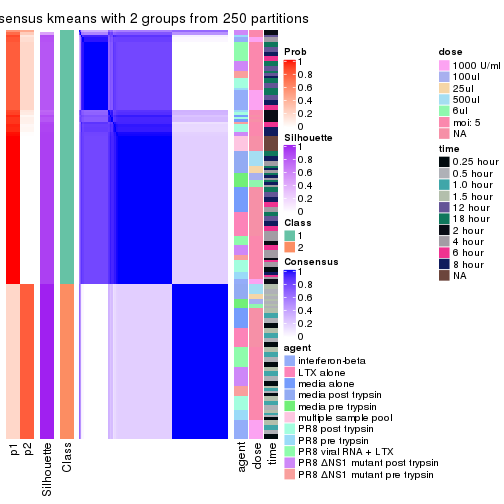
consensus_heatmap(res, k = 3)
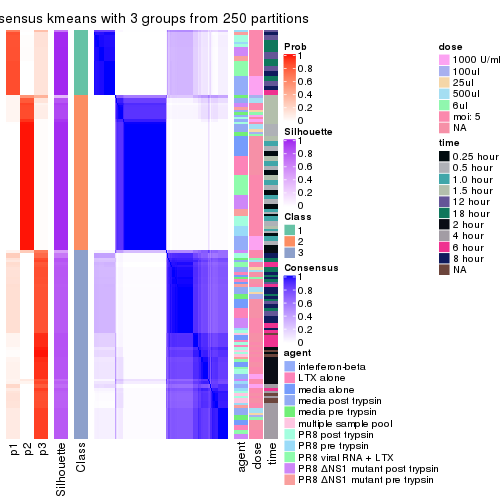
consensus_heatmap(res, k = 4)
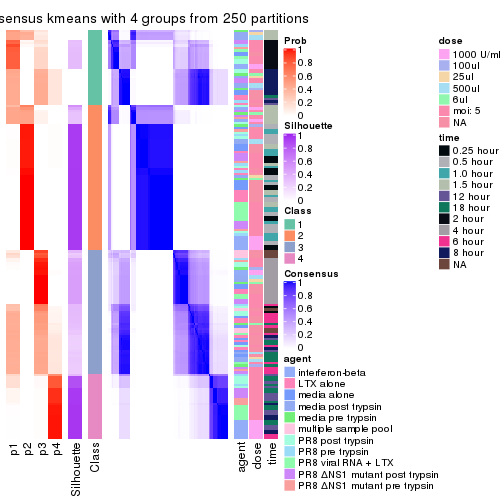
consensus_heatmap(res, k = 5)
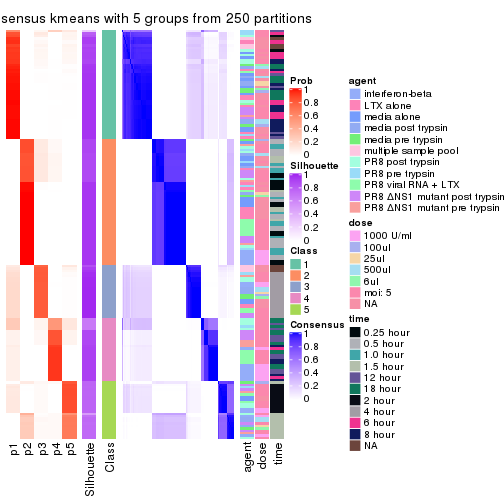
consensus_heatmap(res, k = 6)
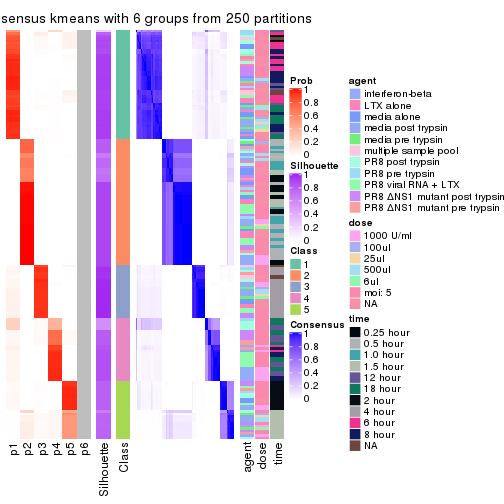
Heatmaps for the membership of samples in all partitions to see how consistent they are:
membership_heatmap(res, k = 2)
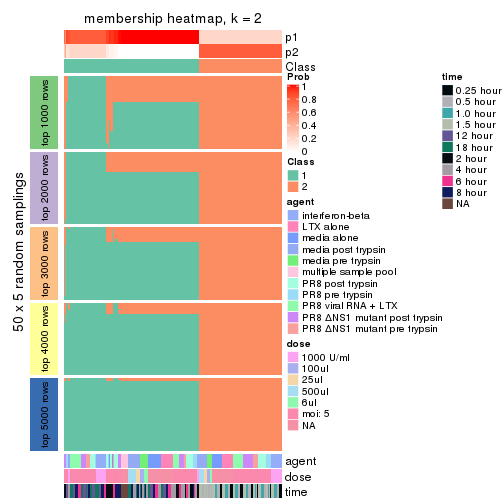
membership_heatmap(res, k = 3)
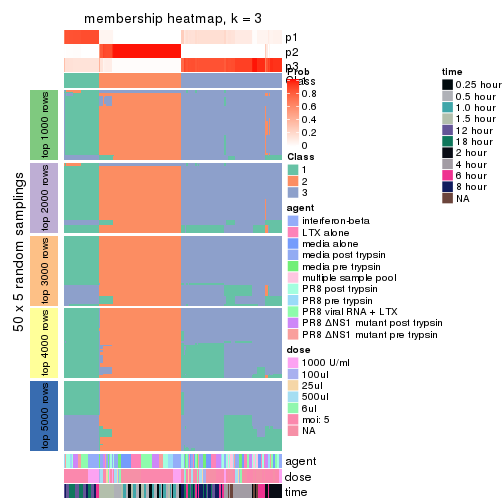
membership_heatmap(res, k = 4)
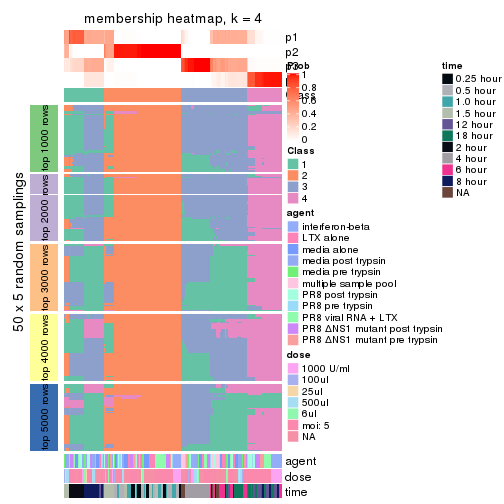
membership_heatmap(res, k = 5)
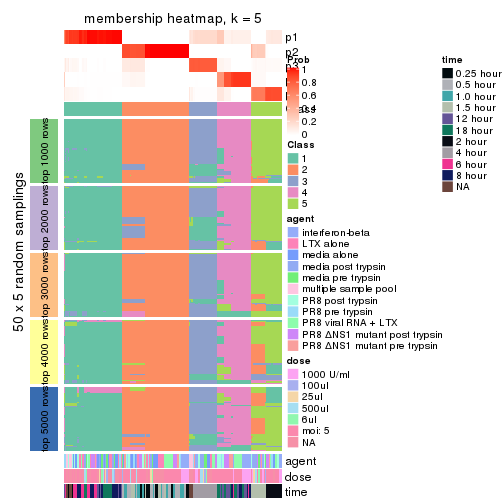
membership_heatmap(res, k = 6)
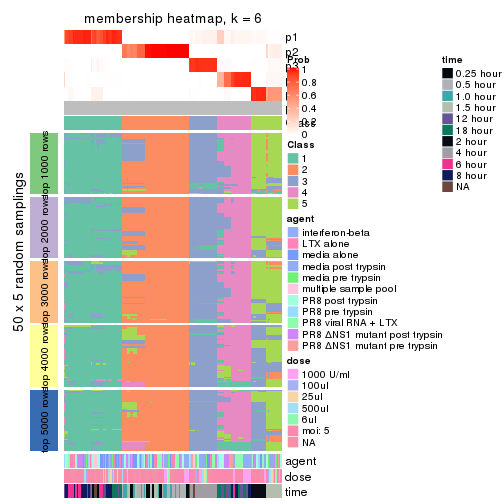
As soon as we have had the classes for columns, we can look for signatures which are significantly different between classes which can be candidate marks for certain classes. Following are the heatmaps for signatures.
Signature heatmaps where rows are scaled:
get_signatures(res, k = 2)
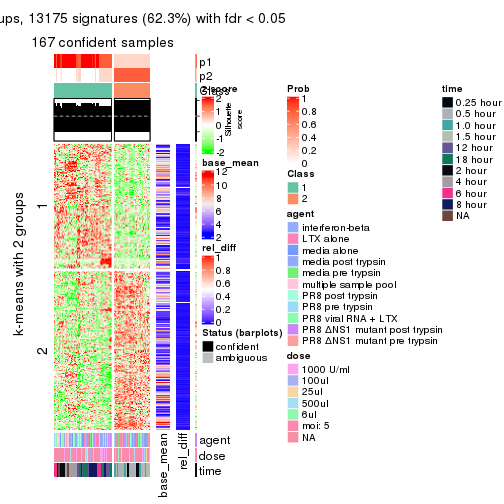
get_signatures(res, k = 3)
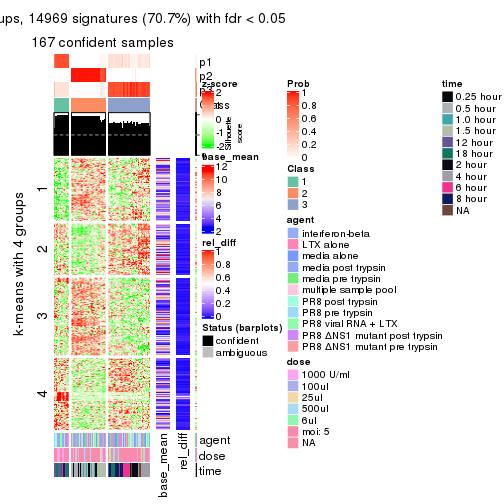
get_signatures(res, k = 4)
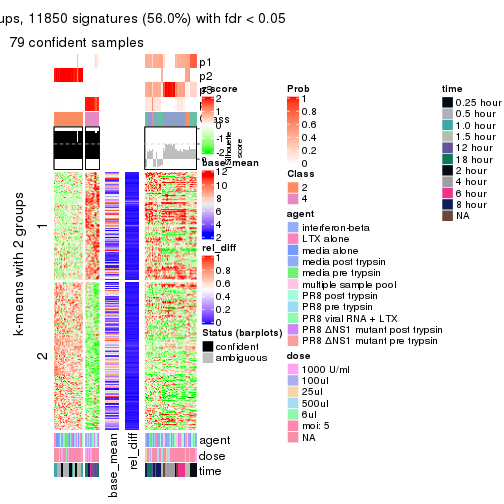
get_signatures(res, k = 5)
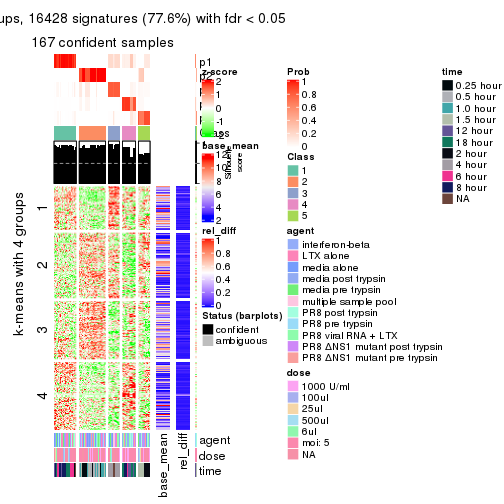
get_signatures(res, k = 6)
#> Error in mat[ceiling(1:nr/h_ratio), ceiling(1:nc/w_ratio), drop = FALSE]: subscript out of bounds
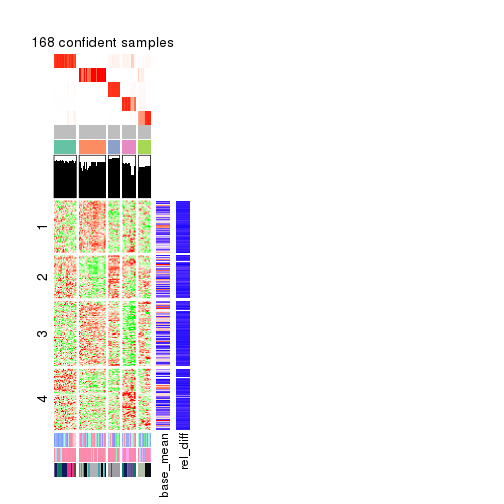
Signature heatmaps where rows are not scaled:
get_signatures(res, k = 2, scale_rows = FALSE)
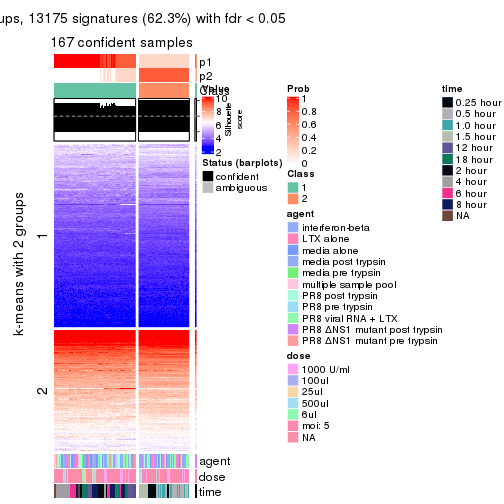
get_signatures(res, k = 3, scale_rows = FALSE)
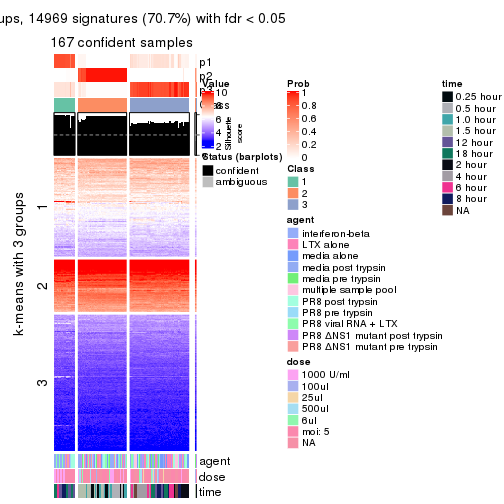
get_signatures(res, k = 4, scale_rows = FALSE)
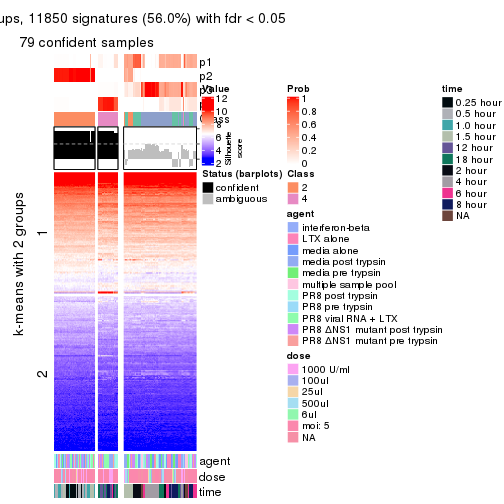
get_signatures(res, k = 5, scale_rows = FALSE)
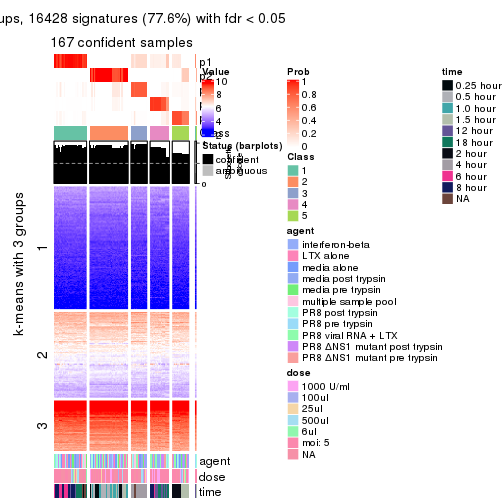
get_signatures(res, k = 6, scale_rows = FALSE)
#> Error in mat[ceiling(1:nr/h_ratio), ceiling(1:nc/w_ratio), drop = FALSE]: subscript out of bounds
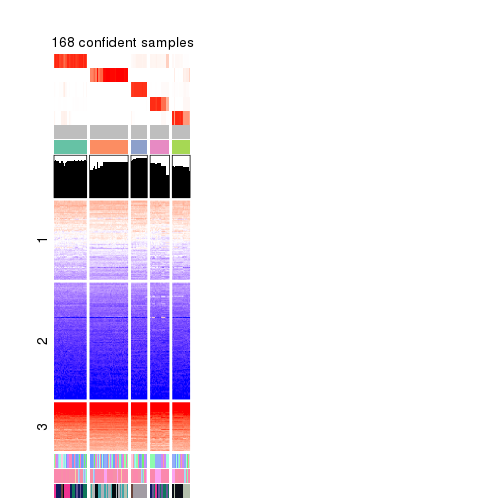
Compare the overlap of signatures from different k:
compare_signatures(res)
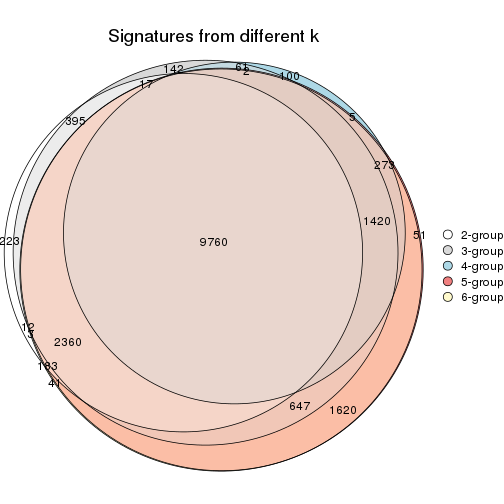
get_signature() returns a data frame invisibly. TO get the list of signatures, the function
call should be assigned to a variable explicitly. In following code, if plot argument is set
to FALSE, no heatmap is plotted while only the differential analysis is performed.
# code only for demonstration
tb = get_signature(res, k = ..., plot = FALSE)
An example of the output of tb is:
#> which_row fdr mean_1 mean_2 scaled_mean_1 scaled_mean_2 km
#> 1 38 0.042760348 8.373488 9.131774 -0.5533452 0.5164555 1
#> 2 40 0.018707592 7.106213 8.469186 -0.6173731 0.5762149 1
#> 3 55 0.019134737 10.221463 11.207825 -0.6159697 0.5749050 1
#> 4 59 0.006059896 5.921854 7.869574 -0.6899429 0.6439467 1
#> 5 60 0.018055526 8.928898 10.211722 -0.6204761 0.5791110 1
#> 6 98 0.009384629 15.714769 14.887706 0.6635654 -0.6193277 2
...
The columns in tb are:
which_row: row indices corresponding to the input matrix.fdr: FDR for the differential test. mean_x: The mean value in group x.scaled_mean_x: The mean value in group x after rows are scaled.km: Row groups if k-means clustering is applied to rows.UMAP plot which shows how samples are separated.
dimension_reduction(res, k = 2, method = "UMAP")
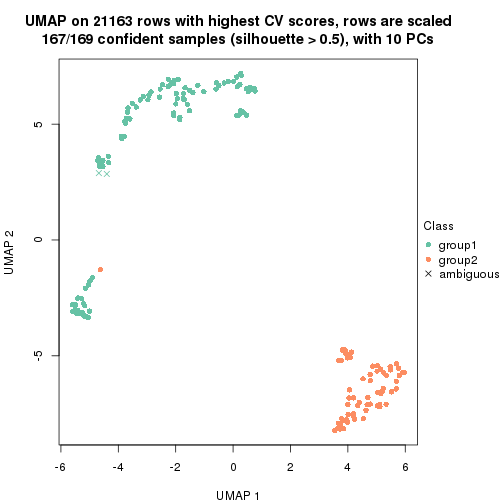
dimension_reduction(res, k = 3, method = "UMAP")
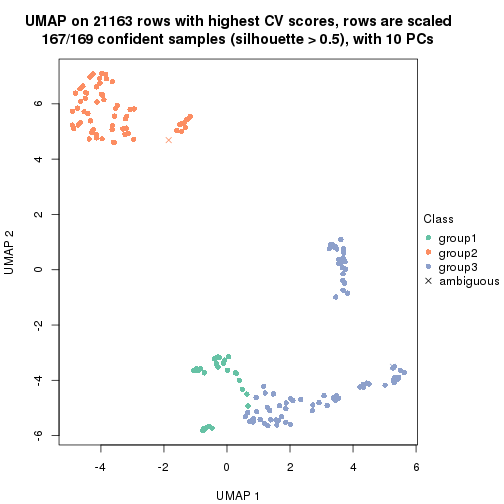
dimension_reduction(res, k = 4, method = "UMAP")
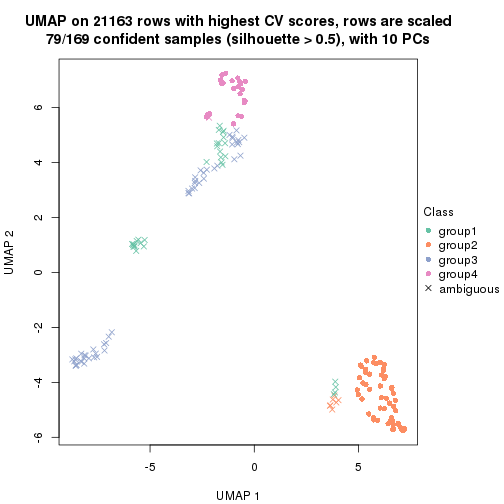
dimension_reduction(res, k = 5, method = "UMAP")
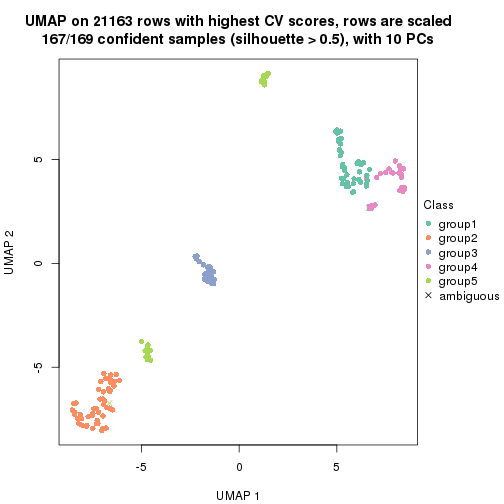
dimension_reduction(res, k = 6, method = "UMAP")
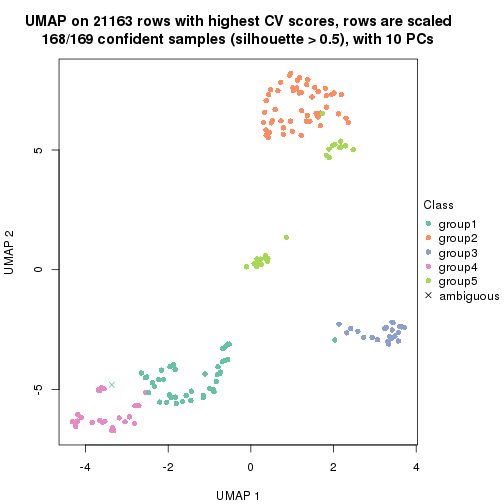
Following heatmap shows how subgroups are split when increasing k:
collect_classes(res)
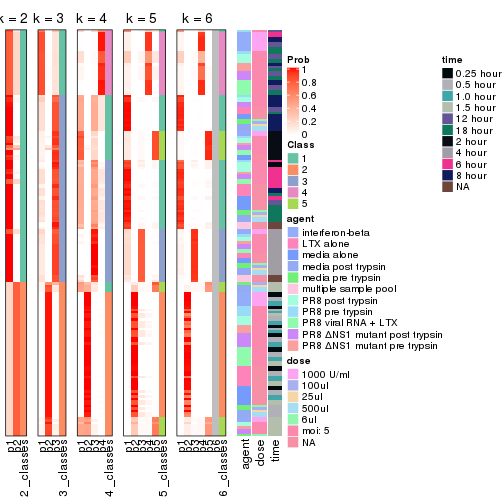
Test correlation between subgroups and known annotations. If the known annotation is numeric, one-way ANOVA test is applied, and if the known annotation is discrete, chi-squared contingency table test is applied.
test_to_known_factors(res)
#> n agent(p) dose(p) time(p) k
#> CV:kmeans 167 0.8905 1.0000 3.65e-29 2
#> CV:kmeans 167 0.0125 0.0029 4.32e-35 3
#> CV:kmeans 79 0.0555 0.0181 2.20e-14 4
#> CV:kmeans 167 0.0287 0.0134 3.09e-73 5
#> CV:kmeans 168 0.0256 0.0125 9.35e-74 6
If matrix rows can be associated to genes, consider to use functional_enrichment(res,
...) to perform function enrichment for the signature genes. See this vignette for more detailed explanations.
The object with results only for a single top-value method and a single partition method can be extracted as:
res = res_list["CV", "skmeans"]
# you can also extract it by
# res = res_list["CV:skmeans"]
A summary of res and all the functions that can be applied to it:
res
#> A 'ConsensusPartition' object with k = 2, 3, 4, 5, 6.
#> On a matrix with 21163 rows and 169 columns.
#> Top rows (1000, 2000, 3000, 4000, 5000) are extracted by 'CV' method.
#> Subgroups are detected by 'skmeans' method.
#> Performed in total 1250 partitions by row resampling.
#> Best k for subgroups seems to be 6.
#>
#> Following methods can be applied to this 'ConsensusPartition' object:
#> [1] "cola_report" "collect_classes" "collect_plots"
#> [4] "collect_stats" "colnames" "compare_signatures"
#> [7] "consensus_heatmap" "dimension_reduction" "functional_enrichment"
#> [10] "get_anno_col" "get_anno" "get_classes"
#> [13] "get_consensus" "get_matrix" "get_membership"
#> [16] "get_param" "get_signatures" "get_stats"
#> [19] "is_best_k" "is_stable_k" "membership_heatmap"
#> [22] "ncol" "nrow" "plot_ecdf"
#> [25] "rownames" "select_partition_number" "show"
#> [28] "suggest_best_k" "test_to_known_factors"
collect_plots() function collects all the plots made from res for all k (number of partitions)
into one single page to provide an easy and fast comparison between different k.
collect_plots(res)
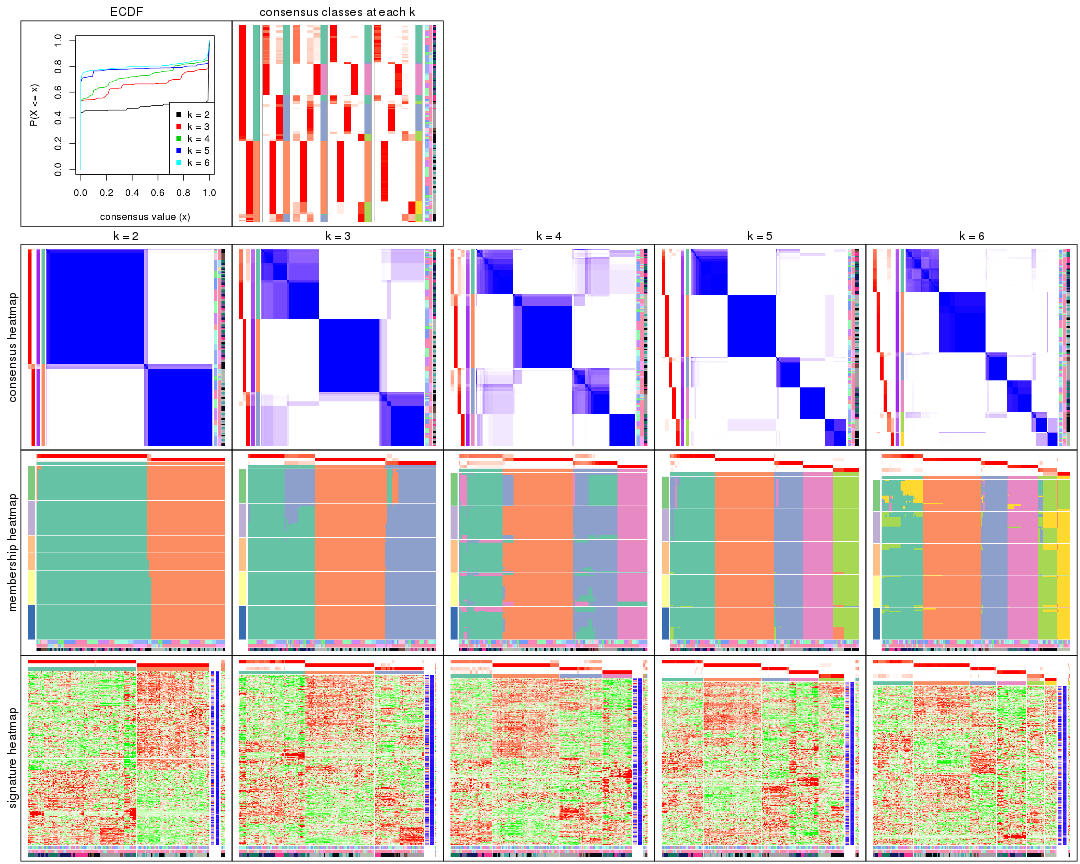
The plots are:
k and the heatmap of
predicted classes for each k.k.k.k.All the plots in panels can be made by individual functions and they are plotted later in this section.
select_partition_number() produces several plots showing different
statistics for choosing “optimized” k. There are following statistics:
k;k, the area increased is defined as \(A_k - A_{k-1}\).The detailed explanations of these statistics can be found in the cola vignette.
Generally speaking, lower PAC score, higher mean silhouette score or higher
concordance corresponds to better partition. Rand index and Jaccard index
measure how similar the current partition is compared to partition with k-1.
If they are too similar, we won't accept k is better than k-1.
select_partition_number(res)
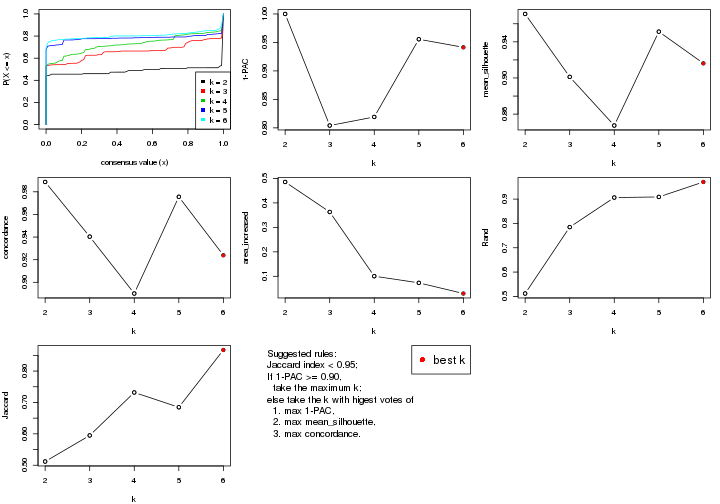
The numeric values for all these statistics can be obtained by get_stats().
get_stats(res)
#> k 1-PAC mean_silhouette concordance area_increased Rand Jaccard
#> 2 2 1.000 0.971 0.989 0.4855 0.512 0.512
#> 3 3 0.804 0.901 0.940 0.3628 0.785 0.595
#> 4 4 0.819 0.847 0.890 0.1004 0.906 0.732
#> 5 5 0.956 0.951 0.976 0.0732 0.909 0.685
#> 6 6 0.941 0.916 0.924 0.0296 0.970 0.867
suggest_best_k() suggests the best \(k\) based on these statistics. The rules are as follows:
suggest_best_k(res)
#> [1] 6
#> attr(,"optional")
#> [1] 2 5
There is also optional best \(k\) = 2 5 that is worth to check.
Following shows the table of the partitions (You need to click the show/hide
code output link to see it). The membership matrix (columns with name p*)
is inferred by
clue::cl_consensus()
function with the SE method. Basically the value in the membership matrix
represents the probability to belong to a certain group. The finall class
label for an item is determined with the group with highest probability it
belongs to.
In get_classes() function, the entropy is calculated from the membership
matrix and the silhouette score is calculated from the consensus matrix.
cbind(get_classes(res, k = 2), get_membership(res, k = 2))
#> class entropy silhouette p1 p2
#> GSM528681 2 0.000 0.976 0.000 1.000
#> GSM528682 2 0.000 0.976 0.000 1.000
#> GSM528683 2 0.000 0.976 0.000 1.000
#> GSM528684 2 0.000 0.976 0.000 1.000
#> GSM528687 2 0.000 0.976 0.000 1.000
#> GSM528688 2 0.000 0.976 0.000 1.000
#> GSM528685 2 0.000 0.976 0.000 1.000
#> GSM528686 2 0.000 0.976 0.000 1.000
#> GSM528693 1 0.000 0.997 1.000 0.000
#> GSM528694 1 0.000 0.997 1.000 0.000
#> GSM528695 1 0.000 0.997 1.000 0.000
#> GSM528696 1 0.000 0.997 1.000 0.000
#> GSM528697 1 0.000 0.997 1.000 0.000
#> GSM528698 1 0.000 0.997 1.000 0.000
#> GSM528699 1 0.000 0.997 1.000 0.000
#> GSM528700 1 0.000 0.997 1.000 0.000
#> GSM528689 1 0.000 0.997 1.000 0.000
#> GSM528690 1 0.000 0.997 1.000 0.000
#> GSM528691 1 0.000 0.997 1.000 0.000
#> GSM528692 1 0.000 0.997 1.000 0.000
#> GSM528779 2 0.000 0.976 0.000 1.000
#> GSM528780 2 0.000 0.976 0.000 1.000
#> GSM528782 2 0.000 0.976 0.000 1.000
#> GSM528781 2 0.000 0.976 0.000 1.000
#> GSM528785 2 0.943 0.452 0.360 0.640
#> GSM528786 1 0.000 0.997 1.000 0.000
#> GSM528787 1 0.000 0.997 1.000 0.000
#> GSM528788 1 0.000 0.997 1.000 0.000
#> GSM528783 1 0.000 0.997 1.000 0.000
#> GSM528784 1 0.000 0.997 1.000 0.000
#> GSM528759 1 0.000 0.997 1.000 0.000
#> GSM528760 1 0.000 0.997 1.000 0.000
#> GSM528761 2 0.000 0.976 0.000 1.000
#> GSM528762 2 0.000 0.976 0.000 1.000
#> GSM528765 2 0.000 0.976 0.000 1.000
#> GSM528766 2 0.000 0.976 0.000 1.000
#> GSM528763 2 0.000 0.976 0.000 1.000
#> GSM528764 2 0.000 0.976 0.000 1.000
#> GSM528771 2 0.943 0.452 0.360 0.640
#> GSM528772 2 0.993 0.201 0.452 0.548
#> GSM528773 1 0.000 0.997 1.000 0.000
#> GSM528774 1 0.000 0.997 1.000 0.000
#> GSM528775 1 0.000 0.997 1.000 0.000
#> GSM528776 1 0.000 0.997 1.000 0.000
#> GSM528777 1 0.000 0.997 1.000 0.000
#> GSM528778 1 0.000 0.997 1.000 0.000
#> GSM528767 1 0.000 0.997 1.000 0.000
#> GSM528768 1 0.000 0.997 1.000 0.000
#> GSM528769 1 0.000 0.997 1.000 0.000
#> GSM528770 1 0.000 0.997 1.000 0.000
#> GSM528671 2 0.000 0.976 0.000 1.000
#> GSM528672 2 0.000 0.976 0.000 1.000
#> GSM528674 2 0.000 0.976 0.000 1.000
#> GSM528673 2 0.000 0.976 0.000 1.000
#> GSM528677 1 0.184 0.969 0.972 0.028
#> GSM528678 1 0.000 0.997 1.000 0.000
#> GSM528679 1 0.000 0.997 1.000 0.000
#> GSM528680 1 0.000 0.997 1.000 0.000
#> GSM528675 1 0.000 0.997 1.000 0.000
#> GSM528676 1 0.000 0.997 1.000 0.000
#> GSM528651 2 0.000 0.976 0.000 1.000
#> GSM528652 2 0.000 0.976 0.000 1.000
#> GSM528653 2 0.000 0.976 0.000 1.000
#> GSM528654 2 0.000 0.976 0.000 1.000
#> GSM528657 2 0.000 0.976 0.000 1.000
#> GSM528658 2 0.000 0.976 0.000 1.000
#> GSM528655 2 0.000 0.976 0.000 1.000
#> GSM528656 2 0.000 0.976 0.000 1.000
#> GSM528663 2 0.000 0.976 0.000 1.000
#> GSM528664 2 0.000 0.976 0.000 1.000
#> GSM528665 1 0.000 0.997 1.000 0.000
#> GSM528666 1 0.000 0.997 1.000 0.000
#> GSM528667 1 0.000 0.997 1.000 0.000
#> GSM528668 1 0.000 0.997 1.000 0.000
#> GSM528669 1 0.000 0.997 1.000 0.000
#> GSM528670 1 0.000 0.997 1.000 0.000
#> GSM528659 1 0.000 0.997 1.000 0.000
#> GSM528660 1 0.000 0.997 1.000 0.000
#> GSM528661 1 0.000 0.997 1.000 0.000
#> GSM528662 1 0.000 0.997 1.000 0.000
#> GSM528701 2 0.000 0.976 0.000 1.000
#> GSM528702 2 0.000 0.976 0.000 1.000
#> GSM528703 2 0.000 0.976 0.000 1.000
#> GSM528704 2 0.000 0.976 0.000 1.000
#> GSM528707 2 0.000 0.976 0.000 1.000
#> GSM528708 2 0.000 0.976 0.000 1.000
#> GSM528705 2 0.000 0.976 0.000 1.000
#> GSM528706 2 0.000 0.976 0.000 1.000
#> GSM528713 1 0.141 0.977 0.980 0.020
#> GSM528714 1 0.163 0.973 0.976 0.024
#> GSM528715 1 0.000 0.997 1.000 0.000
#> GSM528716 1 0.000 0.997 1.000 0.000
#> GSM528717 1 0.000 0.997 1.000 0.000
#> GSM528718 1 0.000 0.997 1.000 0.000
#> GSM528719 1 0.000 0.997 1.000 0.000
#> GSM528720 1 0.000 0.997 1.000 0.000
#> GSM528709 1 0.000 0.997 1.000 0.000
#> GSM528710 1 0.000 0.997 1.000 0.000
#> GSM528711 1 0.000 0.997 1.000 0.000
#> GSM528712 1 0.000 0.997 1.000 0.000
#> GSM528721 2 0.000 0.976 0.000 1.000
#> GSM528722 2 0.000 0.976 0.000 1.000
#> GSM528723 2 0.000 0.976 0.000 1.000
#> GSM528724 2 0.000 0.976 0.000 1.000
#> GSM528727 2 0.000 0.976 0.000 1.000
#> GSM528728 2 0.000 0.976 0.000 1.000
#> GSM528725 2 0.000 0.976 0.000 1.000
#> GSM528726 2 0.000 0.976 0.000 1.000
#> GSM528733 1 0.000 0.997 1.000 0.000
#> GSM528734 1 0.000 0.997 1.000 0.000
#> GSM528735 1 0.000 0.997 1.000 0.000
#> GSM528736 1 0.000 0.997 1.000 0.000
#> GSM528737 1 0.000 0.997 1.000 0.000
#> GSM528738 1 0.000 0.997 1.000 0.000
#> GSM528729 1 0.000 0.997 1.000 0.000
#> GSM528730 1 0.000 0.997 1.000 0.000
#> GSM528731 1 0.000 0.997 1.000 0.000
#> GSM528732 1 0.000 0.997 1.000 0.000
#> GSM528739 2 0.000 0.976 0.000 1.000
#> GSM528740 2 0.000 0.976 0.000 1.000
#> GSM528741 2 0.000 0.976 0.000 1.000
#> GSM528742 2 0.000 0.976 0.000 1.000
#> GSM528745 2 0.000 0.976 0.000 1.000
#> GSM528746 2 0.000 0.976 0.000 1.000
#> GSM528743 2 0.000 0.976 0.000 1.000
#> GSM528744 2 0.000 0.976 0.000 1.000
#> GSM528751 2 0.994 0.189 0.456 0.544
#> GSM528752 1 0.745 0.722 0.788 0.212
#> GSM528753 1 0.000 0.997 1.000 0.000
#> GSM528754 1 0.000 0.997 1.000 0.000
#> GSM528755 1 0.000 0.997 1.000 0.000
#> GSM528756 1 0.000 0.997 1.000 0.000
#> GSM528757 1 0.000 0.997 1.000 0.000
#> GSM528758 1 0.000 0.997 1.000 0.000
#> GSM528747 1 0.000 0.997 1.000 0.000
#> GSM528748 1 0.000 0.997 1.000 0.000
#> GSM528749 1 0.000 0.997 1.000 0.000
#> GSM528750 1 0.000 0.997 1.000 0.000
#> GSM528640 2 0.000 0.976 0.000 1.000
#> GSM528641 2 0.000 0.976 0.000 1.000
#> GSM528643 1 0.000 0.997 1.000 0.000
#> GSM528644 1 0.000 0.997 1.000 0.000
#> GSM528642 1 0.000 0.997 1.000 0.000
#> GSM528620 2 0.000 0.976 0.000 1.000
#> GSM528621 2 0.000 0.976 0.000 1.000
#> GSM528623 1 0.000 0.997 1.000 0.000
#> GSM528624 1 0.000 0.997 1.000 0.000
#> GSM528622 1 0.000 0.997 1.000 0.000
#> GSM528625 2 0.000 0.976 0.000 1.000
#> GSM528626 2 0.000 0.976 0.000 1.000
#> GSM528628 1 0.000 0.997 1.000 0.000
#> GSM528629 1 0.000 0.997 1.000 0.000
#> GSM528627 1 0.000 0.997 1.000 0.000
#> GSM528630 2 0.000 0.976 0.000 1.000
#> GSM528631 2 0.000 0.976 0.000 1.000
#> GSM528632 2 0.000 0.976 0.000 1.000
#> GSM528633 2 0.000 0.976 0.000 1.000
#> GSM528636 1 0.000 0.997 1.000 0.000
#> GSM528637 1 0.000 0.997 1.000 0.000
#> GSM528638 1 0.000 0.997 1.000 0.000
#> GSM528639 1 0.000 0.997 1.000 0.000
#> GSM528634 1 0.000 0.997 1.000 0.000
#> GSM528635 1 0.000 0.997 1.000 0.000
#> GSM528645 1 0.000 0.997 1.000 0.000
#> GSM528646 1 0.000 0.997 1.000 0.000
#> GSM528647 1 0.000 0.997 1.000 0.000
#> GSM528648 1 0.000 0.997 1.000 0.000
#> GSM528649 1 0.000 0.997 1.000 0.000
#> GSM528650 1 0.000 0.997 1.000 0.000
cbind(get_classes(res, k = 3), get_membership(res, k = 3))
#> class entropy silhouette p1 p2 p3
#> GSM528681 2 0.000 1.000 0.000 1.000 0.000
#> GSM528682 2 0.000 1.000 0.000 1.000 0.000
#> GSM528683 2 0.000 1.000 0.000 1.000 0.000
#> GSM528684 2 0.000 1.000 0.000 1.000 0.000
#> GSM528687 2 0.000 1.000 0.000 1.000 0.000
#> GSM528688 2 0.000 1.000 0.000 1.000 0.000
#> GSM528685 2 0.000 1.000 0.000 1.000 0.000
#> GSM528686 2 0.000 1.000 0.000 1.000 0.000
#> GSM528693 3 0.455 0.740 0.200 0.000 0.800
#> GSM528694 3 0.455 0.740 0.200 0.000 0.800
#> GSM528695 3 0.470 0.726 0.212 0.000 0.788
#> GSM528696 3 0.470 0.726 0.212 0.000 0.788
#> GSM528697 1 0.000 0.867 1.000 0.000 0.000
#> GSM528698 1 0.000 0.867 1.000 0.000 0.000
#> GSM528699 1 0.000 0.867 1.000 0.000 0.000
#> GSM528700 1 0.000 0.867 1.000 0.000 0.000
#> GSM528689 1 0.000 0.867 1.000 0.000 0.000
#> GSM528690 1 0.000 0.867 1.000 0.000 0.000
#> GSM528691 1 0.000 0.867 1.000 0.000 0.000
#> GSM528692 1 0.000 0.867 1.000 0.000 0.000
#> GSM528779 2 0.000 1.000 0.000 1.000 0.000
#> GSM528780 2 0.000 1.000 0.000 1.000 0.000
#> GSM528782 2 0.000 1.000 0.000 1.000 0.000
#> GSM528781 2 0.000 1.000 0.000 1.000 0.000
#> GSM528785 3 0.455 0.757 0.000 0.200 0.800
#> GSM528786 3 0.000 0.920 0.000 0.000 1.000
#> GSM528787 3 0.000 0.920 0.000 0.000 1.000
#> GSM528788 1 0.475 0.822 0.784 0.000 0.216
#> GSM528783 1 0.000 0.867 1.000 0.000 0.000
#> GSM528784 1 0.000 0.867 1.000 0.000 0.000
#> GSM528759 3 0.000 0.920 0.000 0.000 1.000
#> GSM528760 3 0.000 0.920 0.000 0.000 1.000
#> GSM528761 2 0.000 1.000 0.000 1.000 0.000
#> GSM528762 2 0.000 1.000 0.000 1.000 0.000
#> GSM528765 2 0.000 1.000 0.000 1.000 0.000
#> GSM528766 2 0.000 1.000 0.000 1.000 0.000
#> GSM528763 2 0.000 1.000 0.000 1.000 0.000
#> GSM528764 2 0.000 1.000 0.000 1.000 0.000
#> GSM528771 3 0.455 0.757 0.000 0.200 0.800
#> GSM528772 3 0.440 0.769 0.000 0.188 0.812
#> GSM528773 3 0.000 0.920 0.000 0.000 1.000
#> GSM528774 3 0.000 0.920 0.000 0.000 1.000
#> GSM528775 3 0.000 0.920 0.000 0.000 1.000
#> GSM528776 1 0.550 0.764 0.708 0.000 0.292
#> GSM528777 1 0.000 0.867 1.000 0.000 0.000
#> GSM528778 1 0.000 0.867 1.000 0.000 0.000
#> GSM528767 1 0.000 0.867 1.000 0.000 0.000
#> GSM528768 1 0.000 0.867 1.000 0.000 0.000
#> GSM528769 1 0.000 0.867 1.000 0.000 0.000
#> GSM528770 1 0.000 0.867 1.000 0.000 0.000
#> GSM528671 2 0.000 1.000 0.000 1.000 0.000
#> GSM528672 2 0.000 1.000 0.000 1.000 0.000
#> GSM528674 2 0.000 1.000 0.000 1.000 0.000
#> GSM528673 2 0.000 1.000 0.000 1.000 0.000
#> GSM528677 3 0.000 0.920 0.000 0.000 1.000
#> GSM528678 3 0.000 0.920 0.000 0.000 1.000
#> GSM528679 1 0.546 0.768 0.712 0.000 0.288
#> GSM528680 1 0.000 0.867 1.000 0.000 0.000
#> GSM528675 1 0.000 0.867 1.000 0.000 0.000
#> GSM528676 1 0.000 0.867 1.000 0.000 0.000
#> GSM528651 2 0.000 1.000 0.000 1.000 0.000
#> GSM528652 2 0.000 1.000 0.000 1.000 0.000
#> GSM528653 2 0.000 1.000 0.000 1.000 0.000
#> GSM528654 2 0.000 1.000 0.000 1.000 0.000
#> GSM528657 2 0.000 1.000 0.000 1.000 0.000
#> GSM528658 2 0.000 1.000 0.000 1.000 0.000
#> GSM528655 2 0.000 1.000 0.000 1.000 0.000
#> GSM528656 2 0.000 1.000 0.000 1.000 0.000
#> GSM528663 3 0.475 0.735 0.000 0.216 0.784
#> GSM528664 3 0.568 0.569 0.000 0.316 0.684
#> GSM528665 3 0.000 0.920 0.000 0.000 1.000
#> GSM528666 3 0.000 0.920 0.000 0.000 1.000
#> GSM528667 1 0.568 0.740 0.684 0.000 0.316
#> GSM528668 1 0.568 0.740 0.684 0.000 0.316
#> GSM528669 1 0.000 0.867 1.000 0.000 0.000
#> GSM528670 1 0.000 0.867 1.000 0.000 0.000
#> GSM528659 1 0.000 0.867 1.000 0.000 0.000
#> GSM528660 1 0.000 0.867 1.000 0.000 0.000
#> GSM528661 1 0.000 0.867 1.000 0.000 0.000
#> GSM528662 1 0.000 0.867 1.000 0.000 0.000
#> GSM528701 2 0.000 1.000 0.000 1.000 0.000
#> GSM528702 2 0.000 1.000 0.000 1.000 0.000
#> GSM528703 2 0.000 1.000 0.000 1.000 0.000
#> GSM528704 2 0.000 1.000 0.000 1.000 0.000
#> GSM528707 2 0.000 1.000 0.000 1.000 0.000
#> GSM528708 2 0.000 1.000 0.000 1.000 0.000
#> GSM528705 2 0.000 1.000 0.000 1.000 0.000
#> GSM528706 2 0.000 1.000 0.000 1.000 0.000
#> GSM528713 3 0.000 0.920 0.000 0.000 1.000
#> GSM528714 3 0.000 0.920 0.000 0.000 1.000
#> GSM528715 3 0.000 0.920 0.000 0.000 1.000
#> GSM528716 3 0.000 0.920 0.000 0.000 1.000
#> GSM528717 1 0.327 0.820 0.884 0.000 0.116
#> GSM528718 1 0.334 0.819 0.880 0.000 0.120
#> GSM528719 1 0.000 0.867 1.000 0.000 0.000
#> GSM528720 1 0.000 0.867 1.000 0.000 0.000
#> GSM528709 1 0.000 0.867 1.000 0.000 0.000
#> GSM528710 1 0.000 0.867 1.000 0.000 0.000
#> GSM528711 1 0.000 0.867 1.000 0.000 0.000
#> GSM528712 1 0.000 0.867 1.000 0.000 0.000
#> GSM528721 2 0.000 1.000 0.000 1.000 0.000
#> GSM528722 2 0.000 1.000 0.000 1.000 0.000
#> GSM528723 2 0.000 1.000 0.000 1.000 0.000
#> GSM528724 2 0.000 1.000 0.000 1.000 0.000
#> GSM528727 2 0.000 1.000 0.000 1.000 0.000
#> GSM528728 2 0.000 1.000 0.000 1.000 0.000
#> GSM528725 2 0.000 1.000 0.000 1.000 0.000
#> GSM528726 2 0.000 1.000 0.000 1.000 0.000
#> GSM528733 3 0.000 0.920 0.000 0.000 1.000
#> GSM528734 3 0.000 0.920 0.000 0.000 1.000
#> GSM528735 3 0.000 0.920 0.000 0.000 1.000
#> GSM528736 3 0.000 0.920 0.000 0.000 1.000
#> GSM528737 1 0.568 0.740 0.684 0.000 0.316
#> GSM528738 1 0.568 0.740 0.684 0.000 0.316
#> GSM528729 1 0.475 0.822 0.784 0.000 0.216
#> GSM528730 1 0.475 0.822 0.784 0.000 0.216
#> GSM528731 1 0.475 0.822 0.784 0.000 0.216
#> GSM528732 1 0.489 0.814 0.772 0.000 0.228
#> GSM528739 2 0.000 1.000 0.000 1.000 0.000
#> GSM528740 2 0.000 1.000 0.000 1.000 0.000
#> GSM528741 2 0.000 1.000 0.000 1.000 0.000
#> GSM528742 2 0.000 1.000 0.000 1.000 0.000
#> GSM528745 2 0.000 1.000 0.000 1.000 0.000
#> GSM528746 2 0.000 1.000 0.000 1.000 0.000
#> GSM528743 2 0.000 1.000 0.000 1.000 0.000
#> GSM528744 2 0.000 1.000 0.000 1.000 0.000
#> GSM528751 3 0.440 0.769 0.000 0.188 0.812
#> GSM528752 3 0.418 0.783 0.000 0.172 0.828
#> GSM528753 3 0.000 0.920 0.000 0.000 1.000
#> GSM528754 3 0.000 0.920 0.000 0.000 1.000
#> GSM528755 3 0.000 0.920 0.000 0.000 1.000
#> GSM528756 3 0.000 0.920 0.000 0.000 1.000
#> GSM528757 1 0.475 0.822 0.784 0.000 0.216
#> GSM528758 1 0.475 0.822 0.784 0.000 0.216
#> GSM528747 1 0.475 0.822 0.784 0.000 0.216
#> GSM528748 1 0.475 0.822 0.784 0.000 0.216
#> GSM528749 1 0.571 0.735 0.680 0.000 0.320
#> GSM528750 1 0.489 0.814 0.772 0.000 0.228
#> GSM528640 2 0.000 1.000 0.000 1.000 0.000
#> GSM528641 2 0.000 1.000 0.000 1.000 0.000
#> GSM528643 3 0.000 0.920 0.000 0.000 1.000
#> GSM528644 1 0.475 0.822 0.784 0.000 0.216
#> GSM528642 1 0.579 0.719 0.668 0.000 0.332
#> GSM528620 2 0.000 1.000 0.000 1.000 0.000
#> GSM528621 3 0.618 0.346 0.000 0.416 0.584
#> GSM528623 3 0.000 0.920 0.000 0.000 1.000
#> GSM528624 1 0.475 0.822 0.784 0.000 0.216
#> GSM528622 1 0.568 0.740 0.684 0.000 0.316
#> GSM528625 2 0.000 1.000 0.000 1.000 0.000
#> GSM528626 2 0.000 1.000 0.000 1.000 0.000
#> GSM528628 3 0.000 0.920 0.000 0.000 1.000
#> GSM528629 1 0.475 0.822 0.784 0.000 0.216
#> GSM528627 1 0.576 0.724 0.672 0.000 0.328
#> GSM528630 2 0.000 1.000 0.000 1.000 0.000
#> GSM528631 2 0.000 1.000 0.000 1.000 0.000
#> GSM528632 2 0.000 1.000 0.000 1.000 0.000
#> GSM528633 2 0.000 1.000 0.000 1.000 0.000
#> GSM528636 3 0.000 0.920 0.000 0.000 1.000
#> GSM528637 3 0.000 0.920 0.000 0.000 1.000
#> GSM528638 1 0.475 0.822 0.784 0.000 0.216
#> GSM528639 1 0.475 0.822 0.784 0.000 0.216
#> GSM528634 1 0.611 0.611 0.604 0.000 0.396
#> GSM528635 1 0.571 0.735 0.680 0.000 0.320
#> GSM528645 3 0.000 0.920 0.000 0.000 1.000
#> GSM528646 3 0.000 0.920 0.000 0.000 1.000
#> GSM528647 3 0.000 0.920 0.000 0.000 1.000
#> GSM528648 3 0.000 0.920 0.000 0.000 1.000
#> GSM528649 3 0.000 0.920 0.000 0.000 1.000
#> GSM528650 3 0.000 0.920 0.000 0.000 1.000
cbind(get_classes(res, k = 4), get_membership(res, k = 4))
#> class entropy silhouette p1 p2 p3 p4
#> GSM528681 2 0.0000 0.953 0.000 1.000 0.000 0.000
#> GSM528682 2 0.0000 0.953 0.000 1.000 0.000 0.000
#> GSM528683 2 0.0000 0.953 0.000 1.000 0.000 0.000
#> GSM528684 2 0.0000 0.953 0.000 1.000 0.000 0.000
#> GSM528687 2 0.0000 0.953 0.000 1.000 0.000 0.000
#> GSM528688 2 0.0000 0.953 0.000 1.000 0.000 0.000
#> GSM528685 2 0.4250 0.724 0.276 0.724 0.000 0.000
#> GSM528686 2 0.4250 0.724 0.276 0.724 0.000 0.000
#> GSM528693 3 0.4933 0.672 0.432 0.000 0.568 0.000
#> GSM528694 3 0.4933 0.672 0.432 0.000 0.568 0.000
#> GSM528695 3 0.3688 0.650 0.000 0.000 0.792 0.208
#> GSM528696 3 0.3688 0.650 0.000 0.000 0.792 0.208
#> GSM528697 4 0.0000 1.000 0.000 0.000 0.000 1.000
#> GSM528698 4 0.0000 1.000 0.000 0.000 0.000 1.000
#> GSM528699 4 0.0000 1.000 0.000 0.000 0.000 1.000
#> GSM528700 4 0.0000 1.000 0.000 0.000 0.000 1.000
#> GSM528689 4 0.0000 1.000 0.000 0.000 0.000 1.000
#> GSM528690 4 0.0000 1.000 0.000 0.000 0.000 1.000
#> GSM528691 4 0.0000 1.000 0.000 0.000 0.000 1.000
#> GSM528692 4 0.0000 1.000 0.000 0.000 0.000 1.000
#> GSM528779 2 0.0000 0.953 0.000 1.000 0.000 0.000
#> GSM528780 2 0.0000 0.953 0.000 1.000 0.000 0.000
#> GSM528782 2 0.0000 0.953 0.000 1.000 0.000 0.000
#> GSM528781 2 0.0000 0.953 0.000 1.000 0.000 0.000
#> GSM528785 1 0.5268 -0.567 0.540 0.008 0.452 0.000
#> GSM528786 3 0.0000 0.803 0.000 0.000 1.000 0.000
#> GSM528787 3 0.2281 0.757 0.096 0.000 0.904 0.000
#> GSM528788 1 0.5867 0.881 0.688 0.000 0.216 0.096
#> GSM528783 4 0.0000 1.000 0.000 0.000 0.000 1.000
#> GSM528784 4 0.0000 1.000 0.000 0.000 0.000 1.000
#> GSM528759 3 0.4164 0.523 0.264 0.000 0.736 0.000
#> GSM528760 3 0.3123 0.700 0.156 0.000 0.844 0.000
#> GSM528761 2 0.0000 0.953 0.000 1.000 0.000 0.000
#> GSM528762 2 0.0000 0.953 0.000 1.000 0.000 0.000
#> GSM528765 2 0.0000 0.953 0.000 1.000 0.000 0.000
#> GSM528766 2 0.0000 0.953 0.000 1.000 0.000 0.000
#> GSM528763 2 0.0000 0.953 0.000 1.000 0.000 0.000
#> GSM528764 2 0.4250 0.724 0.276 0.724 0.000 0.000
#> GSM528771 3 0.4955 0.665 0.444 0.000 0.556 0.000
#> GSM528772 3 0.4955 0.665 0.444 0.000 0.556 0.000
#> GSM528773 3 0.0000 0.803 0.000 0.000 1.000 0.000
#> GSM528774 3 0.0000 0.803 0.000 0.000 1.000 0.000
#> GSM528775 1 0.5220 0.535 0.568 0.000 0.424 0.008
#> GSM528776 1 0.5809 0.880 0.692 0.000 0.216 0.092
#> GSM528777 1 0.4776 0.514 0.624 0.000 0.000 0.376
#> GSM528778 1 0.4776 0.514 0.624 0.000 0.000 0.376
#> GSM528767 4 0.0000 1.000 0.000 0.000 0.000 1.000
#> GSM528768 4 0.0000 1.000 0.000 0.000 0.000 1.000
#> GSM528769 4 0.0000 1.000 0.000 0.000 0.000 1.000
#> GSM528770 4 0.0000 1.000 0.000 0.000 0.000 1.000
#> GSM528671 2 0.0000 0.953 0.000 1.000 0.000 0.000
#> GSM528672 2 0.0000 0.953 0.000 1.000 0.000 0.000
#> GSM528674 2 0.0000 0.953 0.000 1.000 0.000 0.000
#> GSM528673 2 0.4250 0.724 0.276 0.724 0.000 0.000
#> GSM528677 3 0.4933 0.672 0.432 0.000 0.568 0.000
#> GSM528678 3 0.0000 0.803 0.000 0.000 1.000 0.000
#> GSM528679 1 0.5867 0.881 0.688 0.000 0.216 0.096
#> GSM528680 4 0.0000 1.000 0.000 0.000 0.000 1.000
#> GSM528675 4 0.0000 1.000 0.000 0.000 0.000 1.000
#> GSM528676 4 0.0000 1.000 0.000 0.000 0.000 1.000
#> GSM528651 2 0.0000 0.953 0.000 1.000 0.000 0.000
#> GSM528652 2 0.0000 0.953 0.000 1.000 0.000 0.000
#> GSM528653 2 0.0000 0.953 0.000 1.000 0.000 0.000
#> GSM528654 2 0.0000 0.953 0.000 1.000 0.000 0.000
#> GSM528657 2 0.0000 0.953 0.000 1.000 0.000 0.000
#> GSM528658 2 0.0000 0.953 0.000 1.000 0.000 0.000
#> GSM528655 2 0.4250 0.724 0.276 0.724 0.000 0.000
#> GSM528656 2 0.4250 0.724 0.276 0.724 0.000 0.000
#> GSM528663 3 0.4761 0.690 0.372 0.000 0.628 0.000
#> GSM528664 3 0.4936 0.688 0.372 0.004 0.624 0.000
#> GSM528665 3 0.0000 0.803 0.000 0.000 1.000 0.000
#> GSM528666 3 0.0000 0.803 0.000 0.000 1.000 0.000
#> GSM528667 1 0.5809 0.880 0.692 0.000 0.216 0.092
#> GSM528668 1 0.5809 0.880 0.692 0.000 0.216 0.092
#> GSM528669 1 0.4730 0.538 0.636 0.000 0.000 0.364
#> GSM528670 1 0.4477 0.626 0.688 0.000 0.000 0.312
#> GSM528659 4 0.0000 1.000 0.000 0.000 0.000 1.000
#> GSM528660 4 0.0000 1.000 0.000 0.000 0.000 1.000
#> GSM528661 4 0.0000 1.000 0.000 0.000 0.000 1.000
#> GSM528662 4 0.0000 1.000 0.000 0.000 0.000 1.000
#> GSM528701 2 0.0000 0.953 0.000 1.000 0.000 0.000
#> GSM528702 2 0.0000 0.953 0.000 1.000 0.000 0.000
#> GSM528703 2 0.0000 0.953 0.000 1.000 0.000 0.000
#> GSM528704 2 0.0000 0.953 0.000 1.000 0.000 0.000
#> GSM528707 2 0.0000 0.953 0.000 1.000 0.000 0.000
#> GSM528708 2 0.0000 0.953 0.000 1.000 0.000 0.000
#> GSM528705 2 0.0000 0.953 0.000 1.000 0.000 0.000
#> GSM528706 2 0.0000 0.953 0.000 1.000 0.000 0.000
#> GSM528713 3 0.4955 0.665 0.444 0.000 0.556 0.000
#> GSM528714 3 0.4761 0.690 0.372 0.000 0.628 0.000
#> GSM528715 3 0.0000 0.803 0.000 0.000 1.000 0.000
#> GSM528716 3 0.0000 0.803 0.000 0.000 1.000 0.000
#> GSM528717 1 0.5207 0.662 0.680 0.000 0.028 0.292
#> GSM528718 1 0.5657 0.709 0.688 0.000 0.068 0.244
#> GSM528719 4 0.0000 1.000 0.000 0.000 0.000 1.000
#> GSM528720 4 0.0000 1.000 0.000 0.000 0.000 1.000
#> GSM528709 4 0.0000 1.000 0.000 0.000 0.000 1.000
#> GSM528710 4 0.0000 1.000 0.000 0.000 0.000 1.000
#> GSM528711 4 0.0000 1.000 0.000 0.000 0.000 1.000
#> GSM528712 4 0.0000 1.000 0.000 0.000 0.000 1.000
#> GSM528721 2 0.0000 0.953 0.000 1.000 0.000 0.000
#> GSM528722 2 0.0000 0.953 0.000 1.000 0.000 0.000
#> GSM528723 2 0.0000 0.953 0.000 1.000 0.000 0.000
#> GSM528724 2 0.0000 0.953 0.000 1.000 0.000 0.000
#> GSM528727 2 0.0000 0.953 0.000 1.000 0.000 0.000
#> GSM528728 2 0.0000 0.953 0.000 1.000 0.000 0.000
#> GSM528725 2 0.0000 0.953 0.000 1.000 0.000 0.000
#> GSM528726 2 0.0000 0.953 0.000 1.000 0.000 0.000
#> GSM528733 3 0.0000 0.803 0.000 0.000 1.000 0.000
#> GSM528734 3 0.0000 0.803 0.000 0.000 1.000 0.000
#> GSM528735 1 0.4567 0.800 0.716 0.000 0.276 0.008
#> GSM528736 1 0.4594 0.796 0.712 0.000 0.280 0.008
#> GSM528737 1 0.5809 0.880 0.692 0.000 0.216 0.092
#> GSM528738 1 0.5809 0.880 0.692 0.000 0.216 0.092
#> GSM528729 1 0.5867 0.881 0.688 0.000 0.216 0.096
#> GSM528730 1 0.5867 0.881 0.688 0.000 0.216 0.096
#> GSM528731 1 0.5867 0.881 0.688 0.000 0.216 0.096
#> GSM528732 1 0.5867 0.881 0.688 0.000 0.216 0.096
#> GSM528739 2 0.0000 0.953 0.000 1.000 0.000 0.000
#> GSM528740 2 0.0000 0.953 0.000 1.000 0.000 0.000
#> GSM528741 2 0.0000 0.953 0.000 1.000 0.000 0.000
#> GSM528742 2 0.0000 0.953 0.000 1.000 0.000 0.000
#> GSM528745 2 0.0000 0.953 0.000 1.000 0.000 0.000
#> GSM528746 2 0.0000 0.953 0.000 1.000 0.000 0.000
#> GSM528743 2 0.0000 0.953 0.000 1.000 0.000 0.000
#> GSM528744 2 0.0000 0.953 0.000 1.000 0.000 0.000
#> GSM528751 3 0.4961 0.661 0.448 0.000 0.552 0.000
#> GSM528752 3 0.4961 0.661 0.448 0.000 0.552 0.000
#> GSM528753 3 0.0000 0.803 0.000 0.000 1.000 0.000
#> GSM528754 3 0.0000 0.803 0.000 0.000 1.000 0.000
#> GSM528755 1 0.4621 0.792 0.708 0.000 0.284 0.008
#> GSM528756 1 0.4647 0.787 0.704 0.000 0.288 0.008
#> GSM528757 1 0.5867 0.881 0.688 0.000 0.216 0.096
#> GSM528758 1 0.5867 0.881 0.688 0.000 0.216 0.096
#> GSM528747 1 0.5867 0.881 0.688 0.000 0.216 0.096
#> GSM528748 1 0.5677 0.856 0.680 0.000 0.256 0.064
#> GSM528749 1 0.5619 0.860 0.688 0.000 0.248 0.064
#> GSM528750 1 0.5867 0.881 0.688 0.000 0.216 0.096
#> GSM528640 2 0.0000 0.953 0.000 1.000 0.000 0.000
#> GSM528641 2 0.4250 0.724 0.276 0.724 0.000 0.000
#> GSM528643 3 0.0000 0.803 0.000 0.000 1.000 0.000
#> GSM528644 1 0.5867 0.881 0.688 0.000 0.216 0.096
#> GSM528642 1 0.4961 0.600 0.552 0.000 0.448 0.000
#> GSM528620 2 0.0000 0.953 0.000 1.000 0.000 0.000
#> GSM528621 3 0.6121 0.650 0.308 0.072 0.620 0.000
#> GSM528623 3 0.0000 0.803 0.000 0.000 1.000 0.000
#> GSM528624 1 0.5867 0.881 0.688 0.000 0.216 0.096
#> GSM528622 1 0.5867 0.881 0.688 0.000 0.216 0.096
#> GSM528625 2 0.0000 0.953 0.000 1.000 0.000 0.000
#> GSM528626 2 0.4250 0.724 0.276 0.724 0.000 0.000
#> GSM528628 3 0.0000 0.803 0.000 0.000 1.000 0.000
#> GSM528629 1 0.5867 0.881 0.688 0.000 0.216 0.096
#> GSM528627 1 0.5550 0.858 0.692 0.000 0.248 0.060
#> GSM528630 2 0.0000 0.953 0.000 1.000 0.000 0.000
#> GSM528631 2 0.0000 0.953 0.000 1.000 0.000 0.000
#> GSM528632 2 0.7210 0.418 0.276 0.540 0.184 0.000
#> GSM528633 2 0.7210 0.418 0.276 0.540 0.184 0.000
#> GSM528636 3 0.0000 0.803 0.000 0.000 1.000 0.000
#> GSM528637 3 0.0000 0.803 0.000 0.000 1.000 0.000
#> GSM528638 1 0.5867 0.881 0.688 0.000 0.216 0.096
#> GSM528639 1 0.5809 0.880 0.692 0.000 0.216 0.092
#> GSM528634 1 0.5416 0.846 0.692 0.000 0.260 0.048
#> GSM528635 1 0.5619 0.860 0.688 0.000 0.248 0.064
#> GSM528645 3 0.0707 0.800 0.020 0.000 0.980 0.000
#> GSM528646 3 0.0592 0.801 0.016 0.000 0.984 0.000
#> GSM528647 3 0.0817 0.801 0.024 0.000 0.976 0.000
#> GSM528648 3 0.4343 0.515 0.264 0.000 0.732 0.004
#> GSM528649 3 0.3123 0.700 0.156 0.000 0.844 0.000
#> GSM528650 3 0.5088 0.416 0.288 0.000 0.688 0.024
cbind(get_classes(res, k = 5), get_membership(res, k = 5))
#> class entropy silhouette p1 p2 p3 p4 p5
#> GSM528681 2 0.0000 1.000 0.000 1.000 0.000 0.000 0.000
#> GSM528682 2 0.0000 1.000 0.000 1.000 0.000 0.000 0.000
#> GSM528683 2 0.0000 1.000 0.000 1.000 0.000 0.000 0.000
#> GSM528684 2 0.0000 1.000 0.000 1.000 0.000 0.000 0.000
#> GSM528687 2 0.0000 1.000 0.000 1.000 0.000 0.000 0.000
#> GSM528688 2 0.0000 1.000 0.000 1.000 0.000 0.000 0.000
#> GSM528685 5 0.2020 0.920 0.000 0.100 0.000 0.000 0.900
#> GSM528686 5 0.2020 0.920 0.000 0.100 0.000 0.000 0.900
#> GSM528693 5 0.0162 0.938 0.000 0.000 0.004 0.000 0.996
#> GSM528694 5 0.0162 0.938 0.000 0.000 0.004 0.000 0.996
#> GSM528695 3 0.2929 0.767 0.000 0.000 0.820 0.180 0.000
#> GSM528696 3 0.2929 0.767 0.000 0.000 0.820 0.180 0.000
#> GSM528697 4 0.0000 1.000 0.000 0.000 0.000 1.000 0.000
#> GSM528698 4 0.0000 1.000 0.000 0.000 0.000 1.000 0.000
#> GSM528699 4 0.0000 1.000 0.000 0.000 0.000 1.000 0.000
#> GSM528700 4 0.0000 1.000 0.000 0.000 0.000 1.000 0.000
#> GSM528689 4 0.0000 1.000 0.000 0.000 0.000 1.000 0.000
#> GSM528690 4 0.0000 1.000 0.000 0.000 0.000 1.000 0.000
#> GSM528691 4 0.0000 1.000 0.000 0.000 0.000 1.000 0.000
#> GSM528692 4 0.0000 1.000 0.000 0.000 0.000 1.000 0.000
#> GSM528779 2 0.0000 1.000 0.000 1.000 0.000 0.000 0.000
#> GSM528780 2 0.0000 1.000 0.000 1.000 0.000 0.000 0.000
#> GSM528782 2 0.0000 1.000 0.000 1.000 0.000 0.000 0.000
#> GSM528781 2 0.0000 1.000 0.000 1.000 0.000 0.000 0.000
#> GSM528785 5 0.0162 0.937 0.004 0.000 0.000 0.000 0.996
#> GSM528786 3 0.0000 0.960 0.000 0.000 1.000 0.000 0.000
#> GSM528787 3 0.0162 0.957 0.000 0.000 0.996 0.000 0.004
#> GSM528788 1 0.0000 0.947 1.000 0.000 0.000 0.000 0.000
#> GSM528783 4 0.0162 0.996 0.000 0.000 0.000 0.996 0.004
#> GSM528784 4 0.0000 1.000 0.000 0.000 0.000 1.000 0.000
#> GSM528759 1 0.5836 0.173 0.492 0.000 0.412 0.000 0.096
#> GSM528760 3 0.3532 0.817 0.076 0.000 0.832 0.000 0.092
#> GSM528761 2 0.0000 1.000 0.000 1.000 0.000 0.000 0.000
#> GSM528762 2 0.0000 1.000 0.000 1.000 0.000 0.000 0.000
#> GSM528765 2 0.0000 1.000 0.000 1.000 0.000 0.000 0.000
#> GSM528766 2 0.0000 1.000 0.000 1.000 0.000 0.000 0.000
#> GSM528763 2 0.0000 1.000 0.000 1.000 0.000 0.000 0.000
#> GSM528764 5 0.2020 0.920 0.000 0.100 0.000 0.000 0.900
#> GSM528771 5 0.0162 0.937 0.004 0.000 0.000 0.000 0.996
#> GSM528772 5 0.0162 0.937 0.004 0.000 0.000 0.000 0.996
#> GSM528773 3 0.0000 0.960 0.000 0.000 1.000 0.000 0.000
#> GSM528774 3 0.0000 0.960 0.000 0.000 1.000 0.000 0.000
#> GSM528775 1 0.3266 0.754 0.796 0.000 0.200 0.000 0.004
#> GSM528776 1 0.0000 0.947 1.000 0.000 0.000 0.000 0.000
#> GSM528777 1 0.0000 0.947 1.000 0.000 0.000 0.000 0.000
#> GSM528778 1 0.0000 0.947 1.000 0.000 0.000 0.000 0.000
#> GSM528767 4 0.0000 1.000 0.000 0.000 0.000 1.000 0.000
#> GSM528768 4 0.0000 1.000 0.000 0.000 0.000 1.000 0.000
#> GSM528769 4 0.0000 1.000 0.000 0.000 0.000 1.000 0.000
#> GSM528770 4 0.0000 1.000 0.000 0.000 0.000 1.000 0.000
#> GSM528671 2 0.0000 1.000 0.000 1.000 0.000 0.000 0.000
#> GSM528672 2 0.0000 1.000 0.000 1.000 0.000 0.000 0.000
#> GSM528674 2 0.0000 1.000 0.000 1.000 0.000 0.000 0.000
#> GSM528673 5 0.2020 0.920 0.000 0.100 0.000 0.000 0.900
#> GSM528677 5 0.0162 0.938 0.000 0.000 0.004 0.000 0.996
#> GSM528678 3 0.0000 0.960 0.000 0.000 1.000 0.000 0.000
#> GSM528679 1 0.0000 0.947 1.000 0.000 0.000 0.000 0.000
#> GSM528680 4 0.0000 1.000 0.000 0.000 0.000 1.000 0.000
#> GSM528675 4 0.0000 1.000 0.000 0.000 0.000 1.000 0.000
#> GSM528676 4 0.0000 1.000 0.000 0.000 0.000 1.000 0.000
#> GSM528651 2 0.0000 1.000 0.000 1.000 0.000 0.000 0.000
#> GSM528652 2 0.0000 1.000 0.000 1.000 0.000 0.000 0.000
#> GSM528653 2 0.0000 1.000 0.000 1.000 0.000 0.000 0.000
#> GSM528654 2 0.0000 1.000 0.000 1.000 0.000 0.000 0.000
#> GSM528657 2 0.0000 1.000 0.000 1.000 0.000 0.000 0.000
#> GSM528658 2 0.0000 1.000 0.000 1.000 0.000 0.000 0.000
#> GSM528655 5 0.2020 0.920 0.000 0.100 0.000 0.000 0.900
#> GSM528656 5 0.2020 0.920 0.000 0.100 0.000 0.000 0.900
#> GSM528663 5 0.0162 0.938 0.000 0.000 0.004 0.000 0.996
#> GSM528664 5 0.0162 0.938 0.000 0.000 0.004 0.000 0.996
#> GSM528665 3 0.0000 0.960 0.000 0.000 1.000 0.000 0.000
#> GSM528666 3 0.0000 0.960 0.000 0.000 1.000 0.000 0.000
#> GSM528667 1 0.0000 0.947 1.000 0.000 0.000 0.000 0.000
#> GSM528668 1 0.0000 0.947 1.000 0.000 0.000 0.000 0.000
#> GSM528669 1 0.0000 0.947 1.000 0.000 0.000 0.000 0.000
#> GSM528670 1 0.0000 0.947 1.000 0.000 0.000 0.000 0.000
#> GSM528659 4 0.0000 1.000 0.000 0.000 0.000 1.000 0.000
#> GSM528660 4 0.0000 1.000 0.000 0.000 0.000 1.000 0.000
#> GSM528661 4 0.0000 1.000 0.000 0.000 0.000 1.000 0.000
#> GSM528662 4 0.0000 1.000 0.000 0.000 0.000 1.000 0.000
#> GSM528701 2 0.0000 1.000 0.000 1.000 0.000 0.000 0.000
#> GSM528702 2 0.0000 1.000 0.000 1.000 0.000 0.000 0.000
#> GSM528703 2 0.0000 1.000 0.000 1.000 0.000 0.000 0.000
#> GSM528704 2 0.0000 1.000 0.000 1.000 0.000 0.000 0.000
#> GSM528707 2 0.0000 1.000 0.000 1.000 0.000 0.000 0.000
#> GSM528708 2 0.0000 1.000 0.000 1.000 0.000 0.000 0.000
#> GSM528705 2 0.0000 1.000 0.000 1.000 0.000 0.000 0.000
#> GSM528706 2 0.0000 1.000 0.000 1.000 0.000 0.000 0.000
#> GSM528713 5 0.0162 0.937 0.004 0.000 0.000 0.000 0.996
#> GSM528714 5 0.0162 0.938 0.000 0.000 0.004 0.000 0.996
#> GSM528715 3 0.0000 0.960 0.000 0.000 1.000 0.000 0.000
#> GSM528716 3 0.0000 0.960 0.000 0.000 1.000 0.000 0.000
#> GSM528717 1 0.3318 0.758 0.800 0.000 0.008 0.192 0.000
#> GSM528718 1 0.3794 0.781 0.800 0.000 0.048 0.152 0.000
#> GSM528719 4 0.0000 1.000 0.000 0.000 0.000 1.000 0.000
#> GSM528720 4 0.0000 1.000 0.000 0.000 0.000 1.000 0.000
#> GSM528709 4 0.0000 1.000 0.000 0.000 0.000 1.000 0.000
#> GSM528710 4 0.0000 1.000 0.000 0.000 0.000 1.000 0.000
#> GSM528711 4 0.0000 1.000 0.000 0.000 0.000 1.000 0.000
#> GSM528712 4 0.0000 1.000 0.000 0.000 0.000 1.000 0.000
#> GSM528721 2 0.0000 1.000 0.000 1.000 0.000 0.000 0.000
#> GSM528722 2 0.0000 1.000 0.000 1.000 0.000 0.000 0.000
#> GSM528723 2 0.0000 1.000 0.000 1.000 0.000 0.000 0.000
#> GSM528724 2 0.0000 1.000 0.000 1.000 0.000 0.000 0.000
#> GSM528727 2 0.0000 1.000 0.000 1.000 0.000 0.000 0.000
#> GSM528728 2 0.0000 1.000 0.000 1.000 0.000 0.000 0.000
#> GSM528725 2 0.0000 1.000 0.000 1.000 0.000 0.000 0.000
#> GSM528726 2 0.0000 1.000 0.000 1.000 0.000 0.000 0.000
#> GSM528733 3 0.0000 0.960 0.000 0.000 1.000 0.000 0.000
#> GSM528734 3 0.0000 0.960 0.000 0.000 1.000 0.000 0.000
#> GSM528735 1 0.0404 0.941 0.988 0.000 0.012 0.000 0.000
#> GSM528736 1 0.0510 0.939 0.984 0.000 0.016 0.000 0.000
#> GSM528737 1 0.0000 0.947 1.000 0.000 0.000 0.000 0.000
#> GSM528738 1 0.0000 0.947 1.000 0.000 0.000 0.000 0.000
#> GSM528729 1 0.0000 0.947 1.000 0.000 0.000 0.000 0.000
#> GSM528730 1 0.0000 0.947 1.000 0.000 0.000 0.000 0.000
#> GSM528731 1 0.0162 0.947 0.996 0.000 0.000 0.000 0.004
#> GSM528732 1 0.0162 0.947 0.996 0.000 0.000 0.000 0.004
#> GSM528739 2 0.0000 1.000 0.000 1.000 0.000 0.000 0.000
#> GSM528740 2 0.0000 1.000 0.000 1.000 0.000 0.000 0.000
#> GSM528741 2 0.0000 1.000 0.000 1.000 0.000 0.000 0.000
#> GSM528742 2 0.0000 1.000 0.000 1.000 0.000 0.000 0.000
#> GSM528745 2 0.0000 1.000 0.000 1.000 0.000 0.000 0.000
#> GSM528746 2 0.0000 1.000 0.000 1.000 0.000 0.000 0.000
#> GSM528743 2 0.0000 1.000 0.000 1.000 0.000 0.000 0.000
#> GSM528744 2 0.0000 1.000 0.000 1.000 0.000 0.000 0.000
#> GSM528751 5 0.0162 0.937 0.004 0.000 0.000 0.000 0.996
#> GSM528752 5 0.0162 0.937 0.004 0.000 0.000 0.000 0.996
#> GSM528753 3 0.0000 0.960 0.000 0.000 1.000 0.000 0.000
#> GSM528754 3 0.0000 0.960 0.000 0.000 1.000 0.000 0.000
#> GSM528755 1 0.1571 0.905 0.936 0.000 0.060 0.000 0.004
#> GSM528756 1 0.1571 0.905 0.936 0.000 0.060 0.000 0.004
#> GSM528757 1 0.0000 0.947 1.000 0.000 0.000 0.000 0.000
#> GSM528758 1 0.0000 0.947 1.000 0.000 0.000 0.000 0.000
#> GSM528747 1 0.0162 0.947 0.996 0.000 0.000 0.000 0.004
#> GSM528748 1 0.0162 0.947 0.996 0.000 0.000 0.000 0.004
#> GSM528749 1 0.0162 0.947 0.996 0.000 0.000 0.000 0.004
#> GSM528750 1 0.0162 0.947 0.996 0.000 0.000 0.000 0.004
#> GSM528640 2 0.0000 1.000 0.000 1.000 0.000 0.000 0.000
#> GSM528641 5 0.2020 0.920 0.000 0.100 0.000 0.000 0.900
#> GSM528643 3 0.0000 0.960 0.000 0.000 1.000 0.000 0.000
#> GSM528644 1 0.0162 0.947 0.996 0.000 0.000 0.000 0.004
#> GSM528642 3 0.0955 0.935 0.028 0.000 0.968 0.000 0.004
#> GSM528620 2 0.0000 1.000 0.000 1.000 0.000 0.000 0.000
#> GSM528621 5 0.0162 0.938 0.000 0.000 0.004 0.000 0.996
#> GSM528623 3 0.0000 0.960 0.000 0.000 1.000 0.000 0.000
#> GSM528624 1 0.0000 0.947 1.000 0.000 0.000 0.000 0.000
#> GSM528622 1 0.0162 0.947 0.996 0.000 0.000 0.000 0.004
#> GSM528625 2 0.0000 1.000 0.000 1.000 0.000 0.000 0.000
#> GSM528626 5 0.2020 0.920 0.000 0.100 0.000 0.000 0.900
#> GSM528628 3 0.0000 0.960 0.000 0.000 1.000 0.000 0.000
#> GSM528629 1 0.0162 0.947 0.996 0.000 0.000 0.000 0.004
#> GSM528627 1 0.0162 0.947 0.996 0.000 0.000 0.000 0.004
#> GSM528630 2 0.0000 1.000 0.000 1.000 0.000 0.000 0.000
#> GSM528631 2 0.0000 1.000 0.000 1.000 0.000 0.000 0.000
#> GSM528632 5 0.2124 0.921 0.000 0.096 0.004 0.000 0.900
#> GSM528633 5 0.2124 0.921 0.000 0.096 0.004 0.000 0.900
#> GSM528636 3 0.0000 0.960 0.000 0.000 1.000 0.000 0.000
#> GSM528637 3 0.0000 0.960 0.000 0.000 1.000 0.000 0.000
#> GSM528638 1 0.0000 0.947 1.000 0.000 0.000 0.000 0.000
#> GSM528639 1 0.0000 0.947 1.000 0.000 0.000 0.000 0.000
#> GSM528634 1 0.1205 0.922 0.956 0.000 0.040 0.000 0.004
#> GSM528635 1 0.0162 0.947 0.996 0.000 0.000 0.000 0.004
#> GSM528645 3 0.0000 0.960 0.000 0.000 1.000 0.000 0.000
#> GSM528646 3 0.0000 0.960 0.000 0.000 1.000 0.000 0.000
#> GSM528647 3 0.0000 0.960 0.000 0.000 1.000 0.000 0.000
#> GSM528648 1 0.5770 0.294 0.532 0.000 0.372 0.000 0.096
#> GSM528649 3 0.5498 0.448 0.292 0.000 0.612 0.000 0.096
#> GSM528650 1 0.4933 0.662 0.704 0.000 0.200 0.000 0.096
cbind(get_classes(res, k = 6), get_membership(res, k = 6))
#> class entropy silhouette p1 p2 p3 p4 p5 p6
#> GSM528681 2 0.0000 0.996 0.000 1.000 0.000 0.000 0.000 0.000
#> GSM528682 2 0.0000 0.996 0.000 1.000 0.000 0.000 0.000 0.000
#> GSM528683 2 0.0000 0.996 0.000 1.000 0.000 0.000 0.000 0.000
#> GSM528684 2 0.0000 0.996 0.000 1.000 0.000 0.000 0.000 0.000
#> GSM528687 2 0.0000 0.996 0.000 1.000 0.000 0.000 0.000 0.000
#> GSM528688 2 0.0000 0.996 0.000 1.000 0.000 0.000 0.000 0.000
#> GSM528685 6 0.0146 0.919 0.000 0.004 0.000 0.000 0.000 0.996
#> GSM528686 6 0.0146 0.919 0.000 0.004 0.000 0.000 0.000 0.996
#> GSM528693 5 0.3634 0.782 0.000 0.000 0.000 0.000 0.644 0.356
#> GSM528694 5 0.3634 0.782 0.000 0.000 0.000 0.000 0.644 0.356
#> GSM528695 3 0.2260 0.821 0.000 0.000 0.860 0.140 0.000 0.000
#> GSM528696 3 0.2260 0.821 0.000 0.000 0.860 0.140 0.000 0.000
#> GSM528697 4 0.0000 0.988 0.000 0.000 0.000 1.000 0.000 0.000
#> GSM528698 4 0.0000 0.988 0.000 0.000 0.000 1.000 0.000 0.000
#> GSM528699 4 0.0000 0.988 0.000 0.000 0.000 1.000 0.000 0.000
#> GSM528700 4 0.0000 0.988 0.000 0.000 0.000 1.000 0.000 0.000
#> GSM528689 4 0.0000 0.988 0.000 0.000 0.000 1.000 0.000 0.000
#> GSM528690 4 0.0000 0.988 0.000 0.000 0.000 1.000 0.000 0.000
#> GSM528691 4 0.0000 0.988 0.000 0.000 0.000 1.000 0.000 0.000
#> GSM528692 4 0.0000 0.988 0.000 0.000 0.000 1.000 0.000 0.000
#> GSM528779 2 0.0000 0.996 0.000 1.000 0.000 0.000 0.000 0.000
#> GSM528780 2 0.0260 0.993 0.000 0.992 0.000 0.000 0.008 0.000
#> GSM528782 2 0.0000 0.996 0.000 1.000 0.000 0.000 0.000 0.000
#> GSM528781 2 0.0520 0.989 0.000 0.984 0.000 0.000 0.008 0.008
#> GSM528785 5 0.3634 0.782 0.000 0.000 0.000 0.000 0.644 0.356
#> GSM528786 3 0.0000 0.966 0.000 0.000 1.000 0.000 0.000 0.000
#> GSM528787 3 0.3101 0.700 0.000 0.000 0.756 0.000 0.244 0.000
#> GSM528788 1 0.0146 0.871 0.996 0.000 0.000 0.000 0.004 0.000
#> GSM528783 4 0.1226 0.973 0.004 0.000 0.000 0.952 0.040 0.004
#> GSM528784 4 0.0937 0.978 0.000 0.000 0.000 0.960 0.040 0.000
#> GSM528759 5 0.3163 0.520 0.004 0.000 0.232 0.000 0.764 0.000
#> GSM528760 5 0.3266 0.485 0.000 0.000 0.272 0.000 0.728 0.000
#> GSM528761 2 0.0260 0.993 0.000 0.992 0.000 0.000 0.008 0.000
#> GSM528762 2 0.0000 0.996 0.000 1.000 0.000 0.000 0.000 0.000
#> GSM528765 2 0.0520 0.989 0.000 0.984 0.000 0.000 0.008 0.008
#> GSM528766 2 0.0260 0.993 0.000 0.992 0.000 0.000 0.008 0.000
#> GSM528763 6 0.3695 0.328 0.000 0.376 0.000 0.000 0.000 0.624
#> GSM528764 6 0.0146 0.919 0.000 0.004 0.000 0.000 0.000 0.996
#> GSM528771 5 0.3634 0.782 0.000 0.000 0.000 0.000 0.644 0.356
#> GSM528772 5 0.3634 0.782 0.000 0.000 0.000 0.000 0.644 0.356
#> GSM528773 3 0.0000 0.966 0.000 0.000 1.000 0.000 0.000 0.000
#> GSM528774 3 0.0000 0.966 0.000 0.000 1.000 0.000 0.000 0.000
#> GSM528775 1 0.4638 0.782 0.636 0.000 0.068 0.000 0.296 0.000
#> GSM528776 1 0.2730 0.857 0.808 0.000 0.000 0.000 0.192 0.000
#> GSM528777 1 0.0632 0.868 0.976 0.000 0.000 0.000 0.024 0.000
#> GSM528778 1 0.0632 0.868 0.976 0.000 0.000 0.000 0.024 0.000
#> GSM528767 4 0.0937 0.978 0.000 0.000 0.000 0.960 0.040 0.000
#> GSM528768 4 0.0937 0.978 0.000 0.000 0.000 0.960 0.040 0.000
#> GSM528769 4 0.0937 0.978 0.000 0.000 0.000 0.960 0.040 0.000
#> GSM528770 4 0.0937 0.978 0.000 0.000 0.000 0.960 0.040 0.000
#> GSM528671 2 0.0520 0.989 0.000 0.984 0.000 0.000 0.008 0.008
#> GSM528672 2 0.0000 0.996 0.000 1.000 0.000 0.000 0.000 0.000
#> GSM528674 2 0.0260 0.993 0.000 0.992 0.000 0.000 0.008 0.000
#> GSM528673 6 0.0146 0.919 0.000 0.004 0.000 0.000 0.000 0.996
#> GSM528677 5 0.3634 0.782 0.000 0.000 0.000 0.000 0.644 0.356
#> GSM528678 3 0.0000 0.966 0.000 0.000 1.000 0.000 0.000 0.000
#> GSM528679 1 0.2912 0.856 0.784 0.000 0.000 0.000 0.216 0.000
#> GSM528680 4 0.0000 0.988 0.000 0.000 0.000 1.000 0.000 0.000
#> GSM528675 4 0.0632 0.985 0.000 0.000 0.000 0.976 0.024 0.000
#> GSM528676 4 0.0632 0.985 0.000 0.000 0.000 0.976 0.024 0.000
#> GSM528651 2 0.0520 0.989 0.000 0.984 0.000 0.000 0.008 0.008
#> GSM528652 2 0.0520 0.989 0.000 0.984 0.000 0.000 0.008 0.008
#> GSM528653 2 0.0000 0.996 0.000 1.000 0.000 0.000 0.000 0.000
#> GSM528654 2 0.0000 0.996 0.000 1.000 0.000 0.000 0.000 0.000
#> GSM528657 2 0.0520 0.989 0.000 0.984 0.000 0.000 0.008 0.008
#> GSM528658 2 0.0000 0.996 0.000 1.000 0.000 0.000 0.000 0.000
#> GSM528655 6 0.0146 0.919 0.000 0.004 0.000 0.000 0.000 0.996
#> GSM528656 6 0.0146 0.919 0.000 0.004 0.000 0.000 0.000 0.996
#> GSM528663 5 0.3634 0.782 0.000 0.000 0.000 0.000 0.644 0.356
#> GSM528664 5 0.3634 0.782 0.000 0.000 0.000 0.000 0.644 0.356
#> GSM528665 3 0.0000 0.966 0.000 0.000 1.000 0.000 0.000 0.000
#> GSM528666 3 0.0000 0.966 0.000 0.000 1.000 0.000 0.000 0.000
#> GSM528667 1 0.2730 0.857 0.808 0.000 0.000 0.000 0.192 0.000
#> GSM528668 1 0.2730 0.857 0.808 0.000 0.000 0.000 0.192 0.000
#> GSM528669 1 0.0937 0.875 0.960 0.000 0.000 0.000 0.040 0.000
#> GSM528670 1 0.0937 0.875 0.960 0.000 0.000 0.000 0.040 0.000
#> GSM528659 4 0.0632 0.985 0.000 0.000 0.000 0.976 0.024 0.000
#> GSM528660 4 0.0632 0.985 0.000 0.000 0.000 0.976 0.024 0.000
#> GSM528661 4 0.0632 0.985 0.000 0.000 0.000 0.976 0.024 0.000
#> GSM528662 4 0.0632 0.985 0.000 0.000 0.000 0.976 0.024 0.000
#> GSM528701 2 0.0000 0.996 0.000 1.000 0.000 0.000 0.000 0.000
#> GSM528702 2 0.0000 0.996 0.000 1.000 0.000 0.000 0.000 0.000
#> GSM528703 2 0.0000 0.996 0.000 1.000 0.000 0.000 0.000 0.000
#> GSM528704 2 0.0000 0.996 0.000 1.000 0.000 0.000 0.000 0.000
#> GSM528707 2 0.0000 0.996 0.000 1.000 0.000 0.000 0.000 0.000
#> GSM528708 2 0.0000 0.996 0.000 1.000 0.000 0.000 0.000 0.000
#> GSM528705 2 0.0000 0.996 0.000 1.000 0.000 0.000 0.000 0.000
#> GSM528706 2 0.0000 0.996 0.000 1.000 0.000 0.000 0.000 0.000
#> GSM528713 5 0.3634 0.782 0.000 0.000 0.000 0.000 0.644 0.356
#> GSM528714 5 0.3634 0.782 0.000 0.000 0.000 0.000 0.644 0.356
#> GSM528715 3 0.0000 0.966 0.000 0.000 1.000 0.000 0.000 0.000
#> GSM528716 3 0.0000 0.966 0.000 0.000 1.000 0.000 0.000 0.000
#> GSM528717 1 0.3953 0.825 0.744 0.000 0.000 0.060 0.196 0.000
#> GSM528718 1 0.4577 0.809 0.708 0.000 0.016 0.068 0.208 0.000
#> GSM528719 4 0.0000 0.988 0.000 0.000 0.000 1.000 0.000 0.000
#> GSM528720 4 0.0000 0.988 0.000 0.000 0.000 1.000 0.000 0.000
#> GSM528709 4 0.0000 0.988 0.000 0.000 0.000 1.000 0.000 0.000
#> GSM528710 4 0.0000 0.988 0.000 0.000 0.000 1.000 0.000 0.000
#> GSM528711 4 0.0000 0.988 0.000 0.000 0.000 1.000 0.000 0.000
#> GSM528712 4 0.0000 0.988 0.000 0.000 0.000 1.000 0.000 0.000
#> GSM528721 2 0.0000 0.996 0.000 1.000 0.000 0.000 0.000 0.000
#> GSM528722 2 0.0000 0.996 0.000 1.000 0.000 0.000 0.000 0.000
#> GSM528723 2 0.0000 0.996 0.000 1.000 0.000 0.000 0.000 0.000
#> GSM528724 2 0.0000 0.996 0.000 1.000 0.000 0.000 0.000 0.000
#> GSM528727 2 0.0520 0.989 0.000 0.984 0.000 0.000 0.008 0.008
#> GSM528728 2 0.0000 0.996 0.000 1.000 0.000 0.000 0.000 0.000
#> GSM528725 2 0.0000 0.996 0.000 1.000 0.000 0.000 0.000 0.000
#> GSM528726 2 0.0000 0.996 0.000 1.000 0.000 0.000 0.000 0.000
#> GSM528733 3 0.0000 0.966 0.000 0.000 1.000 0.000 0.000 0.000
#> GSM528734 3 0.0000 0.966 0.000 0.000 1.000 0.000 0.000 0.000
#> GSM528735 1 0.2902 0.853 0.800 0.000 0.004 0.000 0.196 0.000
#> GSM528736 1 0.2902 0.853 0.800 0.000 0.004 0.000 0.196 0.000
#> GSM528737 1 0.2730 0.857 0.808 0.000 0.000 0.000 0.192 0.000
#> GSM528738 1 0.2730 0.857 0.808 0.000 0.000 0.000 0.192 0.000
#> GSM528729 1 0.0000 0.871 1.000 0.000 0.000 0.000 0.000 0.000
#> GSM528730 1 0.0260 0.873 0.992 0.000 0.000 0.000 0.008 0.000
#> GSM528731 1 0.1858 0.864 0.904 0.000 0.000 0.000 0.092 0.004
#> GSM528732 1 0.2146 0.857 0.880 0.000 0.000 0.000 0.116 0.004
#> GSM528739 2 0.0000 0.996 0.000 1.000 0.000 0.000 0.000 0.000
#> GSM528740 2 0.0000 0.996 0.000 1.000 0.000 0.000 0.000 0.000
#> GSM528741 2 0.0260 0.993 0.000 0.992 0.000 0.000 0.008 0.000
#> GSM528742 2 0.0000 0.996 0.000 1.000 0.000 0.000 0.000 0.000
#> GSM528745 2 0.0520 0.989 0.000 0.984 0.000 0.000 0.008 0.008
#> GSM528746 2 0.0000 0.996 0.000 1.000 0.000 0.000 0.000 0.000
#> GSM528743 2 0.0520 0.989 0.000 0.984 0.000 0.000 0.008 0.008
#> GSM528744 2 0.0520 0.989 0.000 0.984 0.000 0.000 0.008 0.008
#> GSM528751 5 0.3634 0.782 0.000 0.000 0.000 0.000 0.644 0.356
#> GSM528752 5 0.3634 0.782 0.000 0.000 0.000 0.000 0.644 0.356
#> GSM528753 3 0.0000 0.966 0.000 0.000 1.000 0.000 0.000 0.000
#> GSM528754 3 0.0000 0.966 0.000 0.000 1.000 0.000 0.000 0.000
#> GSM528755 1 0.4065 0.819 0.672 0.000 0.028 0.000 0.300 0.000
#> GSM528756 1 0.4117 0.818 0.672 0.000 0.032 0.000 0.296 0.000
#> GSM528757 1 0.0363 0.871 0.988 0.000 0.000 0.000 0.012 0.000
#> GSM528758 1 0.1141 0.868 0.948 0.000 0.000 0.000 0.052 0.000
#> GSM528747 1 0.2146 0.857 0.880 0.000 0.000 0.000 0.116 0.004
#> GSM528748 1 0.2146 0.857 0.880 0.000 0.000 0.000 0.116 0.004
#> GSM528749 1 0.2146 0.857 0.880 0.000 0.000 0.000 0.116 0.004
#> GSM528750 1 0.1958 0.862 0.896 0.000 0.000 0.000 0.100 0.004
#> GSM528640 2 0.0000 0.996 0.000 1.000 0.000 0.000 0.000 0.000
#> GSM528641 6 0.0146 0.919 0.000 0.004 0.000 0.000 0.000 0.996
#> GSM528643 3 0.0000 0.966 0.000 0.000 1.000 0.000 0.000 0.000
#> GSM528644 1 0.2053 0.860 0.888 0.000 0.000 0.000 0.108 0.004
#> GSM528642 3 0.3185 0.807 0.048 0.000 0.832 0.000 0.116 0.004
#> GSM528620 2 0.0260 0.993 0.000 0.992 0.000 0.000 0.008 0.000
#> GSM528621 6 0.0146 0.910 0.000 0.000 0.000 0.000 0.004 0.996
#> GSM528623 3 0.0000 0.966 0.000 0.000 1.000 0.000 0.000 0.000
#> GSM528624 1 0.0146 0.872 0.996 0.000 0.000 0.000 0.004 0.000
#> GSM528622 1 0.3448 0.846 0.716 0.000 0.000 0.000 0.280 0.004
#> GSM528625 2 0.0000 0.996 0.000 1.000 0.000 0.000 0.000 0.000
#> GSM528626 6 0.0146 0.919 0.000 0.004 0.000 0.000 0.000 0.996
#> GSM528628 3 0.0000 0.966 0.000 0.000 1.000 0.000 0.000 0.000
#> GSM528629 1 0.2053 0.860 0.888 0.000 0.000 0.000 0.108 0.004
#> GSM528627 1 0.3528 0.842 0.700 0.000 0.000 0.000 0.296 0.004
#> GSM528630 2 0.0520 0.989 0.000 0.984 0.000 0.000 0.008 0.008
#> GSM528631 2 0.0520 0.989 0.000 0.984 0.000 0.000 0.008 0.008
#> GSM528632 6 0.0146 0.919 0.000 0.004 0.000 0.000 0.000 0.996
#> GSM528633 6 0.0146 0.919 0.000 0.004 0.000 0.000 0.000 0.996
#> GSM528636 3 0.0000 0.966 0.000 0.000 1.000 0.000 0.000 0.000
#> GSM528637 3 0.0000 0.966 0.000 0.000 1.000 0.000 0.000 0.000
#> GSM528638 1 0.0000 0.871 1.000 0.000 0.000 0.000 0.000 0.000
#> GSM528639 1 0.0632 0.872 0.976 0.000 0.000 0.000 0.024 0.000
#> GSM528634 1 0.3772 0.838 0.692 0.000 0.008 0.000 0.296 0.004
#> GSM528635 1 0.3448 0.846 0.716 0.000 0.000 0.000 0.280 0.004
#> GSM528645 3 0.0000 0.966 0.000 0.000 1.000 0.000 0.000 0.000
#> GSM528646 3 0.0000 0.966 0.000 0.000 1.000 0.000 0.000 0.000
#> GSM528647 3 0.0000 0.966 0.000 0.000 1.000 0.000 0.000 0.000
#> GSM528648 5 0.2383 0.573 0.024 0.000 0.096 0.000 0.880 0.000
#> GSM528649 5 0.2996 0.526 0.000 0.000 0.228 0.000 0.772 0.000
#> GSM528650 5 0.2436 0.569 0.032 0.000 0.088 0.000 0.880 0.000
Heatmaps for the consensus matrix. It visualizes the probability of two samples to be in a same group.
consensus_heatmap(res, k = 2)
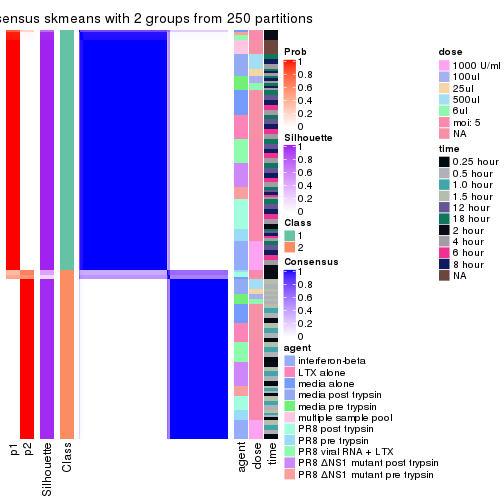
consensus_heatmap(res, k = 3)
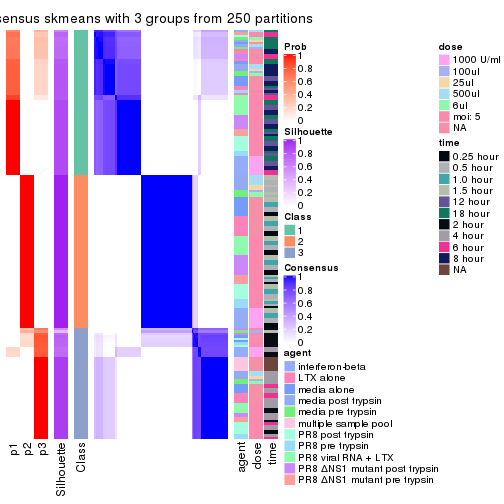
consensus_heatmap(res, k = 4)
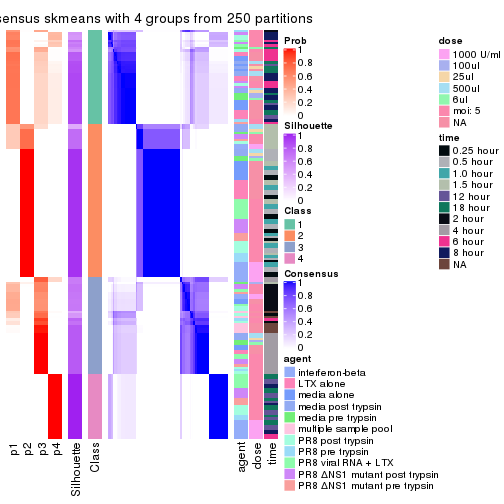
consensus_heatmap(res, k = 5)
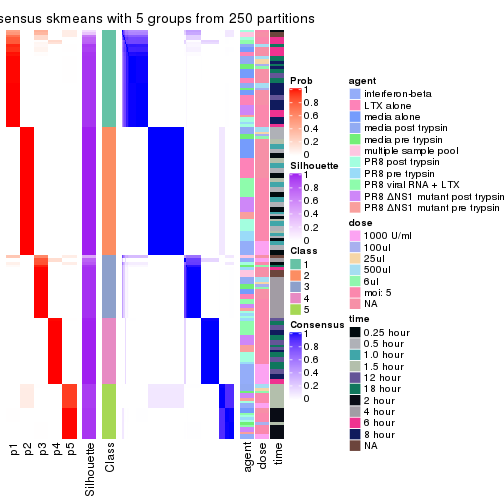
consensus_heatmap(res, k = 6)
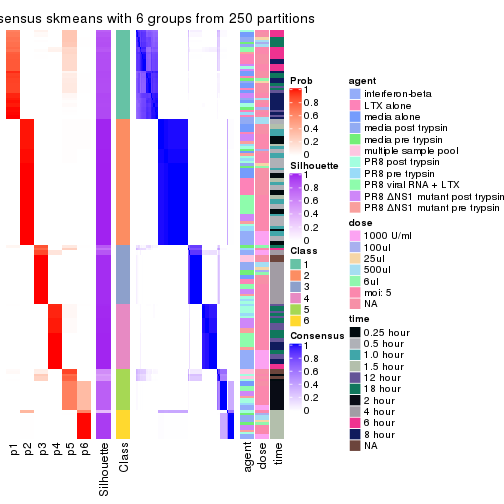
Heatmaps for the membership of samples in all partitions to see how consistent they are:
membership_heatmap(res, k = 2)
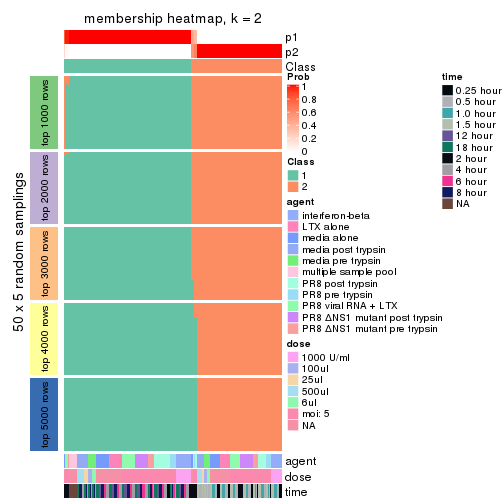
membership_heatmap(res, k = 3)
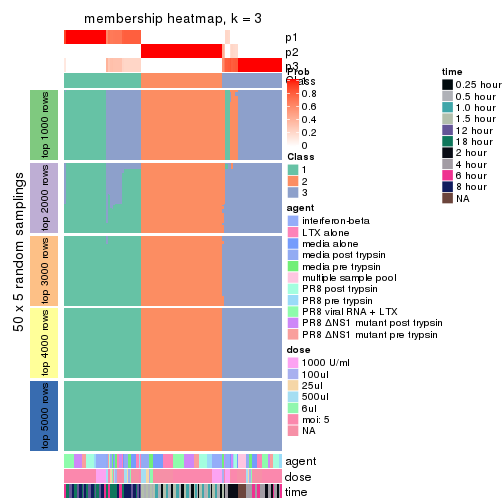
membership_heatmap(res, k = 4)
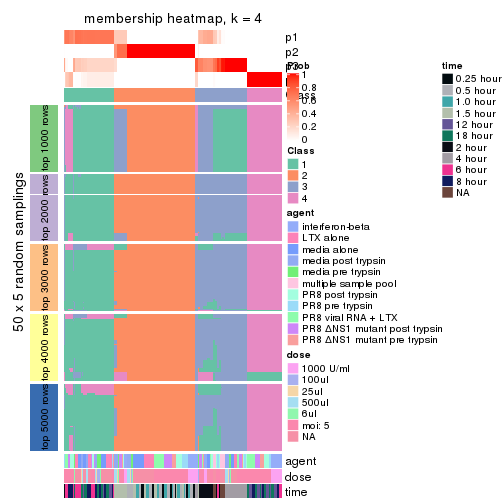
membership_heatmap(res, k = 5)
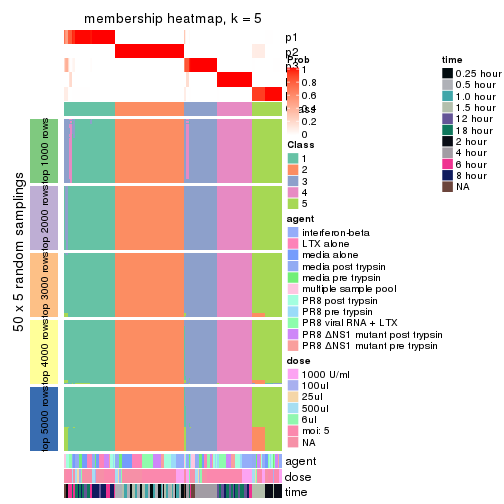
membership_heatmap(res, k = 6)
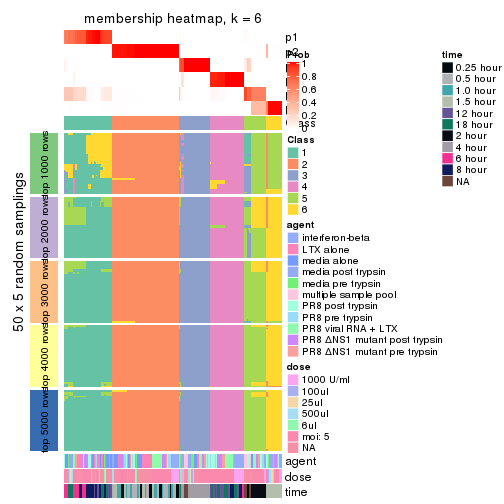
As soon as we have had the classes for columns, we can look for signatures which are significantly different between classes which can be candidate marks for certain classes. Following are the heatmaps for signatures.
Signature heatmaps where rows are scaled:
get_signatures(res, k = 2)
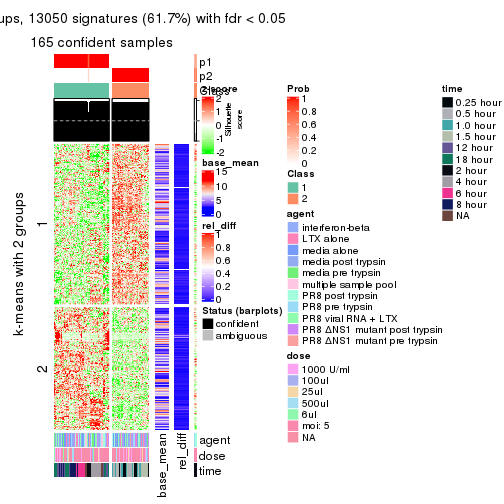
get_signatures(res, k = 3)
#> Error in mat[ceiling(1:nr/h_ratio), ceiling(1:nc/w_ratio), drop = FALSE]: subscript out of bounds
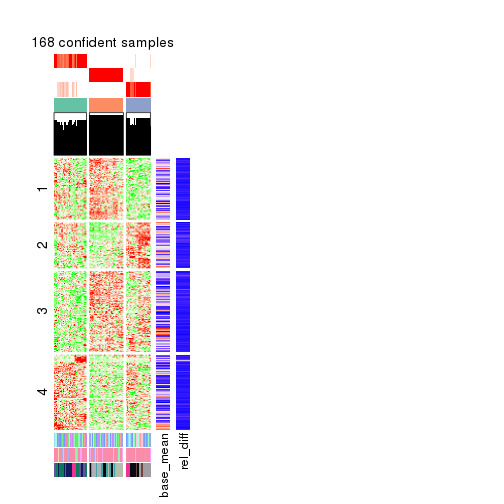
get_signatures(res, k = 4)
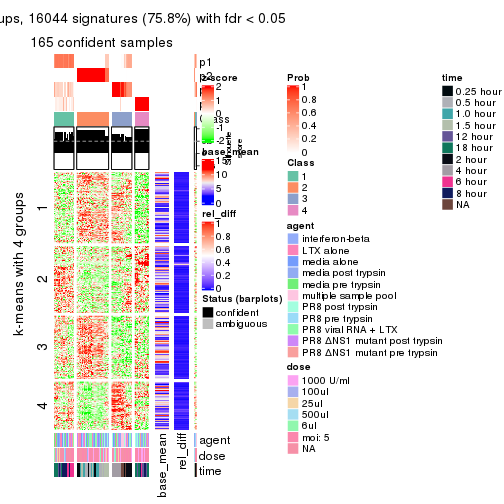
get_signatures(res, k = 5)
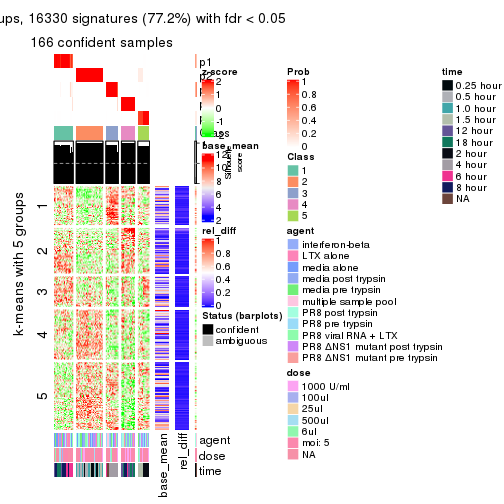
get_signatures(res, k = 6)
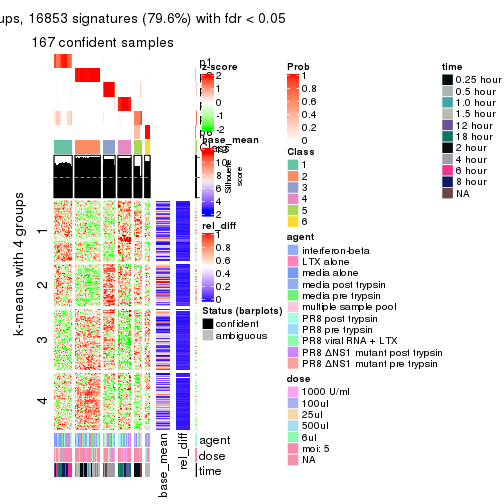
Signature heatmaps where rows are not scaled:
get_signatures(res, k = 2, scale_rows = FALSE)
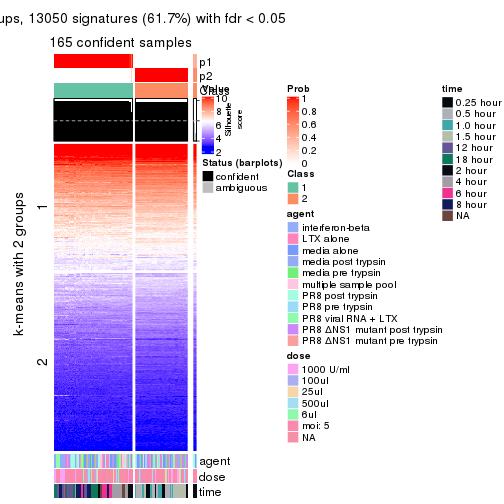
get_signatures(res, k = 3, scale_rows = FALSE)
#> Error in mat[ceiling(1:nr/h_ratio), ceiling(1:nc/w_ratio), drop = FALSE]: subscript out of bounds
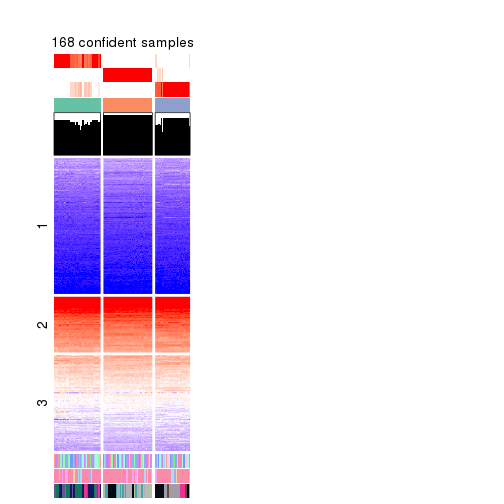
get_signatures(res, k = 4, scale_rows = FALSE)
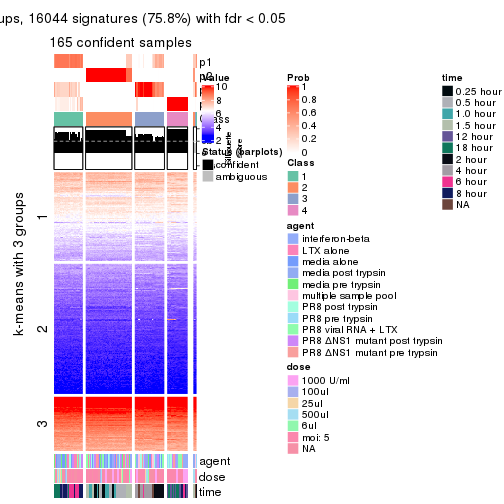
get_signatures(res, k = 5, scale_rows = FALSE)
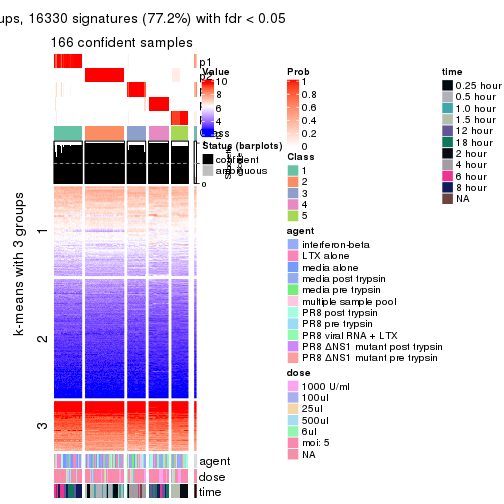
get_signatures(res, k = 6, scale_rows = FALSE)
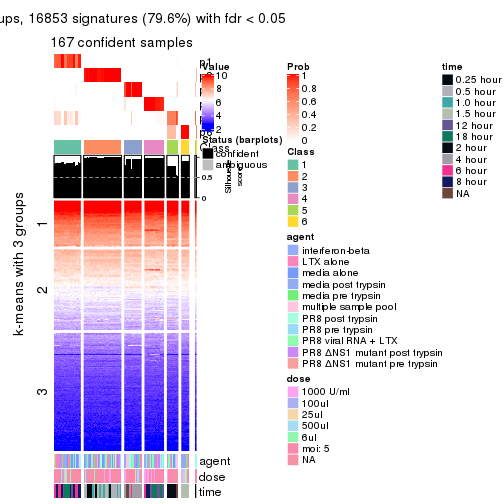
Compare the overlap of signatures from different k:
compare_signatures(res)
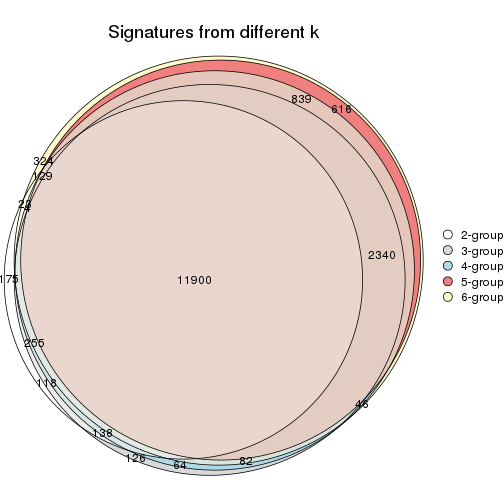
get_signature() returns a data frame invisibly. TO get the list of signatures, the function
call should be assigned to a variable explicitly. In following code, if plot argument is set
to FALSE, no heatmap is plotted while only the differential analysis is performed.
# code only for demonstration
tb = get_signature(res, k = ..., plot = FALSE)
An example of the output of tb is:
#> which_row fdr mean_1 mean_2 scaled_mean_1 scaled_mean_2 km
#> 1 38 0.042760348 8.373488 9.131774 -0.5533452 0.5164555 1
#> 2 40 0.018707592 7.106213 8.469186 -0.6173731 0.5762149 1
#> 3 55 0.019134737 10.221463 11.207825 -0.6159697 0.5749050 1
#> 4 59 0.006059896 5.921854 7.869574 -0.6899429 0.6439467 1
#> 5 60 0.018055526 8.928898 10.211722 -0.6204761 0.5791110 1
#> 6 98 0.009384629 15.714769 14.887706 0.6635654 -0.6193277 2
...
The columns in tb are:
which_row: row indices corresponding to the input matrix.fdr: FDR for the differential test. mean_x: The mean value in group x.scaled_mean_x: The mean value in group x after rows are scaled.km: Row groups if k-means clustering is applied to rows.UMAP plot which shows how samples are separated.
dimension_reduction(res, k = 2, method = "UMAP")
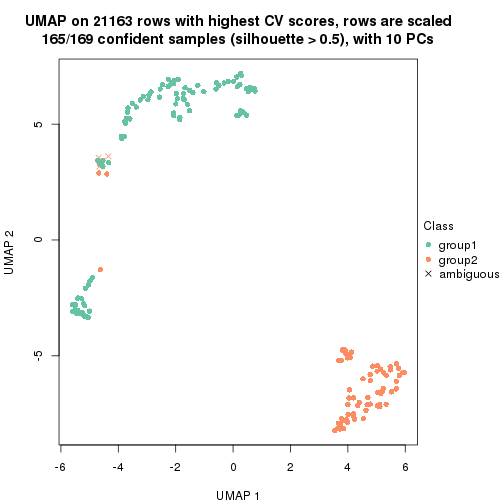
dimension_reduction(res, k = 3, method = "UMAP")
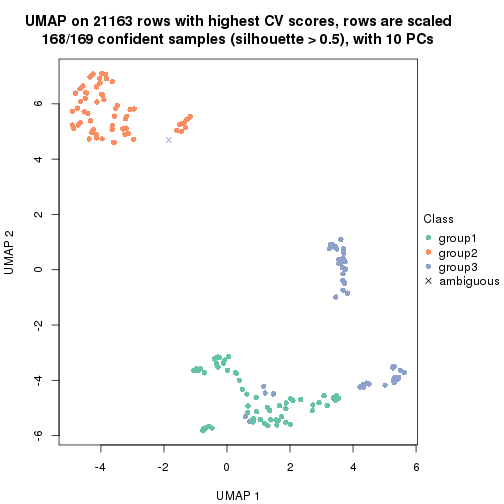
dimension_reduction(res, k = 4, method = "UMAP")
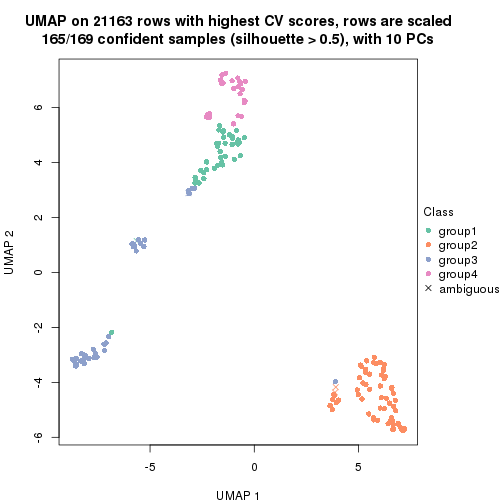
dimension_reduction(res, k = 5, method = "UMAP")
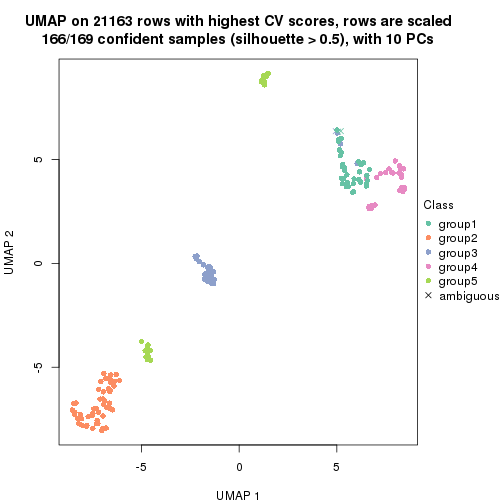
dimension_reduction(res, k = 6, method = "UMAP")
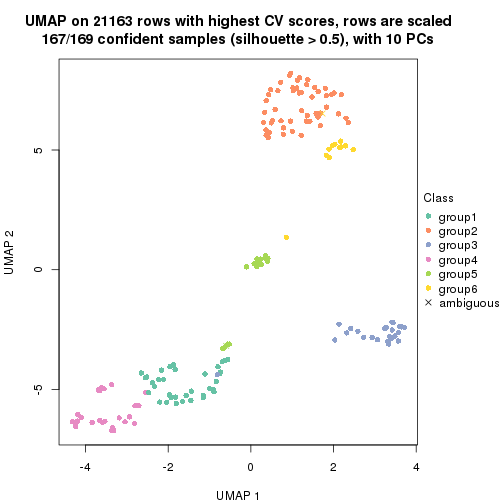
Following heatmap shows how subgroups are split when increasing k:
collect_classes(res)
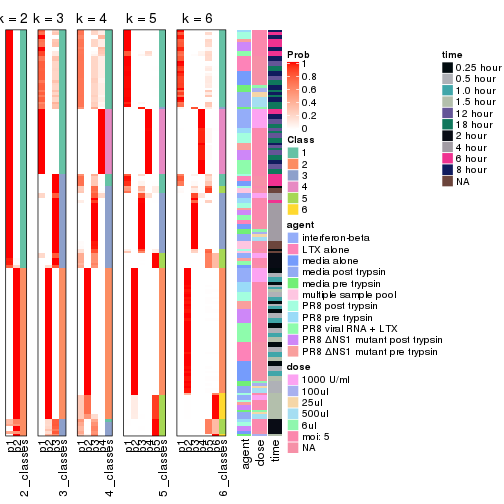
Test correlation between subgroups and known annotations. If the known annotation is numeric, one-way ANOVA test is applied, and if the known annotation is discrete, chi-squared contingency table test is applied.
test_to_known_factors(res)
#> n agent(p) dose(p) time(p) k
#> CV:skmeans 165 0.86112 0.99980 1.74e-27 2
#> CV:skmeans 168 0.43376 0.98472 2.35e-52 3
#> CV:skmeans 165 0.00153 0.00527 4.77e-53 4
#> CV:skmeans 166 0.01727 0.00715 2.85e-70 5
#> CV:skmeans 167 0.00243 0.00679 5.64e-88 6
If matrix rows can be associated to genes, consider to use functional_enrichment(res,
...) to perform function enrichment for the signature genes. See this vignette for more detailed explanations.
The object with results only for a single top-value method and a single partition method can be extracted as:
res = res_list["CV", "pam"]
# you can also extract it by
# res = res_list["CV:pam"]
A summary of res and all the functions that can be applied to it:
res
#> A 'ConsensusPartition' object with k = 2, 3, 4, 5, 6.
#> On a matrix with 21163 rows and 169 columns.
#> Top rows (1000, 2000, 3000, 4000, 5000) are extracted by 'CV' method.
#> Subgroups are detected by 'pam' method.
#> Performed in total 1250 partitions by row resampling.
#> Best k for subgroups seems to be 5.
#>
#> Following methods can be applied to this 'ConsensusPartition' object:
#> [1] "cola_report" "collect_classes" "collect_plots"
#> [4] "collect_stats" "colnames" "compare_signatures"
#> [7] "consensus_heatmap" "dimension_reduction" "functional_enrichment"
#> [10] "get_anno_col" "get_anno" "get_classes"
#> [13] "get_consensus" "get_matrix" "get_membership"
#> [16] "get_param" "get_signatures" "get_stats"
#> [19] "is_best_k" "is_stable_k" "membership_heatmap"
#> [22] "ncol" "nrow" "plot_ecdf"
#> [25] "rownames" "select_partition_number" "show"
#> [28] "suggest_best_k" "test_to_known_factors"
collect_plots() function collects all the plots made from res for all k (number of partitions)
into one single page to provide an easy and fast comparison between different k.
collect_plots(res)
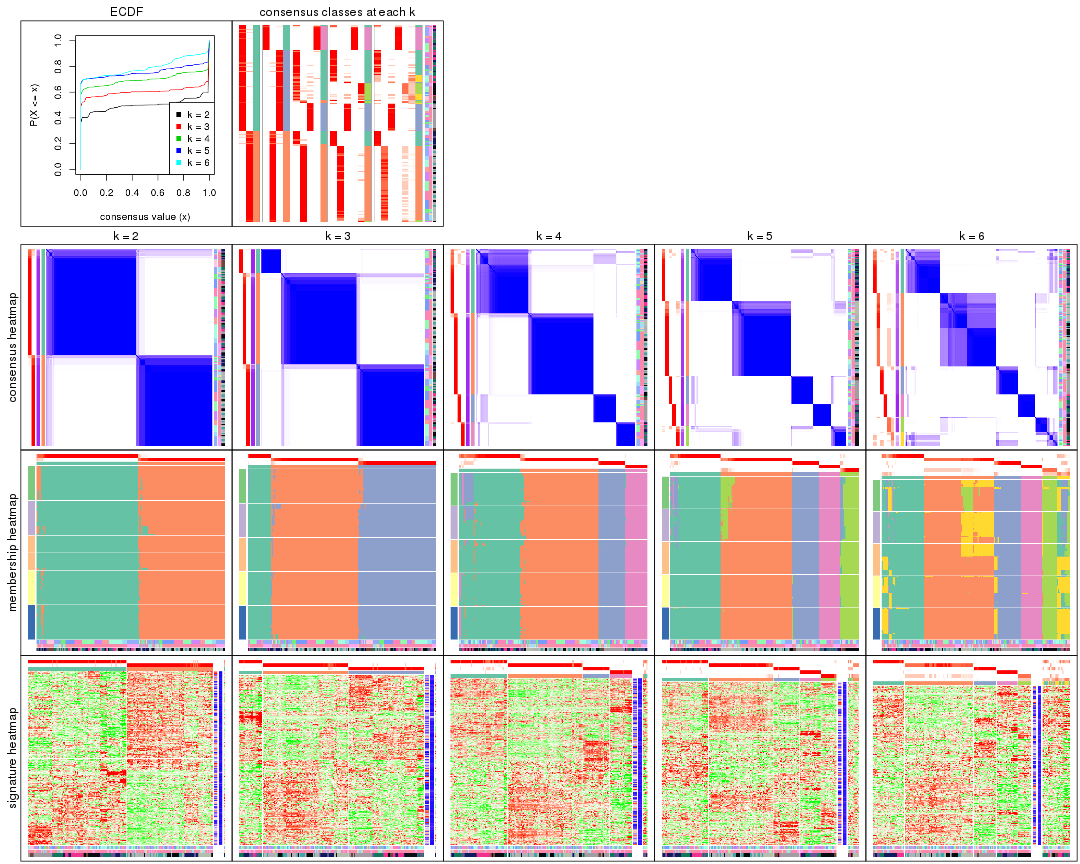
The plots are:
k and the heatmap of
predicted classes for each k.k.k.k.All the plots in panels can be made by individual functions and they are plotted later in this section.
select_partition_number() produces several plots showing different
statistics for choosing “optimized” k. There are following statistics:
k;k, the area increased is defined as \(A_k - A_{k-1}\).The detailed explanations of these statistics can be found in the cola vignette.
Generally speaking, lower PAC score, higher mean silhouette score or higher
concordance corresponds to better partition. Rand index and Jaccard index
measure how similar the current partition is compared to partition with k-1.
If they are too similar, we won't accept k is better than k-1.
select_partition_number(res)
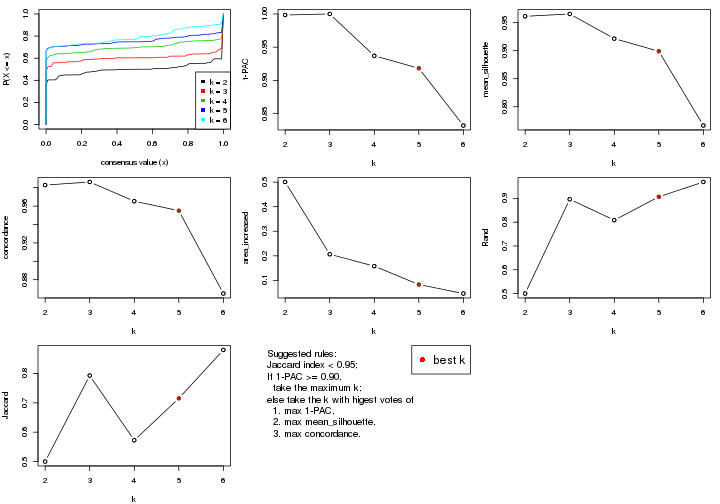
The numeric values for all these statistics can be obtained by get_stats().
get_stats(res)
#> k 1-PAC mean_silhouette concordance area_increased Rand Jaccard
#> 2 2 0.998 0.961 0.983 0.5005 0.500 0.500
#> 3 3 1.000 0.965 0.986 0.2064 0.896 0.793
#> 4 4 0.937 0.921 0.965 0.1580 0.809 0.572
#> 5 5 0.918 0.899 0.955 0.0832 0.907 0.715
#> 6 6 0.832 0.767 0.865 0.0467 0.969 0.880
suggest_best_k() suggests the best \(k\) based on these statistics. The rules are as follows:
suggest_best_k(res)
#> [1] 5
#> attr(,"optional")
#> [1] 2 3 4
There is also optional best \(k\) = 2 3 4 that is worth to check.
Following shows the table of the partitions (You need to click the show/hide
code output link to see it). The membership matrix (columns with name p*)
is inferred by
clue::cl_consensus()
function with the SE method. Basically the value in the membership matrix
represents the probability to belong to a certain group. The finall class
label for an item is determined with the group with highest probability it
belongs to.
In get_classes() function, the entropy is calculated from the membership
matrix and the silhouette score is calculated from the consensus matrix.
cbind(get_classes(res, k = 2), get_membership(res, k = 2))
#> class entropy silhouette p1 p2
#> GSM528681 2 0.0000 0.983 0.000 1.000
#> GSM528682 2 0.0000 0.983 0.000 1.000
#> GSM528683 2 0.0000 0.983 0.000 1.000
#> GSM528684 2 0.0000 0.983 0.000 1.000
#> GSM528687 2 0.0000 0.983 0.000 1.000
#> GSM528688 2 0.0000 0.983 0.000 1.000
#> GSM528685 2 0.0000 0.983 0.000 1.000
#> GSM528686 2 0.0000 0.983 0.000 1.000
#> GSM528693 1 0.0000 0.981 1.000 0.000
#> GSM528694 1 0.0000 0.981 1.000 0.000
#> GSM528695 1 0.0000 0.981 1.000 0.000
#> GSM528696 1 0.0000 0.981 1.000 0.000
#> GSM528697 1 0.0000 0.981 1.000 0.000
#> GSM528698 1 0.0000 0.981 1.000 0.000
#> GSM528699 1 0.8267 0.657 0.740 0.260
#> GSM528700 1 0.0000 0.981 1.000 0.000
#> GSM528689 1 0.0000 0.981 1.000 0.000
#> GSM528690 1 0.7528 0.726 0.784 0.216
#> GSM528691 1 0.0000 0.981 1.000 0.000
#> GSM528692 1 0.0000 0.981 1.000 0.000
#> GSM528779 2 0.0000 0.983 0.000 1.000
#> GSM528780 2 0.0000 0.983 0.000 1.000
#> GSM528782 2 0.0000 0.983 0.000 1.000
#> GSM528781 2 0.0000 0.983 0.000 1.000
#> GSM528785 1 0.7219 0.752 0.800 0.200
#> GSM528786 1 0.0000 0.981 1.000 0.000
#> GSM528787 1 0.0000 0.981 1.000 0.000
#> GSM528788 2 0.3274 0.931 0.060 0.940
#> GSM528783 1 0.0000 0.981 1.000 0.000
#> GSM528784 1 0.0000 0.981 1.000 0.000
#> GSM528759 1 0.0000 0.981 1.000 0.000
#> GSM528760 1 0.0000 0.981 1.000 0.000
#> GSM528761 2 0.0000 0.983 0.000 1.000
#> GSM528762 2 0.0000 0.983 0.000 1.000
#> GSM528765 2 0.0000 0.983 0.000 1.000
#> GSM528766 2 0.0000 0.983 0.000 1.000
#> GSM528763 2 0.0000 0.983 0.000 1.000
#> GSM528764 2 0.0000 0.983 0.000 1.000
#> GSM528771 1 0.0000 0.981 1.000 0.000
#> GSM528772 1 0.0000 0.981 1.000 0.000
#> GSM528773 1 0.0000 0.981 1.000 0.000
#> GSM528774 1 0.0000 0.981 1.000 0.000
#> GSM528775 1 0.0000 0.981 1.000 0.000
#> GSM528776 1 0.0000 0.981 1.000 0.000
#> GSM528777 2 0.3431 0.927 0.064 0.936
#> GSM528778 2 0.8713 0.594 0.292 0.708
#> GSM528767 1 0.0000 0.981 1.000 0.000
#> GSM528768 1 0.0000 0.981 1.000 0.000
#> GSM528769 1 0.0000 0.981 1.000 0.000
#> GSM528770 1 0.0000 0.981 1.000 0.000
#> GSM528671 2 0.0000 0.983 0.000 1.000
#> GSM528672 2 0.0000 0.983 0.000 1.000
#> GSM528674 2 0.0000 0.983 0.000 1.000
#> GSM528673 2 0.0000 0.983 0.000 1.000
#> GSM528677 1 0.0000 0.981 1.000 0.000
#> GSM528678 1 0.0000 0.981 1.000 0.000
#> GSM528679 1 0.0000 0.981 1.000 0.000
#> GSM528680 1 0.0000 0.981 1.000 0.000
#> GSM528675 1 0.0000 0.981 1.000 0.000
#> GSM528676 1 0.0000 0.981 1.000 0.000
#> GSM528651 2 0.0000 0.983 0.000 1.000
#> GSM528652 2 0.0000 0.983 0.000 1.000
#> GSM528653 2 0.0000 0.983 0.000 1.000
#> GSM528654 2 0.0000 0.983 0.000 1.000
#> GSM528657 2 0.0000 0.983 0.000 1.000
#> GSM528658 2 0.0000 0.983 0.000 1.000
#> GSM528655 2 0.0000 0.983 0.000 1.000
#> GSM528656 2 0.0000 0.983 0.000 1.000
#> GSM528663 1 0.3274 0.925 0.940 0.060
#> GSM528664 2 0.0376 0.981 0.004 0.996
#> GSM528665 1 0.0000 0.981 1.000 0.000
#> GSM528666 1 0.0000 0.981 1.000 0.000
#> GSM528667 1 0.0000 0.981 1.000 0.000
#> GSM528668 1 0.0000 0.981 1.000 0.000
#> GSM528669 2 0.3431 0.927 0.064 0.936
#> GSM528670 1 0.0672 0.974 0.992 0.008
#> GSM528659 1 0.4562 0.886 0.904 0.096
#> GSM528660 1 0.0000 0.981 1.000 0.000
#> GSM528661 1 0.0000 0.981 1.000 0.000
#> GSM528662 1 0.0000 0.981 1.000 0.000
#> GSM528701 2 0.0000 0.983 0.000 1.000
#> GSM528702 2 0.0000 0.983 0.000 1.000
#> GSM528703 2 0.0000 0.983 0.000 1.000
#> GSM528704 2 0.0000 0.983 0.000 1.000
#> GSM528707 2 0.0000 0.983 0.000 1.000
#> GSM528708 2 0.0000 0.983 0.000 1.000
#> GSM528705 2 0.0000 0.983 0.000 1.000
#> GSM528706 2 0.0000 0.983 0.000 1.000
#> GSM528713 1 0.0000 0.981 1.000 0.000
#> GSM528714 1 0.0000 0.981 1.000 0.000
#> GSM528715 1 0.0000 0.981 1.000 0.000
#> GSM528716 1 0.0000 0.981 1.000 0.000
#> GSM528717 1 0.0000 0.981 1.000 0.000
#> GSM528718 1 0.0000 0.981 1.000 0.000
#> GSM528719 1 0.0000 0.981 1.000 0.000
#> GSM528720 1 0.0000 0.981 1.000 0.000
#> GSM528709 1 0.0000 0.981 1.000 0.000
#> GSM528710 1 0.0376 0.978 0.996 0.004
#> GSM528711 1 0.0000 0.981 1.000 0.000
#> GSM528712 1 0.0000 0.981 1.000 0.000
#> GSM528721 2 0.0000 0.983 0.000 1.000
#> GSM528722 2 0.0000 0.983 0.000 1.000
#> GSM528723 2 0.0000 0.983 0.000 1.000
#> GSM528724 2 0.0000 0.983 0.000 1.000
#> GSM528727 2 0.0000 0.983 0.000 1.000
#> GSM528728 2 0.0000 0.983 0.000 1.000
#> GSM528725 2 0.0000 0.983 0.000 1.000
#> GSM528726 2 0.0000 0.983 0.000 1.000
#> GSM528733 1 0.0000 0.981 1.000 0.000
#> GSM528734 1 0.0000 0.981 1.000 0.000
#> GSM528735 1 0.0000 0.981 1.000 0.000
#> GSM528736 1 0.0000 0.981 1.000 0.000
#> GSM528737 1 0.0000 0.981 1.000 0.000
#> GSM528738 1 0.0000 0.981 1.000 0.000
#> GSM528729 2 0.3431 0.927 0.064 0.936
#> GSM528730 2 0.7815 0.707 0.232 0.768
#> GSM528731 1 0.7219 0.752 0.800 0.200
#> GSM528732 1 0.0000 0.981 1.000 0.000
#> GSM528739 2 0.0000 0.983 0.000 1.000
#> GSM528740 2 0.0000 0.983 0.000 1.000
#> GSM528741 2 0.0000 0.983 0.000 1.000
#> GSM528742 2 0.0000 0.983 0.000 1.000
#> GSM528745 2 0.0000 0.983 0.000 1.000
#> GSM528746 2 0.0000 0.983 0.000 1.000
#> GSM528743 2 0.0000 0.983 0.000 1.000
#> GSM528744 2 0.0000 0.983 0.000 1.000
#> GSM528751 1 0.0000 0.981 1.000 0.000
#> GSM528752 1 0.0000 0.981 1.000 0.000
#> GSM528753 1 0.0000 0.981 1.000 0.000
#> GSM528754 1 0.0000 0.981 1.000 0.000
#> GSM528755 1 0.0000 0.981 1.000 0.000
#> GSM528756 1 0.0000 0.981 1.000 0.000
#> GSM528757 2 0.0000 0.983 0.000 1.000
#> GSM528758 2 0.0000 0.983 0.000 1.000
#> GSM528747 1 0.7299 0.752 0.796 0.204
#> GSM528748 2 0.0376 0.981 0.004 0.996
#> GSM528749 1 0.0000 0.981 1.000 0.000
#> GSM528750 1 0.0000 0.981 1.000 0.000
#> GSM528640 2 0.0000 0.983 0.000 1.000
#> GSM528641 2 0.0000 0.983 0.000 1.000
#> GSM528643 1 0.0000 0.981 1.000 0.000
#> GSM528644 2 0.0376 0.981 0.004 0.996
#> GSM528642 1 0.0000 0.981 1.000 0.000
#> GSM528620 2 0.0000 0.983 0.000 1.000
#> GSM528621 2 0.3879 0.913 0.076 0.924
#> GSM528623 1 0.0000 0.981 1.000 0.000
#> GSM528624 2 0.3431 0.927 0.064 0.936
#> GSM528622 1 0.0000 0.981 1.000 0.000
#> GSM528625 2 0.0000 0.983 0.000 1.000
#> GSM528626 2 0.0000 0.983 0.000 1.000
#> GSM528628 1 0.0000 0.981 1.000 0.000
#> GSM528629 1 0.9710 0.350 0.600 0.400
#> GSM528627 1 0.0000 0.981 1.000 0.000
#> GSM528630 2 0.0000 0.983 0.000 1.000
#> GSM528631 2 0.0000 0.983 0.000 1.000
#> GSM528632 2 0.0376 0.981 0.004 0.996
#> GSM528633 2 0.0376 0.981 0.004 0.996
#> GSM528636 1 0.0000 0.981 1.000 0.000
#> GSM528637 1 0.0000 0.981 1.000 0.000
#> GSM528638 2 0.0672 0.977 0.008 0.992
#> GSM528639 2 0.8955 0.544 0.312 0.688
#> GSM528634 1 0.0000 0.981 1.000 0.000
#> GSM528635 1 0.0000 0.981 1.000 0.000
#> GSM528645 1 0.0000 0.981 1.000 0.000
#> GSM528646 1 0.0000 0.981 1.000 0.000
#> GSM528647 1 0.0000 0.981 1.000 0.000
#> GSM528648 1 0.0000 0.981 1.000 0.000
#> GSM528649 1 0.0000 0.981 1.000 0.000
#> GSM528650 1 0.0000 0.981 1.000 0.000
cbind(get_classes(res, k = 3), get_membership(res, k = 3))
#> class entropy silhouette p1 p2 p3
#> GSM528681 2 0.0000 0.982 0.000 1.000 0.000
#> GSM528682 2 0.0000 0.982 0.000 1.000 0.000
#> GSM528683 2 0.0000 0.982 0.000 1.000 0.000
#> GSM528684 2 0.0000 0.982 0.000 1.000 0.000
#> GSM528687 2 0.0000 0.982 0.000 1.000 0.000
#> GSM528688 2 0.0000 0.982 0.000 1.000 0.000
#> GSM528685 2 0.0000 0.982 0.000 1.000 0.000
#> GSM528686 2 0.0000 0.982 0.000 1.000 0.000
#> GSM528693 3 0.0000 0.981 0.000 0.000 1.000
#> GSM528694 3 0.0000 0.981 0.000 0.000 1.000
#> GSM528695 3 0.0000 0.981 0.000 0.000 1.000
#> GSM528696 3 0.0000 0.981 0.000 0.000 1.000
#> GSM528697 1 0.0237 0.990 0.996 0.000 0.004
#> GSM528698 1 0.0000 0.994 1.000 0.000 0.000
#> GSM528699 1 0.0000 0.994 1.000 0.000 0.000
#> GSM528700 1 0.0000 0.994 1.000 0.000 0.000
#> GSM528689 1 0.0000 0.994 1.000 0.000 0.000
#> GSM528690 1 0.0000 0.994 1.000 0.000 0.000
#> GSM528691 1 0.0000 0.994 1.000 0.000 0.000
#> GSM528692 1 0.0000 0.994 1.000 0.000 0.000
#> GSM528779 2 0.0000 0.982 0.000 1.000 0.000
#> GSM528780 2 0.0000 0.982 0.000 1.000 0.000
#> GSM528782 2 0.0000 0.982 0.000 1.000 0.000
#> GSM528781 2 0.0000 0.982 0.000 1.000 0.000
#> GSM528785 3 0.4555 0.718 0.000 0.200 0.800
#> GSM528786 3 0.0000 0.981 0.000 0.000 1.000
#> GSM528787 3 0.0000 0.981 0.000 0.000 1.000
#> GSM528788 2 0.1289 0.952 0.000 0.968 0.032
#> GSM528783 3 0.0000 0.981 0.000 0.000 1.000
#> GSM528784 3 0.0000 0.981 0.000 0.000 1.000
#> GSM528759 3 0.0000 0.981 0.000 0.000 1.000
#> GSM528760 3 0.0000 0.981 0.000 0.000 1.000
#> GSM528761 2 0.0000 0.982 0.000 1.000 0.000
#> GSM528762 2 0.0000 0.982 0.000 1.000 0.000
#> GSM528765 2 0.0000 0.982 0.000 1.000 0.000
#> GSM528766 2 0.0000 0.982 0.000 1.000 0.000
#> GSM528763 2 0.0000 0.982 0.000 1.000 0.000
#> GSM528764 2 0.0000 0.982 0.000 1.000 0.000
#> GSM528771 3 0.0000 0.981 0.000 0.000 1.000
#> GSM528772 3 0.0000 0.981 0.000 0.000 1.000
#> GSM528773 3 0.0000 0.981 0.000 0.000 1.000
#> GSM528774 3 0.0000 0.981 0.000 0.000 1.000
#> GSM528775 3 0.0000 0.981 0.000 0.000 1.000
#> GSM528776 3 0.0000 0.981 0.000 0.000 1.000
#> GSM528777 2 0.2569 0.927 0.032 0.936 0.032
#> GSM528778 2 0.6522 0.578 0.032 0.696 0.272
#> GSM528767 3 0.1031 0.959 0.024 0.000 0.976
#> GSM528768 3 0.0000 0.981 0.000 0.000 1.000
#> GSM528769 3 0.0000 0.981 0.000 0.000 1.000
#> GSM528770 3 0.0000 0.981 0.000 0.000 1.000
#> GSM528671 2 0.0000 0.982 0.000 1.000 0.000
#> GSM528672 2 0.0000 0.982 0.000 1.000 0.000
#> GSM528674 2 0.0000 0.982 0.000 1.000 0.000
#> GSM528673 2 0.0000 0.982 0.000 1.000 0.000
#> GSM528677 3 0.0000 0.981 0.000 0.000 1.000
#> GSM528678 3 0.0000 0.981 0.000 0.000 1.000
#> GSM528679 3 0.0000 0.981 0.000 0.000 1.000
#> GSM528680 1 0.3340 0.865 0.880 0.000 0.120
#> GSM528675 1 0.0000 0.994 1.000 0.000 0.000
#> GSM528676 1 0.0000 0.994 1.000 0.000 0.000
#> GSM528651 2 0.0000 0.982 0.000 1.000 0.000
#> GSM528652 2 0.0000 0.982 0.000 1.000 0.000
#> GSM528653 2 0.0000 0.982 0.000 1.000 0.000
#> GSM528654 2 0.0000 0.982 0.000 1.000 0.000
#> GSM528657 2 0.0000 0.982 0.000 1.000 0.000
#> GSM528658 2 0.0000 0.982 0.000 1.000 0.000
#> GSM528655 2 0.0000 0.982 0.000 1.000 0.000
#> GSM528656 2 0.0000 0.982 0.000 1.000 0.000
#> GSM528663 3 0.1163 0.949 0.000 0.028 0.972
#> GSM528664 2 0.0237 0.979 0.000 0.996 0.004
#> GSM528665 3 0.0000 0.981 0.000 0.000 1.000
#> GSM528666 3 0.0000 0.981 0.000 0.000 1.000
#> GSM528667 3 0.0000 0.981 0.000 0.000 1.000
#> GSM528668 3 0.0000 0.981 0.000 0.000 1.000
#> GSM528669 2 0.2569 0.927 0.032 0.936 0.032
#> GSM528670 3 0.1711 0.945 0.032 0.008 0.960
#> GSM528659 1 0.0000 0.994 1.000 0.000 0.000
#> GSM528660 1 0.0000 0.994 1.000 0.000 0.000
#> GSM528661 1 0.0000 0.994 1.000 0.000 0.000
#> GSM528662 1 0.0000 0.994 1.000 0.000 0.000
#> GSM528701 2 0.0000 0.982 0.000 1.000 0.000
#> GSM528702 2 0.0000 0.982 0.000 1.000 0.000
#> GSM528703 2 0.0000 0.982 0.000 1.000 0.000
#> GSM528704 2 0.0000 0.982 0.000 1.000 0.000
#> GSM528707 2 0.0000 0.982 0.000 1.000 0.000
#> GSM528708 2 0.0000 0.982 0.000 1.000 0.000
#> GSM528705 2 0.0000 0.982 0.000 1.000 0.000
#> GSM528706 2 0.0000 0.982 0.000 1.000 0.000
#> GSM528713 3 0.0000 0.981 0.000 0.000 1.000
#> GSM528714 3 0.0000 0.981 0.000 0.000 1.000
#> GSM528715 3 0.0000 0.981 0.000 0.000 1.000
#> GSM528716 3 0.0000 0.981 0.000 0.000 1.000
#> GSM528717 3 0.0000 0.981 0.000 0.000 1.000
#> GSM528718 3 0.0000 0.981 0.000 0.000 1.000
#> GSM528719 1 0.0000 0.994 1.000 0.000 0.000
#> GSM528720 1 0.0000 0.994 1.000 0.000 0.000
#> GSM528709 1 0.0000 0.994 1.000 0.000 0.000
#> GSM528710 1 0.0000 0.994 1.000 0.000 0.000
#> GSM528711 1 0.0000 0.994 1.000 0.000 0.000
#> GSM528712 1 0.0000 0.994 1.000 0.000 0.000
#> GSM528721 2 0.0000 0.982 0.000 1.000 0.000
#> GSM528722 2 0.0000 0.982 0.000 1.000 0.000
#> GSM528723 2 0.0000 0.982 0.000 1.000 0.000
#> GSM528724 2 0.0000 0.982 0.000 1.000 0.000
#> GSM528727 2 0.0000 0.982 0.000 1.000 0.000
#> GSM528728 2 0.0000 0.982 0.000 1.000 0.000
#> GSM528725 2 0.0000 0.982 0.000 1.000 0.000
#> GSM528726 2 0.0000 0.982 0.000 1.000 0.000
#> GSM528733 3 0.0000 0.981 0.000 0.000 1.000
#> GSM528734 3 0.0000 0.981 0.000 0.000 1.000
#> GSM528735 3 0.0000 0.981 0.000 0.000 1.000
#> GSM528736 3 0.0000 0.981 0.000 0.000 1.000
#> GSM528737 3 0.0000 0.981 0.000 0.000 1.000
#> GSM528738 3 0.0000 0.981 0.000 0.000 1.000
#> GSM528729 2 0.1289 0.952 0.000 0.968 0.032
#> GSM528730 2 0.4654 0.720 0.000 0.792 0.208
#> GSM528731 3 0.4605 0.712 0.000 0.204 0.796
#> GSM528732 3 0.0000 0.981 0.000 0.000 1.000
#> GSM528739 2 0.0000 0.982 0.000 1.000 0.000
#> GSM528740 2 0.0000 0.982 0.000 1.000 0.000
#> GSM528741 2 0.0000 0.982 0.000 1.000 0.000
#> GSM528742 2 0.0000 0.982 0.000 1.000 0.000
#> GSM528745 2 0.0000 0.982 0.000 1.000 0.000
#> GSM528746 2 0.0000 0.982 0.000 1.000 0.000
#> GSM528743 2 0.0000 0.982 0.000 1.000 0.000
#> GSM528744 2 0.0000 0.982 0.000 1.000 0.000
#> GSM528751 3 0.0000 0.981 0.000 0.000 1.000
#> GSM528752 3 0.0000 0.981 0.000 0.000 1.000
#> GSM528753 3 0.0000 0.981 0.000 0.000 1.000
#> GSM528754 3 0.0000 0.981 0.000 0.000 1.000
#> GSM528755 3 0.0000 0.981 0.000 0.000 1.000
#> GSM528756 3 0.0000 0.981 0.000 0.000 1.000
#> GSM528757 2 0.0000 0.982 0.000 1.000 0.000
#> GSM528758 2 0.0000 0.982 0.000 1.000 0.000
#> GSM528747 3 0.4178 0.763 0.000 0.172 0.828
#> GSM528748 2 0.0237 0.979 0.000 0.996 0.004
#> GSM528749 3 0.0000 0.981 0.000 0.000 1.000
#> GSM528750 3 0.0000 0.981 0.000 0.000 1.000
#> GSM528640 2 0.0000 0.982 0.000 1.000 0.000
#> GSM528641 2 0.0000 0.982 0.000 1.000 0.000
#> GSM528643 3 0.0000 0.981 0.000 0.000 1.000
#> GSM528644 2 0.0237 0.979 0.000 0.996 0.004
#> GSM528642 3 0.0000 0.981 0.000 0.000 1.000
#> GSM528620 2 0.0000 0.982 0.000 1.000 0.000
#> GSM528621 2 0.2448 0.899 0.000 0.924 0.076
#> GSM528623 3 0.0000 0.981 0.000 0.000 1.000
#> GSM528624 2 0.1289 0.952 0.000 0.968 0.032
#> GSM528622 3 0.0000 0.981 0.000 0.000 1.000
#> GSM528625 2 0.0000 0.982 0.000 1.000 0.000
#> GSM528626 2 0.0000 0.982 0.000 1.000 0.000
#> GSM528628 3 0.0000 0.981 0.000 0.000 1.000
#> GSM528629 3 0.6079 0.376 0.000 0.388 0.612
#> GSM528627 3 0.0000 0.981 0.000 0.000 1.000
#> GSM528630 2 0.0000 0.982 0.000 1.000 0.000
#> GSM528631 2 0.0000 0.982 0.000 1.000 0.000
#> GSM528632 2 0.0237 0.979 0.000 0.996 0.004
#> GSM528633 2 0.0237 0.979 0.000 0.996 0.004
#> GSM528636 3 0.0000 0.981 0.000 0.000 1.000
#> GSM528637 3 0.0000 0.981 0.000 0.000 1.000
#> GSM528638 2 0.0424 0.976 0.000 0.992 0.008
#> GSM528639 2 0.5845 0.546 0.004 0.688 0.308
#> GSM528634 3 0.0000 0.981 0.000 0.000 1.000
#> GSM528635 3 0.0000 0.981 0.000 0.000 1.000
#> GSM528645 3 0.0000 0.981 0.000 0.000 1.000
#> GSM528646 3 0.0000 0.981 0.000 0.000 1.000
#> GSM528647 3 0.0000 0.981 0.000 0.000 1.000
#> GSM528648 3 0.0000 0.981 0.000 0.000 1.000
#> GSM528649 3 0.0000 0.981 0.000 0.000 1.000
#> GSM528650 3 0.0000 0.981 0.000 0.000 1.000
cbind(get_classes(res, k = 4), get_membership(res, k = 4))
#> class entropy silhouette p1 p2 p3 p4
#> GSM528681 2 0.0000 0.978 0.000 1.000 0.000 0.000
#> GSM528682 2 0.0000 0.978 0.000 1.000 0.000 0.000
#> GSM528683 2 0.0000 0.978 0.000 1.000 0.000 0.000
#> GSM528684 2 0.0000 0.978 0.000 1.000 0.000 0.000
#> GSM528687 2 0.0000 0.978 0.000 1.000 0.000 0.000
#> GSM528688 2 0.0000 0.978 0.000 1.000 0.000 0.000
#> GSM528685 2 0.0000 0.978 0.000 1.000 0.000 0.000
#> GSM528686 2 0.0188 0.974 0.004 0.996 0.000 0.000
#> GSM528693 1 0.0336 0.908 0.992 0.000 0.008 0.000
#> GSM528694 1 0.4134 0.682 0.740 0.000 0.260 0.000
#> GSM528695 3 0.0000 0.997 0.000 0.000 1.000 0.000
#> GSM528696 3 0.0000 0.997 0.000 0.000 1.000 0.000
#> GSM528697 1 0.3688 0.733 0.792 0.000 0.000 0.208
#> GSM528698 4 0.0336 0.981 0.008 0.000 0.000 0.992
#> GSM528699 4 0.0000 0.990 0.000 0.000 0.000 1.000
#> GSM528700 4 0.0000 0.990 0.000 0.000 0.000 1.000
#> GSM528689 4 0.0000 0.990 0.000 0.000 0.000 1.000
#> GSM528690 4 0.0000 0.990 0.000 0.000 0.000 1.000
#> GSM528691 4 0.0000 0.990 0.000 0.000 0.000 1.000
#> GSM528692 4 0.0000 0.990 0.000 0.000 0.000 1.000
#> GSM528779 2 0.0000 0.978 0.000 1.000 0.000 0.000
#> GSM528780 2 0.0000 0.978 0.000 1.000 0.000 0.000
#> GSM528782 2 0.0000 0.978 0.000 1.000 0.000 0.000
#> GSM528781 2 0.0000 0.978 0.000 1.000 0.000 0.000
#> GSM528785 1 0.1474 0.872 0.948 0.052 0.000 0.000
#> GSM528786 3 0.0000 0.997 0.000 0.000 1.000 0.000
#> GSM528787 1 0.4624 0.556 0.660 0.000 0.340 0.000
#> GSM528788 1 0.0000 0.912 1.000 0.000 0.000 0.000
#> GSM528783 2 0.4994 0.101 0.480 0.520 0.000 0.000
#> GSM528784 1 0.0336 0.907 0.992 0.000 0.000 0.008
#> GSM528759 1 0.4103 0.687 0.744 0.000 0.256 0.000
#> GSM528760 3 0.1022 0.958 0.032 0.000 0.968 0.000
#> GSM528761 2 0.0000 0.978 0.000 1.000 0.000 0.000
#> GSM528762 2 0.0000 0.978 0.000 1.000 0.000 0.000
#> GSM528765 2 0.0000 0.978 0.000 1.000 0.000 0.000
#> GSM528766 2 0.0000 0.978 0.000 1.000 0.000 0.000
#> GSM528763 2 0.0000 0.978 0.000 1.000 0.000 0.000
#> GSM528764 2 0.0000 0.978 0.000 1.000 0.000 0.000
#> GSM528771 1 0.1389 0.875 0.952 0.048 0.000 0.000
#> GSM528772 1 0.2408 0.820 0.896 0.104 0.000 0.000
#> GSM528773 3 0.0000 0.997 0.000 0.000 1.000 0.000
#> GSM528774 3 0.0000 0.997 0.000 0.000 1.000 0.000
#> GSM528775 1 0.4331 0.642 0.712 0.000 0.288 0.000
#> GSM528776 1 0.0000 0.912 1.000 0.000 0.000 0.000
#> GSM528777 1 0.0000 0.912 1.000 0.000 0.000 0.000
#> GSM528778 1 0.0000 0.912 1.000 0.000 0.000 0.000
#> GSM528767 1 0.4564 0.492 0.672 0.000 0.000 0.328
#> GSM528768 1 0.4776 0.380 0.624 0.000 0.000 0.376
#> GSM528769 1 0.0000 0.912 1.000 0.000 0.000 0.000
#> GSM528770 1 0.0000 0.912 1.000 0.000 0.000 0.000
#> GSM528671 2 0.0000 0.978 0.000 1.000 0.000 0.000
#> GSM528672 2 0.0000 0.978 0.000 1.000 0.000 0.000
#> GSM528674 2 0.0000 0.978 0.000 1.000 0.000 0.000
#> GSM528673 2 0.0000 0.978 0.000 1.000 0.000 0.000
#> GSM528677 2 0.3764 0.713 0.216 0.784 0.000 0.000
#> GSM528678 3 0.0000 0.997 0.000 0.000 1.000 0.000
#> GSM528679 1 0.0000 0.912 1.000 0.000 0.000 0.000
#> GSM528680 4 0.3024 0.812 0.148 0.000 0.000 0.852
#> GSM528675 4 0.0000 0.990 0.000 0.000 0.000 1.000
#> GSM528676 4 0.0000 0.990 0.000 0.000 0.000 1.000
#> GSM528651 2 0.0000 0.978 0.000 1.000 0.000 0.000
#> GSM528652 2 0.0000 0.978 0.000 1.000 0.000 0.000
#> GSM528653 2 0.0000 0.978 0.000 1.000 0.000 0.000
#> GSM528654 2 0.0000 0.978 0.000 1.000 0.000 0.000
#> GSM528657 2 0.0000 0.978 0.000 1.000 0.000 0.000
#> GSM528658 2 0.0000 0.978 0.000 1.000 0.000 0.000
#> GSM528655 2 0.0000 0.978 0.000 1.000 0.000 0.000
#> GSM528656 2 0.0000 0.978 0.000 1.000 0.000 0.000
#> GSM528663 2 0.0707 0.957 0.020 0.980 0.000 0.000
#> GSM528664 2 0.0000 0.978 0.000 1.000 0.000 0.000
#> GSM528665 3 0.0000 0.997 0.000 0.000 1.000 0.000
#> GSM528666 3 0.0000 0.997 0.000 0.000 1.000 0.000
#> GSM528667 1 0.0000 0.912 1.000 0.000 0.000 0.000
#> GSM528668 1 0.0000 0.912 1.000 0.000 0.000 0.000
#> GSM528669 1 0.0000 0.912 1.000 0.000 0.000 0.000
#> GSM528670 1 0.0000 0.912 1.000 0.000 0.000 0.000
#> GSM528659 4 0.0000 0.990 0.000 0.000 0.000 1.000
#> GSM528660 4 0.0000 0.990 0.000 0.000 0.000 1.000
#> GSM528661 4 0.0000 0.990 0.000 0.000 0.000 1.000
#> GSM528662 4 0.0000 0.990 0.000 0.000 0.000 1.000
#> GSM528701 2 0.0000 0.978 0.000 1.000 0.000 0.000
#> GSM528702 2 0.0000 0.978 0.000 1.000 0.000 0.000
#> GSM528703 2 0.0000 0.978 0.000 1.000 0.000 0.000
#> GSM528704 2 0.0000 0.978 0.000 1.000 0.000 0.000
#> GSM528707 2 0.0000 0.978 0.000 1.000 0.000 0.000
#> GSM528708 2 0.0000 0.978 0.000 1.000 0.000 0.000
#> GSM528705 2 0.0000 0.978 0.000 1.000 0.000 0.000
#> GSM528706 2 0.0000 0.978 0.000 1.000 0.000 0.000
#> GSM528713 1 0.0000 0.912 1.000 0.000 0.000 0.000
#> GSM528714 1 0.7344 0.387 0.528 0.248 0.224 0.000
#> GSM528715 3 0.0000 0.997 0.000 0.000 1.000 0.000
#> GSM528716 3 0.0000 0.997 0.000 0.000 1.000 0.000
#> GSM528717 1 0.0000 0.912 1.000 0.000 0.000 0.000
#> GSM528718 1 0.4103 0.687 0.744 0.000 0.256 0.000
#> GSM528719 4 0.0000 0.990 0.000 0.000 0.000 1.000
#> GSM528720 4 0.0000 0.990 0.000 0.000 0.000 1.000
#> GSM528709 4 0.0000 0.990 0.000 0.000 0.000 1.000
#> GSM528710 4 0.0000 0.990 0.000 0.000 0.000 1.000
#> GSM528711 4 0.0000 0.990 0.000 0.000 0.000 1.000
#> GSM528712 4 0.0000 0.990 0.000 0.000 0.000 1.000
#> GSM528721 2 0.0000 0.978 0.000 1.000 0.000 0.000
#> GSM528722 2 0.0000 0.978 0.000 1.000 0.000 0.000
#> GSM528723 2 0.0000 0.978 0.000 1.000 0.000 0.000
#> GSM528724 2 0.0000 0.978 0.000 1.000 0.000 0.000
#> GSM528727 2 0.0000 0.978 0.000 1.000 0.000 0.000
#> GSM528728 2 0.0000 0.978 0.000 1.000 0.000 0.000
#> GSM528725 2 0.0000 0.978 0.000 1.000 0.000 0.000
#> GSM528726 2 0.0000 0.978 0.000 1.000 0.000 0.000
#> GSM528733 3 0.0000 0.997 0.000 0.000 1.000 0.000
#> GSM528734 3 0.0000 0.997 0.000 0.000 1.000 0.000
#> GSM528735 1 0.0000 0.912 1.000 0.000 0.000 0.000
#> GSM528736 1 0.0000 0.912 1.000 0.000 0.000 0.000
#> GSM528737 1 0.0000 0.912 1.000 0.000 0.000 0.000
#> GSM528738 1 0.0000 0.912 1.000 0.000 0.000 0.000
#> GSM528729 1 0.0000 0.912 1.000 0.000 0.000 0.000
#> GSM528730 1 0.0000 0.912 1.000 0.000 0.000 0.000
#> GSM528731 1 0.0000 0.912 1.000 0.000 0.000 0.000
#> GSM528732 1 0.0188 0.909 0.996 0.004 0.000 0.000
#> GSM528739 2 0.0000 0.978 0.000 1.000 0.000 0.000
#> GSM528740 2 0.0000 0.978 0.000 1.000 0.000 0.000
#> GSM528741 2 0.0000 0.978 0.000 1.000 0.000 0.000
#> GSM528742 2 0.0000 0.978 0.000 1.000 0.000 0.000
#> GSM528745 2 0.0000 0.978 0.000 1.000 0.000 0.000
#> GSM528746 2 0.0000 0.978 0.000 1.000 0.000 0.000
#> GSM528743 2 0.0000 0.978 0.000 1.000 0.000 0.000
#> GSM528744 2 0.0000 0.978 0.000 1.000 0.000 0.000
#> GSM528751 1 0.0592 0.901 0.984 0.016 0.000 0.000
#> GSM528752 1 0.0707 0.899 0.980 0.020 0.000 0.000
#> GSM528753 3 0.0000 0.997 0.000 0.000 1.000 0.000
#> GSM528754 3 0.0000 0.997 0.000 0.000 1.000 0.000
#> GSM528755 1 0.4103 0.687 0.744 0.000 0.256 0.000
#> GSM528756 1 0.4103 0.687 0.744 0.000 0.256 0.000
#> GSM528757 1 0.0000 0.912 1.000 0.000 0.000 0.000
#> GSM528758 1 0.4222 0.578 0.728 0.272 0.000 0.000
#> GSM528747 1 0.0817 0.895 0.976 0.024 0.000 0.000
#> GSM528748 2 0.4483 0.606 0.284 0.712 0.004 0.000
#> GSM528749 1 0.0000 0.912 1.000 0.000 0.000 0.000
#> GSM528750 1 0.0000 0.912 1.000 0.000 0.000 0.000
#> GSM528640 2 0.0000 0.978 0.000 1.000 0.000 0.000
#> GSM528641 2 0.0188 0.974 0.004 0.996 0.000 0.000
#> GSM528643 3 0.0000 0.997 0.000 0.000 1.000 0.000
#> GSM528644 2 0.4522 0.541 0.320 0.680 0.000 0.000
#> GSM528642 3 0.0592 0.979 0.016 0.000 0.984 0.000
#> GSM528620 2 0.0000 0.978 0.000 1.000 0.000 0.000
#> GSM528621 2 0.0188 0.974 0.004 0.996 0.000 0.000
#> GSM528623 3 0.0000 0.997 0.000 0.000 1.000 0.000
#> GSM528624 1 0.0000 0.912 1.000 0.000 0.000 0.000
#> GSM528622 1 0.0000 0.912 1.000 0.000 0.000 0.000
#> GSM528625 2 0.0000 0.978 0.000 1.000 0.000 0.000
#> GSM528626 2 0.0188 0.974 0.004 0.996 0.000 0.000
#> GSM528628 3 0.0000 0.997 0.000 0.000 1.000 0.000
#> GSM528629 1 0.0000 0.912 1.000 0.000 0.000 0.000
#> GSM528627 1 0.0000 0.912 1.000 0.000 0.000 0.000
#> GSM528630 2 0.0000 0.978 0.000 1.000 0.000 0.000
#> GSM528631 2 0.0000 0.978 0.000 1.000 0.000 0.000
#> GSM528632 2 0.0000 0.978 0.000 1.000 0.000 0.000
#> GSM528633 2 0.0000 0.978 0.000 1.000 0.000 0.000
#> GSM528636 3 0.0000 0.997 0.000 0.000 1.000 0.000
#> GSM528637 3 0.0000 0.997 0.000 0.000 1.000 0.000
#> GSM528638 1 0.0000 0.912 1.000 0.000 0.000 0.000
#> GSM528639 1 0.0000 0.912 1.000 0.000 0.000 0.000
#> GSM528634 1 0.3400 0.773 0.820 0.000 0.180 0.000
#> GSM528635 1 0.0000 0.912 1.000 0.000 0.000 0.000
#> GSM528645 3 0.0000 0.997 0.000 0.000 1.000 0.000
#> GSM528646 3 0.0000 0.997 0.000 0.000 1.000 0.000
#> GSM528647 3 0.0000 0.997 0.000 0.000 1.000 0.000
#> GSM528648 1 0.0188 0.910 0.996 0.000 0.004 0.000
#> GSM528649 1 0.4356 0.636 0.708 0.000 0.292 0.000
#> GSM528650 1 0.0000 0.912 1.000 0.000 0.000 0.000
cbind(get_classes(res, k = 5), get_membership(res, k = 5))
#> class entropy silhouette p1 p2 p3 p4 p5
#> GSM528681 2 0.0000 0.947 0.000 1.000 0.000 0.000 0.000
#> GSM528682 2 0.0000 0.947 0.000 1.000 0.000 0.000 0.000
#> GSM528683 2 0.0000 0.947 0.000 1.000 0.000 0.000 0.000
#> GSM528684 2 0.0000 0.947 0.000 1.000 0.000 0.000 0.000
#> GSM528687 2 0.0000 0.947 0.000 1.000 0.000 0.000 0.000
#> GSM528688 2 0.0000 0.947 0.000 1.000 0.000 0.000 0.000
#> GSM528685 2 0.2377 0.843 0.000 0.872 0.000 0.000 0.128
#> GSM528686 2 0.4171 0.466 0.000 0.604 0.000 0.000 0.396
#> GSM528693 5 0.0000 0.874 0.000 0.000 0.000 0.000 1.000
#> GSM528694 5 0.0000 0.874 0.000 0.000 0.000 0.000 1.000
#> GSM528695 3 0.0000 0.987 0.000 0.000 1.000 0.000 0.000
#> GSM528696 3 0.0000 0.987 0.000 0.000 1.000 0.000 0.000
#> GSM528697 1 0.3274 0.726 0.780 0.000 0.000 0.220 0.000
#> GSM528698 4 0.0290 0.989 0.008 0.000 0.000 0.992 0.000
#> GSM528699 4 0.0000 0.999 0.000 0.000 0.000 1.000 0.000
#> GSM528700 4 0.0000 0.999 0.000 0.000 0.000 1.000 0.000
#> GSM528689 4 0.0000 0.999 0.000 0.000 0.000 1.000 0.000
#> GSM528690 4 0.0000 0.999 0.000 0.000 0.000 1.000 0.000
#> GSM528691 4 0.0000 0.999 0.000 0.000 0.000 1.000 0.000
#> GSM528692 4 0.0000 0.999 0.000 0.000 0.000 1.000 0.000
#> GSM528779 2 0.0000 0.947 0.000 1.000 0.000 0.000 0.000
#> GSM528780 2 0.0000 0.947 0.000 1.000 0.000 0.000 0.000
#> GSM528782 2 0.0000 0.947 0.000 1.000 0.000 0.000 0.000
#> GSM528781 2 0.0000 0.947 0.000 1.000 0.000 0.000 0.000
#> GSM528785 5 0.0000 0.874 0.000 0.000 0.000 0.000 1.000
#> GSM528786 3 0.0000 0.987 0.000 0.000 1.000 0.000 0.000
#> GSM528787 3 0.0000 0.987 0.000 0.000 1.000 0.000 0.000
#> GSM528788 1 0.0000 0.944 1.000 0.000 0.000 0.000 0.000
#> GSM528783 1 0.0000 0.944 1.000 0.000 0.000 0.000 0.000
#> GSM528784 1 0.0000 0.944 1.000 0.000 0.000 0.000 0.000
#> GSM528759 5 0.6618 0.130 0.216 0.000 0.384 0.000 0.400
#> GSM528760 3 0.3741 0.593 0.004 0.000 0.732 0.000 0.264
#> GSM528761 2 0.0000 0.947 0.000 1.000 0.000 0.000 0.000
#> GSM528762 2 0.0000 0.947 0.000 1.000 0.000 0.000 0.000
#> GSM528765 2 0.0000 0.947 0.000 1.000 0.000 0.000 0.000
#> GSM528766 2 0.0000 0.947 0.000 1.000 0.000 0.000 0.000
#> GSM528763 2 0.1197 0.912 0.000 0.952 0.000 0.000 0.048
#> GSM528764 2 0.1732 0.887 0.000 0.920 0.000 0.000 0.080
#> GSM528771 5 0.0000 0.874 0.000 0.000 0.000 0.000 1.000
#> GSM528772 5 0.0000 0.874 0.000 0.000 0.000 0.000 1.000
#> GSM528773 3 0.0000 0.987 0.000 0.000 1.000 0.000 0.000
#> GSM528774 3 0.0000 0.987 0.000 0.000 1.000 0.000 0.000
#> GSM528775 1 0.4444 0.462 0.624 0.000 0.364 0.000 0.012
#> GSM528776 1 0.0000 0.944 1.000 0.000 0.000 0.000 0.000
#> GSM528777 1 0.0000 0.944 1.000 0.000 0.000 0.000 0.000
#> GSM528778 1 0.0000 0.944 1.000 0.000 0.000 0.000 0.000
#> GSM528767 1 0.0000 0.944 1.000 0.000 0.000 0.000 0.000
#> GSM528768 1 0.0000 0.944 1.000 0.000 0.000 0.000 0.000
#> GSM528769 1 0.0162 0.941 0.996 0.000 0.000 0.000 0.004
#> GSM528770 1 0.0703 0.925 0.976 0.000 0.000 0.000 0.024
#> GSM528671 2 0.0000 0.947 0.000 1.000 0.000 0.000 0.000
#> GSM528672 2 0.0000 0.947 0.000 1.000 0.000 0.000 0.000
#> GSM528674 2 0.0000 0.947 0.000 1.000 0.000 0.000 0.000
#> GSM528673 2 0.4138 0.491 0.000 0.616 0.000 0.000 0.384
#> GSM528677 5 0.0000 0.874 0.000 0.000 0.000 0.000 1.000
#> GSM528678 3 0.0000 0.987 0.000 0.000 1.000 0.000 0.000
#> GSM528679 1 0.0000 0.944 1.000 0.000 0.000 0.000 0.000
#> GSM528680 1 0.3109 0.751 0.800 0.000 0.000 0.200 0.000
#> GSM528675 4 0.0000 0.999 0.000 0.000 0.000 1.000 0.000
#> GSM528676 4 0.0000 0.999 0.000 0.000 0.000 1.000 0.000
#> GSM528651 2 0.0000 0.947 0.000 1.000 0.000 0.000 0.000
#> GSM528652 2 0.0000 0.947 0.000 1.000 0.000 0.000 0.000
#> GSM528653 2 0.0000 0.947 0.000 1.000 0.000 0.000 0.000
#> GSM528654 2 0.0000 0.947 0.000 1.000 0.000 0.000 0.000
#> GSM528657 2 0.0000 0.947 0.000 1.000 0.000 0.000 0.000
#> GSM528658 2 0.0000 0.947 0.000 1.000 0.000 0.000 0.000
#> GSM528655 2 0.3684 0.663 0.000 0.720 0.000 0.000 0.280
#> GSM528656 2 0.4138 0.491 0.000 0.616 0.000 0.000 0.384
#> GSM528663 5 0.0000 0.874 0.000 0.000 0.000 0.000 1.000
#> GSM528664 5 0.0000 0.874 0.000 0.000 0.000 0.000 1.000
#> GSM528665 3 0.0000 0.987 0.000 0.000 1.000 0.000 0.000
#> GSM528666 3 0.0000 0.987 0.000 0.000 1.000 0.000 0.000
#> GSM528667 1 0.0000 0.944 1.000 0.000 0.000 0.000 0.000
#> GSM528668 1 0.0000 0.944 1.000 0.000 0.000 0.000 0.000
#> GSM528669 1 0.0000 0.944 1.000 0.000 0.000 0.000 0.000
#> GSM528670 1 0.0000 0.944 1.000 0.000 0.000 0.000 0.000
#> GSM528659 4 0.0000 0.999 0.000 0.000 0.000 1.000 0.000
#> GSM528660 4 0.0000 0.999 0.000 0.000 0.000 1.000 0.000
#> GSM528661 4 0.0000 0.999 0.000 0.000 0.000 1.000 0.000
#> GSM528662 4 0.0000 0.999 0.000 0.000 0.000 1.000 0.000
#> GSM528701 2 0.0000 0.947 0.000 1.000 0.000 0.000 0.000
#> GSM528702 2 0.0000 0.947 0.000 1.000 0.000 0.000 0.000
#> GSM528703 2 0.0000 0.947 0.000 1.000 0.000 0.000 0.000
#> GSM528704 2 0.0000 0.947 0.000 1.000 0.000 0.000 0.000
#> GSM528707 2 0.0000 0.947 0.000 1.000 0.000 0.000 0.000
#> GSM528708 2 0.0000 0.947 0.000 1.000 0.000 0.000 0.000
#> GSM528705 2 0.0000 0.947 0.000 1.000 0.000 0.000 0.000
#> GSM528706 2 0.0000 0.947 0.000 1.000 0.000 0.000 0.000
#> GSM528713 5 0.0000 0.874 0.000 0.000 0.000 0.000 1.000
#> GSM528714 5 0.0000 0.874 0.000 0.000 0.000 0.000 1.000
#> GSM528715 3 0.0000 0.987 0.000 0.000 1.000 0.000 0.000
#> GSM528716 3 0.0000 0.987 0.000 0.000 1.000 0.000 0.000
#> GSM528717 1 0.0000 0.944 1.000 0.000 0.000 0.000 0.000
#> GSM528718 1 0.4540 0.502 0.640 0.000 0.340 0.000 0.020
#> GSM528719 4 0.0000 0.999 0.000 0.000 0.000 1.000 0.000
#> GSM528720 4 0.0000 0.999 0.000 0.000 0.000 1.000 0.000
#> GSM528709 4 0.0000 0.999 0.000 0.000 0.000 1.000 0.000
#> GSM528710 4 0.0000 0.999 0.000 0.000 0.000 1.000 0.000
#> GSM528711 4 0.0000 0.999 0.000 0.000 0.000 1.000 0.000
#> GSM528712 4 0.0000 0.999 0.000 0.000 0.000 1.000 0.000
#> GSM528721 2 0.0000 0.947 0.000 1.000 0.000 0.000 0.000
#> GSM528722 2 0.0000 0.947 0.000 1.000 0.000 0.000 0.000
#> GSM528723 2 0.0000 0.947 0.000 1.000 0.000 0.000 0.000
#> GSM528724 2 0.0000 0.947 0.000 1.000 0.000 0.000 0.000
#> GSM528727 2 0.0000 0.947 0.000 1.000 0.000 0.000 0.000
#> GSM528728 2 0.0000 0.947 0.000 1.000 0.000 0.000 0.000
#> GSM528725 2 0.0000 0.947 0.000 1.000 0.000 0.000 0.000
#> GSM528726 2 0.0000 0.947 0.000 1.000 0.000 0.000 0.000
#> GSM528733 3 0.0000 0.987 0.000 0.000 1.000 0.000 0.000
#> GSM528734 3 0.0000 0.987 0.000 0.000 1.000 0.000 0.000
#> GSM528735 1 0.0794 0.923 0.972 0.000 0.028 0.000 0.000
#> GSM528736 1 0.2179 0.843 0.888 0.000 0.112 0.000 0.000
#> GSM528737 1 0.0000 0.944 1.000 0.000 0.000 0.000 0.000
#> GSM528738 1 0.0000 0.944 1.000 0.000 0.000 0.000 0.000
#> GSM528729 1 0.0000 0.944 1.000 0.000 0.000 0.000 0.000
#> GSM528730 1 0.0000 0.944 1.000 0.000 0.000 0.000 0.000
#> GSM528731 1 0.0000 0.944 1.000 0.000 0.000 0.000 0.000
#> GSM528732 1 0.0162 0.940 0.996 0.004 0.000 0.000 0.000
#> GSM528739 2 0.0000 0.947 0.000 1.000 0.000 0.000 0.000
#> GSM528740 2 0.0000 0.947 0.000 1.000 0.000 0.000 0.000
#> GSM528741 2 0.0000 0.947 0.000 1.000 0.000 0.000 0.000
#> GSM528742 2 0.0000 0.947 0.000 1.000 0.000 0.000 0.000
#> GSM528745 2 0.0000 0.947 0.000 1.000 0.000 0.000 0.000
#> GSM528746 2 0.0000 0.947 0.000 1.000 0.000 0.000 0.000
#> GSM528743 2 0.0000 0.947 0.000 1.000 0.000 0.000 0.000
#> GSM528744 2 0.0000 0.947 0.000 1.000 0.000 0.000 0.000
#> GSM528751 5 0.0000 0.874 0.000 0.000 0.000 0.000 1.000
#> GSM528752 5 0.0000 0.874 0.000 0.000 0.000 0.000 1.000
#> GSM528753 3 0.0000 0.987 0.000 0.000 1.000 0.000 0.000
#> GSM528754 3 0.0000 0.987 0.000 0.000 1.000 0.000 0.000
#> GSM528755 1 0.4184 0.610 0.700 0.000 0.284 0.000 0.016
#> GSM528756 5 0.5760 0.307 0.096 0.000 0.368 0.000 0.536
#> GSM528757 1 0.0000 0.944 1.000 0.000 0.000 0.000 0.000
#> GSM528758 1 0.0000 0.944 1.000 0.000 0.000 0.000 0.000
#> GSM528747 1 0.0000 0.944 1.000 0.000 0.000 0.000 0.000
#> GSM528748 1 0.0290 0.936 0.992 0.008 0.000 0.000 0.000
#> GSM528749 1 0.0000 0.944 1.000 0.000 0.000 0.000 0.000
#> GSM528750 1 0.0000 0.944 1.000 0.000 0.000 0.000 0.000
#> GSM528640 2 0.0000 0.947 0.000 1.000 0.000 0.000 0.000
#> GSM528641 2 0.3282 0.773 0.008 0.804 0.000 0.000 0.188
#> GSM528643 3 0.0000 0.987 0.000 0.000 1.000 0.000 0.000
#> GSM528644 1 0.0290 0.936 0.992 0.008 0.000 0.000 0.000
#> GSM528642 1 0.4114 0.455 0.624 0.000 0.376 0.000 0.000
#> GSM528620 2 0.0000 0.947 0.000 1.000 0.000 0.000 0.000
#> GSM528621 2 0.4249 0.383 0.000 0.568 0.000 0.000 0.432
#> GSM528623 3 0.0000 0.987 0.000 0.000 1.000 0.000 0.000
#> GSM528624 1 0.0000 0.944 1.000 0.000 0.000 0.000 0.000
#> GSM528622 1 0.0000 0.944 1.000 0.000 0.000 0.000 0.000
#> GSM528625 2 0.0000 0.947 0.000 1.000 0.000 0.000 0.000
#> GSM528626 2 0.3621 0.757 0.020 0.788 0.000 0.000 0.192
#> GSM528628 3 0.0000 0.987 0.000 0.000 1.000 0.000 0.000
#> GSM528629 1 0.0000 0.944 1.000 0.000 0.000 0.000 0.000
#> GSM528627 1 0.0000 0.944 1.000 0.000 0.000 0.000 0.000
#> GSM528630 2 0.0000 0.947 0.000 1.000 0.000 0.000 0.000
#> GSM528631 2 0.1197 0.912 0.000 0.952 0.000 0.000 0.048
#> GSM528632 2 0.4138 0.491 0.000 0.616 0.000 0.000 0.384
#> GSM528633 2 0.3983 0.570 0.000 0.660 0.000 0.000 0.340
#> GSM528636 3 0.0000 0.987 0.000 0.000 1.000 0.000 0.000
#> GSM528637 3 0.0000 0.987 0.000 0.000 1.000 0.000 0.000
#> GSM528638 1 0.0000 0.944 1.000 0.000 0.000 0.000 0.000
#> GSM528639 1 0.0000 0.944 1.000 0.000 0.000 0.000 0.000
#> GSM528634 1 0.2929 0.767 0.820 0.000 0.180 0.000 0.000
#> GSM528635 1 0.0000 0.944 1.000 0.000 0.000 0.000 0.000
#> GSM528645 3 0.0000 0.987 0.000 0.000 1.000 0.000 0.000
#> GSM528646 3 0.0000 0.987 0.000 0.000 1.000 0.000 0.000
#> GSM528647 3 0.0000 0.987 0.000 0.000 1.000 0.000 0.000
#> GSM528648 5 0.3944 0.693 0.200 0.000 0.032 0.000 0.768
#> GSM528649 5 0.4651 0.362 0.020 0.000 0.372 0.000 0.608
#> GSM528650 5 0.2377 0.773 0.128 0.000 0.000 0.000 0.872
cbind(get_classes(res, k = 6), get_membership(res, k = 6))
#> class entropy silhouette p1 p2 p3 p4 p5 p6
#> GSM528681 2 0.3266 0.841 0.000 0.728 0.000 0.000 0.272 0.000
#> GSM528682 2 0.3266 0.841 0.000 0.728 0.000 0.000 0.272 0.000
#> GSM528683 2 0.3266 0.841 0.000 0.728 0.000 0.000 0.272 0.000
#> GSM528684 2 0.3266 0.841 0.000 0.728 0.000 0.000 0.272 0.000
#> GSM528687 2 0.3244 0.840 0.000 0.732 0.000 0.000 0.268 0.000
#> GSM528688 2 0.3266 0.841 0.000 0.728 0.000 0.000 0.272 0.000
#> GSM528685 2 0.3213 0.664 0.000 0.820 0.000 0.000 0.132 0.048
#> GSM528686 2 0.3712 0.584 0.000 0.768 0.000 0.000 0.180 0.052
#> GSM528693 5 0.3351 0.919 0.000 0.000 0.000 0.000 0.712 0.288
#> GSM528694 5 0.3351 0.919 0.000 0.000 0.000 0.000 0.712 0.288
#> GSM528695 3 0.0000 0.929 0.000 0.000 1.000 0.000 0.000 0.000
#> GSM528696 3 0.0000 0.929 0.000 0.000 1.000 0.000 0.000 0.000
#> GSM528697 1 0.2969 0.571 0.776 0.000 0.000 0.224 0.000 0.000
#> GSM528698 4 0.0260 0.990 0.008 0.000 0.000 0.992 0.000 0.000
#> GSM528699 4 0.0000 0.998 0.000 0.000 0.000 1.000 0.000 0.000
#> GSM528700 4 0.0000 0.998 0.000 0.000 0.000 1.000 0.000 0.000
#> GSM528689 4 0.0000 0.998 0.000 0.000 0.000 1.000 0.000 0.000
#> GSM528690 4 0.0000 0.998 0.000 0.000 0.000 1.000 0.000 0.000
#> GSM528691 4 0.0000 0.998 0.000 0.000 0.000 1.000 0.000 0.000
#> GSM528692 4 0.0000 0.998 0.000 0.000 0.000 1.000 0.000 0.000
#> GSM528779 2 0.3360 0.840 0.000 0.732 0.000 0.000 0.264 0.004
#> GSM528780 2 0.3468 0.839 0.000 0.728 0.000 0.000 0.264 0.008
#> GSM528782 2 0.3266 0.841 0.000 0.728 0.000 0.000 0.272 0.000
#> GSM528781 2 0.1267 0.767 0.000 0.940 0.000 0.000 0.000 0.060
#> GSM528785 5 0.3266 0.926 0.000 0.000 0.000 0.000 0.728 0.272
#> GSM528786 3 0.0000 0.929 0.000 0.000 1.000 0.000 0.000 0.000
#> GSM528787 3 0.3887 0.306 0.008 0.000 0.632 0.000 0.000 0.360
#> GSM528788 1 0.0000 0.845 1.000 0.000 0.000 0.000 0.000 0.000
#> GSM528783 1 0.3531 0.448 0.672 0.000 0.000 0.000 0.000 0.328
#> GSM528784 6 0.3592 0.385 0.344 0.000 0.000 0.000 0.000 0.656
#> GSM528759 6 0.6916 0.355 0.124 0.000 0.376 0.000 0.112 0.388
#> GSM528760 3 0.4664 0.202 0.000 0.000 0.584 0.000 0.052 0.364
#> GSM528761 2 0.0508 0.794 0.000 0.984 0.000 0.000 0.004 0.012
#> GSM528762 2 0.3266 0.841 0.000 0.728 0.000 0.000 0.272 0.000
#> GSM528765 2 0.0363 0.793 0.000 0.988 0.000 0.000 0.000 0.012
#> GSM528766 2 0.1462 0.810 0.000 0.936 0.000 0.000 0.056 0.008
#> GSM528763 2 0.3044 0.762 0.000 0.836 0.000 0.000 0.116 0.048
#> GSM528764 2 0.2762 0.728 0.000 0.860 0.000 0.000 0.092 0.048
#> GSM528771 5 0.3266 0.926 0.000 0.000 0.000 0.000 0.728 0.272
#> GSM528772 5 0.3266 0.926 0.000 0.000 0.000 0.000 0.728 0.272
#> GSM528773 3 0.0000 0.929 0.000 0.000 1.000 0.000 0.000 0.000
#> GSM528774 3 0.0000 0.929 0.000 0.000 1.000 0.000 0.000 0.000
#> GSM528775 6 0.6122 0.492 0.312 0.000 0.328 0.000 0.000 0.360
#> GSM528776 1 0.0000 0.845 1.000 0.000 0.000 0.000 0.000 0.000
#> GSM528777 1 0.0000 0.845 1.000 0.000 0.000 0.000 0.000 0.000
#> GSM528778 1 0.0000 0.845 1.000 0.000 0.000 0.000 0.000 0.000
#> GSM528767 1 0.3482 0.460 0.684 0.000 0.000 0.000 0.000 0.316
#> GSM528768 6 0.3706 0.318 0.380 0.000 0.000 0.000 0.000 0.620
#> GSM528769 6 0.3647 0.358 0.360 0.000 0.000 0.000 0.000 0.640
#> GSM528770 6 0.3563 0.395 0.336 0.000 0.000 0.000 0.000 0.664
#> GSM528671 2 0.0363 0.793 0.000 0.988 0.000 0.000 0.000 0.012
#> GSM528672 2 0.3266 0.841 0.000 0.728 0.000 0.000 0.272 0.000
#> GSM528674 2 0.2170 0.818 0.000 0.888 0.000 0.000 0.100 0.012
#> GSM528673 2 0.3470 0.623 0.000 0.796 0.000 0.000 0.152 0.052
#> GSM528677 5 0.3351 0.919 0.000 0.000 0.000 0.000 0.712 0.288
#> GSM528678 3 0.0363 0.918 0.000 0.000 0.988 0.000 0.000 0.012
#> GSM528679 1 0.3428 0.378 0.696 0.000 0.000 0.000 0.000 0.304
#> GSM528680 1 0.5529 0.153 0.516 0.000 0.000 0.336 0.000 0.148
#> GSM528675 4 0.0146 0.997 0.000 0.000 0.000 0.996 0.000 0.004
#> GSM528676 4 0.0146 0.997 0.000 0.000 0.000 0.996 0.000 0.004
#> GSM528651 2 0.0363 0.793 0.000 0.988 0.000 0.000 0.000 0.012
#> GSM528652 2 0.0363 0.793 0.000 0.988 0.000 0.000 0.000 0.012
#> GSM528653 2 0.3266 0.841 0.000 0.728 0.000 0.000 0.272 0.000
#> GSM528654 2 0.3266 0.841 0.000 0.728 0.000 0.000 0.272 0.000
#> GSM528657 2 0.0363 0.793 0.000 0.988 0.000 0.000 0.000 0.012
#> GSM528658 2 0.3266 0.841 0.000 0.728 0.000 0.000 0.272 0.000
#> GSM528655 2 0.3470 0.623 0.000 0.796 0.000 0.000 0.152 0.052
#> GSM528656 2 0.3588 0.618 0.000 0.788 0.000 0.000 0.152 0.060
#> GSM528663 5 0.3266 0.926 0.000 0.000 0.000 0.000 0.728 0.272
#> GSM528664 5 0.3266 0.926 0.000 0.000 0.000 0.000 0.728 0.272
#> GSM528665 3 0.0000 0.929 0.000 0.000 1.000 0.000 0.000 0.000
#> GSM528666 3 0.0000 0.929 0.000 0.000 1.000 0.000 0.000 0.000
#> GSM528667 1 0.0000 0.845 1.000 0.000 0.000 0.000 0.000 0.000
#> GSM528668 1 0.0000 0.845 1.000 0.000 0.000 0.000 0.000 0.000
#> GSM528669 1 0.0000 0.845 1.000 0.000 0.000 0.000 0.000 0.000
#> GSM528670 1 0.0000 0.845 1.000 0.000 0.000 0.000 0.000 0.000
#> GSM528659 4 0.0146 0.997 0.000 0.000 0.000 0.996 0.000 0.004
#> GSM528660 4 0.0146 0.997 0.000 0.000 0.000 0.996 0.000 0.004
#> GSM528661 4 0.0146 0.997 0.000 0.000 0.000 0.996 0.000 0.004
#> GSM528662 4 0.0000 0.998 0.000 0.000 0.000 1.000 0.000 0.000
#> GSM528701 2 0.3244 0.840 0.000 0.732 0.000 0.000 0.268 0.000
#> GSM528702 2 0.3221 0.840 0.000 0.736 0.000 0.000 0.264 0.000
#> GSM528703 2 0.3266 0.841 0.000 0.728 0.000 0.000 0.272 0.000
#> GSM528704 2 0.3266 0.841 0.000 0.728 0.000 0.000 0.272 0.000
#> GSM528707 2 0.3266 0.841 0.000 0.728 0.000 0.000 0.272 0.000
#> GSM528708 2 0.3266 0.841 0.000 0.728 0.000 0.000 0.272 0.000
#> GSM528705 2 0.3266 0.841 0.000 0.728 0.000 0.000 0.272 0.000
#> GSM528706 2 0.1141 0.811 0.000 0.948 0.000 0.000 0.052 0.000
#> GSM528713 5 0.3330 0.921 0.000 0.000 0.000 0.000 0.716 0.284
#> GSM528714 5 0.3351 0.919 0.000 0.000 0.000 0.000 0.712 0.288
#> GSM528715 3 0.0000 0.929 0.000 0.000 1.000 0.000 0.000 0.000
#> GSM528716 3 0.0000 0.929 0.000 0.000 1.000 0.000 0.000 0.000
#> GSM528717 1 0.1501 0.780 0.924 0.000 0.000 0.000 0.000 0.076
#> GSM528718 6 0.6114 0.489 0.304 0.000 0.328 0.000 0.000 0.368
#> GSM528719 4 0.0000 0.998 0.000 0.000 0.000 1.000 0.000 0.000
#> GSM528720 4 0.0000 0.998 0.000 0.000 0.000 1.000 0.000 0.000
#> GSM528709 4 0.0000 0.998 0.000 0.000 0.000 1.000 0.000 0.000
#> GSM528710 4 0.0000 0.998 0.000 0.000 0.000 1.000 0.000 0.000
#> GSM528711 4 0.0000 0.998 0.000 0.000 0.000 1.000 0.000 0.000
#> GSM528712 4 0.0000 0.998 0.000 0.000 0.000 1.000 0.000 0.000
#> GSM528721 2 0.3266 0.841 0.000 0.728 0.000 0.000 0.272 0.000
#> GSM528722 2 0.3360 0.840 0.000 0.732 0.000 0.000 0.264 0.004
#> GSM528723 2 0.3266 0.841 0.000 0.728 0.000 0.000 0.272 0.000
#> GSM528724 2 0.3266 0.841 0.000 0.728 0.000 0.000 0.272 0.000
#> GSM528727 2 0.0363 0.793 0.000 0.988 0.000 0.000 0.000 0.012
#> GSM528728 2 0.3266 0.841 0.000 0.728 0.000 0.000 0.272 0.000
#> GSM528725 2 0.3266 0.841 0.000 0.728 0.000 0.000 0.272 0.000
#> GSM528726 2 0.0260 0.799 0.000 0.992 0.000 0.000 0.008 0.000
#> GSM528733 3 0.0000 0.929 0.000 0.000 1.000 0.000 0.000 0.000
#> GSM528734 3 0.0000 0.929 0.000 0.000 1.000 0.000 0.000 0.000
#> GSM528735 1 0.1549 0.796 0.936 0.000 0.020 0.000 0.000 0.044
#> GSM528736 1 0.1863 0.719 0.896 0.000 0.104 0.000 0.000 0.000
#> GSM528737 1 0.0000 0.845 1.000 0.000 0.000 0.000 0.000 0.000
#> GSM528738 1 0.0000 0.845 1.000 0.000 0.000 0.000 0.000 0.000
#> GSM528729 1 0.0146 0.844 0.996 0.000 0.000 0.000 0.000 0.004
#> GSM528730 1 0.0146 0.844 0.996 0.000 0.000 0.000 0.000 0.004
#> GSM528731 1 0.0146 0.844 0.996 0.000 0.000 0.000 0.000 0.004
#> GSM528732 1 0.3221 0.487 0.736 0.000 0.000 0.000 0.000 0.264
#> GSM528739 2 0.3221 0.840 0.000 0.736 0.000 0.000 0.264 0.000
#> GSM528740 2 0.3221 0.840 0.000 0.736 0.000 0.000 0.264 0.000
#> GSM528741 2 0.1434 0.807 0.000 0.940 0.000 0.000 0.048 0.012
#> GSM528742 2 0.3266 0.841 0.000 0.728 0.000 0.000 0.272 0.000
#> GSM528745 2 0.0547 0.790 0.000 0.980 0.000 0.000 0.000 0.020
#> GSM528746 2 0.3266 0.841 0.000 0.728 0.000 0.000 0.272 0.000
#> GSM528743 2 0.0363 0.793 0.000 0.988 0.000 0.000 0.000 0.012
#> GSM528744 2 0.0363 0.793 0.000 0.988 0.000 0.000 0.000 0.012
#> GSM528751 5 0.3266 0.926 0.000 0.000 0.000 0.000 0.728 0.272
#> GSM528752 5 0.3266 0.926 0.000 0.000 0.000 0.000 0.728 0.272
#> GSM528753 3 0.0000 0.929 0.000 0.000 1.000 0.000 0.000 0.000
#> GSM528754 3 0.0000 0.929 0.000 0.000 1.000 0.000 0.000 0.000
#> GSM528755 1 0.6060 -0.478 0.376 0.000 0.260 0.000 0.000 0.364
#> GSM528756 6 0.6705 0.334 0.068 0.000 0.360 0.000 0.152 0.420
#> GSM528757 1 0.0000 0.845 1.000 0.000 0.000 0.000 0.000 0.000
#> GSM528758 1 0.0146 0.844 0.996 0.000 0.000 0.000 0.000 0.004
#> GSM528747 1 0.0146 0.844 0.996 0.000 0.000 0.000 0.000 0.004
#> GSM528748 1 0.0717 0.826 0.976 0.016 0.000 0.000 0.000 0.008
#> GSM528749 1 0.3620 0.270 0.648 0.000 0.000 0.000 0.000 0.352
#> GSM528750 1 0.0146 0.844 0.996 0.000 0.000 0.000 0.000 0.004
#> GSM528640 2 0.3266 0.841 0.000 0.728 0.000 0.000 0.272 0.000
#> GSM528641 2 0.3573 0.624 0.004 0.796 0.000 0.000 0.148 0.052
#> GSM528643 3 0.0000 0.929 0.000 0.000 1.000 0.000 0.000 0.000
#> GSM528644 1 0.0520 0.835 0.984 0.008 0.000 0.000 0.000 0.008
#> GSM528642 6 0.6120 0.491 0.316 0.000 0.320 0.000 0.000 0.364
#> GSM528620 2 0.0363 0.793 0.000 0.988 0.000 0.000 0.000 0.012
#> GSM528621 5 0.4882 0.304 0.000 0.428 0.000 0.000 0.512 0.060
#> GSM528623 3 0.0000 0.929 0.000 0.000 1.000 0.000 0.000 0.000
#> GSM528624 1 0.0000 0.845 1.000 0.000 0.000 0.000 0.000 0.000
#> GSM528622 1 0.0260 0.843 0.992 0.000 0.000 0.000 0.000 0.008
#> GSM528625 2 0.3266 0.841 0.000 0.728 0.000 0.000 0.272 0.000
#> GSM528626 2 0.3588 0.618 0.000 0.788 0.000 0.000 0.152 0.060
#> GSM528628 3 0.0000 0.929 0.000 0.000 1.000 0.000 0.000 0.000
#> GSM528629 1 0.0146 0.844 0.996 0.000 0.000 0.000 0.000 0.004
#> GSM528627 1 0.3659 0.238 0.636 0.000 0.000 0.000 0.000 0.364
#> GSM528630 2 0.0363 0.793 0.000 0.988 0.000 0.000 0.000 0.012
#> GSM528631 2 0.1563 0.759 0.000 0.932 0.000 0.000 0.056 0.012
#> GSM528632 2 0.3624 0.613 0.000 0.784 0.000 0.000 0.156 0.060
#> GSM528633 2 0.3588 0.618 0.000 0.788 0.000 0.000 0.152 0.060
#> GSM528636 3 0.0000 0.929 0.000 0.000 1.000 0.000 0.000 0.000
#> GSM528637 3 0.0000 0.929 0.000 0.000 1.000 0.000 0.000 0.000
#> GSM528638 1 0.0000 0.845 1.000 0.000 0.000 0.000 0.000 0.000
#> GSM528639 1 0.0146 0.844 0.996 0.000 0.000 0.000 0.000 0.004
#> GSM528634 1 0.5774 -0.325 0.456 0.000 0.180 0.000 0.000 0.364
#> GSM528635 1 0.0146 0.844 0.996 0.000 0.000 0.000 0.000 0.004
#> GSM528645 3 0.1327 0.871 0.000 0.000 0.936 0.000 0.000 0.064
#> GSM528646 3 0.0458 0.914 0.000 0.000 0.984 0.000 0.000 0.016
#> GSM528647 3 0.3774 0.260 0.000 0.000 0.592 0.000 0.000 0.408
#> GSM528648 6 0.4438 -0.159 0.044 0.000 0.000 0.000 0.328 0.628
#> GSM528649 6 0.5598 0.215 0.012 0.000 0.180 0.000 0.216 0.592
#> GSM528650 6 0.4524 -0.140 0.052 0.000 0.000 0.000 0.320 0.628
Heatmaps for the consensus matrix. It visualizes the probability of two samples to be in a same group.
consensus_heatmap(res, k = 2)
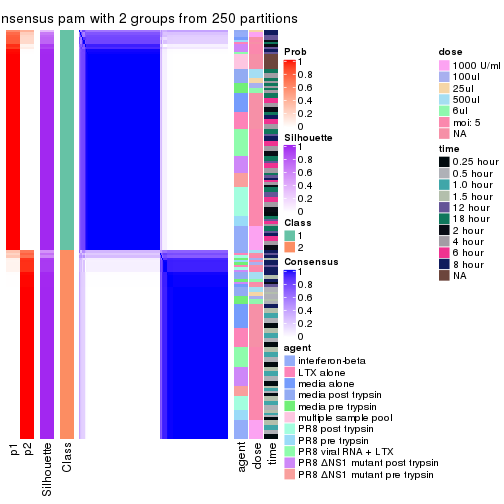
consensus_heatmap(res, k = 3)
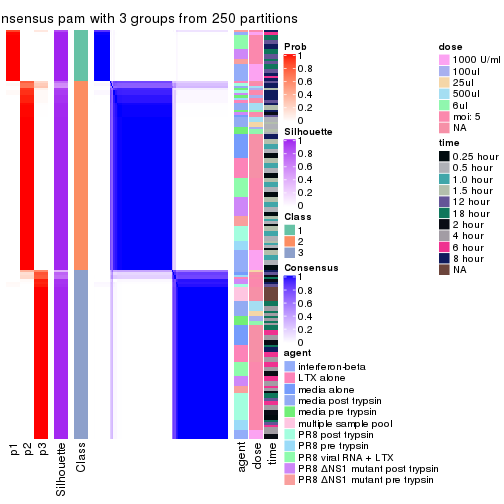
consensus_heatmap(res, k = 4)
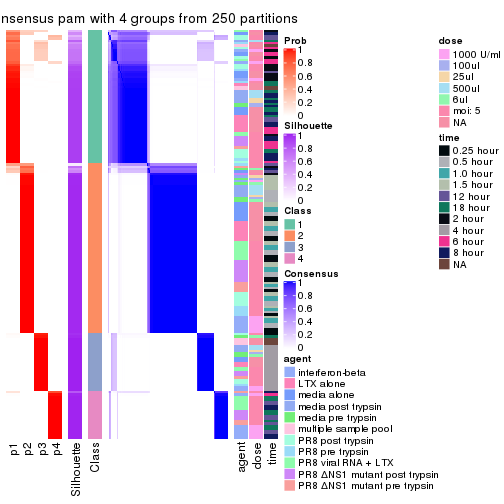
consensus_heatmap(res, k = 5)
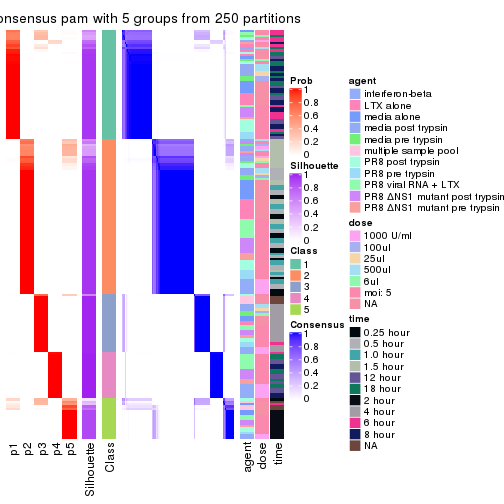
consensus_heatmap(res, k = 6)
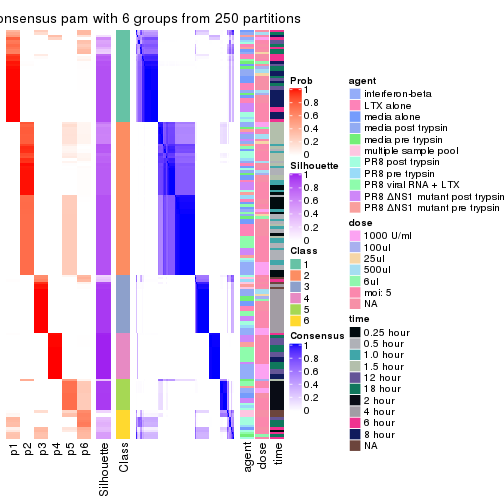
Heatmaps for the membership of samples in all partitions to see how consistent they are:
membership_heatmap(res, k = 2)
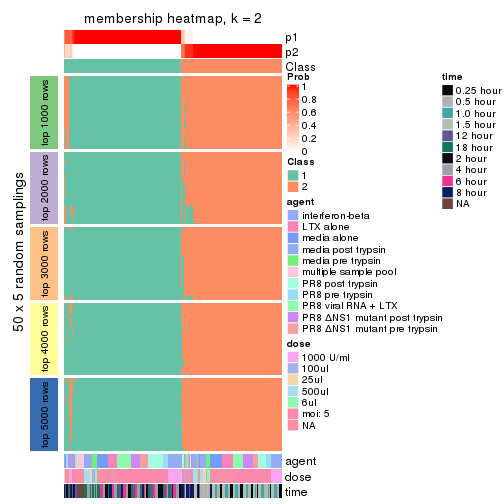
membership_heatmap(res, k = 3)
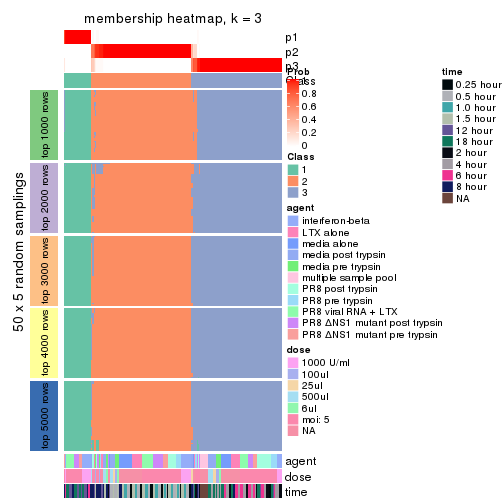
membership_heatmap(res, k = 4)
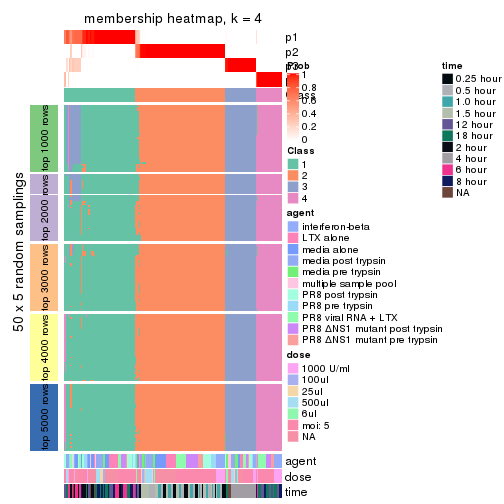
membership_heatmap(res, k = 5)
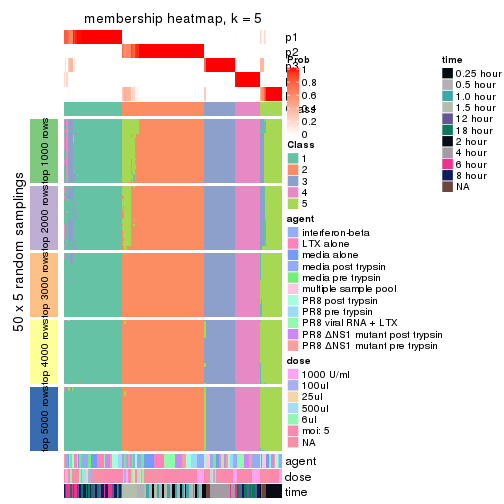
membership_heatmap(res, k = 6)
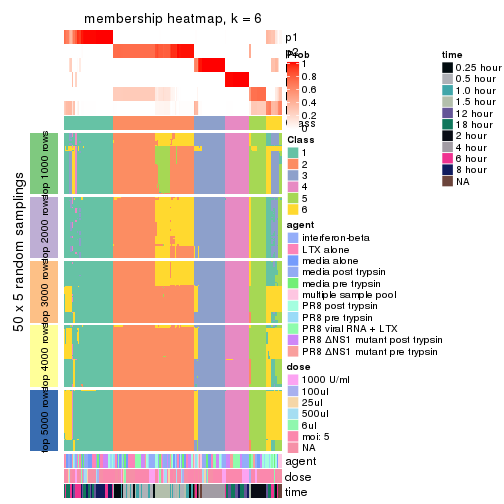
As soon as we have had the classes for columns, we can look for signatures which are significantly different between classes which can be candidate marks for certain classes. Following are the heatmaps for signatures.
Signature heatmaps where rows are scaled:
get_signatures(res, k = 2)
#> Error in mat[ceiling(1:nr/h_ratio), ceiling(1:nc/w_ratio), drop = FALSE]: subscript out of bounds
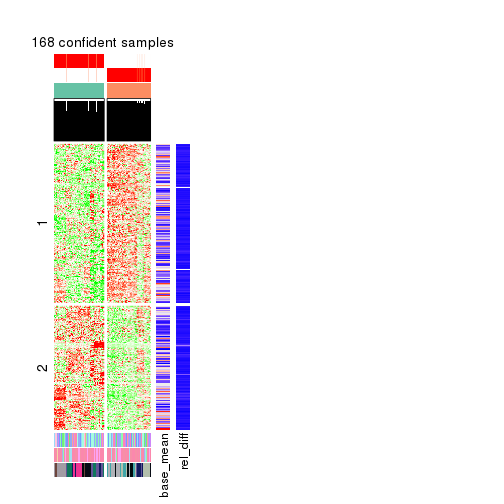
get_signatures(res, k = 3)
#> Error in mat[ceiling(1:nr/h_ratio), ceiling(1:nc/w_ratio), drop = FALSE]: subscript out of bounds
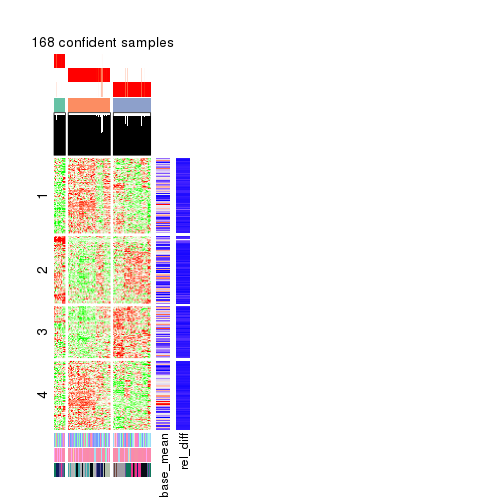
get_signatures(res, k = 4)
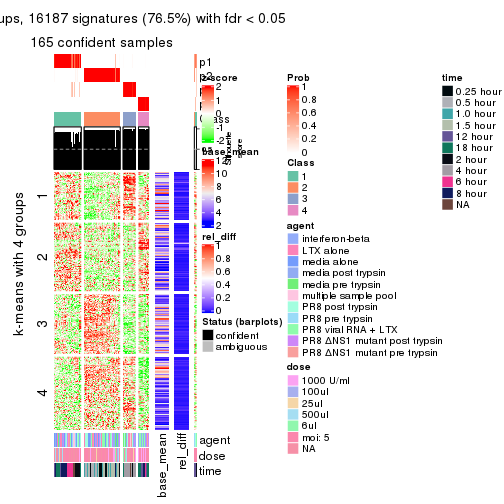
get_signatures(res, k = 5)
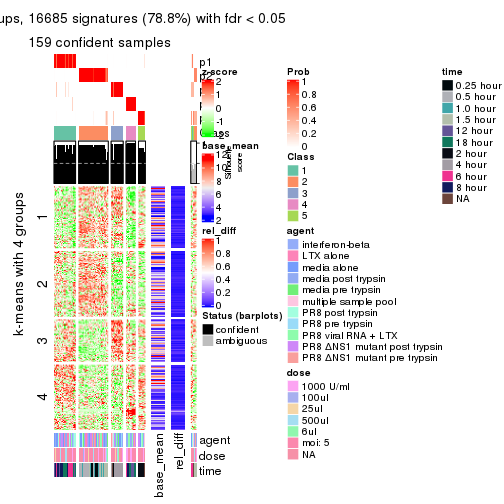
get_signatures(res, k = 6)
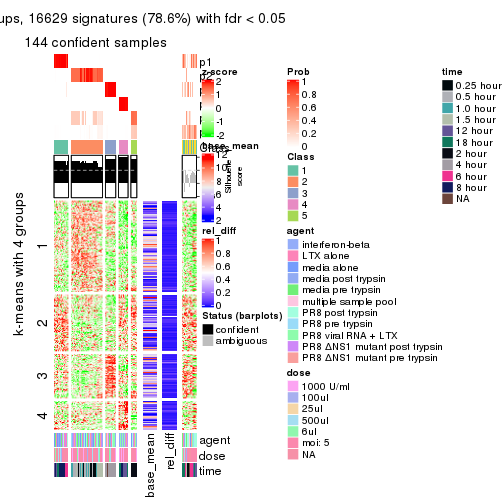
Signature heatmaps where rows are not scaled:
get_signatures(res, k = 2, scale_rows = FALSE)
#> Error in mat[ceiling(1:nr/h_ratio), ceiling(1:nc/w_ratio), drop = FALSE]: subscript out of bounds
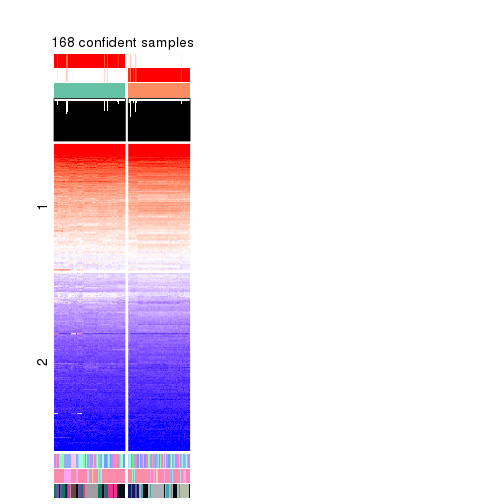
get_signatures(res, k = 3, scale_rows = FALSE)
#> Error in mat[ceiling(1:nr/h_ratio), ceiling(1:nc/w_ratio), drop = FALSE]: subscript out of bounds
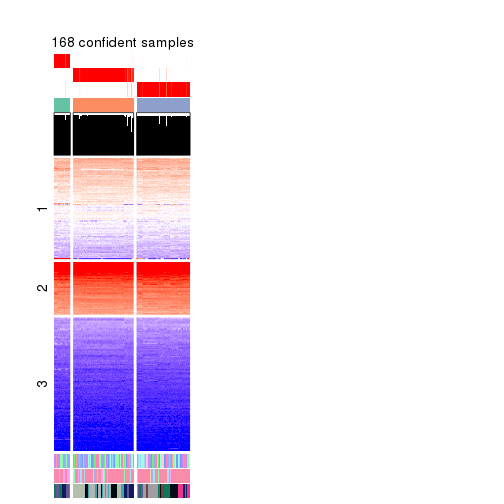
get_signatures(res, k = 4, scale_rows = FALSE)
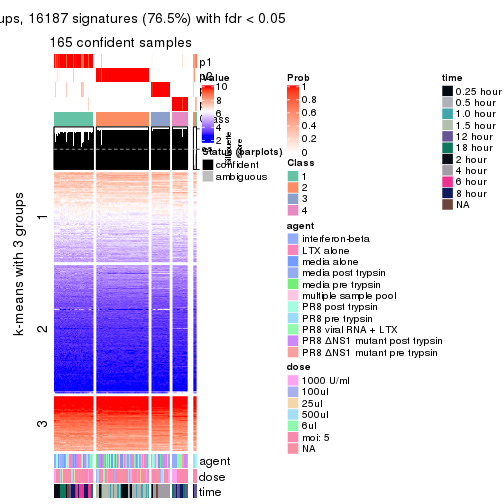
get_signatures(res, k = 5, scale_rows = FALSE)
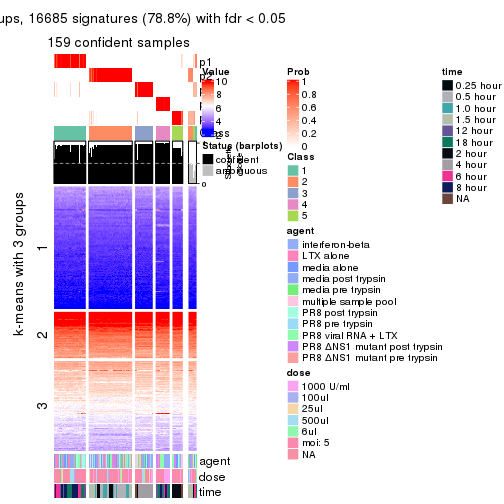
get_signatures(res, k = 6, scale_rows = FALSE)
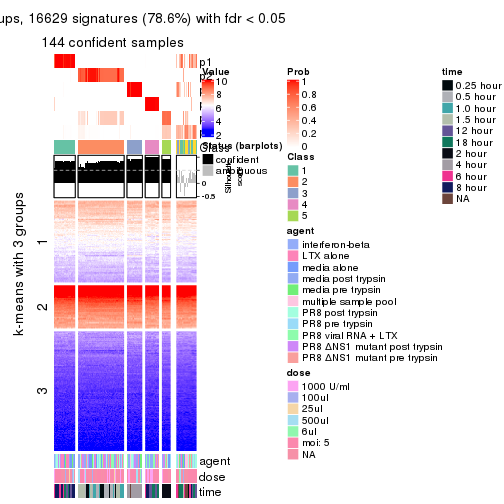
Compare the overlap of signatures from different k:
compare_signatures(res)
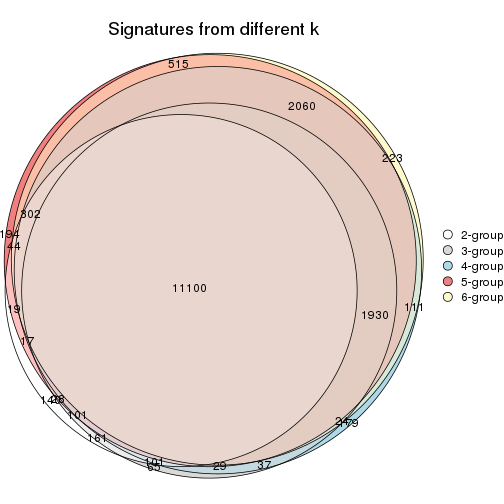
get_signature() returns a data frame invisibly. TO get the list of signatures, the function
call should be assigned to a variable explicitly. In following code, if plot argument is set
to FALSE, no heatmap is plotted while only the differential analysis is performed.
# code only for demonstration
tb = get_signature(res, k = ..., plot = FALSE)
An example of the output of tb is:
#> which_row fdr mean_1 mean_2 scaled_mean_1 scaled_mean_2 km
#> 1 38 0.042760348 8.373488 9.131774 -0.5533452 0.5164555 1
#> 2 40 0.018707592 7.106213 8.469186 -0.6173731 0.5762149 1
#> 3 55 0.019134737 10.221463 11.207825 -0.6159697 0.5749050 1
#> 4 59 0.006059896 5.921854 7.869574 -0.6899429 0.6439467 1
#> 5 60 0.018055526 8.928898 10.211722 -0.6204761 0.5791110 1
#> 6 98 0.009384629 15.714769 14.887706 0.6635654 -0.6193277 2
...
The columns in tb are:
which_row: row indices corresponding to the input matrix.fdr: FDR for the differential test. mean_x: The mean value in group x.scaled_mean_x: The mean value in group x after rows are scaled.km: Row groups if k-means clustering is applied to rows.UMAP plot which shows how samples are separated.
dimension_reduction(res, k = 2, method = "UMAP")
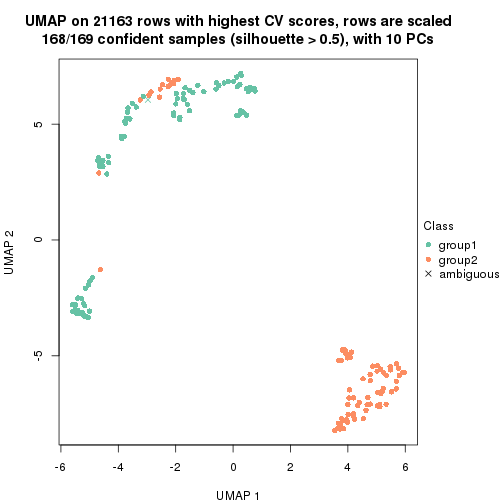
dimension_reduction(res, k = 3, method = "UMAP")
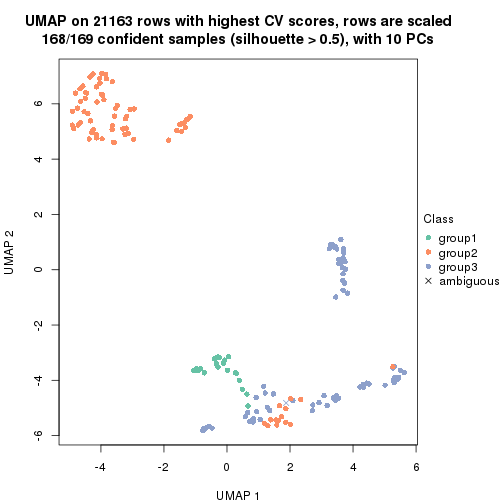
dimension_reduction(res, k = 4, method = "UMAP")
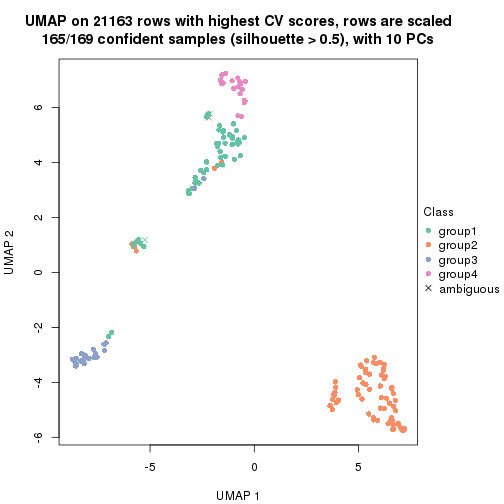
dimension_reduction(res, k = 5, method = "UMAP")
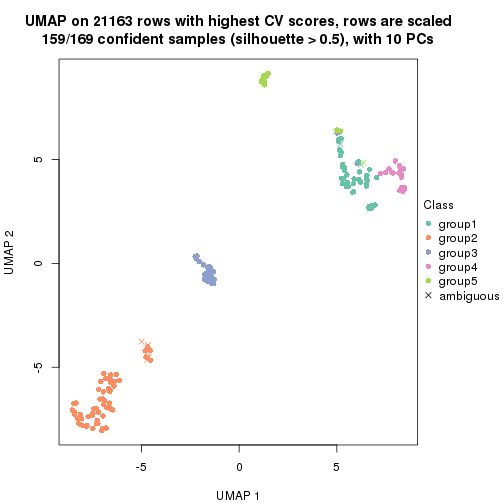
dimension_reduction(res, k = 6, method = "UMAP")
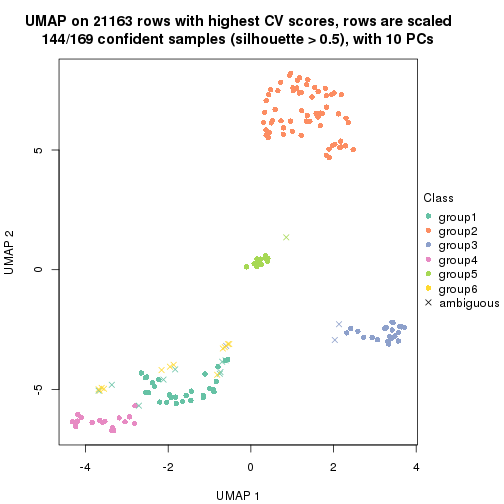
Following heatmap shows how subgroups are split when increasing k:
collect_classes(res)
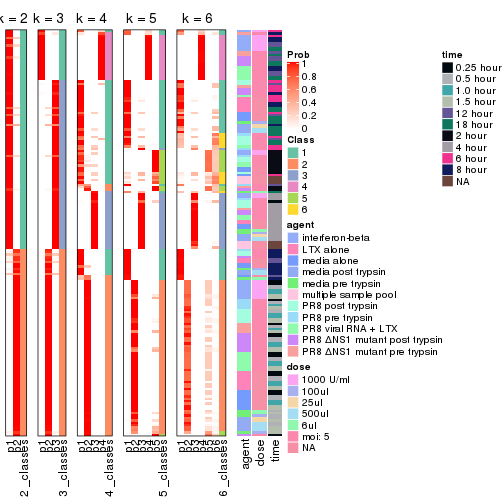
Test correlation between subgroups and known annotations. If the known annotation is numeric, one-way ANOVA test is applied, and if the known annotation is discrete, chi-squared contingency table test is applied.
test_to_known_factors(res)
#> n agent(p) dose(p) time(p) k
#> CV:pam 168 0.522904 0.91081 4.51e-23 2
#> CV:pam 168 0.000389 0.00994 7.96e-27 3
#> CV:pam 165 0.005162 0.04442 2.47e-48 4
#> CV:pam 159 0.014721 0.20333 1.38e-71 5
#> CV:pam 144 0.051547 0.15297 3.25e-73 6
If matrix rows can be associated to genes, consider to use functional_enrichment(res,
...) to perform function enrichment for the signature genes. See this vignette for more detailed explanations.
The object with results only for a single top-value method and a single partition method can be extracted as:
res = res_list["CV", "mclust"]
# you can also extract it by
# res = res_list["CV:mclust"]
A summary of res and all the functions that can be applied to it:
res
#> A 'ConsensusPartition' object with k = 2, 3, 4, 5, 6.
#> On a matrix with 21163 rows and 169 columns.
#> Top rows (1000, 2000, 3000, 4000, 5000) are extracted by 'CV' method.
#> Subgroups are detected by 'mclust' method.
#> Performed in total 1250 partitions by row resampling.
#> Best k for subgroups seems to be 3.
#>
#> Following methods can be applied to this 'ConsensusPartition' object:
#> [1] "cola_report" "collect_classes" "collect_plots"
#> [4] "collect_stats" "colnames" "compare_signatures"
#> [7] "consensus_heatmap" "dimension_reduction" "functional_enrichment"
#> [10] "get_anno_col" "get_anno" "get_classes"
#> [13] "get_consensus" "get_matrix" "get_membership"
#> [16] "get_param" "get_signatures" "get_stats"
#> [19] "is_best_k" "is_stable_k" "membership_heatmap"
#> [22] "ncol" "nrow" "plot_ecdf"
#> [25] "rownames" "select_partition_number" "show"
#> [28] "suggest_best_k" "test_to_known_factors"
collect_plots() function collects all the plots made from res for all k (number of partitions)
into one single page to provide an easy and fast comparison between different k.
collect_plots(res)
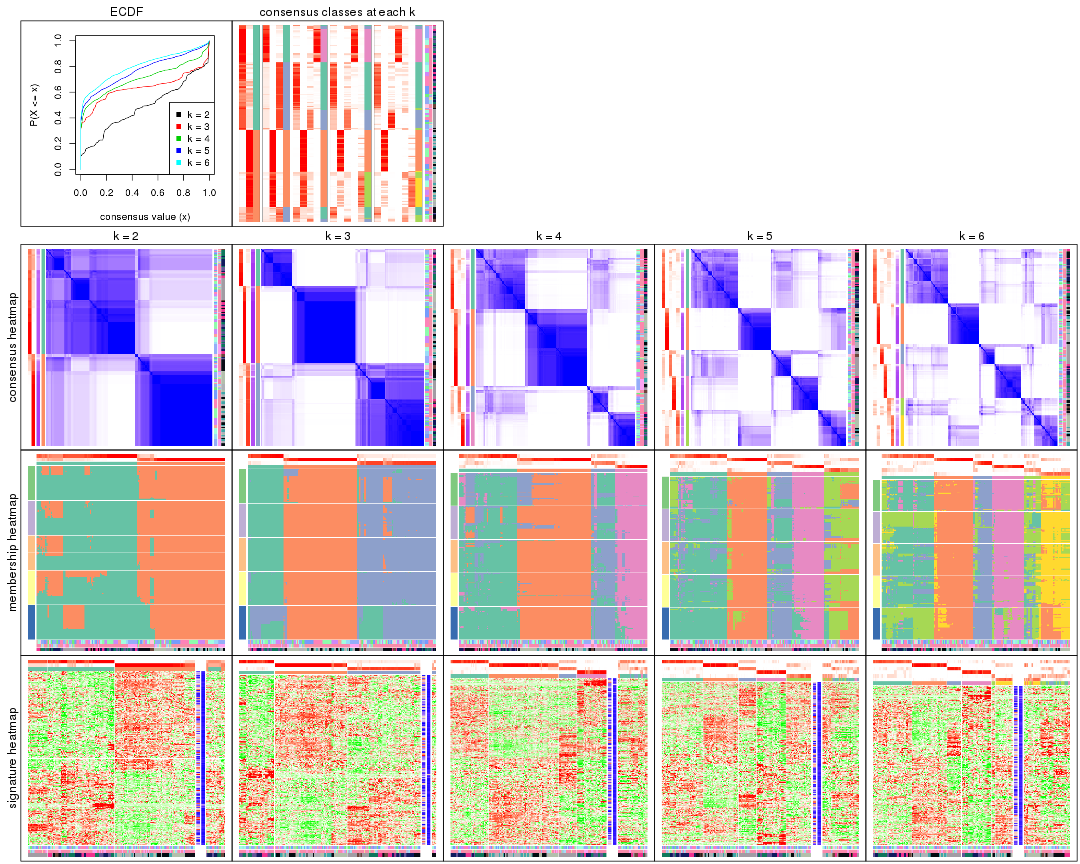
The plots are:
k and the heatmap of
predicted classes for each k.k.k.k.All the plots in panels can be made by individual functions and they are plotted later in this section.
select_partition_number() produces several plots showing different
statistics for choosing “optimized” k. There are following statistics:
k;k, the area increased is defined as \(A_k - A_{k-1}\).The detailed explanations of these statistics can be found in the cola vignette.
Generally speaking, lower PAC score, higher mean silhouette score or higher
concordance corresponds to better partition. Rand index and Jaccard index
measure how similar the current partition is compared to partition with k-1.
If they are too similar, we won't accept k is better than k-1.
select_partition_number(res)
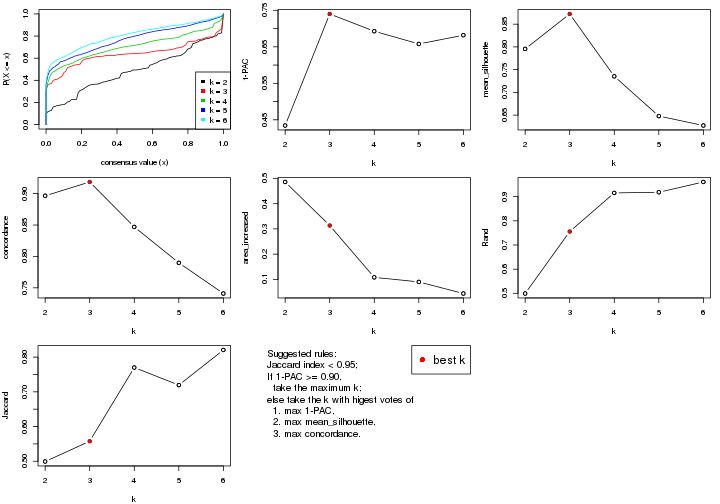
The numeric values for all these statistics can be obtained by get_stats().
get_stats(res)
#> k 1-PAC mean_silhouette concordance area_increased Rand Jaccard
#> 2 2 0.434 0.796 0.897 0.4862 0.499 0.499
#> 3 3 0.740 0.872 0.919 0.3135 0.756 0.558
#> 4 4 0.693 0.735 0.847 0.1078 0.915 0.770
#> 5 5 0.658 0.648 0.790 0.0899 0.918 0.719
#> 6 6 0.682 0.627 0.741 0.0438 0.961 0.821
suggest_best_k() suggests the best \(k\) based on these statistics. The rules are as follows:
suggest_best_k(res)
#> [1] 3
Following shows the table of the partitions (You need to click the show/hide
code output link to see it). The membership matrix (columns with name p*)
is inferred by
clue::cl_consensus()
function with the SE method. Basically the value in the membership matrix
represents the probability to belong to a certain group. The finall class
label for an item is determined with the group with highest probability it
belongs to.
In get_classes() function, the entropy is calculated from the membership
matrix and the silhouette score is calculated from the consensus matrix.
cbind(get_classes(res, k = 2), get_membership(res, k = 2))
#> class entropy silhouette p1 p2
#> GSM528681 2 0.0000 0.930 0.000 1.000
#> GSM528682 2 0.0000 0.930 0.000 1.000
#> GSM528683 2 0.0000 0.930 0.000 1.000
#> GSM528684 2 0.0000 0.930 0.000 1.000
#> GSM528687 2 0.0000 0.930 0.000 1.000
#> GSM528688 2 0.0000 0.930 0.000 1.000
#> GSM528685 2 0.3274 0.879 0.060 0.940
#> GSM528686 2 0.3274 0.879 0.060 0.940
#> GSM528693 1 0.2423 0.837 0.960 0.040
#> GSM528694 1 0.2236 0.837 0.964 0.036
#> GSM528695 1 0.5842 0.778 0.860 0.140
#> GSM528696 1 0.5842 0.778 0.860 0.140
#> GSM528697 1 0.0000 0.835 1.000 0.000
#> GSM528698 1 0.0000 0.835 1.000 0.000
#> GSM528699 1 0.0000 0.835 1.000 0.000
#> GSM528700 1 0.0000 0.835 1.000 0.000
#> GSM528689 1 0.0000 0.835 1.000 0.000
#> GSM528690 1 0.0000 0.835 1.000 0.000
#> GSM528691 1 0.0000 0.835 1.000 0.000
#> GSM528692 1 0.0000 0.835 1.000 0.000
#> GSM528779 2 0.0000 0.930 0.000 1.000
#> GSM528780 2 0.0000 0.930 0.000 1.000
#> GSM528782 2 0.0000 0.930 0.000 1.000
#> GSM528781 2 0.0000 0.930 0.000 1.000
#> GSM528785 2 0.7674 0.685 0.224 0.776
#> GSM528786 1 0.6801 0.779 0.820 0.180
#> GSM528787 1 0.4939 0.820 0.892 0.108
#> GSM528788 1 0.9552 0.510 0.624 0.376
#> GSM528783 1 0.0000 0.835 1.000 0.000
#> GSM528784 1 0.0000 0.835 1.000 0.000
#> GSM528759 1 0.4022 0.830 0.920 0.080
#> GSM528760 1 0.2948 0.836 0.948 0.052
#> GSM528761 2 0.0000 0.930 0.000 1.000
#> GSM528762 2 0.0000 0.930 0.000 1.000
#> GSM528765 2 0.0000 0.930 0.000 1.000
#> GSM528766 2 0.0000 0.930 0.000 1.000
#> GSM528763 2 0.0000 0.930 0.000 1.000
#> GSM528764 2 0.0672 0.925 0.008 0.992
#> GSM528771 2 0.7453 0.704 0.212 0.788
#> GSM528772 2 0.7528 0.698 0.216 0.784
#> GSM528773 1 0.6801 0.779 0.820 0.180
#> GSM528774 1 0.6801 0.779 0.820 0.180
#> GSM528775 1 0.6623 0.780 0.828 0.172
#> GSM528776 1 0.7602 0.737 0.780 0.220
#> GSM528777 1 0.1414 0.837 0.980 0.020
#> GSM528778 1 0.1184 0.837 0.984 0.016
#> GSM528767 1 0.0000 0.835 1.000 0.000
#> GSM528768 1 0.0000 0.835 1.000 0.000
#> GSM528769 1 0.0000 0.835 1.000 0.000
#> GSM528770 1 0.0000 0.835 1.000 0.000
#> GSM528671 2 0.0000 0.930 0.000 1.000
#> GSM528672 2 0.0000 0.930 0.000 1.000
#> GSM528674 2 0.0000 0.930 0.000 1.000
#> GSM528673 2 0.0672 0.925 0.008 0.992
#> GSM528677 2 0.7602 0.692 0.220 0.780
#> GSM528678 1 0.6623 0.785 0.828 0.172
#> GSM528679 1 0.7815 0.723 0.768 0.232
#> GSM528680 1 0.0000 0.835 1.000 0.000
#> GSM528675 1 0.0000 0.835 1.000 0.000
#> GSM528676 1 0.0000 0.835 1.000 0.000
#> GSM528651 2 0.0000 0.930 0.000 1.000
#> GSM528652 2 0.0000 0.930 0.000 1.000
#> GSM528653 2 0.0000 0.930 0.000 1.000
#> GSM528654 2 0.0000 0.930 0.000 1.000
#> GSM528657 2 0.0000 0.930 0.000 1.000
#> GSM528658 2 0.0000 0.930 0.000 1.000
#> GSM528655 2 0.0672 0.925 0.008 0.992
#> GSM528656 2 0.0672 0.925 0.008 0.992
#> GSM528663 2 0.7376 0.709 0.208 0.792
#> GSM528664 2 0.7376 0.709 0.208 0.792
#> GSM528665 1 0.6801 0.779 0.820 0.180
#> GSM528666 1 0.6801 0.779 0.820 0.180
#> GSM528667 1 0.5737 0.807 0.864 0.136
#> GSM528668 1 0.5737 0.807 0.864 0.136
#> GSM528669 1 0.2043 0.838 0.968 0.032
#> GSM528670 1 0.2043 0.838 0.968 0.032
#> GSM528659 1 0.0000 0.835 1.000 0.000
#> GSM528660 1 0.0000 0.835 1.000 0.000
#> GSM528661 1 0.0000 0.835 1.000 0.000
#> GSM528662 1 0.0000 0.835 1.000 0.000
#> GSM528701 2 0.0000 0.930 0.000 1.000
#> GSM528702 2 0.0000 0.930 0.000 1.000
#> GSM528703 2 0.0000 0.930 0.000 1.000
#> GSM528704 2 0.0000 0.930 0.000 1.000
#> GSM528707 2 0.0000 0.930 0.000 1.000
#> GSM528708 2 0.0000 0.930 0.000 1.000
#> GSM528705 2 0.0000 0.930 0.000 1.000
#> GSM528706 2 0.0000 0.930 0.000 1.000
#> GSM528713 2 0.9000 0.499 0.316 0.684
#> GSM528714 2 0.7453 0.704 0.212 0.788
#> GSM528715 1 0.6887 0.778 0.816 0.184
#> GSM528716 1 0.6973 0.775 0.812 0.188
#> GSM528717 1 0.1843 0.838 0.972 0.028
#> GSM528718 1 0.2043 0.838 0.968 0.032
#> GSM528719 1 0.0000 0.835 1.000 0.000
#> GSM528720 1 0.0000 0.835 1.000 0.000
#> GSM528709 1 0.0000 0.835 1.000 0.000
#> GSM528710 1 0.0000 0.835 1.000 0.000
#> GSM528711 1 0.0000 0.835 1.000 0.000
#> GSM528712 1 0.0000 0.835 1.000 0.000
#> GSM528721 2 0.0000 0.930 0.000 1.000
#> GSM528722 2 0.0000 0.930 0.000 1.000
#> GSM528723 2 0.0000 0.930 0.000 1.000
#> GSM528724 2 0.0000 0.930 0.000 1.000
#> GSM528727 2 0.0000 0.930 0.000 1.000
#> GSM528728 2 0.0000 0.930 0.000 1.000
#> GSM528725 2 0.0000 0.930 0.000 1.000
#> GSM528726 2 0.0000 0.930 0.000 1.000
#> GSM528733 1 0.6801 0.779 0.820 0.180
#> GSM528734 1 0.6801 0.779 0.820 0.180
#> GSM528735 1 0.2423 0.837 0.960 0.040
#> GSM528736 1 0.2423 0.837 0.960 0.040
#> GSM528737 1 0.6801 0.776 0.820 0.180
#> GSM528738 1 0.5059 0.818 0.888 0.112
#> GSM528729 1 0.9815 0.422 0.580 0.420
#> GSM528730 1 0.9815 0.422 0.580 0.420
#> GSM528731 1 0.8909 0.628 0.692 0.308
#> GSM528732 1 0.9815 0.422 0.580 0.420
#> GSM528739 2 0.0000 0.930 0.000 1.000
#> GSM528740 2 0.0000 0.930 0.000 1.000
#> GSM528741 2 0.0000 0.930 0.000 1.000
#> GSM528742 2 0.0000 0.930 0.000 1.000
#> GSM528745 2 0.0000 0.930 0.000 1.000
#> GSM528746 2 0.0000 0.930 0.000 1.000
#> GSM528743 2 0.0000 0.930 0.000 1.000
#> GSM528744 2 0.0000 0.930 0.000 1.000
#> GSM528751 2 0.7745 0.679 0.228 0.772
#> GSM528752 2 0.7950 0.658 0.240 0.760
#> GSM528753 1 0.6801 0.779 0.820 0.180
#> GSM528754 1 0.6801 0.779 0.820 0.180
#> GSM528755 1 0.4815 0.823 0.896 0.104
#> GSM528756 1 0.2423 0.837 0.960 0.040
#> GSM528757 1 0.9815 0.422 0.580 0.420
#> GSM528758 1 0.9815 0.422 0.580 0.420
#> GSM528747 1 0.7602 0.740 0.780 0.220
#> GSM528748 2 0.9815 0.166 0.420 0.580
#> GSM528749 1 0.8955 0.626 0.688 0.312
#> GSM528750 1 0.9795 0.431 0.584 0.416
#> GSM528640 2 0.0000 0.930 0.000 1.000
#> GSM528641 2 0.0672 0.925 0.008 0.992
#> GSM528643 1 0.6801 0.779 0.820 0.180
#> GSM528644 2 0.9710 0.242 0.400 0.600
#> GSM528642 1 0.9963 0.354 0.536 0.464
#> GSM528620 2 0.0000 0.930 0.000 1.000
#> GSM528621 2 0.3733 0.864 0.072 0.928
#> GSM528623 1 0.6801 0.779 0.820 0.180
#> GSM528624 1 0.9815 0.422 0.580 0.420
#> GSM528622 1 0.9608 0.500 0.616 0.384
#> GSM528625 2 0.0000 0.930 0.000 1.000
#> GSM528626 2 0.0672 0.925 0.008 0.992
#> GSM528628 1 0.6801 0.779 0.820 0.180
#> GSM528629 1 0.9815 0.422 0.580 0.420
#> GSM528627 1 0.9286 0.575 0.656 0.344
#> GSM528630 2 0.0000 0.930 0.000 1.000
#> GSM528631 2 0.0000 0.930 0.000 1.000
#> GSM528632 2 0.0672 0.925 0.008 0.992
#> GSM528633 2 0.0672 0.925 0.008 0.992
#> GSM528636 1 0.6801 0.779 0.820 0.180
#> GSM528637 1 0.6801 0.779 0.820 0.180
#> GSM528638 1 0.9815 0.422 0.580 0.420
#> GSM528639 1 0.9815 0.422 0.580 0.420
#> GSM528634 1 0.7883 0.724 0.764 0.236
#> GSM528635 1 0.8813 0.644 0.700 0.300
#> GSM528645 2 0.9427 0.349 0.360 0.640
#> GSM528646 2 0.9522 0.314 0.372 0.628
#> GSM528647 2 0.9491 0.335 0.368 0.632
#> GSM528648 1 0.9209 0.581 0.664 0.336
#> GSM528649 1 0.7219 0.756 0.800 0.200
#> GSM528650 1 0.5059 0.820 0.888 0.112
cbind(get_classes(res, k = 3), get_membership(res, k = 3))
#> class entropy silhouette p1 p2 p3
#> GSM528681 2 0.0000 0.977 0.000 1.000 0.000
#> GSM528682 2 0.0000 0.977 0.000 1.000 0.000
#> GSM528683 2 0.0000 0.977 0.000 1.000 0.000
#> GSM528684 2 0.0000 0.977 0.000 1.000 0.000
#> GSM528687 2 0.0000 0.977 0.000 1.000 0.000
#> GSM528688 2 0.0000 0.977 0.000 1.000 0.000
#> GSM528685 2 0.4652 0.854 0.080 0.856 0.064
#> GSM528686 2 0.4652 0.854 0.080 0.856 0.064
#> GSM528693 3 0.6062 0.481 0.384 0.000 0.616
#> GSM528694 3 0.6302 0.193 0.480 0.000 0.520
#> GSM528695 1 0.4002 0.817 0.840 0.000 0.160
#> GSM528696 1 0.4002 0.817 0.840 0.000 0.160
#> GSM528697 1 0.1031 0.939 0.976 0.000 0.024
#> GSM528698 1 0.3192 0.886 0.888 0.000 0.112
#> GSM528699 1 0.3116 0.887 0.892 0.000 0.108
#> GSM528700 1 0.2796 0.900 0.908 0.000 0.092
#> GSM528689 1 0.2066 0.920 0.940 0.000 0.060
#> GSM528690 1 0.0892 0.940 0.980 0.000 0.020
#> GSM528691 1 0.0892 0.940 0.980 0.000 0.020
#> GSM528692 1 0.0000 0.936 1.000 0.000 0.000
#> GSM528779 2 0.0000 0.977 0.000 1.000 0.000
#> GSM528780 2 0.0000 0.977 0.000 1.000 0.000
#> GSM528782 2 0.0000 0.977 0.000 1.000 0.000
#> GSM528781 2 0.0000 0.977 0.000 1.000 0.000
#> GSM528785 3 0.7244 0.678 0.092 0.208 0.700
#> GSM528786 3 0.4235 0.740 0.176 0.000 0.824
#> GSM528787 3 0.3112 0.858 0.096 0.004 0.900
#> GSM528788 3 0.2711 0.859 0.088 0.000 0.912
#> GSM528783 1 0.0424 0.936 0.992 0.000 0.008
#> GSM528784 1 0.0237 0.937 0.996 0.000 0.004
#> GSM528759 3 0.2711 0.859 0.088 0.000 0.912
#> GSM528760 3 0.2711 0.859 0.088 0.000 0.912
#> GSM528761 2 0.0000 0.977 0.000 1.000 0.000
#> GSM528762 2 0.0000 0.977 0.000 1.000 0.000
#> GSM528765 2 0.0000 0.977 0.000 1.000 0.000
#> GSM528766 2 0.0000 0.977 0.000 1.000 0.000
#> GSM528763 2 0.0237 0.975 0.000 0.996 0.004
#> GSM528764 2 0.1765 0.944 0.004 0.956 0.040
#> GSM528771 3 0.8518 0.255 0.092 0.436 0.472
#> GSM528772 3 0.8457 0.372 0.092 0.396 0.512
#> GSM528773 3 0.3412 0.774 0.124 0.000 0.876
#> GSM528774 3 0.3267 0.778 0.116 0.000 0.884
#> GSM528775 3 0.4605 0.778 0.204 0.000 0.796
#> GSM528776 3 0.3482 0.843 0.128 0.000 0.872
#> GSM528777 3 0.3267 0.850 0.116 0.000 0.884
#> GSM528778 3 0.3267 0.850 0.116 0.000 0.884
#> GSM528767 1 0.1031 0.939 0.976 0.000 0.024
#> GSM528768 1 0.1031 0.939 0.976 0.000 0.024
#> GSM528769 1 0.0237 0.937 0.996 0.000 0.004
#> GSM528770 1 0.0237 0.937 0.996 0.000 0.004
#> GSM528671 2 0.0000 0.977 0.000 1.000 0.000
#> GSM528672 2 0.0000 0.977 0.000 1.000 0.000
#> GSM528674 2 0.0000 0.977 0.000 1.000 0.000
#> GSM528673 2 0.1765 0.944 0.004 0.956 0.040
#> GSM528677 3 0.7745 0.609 0.092 0.260 0.648
#> GSM528678 3 0.4178 0.813 0.172 0.000 0.828
#> GSM528679 1 0.4842 0.747 0.776 0.000 0.224
#> GSM528680 1 0.3116 0.887 0.892 0.000 0.108
#> GSM528675 1 0.0000 0.936 1.000 0.000 0.000
#> GSM528676 1 0.0000 0.936 1.000 0.000 0.000
#> GSM528651 2 0.0000 0.977 0.000 1.000 0.000
#> GSM528652 2 0.0000 0.977 0.000 1.000 0.000
#> GSM528653 2 0.0000 0.977 0.000 1.000 0.000
#> GSM528654 2 0.0000 0.977 0.000 1.000 0.000
#> GSM528657 2 0.0000 0.977 0.000 1.000 0.000
#> GSM528658 2 0.0000 0.977 0.000 1.000 0.000
#> GSM528655 2 0.1765 0.944 0.004 0.956 0.040
#> GSM528656 2 0.1765 0.944 0.004 0.956 0.040
#> GSM528663 2 0.7059 0.607 0.092 0.716 0.192
#> GSM528664 2 0.6860 0.638 0.092 0.732 0.176
#> GSM528665 3 0.3267 0.778 0.116 0.000 0.884
#> GSM528666 3 0.3267 0.778 0.116 0.000 0.884
#> GSM528667 3 0.2796 0.859 0.092 0.000 0.908
#> GSM528668 3 0.2796 0.859 0.092 0.000 0.908
#> GSM528669 3 0.3340 0.849 0.120 0.000 0.880
#> GSM528670 3 0.3267 0.850 0.116 0.000 0.884
#> GSM528659 1 0.0000 0.936 1.000 0.000 0.000
#> GSM528660 1 0.0000 0.936 1.000 0.000 0.000
#> GSM528661 1 0.0000 0.936 1.000 0.000 0.000
#> GSM528662 1 0.0000 0.936 1.000 0.000 0.000
#> GSM528701 2 0.0000 0.977 0.000 1.000 0.000
#> GSM528702 2 0.0000 0.977 0.000 1.000 0.000
#> GSM528703 2 0.0000 0.977 0.000 1.000 0.000
#> GSM528704 2 0.0000 0.977 0.000 1.000 0.000
#> GSM528707 2 0.0000 0.977 0.000 1.000 0.000
#> GSM528708 2 0.0000 0.977 0.000 1.000 0.000
#> GSM528705 2 0.0000 0.977 0.000 1.000 0.000
#> GSM528706 2 0.0000 0.977 0.000 1.000 0.000
#> GSM528713 3 0.6752 0.733 0.104 0.152 0.744
#> GSM528714 3 0.8202 0.512 0.092 0.328 0.580
#> GSM528715 3 0.3267 0.778 0.116 0.000 0.884
#> GSM528716 3 0.3267 0.778 0.116 0.000 0.884
#> GSM528717 1 0.3340 0.879 0.880 0.000 0.120
#> GSM528718 1 0.3340 0.879 0.880 0.000 0.120
#> GSM528719 1 0.3116 0.887 0.892 0.000 0.108
#> GSM528720 1 0.3116 0.887 0.892 0.000 0.108
#> GSM528709 1 0.0892 0.940 0.980 0.000 0.020
#> GSM528710 1 0.0237 0.938 0.996 0.000 0.004
#> GSM528711 1 0.0892 0.940 0.980 0.000 0.020
#> GSM528712 1 0.0892 0.940 0.980 0.000 0.020
#> GSM528721 2 0.0000 0.977 0.000 1.000 0.000
#> GSM528722 2 0.0000 0.977 0.000 1.000 0.000
#> GSM528723 2 0.0000 0.977 0.000 1.000 0.000
#> GSM528724 2 0.0000 0.977 0.000 1.000 0.000
#> GSM528727 2 0.0000 0.977 0.000 1.000 0.000
#> GSM528728 2 0.0000 0.977 0.000 1.000 0.000
#> GSM528725 2 0.0000 0.977 0.000 1.000 0.000
#> GSM528726 2 0.0000 0.977 0.000 1.000 0.000
#> GSM528733 3 0.3267 0.778 0.116 0.000 0.884
#> GSM528734 3 0.3267 0.778 0.116 0.000 0.884
#> GSM528735 3 0.3192 0.854 0.112 0.000 0.888
#> GSM528736 3 0.2959 0.858 0.100 0.000 0.900
#> GSM528737 3 0.2796 0.859 0.092 0.000 0.908
#> GSM528738 3 0.2796 0.859 0.092 0.000 0.908
#> GSM528729 3 0.2711 0.859 0.088 0.000 0.912
#> GSM528730 3 0.2711 0.859 0.088 0.000 0.912
#> GSM528731 3 0.2711 0.859 0.088 0.000 0.912
#> GSM528732 3 0.2711 0.859 0.088 0.000 0.912
#> GSM528739 2 0.0000 0.977 0.000 1.000 0.000
#> GSM528740 2 0.0000 0.977 0.000 1.000 0.000
#> GSM528741 2 0.0000 0.977 0.000 1.000 0.000
#> GSM528742 2 0.0000 0.977 0.000 1.000 0.000
#> GSM528745 2 0.0000 0.977 0.000 1.000 0.000
#> GSM528746 2 0.0000 0.977 0.000 1.000 0.000
#> GSM528743 2 0.0000 0.977 0.000 1.000 0.000
#> GSM528744 2 0.0000 0.977 0.000 1.000 0.000
#> GSM528751 3 0.7199 0.683 0.092 0.204 0.704
#> GSM528752 3 0.7059 0.697 0.092 0.192 0.716
#> GSM528753 3 0.3267 0.778 0.116 0.000 0.884
#> GSM528754 3 0.3267 0.778 0.116 0.000 0.884
#> GSM528755 3 0.3267 0.851 0.116 0.000 0.884
#> GSM528756 3 0.3340 0.848 0.120 0.000 0.880
#> GSM528757 3 0.2945 0.859 0.088 0.004 0.908
#> GSM528758 3 0.2945 0.859 0.088 0.004 0.908
#> GSM528747 3 0.2711 0.859 0.088 0.000 0.912
#> GSM528748 3 0.3445 0.855 0.088 0.016 0.896
#> GSM528749 3 0.2711 0.859 0.088 0.000 0.912
#> GSM528750 3 0.2711 0.859 0.088 0.000 0.912
#> GSM528640 2 0.0000 0.977 0.000 1.000 0.000
#> GSM528641 2 0.1765 0.944 0.004 0.956 0.040
#> GSM528643 3 0.3267 0.778 0.116 0.000 0.884
#> GSM528644 3 0.4092 0.845 0.088 0.036 0.876
#> GSM528642 3 0.4784 0.812 0.200 0.004 0.796
#> GSM528620 2 0.0000 0.977 0.000 1.000 0.000
#> GSM528621 2 0.4749 0.820 0.072 0.852 0.076
#> GSM528623 3 0.3267 0.778 0.116 0.000 0.884
#> GSM528624 3 0.2945 0.859 0.088 0.004 0.908
#> GSM528622 3 0.2796 0.859 0.092 0.000 0.908
#> GSM528625 2 0.0000 0.977 0.000 1.000 0.000
#> GSM528626 2 0.1765 0.944 0.004 0.956 0.040
#> GSM528628 3 0.3267 0.778 0.116 0.000 0.884
#> GSM528629 3 0.2945 0.859 0.088 0.004 0.908
#> GSM528627 3 0.2959 0.857 0.100 0.000 0.900
#> GSM528630 2 0.0000 0.977 0.000 1.000 0.000
#> GSM528631 2 0.0000 0.977 0.000 1.000 0.000
#> GSM528632 2 0.1765 0.944 0.004 0.956 0.040
#> GSM528633 2 0.1765 0.944 0.004 0.956 0.040
#> GSM528636 3 0.3267 0.778 0.116 0.000 0.884
#> GSM528637 3 0.3267 0.778 0.116 0.000 0.884
#> GSM528638 3 0.2711 0.859 0.088 0.000 0.912
#> GSM528639 3 0.2711 0.859 0.088 0.000 0.912
#> GSM528634 3 0.2959 0.857 0.100 0.000 0.900
#> GSM528635 3 0.2711 0.859 0.088 0.000 0.912
#> GSM528645 3 0.7816 0.590 0.132 0.200 0.668
#> GSM528646 3 0.7816 0.590 0.132 0.200 0.668
#> GSM528647 3 0.8802 0.601 0.200 0.216 0.584
#> GSM528648 3 0.3267 0.852 0.116 0.000 0.884
#> GSM528649 3 0.3752 0.836 0.144 0.000 0.856
#> GSM528650 3 0.3116 0.855 0.108 0.000 0.892
cbind(get_classes(res, k = 4), get_membership(res, k = 4))
#> class entropy silhouette p1 p2 p3 p4
#> GSM528681 2 0.0000 0.9274 0.000 1.000 0.000 0.000
#> GSM528682 2 0.0000 0.9274 0.000 1.000 0.000 0.000
#> GSM528683 2 0.0000 0.9274 0.000 1.000 0.000 0.000
#> GSM528684 2 0.0000 0.9274 0.000 1.000 0.000 0.000
#> GSM528687 2 0.0000 0.9274 0.000 1.000 0.000 0.000
#> GSM528688 2 0.0000 0.9274 0.000 1.000 0.000 0.000
#> GSM528685 2 0.4692 0.7988 0.032 0.756 0.212 0.000
#> GSM528686 2 0.4868 0.7906 0.040 0.748 0.212 0.000
#> GSM528693 1 0.7251 0.3384 0.588 0.012 0.172 0.228
#> GSM528694 3 0.7790 0.1265 0.340 0.000 0.408 0.252
#> GSM528695 3 0.6249 0.1188 0.068 0.000 0.580 0.352
#> GSM528696 3 0.6171 0.1349 0.064 0.000 0.588 0.348
#> GSM528697 4 0.0524 0.8935 0.008 0.000 0.004 0.988
#> GSM528698 4 0.5929 0.6552 0.108 0.000 0.204 0.688
#> GSM528699 4 0.4224 0.7544 0.144 0.000 0.044 0.812
#> GSM528700 4 0.1637 0.8619 0.060 0.000 0.000 0.940
#> GSM528689 4 0.0817 0.8867 0.024 0.000 0.000 0.976
#> GSM528690 4 0.0188 0.8939 0.004 0.000 0.000 0.996
#> GSM528691 4 0.2412 0.8518 0.084 0.000 0.008 0.908
#> GSM528692 4 0.2919 0.8536 0.044 0.000 0.060 0.896
#> GSM528779 2 0.0524 0.9277 0.008 0.988 0.004 0.000
#> GSM528780 2 0.1211 0.9252 0.000 0.960 0.040 0.000
#> GSM528782 2 0.0000 0.9274 0.000 1.000 0.000 0.000
#> GSM528781 2 0.2867 0.8934 0.012 0.884 0.104 0.000
#> GSM528785 1 0.7103 0.4505 0.632 0.164 0.180 0.024
#> GSM528786 3 0.4955 0.7122 0.344 0.000 0.648 0.008
#> GSM528787 1 0.4916 0.0359 0.576 0.000 0.424 0.000
#> GSM528788 1 0.1406 0.7232 0.960 0.000 0.016 0.024
#> GSM528783 4 0.2521 0.8615 0.024 0.000 0.064 0.912
#> GSM528784 4 0.0376 0.8938 0.004 0.000 0.004 0.992
#> GSM528759 1 0.1722 0.7096 0.944 0.000 0.048 0.008
#> GSM528760 1 0.3791 0.5358 0.796 0.000 0.200 0.004
#> GSM528761 2 0.1854 0.9219 0.012 0.940 0.048 0.000
#> GSM528762 2 0.0000 0.9274 0.000 1.000 0.000 0.000
#> GSM528765 2 0.1854 0.9219 0.012 0.940 0.048 0.000
#> GSM528766 2 0.1489 0.9242 0.004 0.952 0.044 0.000
#> GSM528763 2 0.2443 0.9086 0.024 0.916 0.060 0.000
#> GSM528764 2 0.4500 0.8142 0.032 0.776 0.192 0.000
#> GSM528771 1 0.7488 0.3946 0.588 0.196 0.192 0.024
#> GSM528772 1 0.7259 0.4020 0.600 0.192 0.192 0.016
#> GSM528773 3 0.4936 0.7253 0.340 0.000 0.652 0.008
#> GSM528774 3 0.4817 0.6884 0.388 0.000 0.612 0.000
#> GSM528775 1 0.6522 0.1296 0.560 0.004 0.364 0.072
#> GSM528776 1 0.2845 0.6883 0.896 0.000 0.028 0.076
#> GSM528777 1 0.4004 0.6189 0.812 0.000 0.024 0.164
#> GSM528778 1 0.4194 0.6070 0.800 0.000 0.028 0.172
#> GSM528767 4 0.0376 0.8938 0.004 0.000 0.004 0.992
#> GSM528768 4 0.0376 0.8938 0.004 0.000 0.004 0.992
#> GSM528769 4 0.0376 0.8938 0.004 0.000 0.004 0.992
#> GSM528770 4 0.0376 0.8938 0.004 0.000 0.004 0.992
#> GSM528671 2 0.1854 0.9219 0.012 0.940 0.048 0.000
#> GSM528672 2 0.0000 0.9274 0.000 1.000 0.000 0.000
#> GSM528674 2 0.0707 0.9273 0.000 0.980 0.020 0.000
#> GSM528673 2 0.4579 0.8077 0.032 0.768 0.200 0.000
#> GSM528677 1 0.6889 0.3776 0.592 0.176 0.232 0.000
#> GSM528678 1 0.4868 0.2993 0.684 0.000 0.304 0.012
#> GSM528679 1 0.6391 0.2869 0.588 0.000 0.084 0.328
#> GSM528680 4 0.2281 0.8290 0.096 0.000 0.000 0.904
#> GSM528675 4 0.0000 0.8934 0.000 0.000 0.000 1.000
#> GSM528676 4 0.0000 0.8934 0.000 0.000 0.000 1.000
#> GSM528651 2 0.1854 0.9219 0.012 0.940 0.048 0.000
#> GSM528652 2 0.1854 0.9219 0.012 0.940 0.048 0.000
#> GSM528653 2 0.0000 0.9274 0.000 1.000 0.000 0.000
#> GSM528654 2 0.0000 0.9274 0.000 1.000 0.000 0.000
#> GSM528657 2 0.1854 0.9219 0.012 0.940 0.048 0.000
#> GSM528658 2 0.0000 0.9274 0.000 1.000 0.000 0.000
#> GSM528655 2 0.4655 0.8011 0.032 0.760 0.208 0.000
#> GSM528656 2 0.4655 0.8011 0.032 0.760 0.208 0.000
#> GSM528663 2 0.7972 0.3390 0.248 0.492 0.244 0.016
#> GSM528664 2 0.7888 0.3808 0.236 0.508 0.240 0.016
#> GSM528665 3 0.4331 0.7483 0.288 0.000 0.712 0.000
#> GSM528666 3 0.4477 0.7488 0.312 0.000 0.688 0.000
#> GSM528667 1 0.1022 0.7137 0.968 0.000 0.032 0.000
#> GSM528668 1 0.1022 0.7137 0.968 0.000 0.032 0.000
#> GSM528669 1 0.3853 0.6255 0.820 0.000 0.020 0.160
#> GSM528670 1 0.4010 0.6251 0.816 0.000 0.028 0.156
#> GSM528659 4 0.0000 0.8934 0.000 0.000 0.000 1.000
#> GSM528660 4 0.0000 0.8934 0.000 0.000 0.000 1.000
#> GSM528661 4 0.0188 0.8932 0.000 0.000 0.004 0.996
#> GSM528662 4 0.0188 0.8932 0.000 0.000 0.004 0.996
#> GSM528701 2 0.0937 0.9271 0.012 0.976 0.012 0.000
#> GSM528702 2 0.0672 0.9272 0.008 0.984 0.008 0.000
#> GSM528703 2 0.0188 0.9276 0.000 0.996 0.004 0.000
#> GSM528704 2 0.0000 0.9274 0.000 1.000 0.000 0.000
#> GSM528707 2 0.0000 0.9274 0.000 1.000 0.000 0.000
#> GSM528708 2 0.0657 0.9271 0.004 0.984 0.012 0.000
#> GSM528705 2 0.0000 0.9274 0.000 1.000 0.000 0.000
#> GSM528706 2 0.1209 0.9261 0.004 0.964 0.032 0.000
#> GSM528713 1 0.6664 0.4539 0.648 0.156 0.188 0.008
#> GSM528714 1 0.7594 0.2201 0.480 0.256 0.264 0.000
#> GSM528715 3 0.4916 0.6262 0.424 0.000 0.576 0.000
#> GSM528716 3 0.4790 0.6965 0.380 0.000 0.620 0.000
#> GSM528717 4 0.7706 0.1400 0.364 0.000 0.224 0.412
#> GSM528718 4 0.7756 0.1611 0.320 0.000 0.252 0.428
#> GSM528719 4 0.5894 0.6571 0.108 0.000 0.200 0.692
#> GSM528720 4 0.5929 0.6552 0.108 0.000 0.204 0.688
#> GSM528709 4 0.0336 0.8934 0.008 0.000 0.000 0.992
#> GSM528710 4 0.0000 0.8934 0.000 0.000 0.000 1.000
#> GSM528711 4 0.0188 0.8932 0.000 0.000 0.004 0.996
#> GSM528712 4 0.1305 0.8816 0.004 0.000 0.036 0.960
#> GSM528721 2 0.0000 0.9274 0.000 1.000 0.000 0.000
#> GSM528722 2 0.0000 0.9274 0.000 1.000 0.000 0.000
#> GSM528723 2 0.0000 0.9274 0.000 1.000 0.000 0.000
#> GSM528724 2 0.0000 0.9274 0.000 1.000 0.000 0.000
#> GSM528727 2 0.1854 0.9219 0.012 0.940 0.048 0.000
#> GSM528728 2 0.0000 0.9274 0.000 1.000 0.000 0.000
#> GSM528725 2 0.0000 0.9274 0.000 1.000 0.000 0.000
#> GSM528726 2 0.1489 0.9241 0.004 0.952 0.044 0.000
#> GSM528733 3 0.4454 0.7498 0.308 0.000 0.692 0.000
#> GSM528734 3 0.4843 0.6731 0.396 0.000 0.604 0.000
#> GSM528735 1 0.2376 0.6885 0.916 0.000 0.068 0.016
#> GSM528736 1 0.2124 0.6910 0.924 0.000 0.068 0.008
#> GSM528737 1 0.1022 0.7137 0.968 0.000 0.032 0.000
#> GSM528738 1 0.1118 0.7120 0.964 0.000 0.036 0.000
#> GSM528729 1 0.1406 0.7243 0.960 0.000 0.016 0.024
#> GSM528730 1 0.1471 0.7247 0.960 0.004 0.012 0.024
#> GSM528731 1 0.1284 0.7237 0.964 0.000 0.012 0.024
#> GSM528732 1 0.0844 0.7258 0.980 0.004 0.004 0.012
#> GSM528739 2 0.0336 0.9267 0.000 0.992 0.008 0.000
#> GSM528740 2 0.0000 0.9274 0.000 1.000 0.000 0.000
#> GSM528741 2 0.1767 0.9228 0.012 0.944 0.044 0.000
#> GSM528742 2 0.0336 0.9278 0.000 0.992 0.008 0.000
#> GSM528745 2 0.2021 0.9193 0.012 0.932 0.056 0.000
#> GSM528746 2 0.0000 0.9274 0.000 1.000 0.000 0.000
#> GSM528743 2 0.1854 0.9219 0.012 0.940 0.048 0.000
#> GSM528744 2 0.1854 0.9219 0.012 0.940 0.048 0.000
#> GSM528751 1 0.7064 0.4555 0.636 0.160 0.180 0.024
#> GSM528752 1 0.6939 0.4481 0.636 0.164 0.184 0.016
#> GSM528753 3 0.4331 0.7485 0.288 0.000 0.712 0.000
#> GSM528754 3 0.4356 0.7492 0.292 0.000 0.708 0.000
#> GSM528755 1 0.4690 0.3542 0.712 0.000 0.276 0.012
#> GSM528756 1 0.4434 0.4574 0.756 0.000 0.228 0.016
#> GSM528757 1 0.1406 0.7243 0.960 0.000 0.016 0.024
#> GSM528758 1 0.1406 0.7243 0.960 0.000 0.016 0.024
#> GSM528747 1 0.0779 0.7256 0.980 0.004 0.000 0.016
#> GSM528748 1 0.3932 0.6096 0.836 0.128 0.032 0.004
#> GSM528749 1 0.0524 0.7216 0.988 0.004 0.008 0.000
#> GSM528750 1 0.1042 0.7262 0.972 0.000 0.008 0.020
#> GSM528640 2 0.0000 0.9274 0.000 1.000 0.000 0.000
#> GSM528641 2 0.4655 0.8011 0.032 0.760 0.208 0.000
#> GSM528643 3 0.4164 0.7350 0.264 0.000 0.736 0.000
#> GSM528644 1 0.4588 0.6033 0.812 0.132 0.032 0.024
#> GSM528642 1 0.4922 0.5994 0.792 0.088 0.112 0.008
#> GSM528620 2 0.1722 0.9228 0.008 0.944 0.048 0.000
#> GSM528621 2 0.7344 0.5515 0.180 0.588 0.216 0.016
#> GSM528623 3 0.4624 0.7324 0.340 0.000 0.660 0.000
#> GSM528624 1 0.1406 0.7243 0.960 0.000 0.016 0.024
#> GSM528622 1 0.1022 0.7137 0.968 0.000 0.032 0.000
#> GSM528625 2 0.0000 0.9274 0.000 1.000 0.000 0.000
#> GSM528626 2 0.4831 0.7930 0.040 0.752 0.208 0.000
#> GSM528628 3 0.4661 0.7244 0.348 0.000 0.652 0.000
#> GSM528629 1 0.1516 0.7242 0.960 0.008 0.016 0.016
#> GSM528627 1 0.1389 0.7065 0.952 0.000 0.048 0.000
#> GSM528630 2 0.1854 0.9219 0.012 0.940 0.048 0.000
#> GSM528631 2 0.1854 0.9219 0.012 0.940 0.048 0.000
#> GSM528632 2 0.4904 0.7855 0.040 0.744 0.216 0.000
#> GSM528633 2 0.4904 0.7855 0.040 0.744 0.216 0.000
#> GSM528636 3 0.4331 0.7484 0.288 0.000 0.712 0.000
#> GSM528637 3 0.4477 0.7488 0.312 0.000 0.688 0.000
#> GSM528638 1 0.1406 0.7243 0.960 0.000 0.016 0.024
#> GSM528639 1 0.1593 0.7244 0.956 0.004 0.016 0.024
#> GSM528634 1 0.4008 0.4468 0.756 0.000 0.244 0.000
#> GSM528635 1 0.1118 0.7120 0.964 0.000 0.036 0.000
#> GSM528645 3 0.5550 0.4304 0.248 0.060 0.692 0.000
#> GSM528646 3 0.5448 0.4507 0.244 0.056 0.700 0.000
#> GSM528647 3 0.6859 0.0339 0.404 0.080 0.508 0.008
#> GSM528648 1 0.3164 0.6940 0.884 0.000 0.052 0.064
#> GSM528649 1 0.6139 0.1266 0.544 0.000 0.404 0.052
#> GSM528650 1 0.2759 0.7067 0.904 0.000 0.052 0.044
cbind(get_classes(res, k = 5), get_membership(res, k = 5))
#> class entropy silhouette p1 p2 p3 p4 p5
#> GSM528681 2 0.0000 0.8899 0.000 1.000 0.000 0.000 0.000
#> GSM528682 2 0.0000 0.8899 0.000 1.000 0.000 0.000 0.000
#> GSM528683 2 0.0000 0.8899 0.000 1.000 0.000 0.000 0.000
#> GSM528684 2 0.0000 0.8899 0.000 1.000 0.000 0.000 0.000
#> GSM528687 2 0.1557 0.8613 0.000 0.940 0.008 0.000 0.052
#> GSM528688 2 0.0703 0.8796 0.000 0.976 0.000 0.000 0.024
#> GSM528685 5 0.3913 0.6558 0.032 0.080 0.048 0.004 0.836
#> GSM528686 5 0.4247 0.6471 0.032 0.072 0.076 0.004 0.816
#> GSM528693 1 0.7561 0.2044 0.428 0.000 0.300 0.216 0.056
#> GSM528694 3 0.7763 -0.0581 0.312 0.000 0.384 0.240 0.064
#> GSM528695 3 0.6205 -0.0985 0.044 0.000 0.480 0.428 0.048
#> GSM528696 3 0.6205 -0.0985 0.044 0.000 0.480 0.428 0.048
#> GSM528697 4 0.1012 0.8986 0.012 0.000 0.000 0.968 0.020
#> GSM528698 4 0.3996 0.7851 0.148 0.000 0.012 0.800 0.040
#> GSM528699 4 0.3870 0.7598 0.176 0.000 0.016 0.792 0.016
#> GSM528700 4 0.2127 0.8429 0.108 0.000 0.000 0.892 0.000
#> GSM528689 4 0.1341 0.8824 0.056 0.000 0.000 0.944 0.000
#> GSM528690 4 0.0162 0.8994 0.004 0.000 0.000 0.996 0.000
#> GSM528691 4 0.1697 0.8781 0.060 0.000 0.000 0.932 0.008
#> GSM528692 4 0.2450 0.8792 0.032 0.000 0.028 0.912 0.028
#> GSM528779 2 0.2424 0.7806 0.000 0.868 0.000 0.000 0.132
#> GSM528780 2 0.4803 -0.2652 0.000 0.536 0.020 0.000 0.444
#> GSM528782 2 0.0162 0.8887 0.000 0.996 0.000 0.000 0.004
#> GSM528781 5 0.4552 0.6342 0.000 0.264 0.040 0.000 0.696
#> GSM528785 1 0.4280 0.5749 0.744 0.004 0.024 0.004 0.224
#> GSM528786 3 0.5521 0.6568 0.300 0.000 0.628 0.024 0.048
#> GSM528787 1 0.5014 0.2126 0.536 0.000 0.432 0.000 0.032
#> GSM528788 1 0.1605 0.7045 0.944 0.000 0.040 0.004 0.012
#> GSM528783 4 0.2772 0.8752 0.028 0.000 0.032 0.896 0.044
#> GSM528784 4 0.0703 0.8980 0.000 0.000 0.000 0.976 0.024
#> GSM528759 1 0.2439 0.6867 0.876 0.000 0.120 0.000 0.004
#> GSM528760 1 0.4220 0.4406 0.688 0.000 0.300 0.004 0.008
#> GSM528761 5 0.4872 0.4960 0.000 0.436 0.024 0.000 0.540
#> GSM528762 2 0.0000 0.8899 0.000 1.000 0.000 0.000 0.000
#> GSM528765 5 0.4974 0.5389 0.000 0.408 0.032 0.000 0.560
#> GSM528766 5 0.4815 0.4565 0.000 0.456 0.020 0.000 0.524
#> GSM528763 5 0.4981 0.4178 0.004 0.412 0.024 0.000 0.560
#> GSM528764 5 0.3629 0.6540 0.040 0.076 0.036 0.000 0.848
#> GSM528771 1 0.5344 0.4390 0.628 0.012 0.040 0.004 0.316
#> GSM528772 1 0.5872 0.3880 0.588 0.008 0.084 0.004 0.316
#> GSM528773 3 0.4729 0.6884 0.268 0.000 0.688 0.004 0.040
#> GSM528774 3 0.4655 0.7153 0.312 0.000 0.660 0.004 0.024
#> GSM528775 1 0.6857 0.2755 0.492 0.000 0.344 0.124 0.040
#> GSM528776 1 0.4789 0.6672 0.768 0.000 0.124 0.072 0.036
#> GSM528777 1 0.4295 0.6433 0.800 0.000 0.068 0.108 0.024
#> GSM528778 1 0.4344 0.6399 0.796 0.000 0.068 0.112 0.024
#> GSM528767 4 0.0510 0.8986 0.000 0.000 0.000 0.984 0.016
#> GSM528768 4 0.0609 0.8981 0.000 0.000 0.000 0.980 0.020
#> GSM528769 4 0.0703 0.8980 0.000 0.000 0.000 0.976 0.024
#> GSM528770 4 0.0703 0.8980 0.000 0.000 0.000 0.976 0.024
#> GSM528671 5 0.3837 0.6107 0.000 0.308 0.000 0.000 0.692
#> GSM528672 2 0.0000 0.8899 0.000 1.000 0.000 0.000 0.000
#> GSM528674 2 0.4251 0.2575 0.000 0.672 0.012 0.000 0.316
#> GSM528673 5 0.3033 0.6600 0.016 0.076 0.032 0.000 0.876
#> GSM528677 1 0.6511 0.2759 0.508 0.004 0.204 0.000 0.284
#> GSM528678 1 0.5700 -0.1218 0.476 0.000 0.460 0.012 0.052
#> GSM528679 1 0.6827 0.0912 0.448 0.000 0.092 0.408 0.052
#> GSM528680 4 0.2929 0.7962 0.152 0.000 0.000 0.840 0.008
#> GSM528675 4 0.0162 0.8981 0.000 0.000 0.000 0.996 0.004
#> GSM528676 4 0.0162 0.8981 0.000 0.000 0.000 0.996 0.004
#> GSM528651 5 0.4067 0.6140 0.000 0.300 0.008 0.000 0.692
#> GSM528652 5 0.4485 0.6128 0.000 0.292 0.028 0.000 0.680
#> GSM528653 2 0.0000 0.8899 0.000 1.000 0.000 0.000 0.000
#> GSM528654 2 0.0162 0.8887 0.000 0.996 0.000 0.000 0.004
#> GSM528657 5 0.4974 0.5389 0.000 0.408 0.032 0.000 0.560
#> GSM528658 2 0.0000 0.8899 0.000 1.000 0.000 0.000 0.000
#> GSM528655 5 0.3033 0.6600 0.016 0.076 0.032 0.000 0.876
#> GSM528656 5 0.3206 0.6589 0.016 0.072 0.044 0.000 0.868
#> GSM528663 5 0.7352 0.2799 0.228 0.040 0.244 0.004 0.484
#> GSM528664 5 0.7318 0.2921 0.232 0.040 0.232 0.004 0.492
#> GSM528665 3 0.3752 0.7334 0.292 0.000 0.708 0.000 0.000
#> GSM528666 3 0.3837 0.7235 0.308 0.000 0.692 0.000 0.000
#> GSM528667 1 0.2770 0.6811 0.864 0.000 0.124 0.004 0.008
#> GSM528668 1 0.2563 0.6837 0.872 0.000 0.120 0.000 0.008
#> GSM528669 1 0.4042 0.6484 0.812 0.000 0.044 0.120 0.024
#> GSM528670 1 0.4140 0.6538 0.812 0.000 0.068 0.096 0.024
#> GSM528659 4 0.0162 0.8981 0.000 0.000 0.000 0.996 0.004
#> GSM528660 4 0.0162 0.8981 0.000 0.000 0.000 0.996 0.004
#> GSM528661 4 0.0162 0.8981 0.000 0.000 0.000 0.996 0.004
#> GSM528662 4 0.0162 0.8981 0.000 0.000 0.000 0.996 0.004
#> GSM528701 2 0.2424 0.7785 0.000 0.868 0.000 0.000 0.132
#> GSM528702 2 0.1671 0.8467 0.000 0.924 0.000 0.000 0.076
#> GSM528703 2 0.0290 0.8856 0.000 0.992 0.000 0.000 0.008
#> GSM528704 2 0.0000 0.8899 0.000 1.000 0.000 0.000 0.000
#> GSM528707 2 0.0000 0.8899 0.000 1.000 0.000 0.000 0.000
#> GSM528708 2 0.1197 0.8525 0.000 0.952 0.000 0.000 0.048
#> GSM528705 2 0.0963 0.8726 0.000 0.964 0.000 0.000 0.036
#> GSM528706 2 0.4517 -0.0883 0.000 0.556 0.008 0.000 0.436
#> GSM528713 1 0.6057 0.3976 0.584 0.004 0.156 0.000 0.256
#> GSM528714 5 0.7047 -0.1426 0.340 0.008 0.300 0.000 0.352
#> GSM528715 3 0.4118 0.6881 0.336 0.000 0.660 0.000 0.004
#> GSM528716 3 0.4251 0.7121 0.316 0.000 0.672 0.000 0.012
#> GSM528717 4 0.6922 0.3475 0.268 0.000 0.172 0.524 0.036
#> GSM528718 4 0.7208 0.2983 0.244 0.000 0.228 0.488 0.040
#> GSM528719 4 0.3699 0.8095 0.128 0.000 0.012 0.824 0.036
#> GSM528720 4 0.3878 0.7914 0.144 0.000 0.012 0.808 0.036
#> GSM528709 4 0.0404 0.8996 0.012 0.000 0.000 0.988 0.000
#> GSM528710 4 0.0000 0.8980 0.000 0.000 0.000 1.000 0.000
#> GSM528711 4 0.0162 0.8994 0.004 0.000 0.000 0.996 0.000
#> GSM528712 4 0.1306 0.8945 0.016 0.000 0.008 0.960 0.016
#> GSM528721 2 0.0000 0.8899 0.000 1.000 0.000 0.000 0.000
#> GSM528722 2 0.1671 0.8456 0.000 0.924 0.000 0.000 0.076
#> GSM528723 2 0.0000 0.8899 0.000 1.000 0.000 0.000 0.000
#> GSM528724 2 0.0000 0.8899 0.000 1.000 0.000 0.000 0.000
#> GSM528727 5 0.4974 0.5389 0.000 0.408 0.032 0.000 0.560
#> GSM528728 2 0.0000 0.8899 0.000 1.000 0.000 0.000 0.000
#> GSM528725 2 0.2017 0.8334 0.000 0.912 0.008 0.000 0.080
#> GSM528726 2 0.4974 -0.3414 0.000 0.508 0.028 0.000 0.464
#> GSM528733 3 0.3774 0.7319 0.296 0.000 0.704 0.000 0.000
#> GSM528734 3 0.3949 0.6954 0.332 0.000 0.668 0.000 0.000
#> GSM528735 1 0.4451 0.5599 0.736 0.000 0.224 0.024 0.016
#> GSM528736 1 0.3845 0.5744 0.760 0.000 0.224 0.004 0.012
#> GSM528737 1 0.2513 0.6862 0.876 0.000 0.116 0.000 0.008
#> GSM528738 1 0.2674 0.6827 0.868 0.000 0.120 0.000 0.012
#> GSM528729 1 0.1569 0.7055 0.944 0.000 0.044 0.004 0.008
#> GSM528730 1 0.1329 0.7081 0.956 0.000 0.032 0.004 0.008
#> GSM528731 1 0.1492 0.7070 0.948 0.000 0.040 0.004 0.008
#> GSM528732 1 0.1041 0.7131 0.964 0.000 0.000 0.004 0.032
#> GSM528739 2 0.1671 0.8467 0.000 0.924 0.000 0.000 0.076
#> GSM528740 2 0.1544 0.8505 0.000 0.932 0.000 0.000 0.068
#> GSM528741 5 0.4818 0.4518 0.000 0.460 0.020 0.000 0.520
#> GSM528742 2 0.2864 0.7075 0.000 0.852 0.012 0.000 0.136
#> GSM528745 5 0.4305 0.6192 0.004 0.296 0.012 0.000 0.688
#> GSM528746 2 0.0000 0.8899 0.000 1.000 0.000 0.000 0.000
#> GSM528743 5 0.4966 0.5448 0.000 0.404 0.032 0.000 0.564
#> GSM528744 5 0.4966 0.5448 0.000 0.404 0.032 0.000 0.564
#> GSM528751 1 0.4295 0.5544 0.724 0.000 0.024 0.004 0.248
#> GSM528752 1 0.4608 0.5272 0.700 0.000 0.036 0.004 0.260
#> GSM528753 3 0.3861 0.7338 0.284 0.000 0.712 0.000 0.004
#> GSM528754 3 0.3884 0.7345 0.288 0.000 0.708 0.000 0.004
#> GSM528755 1 0.4629 0.4731 0.688 0.000 0.280 0.020 0.012
#> GSM528756 1 0.4502 0.4165 0.668 0.000 0.312 0.008 0.012
#> GSM528757 1 0.1525 0.7081 0.948 0.000 0.036 0.004 0.012
#> GSM528758 1 0.1710 0.7064 0.940 0.000 0.040 0.004 0.016
#> GSM528747 1 0.1646 0.7165 0.944 0.000 0.032 0.004 0.020
#> GSM528748 1 0.2179 0.6921 0.896 0.000 0.004 0.000 0.100
#> GSM528749 1 0.1831 0.7024 0.920 0.000 0.076 0.000 0.004
#> GSM528750 1 0.0932 0.7129 0.972 0.000 0.020 0.004 0.004
#> GSM528640 2 0.0000 0.8899 0.000 1.000 0.000 0.000 0.000
#> GSM528641 5 0.3033 0.6600 0.016 0.076 0.032 0.000 0.876
#> GSM528643 3 0.3861 0.7338 0.284 0.000 0.712 0.000 0.004
#> GSM528644 1 0.1892 0.7012 0.916 0.000 0.000 0.004 0.080
#> GSM528642 1 0.4432 0.6580 0.772 0.000 0.144 0.008 0.076
#> GSM528620 5 0.4848 0.5233 0.000 0.420 0.024 0.000 0.556
#> GSM528621 5 0.7324 0.3431 0.196 0.052 0.236 0.004 0.512
#> GSM528623 3 0.3949 0.7294 0.300 0.000 0.696 0.000 0.004
#> GSM528624 1 0.1605 0.7061 0.944 0.000 0.040 0.004 0.012
#> GSM528622 1 0.2286 0.6935 0.888 0.000 0.108 0.000 0.004
#> GSM528625 2 0.0000 0.8899 0.000 1.000 0.000 0.000 0.000
#> GSM528626 5 0.3550 0.6544 0.016 0.072 0.064 0.000 0.848
#> GSM528628 3 0.4348 0.7184 0.316 0.000 0.668 0.000 0.016
#> GSM528629 1 0.1357 0.7107 0.948 0.000 0.000 0.004 0.048
#> GSM528627 1 0.3141 0.6625 0.832 0.000 0.152 0.000 0.016
#> GSM528630 5 0.4966 0.5448 0.000 0.404 0.032 0.000 0.564
#> GSM528631 5 0.4067 0.6146 0.000 0.300 0.008 0.000 0.692
#> GSM528632 5 0.5469 0.5287 0.024 0.068 0.236 0.000 0.672
#> GSM528633 5 0.5472 0.5420 0.024 0.072 0.228 0.000 0.676
#> GSM528636 3 0.3707 0.7340 0.284 0.000 0.716 0.000 0.000
#> GSM528637 3 0.3906 0.7333 0.292 0.000 0.704 0.000 0.004
#> GSM528638 1 0.1492 0.7056 0.948 0.000 0.040 0.004 0.008
#> GSM528639 1 0.1282 0.7118 0.952 0.000 0.000 0.004 0.044
#> GSM528634 1 0.3878 0.5559 0.748 0.000 0.236 0.000 0.016
#> GSM528635 1 0.2462 0.6884 0.880 0.000 0.112 0.000 0.008
#> GSM528645 3 0.4944 0.4546 0.092 0.000 0.700 0.000 0.208
#> GSM528646 3 0.4883 0.4612 0.092 0.000 0.708 0.000 0.200
#> GSM528647 3 0.6583 0.1737 0.268 0.000 0.516 0.008 0.208
#> GSM528648 1 0.4744 0.6806 0.780 0.000 0.096 0.060 0.064
#> GSM528649 1 0.6420 0.3738 0.548 0.000 0.332 0.060 0.060
#> GSM528650 1 0.4525 0.6864 0.792 0.000 0.100 0.044 0.064
cbind(get_classes(res, k = 6), get_membership(res, k = 6))
#> class entropy silhouette p1 p2 p3 p4 p5 p6
#> GSM528681 2 0.0000 0.9066 0.000 1.000 0.000 0.000 0.000 0.000
#> GSM528682 2 0.0000 0.9066 0.000 1.000 0.000 0.000 0.000 0.000
#> GSM528683 2 0.0000 0.9066 0.000 1.000 0.000 0.000 0.000 0.000
#> GSM528684 2 0.0000 0.9066 0.000 1.000 0.000 0.000 0.000 0.000
#> GSM528687 2 0.1444 0.8713 0.000 0.928 0.000 0.000 0.000 0.072
#> GSM528688 2 0.0865 0.8946 0.000 0.964 0.000 0.000 0.000 0.036
#> GSM528685 6 0.4100 0.4841 0.016 0.024 0.000 0.000 0.240 0.720
#> GSM528686 6 0.4224 0.3661 0.016 0.012 0.000 0.000 0.312 0.660
#> GSM528693 5 0.7146 0.2842 0.336 0.000 0.136 0.140 0.388 0.000
#> GSM528694 5 0.7317 0.2922 0.260 0.000 0.196 0.140 0.404 0.000
#> GSM528695 3 0.6529 0.1006 0.012 0.000 0.360 0.312 0.312 0.004
#> GSM528696 3 0.6529 0.1006 0.012 0.000 0.360 0.312 0.312 0.004
#> GSM528697 4 0.1204 0.9000 0.016 0.000 0.004 0.960 0.016 0.004
#> GSM528698 4 0.4064 0.7573 0.164 0.000 0.012 0.768 0.052 0.004
#> GSM528699 4 0.2457 0.8455 0.084 0.000 0.000 0.880 0.036 0.000
#> GSM528700 4 0.1668 0.8811 0.060 0.000 0.004 0.928 0.008 0.000
#> GSM528689 4 0.0935 0.8978 0.032 0.000 0.000 0.964 0.004 0.000
#> GSM528690 4 0.0520 0.9010 0.008 0.000 0.000 0.984 0.008 0.000
#> GSM528691 4 0.1680 0.8923 0.040 0.000 0.004 0.936 0.016 0.004
#> GSM528692 4 0.2077 0.8857 0.032 0.000 0.012 0.920 0.032 0.004
#> GSM528779 2 0.2491 0.7782 0.000 0.836 0.000 0.000 0.000 0.164
#> GSM528780 2 0.3817 -0.1393 0.000 0.568 0.000 0.000 0.000 0.432
#> GSM528782 2 0.0146 0.9040 0.000 0.996 0.000 0.000 0.000 0.004
#> GSM528781 6 0.2706 0.6758 0.000 0.104 0.000 0.000 0.036 0.860
#> GSM528785 1 0.5455 0.1997 0.532 0.000 0.008 0.000 0.356 0.104
#> GSM528786 5 0.6422 0.0348 0.204 0.000 0.384 0.012 0.392 0.008
#> GSM528787 1 0.6186 -0.0675 0.432 0.000 0.320 0.000 0.240 0.008
#> GSM528788 1 0.2838 0.6327 0.808 0.000 0.000 0.000 0.188 0.004
#> GSM528783 4 0.3054 0.8407 0.028 0.000 0.004 0.852 0.104 0.012
#> GSM528784 4 0.0893 0.8992 0.004 0.000 0.004 0.972 0.016 0.004
#> GSM528759 1 0.2346 0.6587 0.868 0.000 0.124 0.000 0.008 0.000
#> GSM528760 1 0.4219 0.4821 0.660 0.000 0.304 0.000 0.036 0.000
#> GSM528761 6 0.3531 0.6510 0.000 0.328 0.000 0.000 0.000 0.672
#> GSM528762 2 0.0000 0.9066 0.000 1.000 0.000 0.000 0.000 0.000
#> GSM528765 6 0.3076 0.7015 0.000 0.240 0.000 0.000 0.000 0.760
#> GSM528766 6 0.3810 0.5055 0.000 0.428 0.000 0.000 0.000 0.572
#> GSM528763 6 0.5749 0.5669 0.012 0.292 0.000 0.000 0.152 0.544
#> GSM528764 6 0.4094 0.4584 0.016 0.020 0.000 0.000 0.252 0.712
#> GSM528771 1 0.5973 -0.0609 0.440 0.000 0.008 0.000 0.380 0.172
#> GSM528772 5 0.5919 0.1263 0.396 0.000 0.008 0.000 0.436 0.160
#> GSM528773 3 0.5862 -0.0707 0.196 0.000 0.428 0.000 0.376 0.000
#> GSM528774 3 0.5798 0.0881 0.204 0.000 0.484 0.000 0.312 0.000
#> GSM528775 1 0.6356 0.1546 0.508 0.000 0.236 0.020 0.228 0.008
#> GSM528776 1 0.4572 0.5897 0.748 0.000 0.112 0.112 0.024 0.004
#> GSM528777 1 0.5135 0.5228 0.656 0.000 0.004 0.164 0.172 0.004
#> GSM528778 1 0.5135 0.5228 0.656 0.000 0.004 0.164 0.172 0.004
#> GSM528767 4 0.0893 0.8992 0.004 0.000 0.004 0.972 0.016 0.004
#> GSM528768 4 0.0893 0.8992 0.004 0.000 0.004 0.972 0.016 0.004
#> GSM528769 4 0.1637 0.8970 0.004 0.000 0.004 0.932 0.056 0.004
#> GSM528770 4 0.0893 0.8992 0.004 0.000 0.004 0.972 0.016 0.004
#> GSM528671 6 0.3518 0.6819 0.000 0.256 0.000 0.000 0.012 0.732
#> GSM528672 2 0.0146 0.9060 0.000 0.996 0.000 0.000 0.000 0.004
#> GSM528674 2 0.3390 0.3629 0.000 0.704 0.000 0.000 0.000 0.296
#> GSM528673 6 0.3716 0.4649 0.008 0.012 0.000 0.000 0.248 0.732
#> GSM528677 1 0.6007 -0.2230 0.476 0.000 0.032 0.000 0.380 0.112
#> GSM528678 5 0.6514 0.2259 0.340 0.000 0.276 0.008 0.368 0.008
#> GSM528679 1 0.6062 0.2310 0.520 0.000 0.124 0.324 0.028 0.004
#> GSM528680 4 0.2039 0.8703 0.072 0.000 0.004 0.908 0.016 0.000
#> GSM528675 4 0.1007 0.8956 0.000 0.000 0.000 0.956 0.044 0.000
#> GSM528676 4 0.1007 0.8956 0.000 0.000 0.000 0.956 0.044 0.000
#> GSM528651 6 0.3404 0.7070 0.000 0.224 0.000 0.000 0.016 0.760
#> GSM528652 6 0.2562 0.7111 0.000 0.172 0.000 0.000 0.000 0.828
#> GSM528653 2 0.0146 0.9060 0.000 0.996 0.000 0.000 0.000 0.004
#> GSM528654 2 0.0000 0.9066 0.000 1.000 0.000 0.000 0.000 0.000
#> GSM528657 6 0.3076 0.7015 0.000 0.240 0.000 0.000 0.000 0.760
#> GSM528658 2 0.0260 0.9042 0.000 0.992 0.000 0.000 0.000 0.008
#> GSM528655 6 0.3692 0.4696 0.008 0.012 0.000 0.000 0.244 0.736
#> GSM528656 6 0.3692 0.4659 0.008 0.012 0.000 0.000 0.244 0.736
#> GSM528663 5 0.5640 0.5308 0.184 0.004 0.012 0.000 0.604 0.196
#> GSM528664 5 0.5782 0.4994 0.192 0.004 0.008 0.000 0.568 0.228
#> GSM528665 3 0.0632 0.7577 0.024 0.000 0.976 0.000 0.000 0.000
#> GSM528666 3 0.0458 0.7582 0.016 0.000 0.984 0.000 0.000 0.000
#> GSM528667 1 0.2776 0.6618 0.860 0.000 0.112 0.004 0.020 0.004
#> GSM528668 1 0.2776 0.6618 0.860 0.000 0.112 0.004 0.020 0.004
#> GSM528669 1 0.5195 0.5138 0.648 0.000 0.004 0.168 0.176 0.004
#> GSM528670 1 0.4876 0.5509 0.688 0.000 0.004 0.144 0.160 0.004
#> GSM528659 4 0.1007 0.8956 0.000 0.000 0.000 0.956 0.044 0.000
#> GSM528660 4 0.1007 0.8956 0.000 0.000 0.000 0.956 0.044 0.000
#> GSM528661 4 0.1007 0.8956 0.000 0.000 0.000 0.956 0.044 0.000
#> GSM528662 4 0.0865 0.8966 0.000 0.000 0.000 0.964 0.036 0.000
#> GSM528701 2 0.2504 0.8033 0.004 0.856 0.000 0.000 0.004 0.136
#> GSM528702 2 0.2092 0.8235 0.000 0.876 0.000 0.000 0.000 0.124
#> GSM528703 2 0.0363 0.9009 0.000 0.988 0.000 0.000 0.000 0.012
#> GSM528704 2 0.0000 0.9066 0.000 1.000 0.000 0.000 0.000 0.000
#> GSM528707 2 0.0146 0.9057 0.000 0.996 0.000 0.000 0.000 0.004
#> GSM528708 2 0.0363 0.9041 0.000 0.988 0.000 0.000 0.000 0.012
#> GSM528705 2 0.0790 0.8958 0.000 0.968 0.000 0.000 0.000 0.032
#> GSM528706 2 0.4181 -0.1761 0.000 0.512 0.000 0.000 0.012 0.476
#> GSM528713 5 0.5782 0.1144 0.420 0.000 0.024 0.000 0.460 0.096
#> GSM528714 5 0.5779 0.5495 0.260 0.000 0.060 0.000 0.596 0.084
#> GSM528715 3 0.3253 0.5817 0.192 0.000 0.788 0.000 0.020 0.000
#> GSM528716 3 0.2442 0.6638 0.144 0.000 0.852 0.000 0.004 0.000
#> GSM528717 4 0.6267 0.2909 0.308 0.000 0.116 0.516 0.060 0.000
#> GSM528718 4 0.6878 0.1474 0.268 0.000 0.084 0.460 0.188 0.000
#> GSM528719 4 0.3940 0.7596 0.164 0.000 0.012 0.776 0.044 0.004
#> GSM528720 4 0.3940 0.7628 0.164 0.000 0.012 0.776 0.044 0.004
#> GSM528709 4 0.0146 0.8997 0.004 0.000 0.000 0.996 0.000 0.000
#> GSM528710 4 0.0000 0.8979 0.000 0.000 0.000 1.000 0.000 0.000
#> GSM528711 4 0.0146 0.8997 0.004 0.000 0.000 0.996 0.000 0.000
#> GSM528712 4 0.0777 0.9000 0.024 0.000 0.000 0.972 0.004 0.000
#> GSM528721 2 0.0363 0.9039 0.000 0.988 0.000 0.000 0.000 0.012
#> GSM528722 2 0.1610 0.8574 0.000 0.916 0.000 0.000 0.000 0.084
#> GSM528723 2 0.0000 0.9066 0.000 1.000 0.000 0.000 0.000 0.000
#> GSM528724 2 0.0000 0.9066 0.000 1.000 0.000 0.000 0.000 0.000
#> GSM528727 6 0.3076 0.7015 0.000 0.240 0.000 0.000 0.000 0.760
#> GSM528728 2 0.0260 0.9057 0.000 0.992 0.000 0.000 0.000 0.008
#> GSM528725 2 0.1957 0.8349 0.000 0.888 0.000 0.000 0.000 0.112
#> GSM528726 6 0.3847 0.4233 0.000 0.456 0.000 0.000 0.000 0.544
#> GSM528733 3 0.0777 0.7573 0.024 0.000 0.972 0.000 0.004 0.000
#> GSM528734 3 0.1219 0.7491 0.048 0.000 0.948 0.000 0.004 0.000
#> GSM528735 1 0.3232 0.6426 0.812 0.000 0.160 0.008 0.020 0.000
#> GSM528736 1 0.3147 0.6446 0.816 0.000 0.160 0.008 0.016 0.000
#> GSM528737 1 0.2776 0.6618 0.860 0.000 0.112 0.004 0.020 0.004
#> GSM528738 1 0.2689 0.6616 0.864 0.000 0.112 0.004 0.016 0.004
#> GSM528729 1 0.3152 0.6305 0.792 0.000 0.004 0.000 0.196 0.008
#> GSM528730 1 0.3198 0.6310 0.796 0.000 0.008 0.000 0.188 0.008
#> GSM528731 1 0.3359 0.6304 0.784 0.000 0.008 0.000 0.196 0.012
#> GSM528732 1 0.2036 0.6633 0.912 0.000 0.008 0.000 0.064 0.016
#> GSM528739 2 0.2092 0.8235 0.000 0.876 0.000 0.000 0.000 0.124
#> GSM528740 2 0.2048 0.8254 0.000 0.880 0.000 0.000 0.000 0.120
#> GSM528741 6 0.3838 0.4690 0.000 0.448 0.000 0.000 0.000 0.552
#> GSM528742 2 0.1863 0.8011 0.000 0.896 0.000 0.000 0.000 0.104
#> GSM528745 6 0.4255 0.6917 0.000 0.224 0.000 0.000 0.068 0.708
#> GSM528746 2 0.0000 0.9066 0.000 1.000 0.000 0.000 0.000 0.000
#> GSM528743 6 0.2854 0.7092 0.000 0.208 0.000 0.000 0.000 0.792
#> GSM528744 6 0.3076 0.7099 0.000 0.240 0.000 0.000 0.000 0.760
#> GSM528751 1 0.5500 0.1704 0.524 0.000 0.008 0.000 0.360 0.108
#> GSM528752 1 0.5523 0.1224 0.512 0.000 0.008 0.000 0.372 0.108
#> GSM528753 3 0.0458 0.7582 0.016 0.000 0.984 0.000 0.000 0.000
#> GSM528754 3 0.0458 0.7582 0.016 0.000 0.984 0.000 0.000 0.000
#> GSM528755 1 0.3381 0.6119 0.772 0.000 0.212 0.008 0.008 0.000
#> GSM528756 1 0.3329 0.5974 0.756 0.000 0.236 0.004 0.004 0.000
#> GSM528757 1 0.2915 0.6326 0.808 0.000 0.000 0.000 0.184 0.008
#> GSM528758 1 0.2805 0.6335 0.812 0.000 0.000 0.000 0.184 0.004
#> GSM528747 1 0.3000 0.6691 0.856 0.000 0.044 0.000 0.088 0.012
#> GSM528748 1 0.3820 0.5290 0.784 0.000 0.008 0.000 0.144 0.064
#> GSM528749 1 0.2290 0.6682 0.892 0.000 0.084 0.000 0.020 0.004
#> GSM528750 1 0.2734 0.6488 0.840 0.000 0.008 0.000 0.148 0.004
#> GSM528640 2 0.0146 0.9057 0.000 0.996 0.000 0.000 0.000 0.004
#> GSM528641 6 0.3764 0.4595 0.008 0.012 0.000 0.000 0.256 0.724
#> GSM528643 3 0.0458 0.7582 0.016 0.000 0.984 0.000 0.000 0.000
#> GSM528644 1 0.4207 0.5727 0.744 0.000 0.008 0.000 0.176 0.072
#> GSM528642 1 0.5497 0.4741 0.672 0.000 0.136 0.008 0.144 0.040
#> GSM528620 6 0.3563 0.6420 0.000 0.336 0.000 0.000 0.000 0.664
#> GSM528621 5 0.5728 0.5085 0.176 0.012 0.004 0.000 0.588 0.220
#> GSM528623 3 0.1204 0.7402 0.056 0.000 0.944 0.000 0.000 0.000
#> GSM528624 1 0.2838 0.6311 0.808 0.000 0.000 0.000 0.188 0.004
#> GSM528622 1 0.2633 0.6631 0.864 0.000 0.112 0.000 0.020 0.004
#> GSM528625 2 0.0000 0.9066 0.000 1.000 0.000 0.000 0.000 0.000
#> GSM528626 6 0.4027 0.3835 0.008 0.012 0.000 0.000 0.308 0.672
#> GSM528628 3 0.3665 0.5738 0.212 0.000 0.760 0.012 0.016 0.000
#> GSM528629 1 0.3095 0.6443 0.840 0.000 0.008 0.000 0.116 0.036
#> GSM528627 1 0.2662 0.6511 0.840 0.000 0.152 0.000 0.004 0.004
#> GSM528630 6 0.3050 0.7022 0.000 0.236 0.000 0.000 0.000 0.764
#> GSM528631 6 0.3014 0.7106 0.000 0.184 0.000 0.000 0.012 0.804
#> GSM528632 5 0.4371 0.2169 0.008 0.008 0.004 0.000 0.576 0.404
#> GSM528633 5 0.4386 0.1982 0.008 0.008 0.004 0.000 0.568 0.412
#> GSM528636 3 0.0458 0.7582 0.016 0.000 0.984 0.000 0.000 0.000
#> GSM528637 3 0.0458 0.7582 0.016 0.000 0.984 0.000 0.000 0.000
#> GSM528638 1 0.2979 0.6318 0.804 0.000 0.004 0.000 0.188 0.004
#> GSM528639 1 0.3279 0.6386 0.816 0.000 0.008 0.000 0.148 0.028
#> GSM528634 1 0.2964 0.6225 0.792 0.000 0.204 0.000 0.004 0.000
#> GSM528635 1 0.2501 0.6633 0.872 0.000 0.108 0.000 0.016 0.004
#> GSM528645 5 0.6001 0.3009 0.104 0.000 0.324 0.000 0.528 0.044
#> GSM528646 5 0.5842 0.2773 0.112 0.000 0.328 0.000 0.532 0.028
#> GSM528647 5 0.6402 0.4948 0.204 0.000 0.176 0.008 0.560 0.052
#> GSM528648 1 0.4759 0.6026 0.752 0.000 0.100 0.056 0.084 0.008
#> GSM528649 1 0.6256 0.2642 0.552 0.000 0.196 0.024 0.216 0.012
#> GSM528650 1 0.4709 0.6058 0.756 0.000 0.100 0.056 0.080 0.008
Heatmaps for the consensus matrix. It visualizes the probability of two samples to be in a same group.
consensus_heatmap(res, k = 2)
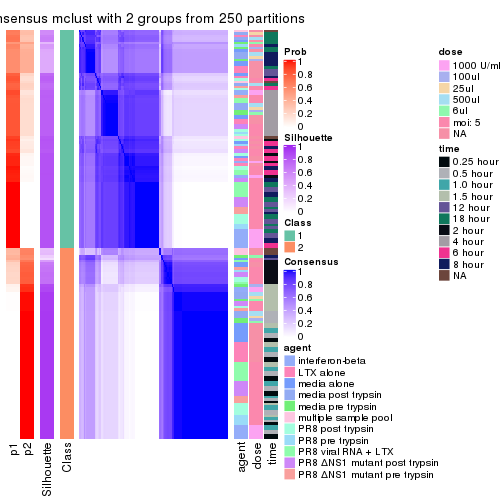
consensus_heatmap(res, k = 3)
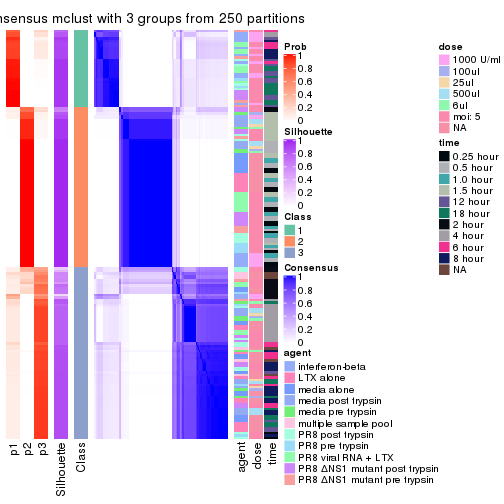
consensus_heatmap(res, k = 4)
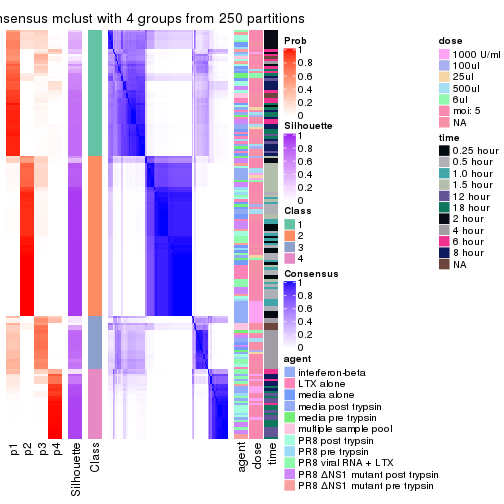
consensus_heatmap(res, k = 5)
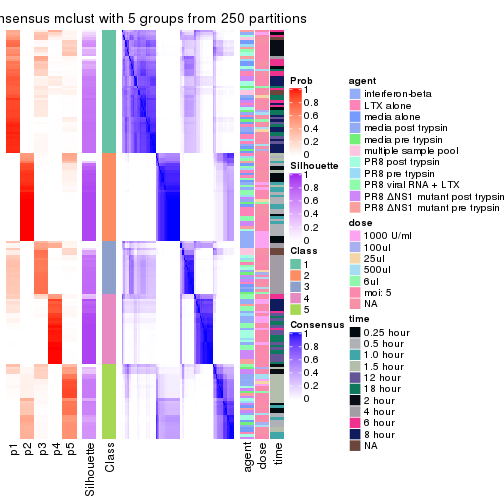
consensus_heatmap(res, k = 6)
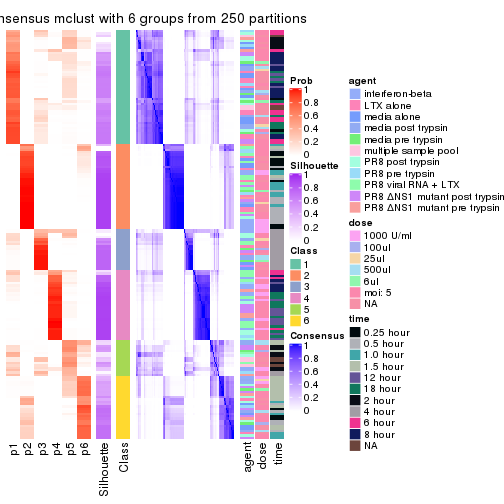
Heatmaps for the membership of samples in all partitions to see how consistent they are:
membership_heatmap(res, k = 2)
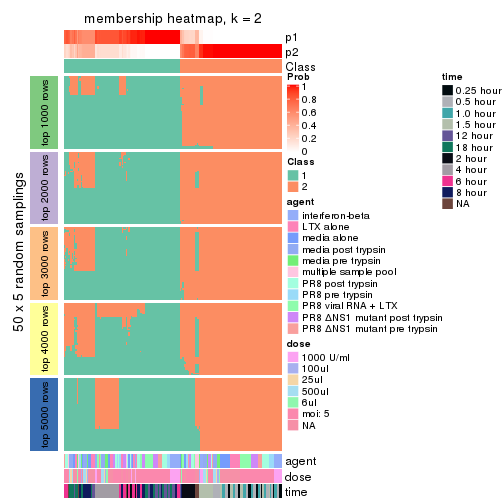
membership_heatmap(res, k = 3)
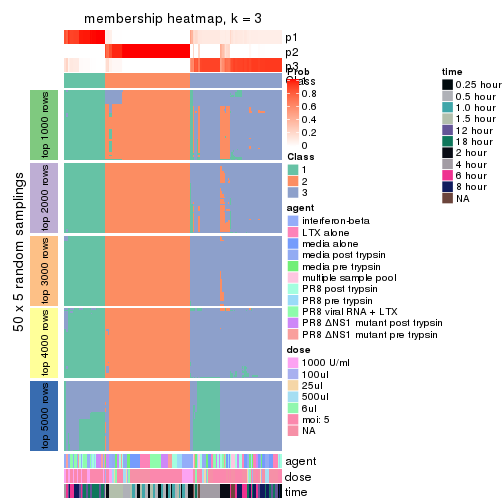
membership_heatmap(res, k = 4)
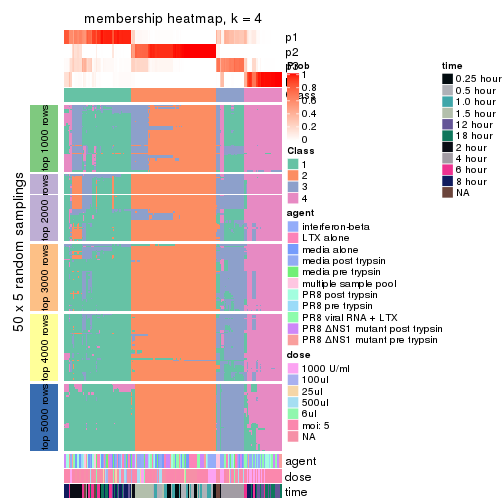
membership_heatmap(res, k = 5)
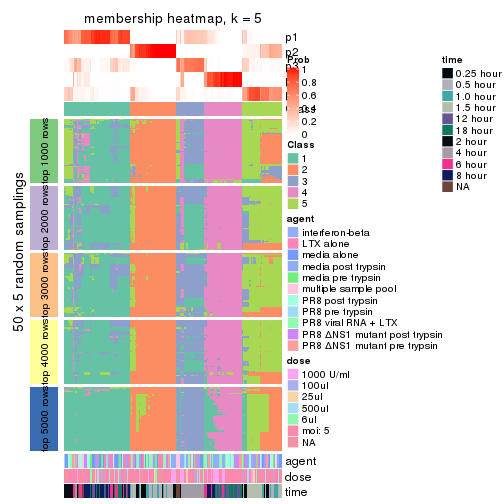
membership_heatmap(res, k = 6)
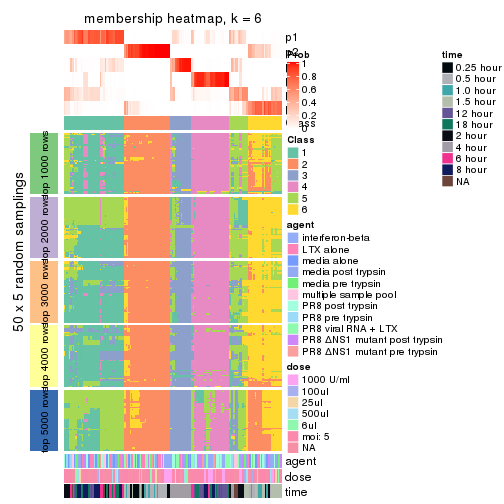
As soon as we have had the classes for columns, we can look for signatures which are significantly different between classes which can be candidate marks for certain classes. Following are the heatmaps for signatures.
Signature heatmaps where rows are scaled:
get_signatures(res, k = 2)
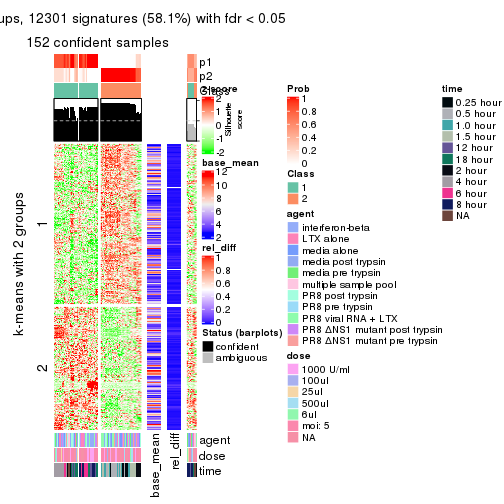
get_signatures(res, k = 3)
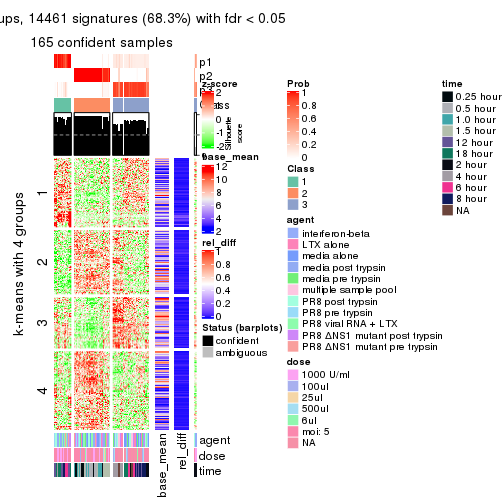
get_signatures(res, k = 4)
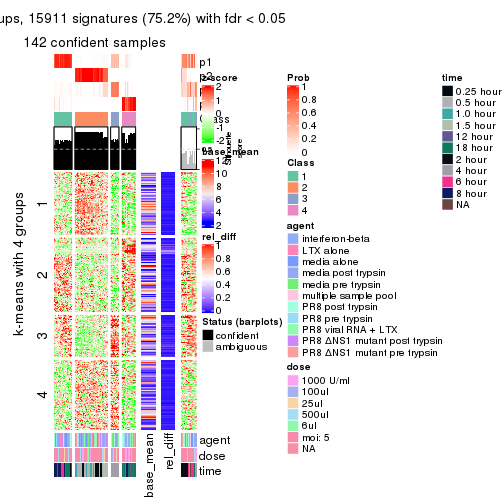
get_signatures(res, k = 5)
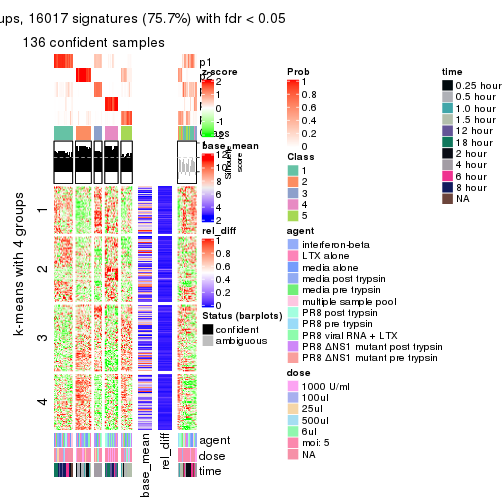
get_signatures(res, k = 6)
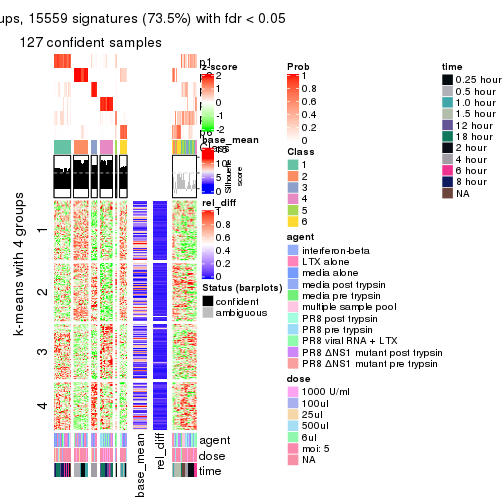
Signature heatmaps where rows are not scaled:
get_signatures(res, k = 2, scale_rows = FALSE)
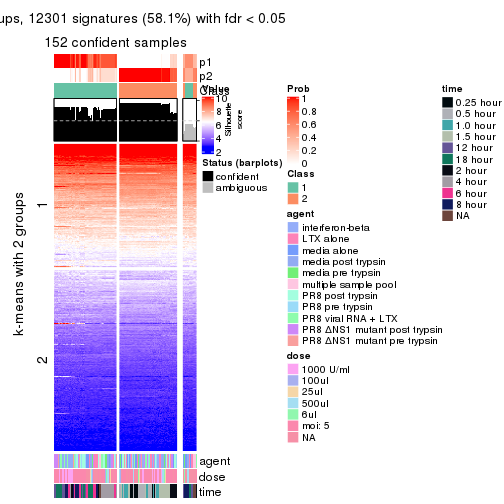
get_signatures(res, k = 3, scale_rows = FALSE)
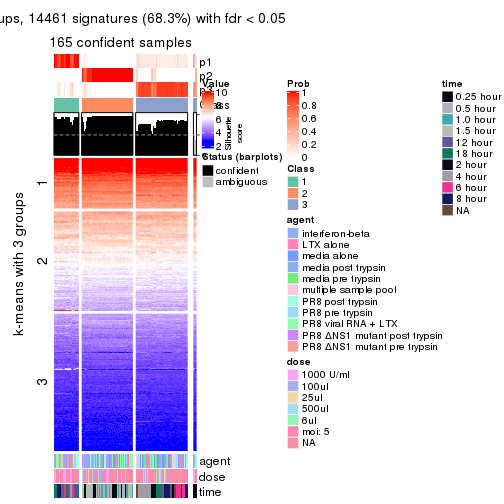
get_signatures(res, k = 4, scale_rows = FALSE)
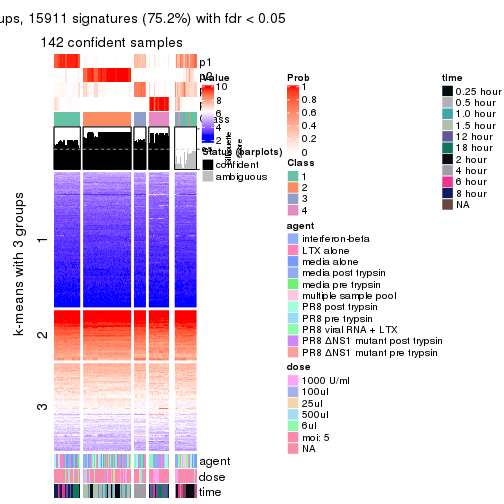
get_signatures(res, k = 5, scale_rows = FALSE)
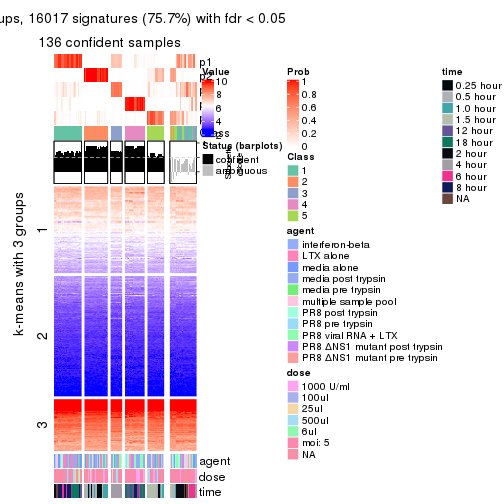
get_signatures(res, k = 6, scale_rows = FALSE)
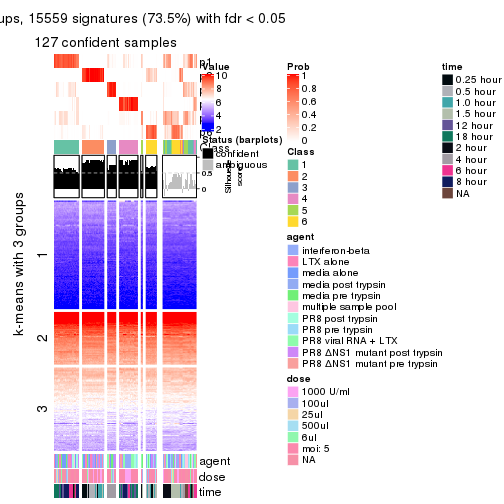
Compare the overlap of signatures from different k:
compare_signatures(res)
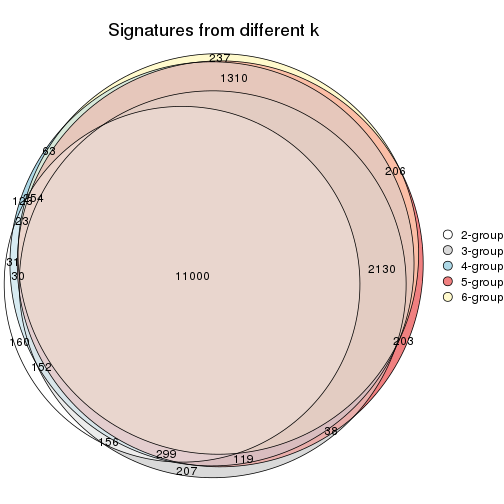
get_signature() returns a data frame invisibly. TO get the list of signatures, the function
call should be assigned to a variable explicitly. In following code, if plot argument is set
to FALSE, no heatmap is plotted while only the differential analysis is performed.
# code only for demonstration
tb = get_signature(res, k = ..., plot = FALSE)
An example of the output of tb is:
#> which_row fdr mean_1 mean_2 scaled_mean_1 scaled_mean_2 km
#> 1 38 0.042760348 8.373488 9.131774 -0.5533452 0.5164555 1
#> 2 40 0.018707592 7.106213 8.469186 -0.6173731 0.5762149 1
#> 3 55 0.019134737 10.221463 11.207825 -0.6159697 0.5749050 1
#> 4 59 0.006059896 5.921854 7.869574 -0.6899429 0.6439467 1
#> 5 60 0.018055526 8.928898 10.211722 -0.6204761 0.5791110 1
#> 6 98 0.009384629 15.714769 14.887706 0.6635654 -0.6193277 2
...
The columns in tb are:
which_row: row indices corresponding to the input matrix.fdr: FDR for the differential test. mean_x: The mean value in group x.scaled_mean_x: The mean value in group x after rows are scaled.km: Row groups if k-means clustering is applied to rows.UMAP plot which shows how samples are separated.
dimension_reduction(res, k = 2, method = "UMAP")
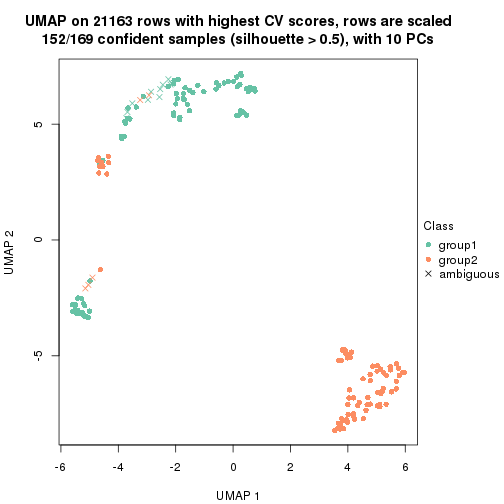
dimension_reduction(res, k = 3, method = "UMAP")
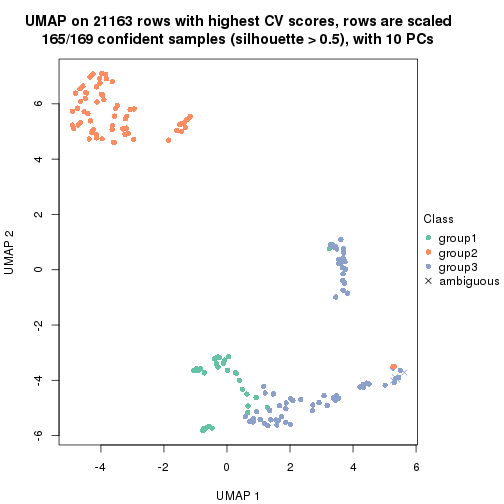
dimension_reduction(res, k = 4, method = "UMAP")
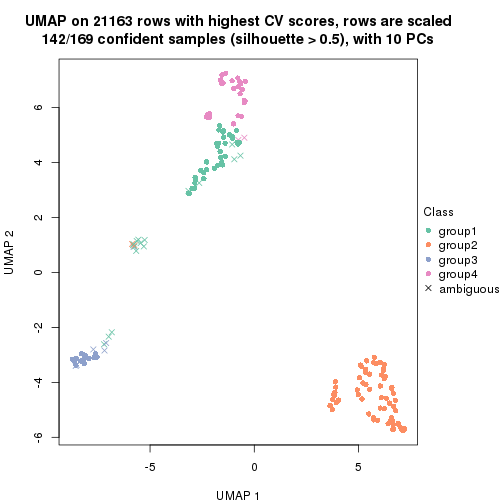
dimension_reduction(res, k = 5, method = "UMAP")
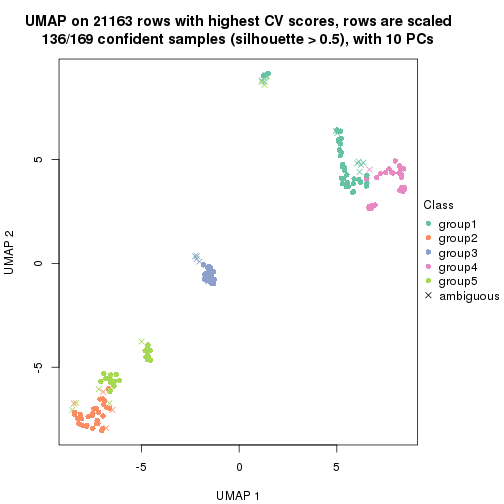
dimension_reduction(res, k = 6, method = "UMAP")
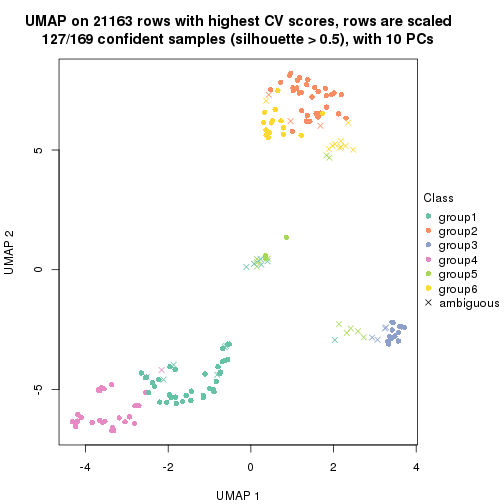
Following heatmap shows how subgroups are split when increasing k:
collect_classes(res)
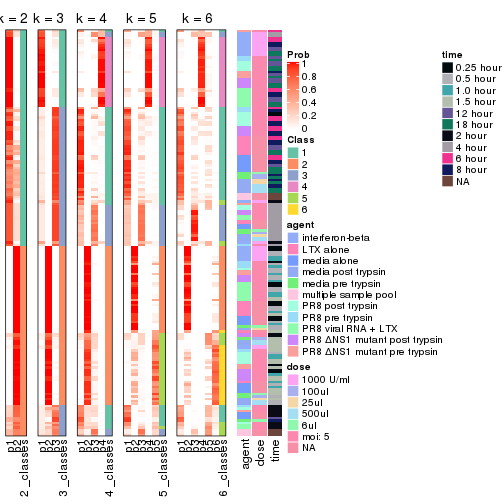
Test correlation between subgroups and known annotations. If the known annotation is numeric, one-way ANOVA test is applied, and if the known annotation is discrete, chi-squared contingency table test is applied.
test_to_known_factors(res)
#> n agent(p) dose(p) time(p) k
#> CV:mclust 152 8.45e-01 9.70e-01 8.25e-25 2
#> CV:mclust 165 2.14e-05 6.60e-06 1.06e-29 3
#> CV:mclust 142 7.48e-03 1.74e-03 8.79e-48 4
#> CV:mclust 136 1.93e-03 9.03e-04 1.68e-48 5
#> CV:mclust 127 3.12e-03 2.73e-04 1.68e-50 6
If matrix rows can be associated to genes, consider to use functional_enrichment(res,
...) to perform function enrichment for the signature genes. See this vignette for more detailed explanations.
The object with results only for a single top-value method and a single partition method can be extracted as:
res = res_list["CV", "NMF"]
# you can also extract it by
# res = res_list["CV:NMF"]
A summary of res and all the functions that can be applied to it:
res
#> A 'ConsensusPartition' object with k = 2, 3, 4, 5, 6.
#> On a matrix with 21163 rows and 169 columns.
#> Top rows (1000, 2000, 3000, 4000, 5000) are extracted by 'CV' method.
#> Subgroups are detected by 'NMF' method.
#> Performed in total 1250 partitions by row resampling.
#> Best k for subgroups seems to be 3.
#>
#> Following methods can be applied to this 'ConsensusPartition' object:
#> [1] "cola_report" "collect_classes" "collect_plots"
#> [4] "collect_stats" "colnames" "compare_signatures"
#> [7] "consensus_heatmap" "dimension_reduction" "functional_enrichment"
#> [10] "get_anno_col" "get_anno" "get_classes"
#> [13] "get_consensus" "get_matrix" "get_membership"
#> [16] "get_param" "get_signatures" "get_stats"
#> [19] "is_best_k" "is_stable_k" "membership_heatmap"
#> [22] "ncol" "nrow" "plot_ecdf"
#> [25] "rownames" "select_partition_number" "show"
#> [28] "suggest_best_k" "test_to_known_factors"
collect_plots() function collects all the plots made from res for all k (number of partitions)
into one single page to provide an easy and fast comparison between different k.
collect_plots(res)
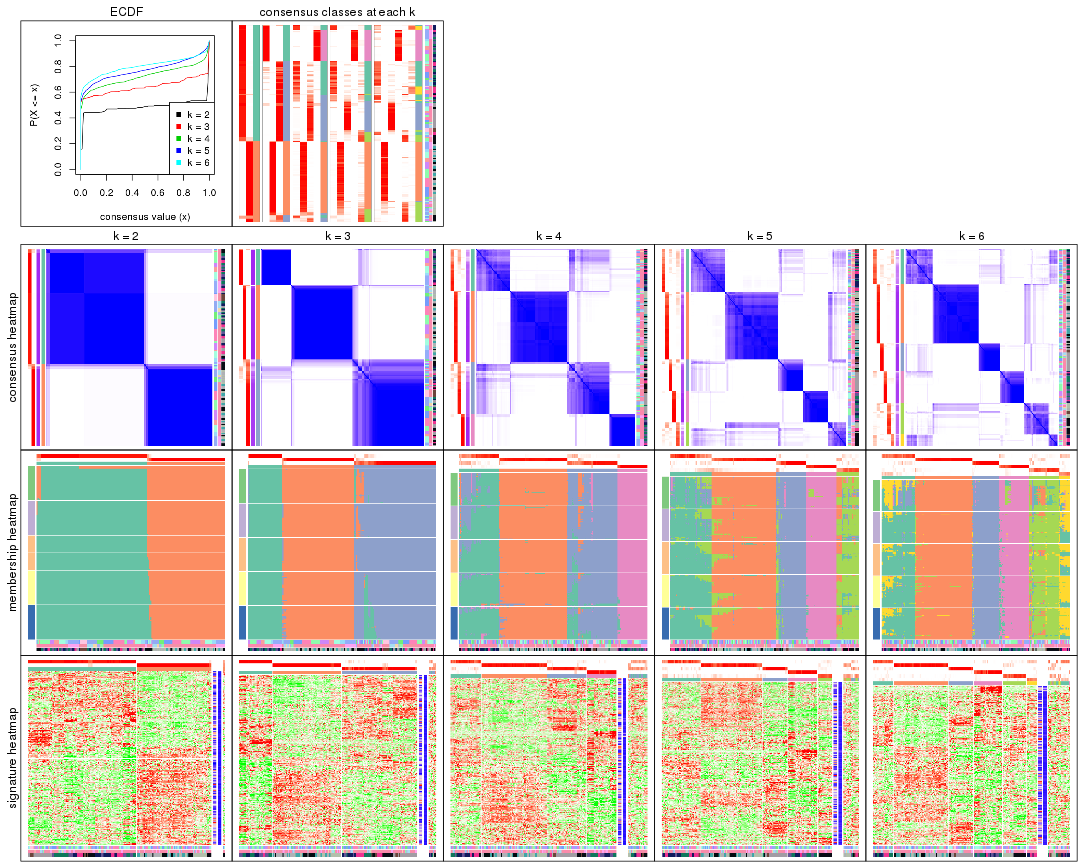
The plots are:
k and the heatmap of
predicted classes for each k.k.k.k.All the plots in panels can be made by individual functions and they are plotted later in this section.
select_partition_number() produces several plots showing different
statistics for choosing “optimized” k. There are following statistics:
k;k, the area increased is defined as \(A_k - A_{k-1}\).The detailed explanations of these statistics can be found in the cola vignette.
Generally speaking, lower PAC score, higher mean silhouette score or higher
concordance corresponds to better partition. Rand index and Jaccard index
measure how similar the current partition is compared to partition with k-1.
If they are too similar, we won't accept k is better than k-1.
select_partition_number(res)
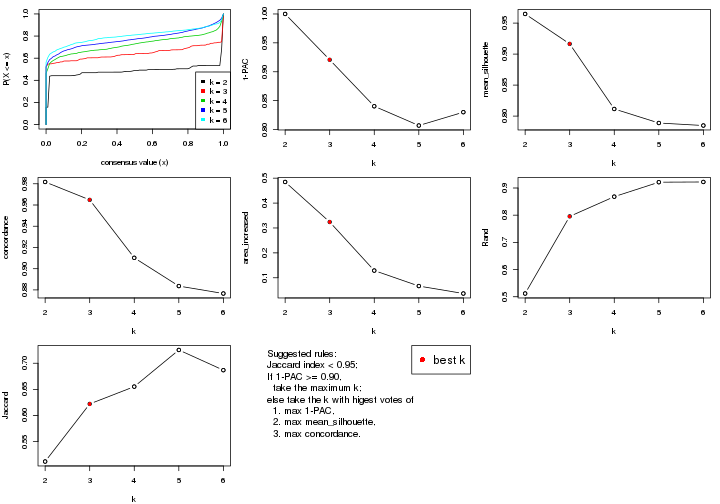
The numeric values for all these statistics can be obtained by get_stats().
get_stats(res)
#> k 1-PAC mean_silhouette concordance area_increased Rand Jaccard
#> 2 2 1.000 0.965 0.982 0.4848 0.512 0.512
#> 3 3 0.921 0.916 0.965 0.3240 0.796 0.622
#> 4 4 0.840 0.811 0.910 0.1289 0.868 0.655
#> 5 5 0.807 0.789 0.884 0.0667 0.921 0.725
#> 6 6 0.830 0.785 0.877 0.0366 0.922 0.687
suggest_best_k() suggests the best \(k\) based on these statistics. The rules are as follows:
suggest_best_k(res)
#> [1] 3
#> attr(,"optional")
#> [1] 2
There is also optional best \(k\) = 2 that is worth to check.
Following shows the table of the partitions (You need to click the show/hide
code output link to see it). The membership matrix (columns with name p*)
is inferred by
clue::cl_consensus()
function with the SE method. Basically the value in the membership matrix
represents the probability to belong to a certain group. The finall class
label for an item is determined with the group with highest probability it
belongs to.
In get_classes() function, the entropy is calculated from the membership
matrix and the silhouette score is calculated from the consensus matrix.
cbind(get_classes(res, k = 2), get_membership(res, k = 2))
#> class entropy silhouette p1 p2
#> GSM528681 2 0.0000 0.9814 0.000 1.000
#> GSM528682 2 0.0000 0.9814 0.000 1.000
#> GSM528683 2 0.0000 0.9814 0.000 1.000
#> GSM528684 2 0.0000 0.9814 0.000 1.000
#> GSM528687 2 0.0000 0.9814 0.000 1.000
#> GSM528688 2 0.0000 0.9814 0.000 1.000
#> GSM528685 2 0.0000 0.9814 0.000 1.000
#> GSM528686 2 0.0000 0.9814 0.000 1.000
#> GSM528693 1 0.1184 0.9854 0.984 0.016
#> GSM528694 1 0.1184 0.9854 0.984 0.016
#> GSM528695 1 0.0000 0.9807 1.000 0.000
#> GSM528696 1 0.0000 0.9807 1.000 0.000
#> GSM528697 1 0.0000 0.9807 1.000 0.000
#> GSM528698 1 0.0000 0.9807 1.000 0.000
#> GSM528699 1 0.0000 0.9807 1.000 0.000
#> GSM528700 1 0.0000 0.9807 1.000 0.000
#> GSM528689 1 0.0000 0.9807 1.000 0.000
#> GSM528690 1 0.0000 0.9807 1.000 0.000
#> GSM528691 1 0.0000 0.9807 1.000 0.000
#> GSM528692 1 0.0000 0.9807 1.000 0.000
#> GSM528779 2 0.0000 0.9814 0.000 1.000
#> GSM528780 2 0.0000 0.9814 0.000 1.000
#> GSM528782 2 0.0000 0.9814 0.000 1.000
#> GSM528781 2 0.0000 0.9814 0.000 1.000
#> GSM528785 2 0.6712 0.7769 0.176 0.824
#> GSM528786 1 0.1184 0.9854 0.984 0.016
#> GSM528787 1 0.1184 0.9854 0.984 0.016
#> GSM528788 1 0.1184 0.9854 0.984 0.016
#> GSM528783 1 0.0000 0.9807 1.000 0.000
#> GSM528784 1 0.0000 0.9807 1.000 0.000
#> GSM528759 1 0.1184 0.9854 0.984 0.016
#> GSM528760 1 0.1184 0.9854 0.984 0.016
#> GSM528761 2 0.0000 0.9814 0.000 1.000
#> GSM528762 2 0.0000 0.9814 0.000 1.000
#> GSM528765 2 0.0000 0.9814 0.000 1.000
#> GSM528766 2 0.0000 0.9814 0.000 1.000
#> GSM528763 2 0.0000 0.9814 0.000 1.000
#> GSM528764 2 0.0000 0.9814 0.000 1.000
#> GSM528771 2 0.6048 0.8159 0.148 0.852
#> GSM528772 2 0.9850 0.2350 0.428 0.572
#> GSM528773 1 0.1184 0.9854 0.984 0.016
#> GSM528774 1 0.1184 0.9854 0.984 0.016
#> GSM528775 1 0.1184 0.9854 0.984 0.016
#> GSM528776 1 0.1184 0.9854 0.984 0.016
#> GSM528777 1 0.0000 0.9807 1.000 0.000
#> GSM528778 1 0.0000 0.9807 1.000 0.000
#> GSM528767 1 0.0000 0.9807 1.000 0.000
#> GSM528768 1 0.0000 0.9807 1.000 0.000
#> GSM528769 1 0.0000 0.9807 1.000 0.000
#> GSM528770 1 0.0000 0.9807 1.000 0.000
#> GSM528671 2 0.0000 0.9814 0.000 1.000
#> GSM528672 2 0.0000 0.9814 0.000 1.000
#> GSM528674 2 0.0000 0.9814 0.000 1.000
#> GSM528673 2 0.0000 0.9814 0.000 1.000
#> GSM528677 1 0.7219 0.7662 0.800 0.200
#> GSM528678 1 0.1184 0.9854 0.984 0.016
#> GSM528679 1 0.0000 0.9807 1.000 0.000
#> GSM528680 1 0.0000 0.9807 1.000 0.000
#> GSM528675 1 0.0000 0.9807 1.000 0.000
#> GSM528676 1 0.0000 0.9807 1.000 0.000
#> GSM528651 2 0.0000 0.9814 0.000 1.000
#> GSM528652 2 0.0000 0.9814 0.000 1.000
#> GSM528653 2 0.0000 0.9814 0.000 1.000
#> GSM528654 2 0.0000 0.9814 0.000 1.000
#> GSM528657 2 0.0000 0.9814 0.000 1.000
#> GSM528658 2 0.0000 0.9814 0.000 1.000
#> GSM528655 2 0.0000 0.9814 0.000 1.000
#> GSM528656 2 0.0000 0.9814 0.000 1.000
#> GSM528663 2 0.0672 0.9740 0.008 0.992
#> GSM528664 2 0.0000 0.9814 0.000 1.000
#> GSM528665 1 0.1184 0.9854 0.984 0.016
#> GSM528666 1 0.1184 0.9854 0.984 0.016
#> GSM528667 1 0.1184 0.9854 0.984 0.016
#> GSM528668 1 0.1184 0.9854 0.984 0.016
#> GSM528669 1 0.1184 0.9854 0.984 0.016
#> GSM528670 1 0.1184 0.9854 0.984 0.016
#> GSM528659 1 0.0000 0.9807 1.000 0.000
#> GSM528660 1 0.0000 0.9807 1.000 0.000
#> GSM528661 1 0.0000 0.9807 1.000 0.000
#> GSM528662 1 0.0000 0.9807 1.000 0.000
#> GSM528701 2 0.0000 0.9814 0.000 1.000
#> GSM528702 2 0.0000 0.9814 0.000 1.000
#> GSM528703 2 0.0000 0.9814 0.000 1.000
#> GSM528704 2 0.0000 0.9814 0.000 1.000
#> GSM528707 2 0.0000 0.9814 0.000 1.000
#> GSM528708 2 0.0000 0.9814 0.000 1.000
#> GSM528705 2 0.0000 0.9814 0.000 1.000
#> GSM528706 2 0.0000 0.9814 0.000 1.000
#> GSM528713 1 0.7219 0.7662 0.800 0.200
#> GSM528714 1 0.6973 0.7840 0.812 0.188
#> GSM528715 1 0.1184 0.9854 0.984 0.016
#> GSM528716 1 0.1184 0.9854 0.984 0.016
#> GSM528717 1 0.0000 0.9807 1.000 0.000
#> GSM528718 1 0.0000 0.9807 1.000 0.000
#> GSM528719 1 0.0000 0.9807 1.000 0.000
#> GSM528720 1 0.0000 0.9807 1.000 0.000
#> GSM528709 1 0.0000 0.9807 1.000 0.000
#> GSM528710 1 0.0000 0.9807 1.000 0.000
#> GSM528711 1 0.0000 0.9807 1.000 0.000
#> GSM528712 1 0.0000 0.9807 1.000 0.000
#> GSM528721 2 0.0000 0.9814 0.000 1.000
#> GSM528722 2 0.0000 0.9814 0.000 1.000
#> GSM528723 2 0.0000 0.9814 0.000 1.000
#> GSM528724 2 0.0000 0.9814 0.000 1.000
#> GSM528727 2 0.0000 0.9814 0.000 1.000
#> GSM528728 2 0.0000 0.9814 0.000 1.000
#> GSM528725 2 0.0000 0.9814 0.000 1.000
#> GSM528726 2 0.0000 0.9814 0.000 1.000
#> GSM528733 1 0.1184 0.9854 0.984 0.016
#> GSM528734 1 0.1184 0.9854 0.984 0.016
#> GSM528735 1 0.1184 0.9854 0.984 0.016
#> GSM528736 1 0.1184 0.9854 0.984 0.016
#> GSM528737 1 0.1184 0.9854 0.984 0.016
#> GSM528738 1 0.1184 0.9854 0.984 0.016
#> GSM528729 1 0.1184 0.9854 0.984 0.016
#> GSM528730 1 0.1184 0.9854 0.984 0.016
#> GSM528731 1 0.1184 0.9854 0.984 0.016
#> GSM528732 1 0.1184 0.9854 0.984 0.016
#> GSM528739 2 0.0000 0.9814 0.000 1.000
#> GSM528740 2 0.0000 0.9814 0.000 1.000
#> GSM528741 2 0.0000 0.9814 0.000 1.000
#> GSM528742 2 0.0000 0.9814 0.000 1.000
#> GSM528745 2 0.0000 0.9814 0.000 1.000
#> GSM528746 2 0.0000 0.9814 0.000 1.000
#> GSM528743 2 0.0000 0.9814 0.000 1.000
#> GSM528744 2 0.0000 0.9814 0.000 1.000
#> GSM528751 2 0.9983 0.0681 0.476 0.524
#> GSM528752 1 0.8661 0.6133 0.712 0.288
#> GSM528753 1 0.1184 0.9854 0.984 0.016
#> GSM528754 1 0.1184 0.9854 0.984 0.016
#> GSM528755 1 0.1184 0.9854 0.984 0.016
#> GSM528756 1 0.1184 0.9854 0.984 0.016
#> GSM528757 1 0.1414 0.9824 0.980 0.020
#> GSM528758 1 0.1184 0.9854 0.984 0.016
#> GSM528747 1 0.1184 0.9854 0.984 0.016
#> GSM528748 1 0.1184 0.9854 0.984 0.016
#> GSM528749 1 0.1184 0.9854 0.984 0.016
#> GSM528750 1 0.1184 0.9854 0.984 0.016
#> GSM528640 2 0.0000 0.9814 0.000 1.000
#> GSM528641 2 0.0000 0.9814 0.000 1.000
#> GSM528643 1 0.1184 0.9854 0.984 0.016
#> GSM528644 1 0.1184 0.9854 0.984 0.016
#> GSM528642 1 0.1184 0.9854 0.984 0.016
#> GSM528620 2 0.0000 0.9814 0.000 1.000
#> GSM528621 2 0.0000 0.9814 0.000 1.000
#> GSM528623 1 0.1184 0.9854 0.984 0.016
#> GSM528624 1 0.1184 0.9854 0.984 0.016
#> GSM528622 1 0.1184 0.9854 0.984 0.016
#> GSM528625 2 0.0000 0.9814 0.000 1.000
#> GSM528626 2 0.0000 0.9814 0.000 1.000
#> GSM528628 1 0.1184 0.9854 0.984 0.016
#> GSM528629 1 0.1184 0.9854 0.984 0.016
#> GSM528627 1 0.1184 0.9854 0.984 0.016
#> GSM528630 2 0.0000 0.9814 0.000 1.000
#> GSM528631 2 0.0000 0.9814 0.000 1.000
#> GSM528632 2 0.0000 0.9814 0.000 1.000
#> GSM528633 2 0.0000 0.9814 0.000 1.000
#> GSM528636 1 0.1184 0.9854 0.984 0.016
#> GSM528637 1 0.1184 0.9854 0.984 0.016
#> GSM528638 1 0.1184 0.9854 0.984 0.016
#> GSM528639 1 0.1184 0.9854 0.984 0.016
#> GSM528634 1 0.1184 0.9854 0.984 0.016
#> GSM528635 1 0.1184 0.9854 0.984 0.016
#> GSM528645 1 0.1184 0.9854 0.984 0.016
#> GSM528646 1 0.1184 0.9854 0.984 0.016
#> GSM528647 1 0.1184 0.9854 0.984 0.016
#> GSM528648 1 0.1184 0.9854 0.984 0.016
#> GSM528649 1 0.1184 0.9854 0.984 0.016
#> GSM528650 1 0.1184 0.9854 0.984 0.016
cbind(get_classes(res, k = 3), get_membership(res, k = 3))
#> class entropy silhouette p1 p2 p3
#> GSM528681 2 0.0000 0.987 0.000 1.000 0.000
#> GSM528682 2 0.0000 0.987 0.000 1.000 0.000
#> GSM528683 2 0.0000 0.987 0.000 1.000 0.000
#> GSM528684 2 0.0000 0.987 0.000 1.000 0.000
#> GSM528687 2 0.0000 0.987 0.000 1.000 0.000
#> GSM528688 2 0.0000 0.987 0.000 1.000 0.000
#> GSM528685 2 0.0000 0.987 0.000 1.000 0.000
#> GSM528686 2 0.0000 0.987 0.000 1.000 0.000
#> GSM528693 3 0.0237 0.925 0.004 0.000 0.996
#> GSM528694 3 0.0000 0.927 0.000 0.000 1.000
#> GSM528695 3 0.4887 0.705 0.228 0.000 0.772
#> GSM528696 3 0.4702 0.727 0.212 0.000 0.788
#> GSM528697 1 0.0000 0.986 1.000 0.000 0.000
#> GSM528698 1 0.0000 0.986 1.000 0.000 0.000
#> GSM528699 1 0.0000 0.986 1.000 0.000 0.000
#> GSM528700 1 0.0000 0.986 1.000 0.000 0.000
#> GSM528689 1 0.0000 0.986 1.000 0.000 0.000
#> GSM528690 1 0.0000 0.986 1.000 0.000 0.000
#> GSM528691 1 0.0000 0.986 1.000 0.000 0.000
#> GSM528692 1 0.0000 0.986 1.000 0.000 0.000
#> GSM528779 2 0.0000 0.987 0.000 1.000 0.000
#> GSM528780 2 0.0000 0.987 0.000 1.000 0.000
#> GSM528782 2 0.0000 0.987 0.000 1.000 0.000
#> GSM528781 2 0.0000 0.987 0.000 1.000 0.000
#> GSM528785 2 0.6309 -0.056 0.000 0.504 0.496
#> GSM528786 3 0.0000 0.927 0.000 0.000 1.000
#> GSM528787 3 0.0000 0.927 0.000 0.000 1.000
#> GSM528788 3 0.6062 0.413 0.384 0.000 0.616
#> GSM528783 1 0.0000 0.986 1.000 0.000 0.000
#> GSM528784 1 0.0000 0.986 1.000 0.000 0.000
#> GSM528759 3 0.0000 0.927 0.000 0.000 1.000
#> GSM528760 3 0.0000 0.927 0.000 0.000 1.000
#> GSM528761 2 0.0000 0.987 0.000 1.000 0.000
#> GSM528762 2 0.0000 0.987 0.000 1.000 0.000
#> GSM528765 2 0.0000 0.987 0.000 1.000 0.000
#> GSM528766 2 0.0000 0.987 0.000 1.000 0.000
#> GSM528763 2 0.0000 0.987 0.000 1.000 0.000
#> GSM528764 2 0.0000 0.987 0.000 1.000 0.000
#> GSM528771 3 0.5529 0.590 0.000 0.296 0.704
#> GSM528772 3 0.4291 0.757 0.000 0.180 0.820
#> GSM528773 3 0.0000 0.927 0.000 0.000 1.000
#> GSM528774 3 0.0000 0.927 0.000 0.000 1.000
#> GSM528775 3 0.0000 0.927 0.000 0.000 1.000
#> GSM528776 3 0.0892 0.915 0.020 0.000 0.980
#> GSM528777 1 0.0000 0.986 1.000 0.000 0.000
#> GSM528778 1 0.0000 0.986 1.000 0.000 0.000
#> GSM528767 1 0.0000 0.986 1.000 0.000 0.000
#> GSM528768 1 0.0000 0.986 1.000 0.000 0.000
#> GSM528769 1 0.0000 0.986 1.000 0.000 0.000
#> GSM528770 1 0.0000 0.986 1.000 0.000 0.000
#> GSM528671 2 0.0000 0.987 0.000 1.000 0.000
#> GSM528672 2 0.0000 0.987 0.000 1.000 0.000
#> GSM528674 2 0.0000 0.987 0.000 1.000 0.000
#> GSM528673 2 0.0000 0.987 0.000 1.000 0.000
#> GSM528677 3 0.0000 0.927 0.000 0.000 1.000
#> GSM528678 3 0.0000 0.927 0.000 0.000 1.000
#> GSM528679 3 0.0424 0.922 0.008 0.000 0.992
#> GSM528680 1 0.0000 0.986 1.000 0.000 0.000
#> GSM528675 1 0.0000 0.986 1.000 0.000 0.000
#> GSM528676 1 0.0000 0.986 1.000 0.000 0.000
#> GSM528651 2 0.0000 0.987 0.000 1.000 0.000
#> GSM528652 2 0.0000 0.987 0.000 1.000 0.000
#> GSM528653 2 0.0000 0.987 0.000 1.000 0.000
#> GSM528654 2 0.0000 0.987 0.000 1.000 0.000
#> GSM528657 2 0.0000 0.987 0.000 1.000 0.000
#> GSM528658 2 0.0000 0.987 0.000 1.000 0.000
#> GSM528655 2 0.0000 0.987 0.000 1.000 0.000
#> GSM528656 2 0.0000 0.987 0.000 1.000 0.000
#> GSM528663 3 0.4887 0.699 0.000 0.228 0.772
#> GSM528664 3 0.6140 0.346 0.000 0.404 0.596
#> GSM528665 3 0.0000 0.927 0.000 0.000 1.000
#> GSM528666 3 0.0000 0.927 0.000 0.000 1.000
#> GSM528667 3 0.0000 0.927 0.000 0.000 1.000
#> GSM528668 3 0.0237 0.925 0.004 0.000 0.996
#> GSM528669 1 0.0237 0.982 0.996 0.000 0.004
#> GSM528670 1 0.6079 0.314 0.612 0.000 0.388
#> GSM528659 1 0.0000 0.986 1.000 0.000 0.000
#> GSM528660 1 0.0000 0.986 1.000 0.000 0.000
#> GSM528661 1 0.0000 0.986 1.000 0.000 0.000
#> GSM528662 1 0.0000 0.986 1.000 0.000 0.000
#> GSM528701 2 0.0000 0.987 0.000 1.000 0.000
#> GSM528702 2 0.0000 0.987 0.000 1.000 0.000
#> GSM528703 2 0.0000 0.987 0.000 1.000 0.000
#> GSM528704 2 0.0000 0.987 0.000 1.000 0.000
#> GSM528707 2 0.0000 0.987 0.000 1.000 0.000
#> GSM528708 2 0.0000 0.987 0.000 1.000 0.000
#> GSM528705 2 0.0000 0.987 0.000 1.000 0.000
#> GSM528706 2 0.0000 0.987 0.000 1.000 0.000
#> GSM528713 3 0.0000 0.927 0.000 0.000 1.000
#> GSM528714 3 0.0000 0.927 0.000 0.000 1.000
#> GSM528715 3 0.0000 0.927 0.000 0.000 1.000
#> GSM528716 3 0.0000 0.927 0.000 0.000 1.000
#> GSM528717 3 0.4399 0.771 0.188 0.000 0.812
#> GSM528718 3 0.0237 0.925 0.004 0.000 0.996
#> GSM528719 1 0.0000 0.986 1.000 0.000 0.000
#> GSM528720 1 0.0000 0.986 1.000 0.000 0.000
#> GSM528709 1 0.0000 0.986 1.000 0.000 0.000
#> GSM528710 1 0.0000 0.986 1.000 0.000 0.000
#> GSM528711 1 0.0000 0.986 1.000 0.000 0.000
#> GSM528712 1 0.0000 0.986 1.000 0.000 0.000
#> GSM528721 2 0.0000 0.987 0.000 1.000 0.000
#> GSM528722 2 0.0000 0.987 0.000 1.000 0.000
#> GSM528723 2 0.0000 0.987 0.000 1.000 0.000
#> GSM528724 2 0.0000 0.987 0.000 1.000 0.000
#> GSM528727 2 0.0000 0.987 0.000 1.000 0.000
#> GSM528728 2 0.0000 0.987 0.000 1.000 0.000
#> GSM528725 2 0.0000 0.987 0.000 1.000 0.000
#> GSM528726 2 0.0000 0.987 0.000 1.000 0.000
#> GSM528733 3 0.0000 0.927 0.000 0.000 1.000
#> GSM528734 3 0.0000 0.927 0.000 0.000 1.000
#> GSM528735 3 0.0000 0.927 0.000 0.000 1.000
#> GSM528736 3 0.0000 0.927 0.000 0.000 1.000
#> GSM528737 3 0.0000 0.927 0.000 0.000 1.000
#> GSM528738 3 0.0000 0.927 0.000 0.000 1.000
#> GSM528729 3 0.6045 0.423 0.380 0.000 0.620
#> GSM528730 3 0.4796 0.718 0.220 0.000 0.780
#> GSM528731 3 0.5988 0.451 0.368 0.000 0.632
#> GSM528732 3 0.0000 0.927 0.000 0.000 1.000
#> GSM528739 2 0.0000 0.987 0.000 1.000 0.000
#> GSM528740 2 0.0000 0.987 0.000 1.000 0.000
#> GSM528741 2 0.0000 0.987 0.000 1.000 0.000
#> GSM528742 2 0.0000 0.987 0.000 1.000 0.000
#> GSM528745 2 0.0000 0.987 0.000 1.000 0.000
#> GSM528746 2 0.0000 0.987 0.000 1.000 0.000
#> GSM528743 2 0.0000 0.987 0.000 1.000 0.000
#> GSM528744 2 0.0000 0.987 0.000 1.000 0.000
#> GSM528751 3 0.4399 0.748 0.000 0.188 0.812
#> GSM528752 3 0.2878 0.845 0.000 0.096 0.904
#> GSM528753 3 0.0000 0.927 0.000 0.000 1.000
#> GSM528754 3 0.0000 0.927 0.000 0.000 1.000
#> GSM528755 3 0.0000 0.927 0.000 0.000 1.000
#> GSM528756 3 0.0000 0.927 0.000 0.000 1.000
#> GSM528757 3 0.7451 0.503 0.304 0.060 0.636
#> GSM528758 3 0.2173 0.891 0.048 0.008 0.944
#> GSM528747 3 0.2356 0.876 0.072 0.000 0.928
#> GSM528748 3 0.0000 0.927 0.000 0.000 1.000
#> GSM528749 3 0.0000 0.927 0.000 0.000 1.000
#> GSM528750 3 0.3551 0.822 0.132 0.000 0.868
#> GSM528640 2 0.0000 0.987 0.000 1.000 0.000
#> GSM528641 2 0.0000 0.987 0.000 1.000 0.000
#> GSM528643 3 0.0000 0.927 0.000 0.000 1.000
#> GSM528644 3 0.0000 0.927 0.000 0.000 1.000
#> GSM528642 3 0.0000 0.927 0.000 0.000 1.000
#> GSM528620 2 0.0000 0.987 0.000 1.000 0.000
#> GSM528621 3 0.6204 0.285 0.000 0.424 0.576
#> GSM528623 3 0.0000 0.927 0.000 0.000 1.000
#> GSM528624 3 0.4808 0.754 0.188 0.008 0.804
#> GSM528622 3 0.0424 0.922 0.008 0.000 0.992
#> GSM528625 2 0.0000 0.987 0.000 1.000 0.000
#> GSM528626 2 0.1289 0.953 0.000 0.968 0.032
#> GSM528628 3 0.0000 0.927 0.000 0.000 1.000
#> GSM528629 3 0.0000 0.927 0.000 0.000 1.000
#> GSM528627 3 0.0000 0.927 0.000 0.000 1.000
#> GSM528630 2 0.0000 0.987 0.000 1.000 0.000
#> GSM528631 2 0.0000 0.987 0.000 1.000 0.000
#> GSM528632 2 0.2878 0.879 0.000 0.904 0.096
#> GSM528633 2 0.2537 0.898 0.000 0.920 0.080
#> GSM528636 3 0.0000 0.927 0.000 0.000 1.000
#> GSM528637 3 0.0000 0.927 0.000 0.000 1.000
#> GSM528638 3 0.4521 0.767 0.180 0.004 0.816
#> GSM528639 3 0.0000 0.927 0.000 0.000 1.000
#> GSM528634 3 0.0000 0.927 0.000 0.000 1.000
#> GSM528635 3 0.0000 0.927 0.000 0.000 1.000
#> GSM528645 3 0.0000 0.927 0.000 0.000 1.000
#> GSM528646 3 0.0000 0.927 0.000 0.000 1.000
#> GSM528647 3 0.0000 0.927 0.000 0.000 1.000
#> GSM528648 3 0.0000 0.927 0.000 0.000 1.000
#> GSM528649 3 0.0000 0.927 0.000 0.000 1.000
#> GSM528650 3 0.0000 0.927 0.000 0.000 1.000
cbind(get_classes(res, k = 4), get_membership(res, k = 4))
#> class entropy silhouette p1 p2 p3 p4
#> GSM528681 2 0.0592 0.9731 0.016 0.984 0.000 0.000
#> GSM528682 2 0.0188 0.9765 0.004 0.996 0.000 0.000
#> GSM528683 2 0.0188 0.9765 0.004 0.996 0.000 0.000
#> GSM528684 2 0.0592 0.9731 0.016 0.984 0.000 0.000
#> GSM528687 2 0.0188 0.9765 0.004 0.996 0.000 0.000
#> GSM528688 2 0.0188 0.9765 0.004 0.996 0.000 0.000
#> GSM528685 2 0.0469 0.9742 0.000 0.988 0.012 0.000
#> GSM528686 2 0.2048 0.9292 0.008 0.928 0.064 0.000
#> GSM528693 3 0.3015 0.7754 0.092 0.000 0.884 0.024
#> GSM528694 3 0.2149 0.7835 0.088 0.000 0.912 0.000
#> GSM528695 3 0.4560 0.5117 0.004 0.000 0.700 0.296
#> GSM528696 3 0.4188 0.5804 0.004 0.000 0.752 0.244
#> GSM528697 4 0.0000 0.9885 0.000 0.000 0.000 1.000
#> GSM528698 4 0.2760 0.8316 0.128 0.000 0.000 0.872
#> GSM528699 4 0.0469 0.9766 0.012 0.000 0.000 0.988
#> GSM528700 4 0.0000 0.9885 0.000 0.000 0.000 1.000
#> GSM528689 4 0.0000 0.9885 0.000 0.000 0.000 1.000
#> GSM528690 4 0.0000 0.9885 0.000 0.000 0.000 1.000
#> GSM528691 4 0.0000 0.9885 0.000 0.000 0.000 1.000
#> GSM528692 4 0.0000 0.9885 0.000 0.000 0.000 1.000
#> GSM528779 2 0.0188 0.9765 0.004 0.996 0.000 0.000
#> GSM528780 2 0.0000 0.9763 0.000 1.000 0.000 0.000
#> GSM528782 2 0.0817 0.9685 0.024 0.976 0.000 0.000
#> GSM528781 2 0.1059 0.9673 0.012 0.972 0.016 0.000
#> GSM528785 1 0.1356 0.7670 0.960 0.032 0.008 0.000
#> GSM528786 3 0.0336 0.8102 0.008 0.000 0.992 0.000
#> GSM528787 3 0.1792 0.7926 0.068 0.000 0.932 0.000
#> GSM528788 1 0.1639 0.7689 0.952 0.008 0.004 0.036
#> GSM528783 4 0.0000 0.9885 0.000 0.000 0.000 1.000
#> GSM528784 4 0.0000 0.9885 0.000 0.000 0.000 1.000
#> GSM528759 3 0.4543 0.3620 0.324 0.000 0.676 0.000
#> GSM528760 3 0.0921 0.8074 0.028 0.000 0.972 0.000
#> GSM528761 2 0.0469 0.9742 0.000 0.988 0.012 0.000
#> GSM528762 2 0.0592 0.9731 0.016 0.984 0.000 0.000
#> GSM528765 2 0.0469 0.9742 0.000 0.988 0.012 0.000
#> GSM528766 2 0.0000 0.9763 0.000 1.000 0.000 0.000
#> GSM528763 2 0.0469 0.9742 0.000 0.988 0.012 0.000
#> GSM528764 2 0.2081 0.9161 0.000 0.916 0.084 0.000
#> GSM528771 1 0.7785 0.1667 0.404 0.348 0.248 0.000
#> GSM528772 3 0.6653 0.4816 0.196 0.180 0.624 0.000
#> GSM528773 3 0.0336 0.8102 0.008 0.000 0.992 0.000
#> GSM528774 3 0.0469 0.8113 0.012 0.000 0.988 0.000
#> GSM528775 3 0.4008 0.5971 0.244 0.000 0.756 0.000
#> GSM528776 1 0.2466 0.7721 0.900 0.000 0.096 0.004
#> GSM528777 1 0.2179 0.7490 0.924 0.012 0.000 0.064
#> GSM528778 1 0.2179 0.7490 0.924 0.012 0.000 0.064
#> GSM528767 4 0.0000 0.9885 0.000 0.000 0.000 1.000
#> GSM528768 4 0.0000 0.9885 0.000 0.000 0.000 1.000
#> GSM528769 4 0.0000 0.9885 0.000 0.000 0.000 1.000
#> GSM528770 4 0.0000 0.9885 0.000 0.000 0.000 1.000
#> GSM528671 2 0.0469 0.9742 0.000 0.988 0.012 0.000
#> GSM528672 2 0.0592 0.9731 0.016 0.984 0.000 0.000
#> GSM528674 2 0.0000 0.9763 0.000 1.000 0.000 0.000
#> GSM528673 2 0.0817 0.9686 0.000 0.976 0.024 0.000
#> GSM528677 3 0.2149 0.7763 0.088 0.000 0.912 0.000
#> GSM528678 3 0.0469 0.8113 0.012 0.000 0.988 0.000
#> GSM528679 1 0.4422 0.6784 0.736 0.000 0.256 0.008
#> GSM528680 4 0.2530 0.8555 0.112 0.000 0.000 0.888
#> GSM528675 4 0.0000 0.9885 0.000 0.000 0.000 1.000
#> GSM528676 4 0.0000 0.9885 0.000 0.000 0.000 1.000
#> GSM528651 2 0.0657 0.9730 0.004 0.984 0.012 0.000
#> GSM528652 2 0.0779 0.9712 0.004 0.980 0.016 0.000
#> GSM528653 2 0.0469 0.9746 0.012 0.988 0.000 0.000
#> GSM528654 2 0.0817 0.9685 0.024 0.976 0.000 0.000
#> GSM528657 2 0.0469 0.9742 0.000 0.988 0.012 0.000
#> GSM528658 2 0.0188 0.9765 0.004 0.996 0.000 0.000
#> GSM528655 2 0.1389 0.9507 0.000 0.952 0.048 0.000
#> GSM528656 2 0.1305 0.9575 0.004 0.960 0.036 0.000
#> GSM528663 3 0.4245 0.6915 0.064 0.116 0.820 0.000
#> GSM528664 3 0.5566 0.5505 0.072 0.224 0.704 0.000
#> GSM528665 3 0.0592 0.8117 0.016 0.000 0.984 0.000
#> GSM528666 3 0.0592 0.8117 0.016 0.000 0.984 0.000
#> GSM528667 1 0.2281 0.7751 0.904 0.000 0.096 0.000
#> GSM528668 1 0.2216 0.7756 0.908 0.000 0.092 0.000
#> GSM528669 1 0.1767 0.7623 0.944 0.012 0.000 0.044
#> GSM528670 1 0.0469 0.7770 0.988 0.000 0.000 0.012
#> GSM528659 4 0.0000 0.9885 0.000 0.000 0.000 1.000
#> GSM528660 4 0.0000 0.9885 0.000 0.000 0.000 1.000
#> GSM528661 4 0.0000 0.9885 0.000 0.000 0.000 1.000
#> GSM528662 4 0.0000 0.9885 0.000 0.000 0.000 1.000
#> GSM528701 2 0.0469 0.9746 0.012 0.988 0.000 0.000
#> GSM528702 2 0.0592 0.9731 0.016 0.984 0.000 0.000
#> GSM528703 2 0.0188 0.9765 0.004 0.996 0.000 0.000
#> GSM528704 2 0.0592 0.9731 0.016 0.984 0.000 0.000
#> GSM528707 2 0.0188 0.9765 0.004 0.996 0.000 0.000
#> GSM528708 2 0.1389 0.9491 0.048 0.952 0.000 0.000
#> GSM528705 2 0.0188 0.9765 0.004 0.996 0.000 0.000
#> GSM528706 2 0.0336 0.9752 0.000 0.992 0.008 0.000
#> GSM528713 3 0.4008 0.5907 0.244 0.000 0.756 0.000
#> GSM528714 3 0.2124 0.7855 0.068 0.008 0.924 0.000
#> GSM528715 3 0.0469 0.8113 0.012 0.000 0.988 0.000
#> GSM528716 3 0.0592 0.8117 0.016 0.000 0.984 0.000
#> GSM528717 1 0.5208 0.6975 0.748 0.000 0.080 0.172
#> GSM528718 1 0.6276 0.2156 0.480 0.000 0.464 0.056
#> GSM528719 4 0.0000 0.9885 0.000 0.000 0.000 1.000
#> GSM528720 4 0.0000 0.9885 0.000 0.000 0.000 1.000
#> GSM528709 4 0.0000 0.9885 0.000 0.000 0.000 1.000
#> GSM528710 4 0.0000 0.9885 0.000 0.000 0.000 1.000
#> GSM528711 4 0.0000 0.9885 0.000 0.000 0.000 1.000
#> GSM528712 4 0.0000 0.9885 0.000 0.000 0.000 1.000
#> GSM528721 2 0.0188 0.9765 0.004 0.996 0.000 0.000
#> GSM528722 2 0.0188 0.9765 0.004 0.996 0.000 0.000
#> GSM528723 2 0.0336 0.9758 0.008 0.992 0.000 0.000
#> GSM528724 2 0.0469 0.9746 0.012 0.988 0.000 0.000
#> GSM528727 2 0.0469 0.9742 0.000 0.988 0.012 0.000
#> GSM528728 2 0.0592 0.9731 0.016 0.984 0.000 0.000
#> GSM528725 2 0.0336 0.9758 0.008 0.992 0.000 0.000
#> GSM528726 2 0.0469 0.9742 0.000 0.988 0.012 0.000
#> GSM528733 3 0.0469 0.8113 0.012 0.000 0.988 0.000
#> GSM528734 3 0.0592 0.8117 0.016 0.000 0.984 0.000
#> GSM528735 1 0.4730 0.5493 0.636 0.000 0.364 0.000
#> GSM528736 1 0.4888 0.4701 0.588 0.000 0.412 0.000
#> GSM528737 1 0.1716 0.7787 0.936 0.000 0.064 0.000
#> GSM528738 1 0.2647 0.7643 0.880 0.000 0.120 0.000
#> GSM528729 1 0.1004 0.7748 0.972 0.004 0.000 0.024
#> GSM528730 1 0.0779 0.7774 0.980 0.000 0.004 0.016
#> GSM528731 1 0.1191 0.7752 0.968 0.004 0.004 0.024
#> GSM528732 1 0.4605 0.5680 0.664 0.000 0.336 0.000
#> GSM528739 2 0.0707 0.9711 0.020 0.980 0.000 0.000
#> GSM528740 2 0.0592 0.9731 0.016 0.984 0.000 0.000
#> GSM528741 2 0.0336 0.9753 0.000 0.992 0.008 0.000
#> GSM528742 2 0.0188 0.9765 0.004 0.996 0.000 0.000
#> GSM528745 2 0.0592 0.9728 0.000 0.984 0.016 0.000
#> GSM528746 2 0.0188 0.9765 0.004 0.996 0.000 0.000
#> GSM528743 2 0.0779 0.9712 0.004 0.980 0.016 0.000
#> GSM528744 2 0.0469 0.9742 0.000 0.988 0.012 0.000
#> GSM528751 1 0.3009 0.7587 0.892 0.052 0.056 0.000
#> GSM528752 1 0.6350 0.3967 0.564 0.072 0.364 0.000
#> GSM528753 3 0.0592 0.8117 0.016 0.000 0.984 0.000
#> GSM528754 3 0.0592 0.8117 0.016 0.000 0.984 0.000
#> GSM528755 3 0.4855 0.2023 0.400 0.000 0.600 0.000
#> GSM528756 3 0.4776 0.2819 0.376 0.000 0.624 0.000
#> GSM528757 1 0.1059 0.7716 0.972 0.016 0.000 0.012
#> GSM528758 1 0.0564 0.7764 0.988 0.004 0.004 0.004
#> GSM528747 1 0.4917 0.5657 0.656 0.000 0.336 0.008
#> GSM528748 3 0.3975 0.5841 0.240 0.000 0.760 0.000
#> GSM528749 1 0.4994 0.2882 0.520 0.000 0.480 0.000
#> GSM528750 1 0.1488 0.7764 0.956 0.000 0.032 0.012
#> GSM528640 2 0.0188 0.9765 0.004 0.996 0.000 0.000
#> GSM528641 2 0.2216 0.9064 0.000 0.908 0.092 0.000
#> GSM528643 3 0.0592 0.8117 0.016 0.000 0.984 0.000
#> GSM528644 3 0.4992 -0.0727 0.476 0.000 0.524 0.000
#> GSM528642 3 0.0592 0.8117 0.016 0.000 0.984 0.000
#> GSM528620 2 0.0336 0.9753 0.000 0.992 0.008 0.000
#> GSM528621 3 0.4624 0.6394 0.052 0.164 0.784 0.000
#> GSM528623 3 0.0469 0.8113 0.012 0.000 0.988 0.000
#> GSM528624 1 0.0992 0.7756 0.976 0.008 0.004 0.012
#> GSM528622 1 0.3539 0.7404 0.820 0.000 0.176 0.004
#> GSM528625 2 0.0592 0.9731 0.016 0.984 0.000 0.000
#> GSM528626 2 0.5165 0.0624 0.004 0.512 0.484 0.000
#> GSM528628 3 0.0592 0.8117 0.016 0.000 0.984 0.000
#> GSM528629 1 0.4877 0.4239 0.592 0.000 0.408 0.000
#> GSM528627 1 0.4981 0.3141 0.536 0.000 0.464 0.000
#> GSM528630 2 0.0469 0.9742 0.000 0.988 0.012 0.000
#> GSM528631 2 0.0804 0.9714 0.008 0.980 0.012 0.000
#> GSM528632 3 0.5220 0.2038 0.008 0.424 0.568 0.000
#> GSM528633 3 0.5203 0.2233 0.008 0.416 0.576 0.000
#> GSM528636 3 0.0592 0.8117 0.016 0.000 0.984 0.000
#> GSM528637 3 0.0592 0.8117 0.016 0.000 0.984 0.000
#> GSM528638 1 0.0992 0.7756 0.976 0.008 0.004 0.012
#> GSM528639 1 0.2704 0.7600 0.876 0.000 0.124 0.000
#> GSM528634 3 0.4761 0.2707 0.372 0.000 0.628 0.000
#> GSM528635 1 0.4134 0.6849 0.740 0.000 0.260 0.000
#> GSM528645 3 0.0188 0.8047 0.000 0.004 0.996 0.000
#> GSM528646 3 0.0188 0.8047 0.000 0.004 0.996 0.000
#> GSM528647 3 0.0657 0.8019 0.012 0.004 0.984 0.000
#> GSM528648 3 0.4933 0.0077 0.432 0.000 0.568 0.000
#> GSM528649 3 0.1637 0.7953 0.060 0.000 0.940 0.000
#> GSM528650 1 0.4967 0.3130 0.548 0.000 0.452 0.000
cbind(get_classes(res, k = 5), get_membership(res, k = 5))
#> class entropy silhouette p1 p2 p3 p4 p5
#> GSM528681 2 0.0000 0.9186 0.000 1.000 0.000 0.000 0.000
#> GSM528682 2 0.0000 0.9186 0.000 1.000 0.000 0.000 0.000
#> GSM528683 2 0.0000 0.9186 0.000 1.000 0.000 0.000 0.000
#> GSM528684 2 0.0579 0.9142 0.008 0.984 0.000 0.000 0.008
#> GSM528687 2 0.0000 0.9186 0.000 1.000 0.000 0.000 0.000
#> GSM528688 2 0.0000 0.9186 0.000 1.000 0.000 0.000 0.000
#> GSM528685 2 0.3109 0.7710 0.000 0.800 0.000 0.000 0.200
#> GSM528686 5 0.4278 0.1694 0.000 0.452 0.000 0.000 0.548
#> GSM528693 5 0.4197 0.6256 0.052 0.000 0.080 0.052 0.816
#> GSM528694 5 0.3362 0.6359 0.076 0.000 0.080 0.000 0.844
#> GSM528695 3 0.2732 0.7368 0.000 0.000 0.840 0.160 0.000
#> GSM528696 3 0.2280 0.7826 0.000 0.000 0.880 0.120 0.000
#> GSM528697 4 0.0000 0.9818 0.000 0.000 0.000 1.000 0.000
#> GSM528698 4 0.1965 0.8785 0.096 0.000 0.000 0.904 0.000
#> GSM528699 4 0.0162 0.9795 0.004 0.000 0.000 0.996 0.000
#> GSM528700 4 0.0000 0.9818 0.000 0.000 0.000 1.000 0.000
#> GSM528689 4 0.0000 0.9818 0.000 0.000 0.000 1.000 0.000
#> GSM528690 4 0.0000 0.9818 0.000 0.000 0.000 1.000 0.000
#> GSM528691 4 0.0000 0.9818 0.000 0.000 0.000 1.000 0.000
#> GSM528692 4 0.0000 0.9818 0.000 0.000 0.000 1.000 0.000
#> GSM528779 2 0.0510 0.9169 0.000 0.984 0.000 0.000 0.016
#> GSM528780 2 0.0510 0.9169 0.000 0.984 0.000 0.000 0.016
#> GSM528782 2 0.0798 0.9101 0.016 0.976 0.000 0.000 0.008
#> GSM528781 5 0.4278 0.1721 0.000 0.452 0.000 0.000 0.548
#> GSM528785 5 0.4233 0.5583 0.208 0.044 0.000 0.000 0.748
#> GSM528786 3 0.0000 0.8963 0.000 0.000 1.000 0.000 0.000
#> GSM528787 5 0.4946 0.3986 0.060 0.000 0.276 0.000 0.664
#> GSM528788 1 0.1386 0.7725 0.952 0.016 0.000 0.000 0.032
#> GSM528783 4 0.0162 0.9813 0.000 0.000 0.000 0.996 0.004
#> GSM528784 4 0.1341 0.9551 0.000 0.000 0.000 0.944 0.056
#> GSM528759 3 0.3949 0.3418 0.332 0.000 0.668 0.000 0.000
#> GSM528760 3 0.1809 0.8458 0.012 0.000 0.928 0.000 0.060
#> GSM528761 2 0.1197 0.9051 0.000 0.952 0.000 0.000 0.048
#> GSM528762 2 0.0451 0.9156 0.008 0.988 0.000 0.000 0.004
#> GSM528765 2 0.2127 0.8667 0.000 0.892 0.000 0.000 0.108
#> GSM528766 2 0.0404 0.9176 0.000 0.988 0.000 0.000 0.012
#> GSM528763 2 0.1792 0.8873 0.000 0.916 0.000 0.000 0.084
#> GSM528764 2 0.4315 0.5587 0.000 0.700 0.276 0.000 0.024
#> GSM528771 5 0.2992 0.6723 0.068 0.064 0.000 0.000 0.868
#> GSM528772 5 0.2547 0.6593 0.068 0.016 0.016 0.000 0.900
#> GSM528773 3 0.0000 0.8963 0.000 0.000 1.000 0.000 0.000
#> GSM528774 3 0.0000 0.8963 0.000 0.000 1.000 0.000 0.000
#> GSM528775 5 0.6001 0.1492 0.244 0.000 0.176 0.000 0.580
#> GSM528776 1 0.3612 0.7442 0.764 0.000 0.008 0.000 0.228
#> GSM528777 1 0.1549 0.7701 0.944 0.016 0.000 0.000 0.040
#> GSM528778 1 0.1597 0.7691 0.940 0.012 0.000 0.000 0.048
#> GSM528767 4 0.1121 0.9619 0.000 0.000 0.000 0.956 0.044
#> GSM528768 4 0.1197 0.9594 0.000 0.000 0.000 0.952 0.048
#> GSM528769 4 0.1544 0.9472 0.000 0.000 0.000 0.932 0.068
#> GSM528770 4 0.1410 0.9526 0.000 0.000 0.000 0.940 0.060
#> GSM528671 2 0.1732 0.8873 0.000 0.920 0.000 0.000 0.080
#> GSM528672 2 0.0693 0.9124 0.012 0.980 0.000 0.000 0.008
#> GSM528674 2 0.0510 0.9169 0.000 0.984 0.000 0.000 0.016
#> GSM528673 2 0.3586 0.6733 0.000 0.736 0.000 0.000 0.264
#> GSM528677 5 0.2813 0.6536 0.040 0.000 0.084 0.000 0.876
#> GSM528678 3 0.1732 0.8371 0.000 0.000 0.920 0.000 0.080
#> GSM528679 1 0.3844 0.7660 0.792 0.000 0.164 0.000 0.044
#> GSM528680 4 0.1704 0.9096 0.068 0.000 0.000 0.928 0.004
#> GSM528675 4 0.0404 0.9785 0.000 0.000 0.000 0.988 0.012
#> GSM528676 4 0.0290 0.9801 0.000 0.000 0.000 0.992 0.008
#> GSM528651 2 0.3612 0.6632 0.000 0.732 0.000 0.000 0.268
#> GSM528652 2 0.3366 0.7234 0.000 0.768 0.000 0.000 0.232
#> GSM528653 2 0.0579 0.9142 0.008 0.984 0.000 0.000 0.008
#> GSM528654 2 0.0798 0.9101 0.016 0.976 0.000 0.000 0.008
#> GSM528657 2 0.1544 0.8947 0.000 0.932 0.000 0.000 0.068
#> GSM528658 2 0.0000 0.9186 0.000 1.000 0.000 0.000 0.000
#> GSM528655 2 0.3727 0.7362 0.000 0.768 0.016 0.000 0.216
#> GSM528656 2 0.4210 0.3106 0.000 0.588 0.000 0.000 0.412
#> GSM528663 5 0.3547 0.6805 0.004 0.100 0.060 0.000 0.836
#> GSM528664 5 0.3368 0.6635 0.000 0.156 0.024 0.000 0.820
#> GSM528665 3 0.0000 0.8963 0.000 0.000 1.000 0.000 0.000
#> GSM528666 3 0.0000 0.8963 0.000 0.000 1.000 0.000 0.000
#> GSM528667 1 0.0865 0.7889 0.972 0.000 0.004 0.000 0.024
#> GSM528668 1 0.0794 0.7841 0.972 0.000 0.000 0.000 0.028
#> GSM528669 1 0.1121 0.7946 0.956 0.000 0.000 0.000 0.044
#> GSM528670 1 0.2852 0.7708 0.828 0.000 0.000 0.000 0.172
#> GSM528659 4 0.0162 0.9813 0.000 0.000 0.000 0.996 0.004
#> GSM528660 4 0.0162 0.9813 0.000 0.000 0.000 0.996 0.004
#> GSM528661 4 0.0162 0.9813 0.000 0.000 0.000 0.996 0.004
#> GSM528662 4 0.0162 0.9813 0.000 0.000 0.000 0.996 0.004
#> GSM528701 2 0.0693 0.9124 0.012 0.980 0.000 0.000 0.008
#> GSM528702 2 0.0671 0.9123 0.016 0.980 0.000 0.000 0.004
#> GSM528703 2 0.0290 0.9182 0.000 0.992 0.000 0.000 0.008
#> GSM528704 2 0.0579 0.9142 0.008 0.984 0.000 0.000 0.008
#> GSM528707 2 0.0162 0.9186 0.000 0.996 0.000 0.000 0.004
#> GSM528708 2 0.0912 0.9079 0.016 0.972 0.000 0.000 0.012
#> GSM528705 2 0.0290 0.9187 0.000 0.992 0.000 0.000 0.008
#> GSM528706 2 0.0794 0.9140 0.000 0.972 0.000 0.000 0.028
#> GSM528713 5 0.2932 0.6224 0.104 0.000 0.032 0.000 0.864
#> GSM528714 5 0.2871 0.6577 0.032 0.004 0.088 0.000 0.876
#> GSM528715 3 0.0000 0.8963 0.000 0.000 1.000 0.000 0.000
#> GSM528716 3 0.0000 0.8963 0.000 0.000 1.000 0.000 0.000
#> GSM528717 1 0.3465 0.7615 0.840 0.000 0.004 0.104 0.052
#> GSM528718 1 0.6482 0.6350 0.580 0.000 0.080 0.060 0.280
#> GSM528719 4 0.0000 0.9818 0.000 0.000 0.000 1.000 0.000
#> GSM528720 4 0.0000 0.9818 0.000 0.000 0.000 1.000 0.000
#> GSM528709 4 0.0000 0.9818 0.000 0.000 0.000 1.000 0.000
#> GSM528710 4 0.0000 0.9818 0.000 0.000 0.000 1.000 0.000
#> GSM528711 4 0.0000 0.9818 0.000 0.000 0.000 1.000 0.000
#> GSM528712 4 0.0000 0.9818 0.000 0.000 0.000 1.000 0.000
#> GSM528721 2 0.0162 0.9186 0.000 0.996 0.000 0.000 0.004
#> GSM528722 2 0.0290 0.9182 0.000 0.992 0.000 0.000 0.008
#> GSM528723 2 0.0000 0.9186 0.000 1.000 0.000 0.000 0.000
#> GSM528724 2 0.0290 0.9169 0.008 0.992 0.000 0.000 0.000
#> GSM528727 2 0.1908 0.8790 0.000 0.908 0.000 0.000 0.092
#> GSM528728 2 0.0162 0.9179 0.004 0.996 0.000 0.000 0.000
#> GSM528725 2 0.1117 0.9038 0.016 0.964 0.000 0.000 0.020
#> GSM528726 2 0.0880 0.9125 0.000 0.968 0.000 0.000 0.032
#> GSM528733 3 0.0000 0.8963 0.000 0.000 1.000 0.000 0.000
#> GSM528734 3 0.0000 0.8963 0.000 0.000 1.000 0.000 0.000
#> GSM528735 1 0.2871 0.7932 0.872 0.000 0.088 0.000 0.040
#> GSM528736 1 0.3565 0.7760 0.816 0.000 0.144 0.000 0.040
#> GSM528737 1 0.0963 0.7935 0.964 0.000 0.000 0.000 0.036
#> GSM528738 1 0.3231 0.7610 0.800 0.000 0.004 0.000 0.196
#> GSM528729 1 0.0451 0.7893 0.988 0.008 0.000 0.000 0.004
#> GSM528730 1 0.0671 0.7923 0.980 0.004 0.000 0.000 0.016
#> GSM528731 1 0.0510 0.7874 0.984 0.000 0.000 0.000 0.016
#> GSM528732 1 0.4946 0.7399 0.712 0.000 0.120 0.000 0.168
#> GSM528739 2 0.0898 0.9078 0.020 0.972 0.000 0.000 0.008
#> GSM528740 2 0.0798 0.9101 0.016 0.976 0.000 0.000 0.008
#> GSM528741 2 0.0703 0.9147 0.000 0.976 0.000 0.000 0.024
#> GSM528742 2 0.0290 0.9182 0.000 0.992 0.000 0.000 0.008
#> GSM528745 2 0.2179 0.8639 0.000 0.888 0.000 0.000 0.112
#> GSM528746 2 0.0000 0.9186 0.000 1.000 0.000 0.000 0.000
#> GSM528743 2 0.3109 0.7704 0.000 0.800 0.000 0.000 0.200
#> GSM528744 2 0.2561 0.8341 0.000 0.856 0.000 0.000 0.144
#> GSM528751 5 0.3732 0.5920 0.176 0.032 0.000 0.000 0.792
#> GSM528752 5 0.2770 0.6064 0.124 0.004 0.008 0.000 0.864
#> GSM528753 3 0.0000 0.8963 0.000 0.000 1.000 0.000 0.000
#> GSM528754 3 0.0000 0.8963 0.000 0.000 1.000 0.000 0.000
#> GSM528755 1 0.6396 0.5278 0.488 0.000 0.188 0.000 0.324
#> GSM528756 1 0.6154 0.5413 0.508 0.000 0.144 0.000 0.348
#> GSM528757 1 0.1012 0.7798 0.968 0.012 0.000 0.000 0.020
#> GSM528758 1 0.1041 0.7944 0.964 0.004 0.000 0.000 0.032
#> GSM528747 1 0.5692 0.6894 0.628 0.000 0.168 0.000 0.204
#> GSM528748 3 0.6211 0.2568 0.204 0.000 0.548 0.000 0.248
#> GSM528749 1 0.5382 0.5245 0.580 0.000 0.352 0.000 0.068
#> GSM528750 1 0.2777 0.7640 0.896 0.028 0.036 0.000 0.040
#> GSM528640 2 0.0000 0.9186 0.000 1.000 0.000 0.000 0.000
#> GSM528641 2 0.4238 0.7524 0.000 0.776 0.088 0.000 0.136
#> GSM528643 3 0.0000 0.8963 0.000 0.000 1.000 0.000 0.000
#> GSM528644 1 0.6318 0.5190 0.488 0.000 0.168 0.000 0.344
#> GSM528642 3 0.1800 0.8455 0.020 0.000 0.932 0.000 0.048
#> GSM528620 2 0.1197 0.9053 0.000 0.952 0.000 0.000 0.048
#> GSM528621 5 0.3465 0.6771 0.004 0.104 0.052 0.000 0.840
#> GSM528623 3 0.0000 0.8963 0.000 0.000 1.000 0.000 0.000
#> GSM528624 1 0.0566 0.7880 0.984 0.012 0.000 0.000 0.004
#> GSM528622 1 0.3119 0.7946 0.860 0.000 0.072 0.000 0.068
#> GSM528625 2 0.0290 0.9169 0.008 0.992 0.000 0.000 0.000
#> GSM528626 5 0.4980 0.0330 0.000 0.484 0.028 0.000 0.488
#> GSM528628 3 0.0000 0.8963 0.000 0.000 1.000 0.000 0.000
#> GSM528629 1 0.5778 0.6544 0.596 0.000 0.132 0.000 0.272
#> GSM528627 1 0.5525 0.6913 0.636 0.000 0.124 0.000 0.240
#> GSM528630 2 0.2074 0.8700 0.000 0.896 0.000 0.000 0.104
#> GSM528631 2 0.4192 0.3366 0.000 0.596 0.000 0.000 0.404
#> GSM528632 5 0.4808 0.3120 0.000 0.400 0.024 0.000 0.576
#> GSM528633 5 0.5500 0.3450 0.000 0.376 0.072 0.000 0.552
#> GSM528636 3 0.0000 0.8963 0.000 0.000 1.000 0.000 0.000
#> GSM528637 3 0.0000 0.8963 0.000 0.000 1.000 0.000 0.000
#> GSM528638 1 0.0865 0.7938 0.972 0.004 0.000 0.000 0.024
#> GSM528639 1 0.4306 0.6541 0.660 0.000 0.012 0.000 0.328
#> GSM528634 1 0.6678 0.4587 0.436 0.000 0.300 0.000 0.264
#> GSM528635 1 0.2806 0.7732 0.844 0.000 0.152 0.000 0.004
#> GSM528645 3 0.0162 0.8939 0.000 0.000 0.996 0.000 0.004
#> GSM528646 3 0.0000 0.8963 0.000 0.000 1.000 0.000 0.000
#> GSM528647 3 0.4306 0.0500 0.000 0.000 0.508 0.000 0.492
#> GSM528648 1 0.5104 0.6073 0.632 0.000 0.308 0.000 0.060
#> GSM528649 3 0.6219 -0.0293 0.140 0.000 0.436 0.000 0.424
#> GSM528650 1 0.6030 0.6230 0.580 0.000 0.196 0.000 0.224
cbind(get_classes(res, k = 6), get_membership(res, k = 6))
#> class entropy silhouette p1 p2 p3 p4 p5 p6
#> GSM528681 2 0.0000 0.9716 0.000 1.000 0.000 0.000 0.000 0.000
#> GSM528682 2 0.0000 0.9716 0.000 1.000 0.000 0.000 0.000 0.000
#> GSM528683 2 0.0000 0.9716 0.000 1.000 0.000 0.000 0.000 0.000
#> GSM528684 2 0.0000 0.9716 0.000 1.000 0.000 0.000 0.000 0.000
#> GSM528687 2 0.0146 0.9716 0.000 0.996 0.000 0.000 0.004 0.000
#> GSM528688 2 0.0146 0.9716 0.000 0.996 0.000 0.000 0.004 0.000
#> GSM528685 5 0.4851 0.3881 0.000 0.404 0.000 0.000 0.536 0.060
#> GSM528686 5 0.2725 0.7624 0.040 0.060 0.000 0.000 0.880 0.020
#> GSM528693 5 0.1584 0.7478 0.008 0.000 0.000 0.000 0.928 0.064
#> GSM528694 5 0.1334 0.7516 0.020 0.000 0.000 0.000 0.948 0.032
#> GSM528695 3 0.1663 0.8597 0.000 0.000 0.912 0.088 0.000 0.000
#> GSM528696 3 0.0632 0.9364 0.000 0.000 0.976 0.024 0.000 0.000
#> GSM528697 4 0.0000 0.9179 0.000 0.000 0.000 1.000 0.000 0.000
#> GSM528698 4 0.3371 0.5653 0.292 0.000 0.000 0.708 0.000 0.000
#> GSM528699 4 0.3810 0.2809 0.428 0.000 0.000 0.572 0.000 0.000
#> GSM528700 4 0.0000 0.9179 0.000 0.000 0.000 1.000 0.000 0.000
#> GSM528689 4 0.0000 0.9179 0.000 0.000 0.000 1.000 0.000 0.000
#> GSM528690 4 0.0000 0.9179 0.000 0.000 0.000 1.000 0.000 0.000
#> GSM528691 4 0.1863 0.8562 0.104 0.000 0.000 0.896 0.000 0.000
#> GSM528692 4 0.2300 0.8221 0.144 0.000 0.000 0.856 0.000 0.000
#> GSM528779 2 0.0000 0.9716 0.000 1.000 0.000 0.000 0.000 0.000
#> GSM528780 2 0.0146 0.9714 0.000 0.996 0.000 0.000 0.004 0.000
#> GSM528782 2 0.0260 0.9689 0.000 0.992 0.000 0.000 0.000 0.008
#> GSM528781 5 0.3371 0.6388 0.000 0.292 0.000 0.000 0.708 0.000
#> GSM528785 5 0.1858 0.7394 0.004 0.000 0.000 0.000 0.904 0.092
#> GSM528786 3 0.0000 0.9592 0.000 0.000 1.000 0.000 0.000 0.000
#> GSM528787 1 0.4059 0.4686 0.752 0.000 0.100 0.000 0.148 0.000
#> GSM528788 1 0.4099 0.2667 0.612 0.016 0.000 0.000 0.000 0.372
#> GSM528783 4 0.2664 0.7745 0.184 0.000 0.000 0.816 0.000 0.000
#> GSM528784 4 0.2237 0.8678 0.000 0.000 0.000 0.896 0.036 0.068
#> GSM528759 3 0.2402 0.8436 0.008 0.000 0.888 0.000 0.020 0.084
#> GSM528760 3 0.1196 0.9190 0.008 0.000 0.952 0.000 0.040 0.000
#> GSM528761 2 0.0260 0.9700 0.000 0.992 0.000 0.000 0.008 0.000
#> GSM528762 2 0.0146 0.9707 0.000 0.996 0.000 0.000 0.000 0.004
#> GSM528765 2 0.0547 0.9640 0.000 0.980 0.000 0.000 0.020 0.000
#> GSM528766 2 0.0146 0.9714 0.000 0.996 0.000 0.000 0.004 0.000
#> GSM528763 2 0.4947 -0.1920 0.000 0.480 0.000 0.000 0.456 0.064
#> GSM528764 3 0.6091 0.2524 0.000 0.316 0.532 0.000 0.072 0.080
#> GSM528771 5 0.0909 0.7559 0.012 0.000 0.000 0.000 0.968 0.020
#> GSM528772 5 0.1524 0.7517 0.060 0.000 0.000 0.000 0.932 0.008
#> GSM528773 3 0.0000 0.9592 0.000 0.000 1.000 0.000 0.000 0.000
#> GSM528774 3 0.0000 0.9592 0.000 0.000 1.000 0.000 0.000 0.000
#> GSM528775 1 0.2752 0.5945 0.856 0.000 0.036 0.000 0.108 0.000
#> GSM528776 1 0.3960 0.4732 0.752 0.000 0.000 0.000 0.072 0.176
#> GSM528777 6 0.3266 0.7463 0.272 0.000 0.000 0.000 0.000 0.728
#> GSM528778 6 0.3126 0.7405 0.248 0.000 0.000 0.000 0.000 0.752
#> GSM528767 4 0.1644 0.8881 0.000 0.000 0.000 0.932 0.028 0.040
#> GSM528768 4 0.1572 0.8903 0.000 0.000 0.000 0.936 0.028 0.036
#> GSM528769 4 0.3644 0.7855 0.000 0.000 0.000 0.792 0.088 0.120
#> GSM528770 4 0.3327 0.8078 0.000 0.000 0.000 0.820 0.088 0.092
#> GSM528671 2 0.0260 0.9700 0.000 0.992 0.000 0.000 0.008 0.000
#> GSM528672 2 0.0260 0.9689 0.000 0.992 0.000 0.000 0.000 0.008
#> GSM528674 2 0.0000 0.9716 0.000 1.000 0.000 0.000 0.000 0.000
#> GSM528673 5 0.3858 0.6895 0.000 0.216 0.000 0.000 0.740 0.044
#> GSM528677 5 0.1285 0.7524 0.052 0.000 0.000 0.000 0.944 0.004
#> GSM528678 3 0.0405 0.9512 0.004 0.000 0.988 0.000 0.008 0.000
#> GSM528679 1 0.4100 0.6446 0.760 0.000 0.124 0.000 0.004 0.112
#> GSM528680 4 0.2416 0.7699 0.156 0.000 0.000 0.844 0.000 0.000
#> GSM528675 4 0.0000 0.9179 0.000 0.000 0.000 1.000 0.000 0.000
#> GSM528676 4 0.0000 0.9179 0.000 0.000 0.000 1.000 0.000 0.000
#> GSM528651 2 0.1141 0.9386 0.000 0.948 0.000 0.000 0.052 0.000
#> GSM528652 2 0.0632 0.9610 0.000 0.976 0.000 0.000 0.024 0.000
#> GSM528653 2 0.0260 0.9689 0.000 0.992 0.000 0.000 0.000 0.008
#> GSM528654 2 0.0260 0.9689 0.000 0.992 0.000 0.000 0.000 0.008
#> GSM528657 2 0.0363 0.9683 0.000 0.988 0.000 0.000 0.012 0.000
#> GSM528658 2 0.0146 0.9716 0.000 0.996 0.000 0.000 0.004 0.000
#> GSM528655 5 0.4954 0.6082 0.000 0.232 0.000 0.000 0.640 0.128
#> GSM528656 5 0.3025 0.7317 0.000 0.156 0.000 0.000 0.820 0.024
#> GSM528663 5 0.1124 0.7608 0.036 0.008 0.000 0.000 0.956 0.000
#> GSM528664 5 0.1138 0.7595 0.024 0.004 0.000 0.000 0.960 0.012
#> GSM528665 3 0.0000 0.9592 0.000 0.000 1.000 0.000 0.000 0.000
#> GSM528666 3 0.0000 0.9592 0.000 0.000 1.000 0.000 0.000 0.000
#> GSM528667 6 0.3725 0.7199 0.316 0.000 0.000 0.000 0.008 0.676
#> GSM528668 6 0.3672 0.7504 0.276 0.000 0.004 0.000 0.008 0.712
#> GSM528669 6 0.4159 0.6354 0.396 0.000 0.000 0.000 0.016 0.588
#> GSM528670 1 0.4684 -0.0705 0.592 0.000 0.000 0.000 0.056 0.352
#> GSM528659 4 0.0000 0.9179 0.000 0.000 0.000 1.000 0.000 0.000
#> GSM528660 4 0.0000 0.9179 0.000 0.000 0.000 1.000 0.000 0.000
#> GSM528661 4 0.0000 0.9179 0.000 0.000 0.000 1.000 0.000 0.000
#> GSM528662 4 0.0000 0.9179 0.000 0.000 0.000 1.000 0.000 0.000
#> GSM528701 2 0.0260 0.9689 0.000 0.992 0.000 0.000 0.000 0.008
#> GSM528702 2 0.0260 0.9689 0.000 0.992 0.000 0.000 0.000 0.008
#> GSM528703 2 0.0260 0.9704 0.000 0.992 0.000 0.000 0.008 0.000
#> GSM528704 2 0.0146 0.9716 0.000 0.996 0.000 0.000 0.004 0.000
#> GSM528707 2 0.0146 0.9716 0.000 0.996 0.000 0.000 0.004 0.000
#> GSM528708 2 0.0777 0.9617 0.000 0.972 0.000 0.000 0.004 0.024
#> GSM528705 2 0.0508 0.9674 0.000 0.984 0.000 0.000 0.012 0.004
#> GSM528706 2 0.1501 0.9124 0.000 0.924 0.000 0.000 0.076 0.000
#> GSM528713 5 0.1524 0.7495 0.060 0.000 0.000 0.000 0.932 0.008
#> GSM528714 5 0.1957 0.7375 0.112 0.000 0.000 0.000 0.888 0.000
#> GSM528715 3 0.0000 0.9592 0.000 0.000 1.000 0.000 0.000 0.000
#> GSM528716 3 0.0000 0.9592 0.000 0.000 1.000 0.000 0.000 0.000
#> GSM528717 6 0.5690 0.6670 0.252 0.000 0.000 0.100 0.044 0.604
#> GSM528718 1 0.4805 0.5647 0.752 0.000 0.016 0.112 0.048 0.072
#> GSM528719 4 0.0363 0.9128 0.012 0.000 0.000 0.988 0.000 0.000
#> GSM528720 4 0.0146 0.9163 0.004 0.000 0.000 0.996 0.000 0.000
#> GSM528709 4 0.0000 0.9179 0.000 0.000 0.000 1.000 0.000 0.000
#> GSM528710 4 0.0000 0.9179 0.000 0.000 0.000 1.000 0.000 0.000
#> GSM528711 4 0.0000 0.9179 0.000 0.000 0.000 1.000 0.000 0.000
#> GSM528712 4 0.0000 0.9179 0.000 0.000 0.000 1.000 0.000 0.000
#> GSM528721 2 0.0000 0.9716 0.000 1.000 0.000 0.000 0.000 0.000
#> GSM528722 2 0.0000 0.9716 0.000 1.000 0.000 0.000 0.000 0.000
#> GSM528723 2 0.0146 0.9716 0.000 0.996 0.000 0.000 0.004 0.000
#> GSM528724 2 0.0146 0.9707 0.000 0.996 0.000 0.000 0.000 0.004
#> GSM528727 2 0.0458 0.9661 0.000 0.984 0.000 0.000 0.016 0.000
#> GSM528728 2 0.0000 0.9716 0.000 1.000 0.000 0.000 0.000 0.000
#> GSM528725 2 0.1462 0.9331 0.000 0.936 0.000 0.000 0.008 0.056
#> GSM528726 2 0.1387 0.9214 0.000 0.932 0.000 0.000 0.068 0.000
#> GSM528733 3 0.0000 0.9592 0.000 0.000 1.000 0.000 0.000 0.000
#> GSM528734 3 0.0000 0.9592 0.000 0.000 1.000 0.000 0.000 0.000
#> GSM528735 6 0.5511 0.7091 0.272 0.000 0.080 0.000 0.040 0.608
#> GSM528736 6 0.6190 0.6328 0.252 0.000 0.152 0.000 0.048 0.548
#> GSM528737 6 0.4129 0.5426 0.424 0.000 0.000 0.000 0.012 0.564
#> GSM528738 1 0.3989 0.4342 0.720 0.000 0.000 0.000 0.044 0.236
#> GSM528729 1 0.3409 0.4560 0.700 0.000 0.000 0.000 0.000 0.300
#> GSM528730 1 0.3101 0.5325 0.756 0.000 0.000 0.000 0.000 0.244
#> GSM528731 1 0.3409 0.4675 0.700 0.000 0.000 0.000 0.000 0.300
#> GSM528732 1 0.2510 0.6728 0.872 0.000 0.100 0.000 0.000 0.028
#> GSM528739 2 0.0260 0.9689 0.000 0.992 0.000 0.000 0.000 0.008
#> GSM528740 2 0.0260 0.9689 0.000 0.992 0.000 0.000 0.000 0.008
#> GSM528741 2 0.0146 0.9714 0.000 0.996 0.000 0.000 0.004 0.000
#> GSM528742 2 0.0146 0.9716 0.000 0.996 0.000 0.000 0.004 0.000
#> GSM528745 2 0.0547 0.9651 0.000 0.980 0.000 0.000 0.020 0.000
#> GSM528746 2 0.0000 0.9716 0.000 1.000 0.000 0.000 0.000 0.000
#> GSM528743 2 0.1957 0.8679 0.000 0.888 0.000 0.000 0.112 0.000
#> GSM528744 2 0.1910 0.8731 0.000 0.892 0.000 0.000 0.108 0.000
#> GSM528751 5 0.1524 0.7483 0.008 0.000 0.000 0.000 0.932 0.060
#> GSM528752 5 0.1462 0.7506 0.056 0.000 0.000 0.000 0.936 0.008
#> GSM528753 3 0.0000 0.9592 0.000 0.000 1.000 0.000 0.000 0.000
#> GSM528754 3 0.0000 0.9592 0.000 0.000 1.000 0.000 0.000 0.000
#> GSM528755 1 0.3480 0.6519 0.808 0.000 0.140 0.000 0.044 0.008
#> GSM528756 1 0.2858 0.6319 0.864 0.000 0.028 0.000 0.092 0.016
#> GSM528757 1 0.3898 0.3784 0.652 0.012 0.000 0.000 0.000 0.336
#> GSM528758 1 0.2402 0.6283 0.868 0.012 0.000 0.000 0.000 0.120
#> GSM528747 1 0.2431 0.6641 0.860 0.000 0.132 0.000 0.000 0.008
#> GSM528748 1 0.3466 0.5683 0.760 0.008 0.224 0.000 0.008 0.000
#> GSM528749 1 0.3345 0.6146 0.776 0.000 0.204 0.000 0.000 0.020
#> GSM528750 1 0.4786 0.2708 0.604 0.016 0.036 0.000 0.000 0.344
#> GSM528640 2 0.0146 0.9716 0.000 0.996 0.000 0.000 0.004 0.000
#> GSM528641 5 0.6642 0.4625 0.000 0.268 0.236 0.000 0.452 0.044
#> GSM528643 3 0.0000 0.9592 0.000 0.000 1.000 0.000 0.000 0.000
#> GSM528644 1 0.2058 0.6525 0.908 0.000 0.056 0.000 0.036 0.000
#> GSM528642 1 0.3838 0.3087 0.552 0.000 0.448 0.000 0.000 0.000
#> GSM528620 2 0.0458 0.9673 0.000 0.984 0.000 0.000 0.016 0.000
#> GSM528621 5 0.3066 0.7452 0.124 0.044 0.000 0.000 0.832 0.000
#> GSM528623 3 0.0000 0.9592 0.000 0.000 1.000 0.000 0.000 0.000
#> GSM528624 1 0.3727 0.2100 0.612 0.000 0.000 0.000 0.000 0.388
#> GSM528622 1 0.3616 0.6400 0.792 0.000 0.076 0.000 0.000 0.132
#> GSM528625 2 0.0146 0.9707 0.000 0.996 0.000 0.000 0.000 0.004
#> GSM528626 5 0.3840 0.6395 0.000 0.284 0.020 0.000 0.696 0.000
#> GSM528628 3 0.0000 0.9592 0.000 0.000 1.000 0.000 0.000 0.000
#> GSM528629 1 0.1625 0.6679 0.928 0.000 0.060 0.000 0.012 0.000
#> GSM528627 1 0.2212 0.6712 0.880 0.000 0.112 0.000 0.000 0.008
#> GSM528630 2 0.0632 0.9624 0.000 0.976 0.000 0.000 0.024 0.000
#> GSM528631 5 0.3288 0.6536 0.000 0.276 0.000 0.000 0.724 0.000
#> GSM528632 5 0.2643 0.7462 0.008 0.128 0.008 0.000 0.856 0.000
#> GSM528633 5 0.3417 0.7376 0.000 0.132 0.052 0.000 0.812 0.004
#> GSM528636 3 0.0000 0.9592 0.000 0.000 1.000 0.000 0.000 0.000
#> GSM528637 3 0.0000 0.9592 0.000 0.000 1.000 0.000 0.000 0.000
#> GSM528638 1 0.2697 0.5918 0.812 0.000 0.000 0.000 0.000 0.188
#> GSM528639 1 0.1075 0.6370 0.952 0.000 0.000 0.000 0.048 0.000
#> GSM528634 1 0.2520 0.6484 0.844 0.000 0.152 0.000 0.004 0.000
#> GSM528635 1 0.3786 0.6272 0.768 0.000 0.168 0.000 0.000 0.064
#> GSM528645 3 0.0146 0.9560 0.000 0.000 0.996 0.000 0.004 0.000
#> GSM528646 3 0.0000 0.9592 0.000 0.000 1.000 0.000 0.000 0.000
#> GSM528647 5 0.4141 0.2635 0.012 0.000 0.432 0.000 0.556 0.000
#> GSM528648 6 0.5132 0.2673 0.008 0.000 0.112 0.000 0.248 0.632
#> GSM528649 5 0.5897 0.2663 0.140 0.000 0.348 0.000 0.496 0.016
#> GSM528650 5 0.4918 0.3831 0.032 0.000 0.028 0.000 0.604 0.336
Heatmaps for the consensus matrix. It visualizes the probability of two samples to be in a same group.
consensus_heatmap(res, k = 2)
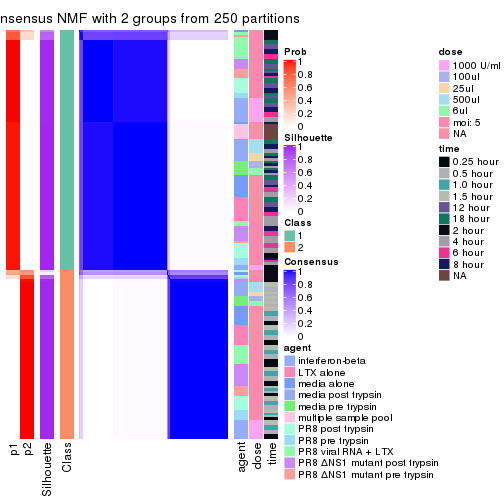
consensus_heatmap(res, k = 3)
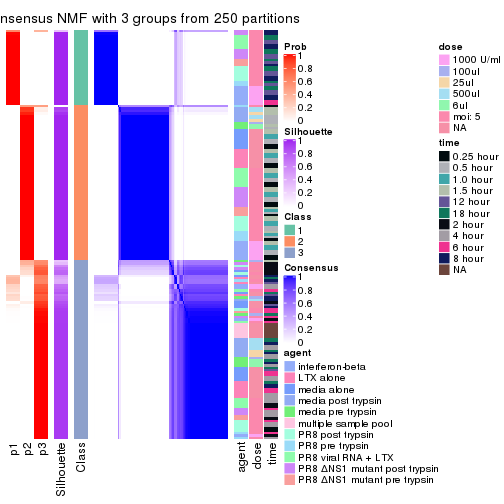
consensus_heatmap(res, k = 4)
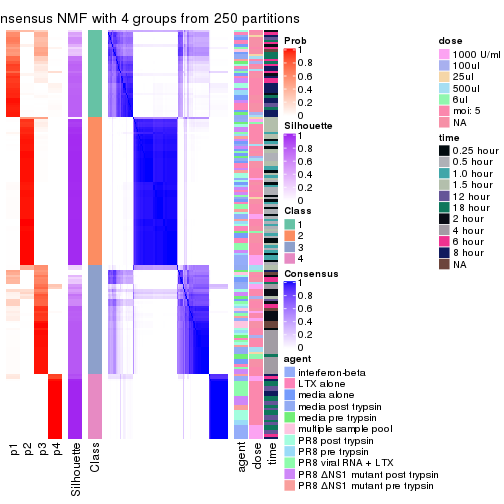
consensus_heatmap(res, k = 5)
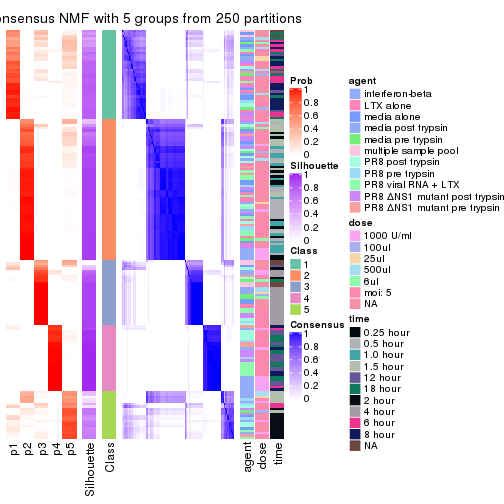
consensus_heatmap(res, k = 6)
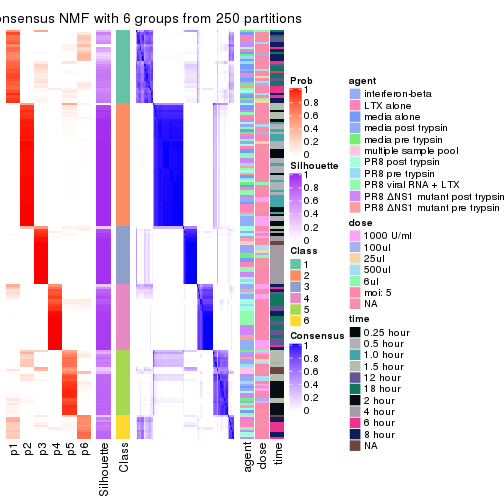
Heatmaps for the membership of samples in all partitions to see how consistent they are:
membership_heatmap(res, k = 2)
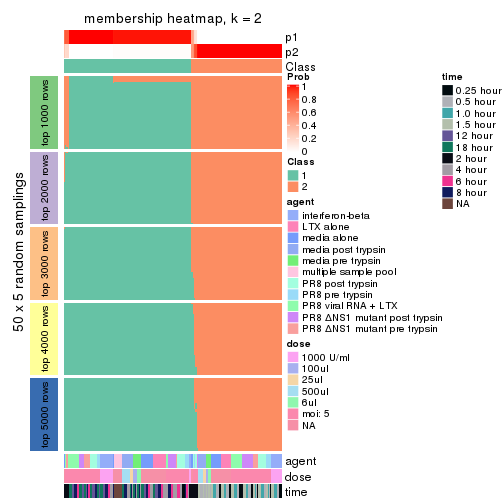
membership_heatmap(res, k = 3)
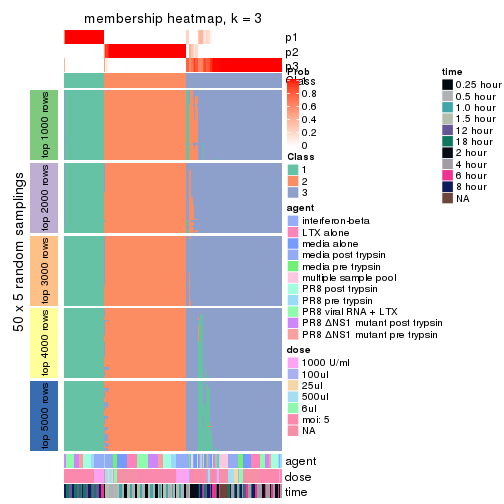
membership_heatmap(res, k = 4)
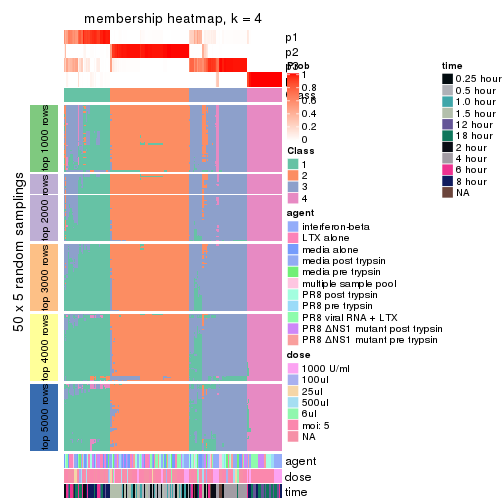
membership_heatmap(res, k = 5)
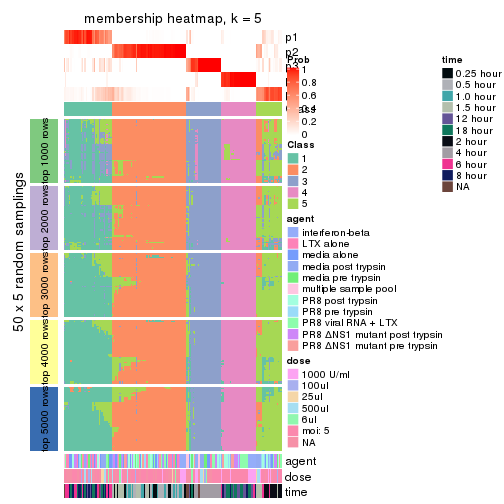
membership_heatmap(res, k = 6)
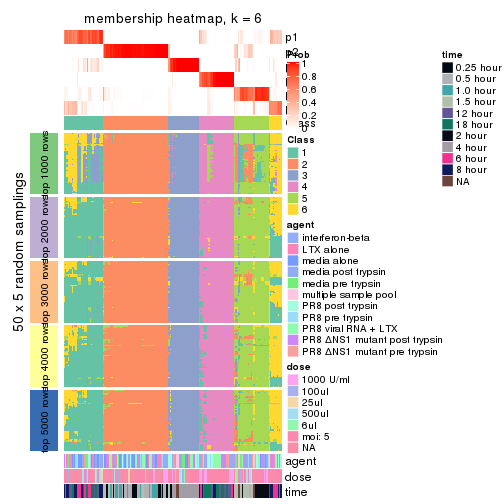
As soon as we have had the classes for columns, we can look for signatures which are significantly different between classes which can be candidate marks for certain classes. Following are the heatmaps for signatures.
Signature heatmaps where rows are scaled:
get_signatures(res, k = 2)
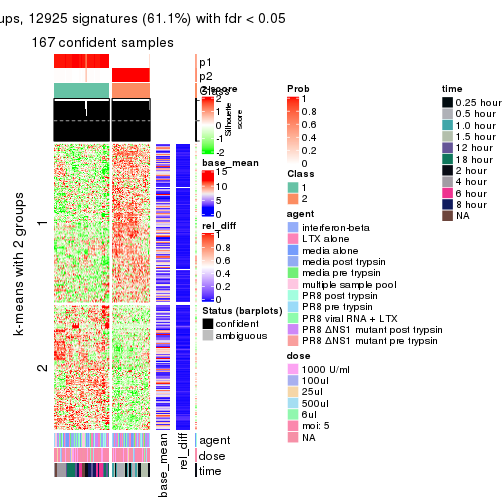
get_signatures(res, k = 3)
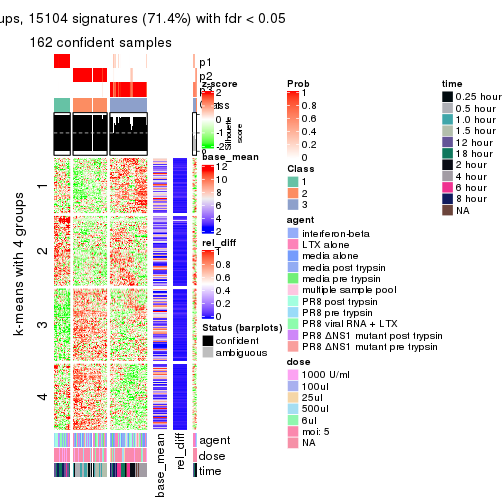
get_signatures(res, k = 4)
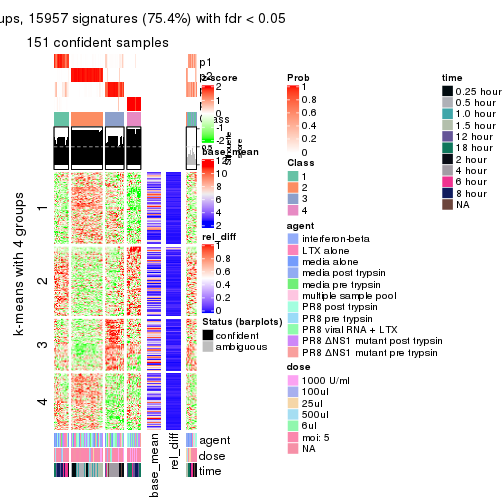
get_signatures(res, k = 5)
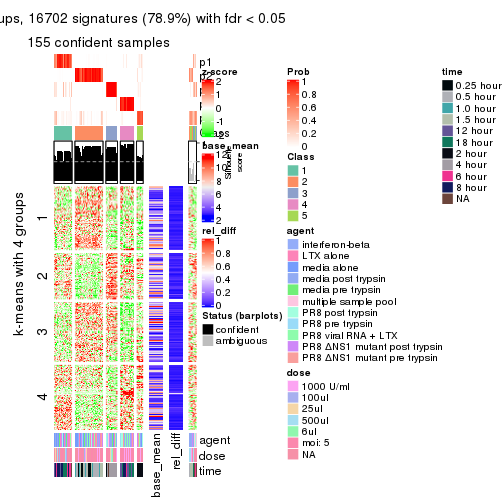
get_signatures(res, k = 6)
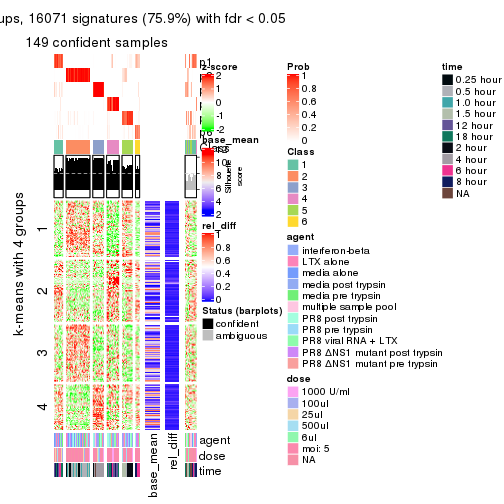
Signature heatmaps where rows are not scaled:
get_signatures(res, k = 2, scale_rows = FALSE)
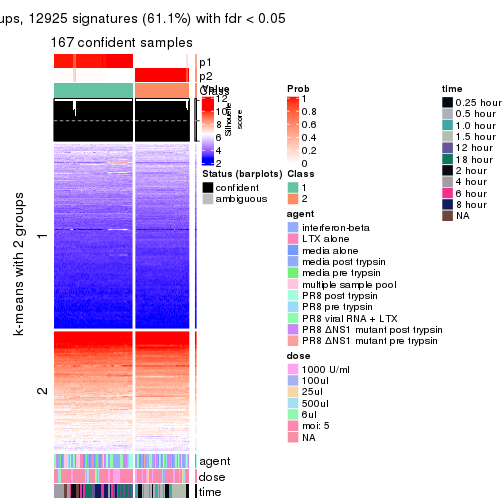
get_signatures(res, k = 3, scale_rows = FALSE)
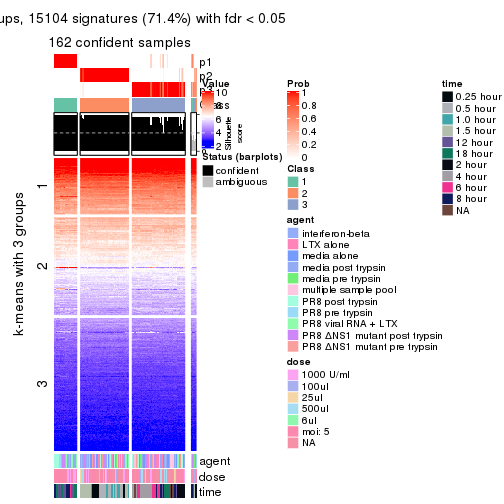
get_signatures(res, k = 4, scale_rows = FALSE)
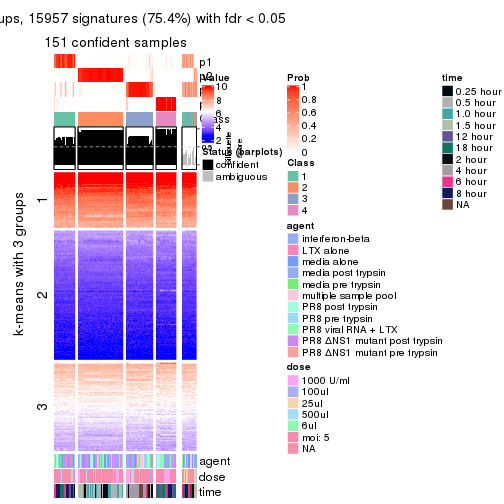
get_signatures(res, k = 5, scale_rows = FALSE)
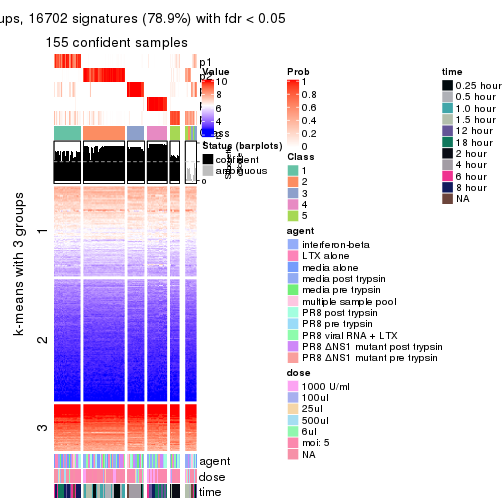
get_signatures(res, k = 6, scale_rows = FALSE)
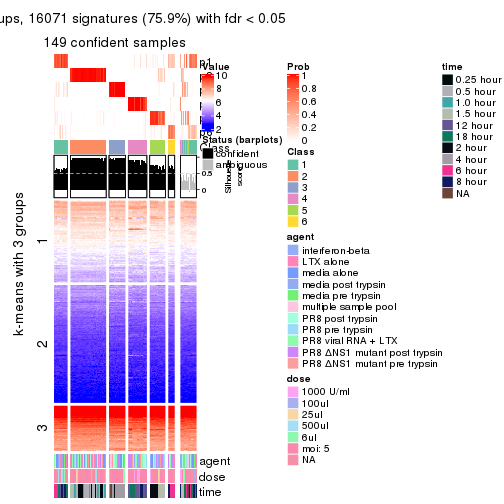
Compare the overlap of signatures from different k:
compare_signatures(res)
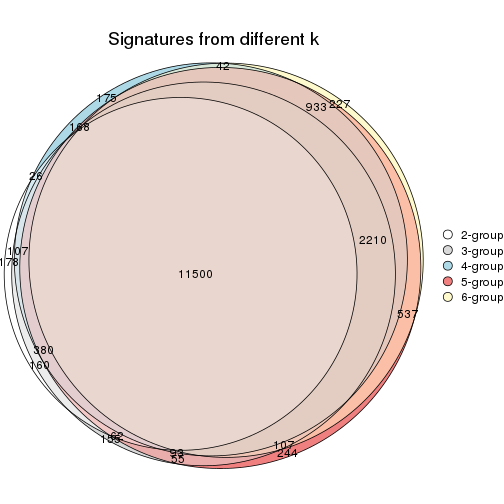
get_signature() returns a data frame invisibly. TO get the list of signatures, the function
call should be assigned to a variable explicitly. In following code, if plot argument is set
to FALSE, no heatmap is plotted while only the differential analysis is performed.
# code only for demonstration
tb = get_signature(res, k = ..., plot = FALSE)
An example of the output of tb is:
#> which_row fdr mean_1 mean_2 scaled_mean_1 scaled_mean_2 km
#> 1 38 0.042760348 8.373488 9.131774 -0.5533452 0.5164555 1
#> 2 40 0.018707592 7.106213 8.469186 -0.6173731 0.5762149 1
#> 3 55 0.019134737 10.221463 11.207825 -0.6159697 0.5749050 1
#> 4 59 0.006059896 5.921854 7.869574 -0.6899429 0.6439467 1
#> 5 60 0.018055526 8.928898 10.211722 -0.6204761 0.5791110 1
#> 6 98 0.009384629 15.714769 14.887706 0.6635654 -0.6193277 2
...
The columns in tb are:
which_row: row indices corresponding to the input matrix.fdr: FDR for the differential test. mean_x: The mean value in group x.scaled_mean_x: The mean value in group x after rows are scaled.km: Row groups if k-means clustering is applied to rows.UMAP plot which shows how samples are separated.
dimension_reduction(res, k = 2, method = "UMAP")
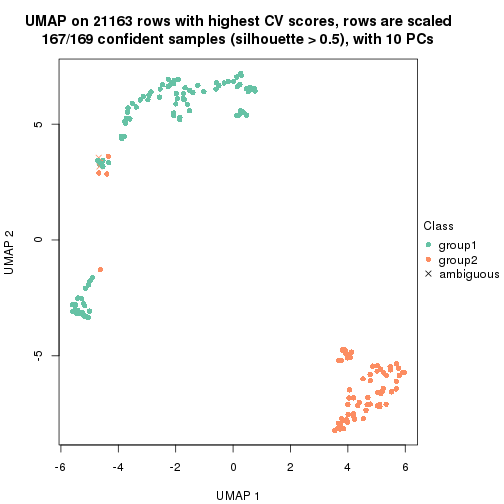
dimension_reduction(res, k = 3, method = "UMAP")
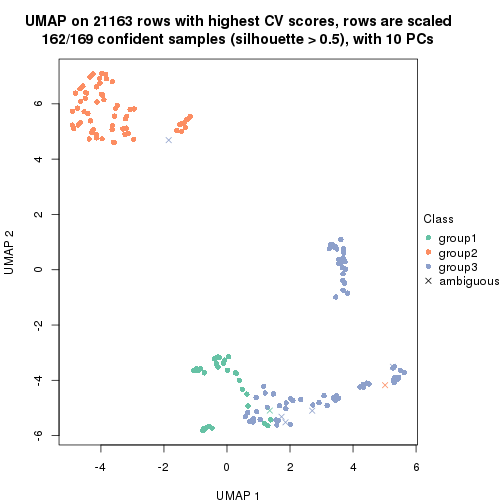
dimension_reduction(res, k = 4, method = "UMAP")
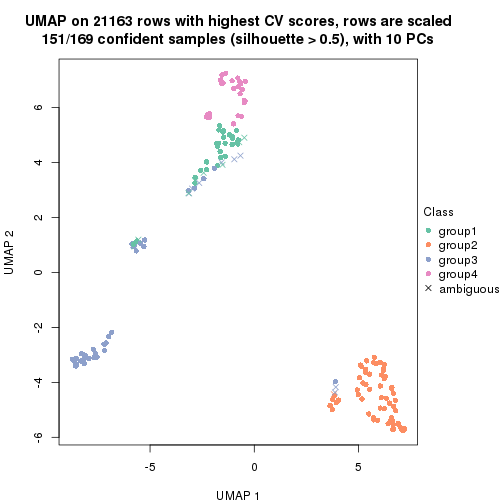
dimension_reduction(res, k = 5, method = "UMAP")
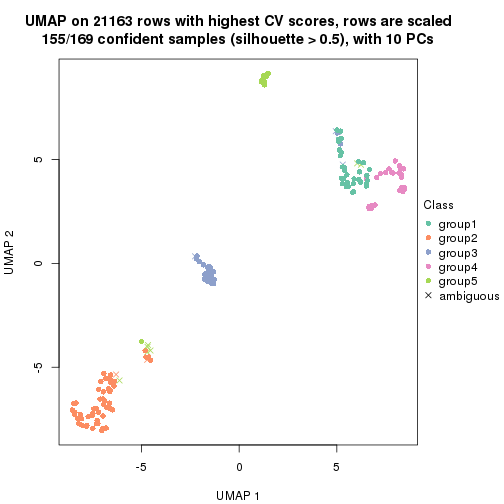
dimension_reduction(res, k = 6, method = "UMAP")
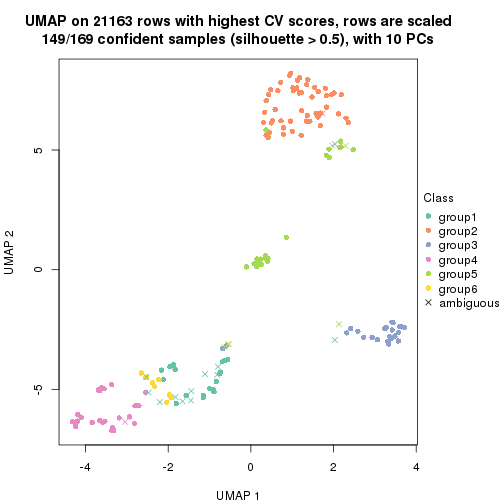
Following heatmap shows how subgroups are split when increasing k:
collect_classes(res)
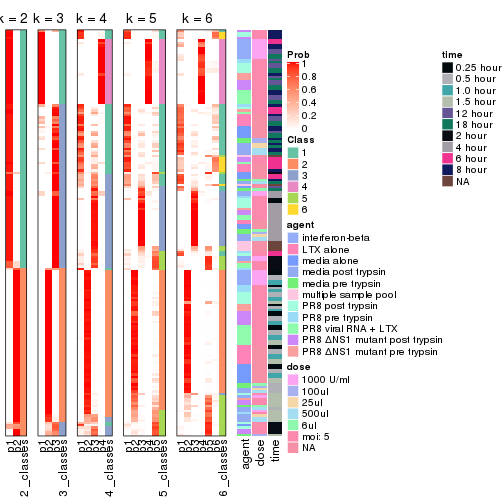
Test correlation between subgroups and known annotations. If the known annotation is numeric, one-way ANOVA test is applied, and if the known annotation is discrete, chi-squared contingency table test is applied.
test_to_known_factors(res)
#> n agent(p) dose(p) time(p) k
#> CV:NMF 167 0.85955 0.99881 3.81e-27 2
#> CV:NMF 162 0.00640 0.00114 4.41e-35 3
#> CV:NMF 151 0.01861 0.01267 8.31e-43 4
#> CV:NMF 155 0.09875 0.00526 1.15e-72 5
#> CV:NMF 149 0.00514 0.01197 5.89e-63 6
If matrix rows can be associated to genes, consider to use functional_enrichment(res,
...) to perform function enrichment for the signature genes. See this vignette for more detailed explanations.
The object with results only for a single top-value method and a single partition method can be extracted as:
res = res_list["MAD", "hclust"]
# you can also extract it by
# res = res_list["MAD:hclust"]
A summary of res and all the functions that can be applied to it:
res
#> A 'ConsensusPartition' object with k = 2, 3, 4, 5, 6.
#> On a matrix with 21163 rows and 169 columns.
#> Top rows (1000, 2000, 3000, 4000, 5000) are extracted by 'MAD' method.
#> Subgroups are detected by 'hclust' method.
#> Performed in total 1250 partitions by row resampling.
#> Best k for subgroups seems to be 3.
#>
#> Following methods can be applied to this 'ConsensusPartition' object:
#> [1] "cola_report" "collect_classes" "collect_plots"
#> [4] "collect_stats" "colnames" "compare_signatures"
#> [7] "consensus_heatmap" "dimension_reduction" "functional_enrichment"
#> [10] "get_anno_col" "get_anno" "get_classes"
#> [13] "get_consensus" "get_matrix" "get_membership"
#> [16] "get_param" "get_signatures" "get_stats"
#> [19] "is_best_k" "is_stable_k" "membership_heatmap"
#> [22] "ncol" "nrow" "plot_ecdf"
#> [25] "rownames" "select_partition_number" "show"
#> [28] "suggest_best_k" "test_to_known_factors"
collect_plots() function collects all the plots made from res for all k (number of partitions)
into one single page to provide an easy and fast comparison between different k.
collect_plots(res)
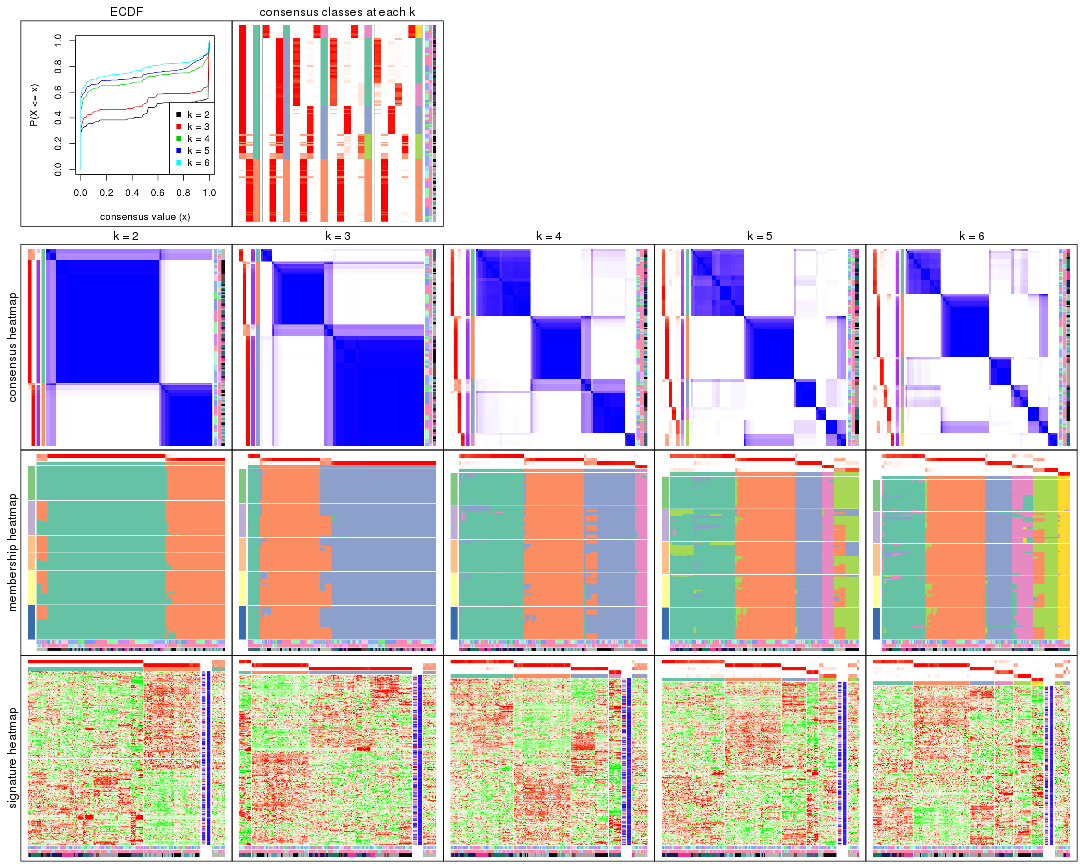
The plots are:
k and the heatmap of
predicted classes for each k.k.k.k.All the plots in panels can be made by individual functions and they are plotted later in this section.
select_partition_number() produces several plots showing different
statistics for choosing “optimized” k. There are following statistics:
k;k, the area increased is defined as \(A_k - A_{k-1}\).The detailed explanations of these statistics can be found in the cola vignette.
Generally speaking, lower PAC score, higher mean silhouette score or higher
concordance corresponds to better partition. Rand index and Jaccard index
measure how similar the current partition is compared to partition with k-1.
If they are too similar, we won't accept k is better than k-1.
select_partition_number(res)
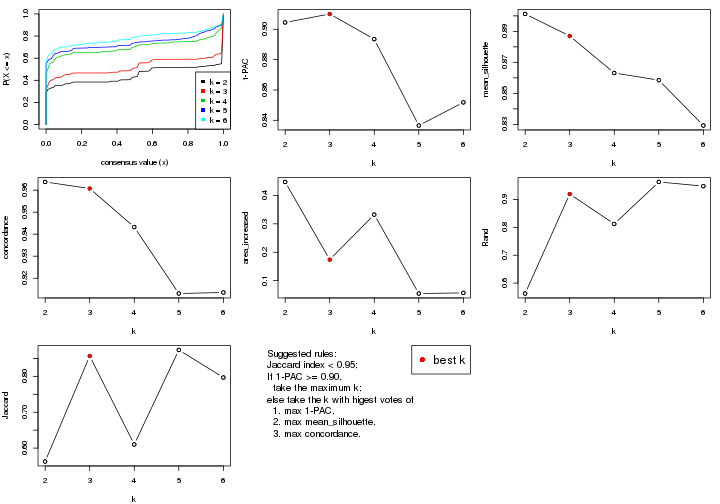
The numeric values for all these statistics can be obtained by get_stats().
get_stats(res)
#> k 1-PAC mean_silhouette concordance area_increased Rand Jaccard
#> 2 2 0.905 0.901 0.964 0.4475 0.563 0.563
#> 3 3 0.910 0.887 0.961 0.1740 0.919 0.857
#> 4 4 0.893 0.863 0.943 0.3326 0.812 0.610
#> 5 5 0.837 0.859 0.913 0.0546 0.963 0.874
#> 6 6 0.852 0.829 0.914 0.0568 0.948 0.797
suggest_best_k() suggests the best \(k\) based on these statistics. The rules are as follows:
suggest_best_k(res)
#> [1] 3
#> attr(,"optional")
#> [1] 2
There is also optional best \(k\) = 2 that is worth to check.
Following shows the table of the partitions (You need to click the show/hide
code output link to see it). The membership matrix (columns with name p*)
is inferred by
clue::cl_consensus()
function with the SE method. Basically the value in the membership matrix
represents the probability to belong to a certain group. The finall class
label for an item is determined with the group with highest probability it
belongs to.
In get_classes() function, the entropy is calculated from the membership
matrix and the silhouette score is calculated from the consensus matrix.
cbind(get_classes(res, k = 2), get_membership(res, k = 2))
#> class entropy silhouette p1 p2
#> GSM528681 2 0.0000 0.96898 0.000 1.000
#> GSM528682 2 0.0000 0.96898 0.000 1.000
#> GSM528683 2 0.0000 0.96898 0.000 1.000
#> GSM528684 2 0.0000 0.96898 0.000 1.000
#> GSM528687 2 0.0000 0.96898 0.000 1.000
#> GSM528688 2 0.0000 0.96898 0.000 1.000
#> GSM528685 1 0.9993 0.07663 0.516 0.484
#> GSM528686 1 0.9993 0.07663 0.516 0.484
#> GSM528693 1 0.0376 0.95407 0.996 0.004
#> GSM528694 1 0.0376 0.95407 0.996 0.004
#> GSM528695 1 0.0000 0.95696 1.000 0.000
#> GSM528696 1 0.0000 0.95696 1.000 0.000
#> GSM528697 1 0.0000 0.95696 1.000 0.000
#> GSM528698 1 0.0000 0.95696 1.000 0.000
#> GSM528699 1 0.0000 0.95696 1.000 0.000
#> GSM528700 1 0.0000 0.95696 1.000 0.000
#> GSM528689 1 0.0000 0.95696 1.000 0.000
#> GSM528690 1 0.0000 0.95696 1.000 0.000
#> GSM528691 1 0.0000 0.95696 1.000 0.000
#> GSM528692 1 0.0000 0.95696 1.000 0.000
#> GSM528779 2 0.1633 0.95168 0.024 0.976
#> GSM528780 2 0.0000 0.96898 0.000 1.000
#> GSM528782 2 0.0000 0.96898 0.000 1.000
#> GSM528781 2 0.5842 0.83252 0.140 0.860
#> GSM528785 1 0.0376 0.95407 0.996 0.004
#> GSM528786 1 0.0000 0.95696 1.000 0.000
#> GSM528787 1 0.0000 0.95696 1.000 0.000
#> GSM528788 1 0.0000 0.95696 1.000 0.000
#> GSM528783 1 0.0000 0.95696 1.000 0.000
#> GSM528784 1 0.0000 0.95696 1.000 0.000
#> GSM528759 1 0.0000 0.95696 1.000 0.000
#> GSM528760 1 0.0000 0.95696 1.000 0.000
#> GSM528761 2 0.0000 0.96898 0.000 1.000
#> GSM528762 2 0.0000 0.96898 0.000 1.000
#> GSM528765 2 0.0000 0.96898 0.000 1.000
#> GSM528766 2 0.0000 0.96898 0.000 1.000
#> GSM528763 2 0.9427 0.41059 0.360 0.640
#> GSM528764 2 0.9998 -0.00906 0.492 0.508
#> GSM528771 1 0.0376 0.95407 0.996 0.004
#> GSM528772 1 0.0376 0.95407 0.996 0.004
#> GSM528773 1 0.0000 0.95696 1.000 0.000
#> GSM528774 1 0.0000 0.95696 1.000 0.000
#> GSM528775 1 0.0000 0.95696 1.000 0.000
#> GSM528776 1 0.0000 0.95696 1.000 0.000
#> GSM528777 1 0.0000 0.95696 1.000 0.000
#> GSM528778 1 0.0000 0.95696 1.000 0.000
#> GSM528767 1 0.0000 0.95696 1.000 0.000
#> GSM528768 1 0.0000 0.95696 1.000 0.000
#> GSM528769 1 0.0000 0.95696 1.000 0.000
#> GSM528770 1 0.0000 0.95696 1.000 0.000
#> GSM528671 2 0.2778 0.93231 0.048 0.952
#> GSM528672 2 0.0000 0.96898 0.000 1.000
#> GSM528674 2 0.0000 0.96898 0.000 1.000
#> GSM528673 1 0.9993 0.07663 0.516 0.484
#> GSM528677 1 0.0376 0.95407 0.996 0.004
#> GSM528678 1 0.0000 0.95696 1.000 0.000
#> GSM528679 1 0.0000 0.95696 1.000 0.000
#> GSM528680 1 0.0000 0.95696 1.000 0.000
#> GSM528675 1 0.0000 0.95696 1.000 0.000
#> GSM528676 1 0.0000 0.95696 1.000 0.000
#> GSM528651 2 0.2778 0.93231 0.048 0.952
#> GSM528652 2 0.2778 0.93231 0.048 0.952
#> GSM528653 2 0.0000 0.96898 0.000 1.000
#> GSM528654 2 0.0000 0.96898 0.000 1.000
#> GSM528657 2 0.0000 0.96898 0.000 1.000
#> GSM528658 2 0.0000 0.96898 0.000 1.000
#> GSM528655 1 0.9993 0.07663 0.516 0.484
#> GSM528656 1 0.9993 0.07663 0.516 0.484
#> GSM528663 1 0.0376 0.95407 0.996 0.004
#> GSM528664 1 0.0376 0.95407 0.996 0.004
#> GSM528665 1 0.0000 0.95696 1.000 0.000
#> GSM528666 1 0.0000 0.95696 1.000 0.000
#> GSM528667 1 0.0000 0.95696 1.000 0.000
#> GSM528668 1 0.0000 0.95696 1.000 0.000
#> GSM528669 1 0.0000 0.95696 1.000 0.000
#> GSM528670 1 0.0000 0.95696 1.000 0.000
#> GSM528659 1 0.0000 0.95696 1.000 0.000
#> GSM528660 1 0.0000 0.95696 1.000 0.000
#> GSM528661 1 0.0000 0.95696 1.000 0.000
#> GSM528662 1 0.0000 0.95696 1.000 0.000
#> GSM528701 2 0.0000 0.96898 0.000 1.000
#> GSM528702 2 0.0000 0.96898 0.000 1.000
#> GSM528703 2 0.0000 0.96898 0.000 1.000
#> GSM528704 2 0.0000 0.96898 0.000 1.000
#> GSM528707 2 0.0000 0.96898 0.000 1.000
#> GSM528708 2 0.0000 0.96898 0.000 1.000
#> GSM528705 2 0.0000 0.96898 0.000 1.000
#> GSM528706 2 0.0000 0.96898 0.000 1.000
#> GSM528713 1 0.0376 0.95407 0.996 0.004
#> GSM528714 1 0.0376 0.95407 0.996 0.004
#> GSM528715 1 0.0000 0.95696 1.000 0.000
#> GSM528716 1 0.0000 0.95696 1.000 0.000
#> GSM528717 1 0.0000 0.95696 1.000 0.000
#> GSM528718 1 0.0000 0.95696 1.000 0.000
#> GSM528719 1 0.0000 0.95696 1.000 0.000
#> GSM528720 1 0.0000 0.95696 1.000 0.000
#> GSM528709 1 0.0000 0.95696 1.000 0.000
#> GSM528710 1 0.0000 0.95696 1.000 0.000
#> GSM528711 1 0.0000 0.95696 1.000 0.000
#> GSM528712 1 0.0000 0.95696 1.000 0.000
#> GSM528721 2 0.0000 0.96898 0.000 1.000
#> GSM528722 2 0.0000 0.96898 0.000 1.000
#> GSM528723 2 0.0000 0.96898 0.000 1.000
#> GSM528724 2 0.0000 0.96898 0.000 1.000
#> GSM528727 2 0.0000 0.96898 0.000 1.000
#> GSM528728 2 0.0000 0.96898 0.000 1.000
#> GSM528725 2 0.0000 0.96898 0.000 1.000
#> GSM528726 2 0.0000 0.96898 0.000 1.000
#> GSM528733 1 0.0000 0.95696 1.000 0.000
#> GSM528734 1 0.0000 0.95696 1.000 0.000
#> GSM528735 1 0.0000 0.95696 1.000 0.000
#> GSM528736 1 0.0000 0.95696 1.000 0.000
#> GSM528737 1 0.0000 0.95696 1.000 0.000
#> GSM528738 1 0.0000 0.95696 1.000 0.000
#> GSM528729 1 0.0000 0.95696 1.000 0.000
#> GSM528730 1 0.0000 0.95696 1.000 0.000
#> GSM528731 1 0.0000 0.95696 1.000 0.000
#> GSM528732 1 0.0000 0.95696 1.000 0.000
#> GSM528739 2 0.0000 0.96898 0.000 1.000
#> GSM528740 2 0.0000 0.96898 0.000 1.000
#> GSM528741 2 0.0000 0.96898 0.000 1.000
#> GSM528742 2 0.0000 0.96898 0.000 1.000
#> GSM528745 2 0.4690 0.87991 0.100 0.900
#> GSM528746 2 0.0000 0.96898 0.000 1.000
#> GSM528743 2 0.4939 0.87127 0.108 0.892
#> GSM528744 2 0.1414 0.95487 0.020 0.980
#> GSM528751 1 0.0376 0.95407 0.996 0.004
#> GSM528752 1 0.0376 0.95407 0.996 0.004
#> GSM528753 1 0.0000 0.95696 1.000 0.000
#> GSM528754 1 0.0000 0.95696 1.000 0.000
#> GSM528755 1 0.0000 0.95696 1.000 0.000
#> GSM528756 1 0.0000 0.95696 1.000 0.000
#> GSM528757 1 0.0000 0.95696 1.000 0.000
#> GSM528758 1 0.0000 0.95696 1.000 0.000
#> GSM528747 1 0.0000 0.95696 1.000 0.000
#> GSM528748 1 0.0000 0.95696 1.000 0.000
#> GSM528749 1 0.0000 0.95696 1.000 0.000
#> GSM528750 1 0.0000 0.95696 1.000 0.000
#> GSM528640 2 0.0000 0.96898 0.000 1.000
#> GSM528641 1 0.9993 0.07663 0.516 0.484
#> GSM528643 1 0.0000 0.95696 1.000 0.000
#> GSM528644 1 0.0000 0.95696 1.000 0.000
#> GSM528642 1 0.0000 0.95696 1.000 0.000
#> GSM528620 2 0.0000 0.96898 0.000 1.000
#> GSM528621 1 0.9754 0.31151 0.592 0.408
#> GSM528623 1 0.0000 0.95696 1.000 0.000
#> GSM528624 1 0.0000 0.95696 1.000 0.000
#> GSM528622 1 0.0000 0.95696 1.000 0.000
#> GSM528625 2 0.0000 0.96898 0.000 1.000
#> GSM528626 1 0.9795 0.28960 0.584 0.416
#> GSM528628 1 0.0000 0.95696 1.000 0.000
#> GSM528629 1 0.0000 0.95696 1.000 0.000
#> GSM528627 1 0.0000 0.95696 1.000 0.000
#> GSM528630 2 0.0000 0.96898 0.000 1.000
#> GSM528631 2 0.6048 0.82204 0.148 0.852
#> GSM528632 1 0.9754 0.31151 0.592 0.408
#> GSM528633 1 0.9754 0.31151 0.592 0.408
#> GSM528636 1 0.0000 0.95696 1.000 0.000
#> GSM528637 1 0.0000 0.95696 1.000 0.000
#> GSM528638 1 0.0000 0.95696 1.000 0.000
#> GSM528639 1 0.0000 0.95696 1.000 0.000
#> GSM528634 1 0.0000 0.95696 1.000 0.000
#> GSM528635 1 0.0000 0.95696 1.000 0.000
#> GSM528645 1 0.0000 0.95696 1.000 0.000
#> GSM528646 1 0.0000 0.95696 1.000 0.000
#> GSM528647 1 0.0000 0.95696 1.000 0.000
#> GSM528648 1 0.0000 0.95696 1.000 0.000
#> GSM528649 1 0.0000 0.95696 1.000 0.000
#> GSM528650 1 0.0000 0.95696 1.000 0.000
cbind(get_classes(res, k = 3), get_membership(res, k = 3))
#> class entropy silhouette p1 p2 p3
#> GSM528681 2 0.0000 0.9552 0.000 1.000 0.000
#> GSM528682 2 0.0000 0.9552 0.000 1.000 0.000
#> GSM528683 2 0.0000 0.9552 0.000 1.000 0.000
#> GSM528684 2 0.0000 0.9552 0.000 1.000 0.000
#> GSM528687 2 0.0000 0.9552 0.000 1.000 0.000
#> GSM528688 2 0.0000 0.9552 0.000 1.000 0.000
#> GSM528685 3 0.6305 0.0876 0.000 0.484 0.516
#> GSM528686 3 0.6305 0.0876 0.000 0.484 0.516
#> GSM528693 3 0.0237 0.9401 0.000 0.004 0.996
#> GSM528694 3 0.0237 0.9401 0.000 0.004 0.996
#> GSM528695 3 0.0000 0.9425 0.000 0.000 1.000
#> GSM528696 3 0.0000 0.9425 0.000 0.000 1.000
#> GSM528697 3 0.0424 0.9376 0.008 0.000 0.992
#> GSM528698 3 0.0424 0.9376 0.008 0.000 0.992
#> GSM528699 3 0.0424 0.9376 0.008 0.000 0.992
#> GSM528700 3 0.0424 0.9376 0.008 0.000 0.992
#> GSM528689 3 0.0424 0.9376 0.008 0.000 0.992
#> GSM528690 3 0.1964 0.8948 0.056 0.000 0.944
#> GSM528691 3 0.0237 0.9403 0.004 0.000 0.996
#> GSM528692 3 0.0237 0.9403 0.004 0.000 0.996
#> GSM528779 2 0.1031 0.9309 0.000 0.976 0.024
#> GSM528780 2 0.0000 0.9552 0.000 1.000 0.000
#> GSM528782 2 0.0000 0.9552 0.000 1.000 0.000
#> GSM528781 2 0.3686 0.7760 0.000 0.860 0.140
#> GSM528785 3 0.0237 0.9401 0.000 0.004 0.996
#> GSM528786 3 0.0000 0.9425 0.000 0.000 1.000
#> GSM528787 3 0.0000 0.9425 0.000 0.000 1.000
#> GSM528788 3 0.0000 0.9425 0.000 0.000 1.000
#> GSM528783 3 0.0000 0.9425 0.000 0.000 1.000
#> GSM528784 1 0.0747 0.9719 0.984 0.000 0.016
#> GSM528759 3 0.0000 0.9425 0.000 0.000 1.000
#> GSM528760 3 0.0000 0.9425 0.000 0.000 1.000
#> GSM528761 2 0.0000 0.9552 0.000 1.000 0.000
#> GSM528762 2 0.0000 0.9552 0.000 1.000 0.000
#> GSM528765 2 0.0000 0.9552 0.000 1.000 0.000
#> GSM528766 2 0.0000 0.9552 0.000 1.000 0.000
#> GSM528763 2 0.5948 0.3924 0.000 0.640 0.360
#> GSM528764 2 0.6308 -0.0214 0.000 0.508 0.492
#> GSM528771 3 0.0237 0.9401 0.000 0.004 0.996
#> GSM528772 3 0.0237 0.9401 0.000 0.004 0.996
#> GSM528773 3 0.0000 0.9425 0.000 0.000 1.000
#> GSM528774 3 0.0000 0.9425 0.000 0.000 1.000
#> GSM528775 3 0.0000 0.9425 0.000 0.000 1.000
#> GSM528776 3 0.0000 0.9425 0.000 0.000 1.000
#> GSM528777 3 0.0000 0.9425 0.000 0.000 1.000
#> GSM528778 3 0.0000 0.9425 0.000 0.000 1.000
#> GSM528767 1 0.0747 0.9719 0.984 0.000 0.016
#> GSM528768 1 0.0747 0.9719 0.984 0.000 0.016
#> GSM528769 1 0.0747 0.9719 0.984 0.000 0.016
#> GSM528770 1 0.0747 0.9719 0.984 0.000 0.016
#> GSM528671 2 0.1753 0.9042 0.000 0.952 0.048
#> GSM528672 2 0.0000 0.9552 0.000 1.000 0.000
#> GSM528674 2 0.0000 0.9552 0.000 1.000 0.000
#> GSM528673 3 0.6305 0.0876 0.000 0.484 0.516
#> GSM528677 3 0.0237 0.9401 0.000 0.004 0.996
#> GSM528678 3 0.0000 0.9425 0.000 0.000 1.000
#> GSM528679 3 0.0000 0.9425 0.000 0.000 1.000
#> GSM528680 3 0.0424 0.9376 0.008 0.000 0.992
#> GSM528675 1 0.0000 0.9663 1.000 0.000 0.000
#> GSM528676 1 0.0000 0.9663 1.000 0.000 0.000
#> GSM528651 2 0.1753 0.9042 0.000 0.952 0.048
#> GSM528652 2 0.1753 0.9042 0.000 0.952 0.048
#> GSM528653 2 0.0000 0.9552 0.000 1.000 0.000
#> GSM528654 2 0.0000 0.9552 0.000 1.000 0.000
#> GSM528657 2 0.0000 0.9552 0.000 1.000 0.000
#> GSM528658 2 0.0000 0.9552 0.000 1.000 0.000
#> GSM528655 3 0.6305 0.0876 0.000 0.484 0.516
#> GSM528656 3 0.6305 0.0876 0.000 0.484 0.516
#> GSM528663 3 0.0237 0.9401 0.000 0.004 0.996
#> GSM528664 3 0.0237 0.9401 0.000 0.004 0.996
#> GSM528665 3 0.0000 0.9425 0.000 0.000 1.000
#> GSM528666 3 0.0000 0.9425 0.000 0.000 1.000
#> GSM528667 3 0.0000 0.9425 0.000 0.000 1.000
#> GSM528668 3 0.0000 0.9425 0.000 0.000 1.000
#> GSM528669 3 0.0000 0.9425 0.000 0.000 1.000
#> GSM528670 3 0.0000 0.9425 0.000 0.000 1.000
#> GSM528659 1 0.2711 0.9040 0.912 0.000 0.088
#> GSM528660 1 0.2711 0.9040 0.912 0.000 0.088
#> GSM528661 1 0.0000 0.9663 1.000 0.000 0.000
#> GSM528662 1 0.0000 0.9663 1.000 0.000 0.000
#> GSM528701 2 0.0000 0.9552 0.000 1.000 0.000
#> GSM528702 2 0.0000 0.9552 0.000 1.000 0.000
#> GSM528703 2 0.0000 0.9552 0.000 1.000 0.000
#> GSM528704 2 0.0000 0.9552 0.000 1.000 0.000
#> GSM528707 2 0.0000 0.9552 0.000 1.000 0.000
#> GSM528708 2 0.0000 0.9552 0.000 1.000 0.000
#> GSM528705 2 0.0000 0.9552 0.000 1.000 0.000
#> GSM528706 2 0.0000 0.9552 0.000 1.000 0.000
#> GSM528713 3 0.0237 0.9401 0.000 0.004 0.996
#> GSM528714 3 0.0237 0.9401 0.000 0.004 0.996
#> GSM528715 3 0.0000 0.9425 0.000 0.000 1.000
#> GSM528716 3 0.0000 0.9425 0.000 0.000 1.000
#> GSM528717 3 0.0000 0.9425 0.000 0.000 1.000
#> GSM528718 3 0.0000 0.9425 0.000 0.000 1.000
#> GSM528719 3 0.0424 0.9376 0.008 0.000 0.992
#> GSM528720 3 0.0424 0.9376 0.008 0.000 0.992
#> GSM528709 3 0.1964 0.8948 0.056 0.000 0.944
#> GSM528710 3 0.1964 0.8948 0.056 0.000 0.944
#> GSM528711 3 0.0237 0.9403 0.004 0.000 0.996
#> GSM528712 3 0.0237 0.9403 0.004 0.000 0.996
#> GSM528721 2 0.0000 0.9552 0.000 1.000 0.000
#> GSM528722 2 0.0000 0.9552 0.000 1.000 0.000
#> GSM528723 2 0.0000 0.9552 0.000 1.000 0.000
#> GSM528724 2 0.0000 0.9552 0.000 1.000 0.000
#> GSM528727 2 0.0000 0.9552 0.000 1.000 0.000
#> GSM528728 2 0.0000 0.9552 0.000 1.000 0.000
#> GSM528725 2 0.0000 0.9552 0.000 1.000 0.000
#> GSM528726 2 0.0000 0.9552 0.000 1.000 0.000
#> GSM528733 3 0.0000 0.9425 0.000 0.000 1.000
#> GSM528734 3 0.0000 0.9425 0.000 0.000 1.000
#> GSM528735 3 0.0000 0.9425 0.000 0.000 1.000
#> GSM528736 3 0.0000 0.9425 0.000 0.000 1.000
#> GSM528737 3 0.0000 0.9425 0.000 0.000 1.000
#> GSM528738 3 0.0000 0.9425 0.000 0.000 1.000
#> GSM528729 3 0.0000 0.9425 0.000 0.000 1.000
#> GSM528730 3 0.0000 0.9425 0.000 0.000 1.000
#> GSM528731 3 0.0000 0.9425 0.000 0.000 1.000
#> GSM528732 3 0.0000 0.9425 0.000 0.000 1.000
#> GSM528739 2 0.0000 0.9552 0.000 1.000 0.000
#> GSM528740 2 0.0000 0.9552 0.000 1.000 0.000
#> GSM528741 2 0.0000 0.9552 0.000 1.000 0.000
#> GSM528742 2 0.0000 0.9552 0.000 1.000 0.000
#> GSM528745 2 0.2959 0.8350 0.000 0.900 0.100
#> GSM528746 2 0.0000 0.9552 0.000 1.000 0.000
#> GSM528743 2 0.3116 0.8240 0.000 0.892 0.108
#> GSM528744 2 0.0892 0.9352 0.000 0.980 0.020
#> GSM528751 3 0.0237 0.9401 0.000 0.004 0.996
#> GSM528752 3 0.0237 0.9401 0.000 0.004 0.996
#> GSM528753 3 0.0000 0.9425 0.000 0.000 1.000
#> GSM528754 3 0.0000 0.9425 0.000 0.000 1.000
#> GSM528755 3 0.0000 0.9425 0.000 0.000 1.000
#> GSM528756 3 0.0000 0.9425 0.000 0.000 1.000
#> GSM528757 3 0.0000 0.9425 0.000 0.000 1.000
#> GSM528758 3 0.0000 0.9425 0.000 0.000 1.000
#> GSM528747 3 0.0000 0.9425 0.000 0.000 1.000
#> GSM528748 3 0.0000 0.9425 0.000 0.000 1.000
#> GSM528749 3 0.0000 0.9425 0.000 0.000 1.000
#> GSM528750 3 0.0000 0.9425 0.000 0.000 1.000
#> GSM528640 2 0.0000 0.9552 0.000 1.000 0.000
#> GSM528641 3 0.6305 0.0876 0.000 0.484 0.516
#> GSM528643 3 0.0000 0.9425 0.000 0.000 1.000
#> GSM528644 3 0.0000 0.9425 0.000 0.000 1.000
#> GSM528642 3 0.0000 0.9425 0.000 0.000 1.000
#> GSM528620 2 0.0000 0.9552 0.000 1.000 0.000
#> GSM528621 3 0.6154 0.3177 0.000 0.408 0.592
#> GSM528623 3 0.0000 0.9425 0.000 0.000 1.000
#> GSM528624 3 0.0000 0.9425 0.000 0.000 1.000
#> GSM528622 3 0.0000 0.9425 0.000 0.000 1.000
#> GSM528625 2 0.0000 0.9552 0.000 1.000 0.000
#> GSM528626 3 0.6180 0.2972 0.000 0.416 0.584
#> GSM528628 3 0.0000 0.9425 0.000 0.000 1.000
#> GSM528629 3 0.0000 0.9425 0.000 0.000 1.000
#> GSM528627 3 0.0000 0.9425 0.000 0.000 1.000
#> GSM528630 2 0.0000 0.9552 0.000 1.000 0.000
#> GSM528631 2 0.3816 0.7635 0.000 0.852 0.148
#> GSM528632 3 0.6154 0.3177 0.000 0.408 0.592
#> GSM528633 3 0.6154 0.3177 0.000 0.408 0.592
#> GSM528636 3 0.0000 0.9425 0.000 0.000 1.000
#> GSM528637 3 0.0000 0.9425 0.000 0.000 1.000
#> GSM528638 3 0.0000 0.9425 0.000 0.000 1.000
#> GSM528639 3 0.0000 0.9425 0.000 0.000 1.000
#> GSM528634 3 0.0000 0.9425 0.000 0.000 1.000
#> GSM528635 3 0.0000 0.9425 0.000 0.000 1.000
#> GSM528645 3 0.0000 0.9425 0.000 0.000 1.000
#> GSM528646 3 0.0000 0.9425 0.000 0.000 1.000
#> GSM528647 3 0.0000 0.9425 0.000 0.000 1.000
#> GSM528648 3 0.0000 0.9425 0.000 0.000 1.000
#> GSM528649 3 0.0000 0.9425 0.000 0.000 1.000
#> GSM528650 3 0.0000 0.9425 0.000 0.000 1.000
cbind(get_classes(res, k = 4), get_membership(res, k = 4))
#> class entropy silhouette p1 p2 p3 p4
#> GSM528681 2 0.0000 0.965 0.000 1.000 0.000 0.000
#> GSM528682 2 0.0000 0.965 0.000 1.000 0.000 0.000
#> GSM528683 2 0.0000 0.965 0.000 1.000 0.000 0.000
#> GSM528684 2 0.0000 0.965 0.000 1.000 0.000 0.000
#> GSM528687 2 0.0000 0.965 0.000 1.000 0.000 0.000
#> GSM528688 2 0.0000 0.965 0.000 1.000 0.000 0.000
#> GSM528685 3 0.4994 0.187 0.000 0.480 0.520 0.000
#> GSM528686 3 0.4994 0.187 0.000 0.480 0.520 0.000
#> GSM528693 3 0.0000 0.832 0.000 0.000 1.000 0.000
#> GSM528694 3 0.0000 0.832 0.000 0.000 1.000 0.000
#> GSM528695 3 0.0469 0.833 0.012 0.000 0.988 0.000
#> GSM528696 3 0.0469 0.833 0.012 0.000 0.988 0.000
#> GSM528697 1 0.0336 0.949 0.992 0.000 0.000 0.008
#> GSM528698 1 0.0927 0.950 0.976 0.000 0.016 0.008
#> GSM528699 1 0.0336 0.949 0.992 0.000 0.000 0.008
#> GSM528700 1 0.0336 0.949 0.992 0.000 0.000 0.008
#> GSM528689 1 0.0336 0.949 0.992 0.000 0.000 0.008
#> GSM528690 1 0.1557 0.917 0.944 0.000 0.000 0.056
#> GSM528691 1 0.0188 0.950 0.996 0.000 0.000 0.004
#> GSM528692 1 0.0188 0.950 0.996 0.000 0.000 0.004
#> GSM528779 2 0.0817 0.945 0.000 0.976 0.024 0.000
#> GSM528780 2 0.0000 0.965 0.000 1.000 0.000 0.000
#> GSM528782 2 0.0000 0.965 0.000 1.000 0.000 0.000
#> GSM528781 2 0.2973 0.815 0.000 0.856 0.144 0.000
#> GSM528785 3 0.0000 0.832 0.000 0.000 1.000 0.000
#> GSM528786 3 0.0336 0.834 0.008 0.000 0.992 0.000
#> GSM528787 3 0.4454 0.451 0.308 0.000 0.692 0.000
#> GSM528788 1 0.0000 0.951 1.000 0.000 0.000 0.000
#> GSM528783 1 0.0000 0.951 1.000 0.000 0.000 0.000
#> GSM528784 4 0.0592 0.976 0.016 0.000 0.000 0.984
#> GSM528759 1 0.2868 0.863 0.864 0.000 0.136 0.000
#> GSM528760 1 0.2868 0.863 0.864 0.000 0.136 0.000
#> GSM528761 2 0.0000 0.965 0.000 1.000 0.000 0.000
#> GSM528762 2 0.0000 0.965 0.000 1.000 0.000 0.000
#> GSM528765 2 0.0000 0.965 0.000 1.000 0.000 0.000
#> GSM528766 2 0.0000 0.965 0.000 1.000 0.000 0.000
#> GSM528763 2 0.4730 0.323 0.000 0.636 0.364 0.000
#> GSM528764 2 0.5000 -0.136 0.000 0.504 0.496 0.000
#> GSM528771 3 0.0000 0.832 0.000 0.000 1.000 0.000
#> GSM528772 3 0.0000 0.832 0.000 0.000 1.000 0.000
#> GSM528773 3 0.0336 0.834 0.008 0.000 0.992 0.000
#> GSM528774 3 0.0336 0.834 0.008 0.000 0.992 0.000
#> GSM528775 3 0.4454 0.451 0.308 0.000 0.692 0.000
#> GSM528776 1 0.1118 0.946 0.964 0.000 0.036 0.000
#> GSM528777 1 0.0000 0.951 1.000 0.000 0.000 0.000
#> GSM528778 1 0.0000 0.951 1.000 0.000 0.000 0.000
#> GSM528767 4 0.0592 0.976 0.016 0.000 0.000 0.984
#> GSM528768 4 0.0592 0.976 0.016 0.000 0.000 0.984
#> GSM528769 4 0.0592 0.976 0.016 0.000 0.000 0.984
#> GSM528770 4 0.0592 0.976 0.016 0.000 0.000 0.984
#> GSM528671 2 0.1389 0.925 0.000 0.952 0.048 0.000
#> GSM528672 2 0.0000 0.965 0.000 1.000 0.000 0.000
#> GSM528674 2 0.0000 0.965 0.000 1.000 0.000 0.000
#> GSM528673 3 0.4994 0.187 0.000 0.480 0.520 0.000
#> GSM528677 3 0.0000 0.832 0.000 0.000 1.000 0.000
#> GSM528678 3 0.0336 0.834 0.008 0.000 0.992 0.000
#> GSM528679 1 0.1211 0.945 0.960 0.000 0.040 0.000
#> GSM528680 1 0.0336 0.949 0.992 0.000 0.000 0.008
#> GSM528675 4 0.0000 0.971 0.000 0.000 0.000 1.000
#> GSM528676 4 0.0000 0.971 0.000 0.000 0.000 1.000
#> GSM528651 2 0.1389 0.925 0.000 0.952 0.048 0.000
#> GSM528652 2 0.1389 0.925 0.000 0.952 0.048 0.000
#> GSM528653 2 0.0000 0.965 0.000 1.000 0.000 0.000
#> GSM528654 2 0.0000 0.965 0.000 1.000 0.000 0.000
#> GSM528657 2 0.0000 0.965 0.000 1.000 0.000 0.000
#> GSM528658 2 0.0000 0.965 0.000 1.000 0.000 0.000
#> GSM528655 3 0.4994 0.187 0.000 0.480 0.520 0.000
#> GSM528656 3 0.4994 0.187 0.000 0.480 0.520 0.000
#> GSM528663 3 0.0000 0.832 0.000 0.000 1.000 0.000
#> GSM528664 3 0.0000 0.832 0.000 0.000 1.000 0.000
#> GSM528665 3 0.0469 0.833 0.012 0.000 0.988 0.000
#> GSM528666 3 0.0469 0.833 0.012 0.000 0.988 0.000
#> GSM528667 1 0.1211 0.945 0.960 0.000 0.040 0.000
#> GSM528668 1 0.1211 0.945 0.960 0.000 0.040 0.000
#> GSM528669 1 0.0000 0.951 1.000 0.000 0.000 0.000
#> GSM528670 1 0.0000 0.951 1.000 0.000 0.000 0.000
#> GSM528659 4 0.2149 0.916 0.088 0.000 0.000 0.912
#> GSM528660 4 0.2149 0.916 0.088 0.000 0.000 0.912
#> GSM528661 4 0.0000 0.971 0.000 0.000 0.000 1.000
#> GSM528662 4 0.0000 0.971 0.000 0.000 0.000 1.000
#> GSM528701 2 0.0000 0.965 0.000 1.000 0.000 0.000
#> GSM528702 2 0.0000 0.965 0.000 1.000 0.000 0.000
#> GSM528703 2 0.0000 0.965 0.000 1.000 0.000 0.000
#> GSM528704 2 0.0000 0.965 0.000 1.000 0.000 0.000
#> GSM528707 2 0.0000 0.965 0.000 1.000 0.000 0.000
#> GSM528708 2 0.0000 0.965 0.000 1.000 0.000 0.000
#> GSM528705 2 0.0000 0.965 0.000 1.000 0.000 0.000
#> GSM528706 2 0.0000 0.965 0.000 1.000 0.000 0.000
#> GSM528713 3 0.0000 0.832 0.000 0.000 1.000 0.000
#> GSM528714 3 0.0000 0.832 0.000 0.000 1.000 0.000
#> GSM528715 3 0.0469 0.833 0.012 0.000 0.988 0.000
#> GSM528716 3 0.0469 0.833 0.012 0.000 0.988 0.000
#> GSM528717 1 0.1302 0.943 0.956 0.000 0.044 0.000
#> GSM528718 1 0.1302 0.943 0.956 0.000 0.044 0.000
#> GSM528719 1 0.0336 0.949 0.992 0.000 0.000 0.008
#> GSM528720 1 0.0336 0.949 0.992 0.000 0.000 0.008
#> GSM528709 1 0.1557 0.917 0.944 0.000 0.000 0.056
#> GSM528710 1 0.1557 0.917 0.944 0.000 0.000 0.056
#> GSM528711 1 0.0188 0.950 0.996 0.000 0.000 0.004
#> GSM528712 1 0.0188 0.950 0.996 0.000 0.000 0.004
#> GSM528721 2 0.0000 0.965 0.000 1.000 0.000 0.000
#> GSM528722 2 0.0000 0.965 0.000 1.000 0.000 0.000
#> GSM528723 2 0.0000 0.965 0.000 1.000 0.000 0.000
#> GSM528724 2 0.0000 0.965 0.000 1.000 0.000 0.000
#> GSM528727 2 0.0000 0.965 0.000 1.000 0.000 0.000
#> GSM528728 2 0.0000 0.965 0.000 1.000 0.000 0.000
#> GSM528725 2 0.0000 0.965 0.000 1.000 0.000 0.000
#> GSM528726 2 0.0000 0.965 0.000 1.000 0.000 0.000
#> GSM528733 3 0.0469 0.833 0.012 0.000 0.988 0.000
#> GSM528734 3 0.0469 0.833 0.012 0.000 0.988 0.000
#> GSM528735 1 0.1118 0.946 0.964 0.000 0.036 0.000
#> GSM528736 1 0.1118 0.946 0.964 0.000 0.036 0.000
#> GSM528737 1 0.1118 0.946 0.964 0.000 0.036 0.000
#> GSM528738 1 0.1118 0.946 0.964 0.000 0.036 0.000
#> GSM528729 1 0.0000 0.951 1.000 0.000 0.000 0.000
#> GSM528730 1 0.0000 0.951 1.000 0.000 0.000 0.000
#> GSM528731 1 0.1302 0.943 0.956 0.000 0.044 0.000
#> GSM528732 1 0.1302 0.943 0.956 0.000 0.044 0.000
#> GSM528739 2 0.0000 0.965 0.000 1.000 0.000 0.000
#> GSM528740 2 0.0000 0.965 0.000 1.000 0.000 0.000
#> GSM528741 2 0.0000 0.965 0.000 1.000 0.000 0.000
#> GSM528742 2 0.0000 0.965 0.000 1.000 0.000 0.000
#> GSM528745 2 0.2408 0.866 0.000 0.896 0.104 0.000
#> GSM528746 2 0.0000 0.965 0.000 1.000 0.000 0.000
#> GSM528743 2 0.2530 0.857 0.000 0.888 0.112 0.000
#> GSM528744 2 0.0817 0.946 0.000 0.976 0.024 0.000
#> GSM528751 3 0.0000 0.832 0.000 0.000 1.000 0.000
#> GSM528752 3 0.0000 0.832 0.000 0.000 1.000 0.000
#> GSM528753 3 0.0469 0.833 0.012 0.000 0.988 0.000
#> GSM528754 3 0.0469 0.833 0.012 0.000 0.988 0.000
#> GSM528755 1 0.4356 0.647 0.708 0.000 0.292 0.000
#> GSM528756 1 0.4356 0.647 0.708 0.000 0.292 0.000
#> GSM528757 1 0.0000 0.951 1.000 0.000 0.000 0.000
#> GSM528758 1 0.0000 0.951 1.000 0.000 0.000 0.000
#> GSM528747 1 0.0188 0.952 0.996 0.000 0.004 0.000
#> GSM528748 1 0.0188 0.952 0.996 0.000 0.004 0.000
#> GSM528749 1 0.1302 0.943 0.956 0.000 0.044 0.000
#> GSM528750 1 0.1302 0.943 0.956 0.000 0.044 0.000
#> GSM528640 2 0.0000 0.965 0.000 1.000 0.000 0.000
#> GSM528641 3 0.4994 0.187 0.000 0.480 0.520 0.000
#> GSM528643 3 0.0469 0.833 0.012 0.000 0.988 0.000
#> GSM528644 1 0.0188 0.952 0.996 0.000 0.004 0.000
#> GSM528642 1 0.0000 0.951 1.000 0.000 0.000 0.000
#> GSM528620 2 0.0000 0.965 0.000 1.000 0.000 0.000
#> GSM528621 3 0.4866 0.376 0.000 0.404 0.596 0.000
#> GSM528623 3 0.0469 0.833 0.012 0.000 0.988 0.000
#> GSM528624 1 0.0000 0.951 1.000 0.000 0.000 0.000
#> GSM528622 1 0.1940 0.920 0.924 0.000 0.076 0.000
#> GSM528625 2 0.0000 0.965 0.000 1.000 0.000 0.000
#> GSM528626 3 0.4888 0.360 0.000 0.412 0.588 0.000
#> GSM528628 3 0.0469 0.833 0.012 0.000 0.988 0.000
#> GSM528629 1 0.0188 0.952 0.996 0.000 0.004 0.000
#> GSM528627 1 0.1940 0.920 0.924 0.000 0.076 0.000
#> GSM528630 2 0.0000 0.965 0.000 1.000 0.000 0.000
#> GSM528631 2 0.3074 0.805 0.000 0.848 0.152 0.000
#> GSM528632 3 0.4866 0.376 0.000 0.404 0.596 0.000
#> GSM528633 3 0.4866 0.376 0.000 0.404 0.596 0.000
#> GSM528636 3 0.0469 0.833 0.012 0.000 0.988 0.000
#> GSM528637 3 0.0469 0.833 0.012 0.000 0.988 0.000
#> GSM528638 1 0.0000 0.951 1.000 0.000 0.000 0.000
#> GSM528639 1 0.0188 0.952 0.996 0.000 0.004 0.000
#> GSM528634 1 0.1940 0.920 0.924 0.000 0.076 0.000
#> GSM528635 1 0.1940 0.920 0.924 0.000 0.076 0.000
#> GSM528645 3 0.0336 0.834 0.008 0.000 0.992 0.000
#> GSM528646 3 0.0336 0.834 0.008 0.000 0.992 0.000
#> GSM528647 3 0.0336 0.834 0.008 0.000 0.992 0.000
#> GSM528648 1 0.2868 0.863 0.864 0.000 0.136 0.000
#> GSM528649 1 0.2868 0.863 0.864 0.000 0.136 0.000
#> GSM528650 1 0.2868 0.863 0.864 0.000 0.136 0.000
cbind(get_classes(res, k = 5), get_membership(res, k = 5))
#> class entropy silhouette p1 p2 p3 p4 p5
#> GSM528681 2 0.0000 0.961 0.000 1.000 0.000 0.000 0.000
#> GSM528682 2 0.0000 0.961 0.000 1.000 0.000 0.000 0.000
#> GSM528683 2 0.0000 0.961 0.000 1.000 0.000 0.000 0.000
#> GSM528684 2 0.0000 0.961 0.000 1.000 0.000 0.000 0.000
#> GSM528687 2 0.0000 0.961 0.000 1.000 0.000 0.000 0.000
#> GSM528688 2 0.0000 0.961 0.000 1.000 0.000 0.000 0.000
#> GSM528685 5 0.5049 0.398 0.000 0.480 0.032 0.000 0.488
#> GSM528686 5 0.5049 0.398 0.000 0.480 0.032 0.000 0.488
#> GSM528693 5 0.2605 0.633 0.000 0.000 0.148 0.000 0.852
#> GSM528694 5 0.2605 0.633 0.000 0.000 0.148 0.000 0.852
#> GSM528695 3 0.0162 0.956 0.004 0.000 0.996 0.000 0.000
#> GSM528696 3 0.0162 0.956 0.004 0.000 0.996 0.000 0.000
#> GSM528697 1 0.2233 0.896 0.892 0.000 0.004 0.000 0.104
#> GSM528698 1 0.2616 0.902 0.880 0.000 0.020 0.000 0.100
#> GSM528699 1 0.2674 0.887 0.856 0.000 0.004 0.000 0.140
#> GSM528700 1 0.2674 0.887 0.856 0.000 0.004 0.000 0.140
#> GSM528689 1 0.2674 0.887 0.856 0.000 0.004 0.000 0.140
#> GSM528690 1 0.3867 0.851 0.804 0.000 0.004 0.048 0.144
#> GSM528691 1 0.2583 0.889 0.864 0.000 0.004 0.000 0.132
#> GSM528692 1 0.2583 0.889 0.864 0.000 0.004 0.000 0.132
#> GSM528779 2 0.0703 0.939 0.000 0.976 0.000 0.000 0.024
#> GSM528780 2 0.0000 0.961 0.000 1.000 0.000 0.000 0.000
#> GSM528782 2 0.0000 0.961 0.000 1.000 0.000 0.000 0.000
#> GSM528781 2 0.2561 0.785 0.000 0.856 0.000 0.000 0.144
#> GSM528785 5 0.2605 0.633 0.000 0.000 0.148 0.000 0.852
#> GSM528786 3 0.0162 0.953 0.000 0.000 0.996 0.000 0.004
#> GSM528787 3 0.5008 0.483 0.300 0.000 0.644 0.000 0.056
#> GSM528788 1 0.0000 0.914 1.000 0.000 0.000 0.000 0.000
#> GSM528783 1 0.2377 0.893 0.872 0.000 0.000 0.000 0.128
#> GSM528784 4 0.0566 0.975 0.012 0.000 0.000 0.984 0.004
#> GSM528759 1 0.2660 0.857 0.864 0.000 0.128 0.000 0.008
#> GSM528760 1 0.2660 0.857 0.864 0.000 0.128 0.000 0.008
#> GSM528761 2 0.0000 0.961 0.000 1.000 0.000 0.000 0.000
#> GSM528762 2 0.0000 0.961 0.000 1.000 0.000 0.000 0.000
#> GSM528765 2 0.0000 0.961 0.000 1.000 0.000 0.000 0.000
#> GSM528766 2 0.0000 0.961 0.000 1.000 0.000 0.000 0.000
#> GSM528763 2 0.4747 0.143 0.000 0.636 0.032 0.000 0.332
#> GSM528764 2 0.5044 -0.364 0.000 0.504 0.032 0.000 0.464
#> GSM528771 5 0.2605 0.633 0.000 0.000 0.148 0.000 0.852
#> GSM528772 5 0.2605 0.633 0.000 0.000 0.148 0.000 0.852
#> GSM528773 3 0.0162 0.953 0.000 0.000 0.996 0.000 0.004
#> GSM528774 3 0.0162 0.953 0.000 0.000 0.996 0.000 0.004
#> GSM528775 3 0.5008 0.483 0.300 0.000 0.644 0.000 0.056
#> GSM528776 1 0.1251 0.912 0.956 0.000 0.036 0.000 0.008
#> GSM528777 1 0.0000 0.914 1.000 0.000 0.000 0.000 0.000
#> GSM528778 1 0.0000 0.914 1.000 0.000 0.000 0.000 0.000
#> GSM528767 4 0.0566 0.975 0.012 0.000 0.000 0.984 0.004
#> GSM528768 4 0.0566 0.975 0.012 0.000 0.000 0.984 0.004
#> GSM528769 4 0.0566 0.975 0.012 0.000 0.000 0.984 0.004
#> GSM528770 4 0.0566 0.975 0.012 0.000 0.000 0.984 0.004
#> GSM528671 2 0.1197 0.915 0.000 0.952 0.000 0.000 0.048
#> GSM528672 2 0.0000 0.961 0.000 1.000 0.000 0.000 0.000
#> GSM528674 2 0.0000 0.961 0.000 1.000 0.000 0.000 0.000
#> GSM528673 5 0.5049 0.398 0.000 0.480 0.032 0.000 0.488
#> GSM528677 5 0.2605 0.633 0.000 0.000 0.148 0.000 0.852
#> GSM528678 3 0.0162 0.953 0.000 0.000 0.996 0.000 0.004
#> GSM528679 1 0.1331 0.911 0.952 0.000 0.040 0.000 0.008
#> GSM528680 1 0.2674 0.887 0.856 0.000 0.004 0.000 0.140
#> GSM528675 4 0.0000 0.972 0.000 0.000 0.000 1.000 0.000
#> GSM528676 4 0.0000 0.972 0.000 0.000 0.000 1.000 0.000
#> GSM528651 2 0.1197 0.915 0.000 0.952 0.000 0.000 0.048
#> GSM528652 2 0.1197 0.915 0.000 0.952 0.000 0.000 0.048
#> GSM528653 2 0.0000 0.961 0.000 1.000 0.000 0.000 0.000
#> GSM528654 2 0.0000 0.961 0.000 1.000 0.000 0.000 0.000
#> GSM528657 2 0.0000 0.961 0.000 1.000 0.000 0.000 0.000
#> GSM528658 2 0.0000 0.961 0.000 1.000 0.000 0.000 0.000
#> GSM528655 5 0.5049 0.398 0.000 0.480 0.032 0.000 0.488
#> GSM528656 5 0.5049 0.398 0.000 0.480 0.032 0.000 0.488
#> GSM528663 5 0.2605 0.633 0.000 0.000 0.148 0.000 0.852
#> GSM528664 5 0.2605 0.633 0.000 0.000 0.148 0.000 0.852
#> GSM528665 3 0.0162 0.956 0.004 0.000 0.996 0.000 0.000
#> GSM528666 3 0.0162 0.956 0.004 0.000 0.996 0.000 0.000
#> GSM528667 1 0.1331 0.911 0.952 0.000 0.040 0.000 0.008
#> GSM528668 1 0.1331 0.911 0.952 0.000 0.040 0.000 0.008
#> GSM528669 1 0.0000 0.914 1.000 0.000 0.000 0.000 0.000
#> GSM528670 1 0.0000 0.914 1.000 0.000 0.000 0.000 0.000
#> GSM528659 4 0.2304 0.916 0.048 0.000 0.000 0.908 0.044
#> GSM528660 4 0.2304 0.916 0.048 0.000 0.000 0.908 0.044
#> GSM528661 4 0.0000 0.972 0.000 0.000 0.000 1.000 0.000
#> GSM528662 4 0.0000 0.972 0.000 0.000 0.000 1.000 0.000
#> GSM528701 2 0.0000 0.961 0.000 1.000 0.000 0.000 0.000
#> GSM528702 2 0.0000 0.961 0.000 1.000 0.000 0.000 0.000
#> GSM528703 2 0.0000 0.961 0.000 1.000 0.000 0.000 0.000
#> GSM528704 2 0.0000 0.961 0.000 1.000 0.000 0.000 0.000
#> GSM528707 2 0.0000 0.961 0.000 1.000 0.000 0.000 0.000
#> GSM528708 2 0.0000 0.961 0.000 1.000 0.000 0.000 0.000
#> GSM528705 2 0.0000 0.961 0.000 1.000 0.000 0.000 0.000
#> GSM528706 2 0.0000 0.961 0.000 1.000 0.000 0.000 0.000
#> GSM528713 5 0.2605 0.633 0.000 0.000 0.148 0.000 0.852
#> GSM528714 5 0.2605 0.633 0.000 0.000 0.148 0.000 0.852
#> GSM528715 3 0.0162 0.956 0.004 0.000 0.996 0.000 0.000
#> GSM528716 3 0.0162 0.956 0.004 0.000 0.996 0.000 0.000
#> GSM528717 1 0.1408 0.909 0.948 0.000 0.044 0.000 0.008
#> GSM528718 1 0.1408 0.909 0.948 0.000 0.044 0.000 0.008
#> GSM528719 1 0.2674 0.887 0.856 0.000 0.004 0.000 0.140
#> GSM528720 1 0.2674 0.887 0.856 0.000 0.004 0.000 0.140
#> GSM528709 1 0.3867 0.851 0.804 0.000 0.004 0.048 0.144
#> GSM528710 1 0.3867 0.851 0.804 0.000 0.004 0.048 0.144
#> GSM528711 1 0.2583 0.889 0.864 0.000 0.004 0.000 0.132
#> GSM528712 1 0.2583 0.889 0.864 0.000 0.004 0.000 0.132
#> GSM528721 2 0.0000 0.961 0.000 1.000 0.000 0.000 0.000
#> GSM528722 2 0.0000 0.961 0.000 1.000 0.000 0.000 0.000
#> GSM528723 2 0.0000 0.961 0.000 1.000 0.000 0.000 0.000
#> GSM528724 2 0.0000 0.961 0.000 1.000 0.000 0.000 0.000
#> GSM528727 2 0.0000 0.961 0.000 1.000 0.000 0.000 0.000
#> GSM528728 2 0.0000 0.961 0.000 1.000 0.000 0.000 0.000
#> GSM528725 2 0.0000 0.961 0.000 1.000 0.000 0.000 0.000
#> GSM528726 2 0.0000 0.961 0.000 1.000 0.000 0.000 0.000
#> GSM528733 3 0.0162 0.956 0.004 0.000 0.996 0.000 0.000
#> GSM528734 3 0.0162 0.956 0.004 0.000 0.996 0.000 0.000
#> GSM528735 1 0.1251 0.912 0.956 0.000 0.036 0.000 0.008
#> GSM528736 1 0.1251 0.912 0.956 0.000 0.036 0.000 0.008
#> GSM528737 1 0.1251 0.912 0.956 0.000 0.036 0.000 0.008
#> GSM528738 1 0.1251 0.912 0.956 0.000 0.036 0.000 0.008
#> GSM528729 1 0.0000 0.914 1.000 0.000 0.000 0.000 0.000
#> GSM528730 1 0.0000 0.914 1.000 0.000 0.000 0.000 0.000
#> GSM528731 1 0.1818 0.912 0.932 0.000 0.044 0.000 0.024
#> GSM528732 1 0.1818 0.912 0.932 0.000 0.044 0.000 0.024
#> GSM528739 2 0.0000 0.961 0.000 1.000 0.000 0.000 0.000
#> GSM528740 2 0.0000 0.961 0.000 1.000 0.000 0.000 0.000
#> GSM528741 2 0.0000 0.961 0.000 1.000 0.000 0.000 0.000
#> GSM528742 2 0.0000 0.961 0.000 1.000 0.000 0.000 0.000
#> GSM528745 2 0.2074 0.844 0.000 0.896 0.000 0.000 0.104
#> GSM528746 2 0.0000 0.961 0.000 1.000 0.000 0.000 0.000
#> GSM528743 2 0.2179 0.834 0.000 0.888 0.000 0.000 0.112
#> GSM528744 2 0.0703 0.939 0.000 0.976 0.000 0.000 0.024
#> GSM528751 5 0.2605 0.633 0.000 0.000 0.148 0.000 0.852
#> GSM528752 5 0.2605 0.633 0.000 0.000 0.148 0.000 0.852
#> GSM528753 3 0.0162 0.956 0.004 0.000 0.996 0.000 0.000
#> GSM528754 3 0.0162 0.956 0.004 0.000 0.996 0.000 0.000
#> GSM528755 1 0.4701 0.657 0.704 0.000 0.236 0.000 0.060
#> GSM528756 1 0.4701 0.657 0.704 0.000 0.236 0.000 0.060
#> GSM528757 1 0.0000 0.914 1.000 0.000 0.000 0.000 0.000
#> GSM528758 1 0.0000 0.914 1.000 0.000 0.000 0.000 0.000
#> GSM528747 1 0.2439 0.896 0.876 0.000 0.004 0.000 0.120
#> GSM528748 1 0.2439 0.896 0.876 0.000 0.004 0.000 0.120
#> GSM528749 1 0.1818 0.912 0.932 0.000 0.044 0.000 0.024
#> GSM528750 1 0.1818 0.912 0.932 0.000 0.044 0.000 0.024
#> GSM528640 2 0.0000 0.961 0.000 1.000 0.000 0.000 0.000
#> GSM528641 5 0.5049 0.398 0.000 0.480 0.032 0.000 0.488
#> GSM528643 3 0.0162 0.956 0.004 0.000 0.996 0.000 0.000
#> GSM528644 1 0.2439 0.896 0.876 0.000 0.004 0.000 0.120
#> GSM528642 1 0.2329 0.893 0.876 0.000 0.000 0.000 0.124
#> GSM528620 2 0.0000 0.961 0.000 1.000 0.000 0.000 0.000
#> GSM528621 5 0.5506 0.518 0.000 0.404 0.068 0.000 0.528
#> GSM528623 3 0.0162 0.956 0.004 0.000 0.996 0.000 0.000
#> GSM528624 1 0.0000 0.914 1.000 0.000 0.000 0.000 0.000
#> GSM528622 1 0.2362 0.898 0.900 0.000 0.076 0.000 0.024
#> GSM528625 2 0.0000 0.961 0.000 1.000 0.000 0.000 0.000
#> GSM528626 5 0.5467 0.507 0.000 0.412 0.064 0.000 0.524
#> GSM528628 3 0.0162 0.956 0.004 0.000 0.996 0.000 0.000
#> GSM528629 1 0.2439 0.896 0.876 0.000 0.004 0.000 0.120
#> GSM528627 1 0.2362 0.898 0.900 0.000 0.076 0.000 0.024
#> GSM528630 2 0.0000 0.961 0.000 1.000 0.000 0.000 0.000
#> GSM528631 2 0.2648 0.771 0.000 0.848 0.000 0.000 0.152
#> GSM528632 5 0.5506 0.518 0.000 0.404 0.068 0.000 0.528
#> GSM528633 5 0.5506 0.518 0.000 0.404 0.068 0.000 0.528
#> GSM528636 3 0.0162 0.956 0.004 0.000 0.996 0.000 0.000
#> GSM528637 3 0.0162 0.956 0.004 0.000 0.996 0.000 0.000
#> GSM528638 1 0.0000 0.914 1.000 0.000 0.000 0.000 0.000
#> GSM528639 1 0.0162 0.914 0.996 0.000 0.004 0.000 0.000
#> GSM528634 1 0.2362 0.898 0.900 0.000 0.076 0.000 0.024
#> GSM528635 1 0.2362 0.898 0.900 0.000 0.076 0.000 0.024
#> GSM528645 3 0.0162 0.953 0.000 0.000 0.996 0.000 0.004
#> GSM528646 3 0.0162 0.953 0.000 0.000 0.996 0.000 0.004
#> GSM528647 3 0.0162 0.953 0.000 0.000 0.996 0.000 0.004
#> GSM528648 1 0.2660 0.857 0.864 0.000 0.128 0.000 0.008
#> GSM528649 1 0.2660 0.857 0.864 0.000 0.128 0.000 0.008
#> GSM528650 1 0.2660 0.857 0.864 0.000 0.128 0.000 0.008
cbind(get_classes(res, k = 6), get_membership(res, k = 6))
#> class entropy silhouette p1 p2 p3 p4 p5 p6
#> GSM528681 2 0.0000 0.961 0.000 1.000 0.000 0.000 0.000 0.000
#> GSM528682 2 0.0000 0.961 0.000 1.000 0.000 0.000 0.000 0.000
#> GSM528683 2 0.0000 0.961 0.000 1.000 0.000 0.000 0.000 0.000
#> GSM528684 2 0.0000 0.961 0.000 1.000 0.000 0.000 0.000 0.000
#> GSM528687 2 0.0000 0.961 0.000 1.000 0.000 0.000 0.000 0.000
#> GSM528688 2 0.0000 0.961 0.000 1.000 0.000 0.000 0.000 0.000
#> GSM528685 5 0.3995 0.404 0.000 0.480 0.004 0.000 0.516 0.000
#> GSM528686 5 0.3995 0.404 0.000 0.480 0.004 0.000 0.516 0.000
#> GSM528693 5 0.0146 0.632 0.000 0.000 0.004 0.000 0.996 0.000
#> GSM528694 5 0.0146 0.632 0.000 0.000 0.004 0.000 0.996 0.000
#> GSM528695 3 0.0363 0.955 0.012 0.000 0.988 0.000 0.000 0.000
#> GSM528696 3 0.0363 0.955 0.012 0.000 0.988 0.000 0.000 0.000
#> GSM528697 1 0.3841 0.131 0.616 0.000 0.000 0.380 0.004 0.000
#> GSM528698 1 0.4102 0.233 0.628 0.000 0.012 0.356 0.004 0.000
#> GSM528699 4 0.2964 0.808 0.204 0.000 0.000 0.792 0.004 0.000
#> GSM528700 4 0.2964 0.808 0.204 0.000 0.000 0.792 0.004 0.000
#> GSM528689 4 0.2871 0.808 0.192 0.000 0.000 0.804 0.004 0.000
#> GSM528690 4 0.3434 0.795 0.140 0.000 0.000 0.808 0.004 0.048
#> GSM528691 4 0.0632 0.764 0.024 0.000 0.000 0.976 0.000 0.000
#> GSM528692 4 0.0632 0.764 0.024 0.000 0.000 0.976 0.000 0.000
#> GSM528779 2 0.0632 0.939 0.000 0.976 0.000 0.000 0.024 0.000
#> GSM528780 2 0.0000 0.961 0.000 1.000 0.000 0.000 0.000 0.000
#> GSM528782 2 0.0000 0.961 0.000 1.000 0.000 0.000 0.000 0.000
#> GSM528781 2 0.2300 0.784 0.000 0.856 0.000 0.000 0.144 0.000
#> GSM528785 5 0.0146 0.632 0.000 0.000 0.004 0.000 0.996 0.000
#> GSM528786 3 0.0146 0.948 0.000 0.000 0.996 0.004 0.000 0.000
#> GSM528787 3 0.4740 0.444 0.300 0.000 0.632 0.004 0.064 0.000
#> GSM528788 1 0.0260 0.892 0.992 0.000 0.000 0.008 0.000 0.000
#> GSM528783 4 0.0937 0.769 0.040 0.000 0.000 0.960 0.000 0.000
#> GSM528784 6 0.0508 0.976 0.012 0.000 0.000 0.004 0.000 0.984
#> GSM528759 1 0.2357 0.855 0.872 0.000 0.116 0.000 0.012 0.000
#> GSM528760 1 0.2357 0.855 0.872 0.000 0.116 0.000 0.012 0.000
#> GSM528761 2 0.0000 0.961 0.000 1.000 0.000 0.000 0.000 0.000
#> GSM528762 2 0.0000 0.961 0.000 1.000 0.000 0.000 0.000 0.000
#> GSM528765 2 0.0000 0.961 0.000 1.000 0.000 0.000 0.000 0.000
#> GSM528766 2 0.0000 0.961 0.000 1.000 0.000 0.000 0.000 0.000
#> GSM528763 2 0.3782 0.139 0.000 0.636 0.004 0.000 0.360 0.000
#> GSM528764 2 0.3998 -0.370 0.000 0.504 0.004 0.000 0.492 0.000
#> GSM528771 5 0.0146 0.632 0.000 0.000 0.004 0.000 0.996 0.000
#> GSM528772 5 0.0146 0.632 0.000 0.000 0.004 0.000 0.996 0.000
#> GSM528773 3 0.0146 0.948 0.000 0.000 0.996 0.004 0.000 0.000
#> GSM528774 3 0.0146 0.948 0.000 0.000 0.996 0.004 0.000 0.000
#> GSM528775 3 0.4740 0.444 0.300 0.000 0.632 0.004 0.064 0.000
#> GSM528776 1 0.1418 0.902 0.944 0.000 0.032 0.024 0.000 0.000
#> GSM528777 1 0.0547 0.888 0.980 0.000 0.000 0.020 0.000 0.000
#> GSM528778 1 0.0547 0.888 0.980 0.000 0.000 0.020 0.000 0.000
#> GSM528767 6 0.0508 0.976 0.012 0.000 0.000 0.004 0.000 0.984
#> GSM528768 6 0.0508 0.976 0.012 0.000 0.000 0.004 0.000 0.984
#> GSM528769 6 0.0508 0.976 0.012 0.000 0.000 0.004 0.000 0.984
#> GSM528770 6 0.0508 0.976 0.012 0.000 0.000 0.004 0.000 0.984
#> GSM528671 2 0.1075 0.915 0.000 0.952 0.000 0.000 0.048 0.000
#> GSM528672 2 0.0000 0.961 0.000 1.000 0.000 0.000 0.000 0.000
#> GSM528674 2 0.0000 0.961 0.000 1.000 0.000 0.000 0.000 0.000
#> GSM528673 5 0.3995 0.404 0.000 0.480 0.004 0.000 0.516 0.000
#> GSM528677 5 0.0146 0.632 0.000 0.000 0.004 0.000 0.996 0.000
#> GSM528678 3 0.0146 0.948 0.000 0.000 0.996 0.004 0.000 0.000
#> GSM528679 1 0.1334 0.902 0.948 0.000 0.032 0.020 0.000 0.000
#> GSM528680 4 0.2994 0.806 0.208 0.000 0.000 0.788 0.004 0.000
#> GSM528675 6 0.0000 0.975 0.000 0.000 0.000 0.000 0.000 1.000
#> GSM528676 6 0.0000 0.975 0.000 0.000 0.000 0.000 0.000 1.000
#> GSM528651 2 0.1075 0.915 0.000 0.952 0.000 0.000 0.048 0.000
#> GSM528652 2 0.1075 0.915 0.000 0.952 0.000 0.000 0.048 0.000
#> GSM528653 2 0.0000 0.961 0.000 1.000 0.000 0.000 0.000 0.000
#> GSM528654 2 0.0000 0.961 0.000 1.000 0.000 0.000 0.000 0.000
#> GSM528657 2 0.0000 0.961 0.000 1.000 0.000 0.000 0.000 0.000
#> GSM528658 2 0.0000 0.961 0.000 1.000 0.000 0.000 0.000 0.000
#> GSM528655 5 0.3995 0.404 0.000 0.480 0.004 0.000 0.516 0.000
#> GSM528656 5 0.3995 0.404 0.000 0.480 0.004 0.000 0.516 0.000
#> GSM528663 5 0.0146 0.632 0.000 0.000 0.004 0.000 0.996 0.000
#> GSM528664 5 0.0146 0.632 0.000 0.000 0.004 0.000 0.996 0.000
#> GSM528665 3 0.0363 0.955 0.012 0.000 0.988 0.000 0.000 0.000
#> GSM528666 3 0.0363 0.955 0.012 0.000 0.988 0.000 0.000 0.000
#> GSM528667 1 0.1334 0.902 0.948 0.000 0.032 0.020 0.000 0.000
#> GSM528668 1 0.1334 0.902 0.948 0.000 0.032 0.020 0.000 0.000
#> GSM528669 1 0.0790 0.886 0.968 0.000 0.000 0.032 0.000 0.000
#> GSM528670 1 0.0790 0.886 0.968 0.000 0.000 0.032 0.000 0.000
#> GSM528659 6 0.2128 0.909 0.032 0.000 0.000 0.056 0.004 0.908
#> GSM528660 6 0.2128 0.909 0.032 0.000 0.000 0.056 0.004 0.908
#> GSM528661 6 0.0000 0.975 0.000 0.000 0.000 0.000 0.000 1.000
#> GSM528662 6 0.0000 0.975 0.000 0.000 0.000 0.000 0.000 1.000
#> GSM528701 2 0.0000 0.961 0.000 1.000 0.000 0.000 0.000 0.000
#> GSM528702 2 0.0000 0.961 0.000 1.000 0.000 0.000 0.000 0.000
#> GSM528703 2 0.0000 0.961 0.000 1.000 0.000 0.000 0.000 0.000
#> GSM528704 2 0.0000 0.961 0.000 1.000 0.000 0.000 0.000 0.000
#> GSM528707 2 0.0000 0.961 0.000 1.000 0.000 0.000 0.000 0.000
#> GSM528708 2 0.0000 0.961 0.000 1.000 0.000 0.000 0.000 0.000
#> GSM528705 2 0.0000 0.961 0.000 1.000 0.000 0.000 0.000 0.000
#> GSM528706 2 0.0000 0.961 0.000 1.000 0.000 0.000 0.000 0.000
#> GSM528713 5 0.0146 0.632 0.000 0.000 0.004 0.000 0.996 0.000
#> GSM528714 5 0.0146 0.632 0.000 0.000 0.004 0.000 0.996 0.000
#> GSM528715 3 0.0363 0.955 0.012 0.000 0.988 0.000 0.000 0.000
#> GSM528716 3 0.0363 0.955 0.012 0.000 0.988 0.000 0.000 0.000
#> GSM528717 1 0.1408 0.901 0.944 0.000 0.036 0.020 0.000 0.000
#> GSM528718 1 0.1408 0.901 0.944 0.000 0.036 0.020 0.000 0.000
#> GSM528719 4 0.2964 0.808 0.204 0.000 0.000 0.792 0.004 0.000
#> GSM528720 4 0.2964 0.808 0.204 0.000 0.000 0.792 0.004 0.000
#> GSM528709 4 0.3434 0.795 0.140 0.000 0.000 0.808 0.004 0.048
#> GSM528710 4 0.3434 0.795 0.140 0.000 0.000 0.808 0.004 0.048
#> GSM528711 4 0.0632 0.764 0.024 0.000 0.000 0.976 0.000 0.000
#> GSM528712 4 0.0632 0.764 0.024 0.000 0.000 0.976 0.000 0.000
#> GSM528721 2 0.0000 0.961 0.000 1.000 0.000 0.000 0.000 0.000
#> GSM528722 2 0.0000 0.961 0.000 1.000 0.000 0.000 0.000 0.000
#> GSM528723 2 0.0000 0.961 0.000 1.000 0.000 0.000 0.000 0.000
#> GSM528724 2 0.0000 0.961 0.000 1.000 0.000 0.000 0.000 0.000
#> GSM528727 2 0.0000 0.961 0.000 1.000 0.000 0.000 0.000 0.000
#> GSM528728 2 0.0000 0.961 0.000 1.000 0.000 0.000 0.000 0.000
#> GSM528725 2 0.0000 0.961 0.000 1.000 0.000 0.000 0.000 0.000
#> GSM528726 2 0.0000 0.961 0.000 1.000 0.000 0.000 0.000 0.000
#> GSM528733 3 0.0363 0.955 0.012 0.000 0.988 0.000 0.000 0.000
#> GSM528734 3 0.0363 0.955 0.012 0.000 0.988 0.000 0.000 0.000
#> GSM528735 1 0.1418 0.902 0.944 0.000 0.032 0.024 0.000 0.000
#> GSM528736 1 0.1418 0.902 0.944 0.000 0.032 0.024 0.000 0.000
#> GSM528737 1 0.1418 0.902 0.944 0.000 0.032 0.024 0.000 0.000
#> GSM528738 1 0.1418 0.902 0.944 0.000 0.032 0.024 0.000 0.000
#> GSM528729 1 0.0937 0.886 0.960 0.000 0.000 0.040 0.000 0.000
#> GSM528730 1 0.0937 0.886 0.960 0.000 0.000 0.040 0.000 0.000
#> GSM528731 1 0.1930 0.890 0.916 0.000 0.036 0.048 0.000 0.000
#> GSM528732 1 0.1930 0.890 0.916 0.000 0.036 0.048 0.000 0.000
#> GSM528739 2 0.0000 0.961 0.000 1.000 0.000 0.000 0.000 0.000
#> GSM528740 2 0.0000 0.961 0.000 1.000 0.000 0.000 0.000 0.000
#> GSM528741 2 0.0000 0.961 0.000 1.000 0.000 0.000 0.000 0.000
#> GSM528742 2 0.0000 0.961 0.000 1.000 0.000 0.000 0.000 0.000
#> GSM528745 2 0.1863 0.844 0.000 0.896 0.000 0.000 0.104 0.000
#> GSM528746 2 0.0000 0.961 0.000 1.000 0.000 0.000 0.000 0.000
#> GSM528743 2 0.1957 0.833 0.000 0.888 0.000 0.000 0.112 0.000
#> GSM528744 2 0.0632 0.939 0.000 0.976 0.000 0.000 0.024 0.000
#> GSM528751 5 0.0146 0.632 0.000 0.000 0.004 0.000 0.996 0.000
#> GSM528752 5 0.0146 0.632 0.000 0.000 0.004 0.000 0.996 0.000
#> GSM528753 3 0.0363 0.955 0.012 0.000 0.988 0.000 0.000 0.000
#> GSM528754 3 0.0363 0.955 0.012 0.000 0.988 0.000 0.000 0.000
#> GSM528755 1 0.4229 0.668 0.712 0.000 0.220 0.000 0.068 0.000
#> GSM528756 1 0.4229 0.668 0.712 0.000 0.220 0.000 0.068 0.000
#> GSM528757 1 0.0260 0.892 0.992 0.000 0.000 0.008 0.000 0.000
#> GSM528758 1 0.0260 0.892 0.992 0.000 0.000 0.008 0.000 0.000
#> GSM528747 4 0.3565 0.602 0.304 0.000 0.004 0.692 0.000 0.000
#> GSM528748 4 0.3565 0.602 0.304 0.000 0.004 0.692 0.000 0.000
#> GSM528749 1 0.1930 0.890 0.916 0.000 0.036 0.048 0.000 0.000
#> GSM528750 1 0.1930 0.890 0.916 0.000 0.036 0.048 0.000 0.000
#> GSM528640 2 0.0000 0.961 0.000 1.000 0.000 0.000 0.000 0.000
#> GSM528641 5 0.3995 0.404 0.000 0.480 0.004 0.000 0.516 0.000
#> GSM528643 3 0.0363 0.955 0.012 0.000 0.988 0.000 0.000 0.000
#> GSM528644 4 0.3819 0.462 0.372 0.000 0.004 0.624 0.000 0.000
#> GSM528642 4 0.1007 0.771 0.044 0.000 0.000 0.956 0.000 0.000
#> GSM528620 2 0.0000 0.961 0.000 1.000 0.000 0.000 0.000 0.000
#> GSM528621 5 0.4524 0.519 0.000 0.404 0.036 0.000 0.560 0.000
#> GSM528623 3 0.0363 0.955 0.012 0.000 0.988 0.000 0.000 0.000
#> GSM528624 1 0.0790 0.886 0.968 0.000 0.000 0.032 0.000 0.000
#> GSM528622 1 0.2442 0.881 0.884 0.000 0.068 0.048 0.000 0.000
#> GSM528625 2 0.0000 0.961 0.000 1.000 0.000 0.000 0.000 0.000
#> GSM528626 5 0.4410 0.510 0.000 0.412 0.028 0.000 0.560 0.000
#> GSM528628 3 0.0363 0.955 0.012 0.000 0.988 0.000 0.000 0.000
#> GSM528629 4 0.3819 0.462 0.372 0.000 0.004 0.624 0.000 0.000
#> GSM528627 1 0.2442 0.881 0.884 0.000 0.068 0.048 0.000 0.000
#> GSM528630 2 0.0000 0.961 0.000 1.000 0.000 0.000 0.000 0.000
#> GSM528631 2 0.2378 0.770 0.000 0.848 0.000 0.000 0.152 0.000
#> GSM528632 5 0.4524 0.519 0.000 0.404 0.036 0.000 0.560 0.000
#> GSM528633 5 0.4524 0.519 0.000 0.404 0.036 0.000 0.560 0.000
#> GSM528636 3 0.0363 0.955 0.012 0.000 0.988 0.000 0.000 0.000
#> GSM528637 3 0.0363 0.955 0.012 0.000 0.988 0.000 0.000 0.000
#> GSM528638 1 0.0790 0.886 0.968 0.000 0.000 0.032 0.000 0.000
#> GSM528639 1 0.1285 0.884 0.944 0.000 0.004 0.052 0.000 0.000
#> GSM528634 1 0.2442 0.881 0.884 0.000 0.068 0.048 0.000 0.000
#> GSM528635 1 0.2442 0.881 0.884 0.000 0.068 0.048 0.000 0.000
#> GSM528645 3 0.0146 0.948 0.000 0.000 0.996 0.004 0.000 0.000
#> GSM528646 3 0.0146 0.948 0.000 0.000 0.996 0.004 0.000 0.000
#> GSM528647 3 0.0146 0.948 0.000 0.000 0.996 0.004 0.000 0.000
#> GSM528648 1 0.2357 0.855 0.872 0.000 0.116 0.000 0.012 0.000
#> GSM528649 1 0.2357 0.855 0.872 0.000 0.116 0.000 0.012 0.000
#> GSM528650 1 0.2357 0.855 0.872 0.000 0.116 0.000 0.012 0.000
Heatmaps for the consensus matrix. It visualizes the probability of two samples to be in a same group.
consensus_heatmap(res, k = 2)
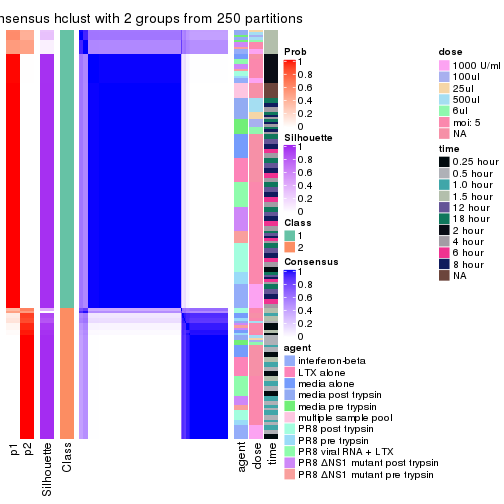
consensus_heatmap(res, k = 3)
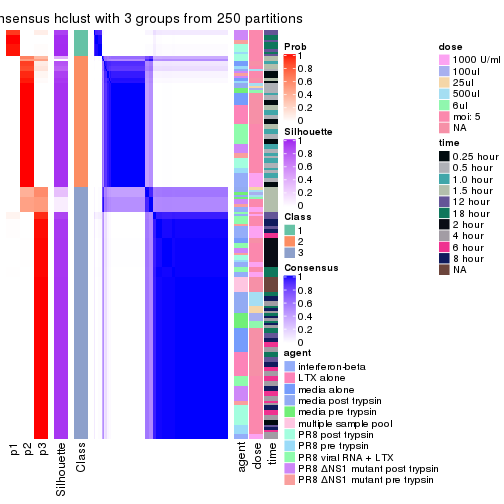
consensus_heatmap(res, k = 4)
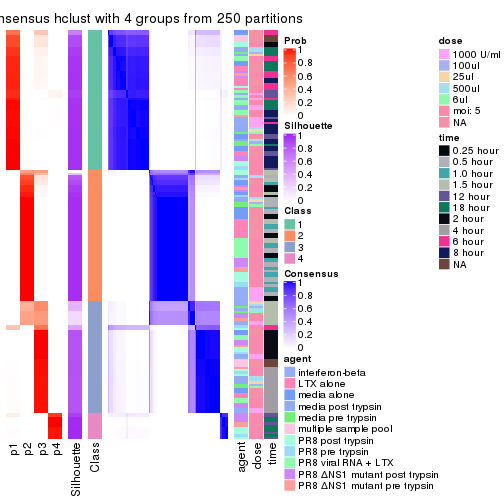
consensus_heatmap(res, k = 5)
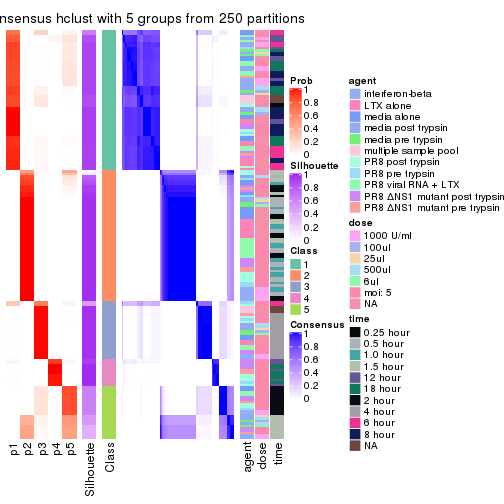
consensus_heatmap(res, k = 6)
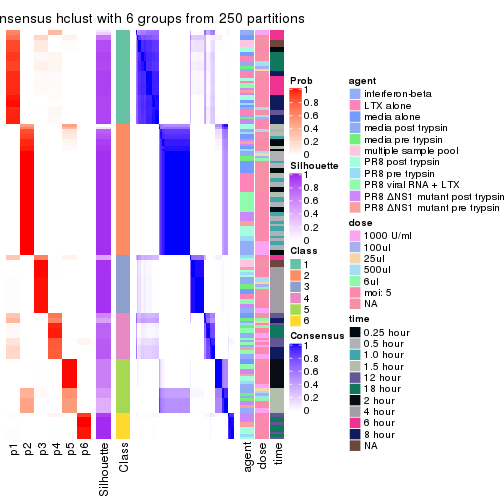
Heatmaps for the membership of samples in all partitions to see how consistent they are:
membership_heatmap(res, k = 2)
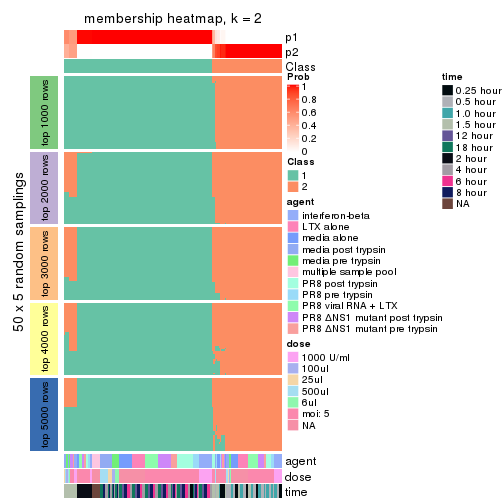
membership_heatmap(res, k = 3)
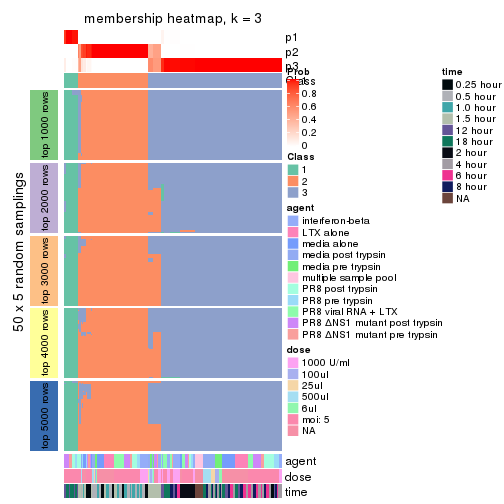
membership_heatmap(res, k = 4)
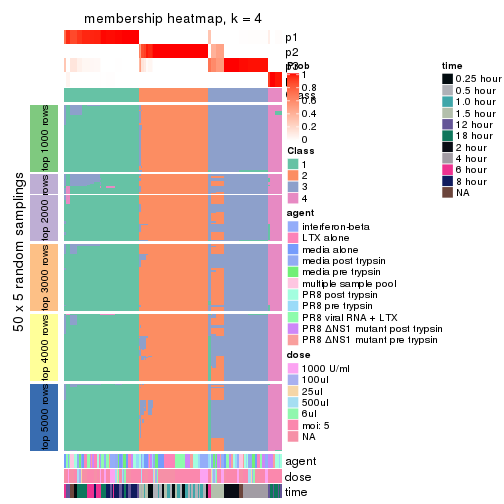
membership_heatmap(res, k = 5)
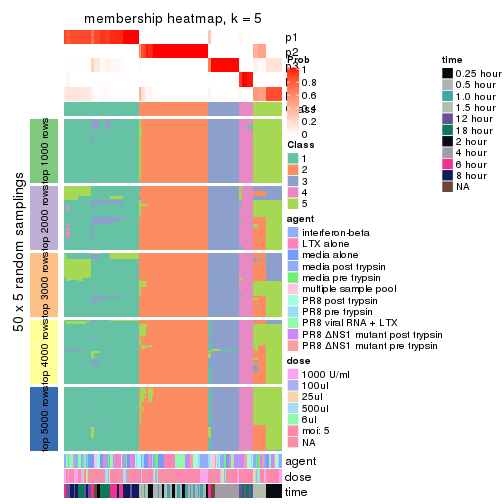
membership_heatmap(res, k = 6)
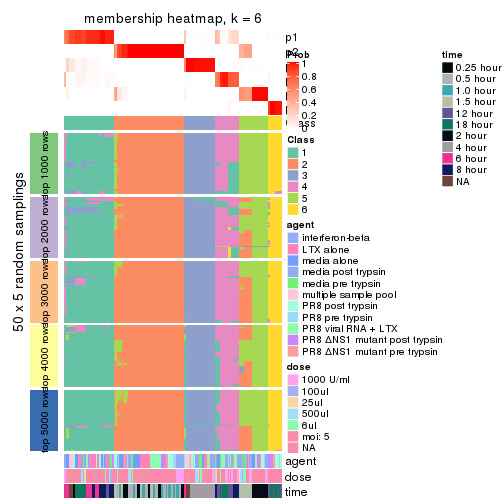
As soon as we have had the classes for columns, we can look for signatures which are significantly different between classes which can be candidate marks for certain classes. Following are the heatmaps for signatures.
Signature heatmaps where rows are scaled:
get_signatures(res, k = 2)
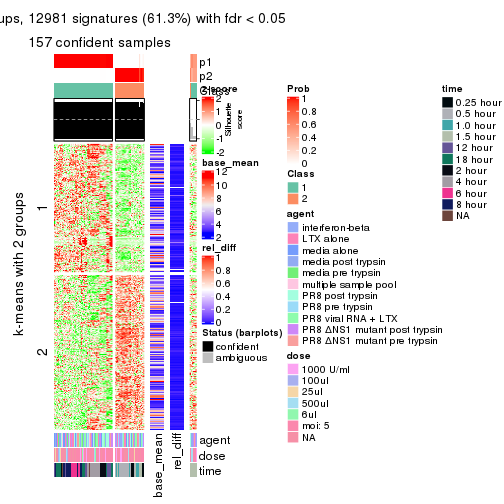
get_signatures(res, k = 3)
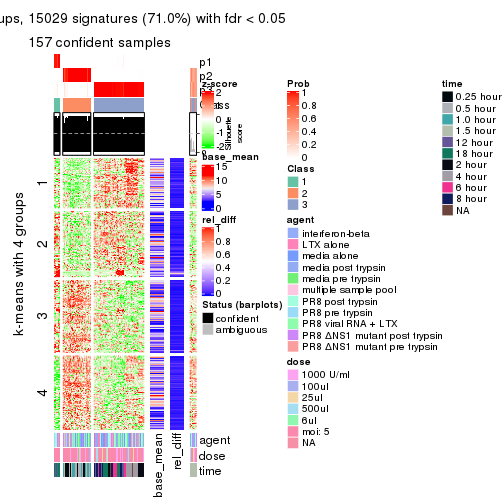
get_signatures(res, k = 4)
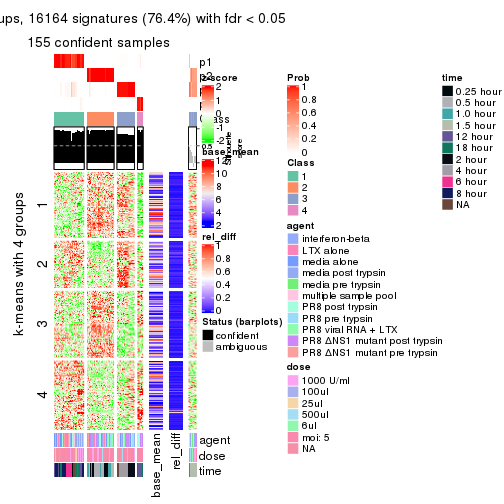
get_signatures(res, k = 5)
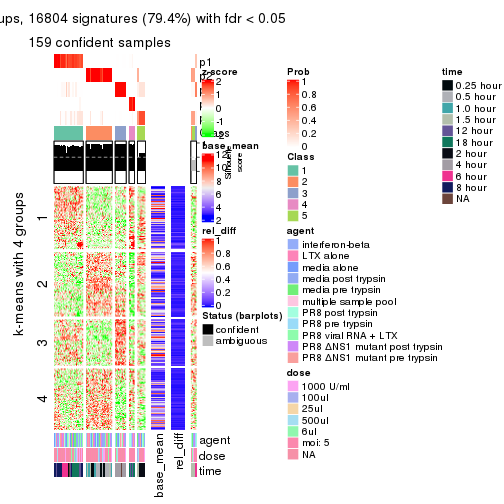
get_signatures(res, k = 6)
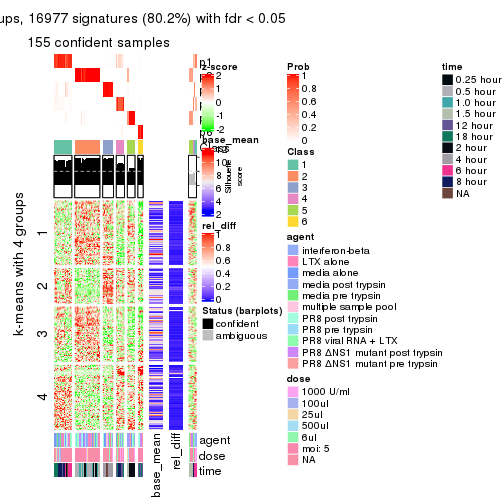
Signature heatmaps where rows are not scaled:
get_signatures(res, k = 2, scale_rows = FALSE)
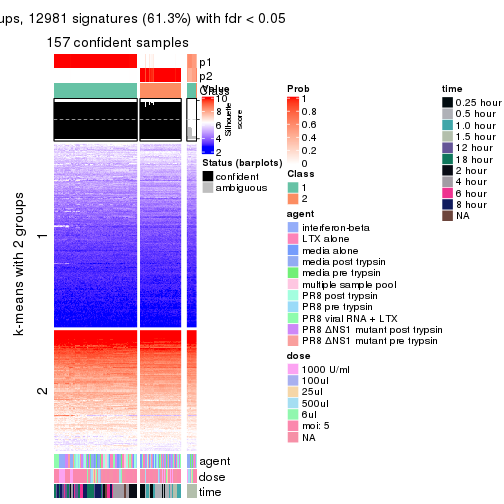
get_signatures(res, k = 3, scale_rows = FALSE)
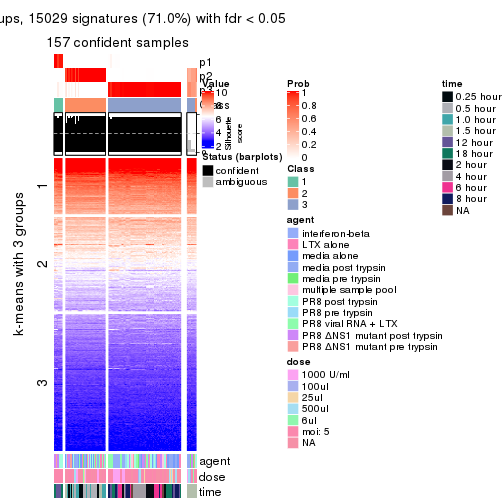
get_signatures(res, k = 4, scale_rows = FALSE)
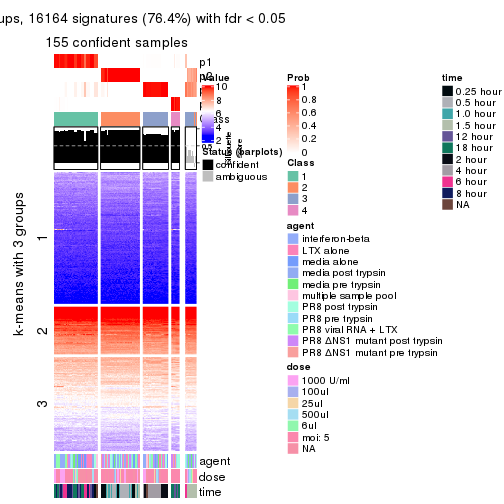
get_signatures(res, k = 5, scale_rows = FALSE)
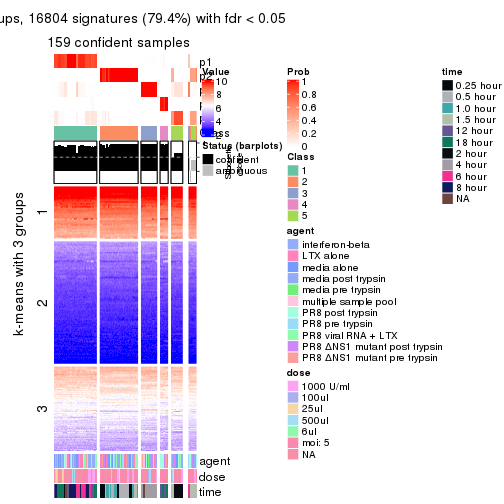
get_signatures(res, k = 6, scale_rows = FALSE)
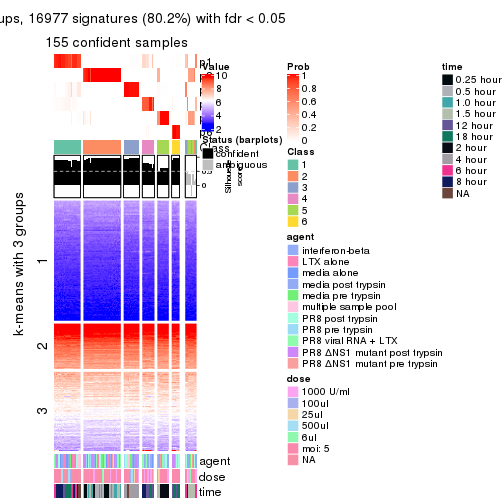
Compare the overlap of signatures from different k:
compare_signatures(res)
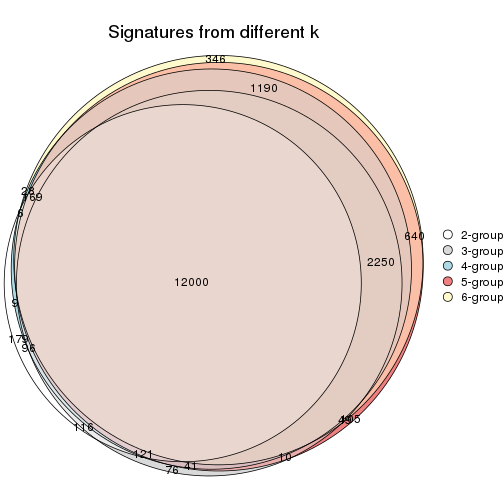
get_signature() returns a data frame invisibly. TO get the list of signatures, the function
call should be assigned to a variable explicitly. In following code, if plot argument is set
to FALSE, no heatmap is plotted while only the differential analysis is performed.
# code only for demonstration
tb = get_signature(res, k = ..., plot = FALSE)
An example of the output of tb is:
#> which_row fdr mean_1 mean_2 scaled_mean_1 scaled_mean_2 km
#> 1 38 0.042760348 8.373488 9.131774 -0.5533452 0.5164555 1
#> 2 40 0.018707592 7.106213 8.469186 -0.6173731 0.5762149 1
#> 3 55 0.019134737 10.221463 11.207825 -0.6159697 0.5749050 1
#> 4 59 0.006059896 5.921854 7.869574 -0.6899429 0.6439467 1
#> 5 60 0.018055526 8.928898 10.211722 -0.6204761 0.5791110 1
#> 6 98 0.009384629 15.714769 14.887706 0.6635654 -0.6193277 2
...
The columns in tb are:
which_row: row indices corresponding to the input matrix.fdr: FDR for the differential test. mean_x: The mean value in group x.scaled_mean_x: The mean value in group x after rows are scaled.km: Row groups if k-means clustering is applied to rows.UMAP plot which shows how samples are separated.
dimension_reduction(res, k = 2, method = "UMAP")
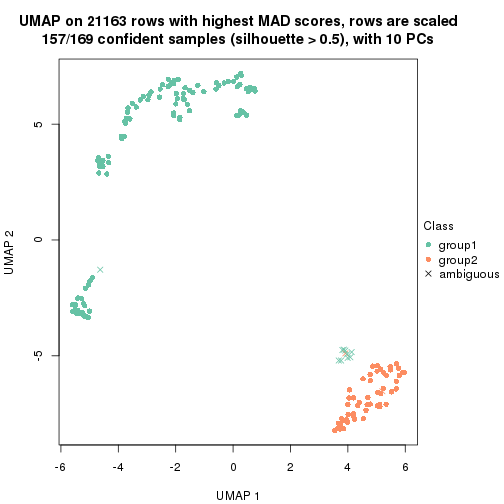
dimension_reduction(res, k = 3, method = "UMAP")
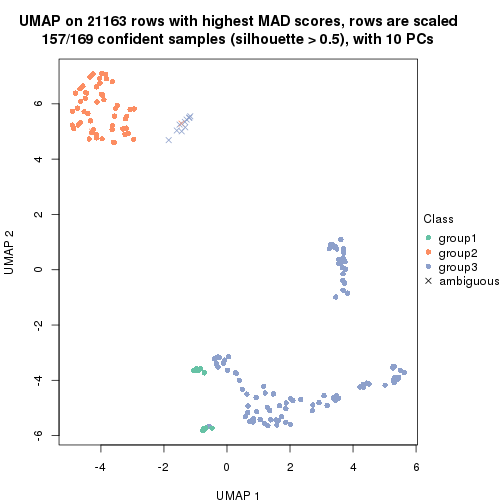
dimension_reduction(res, k = 4, method = "UMAP")
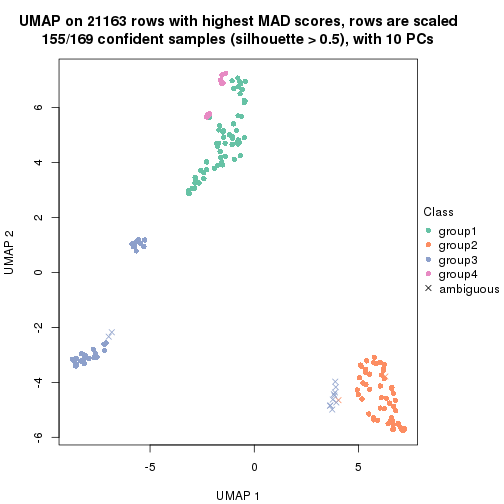
dimension_reduction(res, k = 5, method = "UMAP")
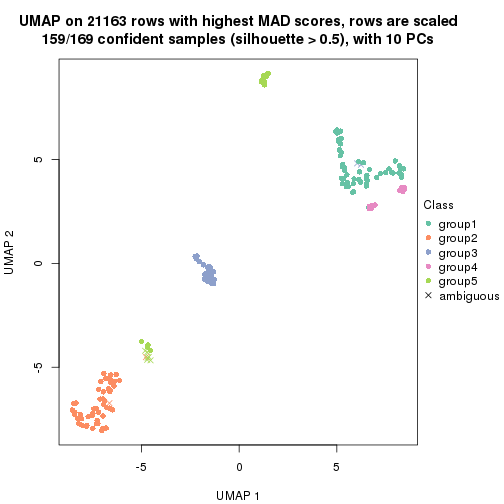
dimension_reduction(res, k = 6, method = "UMAP")
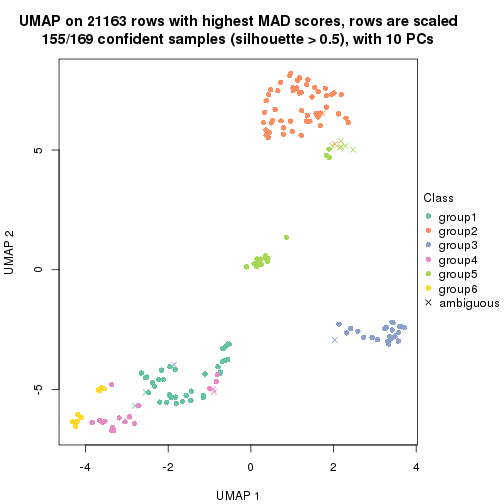
Following heatmap shows how subgroups are split when increasing k:
collect_classes(res)
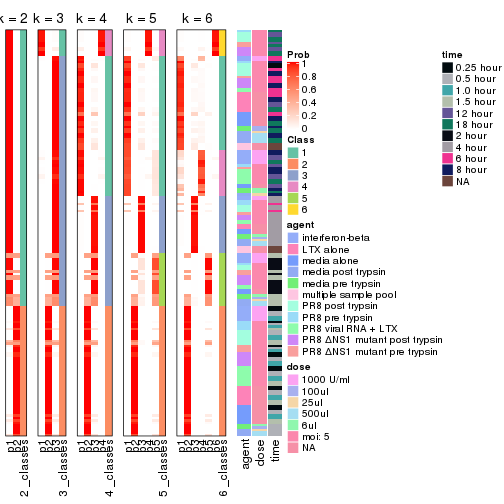
Test correlation between subgroups and known annotations. If the known annotation is numeric, one-way ANOVA test is applied, and if the known annotation is discrete, chi-squared contingency table test is applied.
test_to_known_factors(res)
#> n agent(p) dose(p) time(p) k
#> MAD:hclust 157 0.7587 0.9919 5.29e-27 2
#> MAD:hclust 157 0.0628 0.2789 1.48e-29 3
#> MAD:hclust 155 0.2622 0.5946 1.32e-50 4
#> MAD:hclust 159 0.3195 0.5840 3.15e-71 5
#> MAD:hclust 155 0.0081 0.0291 6.66e-70 6
If matrix rows can be associated to genes, consider to use functional_enrichment(res,
...) to perform function enrichment for the signature genes. See this vignette for more detailed explanations.
The object with results only for a single top-value method and a single partition method can be extracted as:
res = res_list["MAD", "kmeans"]
# you can also extract it by
# res = res_list["MAD:kmeans"]
A summary of res and all the functions that can be applied to it:
res
#> A 'ConsensusPartition' object with k = 2, 3, 4, 5, 6.
#> On a matrix with 21163 rows and 169 columns.
#> Top rows (1000, 2000, 3000, 4000, 5000) are extracted by 'MAD' method.
#> Subgroups are detected by 'kmeans' method.
#> Performed in total 1250 partitions by row resampling.
#> Best k for subgroups seems to be 2.
#>
#> Following methods can be applied to this 'ConsensusPartition' object:
#> [1] "cola_report" "collect_classes" "collect_plots"
#> [4] "collect_stats" "colnames" "compare_signatures"
#> [7] "consensus_heatmap" "dimension_reduction" "functional_enrichment"
#> [10] "get_anno_col" "get_anno" "get_classes"
#> [13] "get_consensus" "get_matrix" "get_membership"
#> [16] "get_param" "get_signatures" "get_stats"
#> [19] "is_best_k" "is_stable_k" "membership_heatmap"
#> [22] "ncol" "nrow" "plot_ecdf"
#> [25] "rownames" "select_partition_number" "show"
#> [28] "suggest_best_k" "test_to_known_factors"
collect_plots() function collects all the plots made from res for all k (number of partitions)
into one single page to provide an easy and fast comparison between different k.
collect_plots(res)
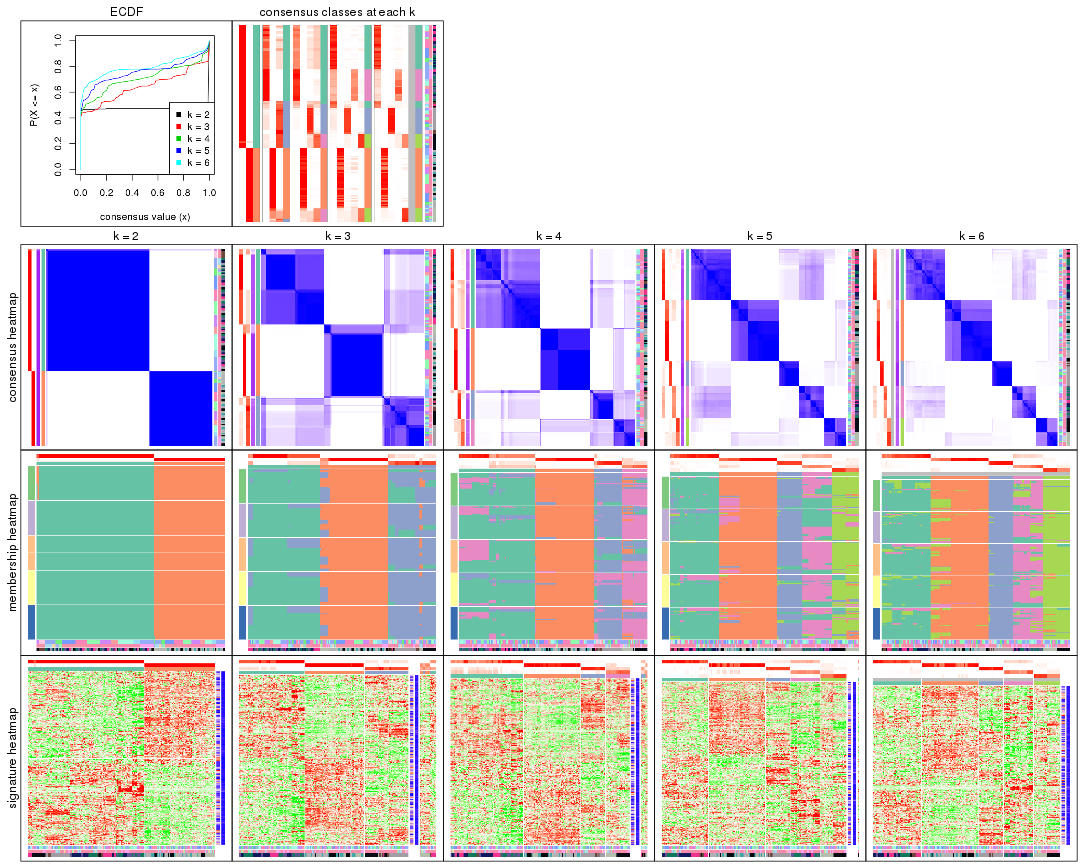
The plots are:
k and the heatmap of
predicted classes for each k.k.k.k.All the plots in panels can be made by individual functions and they are plotted later in this section.
select_partition_number() produces several plots showing different
statistics for choosing “optimized” k. There are following statistics:
k;k, the area increased is defined as \(A_k - A_{k-1}\).The detailed explanations of these statistics can be found in the cola vignette.
Generally speaking, lower PAC score, higher mean silhouette score or higher
concordance corresponds to better partition. Rand index and Jaccard index
measure how similar the current partition is compared to partition with k-1.
If they are too similar, we won't accept k is better than k-1.
select_partition_number(res)
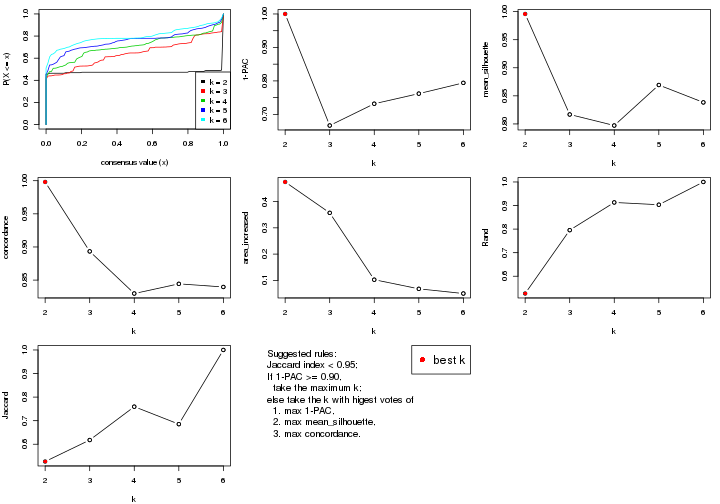
The numeric values for all these statistics can be obtained by get_stats().
get_stats(res)
#> k 1-PAC mean_silhouette concordance area_increased Rand Jaccard
#> 2 2 1.000 0.996 0.998 0.4747 0.527 0.527
#> 3 3 0.667 0.817 0.893 0.3571 0.796 0.618
#> 4 4 0.732 0.797 0.830 0.1026 0.913 0.759
#> 5 5 0.762 0.869 0.844 0.0678 0.903 0.685
#> 6 6 0.794 0.838 0.840 0.0499 1.000 1.000
suggest_best_k() suggests the best \(k\) based on these statistics. The rules are as follows:
suggest_best_k(res)
#> [1] 2
Following shows the table of the partitions (You need to click the show/hide
code output link to see it). The membership matrix (columns with name p*)
is inferred by
clue::cl_consensus()
function with the SE method. Basically the value in the membership matrix
represents the probability to belong to a certain group. The finall class
label for an item is determined with the group with highest probability it
belongs to.
In get_classes() function, the entropy is calculated from the membership
matrix and the silhouette score is calculated from the consensus matrix.
cbind(get_classes(res, k = 2), get_membership(res, k = 2))
#> class entropy silhouette p1 p2
#> GSM528681 2 0.000 1.000 0.000 1.000
#> GSM528682 2 0.000 1.000 0.000 1.000
#> GSM528683 2 0.000 1.000 0.000 1.000
#> GSM528684 2 0.000 1.000 0.000 1.000
#> GSM528687 2 0.000 1.000 0.000 1.000
#> GSM528688 2 0.000 1.000 0.000 1.000
#> GSM528685 2 0.000 1.000 0.000 1.000
#> GSM528686 2 0.000 1.000 0.000 1.000
#> GSM528693 1 0.000 0.997 1.000 0.000
#> GSM528694 1 0.000 0.997 1.000 0.000
#> GSM528695 1 0.000 0.997 1.000 0.000
#> GSM528696 1 0.000 0.997 1.000 0.000
#> GSM528697 1 0.000 0.997 1.000 0.000
#> GSM528698 1 0.000 0.997 1.000 0.000
#> GSM528699 1 0.000 0.997 1.000 0.000
#> GSM528700 1 0.000 0.997 1.000 0.000
#> GSM528689 1 0.000 0.997 1.000 0.000
#> GSM528690 1 0.000 0.997 1.000 0.000
#> GSM528691 1 0.000 0.997 1.000 0.000
#> GSM528692 1 0.000 0.997 1.000 0.000
#> GSM528779 2 0.000 1.000 0.000 1.000
#> GSM528780 2 0.000 1.000 0.000 1.000
#> GSM528782 2 0.000 1.000 0.000 1.000
#> GSM528781 2 0.000 1.000 0.000 1.000
#> GSM528785 1 0.000 0.997 1.000 0.000
#> GSM528786 1 0.000 0.997 1.000 0.000
#> GSM528787 1 0.000 0.997 1.000 0.000
#> GSM528788 1 0.000 0.997 1.000 0.000
#> GSM528783 1 0.000 0.997 1.000 0.000
#> GSM528784 1 0.000 0.997 1.000 0.000
#> GSM528759 1 0.000 0.997 1.000 0.000
#> GSM528760 1 0.000 0.997 1.000 0.000
#> GSM528761 2 0.000 1.000 0.000 1.000
#> GSM528762 2 0.000 1.000 0.000 1.000
#> GSM528765 2 0.000 1.000 0.000 1.000
#> GSM528766 2 0.000 1.000 0.000 1.000
#> GSM528763 2 0.000 1.000 0.000 1.000
#> GSM528764 2 0.000 1.000 0.000 1.000
#> GSM528771 1 0.000 0.997 1.000 0.000
#> GSM528772 1 0.000 0.997 1.000 0.000
#> GSM528773 1 0.000 0.997 1.000 0.000
#> GSM528774 1 0.000 0.997 1.000 0.000
#> GSM528775 1 0.000 0.997 1.000 0.000
#> GSM528776 1 0.000 0.997 1.000 0.000
#> GSM528777 1 0.000 0.997 1.000 0.000
#> GSM528778 1 0.000 0.997 1.000 0.000
#> GSM528767 1 0.000 0.997 1.000 0.000
#> GSM528768 1 0.000 0.997 1.000 0.000
#> GSM528769 1 0.000 0.997 1.000 0.000
#> GSM528770 1 0.000 0.997 1.000 0.000
#> GSM528671 2 0.000 1.000 0.000 1.000
#> GSM528672 2 0.000 1.000 0.000 1.000
#> GSM528674 2 0.000 1.000 0.000 1.000
#> GSM528673 2 0.000 1.000 0.000 1.000
#> GSM528677 1 0.000 0.997 1.000 0.000
#> GSM528678 1 0.000 0.997 1.000 0.000
#> GSM528679 1 0.000 0.997 1.000 0.000
#> GSM528680 1 0.000 0.997 1.000 0.000
#> GSM528675 1 0.000 0.997 1.000 0.000
#> GSM528676 1 0.000 0.997 1.000 0.000
#> GSM528651 2 0.000 1.000 0.000 1.000
#> GSM528652 2 0.000 1.000 0.000 1.000
#> GSM528653 2 0.000 1.000 0.000 1.000
#> GSM528654 2 0.000 1.000 0.000 1.000
#> GSM528657 2 0.000 1.000 0.000 1.000
#> GSM528658 2 0.000 1.000 0.000 1.000
#> GSM528655 2 0.000 1.000 0.000 1.000
#> GSM528656 2 0.000 1.000 0.000 1.000
#> GSM528663 1 0.494 0.879 0.892 0.108
#> GSM528664 1 0.722 0.752 0.800 0.200
#> GSM528665 1 0.000 0.997 1.000 0.000
#> GSM528666 1 0.000 0.997 1.000 0.000
#> GSM528667 1 0.000 0.997 1.000 0.000
#> GSM528668 1 0.000 0.997 1.000 0.000
#> GSM528669 1 0.000 0.997 1.000 0.000
#> GSM528670 1 0.000 0.997 1.000 0.000
#> GSM528659 1 0.000 0.997 1.000 0.000
#> GSM528660 1 0.000 0.997 1.000 0.000
#> GSM528661 1 0.000 0.997 1.000 0.000
#> GSM528662 1 0.000 0.997 1.000 0.000
#> GSM528701 2 0.000 1.000 0.000 1.000
#> GSM528702 2 0.000 1.000 0.000 1.000
#> GSM528703 2 0.000 1.000 0.000 1.000
#> GSM528704 2 0.000 1.000 0.000 1.000
#> GSM528707 2 0.000 1.000 0.000 1.000
#> GSM528708 2 0.000 1.000 0.000 1.000
#> GSM528705 2 0.000 1.000 0.000 1.000
#> GSM528706 2 0.000 1.000 0.000 1.000
#> GSM528713 1 0.000 0.997 1.000 0.000
#> GSM528714 1 0.000 0.997 1.000 0.000
#> GSM528715 1 0.000 0.997 1.000 0.000
#> GSM528716 1 0.000 0.997 1.000 0.000
#> GSM528717 1 0.000 0.997 1.000 0.000
#> GSM528718 1 0.000 0.997 1.000 0.000
#> GSM528719 1 0.000 0.997 1.000 0.000
#> GSM528720 1 0.000 0.997 1.000 0.000
#> GSM528709 1 0.000 0.997 1.000 0.000
#> GSM528710 1 0.000 0.997 1.000 0.000
#> GSM528711 1 0.000 0.997 1.000 0.000
#> GSM528712 1 0.000 0.997 1.000 0.000
#> GSM528721 2 0.000 1.000 0.000 1.000
#> GSM528722 2 0.000 1.000 0.000 1.000
#> GSM528723 2 0.000 1.000 0.000 1.000
#> GSM528724 2 0.000 1.000 0.000 1.000
#> GSM528727 2 0.000 1.000 0.000 1.000
#> GSM528728 2 0.000 1.000 0.000 1.000
#> GSM528725 2 0.000 1.000 0.000 1.000
#> GSM528726 2 0.000 1.000 0.000 1.000
#> GSM528733 1 0.000 0.997 1.000 0.000
#> GSM528734 1 0.000 0.997 1.000 0.000
#> GSM528735 1 0.000 0.997 1.000 0.000
#> GSM528736 1 0.000 0.997 1.000 0.000
#> GSM528737 1 0.000 0.997 1.000 0.000
#> GSM528738 1 0.000 0.997 1.000 0.000
#> GSM528729 1 0.000 0.997 1.000 0.000
#> GSM528730 1 0.000 0.997 1.000 0.000
#> GSM528731 1 0.000 0.997 1.000 0.000
#> GSM528732 1 0.000 0.997 1.000 0.000
#> GSM528739 2 0.000 1.000 0.000 1.000
#> GSM528740 2 0.000 1.000 0.000 1.000
#> GSM528741 2 0.000 1.000 0.000 1.000
#> GSM528742 2 0.000 1.000 0.000 1.000
#> GSM528745 2 0.000 1.000 0.000 1.000
#> GSM528746 2 0.000 1.000 0.000 1.000
#> GSM528743 2 0.000 1.000 0.000 1.000
#> GSM528744 2 0.000 1.000 0.000 1.000
#> GSM528751 1 0.000 0.997 1.000 0.000
#> GSM528752 1 0.000 0.997 1.000 0.000
#> GSM528753 1 0.000 0.997 1.000 0.000
#> GSM528754 1 0.000 0.997 1.000 0.000
#> GSM528755 1 0.000 0.997 1.000 0.000
#> GSM528756 1 0.000 0.997 1.000 0.000
#> GSM528757 1 0.000 0.997 1.000 0.000
#> GSM528758 1 0.000 0.997 1.000 0.000
#> GSM528747 1 0.000 0.997 1.000 0.000
#> GSM528748 1 0.000 0.997 1.000 0.000
#> GSM528749 1 0.000 0.997 1.000 0.000
#> GSM528750 1 0.000 0.997 1.000 0.000
#> GSM528640 2 0.000 1.000 0.000 1.000
#> GSM528641 2 0.000 1.000 0.000 1.000
#> GSM528643 1 0.000 0.997 1.000 0.000
#> GSM528644 1 0.000 0.997 1.000 0.000
#> GSM528642 1 0.000 0.997 1.000 0.000
#> GSM528620 2 0.000 1.000 0.000 1.000
#> GSM528621 2 0.141 0.979 0.020 0.980
#> GSM528623 1 0.000 0.997 1.000 0.000
#> GSM528624 1 0.000 0.997 1.000 0.000
#> GSM528622 1 0.000 0.997 1.000 0.000
#> GSM528625 2 0.000 1.000 0.000 1.000
#> GSM528626 2 0.000 1.000 0.000 1.000
#> GSM528628 1 0.000 0.997 1.000 0.000
#> GSM528629 1 0.000 0.997 1.000 0.000
#> GSM528627 1 0.000 0.997 1.000 0.000
#> GSM528630 2 0.000 1.000 0.000 1.000
#> GSM528631 2 0.000 1.000 0.000 1.000
#> GSM528632 2 0.000 1.000 0.000 1.000
#> GSM528633 2 0.000 1.000 0.000 1.000
#> GSM528636 1 0.000 0.997 1.000 0.000
#> GSM528637 1 0.000 0.997 1.000 0.000
#> GSM528638 1 0.000 0.997 1.000 0.000
#> GSM528639 1 0.000 0.997 1.000 0.000
#> GSM528634 1 0.000 0.997 1.000 0.000
#> GSM528635 1 0.000 0.997 1.000 0.000
#> GSM528645 1 0.000 0.997 1.000 0.000
#> GSM528646 1 0.000 0.997 1.000 0.000
#> GSM528647 1 0.000 0.997 1.000 0.000
#> GSM528648 1 0.000 0.997 1.000 0.000
#> GSM528649 1 0.000 0.997 1.000 0.000
#> GSM528650 1 0.000 0.997 1.000 0.000
cbind(get_classes(res, k = 3), get_membership(res, k = 3))
#> class entropy silhouette p1 p2 p3
#> GSM528681 2 0.0000 0.945 0.000 1.000 0.000
#> GSM528682 2 0.0000 0.945 0.000 1.000 0.000
#> GSM528683 2 0.0000 0.945 0.000 1.000 0.000
#> GSM528684 2 0.0000 0.945 0.000 1.000 0.000
#> GSM528687 2 0.0000 0.945 0.000 1.000 0.000
#> GSM528688 2 0.0000 0.945 0.000 1.000 0.000
#> GSM528685 2 0.4233 0.804 0.004 0.836 0.160
#> GSM528686 2 0.6410 0.404 0.004 0.576 0.420
#> GSM528693 3 0.3619 0.801 0.136 0.000 0.864
#> GSM528694 3 0.3340 0.807 0.120 0.000 0.880
#> GSM528695 3 0.3941 0.826 0.156 0.000 0.844
#> GSM528696 3 0.3941 0.826 0.156 0.000 0.844
#> GSM528697 1 0.0000 0.848 1.000 0.000 0.000
#> GSM528698 1 0.0237 0.847 0.996 0.000 0.004
#> GSM528699 1 0.0000 0.848 1.000 0.000 0.000
#> GSM528700 1 0.0000 0.848 1.000 0.000 0.000
#> GSM528689 1 0.0000 0.848 1.000 0.000 0.000
#> GSM528690 1 0.0000 0.848 1.000 0.000 0.000
#> GSM528691 1 0.0237 0.847 0.996 0.000 0.004
#> GSM528692 1 0.0237 0.847 0.996 0.000 0.004
#> GSM528779 2 0.0000 0.945 0.000 1.000 0.000
#> GSM528780 2 0.0000 0.945 0.000 1.000 0.000
#> GSM528782 2 0.0000 0.945 0.000 1.000 0.000
#> GSM528781 2 0.0000 0.945 0.000 1.000 0.000
#> GSM528785 3 0.3619 0.801 0.136 0.000 0.864
#> GSM528786 3 0.0747 0.798 0.016 0.000 0.984
#> GSM528787 3 0.5254 0.734 0.264 0.000 0.736
#> GSM528788 1 0.4121 0.841 0.832 0.000 0.168
#> GSM528783 1 0.0237 0.847 0.996 0.000 0.004
#> GSM528784 1 0.0000 0.848 1.000 0.000 0.000
#> GSM528759 3 0.5327 0.723 0.272 0.000 0.728
#> GSM528760 3 0.4974 0.766 0.236 0.000 0.764
#> GSM528761 2 0.0000 0.945 0.000 1.000 0.000
#> GSM528762 2 0.0000 0.945 0.000 1.000 0.000
#> GSM528765 2 0.0000 0.945 0.000 1.000 0.000
#> GSM528766 2 0.0000 0.945 0.000 1.000 0.000
#> GSM528763 2 0.2537 0.882 0.000 0.920 0.080
#> GSM528764 2 0.6410 0.404 0.004 0.576 0.420
#> GSM528771 3 0.3619 0.801 0.136 0.000 0.864
#> GSM528772 3 0.3619 0.801 0.136 0.000 0.864
#> GSM528773 3 0.2796 0.827 0.092 0.000 0.908
#> GSM528774 3 0.2959 0.828 0.100 0.000 0.900
#> GSM528775 1 0.6280 0.183 0.540 0.000 0.460
#> GSM528776 1 0.4178 0.840 0.828 0.000 0.172
#> GSM528777 1 0.0000 0.848 1.000 0.000 0.000
#> GSM528778 1 0.0000 0.848 1.000 0.000 0.000
#> GSM528767 1 0.0000 0.848 1.000 0.000 0.000
#> GSM528768 1 0.0000 0.848 1.000 0.000 0.000
#> GSM528769 1 0.0000 0.848 1.000 0.000 0.000
#> GSM528770 1 0.0000 0.848 1.000 0.000 0.000
#> GSM528671 2 0.0000 0.945 0.000 1.000 0.000
#> GSM528672 2 0.0000 0.945 0.000 1.000 0.000
#> GSM528674 2 0.0000 0.945 0.000 1.000 0.000
#> GSM528673 2 0.6410 0.404 0.004 0.576 0.420
#> GSM528677 3 0.3267 0.808 0.116 0.000 0.884
#> GSM528678 3 0.2711 0.826 0.088 0.000 0.912
#> GSM528679 1 0.4178 0.840 0.828 0.000 0.172
#> GSM528680 1 0.0000 0.848 1.000 0.000 0.000
#> GSM528675 1 0.0000 0.848 1.000 0.000 0.000
#> GSM528676 1 0.0000 0.848 1.000 0.000 0.000
#> GSM528651 2 0.0000 0.945 0.000 1.000 0.000
#> GSM528652 2 0.0000 0.945 0.000 1.000 0.000
#> GSM528653 2 0.0000 0.945 0.000 1.000 0.000
#> GSM528654 2 0.0000 0.945 0.000 1.000 0.000
#> GSM528657 2 0.0000 0.945 0.000 1.000 0.000
#> GSM528658 2 0.0000 0.945 0.000 1.000 0.000
#> GSM528655 2 0.6410 0.404 0.004 0.576 0.420
#> GSM528656 2 0.6410 0.404 0.004 0.576 0.420
#> GSM528663 3 0.4174 0.797 0.092 0.036 0.872
#> GSM528664 3 0.4505 0.789 0.092 0.048 0.860
#> GSM528665 3 0.3941 0.826 0.156 0.000 0.844
#> GSM528666 3 0.3941 0.826 0.156 0.000 0.844
#> GSM528667 1 0.4178 0.840 0.828 0.000 0.172
#> GSM528668 1 0.4178 0.840 0.828 0.000 0.172
#> GSM528669 1 0.0000 0.848 1.000 0.000 0.000
#> GSM528670 1 0.3482 0.845 0.872 0.000 0.128
#> GSM528659 1 0.0000 0.848 1.000 0.000 0.000
#> GSM528660 1 0.0000 0.848 1.000 0.000 0.000
#> GSM528661 1 0.0000 0.848 1.000 0.000 0.000
#> GSM528662 1 0.0000 0.848 1.000 0.000 0.000
#> GSM528701 2 0.0000 0.945 0.000 1.000 0.000
#> GSM528702 2 0.0000 0.945 0.000 1.000 0.000
#> GSM528703 2 0.0000 0.945 0.000 1.000 0.000
#> GSM528704 2 0.0000 0.945 0.000 1.000 0.000
#> GSM528707 2 0.0000 0.945 0.000 1.000 0.000
#> GSM528708 2 0.0000 0.945 0.000 1.000 0.000
#> GSM528705 2 0.0000 0.945 0.000 1.000 0.000
#> GSM528706 2 0.0000 0.945 0.000 1.000 0.000
#> GSM528713 3 0.3619 0.801 0.136 0.000 0.864
#> GSM528714 3 0.3267 0.808 0.116 0.000 0.884
#> GSM528715 3 0.3941 0.826 0.156 0.000 0.844
#> GSM528716 3 0.3941 0.826 0.156 0.000 0.844
#> GSM528717 1 0.4178 0.840 0.828 0.000 0.172
#> GSM528718 1 0.4178 0.840 0.828 0.000 0.172
#> GSM528719 1 0.0237 0.847 0.996 0.000 0.004
#> GSM528720 1 0.0000 0.848 1.000 0.000 0.000
#> GSM528709 1 0.0000 0.848 1.000 0.000 0.000
#> GSM528710 1 0.0000 0.848 1.000 0.000 0.000
#> GSM528711 1 0.0000 0.848 1.000 0.000 0.000
#> GSM528712 1 0.0000 0.848 1.000 0.000 0.000
#> GSM528721 2 0.0000 0.945 0.000 1.000 0.000
#> GSM528722 2 0.0000 0.945 0.000 1.000 0.000
#> GSM528723 2 0.0000 0.945 0.000 1.000 0.000
#> GSM528724 2 0.0000 0.945 0.000 1.000 0.000
#> GSM528727 2 0.0000 0.945 0.000 1.000 0.000
#> GSM528728 2 0.0000 0.945 0.000 1.000 0.000
#> GSM528725 2 0.0000 0.945 0.000 1.000 0.000
#> GSM528726 2 0.0000 0.945 0.000 1.000 0.000
#> GSM528733 3 0.3941 0.826 0.156 0.000 0.844
#> GSM528734 3 0.3941 0.826 0.156 0.000 0.844
#> GSM528735 1 0.6192 0.319 0.580 0.000 0.420
#> GSM528736 1 0.6215 0.291 0.572 0.000 0.428
#> GSM528737 1 0.4178 0.840 0.828 0.000 0.172
#> GSM528738 1 0.4178 0.840 0.828 0.000 0.172
#> GSM528729 1 0.4121 0.841 0.832 0.000 0.168
#> GSM528730 1 0.4121 0.841 0.832 0.000 0.168
#> GSM528731 1 0.4121 0.841 0.832 0.000 0.168
#> GSM528732 1 0.4178 0.840 0.828 0.000 0.172
#> GSM528739 2 0.0000 0.945 0.000 1.000 0.000
#> GSM528740 2 0.0000 0.945 0.000 1.000 0.000
#> GSM528741 2 0.0000 0.945 0.000 1.000 0.000
#> GSM528742 2 0.0000 0.945 0.000 1.000 0.000
#> GSM528745 2 0.0000 0.945 0.000 1.000 0.000
#> GSM528746 2 0.0000 0.945 0.000 1.000 0.000
#> GSM528743 2 0.0000 0.945 0.000 1.000 0.000
#> GSM528744 2 0.0000 0.945 0.000 1.000 0.000
#> GSM528751 3 0.3619 0.801 0.136 0.000 0.864
#> GSM528752 3 0.3619 0.801 0.136 0.000 0.864
#> GSM528753 3 0.3941 0.826 0.156 0.000 0.844
#> GSM528754 3 0.3941 0.826 0.156 0.000 0.844
#> GSM528755 1 0.6267 0.216 0.548 0.000 0.452
#> GSM528756 1 0.6280 0.183 0.540 0.000 0.460
#> GSM528757 1 0.4121 0.841 0.832 0.000 0.168
#> GSM528758 1 0.4121 0.841 0.832 0.000 0.168
#> GSM528747 1 0.4178 0.840 0.828 0.000 0.172
#> GSM528748 1 0.4178 0.840 0.828 0.000 0.172
#> GSM528749 1 0.4178 0.840 0.828 0.000 0.172
#> GSM528750 1 0.4178 0.840 0.828 0.000 0.172
#> GSM528640 2 0.0000 0.945 0.000 1.000 0.000
#> GSM528641 2 0.6410 0.404 0.004 0.576 0.420
#> GSM528643 3 0.3941 0.826 0.156 0.000 0.844
#> GSM528644 1 0.4178 0.840 0.828 0.000 0.172
#> GSM528642 1 0.4654 0.808 0.792 0.000 0.208
#> GSM528620 2 0.0000 0.945 0.000 1.000 0.000
#> GSM528621 3 0.4172 0.699 0.004 0.156 0.840
#> GSM528623 3 0.3941 0.826 0.156 0.000 0.844
#> GSM528624 1 0.4121 0.841 0.832 0.000 0.168
#> GSM528622 1 0.4178 0.840 0.828 0.000 0.172
#> GSM528625 2 0.0000 0.945 0.000 1.000 0.000
#> GSM528626 2 0.6500 0.290 0.004 0.532 0.464
#> GSM528628 3 0.3941 0.826 0.156 0.000 0.844
#> GSM528629 1 0.4178 0.840 0.828 0.000 0.172
#> GSM528627 1 0.4178 0.840 0.828 0.000 0.172
#> GSM528630 2 0.0000 0.945 0.000 1.000 0.000
#> GSM528631 2 0.0000 0.945 0.000 1.000 0.000
#> GSM528632 3 0.6298 0.168 0.004 0.388 0.608
#> GSM528633 3 0.6298 0.168 0.004 0.388 0.608
#> GSM528636 3 0.3941 0.826 0.156 0.000 0.844
#> GSM528637 3 0.3941 0.826 0.156 0.000 0.844
#> GSM528638 1 0.4121 0.841 0.832 0.000 0.168
#> GSM528639 1 0.4121 0.841 0.832 0.000 0.168
#> GSM528634 1 0.4452 0.822 0.808 0.000 0.192
#> GSM528635 1 0.4178 0.840 0.828 0.000 0.172
#> GSM528645 3 0.0000 0.788 0.000 0.000 1.000
#> GSM528646 3 0.0000 0.788 0.000 0.000 1.000
#> GSM528647 3 0.0000 0.788 0.000 0.000 1.000
#> GSM528648 3 0.5529 0.693 0.296 0.000 0.704
#> GSM528649 3 0.5327 0.723 0.272 0.000 0.728
#> GSM528650 3 0.6180 0.381 0.416 0.000 0.584
cbind(get_classes(res, k = 4), get_membership(res, k = 4))
#> class entropy silhouette p1 p2 p3 p4
#> GSM528681 2 0.0000 0.972 0.000 1.000 0.000 0.000
#> GSM528682 2 0.0000 0.972 0.000 1.000 0.000 0.000
#> GSM528683 2 0.0000 0.972 0.000 1.000 0.000 0.000
#> GSM528684 2 0.0000 0.972 0.000 1.000 0.000 0.000
#> GSM528687 2 0.0000 0.972 0.000 1.000 0.000 0.000
#> GSM528688 2 0.0000 0.972 0.000 1.000 0.000 0.000
#> GSM528685 4 0.5310 0.409 0.000 0.412 0.012 0.576
#> GSM528686 4 0.7001 0.750 0.000 0.196 0.224 0.580
#> GSM528693 4 0.4123 0.759 0.008 0.000 0.220 0.772
#> GSM528694 4 0.4123 0.759 0.008 0.000 0.220 0.772
#> GSM528695 3 0.1118 0.859 0.036 0.000 0.964 0.000
#> GSM528696 3 0.1118 0.859 0.036 0.000 0.964 0.000
#> GSM528697 1 0.0921 0.724 0.972 0.000 0.000 0.028
#> GSM528698 1 0.1022 0.724 0.968 0.000 0.000 0.032
#> GSM528699 1 0.1022 0.724 0.968 0.000 0.000 0.032
#> GSM528700 1 0.0469 0.716 0.988 0.000 0.000 0.012
#> GSM528689 1 0.0188 0.714 0.996 0.000 0.000 0.004
#> GSM528690 1 0.0188 0.712 0.996 0.000 0.000 0.004
#> GSM528691 1 0.0469 0.715 0.988 0.000 0.000 0.012
#> GSM528692 1 0.0469 0.715 0.988 0.000 0.000 0.012
#> GSM528779 2 0.0000 0.972 0.000 1.000 0.000 0.000
#> GSM528780 2 0.1724 0.956 0.000 0.948 0.032 0.020
#> GSM528782 2 0.0000 0.972 0.000 1.000 0.000 0.000
#> GSM528781 2 0.1724 0.956 0.000 0.948 0.032 0.020
#> GSM528785 4 0.2976 0.646 0.008 0.000 0.120 0.872
#> GSM528786 3 0.2149 0.739 0.000 0.000 0.912 0.088
#> GSM528787 3 0.7658 -0.175 0.372 0.000 0.416 0.212
#> GSM528788 1 0.6567 0.778 0.616 0.000 0.128 0.256
#> GSM528783 1 0.1792 0.715 0.932 0.000 0.000 0.068
#> GSM528784 1 0.2149 0.699 0.912 0.000 0.000 0.088
#> GSM528759 1 0.7895 0.417 0.376 0.000 0.308 0.316
#> GSM528760 3 0.7135 0.322 0.240 0.000 0.560 0.200
#> GSM528761 2 0.1724 0.956 0.000 0.948 0.032 0.020
#> GSM528762 2 0.0000 0.972 0.000 1.000 0.000 0.000
#> GSM528765 2 0.1724 0.956 0.000 0.948 0.032 0.020
#> GSM528766 2 0.1724 0.956 0.000 0.948 0.032 0.020
#> GSM528763 2 0.4996 -0.146 0.000 0.516 0.000 0.484
#> GSM528764 4 0.7036 0.742 0.000 0.212 0.212 0.576
#> GSM528771 4 0.4049 0.758 0.008 0.000 0.212 0.780
#> GSM528772 4 0.4049 0.758 0.008 0.000 0.212 0.780
#> GSM528773 3 0.1706 0.817 0.016 0.000 0.948 0.036
#> GSM528774 3 0.1182 0.837 0.016 0.000 0.968 0.016
#> GSM528775 1 0.7375 0.672 0.488 0.000 0.176 0.336
#> GSM528776 1 0.6592 0.776 0.612 0.000 0.128 0.260
#> GSM528777 1 0.4599 0.770 0.736 0.000 0.016 0.248
#> GSM528778 1 0.4599 0.770 0.736 0.000 0.016 0.248
#> GSM528767 1 0.2149 0.699 0.912 0.000 0.000 0.088
#> GSM528768 1 0.2149 0.699 0.912 0.000 0.000 0.088
#> GSM528769 1 0.2149 0.699 0.912 0.000 0.000 0.088
#> GSM528770 1 0.2149 0.699 0.912 0.000 0.000 0.088
#> GSM528671 2 0.1724 0.956 0.000 0.948 0.032 0.020
#> GSM528672 2 0.0000 0.972 0.000 1.000 0.000 0.000
#> GSM528674 2 0.1724 0.956 0.000 0.948 0.032 0.020
#> GSM528673 4 0.7036 0.742 0.000 0.212 0.212 0.576
#> GSM528677 4 0.4018 0.758 0.004 0.000 0.224 0.772
#> GSM528678 3 0.2412 0.780 0.008 0.000 0.908 0.084
#> GSM528679 1 0.6592 0.778 0.612 0.000 0.128 0.260
#> GSM528680 1 0.1022 0.724 0.968 0.000 0.000 0.032
#> GSM528675 1 0.1557 0.683 0.944 0.000 0.000 0.056
#> GSM528676 1 0.1557 0.683 0.944 0.000 0.000 0.056
#> GSM528651 2 0.1724 0.956 0.000 0.948 0.032 0.020
#> GSM528652 2 0.1724 0.956 0.000 0.948 0.032 0.020
#> GSM528653 2 0.0000 0.972 0.000 1.000 0.000 0.000
#> GSM528654 2 0.0000 0.972 0.000 1.000 0.000 0.000
#> GSM528657 2 0.1724 0.956 0.000 0.948 0.032 0.020
#> GSM528658 2 0.0000 0.972 0.000 1.000 0.000 0.000
#> GSM528655 4 0.7036 0.742 0.000 0.212 0.212 0.576
#> GSM528656 4 0.7034 0.734 0.000 0.220 0.204 0.576
#> GSM528663 4 0.4155 0.757 0.000 0.004 0.240 0.756
#> GSM528664 4 0.4642 0.762 0.000 0.020 0.240 0.740
#> GSM528665 3 0.1118 0.859 0.036 0.000 0.964 0.000
#> GSM528666 3 0.1118 0.859 0.036 0.000 0.964 0.000
#> GSM528667 1 0.6567 0.776 0.616 0.000 0.128 0.256
#> GSM528668 1 0.6567 0.776 0.616 0.000 0.128 0.256
#> GSM528669 1 0.4737 0.770 0.728 0.000 0.020 0.252
#> GSM528670 1 0.5845 0.777 0.672 0.000 0.076 0.252
#> GSM528659 1 0.1557 0.683 0.944 0.000 0.000 0.056
#> GSM528660 1 0.1557 0.683 0.944 0.000 0.000 0.056
#> GSM528661 1 0.1557 0.683 0.944 0.000 0.000 0.056
#> GSM528662 1 0.1557 0.683 0.944 0.000 0.000 0.056
#> GSM528701 2 0.0000 0.972 0.000 1.000 0.000 0.000
#> GSM528702 2 0.0000 0.972 0.000 1.000 0.000 0.000
#> GSM528703 2 0.0000 0.972 0.000 1.000 0.000 0.000
#> GSM528704 2 0.0000 0.972 0.000 1.000 0.000 0.000
#> GSM528707 2 0.0000 0.972 0.000 1.000 0.000 0.000
#> GSM528708 2 0.0000 0.972 0.000 1.000 0.000 0.000
#> GSM528705 2 0.0000 0.972 0.000 1.000 0.000 0.000
#> GSM528706 2 0.0000 0.972 0.000 1.000 0.000 0.000
#> GSM528713 4 0.4049 0.758 0.008 0.000 0.212 0.780
#> GSM528714 4 0.4155 0.754 0.004 0.000 0.240 0.756
#> GSM528715 3 0.1118 0.859 0.036 0.000 0.964 0.000
#> GSM528716 3 0.1118 0.859 0.036 0.000 0.964 0.000
#> GSM528717 1 0.6542 0.778 0.620 0.000 0.128 0.252
#> GSM528718 1 0.6751 0.764 0.592 0.000 0.136 0.272
#> GSM528719 1 0.1022 0.724 0.968 0.000 0.000 0.032
#> GSM528720 1 0.1022 0.724 0.968 0.000 0.000 0.032
#> GSM528709 1 0.0592 0.708 0.984 0.000 0.000 0.016
#> GSM528710 1 0.0469 0.708 0.988 0.000 0.000 0.012
#> GSM528711 1 0.0817 0.709 0.976 0.000 0.000 0.024
#> GSM528712 1 0.0817 0.709 0.976 0.000 0.000 0.024
#> GSM528721 2 0.0000 0.972 0.000 1.000 0.000 0.000
#> GSM528722 2 0.0000 0.972 0.000 1.000 0.000 0.000
#> GSM528723 2 0.0000 0.972 0.000 1.000 0.000 0.000
#> GSM528724 2 0.0000 0.972 0.000 1.000 0.000 0.000
#> GSM528727 2 0.1724 0.956 0.000 0.948 0.032 0.020
#> GSM528728 2 0.0000 0.972 0.000 1.000 0.000 0.000
#> GSM528725 2 0.0000 0.972 0.000 1.000 0.000 0.000
#> GSM528726 2 0.0000 0.972 0.000 1.000 0.000 0.000
#> GSM528733 3 0.1118 0.859 0.036 0.000 0.964 0.000
#> GSM528734 3 0.1118 0.859 0.036 0.000 0.964 0.000
#> GSM528735 1 0.6994 0.738 0.560 0.000 0.152 0.288
#> GSM528736 1 0.6994 0.738 0.560 0.000 0.152 0.288
#> GSM528737 1 0.6567 0.776 0.616 0.000 0.128 0.256
#> GSM528738 1 0.6592 0.776 0.612 0.000 0.128 0.260
#> GSM528729 1 0.6567 0.778 0.616 0.000 0.128 0.256
#> GSM528730 1 0.6567 0.778 0.616 0.000 0.128 0.256
#> GSM528731 1 0.6567 0.778 0.616 0.000 0.128 0.256
#> GSM528732 1 0.6592 0.777 0.612 0.000 0.128 0.260
#> GSM528739 2 0.0000 0.972 0.000 1.000 0.000 0.000
#> GSM528740 2 0.0000 0.972 0.000 1.000 0.000 0.000
#> GSM528741 2 0.1724 0.956 0.000 0.948 0.032 0.020
#> GSM528742 2 0.0000 0.972 0.000 1.000 0.000 0.000
#> GSM528745 2 0.1724 0.956 0.000 0.948 0.032 0.020
#> GSM528746 2 0.0000 0.972 0.000 1.000 0.000 0.000
#> GSM528743 2 0.1724 0.956 0.000 0.948 0.032 0.020
#> GSM528744 2 0.1724 0.956 0.000 0.948 0.032 0.020
#> GSM528751 4 0.4049 0.758 0.008 0.000 0.212 0.780
#> GSM528752 4 0.4049 0.758 0.008 0.000 0.212 0.780
#> GSM528753 3 0.1118 0.859 0.036 0.000 0.964 0.000
#> GSM528754 3 0.1118 0.859 0.036 0.000 0.964 0.000
#> GSM528755 1 0.7375 0.672 0.488 0.000 0.176 0.336
#> GSM528756 1 0.7375 0.672 0.488 0.000 0.176 0.336
#> GSM528757 1 0.6567 0.778 0.616 0.000 0.128 0.256
#> GSM528758 1 0.6592 0.777 0.612 0.000 0.128 0.260
#> GSM528747 1 0.6592 0.777 0.612 0.000 0.128 0.260
#> GSM528748 1 0.6592 0.777 0.612 0.000 0.128 0.260
#> GSM528749 1 0.6592 0.777 0.612 0.000 0.128 0.260
#> GSM528750 1 0.6567 0.778 0.616 0.000 0.128 0.256
#> GSM528640 2 0.0000 0.972 0.000 1.000 0.000 0.000
#> GSM528641 4 0.7036 0.742 0.000 0.212 0.212 0.576
#> GSM528643 3 0.1118 0.859 0.036 0.000 0.964 0.000
#> GSM528644 1 0.6592 0.777 0.612 0.000 0.128 0.260
#> GSM528642 1 0.7348 0.683 0.528 0.000 0.240 0.232
#> GSM528620 2 0.1724 0.956 0.000 0.948 0.032 0.020
#> GSM528621 4 0.6167 0.757 0.000 0.100 0.248 0.652
#> GSM528623 3 0.1118 0.859 0.036 0.000 0.964 0.000
#> GSM528624 1 0.6567 0.778 0.616 0.000 0.128 0.256
#> GSM528622 1 0.6640 0.775 0.604 0.000 0.128 0.268
#> GSM528625 2 0.0000 0.972 0.000 1.000 0.000 0.000
#> GSM528626 4 0.7010 0.751 0.000 0.184 0.240 0.576
#> GSM528628 3 0.1118 0.859 0.036 0.000 0.964 0.000
#> GSM528629 1 0.6592 0.777 0.612 0.000 0.128 0.260
#> GSM528627 1 0.6640 0.775 0.604 0.000 0.128 0.268
#> GSM528630 2 0.1724 0.956 0.000 0.948 0.032 0.020
#> GSM528631 2 0.1724 0.956 0.000 0.948 0.032 0.020
#> GSM528632 4 0.6967 0.752 0.000 0.176 0.244 0.580
#> GSM528633 4 0.7001 0.751 0.000 0.180 0.244 0.576
#> GSM528636 3 0.1118 0.859 0.036 0.000 0.964 0.000
#> GSM528637 3 0.1118 0.859 0.036 0.000 0.964 0.000
#> GSM528638 1 0.6592 0.777 0.612 0.000 0.128 0.260
#> GSM528639 1 0.6640 0.775 0.604 0.000 0.128 0.268
#> GSM528634 1 0.7015 0.746 0.568 0.000 0.168 0.264
#> GSM528635 1 0.6640 0.775 0.604 0.000 0.128 0.268
#> GSM528645 3 0.2216 0.732 0.000 0.000 0.908 0.092
#> GSM528646 3 0.2216 0.732 0.000 0.000 0.908 0.092
#> GSM528647 3 0.3486 0.628 0.000 0.000 0.812 0.188
#> GSM528648 1 0.7732 0.544 0.432 0.000 0.244 0.324
#> GSM528649 3 0.7660 -0.130 0.356 0.000 0.428 0.216
#> GSM528650 1 0.7568 0.611 0.456 0.000 0.204 0.340
cbind(get_classes(res, k = 5), get_membership(res, k = 5))
#> class entropy silhouette p1 p2 p3 p4 p5
#> GSM528681 2 0.0000 0.923 0.000 1.000 0.000 0.000 0.000
#> GSM528682 2 0.0000 0.923 0.000 1.000 0.000 0.000 0.000
#> GSM528683 2 0.0000 0.923 0.000 1.000 0.000 0.000 0.000
#> GSM528684 2 0.0000 0.923 0.000 1.000 0.000 0.000 0.000
#> GSM528687 2 0.0451 0.922 0.000 0.988 0.004 0.000 0.008
#> GSM528688 2 0.0451 0.922 0.000 0.988 0.004 0.000 0.008
#> GSM528685 5 0.5693 0.796 0.000 0.128 0.028 0.160 0.684
#> GSM528686 5 0.5908 0.839 0.000 0.076 0.080 0.160 0.684
#> GSM528693 5 0.1942 0.848 0.012 0.000 0.068 0.000 0.920
#> GSM528694 5 0.1942 0.848 0.012 0.000 0.068 0.000 0.920
#> GSM528695 3 0.2127 0.974 0.108 0.000 0.892 0.000 0.000
#> GSM528696 3 0.2127 0.974 0.108 0.000 0.892 0.000 0.000
#> GSM528697 4 0.4549 0.823 0.464 0.000 0.000 0.528 0.008
#> GSM528698 4 0.4684 0.806 0.452 0.000 0.004 0.536 0.008
#> GSM528699 4 0.4572 0.808 0.452 0.000 0.004 0.540 0.004
#> GSM528700 4 0.4490 0.857 0.404 0.000 0.004 0.588 0.004
#> GSM528689 4 0.4331 0.861 0.400 0.000 0.004 0.596 0.000
#> GSM528690 4 0.4161 0.872 0.392 0.000 0.000 0.608 0.000
#> GSM528691 4 0.4480 0.859 0.400 0.000 0.004 0.592 0.004
#> GSM528692 4 0.4480 0.859 0.400 0.000 0.004 0.592 0.004
#> GSM528779 2 0.0451 0.922 0.000 0.988 0.004 0.000 0.008
#> GSM528780 2 0.3663 0.860 0.000 0.820 0.044 0.132 0.004
#> GSM528782 2 0.0000 0.923 0.000 1.000 0.000 0.000 0.000
#> GSM528781 2 0.4967 0.783 0.000 0.708 0.060 0.220 0.012
#> GSM528785 5 0.1997 0.828 0.040 0.000 0.036 0.000 0.924
#> GSM528786 3 0.2278 0.935 0.060 0.000 0.908 0.000 0.032
#> GSM528787 1 0.5102 0.650 0.732 0.000 0.144 0.020 0.104
#> GSM528788 1 0.0162 0.888 0.996 0.000 0.000 0.000 0.004
#> GSM528783 4 0.5758 0.811 0.436 0.000 0.024 0.500 0.040
#> GSM528784 4 0.5723 0.826 0.384 0.000 0.020 0.548 0.048
#> GSM528759 1 0.4441 0.688 0.776 0.000 0.120 0.008 0.096
#> GSM528760 1 0.5775 0.480 0.628 0.000 0.256 0.012 0.104
#> GSM528761 2 0.3752 0.857 0.000 0.812 0.044 0.140 0.004
#> GSM528762 2 0.0000 0.923 0.000 1.000 0.000 0.000 0.000
#> GSM528765 2 0.3867 0.854 0.000 0.804 0.048 0.144 0.004
#> GSM528766 2 0.3708 0.859 0.000 0.816 0.044 0.136 0.004
#> GSM528763 5 0.6020 0.753 0.000 0.172 0.024 0.160 0.644
#> GSM528764 5 0.5908 0.838 0.000 0.080 0.076 0.160 0.684
#> GSM528771 5 0.1981 0.848 0.016 0.000 0.064 0.000 0.920
#> GSM528772 5 0.1981 0.848 0.016 0.000 0.064 0.000 0.920
#> GSM528773 3 0.2270 0.952 0.076 0.000 0.904 0.000 0.020
#> GSM528774 3 0.2020 0.970 0.100 0.000 0.900 0.000 0.000
#> GSM528775 1 0.3720 0.784 0.836 0.000 0.048 0.020 0.096
#> GSM528776 1 0.1012 0.886 0.968 0.000 0.000 0.020 0.012
#> GSM528777 1 0.2312 0.765 0.912 0.000 0.016 0.060 0.012
#> GSM528778 1 0.2378 0.761 0.908 0.000 0.016 0.064 0.012
#> GSM528767 4 0.5723 0.826 0.384 0.000 0.020 0.548 0.048
#> GSM528768 4 0.5723 0.826 0.384 0.000 0.020 0.548 0.048
#> GSM528769 4 0.5723 0.826 0.384 0.000 0.020 0.548 0.048
#> GSM528770 4 0.5723 0.826 0.384 0.000 0.020 0.548 0.048
#> GSM528671 2 0.4815 0.798 0.000 0.724 0.056 0.208 0.012
#> GSM528672 2 0.0162 0.923 0.000 0.996 0.004 0.000 0.000
#> GSM528674 2 0.3752 0.857 0.000 0.812 0.044 0.140 0.004
#> GSM528673 5 0.5908 0.838 0.000 0.080 0.076 0.160 0.684
#> GSM528677 5 0.1942 0.848 0.012 0.000 0.068 0.000 0.920
#> GSM528678 3 0.2325 0.943 0.068 0.000 0.904 0.000 0.028
#> GSM528679 1 0.0898 0.886 0.972 0.000 0.000 0.020 0.008
#> GSM528680 4 0.4692 0.808 0.460 0.000 0.004 0.528 0.008
#> GSM528675 4 0.5124 0.850 0.324 0.000 0.008 0.628 0.040
#> GSM528676 4 0.5124 0.850 0.324 0.000 0.008 0.628 0.040
#> GSM528651 2 0.4815 0.798 0.000 0.724 0.056 0.208 0.012
#> GSM528652 2 0.4815 0.798 0.000 0.724 0.056 0.208 0.012
#> GSM528653 2 0.0162 0.923 0.000 0.996 0.004 0.000 0.000
#> GSM528654 2 0.0162 0.923 0.000 0.996 0.004 0.000 0.000
#> GSM528657 2 0.3867 0.854 0.000 0.804 0.048 0.144 0.004
#> GSM528658 2 0.0000 0.923 0.000 1.000 0.000 0.000 0.000
#> GSM528655 5 0.5908 0.838 0.000 0.080 0.076 0.160 0.684
#> GSM528656 5 0.5908 0.838 0.000 0.080 0.076 0.160 0.684
#> GSM528663 5 0.1956 0.848 0.008 0.000 0.076 0.000 0.916
#> GSM528664 5 0.1956 0.848 0.008 0.000 0.076 0.000 0.916
#> GSM528665 3 0.2127 0.974 0.108 0.000 0.892 0.000 0.000
#> GSM528666 3 0.2127 0.974 0.108 0.000 0.892 0.000 0.000
#> GSM528667 1 0.0566 0.884 0.984 0.000 0.000 0.004 0.012
#> GSM528668 1 0.0566 0.884 0.984 0.000 0.000 0.004 0.012
#> GSM528669 1 0.1942 0.784 0.920 0.000 0.000 0.068 0.012
#> GSM528670 1 0.1281 0.850 0.956 0.000 0.000 0.032 0.012
#> GSM528659 4 0.5124 0.850 0.324 0.000 0.008 0.628 0.040
#> GSM528660 4 0.5124 0.850 0.324 0.000 0.008 0.628 0.040
#> GSM528661 4 0.5124 0.850 0.324 0.000 0.008 0.628 0.040
#> GSM528662 4 0.5124 0.850 0.324 0.000 0.008 0.628 0.040
#> GSM528701 2 0.0451 0.922 0.000 0.988 0.004 0.000 0.008
#> GSM528702 2 0.0451 0.922 0.000 0.988 0.004 0.000 0.008
#> GSM528703 2 0.0000 0.923 0.000 1.000 0.000 0.000 0.000
#> GSM528704 2 0.0000 0.923 0.000 1.000 0.000 0.000 0.000
#> GSM528707 2 0.0000 0.923 0.000 1.000 0.000 0.000 0.000
#> GSM528708 2 0.0000 0.923 0.000 1.000 0.000 0.000 0.000
#> GSM528705 2 0.0451 0.922 0.000 0.988 0.004 0.000 0.008
#> GSM528706 2 0.0451 0.922 0.000 0.988 0.004 0.000 0.008
#> GSM528713 5 0.1981 0.848 0.016 0.000 0.064 0.000 0.920
#> GSM528714 5 0.2006 0.847 0.012 0.000 0.072 0.000 0.916
#> GSM528715 3 0.2127 0.974 0.108 0.000 0.892 0.000 0.000
#> GSM528716 3 0.2127 0.974 0.108 0.000 0.892 0.000 0.000
#> GSM528717 1 0.0566 0.884 0.984 0.000 0.000 0.004 0.012
#> GSM528718 1 0.1960 0.870 0.928 0.000 0.004 0.020 0.048
#> GSM528719 4 0.4572 0.808 0.452 0.000 0.004 0.540 0.004
#> GSM528720 4 0.4572 0.808 0.452 0.000 0.004 0.540 0.004
#> GSM528709 4 0.4238 0.871 0.368 0.000 0.004 0.628 0.000
#> GSM528710 4 0.4114 0.872 0.376 0.000 0.000 0.624 0.000
#> GSM528711 4 0.4225 0.871 0.364 0.000 0.004 0.632 0.000
#> GSM528712 4 0.4225 0.871 0.364 0.000 0.004 0.632 0.000
#> GSM528721 2 0.0162 0.923 0.000 0.996 0.004 0.000 0.000
#> GSM528722 2 0.0162 0.923 0.000 0.996 0.004 0.000 0.000
#> GSM528723 2 0.0000 0.923 0.000 1.000 0.000 0.000 0.000
#> GSM528724 2 0.0000 0.923 0.000 1.000 0.000 0.000 0.000
#> GSM528727 2 0.3867 0.854 0.000 0.804 0.048 0.144 0.004
#> GSM528728 2 0.0000 0.923 0.000 1.000 0.000 0.000 0.000
#> GSM528725 2 0.0451 0.922 0.000 0.988 0.004 0.000 0.008
#> GSM528726 2 0.0451 0.922 0.000 0.988 0.004 0.000 0.008
#> GSM528733 3 0.2127 0.974 0.108 0.000 0.892 0.000 0.000
#> GSM528734 3 0.2127 0.974 0.108 0.000 0.892 0.000 0.000
#> GSM528735 1 0.2331 0.842 0.908 0.000 0.024 0.004 0.064
#> GSM528736 1 0.2331 0.842 0.908 0.000 0.024 0.004 0.064
#> GSM528737 1 0.0566 0.884 0.984 0.000 0.000 0.004 0.012
#> GSM528738 1 0.0566 0.884 0.984 0.000 0.000 0.004 0.012
#> GSM528729 1 0.0162 0.888 0.996 0.000 0.000 0.000 0.004
#> GSM528730 1 0.0162 0.888 0.996 0.000 0.000 0.000 0.004
#> GSM528731 1 0.0324 0.887 0.992 0.000 0.000 0.004 0.004
#> GSM528732 1 0.0932 0.885 0.972 0.000 0.004 0.020 0.004
#> GSM528739 2 0.0451 0.922 0.000 0.988 0.004 0.000 0.008
#> GSM528740 2 0.0451 0.922 0.000 0.988 0.004 0.000 0.008
#> GSM528741 2 0.3752 0.857 0.000 0.812 0.044 0.140 0.004
#> GSM528742 2 0.0000 0.923 0.000 1.000 0.000 0.000 0.000
#> GSM528745 2 0.4967 0.783 0.000 0.708 0.060 0.220 0.012
#> GSM528746 2 0.0000 0.923 0.000 1.000 0.000 0.000 0.000
#> GSM528743 2 0.4876 0.791 0.000 0.716 0.056 0.216 0.012
#> GSM528744 2 0.4876 0.791 0.000 0.716 0.056 0.216 0.012
#> GSM528751 5 0.1981 0.848 0.016 0.000 0.064 0.000 0.920
#> GSM528752 5 0.1981 0.848 0.016 0.000 0.064 0.000 0.920
#> GSM528753 3 0.2127 0.974 0.108 0.000 0.892 0.000 0.000
#> GSM528754 3 0.2127 0.974 0.108 0.000 0.892 0.000 0.000
#> GSM528755 1 0.3625 0.786 0.840 0.000 0.048 0.016 0.096
#> GSM528756 1 0.3625 0.786 0.840 0.000 0.048 0.016 0.096
#> GSM528757 1 0.0162 0.888 0.996 0.000 0.000 0.000 0.004
#> GSM528758 1 0.0162 0.889 0.996 0.000 0.000 0.004 0.000
#> GSM528747 1 0.1026 0.883 0.968 0.000 0.004 0.024 0.004
#> GSM528748 1 0.1026 0.883 0.968 0.000 0.004 0.024 0.004
#> GSM528749 1 0.0932 0.885 0.972 0.000 0.004 0.020 0.004
#> GSM528750 1 0.0324 0.887 0.992 0.000 0.000 0.004 0.004
#> GSM528640 2 0.0000 0.923 0.000 1.000 0.000 0.000 0.000
#> GSM528641 5 0.5908 0.838 0.000 0.080 0.076 0.160 0.684
#> GSM528643 3 0.2127 0.974 0.108 0.000 0.892 0.000 0.000
#> GSM528644 1 0.1026 0.883 0.968 0.000 0.004 0.024 0.004
#> GSM528642 1 0.2460 0.832 0.900 0.000 0.072 0.024 0.004
#> GSM528620 2 0.3752 0.857 0.000 0.812 0.044 0.140 0.004
#> GSM528621 5 0.4897 0.838 0.004 0.008 0.084 0.164 0.740
#> GSM528623 3 0.2074 0.971 0.104 0.000 0.896 0.000 0.000
#> GSM528624 1 0.0162 0.888 0.996 0.000 0.000 0.000 0.004
#> GSM528622 1 0.0566 0.888 0.984 0.000 0.000 0.012 0.004
#> GSM528625 2 0.0000 0.923 0.000 1.000 0.000 0.000 0.000
#> GSM528626 5 0.5901 0.840 0.000 0.068 0.088 0.160 0.684
#> GSM528628 3 0.2127 0.974 0.108 0.000 0.892 0.000 0.000
#> GSM528629 1 0.1026 0.883 0.968 0.000 0.004 0.024 0.004
#> GSM528627 1 0.0932 0.885 0.972 0.000 0.004 0.020 0.004
#> GSM528630 2 0.3867 0.854 0.000 0.804 0.048 0.144 0.004
#> GSM528631 2 0.5084 0.771 0.000 0.696 0.064 0.228 0.012
#> GSM528632 5 0.5987 0.840 0.000 0.068 0.092 0.164 0.676
#> GSM528633 5 0.5951 0.840 0.000 0.068 0.092 0.160 0.680
#> GSM528636 3 0.2127 0.974 0.108 0.000 0.892 0.000 0.000
#> GSM528637 3 0.2127 0.974 0.108 0.000 0.892 0.000 0.000
#> GSM528638 1 0.0162 0.888 0.996 0.000 0.000 0.000 0.004
#> GSM528639 1 0.0833 0.886 0.976 0.000 0.004 0.016 0.004
#> GSM528634 1 0.1728 0.869 0.940 0.000 0.036 0.020 0.004
#> GSM528635 1 0.0566 0.888 0.984 0.000 0.000 0.012 0.004
#> GSM528645 3 0.2230 0.915 0.044 0.000 0.912 0.000 0.044
#> GSM528646 3 0.2230 0.915 0.044 0.000 0.912 0.000 0.044
#> GSM528647 3 0.3639 0.825 0.044 0.000 0.812 0.000 0.144
#> GSM528648 1 0.3446 0.780 0.844 0.000 0.044 0.008 0.104
#> GSM528649 1 0.5127 0.632 0.724 0.000 0.156 0.016 0.104
#> GSM528650 1 0.3446 0.780 0.844 0.000 0.044 0.008 0.104
cbind(get_classes(res, k = 6), get_membership(res, k = 6))
#> class entropy silhouette p1 p2 p3 p4 p5 p6
#> GSM528681 2 0.0405 0.887 0.000 0.988 0.000 0.008 0.000 NA
#> GSM528682 2 0.0405 0.887 0.000 0.988 0.000 0.008 0.000 NA
#> GSM528683 2 0.0405 0.887 0.000 0.988 0.000 0.008 0.000 NA
#> GSM528684 2 0.0146 0.888 0.000 0.996 0.000 0.004 0.000 NA
#> GSM528687 2 0.0520 0.887 0.000 0.984 0.000 0.008 0.000 NA
#> GSM528688 2 0.0520 0.887 0.000 0.984 0.000 0.008 0.000 NA
#> GSM528685 5 0.1757 0.774 0.000 0.076 0.008 0.000 0.916 NA
#> GSM528686 5 0.1765 0.784 0.000 0.052 0.024 0.000 0.924 NA
#> GSM528693 5 0.5572 0.794 0.004 0.000 0.024 0.096 0.600 NA
#> GSM528694 5 0.5572 0.794 0.004 0.000 0.024 0.096 0.600 NA
#> GSM528695 3 0.0363 0.987 0.012 0.000 0.988 0.000 0.000 NA
#> GSM528696 3 0.0363 0.987 0.012 0.000 0.988 0.000 0.000 NA
#> GSM528697 4 0.6072 0.713 0.328 0.000 0.004 0.464 0.004 NA
#> GSM528698 4 0.6147 0.718 0.260 0.000 0.004 0.468 0.004 NA
#> GSM528699 4 0.5807 0.773 0.256 0.000 0.004 0.524 0.000 NA
#> GSM528700 4 0.5577 0.808 0.216 0.000 0.004 0.572 0.000 NA
#> GSM528689 4 0.5485 0.813 0.200 0.000 0.004 0.588 0.000 NA
#> GSM528690 4 0.5555 0.816 0.212 0.000 0.004 0.576 0.000 NA
#> GSM528691 4 0.5582 0.802 0.188 0.000 0.004 0.568 0.000 NA
#> GSM528692 4 0.5594 0.800 0.184 0.000 0.004 0.564 0.000 NA
#> GSM528779 2 0.0520 0.887 0.000 0.984 0.000 0.008 0.000 NA
#> GSM528780 2 0.3349 0.799 0.000 0.748 0.000 0.008 0.000 NA
#> GSM528782 2 0.0146 0.888 0.000 0.996 0.000 0.004 0.000 NA
#> GSM528781 2 0.5100 0.687 0.000 0.600 0.000 0.000 0.116 NA
#> GSM528785 5 0.5615 0.790 0.012 0.000 0.016 0.096 0.600 NA
#> GSM528786 3 0.1036 0.975 0.008 0.000 0.964 0.000 0.004 NA
#> GSM528787 1 0.5482 0.738 0.644 0.000 0.036 0.060 0.016 NA
#> GSM528788 1 0.0436 0.865 0.988 0.000 0.000 0.004 0.004 NA
#> GSM528783 4 0.5356 0.696 0.288 0.000 0.000 0.580 0.004 NA
#> GSM528784 4 0.4122 0.749 0.212 0.000 0.000 0.724 0.000 NA
#> GSM528759 1 0.5165 0.752 0.696 0.000 0.056 0.040 0.016 NA
#> GSM528760 1 0.6606 0.613 0.556 0.000 0.152 0.064 0.016 NA
#> GSM528761 2 0.3448 0.784 0.000 0.716 0.000 0.004 0.000 NA
#> GSM528762 2 0.0405 0.887 0.000 0.988 0.000 0.008 0.000 NA
#> GSM528765 2 0.3448 0.784 0.000 0.716 0.000 0.004 0.000 NA
#> GSM528766 2 0.3373 0.798 0.000 0.744 0.000 0.008 0.000 NA
#> GSM528763 5 0.2325 0.744 0.000 0.100 0.000 0.008 0.884 NA
#> GSM528764 5 0.2290 0.777 0.000 0.060 0.024 0.008 0.904 NA
#> GSM528771 5 0.5601 0.793 0.008 0.000 0.020 0.096 0.600 NA
#> GSM528772 5 0.5601 0.793 0.008 0.000 0.020 0.096 0.600 NA
#> GSM528773 3 0.0725 0.983 0.012 0.000 0.976 0.000 0.000 NA
#> GSM528774 3 0.0508 0.986 0.012 0.000 0.984 0.000 0.000 NA
#> GSM528775 1 0.5126 0.762 0.668 0.000 0.016 0.064 0.016 NA
#> GSM528776 1 0.2274 0.862 0.892 0.000 0.000 0.012 0.008 NA
#> GSM528777 1 0.1440 0.846 0.948 0.000 0.004 0.012 0.004 NA
#> GSM528778 1 0.1440 0.846 0.948 0.000 0.004 0.012 0.004 NA
#> GSM528767 4 0.4122 0.749 0.212 0.000 0.000 0.724 0.000 NA
#> GSM528768 4 0.4122 0.749 0.212 0.000 0.000 0.724 0.000 NA
#> GSM528769 4 0.4122 0.749 0.212 0.000 0.000 0.724 0.000 NA
#> GSM528770 4 0.4122 0.749 0.212 0.000 0.000 0.724 0.000 NA
#> GSM528671 2 0.4905 0.709 0.000 0.620 0.000 0.000 0.096 NA
#> GSM528672 2 0.0000 0.888 0.000 1.000 0.000 0.000 0.000 NA
#> GSM528674 2 0.3426 0.785 0.000 0.720 0.000 0.004 0.000 NA
#> GSM528673 5 0.1890 0.782 0.000 0.060 0.024 0.000 0.916 NA
#> GSM528677 5 0.5572 0.794 0.004 0.000 0.024 0.096 0.600 NA
#> GSM528678 3 0.1526 0.961 0.008 0.000 0.944 0.004 0.008 NA
#> GSM528679 1 0.2686 0.862 0.868 0.000 0.000 0.024 0.008 NA
#> GSM528680 4 0.5867 0.766 0.272 0.000 0.004 0.508 0.000 NA
#> GSM528675 4 0.2513 0.793 0.140 0.000 0.000 0.852 0.008 NA
#> GSM528676 4 0.2513 0.793 0.140 0.000 0.000 0.852 0.008 NA
#> GSM528651 2 0.4905 0.709 0.000 0.620 0.000 0.000 0.096 NA
#> GSM528652 2 0.4998 0.711 0.000 0.620 0.000 0.004 0.092 NA
#> GSM528653 2 0.0000 0.888 0.000 1.000 0.000 0.000 0.000 NA
#> GSM528654 2 0.0260 0.887 0.000 0.992 0.000 0.008 0.000 NA
#> GSM528657 2 0.3448 0.784 0.000 0.716 0.000 0.004 0.000 NA
#> GSM528658 2 0.0000 0.888 0.000 1.000 0.000 0.000 0.000 NA
#> GSM528655 5 0.1890 0.782 0.000 0.060 0.024 0.000 0.916 NA
#> GSM528656 5 0.1890 0.782 0.000 0.060 0.024 0.000 0.916 NA
#> GSM528663 5 0.5572 0.794 0.004 0.000 0.024 0.096 0.600 NA
#> GSM528664 5 0.5572 0.794 0.004 0.000 0.024 0.096 0.600 NA
#> GSM528665 3 0.0363 0.987 0.012 0.000 0.988 0.000 0.000 NA
#> GSM528666 3 0.0363 0.987 0.012 0.000 0.988 0.000 0.000 NA
#> GSM528667 1 0.2062 0.861 0.900 0.000 0.000 0.004 0.008 NA
#> GSM528668 1 0.2062 0.861 0.900 0.000 0.000 0.004 0.008 NA
#> GSM528669 1 0.1053 0.860 0.964 0.000 0.004 0.012 0.000 NA
#> GSM528670 1 0.1053 0.860 0.964 0.000 0.004 0.012 0.000 NA
#> GSM528659 4 0.2513 0.793 0.140 0.000 0.000 0.852 0.008 NA
#> GSM528660 4 0.2513 0.793 0.140 0.000 0.000 0.852 0.008 NA
#> GSM528661 4 0.2513 0.793 0.140 0.000 0.000 0.852 0.008 NA
#> GSM528662 4 0.2513 0.793 0.140 0.000 0.000 0.852 0.008 NA
#> GSM528701 2 0.0520 0.887 0.000 0.984 0.000 0.008 0.000 NA
#> GSM528702 2 0.0520 0.887 0.000 0.984 0.000 0.008 0.000 NA
#> GSM528703 2 0.0405 0.887 0.000 0.988 0.000 0.008 0.000 NA
#> GSM528704 2 0.0405 0.887 0.000 0.988 0.000 0.008 0.000 NA
#> GSM528707 2 0.0000 0.888 0.000 1.000 0.000 0.000 0.000 NA
#> GSM528708 2 0.0146 0.888 0.000 0.996 0.000 0.004 0.000 NA
#> GSM528705 2 0.0520 0.887 0.000 0.984 0.000 0.008 0.000 NA
#> GSM528706 2 0.0520 0.887 0.000 0.984 0.000 0.008 0.000 NA
#> GSM528713 5 0.5601 0.793 0.008 0.000 0.020 0.096 0.600 NA
#> GSM528714 5 0.5572 0.794 0.004 0.000 0.024 0.096 0.600 NA
#> GSM528715 3 0.0363 0.987 0.012 0.000 0.988 0.000 0.000 NA
#> GSM528716 3 0.0363 0.987 0.012 0.000 0.988 0.000 0.000 NA
#> GSM528717 1 0.2062 0.861 0.900 0.000 0.000 0.004 0.008 NA
#> GSM528718 1 0.3402 0.848 0.820 0.000 0.000 0.052 0.008 NA
#> GSM528719 4 0.5866 0.763 0.232 0.000 0.004 0.512 0.000 NA
#> GSM528720 4 0.5885 0.759 0.244 0.000 0.004 0.508 0.000 NA
#> GSM528709 4 0.5386 0.815 0.188 0.000 0.004 0.604 0.000 NA
#> GSM528710 4 0.5486 0.817 0.204 0.000 0.004 0.588 0.000 NA
#> GSM528711 4 0.5354 0.812 0.176 0.000 0.004 0.608 0.000 NA
#> GSM528712 4 0.5354 0.812 0.176 0.000 0.004 0.608 0.000 NA
#> GSM528721 2 0.0146 0.888 0.000 0.996 0.000 0.004 0.000 NA
#> GSM528722 2 0.0520 0.887 0.000 0.984 0.000 0.008 0.000 NA
#> GSM528723 2 0.0405 0.887 0.000 0.988 0.000 0.008 0.000 NA
#> GSM528724 2 0.0405 0.887 0.000 0.988 0.000 0.008 0.000 NA
#> GSM528727 2 0.3448 0.784 0.000 0.716 0.000 0.004 0.000 NA
#> GSM528728 2 0.0260 0.888 0.000 0.992 0.000 0.008 0.000 NA
#> GSM528725 2 0.0520 0.887 0.000 0.984 0.000 0.008 0.000 NA
#> GSM528726 2 0.0520 0.887 0.000 0.984 0.000 0.008 0.000 NA
#> GSM528733 3 0.0363 0.987 0.012 0.000 0.988 0.000 0.000 NA
#> GSM528734 3 0.0363 0.987 0.012 0.000 0.988 0.000 0.000 NA
#> GSM528735 1 0.3044 0.849 0.856 0.000 0.008 0.032 0.008 NA
#> GSM528736 1 0.3044 0.849 0.856 0.000 0.008 0.032 0.008 NA
#> GSM528737 1 0.2062 0.861 0.900 0.000 0.000 0.004 0.008 NA
#> GSM528738 1 0.2062 0.861 0.900 0.000 0.000 0.004 0.008 NA
#> GSM528729 1 0.0291 0.865 0.992 0.000 0.000 0.004 0.004 NA
#> GSM528730 1 0.0291 0.865 0.992 0.000 0.000 0.004 0.004 NA
#> GSM528731 1 0.1226 0.862 0.952 0.000 0.000 0.004 0.004 NA
#> GSM528732 1 0.2231 0.852 0.900 0.000 0.000 0.028 0.004 NA
#> GSM528739 2 0.0520 0.887 0.000 0.984 0.000 0.008 0.000 NA
#> GSM528740 2 0.0520 0.887 0.000 0.984 0.000 0.008 0.000 NA
#> GSM528741 2 0.3448 0.784 0.000 0.716 0.000 0.004 0.000 NA
#> GSM528742 2 0.0405 0.887 0.000 0.988 0.000 0.008 0.000 NA
#> GSM528745 2 0.5100 0.687 0.000 0.600 0.000 0.000 0.116 NA
#> GSM528746 2 0.0405 0.887 0.000 0.988 0.000 0.008 0.000 NA
#> GSM528743 2 0.4905 0.709 0.000 0.620 0.000 0.000 0.096 NA
#> GSM528744 2 0.4905 0.709 0.000 0.620 0.000 0.000 0.096 NA
#> GSM528751 5 0.5601 0.793 0.008 0.000 0.020 0.096 0.600 NA
#> GSM528752 5 0.5601 0.793 0.008 0.000 0.020 0.096 0.600 NA
#> GSM528753 3 0.0363 0.987 0.012 0.000 0.988 0.000 0.000 NA
#> GSM528754 3 0.0363 0.987 0.012 0.000 0.988 0.000 0.000 NA
#> GSM528755 1 0.4868 0.787 0.708 0.000 0.016 0.064 0.016 NA
#> GSM528756 1 0.4809 0.790 0.716 0.000 0.016 0.064 0.016 NA
#> GSM528757 1 0.0436 0.865 0.988 0.000 0.000 0.004 0.004 NA
#> GSM528758 1 0.0551 0.867 0.984 0.000 0.000 0.004 0.004 NA
#> GSM528747 1 0.2554 0.839 0.876 0.000 0.000 0.028 0.004 NA
#> GSM528748 1 0.2653 0.835 0.868 0.000 0.000 0.028 0.004 NA
#> GSM528749 1 0.2231 0.852 0.900 0.000 0.000 0.028 0.004 NA
#> GSM528750 1 0.1226 0.862 0.952 0.000 0.000 0.004 0.004 NA
#> GSM528640 2 0.0291 0.888 0.000 0.992 0.000 0.004 0.000 NA
#> GSM528641 5 0.1890 0.782 0.000 0.060 0.024 0.000 0.916 NA
#> GSM528643 3 0.0363 0.987 0.012 0.000 0.988 0.000 0.000 NA
#> GSM528644 1 0.2504 0.840 0.880 0.000 0.000 0.028 0.004 NA
#> GSM528642 1 0.3797 0.813 0.804 0.000 0.036 0.028 0.004 NA
#> GSM528620 2 0.3448 0.784 0.000 0.716 0.000 0.004 0.000 NA
#> GSM528621 5 0.0862 0.779 0.000 0.004 0.016 0.000 0.972 NA
#> GSM528623 3 0.0363 0.987 0.012 0.000 0.988 0.000 0.000 NA
#> GSM528624 1 0.0291 0.865 0.992 0.000 0.000 0.004 0.004 NA
#> GSM528622 1 0.1897 0.873 0.908 0.000 0.000 0.004 0.004 NA
#> GSM528625 2 0.0000 0.888 0.000 1.000 0.000 0.000 0.000 NA
#> GSM528626 5 0.2036 0.783 0.000 0.048 0.028 0.000 0.916 NA
#> GSM528628 3 0.0363 0.987 0.012 0.000 0.988 0.000 0.000 NA
#> GSM528629 1 0.2504 0.840 0.880 0.000 0.000 0.028 0.004 NA
#> GSM528627 1 0.2968 0.859 0.840 0.000 0.000 0.028 0.004 NA
#> GSM528630 2 0.3448 0.784 0.000 0.716 0.000 0.004 0.000 NA
#> GSM528631 2 0.5240 0.668 0.000 0.584 0.000 0.000 0.132 NA
#> GSM528632 5 0.1970 0.783 0.000 0.044 0.028 0.000 0.920 NA
#> GSM528633 5 0.2036 0.783 0.000 0.048 0.028 0.000 0.916 NA
#> GSM528636 3 0.0363 0.987 0.012 0.000 0.988 0.000 0.000 NA
#> GSM528637 3 0.0363 0.987 0.012 0.000 0.988 0.000 0.000 NA
#> GSM528638 1 0.0291 0.865 0.992 0.000 0.000 0.004 0.004 NA
#> GSM528639 1 0.1232 0.868 0.956 0.000 0.000 0.024 0.004 NA
#> GSM528634 1 0.3451 0.853 0.820 0.000 0.016 0.028 0.004 NA
#> GSM528635 1 0.1897 0.873 0.908 0.000 0.000 0.004 0.004 NA
#> GSM528645 3 0.1036 0.975 0.008 0.000 0.964 0.000 0.004 NA
#> GSM528646 3 0.1036 0.975 0.008 0.000 0.964 0.000 0.004 NA
#> GSM528647 3 0.3462 0.840 0.008 0.000 0.836 0.040 0.020 NA
#> GSM528648 1 0.4396 0.787 0.740 0.000 0.012 0.040 0.016 NA
#> GSM528649 1 0.5799 0.721 0.636 0.000 0.064 0.064 0.016 NA
#> GSM528650 1 0.4396 0.787 0.740 0.000 0.012 0.040 0.016 NA
Heatmaps for the consensus matrix. It visualizes the probability of two samples to be in a same group.
consensus_heatmap(res, k = 2)
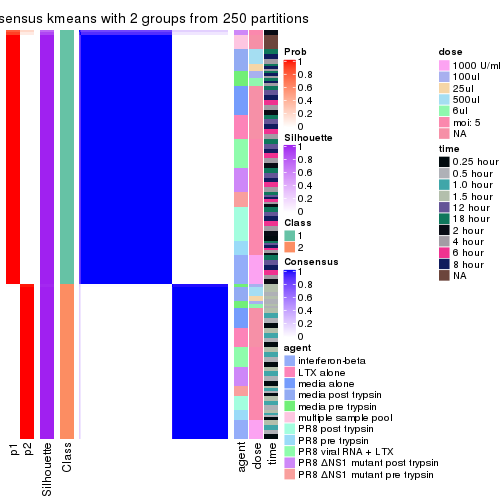
consensus_heatmap(res, k = 3)
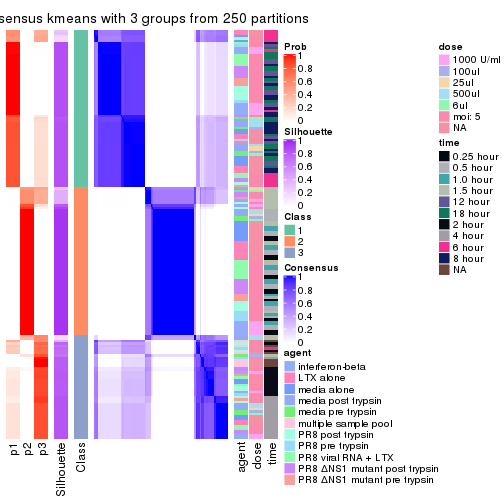
consensus_heatmap(res, k = 4)
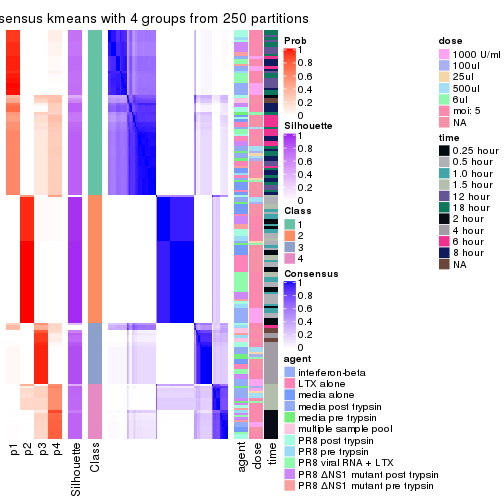
consensus_heatmap(res, k = 5)
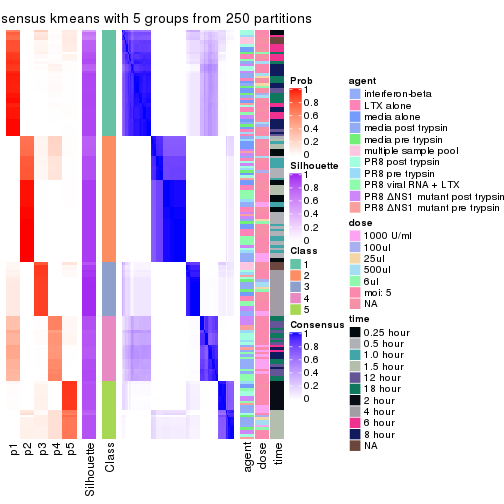
consensus_heatmap(res, k = 6)
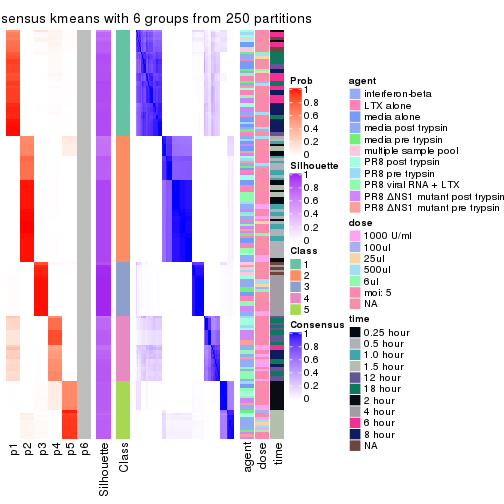
Heatmaps for the membership of samples in all partitions to see how consistent they are:
membership_heatmap(res, k = 2)
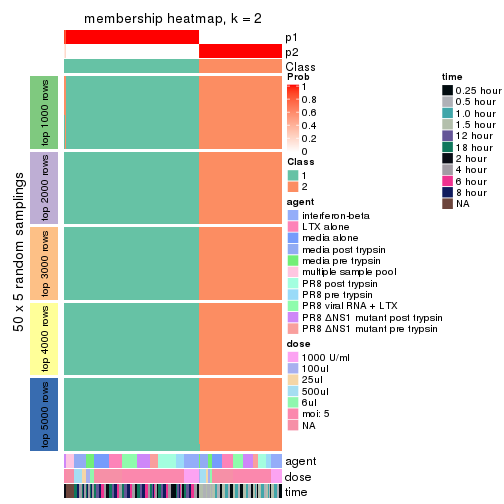
membership_heatmap(res, k = 3)
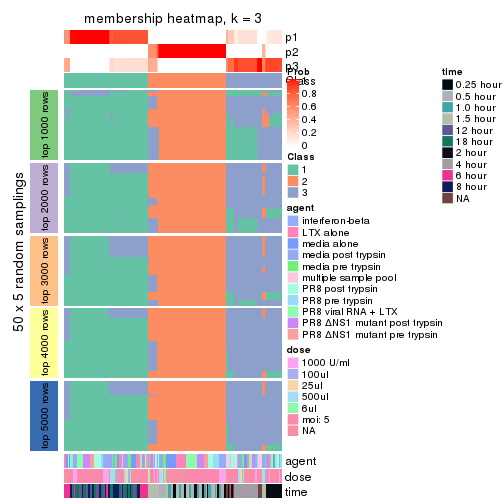
membership_heatmap(res, k = 4)
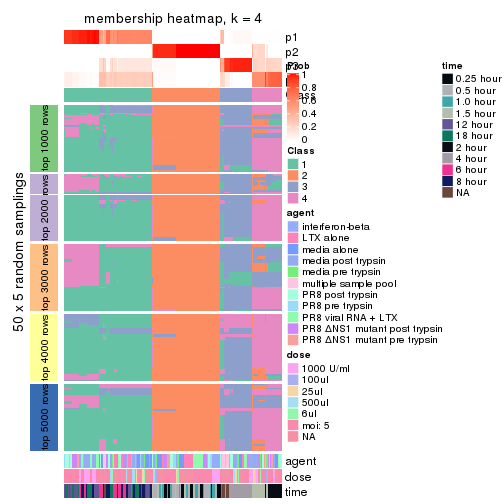
membership_heatmap(res, k = 5)
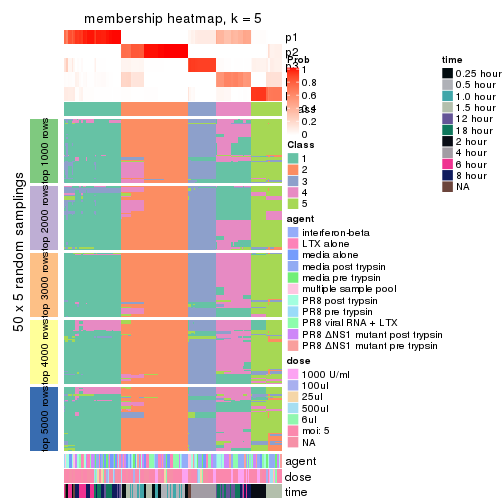
membership_heatmap(res, k = 6)
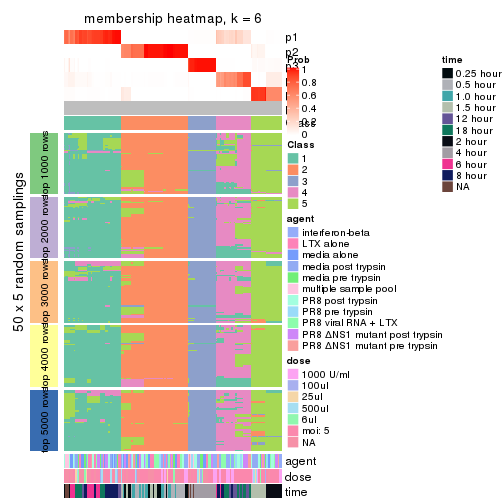
As soon as we have had the classes for columns, we can look for signatures which are significantly different between classes which can be candidate marks for certain classes. Following are the heatmaps for signatures.
Signature heatmaps where rows are scaled:
get_signatures(res, k = 2)
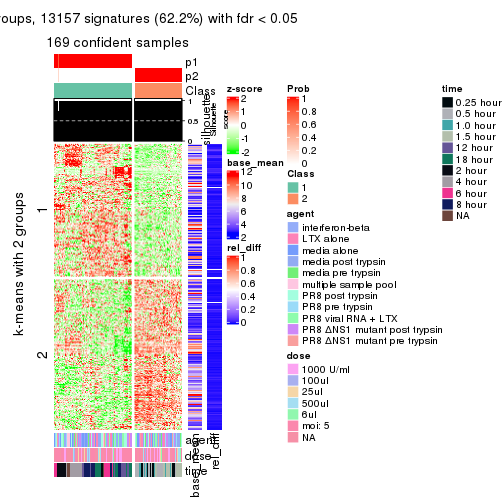
get_signatures(res, k = 3)
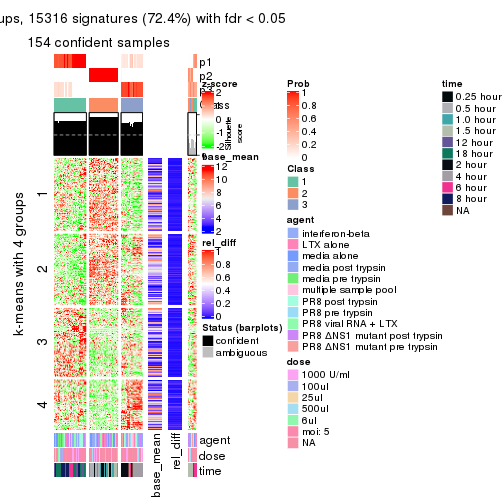
get_signatures(res, k = 4)
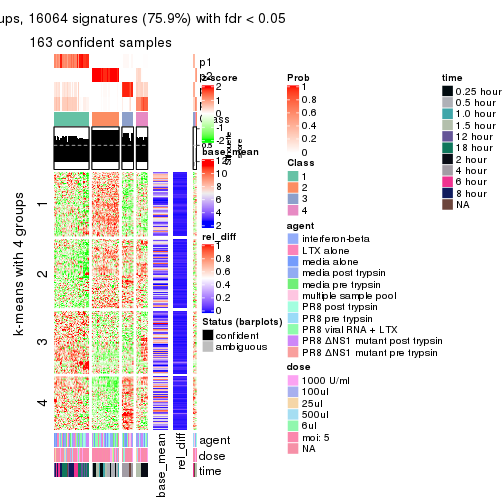
get_signatures(res, k = 5)
#> Error in mat[ceiling(1:nr/h_ratio), ceiling(1:nc/w_ratio), drop = FALSE]: subscript out of bounds
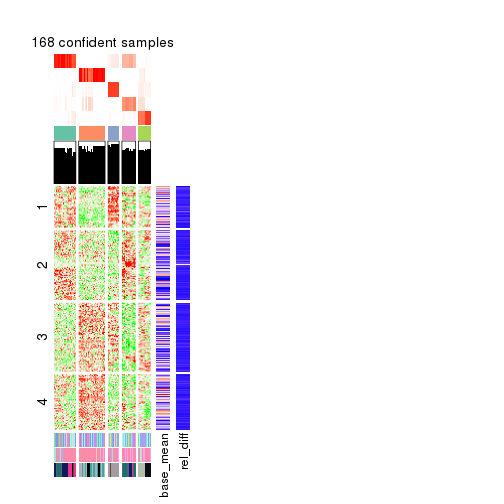
get_signatures(res, k = 6)
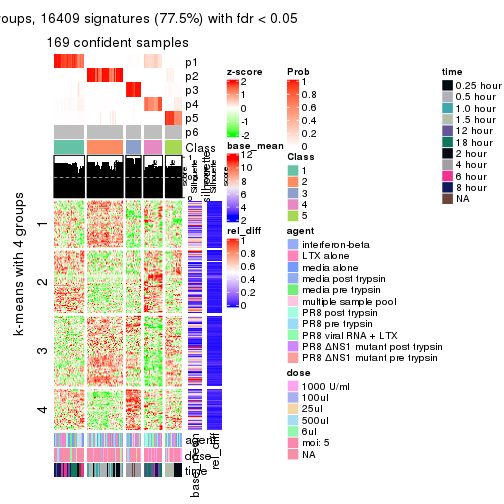
Signature heatmaps where rows are not scaled:
get_signatures(res, k = 2, scale_rows = FALSE)
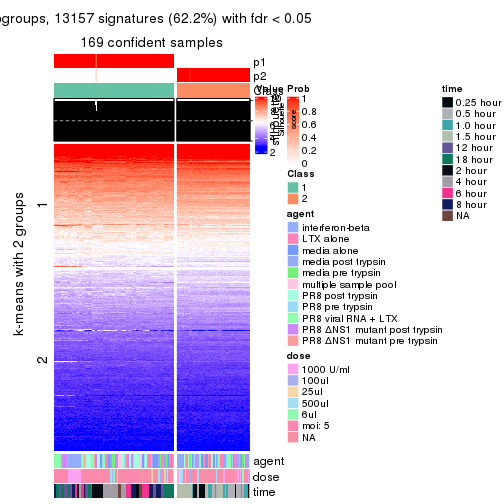
get_signatures(res, k = 3, scale_rows = FALSE)
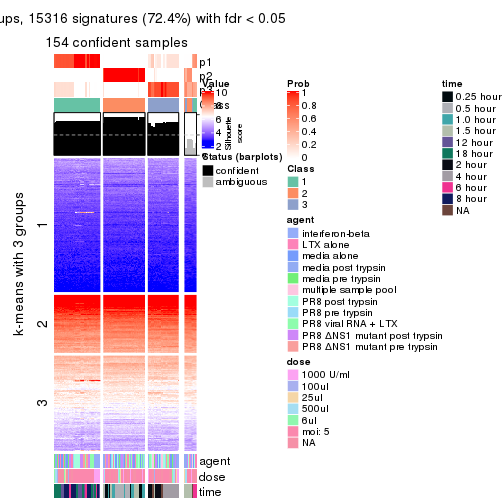
get_signatures(res, k = 4, scale_rows = FALSE)
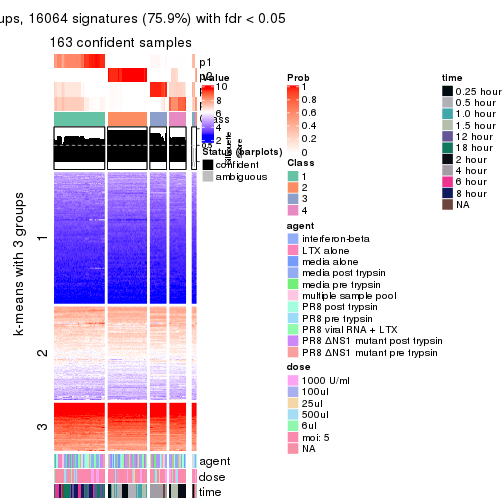
get_signatures(res, k = 5, scale_rows = FALSE)
#> Error in mat[ceiling(1:nr/h_ratio), ceiling(1:nc/w_ratio), drop = FALSE]: subscript out of bounds
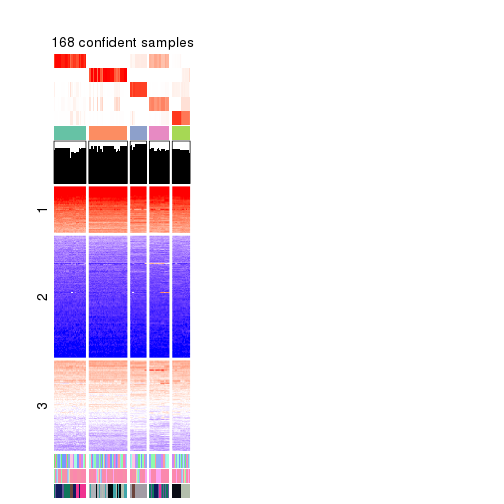
get_signatures(res, k = 6, scale_rows = FALSE)
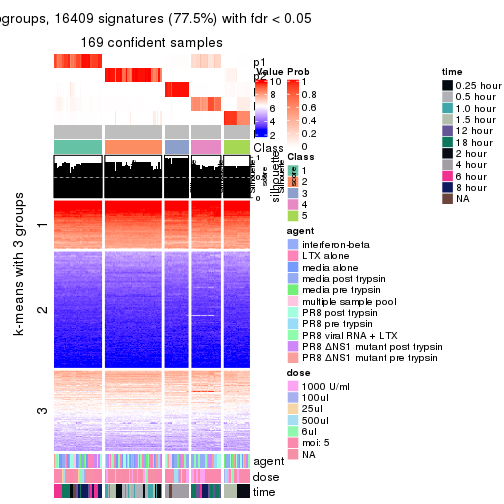
Compare the overlap of signatures from different k:
compare_signatures(res)
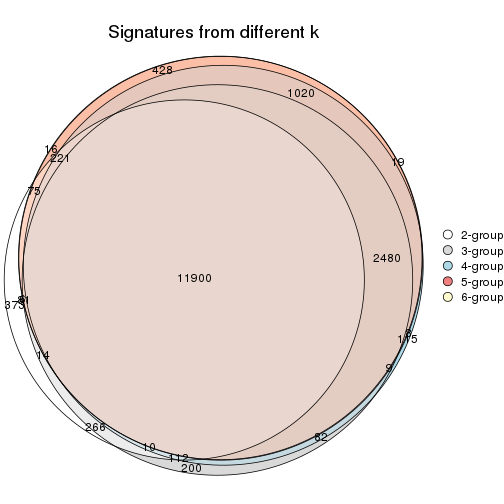
get_signature() returns a data frame invisibly. TO get the list of signatures, the function
call should be assigned to a variable explicitly. In following code, if plot argument is set
to FALSE, no heatmap is plotted while only the differential analysis is performed.
# code only for demonstration
tb = get_signature(res, k = ..., plot = FALSE)
An example of the output of tb is:
#> which_row fdr mean_1 mean_2 scaled_mean_1 scaled_mean_2 km
#> 1 38 0.042760348 8.373488 9.131774 -0.5533452 0.5164555 1
#> 2 40 0.018707592 7.106213 8.469186 -0.6173731 0.5762149 1
#> 3 55 0.019134737 10.221463 11.207825 -0.6159697 0.5749050 1
#> 4 59 0.006059896 5.921854 7.869574 -0.6899429 0.6439467 1
#> 5 60 0.018055526 8.928898 10.211722 -0.6204761 0.5791110 1
#> 6 98 0.009384629 15.714769 14.887706 0.6635654 -0.6193277 2
...
The columns in tb are:
which_row: row indices corresponding to the input matrix.fdr: FDR for the differential test. mean_x: The mean value in group x.scaled_mean_x: The mean value in group x after rows are scaled.km: Row groups if k-means clustering is applied to rows.UMAP plot which shows how samples are separated.
dimension_reduction(res, k = 2, method = "UMAP")
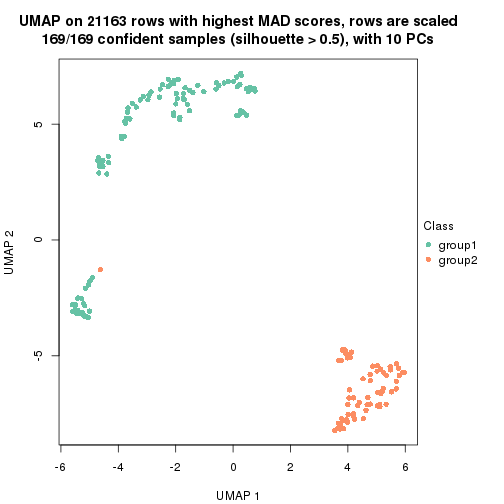
dimension_reduction(res, k = 3, method = "UMAP")
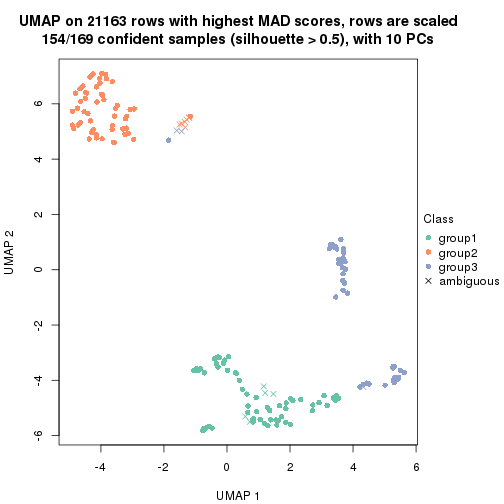
dimension_reduction(res, k = 4, method = "UMAP")
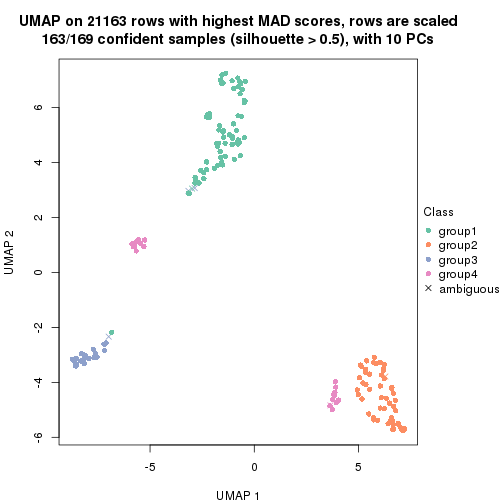
dimension_reduction(res, k = 5, method = "UMAP")
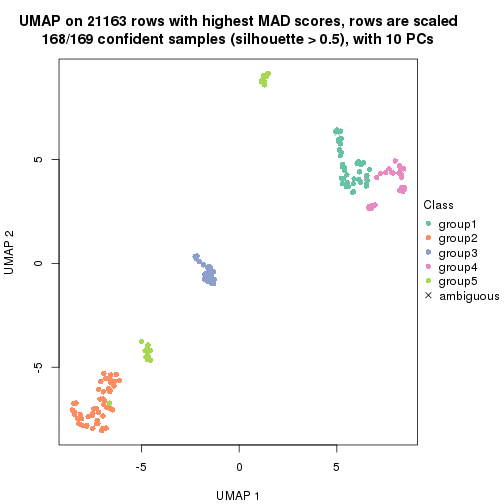
dimension_reduction(res, k = 6, method = "UMAP")
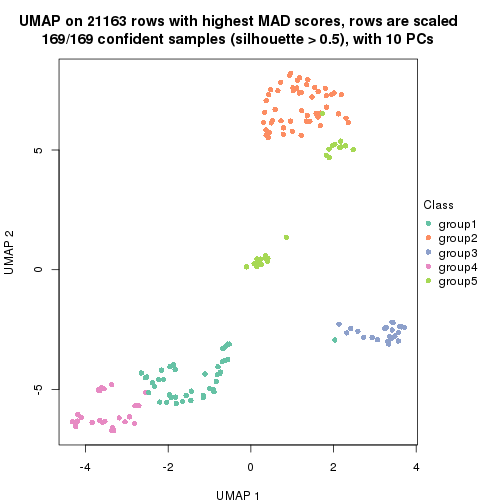
Following heatmap shows how subgroups are split when increasing k:
collect_classes(res)
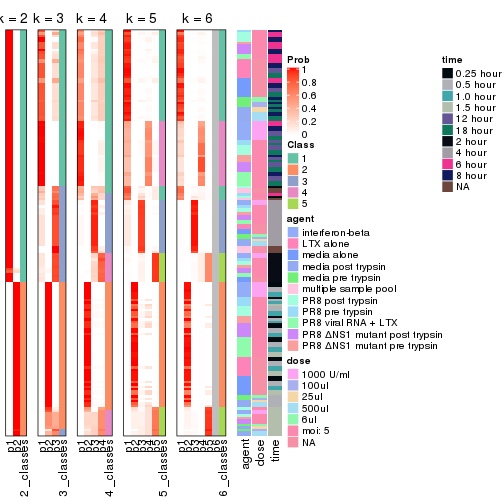
Test correlation between subgroups and known annotations. If the known annotation is numeric, one-way ANOVA test is applied, and if the known annotation is discrete, chi-squared contingency table test is applied.
test_to_known_factors(res)
#> n agent(p) dose(p) time(p) k
#> MAD:kmeans 169 0.9069 0.99995 1.43e-29 2
#> MAD:kmeans 154 0.4257 0.99486 1.03e-48 3
#> MAD:kmeans 163 0.8924 0.99148 4.01e-73 4
#> MAD:kmeans 168 0.0293 0.00946 4.90e-75 5
#> MAD:kmeans 169 0.0288 0.01145 9.45e-75 6
If matrix rows can be associated to genes, consider to use functional_enrichment(res,
...) to perform function enrichment for the signature genes. See this vignette for more detailed explanations.
The object with results only for a single top-value method and a single partition method can be extracted as:
res = res_list["MAD", "skmeans"]
# you can also extract it by
# res = res_list["MAD:skmeans"]
A summary of res and all the functions that can be applied to it:
res
#> A 'ConsensusPartition' object with k = 2, 3, 4, 5, 6.
#> On a matrix with 21163 rows and 169 columns.
#> Top rows (1000, 2000, 3000, 4000, 5000) are extracted by 'MAD' method.
#> Subgroups are detected by 'skmeans' method.
#> Performed in total 1250 partitions by row resampling.
#> Best k for subgroups seems to be 6.
#>
#> Following methods can be applied to this 'ConsensusPartition' object:
#> [1] "cola_report" "collect_classes" "collect_plots"
#> [4] "collect_stats" "colnames" "compare_signatures"
#> [7] "consensus_heatmap" "dimension_reduction" "functional_enrichment"
#> [10] "get_anno_col" "get_anno" "get_classes"
#> [13] "get_consensus" "get_matrix" "get_membership"
#> [16] "get_param" "get_signatures" "get_stats"
#> [19] "is_best_k" "is_stable_k" "membership_heatmap"
#> [22] "ncol" "nrow" "plot_ecdf"
#> [25] "rownames" "select_partition_number" "show"
#> [28] "suggest_best_k" "test_to_known_factors"
collect_plots() function collects all the plots made from res for all k (number of partitions)
into one single page to provide an easy and fast comparison between different k.
collect_plots(res)
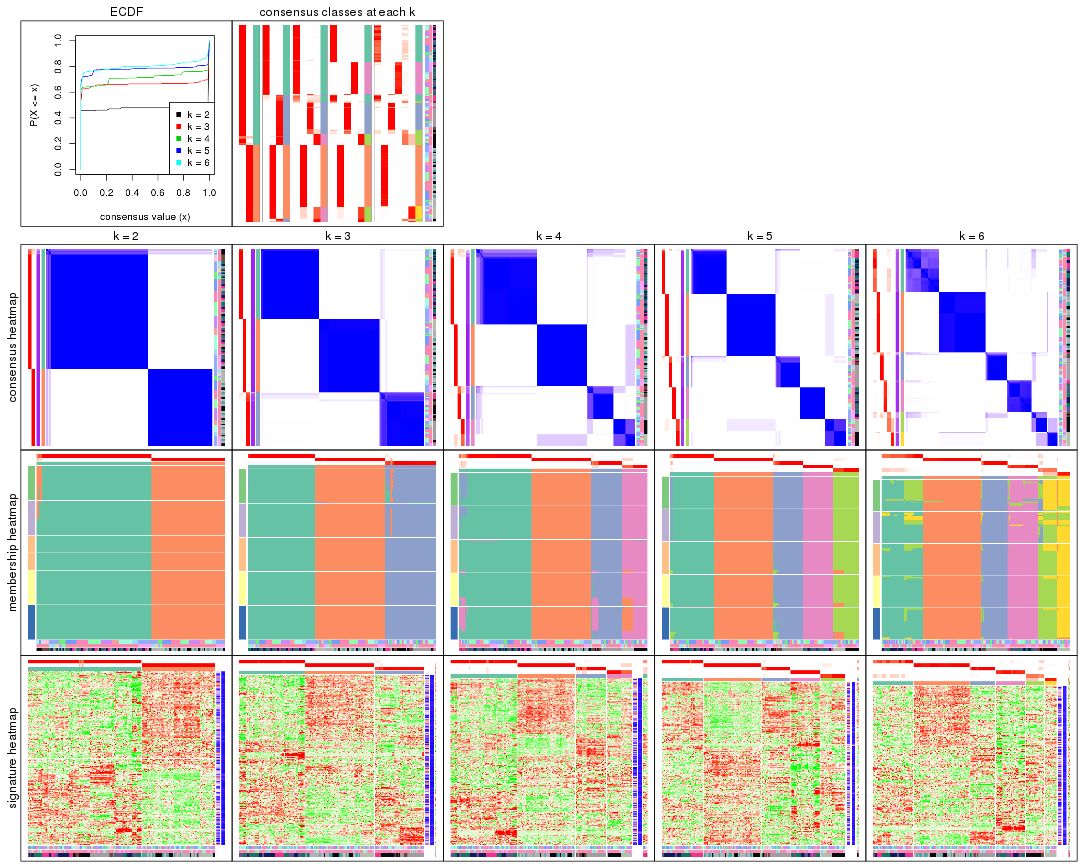
The plots are:
k and the heatmap of
predicted classes for each k.k.k.k.All the plots in panels can be made by individual functions and they are plotted later in this section.
select_partition_number() produces several plots showing different
statistics for choosing “optimized” k. There are following statistics:
k;k, the area increased is defined as \(A_k - A_{k-1}\).The detailed explanations of these statistics can be found in the cola vignette.
Generally speaking, lower PAC score, higher mean silhouette score or higher
concordance corresponds to better partition. Rand index and Jaccard index
measure how similar the current partition is compared to partition with k-1.
If they are too similar, we won't accept k is better than k-1.
select_partition_number(res)
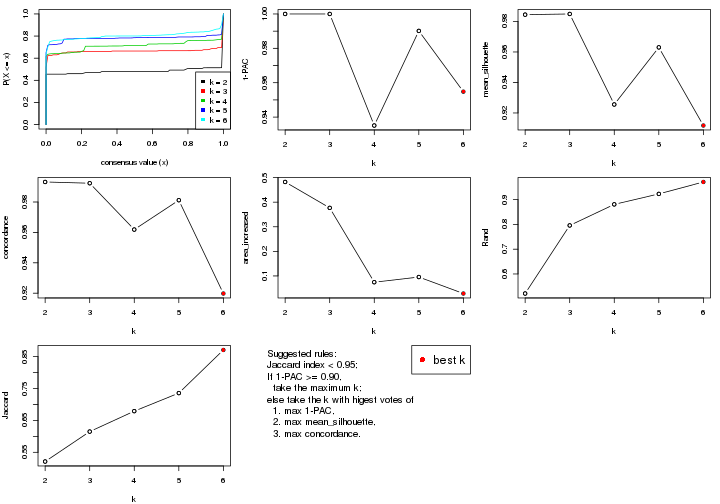
The numeric values for all these statistics can be obtained by get_stats().
get_stats(res)
#> k 1-PAC mean_silhouette concordance area_increased Rand Jaccard
#> 2 2 1.000 0.984 0.993 0.4820 0.521 0.521
#> 3 3 1.000 0.985 0.992 0.3767 0.796 0.615
#> 4 4 0.935 0.926 0.962 0.0745 0.881 0.679
#> 5 5 0.990 0.963 0.981 0.0956 0.923 0.736
#> 6 6 0.955 0.912 0.920 0.0285 0.971 0.871
suggest_best_k() suggests the best \(k\) based on these statistics. The rules are as follows:
suggest_best_k(res)
#> [1] 6
#> attr(,"optional")
#> [1] 2 3 4 5
There is also optional best \(k\) = 2 3 4 5 that is worth to check.
Following shows the table of the partitions (You need to click the show/hide
code output link to see it). The membership matrix (columns with name p*)
is inferred by
clue::cl_consensus()
function with the SE method. Basically the value in the membership matrix
represents the probability to belong to a certain group. The finall class
label for an item is determined with the group with highest probability it
belongs to.
In get_classes() function, the entropy is calculated from the membership
matrix and the silhouette score is calculated from the consensus matrix.
cbind(get_classes(res, k = 2), get_membership(res, k = 2))
#> class entropy silhouette p1 p2
#> GSM528681 2 0.000 1.000 0.000 1.000
#> GSM528682 2 0.000 1.000 0.000 1.000
#> GSM528683 2 0.000 1.000 0.000 1.000
#> GSM528684 2 0.000 1.000 0.000 1.000
#> GSM528687 2 0.000 1.000 0.000 1.000
#> GSM528688 2 0.000 1.000 0.000 1.000
#> GSM528685 2 0.000 1.000 0.000 1.000
#> GSM528686 2 0.000 1.000 0.000 1.000
#> GSM528693 1 0.000 0.989 1.000 0.000
#> GSM528694 1 0.000 0.989 1.000 0.000
#> GSM528695 1 0.000 0.989 1.000 0.000
#> GSM528696 1 0.000 0.989 1.000 0.000
#> GSM528697 1 0.000 0.989 1.000 0.000
#> GSM528698 1 0.000 0.989 1.000 0.000
#> GSM528699 1 0.000 0.989 1.000 0.000
#> GSM528700 1 0.000 0.989 1.000 0.000
#> GSM528689 1 0.000 0.989 1.000 0.000
#> GSM528690 1 0.000 0.989 1.000 0.000
#> GSM528691 1 0.000 0.989 1.000 0.000
#> GSM528692 1 0.000 0.989 1.000 0.000
#> GSM528779 2 0.000 1.000 0.000 1.000
#> GSM528780 2 0.000 1.000 0.000 1.000
#> GSM528782 2 0.000 1.000 0.000 1.000
#> GSM528781 2 0.000 1.000 0.000 1.000
#> GSM528785 1 0.891 0.570 0.692 0.308
#> GSM528786 1 0.000 0.989 1.000 0.000
#> GSM528787 1 0.000 0.989 1.000 0.000
#> GSM528788 1 0.000 0.989 1.000 0.000
#> GSM528783 1 0.000 0.989 1.000 0.000
#> GSM528784 1 0.000 0.989 1.000 0.000
#> GSM528759 1 0.000 0.989 1.000 0.000
#> GSM528760 1 0.000 0.989 1.000 0.000
#> GSM528761 2 0.000 1.000 0.000 1.000
#> GSM528762 2 0.000 1.000 0.000 1.000
#> GSM528765 2 0.000 1.000 0.000 1.000
#> GSM528766 2 0.000 1.000 0.000 1.000
#> GSM528763 2 0.000 1.000 0.000 1.000
#> GSM528764 2 0.000 1.000 0.000 1.000
#> GSM528771 1 0.891 0.570 0.692 0.308
#> GSM528772 1 0.753 0.732 0.784 0.216
#> GSM528773 1 0.000 0.989 1.000 0.000
#> GSM528774 1 0.000 0.989 1.000 0.000
#> GSM528775 1 0.000 0.989 1.000 0.000
#> GSM528776 1 0.000 0.989 1.000 0.000
#> GSM528777 1 0.000 0.989 1.000 0.000
#> GSM528778 1 0.000 0.989 1.000 0.000
#> GSM528767 1 0.000 0.989 1.000 0.000
#> GSM528768 1 0.000 0.989 1.000 0.000
#> GSM528769 1 0.000 0.989 1.000 0.000
#> GSM528770 1 0.000 0.989 1.000 0.000
#> GSM528671 2 0.000 1.000 0.000 1.000
#> GSM528672 2 0.000 1.000 0.000 1.000
#> GSM528674 2 0.000 1.000 0.000 1.000
#> GSM528673 2 0.000 1.000 0.000 1.000
#> GSM528677 1 0.000 0.989 1.000 0.000
#> GSM528678 1 0.000 0.989 1.000 0.000
#> GSM528679 1 0.000 0.989 1.000 0.000
#> GSM528680 1 0.000 0.989 1.000 0.000
#> GSM528675 1 0.000 0.989 1.000 0.000
#> GSM528676 1 0.000 0.989 1.000 0.000
#> GSM528651 2 0.000 1.000 0.000 1.000
#> GSM528652 2 0.000 1.000 0.000 1.000
#> GSM528653 2 0.000 1.000 0.000 1.000
#> GSM528654 2 0.000 1.000 0.000 1.000
#> GSM528657 2 0.000 1.000 0.000 1.000
#> GSM528658 2 0.000 1.000 0.000 1.000
#> GSM528655 2 0.000 1.000 0.000 1.000
#> GSM528656 2 0.000 1.000 0.000 1.000
#> GSM528663 2 0.000 1.000 0.000 1.000
#> GSM528664 2 0.000 1.000 0.000 1.000
#> GSM528665 1 0.000 0.989 1.000 0.000
#> GSM528666 1 0.000 0.989 1.000 0.000
#> GSM528667 1 0.000 0.989 1.000 0.000
#> GSM528668 1 0.000 0.989 1.000 0.000
#> GSM528669 1 0.000 0.989 1.000 0.000
#> GSM528670 1 0.000 0.989 1.000 0.000
#> GSM528659 1 0.000 0.989 1.000 0.000
#> GSM528660 1 0.000 0.989 1.000 0.000
#> GSM528661 1 0.000 0.989 1.000 0.000
#> GSM528662 1 0.000 0.989 1.000 0.000
#> GSM528701 2 0.000 1.000 0.000 1.000
#> GSM528702 2 0.000 1.000 0.000 1.000
#> GSM528703 2 0.000 1.000 0.000 1.000
#> GSM528704 2 0.000 1.000 0.000 1.000
#> GSM528707 2 0.000 1.000 0.000 1.000
#> GSM528708 2 0.000 1.000 0.000 1.000
#> GSM528705 2 0.000 1.000 0.000 1.000
#> GSM528706 2 0.000 1.000 0.000 1.000
#> GSM528713 1 0.000 0.989 1.000 0.000
#> GSM528714 1 0.000 0.989 1.000 0.000
#> GSM528715 1 0.000 0.989 1.000 0.000
#> GSM528716 1 0.000 0.989 1.000 0.000
#> GSM528717 1 0.000 0.989 1.000 0.000
#> GSM528718 1 0.000 0.989 1.000 0.000
#> GSM528719 1 0.000 0.989 1.000 0.000
#> GSM528720 1 0.000 0.989 1.000 0.000
#> GSM528709 1 0.000 0.989 1.000 0.000
#> GSM528710 1 0.000 0.989 1.000 0.000
#> GSM528711 1 0.000 0.989 1.000 0.000
#> GSM528712 1 0.000 0.989 1.000 0.000
#> GSM528721 2 0.000 1.000 0.000 1.000
#> GSM528722 2 0.000 1.000 0.000 1.000
#> GSM528723 2 0.000 1.000 0.000 1.000
#> GSM528724 2 0.000 1.000 0.000 1.000
#> GSM528727 2 0.000 1.000 0.000 1.000
#> GSM528728 2 0.000 1.000 0.000 1.000
#> GSM528725 2 0.000 1.000 0.000 1.000
#> GSM528726 2 0.000 1.000 0.000 1.000
#> GSM528733 1 0.000 0.989 1.000 0.000
#> GSM528734 1 0.000 0.989 1.000 0.000
#> GSM528735 1 0.000 0.989 1.000 0.000
#> GSM528736 1 0.000 0.989 1.000 0.000
#> GSM528737 1 0.000 0.989 1.000 0.000
#> GSM528738 1 0.000 0.989 1.000 0.000
#> GSM528729 1 0.000 0.989 1.000 0.000
#> GSM528730 1 0.000 0.989 1.000 0.000
#> GSM528731 1 0.000 0.989 1.000 0.000
#> GSM528732 1 0.000 0.989 1.000 0.000
#> GSM528739 2 0.000 1.000 0.000 1.000
#> GSM528740 2 0.000 1.000 0.000 1.000
#> GSM528741 2 0.000 1.000 0.000 1.000
#> GSM528742 2 0.000 1.000 0.000 1.000
#> GSM528745 2 0.000 1.000 0.000 1.000
#> GSM528746 2 0.000 1.000 0.000 1.000
#> GSM528743 2 0.000 1.000 0.000 1.000
#> GSM528744 2 0.000 1.000 0.000 1.000
#> GSM528751 1 0.730 0.750 0.796 0.204
#> GSM528752 1 0.518 0.867 0.884 0.116
#> GSM528753 1 0.000 0.989 1.000 0.000
#> GSM528754 1 0.000 0.989 1.000 0.000
#> GSM528755 1 0.000 0.989 1.000 0.000
#> GSM528756 1 0.000 0.989 1.000 0.000
#> GSM528757 1 0.000 0.989 1.000 0.000
#> GSM528758 1 0.000 0.989 1.000 0.000
#> GSM528747 1 0.000 0.989 1.000 0.000
#> GSM528748 1 0.000 0.989 1.000 0.000
#> GSM528749 1 0.000 0.989 1.000 0.000
#> GSM528750 1 0.000 0.989 1.000 0.000
#> GSM528640 2 0.000 1.000 0.000 1.000
#> GSM528641 2 0.000 1.000 0.000 1.000
#> GSM528643 1 0.000 0.989 1.000 0.000
#> GSM528644 1 0.000 0.989 1.000 0.000
#> GSM528642 1 0.000 0.989 1.000 0.000
#> GSM528620 2 0.000 1.000 0.000 1.000
#> GSM528621 2 0.000 1.000 0.000 1.000
#> GSM528623 1 0.000 0.989 1.000 0.000
#> GSM528624 1 0.000 0.989 1.000 0.000
#> GSM528622 1 0.000 0.989 1.000 0.000
#> GSM528625 2 0.000 1.000 0.000 1.000
#> GSM528626 2 0.000 1.000 0.000 1.000
#> GSM528628 1 0.000 0.989 1.000 0.000
#> GSM528629 1 0.000 0.989 1.000 0.000
#> GSM528627 1 0.000 0.989 1.000 0.000
#> GSM528630 2 0.000 1.000 0.000 1.000
#> GSM528631 2 0.000 1.000 0.000 1.000
#> GSM528632 2 0.000 1.000 0.000 1.000
#> GSM528633 2 0.000 1.000 0.000 1.000
#> GSM528636 1 0.000 0.989 1.000 0.000
#> GSM528637 1 0.000 0.989 1.000 0.000
#> GSM528638 1 0.000 0.989 1.000 0.000
#> GSM528639 1 0.000 0.989 1.000 0.000
#> GSM528634 1 0.000 0.989 1.000 0.000
#> GSM528635 1 0.000 0.989 1.000 0.000
#> GSM528645 1 0.000 0.989 1.000 0.000
#> GSM528646 1 0.000 0.989 1.000 0.000
#> GSM528647 1 0.000 0.989 1.000 0.000
#> GSM528648 1 0.000 0.989 1.000 0.000
#> GSM528649 1 0.000 0.989 1.000 0.000
#> GSM528650 1 0.000 0.989 1.000 0.000
cbind(get_classes(res, k = 3), get_membership(res, k = 3))
#> class entropy silhouette p1 p2 p3
#> GSM528681 2 0.0000 0.999 0.000 1.000 0.000
#> GSM528682 2 0.0000 0.999 0.000 1.000 0.000
#> GSM528683 2 0.0000 0.999 0.000 1.000 0.000
#> GSM528684 2 0.0000 0.999 0.000 1.000 0.000
#> GSM528687 2 0.0000 0.999 0.000 1.000 0.000
#> GSM528688 2 0.0000 0.999 0.000 1.000 0.000
#> GSM528685 2 0.0237 0.997 0.000 0.996 0.004
#> GSM528686 2 0.0237 0.997 0.000 0.996 0.004
#> GSM528693 3 0.0000 0.974 0.000 0.000 1.000
#> GSM528694 3 0.0000 0.974 0.000 0.000 1.000
#> GSM528695 3 0.0237 0.975 0.004 0.000 0.996
#> GSM528696 3 0.0237 0.975 0.004 0.000 0.996
#> GSM528697 1 0.0000 0.999 1.000 0.000 0.000
#> GSM528698 1 0.0000 0.999 1.000 0.000 0.000
#> GSM528699 1 0.0000 0.999 1.000 0.000 0.000
#> GSM528700 1 0.0000 0.999 1.000 0.000 0.000
#> GSM528689 1 0.0000 0.999 1.000 0.000 0.000
#> GSM528690 1 0.0000 0.999 1.000 0.000 0.000
#> GSM528691 1 0.0000 0.999 1.000 0.000 0.000
#> GSM528692 1 0.0000 0.999 1.000 0.000 0.000
#> GSM528779 2 0.0000 0.999 0.000 1.000 0.000
#> GSM528780 2 0.0000 0.999 0.000 1.000 0.000
#> GSM528782 2 0.0000 0.999 0.000 1.000 0.000
#> GSM528781 2 0.0000 0.999 0.000 1.000 0.000
#> GSM528785 3 0.3267 0.865 0.000 0.116 0.884
#> GSM528786 3 0.0000 0.974 0.000 0.000 1.000
#> GSM528787 3 0.0237 0.975 0.004 0.000 0.996
#> GSM528788 1 0.0000 0.999 1.000 0.000 0.000
#> GSM528783 1 0.0000 0.999 1.000 0.000 0.000
#> GSM528784 1 0.0000 0.999 1.000 0.000 0.000
#> GSM528759 3 0.0237 0.975 0.004 0.000 0.996
#> GSM528760 3 0.0237 0.975 0.004 0.000 0.996
#> GSM528761 2 0.0000 0.999 0.000 1.000 0.000
#> GSM528762 2 0.0000 0.999 0.000 1.000 0.000
#> GSM528765 2 0.0000 0.999 0.000 1.000 0.000
#> GSM528766 2 0.0000 0.999 0.000 1.000 0.000
#> GSM528763 2 0.0000 0.999 0.000 1.000 0.000
#> GSM528764 2 0.0237 0.997 0.000 0.996 0.004
#> GSM528771 3 0.0000 0.974 0.000 0.000 1.000
#> GSM528772 3 0.0000 0.974 0.000 0.000 1.000
#> GSM528773 3 0.0237 0.975 0.004 0.000 0.996
#> GSM528774 3 0.0237 0.975 0.004 0.000 0.996
#> GSM528775 3 0.2537 0.913 0.080 0.000 0.920
#> GSM528776 1 0.0000 0.999 1.000 0.000 0.000
#> GSM528777 1 0.0000 0.999 1.000 0.000 0.000
#> GSM528778 1 0.0000 0.999 1.000 0.000 0.000
#> GSM528767 1 0.0000 0.999 1.000 0.000 0.000
#> GSM528768 1 0.0000 0.999 1.000 0.000 0.000
#> GSM528769 1 0.0000 0.999 1.000 0.000 0.000
#> GSM528770 1 0.0000 0.999 1.000 0.000 0.000
#> GSM528671 2 0.0000 0.999 0.000 1.000 0.000
#> GSM528672 2 0.0000 0.999 0.000 1.000 0.000
#> GSM528674 2 0.0000 0.999 0.000 1.000 0.000
#> GSM528673 2 0.0237 0.997 0.000 0.996 0.004
#> GSM528677 3 0.0000 0.974 0.000 0.000 1.000
#> GSM528678 3 0.0237 0.975 0.004 0.000 0.996
#> GSM528679 1 0.0000 0.999 1.000 0.000 0.000
#> GSM528680 1 0.0000 0.999 1.000 0.000 0.000
#> GSM528675 1 0.0000 0.999 1.000 0.000 0.000
#> GSM528676 1 0.0000 0.999 1.000 0.000 0.000
#> GSM528651 2 0.0000 0.999 0.000 1.000 0.000
#> GSM528652 2 0.0000 0.999 0.000 1.000 0.000
#> GSM528653 2 0.0000 0.999 0.000 1.000 0.000
#> GSM528654 2 0.0000 0.999 0.000 1.000 0.000
#> GSM528657 2 0.0000 0.999 0.000 1.000 0.000
#> GSM528658 2 0.0000 0.999 0.000 1.000 0.000
#> GSM528655 2 0.0237 0.997 0.000 0.996 0.004
#> GSM528656 2 0.0237 0.997 0.000 0.996 0.004
#> GSM528663 3 0.0000 0.974 0.000 0.000 1.000
#> GSM528664 3 0.2165 0.920 0.000 0.064 0.936
#> GSM528665 3 0.0237 0.975 0.004 0.000 0.996
#> GSM528666 3 0.0237 0.975 0.004 0.000 0.996
#> GSM528667 1 0.0000 0.999 1.000 0.000 0.000
#> GSM528668 1 0.0000 0.999 1.000 0.000 0.000
#> GSM528669 1 0.0000 0.999 1.000 0.000 0.000
#> GSM528670 1 0.0000 0.999 1.000 0.000 0.000
#> GSM528659 1 0.0000 0.999 1.000 0.000 0.000
#> GSM528660 1 0.0000 0.999 1.000 0.000 0.000
#> GSM528661 1 0.0000 0.999 1.000 0.000 0.000
#> GSM528662 1 0.0000 0.999 1.000 0.000 0.000
#> GSM528701 2 0.0000 0.999 0.000 1.000 0.000
#> GSM528702 2 0.0000 0.999 0.000 1.000 0.000
#> GSM528703 2 0.0000 0.999 0.000 1.000 0.000
#> GSM528704 2 0.0000 0.999 0.000 1.000 0.000
#> GSM528707 2 0.0000 0.999 0.000 1.000 0.000
#> GSM528708 2 0.0000 0.999 0.000 1.000 0.000
#> GSM528705 2 0.0000 0.999 0.000 1.000 0.000
#> GSM528706 2 0.0000 0.999 0.000 1.000 0.000
#> GSM528713 3 0.0000 0.974 0.000 0.000 1.000
#> GSM528714 3 0.0000 0.974 0.000 0.000 1.000
#> GSM528715 3 0.0237 0.975 0.004 0.000 0.996
#> GSM528716 3 0.0237 0.975 0.004 0.000 0.996
#> GSM528717 1 0.0000 0.999 1.000 0.000 0.000
#> GSM528718 1 0.0000 0.999 1.000 0.000 0.000
#> GSM528719 1 0.0000 0.999 1.000 0.000 0.000
#> GSM528720 1 0.0000 0.999 1.000 0.000 0.000
#> GSM528709 1 0.0000 0.999 1.000 0.000 0.000
#> GSM528710 1 0.0000 0.999 1.000 0.000 0.000
#> GSM528711 1 0.0000 0.999 1.000 0.000 0.000
#> GSM528712 1 0.0000 0.999 1.000 0.000 0.000
#> GSM528721 2 0.0000 0.999 0.000 1.000 0.000
#> GSM528722 2 0.0000 0.999 0.000 1.000 0.000
#> GSM528723 2 0.0000 0.999 0.000 1.000 0.000
#> GSM528724 2 0.0000 0.999 0.000 1.000 0.000
#> GSM528727 2 0.0000 0.999 0.000 1.000 0.000
#> GSM528728 2 0.0000 0.999 0.000 1.000 0.000
#> GSM528725 2 0.0000 0.999 0.000 1.000 0.000
#> GSM528726 2 0.0000 0.999 0.000 1.000 0.000
#> GSM528733 3 0.0237 0.975 0.004 0.000 0.996
#> GSM528734 3 0.0237 0.975 0.004 0.000 0.996
#> GSM528735 3 0.4178 0.807 0.172 0.000 0.828
#> GSM528736 3 0.3340 0.871 0.120 0.000 0.880
#> GSM528737 1 0.0000 0.999 1.000 0.000 0.000
#> GSM528738 1 0.0000 0.999 1.000 0.000 0.000
#> GSM528729 1 0.0000 0.999 1.000 0.000 0.000
#> GSM528730 1 0.0000 0.999 1.000 0.000 0.000
#> GSM528731 1 0.0000 0.999 1.000 0.000 0.000
#> GSM528732 1 0.0000 0.999 1.000 0.000 0.000
#> GSM528739 2 0.0000 0.999 0.000 1.000 0.000
#> GSM528740 2 0.0000 0.999 0.000 1.000 0.000
#> GSM528741 2 0.0000 0.999 0.000 1.000 0.000
#> GSM528742 2 0.0000 0.999 0.000 1.000 0.000
#> GSM528745 2 0.0000 0.999 0.000 1.000 0.000
#> GSM528746 2 0.0000 0.999 0.000 1.000 0.000
#> GSM528743 2 0.0000 0.999 0.000 1.000 0.000
#> GSM528744 2 0.0000 0.999 0.000 1.000 0.000
#> GSM528751 3 0.0000 0.974 0.000 0.000 1.000
#> GSM528752 3 0.0000 0.974 0.000 0.000 1.000
#> GSM528753 3 0.0237 0.975 0.004 0.000 0.996
#> GSM528754 3 0.0237 0.975 0.004 0.000 0.996
#> GSM528755 3 0.2625 0.909 0.084 0.000 0.916
#> GSM528756 3 0.2537 0.913 0.080 0.000 0.920
#> GSM528757 1 0.0000 0.999 1.000 0.000 0.000
#> GSM528758 1 0.0000 0.999 1.000 0.000 0.000
#> GSM528747 1 0.0000 0.999 1.000 0.000 0.000
#> GSM528748 1 0.0000 0.999 1.000 0.000 0.000
#> GSM528749 1 0.0000 0.999 1.000 0.000 0.000
#> GSM528750 1 0.0000 0.999 1.000 0.000 0.000
#> GSM528640 2 0.0000 0.999 0.000 1.000 0.000
#> GSM528641 2 0.0237 0.997 0.000 0.996 0.004
#> GSM528643 3 0.0237 0.975 0.004 0.000 0.996
#> GSM528644 1 0.0000 0.999 1.000 0.000 0.000
#> GSM528642 1 0.1411 0.963 0.964 0.000 0.036
#> GSM528620 2 0.0000 0.999 0.000 1.000 0.000
#> GSM528621 3 0.5988 0.434 0.000 0.368 0.632
#> GSM528623 3 0.0237 0.975 0.004 0.000 0.996
#> GSM528624 1 0.0000 0.999 1.000 0.000 0.000
#> GSM528622 1 0.0000 0.999 1.000 0.000 0.000
#> GSM528625 2 0.0000 0.999 0.000 1.000 0.000
#> GSM528626 2 0.0237 0.997 0.000 0.996 0.004
#> GSM528628 3 0.0237 0.975 0.004 0.000 0.996
#> GSM528629 1 0.0000 0.999 1.000 0.000 0.000
#> GSM528627 1 0.0000 0.999 1.000 0.000 0.000
#> GSM528630 2 0.0000 0.999 0.000 1.000 0.000
#> GSM528631 2 0.0000 0.999 0.000 1.000 0.000
#> GSM528632 2 0.0237 0.997 0.000 0.996 0.004
#> GSM528633 2 0.0237 0.997 0.000 0.996 0.004
#> GSM528636 3 0.0237 0.975 0.004 0.000 0.996
#> GSM528637 3 0.0237 0.975 0.004 0.000 0.996
#> GSM528638 1 0.0000 0.999 1.000 0.000 0.000
#> GSM528639 1 0.0000 0.999 1.000 0.000 0.000
#> GSM528634 1 0.1411 0.963 0.964 0.000 0.036
#> GSM528635 1 0.0000 0.999 1.000 0.000 0.000
#> GSM528645 3 0.0000 0.974 0.000 0.000 1.000
#> GSM528646 3 0.0000 0.974 0.000 0.000 1.000
#> GSM528647 3 0.0000 0.974 0.000 0.000 1.000
#> GSM528648 3 0.0237 0.975 0.004 0.000 0.996
#> GSM528649 3 0.0237 0.975 0.004 0.000 0.996
#> GSM528650 3 0.0237 0.975 0.004 0.000 0.996
cbind(get_classes(res, k = 4), get_membership(res, k = 4))
#> class entropy silhouette p1 p2 p3 p4
#> GSM528681 2 0.0000 1.00000 0.000 1.000 0.000 0.000
#> GSM528682 2 0.0000 1.00000 0.000 1.000 0.000 0.000
#> GSM528683 2 0.0000 1.00000 0.000 1.000 0.000 0.000
#> GSM528684 2 0.0000 1.00000 0.000 1.000 0.000 0.000
#> GSM528687 2 0.0000 1.00000 0.000 1.000 0.000 0.000
#> GSM528688 2 0.0000 1.00000 0.000 1.000 0.000 0.000
#> GSM528685 4 0.3764 0.81841 0.000 0.216 0.000 0.784
#> GSM528686 4 0.3764 0.81841 0.000 0.216 0.000 0.784
#> GSM528693 4 0.0188 0.85676 0.000 0.000 0.004 0.996
#> GSM528694 4 0.0188 0.85676 0.000 0.000 0.004 0.996
#> GSM528695 3 0.0000 0.94300 0.000 0.000 1.000 0.000
#> GSM528696 3 0.0000 0.94300 0.000 0.000 1.000 0.000
#> GSM528697 1 0.0188 0.95791 0.996 0.000 0.000 0.004
#> GSM528698 1 0.0188 0.95791 0.996 0.000 0.000 0.004
#> GSM528699 1 0.0188 0.95791 0.996 0.000 0.000 0.004
#> GSM528700 1 0.0188 0.95791 0.996 0.000 0.000 0.004
#> GSM528689 1 0.0188 0.95791 0.996 0.000 0.000 0.004
#> GSM528690 1 0.0188 0.95791 0.996 0.000 0.000 0.004
#> GSM528691 1 0.0188 0.95791 0.996 0.000 0.000 0.004
#> GSM528692 1 0.1109 0.93537 0.968 0.000 0.028 0.004
#> GSM528779 2 0.0000 1.00000 0.000 1.000 0.000 0.000
#> GSM528780 2 0.0000 1.00000 0.000 1.000 0.000 0.000
#> GSM528782 2 0.0000 1.00000 0.000 1.000 0.000 0.000
#> GSM528781 2 0.0000 1.00000 0.000 1.000 0.000 0.000
#> GSM528785 4 0.0188 0.85676 0.000 0.000 0.004 0.996
#> GSM528786 3 0.0000 0.94300 0.000 0.000 1.000 0.000
#> GSM528787 3 0.3726 0.79041 0.000 0.000 0.788 0.212
#> GSM528788 1 0.0000 0.95816 1.000 0.000 0.000 0.000
#> GSM528783 1 0.0188 0.95791 0.996 0.000 0.000 0.004
#> GSM528784 1 0.0188 0.95791 0.996 0.000 0.000 0.004
#> GSM528759 3 0.3726 0.79041 0.000 0.000 0.788 0.212
#> GSM528760 3 0.3726 0.79041 0.000 0.000 0.788 0.212
#> GSM528761 2 0.0000 1.00000 0.000 1.000 0.000 0.000
#> GSM528762 2 0.0000 1.00000 0.000 1.000 0.000 0.000
#> GSM528765 2 0.0000 1.00000 0.000 1.000 0.000 0.000
#> GSM528766 2 0.0000 1.00000 0.000 1.000 0.000 0.000
#> GSM528763 2 0.0000 1.00000 0.000 1.000 0.000 0.000
#> GSM528764 4 0.3801 0.81430 0.000 0.220 0.000 0.780
#> GSM528771 4 0.0188 0.85676 0.000 0.000 0.004 0.996
#> GSM528772 4 0.0188 0.85676 0.000 0.000 0.004 0.996
#> GSM528773 3 0.0000 0.94300 0.000 0.000 1.000 0.000
#> GSM528774 3 0.0000 0.94300 0.000 0.000 1.000 0.000
#> GSM528775 1 0.7065 0.40838 0.572 0.000 0.216 0.212
#> GSM528776 1 0.0000 0.95816 1.000 0.000 0.000 0.000
#> GSM528777 1 0.0000 0.95816 1.000 0.000 0.000 0.000
#> GSM528778 1 0.0000 0.95816 1.000 0.000 0.000 0.000
#> GSM528767 1 0.0188 0.95791 0.996 0.000 0.000 0.004
#> GSM528768 1 0.0188 0.95791 0.996 0.000 0.000 0.004
#> GSM528769 1 0.0188 0.95791 0.996 0.000 0.000 0.004
#> GSM528770 1 0.0188 0.95791 0.996 0.000 0.000 0.004
#> GSM528671 2 0.0000 1.00000 0.000 1.000 0.000 0.000
#> GSM528672 2 0.0000 1.00000 0.000 1.000 0.000 0.000
#> GSM528674 2 0.0000 1.00000 0.000 1.000 0.000 0.000
#> GSM528673 4 0.3764 0.81841 0.000 0.216 0.000 0.784
#> GSM528677 4 0.0188 0.85676 0.000 0.000 0.004 0.996
#> GSM528678 3 0.0000 0.94300 0.000 0.000 1.000 0.000
#> GSM528679 1 0.0000 0.95816 1.000 0.000 0.000 0.000
#> GSM528680 1 0.0188 0.95791 0.996 0.000 0.000 0.004
#> GSM528675 1 0.0188 0.95791 0.996 0.000 0.000 0.004
#> GSM528676 1 0.0188 0.95791 0.996 0.000 0.000 0.004
#> GSM528651 2 0.0000 1.00000 0.000 1.000 0.000 0.000
#> GSM528652 2 0.0000 1.00000 0.000 1.000 0.000 0.000
#> GSM528653 2 0.0000 1.00000 0.000 1.000 0.000 0.000
#> GSM528654 2 0.0000 1.00000 0.000 1.000 0.000 0.000
#> GSM528657 2 0.0000 1.00000 0.000 1.000 0.000 0.000
#> GSM528658 2 0.0000 1.00000 0.000 1.000 0.000 0.000
#> GSM528655 4 0.3764 0.81841 0.000 0.216 0.000 0.784
#> GSM528656 4 0.3764 0.81841 0.000 0.216 0.000 0.784
#> GSM528663 4 0.0188 0.85676 0.000 0.000 0.004 0.996
#> GSM528664 4 0.0188 0.85676 0.000 0.000 0.004 0.996
#> GSM528665 3 0.0000 0.94300 0.000 0.000 1.000 0.000
#> GSM528666 3 0.0000 0.94300 0.000 0.000 1.000 0.000
#> GSM528667 1 0.0000 0.95816 1.000 0.000 0.000 0.000
#> GSM528668 1 0.0000 0.95816 1.000 0.000 0.000 0.000
#> GSM528669 1 0.0000 0.95816 1.000 0.000 0.000 0.000
#> GSM528670 1 0.0000 0.95816 1.000 0.000 0.000 0.000
#> GSM528659 1 0.0188 0.95791 0.996 0.000 0.000 0.004
#> GSM528660 1 0.0188 0.95791 0.996 0.000 0.000 0.004
#> GSM528661 1 0.0188 0.95791 0.996 0.000 0.000 0.004
#> GSM528662 1 0.0188 0.95791 0.996 0.000 0.000 0.004
#> GSM528701 2 0.0000 1.00000 0.000 1.000 0.000 0.000
#> GSM528702 2 0.0000 1.00000 0.000 1.000 0.000 0.000
#> GSM528703 2 0.0000 1.00000 0.000 1.000 0.000 0.000
#> GSM528704 2 0.0000 1.00000 0.000 1.000 0.000 0.000
#> GSM528707 2 0.0000 1.00000 0.000 1.000 0.000 0.000
#> GSM528708 2 0.0000 1.00000 0.000 1.000 0.000 0.000
#> GSM528705 2 0.0000 1.00000 0.000 1.000 0.000 0.000
#> GSM528706 2 0.0000 1.00000 0.000 1.000 0.000 0.000
#> GSM528713 4 0.0188 0.85676 0.000 0.000 0.004 0.996
#> GSM528714 4 0.0188 0.85676 0.000 0.000 0.004 0.996
#> GSM528715 3 0.0000 0.94300 0.000 0.000 1.000 0.000
#> GSM528716 3 0.0000 0.94300 0.000 0.000 1.000 0.000
#> GSM528717 1 0.0000 0.95816 1.000 0.000 0.000 0.000
#> GSM528718 1 0.1389 0.91854 0.952 0.000 0.000 0.048
#> GSM528719 1 0.0188 0.95791 0.996 0.000 0.000 0.004
#> GSM528720 1 0.0188 0.95791 0.996 0.000 0.000 0.004
#> GSM528709 1 0.0188 0.95791 0.996 0.000 0.000 0.004
#> GSM528710 1 0.0188 0.95791 0.996 0.000 0.000 0.004
#> GSM528711 1 0.0188 0.95791 0.996 0.000 0.000 0.004
#> GSM528712 1 0.0188 0.95791 0.996 0.000 0.000 0.004
#> GSM528721 2 0.0000 1.00000 0.000 1.000 0.000 0.000
#> GSM528722 2 0.0000 1.00000 0.000 1.000 0.000 0.000
#> GSM528723 2 0.0000 1.00000 0.000 1.000 0.000 0.000
#> GSM528724 2 0.0000 1.00000 0.000 1.000 0.000 0.000
#> GSM528727 2 0.0000 1.00000 0.000 1.000 0.000 0.000
#> GSM528728 2 0.0000 1.00000 0.000 1.000 0.000 0.000
#> GSM528725 2 0.0000 1.00000 0.000 1.000 0.000 0.000
#> GSM528726 2 0.0000 1.00000 0.000 1.000 0.000 0.000
#> GSM528733 3 0.0000 0.94300 0.000 0.000 1.000 0.000
#> GSM528734 3 0.0000 0.94300 0.000 0.000 1.000 0.000
#> GSM528735 1 0.4791 0.74985 0.784 0.000 0.080 0.136
#> GSM528736 1 0.5582 0.67367 0.728 0.000 0.136 0.136
#> GSM528737 1 0.0000 0.95816 1.000 0.000 0.000 0.000
#> GSM528738 1 0.0000 0.95816 1.000 0.000 0.000 0.000
#> GSM528729 1 0.0000 0.95816 1.000 0.000 0.000 0.000
#> GSM528730 1 0.0000 0.95816 1.000 0.000 0.000 0.000
#> GSM528731 1 0.0000 0.95816 1.000 0.000 0.000 0.000
#> GSM528732 1 0.0000 0.95816 1.000 0.000 0.000 0.000
#> GSM528739 2 0.0000 1.00000 0.000 1.000 0.000 0.000
#> GSM528740 2 0.0000 1.00000 0.000 1.000 0.000 0.000
#> GSM528741 2 0.0000 1.00000 0.000 1.000 0.000 0.000
#> GSM528742 2 0.0000 1.00000 0.000 1.000 0.000 0.000
#> GSM528745 2 0.0000 1.00000 0.000 1.000 0.000 0.000
#> GSM528746 2 0.0000 1.00000 0.000 1.000 0.000 0.000
#> GSM528743 2 0.0000 1.00000 0.000 1.000 0.000 0.000
#> GSM528744 2 0.0000 1.00000 0.000 1.000 0.000 0.000
#> GSM528751 4 0.0188 0.85676 0.000 0.000 0.004 0.996
#> GSM528752 4 0.0188 0.85676 0.000 0.000 0.004 0.996
#> GSM528753 3 0.0000 0.94300 0.000 0.000 1.000 0.000
#> GSM528754 3 0.0000 0.94300 0.000 0.000 1.000 0.000
#> GSM528755 1 0.7065 0.40838 0.572 0.000 0.216 0.212
#> GSM528756 1 0.7065 0.40838 0.572 0.000 0.216 0.212
#> GSM528757 1 0.0000 0.95816 1.000 0.000 0.000 0.000
#> GSM528758 1 0.0000 0.95816 1.000 0.000 0.000 0.000
#> GSM528747 1 0.0000 0.95816 1.000 0.000 0.000 0.000
#> GSM528748 1 0.0000 0.95816 1.000 0.000 0.000 0.000
#> GSM528749 1 0.0000 0.95816 1.000 0.000 0.000 0.000
#> GSM528750 1 0.0000 0.95816 1.000 0.000 0.000 0.000
#> GSM528640 2 0.0000 1.00000 0.000 1.000 0.000 0.000
#> GSM528641 4 0.3764 0.81841 0.000 0.216 0.000 0.784
#> GSM528643 3 0.0000 0.94300 0.000 0.000 1.000 0.000
#> GSM528644 1 0.0000 0.95816 1.000 0.000 0.000 0.000
#> GSM528642 3 0.2216 0.85113 0.092 0.000 0.908 0.000
#> GSM528620 2 0.0000 1.00000 0.000 1.000 0.000 0.000
#> GSM528621 4 0.0188 0.85676 0.000 0.000 0.004 0.996
#> GSM528623 3 0.0000 0.94300 0.000 0.000 1.000 0.000
#> GSM528624 1 0.0000 0.95816 1.000 0.000 0.000 0.000
#> GSM528622 1 0.0000 0.95816 1.000 0.000 0.000 0.000
#> GSM528625 2 0.0000 1.00000 0.000 1.000 0.000 0.000
#> GSM528626 4 0.3764 0.81841 0.000 0.216 0.000 0.784
#> GSM528628 3 0.0000 0.94300 0.000 0.000 1.000 0.000
#> GSM528629 1 0.0000 0.95816 1.000 0.000 0.000 0.000
#> GSM528627 1 0.0000 0.95816 1.000 0.000 0.000 0.000
#> GSM528630 2 0.0000 1.00000 0.000 1.000 0.000 0.000
#> GSM528631 2 0.0000 1.00000 0.000 1.000 0.000 0.000
#> GSM528632 4 0.4175 0.81888 0.000 0.200 0.016 0.784
#> GSM528633 4 0.4175 0.81888 0.000 0.200 0.016 0.784
#> GSM528636 3 0.0000 0.94300 0.000 0.000 1.000 0.000
#> GSM528637 3 0.0000 0.94300 0.000 0.000 1.000 0.000
#> GSM528638 1 0.0000 0.95816 1.000 0.000 0.000 0.000
#> GSM528639 1 0.0000 0.95816 1.000 0.000 0.000 0.000
#> GSM528634 1 0.3688 0.72811 0.792 0.000 0.208 0.000
#> GSM528635 1 0.0000 0.95816 1.000 0.000 0.000 0.000
#> GSM528645 3 0.0000 0.94300 0.000 0.000 1.000 0.000
#> GSM528646 3 0.0000 0.94300 0.000 0.000 1.000 0.000
#> GSM528647 3 0.3528 0.80784 0.000 0.000 0.808 0.192
#> GSM528648 3 0.6555 0.59380 0.156 0.000 0.632 0.212
#> GSM528649 3 0.3726 0.79041 0.000 0.000 0.788 0.212
#> GSM528650 1 0.7634 0.00308 0.436 0.000 0.352 0.212
cbind(get_classes(res, k = 5), get_membership(res, k = 5))
#> class entropy silhouette p1 p2 p3 p4 p5
#> GSM528681 2 0.0000 0.9999 0.000 1.000 0.000 0.000 0.000
#> GSM528682 2 0.0000 0.9999 0.000 1.000 0.000 0.000 0.000
#> GSM528683 2 0.0000 0.9999 0.000 1.000 0.000 0.000 0.000
#> GSM528684 2 0.0000 0.9999 0.000 1.000 0.000 0.000 0.000
#> GSM528687 2 0.0000 0.9999 0.000 1.000 0.000 0.000 0.000
#> GSM528688 2 0.0000 0.9999 0.000 1.000 0.000 0.000 0.000
#> GSM528685 5 0.1965 0.9204 0.000 0.096 0.000 0.000 0.904
#> GSM528686 5 0.1965 0.9204 0.000 0.096 0.000 0.000 0.904
#> GSM528693 5 0.0162 0.9406 0.004 0.000 0.000 0.000 0.996
#> GSM528694 5 0.0162 0.9406 0.004 0.000 0.000 0.000 0.996
#> GSM528695 3 0.0000 0.9536 0.000 0.000 1.000 0.000 0.000
#> GSM528696 3 0.0000 0.9536 0.000 0.000 1.000 0.000 0.000
#> GSM528697 4 0.0000 1.0000 0.000 0.000 0.000 1.000 0.000
#> GSM528698 4 0.0000 1.0000 0.000 0.000 0.000 1.000 0.000
#> GSM528699 4 0.0000 1.0000 0.000 0.000 0.000 1.000 0.000
#> GSM528700 4 0.0000 1.0000 0.000 0.000 0.000 1.000 0.000
#> GSM528689 4 0.0000 1.0000 0.000 0.000 0.000 1.000 0.000
#> GSM528690 4 0.0000 1.0000 0.000 0.000 0.000 1.000 0.000
#> GSM528691 4 0.0000 1.0000 0.000 0.000 0.000 1.000 0.000
#> GSM528692 4 0.0000 1.0000 0.000 0.000 0.000 1.000 0.000
#> GSM528779 2 0.0000 0.9999 0.000 1.000 0.000 0.000 0.000
#> GSM528780 2 0.0000 0.9999 0.000 1.000 0.000 0.000 0.000
#> GSM528782 2 0.0000 0.9999 0.000 1.000 0.000 0.000 0.000
#> GSM528781 2 0.0000 0.9999 0.000 1.000 0.000 0.000 0.000
#> GSM528785 5 0.0162 0.9406 0.004 0.000 0.000 0.000 0.996
#> GSM528786 3 0.0000 0.9536 0.000 0.000 1.000 0.000 0.000
#> GSM528787 3 0.2859 0.8727 0.056 0.000 0.876 0.000 0.068
#> GSM528788 1 0.0162 0.9776 0.996 0.000 0.000 0.004 0.000
#> GSM528783 4 0.0000 1.0000 0.000 0.000 0.000 1.000 0.000
#> GSM528784 4 0.0000 1.0000 0.000 0.000 0.000 1.000 0.000
#> GSM528759 3 0.5815 0.2557 0.396 0.000 0.508 0.000 0.096
#> GSM528760 3 0.3464 0.8390 0.068 0.000 0.836 0.000 0.096
#> GSM528761 2 0.0000 0.9999 0.000 1.000 0.000 0.000 0.000
#> GSM528762 2 0.0000 0.9999 0.000 1.000 0.000 0.000 0.000
#> GSM528765 2 0.0000 0.9999 0.000 1.000 0.000 0.000 0.000
#> GSM528766 2 0.0000 0.9999 0.000 1.000 0.000 0.000 0.000
#> GSM528763 2 0.0162 0.9961 0.000 0.996 0.000 0.000 0.004
#> GSM528764 5 0.1965 0.9204 0.000 0.096 0.000 0.000 0.904
#> GSM528771 5 0.0162 0.9406 0.004 0.000 0.000 0.000 0.996
#> GSM528772 5 0.0162 0.9406 0.004 0.000 0.000 0.000 0.996
#> GSM528773 3 0.0000 0.9536 0.000 0.000 1.000 0.000 0.000
#> GSM528774 3 0.0000 0.9536 0.000 0.000 1.000 0.000 0.000
#> GSM528775 1 0.1082 0.9457 0.964 0.000 0.008 0.000 0.028
#> GSM528776 1 0.0162 0.9776 0.996 0.000 0.000 0.004 0.000
#> GSM528777 1 0.0162 0.9776 0.996 0.000 0.000 0.004 0.000
#> GSM528778 1 0.0162 0.9776 0.996 0.000 0.000 0.004 0.000
#> GSM528767 4 0.0000 1.0000 0.000 0.000 0.000 1.000 0.000
#> GSM528768 4 0.0000 1.0000 0.000 0.000 0.000 1.000 0.000
#> GSM528769 4 0.0000 1.0000 0.000 0.000 0.000 1.000 0.000
#> GSM528770 4 0.0000 1.0000 0.000 0.000 0.000 1.000 0.000
#> GSM528671 2 0.0000 0.9999 0.000 1.000 0.000 0.000 0.000
#> GSM528672 2 0.0000 0.9999 0.000 1.000 0.000 0.000 0.000
#> GSM528674 2 0.0000 0.9999 0.000 1.000 0.000 0.000 0.000
#> GSM528673 5 0.1965 0.9204 0.000 0.096 0.000 0.000 0.904
#> GSM528677 5 0.0162 0.9406 0.004 0.000 0.000 0.000 0.996
#> GSM528678 3 0.0000 0.9536 0.000 0.000 1.000 0.000 0.000
#> GSM528679 1 0.0162 0.9776 0.996 0.000 0.000 0.004 0.000
#> GSM528680 4 0.0000 1.0000 0.000 0.000 0.000 1.000 0.000
#> GSM528675 4 0.0000 1.0000 0.000 0.000 0.000 1.000 0.000
#> GSM528676 4 0.0000 1.0000 0.000 0.000 0.000 1.000 0.000
#> GSM528651 2 0.0000 0.9999 0.000 1.000 0.000 0.000 0.000
#> GSM528652 2 0.0000 0.9999 0.000 1.000 0.000 0.000 0.000
#> GSM528653 2 0.0000 0.9999 0.000 1.000 0.000 0.000 0.000
#> GSM528654 2 0.0000 0.9999 0.000 1.000 0.000 0.000 0.000
#> GSM528657 2 0.0000 0.9999 0.000 1.000 0.000 0.000 0.000
#> GSM528658 2 0.0000 0.9999 0.000 1.000 0.000 0.000 0.000
#> GSM528655 5 0.1965 0.9204 0.000 0.096 0.000 0.000 0.904
#> GSM528656 5 0.1965 0.9204 0.000 0.096 0.000 0.000 0.904
#> GSM528663 5 0.0162 0.9406 0.004 0.000 0.000 0.000 0.996
#> GSM528664 5 0.0162 0.9406 0.004 0.000 0.000 0.000 0.996
#> GSM528665 3 0.0000 0.9536 0.000 0.000 1.000 0.000 0.000
#> GSM528666 3 0.0000 0.9536 0.000 0.000 1.000 0.000 0.000
#> GSM528667 1 0.0162 0.9776 0.996 0.000 0.000 0.004 0.000
#> GSM528668 1 0.0162 0.9776 0.996 0.000 0.000 0.004 0.000
#> GSM528669 1 0.0162 0.9776 0.996 0.000 0.000 0.004 0.000
#> GSM528670 1 0.0162 0.9776 0.996 0.000 0.000 0.004 0.000
#> GSM528659 4 0.0000 1.0000 0.000 0.000 0.000 1.000 0.000
#> GSM528660 4 0.0000 1.0000 0.000 0.000 0.000 1.000 0.000
#> GSM528661 4 0.0000 1.0000 0.000 0.000 0.000 1.000 0.000
#> GSM528662 4 0.0000 1.0000 0.000 0.000 0.000 1.000 0.000
#> GSM528701 2 0.0000 0.9999 0.000 1.000 0.000 0.000 0.000
#> GSM528702 2 0.0000 0.9999 0.000 1.000 0.000 0.000 0.000
#> GSM528703 2 0.0000 0.9999 0.000 1.000 0.000 0.000 0.000
#> GSM528704 2 0.0000 0.9999 0.000 1.000 0.000 0.000 0.000
#> GSM528707 2 0.0000 0.9999 0.000 1.000 0.000 0.000 0.000
#> GSM528708 2 0.0000 0.9999 0.000 1.000 0.000 0.000 0.000
#> GSM528705 2 0.0000 0.9999 0.000 1.000 0.000 0.000 0.000
#> GSM528706 2 0.0000 0.9999 0.000 1.000 0.000 0.000 0.000
#> GSM528713 5 0.0162 0.9406 0.004 0.000 0.000 0.000 0.996
#> GSM528714 5 0.0162 0.9406 0.004 0.000 0.000 0.000 0.996
#> GSM528715 3 0.0000 0.9536 0.000 0.000 1.000 0.000 0.000
#> GSM528716 3 0.0000 0.9536 0.000 0.000 1.000 0.000 0.000
#> GSM528717 1 0.0162 0.9776 0.996 0.000 0.000 0.004 0.000
#> GSM528718 1 0.0000 0.9745 1.000 0.000 0.000 0.000 0.000
#> GSM528719 4 0.0000 1.0000 0.000 0.000 0.000 1.000 0.000
#> GSM528720 4 0.0000 1.0000 0.000 0.000 0.000 1.000 0.000
#> GSM528709 4 0.0000 1.0000 0.000 0.000 0.000 1.000 0.000
#> GSM528710 4 0.0000 1.0000 0.000 0.000 0.000 1.000 0.000
#> GSM528711 4 0.0000 1.0000 0.000 0.000 0.000 1.000 0.000
#> GSM528712 4 0.0000 1.0000 0.000 0.000 0.000 1.000 0.000
#> GSM528721 2 0.0000 0.9999 0.000 1.000 0.000 0.000 0.000
#> GSM528722 2 0.0000 0.9999 0.000 1.000 0.000 0.000 0.000
#> GSM528723 2 0.0000 0.9999 0.000 1.000 0.000 0.000 0.000
#> GSM528724 2 0.0000 0.9999 0.000 1.000 0.000 0.000 0.000
#> GSM528727 2 0.0000 0.9999 0.000 1.000 0.000 0.000 0.000
#> GSM528728 2 0.0000 0.9999 0.000 1.000 0.000 0.000 0.000
#> GSM528725 2 0.0000 0.9999 0.000 1.000 0.000 0.000 0.000
#> GSM528726 2 0.0000 0.9999 0.000 1.000 0.000 0.000 0.000
#> GSM528733 3 0.0000 0.9536 0.000 0.000 1.000 0.000 0.000
#> GSM528734 3 0.0000 0.9536 0.000 0.000 1.000 0.000 0.000
#> GSM528735 1 0.0000 0.9745 1.000 0.000 0.000 0.000 0.000
#> GSM528736 1 0.0000 0.9745 1.000 0.000 0.000 0.000 0.000
#> GSM528737 1 0.0162 0.9776 0.996 0.000 0.000 0.004 0.000
#> GSM528738 1 0.0162 0.9776 0.996 0.000 0.000 0.004 0.000
#> GSM528729 1 0.0162 0.9776 0.996 0.000 0.000 0.004 0.000
#> GSM528730 1 0.0162 0.9776 0.996 0.000 0.000 0.004 0.000
#> GSM528731 1 0.0162 0.9776 0.996 0.000 0.000 0.004 0.000
#> GSM528732 1 0.0162 0.9776 0.996 0.000 0.000 0.004 0.000
#> GSM528739 2 0.0000 0.9999 0.000 1.000 0.000 0.000 0.000
#> GSM528740 2 0.0000 0.9999 0.000 1.000 0.000 0.000 0.000
#> GSM528741 2 0.0000 0.9999 0.000 1.000 0.000 0.000 0.000
#> GSM528742 2 0.0000 0.9999 0.000 1.000 0.000 0.000 0.000
#> GSM528745 2 0.0000 0.9999 0.000 1.000 0.000 0.000 0.000
#> GSM528746 2 0.0000 0.9999 0.000 1.000 0.000 0.000 0.000
#> GSM528743 2 0.0000 0.9999 0.000 1.000 0.000 0.000 0.000
#> GSM528744 2 0.0000 0.9999 0.000 1.000 0.000 0.000 0.000
#> GSM528751 5 0.0162 0.9406 0.004 0.000 0.000 0.000 0.996
#> GSM528752 5 0.0162 0.9406 0.004 0.000 0.000 0.000 0.996
#> GSM528753 3 0.0000 0.9536 0.000 0.000 1.000 0.000 0.000
#> GSM528754 3 0.0000 0.9536 0.000 0.000 1.000 0.000 0.000
#> GSM528755 1 0.0404 0.9657 0.988 0.000 0.000 0.000 0.012
#> GSM528756 1 0.0404 0.9657 0.988 0.000 0.000 0.000 0.012
#> GSM528757 1 0.0162 0.9776 0.996 0.000 0.000 0.004 0.000
#> GSM528758 1 0.0162 0.9776 0.996 0.000 0.000 0.004 0.000
#> GSM528747 1 0.0162 0.9776 0.996 0.000 0.000 0.004 0.000
#> GSM528748 1 0.0162 0.9776 0.996 0.000 0.000 0.004 0.000
#> GSM528749 1 0.0162 0.9776 0.996 0.000 0.000 0.004 0.000
#> GSM528750 1 0.0162 0.9776 0.996 0.000 0.000 0.004 0.000
#> GSM528640 2 0.0000 0.9999 0.000 1.000 0.000 0.000 0.000
#> GSM528641 5 0.1965 0.9204 0.000 0.096 0.000 0.000 0.904
#> GSM528643 3 0.0000 0.9536 0.000 0.000 1.000 0.000 0.000
#> GSM528644 1 0.0162 0.9776 0.996 0.000 0.000 0.004 0.000
#> GSM528642 3 0.2179 0.8592 0.112 0.000 0.888 0.000 0.000
#> GSM528620 2 0.0000 0.9999 0.000 1.000 0.000 0.000 0.000
#> GSM528621 5 0.0000 0.9397 0.000 0.000 0.000 0.000 1.000
#> GSM528623 3 0.0000 0.9536 0.000 0.000 1.000 0.000 0.000
#> GSM528624 1 0.0162 0.9776 0.996 0.000 0.000 0.004 0.000
#> GSM528622 1 0.0162 0.9776 0.996 0.000 0.000 0.004 0.000
#> GSM528625 2 0.0000 0.9999 0.000 1.000 0.000 0.000 0.000
#> GSM528626 5 0.2068 0.9214 0.000 0.092 0.004 0.000 0.904
#> GSM528628 3 0.0000 0.9536 0.000 0.000 1.000 0.000 0.000
#> GSM528629 1 0.0162 0.9776 0.996 0.000 0.000 0.004 0.000
#> GSM528627 1 0.0162 0.9776 0.996 0.000 0.000 0.004 0.000
#> GSM528630 2 0.0000 0.9999 0.000 1.000 0.000 0.000 0.000
#> GSM528631 2 0.0000 0.9999 0.000 1.000 0.000 0.000 0.000
#> GSM528632 5 0.2189 0.9223 0.000 0.084 0.012 0.000 0.904
#> GSM528633 5 0.2189 0.9223 0.000 0.084 0.012 0.000 0.904
#> GSM528636 3 0.0000 0.9536 0.000 0.000 1.000 0.000 0.000
#> GSM528637 3 0.0000 0.9536 0.000 0.000 1.000 0.000 0.000
#> GSM528638 1 0.0162 0.9776 0.996 0.000 0.000 0.004 0.000
#> GSM528639 1 0.0162 0.9776 0.996 0.000 0.000 0.004 0.000
#> GSM528634 1 0.0162 0.9776 0.996 0.000 0.000 0.004 0.000
#> GSM528635 1 0.0162 0.9776 0.996 0.000 0.000 0.004 0.000
#> GSM528645 3 0.0000 0.9536 0.000 0.000 1.000 0.000 0.000
#> GSM528646 3 0.0000 0.9536 0.000 0.000 1.000 0.000 0.000
#> GSM528647 3 0.1478 0.9101 0.000 0.000 0.936 0.000 0.064
#> GSM528648 1 0.5831 0.0507 0.496 0.000 0.408 0.000 0.096
#> GSM528649 3 0.4587 0.7393 0.160 0.000 0.744 0.000 0.096
#> GSM528650 1 0.4698 0.6611 0.732 0.000 0.172 0.000 0.096
cbind(get_classes(res, k = 6), get_membership(res, k = 6))
#> class entropy silhouette p1 p2 p3 p4 p5 p6
#> GSM528681 2 0.0000 0.996 0.000 1.000 0.000 0.000 0.000 0.000
#> GSM528682 2 0.0000 0.996 0.000 1.000 0.000 0.000 0.000 0.000
#> GSM528683 2 0.0000 0.996 0.000 1.000 0.000 0.000 0.000 0.000
#> GSM528684 2 0.0000 0.996 0.000 1.000 0.000 0.000 0.000 0.000
#> GSM528687 2 0.0000 0.996 0.000 1.000 0.000 0.000 0.000 0.000
#> GSM528688 2 0.0000 0.996 0.000 1.000 0.000 0.000 0.000 0.000
#> GSM528685 6 0.0603 0.928 0.000 0.016 0.000 0.000 0.004 0.980
#> GSM528686 6 0.0603 0.928 0.000 0.016 0.000 0.000 0.004 0.980
#> GSM528693 5 0.3446 0.791 0.000 0.000 0.000 0.000 0.692 0.308
#> GSM528694 5 0.3446 0.791 0.000 0.000 0.000 0.000 0.692 0.308
#> GSM528695 3 0.0000 0.963 0.000 0.000 1.000 0.000 0.000 0.000
#> GSM528696 3 0.0000 0.963 0.000 0.000 1.000 0.000 0.000 0.000
#> GSM528697 4 0.1501 0.925 0.076 0.000 0.000 0.924 0.000 0.000
#> GSM528698 4 0.2491 0.812 0.164 0.000 0.000 0.836 0.000 0.000
#> GSM528699 4 0.0458 0.966 0.016 0.000 0.000 0.984 0.000 0.000
#> GSM528700 4 0.0458 0.966 0.016 0.000 0.000 0.984 0.000 0.000
#> GSM528689 4 0.0260 0.968 0.008 0.000 0.000 0.992 0.000 0.000
#> GSM528690 4 0.0260 0.968 0.008 0.000 0.000 0.992 0.000 0.000
#> GSM528691 4 0.0405 0.967 0.008 0.000 0.000 0.988 0.000 0.004
#> GSM528692 4 0.0436 0.966 0.004 0.000 0.004 0.988 0.000 0.004
#> GSM528779 2 0.0000 0.996 0.000 1.000 0.000 0.000 0.000 0.000
#> GSM528780 2 0.0291 0.994 0.000 0.992 0.000 0.004 0.004 0.000
#> GSM528782 2 0.0000 0.996 0.000 1.000 0.000 0.000 0.000 0.000
#> GSM528781 2 0.0436 0.992 0.000 0.988 0.000 0.004 0.004 0.004
#> GSM528785 5 0.3446 0.791 0.000 0.000 0.000 0.000 0.692 0.308
#> GSM528786 3 0.0000 0.963 0.000 0.000 1.000 0.000 0.000 0.000
#> GSM528787 3 0.5780 0.357 0.264 0.000 0.560 0.016 0.160 0.000
#> GSM528788 1 0.2912 0.871 0.784 0.000 0.000 0.000 0.216 0.000
#> GSM528783 4 0.1578 0.959 0.004 0.000 0.000 0.936 0.048 0.012
#> GSM528784 4 0.1152 0.967 0.004 0.000 0.000 0.952 0.044 0.000
#> GSM528759 5 0.5409 0.533 0.188 0.000 0.232 0.000 0.580 0.000
#> GSM528760 5 0.5391 0.523 0.176 0.000 0.244 0.000 0.580 0.000
#> GSM528761 2 0.0436 0.992 0.000 0.988 0.000 0.004 0.004 0.004
#> GSM528762 2 0.0000 0.996 0.000 1.000 0.000 0.000 0.000 0.000
#> GSM528765 2 0.0436 0.992 0.000 0.988 0.000 0.004 0.004 0.004
#> GSM528766 2 0.0291 0.994 0.000 0.992 0.000 0.004 0.004 0.000
#> GSM528763 6 0.3547 0.419 0.000 0.332 0.000 0.000 0.000 0.668
#> GSM528764 6 0.0632 0.920 0.000 0.024 0.000 0.000 0.000 0.976
#> GSM528771 5 0.3446 0.791 0.000 0.000 0.000 0.000 0.692 0.308
#> GSM528772 5 0.3446 0.791 0.000 0.000 0.000 0.000 0.692 0.308
#> GSM528773 3 0.0000 0.963 0.000 0.000 1.000 0.000 0.000 0.000
#> GSM528774 3 0.0000 0.963 0.000 0.000 1.000 0.000 0.000 0.000
#> GSM528775 1 0.2971 0.738 0.832 0.000 0.004 0.020 0.144 0.000
#> GSM528776 1 0.0000 0.854 1.000 0.000 0.000 0.000 0.000 0.000
#> GSM528777 1 0.2883 0.872 0.788 0.000 0.000 0.000 0.212 0.000
#> GSM528778 1 0.2854 0.873 0.792 0.000 0.000 0.000 0.208 0.000
#> GSM528767 4 0.1152 0.967 0.004 0.000 0.000 0.952 0.044 0.000
#> GSM528768 4 0.1152 0.967 0.004 0.000 0.000 0.952 0.044 0.000
#> GSM528769 4 0.1152 0.967 0.004 0.000 0.000 0.952 0.044 0.000
#> GSM528770 4 0.1152 0.967 0.004 0.000 0.000 0.952 0.044 0.000
#> GSM528671 2 0.0436 0.992 0.000 0.988 0.000 0.004 0.004 0.004
#> GSM528672 2 0.0000 0.996 0.000 1.000 0.000 0.000 0.000 0.000
#> GSM528674 2 0.0291 0.994 0.000 0.992 0.000 0.004 0.004 0.000
#> GSM528673 6 0.0603 0.928 0.000 0.016 0.000 0.000 0.004 0.980
#> GSM528677 5 0.3446 0.791 0.000 0.000 0.000 0.000 0.692 0.308
#> GSM528678 3 0.0000 0.963 0.000 0.000 1.000 0.000 0.000 0.000
#> GSM528679 1 0.0713 0.849 0.972 0.000 0.000 0.000 0.028 0.000
#> GSM528680 4 0.0458 0.966 0.016 0.000 0.000 0.984 0.000 0.000
#> GSM528675 4 0.1152 0.967 0.004 0.000 0.000 0.952 0.044 0.000
#> GSM528676 4 0.1152 0.967 0.004 0.000 0.000 0.952 0.044 0.000
#> GSM528651 2 0.0436 0.992 0.000 0.988 0.000 0.004 0.004 0.004
#> GSM528652 2 0.0436 0.992 0.000 0.988 0.000 0.004 0.004 0.004
#> GSM528653 2 0.0000 0.996 0.000 1.000 0.000 0.000 0.000 0.000
#> GSM528654 2 0.0000 0.996 0.000 1.000 0.000 0.000 0.000 0.000
#> GSM528657 2 0.0436 0.992 0.000 0.988 0.000 0.004 0.004 0.004
#> GSM528658 2 0.0000 0.996 0.000 1.000 0.000 0.000 0.000 0.000
#> GSM528655 6 0.0603 0.928 0.000 0.016 0.000 0.000 0.004 0.980
#> GSM528656 6 0.0603 0.928 0.000 0.016 0.000 0.000 0.004 0.980
#> GSM528663 5 0.3446 0.791 0.000 0.000 0.000 0.000 0.692 0.308
#> GSM528664 5 0.3446 0.791 0.000 0.000 0.000 0.000 0.692 0.308
#> GSM528665 3 0.0000 0.963 0.000 0.000 1.000 0.000 0.000 0.000
#> GSM528666 3 0.0000 0.963 0.000 0.000 1.000 0.000 0.000 0.000
#> GSM528667 1 0.0000 0.854 1.000 0.000 0.000 0.000 0.000 0.000
#> GSM528668 1 0.0000 0.854 1.000 0.000 0.000 0.000 0.000 0.000
#> GSM528669 1 0.2664 0.875 0.816 0.000 0.000 0.000 0.184 0.000
#> GSM528670 1 0.2664 0.875 0.816 0.000 0.000 0.000 0.184 0.000
#> GSM528659 4 0.1152 0.967 0.004 0.000 0.000 0.952 0.044 0.000
#> GSM528660 4 0.1152 0.967 0.004 0.000 0.000 0.952 0.044 0.000
#> GSM528661 4 0.1152 0.967 0.004 0.000 0.000 0.952 0.044 0.000
#> GSM528662 4 0.1152 0.967 0.004 0.000 0.000 0.952 0.044 0.000
#> GSM528701 2 0.0000 0.996 0.000 1.000 0.000 0.000 0.000 0.000
#> GSM528702 2 0.0000 0.996 0.000 1.000 0.000 0.000 0.000 0.000
#> GSM528703 2 0.0000 0.996 0.000 1.000 0.000 0.000 0.000 0.000
#> GSM528704 2 0.0000 0.996 0.000 1.000 0.000 0.000 0.000 0.000
#> GSM528707 2 0.0000 0.996 0.000 1.000 0.000 0.000 0.000 0.000
#> GSM528708 2 0.0000 0.996 0.000 1.000 0.000 0.000 0.000 0.000
#> GSM528705 2 0.0000 0.996 0.000 1.000 0.000 0.000 0.000 0.000
#> GSM528706 2 0.0000 0.996 0.000 1.000 0.000 0.000 0.000 0.000
#> GSM528713 5 0.3446 0.791 0.000 0.000 0.000 0.000 0.692 0.308
#> GSM528714 5 0.3446 0.791 0.000 0.000 0.000 0.000 0.692 0.308
#> GSM528715 3 0.0000 0.963 0.000 0.000 1.000 0.000 0.000 0.000
#> GSM528716 3 0.0000 0.963 0.000 0.000 1.000 0.000 0.000 0.000
#> GSM528717 1 0.0260 0.851 0.992 0.000 0.000 0.008 0.000 0.000
#> GSM528718 1 0.1049 0.845 0.960 0.000 0.000 0.008 0.032 0.000
#> GSM528719 4 0.0790 0.957 0.032 0.000 0.000 0.968 0.000 0.000
#> GSM528720 4 0.0937 0.951 0.040 0.000 0.000 0.960 0.000 0.000
#> GSM528709 4 0.0260 0.968 0.008 0.000 0.000 0.992 0.000 0.000
#> GSM528710 4 0.0260 0.968 0.008 0.000 0.000 0.992 0.000 0.000
#> GSM528711 4 0.0260 0.968 0.008 0.000 0.000 0.992 0.000 0.000
#> GSM528712 4 0.0260 0.968 0.008 0.000 0.000 0.992 0.000 0.000
#> GSM528721 2 0.0000 0.996 0.000 1.000 0.000 0.000 0.000 0.000
#> GSM528722 2 0.0000 0.996 0.000 1.000 0.000 0.000 0.000 0.000
#> GSM528723 2 0.0000 0.996 0.000 1.000 0.000 0.000 0.000 0.000
#> GSM528724 2 0.0000 0.996 0.000 1.000 0.000 0.000 0.000 0.000
#> GSM528727 2 0.0436 0.992 0.000 0.988 0.000 0.004 0.004 0.004
#> GSM528728 2 0.0000 0.996 0.000 1.000 0.000 0.000 0.000 0.000
#> GSM528725 2 0.0000 0.996 0.000 1.000 0.000 0.000 0.000 0.000
#> GSM528726 2 0.0000 0.996 0.000 1.000 0.000 0.000 0.000 0.000
#> GSM528733 3 0.0000 0.963 0.000 0.000 1.000 0.000 0.000 0.000
#> GSM528734 3 0.0000 0.963 0.000 0.000 1.000 0.000 0.000 0.000
#> GSM528735 1 0.0000 0.854 1.000 0.000 0.000 0.000 0.000 0.000
#> GSM528736 1 0.0000 0.854 1.000 0.000 0.000 0.000 0.000 0.000
#> GSM528737 1 0.0000 0.854 1.000 0.000 0.000 0.000 0.000 0.000
#> GSM528738 1 0.0000 0.854 1.000 0.000 0.000 0.000 0.000 0.000
#> GSM528729 1 0.2854 0.873 0.792 0.000 0.000 0.000 0.208 0.000
#> GSM528730 1 0.2823 0.873 0.796 0.000 0.000 0.000 0.204 0.000
#> GSM528731 1 0.3606 0.867 0.728 0.000 0.000 0.000 0.256 0.016
#> GSM528732 1 0.3629 0.867 0.724 0.000 0.000 0.000 0.260 0.016
#> GSM528739 2 0.0000 0.996 0.000 1.000 0.000 0.000 0.000 0.000
#> GSM528740 2 0.0000 0.996 0.000 1.000 0.000 0.000 0.000 0.000
#> GSM528741 2 0.0291 0.994 0.000 0.992 0.000 0.004 0.004 0.000
#> GSM528742 2 0.0000 0.996 0.000 1.000 0.000 0.000 0.000 0.000
#> GSM528745 2 0.0436 0.992 0.000 0.988 0.000 0.004 0.004 0.004
#> GSM528746 2 0.0000 0.996 0.000 1.000 0.000 0.000 0.000 0.000
#> GSM528743 2 0.0436 0.992 0.000 0.988 0.000 0.004 0.004 0.004
#> GSM528744 2 0.0436 0.992 0.000 0.988 0.000 0.004 0.004 0.004
#> GSM528751 5 0.3446 0.791 0.000 0.000 0.000 0.000 0.692 0.308
#> GSM528752 5 0.3446 0.791 0.000 0.000 0.000 0.000 0.692 0.308
#> GSM528753 3 0.0000 0.963 0.000 0.000 1.000 0.000 0.000 0.000
#> GSM528754 3 0.0000 0.963 0.000 0.000 1.000 0.000 0.000 0.000
#> GSM528755 1 0.2362 0.762 0.860 0.000 0.004 0.000 0.136 0.000
#> GSM528756 1 0.2362 0.762 0.860 0.000 0.004 0.000 0.136 0.000
#> GSM528757 1 0.2912 0.871 0.784 0.000 0.000 0.000 0.216 0.000
#> GSM528758 1 0.2912 0.871 0.784 0.000 0.000 0.000 0.216 0.000
#> GSM528747 1 0.3970 0.863 0.712 0.000 0.000 0.012 0.260 0.016
#> GSM528748 1 0.3970 0.863 0.712 0.000 0.000 0.012 0.260 0.016
#> GSM528749 1 0.3629 0.867 0.724 0.000 0.000 0.000 0.260 0.016
#> GSM528750 1 0.3606 0.867 0.728 0.000 0.000 0.000 0.256 0.016
#> GSM528640 2 0.0000 0.996 0.000 1.000 0.000 0.000 0.000 0.000
#> GSM528641 6 0.0458 0.928 0.000 0.016 0.000 0.000 0.000 0.984
#> GSM528643 3 0.0000 0.963 0.000 0.000 1.000 0.000 0.000 0.000
#> GSM528644 1 0.3947 0.864 0.716 0.000 0.000 0.012 0.256 0.016
#> GSM528642 3 0.4253 0.693 0.152 0.000 0.768 0.012 0.052 0.016
#> GSM528620 2 0.0436 0.992 0.000 0.988 0.000 0.004 0.004 0.004
#> GSM528621 6 0.0458 0.897 0.000 0.000 0.000 0.000 0.016 0.984
#> GSM528623 3 0.0000 0.963 0.000 0.000 1.000 0.000 0.000 0.000
#> GSM528624 1 0.2854 0.873 0.792 0.000 0.000 0.000 0.208 0.000
#> GSM528622 1 0.1528 0.843 0.936 0.000 0.000 0.000 0.048 0.016
#> GSM528625 2 0.0000 0.996 0.000 1.000 0.000 0.000 0.000 0.000
#> GSM528626 6 0.0458 0.928 0.000 0.016 0.000 0.000 0.000 0.984
#> GSM528628 3 0.0000 0.963 0.000 0.000 1.000 0.000 0.000 0.000
#> GSM528629 1 0.3947 0.864 0.716 0.000 0.000 0.012 0.256 0.016
#> GSM528627 1 0.1528 0.843 0.936 0.000 0.000 0.000 0.048 0.016
#> GSM528630 2 0.0436 0.992 0.000 0.988 0.000 0.004 0.004 0.004
#> GSM528631 2 0.0436 0.992 0.000 0.988 0.000 0.004 0.004 0.004
#> GSM528632 6 0.0458 0.928 0.000 0.016 0.000 0.000 0.000 0.984
#> GSM528633 6 0.0458 0.928 0.000 0.016 0.000 0.000 0.000 0.984
#> GSM528636 3 0.0000 0.963 0.000 0.000 1.000 0.000 0.000 0.000
#> GSM528637 3 0.0000 0.963 0.000 0.000 1.000 0.000 0.000 0.000
#> GSM528638 1 0.2854 0.873 0.792 0.000 0.000 0.000 0.208 0.000
#> GSM528639 1 0.2933 0.874 0.796 0.000 0.000 0.004 0.200 0.000
#> GSM528634 1 0.1672 0.840 0.932 0.000 0.004 0.000 0.048 0.016
#> GSM528635 1 0.1528 0.843 0.936 0.000 0.000 0.000 0.048 0.016
#> GSM528645 3 0.0000 0.963 0.000 0.000 1.000 0.000 0.000 0.000
#> GSM528646 3 0.0000 0.963 0.000 0.000 1.000 0.000 0.000 0.000
#> GSM528647 3 0.1863 0.849 0.000 0.000 0.896 0.000 0.104 0.000
#> GSM528648 5 0.5047 0.569 0.208 0.000 0.156 0.000 0.636 0.000
#> GSM528649 5 0.5409 0.533 0.188 0.000 0.232 0.000 0.580 0.000
#> GSM528650 5 0.4443 0.553 0.276 0.000 0.060 0.000 0.664 0.000
Heatmaps for the consensus matrix. It visualizes the probability of two samples to be in a same group.
consensus_heatmap(res, k = 2)
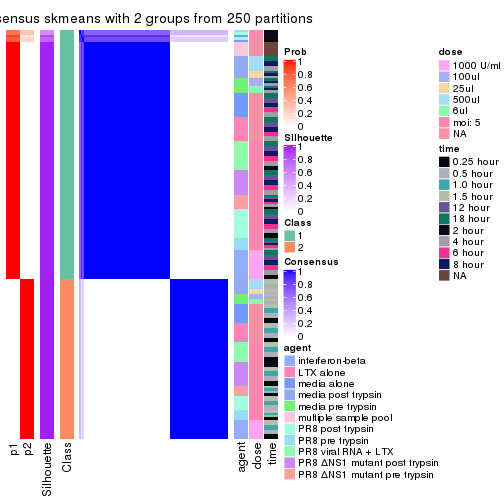
consensus_heatmap(res, k = 3)
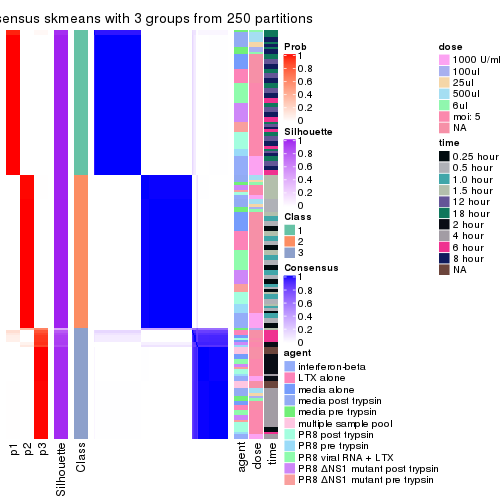
consensus_heatmap(res, k = 4)
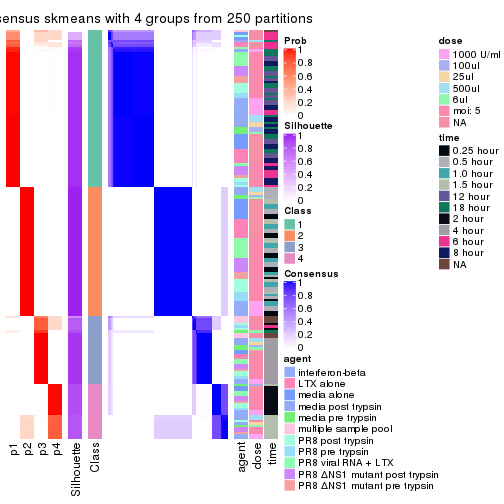
consensus_heatmap(res, k = 5)
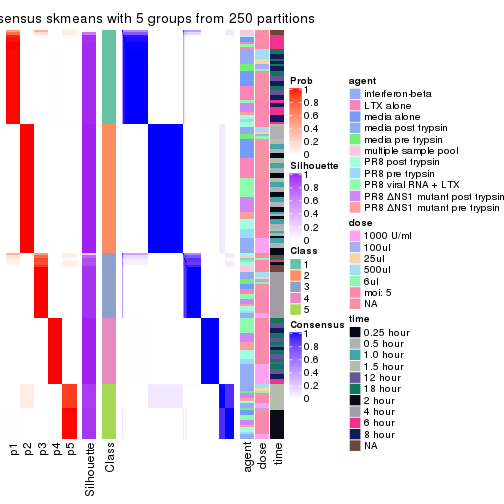
consensus_heatmap(res, k = 6)
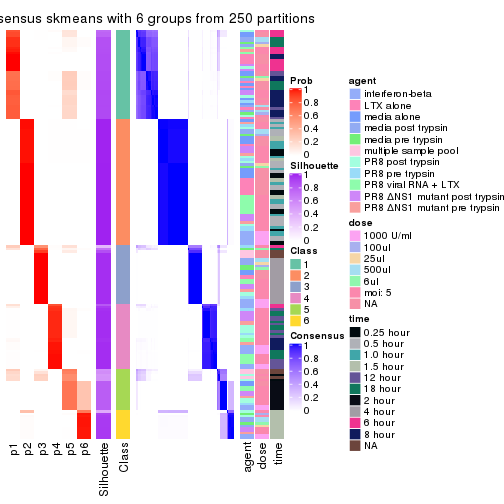
Heatmaps for the membership of samples in all partitions to see how consistent they are:
membership_heatmap(res, k = 2)
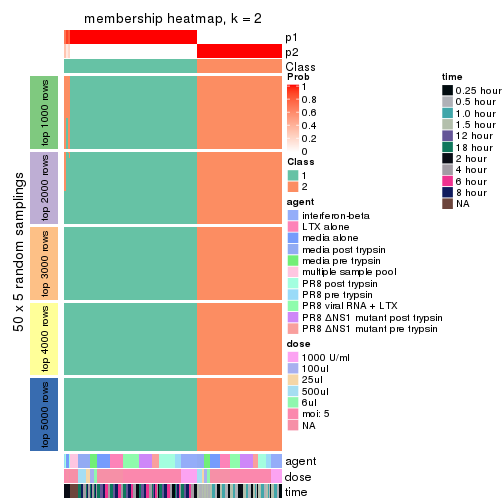
membership_heatmap(res, k = 3)
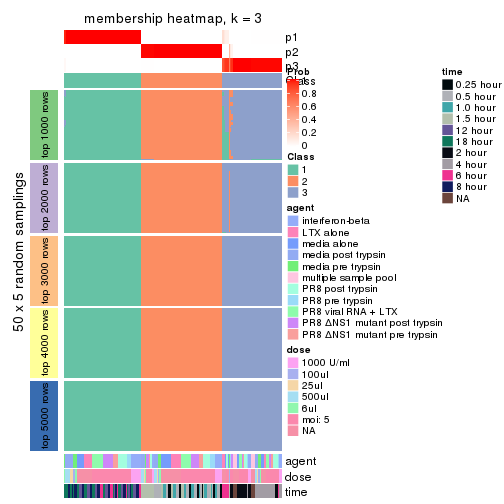
membership_heatmap(res, k = 4)
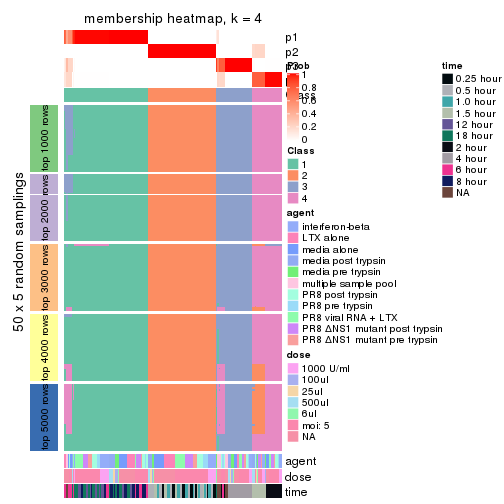
membership_heatmap(res, k = 5)
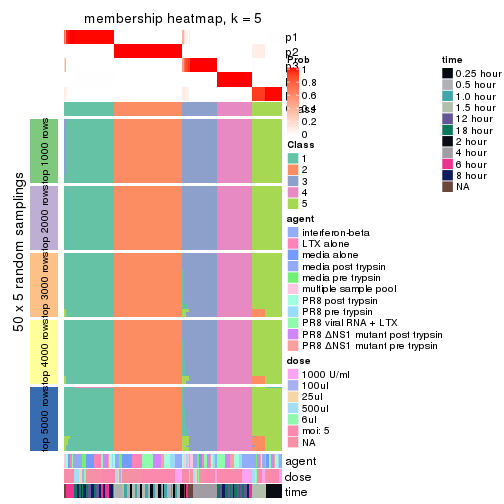
membership_heatmap(res, k = 6)
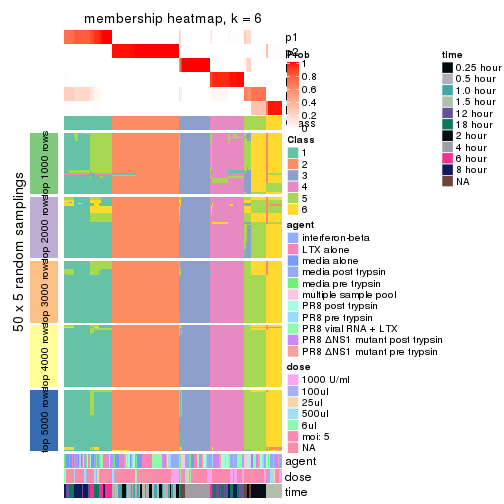
As soon as we have had the classes for columns, we can look for signatures which are significantly different between classes which can be candidate marks for certain classes. Following are the heatmaps for signatures.
Signature heatmaps where rows are scaled:
get_signatures(res, k = 2)
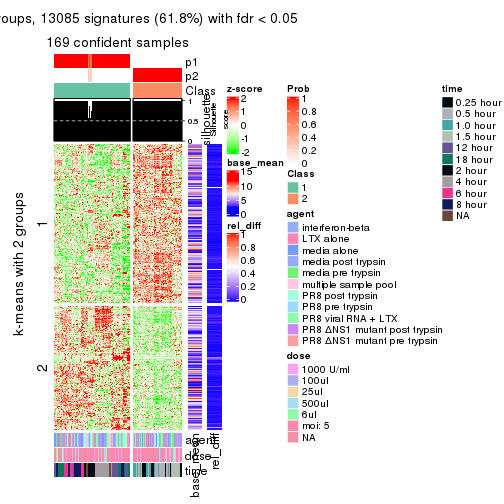
get_signatures(res, k = 3)
#> Error in mat[ceiling(1:nr/h_ratio), ceiling(1:nc/w_ratio), drop = FALSE]: subscript out of bounds
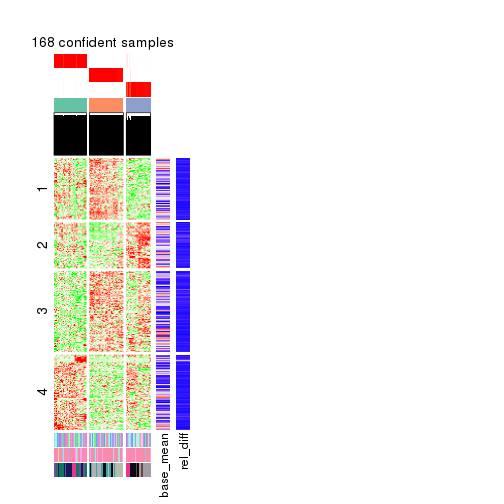
get_signatures(res, k = 4)
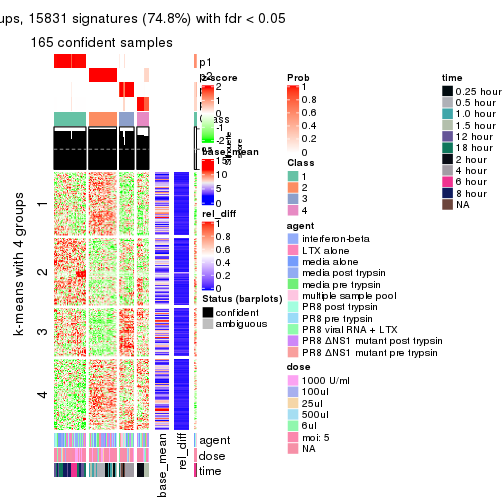
get_signatures(res, k = 5)
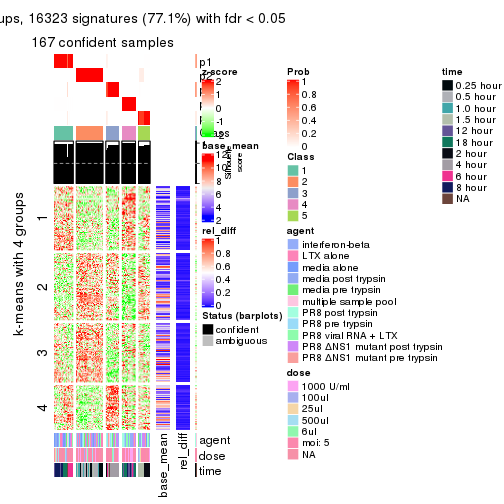
get_signatures(res, k = 6)
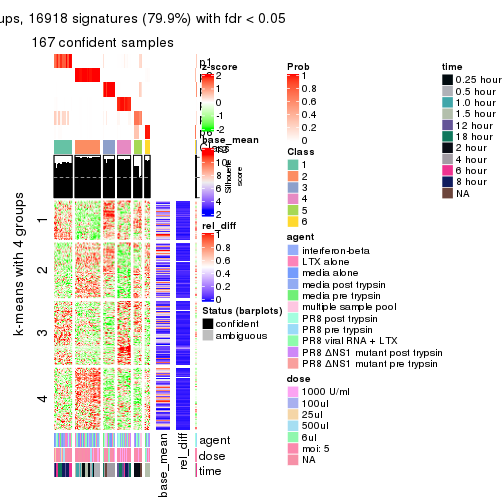
Signature heatmaps where rows are not scaled:
get_signatures(res, k = 2, scale_rows = FALSE)
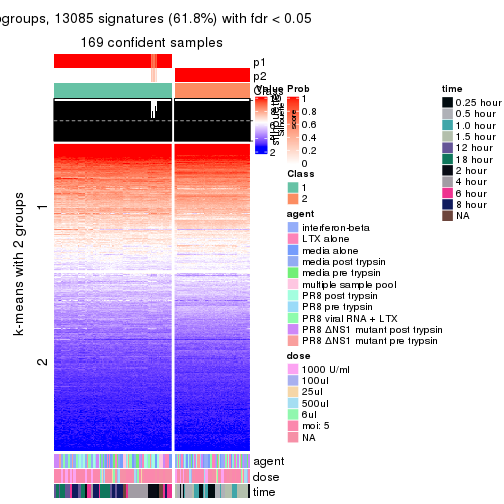
get_signatures(res, k = 3, scale_rows = FALSE)
#> Error in mat[ceiling(1:nr/h_ratio), ceiling(1:nc/w_ratio), drop = FALSE]: subscript out of bounds
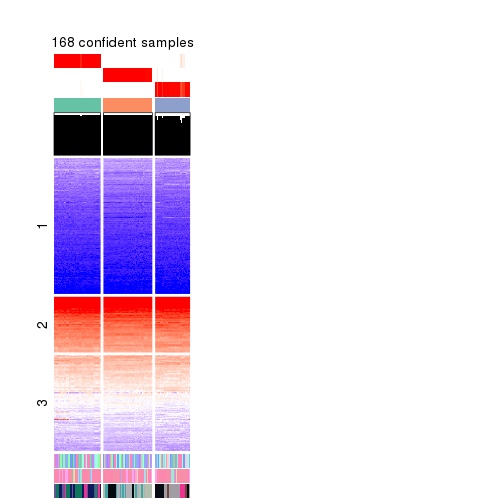
get_signatures(res, k = 4, scale_rows = FALSE)
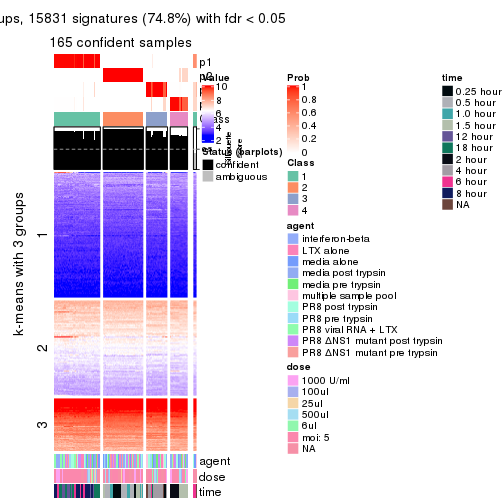
get_signatures(res, k = 5, scale_rows = FALSE)
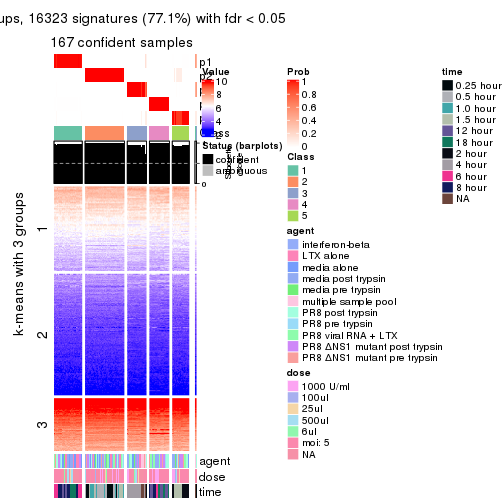
get_signatures(res, k = 6, scale_rows = FALSE)
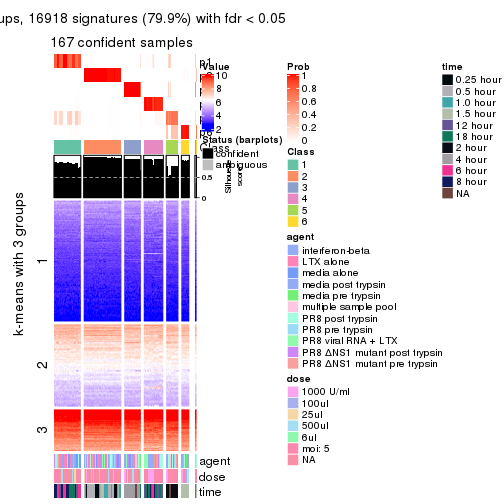
Compare the overlap of signatures from different k:
compare_signatures(res)
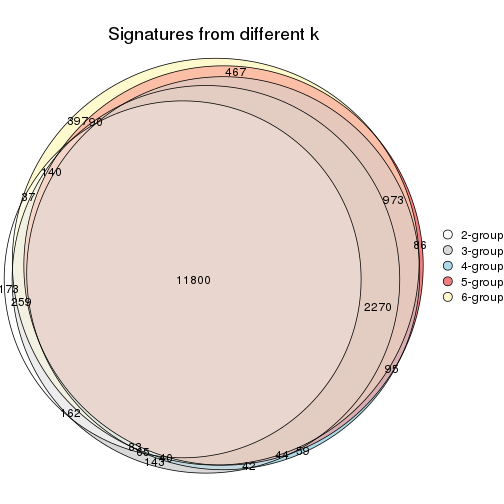
get_signature() returns a data frame invisibly. TO get the list of signatures, the function
call should be assigned to a variable explicitly. In following code, if plot argument is set
to FALSE, no heatmap is plotted while only the differential analysis is performed.
# code only for demonstration
tb = get_signature(res, k = ..., plot = FALSE)
An example of the output of tb is:
#> which_row fdr mean_1 mean_2 scaled_mean_1 scaled_mean_2 km
#> 1 38 0.042760348 8.373488 9.131774 -0.5533452 0.5164555 1
#> 2 40 0.018707592 7.106213 8.469186 -0.6173731 0.5762149 1
#> 3 55 0.019134737 10.221463 11.207825 -0.6159697 0.5749050 1
#> 4 59 0.006059896 5.921854 7.869574 -0.6899429 0.6439467 1
#> 5 60 0.018055526 8.928898 10.211722 -0.6204761 0.5791110 1
#> 6 98 0.009384629 15.714769 14.887706 0.6635654 -0.6193277 2
...
The columns in tb are:
which_row: row indices corresponding to the input matrix.fdr: FDR for the differential test. mean_x: The mean value in group x.scaled_mean_x: The mean value in group x after rows are scaled.km: Row groups if k-means clustering is applied to rows.UMAP plot which shows how samples are separated.
dimension_reduction(res, k = 2, method = "UMAP")
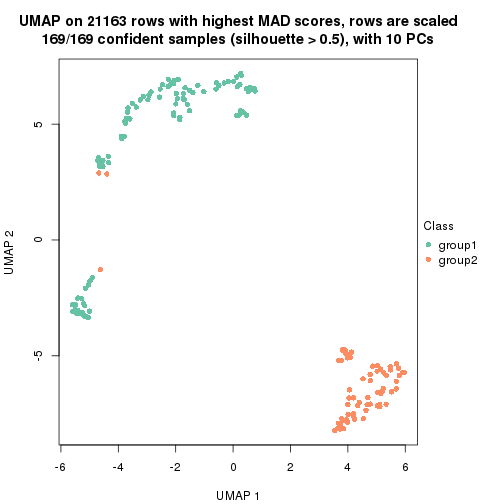
dimension_reduction(res, k = 3, method = "UMAP")
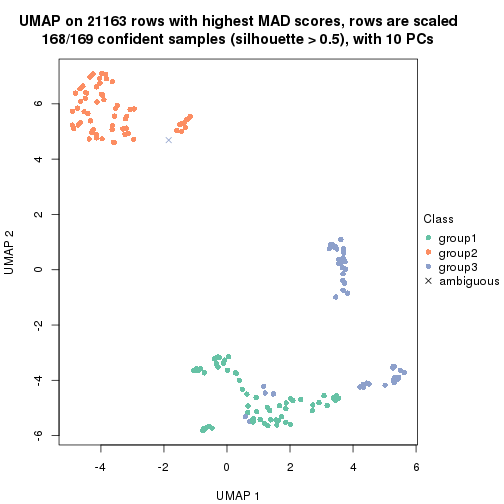
dimension_reduction(res, k = 4, method = "UMAP")
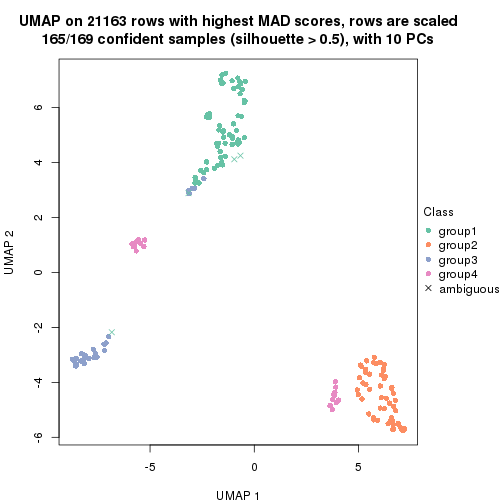
dimension_reduction(res, k = 5, method = "UMAP")
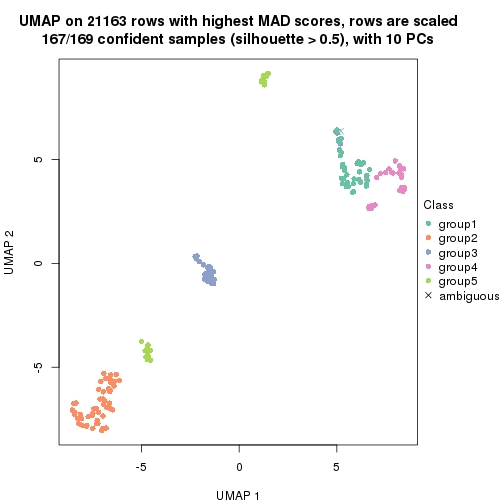
dimension_reduction(res, k = 6, method = "UMAP")
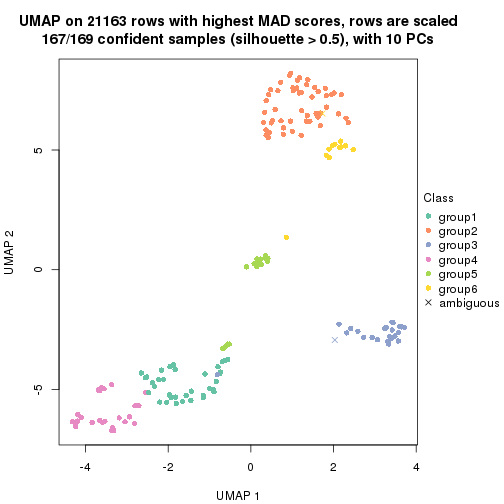
Following heatmap shows how subgroups are split when increasing k:
collect_classes(res)
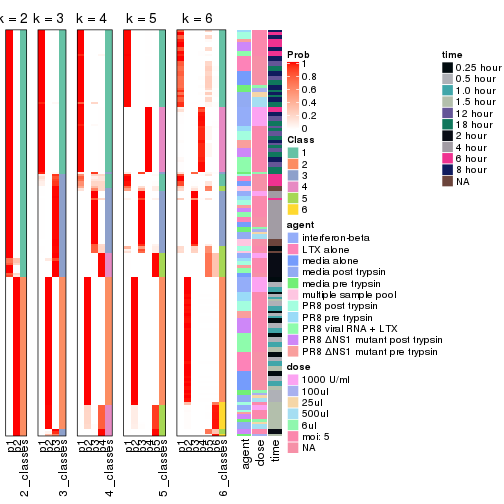
Test correlation between subgroups and known annotations. If the known annotation is numeric, one-way ANOVA test is applied, and if the known annotation is discrete, chi-squared contingency table test is applied.
test_to_known_factors(res)
#> n agent(p) dose(p) time(p) k
#> MAD:skmeans 169 0.83181 0.99988 3.84e-28 2
#> MAD:skmeans 168 0.43376 0.98472 2.35e-52 3
#> MAD:skmeans 165 0.14993 0.95086 1.65e-69 4
#> MAD:skmeans 167 0.00608 0.00700 7.01e-71 5
#> MAD:skmeans 167 0.00190 0.00542 5.56e-88 6
If matrix rows can be associated to genes, consider to use functional_enrichment(res,
...) to perform function enrichment for the signature genes. See this vignette for more detailed explanations.
The object with results only for a single top-value method and a single partition method can be extracted as:
res = res_list["MAD", "pam"]
# you can also extract it by
# res = res_list["MAD:pam"]
A summary of res and all the functions that can be applied to it:
res
#> A 'ConsensusPartition' object with k = 2, 3, 4, 5, 6.
#> On a matrix with 21163 rows and 169 columns.
#> Top rows (1000, 2000, 3000, 4000, 5000) are extracted by 'MAD' method.
#> Subgroups are detected by 'pam' method.
#> Performed in total 1250 partitions by row resampling.
#> Best k for subgroups seems to be 5.
#>
#> Following methods can be applied to this 'ConsensusPartition' object:
#> [1] "cola_report" "collect_classes" "collect_plots"
#> [4] "collect_stats" "colnames" "compare_signatures"
#> [7] "consensus_heatmap" "dimension_reduction" "functional_enrichment"
#> [10] "get_anno_col" "get_anno" "get_classes"
#> [13] "get_consensus" "get_matrix" "get_membership"
#> [16] "get_param" "get_signatures" "get_stats"
#> [19] "is_best_k" "is_stable_k" "membership_heatmap"
#> [22] "ncol" "nrow" "plot_ecdf"
#> [25] "rownames" "select_partition_number" "show"
#> [28] "suggest_best_k" "test_to_known_factors"
collect_plots() function collects all the plots made from res for all k (number of partitions)
into one single page to provide an easy and fast comparison between different k.
collect_plots(res)
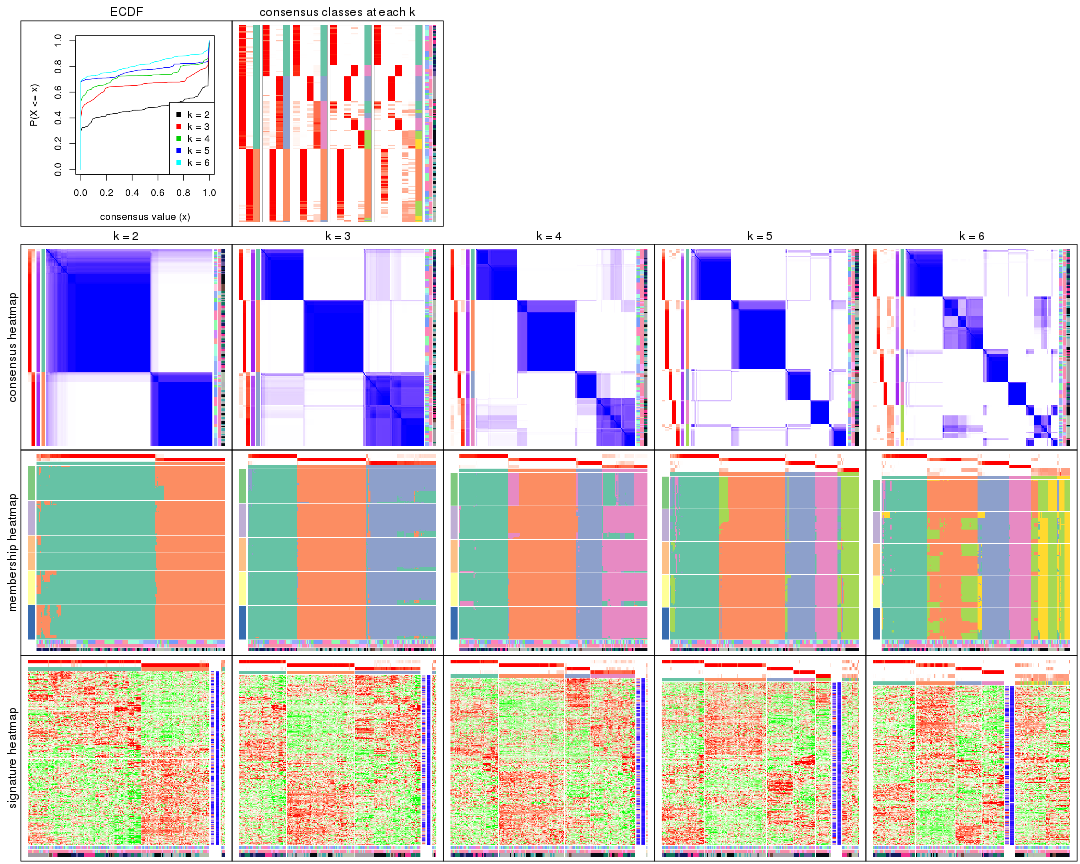
The plots are:
k and the heatmap of
predicted classes for each k.k.k.k.All the plots in panels can be made by individual functions and they are plotted later in this section.
select_partition_number() produces several plots showing different
statistics for choosing “optimized” k. There are following statistics:
k;k, the area increased is defined as \(A_k - A_{k-1}\).The detailed explanations of these statistics can be found in the cola vignette.
Generally speaking, lower PAC score, higher mean silhouette score or higher
concordance corresponds to better partition. Rand index and Jaccard index
measure how similar the current partition is compared to partition with k-1.
If they are too similar, we won't accept k is better than k-1.
select_partition_number(res)
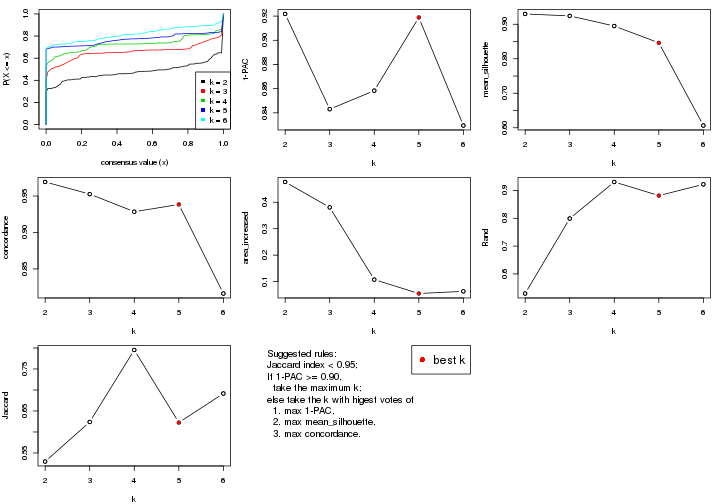
The numeric values for all these statistics can be obtained by get_stats().
get_stats(res)
#> k 1-PAC mean_silhouette concordance area_increased Rand Jaccard
#> 2 2 0.922 0.930 0.969 0.4767 0.530 0.530
#> 3 3 0.843 0.924 0.953 0.3805 0.799 0.624
#> 4 4 0.858 0.895 0.928 0.1074 0.931 0.795
#> 5 5 0.919 0.846 0.938 0.0549 0.882 0.622
#> 6 6 0.829 0.607 0.816 0.0631 0.922 0.692
suggest_best_k() suggests the best \(k\) based on these statistics. The rules are as follows:
suggest_best_k(res)
#> [1] 5
#> attr(,"optional")
#> [1] 2
There is also optional best \(k\) = 2 that is worth to check.
Following shows the table of the partitions (You need to click the show/hide
code output link to see it). The membership matrix (columns with name p*)
is inferred by
clue::cl_consensus()
function with the SE method. Basically the value in the membership matrix
represents the probability to belong to a certain group. The finall class
label for an item is determined with the group with highest probability it
belongs to.
In get_classes() function, the entropy is calculated from the membership
matrix and the silhouette score is calculated from the consensus matrix.
cbind(get_classes(res, k = 2), get_membership(res, k = 2))
#> class entropy silhouette p1 p2
#> GSM528681 2 0.0000 0.9805 0.000 1.000
#> GSM528682 2 0.0000 0.9805 0.000 1.000
#> GSM528683 2 0.0000 0.9805 0.000 1.000
#> GSM528684 2 0.0000 0.9805 0.000 1.000
#> GSM528687 2 0.0000 0.9805 0.000 1.000
#> GSM528688 2 0.0000 0.9805 0.000 1.000
#> GSM528685 2 0.0000 0.9805 0.000 1.000
#> GSM528686 2 0.4298 0.8988 0.088 0.912
#> GSM528693 1 0.0000 0.9601 1.000 0.000
#> GSM528694 1 0.0000 0.9601 1.000 0.000
#> GSM528695 1 0.0000 0.9601 1.000 0.000
#> GSM528696 1 0.0000 0.9601 1.000 0.000
#> GSM528697 1 0.0000 0.9601 1.000 0.000
#> GSM528698 1 0.0000 0.9601 1.000 0.000
#> GSM528699 1 0.3879 0.9032 0.924 0.076
#> GSM528700 1 0.0000 0.9601 1.000 0.000
#> GSM528689 1 0.0000 0.9601 1.000 0.000
#> GSM528690 1 0.3584 0.9090 0.932 0.068
#> GSM528691 1 0.0000 0.9601 1.000 0.000
#> GSM528692 1 0.0000 0.9601 1.000 0.000
#> GSM528779 2 0.0000 0.9805 0.000 1.000
#> GSM528780 2 0.0000 0.9805 0.000 1.000
#> GSM528782 2 0.0000 0.9805 0.000 1.000
#> GSM528781 2 0.0000 0.9805 0.000 1.000
#> GSM528785 1 0.0672 0.9556 0.992 0.008
#> GSM528786 1 0.0000 0.9601 1.000 0.000
#> GSM528787 1 0.0000 0.9601 1.000 0.000
#> GSM528788 1 0.7056 0.7694 0.808 0.192
#> GSM528783 1 0.0000 0.9601 1.000 0.000
#> GSM528784 1 0.0000 0.9601 1.000 0.000
#> GSM528759 1 0.0000 0.9601 1.000 0.000
#> GSM528760 1 0.0000 0.9601 1.000 0.000
#> GSM528761 2 0.0000 0.9805 0.000 1.000
#> GSM528762 2 0.0000 0.9805 0.000 1.000
#> GSM528765 2 0.0000 0.9805 0.000 1.000
#> GSM528766 2 0.0000 0.9805 0.000 1.000
#> GSM528763 2 0.0000 0.9805 0.000 1.000
#> GSM528764 2 0.4939 0.8753 0.108 0.892
#> GSM528771 1 0.0672 0.9556 0.992 0.008
#> GSM528772 1 0.0672 0.9556 0.992 0.008
#> GSM528773 1 0.0000 0.9601 1.000 0.000
#> GSM528774 1 0.0000 0.9601 1.000 0.000
#> GSM528775 1 0.0000 0.9601 1.000 0.000
#> GSM528776 1 0.0000 0.9601 1.000 0.000
#> GSM528777 1 0.9552 0.4342 0.624 0.376
#> GSM528778 1 0.7219 0.7600 0.800 0.200
#> GSM528767 1 0.0000 0.9601 1.000 0.000
#> GSM528768 1 0.0000 0.9601 1.000 0.000
#> GSM528769 1 0.0000 0.9601 1.000 0.000
#> GSM528770 1 0.0000 0.9601 1.000 0.000
#> GSM528671 2 0.0000 0.9805 0.000 1.000
#> GSM528672 2 0.0000 0.9805 0.000 1.000
#> GSM528674 2 0.0000 0.9805 0.000 1.000
#> GSM528673 2 0.4161 0.9032 0.084 0.916
#> GSM528677 1 0.0672 0.9556 0.992 0.008
#> GSM528678 1 0.0000 0.9601 1.000 0.000
#> GSM528679 1 0.0000 0.9601 1.000 0.000
#> GSM528680 1 0.0000 0.9601 1.000 0.000
#> GSM528675 1 0.0000 0.9601 1.000 0.000
#> GSM528676 1 0.0000 0.9601 1.000 0.000
#> GSM528651 2 0.0000 0.9805 0.000 1.000
#> GSM528652 2 0.0000 0.9805 0.000 1.000
#> GSM528653 2 0.0000 0.9805 0.000 1.000
#> GSM528654 2 0.0000 0.9805 0.000 1.000
#> GSM528657 2 0.0000 0.9805 0.000 1.000
#> GSM528658 2 0.0000 0.9805 0.000 1.000
#> GSM528655 2 0.4161 0.9032 0.084 0.916
#> GSM528656 2 0.0000 0.9805 0.000 1.000
#> GSM528663 1 0.3431 0.9129 0.936 0.064
#> GSM528664 1 0.3879 0.9026 0.924 0.076
#> GSM528665 1 0.0000 0.9601 1.000 0.000
#> GSM528666 1 0.0000 0.9601 1.000 0.000
#> GSM528667 1 0.0000 0.9601 1.000 0.000
#> GSM528668 1 0.0000 0.9601 1.000 0.000
#> GSM528669 1 0.9993 0.1028 0.516 0.484
#> GSM528670 1 0.0000 0.9601 1.000 0.000
#> GSM528659 1 0.3274 0.9159 0.940 0.060
#> GSM528660 1 0.2043 0.9384 0.968 0.032
#> GSM528661 1 0.0000 0.9601 1.000 0.000
#> GSM528662 1 0.0000 0.9601 1.000 0.000
#> GSM528701 2 0.0000 0.9805 0.000 1.000
#> GSM528702 2 0.0000 0.9805 0.000 1.000
#> GSM528703 2 0.0000 0.9805 0.000 1.000
#> GSM528704 2 0.0000 0.9805 0.000 1.000
#> GSM528707 2 0.0000 0.9805 0.000 1.000
#> GSM528708 2 0.0000 0.9805 0.000 1.000
#> GSM528705 2 0.0000 0.9805 0.000 1.000
#> GSM528706 2 0.0000 0.9805 0.000 1.000
#> GSM528713 1 0.0376 0.9579 0.996 0.004
#> GSM528714 1 0.0672 0.9556 0.992 0.008
#> GSM528715 1 0.0000 0.9601 1.000 0.000
#> GSM528716 1 0.0000 0.9601 1.000 0.000
#> GSM528717 1 0.0000 0.9601 1.000 0.000
#> GSM528718 1 0.0000 0.9601 1.000 0.000
#> GSM528719 1 0.0000 0.9601 1.000 0.000
#> GSM528720 1 0.0000 0.9601 1.000 0.000
#> GSM528709 1 0.0000 0.9601 1.000 0.000
#> GSM528710 1 0.3274 0.9159 0.940 0.060
#> GSM528711 1 0.0000 0.9601 1.000 0.000
#> GSM528712 1 0.0000 0.9601 1.000 0.000
#> GSM528721 2 0.0000 0.9805 0.000 1.000
#> GSM528722 2 0.0000 0.9805 0.000 1.000
#> GSM528723 2 0.0000 0.9805 0.000 1.000
#> GSM528724 2 0.0000 0.9805 0.000 1.000
#> GSM528727 2 0.0000 0.9805 0.000 1.000
#> GSM528728 2 0.0000 0.9805 0.000 1.000
#> GSM528725 2 0.0000 0.9805 0.000 1.000
#> GSM528726 2 0.0000 0.9805 0.000 1.000
#> GSM528733 1 0.0000 0.9601 1.000 0.000
#> GSM528734 1 0.0000 0.9601 1.000 0.000
#> GSM528735 1 0.0000 0.9601 1.000 0.000
#> GSM528736 1 0.0000 0.9601 1.000 0.000
#> GSM528737 1 0.0000 0.9601 1.000 0.000
#> GSM528738 1 0.0000 0.9601 1.000 0.000
#> GSM528729 1 0.5059 0.8660 0.888 0.112
#> GSM528730 1 0.6343 0.8118 0.840 0.160
#> GSM528731 1 0.0000 0.9601 1.000 0.000
#> GSM528732 1 0.0000 0.9601 1.000 0.000
#> GSM528739 2 0.0000 0.9805 0.000 1.000
#> GSM528740 2 0.0000 0.9805 0.000 1.000
#> GSM528741 2 0.0000 0.9805 0.000 1.000
#> GSM528742 2 0.0000 0.9805 0.000 1.000
#> GSM528745 2 0.0000 0.9805 0.000 1.000
#> GSM528746 2 0.0000 0.9805 0.000 1.000
#> GSM528743 2 0.0000 0.9805 0.000 1.000
#> GSM528744 2 0.0000 0.9805 0.000 1.000
#> GSM528751 1 0.0672 0.9556 0.992 0.008
#> GSM528752 1 0.0672 0.9556 0.992 0.008
#> GSM528753 1 0.0000 0.9601 1.000 0.000
#> GSM528754 1 0.0000 0.9601 1.000 0.000
#> GSM528755 1 0.0000 0.9601 1.000 0.000
#> GSM528756 1 0.0000 0.9601 1.000 0.000
#> GSM528757 1 1.0000 0.0612 0.500 0.500
#> GSM528758 1 0.8144 0.6865 0.748 0.252
#> GSM528747 1 0.0000 0.9601 1.000 0.000
#> GSM528748 1 0.3431 0.9128 0.936 0.064
#> GSM528749 1 0.0000 0.9601 1.000 0.000
#> GSM528750 1 0.0000 0.9601 1.000 0.000
#> GSM528640 2 0.0000 0.9805 0.000 1.000
#> GSM528641 2 0.4161 0.9032 0.084 0.916
#> GSM528643 1 0.0000 0.9601 1.000 0.000
#> GSM528644 1 0.7745 0.7215 0.772 0.228
#> GSM528642 1 0.0000 0.9601 1.000 0.000
#> GSM528620 2 0.0000 0.9805 0.000 1.000
#> GSM528621 1 0.8763 0.6140 0.704 0.296
#> GSM528623 1 0.0000 0.9601 1.000 0.000
#> GSM528624 1 0.9044 0.5602 0.680 0.320
#> GSM528622 1 0.0000 0.9601 1.000 0.000
#> GSM528625 2 0.0000 0.9805 0.000 1.000
#> GSM528626 2 0.4161 0.9032 0.084 0.916
#> GSM528628 1 0.0000 0.9601 1.000 0.000
#> GSM528629 1 0.3114 0.9189 0.944 0.056
#> GSM528627 1 0.0000 0.9601 1.000 0.000
#> GSM528630 2 0.0000 0.9805 0.000 1.000
#> GSM528631 2 0.0000 0.9805 0.000 1.000
#> GSM528632 2 0.9732 0.2818 0.404 0.596
#> GSM528633 2 0.7056 0.7585 0.192 0.808
#> GSM528636 1 0.0000 0.9601 1.000 0.000
#> GSM528637 1 0.0000 0.9601 1.000 0.000
#> GSM528638 1 0.8661 0.6275 0.712 0.288
#> GSM528639 1 0.2423 0.9319 0.960 0.040
#> GSM528634 1 0.0000 0.9601 1.000 0.000
#> GSM528635 1 0.0000 0.9601 1.000 0.000
#> GSM528645 1 0.0000 0.9601 1.000 0.000
#> GSM528646 1 0.0000 0.9601 1.000 0.000
#> GSM528647 1 0.0000 0.9601 1.000 0.000
#> GSM528648 1 0.0000 0.9601 1.000 0.000
#> GSM528649 1 0.0000 0.9601 1.000 0.000
#> GSM528650 1 0.0000 0.9601 1.000 0.000
cbind(get_classes(res, k = 3), get_membership(res, k = 3))
#> class entropy silhouette p1 p2 p3
#> GSM528681 2 0.0000 0.9951 0.000 1.000 0.000
#> GSM528682 2 0.0000 0.9951 0.000 1.000 0.000
#> GSM528683 2 0.0000 0.9951 0.000 1.000 0.000
#> GSM528684 2 0.0000 0.9951 0.000 1.000 0.000
#> GSM528687 2 0.0000 0.9951 0.000 1.000 0.000
#> GSM528688 2 0.0000 0.9951 0.000 1.000 0.000
#> GSM528685 2 0.0237 0.9927 0.000 0.996 0.004
#> GSM528686 2 0.0592 0.9854 0.000 0.988 0.012
#> GSM528693 3 0.3551 0.8826 0.132 0.000 0.868
#> GSM528694 3 0.2537 0.8934 0.080 0.000 0.920
#> GSM528695 3 0.0237 0.8886 0.004 0.000 0.996
#> GSM528696 3 0.0237 0.8886 0.004 0.000 0.996
#> GSM528697 1 0.0000 0.9774 1.000 0.000 0.000
#> GSM528698 3 0.4346 0.8556 0.184 0.000 0.816
#> GSM528699 1 0.0424 0.9694 0.992 0.008 0.000
#> GSM528700 1 0.0000 0.9774 1.000 0.000 0.000
#> GSM528689 1 0.0000 0.9774 1.000 0.000 0.000
#> GSM528690 1 0.0000 0.9774 1.000 0.000 0.000
#> GSM528691 3 0.4346 0.8556 0.184 0.000 0.816
#> GSM528692 3 0.0237 0.8886 0.004 0.000 0.996
#> GSM528779 2 0.0000 0.9951 0.000 1.000 0.000
#> GSM528780 2 0.0000 0.9951 0.000 1.000 0.000
#> GSM528782 2 0.0000 0.9951 0.000 1.000 0.000
#> GSM528781 2 0.0000 0.9951 0.000 1.000 0.000
#> GSM528785 3 0.7187 0.2359 0.480 0.024 0.496
#> GSM528786 3 0.0000 0.8867 0.000 0.000 1.000
#> GSM528787 3 0.1860 0.8931 0.052 0.000 0.948
#> GSM528788 1 0.0000 0.9774 1.000 0.000 0.000
#> GSM528783 1 0.0000 0.9774 1.000 0.000 0.000
#> GSM528784 1 0.3752 0.8079 0.856 0.000 0.144
#> GSM528759 3 0.2878 0.8919 0.096 0.000 0.904
#> GSM528760 3 0.0747 0.8903 0.016 0.000 0.984
#> GSM528761 2 0.0000 0.9951 0.000 1.000 0.000
#> GSM528762 2 0.0000 0.9951 0.000 1.000 0.000
#> GSM528765 2 0.0000 0.9951 0.000 1.000 0.000
#> GSM528766 2 0.0000 0.9951 0.000 1.000 0.000
#> GSM528763 2 0.0237 0.9927 0.000 0.996 0.004
#> GSM528764 2 0.0237 0.9927 0.000 0.996 0.004
#> GSM528771 3 0.5202 0.8621 0.136 0.044 0.820
#> GSM528772 3 0.5377 0.8575 0.112 0.068 0.820
#> GSM528773 3 0.0000 0.8867 0.000 0.000 1.000
#> GSM528774 3 0.0237 0.8886 0.004 0.000 0.996
#> GSM528775 3 0.2711 0.8926 0.088 0.000 0.912
#> GSM528776 1 0.0000 0.9774 1.000 0.000 0.000
#> GSM528777 1 0.0000 0.9774 1.000 0.000 0.000
#> GSM528778 1 0.0000 0.9774 1.000 0.000 0.000
#> GSM528767 1 0.0000 0.9774 1.000 0.000 0.000
#> GSM528768 3 0.4702 0.8291 0.212 0.000 0.788
#> GSM528769 1 0.3267 0.8466 0.884 0.000 0.116
#> GSM528770 3 0.4346 0.8556 0.184 0.000 0.816
#> GSM528671 2 0.0000 0.9951 0.000 1.000 0.000
#> GSM528672 2 0.0000 0.9951 0.000 1.000 0.000
#> GSM528674 2 0.0000 0.9951 0.000 1.000 0.000
#> GSM528673 2 0.0237 0.9927 0.000 0.996 0.004
#> GSM528677 3 0.4818 0.8720 0.108 0.048 0.844
#> GSM528678 3 0.0237 0.8886 0.004 0.000 0.996
#> GSM528679 3 0.4346 0.8556 0.184 0.000 0.816
#> GSM528680 1 0.0000 0.9774 1.000 0.000 0.000
#> GSM528675 1 0.3816 0.8002 0.852 0.000 0.148
#> GSM528676 3 0.4399 0.8525 0.188 0.000 0.812
#> GSM528651 2 0.0000 0.9951 0.000 1.000 0.000
#> GSM528652 2 0.0000 0.9951 0.000 1.000 0.000
#> GSM528653 2 0.0000 0.9951 0.000 1.000 0.000
#> GSM528654 2 0.0000 0.9951 0.000 1.000 0.000
#> GSM528657 2 0.0000 0.9951 0.000 1.000 0.000
#> GSM528658 2 0.0000 0.9951 0.000 1.000 0.000
#> GSM528655 2 0.0237 0.9927 0.000 0.996 0.004
#> GSM528656 2 0.0237 0.9927 0.000 0.996 0.004
#> GSM528663 3 0.5344 0.8531 0.092 0.084 0.824
#> GSM528664 3 0.5094 0.8216 0.040 0.136 0.824
#> GSM528665 3 0.0237 0.8886 0.004 0.000 0.996
#> GSM528666 3 0.0237 0.8886 0.004 0.000 0.996
#> GSM528667 1 0.0000 0.9774 1.000 0.000 0.000
#> GSM528668 1 0.0000 0.9774 1.000 0.000 0.000
#> GSM528669 1 0.0000 0.9774 1.000 0.000 0.000
#> GSM528670 1 0.0000 0.9774 1.000 0.000 0.000
#> GSM528659 1 0.0000 0.9774 1.000 0.000 0.000
#> GSM528660 1 0.0592 0.9675 0.988 0.000 0.012
#> GSM528661 3 0.3879 0.8741 0.152 0.000 0.848
#> GSM528662 3 0.3412 0.8855 0.124 0.000 0.876
#> GSM528701 2 0.0000 0.9951 0.000 1.000 0.000
#> GSM528702 2 0.0000 0.9951 0.000 1.000 0.000
#> GSM528703 2 0.0000 0.9951 0.000 1.000 0.000
#> GSM528704 2 0.0000 0.9951 0.000 1.000 0.000
#> GSM528707 2 0.0000 0.9951 0.000 1.000 0.000
#> GSM528708 2 0.0000 0.9951 0.000 1.000 0.000
#> GSM528705 2 0.0000 0.9951 0.000 1.000 0.000
#> GSM528706 2 0.0000 0.9951 0.000 1.000 0.000
#> GSM528713 3 0.4291 0.8566 0.180 0.000 0.820
#> GSM528714 3 0.2903 0.8907 0.048 0.028 0.924
#> GSM528715 3 0.0237 0.8886 0.004 0.000 0.996
#> GSM528716 3 0.0237 0.8886 0.004 0.000 0.996
#> GSM528717 1 0.5785 0.4015 0.668 0.000 0.332
#> GSM528718 3 0.3116 0.8896 0.108 0.000 0.892
#> GSM528719 3 0.3412 0.8857 0.124 0.000 0.876
#> GSM528720 3 0.4346 0.8556 0.184 0.000 0.816
#> GSM528709 1 0.0000 0.9774 1.000 0.000 0.000
#> GSM528710 1 0.0000 0.9774 1.000 0.000 0.000
#> GSM528711 3 0.4346 0.8556 0.184 0.000 0.816
#> GSM528712 3 0.4645 0.8585 0.176 0.008 0.816
#> GSM528721 2 0.0000 0.9951 0.000 1.000 0.000
#> GSM528722 2 0.0000 0.9951 0.000 1.000 0.000
#> GSM528723 2 0.0000 0.9951 0.000 1.000 0.000
#> GSM528724 2 0.0000 0.9951 0.000 1.000 0.000
#> GSM528727 2 0.0000 0.9951 0.000 1.000 0.000
#> GSM528728 2 0.0000 0.9951 0.000 1.000 0.000
#> GSM528725 2 0.0000 0.9951 0.000 1.000 0.000
#> GSM528726 2 0.0000 0.9951 0.000 1.000 0.000
#> GSM528733 3 0.0237 0.8886 0.004 0.000 0.996
#> GSM528734 3 0.0237 0.8886 0.004 0.000 0.996
#> GSM528735 1 0.0000 0.9774 1.000 0.000 0.000
#> GSM528736 1 0.0000 0.9774 1.000 0.000 0.000
#> GSM528737 1 0.0000 0.9774 1.000 0.000 0.000
#> GSM528738 1 0.0000 0.9774 1.000 0.000 0.000
#> GSM528729 1 0.0000 0.9774 1.000 0.000 0.000
#> GSM528730 1 0.0000 0.9774 1.000 0.000 0.000
#> GSM528731 1 0.0000 0.9774 1.000 0.000 0.000
#> GSM528732 1 0.1031 0.9554 0.976 0.000 0.024
#> GSM528739 2 0.0000 0.9951 0.000 1.000 0.000
#> GSM528740 2 0.0000 0.9951 0.000 1.000 0.000
#> GSM528741 2 0.0000 0.9951 0.000 1.000 0.000
#> GSM528742 2 0.0000 0.9951 0.000 1.000 0.000
#> GSM528745 2 0.0000 0.9951 0.000 1.000 0.000
#> GSM528746 2 0.0000 0.9951 0.000 1.000 0.000
#> GSM528743 2 0.0000 0.9951 0.000 1.000 0.000
#> GSM528744 2 0.0000 0.9951 0.000 1.000 0.000
#> GSM528751 3 0.4862 0.8623 0.160 0.020 0.820
#> GSM528752 3 0.4782 0.8615 0.164 0.016 0.820
#> GSM528753 3 0.0237 0.8886 0.004 0.000 0.996
#> GSM528754 3 0.0237 0.8886 0.004 0.000 0.996
#> GSM528755 3 0.3038 0.8904 0.104 0.000 0.896
#> GSM528756 3 0.3038 0.8904 0.104 0.000 0.896
#> GSM528757 1 0.0000 0.9774 1.000 0.000 0.000
#> GSM528758 1 0.0000 0.9774 1.000 0.000 0.000
#> GSM528747 1 0.0000 0.9774 1.000 0.000 0.000
#> GSM528748 1 0.0424 0.9694 0.992 0.008 0.000
#> GSM528749 3 0.4452 0.8495 0.192 0.000 0.808
#> GSM528750 1 0.0000 0.9774 1.000 0.000 0.000
#> GSM528640 2 0.0000 0.9951 0.000 1.000 0.000
#> GSM528641 2 0.0424 0.9893 0.000 0.992 0.008
#> GSM528643 3 0.0237 0.8886 0.004 0.000 0.996
#> GSM528644 1 0.0424 0.9694 0.992 0.008 0.000
#> GSM528642 3 0.0237 0.8886 0.004 0.000 0.996
#> GSM528620 2 0.0000 0.9951 0.000 1.000 0.000
#> GSM528621 3 0.3816 0.8081 0.000 0.148 0.852
#> GSM528623 3 0.0237 0.8886 0.004 0.000 0.996
#> GSM528624 1 0.0000 0.9774 1.000 0.000 0.000
#> GSM528622 1 0.0892 0.9599 0.980 0.000 0.020
#> GSM528625 2 0.0000 0.9951 0.000 1.000 0.000
#> GSM528626 2 0.1163 0.9700 0.000 0.972 0.028
#> GSM528628 3 0.6244 0.1089 0.440 0.000 0.560
#> GSM528629 1 0.0000 0.9774 1.000 0.000 0.000
#> GSM528627 3 0.4346 0.8556 0.184 0.000 0.816
#> GSM528630 2 0.0000 0.9951 0.000 1.000 0.000
#> GSM528631 2 0.0237 0.9927 0.000 0.996 0.004
#> GSM528632 3 0.6305 0.0915 0.000 0.484 0.516
#> GSM528633 2 0.4842 0.7103 0.000 0.776 0.224
#> GSM528636 3 0.0237 0.8886 0.004 0.000 0.996
#> GSM528637 3 0.0237 0.8886 0.004 0.000 0.996
#> GSM528638 1 0.0000 0.9774 1.000 0.000 0.000
#> GSM528639 1 0.0000 0.9774 1.000 0.000 0.000
#> GSM528634 3 0.3340 0.8868 0.120 0.000 0.880
#> GSM528635 1 0.0000 0.9774 1.000 0.000 0.000
#> GSM528645 3 0.0000 0.8867 0.000 0.000 1.000
#> GSM528646 3 0.0000 0.8867 0.000 0.000 1.000
#> GSM528647 3 0.0000 0.8867 0.000 0.000 1.000
#> GSM528648 3 0.3482 0.8845 0.128 0.000 0.872
#> GSM528649 3 0.2448 0.8933 0.076 0.000 0.924
#> GSM528650 3 0.4346 0.8556 0.184 0.000 0.816
cbind(get_classes(res, k = 4), get_membership(res, k = 4))
#> class entropy silhouette p1 p2 p3 p4
#> GSM528681 2 0.0000 0.959 0.000 1.000 0.000 0.000
#> GSM528682 2 0.0000 0.959 0.000 1.000 0.000 0.000
#> GSM528683 2 0.0000 0.959 0.000 1.000 0.000 0.000
#> GSM528684 2 0.0000 0.959 0.000 1.000 0.000 0.000
#> GSM528687 2 0.0000 0.959 0.000 1.000 0.000 0.000
#> GSM528688 2 0.0000 0.959 0.000 1.000 0.000 0.000
#> GSM528685 2 0.3837 0.779 0.000 0.776 0.000 0.224
#> GSM528686 2 0.3942 0.767 0.000 0.764 0.000 0.236
#> GSM528693 4 0.1389 0.798 0.048 0.000 0.000 0.952
#> GSM528694 4 0.1389 0.798 0.048 0.000 0.000 0.952
#> GSM528695 3 0.0000 0.959 0.000 0.000 1.000 0.000
#> GSM528696 3 0.0000 0.959 0.000 0.000 1.000 0.000
#> GSM528697 1 0.0000 0.975 1.000 0.000 0.000 0.000
#> GSM528698 4 0.3975 0.758 0.240 0.000 0.000 0.760
#> GSM528699 1 0.1389 0.952 0.952 0.000 0.000 0.048
#> GSM528700 1 0.1389 0.952 0.952 0.000 0.000 0.048
#> GSM528689 1 0.1389 0.952 0.952 0.000 0.000 0.048
#> GSM528690 1 0.1389 0.952 0.952 0.000 0.000 0.048
#> GSM528691 4 0.3942 0.759 0.236 0.000 0.000 0.764
#> GSM528692 4 0.4088 0.743 0.004 0.000 0.232 0.764
#> GSM528779 2 0.0000 0.959 0.000 1.000 0.000 0.000
#> GSM528780 2 0.0000 0.959 0.000 1.000 0.000 0.000
#> GSM528782 2 0.0000 0.959 0.000 1.000 0.000 0.000
#> GSM528781 2 0.0000 0.959 0.000 1.000 0.000 0.000
#> GSM528785 4 0.4040 0.651 0.248 0.000 0.000 0.752
#> GSM528786 3 0.0000 0.959 0.000 0.000 1.000 0.000
#> GSM528787 4 0.5188 0.752 0.044 0.000 0.240 0.716
#> GSM528788 1 0.0000 0.975 1.000 0.000 0.000 0.000
#> GSM528783 1 0.1302 0.954 0.956 0.000 0.000 0.044
#> GSM528784 1 0.1389 0.929 0.952 0.000 0.000 0.048
#> GSM528759 4 0.5548 0.786 0.084 0.000 0.200 0.716
#> GSM528760 4 0.4304 0.707 0.000 0.000 0.284 0.716
#> GSM528761 2 0.0000 0.959 0.000 1.000 0.000 0.000
#> GSM528762 2 0.0000 0.959 0.000 1.000 0.000 0.000
#> GSM528765 2 0.0000 0.959 0.000 1.000 0.000 0.000
#> GSM528766 2 0.0000 0.959 0.000 1.000 0.000 0.000
#> GSM528763 2 0.3837 0.779 0.000 0.776 0.000 0.224
#> GSM528764 2 0.3837 0.779 0.000 0.776 0.000 0.224
#> GSM528771 4 0.1489 0.797 0.044 0.004 0.000 0.952
#> GSM528772 4 0.1489 0.797 0.044 0.004 0.000 0.952
#> GSM528773 3 0.0000 0.959 0.000 0.000 1.000 0.000
#> GSM528774 3 0.0000 0.959 0.000 0.000 1.000 0.000
#> GSM528775 4 0.5548 0.786 0.084 0.000 0.200 0.716
#> GSM528776 1 0.0000 0.975 1.000 0.000 0.000 0.000
#> GSM528777 1 0.0000 0.975 1.000 0.000 0.000 0.000
#> GSM528778 1 0.0000 0.975 1.000 0.000 0.000 0.000
#> GSM528767 1 0.1302 0.954 0.956 0.000 0.000 0.044
#> GSM528768 4 0.4193 0.726 0.268 0.000 0.000 0.732
#> GSM528769 1 0.0336 0.972 0.992 0.000 0.000 0.008
#> GSM528770 4 0.4040 0.758 0.248 0.000 0.000 0.752
#> GSM528671 2 0.0000 0.959 0.000 1.000 0.000 0.000
#> GSM528672 2 0.0000 0.959 0.000 1.000 0.000 0.000
#> GSM528674 2 0.0000 0.959 0.000 1.000 0.000 0.000
#> GSM528673 2 0.3907 0.771 0.000 0.768 0.000 0.232
#> GSM528677 4 0.1489 0.797 0.044 0.004 0.000 0.952
#> GSM528678 3 0.1792 0.880 0.000 0.000 0.932 0.068
#> GSM528679 4 0.4304 0.751 0.284 0.000 0.000 0.716
#> GSM528680 1 0.1389 0.952 0.952 0.000 0.000 0.048
#> GSM528675 1 0.1792 0.941 0.932 0.000 0.000 0.068
#> GSM528676 4 0.2281 0.806 0.096 0.000 0.000 0.904
#> GSM528651 2 0.0592 0.947 0.000 0.984 0.000 0.016
#> GSM528652 2 0.0000 0.959 0.000 1.000 0.000 0.000
#> GSM528653 2 0.0000 0.959 0.000 1.000 0.000 0.000
#> GSM528654 2 0.0000 0.959 0.000 1.000 0.000 0.000
#> GSM528657 2 0.0000 0.959 0.000 1.000 0.000 0.000
#> GSM528658 2 0.0000 0.959 0.000 1.000 0.000 0.000
#> GSM528655 2 0.3873 0.775 0.000 0.772 0.000 0.228
#> GSM528656 2 0.3942 0.767 0.000 0.764 0.000 0.236
#> GSM528663 4 0.1584 0.792 0.036 0.012 0.000 0.952
#> GSM528664 4 0.1584 0.792 0.036 0.012 0.000 0.952
#> GSM528665 3 0.0000 0.959 0.000 0.000 1.000 0.000
#> GSM528666 3 0.0000 0.959 0.000 0.000 1.000 0.000
#> GSM528667 1 0.0000 0.975 1.000 0.000 0.000 0.000
#> GSM528668 1 0.0000 0.975 1.000 0.000 0.000 0.000
#> GSM528669 1 0.0000 0.975 1.000 0.000 0.000 0.000
#> GSM528670 1 0.0000 0.975 1.000 0.000 0.000 0.000
#> GSM528659 1 0.1389 0.952 0.952 0.000 0.000 0.048
#> GSM528660 1 0.1389 0.952 0.952 0.000 0.000 0.048
#> GSM528661 4 0.1452 0.802 0.036 0.000 0.008 0.956
#> GSM528662 4 0.3948 0.799 0.036 0.000 0.136 0.828
#> GSM528701 2 0.0000 0.959 0.000 1.000 0.000 0.000
#> GSM528702 2 0.0000 0.959 0.000 1.000 0.000 0.000
#> GSM528703 2 0.0000 0.959 0.000 1.000 0.000 0.000
#> GSM528704 2 0.0000 0.959 0.000 1.000 0.000 0.000
#> GSM528707 2 0.0000 0.959 0.000 1.000 0.000 0.000
#> GSM528708 2 0.0000 0.959 0.000 1.000 0.000 0.000
#> GSM528705 2 0.0000 0.959 0.000 1.000 0.000 0.000
#> GSM528706 2 0.0000 0.959 0.000 1.000 0.000 0.000
#> GSM528713 4 0.1389 0.798 0.048 0.000 0.000 0.952
#> GSM528714 4 0.1489 0.797 0.044 0.004 0.000 0.952
#> GSM528715 3 0.0000 0.959 0.000 0.000 1.000 0.000
#> GSM528716 3 0.0000 0.959 0.000 0.000 1.000 0.000
#> GSM528717 1 0.3649 0.672 0.796 0.000 0.000 0.204
#> GSM528718 4 0.5548 0.786 0.084 0.000 0.200 0.716
#> GSM528719 4 0.4907 0.783 0.060 0.000 0.176 0.764
#> GSM528720 4 0.3942 0.759 0.236 0.000 0.000 0.764
#> GSM528709 1 0.1389 0.952 0.952 0.000 0.000 0.048
#> GSM528710 1 0.1389 0.952 0.952 0.000 0.000 0.048
#> GSM528711 4 0.3942 0.759 0.236 0.000 0.000 0.764
#> GSM528712 4 0.3726 0.774 0.212 0.000 0.000 0.788
#> GSM528721 2 0.0000 0.959 0.000 1.000 0.000 0.000
#> GSM528722 2 0.0000 0.959 0.000 1.000 0.000 0.000
#> GSM528723 2 0.0000 0.959 0.000 1.000 0.000 0.000
#> GSM528724 2 0.0000 0.959 0.000 1.000 0.000 0.000
#> GSM528727 2 0.0000 0.959 0.000 1.000 0.000 0.000
#> GSM528728 2 0.0000 0.959 0.000 1.000 0.000 0.000
#> GSM528725 2 0.0000 0.959 0.000 1.000 0.000 0.000
#> GSM528726 2 0.0000 0.959 0.000 1.000 0.000 0.000
#> GSM528733 3 0.0000 0.959 0.000 0.000 1.000 0.000
#> GSM528734 3 0.0000 0.959 0.000 0.000 1.000 0.000
#> GSM528735 1 0.0000 0.975 1.000 0.000 0.000 0.000
#> GSM528736 1 0.0817 0.955 0.976 0.000 0.024 0.000
#> GSM528737 1 0.0000 0.975 1.000 0.000 0.000 0.000
#> GSM528738 1 0.0000 0.975 1.000 0.000 0.000 0.000
#> GSM528729 1 0.0000 0.975 1.000 0.000 0.000 0.000
#> GSM528730 1 0.0000 0.975 1.000 0.000 0.000 0.000
#> GSM528731 1 0.0000 0.975 1.000 0.000 0.000 0.000
#> GSM528732 1 0.0817 0.955 0.976 0.000 0.000 0.024
#> GSM528739 2 0.0000 0.959 0.000 1.000 0.000 0.000
#> GSM528740 2 0.0000 0.959 0.000 1.000 0.000 0.000
#> GSM528741 2 0.0000 0.959 0.000 1.000 0.000 0.000
#> GSM528742 2 0.0000 0.959 0.000 1.000 0.000 0.000
#> GSM528745 2 0.0000 0.959 0.000 1.000 0.000 0.000
#> GSM528746 2 0.0000 0.959 0.000 1.000 0.000 0.000
#> GSM528743 2 0.0000 0.959 0.000 1.000 0.000 0.000
#> GSM528744 2 0.0000 0.959 0.000 1.000 0.000 0.000
#> GSM528751 4 0.1389 0.798 0.048 0.000 0.000 0.952
#> GSM528752 4 0.1489 0.797 0.044 0.004 0.000 0.952
#> GSM528753 3 0.0000 0.959 0.000 0.000 1.000 0.000
#> GSM528754 3 0.0000 0.959 0.000 0.000 1.000 0.000
#> GSM528755 4 0.5548 0.786 0.084 0.000 0.200 0.716
#> GSM528756 4 0.5548 0.786 0.084 0.000 0.200 0.716
#> GSM528757 1 0.0000 0.975 1.000 0.000 0.000 0.000
#> GSM528758 1 0.0000 0.975 1.000 0.000 0.000 0.000
#> GSM528747 1 0.0000 0.975 1.000 0.000 0.000 0.000
#> GSM528748 1 0.0188 0.972 0.996 0.004 0.000 0.000
#> GSM528749 4 0.4304 0.751 0.284 0.000 0.000 0.716
#> GSM528750 1 0.0000 0.975 1.000 0.000 0.000 0.000
#> GSM528640 2 0.0000 0.959 0.000 1.000 0.000 0.000
#> GSM528641 2 0.3837 0.779 0.000 0.776 0.000 0.224
#> GSM528643 3 0.0000 0.959 0.000 0.000 1.000 0.000
#> GSM528644 1 0.0188 0.972 0.996 0.004 0.000 0.000
#> GSM528642 4 0.4304 0.707 0.000 0.000 0.284 0.716
#> GSM528620 2 0.0000 0.959 0.000 1.000 0.000 0.000
#> GSM528621 4 0.1624 0.770 0.000 0.020 0.028 0.952
#> GSM528623 3 0.0000 0.959 0.000 0.000 1.000 0.000
#> GSM528624 1 0.0000 0.975 1.000 0.000 0.000 0.000
#> GSM528622 1 0.0000 0.975 1.000 0.000 0.000 0.000
#> GSM528625 2 0.0000 0.959 0.000 1.000 0.000 0.000
#> GSM528626 2 0.7227 0.418 0.000 0.548 0.224 0.228
#> GSM528628 3 0.0000 0.959 0.000 0.000 1.000 0.000
#> GSM528629 1 0.0000 0.975 1.000 0.000 0.000 0.000
#> GSM528627 4 0.4304 0.751 0.284 0.000 0.000 0.716
#> GSM528630 2 0.0000 0.959 0.000 1.000 0.000 0.000
#> GSM528631 2 0.3837 0.779 0.000 0.776 0.000 0.224
#> GSM528632 3 0.6592 0.549 0.000 0.128 0.612 0.260
#> GSM528633 3 0.6542 0.558 0.000 0.128 0.620 0.252
#> GSM528636 3 0.0000 0.959 0.000 0.000 1.000 0.000
#> GSM528637 3 0.0000 0.959 0.000 0.000 1.000 0.000
#> GSM528638 1 0.0000 0.975 1.000 0.000 0.000 0.000
#> GSM528639 1 0.0000 0.975 1.000 0.000 0.000 0.000
#> GSM528634 4 0.5594 0.789 0.092 0.000 0.192 0.716
#> GSM528635 1 0.0000 0.975 1.000 0.000 0.000 0.000
#> GSM528645 3 0.0000 0.959 0.000 0.000 1.000 0.000
#> GSM528646 3 0.0000 0.959 0.000 0.000 1.000 0.000
#> GSM528647 4 0.4304 0.707 0.000 0.000 0.284 0.716
#> GSM528648 4 0.5665 0.794 0.108 0.000 0.176 0.716
#> GSM528649 4 0.5548 0.786 0.084 0.000 0.200 0.716
#> GSM528650 4 0.4304 0.751 0.284 0.000 0.000 0.716
cbind(get_classes(res, k = 5), get_membership(res, k = 5))
#> class entropy silhouette p1 p2 p3 p4 p5
#> GSM528681 2 0.0000 0.9508 0.000 1.000 0.000 0.000 0.000
#> GSM528682 2 0.0000 0.9508 0.000 1.000 0.000 0.000 0.000
#> GSM528683 2 0.0000 0.9508 0.000 1.000 0.000 0.000 0.000
#> GSM528684 2 0.0000 0.9508 0.000 1.000 0.000 0.000 0.000
#> GSM528687 2 0.0000 0.9508 0.000 1.000 0.000 0.000 0.000
#> GSM528688 2 0.0000 0.9508 0.000 1.000 0.000 0.000 0.000
#> GSM528685 2 0.3684 0.6384 0.000 0.720 0.000 0.000 0.280
#> GSM528686 5 0.2377 0.6953 0.000 0.128 0.000 0.000 0.872
#> GSM528693 5 0.0000 0.8227 0.000 0.000 0.000 0.000 1.000
#> GSM528694 5 0.0000 0.8227 0.000 0.000 0.000 0.000 1.000
#> GSM528695 3 0.0000 0.9355 0.000 0.000 1.000 0.000 0.000
#> GSM528696 3 0.0000 0.9355 0.000 0.000 1.000 0.000 0.000
#> GSM528697 1 0.0000 0.9192 1.000 0.000 0.000 0.000 0.000
#> GSM528698 4 0.3774 0.5276 0.296 0.000 0.000 0.704 0.000
#> GSM528699 4 0.0000 0.9789 0.000 0.000 0.000 1.000 0.000
#> GSM528700 4 0.0000 0.9789 0.000 0.000 0.000 1.000 0.000
#> GSM528689 4 0.0000 0.9789 0.000 0.000 0.000 1.000 0.000
#> GSM528690 4 0.0000 0.9789 0.000 0.000 0.000 1.000 0.000
#> GSM528691 4 0.0000 0.9789 0.000 0.000 0.000 1.000 0.000
#> GSM528692 4 0.0000 0.9789 0.000 0.000 0.000 1.000 0.000
#> GSM528779 2 0.0000 0.9508 0.000 1.000 0.000 0.000 0.000
#> GSM528780 2 0.0000 0.9508 0.000 1.000 0.000 0.000 0.000
#> GSM528782 2 0.0000 0.9508 0.000 1.000 0.000 0.000 0.000
#> GSM528781 2 0.0000 0.9508 0.000 1.000 0.000 0.000 0.000
#> GSM528785 5 0.0000 0.8227 0.000 0.000 0.000 0.000 1.000
#> GSM528786 3 0.0000 0.9355 0.000 0.000 1.000 0.000 0.000
#> GSM528787 3 0.0703 0.9143 0.000 0.000 0.976 0.000 0.024
#> GSM528788 1 0.0000 0.9192 1.000 0.000 0.000 0.000 0.000
#> GSM528783 1 0.3816 0.5416 0.696 0.000 0.000 0.304 0.000
#> GSM528784 1 0.0000 0.9192 1.000 0.000 0.000 0.000 0.000
#> GSM528759 5 0.6807 0.1513 0.328 0.000 0.304 0.000 0.368
#> GSM528760 3 0.4857 0.4039 0.040 0.000 0.636 0.000 0.324
#> GSM528761 2 0.0000 0.9508 0.000 1.000 0.000 0.000 0.000
#> GSM528762 2 0.0000 0.9508 0.000 1.000 0.000 0.000 0.000
#> GSM528765 2 0.0000 0.9508 0.000 1.000 0.000 0.000 0.000
#> GSM528766 2 0.0000 0.9508 0.000 1.000 0.000 0.000 0.000
#> GSM528763 2 0.3684 0.6384 0.000 0.720 0.000 0.000 0.280
#> GSM528764 2 0.3684 0.6384 0.000 0.720 0.000 0.000 0.280
#> GSM528771 5 0.0000 0.8227 0.000 0.000 0.000 0.000 1.000
#> GSM528772 5 0.0000 0.8227 0.000 0.000 0.000 0.000 1.000
#> GSM528773 3 0.0000 0.9355 0.000 0.000 1.000 0.000 0.000
#> GSM528774 3 0.0000 0.9355 0.000 0.000 1.000 0.000 0.000
#> GSM528775 3 0.6796 -0.0980 0.304 0.000 0.380 0.000 0.316
#> GSM528776 1 0.0000 0.9192 1.000 0.000 0.000 0.000 0.000
#> GSM528777 1 0.0000 0.9192 1.000 0.000 0.000 0.000 0.000
#> GSM528778 1 0.0000 0.9192 1.000 0.000 0.000 0.000 0.000
#> GSM528767 1 0.1851 0.8395 0.912 0.000 0.000 0.088 0.000
#> GSM528768 1 0.4150 0.3800 0.612 0.000 0.000 0.388 0.000
#> GSM528769 1 0.0000 0.9192 1.000 0.000 0.000 0.000 0.000
#> GSM528770 1 0.2127 0.8273 0.892 0.000 0.000 0.108 0.000
#> GSM528671 2 0.0000 0.9508 0.000 1.000 0.000 0.000 0.000
#> GSM528672 2 0.0000 0.9508 0.000 1.000 0.000 0.000 0.000
#> GSM528674 2 0.0000 0.9508 0.000 1.000 0.000 0.000 0.000
#> GSM528673 2 0.4045 0.4995 0.000 0.644 0.000 0.000 0.356
#> GSM528677 5 0.0000 0.8227 0.000 0.000 0.000 0.000 1.000
#> GSM528678 3 0.0000 0.9355 0.000 0.000 1.000 0.000 0.000
#> GSM528679 1 0.0000 0.9192 1.000 0.000 0.000 0.000 0.000
#> GSM528680 4 0.0000 0.9789 0.000 0.000 0.000 1.000 0.000
#> GSM528675 4 0.0000 0.9789 0.000 0.000 0.000 1.000 0.000
#> GSM528676 4 0.0000 0.9789 0.000 0.000 0.000 1.000 0.000
#> GSM528651 2 0.1608 0.8875 0.000 0.928 0.000 0.000 0.072
#> GSM528652 2 0.0000 0.9508 0.000 1.000 0.000 0.000 0.000
#> GSM528653 2 0.0000 0.9508 0.000 1.000 0.000 0.000 0.000
#> GSM528654 2 0.0000 0.9508 0.000 1.000 0.000 0.000 0.000
#> GSM528657 2 0.0000 0.9508 0.000 1.000 0.000 0.000 0.000
#> GSM528658 2 0.0000 0.9508 0.000 1.000 0.000 0.000 0.000
#> GSM528655 2 0.3774 0.6120 0.000 0.704 0.000 0.000 0.296
#> GSM528656 5 0.4227 0.1133 0.000 0.420 0.000 0.000 0.580
#> GSM528663 5 0.0000 0.8227 0.000 0.000 0.000 0.000 1.000
#> GSM528664 5 0.0000 0.8227 0.000 0.000 0.000 0.000 1.000
#> GSM528665 3 0.0000 0.9355 0.000 0.000 1.000 0.000 0.000
#> GSM528666 3 0.0000 0.9355 0.000 0.000 1.000 0.000 0.000
#> GSM528667 1 0.0000 0.9192 1.000 0.000 0.000 0.000 0.000
#> GSM528668 1 0.0000 0.9192 1.000 0.000 0.000 0.000 0.000
#> GSM528669 1 0.0000 0.9192 1.000 0.000 0.000 0.000 0.000
#> GSM528670 1 0.0000 0.9192 1.000 0.000 0.000 0.000 0.000
#> GSM528659 4 0.0000 0.9789 0.000 0.000 0.000 1.000 0.000
#> GSM528660 4 0.0000 0.9789 0.000 0.000 0.000 1.000 0.000
#> GSM528661 4 0.0000 0.9789 0.000 0.000 0.000 1.000 0.000
#> GSM528662 4 0.0000 0.9789 0.000 0.000 0.000 1.000 0.000
#> GSM528701 2 0.0000 0.9508 0.000 1.000 0.000 0.000 0.000
#> GSM528702 2 0.0000 0.9508 0.000 1.000 0.000 0.000 0.000
#> GSM528703 2 0.0000 0.9508 0.000 1.000 0.000 0.000 0.000
#> GSM528704 2 0.0000 0.9508 0.000 1.000 0.000 0.000 0.000
#> GSM528707 2 0.0000 0.9508 0.000 1.000 0.000 0.000 0.000
#> GSM528708 2 0.0000 0.9508 0.000 1.000 0.000 0.000 0.000
#> GSM528705 2 0.0000 0.9508 0.000 1.000 0.000 0.000 0.000
#> GSM528706 2 0.0000 0.9508 0.000 1.000 0.000 0.000 0.000
#> GSM528713 5 0.0000 0.8227 0.000 0.000 0.000 0.000 1.000
#> GSM528714 5 0.0000 0.8227 0.000 0.000 0.000 0.000 1.000
#> GSM528715 3 0.0000 0.9355 0.000 0.000 1.000 0.000 0.000
#> GSM528716 3 0.0000 0.9355 0.000 0.000 1.000 0.000 0.000
#> GSM528717 1 0.0000 0.9192 1.000 0.000 0.000 0.000 0.000
#> GSM528718 1 0.6628 0.2638 0.520 0.000 0.272 0.012 0.196
#> GSM528719 4 0.0000 0.9789 0.000 0.000 0.000 1.000 0.000
#> GSM528720 4 0.0000 0.9789 0.000 0.000 0.000 1.000 0.000
#> GSM528709 4 0.0000 0.9789 0.000 0.000 0.000 1.000 0.000
#> GSM528710 4 0.0000 0.9789 0.000 0.000 0.000 1.000 0.000
#> GSM528711 4 0.0000 0.9789 0.000 0.000 0.000 1.000 0.000
#> GSM528712 4 0.0000 0.9789 0.000 0.000 0.000 1.000 0.000
#> GSM528721 2 0.0000 0.9508 0.000 1.000 0.000 0.000 0.000
#> GSM528722 2 0.0000 0.9508 0.000 1.000 0.000 0.000 0.000
#> GSM528723 2 0.0000 0.9508 0.000 1.000 0.000 0.000 0.000
#> GSM528724 2 0.0000 0.9508 0.000 1.000 0.000 0.000 0.000
#> GSM528727 2 0.0000 0.9508 0.000 1.000 0.000 0.000 0.000
#> GSM528728 2 0.0000 0.9508 0.000 1.000 0.000 0.000 0.000
#> GSM528725 2 0.0000 0.9508 0.000 1.000 0.000 0.000 0.000
#> GSM528726 2 0.0000 0.9508 0.000 1.000 0.000 0.000 0.000
#> GSM528733 3 0.0000 0.9355 0.000 0.000 1.000 0.000 0.000
#> GSM528734 3 0.0000 0.9355 0.000 0.000 1.000 0.000 0.000
#> GSM528735 1 0.0000 0.9192 1.000 0.000 0.000 0.000 0.000
#> GSM528736 1 0.0510 0.9064 0.984 0.000 0.016 0.000 0.000
#> GSM528737 1 0.0000 0.9192 1.000 0.000 0.000 0.000 0.000
#> GSM528738 1 0.0000 0.9192 1.000 0.000 0.000 0.000 0.000
#> GSM528729 1 0.0000 0.9192 1.000 0.000 0.000 0.000 0.000
#> GSM528730 1 0.0000 0.9192 1.000 0.000 0.000 0.000 0.000
#> GSM528731 1 0.0000 0.9192 1.000 0.000 0.000 0.000 0.000
#> GSM528732 1 0.0000 0.9192 1.000 0.000 0.000 0.000 0.000
#> GSM528739 2 0.0000 0.9508 0.000 1.000 0.000 0.000 0.000
#> GSM528740 2 0.0000 0.9508 0.000 1.000 0.000 0.000 0.000
#> GSM528741 2 0.0000 0.9508 0.000 1.000 0.000 0.000 0.000
#> GSM528742 2 0.0000 0.9508 0.000 1.000 0.000 0.000 0.000
#> GSM528745 2 0.0000 0.9508 0.000 1.000 0.000 0.000 0.000
#> GSM528746 2 0.0000 0.9508 0.000 1.000 0.000 0.000 0.000
#> GSM528743 2 0.0000 0.9508 0.000 1.000 0.000 0.000 0.000
#> GSM528744 2 0.0000 0.9508 0.000 1.000 0.000 0.000 0.000
#> GSM528751 5 0.0000 0.8227 0.000 0.000 0.000 0.000 1.000
#> GSM528752 5 0.0000 0.8227 0.000 0.000 0.000 0.000 1.000
#> GSM528753 3 0.0000 0.9355 0.000 0.000 1.000 0.000 0.000
#> GSM528754 3 0.0000 0.9355 0.000 0.000 1.000 0.000 0.000
#> GSM528755 1 0.6801 -0.1666 0.360 0.000 0.292 0.000 0.348
#> GSM528756 5 0.6787 0.1732 0.332 0.000 0.288 0.000 0.380
#> GSM528757 1 0.0000 0.9192 1.000 0.000 0.000 0.000 0.000
#> GSM528758 1 0.0000 0.9192 1.000 0.000 0.000 0.000 0.000
#> GSM528747 1 0.0000 0.9192 1.000 0.000 0.000 0.000 0.000
#> GSM528748 1 0.0404 0.9095 0.988 0.000 0.012 0.000 0.000
#> GSM528749 1 0.0000 0.9192 1.000 0.000 0.000 0.000 0.000
#> GSM528750 1 0.0000 0.9192 1.000 0.000 0.000 0.000 0.000
#> GSM528640 2 0.0000 0.9508 0.000 1.000 0.000 0.000 0.000
#> GSM528641 2 0.3684 0.6384 0.000 0.720 0.000 0.000 0.280
#> GSM528643 3 0.0000 0.9355 0.000 0.000 1.000 0.000 0.000
#> GSM528644 1 0.0000 0.9192 1.000 0.000 0.000 0.000 0.000
#> GSM528642 3 0.0000 0.9355 0.000 0.000 1.000 0.000 0.000
#> GSM528620 2 0.0000 0.9508 0.000 1.000 0.000 0.000 0.000
#> GSM528621 5 0.0000 0.8227 0.000 0.000 0.000 0.000 1.000
#> GSM528623 3 0.0000 0.9355 0.000 0.000 1.000 0.000 0.000
#> GSM528624 1 0.0000 0.9192 1.000 0.000 0.000 0.000 0.000
#> GSM528622 1 0.0000 0.9192 1.000 0.000 0.000 0.000 0.000
#> GSM528625 2 0.0000 0.9508 0.000 1.000 0.000 0.000 0.000
#> GSM528626 2 0.6615 0.0482 0.000 0.444 0.232 0.000 0.324
#> GSM528628 3 0.0000 0.9355 0.000 0.000 1.000 0.000 0.000
#> GSM528629 1 0.0000 0.9192 1.000 0.000 0.000 0.000 0.000
#> GSM528627 1 0.0000 0.9192 1.000 0.000 0.000 0.000 0.000
#> GSM528630 2 0.0000 0.9508 0.000 1.000 0.000 0.000 0.000
#> GSM528631 2 0.3684 0.6384 0.000 0.720 0.000 0.000 0.280
#> GSM528632 5 0.4268 0.3528 0.000 0.008 0.344 0.000 0.648
#> GSM528633 3 0.4966 0.1800 0.000 0.032 0.564 0.000 0.404
#> GSM528636 3 0.0000 0.9355 0.000 0.000 1.000 0.000 0.000
#> GSM528637 3 0.0000 0.9355 0.000 0.000 1.000 0.000 0.000
#> GSM528638 1 0.0000 0.9192 1.000 0.000 0.000 0.000 0.000
#> GSM528639 1 0.0000 0.9192 1.000 0.000 0.000 0.000 0.000
#> GSM528634 1 0.3305 0.6739 0.776 0.000 0.224 0.000 0.000
#> GSM528635 1 0.0000 0.9192 1.000 0.000 0.000 0.000 0.000
#> GSM528645 3 0.0000 0.9355 0.000 0.000 1.000 0.000 0.000
#> GSM528646 3 0.0000 0.9355 0.000 0.000 1.000 0.000 0.000
#> GSM528647 3 0.0703 0.9143 0.000 0.000 0.976 0.000 0.024
#> GSM528648 1 0.6356 0.0734 0.468 0.000 0.168 0.000 0.364
#> GSM528649 5 0.6759 0.1449 0.276 0.000 0.328 0.000 0.396
#> GSM528650 1 0.4201 0.3021 0.592 0.000 0.000 0.000 0.408
cbind(get_classes(res, k = 6), get_membership(res, k = 6))
#> class entropy silhouette p1 p2 p3 p4 p5 p6
#> GSM528681 2 0.0000 0.68258 0.000 1.000 0.000 0.000 0.000 0.000
#> GSM528682 2 0.0000 0.68258 0.000 1.000 0.000 0.000 0.000 0.000
#> GSM528683 2 0.0000 0.68258 0.000 1.000 0.000 0.000 0.000 0.000
#> GSM528684 2 0.3482 0.56519 0.000 0.684 0.000 0.000 0.316 0.000
#> GSM528687 2 0.3851 0.48654 0.000 0.540 0.000 0.000 0.460 0.000
#> GSM528688 2 0.3817 0.50769 0.000 0.568 0.000 0.000 0.432 0.000
#> GSM528685 5 0.3868 0.18004 0.000 0.000 0.000 0.000 0.504 0.496
#> GSM528686 6 0.3868 -0.27104 0.000 0.000 0.000 0.000 0.496 0.504
#> GSM528693 6 0.3868 0.26560 0.000 0.000 0.000 0.000 0.496 0.504
#> GSM528694 6 0.3868 0.26560 0.000 0.000 0.000 0.000 0.496 0.504
#> GSM528695 3 0.0000 0.90932 0.000 0.000 1.000 0.000 0.000 0.000
#> GSM528696 3 0.0000 0.90932 0.000 0.000 1.000 0.000 0.000 0.000
#> GSM528697 1 0.0000 0.95022 1.000 0.000 0.000 0.000 0.000 0.000
#> GSM528698 4 0.2300 0.78854 0.144 0.000 0.000 0.856 0.000 0.000
#> GSM528699 4 0.0000 0.98970 0.000 0.000 0.000 1.000 0.000 0.000
#> GSM528700 4 0.0000 0.98970 0.000 0.000 0.000 1.000 0.000 0.000
#> GSM528689 4 0.0000 0.98970 0.000 0.000 0.000 1.000 0.000 0.000
#> GSM528690 4 0.0000 0.98970 0.000 0.000 0.000 1.000 0.000 0.000
#> GSM528691 4 0.0000 0.98970 0.000 0.000 0.000 1.000 0.000 0.000
#> GSM528692 4 0.0000 0.98970 0.000 0.000 0.000 1.000 0.000 0.000
#> GSM528779 2 0.3851 0.48654 0.000 0.540 0.000 0.000 0.460 0.000
#> GSM528780 2 0.0146 0.68199 0.000 0.996 0.000 0.000 0.000 0.004
#> GSM528782 2 0.3817 0.50769 0.000 0.568 0.000 0.000 0.432 0.000
#> GSM528781 5 0.6044 -0.18974 0.000 0.372 0.000 0.000 0.376 0.252
#> GSM528785 5 0.3982 -0.31498 0.004 0.000 0.000 0.000 0.536 0.460
#> GSM528786 3 0.0000 0.90932 0.000 0.000 1.000 0.000 0.000 0.000
#> GSM528787 3 0.1007 0.87996 0.000 0.000 0.956 0.000 0.000 0.044
#> GSM528788 1 0.0000 0.95022 1.000 0.000 0.000 0.000 0.000 0.000
#> GSM528783 1 0.2454 0.79763 0.840 0.000 0.000 0.160 0.000 0.000
#> GSM528784 1 0.0260 0.94642 0.992 0.000 0.000 0.000 0.000 0.008
#> GSM528759 3 0.7142 0.00878 0.156 0.000 0.372 0.000 0.120 0.352
#> GSM528760 3 0.5562 0.42324 0.036 0.000 0.592 0.000 0.084 0.288
#> GSM528761 2 0.3151 0.54224 0.000 0.748 0.000 0.000 0.000 0.252
#> GSM528762 2 0.0000 0.68258 0.000 1.000 0.000 0.000 0.000 0.000
#> GSM528765 2 0.3817 0.52695 0.000 0.720 0.000 0.000 0.028 0.252
#> GSM528766 2 0.3076 0.55236 0.000 0.760 0.000 0.000 0.000 0.240
#> GSM528763 5 0.3868 0.18004 0.000 0.000 0.000 0.000 0.504 0.496
#> GSM528764 5 0.3868 0.18004 0.000 0.000 0.000 0.000 0.504 0.496
#> GSM528771 5 0.3851 -0.31303 0.000 0.000 0.000 0.000 0.540 0.460
#> GSM528772 5 0.3851 -0.31303 0.000 0.000 0.000 0.000 0.540 0.460
#> GSM528773 3 0.0000 0.90932 0.000 0.000 1.000 0.000 0.000 0.000
#> GSM528774 3 0.0000 0.90932 0.000 0.000 1.000 0.000 0.000 0.000
#> GSM528775 3 0.6575 0.29464 0.148 0.000 0.504 0.000 0.076 0.272
#> GSM528776 1 0.0000 0.95022 1.000 0.000 0.000 0.000 0.000 0.000
#> GSM528777 1 0.0000 0.95022 1.000 0.000 0.000 0.000 0.000 0.000
#> GSM528778 1 0.0000 0.95022 1.000 0.000 0.000 0.000 0.000 0.000
#> GSM528767 1 0.0713 0.92929 0.972 0.000 0.000 0.028 0.000 0.000
#> GSM528768 1 0.4361 0.25967 0.552 0.000 0.000 0.424 0.000 0.024
#> GSM528769 1 0.0146 0.94844 0.996 0.000 0.000 0.000 0.000 0.004
#> GSM528770 1 0.2934 0.82450 0.844 0.000 0.000 0.112 0.000 0.044
#> GSM528671 2 0.6044 0.16530 0.000 0.380 0.000 0.000 0.368 0.252
#> GSM528672 2 0.1007 0.68217 0.000 0.956 0.000 0.000 0.044 0.000
#> GSM528674 2 0.1257 0.67463 0.000 0.952 0.000 0.000 0.028 0.020
#> GSM528673 5 0.3868 0.18004 0.000 0.000 0.000 0.000 0.504 0.496
#> GSM528677 6 0.3868 0.26560 0.000 0.000 0.000 0.000 0.496 0.504
#> GSM528678 3 0.0146 0.90743 0.000 0.000 0.996 0.000 0.000 0.004
#> GSM528679 1 0.1007 0.92211 0.956 0.000 0.000 0.000 0.000 0.044
#> GSM528680 4 0.0000 0.98970 0.000 0.000 0.000 1.000 0.000 0.000
#> GSM528675 4 0.0000 0.98970 0.000 0.000 0.000 1.000 0.000 0.000
#> GSM528676 4 0.0000 0.98970 0.000 0.000 0.000 1.000 0.000 0.000
#> GSM528651 5 0.5927 -0.04123 0.000 0.272 0.000 0.000 0.464 0.264
#> GSM528652 2 0.3817 0.52695 0.000 0.720 0.000 0.000 0.028 0.252
#> GSM528653 2 0.2631 0.64266 0.000 0.820 0.000 0.000 0.180 0.000
#> GSM528654 2 0.3817 0.50769 0.000 0.568 0.000 0.000 0.432 0.000
#> GSM528657 2 0.3817 0.52695 0.000 0.720 0.000 0.000 0.028 0.252
#> GSM528658 2 0.3817 0.50769 0.000 0.568 0.000 0.000 0.432 0.000
#> GSM528655 5 0.3868 0.18004 0.000 0.000 0.000 0.000 0.504 0.496
#> GSM528656 6 0.3868 -0.27104 0.000 0.000 0.000 0.000 0.496 0.504
#> GSM528663 5 0.3851 -0.31303 0.000 0.000 0.000 0.000 0.540 0.460
#> GSM528664 5 0.3851 -0.31303 0.000 0.000 0.000 0.000 0.540 0.460
#> GSM528665 3 0.0000 0.90932 0.000 0.000 1.000 0.000 0.000 0.000
#> GSM528666 3 0.0000 0.90932 0.000 0.000 1.000 0.000 0.000 0.000
#> GSM528667 1 0.0000 0.95022 1.000 0.000 0.000 0.000 0.000 0.000
#> GSM528668 1 0.0000 0.95022 1.000 0.000 0.000 0.000 0.000 0.000
#> GSM528669 1 0.0000 0.95022 1.000 0.000 0.000 0.000 0.000 0.000
#> GSM528670 1 0.0000 0.95022 1.000 0.000 0.000 0.000 0.000 0.000
#> GSM528659 4 0.0000 0.98970 0.000 0.000 0.000 1.000 0.000 0.000
#> GSM528660 4 0.0000 0.98970 0.000 0.000 0.000 1.000 0.000 0.000
#> GSM528661 4 0.0000 0.98970 0.000 0.000 0.000 1.000 0.000 0.000
#> GSM528662 4 0.0000 0.98970 0.000 0.000 0.000 1.000 0.000 0.000
#> GSM528701 2 0.3851 0.48654 0.000 0.540 0.000 0.000 0.460 0.000
#> GSM528702 2 0.3851 0.48654 0.000 0.540 0.000 0.000 0.460 0.000
#> GSM528703 2 0.0000 0.68258 0.000 1.000 0.000 0.000 0.000 0.000
#> GSM528704 2 0.0000 0.68258 0.000 1.000 0.000 0.000 0.000 0.000
#> GSM528707 2 0.1556 0.66879 0.000 0.920 0.000 0.000 0.080 0.000
#> GSM528708 2 0.3817 0.50769 0.000 0.568 0.000 0.000 0.432 0.000
#> GSM528705 2 0.3817 0.50769 0.000 0.568 0.000 0.000 0.432 0.000
#> GSM528706 5 0.5930 -0.11358 0.000 0.292 0.000 0.000 0.460 0.248
#> GSM528713 6 0.3868 0.26560 0.000 0.000 0.000 0.000 0.496 0.504
#> GSM528714 5 0.3869 -0.35166 0.000 0.000 0.000 0.000 0.500 0.500
#> GSM528715 3 0.0000 0.90932 0.000 0.000 1.000 0.000 0.000 0.000
#> GSM528716 3 0.0000 0.90932 0.000 0.000 1.000 0.000 0.000 0.000
#> GSM528717 1 0.1007 0.92211 0.956 0.000 0.000 0.000 0.000 0.044
#> GSM528718 1 0.6928 0.03074 0.428 0.000 0.324 0.012 0.048 0.188
#> GSM528719 4 0.0000 0.98970 0.000 0.000 0.000 1.000 0.000 0.000
#> GSM528720 4 0.0000 0.98970 0.000 0.000 0.000 1.000 0.000 0.000
#> GSM528709 4 0.0000 0.98970 0.000 0.000 0.000 1.000 0.000 0.000
#> GSM528710 4 0.0000 0.98970 0.000 0.000 0.000 1.000 0.000 0.000
#> GSM528711 4 0.0000 0.98970 0.000 0.000 0.000 1.000 0.000 0.000
#> GSM528712 4 0.0000 0.98970 0.000 0.000 0.000 1.000 0.000 0.000
#> GSM528721 2 0.0260 0.68285 0.000 0.992 0.000 0.000 0.008 0.000
#> GSM528722 2 0.3838 0.49545 0.000 0.552 0.000 0.000 0.448 0.000
#> GSM528723 2 0.0000 0.68258 0.000 1.000 0.000 0.000 0.000 0.000
#> GSM528724 2 0.0000 0.68258 0.000 1.000 0.000 0.000 0.000 0.000
#> GSM528727 2 0.3817 0.52695 0.000 0.720 0.000 0.000 0.028 0.252
#> GSM528728 2 0.0790 0.68050 0.000 0.968 0.000 0.000 0.032 0.000
#> GSM528725 2 0.3817 0.50769 0.000 0.568 0.000 0.000 0.432 0.000
#> GSM528726 2 0.6044 0.14155 0.000 0.376 0.000 0.000 0.372 0.252
#> GSM528733 3 0.0000 0.90932 0.000 0.000 1.000 0.000 0.000 0.000
#> GSM528734 3 0.0000 0.90932 0.000 0.000 1.000 0.000 0.000 0.000
#> GSM528735 1 0.0000 0.95022 1.000 0.000 0.000 0.000 0.000 0.000
#> GSM528736 1 0.0363 0.94273 0.988 0.000 0.012 0.000 0.000 0.000
#> GSM528737 1 0.0000 0.95022 1.000 0.000 0.000 0.000 0.000 0.000
#> GSM528738 1 0.0000 0.95022 1.000 0.000 0.000 0.000 0.000 0.000
#> GSM528729 1 0.0000 0.95022 1.000 0.000 0.000 0.000 0.000 0.000
#> GSM528730 1 0.0000 0.95022 1.000 0.000 0.000 0.000 0.000 0.000
#> GSM528731 1 0.0000 0.95022 1.000 0.000 0.000 0.000 0.000 0.000
#> GSM528732 1 0.0000 0.95022 1.000 0.000 0.000 0.000 0.000 0.000
#> GSM528739 2 0.3851 0.48654 0.000 0.540 0.000 0.000 0.460 0.000
#> GSM528740 2 0.3851 0.48654 0.000 0.540 0.000 0.000 0.460 0.000
#> GSM528741 2 0.3151 0.54224 0.000 0.748 0.000 0.000 0.000 0.252
#> GSM528742 2 0.0000 0.68258 0.000 1.000 0.000 0.000 0.000 0.000
#> GSM528745 5 0.5933 -0.10713 0.000 0.288 0.000 0.000 0.460 0.252
#> GSM528746 2 0.0146 0.68315 0.000 0.996 0.000 0.000 0.004 0.000
#> GSM528743 5 0.6044 -0.18974 0.000 0.372 0.000 0.000 0.376 0.252
#> GSM528744 5 0.6044 -0.18974 0.000 0.372 0.000 0.000 0.376 0.252
#> GSM528751 5 0.3851 -0.31303 0.000 0.000 0.000 0.000 0.540 0.460
#> GSM528752 6 0.3868 0.26560 0.000 0.000 0.000 0.000 0.496 0.504
#> GSM528753 3 0.0000 0.90932 0.000 0.000 1.000 0.000 0.000 0.000
#> GSM528754 3 0.0000 0.90932 0.000 0.000 1.000 0.000 0.000 0.000
#> GSM528755 3 0.7243 0.01366 0.236 0.000 0.348 0.000 0.096 0.320
#> GSM528756 6 0.7396 0.07029 0.148 0.000 0.296 0.000 0.188 0.368
#> GSM528757 1 0.0000 0.95022 1.000 0.000 0.000 0.000 0.000 0.000
#> GSM528758 1 0.0000 0.95022 1.000 0.000 0.000 0.000 0.000 0.000
#> GSM528747 1 0.0000 0.95022 1.000 0.000 0.000 0.000 0.000 0.000
#> GSM528748 1 0.0713 0.92682 0.972 0.000 0.000 0.000 0.028 0.000
#> GSM528749 1 0.1007 0.92211 0.956 0.000 0.000 0.000 0.000 0.044
#> GSM528750 1 0.0000 0.95022 1.000 0.000 0.000 0.000 0.000 0.000
#> GSM528640 2 0.0146 0.68297 0.000 0.996 0.000 0.000 0.004 0.000
#> GSM528641 5 0.3868 0.18004 0.000 0.000 0.000 0.000 0.504 0.496
#> GSM528643 3 0.0000 0.90932 0.000 0.000 1.000 0.000 0.000 0.000
#> GSM528644 1 0.0458 0.93745 0.984 0.000 0.000 0.000 0.016 0.000
#> GSM528642 3 0.1007 0.87996 0.000 0.000 0.956 0.000 0.000 0.044
#> GSM528620 2 0.3817 0.52695 0.000 0.720 0.000 0.000 0.028 0.252
#> GSM528621 6 0.2003 0.03085 0.000 0.000 0.000 0.000 0.116 0.884
#> GSM528623 3 0.0000 0.90932 0.000 0.000 1.000 0.000 0.000 0.000
#> GSM528624 1 0.0000 0.95022 1.000 0.000 0.000 0.000 0.000 0.000
#> GSM528622 1 0.0146 0.94844 0.996 0.000 0.000 0.000 0.000 0.004
#> GSM528625 2 0.1556 0.66879 0.000 0.920 0.000 0.000 0.080 0.000
#> GSM528626 5 0.3868 0.18004 0.000 0.000 0.000 0.000 0.504 0.496
#> GSM528628 3 0.0000 0.90932 0.000 0.000 1.000 0.000 0.000 0.000
#> GSM528629 1 0.0000 0.95022 1.000 0.000 0.000 0.000 0.000 0.000
#> GSM528627 1 0.1007 0.92211 0.956 0.000 0.000 0.000 0.000 0.044
#> GSM528630 2 0.3817 0.52695 0.000 0.720 0.000 0.000 0.028 0.252
#> GSM528631 6 0.4981 -0.25411 0.000 0.068 0.000 0.000 0.436 0.496
#> GSM528632 6 0.3868 -0.27104 0.000 0.000 0.000 0.000 0.496 0.504
#> GSM528633 5 0.3868 0.18004 0.000 0.000 0.000 0.000 0.504 0.496
#> GSM528636 3 0.0000 0.90932 0.000 0.000 1.000 0.000 0.000 0.000
#> GSM528637 3 0.0000 0.90932 0.000 0.000 1.000 0.000 0.000 0.000
#> GSM528638 1 0.0000 0.95022 1.000 0.000 0.000 0.000 0.000 0.000
#> GSM528639 1 0.0000 0.95022 1.000 0.000 0.000 0.000 0.000 0.000
#> GSM528634 1 0.4038 0.60759 0.712 0.000 0.244 0.000 0.000 0.044
#> GSM528635 1 0.0000 0.95022 1.000 0.000 0.000 0.000 0.000 0.000
#> GSM528645 3 0.0146 0.90743 0.000 0.000 0.996 0.000 0.000 0.004
#> GSM528646 3 0.0146 0.90743 0.000 0.000 0.996 0.000 0.000 0.004
#> GSM528647 3 0.1007 0.87996 0.000 0.000 0.956 0.000 0.000 0.044
#> GSM528648 5 0.5696 -0.29344 0.160 0.000 0.000 0.000 0.444 0.396
#> GSM528649 6 0.7260 0.21660 0.116 0.000 0.232 0.000 0.248 0.404
#> GSM528650 5 0.5554 -0.30048 0.136 0.000 0.000 0.000 0.456 0.408
Heatmaps for the consensus matrix. It visualizes the probability of two samples to be in a same group.
consensus_heatmap(res, k = 2)
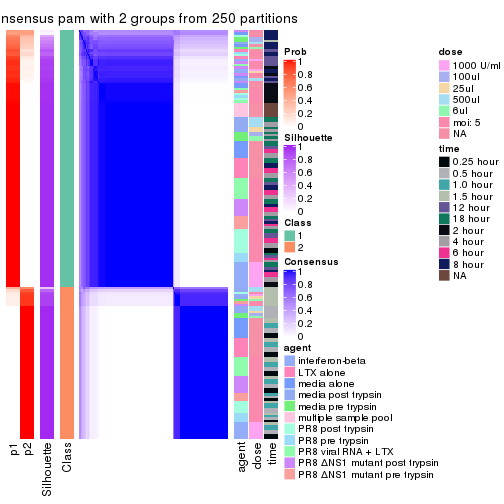
consensus_heatmap(res, k = 3)
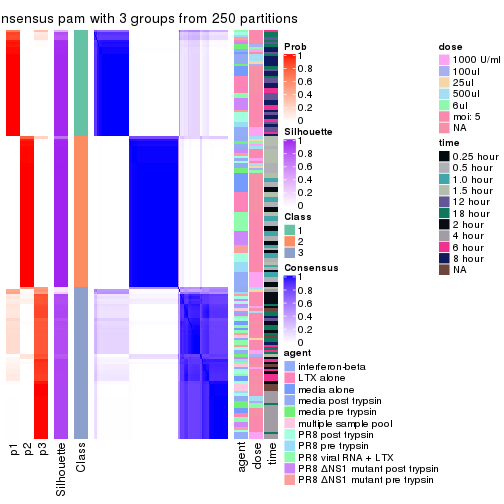
consensus_heatmap(res, k = 4)
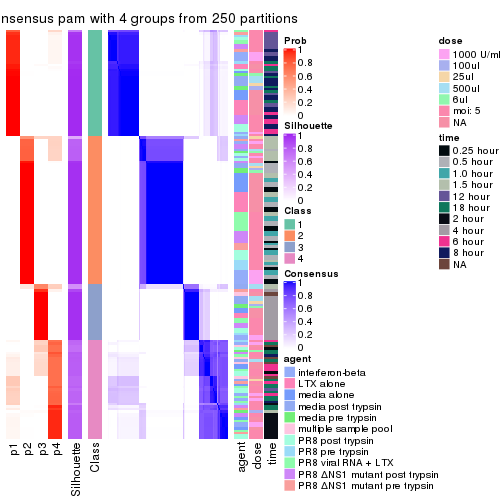
consensus_heatmap(res, k = 5)
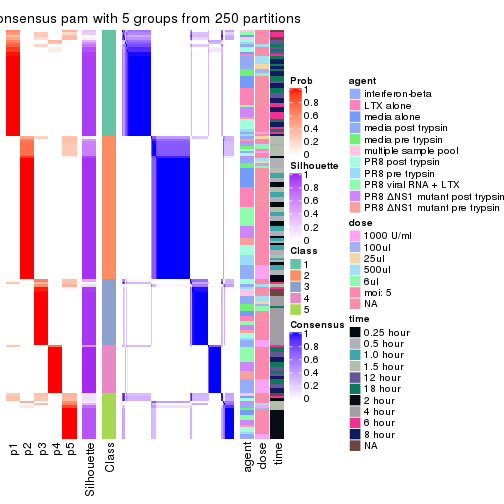
consensus_heatmap(res, k = 6)
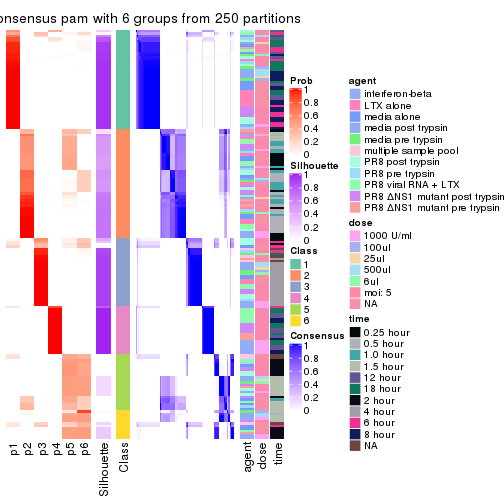
Heatmaps for the membership of samples in all partitions to see how consistent they are:
membership_heatmap(res, k = 2)
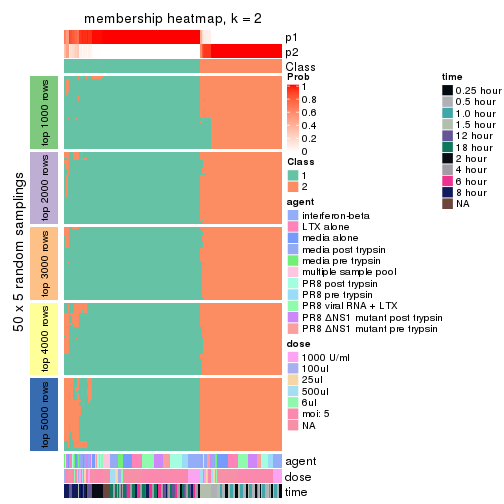
membership_heatmap(res, k = 3)
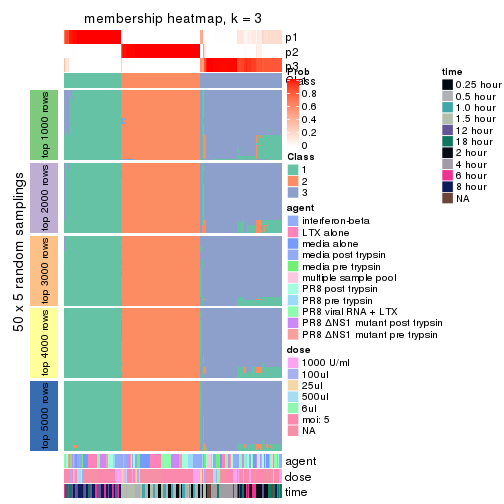
membership_heatmap(res, k = 4)
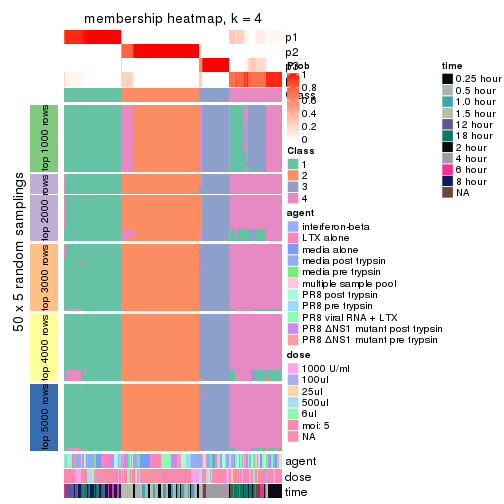
membership_heatmap(res, k = 5)
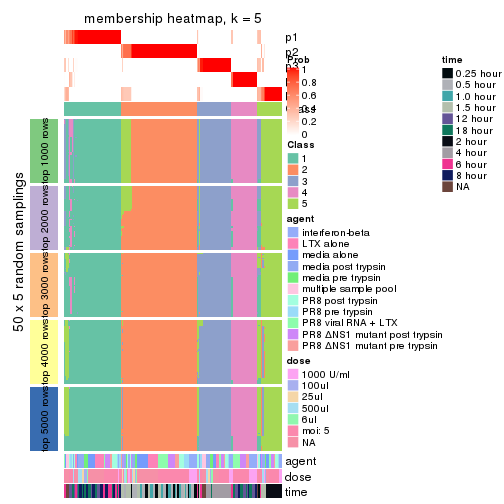
membership_heatmap(res, k = 6)
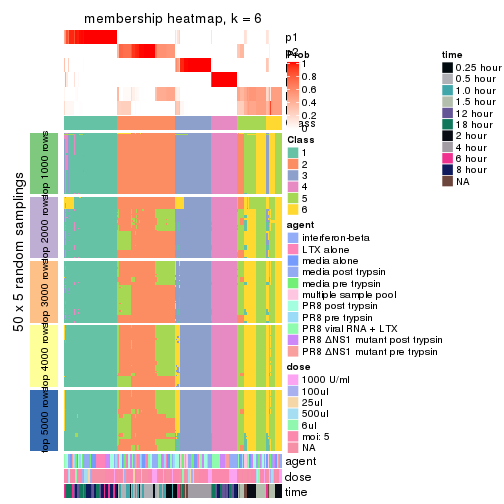
As soon as we have had the classes for columns, we can look for signatures which are significantly different between classes which can be candidate marks for certain classes. Following are the heatmaps for signatures.
Signature heatmaps where rows are scaled:
get_signatures(res, k = 2)
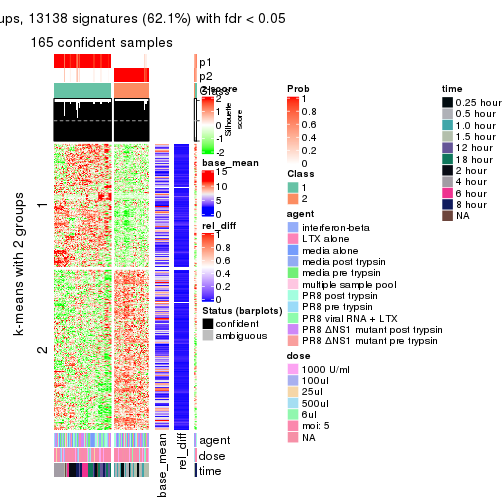
get_signatures(res, k = 3)
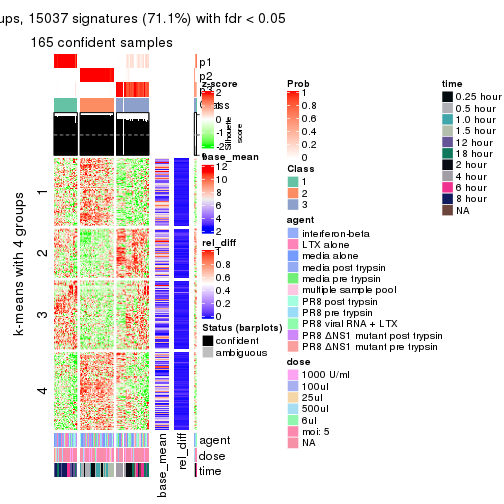
get_signatures(res, k = 4)
#> Error in mat[ceiling(1:nr/h_ratio), ceiling(1:nc/w_ratio), drop = FALSE]: subscript out of bounds
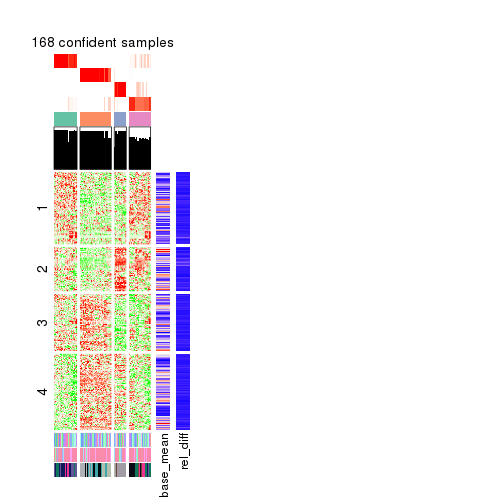
get_signatures(res, k = 5)
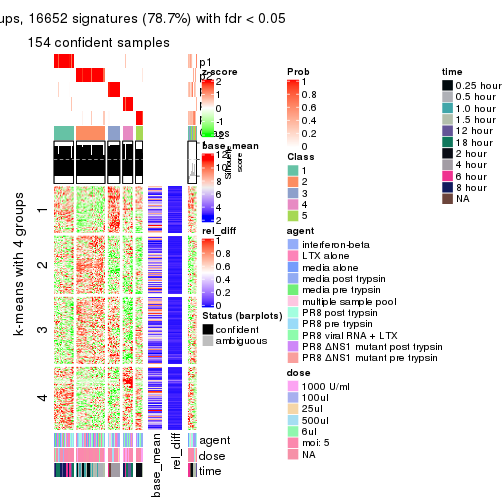
get_signatures(res, k = 6)
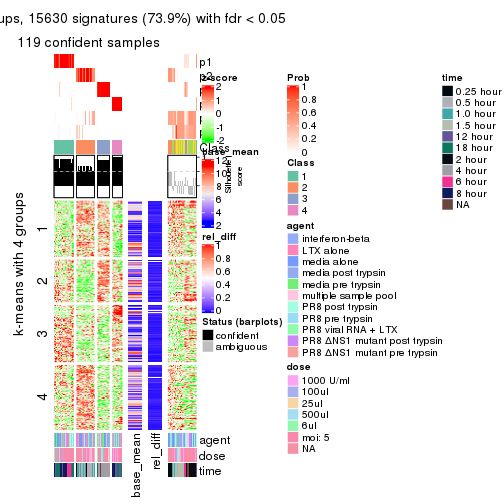
Signature heatmaps where rows are not scaled:
get_signatures(res, k = 2, scale_rows = FALSE)
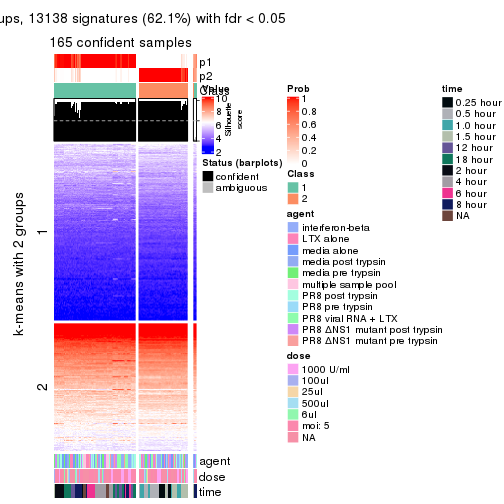
get_signatures(res, k = 3, scale_rows = FALSE)
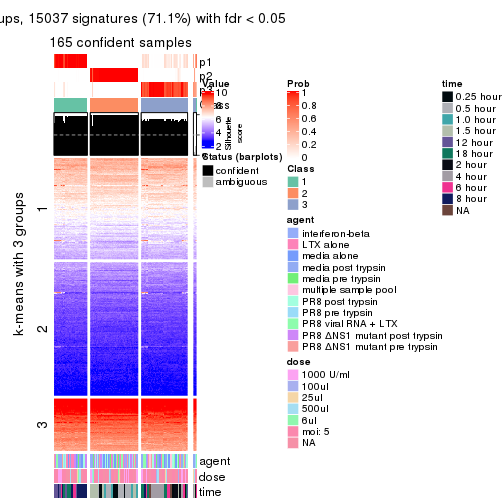
get_signatures(res, k = 4, scale_rows = FALSE)
#> Error in mat[ceiling(1:nr/h_ratio), ceiling(1:nc/w_ratio), drop = FALSE]: subscript out of bounds
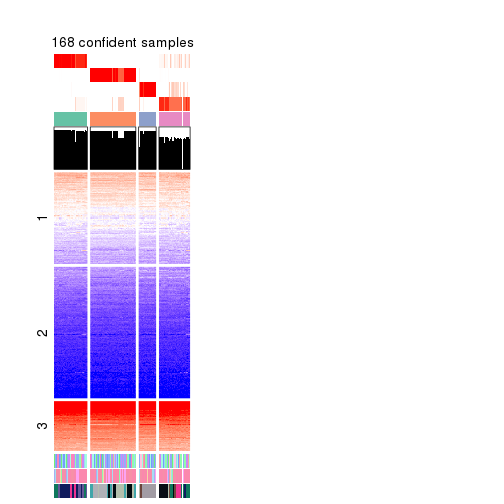
get_signatures(res, k = 5, scale_rows = FALSE)
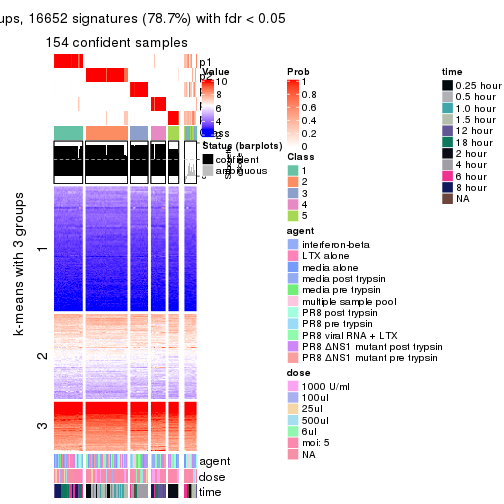
get_signatures(res, k = 6, scale_rows = FALSE)
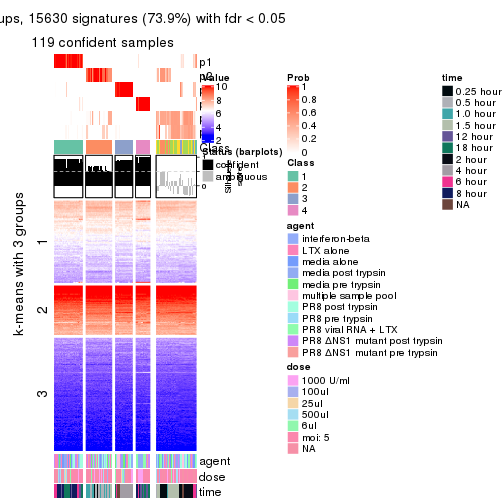
Compare the overlap of signatures from different k:
compare_signatures(res)
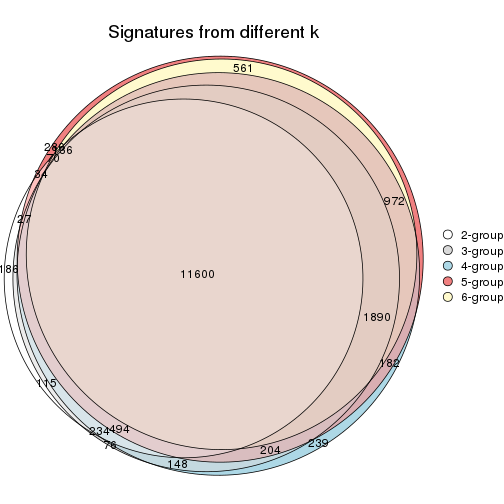
get_signature() returns a data frame invisibly. TO get the list of signatures, the function
call should be assigned to a variable explicitly. In following code, if plot argument is set
to FALSE, no heatmap is plotted while only the differential analysis is performed.
# code only for demonstration
tb = get_signature(res, k = ..., plot = FALSE)
An example of the output of tb is:
#> which_row fdr mean_1 mean_2 scaled_mean_1 scaled_mean_2 km
#> 1 38 0.042760348 8.373488 9.131774 -0.5533452 0.5164555 1
#> 2 40 0.018707592 7.106213 8.469186 -0.6173731 0.5762149 1
#> 3 55 0.019134737 10.221463 11.207825 -0.6159697 0.5749050 1
#> 4 59 0.006059896 5.921854 7.869574 -0.6899429 0.6439467 1
#> 5 60 0.018055526 8.928898 10.211722 -0.6204761 0.5791110 1
#> 6 98 0.009384629 15.714769 14.887706 0.6635654 -0.6193277 2
...
The columns in tb are:
which_row: row indices corresponding to the input matrix.fdr: FDR for the differential test. mean_x: The mean value in group x.scaled_mean_x: The mean value in group x after rows are scaled.km: Row groups if k-means clustering is applied to rows.UMAP plot which shows how samples are separated.
dimension_reduction(res, k = 2, method = "UMAP")
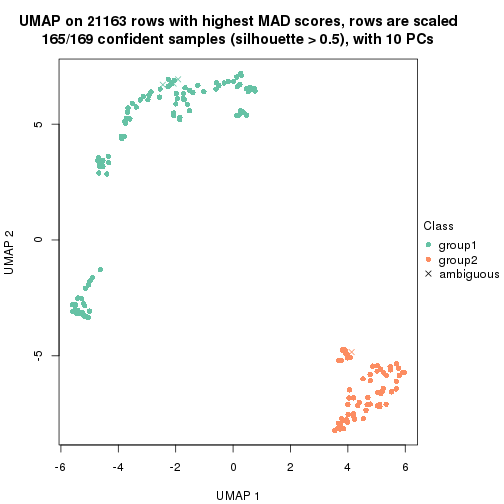
dimension_reduction(res, k = 3, method = "UMAP")
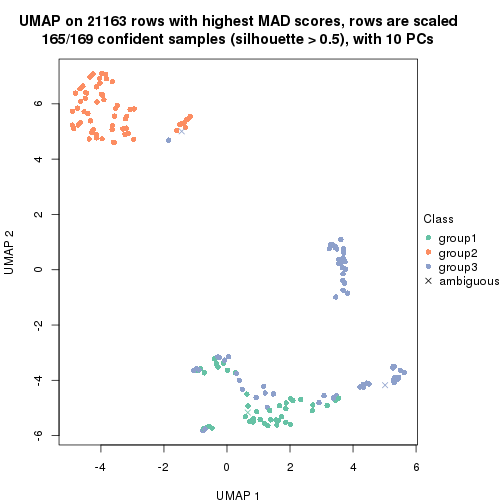
dimension_reduction(res, k = 4, method = "UMAP")
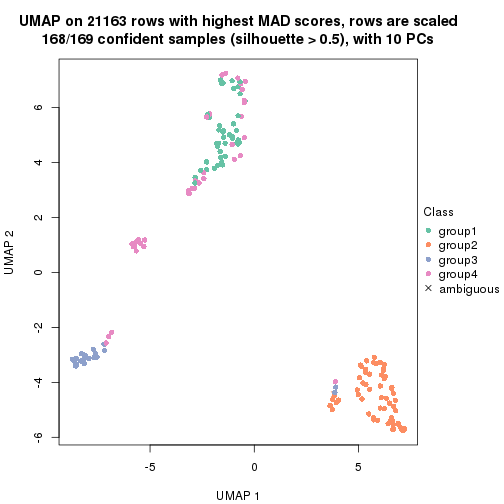
dimension_reduction(res, k = 5, method = "UMAP")
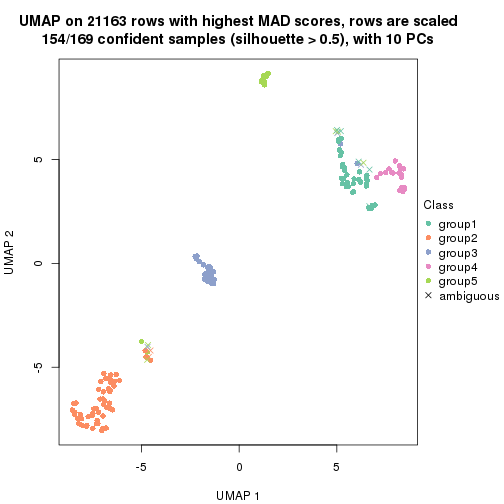
dimension_reduction(res, k = 6, method = "UMAP")
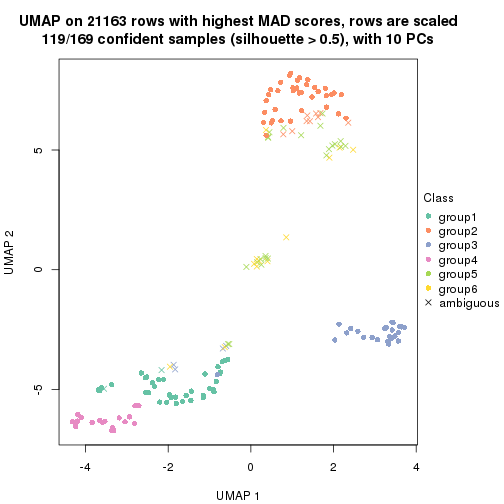
Following heatmap shows how subgroups are split when increasing k:
collect_classes(res)
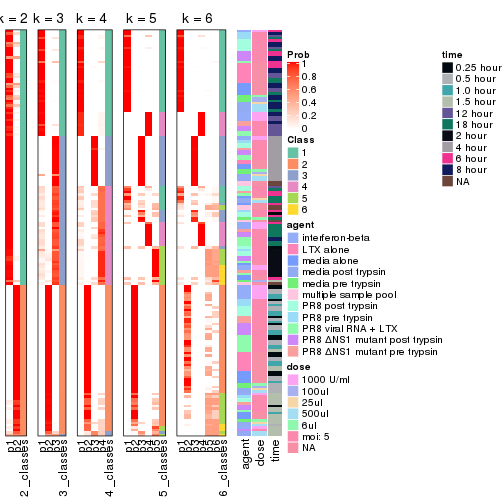
Test correlation between subgroups and known annotations. If the known annotation is numeric, one-way ANOVA test is applied, and if the known annotation is discrete, chi-squared contingency table test is applied.
test_to_known_factors(res)
#> n agent(p) dose(p) time(p) k
#> MAD:pam 165 0.89030 0.9912 6.56e-28 2
#> MAD:pam 165 0.37577 0.9991 3.99e-41 3
#> MAD:pam 168 0.50446 0.9028 5.13e-60 4
#> MAD:pam 154 0.00496 0.0776 1.00e-67 5
#> MAD:pam 119 0.00186 0.0480 4.75e-35 6
If matrix rows can be associated to genes, consider to use functional_enrichment(res,
...) to perform function enrichment for the signature genes. See this vignette for more detailed explanations.
The object with results only for a single top-value method and a single partition method can be extracted as:
res = res_list["MAD", "mclust"]
# you can also extract it by
# res = res_list["MAD:mclust"]
A summary of res and all the functions that can be applied to it:
res
#> A 'ConsensusPartition' object with k = 2, 3, 4, 5, 6.
#> On a matrix with 21163 rows and 169 columns.
#> Top rows (1000, 2000, 3000, 4000, 5000) are extracted by 'MAD' method.
#> Subgroups are detected by 'mclust' method.
#> Performed in total 1250 partitions by row resampling.
#> Best k for subgroups seems to be 2.
#>
#> Following methods can be applied to this 'ConsensusPartition' object:
#> [1] "cola_report" "collect_classes" "collect_plots"
#> [4] "collect_stats" "colnames" "compare_signatures"
#> [7] "consensus_heatmap" "dimension_reduction" "functional_enrichment"
#> [10] "get_anno_col" "get_anno" "get_classes"
#> [13] "get_consensus" "get_matrix" "get_membership"
#> [16] "get_param" "get_signatures" "get_stats"
#> [19] "is_best_k" "is_stable_k" "membership_heatmap"
#> [22] "ncol" "nrow" "plot_ecdf"
#> [25] "rownames" "select_partition_number" "show"
#> [28] "suggest_best_k" "test_to_known_factors"
collect_plots() function collects all the plots made from res for all k (number of partitions)
into one single page to provide an easy and fast comparison between different k.
collect_plots(res)
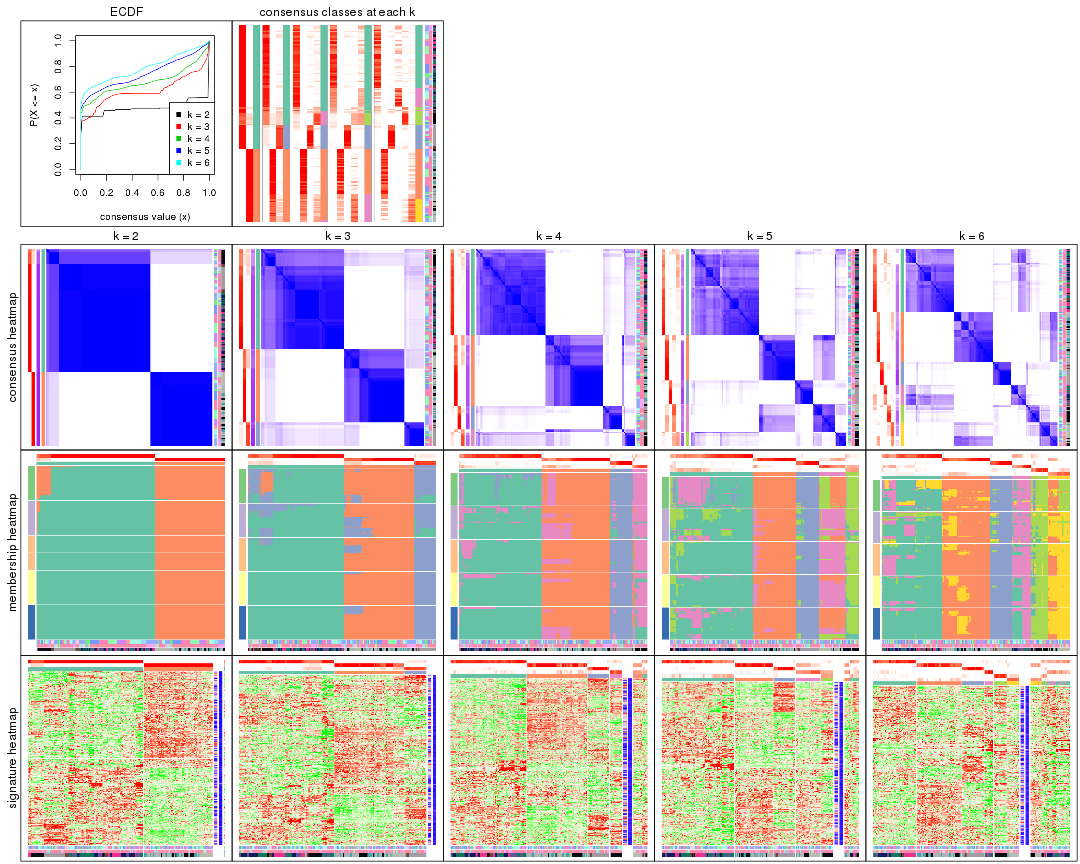
The plots are:
k and the heatmap of
predicted classes for each k.k.k.k.All the plots in panels can be made by individual functions and they are plotted later in this section.
select_partition_number() produces several plots showing different
statistics for choosing “optimized” k. There are following statistics:
k;k, the area increased is defined as \(A_k - A_{k-1}\).The detailed explanations of these statistics can be found in the cola vignette.
Generally speaking, lower PAC score, higher mean silhouette score or higher
concordance corresponds to better partition. Rand index and Jaccard index
measure how similar the current partition is compared to partition with k-1.
If they are too similar, we won't accept k is better than k-1.
select_partition_number(res)
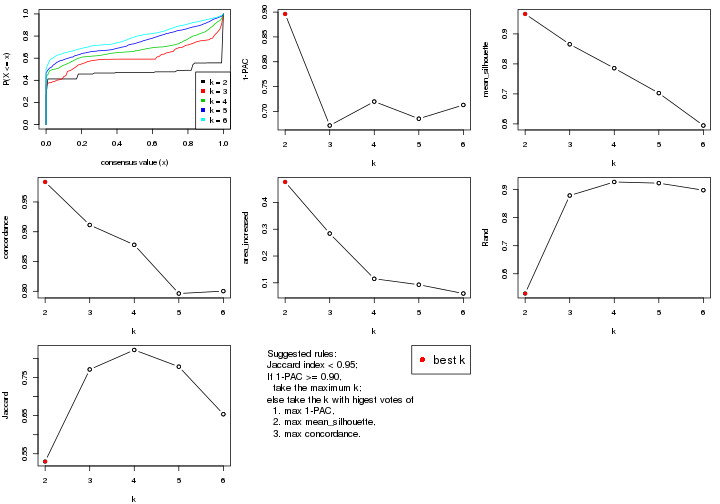
The numeric values for all these statistics can be obtained by get_stats().
get_stats(res)
#> k 1-PAC mean_silhouette concordance area_increased Rand Jaccard
#> 2 2 0.896 0.966 0.984 0.4766 0.530 0.530
#> 3 3 0.671 0.865 0.911 0.2840 0.879 0.771
#> 4 4 0.720 0.786 0.878 0.1149 0.927 0.822
#> 5 5 0.685 0.703 0.796 0.0928 0.923 0.779
#> 6 6 0.713 0.595 0.800 0.0599 0.898 0.654
suggest_best_k() suggests the best \(k\) based on these statistics. The rules are as follows:
suggest_best_k(res)
#> [1] 2
Following shows the table of the partitions (You need to click the show/hide
code output link to see it). The membership matrix (columns with name p*)
is inferred by
clue::cl_consensus()
function with the SE method. Basically the value in the membership matrix
represents the probability to belong to a certain group. The finall class
label for an item is determined with the group with highest probability it
belongs to.
In get_classes() function, the entropy is calculated from the membership
matrix and the silhouette score is calculated from the consensus matrix.
cbind(get_classes(res, k = 2), get_membership(res, k = 2))
#> class entropy silhouette p1 p2
#> GSM528681 2 0.0000 0.999 0.000 1.000
#> GSM528682 2 0.0000 0.999 0.000 1.000
#> GSM528683 2 0.0000 0.999 0.000 1.000
#> GSM528684 2 0.0000 0.999 0.000 1.000
#> GSM528687 2 0.0000 0.999 0.000 1.000
#> GSM528688 2 0.0000 0.999 0.000 1.000
#> GSM528685 2 0.0376 0.996 0.004 0.996
#> GSM528686 2 0.0376 0.996 0.004 0.996
#> GSM528693 1 0.6623 0.812 0.828 0.172
#> GSM528694 1 0.6623 0.812 0.828 0.172
#> GSM528695 1 0.0376 0.972 0.996 0.004
#> GSM528696 1 0.0376 0.972 0.996 0.004
#> GSM528697 1 0.0000 0.974 1.000 0.000
#> GSM528698 1 0.0000 0.974 1.000 0.000
#> GSM528699 1 0.0000 0.974 1.000 0.000
#> GSM528700 1 0.0000 0.974 1.000 0.000
#> GSM528689 1 0.0000 0.974 1.000 0.000
#> GSM528690 1 0.0000 0.974 1.000 0.000
#> GSM528691 1 0.0000 0.974 1.000 0.000
#> GSM528692 1 0.0000 0.974 1.000 0.000
#> GSM528779 2 0.0000 0.999 0.000 1.000
#> GSM528780 2 0.0000 0.999 0.000 1.000
#> GSM528782 2 0.0000 0.999 0.000 1.000
#> GSM528781 2 0.0000 0.999 0.000 1.000
#> GSM528785 1 0.6623 0.812 0.828 0.172
#> GSM528786 1 0.0376 0.972 0.996 0.004
#> GSM528787 1 0.0000 0.974 1.000 0.000
#> GSM528788 1 0.0000 0.974 1.000 0.000
#> GSM528783 1 0.0000 0.974 1.000 0.000
#> GSM528784 1 0.0000 0.974 1.000 0.000
#> GSM528759 1 0.0000 0.974 1.000 0.000
#> GSM528760 1 0.0000 0.974 1.000 0.000
#> GSM528761 2 0.0000 0.999 0.000 1.000
#> GSM528762 2 0.0000 0.999 0.000 1.000
#> GSM528765 2 0.0000 0.999 0.000 1.000
#> GSM528766 2 0.0000 0.999 0.000 1.000
#> GSM528763 2 0.0376 0.996 0.004 0.996
#> GSM528764 2 0.0376 0.996 0.004 0.996
#> GSM528771 1 0.6623 0.812 0.828 0.172
#> GSM528772 1 0.6623 0.812 0.828 0.172
#> GSM528773 1 0.0376 0.972 0.996 0.004
#> GSM528774 1 0.0376 0.972 0.996 0.004
#> GSM528775 1 0.0000 0.974 1.000 0.000
#> GSM528776 1 0.0000 0.974 1.000 0.000
#> GSM528777 1 0.0000 0.974 1.000 0.000
#> GSM528778 1 0.0000 0.974 1.000 0.000
#> GSM528767 1 0.0000 0.974 1.000 0.000
#> GSM528768 1 0.0000 0.974 1.000 0.000
#> GSM528769 1 0.0000 0.974 1.000 0.000
#> GSM528770 1 0.0000 0.974 1.000 0.000
#> GSM528671 2 0.0000 0.999 0.000 1.000
#> GSM528672 2 0.0000 0.999 0.000 1.000
#> GSM528674 2 0.0000 0.999 0.000 1.000
#> GSM528673 2 0.0376 0.996 0.004 0.996
#> GSM528677 1 0.6623 0.812 0.828 0.172
#> GSM528678 1 0.0376 0.972 0.996 0.004
#> GSM528679 1 0.0000 0.974 1.000 0.000
#> GSM528680 1 0.0000 0.974 1.000 0.000
#> GSM528675 1 0.0000 0.974 1.000 0.000
#> GSM528676 1 0.0000 0.974 1.000 0.000
#> GSM528651 2 0.0000 0.999 0.000 1.000
#> GSM528652 2 0.0000 0.999 0.000 1.000
#> GSM528653 2 0.0000 0.999 0.000 1.000
#> GSM528654 2 0.0000 0.999 0.000 1.000
#> GSM528657 2 0.0000 0.999 0.000 1.000
#> GSM528658 2 0.0000 0.999 0.000 1.000
#> GSM528655 2 0.0376 0.996 0.004 0.996
#> GSM528656 2 0.0376 0.996 0.004 0.996
#> GSM528663 1 0.8327 0.678 0.736 0.264
#> GSM528664 1 0.8327 0.678 0.736 0.264
#> GSM528665 1 0.0376 0.972 0.996 0.004
#> GSM528666 1 0.0376 0.972 0.996 0.004
#> GSM528667 1 0.0000 0.974 1.000 0.000
#> GSM528668 1 0.0000 0.974 1.000 0.000
#> GSM528669 1 0.0000 0.974 1.000 0.000
#> GSM528670 1 0.0000 0.974 1.000 0.000
#> GSM528659 1 0.0000 0.974 1.000 0.000
#> GSM528660 1 0.0000 0.974 1.000 0.000
#> GSM528661 1 0.0000 0.974 1.000 0.000
#> GSM528662 1 0.0000 0.974 1.000 0.000
#> GSM528701 2 0.0000 0.999 0.000 1.000
#> GSM528702 2 0.0000 0.999 0.000 1.000
#> GSM528703 2 0.0000 0.999 0.000 1.000
#> GSM528704 2 0.0000 0.999 0.000 1.000
#> GSM528707 2 0.0000 0.999 0.000 1.000
#> GSM528708 2 0.0000 0.999 0.000 1.000
#> GSM528705 2 0.0000 0.999 0.000 1.000
#> GSM528706 2 0.0000 0.999 0.000 1.000
#> GSM528713 1 0.6623 0.812 0.828 0.172
#> GSM528714 1 0.6712 0.807 0.824 0.176
#> GSM528715 1 0.0376 0.972 0.996 0.004
#> GSM528716 1 0.0376 0.972 0.996 0.004
#> GSM528717 1 0.0000 0.974 1.000 0.000
#> GSM528718 1 0.0000 0.974 1.000 0.000
#> GSM528719 1 0.0000 0.974 1.000 0.000
#> GSM528720 1 0.0000 0.974 1.000 0.000
#> GSM528709 1 0.0000 0.974 1.000 0.000
#> GSM528710 1 0.0000 0.974 1.000 0.000
#> GSM528711 1 0.0000 0.974 1.000 0.000
#> GSM528712 1 0.0000 0.974 1.000 0.000
#> GSM528721 2 0.0000 0.999 0.000 1.000
#> GSM528722 2 0.0000 0.999 0.000 1.000
#> GSM528723 2 0.0000 0.999 0.000 1.000
#> GSM528724 2 0.0000 0.999 0.000 1.000
#> GSM528727 2 0.0000 0.999 0.000 1.000
#> GSM528728 2 0.0000 0.999 0.000 1.000
#> GSM528725 2 0.0000 0.999 0.000 1.000
#> GSM528726 2 0.0000 0.999 0.000 1.000
#> GSM528733 1 0.0376 0.972 0.996 0.004
#> GSM528734 1 0.0376 0.972 0.996 0.004
#> GSM528735 1 0.0000 0.974 1.000 0.000
#> GSM528736 1 0.0000 0.974 1.000 0.000
#> GSM528737 1 0.0000 0.974 1.000 0.000
#> GSM528738 1 0.0000 0.974 1.000 0.000
#> GSM528729 1 0.0000 0.974 1.000 0.000
#> GSM528730 1 0.0000 0.974 1.000 0.000
#> GSM528731 1 0.0000 0.974 1.000 0.000
#> GSM528732 1 0.0000 0.974 1.000 0.000
#> GSM528739 2 0.0000 0.999 0.000 1.000
#> GSM528740 2 0.0000 0.999 0.000 1.000
#> GSM528741 2 0.0000 0.999 0.000 1.000
#> GSM528742 2 0.0000 0.999 0.000 1.000
#> GSM528745 2 0.0000 0.999 0.000 1.000
#> GSM528746 2 0.0000 0.999 0.000 1.000
#> GSM528743 2 0.0000 0.999 0.000 1.000
#> GSM528744 2 0.0000 0.999 0.000 1.000
#> GSM528751 1 0.6623 0.812 0.828 0.172
#> GSM528752 1 0.6623 0.812 0.828 0.172
#> GSM528753 1 0.0376 0.972 0.996 0.004
#> GSM528754 1 0.0376 0.972 0.996 0.004
#> GSM528755 1 0.0000 0.974 1.000 0.000
#> GSM528756 1 0.0000 0.974 1.000 0.000
#> GSM528757 1 0.0000 0.974 1.000 0.000
#> GSM528758 1 0.0000 0.974 1.000 0.000
#> GSM528747 1 0.0000 0.974 1.000 0.000
#> GSM528748 1 0.0000 0.974 1.000 0.000
#> GSM528749 1 0.0000 0.974 1.000 0.000
#> GSM528750 1 0.0000 0.974 1.000 0.000
#> GSM528640 2 0.0000 0.999 0.000 1.000
#> GSM528641 2 0.0376 0.996 0.004 0.996
#> GSM528643 1 0.0376 0.972 0.996 0.004
#> GSM528644 1 0.0000 0.974 1.000 0.000
#> GSM528642 1 0.0000 0.974 1.000 0.000
#> GSM528620 2 0.0000 0.999 0.000 1.000
#> GSM528621 1 0.9661 0.412 0.608 0.392
#> GSM528623 1 0.0376 0.972 0.996 0.004
#> GSM528624 1 0.0000 0.974 1.000 0.000
#> GSM528622 1 0.0000 0.974 1.000 0.000
#> GSM528625 2 0.0000 0.999 0.000 1.000
#> GSM528626 2 0.0376 0.996 0.004 0.996
#> GSM528628 1 0.0376 0.972 0.996 0.004
#> GSM528629 1 0.0000 0.974 1.000 0.000
#> GSM528627 1 0.0000 0.974 1.000 0.000
#> GSM528630 2 0.0000 0.999 0.000 1.000
#> GSM528631 2 0.0000 0.999 0.000 1.000
#> GSM528632 2 0.0376 0.996 0.004 0.996
#> GSM528633 2 0.0376 0.996 0.004 0.996
#> GSM528636 1 0.0376 0.972 0.996 0.004
#> GSM528637 1 0.0376 0.972 0.996 0.004
#> GSM528638 1 0.0000 0.974 1.000 0.000
#> GSM528639 1 0.0000 0.974 1.000 0.000
#> GSM528634 1 0.0000 0.974 1.000 0.000
#> GSM528635 1 0.0000 0.974 1.000 0.000
#> GSM528645 1 0.0376 0.972 0.996 0.004
#> GSM528646 1 0.0376 0.972 0.996 0.004
#> GSM528647 1 0.0376 0.972 0.996 0.004
#> GSM528648 1 0.0000 0.974 1.000 0.000
#> GSM528649 1 0.0000 0.974 1.000 0.000
#> GSM528650 1 0.0000 0.974 1.000 0.000
cbind(get_classes(res, k = 3), get_membership(res, k = 3))
#> class entropy silhouette p1 p2 p3
#> GSM528681 2 0.0000 0.925 0.000 1.000 0.000
#> GSM528682 2 0.0000 0.925 0.000 1.000 0.000
#> GSM528683 2 0.0000 0.925 0.000 1.000 0.000
#> GSM528684 2 0.0000 0.925 0.000 1.000 0.000
#> GSM528687 2 0.0000 0.925 0.000 1.000 0.000
#> GSM528688 2 0.0000 0.925 0.000 1.000 0.000
#> GSM528685 2 0.5363 0.764 0.000 0.724 0.276
#> GSM528686 2 0.5397 0.759 0.000 0.720 0.280
#> GSM528693 1 0.7308 0.605 0.656 0.060 0.284
#> GSM528694 1 0.6491 0.710 0.732 0.052 0.216
#> GSM528695 3 0.4796 0.830 0.220 0.000 0.780
#> GSM528696 3 0.4796 0.830 0.220 0.000 0.780
#> GSM528697 1 0.0747 0.899 0.984 0.000 0.016
#> GSM528698 1 0.0000 0.901 1.000 0.000 0.000
#> GSM528699 1 0.1289 0.892 0.968 0.000 0.032
#> GSM528700 1 0.0000 0.901 1.000 0.000 0.000
#> GSM528689 1 0.0000 0.901 1.000 0.000 0.000
#> GSM528690 1 0.0747 0.899 0.984 0.000 0.016
#> GSM528691 1 0.0000 0.901 1.000 0.000 0.000
#> GSM528692 1 0.0892 0.897 0.980 0.000 0.020
#> GSM528779 2 0.0747 0.921 0.000 0.984 0.016
#> GSM528780 2 0.0000 0.925 0.000 1.000 0.000
#> GSM528782 2 0.0000 0.925 0.000 1.000 0.000
#> GSM528781 2 0.5178 0.781 0.000 0.744 0.256
#> GSM528785 1 0.8007 0.581 0.640 0.116 0.244
#> GSM528786 3 0.1860 0.906 0.052 0.000 0.948
#> GSM528787 1 0.4555 0.774 0.800 0.000 0.200
#> GSM528788 1 0.0747 0.899 0.984 0.000 0.016
#> GSM528783 1 0.0747 0.899 0.984 0.000 0.016
#> GSM528784 1 0.0747 0.899 0.984 0.000 0.016
#> GSM528759 1 0.4555 0.755 0.800 0.000 0.200
#> GSM528760 1 0.4291 0.778 0.820 0.000 0.180
#> GSM528761 2 0.1411 0.915 0.000 0.964 0.036
#> GSM528762 2 0.0000 0.925 0.000 1.000 0.000
#> GSM528765 2 0.1964 0.907 0.000 0.944 0.056
#> GSM528766 2 0.0000 0.925 0.000 1.000 0.000
#> GSM528763 2 0.4931 0.800 0.000 0.768 0.232
#> GSM528764 2 0.5404 0.776 0.004 0.740 0.256
#> GSM528771 1 0.8007 0.581 0.640 0.116 0.244
#> GSM528772 1 0.8007 0.581 0.640 0.116 0.244
#> GSM528773 3 0.3038 0.957 0.104 0.000 0.896
#> GSM528774 3 0.3340 0.965 0.120 0.000 0.880
#> GSM528775 1 0.3752 0.813 0.856 0.000 0.144
#> GSM528776 1 0.0000 0.901 1.000 0.000 0.000
#> GSM528777 1 0.0747 0.899 0.984 0.000 0.016
#> GSM528778 1 0.0747 0.899 0.984 0.000 0.016
#> GSM528767 1 0.0747 0.899 0.984 0.000 0.016
#> GSM528768 1 0.0747 0.899 0.984 0.000 0.016
#> GSM528769 1 0.0747 0.899 0.984 0.000 0.016
#> GSM528770 1 0.0747 0.899 0.984 0.000 0.016
#> GSM528671 2 0.3551 0.868 0.000 0.868 0.132
#> GSM528672 2 0.0000 0.925 0.000 1.000 0.000
#> GSM528674 2 0.0000 0.925 0.000 1.000 0.000
#> GSM528673 2 0.5397 0.759 0.000 0.720 0.280
#> GSM528677 1 0.8007 0.581 0.640 0.116 0.244
#> GSM528678 1 0.5858 0.716 0.740 0.020 0.240
#> GSM528679 1 0.0424 0.900 0.992 0.000 0.008
#> GSM528680 1 0.0000 0.901 1.000 0.000 0.000
#> GSM528675 1 0.1031 0.898 0.976 0.000 0.024
#> GSM528676 1 0.1529 0.894 0.960 0.000 0.040
#> GSM528651 2 0.4887 0.801 0.000 0.772 0.228
#> GSM528652 2 0.4796 0.806 0.000 0.780 0.220
#> GSM528653 2 0.0000 0.925 0.000 1.000 0.000
#> GSM528654 2 0.0000 0.925 0.000 1.000 0.000
#> GSM528657 2 0.1643 0.912 0.000 0.956 0.044
#> GSM528658 2 0.0000 0.925 0.000 1.000 0.000
#> GSM528655 2 0.5397 0.759 0.000 0.720 0.280
#> GSM528656 2 0.5397 0.759 0.000 0.720 0.280
#> GSM528663 1 0.8153 0.571 0.640 0.144 0.216
#> GSM528664 1 0.8167 0.569 0.640 0.148 0.212
#> GSM528665 3 0.3267 0.969 0.116 0.000 0.884
#> GSM528666 3 0.3267 0.969 0.116 0.000 0.884
#> GSM528667 1 0.0000 0.901 1.000 0.000 0.000
#> GSM528668 1 0.0000 0.901 1.000 0.000 0.000
#> GSM528669 1 0.0747 0.899 0.984 0.000 0.016
#> GSM528670 1 0.0747 0.899 0.984 0.000 0.016
#> GSM528659 1 0.0747 0.899 0.984 0.000 0.016
#> GSM528660 1 0.0747 0.899 0.984 0.000 0.016
#> GSM528661 1 0.1529 0.894 0.960 0.000 0.040
#> GSM528662 1 0.1163 0.894 0.972 0.000 0.028
#> GSM528701 2 0.0000 0.925 0.000 1.000 0.000
#> GSM528702 2 0.0000 0.925 0.000 1.000 0.000
#> GSM528703 2 0.0000 0.925 0.000 1.000 0.000
#> GSM528704 2 0.0000 0.925 0.000 1.000 0.000
#> GSM528707 2 0.0000 0.925 0.000 1.000 0.000
#> GSM528708 2 0.0000 0.925 0.000 1.000 0.000
#> GSM528705 2 0.0000 0.925 0.000 1.000 0.000
#> GSM528706 2 0.0000 0.925 0.000 1.000 0.000
#> GSM528713 1 0.8007 0.581 0.640 0.116 0.244
#> GSM528714 1 0.8007 0.581 0.640 0.116 0.244
#> GSM528715 3 0.3267 0.969 0.116 0.000 0.884
#> GSM528716 3 0.3267 0.969 0.116 0.000 0.884
#> GSM528717 1 0.0000 0.901 1.000 0.000 0.000
#> GSM528718 1 0.1163 0.893 0.972 0.000 0.028
#> GSM528719 1 0.0747 0.898 0.984 0.000 0.016
#> GSM528720 1 0.0000 0.901 1.000 0.000 0.000
#> GSM528709 1 0.0000 0.901 1.000 0.000 0.000
#> GSM528710 1 0.0747 0.899 0.984 0.000 0.016
#> GSM528711 1 0.0000 0.901 1.000 0.000 0.000
#> GSM528712 1 0.1163 0.893 0.972 0.000 0.028
#> GSM528721 2 0.0000 0.925 0.000 1.000 0.000
#> GSM528722 2 0.0000 0.925 0.000 1.000 0.000
#> GSM528723 2 0.0000 0.925 0.000 1.000 0.000
#> GSM528724 2 0.0000 0.925 0.000 1.000 0.000
#> GSM528727 2 0.1860 0.909 0.000 0.948 0.052
#> GSM528728 2 0.0000 0.925 0.000 1.000 0.000
#> GSM528725 2 0.0000 0.925 0.000 1.000 0.000
#> GSM528726 2 0.0892 0.920 0.000 0.980 0.020
#> GSM528733 3 0.3267 0.969 0.116 0.000 0.884
#> GSM528734 3 0.3267 0.969 0.116 0.000 0.884
#> GSM528735 1 0.1163 0.893 0.972 0.000 0.028
#> GSM528736 1 0.1163 0.893 0.972 0.000 0.028
#> GSM528737 1 0.0000 0.901 1.000 0.000 0.000
#> GSM528738 1 0.0000 0.901 1.000 0.000 0.000
#> GSM528729 1 0.0747 0.899 0.984 0.000 0.016
#> GSM528730 1 0.0747 0.899 0.984 0.000 0.016
#> GSM528731 1 0.0747 0.899 0.984 0.000 0.016
#> GSM528732 1 0.0000 0.901 1.000 0.000 0.000
#> GSM528739 2 0.0000 0.925 0.000 1.000 0.000
#> GSM528740 2 0.0000 0.925 0.000 1.000 0.000
#> GSM528741 2 0.0237 0.924 0.000 0.996 0.004
#> GSM528742 2 0.0000 0.925 0.000 1.000 0.000
#> GSM528745 2 0.4796 0.807 0.000 0.780 0.220
#> GSM528746 2 0.0000 0.925 0.000 1.000 0.000
#> GSM528743 2 0.1964 0.907 0.000 0.944 0.056
#> GSM528744 2 0.1964 0.907 0.000 0.944 0.056
#> GSM528751 1 0.8007 0.581 0.640 0.116 0.244
#> GSM528752 1 0.8007 0.581 0.640 0.116 0.244
#> GSM528753 3 0.3267 0.969 0.116 0.000 0.884
#> GSM528754 3 0.3267 0.969 0.116 0.000 0.884
#> GSM528755 1 0.1964 0.880 0.944 0.000 0.056
#> GSM528756 1 0.2356 0.870 0.928 0.000 0.072
#> GSM528757 1 0.0747 0.899 0.984 0.000 0.016
#> GSM528758 1 0.0747 0.899 0.984 0.000 0.016
#> GSM528747 1 0.0237 0.901 0.996 0.000 0.004
#> GSM528748 1 0.1860 0.883 0.948 0.000 0.052
#> GSM528749 1 0.0237 0.901 0.996 0.000 0.004
#> GSM528750 1 0.0747 0.899 0.984 0.000 0.016
#> GSM528640 2 0.0000 0.925 0.000 1.000 0.000
#> GSM528641 2 0.5397 0.759 0.000 0.720 0.280
#> GSM528643 3 0.3267 0.969 0.116 0.000 0.884
#> GSM528644 1 0.2066 0.878 0.940 0.000 0.060
#> GSM528642 1 0.4002 0.799 0.840 0.000 0.160
#> GSM528620 2 0.1964 0.907 0.000 0.944 0.056
#> GSM528621 1 0.8212 0.551 0.640 0.192 0.168
#> GSM528623 3 0.3267 0.969 0.116 0.000 0.884
#> GSM528624 1 0.0747 0.899 0.984 0.000 0.016
#> GSM528622 1 0.0000 0.901 1.000 0.000 0.000
#> GSM528625 2 0.0000 0.925 0.000 1.000 0.000
#> GSM528626 2 0.5397 0.759 0.000 0.720 0.280
#> GSM528628 3 0.3267 0.969 0.116 0.000 0.884
#> GSM528629 1 0.0592 0.899 0.988 0.000 0.012
#> GSM528627 1 0.1031 0.895 0.976 0.000 0.024
#> GSM528630 2 0.1964 0.907 0.000 0.944 0.056
#> GSM528631 2 0.5327 0.768 0.000 0.728 0.272
#> GSM528632 2 0.6313 0.695 0.016 0.676 0.308
#> GSM528633 2 0.6019 0.732 0.012 0.700 0.288
#> GSM528636 3 0.3267 0.969 0.116 0.000 0.884
#> GSM528637 3 0.3267 0.969 0.116 0.000 0.884
#> GSM528638 1 0.0747 0.899 0.984 0.000 0.016
#> GSM528639 1 0.1529 0.889 0.960 0.000 0.040
#> GSM528634 1 0.1964 0.880 0.944 0.000 0.056
#> GSM528635 1 0.0000 0.901 1.000 0.000 0.000
#> GSM528645 3 0.1860 0.906 0.052 0.000 0.948
#> GSM528646 3 0.1860 0.906 0.052 0.000 0.948
#> GSM528647 1 0.5785 0.605 0.668 0.000 0.332
#> GSM528648 1 0.4121 0.790 0.832 0.000 0.168
#> GSM528649 1 0.4121 0.790 0.832 0.000 0.168
#> GSM528650 1 0.3879 0.806 0.848 0.000 0.152
cbind(get_classes(res, k = 4), get_membership(res, k = 4))
#> class entropy silhouette p1 p2 p3 p4
#> GSM528681 2 0.0000 0.852 0.000 1.000 0.000 0.000
#> GSM528682 2 0.0000 0.852 0.000 1.000 0.000 0.000
#> GSM528683 2 0.0000 0.852 0.000 1.000 0.000 0.000
#> GSM528684 2 0.0000 0.852 0.000 1.000 0.000 0.000
#> GSM528687 2 0.0000 0.852 0.000 1.000 0.000 0.000
#> GSM528688 2 0.0000 0.852 0.000 1.000 0.000 0.000
#> GSM528685 2 0.4977 0.487 0.000 0.540 0.000 0.460
#> GSM528686 2 0.5000 0.405 0.000 0.500 0.000 0.500
#> GSM528693 1 0.4898 0.295 0.584 0.000 0.000 0.416
#> GSM528694 1 0.5581 0.083 0.532 0.000 0.020 0.448
#> GSM528695 3 0.3668 0.716 0.188 0.000 0.808 0.004
#> GSM528696 3 0.3668 0.716 0.188 0.000 0.808 0.004
#> GSM528697 1 0.0336 0.896 0.992 0.000 0.000 0.008
#> GSM528698 1 0.2197 0.887 0.928 0.000 0.024 0.048
#> GSM528699 1 0.3688 0.762 0.792 0.000 0.000 0.208
#> GSM528700 1 0.3569 0.776 0.804 0.000 0.000 0.196
#> GSM528689 1 0.3444 0.791 0.816 0.000 0.000 0.184
#> GSM528690 1 0.1302 0.892 0.956 0.000 0.000 0.044
#> GSM528691 1 0.1970 0.889 0.932 0.000 0.008 0.060
#> GSM528692 1 0.1510 0.899 0.956 0.000 0.016 0.028
#> GSM528779 2 0.3444 0.798 0.000 0.816 0.000 0.184
#> GSM528780 2 0.0707 0.849 0.000 0.980 0.000 0.020
#> GSM528782 2 0.0000 0.852 0.000 1.000 0.000 0.000
#> GSM528781 2 0.4605 0.683 0.000 0.664 0.000 0.336
#> GSM528785 4 0.4543 0.527 0.324 0.000 0.000 0.676
#> GSM528786 3 0.5564 0.709 0.076 0.000 0.708 0.216
#> GSM528787 1 0.6724 0.429 0.612 0.000 0.164 0.224
#> GSM528788 1 0.1854 0.896 0.940 0.000 0.012 0.048
#> GSM528783 1 0.0937 0.897 0.976 0.000 0.012 0.012
#> GSM528784 1 0.0336 0.896 0.992 0.000 0.000 0.008
#> GSM528759 1 0.2255 0.877 0.920 0.000 0.068 0.012
#> GSM528760 1 0.4638 0.721 0.776 0.000 0.180 0.044
#> GSM528761 2 0.2973 0.812 0.000 0.856 0.000 0.144
#> GSM528762 2 0.0000 0.852 0.000 1.000 0.000 0.000
#> GSM528765 2 0.3907 0.772 0.000 0.768 0.000 0.232
#> GSM528766 2 0.0707 0.849 0.000 0.980 0.000 0.020
#> GSM528763 2 0.4522 0.694 0.000 0.680 0.000 0.320
#> GSM528764 2 0.4955 0.517 0.000 0.556 0.000 0.444
#> GSM528771 4 0.2760 0.763 0.128 0.000 0.000 0.872
#> GSM528772 4 0.2760 0.763 0.128 0.000 0.000 0.872
#> GSM528773 3 0.4525 0.789 0.080 0.000 0.804 0.116
#> GSM528774 3 0.2522 0.848 0.076 0.000 0.908 0.016
#> GSM528775 1 0.4614 0.774 0.792 0.000 0.144 0.064
#> GSM528776 1 0.1388 0.897 0.960 0.000 0.012 0.028
#> GSM528777 1 0.1767 0.895 0.944 0.000 0.012 0.044
#> GSM528778 1 0.1767 0.895 0.944 0.000 0.012 0.044
#> GSM528767 1 0.1302 0.892 0.956 0.000 0.000 0.044
#> GSM528768 1 0.0336 0.896 0.992 0.000 0.000 0.008
#> GSM528769 1 0.0336 0.896 0.992 0.000 0.000 0.008
#> GSM528770 1 0.0336 0.896 0.992 0.000 0.000 0.008
#> GSM528671 2 0.4040 0.761 0.000 0.752 0.000 0.248
#> GSM528672 2 0.0000 0.852 0.000 1.000 0.000 0.000
#> GSM528674 2 0.0188 0.852 0.000 0.996 0.000 0.004
#> GSM528673 2 0.4985 0.470 0.000 0.532 0.000 0.468
#> GSM528677 4 0.2760 0.763 0.128 0.000 0.000 0.872
#> GSM528678 1 0.7798 -0.252 0.388 0.000 0.248 0.364
#> GSM528679 1 0.1584 0.893 0.952 0.000 0.036 0.012
#> GSM528680 1 0.3569 0.776 0.804 0.000 0.000 0.196
#> GSM528675 1 0.0336 0.896 0.992 0.000 0.000 0.008
#> GSM528676 1 0.0921 0.896 0.972 0.000 0.000 0.028
#> GSM528651 2 0.4477 0.709 0.000 0.688 0.000 0.312
#> GSM528652 2 0.4304 0.735 0.000 0.716 0.000 0.284
#> GSM528653 2 0.0000 0.852 0.000 1.000 0.000 0.000
#> GSM528654 2 0.0000 0.852 0.000 1.000 0.000 0.000
#> GSM528657 2 0.3356 0.801 0.000 0.824 0.000 0.176
#> GSM528658 2 0.0000 0.852 0.000 1.000 0.000 0.000
#> GSM528655 2 0.4985 0.470 0.000 0.532 0.000 0.468
#> GSM528656 2 0.5000 0.405 0.000 0.500 0.000 0.500
#> GSM528663 4 0.2647 0.760 0.120 0.000 0.000 0.880
#> GSM528664 4 0.2647 0.760 0.120 0.000 0.000 0.880
#> GSM528665 3 0.0000 0.900 0.000 0.000 1.000 0.000
#> GSM528666 3 0.0000 0.900 0.000 0.000 1.000 0.000
#> GSM528667 1 0.1059 0.898 0.972 0.000 0.016 0.012
#> GSM528668 1 0.0937 0.898 0.976 0.000 0.012 0.012
#> GSM528669 1 0.2408 0.861 0.896 0.000 0.000 0.104
#> GSM528670 1 0.3486 0.786 0.812 0.000 0.000 0.188
#> GSM528659 1 0.0336 0.896 0.992 0.000 0.000 0.008
#> GSM528660 1 0.0336 0.896 0.992 0.000 0.000 0.008
#> GSM528661 1 0.0921 0.896 0.972 0.000 0.000 0.028
#> GSM528662 1 0.1867 0.883 0.928 0.000 0.000 0.072
#> GSM528701 2 0.0000 0.852 0.000 1.000 0.000 0.000
#> GSM528702 2 0.0000 0.852 0.000 1.000 0.000 0.000
#> GSM528703 2 0.0000 0.852 0.000 1.000 0.000 0.000
#> GSM528704 2 0.0000 0.852 0.000 1.000 0.000 0.000
#> GSM528707 2 0.0000 0.852 0.000 1.000 0.000 0.000
#> GSM528708 2 0.0469 0.848 0.000 0.988 0.000 0.012
#> GSM528705 2 0.0000 0.852 0.000 1.000 0.000 0.000
#> GSM528706 2 0.3569 0.793 0.000 0.804 0.000 0.196
#> GSM528713 4 0.2868 0.760 0.136 0.000 0.000 0.864
#> GSM528714 4 0.2704 0.762 0.124 0.000 0.000 0.876
#> GSM528715 3 0.0000 0.900 0.000 0.000 1.000 0.000
#> GSM528716 3 0.0000 0.900 0.000 0.000 1.000 0.000
#> GSM528717 1 0.1004 0.895 0.972 0.000 0.024 0.004
#> GSM528718 1 0.2021 0.890 0.936 0.000 0.024 0.040
#> GSM528719 1 0.2443 0.882 0.916 0.000 0.024 0.060
#> GSM528720 1 0.2443 0.882 0.916 0.000 0.024 0.060
#> GSM528709 1 0.2868 0.841 0.864 0.000 0.000 0.136
#> GSM528710 1 0.1557 0.891 0.944 0.000 0.000 0.056
#> GSM528711 1 0.2589 0.855 0.884 0.000 0.000 0.116
#> GSM528712 1 0.3569 0.776 0.804 0.000 0.000 0.196
#> GSM528721 2 0.0000 0.852 0.000 1.000 0.000 0.000
#> GSM528722 2 0.0921 0.848 0.000 0.972 0.000 0.028
#> GSM528723 2 0.0000 0.852 0.000 1.000 0.000 0.000
#> GSM528724 2 0.0000 0.852 0.000 1.000 0.000 0.000
#> GSM528727 2 0.3356 0.800 0.000 0.824 0.000 0.176
#> GSM528728 2 0.0000 0.852 0.000 1.000 0.000 0.000
#> GSM528725 2 0.0000 0.852 0.000 1.000 0.000 0.000
#> GSM528726 2 0.3649 0.788 0.000 0.796 0.000 0.204
#> GSM528733 3 0.0000 0.900 0.000 0.000 1.000 0.000
#> GSM528734 3 0.0000 0.900 0.000 0.000 1.000 0.000
#> GSM528735 1 0.1488 0.895 0.956 0.000 0.032 0.012
#> GSM528736 1 0.1584 0.893 0.952 0.000 0.036 0.012
#> GSM528737 1 0.0937 0.898 0.976 0.000 0.012 0.012
#> GSM528738 1 0.1182 0.898 0.968 0.000 0.016 0.016
#> GSM528729 1 0.1854 0.896 0.940 0.000 0.012 0.048
#> GSM528730 1 0.1854 0.896 0.940 0.000 0.012 0.048
#> GSM528731 1 0.1854 0.896 0.940 0.000 0.012 0.048
#> GSM528732 1 0.1854 0.896 0.940 0.000 0.012 0.048
#> GSM528739 2 0.0000 0.852 0.000 1.000 0.000 0.000
#> GSM528740 2 0.0000 0.852 0.000 1.000 0.000 0.000
#> GSM528741 2 0.1940 0.833 0.000 0.924 0.000 0.076
#> GSM528742 2 0.0188 0.852 0.000 0.996 0.000 0.004
#> GSM528745 2 0.4193 0.745 0.000 0.732 0.000 0.268
#> GSM528746 2 0.0000 0.852 0.000 1.000 0.000 0.000
#> GSM528743 2 0.4072 0.758 0.000 0.748 0.000 0.252
#> GSM528744 2 0.4072 0.758 0.000 0.748 0.000 0.252
#> GSM528751 4 0.4164 0.647 0.264 0.000 0.000 0.736
#> GSM528752 4 0.2973 0.754 0.144 0.000 0.000 0.856
#> GSM528753 3 0.0000 0.900 0.000 0.000 1.000 0.000
#> GSM528754 3 0.0000 0.900 0.000 0.000 1.000 0.000
#> GSM528755 1 0.3156 0.867 0.884 0.000 0.068 0.048
#> GSM528756 1 0.3370 0.857 0.872 0.000 0.080 0.048
#> GSM528757 1 0.1854 0.896 0.940 0.000 0.012 0.048
#> GSM528758 1 0.1854 0.896 0.940 0.000 0.012 0.048
#> GSM528747 1 0.1938 0.896 0.936 0.000 0.012 0.052
#> GSM528748 1 0.2101 0.895 0.928 0.000 0.012 0.060
#> GSM528749 1 0.0937 0.898 0.976 0.000 0.012 0.012
#> GSM528750 1 0.0937 0.897 0.976 0.000 0.012 0.012
#> GSM528640 2 0.0000 0.852 0.000 1.000 0.000 0.000
#> GSM528641 2 0.4955 0.516 0.000 0.556 0.000 0.444
#> GSM528643 3 0.0000 0.900 0.000 0.000 1.000 0.000
#> GSM528644 1 0.4387 0.741 0.752 0.000 0.012 0.236
#> GSM528642 1 0.2142 0.886 0.928 0.000 0.056 0.016
#> GSM528620 2 0.3907 0.772 0.000 0.768 0.000 0.232
#> GSM528621 4 0.2928 0.740 0.108 0.012 0.000 0.880
#> GSM528623 3 0.0376 0.897 0.004 0.000 0.992 0.004
#> GSM528624 1 0.1854 0.896 0.940 0.000 0.012 0.048
#> GSM528622 1 0.1059 0.898 0.972 0.000 0.016 0.012
#> GSM528625 2 0.0000 0.852 0.000 1.000 0.000 0.000
#> GSM528626 2 0.4992 0.456 0.000 0.524 0.000 0.476
#> GSM528628 3 0.1902 0.858 0.064 0.000 0.932 0.004
#> GSM528629 1 0.2542 0.887 0.904 0.000 0.012 0.084
#> GSM528627 1 0.1929 0.893 0.940 0.000 0.036 0.024
#> GSM528630 2 0.3975 0.767 0.000 0.760 0.000 0.240
#> GSM528631 2 0.4907 0.566 0.000 0.580 0.000 0.420
#> GSM528632 4 0.5112 -0.300 0.004 0.436 0.000 0.560
#> GSM528633 4 0.4996 -0.418 0.000 0.484 0.000 0.516
#> GSM528636 3 0.0000 0.900 0.000 0.000 1.000 0.000
#> GSM528637 3 0.0000 0.900 0.000 0.000 1.000 0.000
#> GSM528638 1 0.1854 0.896 0.940 0.000 0.012 0.048
#> GSM528639 1 0.4516 0.715 0.736 0.000 0.012 0.252
#> GSM528634 1 0.2300 0.887 0.924 0.000 0.048 0.028
#> GSM528635 1 0.1059 0.898 0.972 0.000 0.016 0.012
#> GSM528645 3 0.5564 0.709 0.076 0.000 0.708 0.216
#> GSM528646 3 0.5494 0.718 0.076 0.000 0.716 0.208
#> GSM528647 4 0.7896 0.153 0.336 0.000 0.296 0.368
#> GSM528648 1 0.2174 0.884 0.928 0.000 0.052 0.020
#> GSM528649 1 0.4199 0.761 0.804 0.000 0.164 0.032
#> GSM528650 1 0.2256 0.883 0.924 0.000 0.056 0.020
cbind(get_classes(res, k = 5), get_membership(res, k = 5))
#> class entropy silhouette p1 p2 p3 p4 p5
#> GSM528681 2 0.0000 0.8687 0.000 1.000 0.000 0.000 0.000
#> GSM528682 2 0.0162 0.8669 0.000 0.996 0.000 0.000 0.004
#> GSM528683 2 0.0000 0.8687 0.000 1.000 0.000 0.000 0.000
#> GSM528684 2 0.0000 0.8687 0.000 1.000 0.000 0.000 0.000
#> GSM528687 2 0.1544 0.8304 0.000 0.932 0.000 0.068 0.000
#> GSM528688 2 0.0703 0.8618 0.000 0.976 0.000 0.024 0.000
#> GSM528685 4 0.3196 0.7336 0.000 0.192 0.000 0.804 0.004
#> GSM528686 4 0.2890 0.7186 0.000 0.160 0.000 0.836 0.004
#> GSM528693 1 0.6358 0.0307 0.492 0.000 0.000 0.328 0.180
#> GSM528694 1 0.6807 -0.1525 0.440 0.000 0.008 0.340 0.212
#> GSM528695 3 0.3972 0.7393 0.172 0.000 0.788 0.032 0.008
#> GSM528696 3 0.4208 0.7563 0.156 0.000 0.788 0.032 0.024
#> GSM528697 1 0.4182 0.6539 0.600 0.000 0.000 0.000 0.400
#> GSM528698 1 0.3274 0.7383 0.780 0.000 0.000 0.000 0.220
#> GSM528699 5 0.4307 -0.5221 0.496 0.000 0.000 0.000 0.504
#> GSM528700 1 0.4262 0.6015 0.560 0.000 0.000 0.000 0.440
#> GSM528689 1 0.4210 0.6378 0.588 0.000 0.000 0.000 0.412
#> GSM528690 1 0.4074 0.6901 0.636 0.000 0.000 0.000 0.364
#> GSM528691 1 0.2852 0.7537 0.828 0.000 0.000 0.000 0.172
#> GSM528692 1 0.1282 0.7623 0.952 0.000 0.004 0.000 0.044
#> GSM528779 4 0.4283 0.6432 0.000 0.456 0.000 0.544 0.000
#> GSM528780 2 0.1571 0.8219 0.000 0.936 0.000 0.060 0.004
#> GSM528782 2 0.0404 0.8657 0.000 0.988 0.000 0.012 0.000
#> GSM528781 4 0.4276 0.7410 0.000 0.380 0.000 0.616 0.004
#> GSM528785 5 0.6468 0.7594 0.188 0.000 0.000 0.360 0.452
#> GSM528786 3 0.5338 0.7483 0.040 0.000 0.728 0.108 0.124
#> GSM528787 1 0.7452 0.2707 0.532 0.000 0.124 0.160 0.184
#> GSM528788 1 0.1908 0.7651 0.908 0.000 0.000 0.000 0.092
#> GSM528783 1 0.1478 0.7696 0.936 0.000 0.000 0.000 0.064
#> GSM528784 1 0.4268 0.6193 0.556 0.000 0.000 0.000 0.444
#> GSM528759 1 0.2708 0.7465 0.892 0.000 0.072 0.016 0.020
#> GSM528760 1 0.5287 0.6198 0.720 0.000 0.172 0.040 0.068
#> GSM528761 2 0.4434 -0.4945 0.000 0.536 0.000 0.460 0.004
#> GSM528762 2 0.0000 0.8687 0.000 1.000 0.000 0.000 0.000
#> GSM528765 4 0.4448 0.6158 0.000 0.480 0.000 0.516 0.004
#> GSM528766 2 0.1124 0.8457 0.000 0.960 0.000 0.036 0.004
#> GSM528763 4 0.4276 0.7403 0.000 0.380 0.000 0.616 0.004
#> GSM528764 4 0.3635 0.7442 0.000 0.248 0.000 0.748 0.004
#> GSM528771 5 0.5652 0.8526 0.080 0.000 0.000 0.404 0.516
#> GSM528772 5 0.5652 0.8526 0.080 0.000 0.000 0.404 0.516
#> GSM528773 3 0.4447 0.8129 0.048 0.000 0.800 0.072 0.080
#> GSM528774 3 0.2998 0.8659 0.052 0.000 0.884 0.028 0.036
#> GSM528775 1 0.4066 0.7108 0.820 0.000 0.072 0.028 0.080
#> GSM528776 1 0.2011 0.7672 0.908 0.000 0.000 0.004 0.088
#> GSM528777 1 0.3730 0.7269 0.712 0.000 0.000 0.000 0.288
#> GSM528778 1 0.3752 0.7258 0.708 0.000 0.000 0.000 0.292
#> GSM528767 1 0.4101 0.6851 0.628 0.000 0.000 0.000 0.372
#> GSM528768 1 0.3949 0.7045 0.668 0.000 0.000 0.000 0.332
#> GSM528769 1 0.4273 0.6163 0.552 0.000 0.000 0.000 0.448
#> GSM528770 1 0.4015 0.6889 0.652 0.000 0.000 0.000 0.348
#> GSM528671 4 0.4201 0.7156 0.000 0.408 0.000 0.592 0.000
#> GSM528672 2 0.0000 0.8687 0.000 1.000 0.000 0.000 0.000
#> GSM528674 2 0.1965 0.7799 0.000 0.904 0.000 0.096 0.000
#> GSM528673 4 0.2890 0.7186 0.000 0.160 0.000 0.836 0.004
#> GSM528677 5 0.5568 0.8496 0.072 0.000 0.000 0.412 0.516
#> GSM528678 1 0.8370 -0.0936 0.376 0.000 0.196 0.216 0.212
#> GSM528679 1 0.1270 0.7774 0.948 0.000 0.000 0.000 0.052
#> GSM528680 1 0.4273 0.5833 0.552 0.000 0.000 0.000 0.448
#> GSM528675 1 0.4294 0.6037 0.532 0.000 0.000 0.000 0.468
#> GSM528676 1 0.4434 0.6049 0.536 0.000 0.000 0.004 0.460
#> GSM528651 4 0.4138 0.7396 0.000 0.384 0.000 0.616 0.000
#> GSM528652 4 0.4331 0.7226 0.000 0.400 0.000 0.596 0.004
#> GSM528653 2 0.0000 0.8687 0.000 1.000 0.000 0.000 0.000
#> GSM528654 2 0.0794 0.8567 0.000 0.972 0.000 0.028 0.000
#> GSM528657 2 0.4450 -0.5699 0.000 0.508 0.000 0.488 0.004
#> GSM528658 2 0.0000 0.8687 0.000 1.000 0.000 0.000 0.000
#> GSM528655 4 0.2890 0.7186 0.000 0.160 0.000 0.836 0.004
#> GSM528656 4 0.2890 0.7186 0.000 0.160 0.000 0.836 0.004
#> GSM528663 5 0.5334 0.8387 0.052 0.000 0.000 0.436 0.512
#> GSM528664 5 0.5334 0.8387 0.052 0.000 0.000 0.436 0.512
#> GSM528665 3 0.0000 0.9118 0.000 0.000 1.000 0.000 0.000
#> GSM528666 3 0.0000 0.9118 0.000 0.000 1.000 0.000 0.000
#> GSM528667 1 0.0162 0.7664 0.996 0.000 0.000 0.000 0.004
#> GSM528668 1 0.0290 0.7670 0.992 0.000 0.000 0.000 0.008
#> GSM528669 1 0.3949 0.7110 0.668 0.000 0.000 0.000 0.332
#> GSM528670 1 0.4287 0.6000 0.540 0.000 0.000 0.000 0.460
#> GSM528659 1 0.4291 0.6060 0.536 0.000 0.000 0.000 0.464
#> GSM528660 1 0.4294 0.6037 0.532 0.000 0.000 0.000 0.468
#> GSM528661 1 0.4367 0.6309 0.580 0.000 0.000 0.004 0.416
#> GSM528662 1 0.4084 0.6970 0.668 0.000 0.000 0.004 0.328
#> GSM528701 2 0.1671 0.8221 0.000 0.924 0.000 0.076 0.000
#> GSM528702 2 0.1608 0.8265 0.000 0.928 0.000 0.072 0.000
#> GSM528703 2 0.1357 0.8349 0.000 0.948 0.000 0.048 0.004
#> GSM528704 2 0.0000 0.8687 0.000 1.000 0.000 0.000 0.000
#> GSM528707 2 0.0000 0.8687 0.000 1.000 0.000 0.000 0.000
#> GSM528708 2 0.1410 0.8334 0.000 0.940 0.000 0.060 0.000
#> GSM528705 2 0.0290 0.8674 0.000 0.992 0.000 0.008 0.000
#> GSM528706 4 0.4273 0.6559 0.000 0.448 0.000 0.552 0.000
#> GSM528713 5 0.5808 0.8484 0.096 0.000 0.000 0.392 0.512
#> GSM528714 5 0.5435 0.8451 0.060 0.000 0.000 0.428 0.512
#> GSM528715 3 0.0000 0.9118 0.000 0.000 1.000 0.000 0.000
#> GSM528716 3 0.0000 0.9118 0.000 0.000 1.000 0.000 0.000
#> GSM528717 1 0.1478 0.7769 0.936 0.000 0.000 0.000 0.064
#> GSM528718 1 0.2338 0.7560 0.884 0.000 0.000 0.004 0.112
#> GSM528719 1 0.3491 0.7338 0.768 0.000 0.000 0.004 0.228
#> GSM528720 1 0.3636 0.7192 0.728 0.000 0.000 0.000 0.272
#> GSM528709 1 0.4045 0.6878 0.644 0.000 0.000 0.000 0.356
#> GSM528710 1 0.4182 0.6812 0.600 0.000 0.000 0.000 0.400
#> GSM528711 1 0.3949 0.7015 0.668 0.000 0.000 0.000 0.332
#> GSM528712 1 0.4235 0.6040 0.576 0.000 0.000 0.000 0.424
#> GSM528721 2 0.0162 0.8680 0.000 0.996 0.000 0.004 0.000
#> GSM528722 2 0.2377 0.7560 0.000 0.872 0.000 0.128 0.000
#> GSM528723 2 0.0000 0.8687 0.000 1.000 0.000 0.000 0.000
#> GSM528724 2 0.0000 0.8687 0.000 1.000 0.000 0.000 0.000
#> GSM528727 2 0.4450 -0.5699 0.000 0.508 0.000 0.488 0.004
#> GSM528728 2 0.0000 0.8687 0.000 1.000 0.000 0.000 0.000
#> GSM528725 2 0.1544 0.8301 0.000 0.932 0.000 0.068 0.000
#> GSM528726 2 0.4451 -0.5837 0.000 0.504 0.000 0.492 0.004
#> GSM528733 3 0.0000 0.9118 0.000 0.000 1.000 0.000 0.000
#> GSM528734 3 0.0000 0.9118 0.000 0.000 1.000 0.000 0.000
#> GSM528735 1 0.0162 0.7664 0.996 0.000 0.000 0.000 0.004
#> GSM528736 1 0.0671 0.7681 0.980 0.000 0.016 0.000 0.004
#> GSM528737 1 0.0290 0.7677 0.992 0.000 0.000 0.000 0.008
#> GSM528738 1 0.0162 0.7675 0.996 0.000 0.000 0.000 0.004
#> GSM528729 1 0.2127 0.7662 0.892 0.000 0.000 0.000 0.108
#> GSM528730 1 0.1965 0.7684 0.904 0.000 0.000 0.000 0.096
#> GSM528731 1 0.1851 0.7648 0.912 0.000 0.000 0.000 0.088
#> GSM528732 1 0.0794 0.7697 0.972 0.000 0.000 0.000 0.028
#> GSM528739 2 0.1608 0.8265 0.000 0.928 0.000 0.072 0.000
#> GSM528740 2 0.1608 0.8265 0.000 0.928 0.000 0.072 0.000
#> GSM528741 2 0.3333 0.5291 0.000 0.788 0.000 0.208 0.004
#> GSM528742 2 0.1124 0.8457 0.000 0.960 0.000 0.036 0.004
#> GSM528745 4 0.4299 0.7378 0.000 0.388 0.000 0.608 0.004
#> GSM528746 2 0.0000 0.8687 0.000 1.000 0.000 0.000 0.000
#> GSM528743 4 0.4375 0.7051 0.000 0.420 0.000 0.576 0.004
#> GSM528744 4 0.4430 0.6627 0.000 0.456 0.000 0.540 0.004
#> GSM528751 5 0.6360 0.7982 0.164 0.000 0.000 0.388 0.448
#> GSM528752 5 0.6100 0.8308 0.128 0.000 0.000 0.388 0.484
#> GSM528753 3 0.0000 0.9118 0.000 0.000 1.000 0.000 0.000
#> GSM528754 3 0.0000 0.9118 0.000 0.000 1.000 0.000 0.000
#> GSM528755 1 0.3013 0.7443 0.880 0.000 0.044 0.016 0.060
#> GSM528756 1 0.3223 0.7382 0.868 0.000 0.052 0.016 0.064
#> GSM528757 1 0.1908 0.7651 0.908 0.000 0.000 0.000 0.092
#> GSM528758 1 0.1908 0.7651 0.908 0.000 0.000 0.000 0.092
#> GSM528747 1 0.0963 0.7711 0.964 0.000 0.000 0.000 0.036
#> GSM528748 1 0.1197 0.7656 0.952 0.000 0.000 0.000 0.048
#> GSM528749 1 0.0000 0.7662 1.000 0.000 0.000 0.000 0.000
#> GSM528750 1 0.1544 0.7665 0.932 0.000 0.000 0.000 0.068
#> GSM528640 2 0.0000 0.8687 0.000 1.000 0.000 0.000 0.000
#> GSM528641 4 0.3086 0.7323 0.000 0.180 0.000 0.816 0.004
#> GSM528643 3 0.0000 0.9118 0.000 0.000 1.000 0.000 0.000
#> GSM528644 1 0.4249 0.4898 0.688 0.000 0.000 0.016 0.296
#> GSM528642 1 0.2037 0.7633 0.920 0.000 0.064 0.004 0.012
#> GSM528620 4 0.4437 0.6498 0.000 0.464 0.000 0.532 0.004
#> GSM528621 5 0.5283 0.8315 0.048 0.000 0.000 0.444 0.508
#> GSM528623 3 0.0771 0.9033 0.020 0.000 0.976 0.004 0.000
#> GSM528624 1 0.1965 0.7652 0.904 0.000 0.000 0.000 0.096
#> GSM528622 1 0.0000 0.7662 1.000 0.000 0.000 0.000 0.000
#> GSM528625 2 0.0000 0.8687 0.000 1.000 0.000 0.000 0.000
#> GSM528626 4 0.2890 0.7186 0.000 0.160 0.000 0.836 0.004
#> GSM528628 3 0.1168 0.8971 0.032 0.000 0.960 0.008 0.000
#> GSM528629 1 0.1608 0.7659 0.928 0.000 0.000 0.000 0.072
#> GSM528627 1 0.0798 0.7663 0.976 0.000 0.008 0.000 0.016
#> GSM528630 4 0.4437 0.6498 0.000 0.464 0.000 0.532 0.004
#> GSM528631 4 0.4101 0.7446 0.000 0.372 0.000 0.628 0.000
#> GSM528632 4 0.5389 0.4847 0.004 0.160 0.000 0.680 0.156
#> GSM528633 4 0.3013 0.7145 0.000 0.160 0.000 0.832 0.008
#> GSM528636 3 0.0000 0.9118 0.000 0.000 1.000 0.000 0.000
#> GSM528637 3 0.0000 0.9118 0.000 0.000 1.000 0.000 0.000
#> GSM528638 1 0.1908 0.7651 0.908 0.000 0.000 0.000 0.092
#> GSM528639 1 0.4663 0.3618 0.604 0.000 0.000 0.020 0.376
#> GSM528634 1 0.1648 0.7644 0.940 0.000 0.040 0.000 0.020
#> GSM528635 1 0.0290 0.7670 0.992 0.000 0.000 0.000 0.008
#> GSM528645 3 0.5290 0.7516 0.040 0.000 0.732 0.104 0.124
#> GSM528646 3 0.5241 0.7551 0.040 0.000 0.736 0.100 0.124
#> GSM528647 1 0.8421 -0.1510 0.360 0.000 0.196 0.216 0.228
#> GSM528648 1 0.2054 0.7553 0.916 0.000 0.072 0.004 0.008
#> GSM528649 1 0.3745 0.7133 0.828 0.000 0.096 0.008 0.068
#> GSM528650 1 0.2054 0.7553 0.916 0.000 0.072 0.004 0.008
cbind(get_classes(res, k = 6), get_membership(res, k = 6))
#> class entropy silhouette p1 p2 p3 p4 p5 p6
#> GSM528681 2 0.0146 7.95e-01 0.000 0.996 0.000 0.000 0.000 0.004
#> GSM528682 2 0.0260 7.95e-01 0.000 0.992 0.000 0.000 0.000 0.008
#> GSM528683 2 0.0260 7.95e-01 0.000 0.992 0.000 0.000 0.000 0.008
#> GSM528684 2 0.0260 7.95e-01 0.000 0.992 0.000 0.000 0.000 0.008
#> GSM528687 2 0.3175 5.84e-01 0.000 0.744 0.000 0.000 0.000 0.256
#> GSM528688 2 0.2092 7.47e-01 0.000 0.876 0.000 0.000 0.000 0.124
#> GSM528685 6 0.3620 5.81e-01 0.000 0.044 0.000 0.000 0.184 0.772
#> GSM528686 6 0.3023 5.51e-01 0.000 0.000 0.000 0.000 0.232 0.768
#> GSM528693 5 0.3706 4.54e-01 0.380 0.000 0.000 0.000 0.620 0.000
#> GSM528694 5 0.3371 6.01e-01 0.292 0.000 0.000 0.000 0.708 0.000
#> GSM528695 3 0.3782 7.69e-01 0.140 0.000 0.784 0.004 0.072 0.000
#> GSM528696 3 0.3782 7.69e-01 0.140 0.000 0.784 0.004 0.072 0.000
#> GSM528697 4 0.3141 5.98e-01 0.200 0.000 0.000 0.788 0.000 0.012
#> GSM528698 1 0.4681 3.76e-01 0.688 0.000 0.000 0.240 0.032 0.040
#> GSM528699 4 0.5819 1.62e-01 0.440 0.000 0.000 0.448 0.064 0.048
#> GSM528700 1 0.5363 -1.56e-01 0.472 0.000 0.000 0.452 0.032 0.044
#> GSM528689 1 0.5301 -1.47e-01 0.476 0.000 0.000 0.452 0.028 0.044
#> GSM528690 4 0.4121 4.32e-01 0.380 0.000 0.000 0.604 0.000 0.016
#> GSM528691 1 0.4701 3.67e-01 0.676 0.000 0.000 0.256 0.028 0.040
#> GSM528692 1 0.0922 7.17e-01 0.968 0.000 0.000 0.004 0.024 0.004
#> GSM528779 6 0.3868 9.51e-05 0.000 0.492 0.000 0.000 0.000 0.508
#> GSM528780 2 0.2135 7.43e-01 0.000 0.872 0.000 0.000 0.000 0.128
#> GSM528782 2 0.1141 7.85e-01 0.000 0.948 0.000 0.000 0.000 0.052
#> GSM528781 6 0.4261 2.34e-01 0.000 0.408 0.000 0.000 0.020 0.572
#> GSM528785 5 0.2750 7.61e-01 0.136 0.000 0.000 0.020 0.844 0.000
#> GSM528786 3 0.3274 8.15e-01 0.024 0.000 0.804 0.004 0.168 0.000
#> GSM528787 1 0.5358 -4.19e-02 0.496 0.000 0.112 0.000 0.392 0.000
#> GSM528788 1 0.4195 5.78e-01 0.724 0.000 0.000 0.200 0.000 0.076
#> GSM528783 1 0.3667 6.32e-01 0.788 0.000 0.000 0.132 0.000 0.080
#> GSM528784 4 0.1500 6.03e-01 0.052 0.000 0.000 0.936 0.000 0.012
#> GSM528759 1 0.1826 6.99e-01 0.924 0.000 0.020 0.004 0.052 0.000
#> GSM528760 1 0.4800 4.45e-01 0.672 0.000 0.168 0.000 0.160 0.000
#> GSM528761 2 0.3428 5.54e-01 0.000 0.696 0.000 0.000 0.000 0.304
#> GSM528762 2 0.0146 7.95e-01 0.000 0.996 0.000 0.000 0.000 0.004
#> GSM528765 2 0.3531 5.16e-01 0.000 0.672 0.000 0.000 0.000 0.328
#> GSM528766 2 0.1814 7.63e-01 0.000 0.900 0.000 0.000 0.000 0.100
#> GSM528763 6 0.3626 6.09e-01 0.000 0.144 0.000 0.000 0.068 0.788
#> GSM528764 6 0.3201 5.67e-01 0.000 0.012 0.000 0.000 0.208 0.780
#> GSM528771 5 0.1075 7.98e-01 0.048 0.000 0.000 0.000 0.952 0.000
#> GSM528772 5 0.1007 7.98e-01 0.044 0.000 0.000 0.000 0.956 0.000
#> GSM528773 3 0.3091 8.35e-01 0.024 0.000 0.824 0.004 0.148 0.000
#> GSM528774 3 0.2126 8.87e-01 0.020 0.000 0.904 0.004 0.072 0.000
#> GSM528775 1 0.2815 6.58e-01 0.848 0.000 0.032 0.000 0.120 0.000
#> GSM528776 1 0.1851 7.06e-01 0.928 0.000 0.000 0.024 0.036 0.012
#> GSM528777 4 0.5190 1.39e-01 0.452 0.000 0.000 0.460 0.000 0.088
#> GSM528778 4 0.5187 1.78e-01 0.440 0.000 0.000 0.472 0.000 0.088
#> GSM528767 4 0.3887 4.62e-01 0.360 0.000 0.000 0.632 0.000 0.008
#> GSM528768 4 0.3841 4.51e-01 0.380 0.000 0.000 0.616 0.000 0.004
#> GSM528769 4 0.1367 5.99e-01 0.044 0.000 0.000 0.944 0.000 0.012
#> GSM528770 4 0.4057 4.39e-01 0.388 0.000 0.000 0.600 0.000 0.012
#> GSM528671 6 0.3817 1.69e-01 0.000 0.432 0.000 0.000 0.000 0.568
#> GSM528672 2 0.0713 7.96e-01 0.000 0.972 0.000 0.000 0.000 0.028
#> GSM528674 2 0.1957 7.57e-01 0.000 0.888 0.000 0.000 0.000 0.112
#> GSM528673 6 0.2941 5.61e-01 0.000 0.000 0.000 0.000 0.220 0.780
#> GSM528677 5 0.0806 7.81e-01 0.008 0.000 0.000 0.000 0.972 0.020
#> GSM528678 5 0.5688 2.92e-01 0.176 0.000 0.328 0.000 0.496 0.000
#> GSM528679 1 0.0405 7.17e-01 0.988 0.000 0.000 0.004 0.008 0.000
#> GSM528680 1 0.5422 -1.76e-01 0.464 0.000 0.000 0.456 0.036 0.044
#> GSM528675 4 0.0458 5.97e-01 0.016 0.000 0.000 0.984 0.000 0.000
#> GSM528676 4 0.0363 5.96e-01 0.012 0.000 0.000 0.988 0.000 0.000
#> GSM528651 6 0.4361 2.17e-01 0.000 0.424 0.000 0.000 0.024 0.552
#> GSM528652 6 0.3782 2.07e-01 0.000 0.412 0.000 0.000 0.000 0.588
#> GSM528653 2 0.0713 7.96e-01 0.000 0.972 0.000 0.000 0.000 0.028
#> GSM528654 2 0.2597 6.92e-01 0.000 0.824 0.000 0.000 0.000 0.176
#> GSM528657 2 0.3531 5.16e-01 0.000 0.672 0.000 0.000 0.000 0.328
#> GSM528658 2 0.0146 7.96e-01 0.000 0.996 0.000 0.000 0.000 0.004
#> GSM528655 6 0.2996 5.54e-01 0.000 0.000 0.000 0.000 0.228 0.772
#> GSM528656 6 0.3109 5.59e-01 0.000 0.004 0.000 0.000 0.224 0.772
#> GSM528663 5 0.1082 7.72e-01 0.004 0.000 0.000 0.000 0.956 0.040
#> GSM528664 5 0.1082 7.72e-01 0.004 0.000 0.000 0.000 0.956 0.040
#> GSM528665 3 0.0000 9.26e-01 0.000 0.000 1.000 0.000 0.000 0.000
#> GSM528666 3 0.0000 9.26e-01 0.000 0.000 1.000 0.000 0.000 0.000
#> GSM528667 1 0.0260 7.17e-01 0.992 0.000 0.000 0.008 0.000 0.000
#> GSM528668 1 0.0363 7.17e-01 0.988 0.000 0.000 0.012 0.000 0.000
#> GSM528669 4 0.4561 3.12e-01 0.428 0.000 0.000 0.536 0.000 0.036
#> GSM528670 1 0.5128 -2.09e-01 0.472 0.000 0.000 0.468 0.024 0.036
#> GSM528659 4 0.0260 5.95e-01 0.008 0.000 0.000 0.992 0.000 0.000
#> GSM528660 4 0.0260 5.95e-01 0.008 0.000 0.000 0.992 0.000 0.000
#> GSM528661 4 0.1152 5.94e-01 0.044 0.000 0.000 0.952 0.000 0.004
#> GSM528662 1 0.4956 -7.11e-04 0.536 0.000 0.000 0.412 0.020 0.032
#> GSM528701 2 0.3428 5.07e-01 0.000 0.696 0.000 0.000 0.000 0.304
#> GSM528702 2 0.3330 5.42e-01 0.000 0.716 0.000 0.000 0.000 0.284
#> GSM528703 2 0.2003 7.51e-01 0.000 0.884 0.000 0.000 0.000 0.116
#> GSM528704 2 0.0146 7.95e-01 0.000 0.996 0.000 0.000 0.000 0.004
#> GSM528707 2 0.0632 7.96e-01 0.000 0.976 0.000 0.000 0.000 0.024
#> GSM528708 2 0.3445 5.79e-01 0.000 0.744 0.000 0.000 0.012 0.244
#> GSM528705 2 0.1556 7.77e-01 0.000 0.920 0.000 0.000 0.000 0.080
#> GSM528706 6 0.3867 3.18e-02 0.000 0.488 0.000 0.000 0.000 0.512
#> GSM528713 5 0.1267 7.97e-01 0.060 0.000 0.000 0.000 0.940 0.000
#> GSM528714 5 0.0806 7.81e-01 0.008 0.000 0.000 0.000 0.972 0.020
#> GSM528715 3 0.0000 9.26e-01 0.000 0.000 1.000 0.000 0.000 0.000
#> GSM528716 3 0.0000 9.26e-01 0.000 0.000 1.000 0.000 0.000 0.000
#> GSM528717 1 0.1313 7.15e-01 0.952 0.000 0.000 0.028 0.016 0.004
#> GSM528718 1 0.1370 7.12e-01 0.948 0.000 0.000 0.012 0.036 0.004
#> GSM528719 1 0.4633 3.86e-01 0.696 0.000 0.000 0.232 0.032 0.040
#> GSM528720 1 0.4928 2.75e-01 0.640 0.000 0.000 0.288 0.032 0.040
#> GSM528709 1 0.5236 -1.39e-01 0.480 0.000 0.000 0.452 0.024 0.044
#> GSM528710 4 0.4707 4.22e-01 0.372 0.000 0.000 0.580 0.004 0.044
#> GSM528711 1 0.5136 7.26e-03 0.532 0.000 0.000 0.404 0.024 0.040
#> GSM528712 1 0.5463 -1.03e-01 0.488 0.000 0.000 0.428 0.036 0.048
#> GSM528721 2 0.0790 7.97e-01 0.000 0.968 0.000 0.000 0.000 0.032
#> GSM528722 2 0.3390 5.55e-01 0.000 0.704 0.000 0.000 0.000 0.296
#> GSM528723 2 0.0000 7.95e-01 0.000 1.000 0.000 0.000 0.000 0.000
#> GSM528724 2 0.0146 7.95e-01 0.000 0.996 0.000 0.000 0.000 0.004
#> GSM528727 2 0.3531 5.16e-01 0.000 0.672 0.000 0.000 0.000 0.328
#> GSM528728 2 0.0000 7.95e-01 0.000 1.000 0.000 0.000 0.000 0.000
#> GSM528725 2 0.3288 5.56e-01 0.000 0.724 0.000 0.000 0.000 0.276
#> GSM528726 2 0.3464 5.38e-01 0.000 0.688 0.000 0.000 0.000 0.312
#> GSM528733 3 0.0000 9.26e-01 0.000 0.000 1.000 0.000 0.000 0.000
#> GSM528734 3 0.0000 9.26e-01 0.000 0.000 1.000 0.000 0.000 0.000
#> GSM528735 1 0.0260 7.17e-01 0.992 0.000 0.000 0.008 0.000 0.000
#> GSM528736 1 0.0405 7.17e-01 0.988 0.000 0.004 0.008 0.000 0.000
#> GSM528737 1 0.0260 7.17e-01 0.992 0.000 0.000 0.008 0.000 0.000
#> GSM528738 1 0.0405 7.17e-01 0.988 0.000 0.000 0.004 0.008 0.000
#> GSM528729 1 0.4278 5.63e-01 0.712 0.000 0.000 0.212 0.000 0.076
#> GSM528730 1 0.4195 5.79e-01 0.724 0.000 0.000 0.200 0.000 0.076
#> GSM528731 1 0.4195 5.78e-01 0.724 0.000 0.000 0.200 0.000 0.076
#> GSM528732 1 0.2265 7.02e-01 0.896 0.000 0.000 0.024 0.004 0.076
#> GSM528739 2 0.3266 5.63e-01 0.000 0.728 0.000 0.000 0.000 0.272
#> GSM528740 2 0.3330 5.42e-01 0.000 0.716 0.000 0.000 0.000 0.284
#> GSM528741 2 0.2730 6.85e-01 0.000 0.808 0.000 0.000 0.000 0.192
#> GSM528742 2 0.1501 7.74e-01 0.000 0.924 0.000 0.000 0.000 0.076
#> GSM528745 6 0.3500 5.55e-01 0.000 0.204 0.000 0.000 0.028 0.768
#> GSM528746 2 0.0146 7.95e-01 0.000 0.996 0.000 0.000 0.000 0.004
#> GSM528743 6 0.3869 -1.04e-01 0.000 0.500 0.000 0.000 0.000 0.500
#> GSM528744 2 0.3620 4.68e-01 0.000 0.648 0.000 0.000 0.000 0.352
#> GSM528751 5 0.2404 7.79e-01 0.112 0.000 0.000 0.016 0.872 0.000
#> GSM528752 5 0.1444 7.96e-01 0.072 0.000 0.000 0.000 0.928 0.000
#> GSM528753 3 0.0000 9.26e-01 0.000 0.000 1.000 0.000 0.000 0.000
#> GSM528754 3 0.0000 9.26e-01 0.000 0.000 1.000 0.000 0.000 0.000
#> GSM528755 1 0.1500 7.08e-01 0.936 0.000 0.012 0.000 0.052 0.000
#> GSM528756 1 0.1745 7.00e-01 0.920 0.000 0.012 0.000 0.068 0.000
#> GSM528757 1 0.4331 5.53e-01 0.704 0.000 0.000 0.220 0.000 0.076
#> GSM528758 1 0.4166 5.80e-01 0.728 0.000 0.000 0.196 0.000 0.076
#> GSM528747 1 0.3272 6.76e-01 0.836 0.000 0.000 0.080 0.008 0.076
#> GSM528748 1 0.2488 7.05e-01 0.888 0.000 0.000 0.016 0.020 0.076
#> GSM528749 1 0.1757 7.06e-01 0.916 0.000 0.000 0.008 0.000 0.076
#> GSM528750 1 0.3575 6.39e-01 0.796 0.000 0.000 0.128 0.000 0.076
#> GSM528640 2 0.0632 7.96e-01 0.000 0.976 0.000 0.000 0.000 0.024
#> GSM528641 6 0.3230 5.66e-01 0.000 0.012 0.000 0.000 0.212 0.776
#> GSM528643 3 0.0000 9.26e-01 0.000 0.000 1.000 0.000 0.000 0.000
#> GSM528644 1 0.4779 6.13e-01 0.736 0.000 0.000 0.064 0.124 0.076
#> GSM528642 1 0.2697 6.63e-01 0.864 0.000 0.092 0.000 0.044 0.000
#> GSM528620 2 0.3515 5.21e-01 0.000 0.676 0.000 0.000 0.000 0.324
#> GSM528621 5 0.2994 6.32e-01 0.004 0.000 0.000 0.000 0.788 0.208
#> GSM528623 3 0.0146 9.24e-01 0.000 0.000 0.996 0.000 0.004 0.000
#> GSM528624 1 0.4166 5.82e-01 0.728 0.000 0.000 0.196 0.000 0.076
#> GSM528622 1 0.0260 7.17e-01 0.992 0.000 0.000 0.008 0.000 0.000
#> GSM528625 2 0.0713 7.96e-01 0.000 0.972 0.000 0.000 0.000 0.028
#> GSM528626 6 0.2941 5.60e-01 0.000 0.000 0.000 0.000 0.220 0.780
#> GSM528628 3 0.1082 9.10e-01 0.004 0.000 0.956 0.000 0.040 0.000
#> GSM528629 1 0.3423 6.72e-01 0.828 0.000 0.000 0.084 0.012 0.076
#> GSM528627 1 0.0508 7.16e-01 0.984 0.000 0.004 0.000 0.012 0.000
#> GSM528630 2 0.3531 5.16e-01 0.000 0.672 0.000 0.000 0.000 0.328
#> GSM528631 6 0.4569 2.83e-01 0.000 0.396 0.000 0.000 0.040 0.564
#> GSM528632 6 0.3634 3.25e-01 0.000 0.000 0.000 0.000 0.356 0.644
#> GSM528633 6 0.3175 5.15e-01 0.000 0.000 0.000 0.000 0.256 0.744
#> GSM528636 3 0.0000 9.26e-01 0.000 0.000 1.000 0.000 0.000 0.000
#> GSM528637 3 0.0000 9.26e-01 0.000 0.000 1.000 0.000 0.000 0.000
#> GSM528638 1 0.4136 5.84e-01 0.732 0.000 0.000 0.192 0.000 0.076
#> GSM528639 1 0.5359 5.66e-01 0.684 0.000 0.000 0.120 0.128 0.068
#> GSM528634 1 0.0993 7.15e-01 0.964 0.000 0.012 0.000 0.024 0.000
#> GSM528635 1 0.0260 7.17e-01 0.992 0.000 0.000 0.008 0.000 0.000
#> GSM528645 3 0.3274 8.15e-01 0.024 0.000 0.804 0.004 0.168 0.000
#> GSM528646 3 0.3274 8.15e-01 0.024 0.000 0.804 0.004 0.168 0.000
#> GSM528647 5 0.6730 4.14e-01 0.176 0.000 0.244 0.000 0.496 0.084
#> GSM528648 1 0.1148 7.14e-01 0.960 0.000 0.020 0.004 0.016 0.000
#> GSM528649 1 0.2697 6.67e-01 0.864 0.000 0.044 0.000 0.092 0.000
#> GSM528650 1 0.0951 7.15e-01 0.968 0.000 0.020 0.004 0.008 0.000
Heatmaps for the consensus matrix. It visualizes the probability of two samples to be in a same group.
consensus_heatmap(res, k = 2)
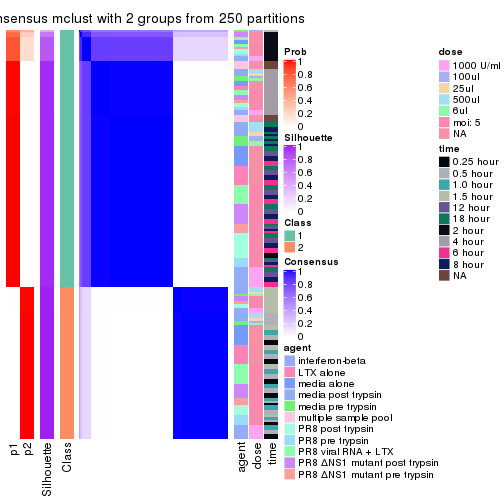
consensus_heatmap(res, k = 3)
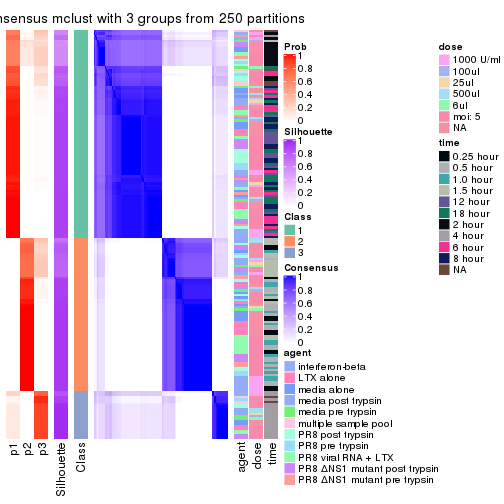
consensus_heatmap(res, k = 4)
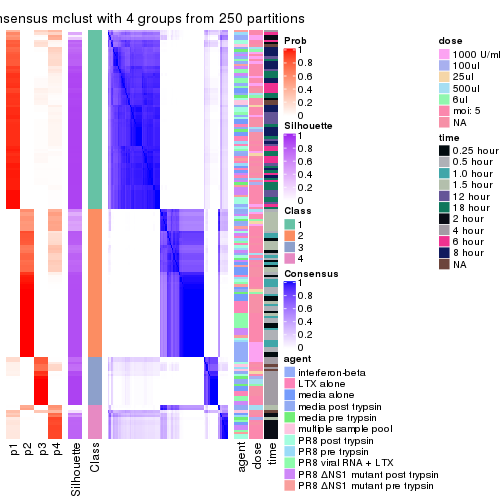
consensus_heatmap(res, k = 5)
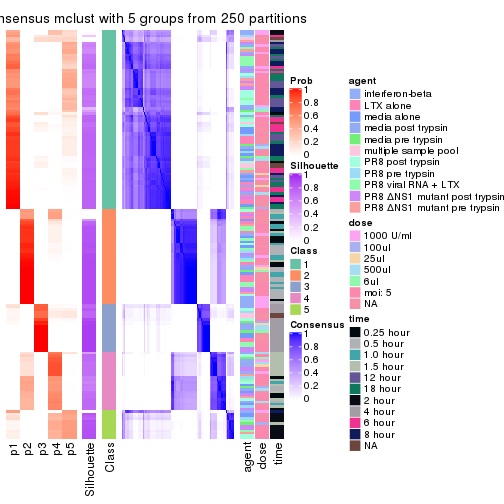
consensus_heatmap(res, k = 6)

Heatmaps for the membership of samples in all partitions to see how consistent they are:
membership_heatmap(res, k = 2)
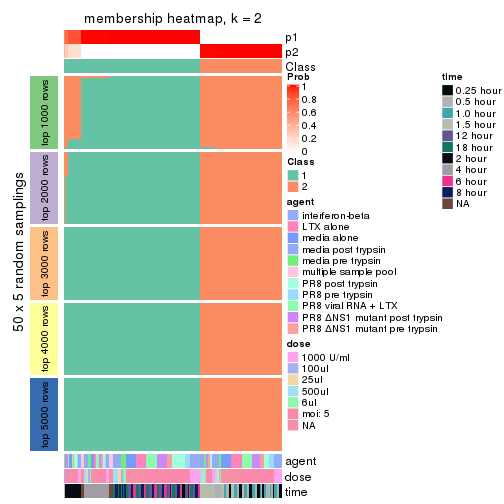
membership_heatmap(res, k = 3)
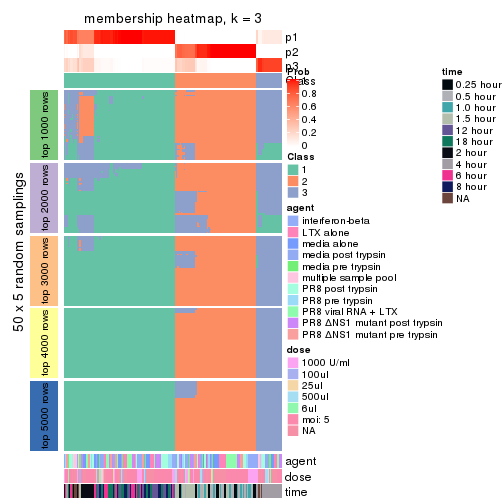
membership_heatmap(res, k = 4)
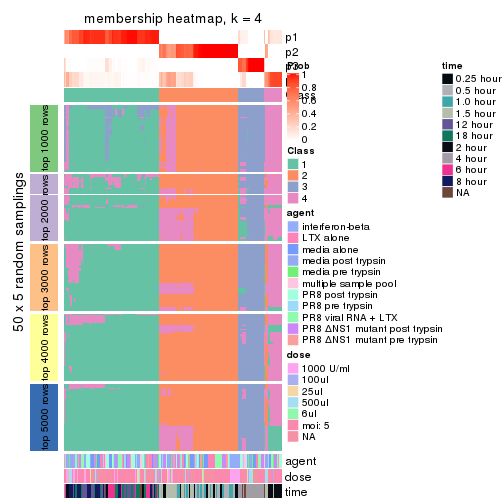
membership_heatmap(res, k = 5)
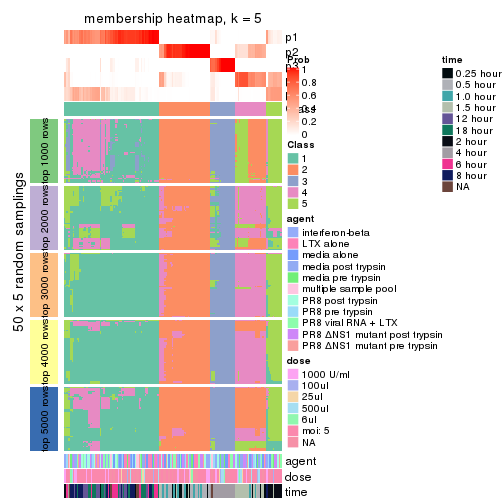
membership_heatmap(res, k = 6)
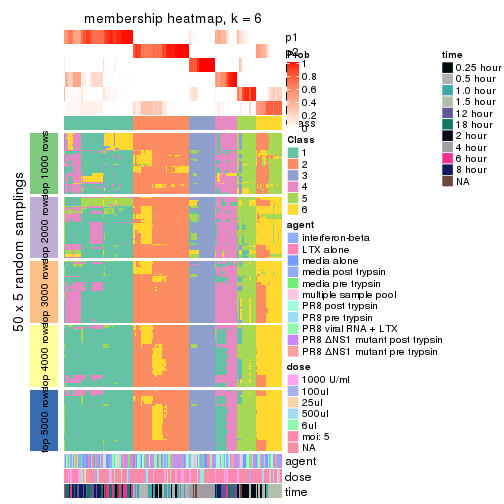
As soon as we have had the classes for columns, we can look for signatures which are significantly different between classes which can be candidate marks for certain classes. Following are the heatmaps for signatures.
Signature heatmaps where rows are scaled:
get_signatures(res, k = 2)
#> Error in mat[ceiling(1:nr/h_ratio), ceiling(1:nc/w_ratio), drop = FALSE]: subscript out of bounds
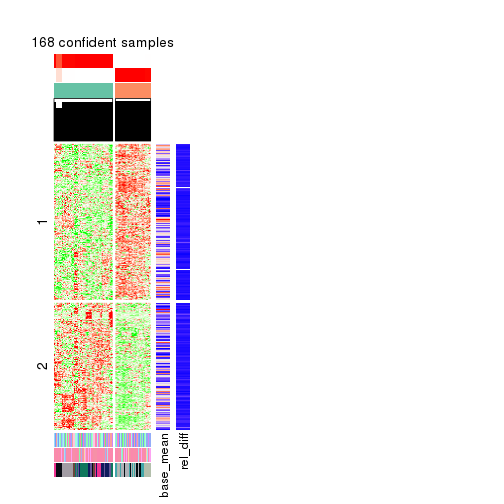
get_signatures(res, k = 3)
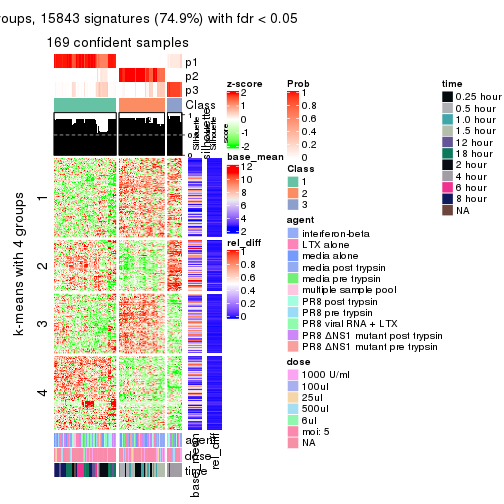
get_signatures(res, k = 4)
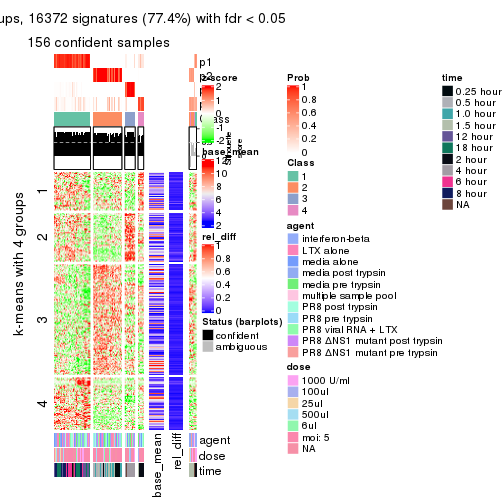
get_signatures(res, k = 5)
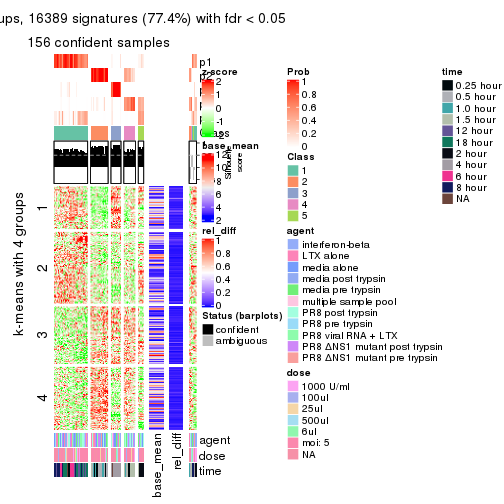
get_signatures(res, k = 6)
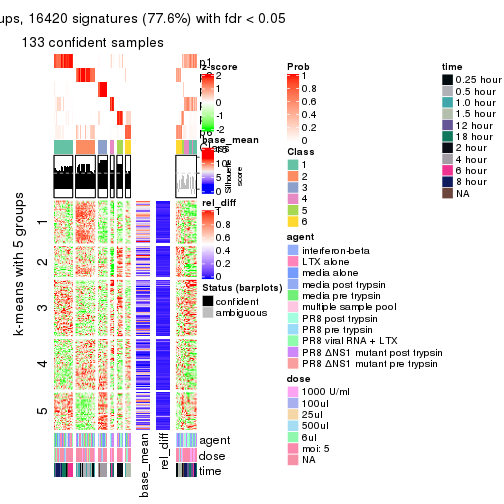
Signature heatmaps where rows are not scaled:
get_signatures(res, k = 2, scale_rows = FALSE)
#> Error in mat[ceiling(1:nr/h_ratio), ceiling(1:nc/w_ratio), drop = FALSE]: subscript out of bounds
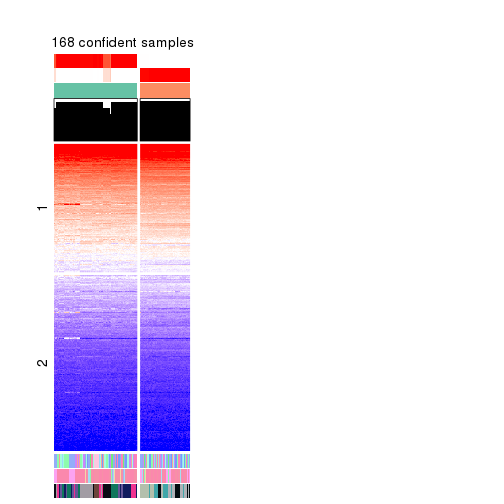
get_signatures(res, k = 3, scale_rows = FALSE)
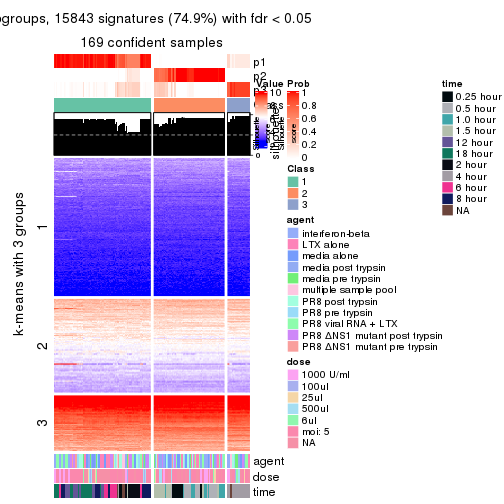
get_signatures(res, k = 4, scale_rows = FALSE)
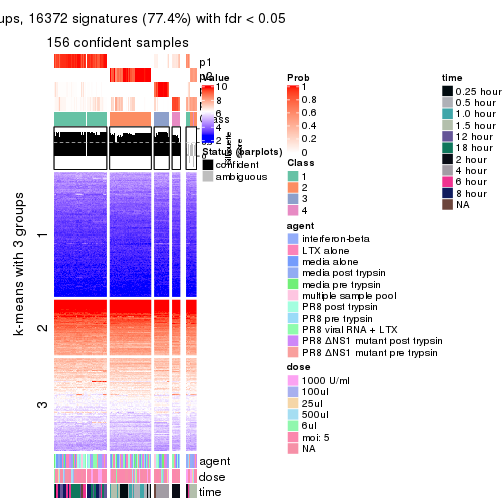
get_signatures(res, k = 5, scale_rows = FALSE)
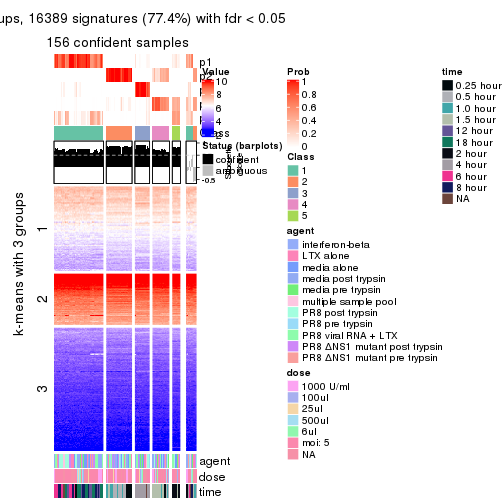
get_signatures(res, k = 6, scale_rows = FALSE)
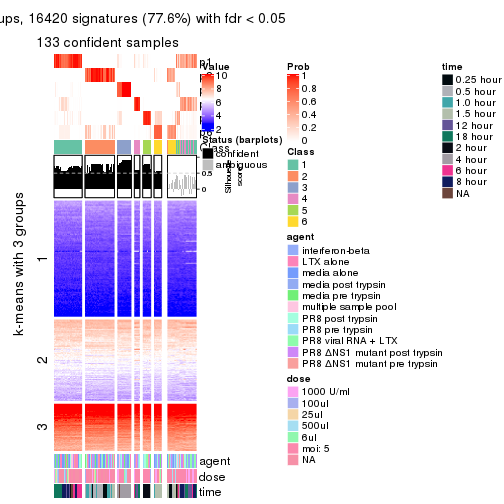
Compare the overlap of signatures from different k:
compare_signatures(res)
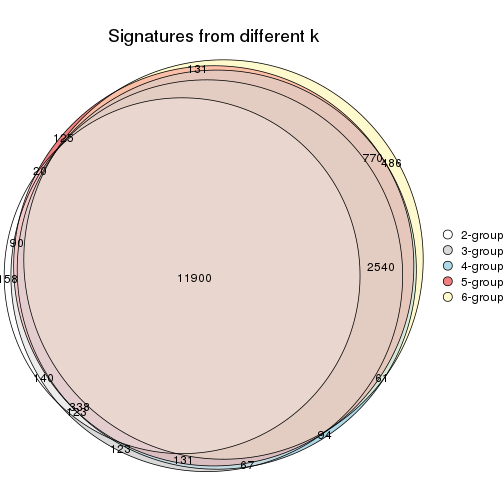
get_signature() returns a data frame invisibly. TO get the list of signatures, the function
call should be assigned to a variable explicitly. In following code, if plot argument is set
to FALSE, no heatmap is plotted while only the differential analysis is performed.
# code only for demonstration
tb = get_signature(res, k = ..., plot = FALSE)
An example of the output of tb is:
#> which_row fdr mean_1 mean_2 scaled_mean_1 scaled_mean_2 km
#> 1 38 0.042760348 8.373488 9.131774 -0.5533452 0.5164555 1
#> 2 40 0.018707592 7.106213 8.469186 -0.6173731 0.5762149 1
#> 3 55 0.019134737 10.221463 11.207825 -0.6159697 0.5749050 1
#> 4 59 0.006059896 5.921854 7.869574 -0.6899429 0.6439467 1
#> 5 60 0.018055526 8.928898 10.211722 -0.6204761 0.5791110 1
#> 6 98 0.009384629 15.714769 14.887706 0.6635654 -0.6193277 2
...
The columns in tb are:
which_row: row indices corresponding to the input matrix.fdr: FDR for the differential test. mean_x: The mean value in group x.scaled_mean_x: The mean value in group x after rows are scaled.km: Row groups if k-means clustering is applied to rows.UMAP plot which shows how samples are separated.
dimension_reduction(res, k = 2, method = "UMAP")
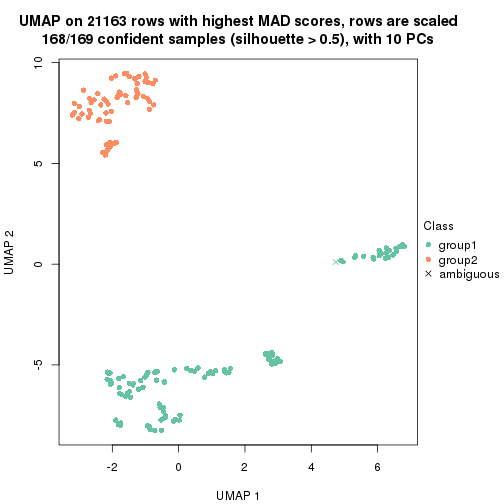
dimension_reduction(res, k = 3, method = "UMAP")
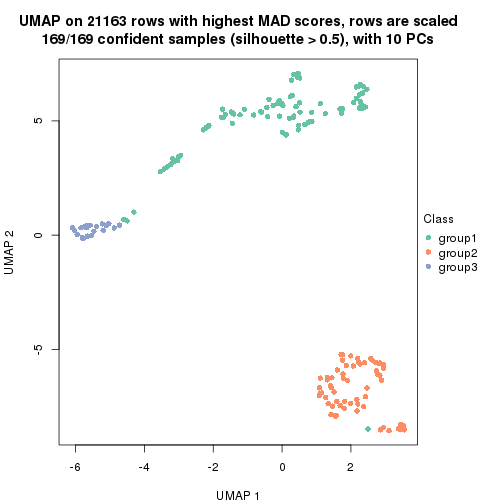
dimension_reduction(res, k = 4, method = "UMAP")
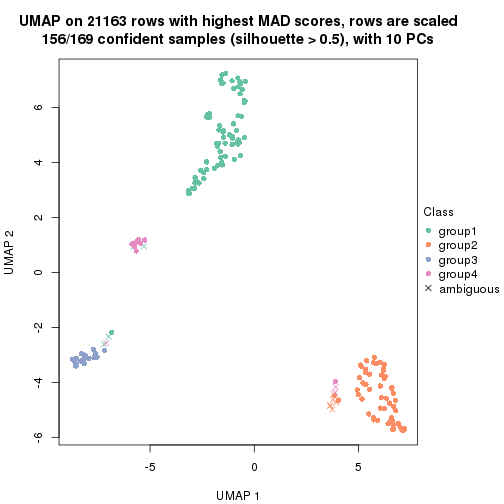
dimension_reduction(res, k = 5, method = "UMAP")
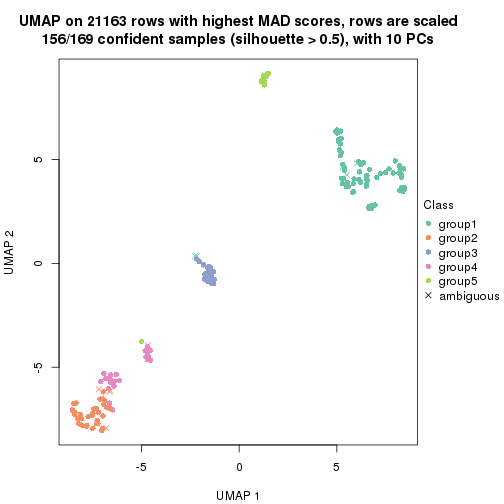
dimension_reduction(res, k = 6, method = "UMAP")
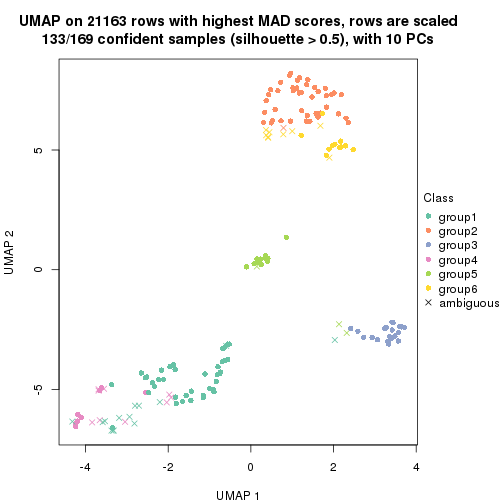
Following heatmap shows how subgroups are split when increasing k:
collect_classes(res)
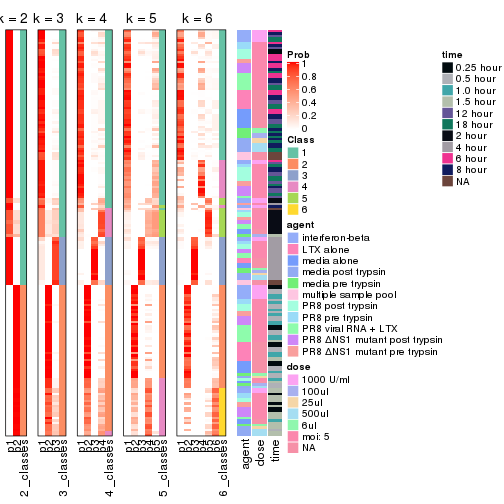
Test correlation between subgroups and known annotations. If the known annotation is numeric, one-way ANOVA test is applied, and if the known annotation is discrete, chi-squared contingency table test is applied.
test_to_known_factors(res)
#> n agent(p) dose(p) time(p) k
#> MAD:mclust 168 0.903 0.999 2.34e-29 2
#> MAD:mclust 169 0.973 0.992 3.35e-52 3
#> MAD:mclust 156 0.983 0.963 1.00e-72 4
#> MAD:mclust 156 0.871 0.806 1.84e-78 5
#> MAD:mclust 133 0.455 0.413 2.96e-69 6
If matrix rows can be associated to genes, consider to use functional_enrichment(res,
...) to perform function enrichment for the signature genes. See this vignette for more detailed explanations.
The object with results only for a single top-value method and a single partition method can be extracted as:
res = res_list["MAD", "NMF"]
# you can also extract it by
# res = res_list["MAD:NMF"]
A summary of res and all the functions that can be applied to it:
res
#> A 'ConsensusPartition' object with k = 2, 3, 4, 5, 6.
#> On a matrix with 21163 rows and 169 columns.
#> Top rows (1000, 2000, 3000, 4000, 5000) are extracted by 'MAD' method.
#> Subgroups are detected by 'NMF' method.
#> Performed in total 1250 partitions by row resampling.
#> Best k for subgroups seems to be 3.
#>
#> Following methods can be applied to this 'ConsensusPartition' object:
#> [1] "cola_report" "collect_classes" "collect_plots"
#> [4] "collect_stats" "colnames" "compare_signatures"
#> [7] "consensus_heatmap" "dimension_reduction" "functional_enrichment"
#> [10] "get_anno_col" "get_anno" "get_classes"
#> [13] "get_consensus" "get_matrix" "get_membership"
#> [16] "get_param" "get_signatures" "get_stats"
#> [19] "is_best_k" "is_stable_k" "membership_heatmap"
#> [22] "ncol" "nrow" "plot_ecdf"
#> [25] "rownames" "select_partition_number" "show"
#> [28] "suggest_best_k" "test_to_known_factors"
collect_plots() function collects all the plots made from res for all k (number of partitions)
into one single page to provide an easy and fast comparison between different k.
collect_plots(res)
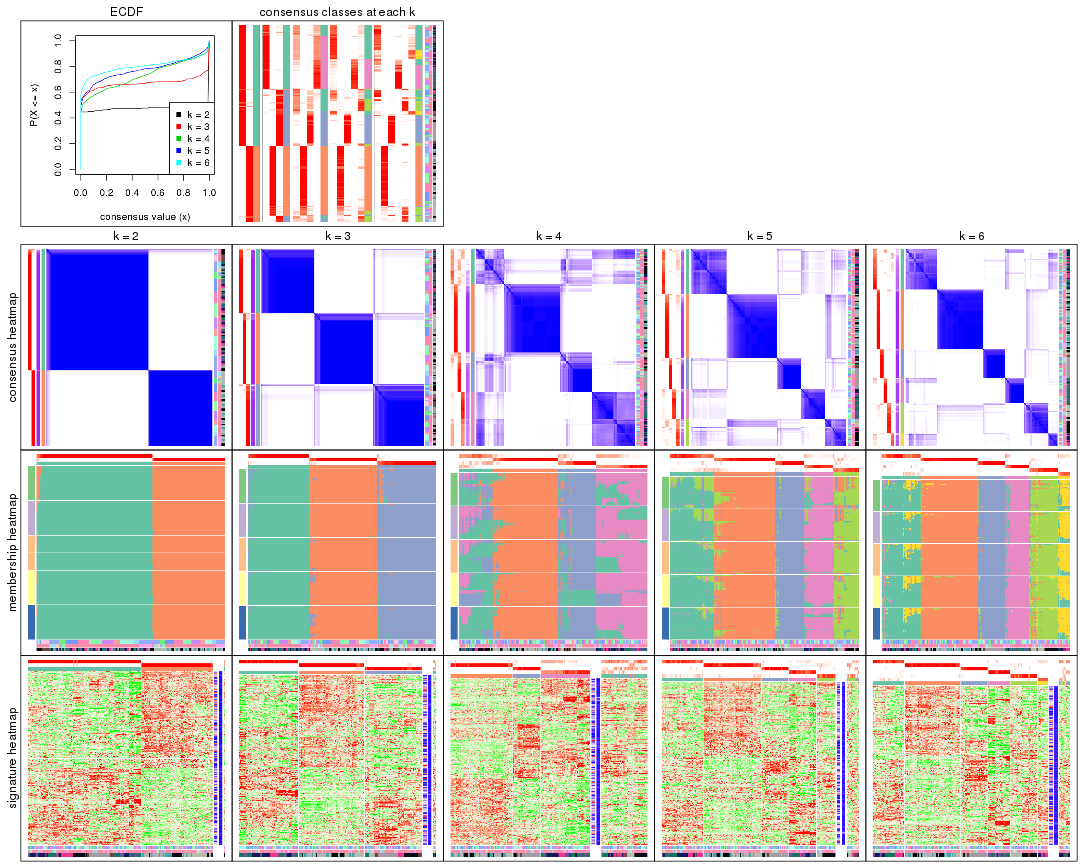
The plots are:
k and the heatmap of
predicted classes for each k.k.k.k.All the plots in panels can be made by individual functions and they are plotted later in this section.
select_partition_number() produces several plots showing different
statistics for choosing “optimized” k. There are following statistics:
k;k, the area increased is defined as \(A_k - A_{k-1}\).The detailed explanations of these statistics can be found in the cola vignette.
Generally speaking, lower PAC score, higher mean silhouette score or higher
concordance corresponds to better partition. Rand index and Jaccard index
measure how similar the current partition is compared to partition with k-1.
If they are too similar, we won't accept k is better than k-1.
select_partition_number(res)
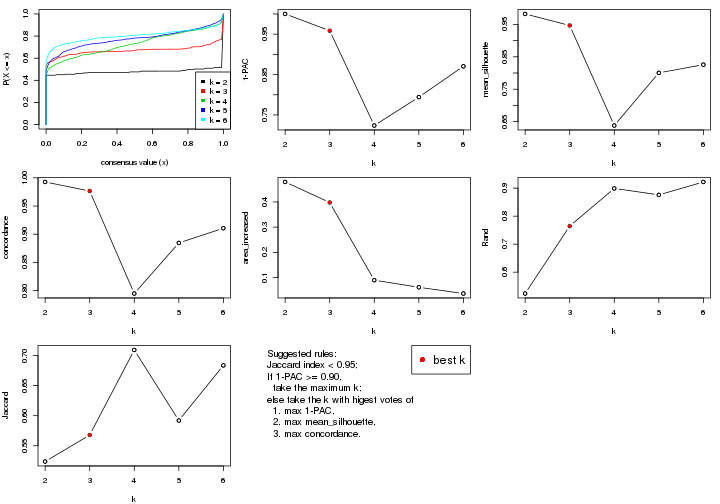
The numeric values for all these statistics can be obtained by get_stats().
get_stats(res)
#> k 1-PAC mean_silhouette concordance area_increased Rand Jaccard
#> 2 2 1.000 0.982 0.993 0.4789 0.524 0.524
#> 3 3 0.958 0.947 0.977 0.3975 0.765 0.568
#> 4 4 0.724 0.638 0.795 0.0896 0.899 0.709
#> 5 5 0.794 0.801 0.885 0.0615 0.876 0.592
#> 6 6 0.870 0.826 0.911 0.0369 0.922 0.684
suggest_best_k() suggests the best \(k\) based on these statistics. The rules are as follows:
suggest_best_k(res)
#> [1] 3
#> attr(,"optional")
#> [1] 2
There is also optional best \(k\) = 2 that is worth to check.
Following shows the table of the partitions (You need to click the show/hide
code output link to see it). The membership matrix (columns with name p*)
is inferred by
clue::cl_consensus()
function with the SE method. Basically the value in the membership matrix
represents the probability to belong to a certain group. The finall class
label for an item is determined with the group with highest probability it
belongs to.
In get_classes() function, the entropy is calculated from the membership
matrix and the silhouette score is calculated from the consensus matrix.
cbind(get_classes(res, k = 2), get_membership(res, k = 2))
#> class entropy silhouette p1 p2
#> GSM528681 2 0.000 0.997 0.000 1.000
#> GSM528682 2 0.000 0.997 0.000 1.000
#> GSM528683 2 0.000 0.997 0.000 1.000
#> GSM528684 2 0.000 0.997 0.000 1.000
#> GSM528687 2 0.000 0.997 0.000 1.000
#> GSM528688 2 0.000 0.997 0.000 1.000
#> GSM528685 2 0.000 0.997 0.000 1.000
#> GSM528686 2 0.000 0.997 0.000 1.000
#> GSM528693 1 0.000 0.990 1.000 0.000
#> GSM528694 1 0.000 0.990 1.000 0.000
#> GSM528695 1 0.000 0.990 1.000 0.000
#> GSM528696 1 0.000 0.990 1.000 0.000
#> GSM528697 1 0.000 0.990 1.000 0.000
#> GSM528698 1 0.000 0.990 1.000 0.000
#> GSM528699 1 0.000 0.990 1.000 0.000
#> GSM528700 1 0.000 0.990 1.000 0.000
#> GSM528689 1 0.000 0.990 1.000 0.000
#> GSM528690 1 0.000 0.990 1.000 0.000
#> GSM528691 1 0.000 0.990 1.000 0.000
#> GSM528692 1 0.000 0.990 1.000 0.000
#> GSM528779 2 0.000 0.997 0.000 1.000
#> GSM528780 2 0.000 0.997 0.000 1.000
#> GSM528782 2 0.000 0.997 0.000 1.000
#> GSM528781 2 0.000 0.997 0.000 1.000
#> GSM528785 1 0.788 0.695 0.764 0.236
#> GSM528786 1 0.000 0.990 1.000 0.000
#> GSM528787 1 0.000 0.990 1.000 0.000
#> GSM528788 1 0.000 0.990 1.000 0.000
#> GSM528783 1 0.000 0.990 1.000 0.000
#> GSM528784 1 0.000 0.990 1.000 0.000
#> GSM528759 1 0.000 0.990 1.000 0.000
#> GSM528760 1 0.000 0.990 1.000 0.000
#> GSM528761 2 0.000 0.997 0.000 1.000
#> GSM528762 2 0.000 0.997 0.000 1.000
#> GSM528765 2 0.000 0.997 0.000 1.000
#> GSM528766 2 0.000 0.997 0.000 1.000
#> GSM528763 2 0.000 0.997 0.000 1.000
#> GSM528764 2 0.000 0.997 0.000 1.000
#> GSM528771 1 0.738 0.740 0.792 0.208
#> GSM528772 1 0.482 0.881 0.896 0.104
#> GSM528773 1 0.000 0.990 1.000 0.000
#> GSM528774 1 0.000 0.990 1.000 0.000
#> GSM528775 1 0.000 0.990 1.000 0.000
#> GSM528776 1 0.000 0.990 1.000 0.000
#> GSM528777 1 0.000 0.990 1.000 0.000
#> GSM528778 1 0.000 0.990 1.000 0.000
#> GSM528767 1 0.000 0.990 1.000 0.000
#> GSM528768 1 0.000 0.990 1.000 0.000
#> GSM528769 1 0.000 0.990 1.000 0.000
#> GSM528770 1 0.000 0.990 1.000 0.000
#> GSM528671 2 0.000 0.997 0.000 1.000
#> GSM528672 2 0.000 0.997 0.000 1.000
#> GSM528674 2 0.000 0.997 0.000 1.000
#> GSM528673 2 0.000 0.997 0.000 1.000
#> GSM528677 1 0.000 0.990 1.000 0.000
#> GSM528678 1 0.000 0.990 1.000 0.000
#> GSM528679 1 0.000 0.990 1.000 0.000
#> GSM528680 1 0.000 0.990 1.000 0.000
#> GSM528675 1 0.000 0.990 1.000 0.000
#> GSM528676 1 0.000 0.990 1.000 0.000
#> GSM528651 2 0.000 0.997 0.000 1.000
#> GSM528652 2 0.000 0.997 0.000 1.000
#> GSM528653 2 0.000 0.997 0.000 1.000
#> GSM528654 2 0.000 0.997 0.000 1.000
#> GSM528657 2 0.000 0.997 0.000 1.000
#> GSM528658 2 0.000 0.997 0.000 1.000
#> GSM528655 2 0.000 0.997 0.000 1.000
#> GSM528656 2 0.000 0.997 0.000 1.000
#> GSM528663 1 0.997 0.132 0.532 0.468
#> GSM528664 2 0.653 0.794 0.168 0.832
#> GSM528665 1 0.000 0.990 1.000 0.000
#> GSM528666 1 0.000 0.990 1.000 0.000
#> GSM528667 1 0.000 0.990 1.000 0.000
#> GSM528668 1 0.000 0.990 1.000 0.000
#> GSM528669 1 0.000 0.990 1.000 0.000
#> GSM528670 1 0.000 0.990 1.000 0.000
#> GSM528659 1 0.000 0.990 1.000 0.000
#> GSM528660 1 0.000 0.990 1.000 0.000
#> GSM528661 1 0.000 0.990 1.000 0.000
#> GSM528662 1 0.000 0.990 1.000 0.000
#> GSM528701 2 0.000 0.997 0.000 1.000
#> GSM528702 2 0.000 0.997 0.000 1.000
#> GSM528703 2 0.000 0.997 0.000 1.000
#> GSM528704 2 0.000 0.997 0.000 1.000
#> GSM528707 2 0.000 0.997 0.000 1.000
#> GSM528708 2 0.000 0.997 0.000 1.000
#> GSM528705 2 0.000 0.997 0.000 1.000
#> GSM528706 2 0.000 0.997 0.000 1.000
#> GSM528713 1 0.000 0.990 1.000 0.000
#> GSM528714 1 0.000 0.990 1.000 0.000
#> GSM528715 1 0.000 0.990 1.000 0.000
#> GSM528716 1 0.000 0.990 1.000 0.000
#> GSM528717 1 0.000 0.990 1.000 0.000
#> GSM528718 1 0.000 0.990 1.000 0.000
#> GSM528719 1 0.000 0.990 1.000 0.000
#> GSM528720 1 0.000 0.990 1.000 0.000
#> GSM528709 1 0.000 0.990 1.000 0.000
#> GSM528710 1 0.000 0.990 1.000 0.000
#> GSM528711 1 0.000 0.990 1.000 0.000
#> GSM528712 1 0.000 0.990 1.000 0.000
#> GSM528721 2 0.000 0.997 0.000 1.000
#> GSM528722 2 0.000 0.997 0.000 1.000
#> GSM528723 2 0.000 0.997 0.000 1.000
#> GSM528724 2 0.000 0.997 0.000 1.000
#> GSM528727 2 0.000 0.997 0.000 1.000
#> GSM528728 2 0.000 0.997 0.000 1.000
#> GSM528725 2 0.000 0.997 0.000 1.000
#> GSM528726 2 0.000 0.997 0.000 1.000
#> GSM528733 1 0.000 0.990 1.000 0.000
#> GSM528734 1 0.000 0.990 1.000 0.000
#> GSM528735 1 0.000 0.990 1.000 0.000
#> GSM528736 1 0.000 0.990 1.000 0.000
#> GSM528737 1 0.000 0.990 1.000 0.000
#> GSM528738 1 0.000 0.990 1.000 0.000
#> GSM528729 1 0.000 0.990 1.000 0.000
#> GSM528730 1 0.000 0.990 1.000 0.000
#> GSM528731 1 0.000 0.990 1.000 0.000
#> GSM528732 1 0.000 0.990 1.000 0.000
#> GSM528739 2 0.000 0.997 0.000 1.000
#> GSM528740 2 0.000 0.997 0.000 1.000
#> GSM528741 2 0.000 0.997 0.000 1.000
#> GSM528742 2 0.000 0.997 0.000 1.000
#> GSM528745 2 0.000 0.997 0.000 1.000
#> GSM528746 2 0.000 0.997 0.000 1.000
#> GSM528743 2 0.000 0.997 0.000 1.000
#> GSM528744 2 0.000 0.997 0.000 1.000
#> GSM528751 1 0.311 0.934 0.944 0.056
#> GSM528752 1 0.000 0.990 1.000 0.000
#> GSM528753 1 0.000 0.990 1.000 0.000
#> GSM528754 1 0.000 0.990 1.000 0.000
#> GSM528755 1 0.000 0.990 1.000 0.000
#> GSM528756 1 0.000 0.990 1.000 0.000
#> GSM528757 1 0.000 0.990 1.000 0.000
#> GSM528758 1 0.000 0.990 1.000 0.000
#> GSM528747 1 0.000 0.990 1.000 0.000
#> GSM528748 1 0.000 0.990 1.000 0.000
#> GSM528749 1 0.000 0.990 1.000 0.000
#> GSM528750 1 0.000 0.990 1.000 0.000
#> GSM528640 2 0.000 0.997 0.000 1.000
#> GSM528641 2 0.000 0.997 0.000 1.000
#> GSM528643 1 0.000 0.990 1.000 0.000
#> GSM528644 1 0.000 0.990 1.000 0.000
#> GSM528642 1 0.000 0.990 1.000 0.000
#> GSM528620 2 0.000 0.997 0.000 1.000
#> GSM528621 2 0.000 0.997 0.000 1.000
#> GSM528623 1 0.000 0.990 1.000 0.000
#> GSM528624 1 0.000 0.990 1.000 0.000
#> GSM528622 1 0.000 0.990 1.000 0.000
#> GSM528625 2 0.000 0.997 0.000 1.000
#> GSM528626 2 0.000 0.997 0.000 1.000
#> GSM528628 1 0.000 0.990 1.000 0.000
#> GSM528629 1 0.000 0.990 1.000 0.000
#> GSM528627 1 0.000 0.990 1.000 0.000
#> GSM528630 2 0.000 0.997 0.000 1.000
#> GSM528631 2 0.000 0.997 0.000 1.000
#> GSM528632 2 0.000 0.997 0.000 1.000
#> GSM528633 2 0.000 0.997 0.000 1.000
#> GSM528636 1 0.000 0.990 1.000 0.000
#> GSM528637 1 0.000 0.990 1.000 0.000
#> GSM528638 1 0.000 0.990 1.000 0.000
#> GSM528639 1 0.000 0.990 1.000 0.000
#> GSM528634 1 0.000 0.990 1.000 0.000
#> GSM528635 1 0.000 0.990 1.000 0.000
#> GSM528645 1 0.000 0.990 1.000 0.000
#> GSM528646 1 0.000 0.990 1.000 0.000
#> GSM528647 1 0.000 0.990 1.000 0.000
#> GSM528648 1 0.000 0.990 1.000 0.000
#> GSM528649 1 0.000 0.990 1.000 0.000
#> GSM528650 1 0.000 0.990 1.000 0.000
cbind(get_classes(res, k = 3), get_membership(res, k = 3))
#> class entropy silhouette p1 p2 p3
#> GSM528681 2 0.0000 0.97902 0.000 1.000 0.000
#> GSM528682 2 0.0000 0.97902 0.000 1.000 0.000
#> GSM528683 2 0.0000 0.97902 0.000 1.000 0.000
#> GSM528684 2 0.0000 0.97902 0.000 1.000 0.000
#> GSM528687 2 0.0000 0.97902 0.000 1.000 0.000
#> GSM528688 2 0.0000 0.97902 0.000 1.000 0.000
#> GSM528685 2 0.0000 0.97902 0.000 1.000 0.000
#> GSM528686 2 0.4399 0.77430 0.000 0.812 0.188
#> GSM528693 3 0.0424 0.96017 0.008 0.000 0.992
#> GSM528694 3 0.0000 0.96499 0.000 0.000 1.000
#> GSM528695 3 0.0000 0.96499 0.000 0.000 1.000
#> GSM528696 3 0.0000 0.96499 0.000 0.000 1.000
#> GSM528697 1 0.0000 0.98230 1.000 0.000 0.000
#> GSM528698 1 0.0000 0.98230 1.000 0.000 0.000
#> GSM528699 1 0.0000 0.98230 1.000 0.000 0.000
#> GSM528700 1 0.0000 0.98230 1.000 0.000 0.000
#> GSM528689 1 0.0000 0.98230 1.000 0.000 0.000
#> GSM528690 1 0.0000 0.98230 1.000 0.000 0.000
#> GSM528691 1 0.0000 0.98230 1.000 0.000 0.000
#> GSM528692 1 0.2261 0.92735 0.932 0.000 0.068
#> GSM528779 2 0.0000 0.97902 0.000 1.000 0.000
#> GSM528780 2 0.0000 0.97902 0.000 1.000 0.000
#> GSM528782 2 0.0000 0.97902 0.000 1.000 0.000
#> GSM528781 2 0.0000 0.97902 0.000 1.000 0.000
#> GSM528785 2 0.8824 0.22240 0.124 0.512 0.364
#> GSM528786 3 0.0000 0.96499 0.000 0.000 1.000
#> GSM528787 3 0.0000 0.96499 0.000 0.000 1.000
#> GSM528788 1 0.0000 0.98230 1.000 0.000 0.000
#> GSM528783 1 0.0000 0.98230 1.000 0.000 0.000
#> GSM528784 1 0.0000 0.98230 1.000 0.000 0.000
#> GSM528759 3 0.0000 0.96499 0.000 0.000 1.000
#> GSM528760 3 0.0000 0.96499 0.000 0.000 1.000
#> GSM528761 2 0.0000 0.97902 0.000 1.000 0.000
#> GSM528762 2 0.0000 0.97902 0.000 1.000 0.000
#> GSM528765 2 0.0000 0.97902 0.000 1.000 0.000
#> GSM528766 2 0.0000 0.97902 0.000 1.000 0.000
#> GSM528763 2 0.0000 0.97902 0.000 1.000 0.000
#> GSM528764 2 0.4235 0.79366 0.000 0.824 0.176
#> GSM528771 3 0.4702 0.73130 0.000 0.212 0.788
#> GSM528772 3 0.3192 0.86537 0.000 0.112 0.888
#> GSM528773 3 0.0000 0.96499 0.000 0.000 1.000
#> GSM528774 3 0.0000 0.96499 0.000 0.000 1.000
#> GSM528775 3 0.0000 0.96499 0.000 0.000 1.000
#> GSM528776 1 0.0424 0.97754 0.992 0.000 0.008
#> GSM528777 1 0.0000 0.98230 1.000 0.000 0.000
#> GSM528778 1 0.0000 0.98230 1.000 0.000 0.000
#> GSM528767 1 0.0000 0.98230 1.000 0.000 0.000
#> GSM528768 1 0.0000 0.98230 1.000 0.000 0.000
#> GSM528769 1 0.0000 0.98230 1.000 0.000 0.000
#> GSM528770 1 0.0000 0.98230 1.000 0.000 0.000
#> GSM528671 2 0.0000 0.97902 0.000 1.000 0.000
#> GSM528672 2 0.0000 0.97902 0.000 1.000 0.000
#> GSM528674 2 0.0000 0.97902 0.000 1.000 0.000
#> GSM528673 2 0.2959 0.88385 0.000 0.900 0.100
#> GSM528677 3 0.0000 0.96499 0.000 0.000 1.000
#> GSM528678 3 0.0000 0.96499 0.000 0.000 1.000
#> GSM528679 1 0.0237 0.98009 0.996 0.000 0.004
#> GSM528680 1 0.0000 0.98230 1.000 0.000 0.000
#> GSM528675 1 0.0000 0.98230 1.000 0.000 0.000
#> GSM528676 1 0.0000 0.98230 1.000 0.000 0.000
#> GSM528651 2 0.0000 0.97902 0.000 1.000 0.000
#> GSM528652 2 0.0000 0.97902 0.000 1.000 0.000
#> GSM528653 2 0.0000 0.97902 0.000 1.000 0.000
#> GSM528654 2 0.0000 0.97902 0.000 1.000 0.000
#> GSM528657 2 0.0000 0.97902 0.000 1.000 0.000
#> GSM528658 2 0.0000 0.97902 0.000 1.000 0.000
#> GSM528655 2 0.0892 0.96211 0.000 0.980 0.020
#> GSM528656 2 0.3482 0.85260 0.000 0.872 0.128
#> GSM528663 3 0.0000 0.96499 0.000 0.000 1.000
#> GSM528664 3 0.0000 0.96499 0.000 0.000 1.000
#> GSM528665 3 0.0000 0.96499 0.000 0.000 1.000
#> GSM528666 3 0.0000 0.96499 0.000 0.000 1.000
#> GSM528667 1 0.0000 0.98230 1.000 0.000 0.000
#> GSM528668 1 0.0000 0.98230 1.000 0.000 0.000
#> GSM528669 1 0.0000 0.98230 1.000 0.000 0.000
#> GSM528670 1 0.0000 0.98230 1.000 0.000 0.000
#> GSM528659 1 0.0000 0.98230 1.000 0.000 0.000
#> GSM528660 1 0.0000 0.98230 1.000 0.000 0.000
#> GSM528661 1 0.0000 0.98230 1.000 0.000 0.000
#> GSM528662 1 0.0000 0.98230 1.000 0.000 0.000
#> GSM528701 2 0.0000 0.97902 0.000 1.000 0.000
#> GSM528702 2 0.0000 0.97902 0.000 1.000 0.000
#> GSM528703 2 0.0000 0.97902 0.000 1.000 0.000
#> GSM528704 2 0.0000 0.97902 0.000 1.000 0.000
#> GSM528707 2 0.0000 0.97902 0.000 1.000 0.000
#> GSM528708 2 0.0000 0.97902 0.000 1.000 0.000
#> GSM528705 2 0.0000 0.97902 0.000 1.000 0.000
#> GSM528706 2 0.0000 0.97902 0.000 1.000 0.000
#> GSM528713 3 0.0000 0.96499 0.000 0.000 1.000
#> GSM528714 3 0.0000 0.96499 0.000 0.000 1.000
#> GSM528715 3 0.0000 0.96499 0.000 0.000 1.000
#> GSM528716 3 0.0000 0.96499 0.000 0.000 1.000
#> GSM528717 1 0.0424 0.97754 0.992 0.000 0.008
#> GSM528718 1 0.3038 0.88555 0.896 0.000 0.104
#> GSM528719 1 0.0424 0.97754 0.992 0.000 0.008
#> GSM528720 1 0.0000 0.98230 1.000 0.000 0.000
#> GSM528709 1 0.0000 0.98230 1.000 0.000 0.000
#> GSM528710 1 0.0000 0.98230 1.000 0.000 0.000
#> GSM528711 1 0.0000 0.98230 1.000 0.000 0.000
#> GSM528712 1 0.0000 0.98230 1.000 0.000 0.000
#> GSM528721 2 0.0000 0.97902 0.000 1.000 0.000
#> GSM528722 2 0.0000 0.97902 0.000 1.000 0.000
#> GSM528723 2 0.0000 0.97902 0.000 1.000 0.000
#> GSM528724 2 0.0000 0.97902 0.000 1.000 0.000
#> GSM528727 2 0.0000 0.97902 0.000 1.000 0.000
#> GSM528728 2 0.0000 0.97902 0.000 1.000 0.000
#> GSM528725 2 0.0000 0.97902 0.000 1.000 0.000
#> GSM528726 2 0.0000 0.97902 0.000 1.000 0.000
#> GSM528733 3 0.0000 0.96499 0.000 0.000 1.000
#> GSM528734 3 0.0000 0.96499 0.000 0.000 1.000
#> GSM528735 3 0.2165 0.91624 0.064 0.000 0.936
#> GSM528736 3 0.1753 0.93075 0.048 0.000 0.952
#> GSM528737 1 0.0237 0.98011 0.996 0.000 0.004
#> GSM528738 1 0.2066 0.93347 0.940 0.000 0.060
#> GSM528729 1 0.0000 0.98230 1.000 0.000 0.000
#> GSM528730 1 0.0000 0.98230 1.000 0.000 0.000
#> GSM528731 1 0.0000 0.98230 1.000 0.000 0.000
#> GSM528732 1 0.2066 0.93455 0.940 0.000 0.060
#> GSM528739 2 0.0000 0.97902 0.000 1.000 0.000
#> GSM528740 2 0.0000 0.97902 0.000 1.000 0.000
#> GSM528741 2 0.0000 0.97902 0.000 1.000 0.000
#> GSM528742 2 0.0000 0.97902 0.000 1.000 0.000
#> GSM528745 2 0.0000 0.97902 0.000 1.000 0.000
#> GSM528746 2 0.0000 0.97902 0.000 1.000 0.000
#> GSM528743 2 0.0000 0.97902 0.000 1.000 0.000
#> GSM528744 2 0.0000 0.97902 0.000 1.000 0.000
#> GSM528751 3 0.4784 0.74732 0.004 0.200 0.796
#> GSM528752 3 0.3349 0.86868 0.004 0.108 0.888
#> GSM528753 3 0.0000 0.96499 0.000 0.000 1.000
#> GSM528754 3 0.0000 0.96499 0.000 0.000 1.000
#> GSM528755 3 0.0000 0.96499 0.000 0.000 1.000
#> GSM528756 3 0.0000 0.96499 0.000 0.000 1.000
#> GSM528757 1 0.0000 0.98230 1.000 0.000 0.000
#> GSM528758 1 0.0000 0.98230 1.000 0.000 0.000
#> GSM528747 1 0.1163 0.96177 0.972 0.000 0.028
#> GSM528748 3 0.1753 0.92802 0.048 0.000 0.952
#> GSM528749 3 0.5016 0.67387 0.240 0.000 0.760
#> GSM528750 1 0.0000 0.98230 1.000 0.000 0.000
#> GSM528640 2 0.0000 0.97902 0.000 1.000 0.000
#> GSM528641 2 0.4178 0.79883 0.000 0.828 0.172
#> GSM528643 3 0.0000 0.96499 0.000 0.000 1.000
#> GSM528644 3 0.6308 -0.00228 0.492 0.000 0.508
#> GSM528642 3 0.0000 0.96499 0.000 0.000 1.000
#> GSM528620 2 0.0000 0.97902 0.000 1.000 0.000
#> GSM528621 3 0.0000 0.96499 0.000 0.000 1.000
#> GSM528623 3 0.0000 0.96499 0.000 0.000 1.000
#> GSM528624 1 0.0000 0.98230 1.000 0.000 0.000
#> GSM528622 1 0.0237 0.98008 0.996 0.000 0.004
#> GSM528625 2 0.0000 0.97902 0.000 1.000 0.000
#> GSM528626 3 0.2261 0.91076 0.000 0.068 0.932
#> GSM528628 3 0.0000 0.96499 0.000 0.000 1.000
#> GSM528629 1 0.2165 0.93127 0.936 0.000 0.064
#> GSM528627 1 0.6235 0.22949 0.564 0.000 0.436
#> GSM528630 2 0.0000 0.97902 0.000 1.000 0.000
#> GSM528631 2 0.0000 0.97902 0.000 1.000 0.000
#> GSM528632 3 0.1411 0.93996 0.000 0.036 0.964
#> GSM528633 3 0.1643 0.93331 0.000 0.044 0.956
#> GSM528636 3 0.0000 0.96499 0.000 0.000 1.000
#> GSM528637 3 0.0000 0.96499 0.000 0.000 1.000
#> GSM528638 1 0.0000 0.98230 1.000 0.000 0.000
#> GSM528639 1 0.0237 0.98011 0.996 0.000 0.004
#> GSM528634 3 0.0000 0.96499 0.000 0.000 1.000
#> GSM528635 1 0.2625 0.90990 0.916 0.000 0.084
#> GSM528645 3 0.0000 0.96499 0.000 0.000 1.000
#> GSM528646 3 0.0000 0.96499 0.000 0.000 1.000
#> GSM528647 3 0.0000 0.96499 0.000 0.000 1.000
#> GSM528648 3 0.1031 0.94970 0.024 0.000 0.976
#> GSM528649 3 0.0000 0.96499 0.000 0.000 1.000
#> GSM528650 3 0.1289 0.94409 0.032 0.000 0.968
cbind(get_classes(res, k = 4), get_membership(res, k = 4))
#> class entropy silhouette p1 p2 p3 p4
#> GSM528681 2 0.0188 0.95313 0.004 0.996 0.000 0.000
#> GSM528682 2 0.0188 0.95313 0.004 0.996 0.000 0.000
#> GSM528683 2 0.0000 0.95279 0.000 1.000 0.000 0.000
#> GSM528684 2 0.0188 0.95313 0.004 0.996 0.000 0.000
#> GSM528687 2 0.0188 0.95313 0.004 0.996 0.000 0.000
#> GSM528688 2 0.0000 0.95279 0.000 1.000 0.000 0.000
#> GSM528685 2 0.1389 0.92534 0.048 0.952 0.000 0.000
#> GSM528686 2 0.7168 0.37024 0.256 0.552 0.192 0.000
#> GSM528693 3 0.5288 0.12379 0.472 0.000 0.520 0.008
#> GSM528694 1 0.5285 -0.03606 0.524 0.000 0.468 0.008
#> GSM528695 3 0.0000 0.80408 0.000 0.000 1.000 0.000
#> GSM528696 3 0.0000 0.80408 0.000 0.000 1.000 0.000
#> GSM528697 4 0.1637 0.70884 0.060 0.000 0.000 0.940
#> GSM528698 4 0.4477 0.64755 0.312 0.000 0.000 0.688
#> GSM528699 4 0.4888 0.44682 0.412 0.000 0.000 0.588
#> GSM528700 4 0.2814 0.69705 0.132 0.000 0.000 0.868
#> GSM528689 4 0.2345 0.69861 0.100 0.000 0.000 0.900
#> GSM528690 4 0.0817 0.70183 0.024 0.000 0.000 0.976
#> GSM528691 4 0.2921 0.67293 0.140 0.000 0.000 0.860
#> GSM528692 4 0.2589 0.66480 0.116 0.000 0.000 0.884
#> GSM528779 2 0.0188 0.95313 0.004 0.996 0.000 0.000
#> GSM528780 2 0.0000 0.95279 0.000 1.000 0.000 0.000
#> GSM528782 2 0.0336 0.95211 0.008 0.992 0.000 0.000
#> GSM528781 2 0.4331 0.65713 0.288 0.712 0.000 0.000
#> GSM528785 1 0.3707 0.43122 0.852 0.112 0.004 0.032
#> GSM528786 3 0.0000 0.80408 0.000 0.000 1.000 0.000
#> GSM528787 1 0.5161 0.00829 0.520 0.000 0.476 0.004
#> GSM528788 4 0.4866 0.60884 0.404 0.000 0.000 0.596
#> GSM528783 4 0.1022 0.70146 0.032 0.000 0.000 0.968
#> GSM528784 4 0.1022 0.68334 0.032 0.000 0.000 0.968
#> GSM528759 3 0.2345 0.68721 0.100 0.000 0.900 0.000
#> GSM528760 3 0.2704 0.69717 0.124 0.000 0.876 0.000
#> GSM528761 2 0.0000 0.95279 0.000 1.000 0.000 0.000
#> GSM528762 2 0.0336 0.95211 0.008 0.992 0.000 0.000
#> GSM528765 2 0.0707 0.94411 0.020 0.980 0.000 0.000
#> GSM528766 2 0.0000 0.95279 0.000 1.000 0.000 0.000
#> GSM528763 2 0.0000 0.95279 0.000 1.000 0.000 0.000
#> GSM528764 3 0.4817 0.32198 0.000 0.388 0.612 0.000
#> GSM528771 1 0.6503 0.29875 0.640 0.164 0.196 0.000
#> GSM528772 1 0.6568 0.17069 0.572 0.096 0.332 0.000
#> GSM528773 3 0.0000 0.80408 0.000 0.000 1.000 0.000
#> GSM528774 3 0.0000 0.80408 0.000 0.000 1.000 0.000
#> GSM528775 1 0.5383 0.39461 0.672 0.000 0.292 0.036
#> GSM528776 1 0.5263 -0.38358 0.544 0.000 0.008 0.448
#> GSM528777 4 0.4843 0.60978 0.396 0.000 0.000 0.604
#> GSM528778 4 0.4888 0.60349 0.412 0.000 0.000 0.588
#> GSM528767 4 0.0000 0.69669 0.000 0.000 0.000 1.000
#> GSM528768 4 0.0469 0.69965 0.012 0.000 0.000 0.988
#> GSM528769 4 0.1118 0.68312 0.036 0.000 0.000 0.964
#> GSM528770 4 0.0921 0.68582 0.028 0.000 0.000 0.972
#> GSM528671 2 0.0336 0.95005 0.008 0.992 0.000 0.000
#> GSM528672 2 0.0336 0.95211 0.008 0.992 0.000 0.000
#> GSM528674 2 0.0000 0.95279 0.000 1.000 0.000 0.000
#> GSM528673 2 0.4898 0.72989 0.072 0.772 0.156 0.000
#> GSM528677 1 0.5147 -0.01639 0.536 0.004 0.460 0.000
#> GSM528678 3 0.2408 0.72429 0.104 0.000 0.896 0.000
#> GSM528679 4 0.5300 0.59389 0.408 0.000 0.012 0.580
#> GSM528680 4 0.4072 0.66753 0.252 0.000 0.000 0.748
#> GSM528675 4 0.1022 0.68334 0.032 0.000 0.000 0.968
#> GSM528676 4 0.1022 0.68334 0.032 0.000 0.000 0.968
#> GSM528651 2 0.2081 0.89657 0.084 0.916 0.000 0.000
#> GSM528652 2 0.2469 0.87588 0.108 0.892 0.000 0.000
#> GSM528653 2 0.0336 0.95211 0.008 0.992 0.000 0.000
#> GSM528654 2 0.0336 0.95211 0.008 0.992 0.000 0.000
#> GSM528657 2 0.0469 0.94822 0.012 0.988 0.000 0.000
#> GSM528658 2 0.0188 0.95313 0.004 0.996 0.000 0.000
#> GSM528655 2 0.4880 0.70522 0.052 0.760 0.188 0.000
#> GSM528656 2 0.5842 0.65441 0.168 0.704 0.128 0.000
#> GSM528663 1 0.6214 0.05090 0.536 0.056 0.408 0.000
#> GSM528664 1 0.6686 0.05216 0.520 0.092 0.388 0.000
#> GSM528665 3 0.0000 0.80408 0.000 0.000 1.000 0.000
#> GSM528666 3 0.0000 0.80408 0.000 0.000 1.000 0.000
#> GSM528667 4 0.5161 0.60299 0.400 0.000 0.008 0.592
#> GSM528668 4 0.5427 0.58591 0.416 0.000 0.016 0.568
#> GSM528669 4 0.4843 0.61539 0.396 0.000 0.000 0.604
#> GSM528670 4 0.4989 0.52494 0.472 0.000 0.000 0.528
#> GSM528659 4 0.0921 0.68582 0.028 0.000 0.000 0.972
#> GSM528660 4 0.0921 0.68582 0.028 0.000 0.000 0.972
#> GSM528661 4 0.0707 0.68953 0.020 0.000 0.000 0.980
#> GSM528662 4 0.0469 0.69585 0.012 0.000 0.000 0.988
#> GSM528701 2 0.0336 0.95211 0.008 0.992 0.000 0.000
#> GSM528702 2 0.0336 0.95211 0.008 0.992 0.000 0.000
#> GSM528703 2 0.0000 0.95279 0.000 1.000 0.000 0.000
#> GSM528704 2 0.0336 0.95211 0.008 0.992 0.000 0.000
#> GSM528707 2 0.0188 0.95313 0.004 0.996 0.000 0.000
#> GSM528708 2 0.0336 0.95211 0.008 0.992 0.000 0.000
#> GSM528705 2 0.0188 0.95261 0.004 0.996 0.000 0.000
#> GSM528706 2 0.0000 0.95279 0.000 1.000 0.000 0.000
#> GSM528713 1 0.5473 0.27345 0.644 0.000 0.324 0.032
#> GSM528714 1 0.4961 0.01526 0.552 0.000 0.448 0.000
#> GSM528715 3 0.0000 0.80408 0.000 0.000 1.000 0.000
#> GSM528716 3 0.0000 0.80408 0.000 0.000 1.000 0.000
#> GSM528717 4 0.4964 0.61668 0.380 0.000 0.004 0.616
#> GSM528718 1 0.6451 -0.16305 0.524 0.000 0.072 0.404
#> GSM528719 4 0.3649 0.61459 0.204 0.000 0.000 0.796
#> GSM528720 4 0.4164 0.64293 0.264 0.000 0.000 0.736
#> GSM528709 4 0.1118 0.70206 0.036 0.000 0.000 0.964
#> GSM528710 4 0.0707 0.70154 0.020 0.000 0.000 0.980
#> GSM528711 4 0.1637 0.69652 0.060 0.000 0.000 0.940
#> GSM528712 4 0.3024 0.63495 0.148 0.000 0.000 0.852
#> GSM528721 2 0.0188 0.95313 0.004 0.996 0.000 0.000
#> GSM528722 2 0.0188 0.95313 0.004 0.996 0.000 0.000
#> GSM528723 2 0.0188 0.95313 0.004 0.996 0.000 0.000
#> GSM528724 2 0.0336 0.95211 0.008 0.992 0.000 0.000
#> GSM528727 2 0.0469 0.94822 0.012 0.988 0.000 0.000
#> GSM528728 2 0.0188 0.95313 0.004 0.996 0.000 0.000
#> GSM528725 2 0.0779 0.94478 0.016 0.980 0.000 0.004
#> GSM528726 2 0.0000 0.95279 0.000 1.000 0.000 0.000
#> GSM528733 3 0.0000 0.80408 0.000 0.000 1.000 0.000
#> GSM528734 3 0.0000 0.80408 0.000 0.000 1.000 0.000
#> GSM528735 3 0.5229 0.02467 0.428 0.000 0.564 0.008
#> GSM528736 3 0.4837 0.19165 0.348 0.000 0.648 0.004
#> GSM528737 4 0.5070 0.59841 0.416 0.000 0.004 0.580
#> GSM528738 1 0.5085 -0.22848 0.616 0.000 0.008 0.376
#> GSM528729 4 0.4907 0.60166 0.420 0.000 0.000 0.580
#> GSM528730 4 0.4961 0.58316 0.448 0.000 0.000 0.552
#> GSM528731 4 0.4916 0.60085 0.424 0.000 0.000 0.576
#> GSM528732 1 0.6139 -0.29944 0.544 0.000 0.052 0.404
#> GSM528739 2 0.0336 0.95211 0.008 0.992 0.000 0.000
#> GSM528740 2 0.0336 0.95211 0.008 0.992 0.000 0.000
#> GSM528741 2 0.0000 0.95279 0.000 1.000 0.000 0.000
#> GSM528742 2 0.0000 0.95279 0.000 1.000 0.000 0.000
#> GSM528745 2 0.0469 0.94822 0.012 0.988 0.000 0.000
#> GSM528746 2 0.0188 0.95313 0.004 0.996 0.000 0.000
#> GSM528743 2 0.2081 0.89749 0.084 0.916 0.000 0.000
#> GSM528744 2 0.0817 0.94163 0.024 0.976 0.000 0.000
#> GSM528751 1 0.4511 0.47183 0.832 0.068 0.072 0.028
#> GSM528752 1 0.4469 0.47300 0.820 0.036 0.124 0.020
#> GSM528753 3 0.0000 0.80408 0.000 0.000 1.000 0.000
#> GSM528754 3 0.0000 0.80408 0.000 0.000 1.000 0.000
#> GSM528755 1 0.4872 0.45712 0.728 0.000 0.244 0.028
#> GSM528756 1 0.4482 0.43576 0.728 0.000 0.264 0.008
#> GSM528757 4 0.5088 0.59861 0.424 0.004 0.000 0.572
#> GSM528758 4 0.4985 0.56099 0.468 0.000 0.000 0.532
#> GSM528747 1 0.5597 -0.42268 0.516 0.000 0.020 0.464
#> GSM528748 1 0.6835 0.44227 0.576 0.000 0.288 0.136
#> GSM528749 1 0.7542 0.12733 0.488 0.000 0.280 0.232
#> GSM528750 4 0.6201 0.53867 0.420 0.004 0.044 0.532
#> GSM528640 2 0.0188 0.95313 0.004 0.996 0.000 0.000
#> GSM528641 2 0.4888 0.28886 0.000 0.588 0.412 0.000
#> GSM528643 3 0.0000 0.80408 0.000 0.000 1.000 0.000
#> GSM528644 1 0.4123 0.39162 0.820 0.000 0.044 0.136
#> GSM528642 3 0.2081 0.72888 0.084 0.000 0.916 0.000
#> GSM528620 2 0.0188 0.95162 0.004 0.996 0.000 0.000
#> GSM528621 1 0.6121 0.07824 0.552 0.052 0.396 0.000
#> GSM528623 3 0.0000 0.80408 0.000 0.000 1.000 0.000
#> GSM528624 4 0.4933 0.59532 0.432 0.000 0.000 0.568
#> GSM528622 4 0.5366 0.57113 0.440 0.000 0.012 0.548
#> GSM528625 2 0.0188 0.95313 0.004 0.996 0.000 0.000
#> GSM528626 3 0.7398 0.18465 0.168 0.376 0.456 0.000
#> GSM528628 3 0.0000 0.80408 0.000 0.000 1.000 0.000
#> GSM528629 1 0.5233 -0.05119 0.648 0.000 0.020 0.332
#> GSM528627 1 0.6737 -0.16300 0.532 0.000 0.100 0.368
#> GSM528630 2 0.0707 0.94411 0.020 0.980 0.000 0.000
#> GSM528631 2 0.3528 0.78641 0.192 0.808 0.000 0.000
#> GSM528632 3 0.7526 0.12375 0.372 0.188 0.440 0.000
#> GSM528633 3 0.6875 0.36181 0.220 0.184 0.596 0.000
#> GSM528636 3 0.0000 0.80408 0.000 0.000 1.000 0.000
#> GSM528637 3 0.0000 0.80408 0.000 0.000 1.000 0.000
#> GSM528638 4 0.4977 0.57174 0.460 0.000 0.000 0.540
#> GSM528639 1 0.3626 0.28300 0.812 0.000 0.004 0.184
#> GSM528634 1 0.6374 0.34459 0.556 0.000 0.372 0.072
#> GSM528635 1 0.7586 -0.26999 0.416 0.000 0.196 0.388
#> GSM528645 3 0.0336 0.79888 0.008 0.000 0.992 0.000
#> GSM528646 3 0.0000 0.80408 0.000 0.000 1.000 0.000
#> GSM528647 3 0.4941 0.22385 0.436 0.000 0.564 0.000
#> GSM528648 3 0.4656 0.55606 0.160 0.000 0.784 0.056
#> GSM528649 3 0.4356 0.45850 0.292 0.000 0.708 0.000
#> GSM528650 1 0.6663 0.36549 0.556 0.000 0.344 0.100
cbind(get_classes(res, k = 5), get_membership(res, k = 5))
#> class entropy silhouette p1 p2 p3 p4 p5
#> GSM528681 2 0.0000 0.929 0.000 1.000 0.000 0.000 0.000
#> GSM528682 2 0.0000 0.929 0.000 1.000 0.000 0.000 0.000
#> GSM528683 2 0.0000 0.929 0.000 1.000 0.000 0.000 0.000
#> GSM528684 2 0.0000 0.929 0.000 1.000 0.000 0.000 0.000
#> GSM528687 2 0.0000 0.929 0.000 1.000 0.000 0.000 0.000
#> GSM528688 2 0.0000 0.929 0.000 1.000 0.000 0.000 0.000
#> GSM528685 2 0.3582 0.700 0.000 0.768 0.000 0.008 0.224
#> GSM528686 5 0.4015 0.502 0.000 0.348 0.000 0.000 0.652
#> GSM528693 5 0.3769 0.616 0.012 0.000 0.176 0.016 0.796
#> GSM528694 5 0.2570 0.695 0.028 0.000 0.084 0.000 0.888
#> GSM528695 3 0.0000 0.932 0.000 0.000 1.000 0.000 0.000
#> GSM528696 3 0.0000 0.932 0.000 0.000 1.000 0.000 0.000
#> GSM528697 4 0.2648 0.867 0.152 0.000 0.000 0.848 0.000
#> GSM528698 1 0.5508 0.585 0.636 0.000 0.000 0.244 0.120
#> GSM528699 4 0.6071 0.528 0.236 0.000 0.000 0.572 0.192
#> GSM528700 4 0.4337 0.778 0.196 0.000 0.000 0.748 0.056
#> GSM528689 4 0.3013 0.855 0.160 0.000 0.000 0.832 0.008
#> GSM528690 4 0.1792 0.905 0.084 0.000 0.000 0.916 0.000
#> GSM528691 4 0.3445 0.857 0.140 0.000 0.000 0.824 0.036
#> GSM528692 4 0.1851 0.905 0.088 0.000 0.000 0.912 0.000
#> GSM528779 2 0.0162 0.928 0.000 0.996 0.000 0.000 0.004
#> GSM528780 2 0.0290 0.927 0.000 0.992 0.000 0.000 0.008
#> GSM528782 2 0.0162 0.928 0.004 0.996 0.000 0.000 0.000
#> GSM528781 5 0.4015 0.503 0.000 0.348 0.000 0.000 0.652
#> GSM528785 5 0.4169 0.712 0.100 0.116 0.000 0.000 0.784
#> GSM528786 3 0.0000 0.932 0.000 0.000 1.000 0.000 0.000
#> GSM528787 5 0.3919 0.477 0.188 0.000 0.036 0.000 0.776
#> GSM528788 1 0.1195 0.832 0.960 0.012 0.000 0.000 0.028
#> GSM528783 4 0.1908 0.904 0.092 0.000 0.000 0.908 0.000
#> GSM528784 4 0.0510 0.882 0.016 0.000 0.000 0.984 0.000
#> GSM528759 3 0.3662 0.601 0.252 0.000 0.744 0.000 0.004
#> GSM528760 3 0.2727 0.818 0.016 0.000 0.868 0.000 0.116
#> GSM528761 2 0.0880 0.917 0.000 0.968 0.000 0.000 0.032
#> GSM528762 2 0.0162 0.928 0.004 0.996 0.000 0.000 0.000
#> GSM528765 2 0.2127 0.856 0.000 0.892 0.000 0.000 0.108
#> GSM528766 2 0.0290 0.927 0.000 0.992 0.000 0.000 0.008
#> GSM528763 2 0.1121 0.911 0.000 0.956 0.000 0.000 0.044
#> GSM528764 3 0.3048 0.691 0.000 0.176 0.820 0.000 0.004
#> GSM528771 5 0.2248 0.750 0.012 0.088 0.000 0.000 0.900
#> GSM528772 5 0.1493 0.723 0.028 0.024 0.000 0.000 0.948
#> GSM528773 3 0.0000 0.932 0.000 0.000 1.000 0.000 0.000
#> GSM528774 3 0.0000 0.932 0.000 0.000 1.000 0.000 0.000
#> GSM528775 5 0.4449 -0.395 0.484 0.000 0.004 0.000 0.512
#> GSM528776 1 0.3196 0.824 0.804 0.000 0.000 0.004 0.192
#> GSM528777 1 0.1569 0.828 0.948 0.012 0.000 0.008 0.032
#> GSM528778 1 0.1596 0.830 0.948 0.012 0.000 0.012 0.028
#> GSM528767 4 0.1608 0.906 0.072 0.000 0.000 0.928 0.000
#> GSM528768 4 0.1671 0.906 0.076 0.000 0.000 0.924 0.000
#> GSM528769 4 0.0162 0.871 0.004 0.000 0.000 0.996 0.000
#> GSM528770 4 0.0703 0.886 0.024 0.000 0.000 0.976 0.000
#> GSM528671 2 0.1478 0.895 0.000 0.936 0.000 0.000 0.064
#> GSM528672 2 0.0162 0.928 0.004 0.996 0.000 0.000 0.000
#> GSM528674 2 0.0162 0.928 0.000 0.996 0.000 0.000 0.004
#> GSM528673 2 0.4502 0.510 0.000 0.668 0.012 0.008 0.312
#> GSM528677 5 0.1300 0.709 0.028 0.000 0.016 0.000 0.956
#> GSM528678 3 0.3395 0.668 0.000 0.000 0.764 0.000 0.236
#> GSM528679 1 0.1952 0.851 0.912 0.000 0.000 0.004 0.084
#> GSM528680 4 0.4966 0.342 0.404 0.000 0.000 0.564 0.032
#> GSM528675 4 0.0404 0.877 0.012 0.000 0.000 0.988 0.000
#> GSM528676 4 0.0290 0.866 0.000 0.000 0.000 0.992 0.008
#> GSM528651 2 0.3586 0.638 0.000 0.736 0.000 0.000 0.264
#> GSM528652 2 0.4150 0.334 0.000 0.612 0.000 0.000 0.388
#> GSM528653 2 0.0162 0.928 0.004 0.996 0.000 0.000 0.000
#> GSM528654 2 0.0290 0.926 0.008 0.992 0.000 0.000 0.000
#> GSM528657 2 0.1478 0.895 0.000 0.936 0.000 0.000 0.064
#> GSM528658 2 0.0000 0.929 0.000 1.000 0.000 0.000 0.000
#> GSM528655 2 0.6040 0.505 0.000 0.640 0.148 0.024 0.188
#> GSM528656 5 0.4126 0.434 0.000 0.380 0.000 0.000 0.620
#> GSM528663 5 0.2068 0.751 0.004 0.092 0.000 0.000 0.904
#> GSM528664 5 0.2020 0.750 0.000 0.100 0.000 0.000 0.900
#> GSM528665 3 0.0000 0.932 0.000 0.000 1.000 0.000 0.000
#> GSM528666 3 0.0000 0.932 0.000 0.000 1.000 0.000 0.000
#> GSM528667 1 0.1630 0.836 0.944 0.000 0.004 0.016 0.036
#> GSM528668 1 0.2072 0.830 0.928 0.000 0.020 0.016 0.036
#> GSM528669 1 0.1569 0.852 0.944 0.004 0.000 0.008 0.044
#> GSM528670 1 0.2848 0.837 0.840 0.000 0.000 0.004 0.156
#> GSM528659 4 0.1341 0.901 0.056 0.000 0.000 0.944 0.000
#> GSM528660 4 0.1197 0.898 0.048 0.000 0.000 0.952 0.000
#> GSM528661 4 0.0865 0.885 0.024 0.000 0.000 0.972 0.004
#> GSM528662 4 0.1410 0.903 0.060 0.000 0.000 0.940 0.000
#> GSM528701 2 0.0579 0.921 0.008 0.984 0.000 0.000 0.008
#> GSM528702 2 0.0162 0.928 0.004 0.996 0.000 0.000 0.000
#> GSM528703 2 0.0162 0.928 0.000 0.996 0.000 0.000 0.004
#> GSM528704 2 0.0000 0.929 0.000 1.000 0.000 0.000 0.000
#> GSM528707 2 0.0000 0.929 0.000 1.000 0.000 0.000 0.000
#> GSM528708 2 0.0290 0.926 0.008 0.992 0.000 0.000 0.000
#> GSM528705 2 0.0162 0.928 0.004 0.996 0.000 0.000 0.000
#> GSM528706 2 0.0609 0.922 0.000 0.980 0.000 0.000 0.020
#> GSM528713 5 0.1478 0.685 0.064 0.000 0.000 0.000 0.936
#> GSM528714 5 0.1195 0.710 0.028 0.000 0.012 0.000 0.960
#> GSM528715 3 0.0000 0.932 0.000 0.000 1.000 0.000 0.000
#> GSM528716 3 0.0000 0.932 0.000 0.000 1.000 0.000 0.000
#> GSM528717 1 0.2790 0.841 0.880 0.000 0.000 0.068 0.052
#> GSM528718 1 0.3689 0.787 0.740 0.000 0.004 0.000 0.256
#> GSM528719 4 0.3846 0.836 0.144 0.000 0.000 0.800 0.056
#> GSM528720 4 0.5440 0.544 0.300 0.000 0.000 0.612 0.088
#> GSM528709 4 0.1671 0.906 0.076 0.000 0.000 0.924 0.000
#> GSM528710 4 0.1671 0.906 0.076 0.000 0.000 0.924 0.000
#> GSM528711 4 0.1671 0.906 0.076 0.000 0.000 0.924 0.000
#> GSM528712 4 0.1792 0.905 0.084 0.000 0.000 0.916 0.000
#> GSM528721 2 0.0000 0.929 0.000 1.000 0.000 0.000 0.000
#> GSM528722 2 0.0162 0.928 0.000 0.996 0.000 0.000 0.004
#> GSM528723 2 0.0000 0.929 0.000 1.000 0.000 0.000 0.000
#> GSM528724 2 0.0162 0.928 0.004 0.996 0.000 0.000 0.000
#> GSM528727 2 0.1478 0.895 0.000 0.936 0.000 0.000 0.064
#> GSM528728 2 0.0162 0.928 0.004 0.996 0.000 0.000 0.000
#> GSM528725 2 0.0451 0.924 0.008 0.988 0.000 0.000 0.004
#> GSM528726 2 0.0794 0.919 0.000 0.972 0.000 0.000 0.028
#> GSM528733 3 0.0000 0.932 0.000 0.000 1.000 0.000 0.000
#> GSM528734 3 0.0000 0.932 0.000 0.000 1.000 0.000 0.000
#> GSM528735 1 0.3267 0.790 0.844 0.000 0.112 0.000 0.044
#> GSM528736 1 0.3586 0.736 0.792 0.000 0.188 0.000 0.020
#> GSM528737 1 0.0798 0.849 0.976 0.000 0.000 0.008 0.016
#> GSM528738 1 0.2848 0.838 0.840 0.000 0.000 0.004 0.156
#> GSM528729 1 0.0162 0.844 0.996 0.000 0.000 0.000 0.004
#> GSM528730 1 0.1121 0.852 0.956 0.000 0.000 0.000 0.044
#> GSM528731 1 0.1251 0.835 0.956 0.000 0.000 0.008 0.036
#> GSM528732 1 0.3196 0.824 0.804 0.000 0.000 0.004 0.192
#> GSM528739 2 0.0451 0.924 0.008 0.988 0.000 0.000 0.004
#> GSM528740 2 0.0451 0.924 0.008 0.988 0.000 0.000 0.004
#> GSM528741 2 0.0703 0.921 0.000 0.976 0.000 0.000 0.024
#> GSM528742 2 0.0162 0.928 0.000 0.996 0.000 0.000 0.004
#> GSM528745 2 0.2230 0.848 0.000 0.884 0.000 0.000 0.116
#> GSM528746 2 0.0000 0.929 0.000 1.000 0.000 0.000 0.000
#> GSM528743 2 0.3730 0.592 0.000 0.712 0.000 0.000 0.288
#> GSM528744 2 0.2732 0.797 0.000 0.840 0.000 0.000 0.160
#> GSM528751 5 0.3102 0.738 0.056 0.084 0.000 0.000 0.860
#> GSM528752 5 0.1792 0.665 0.084 0.000 0.000 0.000 0.916
#> GSM528753 3 0.0000 0.932 0.000 0.000 1.000 0.000 0.000
#> GSM528754 3 0.0000 0.932 0.000 0.000 1.000 0.000 0.000
#> GSM528755 1 0.4804 0.696 0.636 0.000 0.036 0.000 0.328
#> GSM528756 1 0.4668 0.672 0.624 0.000 0.024 0.000 0.352
#> GSM528757 1 0.1673 0.826 0.944 0.016 0.000 0.008 0.032
#> GSM528758 1 0.1282 0.851 0.952 0.000 0.000 0.004 0.044
#> GSM528747 1 0.3462 0.819 0.792 0.000 0.000 0.012 0.196
#> GSM528748 1 0.4733 0.767 0.700 0.000 0.032 0.012 0.256
#> GSM528749 1 0.2761 0.848 0.872 0.000 0.024 0.000 0.104
#> GSM528750 1 0.2151 0.818 0.928 0.024 0.008 0.008 0.032
#> GSM528640 2 0.0000 0.929 0.000 1.000 0.000 0.000 0.000
#> GSM528641 2 0.5687 0.144 0.000 0.484 0.436 0.000 0.080
#> GSM528643 3 0.0000 0.932 0.000 0.000 1.000 0.000 0.000
#> GSM528644 1 0.3928 0.751 0.700 0.000 0.000 0.004 0.296
#> GSM528642 3 0.3234 0.787 0.048 0.000 0.856 0.004 0.092
#> GSM528620 2 0.0963 0.914 0.000 0.964 0.000 0.000 0.036
#> GSM528621 5 0.2052 0.750 0.004 0.080 0.004 0.000 0.912
#> GSM528623 3 0.0000 0.932 0.000 0.000 1.000 0.000 0.000
#> GSM528624 1 0.0451 0.842 0.988 0.004 0.000 0.000 0.008
#> GSM528622 1 0.1544 0.852 0.932 0.000 0.000 0.000 0.068
#> GSM528625 2 0.0162 0.928 0.004 0.996 0.000 0.000 0.000
#> GSM528626 5 0.5671 0.480 0.000 0.336 0.096 0.000 0.568
#> GSM528628 3 0.0000 0.932 0.000 0.000 1.000 0.000 0.000
#> GSM528629 1 0.3671 0.798 0.756 0.000 0.000 0.008 0.236
#> GSM528627 1 0.3487 0.813 0.780 0.000 0.008 0.000 0.212
#> GSM528630 2 0.2020 0.864 0.000 0.900 0.000 0.000 0.100
#> GSM528631 5 0.4268 0.255 0.000 0.444 0.000 0.000 0.556
#> GSM528632 5 0.4736 0.667 0.000 0.216 0.072 0.000 0.712
#> GSM528633 5 0.5752 0.577 0.000 0.172 0.208 0.000 0.620
#> GSM528636 3 0.0000 0.932 0.000 0.000 1.000 0.000 0.000
#> GSM528637 3 0.0000 0.932 0.000 0.000 1.000 0.000 0.000
#> GSM528638 1 0.1282 0.851 0.952 0.004 0.000 0.000 0.044
#> GSM528639 1 0.3730 0.760 0.712 0.000 0.000 0.000 0.288
#> GSM528634 1 0.4169 0.789 0.732 0.000 0.028 0.000 0.240
#> GSM528635 1 0.1386 0.846 0.952 0.000 0.032 0.000 0.016
#> GSM528645 3 0.0404 0.923 0.000 0.000 0.988 0.000 0.012
#> GSM528646 3 0.0000 0.932 0.000 0.000 1.000 0.000 0.000
#> GSM528647 5 0.4015 0.364 0.000 0.000 0.348 0.000 0.652
#> GSM528648 1 0.6081 0.209 0.488 0.000 0.428 0.048 0.036
#> GSM528649 3 0.6037 0.144 0.120 0.000 0.488 0.000 0.392
#> GSM528650 1 0.6297 0.549 0.572 0.000 0.204 0.008 0.216
cbind(get_classes(res, k = 6), get_membership(res, k = 6))
#> class entropy silhouette p1 p2 p3 p4 p5 p6
#> GSM528681 2 0.0000 0.9815 0.000 1.000 0.000 0.000 0.000 0.000
#> GSM528682 2 0.0000 0.9815 0.000 1.000 0.000 0.000 0.000 0.000
#> GSM528683 2 0.0000 0.9815 0.000 1.000 0.000 0.000 0.000 0.000
#> GSM528684 2 0.0146 0.9803 0.000 0.996 0.000 0.000 0.000 0.004
#> GSM528687 2 0.0000 0.9815 0.000 1.000 0.000 0.000 0.000 0.000
#> GSM528688 2 0.0000 0.9815 0.000 1.000 0.000 0.000 0.000 0.000
#> GSM528685 5 0.3819 0.5891 0.000 0.280 0.000 0.000 0.700 0.020
#> GSM528686 5 0.0865 0.8462 0.000 0.036 0.000 0.000 0.964 0.000
#> GSM528693 5 0.0363 0.8446 0.000 0.000 0.000 0.000 0.988 0.012
#> GSM528694 5 0.0806 0.8409 0.008 0.000 0.000 0.000 0.972 0.020
#> GSM528695 3 0.0000 0.9697 0.000 0.000 1.000 0.000 0.000 0.000
#> GSM528696 3 0.0000 0.9697 0.000 0.000 1.000 0.000 0.000 0.000
#> GSM528697 4 0.0935 0.8835 0.004 0.000 0.000 0.964 0.000 0.032
#> GSM528698 1 0.3401 0.6513 0.776 0.000 0.000 0.204 0.004 0.016
#> GSM528699 1 0.2006 0.7106 0.892 0.000 0.000 0.104 0.004 0.000
#> GSM528700 4 0.3266 0.5752 0.272 0.000 0.000 0.728 0.000 0.000
#> GSM528689 4 0.3198 0.5977 0.260 0.000 0.000 0.740 0.000 0.000
#> GSM528690 4 0.0000 0.9134 0.000 0.000 0.000 1.000 0.000 0.000
#> GSM528691 1 0.3547 0.4455 0.668 0.000 0.000 0.332 0.000 0.000
#> GSM528692 4 0.3867 0.0954 0.488 0.000 0.000 0.512 0.000 0.000
#> GSM528779 2 0.0000 0.9815 0.000 1.000 0.000 0.000 0.000 0.000
#> GSM528780 2 0.0000 0.9815 0.000 1.000 0.000 0.000 0.000 0.000
#> GSM528782 2 0.0363 0.9762 0.000 0.988 0.000 0.000 0.000 0.012
#> GSM528781 5 0.2416 0.7639 0.000 0.156 0.000 0.000 0.844 0.000
#> GSM528785 5 0.1141 0.8237 0.000 0.000 0.000 0.000 0.948 0.052
#> GSM528786 3 0.0000 0.9697 0.000 0.000 1.000 0.000 0.000 0.000
#> GSM528787 1 0.3269 0.5585 0.792 0.000 0.024 0.000 0.184 0.000
#> GSM528788 1 0.3189 0.6652 0.760 0.004 0.000 0.000 0.000 0.236
#> GSM528783 4 0.3371 0.5898 0.292 0.000 0.000 0.708 0.000 0.000
#> GSM528784 4 0.0000 0.9134 0.000 0.000 0.000 1.000 0.000 0.000
#> GSM528759 3 0.1610 0.8842 0.000 0.000 0.916 0.000 0.000 0.084
#> GSM528760 3 0.2445 0.8476 0.020 0.000 0.872 0.000 0.108 0.000
#> GSM528761 2 0.0146 0.9803 0.000 0.996 0.000 0.000 0.004 0.000
#> GSM528762 2 0.0146 0.9803 0.000 0.996 0.000 0.000 0.000 0.004
#> GSM528765 2 0.0458 0.9735 0.000 0.984 0.000 0.000 0.016 0.000
#> GSM528766 2 0.0000 0.9815 0.000 1.000 0.000 0.000 0.000 0.000
#> GSM528763 2 0.3707 0.5037 0.000 0.680 0.000 0.000 0.312 0.008
#> GSM528764 3 0.1750 0.9065 0.000 0.040 0.932 0.000 0.016 0.012
#> GSM528771 5 0.0260 0.8455 0.000 0.000 0.000 0.000 0.992 0.008
#> GSM528772 5 0.0146 0.8457 0.000 0.000 0.000 0.000 0.996 0.004
#> GSM528773 3 0.0000 0.9697 0.000 0.000 1.000 0.000 0.000 0.000
#> GSM528774 3 0.0000 0.9697 0.000 0.000 1.000 0.000 0.000 0.000
#> GSM528775 1 0.1411 0.7361 0.936 0.000 0.004 0.000 0.060 0.000
#> GSM528776 1 0.3950 0.5161 0.696 0.000 0.000 0.000 0.028 0.276
#> GSM528777 6 0.3081 0.7866 0.220 0.000 0.000 0.004 0.000 0.776
#> GSM528778 6 0.2402 0.8104 0.140 0.000 0.000 0.004 0.000 0.856
#> GSM528767 4 0.0000 0.9134 0.000 0.000 0.000 1.000 0.000 0.000
#> GSM528768 4 0.0000 0.9134 0.000 0.000 0.000 1.000 0.000 0.000
#> GSM528769 4 0.0000 0.9134 0.000 0.000 0.000 1.000 0.000 0.000
#> GSM528770 4 0.0000 0.9134 0.000 0.000 0.000 1.000 0.000 0.000
#> GSM528671 2 0.0146 0.9803 0.000 0.996 0.000 0.000 0.004 0.000
#> GSM528672 2 0.0363 0.9761 0.000 0.988 0.000 0.000 0.000 0.012
#> GSM528674 2 0.0000 0.9815 0.000 1.000 0.000 0.000 0.000 0.000
#> GSM528673 5 0.2695 0.7667 0.000 0.144 0.004 0.000 0.844 0.008
#> GSM528677 5 0.0508 0.8458 0.012 0.000 0.000 0.000 0.984 0.004
#> GSM528678 3 0.1434 0.9209 0.012 0.000 0.940 0.000 0.048 0.000
#> GSM528679 1 0.2431 0.7400 0.860 0.000 0.008 0.000 0.000 0.132
#> GSM528680 1 0.4086 0.2336 0.528 0.000 0.000 0.464 0.000 0.008
#> GSM528675 4 0.0000 0.9134 0.000 0.000 0.000 1.000 0.000 0.000
#> GSM528676 4 0.0000 0.9134 0.000 0.000 0.000 1.000 0.000 0.000
#> GSM528651 2 0.0865 0.9573 0.000 0.964 0.000 0.000 0.036 0.000
#> GSM528652 2 0.0632 0.9677 0.000 0.976 0.000 0.000 0.024 0.000
#> GSM528653 2 0.0146 0.9803 0.000 0.996 0.000 0.000 0.000 0.004
#> GSM528654 2 0.0458 0.9735 0.000 0.984 0.000 0.000 0.000 0.016
#> GSM528657 2 0.0146 0.9803 0.000 0.996 0.000 0.000 0.004 0.000
#> GSM528658 2 0.0000 0.9815 0.000 1.000 0.000 0.000 0.000 0.000
#> GSM528655 5 0.5506 0.5456 0.000 0.264 0.068 0.000 0.616 0.052
#> GSM528656 5 0.1411 0.8372 0.000 0.060 0.000 0.000 0.936 0.004
#> GSM528663 5 0.0820 0.8490 0.012 0.016 0.000 0.000 0.972 0.000
#> GSM528664 5 0.0717 0.8490 0.008 0.016 0.000 0.000 0.976 0.000
#> GSM528665 3 0.0000 0.9697 0.000 0.000 1.000 0.000 0.000 0.000
#> GSM528666 3 0.0000 0.9697 0.000 0.000 1.000 0.000 0.000 0.000
#> GSM528667 6 0.3171 0.8026 0.204 0.000 0.000 0.000 0.012 0.784
#> GSM528668 6 0.2714 0.8161 0.136 0.000 0.004 0.000 0.012 0.848
#> GSM528669 6 0.3617 0.7673 0.244 0.000 0.000 0.000 0.020 0.736
#> GSM528670 6 0.4594 0.1897 0.480 0.000 0.000 0.000 0.036 0.484
#> GSM528659 4 0.0000 0.9134 0.000 0.000 0.000 1.000 0.000 0.000
#> GSM528660 4 0.0000 0.9134 0.000 0.000 0.000 1.000 0.000 0.000
#> GSM528661 4 0.0000 0.9134 0.000 0.000 0.000 1.000 0.000 0.000
#> GSM528662 4 0.0000 0.9134 0.000 0.000 0.000 1.000 0.000 0.000
#> GSM528701 2 0.0547 0.9704 0.000 0.980 0.000 0.000 0.000 0.020
#> GSM528702 2 0.0458 0.9735 0.000 0.984 0.000 0.000 0.000 0.016
#> GSM528703 2 0.0000 0.9815 0.000 1.000 0.000 0.000 0.000 0.000
#> GSM528704 2 0.0146 0.9803 0.000 0.996 0.000 0.000 0.000 0.004
#> GSM528707 2 0.0000 0.9815 0.000 1.000 0.000 0.000 0.000 0.000
#> GSM528708 2 0.0363 0.9772 0.000 0.988 0.000 0.000 0.000 0.012
#> GSM528705 2 0.0000 0.9815 0.000 1.000 0.000 0.000 0.000 0.000
#> GSM528706 2 0.0713 0.9639 0.000 0.972 0.000 0.000 0.028 0.000
#> GSM528713 5 0.0692 0.8419 0.004 0.000 0.000 0.000 0.976 0.020
#> GSM528714 5 0.0632 0.8447 0.024 0.000 0.000 0.000 0.976 0.000
#> GSM528715 3 0.0000 0.9697 0.000 0.000 1.000 0.000 0.000 0.000
#> GSM528716 3 0.0000 0.9697 0.000 0.000 1.000 0.000 0.000 0.000
#> GSM528717 6 0.3423 0.8175 0.148 0.000 0.000 0.008 0.036 0.808
#> GSM528718 1 0.3485 0.6892 0.800 0.000 0.000 0.004 0.044 0.152
#> GSM528719 1 0.3843 0.1974 0.548 0.000 0.000 0.452 0.000 0.000
#> GSM528720 1 0.4136 0.3172 0.560 0.000 0.000 0.428 0.012 0.000
#> GSM528709 4 0.0000 0.9134 0.000 0.000 0.000 1.000 0.000 0.000
#> GSM528710 4 0.0000 0.9134 0.000 0.000 0.000 1.000 0.000 0.000
#> GSM528711 4 0.0000 0.9134 0.000 0.000 0.000 1.000 0.000 0.000
#> GSM528712 4 0.1327 0.8693 0.064 0.000 0.000 0.936 0.000 0.000
#> GSM528721 2 0.0000 0.9815 0.000 1.000 0.000 0.000 0.000 0.000
#> GSM528722 2 0.0000 0.9815 0.000 1.000 0.000 0.000 0.000 0.000
#> GSM528723 2 0.0000 0.9815 0.000 1.000 0.000 0.000 0.000 0.000
#> GSM528724 2 0.0146 0.9803 0.000 0.996 0.000 0.000 0.000 0.004
#> GSM528727 2 0.0146 0.9803 0.000 0.996 0.000 0.000 0.004 0.000
#> GSM528728 2 0.0000 0.9815 0.000 1.000 0.000 0.000 0.000 0.000
#> GSM528725 2 0.0632 0.9704 0.000 0.976 0.000 0.000 0.000 0.024
#> GSM528726 2 0.0790 0.9603 0.000 0.968 0.000 0.000 0.032 0.000
#> GSM528733 3 0.0000 0.9697 0.000 0.000 1.000 0.000 0.000 0.000
#> GSM528734 3 0.0000 0.9697 0.000 0.000 1.000 0.000 0.000 0.000
#> GSM528735 6 0.2983 0.8139 0.136 0.000 0.000 0.000 0.032 0.832
#> GSM528736 6 0.3488 0.7933 0.112 0.000 0.032 0.000 0.032 0.824
#> GSM528737 6 0.3756 0.7391 0.268 0.000 0.000 0.000 0.020 0.712
#> GSM528738 1 0.4388 0.1365 0.572 0.000 0.000 0.000 0.028 0.400
#> GSM528729 1 0.3050 0.6664 0.764 0.000 0.000 0.000 0.000 0.236
#> GSM528730 1 0.2980 0.6989 0.800 0.000 0.000 0.000 0.008 0.192
#> GSM528731 1 0.2597 0.7218 0.824 0.000 0.000 0.000 0.000 0.176
#> GSM528732 1 0.0806 0.7611 0.972 0.000 0.008 0.000 0.000 0.020
#> GSM528739 2 0.0547 0.9704 0.000 0.980 0.000 0.000 0.000 0.020
#> GSM528740 2 0.0458 0.9735 0.000 0.984 0.000 0.000 0.000 0.016
#> GSM528741 2 0.0146 0.9803 0.000 0.996 0.000 0.000 0.004 0.000
#> GSM528742 2 0.0000 0.9815 0.000 1.000 0.000 0.000 0.000 0.000
#> GSM528745 2 0.0146 0.9803 0.000 0.996 0.000 0.000 0.004 0.000
#> GSM528746 2 0.0000 0.9815 0.000 1.000 0.000 0.000 0.000 0.000
#> GSM528743 2 0.1863 0.8821 0.000 0.896 0.000 0.000 0.104 0.000
#> GSM528744 2 0.2003 0.8674 0.000 0.884 0.000 0.000 0.116 0.000
#> GSM528751 5 0.0713 0.8385 0.000 0.000 0.000 0.000 0.972 0.028
#> GSM528752 5 0.0632 0.8406 0.000 0.000 0.000 0.000 0.976 0.024
#> GSM528753 3 0.0000 0.9697 0.000 0.000 1.000 0.000 0.000 0.000
#> GSM528754 3 0.0000 0.9697 0.000 0.000 1.000 0.000 0.000 0.000
#> GSM528755 1 0.1832 0.7579 0.928 0.000 0.008 0.000 0.032 0.032
#> GSM528756 1 0.2448 0.7375 0.884 0.000 0.000 0.000 0.064 0.052
#> GSM528757 1 0.3528 0.5782 0.700 0.004 0.000 0.000 0.000 0.296
#> GSM528758 1 0.1327 0.7605 0.936 0.000 0.000 0.000 0.000 0.064
#> GSM528747 1 0.0146 0.7594 0.996 0.000 0.000 0.000 0.000 0.004
#> GSM528748 1 0.0713 0.7499 0.972 0.000 0.028 0.000 0.000 0.000
#> GSM528749 1 0.1003 0.7591 0.964 0.000 0.020 0.000 0.000 0.016
#> GSM528750 1 0.3784 0.5329 0.680 0.012 0.000 0.000 0.000 0.308
#> GSM528640 2 0.0000 0.9815 0.000 1.000 0.000 0.000 0.000 0.000
#> GSM528641 3 0.4354 0.5797 0.000 0.080 0.704 0.000 0.216 0.000
#> GSM528643 3 0.0000 0.9697 0.000 0.000 1.000 0.000 0.000 0.000
#> GSM528644 1 0.0000 0.7585 1.000 0.000 0.000 0.000 0.000 0.000
#> GSM528642 1 0.2631 0.6033 0.820 0.000 0.180 0.000 0.000 0.000
#> GSM528620 2 0.0146 0.9803 0.000 0.996 0.000 0.000 0.004 0.000
#> GSM528621 5 0.1575 0.8447 0.032 0.032 0.000 0.000 0.936 0.000
#> GSM528623 3 0.0000 0.9697 0.000 0.000 1.000 0.000 0.000 0.000
#> GSM528624 1 0.3672 0.4229 0.632 0.000 0.000 0.000 0.000 0.368
#> GSM528622 1 0.2431 0.7403 0.860 0.000 0.008 0.000 0.000 0.132
#> GSM528625 2 0.0000 0.9815 0.000 1.000 0.000 0.000 0.000 0.000
#> GSM528626 5 0.4075 0.6970 0.000 0.184 0.076 0.000 0.740 0.000
#> GSM528628 3 0.0000 0.9697 0.000 0.000 1.000 0.000 0.000 0.000
#> GSM528629 1 0.0000 0.7585 1.000 0.000 0.000 0.000 0.000 0.000
#> GSM528627 1 0.0405 0.7605 0.988 0.000 0.004 0.000 0.000 0.008
#> GSM528630 2 0.0363 0.9760 0.000 0.988 0.000 0.000 0.012 0.000
#> GSM528631 5 0.1765 0.8168 0.000 0.096 0.000 0.000 0.904 0.000
#> GSM528632 5 0.1594 0.8410 0.000 0.052 0.016 0.000 0.932 0.000
#> GSM528633 5 0.3108 0.7782 0.000 0.044 0.128 0.000 0.828 0.000
#> GSM528636 3 0.0000 0.9697 0.000 0.000 1.000 0.000 0.000 0.000
#> GSM528637 3 0.0000 0.9697 0.000 0.000 1.000 0.000 0.000 0.000
#> GSM528638 1 0.2378 0.7336 0.848 0.000 0.000 0.000 0.000 0.152
#> GSM528639 1 0.0405 0.7613 0.988 0.000 0.000 0.000 0.004 0.008
#> GSM528634 1 0.0363 0.7588 0.988 0.000 0.012 0.000 0.000 0.000
#> GSM528635 1 0.2930 0.7382 0.840 0.000 0.036 0.000 0.000 0.124
#> GSM528645 3 0.0146 0.9666 0.000 0.000 0.996 0.000 0.004 0.000
#> GSM528646 3 0.0000 0.9697 0.000 0.000 1.000 0.000 0.000 0.000
#> GSM528647 5 0.4227 0.6007 0.052 0.000 0.256 0.000 0.692 0.000
#> GSM528648 6 0.5530 0.3567 0.000 0.000 0.224 0.000 0.216 0.560
#> GSM528649 5 0.5832 0.1683 0.096 0.000 0.400 0.000 0.476 0.028
#> GSM528650 5 0.4260 0.5039 0.016 0.000 0.024 0.000 0.692 0.268
Heatmaps for the consensus matrix. It visualizes the probability of two samples to be in a same group.
consensus_heatmap(res, k = 2)
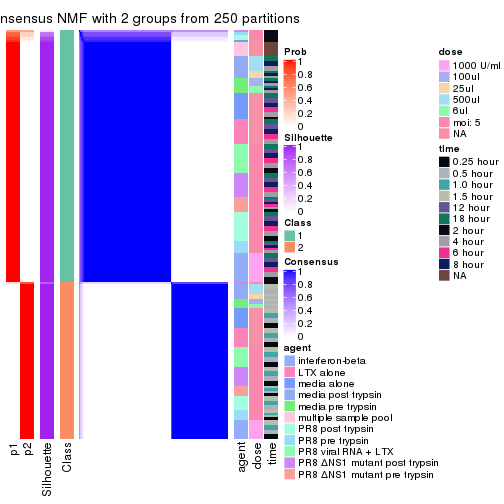
consensus_heatmap(res, k = 3)
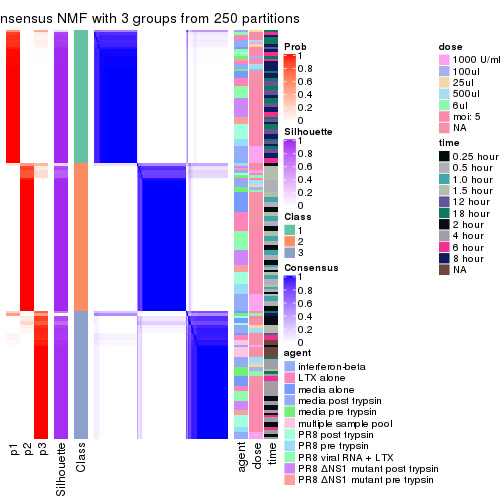
consensus_heatmap(res, k = 4)
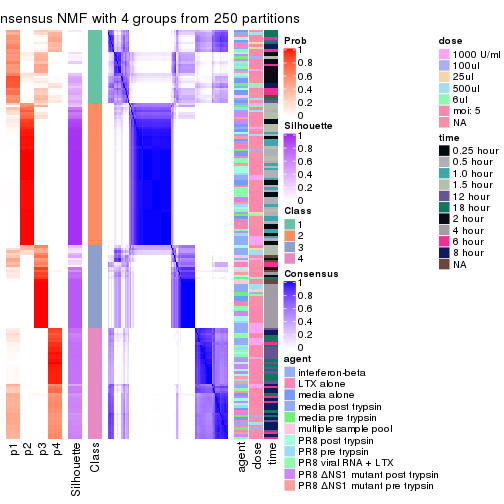
consensus_heatmap(res, k = 5)
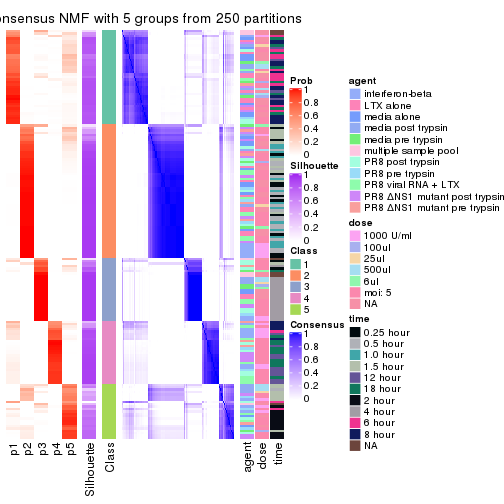
consensus_heatmap(res, k = 6)
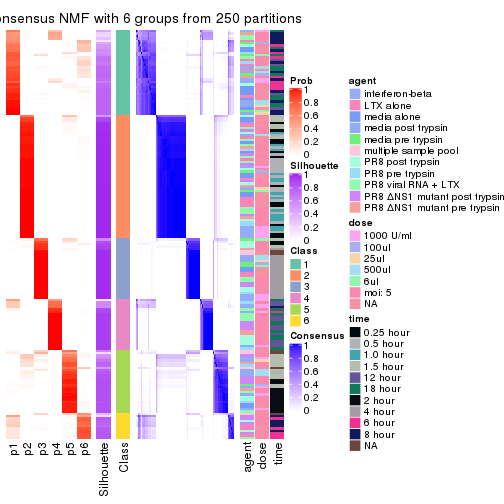
Heatmaps for the membership of samples in all partitions to see how consistent they are:
membership_heatmap(res, k = 2)

membership_heatmap(res, k = 3)
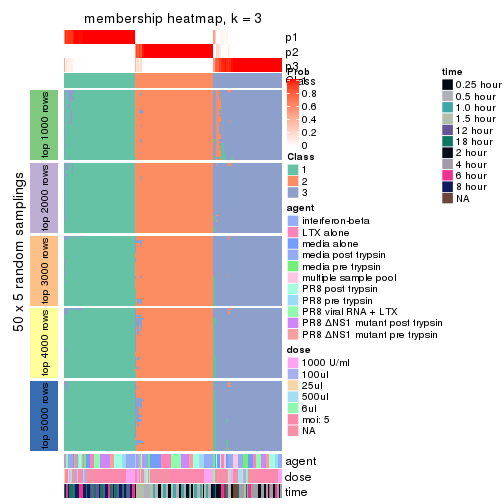
membership_heatmap(res, k = 4)
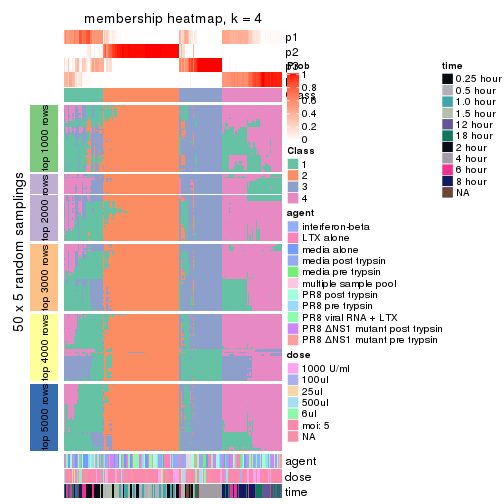
membership_heatmap(res, k = 5)
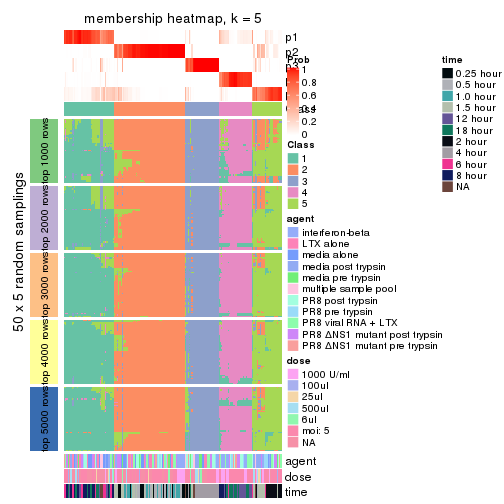
membership_heatmap(res, k = 6)
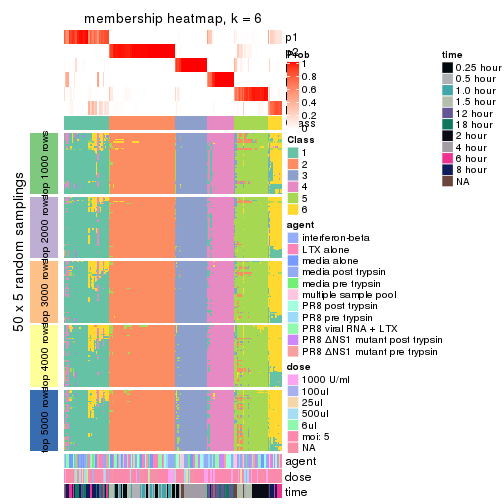
As soon as we have had the classes for columns, we can look for signatures which are significantly different between classes which can be candidate marks for certain classes. Following are the heatmaps for signatures.
Signature heatmaps where rows are scaled:
get_signatures(res, k = 2)
#> Error in mat[ceiling(1:nr/h_ratio), ceiling(1:nc/w_ratio), drop = FALSE]: subscript out of bounds
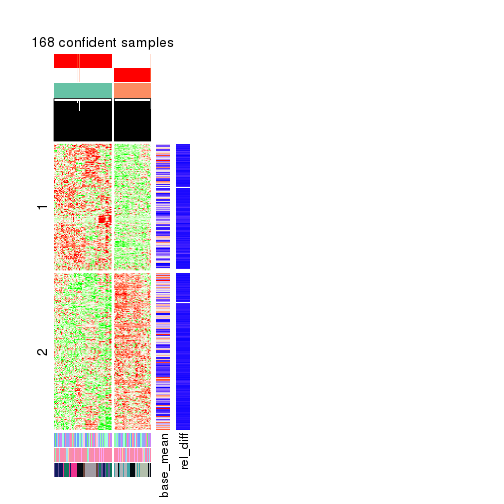
get_signatures(res, k = 3)
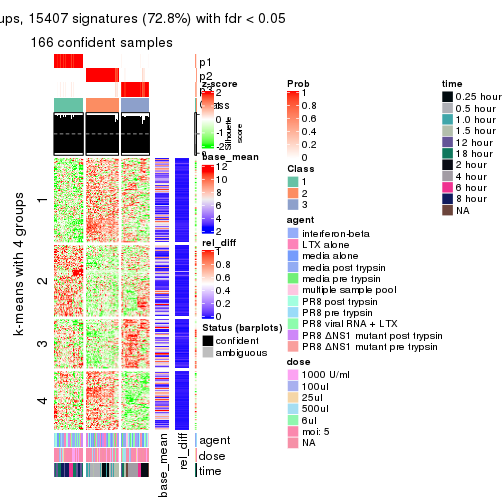
get_signatures(res, k = 4)
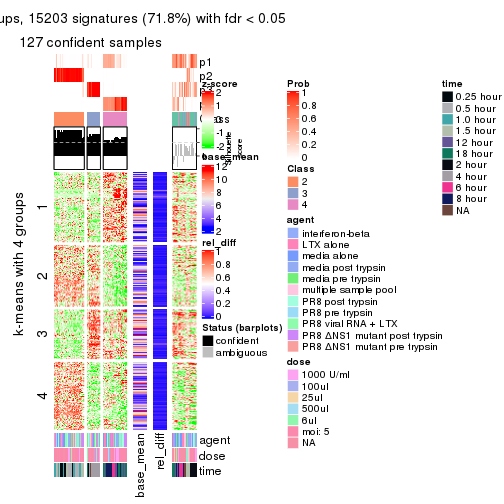
get_signatures(res, k = 5)
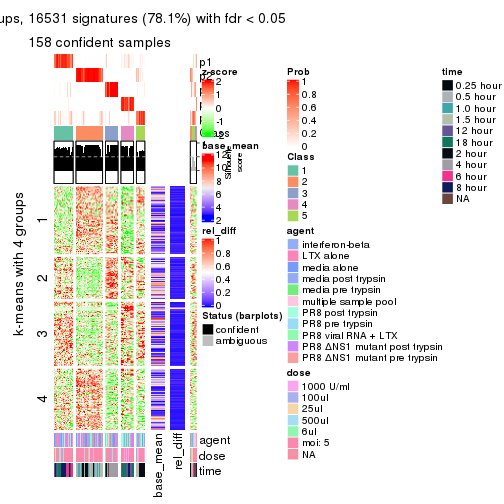
get_signatures(res, k = 6)
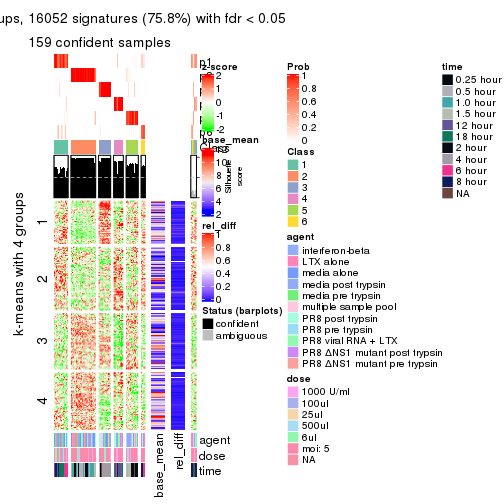
Signature heatmaps where rows are not scaled:
get_signatures(res, k = 2, scale_rows = FALSE)
#> Error in mat[ceiling(1:nr/h_ratio), ceiling(1:nc/w_ratio), drop = FALSE]: subscript out of bounds
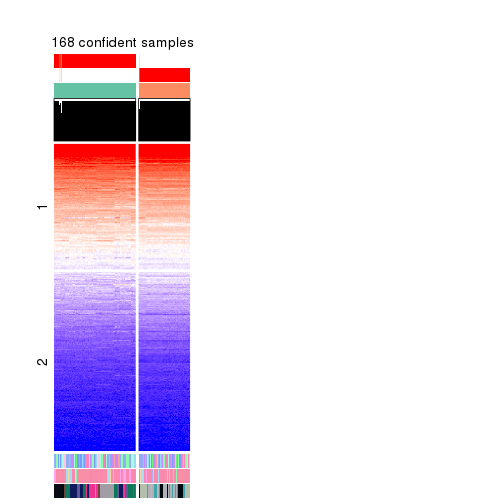
get_signatures(res, k = 3, scale_rows = FALSE)
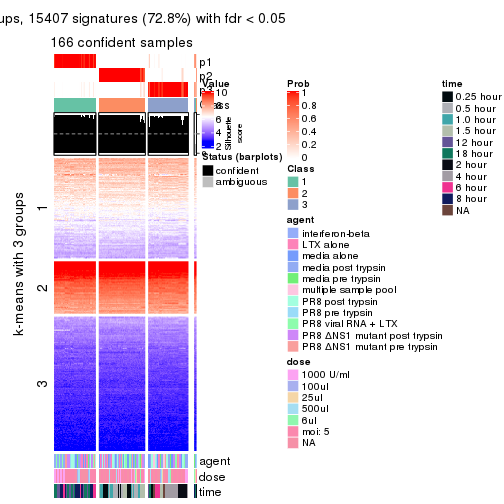
get_signatures(res, k = 4, scale_rows = FALSE)
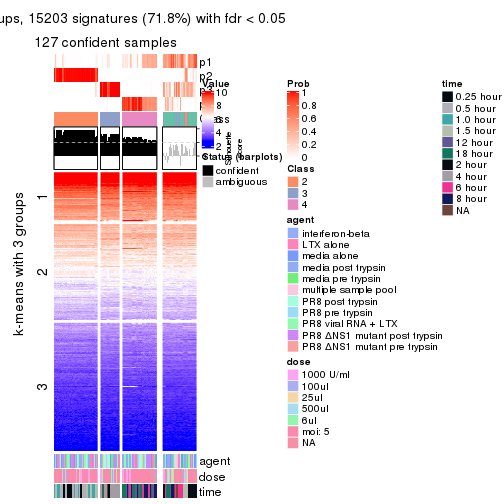
get_signatures(res, k = 5, scale_rows = FALSE)
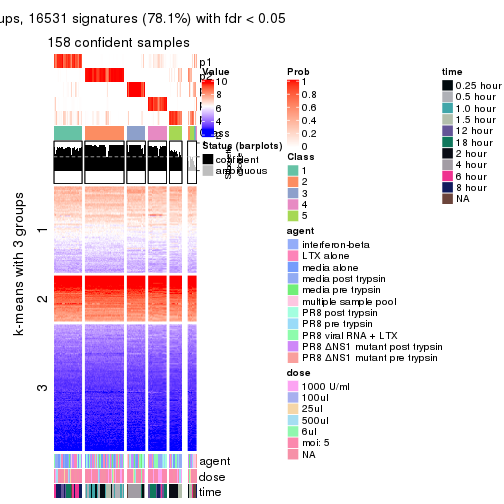
get_signatures(res, k = 6, scale_rows = FALSE)
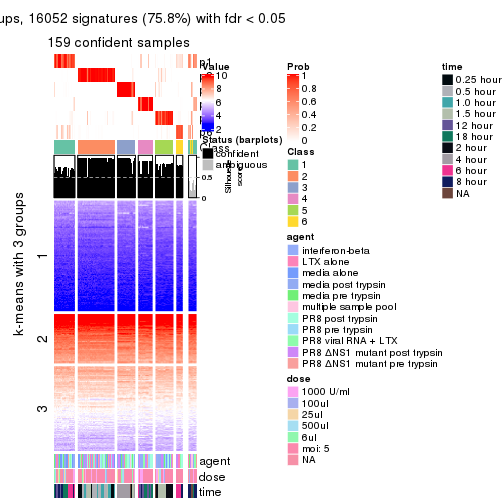
Compare the overlap of signatures from different k:
compare_signatures(res)
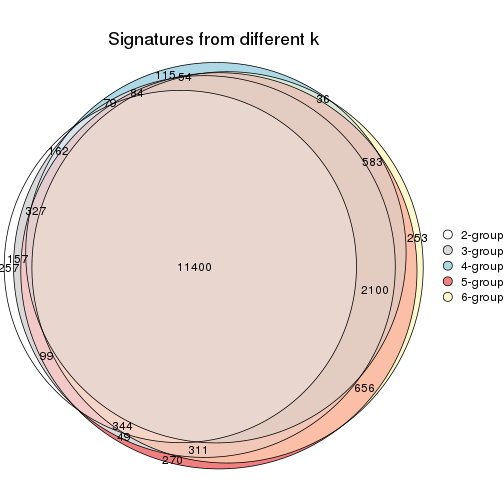
get_signature() returns a data frame invisibly. TO get the list of signatures, the function
call should be assigned to a variable explicitly. In following code, if plot argument is set
to FALSE, no heatmap is plotted while only the differential analysis is performed.
# code only for demonstration
tb = get_signature(res, k = ..., plot = FALSE)
An example of the output of tb is:
#> which_row fdr mean_1 mean_2 scaled_mean_1 scaled_mean_2 km
#> 1 38 0.042760348 8.373488 9.131774 -0.5533452 0.5164555 1
#> 2 40 0.018707592 7.106213 8.469186 -0.6173731 0.5762149 1
#> 3 55 0.019134737 10.221463 11.207825 -0.6159697 0.5749050 1
#> 4 59 0.006059896 5.921854 7.869574 -0.6899429 0.6439467 1
#> 5 60 0.018055526 8.928898 10.211722 -0.6204761 0.5791110 1
#> 6 98 0.009384629 15.714769 14.887706 0.6635654 -0.6193277 2
...
The columns in tb are:
which_row: row indices corresponding to the input matrix.fdr: FDR for the differential test. mean_x: The mean value in group x.scaled_mean_x: The mean value in group x after rows are scaled.km: Row groups if k-means clustering is applied to rows.UMAP plot which shows how samples are separated.
dimension_reduction(res, k = 2, method = "UMAP")
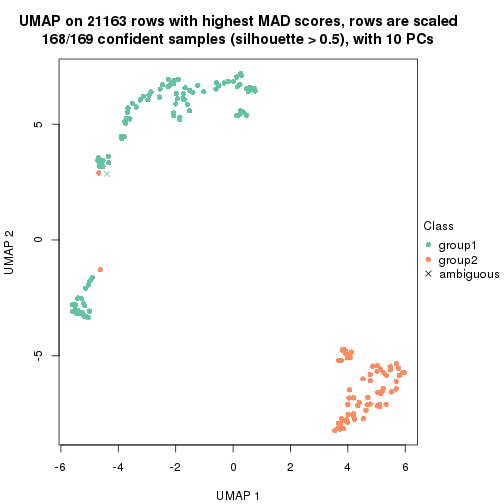
dimension_reduction(res, k = 3, method = "UMAP")
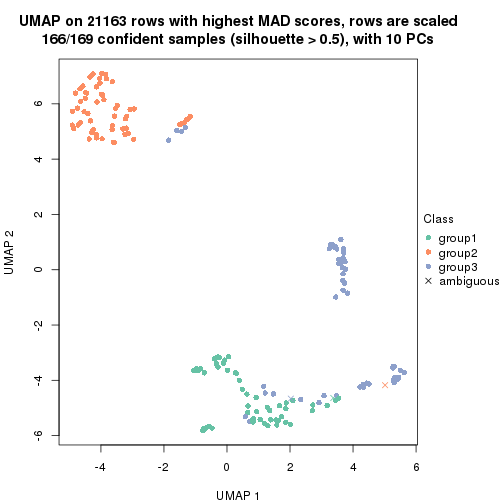
dimension_reduction(res, k = 4, method = "UMAP")
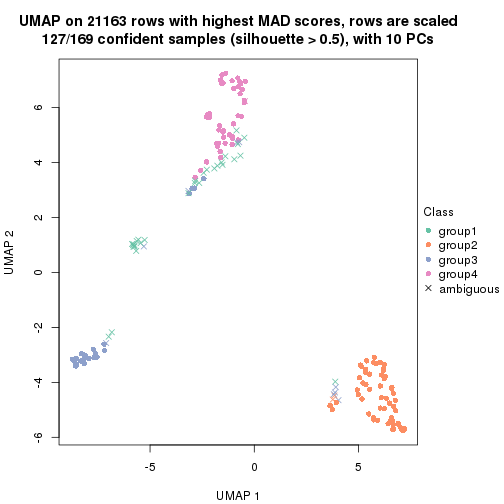
dimension_reduction(res, k = 5, method = "UMAP")
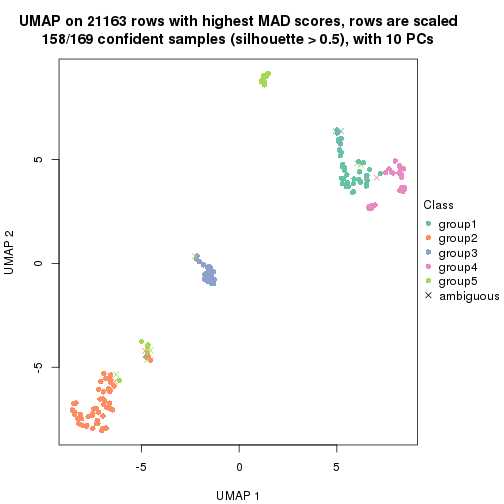
dimension_reduction(res, k = 6, method = "UMAP")
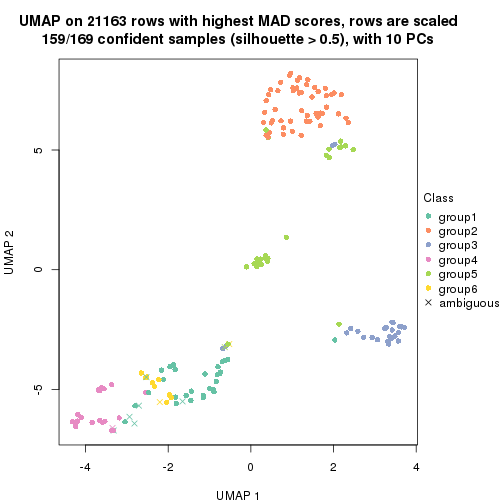
Following heatmap shows how subgroups are split when increasing k:
collect_classes(res)
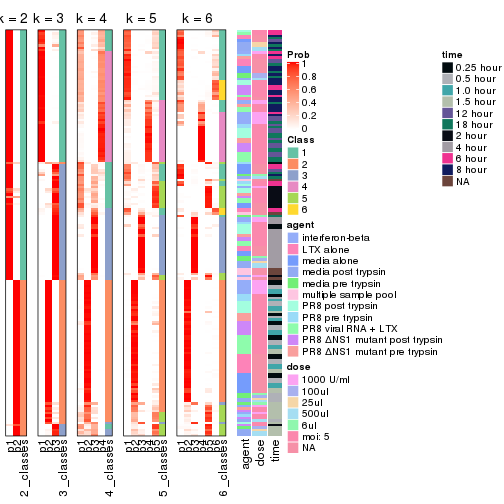
Test correlation between subgroups and known annotations. If the known annotation is numeric, one-way ANOVA test is applied, and if the known annotation is discrete, chi-squared contingency table test is applied.
test_to_known_factors(res)
#> n agent(p) dose(p) time(p) k
#> MAD:NMF 168 0.8663 0.9999 1.39e-28 2
#> MAD:NMF 166 0.2478 0.5294 1.09e-43 3
#> MAD:NMF 127 0.2398 0.4095 1.35e-39 4
#> MAD:NMF 158 0.0967 0.0122 2.11e-67 5
#> MAD:NMF 159 0.0473 0.1225 8.23e-66 6
If matrix rows can be associated to genes, consider to use functional_enrichment(res,
...) to perform function enrichment for the signature genes. See this vignette for more detailed explanations.
The object with results only for a single top-value method and a single partition method can be extracted as:
res = res_list["ATC", "hclust"]
# you can also extract it by
# res = res_list["ATC:hclust"]
A summary of res and all the functions that can be applied to it:
res
#> A 'ConsensusPartition' object with k = 2, 3, 4, 5, 6.
#> On a matrix with 21163 rows and 169 columns.
#> Top rows (1000, 2000, 3000, 4000, 5000) are extracted by 'ATC' method.
#> Subgroups are detected by 'hclust' method.
#> Performed in total 1250 partitions by row resampling.
#> Best k for subgroups seems to be 6.
#>
#> Following methods can be applied to this 'ConsensusPartition' object:
#> [1] "cola_report" "collect_classes" "collect_plots"
#> [4] "collect_stats" "colnames" "compare_signatures"
#> [7] "consensus_heatmap" "dimension_reduction" "functional_enrichment"
#> [10] "get_anno_col" "get_anno" "get_classes"
#> [13] "get_consensus" "get_matrix" "get_membership"
#> [16] "get_param" "get_signatures" "get_stats"
#> [19] "is_best_k" "is_stable_k" "membership_heatmap"
#> [22] "ncol" "nrow" "plot_ecdf"
#> [25] "rownames" "select_partition_number" "show"
#> [28] "suggest_best_k" "test_to_known_factors"
collect_plots() function collects all the plots made from res for all k (number of partitions)
into one single page to provide an easy and fast comparison between different k.
collect_plots(res)
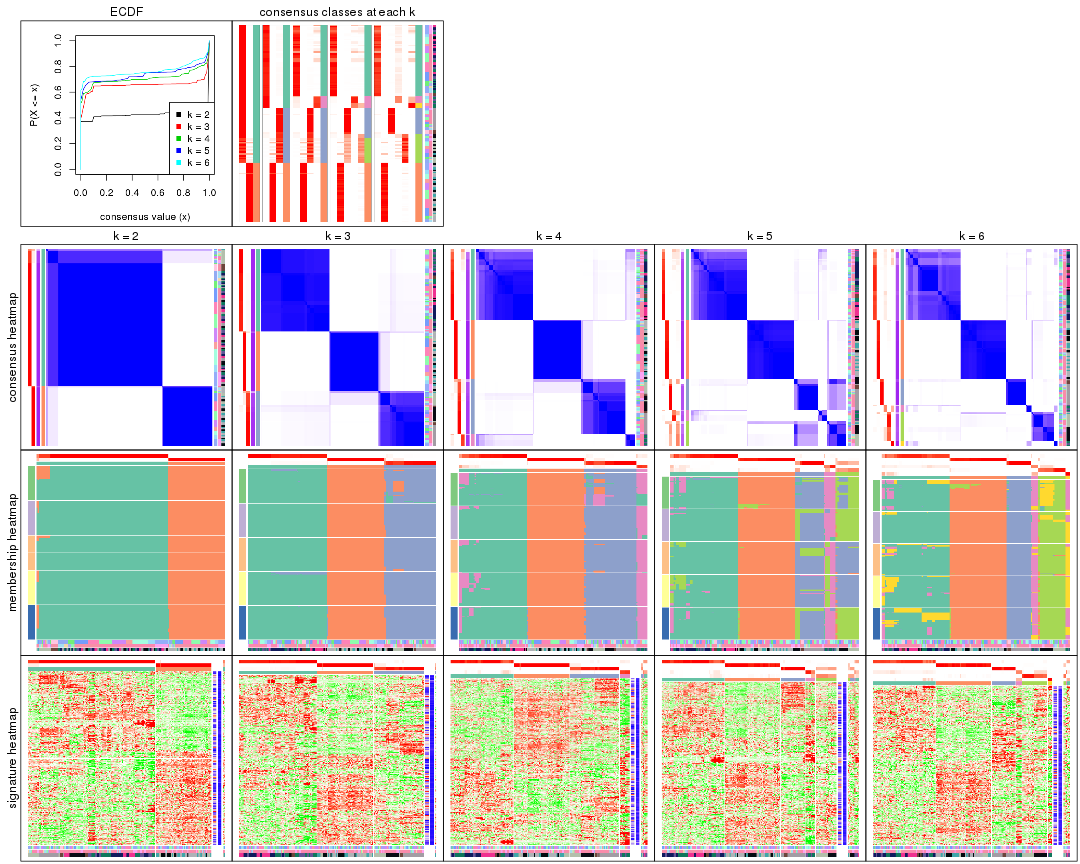
The plots are:
k and the heatmap of
predicted classes for each k.k.k.k.All the plots in panels can be made by individual functions and they are plotted later in this section.
select_partition_number() produces several plots showing different
statistics for choosing “optimized” k. There are following statistics:
k;k, the area increased is defined as \(A_k - A_{k-1}\).The detailed explanations of these statistics can be found in the cola vignette.
Generally speaking, lower PAC score, higher mean silhouette score or higher
concordance corresponds to better partition. Rand index and Jaccard index
measure how similar the current partition is compared to partition with k-1.
If they are too similar, we won't accept k is better than k-1.
select_partition_number(res)
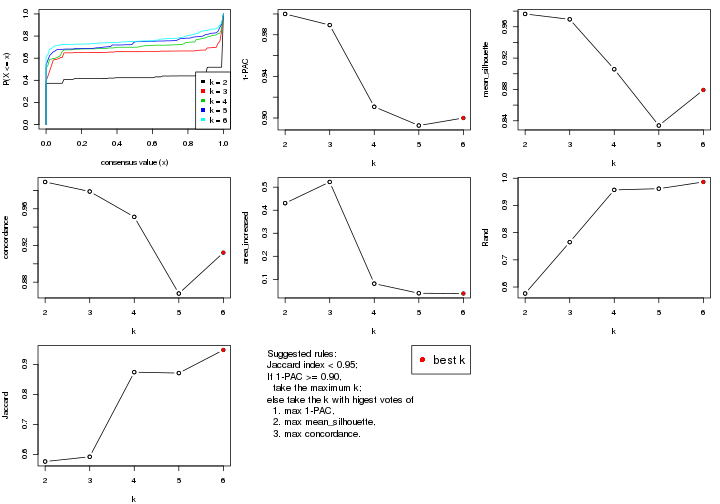
The numeric values for all these statistics can be obtained by get_stats().
get_stats(res)
#> k 1-PAC mean_silhouette concordance area_increased Rand Jaccard
#> 2 2 1.000 0.976 0.989 0.4306 0.576 0.576
#> 3 3 0.989 0.969 0.979 0.5226 0.765 0.592
#> 4 4 0.911 0.906 0.951 0.0814 0.957 0.874
#> 5 5 0.893 0.834 0.868 0.0397 0.962 0.871
#> 6 6 0.900 0.879 0.912 0.0386 0.986 0.948
suggest_best_k() suggests the best \(k\) based on these statistics. The rules are as follows:
suggest_best_k(res)
#> [1] 6
#> attr(,"optional")
#> [1] 2 3 4
There is also optional best \(k\) = 2 3 4 that is worth to check.
Following shows the table of the partitions (You need to click the show/hide
code output link to see it). The membership matrix (columns with name p*)
is inferred by
clue::cl_consensus()
function with the SE method. Basically the value in the membership matrix
represents the probability to belong to a certain group. The finall class
label for an item is determined with the group with highest probability it
belongs to.
In get_classes() function, the entropy is calculated from the membership
matrix and the silhouette score is calculated from the consensus matrix.
cbind(get_classes(res, k = 2), get_membership(res, k = 2))
#> class entropy silhouette p1 p2
#> GSM528681 2 0.0000 0.997 0.000 1.000
#> GSM528682 2 0.0000 0.997 0.000 1.000
#> GSM528683 2 0.0000 0.997 0.000 1.000
#> GSM528684 2 0.0000 0.997 0.000 1.000
#> GSM528687 2 0.0000 0.997 0.000 1.000
#> GSM528688 2 0.0000 0.997 0.000 1.000
#> GSM528685 1 0.4431 0.902 0.908 0.092
#> GSM528686 1 0.4431 0.902 0.908 0.092
#> GSM528693 1 0.0000 0.986 1.000 0.000
#> GSM528694 1 0.0000 0.986 1.000 0.000
#> GSM528695 1 0.0000 0.986 1.000 0.000
#> GSM528696 1 0.0000 0.986 1.000 0.000
#> GSM528697 1 0.0000 0.986 1.000 0.000
#> GSM528698 1 0.0000 0.986 1.000 0.000
#> GSM528699 1 0.0000 0.986 1.000 0.000
#> GSM528700 1 0.0000 0.986 1.000 0.000
#> GSM528689 1 0.0000 0.986 1.000 0.000
#> GSM528690 1 0.0000 0.986 1.000 0.000
#> GSM528691 1 0.0000 0.986 1.000 0.000
#> GSM528692 1 0.0000 0.986 1.000 0.000
#> GSM528779 2 0.0000 0.997 0.000 1.000
#> GSM528780 2 0.0000 0.997 0.000 1.000
#> GSM528782 2 0.0000 0.997 0.000 1.000
#> GSM528781 2 0.6343 0.804 0.160 0.840
#> GSM528785 1 0.0000 0.986 1.000 0.000
#> GSM528786 1 0.0000 0.986 1.000 0.000
#> GSM528787 1 0.0000 0.986 1.000 0.000
#> GSM528788 1 0.0000 0.986 1.000 0.000
#> GSM528783 1 0.0000 0.986 1.000 0.000
#> GSM528784 1 0.0000 0.986 1.000 0.000
#> GSM528759 1 0.0000 0.986 1.000 0.000
#> GSM528760 1 0.0000 0.986 1.000 0.000
#> GSM528761 2 0.0000 0.997 0.000 1.000
#> GSM528762 2 0.0000 0.997 0.000 1.000
#> GSM528765 2 0.0000 0.997 0.000 1.000
#> GSM528766 2 0.0000 0.997 0.000 1.000
#> GSM528763 1 0.9358 0.483 0.648 0.352
#> GSM528764 1 0.4431 0.902 0.908 0.092
#> GSM528771 1 0.0000 0.986 1.000 0.000
#> GSM528772 1 0.0000 0.986 1.000 0.000
#> GSM528773 1 0.0000 0.986 1.000 0.000
#> GSM528774 1 0.0000 0.986 1.000 0.000
#> GSM528775 1 0.0000 0.986 1.000 0.000
#> GSM528776 1 0.0000 0.986 1.000 0.000
#> GSM528777 1 0.0000 0.986 1.000 0.000
#> GSM528778 1 0.0000 0.986 1.000 0.000
#> GSM528767 1 0.0000 0.986 1.000 0.000
#> GSM528768 1 0.0000 0.986 1.000 0.000
#> GSM528769 1 0.0000 0.986 1.000 0.000
#> GSM528770 1 0.0000 0.986 1.000 0.000
#> GSM528671 2 0.0000 0.997 0.000 1.000
#> GSM528672 2 0.0000 0.997 0.000 1.000
#> GSM528674 2 0.0000 0.997 0.000 1.000
#> GSM528673 1 0.4431 0.902 0.908 0.092
#> GSM528677 1 0.0000 0.986 1.000 0.000
#> GSM528678 1 0.0000 0.986 1.000 0.000
#> GSM528679 1 0.0000 0.986 1.000 0.000
#> GSM528680 1 0.0000 0.986 1.000 0.000
#> GSM528675 1 0.0000 0.986 1.000 0.000
#> GSM528676 1 0.0000 0.986 1.000 0.000
#> GSM528651 2 0.0000 0.997 0.000 1.000
#> GSM528652 2 0.0000 0.997 0.000 1.000
#> GSM528653 2 0.0000 0.997 0.000 1.000
#> GSM528654 2 0.0000 0.997 0.000 1.000
#> GSM528657 2 0.0000 0.997 0.000 1.000
#> GSM528658 2 0.0000 0.997 0.000 1.000
#> GSM528655 1 0.4431 0.902 0.908 0.092
#> GSM528656 1 0.4431 0.902 0.908 0.092
#> GSM528663 1 0.0000 0.986 1.000 0.000
#> GSM528664 1 0.0000 0.986 1.000 0.000
#> GSM528665 1 0.0000 0.986 1.000 0.000
#> GSM528666 1 0.0000 0.986 1.000 0.000
#> GSM528667 1 0.0000 0.986 1.000 0.000
#> GSM528668 1 0.0000 0.986 1.000 0.000
#> GSM528669 1 0.0000 0.986 1.000 0.000
#> GSM528670 1 0.0000 0.986 1.000 0.000
#> GSM528659 1 0.0000 0.986 1.000 0.000
#> GSM528660 1 0.0000 0.986 1.000 0.000
#> GSM528661 1 0.0000 0.986 1.000 0.000
#> GSM528662 1 0.0000 0.986 1.000 0.000
#> GSM528701 2 0.0000 0.997 0.000 1.000
#> GSM528702 2 0.0000 0.997 0.000 1.000
#> GSM528703 2 0.0000 0.997 0.000 1.000
#> GSM528704 2 0.0000 0.997 0.000 1.000
#> GSM528707 2 0.0000 0.997 0.000 1.000
#> GSM528708 2 0.0000 0.997 0.000 1.000
#> GSM528705 2 0.0000 0.997 0.000 1.000
#> GSM528706 2 0.0000 0.997 0.000 1.000
#> GSM528713 1 0.0000 0.986 1.000 0.000
#> GSM528714 1 0.0000 0.986 1.000 0.000
#> GSM528715 1 0.0000 0.986 1.000 0.000
#> GSM528716 1 0.0000 0.986 1.000 0.000
#> GSM528717 1 0.0000 0.986 1.000 0.000
#> GSM528718 1 0.0000 0.986 1.000 0.000
#> GSM528719 1 0.0000 0.986 1.000 0.000
#> GSM528720 1 0.0000 0.986 1.000 0.000
#> GSM528709 1 0.0000 0.986 1.000 0.000
#> GSM528710 1 0.0000 0.986 1.000 0.000
#> GSM528711 1 0.0000 0.986 1.000 0.000
#> GSM528712 1 0.0000 0.986 1.000 0.000
#> GSM528721 2 0.0000 0.997 0.000 1.000
#> GSM528722 2 0.0000 0.997 0.000 1.000
#> GSM528723 2 0.0000 0.997 0.000 1.000
#> GSM528724 2 0.0000 0.997 0.000 1.000
#> GSM528727 2 0.0000 0.997 0.000 1.000
#> GSM528728 2 0.0000 0.997 0.000 1.000
#> GSM528725 2 0.0000 0.997 0.000 1.000
#> GSM528726 2 0.0000 0.997 0.000 1.000
#> GSM528733 1 0.0000 0.986 1.000 0.000
#> GSM528734 1 0.0000 0.986 1.000 0.000
#> GSM528735 1 0.0000 0.986 1.000 0.000
#> GSM528736 1 0.0000 0.986 1.000 0.000
#> GSM528737 1 0.0000 0.986 1.000 0.000
#> GSM528738 1 0.0000 0.986 1.000 0.000
#> GSM528729 1 0.0000 0.986 1.000 0.000
#> GSM528730 1 0.0000 0.986 1.000 0.000
#> GSM528731 1 0.0000 0.986 1.000 0.000
#> GSM528732 1 0.0000 0.986 1.000 0.000
#> GSM528739 2 0.0000 0.997 0.000 1.000
#> GSM528740 2 0.0000 0.997 0.000 1.000
#> GSM528741 2 0.0000 0.997 0.000 1.000
#> GSM528742 2 0.0000 0.997 0.000 1.000
#> GSM528745 1 0.9661 0.385 0.608 0.392
#> GSM528746 2 0.0000 0.997 0.000 1.000
#> GSM528743 2 0.0000 0.997 0.000 1.000
#> GSM528744 2 0.0000 0.997 0.000 1.000
#> GSM528751 1 0.0000 0.986 1.000 0.000
#> GSM528752 1 0.0000 0.986 1.000 0.000
#> GSM528753 1 0.0000 0.986 1.000 0.000
#> GSM528754 1 0.0000 0.986 1.000 0.000
#> GSM528755 1 0.0000 0.986 1.000 0.000
#> GSM528756 1 0.0000 0.986 1.000 0.000
#> GSM528757 1 0.0000 0.986 1.000 0.000
#> GSM528758 1 0.0000 0.986 1.000 0.000
#> GSM528747 1 0.0000 0.986 1.000 0.000
#> GSM528748 1 0.0000 0.986 1.000 0.000
#> GSM528749 1 0.0000 0.986 1.000 0.000
#> GSM528750 1 0.0000 0.986 1.000 0.000
#> GSM528640 2 0.0000 0.997 0.000 1.000
#> GSM528641 1 0.4431 0.902 0.908 0.092
#> GSM528643 1 0.0000 0.986 1.000 0.000
#> GSM528644 1 0.0000 0.986 1.000 0.000
#> GSM528642 1 0.0000 0.986 1.000 0.000
#> GSM528620 2 0.0000 0.997 0.000 1.000
#> GSM528621 1 0.0376 0.982 0.996 0.004
#> GSM528623 1 0.0000 0.986 1.000 0.000
#> GSM528624 1 0.0000 0.986 1.000 0.000
#> GSM528622 1 0.0000 0.986 1.000 0.000
#> GSM528625 2 0.0000 0.997 0.000 1.000
#> GSM528626 1 0.4431 0.902 0.908 0.092
#> GSM528628 1 0.0000 0.986 1.000 0.000
#> GSM528629 1 0.0000 0.986 1.000 0.000
#> GSM528627 1 0.0000 0.986 1.000 0.000
#> GSM528630 2 0.0000 0.997 0.000 1.000
#> GSM528631 2 0.0000 0.997 0.000 1.000
#> GSM528632 1 0.4431 0.902 0.908 0.092
#> GSM528633 1 0.4431 0.902 0.908 0.092
#> GSM528636 1 0.0000 0.986 1.000 0.000
#> GSM528637 1 0.0000 0.986 1.000 0.000
#> GSM528638 1 0.0000 0.986 1.000 0.000
#> GSM528639 1 0.0000 0.986 1.000 0.000
#> GSM528634 1 0.0000 0.986 1.000 0.000
#> GSM528635 1 0.0000 0.986 1.000 0.000
#> GSM528645 1 0.0000 0.986 1.000 0.000
#> GSM528646 1 0.0000 0.986 1.000 0.000
#> GSM528647 1 0.0000 0.986 1.000 0.000
#> GSM528648 1 0.0000 0.986 1.000 0.000
#> GSM528649 1 0.0000 0.986 1.000 0.000
#> GSM528650 1 0.0000 0.986 1.000 0.000
cbind(get_classes(res, k = 3), get_membership(res, k = 3))
#> class entropy silhouette p1 p2 p3
#> GSM528681 2 0.0000 0.997 0.000 1.000 0.000
#> GSM528682 2 0.0000 0.997 0.000 1.000 0.000
#> GSM528683 2 0.0000 0.997 0.000 1.000 0.000
#> GSM528684 2 0.0000 0.997 0.000 1.000 0.000
#> GSM528687 2 0.0000 0.997 0.000 1.000 0.000
#> GSM528688 2 0.0000 0.997 0.000 1.000 0.000
#> GSM528685 3 0.2796 0.905 0.000 0.092 0.908
#> GSM528686 3 0.2796 0.905 0.000 0.092 0.908
#> GSM528693 3 0.1643 0.932 0.044 0.000 0.956
#> GSM528694 3 0.1643 0.932 0.044 0.000 0.956
#> GSM528695 3 0.0237 0.954 0.004 0.000 0.996
#> GSM528696 3 0.0237 0.954 0.004 0.000 0.996
#> GSM528697 1 0.0000 0.983 1.000 0.000 0.000
#> GSM528698 1 0.0892 0.989 0.980 0.000 0.020
#> GSM528699 1 0.1163 0.987 0.972 0.000 0.028
#> GSM528700 1 0.1163 0.987 0.972 0.000 0.028
#> GSM528689 1 0.0000 0.983 1.000 0.000 0.000
#> GSM528690 1 0.0000 0.983 1.000 0.000 0.000
#> GSM528691 1 0.0000 0.983 1.000 0.000 0.000
#> GSM528692 1 0.0747 0.981 0.984 0.000 0.016
#> GSM528779 2 0.0000 0.997 0.000 1.000 0.000
#> GSM528780 2 0.0000 0.997 0.000 1.000 0.000
#> GSM528782 2 0.0000 0.997 0.000 1.000 0.000
#> GSM528781 2 0.4002 0.796 0.000 0.840 0.160
#> GSM528785 3 0.0424 0.953 0.008 0.000 0.992
#> GSM528786 3 0.0237 0.954 0.004 0.000 0.996
#> GSM528787 1 0.1289 0.984 0.968 0.000 0.032
#> GSM528788 1 0.1289 0.986 0.968 0.000 0.032
#> GSM528783 1 0.0000 0.983 1.000 0.000 0.000
#> GSM528784 1 0.0000 0.983 1.000 0.000 0.000
#> GSM528759 1 0.0892 0.989 0.980 0.000 0.020
#> GSM528760 1 0.0892 0.989 0.980 0.000 0.020
#> GSM528761 2 0.0000 0.997 0.000 1.000 0.000
#> GSM528762 2 0.0000 0.997 0.000 1.000 0.000
#> GSM528765 2 0.0000 0.997 0.000 1.000 0.000
#> GSM528766 2 0.0000 0.997 0.000 1.000 0.000
#> GSM528763 3 0.5905 0.512 0.000 0.352 0.648
#> GSM528764 3 0.2796 0.905 0.000 0.092 0.908
#> GSM528771 3 0.0424 0.953 0.008 0.000 0.992
#> GSM528772 3 0.0424 0.953 0.008 0.000 0.992
#> GSM528773 3 0.0237 0.954 0.004 0.000 0.996
#> GSM528774 3 0.0237 0.954 0.004 0.000 0.996
#> GSM528775 1 0.1289 0.984 0.968 0.000 0.032
#> GSM528776 1 0.0892 0.989 0.980 0.000 0.020
#> GSM528777 1 0.1163 0.987 0.972 0.000 0.028
#> GSM528778 1 0.1163 0.987 0.972 0.000 0.028
#> GSM528767 1 0.0000 0.983 1.000 0.000 0.000
#> GSM528768 1 0.0000 0.983 1.000 0.000 0.000
#> GSM528769 1 0.0000 0.983 1.000 0.000 0.000
#> GSM528770 1 0.0000 0.983 1.000 0.000 0.000
#> GSM528671 2 0.0000 0.997 0.000 1.000 0.000
#> GSM528672 2 0.0000 0.997 0.000 1.000 0.000
#> GSM528674 2 0.0000 0.997 0.000 1.000 0.000
#> GSM528673 3 0.2796 0.905 0.000 0.092 0.908
#> GSM528677 3 0.0424 0.953 0.008 0.000 0.992
#> GSM528678 3 0.2356 0.909 0.072 0.000 0.928
#> GSM528679 1 0.0892 0.989 0.980 0.000 0.020
#> GSM528680 1 0.1163 0.987 0.972 0.000 0.028
#> GSM528675 1 0.0000 0.983 1.000 0.000 0.000
#> GSM528676 1 0.0000 0.983 1.000 0.000 0.000
#> GSM528651 2 0.0000 0.997 0.000 1.000 0.000
#> GSM528652 2 0.0000 0.997 0.000 1.000 0.000
#> GSM528653 2 0.0000 0.997 0.000 1.000 0.000
#> GSM528654 2 0.0000 0.997 0.000 1.000 0.000
#> GSM528657 2 0.0000 0.997 0.000 1.000 0.000
#> GSM528658 2 0.0000 0.997 0.000 1.000 0.000
#> GSM528655 3 0.2796 0.905 0.000 0.092 0.908
#> GSM528656 3 0.2796 0.905 0.000 0.092 0.908
#> GSM528663 3 0.0424 0.953 0.008 0.000 0.992
#> GSM528664 3 0.0424 0.953 0.008 0.000 0.992
#> GSM528665 3 0.0237 0.954 0.004 0.000 0.996
#> GSM528666 3 0.0237 0.954 0.004 0.000 0.996
#> GSM528667 1 0.0892 0.989 0.980 0.000 0.020
#> GSM528668 1 0.0892 0.989 0.980 0.000 0.020
#> GSM528669 1 0.1163 0.987 0.972 0.000 0.028
#> GSM528670 1 0.1163 0.987 0.972 0.000 0.028
#> GSM528659 1 0.0000 0.983 1.000 0.000 0.000
#> GSM528660 1 0.0000 0.983 1.000 0.000 0.000
#> GSM528661 1 0.0000 0.983 1.000 0.000 0.000
#> GSM528662 1 0.0000 0.983 1.000 0.000 0.000
#> GSM528701 2 0.0000 0.997 0.000 1.000 0.000
#> GSM528702 2 0.0000 0.997 0.000 1.000 0.000
#> GSM528703 2 0.0000 0.997 0.000 1.000 0.000
#> GSM528704 2 0.0000 0.997 0.000 1.000 0.000
#> GSM528707 2 0.0000 0.997 0.000 1.000 0.000
#> GSM528708 2 0.0000 0.997 0.000 1.000 0.000
#> GSM528705 2 0.0000 0.997 0.000 1.000 0.000
#> GSM528706 2 0.0000 0.997 0.000 1.000 0.000
#> GSM528713 3 0.1643 0.932 0.044 0.000 0.956
#> GSM528714 3 0.1643 0.932 0.044 0.000 0.956
#> GSM528715 3 0.0237 0.954 0.004 0.000 0.996
#> GSM528716 3 0.0237 0.954 0.004 0.000 0.996
#> GSM528717 1 0.0892 0.989 0.980 0.000 0.020
#> GSM528718 1 0.0892 0.989 0.980 0.000 0.020
#> GSM528719 1 0.0747 0.989 0.984 0.000 0.016
#> GSM528720 1 0.0747 0.989 0.984 0.000 0.016
#> GSM528709 1 0.0000 0.983 1.000 0.000 0.000
#> GSM528710 1 0.0000 0.983 1.000 0.000 0.000
#> GSM528711 1 0.0000 0.983 1.000 0.000 0.000
#> GSM528712 1 0.0000 0.983 1.000 0.000 0.000
#> GSM528721 2 0.0000 0.997 0.000 1.000 0.000
#> GSM528722 2 0.0000 0.997 0.000 1.000 0.000
#> GSM528723 2 0.0000 0.997 0.000 1.000 0.000
#> GSM528724 2 0.0000 0.997 0.000 1.000 0.000
#> GSM528727 2 0.0000 0.997 0.000 1.000 0.000
#> GSM528728 2 0.0000 0.997 0.000 1.000 0.000
#> GSM528725 2 0.0000 0.997 0.000 1.000 0.000
#> GSM528726 2 0.0000 0.997 0.000 1.000 0.000
#> GSM528733 3 0.0237 0.954 0.004 0.000 0.996
#> GSM528734 3 0.0237 0.954 0.004 0.000 0.996
#> GSM528735 1 0.0892 0.989 0.980 0.000 0.020
#> GSM528736 1 0.0892 0.989 0.980 0.000 0.020
#> GSM528737 1 0.0892 0.989 0.980 0.000 0.020
#> GSM528738 1 0.0892 0.989 0.980 0.000 0.020
#> GSM528729 1 0.1289 0.986 0.968 0.000 0.032
#> GSM528730 1 0.1289 0.986 0.968 0.000 0.032
#> GSM528731 1 0.1289 0.986 0.968 0.000 0.032
#> GSM528732 1 0.1289 0.986 0.968 0.000 0.032
#> GSM528739 2 0.0000 0.997 0.000 1.000 0.000
#> GSM528740 2 0.0000 0.997 0.000 1.000 0.000
#> GSM528741 2 0.0000 0.997 0.000 1.000 0.000
#> GSM528742 2 0.0000 0.997 0.000 1.000 0.000
#> GSM528745 3 0.6095 0.417 0.000 0.392 0.608
#> GSM528746 2 0.0000 0.997 0.000 1.000 0.000
#> GSM528743 2 0.0000 0.997 0.000 1.000 0.000
#> GSM528744 2 0.0000 0.997 0.000 1.000 0.000
#> GSM528751 3 0.0424 0.953 0.008 0.000 0.992
#> GSM528752 3 0.0424 0.953 0.008 0.000 0.992
#> GSM528753 3 0.0237 0.954 0.004 0.000 0.996
#> GSM528754 3 0.0237 0.954 0.004 0.000 0.996
#> GSM528755 1 0.0892 0.989 0.980 0.000 0.020
#> GSM528756 1 0.0892 0.989 0.980 0.000 0.020
#> GSM528757 1 0.1289 0.986 0.968 0.000 0.032
#> GSM528758 1 0.1289 0.986 0.968 0.000 0.032
#> GSM528747 1 0.1289 0.986 0.968 0.000 0.032
#> GSM528748 1 0.1289 0.986 0.968 0.000 0.032
#> GSM528749 1 0.1289 0.986 0.968 0.000 0.032
#> GSM528750 1 0.1289 0.986 0.968 0.000 0.032
#> GSM528640 2 0.0000 0.997 0.000 1.000 0.000
#> GSM528641 3 0.2796 0.905 0.000 0.092 0.908
#> GSM528643 3 0.0237 0.954 0.004 0.000 0.996
#> GSM528644 1 0.1289 0.986 0.968 0.000 0.032
#> GSM528642 1 0.1289 0.984 0.968 0.000 0.032
#> GSM528620 2 0.0000 0.997 0.000 1.000 0.000
#> GSM528621 3 0.0237 0.952 0.000 0.004 0.996
#> GSM528623 3 0.0237 0.954 0.004 0.000 0.996
#> GSM528624 1 0.1289 0.986 0.968 0.000 0.032
#> GSM528622 1 0.0892 0.989 0.980 0.000 0.020
#> GSM528625 2 0.0000 0.997 0.000 1.000 0.000
#> GSM528626 3 0.2796 0.905 0.000 0.092 0.908
#> GSM528628 3 0.0237 0.954 0.004 0.000 0.996
#> GSM528629 1 0.1289 0.986 0.968 0.000 0.032
#> GSM528627 1 0.0892 0.989 0.980 0.000 0.020
#> GSM528630 2 0.0000 0.997 0.000 1.000 0.000
#> GSM528631 2 0.0000 0.997 0.000 1.000 0.000
#> GSM528632 3 0.2796 0.905 0.000 0.092 0.908
#> GSM528633 3 0.2796 0.905 0.000 0.092 0.908
#> GSM528636 3 0.0237 0.954 0.004 0.000 0.996
#> GSM528637 3 0.0237 0.954 0.004 0.000 0.996
#> GSM528638 1 0.1289 0.986 0.968 0.000 0.032
#> GSM528639 1 0.1289 0.986 0.968 0.000 0.032
#> GSM528634 1 0.0892 0.989 0.980 0.000 0.020
#> GSM528635 1 0.0892 0.989 0.980 0.000 0.020
#> GSM528645 3 0.0237 0.954 0.004 0.000 0.996
#> GSM528646 3 0.0237 0.954 0.004 0.000 0.996
#> GSM528647 3 0.2356 0.909 0.072 0.000 0.928
#> GSM528648 1 0.0892 0.989 0.980 0.000 0.020
#> GSM528649 1 0.0892 0.989 0.980 0.000 0.020
#> GSM528650 1 0.0892 0.989 0.980 0.000 0.020
cbind(get_classes(res, k = 4), get_membership(res, k = 4))
#> class entropy silhouette p1 p2 p3 p4
#> GSM528681 2 0.0000 0.9960 0.000 1.000 0.000 0.000
#> GSM528682 2 0.0000 0.9960 0.000 1.000 0.000 0.000
#> GSM528683 2 0.0000 0.9960 0.000 1.000 0.000 0.000
#> GSM528684 2 0.0000 0.9960 0.000 1.000 0.000 0.000
#> GSM528687 2 0.0000 0.9960 0.000 1.000 0.000 0.000
#> GSM528688 2 0.0000 0.9960 0.000 1.000 0.000 0.000
#> GSM528685 3 0.3900 0.8517 0.000 0.084 0.844 0.072
#> GSM528686 3 0.3900 0.8517 0.000 0.084 0.844 0.072
#> GSM528693 3 0.1211 0.9052 0.040 0.000 0.960 0.000
#> GSM528694 3 0.1211 0.9052 0.040 0.000 0.960 0.000
#> GSM528695 3 0.0000 0.9306 0.000 0.000 1.000 0.000
#> GSM528696 3 0.0000 0.9306 0.000 0.000 1.000 0.000
#> GSM528697 1 0.4989 0.0745 0.528 0.000 0.000 0.472
#> GSM528698 1 0.0000 0.9233 1.000 0.000 0.000 0.000
#> GSM528699 1 0.2805 0.8574 0.888 0.000 0.012 0.100
#> GSM528700 1 0.2805 0.8574 0.888 0.000 0.012 0.100
#> GSM528689 1 0.3801 0.7149 0.780 0.000 0.000 0.220
#> GSM528690 1 0.3801 0.7149 0.780 0.000 0.000 0.220
#> GSM528691 1 0.2814 0.8259 0.868 0.000 0.000 0.132
#> GSM528692 1 0.2179 0.8827 0.924 0.000 0.012 0.064
#> GSM528779 2 0.0000 0.9960 0.000 1.000 0.000 0.000
#> GSM528780 2 0.0000 0.9960 0.000 1.000 0.000 0.000
#> GSM528782 2 0.0000 0.9960 0.000 1.000 0.000 0.000
#> GSM528781 2 0.3172 0.7774 0.000 0.840 0.160 0.000
#> GSM528785 3 0.0672 0.9285 0.008 0.000 0.984 0.008
#> GSM528786 3 0.0000 0.9306 0.000 0.000 1.000 0.000
#> GSM528787 1 0.0592 0.9168 0.984 0.000 0.016 0.000
#> GSM528788 1 0.0804 0.9196 0.980 0.000 0.012 0.008
#> GSM528783 4 0.4817 0.4330 0.388 0.000 0.000 0.612
#> GSM528784 4 0.2345 0.9442 0.100 0.000 0.000 0.900
#> GSM528759 1 0.0000 0.9233 1.000 0.000 0.000 0.000
#> GSM528760 1 0.0000 0.9233 1.000 0.000 0.000 0.000
#> GSM528761 2 0.0000 0.9960 0.000 1.000 0.000 0.000
#> GSM528762 2 0.0000 0.9960 0.000 1.000 0.000 0.000
#> GSM528765 2 0.0000 0.9960 0.000 1.000 0.000 0.000
#> GSM528766 2 0.0000 0.9960 0.000 1.000 0.000 0.000
#> GSM528763 3 0.6280 0.4729 0.000 0.344 0.584 0.072
#> GSM528764 3 0.3900 0.8517 0.000 0.084 0.844 0.072
#> GSM528771 3 0.0672 0.9285 0.008 0.000 0.984 0.008
#> GSM528772 3 0.0672 0.9285 0.008 0.000 0.984 0.008
#> GSM528773 3 0.0000 0.9306 0.000 0.000 1.000 0.000
#> GSM528774 3 0.0000 0.9306 0.000 0.000 1.000 0.000
#> GSM528775 1 0.0592 0.9168 0.984 0.000 0.016 0.000
#> GSM528776 1 0.0000 0.9233 1.000 0.000 0.000 0.000
#> GSM528777 1 0.2542 0.8658 0.904 0.000 0.012 0.084
#> GSM528778 1 0.2542 0.8658 0.904 0.000 0.012 0.084
#> GSM528767 4 0.2345 0.9442 0.100 0.000 0.000 0.900
#> GSM528768 4 0.2345 0.9442 0.100 0.000 0.000 0.900
#> GSM528769 4 0.2345 0.9442 0.100 0.000 0.000 0.900
#> GSM528770 4 0.2345 0.9442 0.100 0.000 0.000 0.900
#> GSM528671 2 0.0000 0.9960 0.000 1.000 0.000 0.000
#> GSM528672 2 0.0000 0.9960 0.000 1.000 0.000 0.000
#> GSM528674 2 0.0000 0.9960 0.000 1.000 0.000 0.000
#> GSM528673 3 0.3900 0.8517 0.000 0.084 0.844 0.072
#> GSM528677 3 0.0672 0.9285 0.008 0.000 0.984 0.008
#> GSM528678 3 0.1792 0.8799 0.068 0.000 0.932 0.000
#> GSM528679 1 0.0000 0.9233 1.000 0.000 0.000 0.000
#> GSM528680 1 0.2805 0.8574 0.888 0.000 0.012 0.100
#> GSM528675 4 0.1867 0.9386 0.072 0.000 0.000 0.928
#> GSM528676 4 0.1867 0.9386 0.072 0.000 0.000 0.928
#> GSM528651 2 0.0000 0.9960 0.000 1.000 0.000 0.000
#> GSM528652 2 0.0000 0.9960 0.000 1.000 0.000 0.000
#> GSM528653 2 0.0000 0.9960 0.000 1.000 0.000 0.000
#> GSM528654 2 0.0000 0.9960 0.000 1.000 0.000 0.000
#> GSM528657 2 0.0000 0.9960 0.000 1.000 0.000 0.000
#> GSM528658 2 0.0000 0.9960 0.000 1.000 0.000 0.000
#> GSM528655 3 0.3900 0.8517 0.000 0.084 0.844 0.072
#> GSM528656 3 0.3900 0.8517 0.000 0.084 0.844 0.072
#> GSM528663 3 0.0672 0.9285 0.008 0.000 0.984 0.008
#> GSM528664 3 0.0672 0.9285 0.008 0.000 0.984 0.008
#> GSM528665 3 0.0000 0.9306 0.000 0.000 1.000 0.000
#> GSM528666 3 0.0000 0.9306 0.000 0.000 1.000 0.000
#> GSM528667 1 0.0000 0.9233 1.000 0.000 0.000 0.000
#> GSM528668 1 0.0000 0.9233 1.000 0.000 0.000 0.000
#> GSM528669 1 0.2542 0.8658 0.904 0.000 0.012 0.084
#> GSM528670 1 0.2610 0.8633 0.900 0.000 0.012 0.088
#> GSM528659 1 0.4989 0.0745 0.528 0.000 0.000 0.472
#> GSM528660 1 0.4989 0.0745 0.528 0.000 0.000 0.472
#> GSM528661 4 0.1867 0.9386 0.072 0.000 0.000 0.928
#> GSM528662 4 0.1867 0.9386 0.072 0.000 0.000 0.928
#> GSM528701 2 0.0000 0.9960 0.000 1.000 0.000 0.000
#> GSM528702 2 0.0000 0.9960 0.000 1.000 0.000 0.000
#> GSM528703 2 0.0000 0.9960 0.000 1.000 0.000 0.000
#> GSM528704 2 0.0000 0.9960 0.000 1.000 0.000 0.000
#> GSM528707 2 0.0000 0.9960 0.000 1.000 0.000 0.000
#> GSM528708 2 0.0000 0.9960 0.000 1.000 0.000 0.000
#> GSM528705 2 0.0000 0.9960 0.000 1.000 0.000 0.000
#> GSM528706 2 0.0000 0.9960 0.000 1.000 0.000 0.000
#> GSM528713 3 0.1211 0.9052 0.040 0.000 0.960 0.000
#> GSM528714 3 0.1211 0.9052 0.040 0.000 0.960 0.000
#> GSM528715 3 0.0000 0.9306 0.000 0.000 1.000 0.000
#> GSM528716 3 0.0000 0.9306 0.000 0.000 1.000 0.000
#> GSM528717 1 0.0000 0.9233 1.000 0.000 0.000 0.000
#> GSM528718 1 0.0000 0.9233 1.000 0.000 0.000 0.000
#> GSM528719 1 0.1022 0.9090 0.968 0.000 0.000 0.032
#> GSM528720 1 0.1022 0.9090 0.968 0.000 0.000 0.032
#> GSM528709 1 0.3801 0.7149 0.780 0.000 0.000 0.220
#> GSM528710 1 0.3801 0.7149 0.780 0.000 0.000 0.220
#> GSM528711 1 0.3764 0.7207 0.784 0.000 0.000 0.216
#> GSM528712 1 0.3764 0.7207 0.784 0.000 0.000 0.216
#> GSM528721 2 0.0000 0.9960 0.000 1.000 0.000 0.000
#> GSM528722 2 0.0000 0.9960 0.000 1.000 0.000 0.000
#> GSM528723 2 0.0000 0.9960 0.000 1.000 0.000 0.000
#> GSM528724 2 0.0000 0.9960 0.000 1.000 0.000 0.000
#> GSM528727 2 0.0000 0.9960 0.000 1.000 0.000 0.000
#> GSM528728 2 0.0000 0.9960 0.000 1.000 0.000 0.000
#> GSM528725 2 0.0000 0.9960 0.000 1.000 0.000 0.000
#> GSM528726 2 0.0000 0.9960 0.000 1.000 0.000 0.000
#> GSM528733 3 0.0000 0.9306 0.000 0.000 1.000 0.000
#> GSM528734 3 0.0000 0.9306 0.000 0.000 1.000 0.000
#> GSM528735 1 0.0000 0.9233 1.000 0.000 0.000 0.000
#> GSM528736 1 0.0000 0.9233 1.000 0.000 0.000 0.000
#> GSM528737 1 0.0000 0.9233 1.000 0.000 0.000 0.000
#> GSM528738 1 0.0000 0.9233 1.000 0.000 0.000 0.000
#> GSM528729 1 0.0657 0.9205 0.984 0.000 0.012 0.004
#> GSM528730 1 0.0657 0.9205 0.984 0.000 0.012 0.004
#> GSM528731 1 0.0657 0.9205 0.984 0.000 0.012 0.004
#> GSM528732 1 0.0469 0.9208 0.988 0.000 0.012 0.000
#> GSM528739 2 0.0000 0.9960 0.000 1.000 0.000 0.000
#> GSM528740 2 0.0000 0.9960 0.000 1.000 0.000 0.000
#> GSM528741 2 0.0000 0.9960 0.000 1.000 0.000 0.000
#> GSM528742 2 0.0000 0.9960 0.000 1.000 0.000 0.000
#> GSM528745 3 0.6286 0.3914 0.000 0.384 0.552 0.064
#> GSM528746 2 0.0000 0.9960 0.000 1.000 0.000 0.000
#> GSM528743 2 0.0000 0.9960 0.000 1.000 0.000 0.000
#> GSM528744 2 0.0000 0.9960 0.000 1.000 0.000 0.000
#> GSM528751 3 0.0672 0.9285 0.008 0.000 0.984 0.008
#> GSM528752 3 0.0672 0.9285 0.008 0.000 0.984 0.008
#> GSM528753 3 0.0000 0.9306 0.000 0.000 1.000 0.000
#> GSM528754 3 0.0000 0.9306 0.000 0.000 1.000 0.000
#> GSM528755 1 0.0000 0.9233 1.000 0.000 0.000 0.000
#> GSM528756 1 0.0000 0.9233 1.000 0.000 0.000 0.000
#> GSM528757 1 0.0804 0.9196 0.980 0.000 0.012 0.008
#> GSM528758 1 0.0804 0.9196 0.980 0.000 0.012 0.008
#> GSM528747 1 0.0469 0.9208 0.988 0.000 0.012 0.000
#> GSM528748 1 0.0469 0.9208 0.988 0.000 0.012 0.000
#> GSM528749 1 0.0469 0.9208 0.988 0.000 0.012 0.000
#> GSM528750 1 0.0469 0.9208 0.988 0.000 0.012 0.000
#> GSM528640 2 0.0000 0.9960 0.000 1.000 0.000 0.000
#> GSM528641 3 0.3900 0.8517 0.000 0.084 0.844 0.072
#> GSM528643 3 0.0000 0.9306 0.000 0.000 1.000 0.000
#> GSM528644 1 0.0469 0.9208 0.988 0.000 0.012 0.000
#> GSM528642 1 0.0469 0.9195 0.988 0.000 0.012 0.000
#> GSM528620 2 0.0000 0.9960 0.000 1.000 0.000 0.000
#> GSM528621 3 0.1902 0.9047 0.000 0.004 0.932 0.064
#> GSM528623 3 0.0000 0.9306 0.000 0.000 1.000 0.000
#> GSM528624 1 0.0804 0.9196 0.980 0.000 0.012 0.008
#> GSM528622 1 0.0000 0.9233 1.000 0.000 0.000 0.000
#> GSM528625 2 0.0000 0.9960 0.000 1.000 0.000 0.000
#> GSM528626 3 0.3900 0.8517 0.000 0.084 0.844 0.072
#> GSM528628 3 0.0000 0.9306 0.000 0.000 1.000 0.000
#> GSM528629 1 0.0469 0.9208 0.988 0.000 0.012 0.000
#> GSM528627 1 0.0000 0.9233 1.000 0.000 0.000 0.000
#> GSM528630 2 0.0000 0.9960 0.000 1.000 0.000 0.000
#> GSM528631 2 0.0000 0.9960 0.000 1.000 0.000 0.000
#> GSM528632 3 0.3900 0.8517 0.000 0.084 0.844 0.072
#> GSM528633 3 0.3900 0.8517 0.000 0.084 0.844 0.072
#> GSM528636 3 0.0000 0.9306 0.000 0.000 1.000 0.000
#> GSM528637 3 0.0000 0.9306 0.000 0.000 1.000 0.000
#> GSM528638 1 0.0804 0.9196 0.980 0.000 0.012 0.008
#> GSM528639 1 0.0469 0.9208 0.988 0.000 0.012 0.000
#> GSM528634 1 0.0000 0.9233 1.000 0.000 0.000 0.000
#> GSM528635 1 0.0000 0.9233 1.000 0.000 0.000 0.000
#> GSM528645 3 0.0000 0.9306 0.000 0.000 1.000 0.000
#> GSM528646 3 0.0000 0.9306 0.000 0.000 1.000 0.000
#> GSM528647 3 0.1792 0.8799 0.068 0.000 0.932 0.000
#> GSM528648 1 0.0000 0.9233 1.000 0.000 0.000 0.000
#> GSM528649 1 0.0000 0.9233 1.000 0.000 0.000 0.000
#> GSM528650 1 0.0000 0.9233 1.000 0.000 0.000 0.000
cbind(get_classes(res, k = 5), get_membership(res, k = 5))
#> class entropy silhouette p1 p2 p3 p4 p5
#> GSM528681 2 0.0000 0.986 0.000 1.000 0.000 0.000 0.000
#> GSM528682 2 0.0000 0.986 0.000 1.000 0.000 0.000 0.000
#> GSM528683 2 0.0000 0.986 0.000 1.000 0.000 0.000 0.000
#> GSM528684 2 0.0000 0.986 0.000 1.000 0.000 0.000 0.000
#> GSM528687 2 0.0703 0.981 0.000 0.976 0.000 0.000 0.024
#> GSM528688 2 0.0703 0.981 0.000 0.976 0.000 0.000 0.024
#> GSM528685 5 0.4538 0.794 0.000 0.016 0.364 0.000 0.620
#> GSM528686 5 0.4538 0.794 0.000 0.016 0.364 0.000 0.620
#> GSM528693 3 0.5189 -0.639 0.032 0.000 0.500 0.004 0.464
#> GSM528694 3 0.5189 -0.639 0.032 0.000 0.500 0.004 0.464
#> GSM528695 3 0.0000 0.848 0.000 0.000 1.000 0.000 0.000
#> GSM528696 3 0.0000 0.848 0.000 0.000 1.000 0.000 0.000
#> GSM528697 1 0.6399 0.152 0.492 0.000 0.000 0.316 0.192
#> GSM528698 1 0.0000 0.923 1.000 0.000 0.000 0.000 0.000
#> GSM528699 1 0.2756 0.865 0.880 0.000 0.004 0.024 0.092
#> GSM528700 1 0.2756 0.865 0.880 0.000 0.004 0.024 0.092
#> GSM528689 1 0.4593 0.709 0.748 0.000 0.000 0.128 0.124
#> GSM528690 1 0.4636 0.703 0.744 0.000 0.000 0.132 0.124
#> GSM528691 1 0.3110 0.836 0.860 0.000 0.000 0.060 0.080
#> GSM528692 1 0.2026 0.887 0.924 0.000 0.012 0.008 0.056
#> GSM528779 2 0.0794 0.979 0.000 0.972 0.000 0.000 0.028
#> GSM528780 2 0.0000 0.986 0.000 1.000 0.000 0.000 0.000
#> GSM528782 2 0.0609 0.982 0.000 0.980 0.000 0.000 0.020
#> GSM528781 2 0.3171 0.785 0.000 0.816 0.008 0.000 0.176
#> GSM528785 5 0.4451 0.698 0.000 0.000 0.492 0.004 0.504
#> GSM528786 3 0.0000 0.848 0.000 0.000 1.000 0.000 0.000
#> GSM528787 1 0.0510 0.917 0.984 0.000 0.016 0.000 0.000
#> GSM528788 1 0.0968 0.919 0.972 0.000 0.004 0.012 0.012
#> GSM528783 4 0.3895 0.468 0.320 0.000 0.000 0.680 0.000
#> GSM528784 4 0.0794 0.851 0.028 0.000 0.000 0.972 0.000
#> GSM528759 1 0.0000 0.923 1.000 0.000 0.000 0.000 0.000
#> GSM528760 1 0.0000 0.923 1.000 0.000 0.000 0.000 0.000
#> GSM528761 2 0.0000 0.986 0.000 1.000 0.000 0.000 0.000
#> GSM528762 2 0.0000 0.986 0.000 1.000 0.000 0.000 0.000
#> GSM528765 2 0.0290 0.986 0.000 0.992 0.000 0.000 0.008
#> GSM528766 2 0.0000 0.986 0.000 1.000 0.000 0.000 0.000
#> GSM528763 5 0.6650 0.398 0.000 0.276 0.276 0.000 0.448
#> GSM528764 5 0.4538 0.794 0.000 0.016 0.364 0.000 0.620
#> GSM528771 5 0.4451 0.698 0.000 0.000 0.492 0.004 0.504
#> GSM528772 5 0.4451 0.698 0.000 0.000 0.492 0.004 0.504
#> GSM528773 3 0.0000 0.848 0.000 0.000 1.000 0.000 0.000
#> GSM528774 3 0.0000 0.848 0.000 0.000 1.000 0.000 0.000
#> GSM528775 1 0.0510 0.917 0.984 0.000 0.016 0.000 0.000
#> GSM528776 1 0.0000 0.923 1.000 0.000 0.000 0.000 0.000
#> GSM528777 1 0.2407 0.869 0.896 0.000 0.004 0.088 0.012
#> GSM528778 1 0.2407 0.869 0.896 0.000 0.004 0.088 0.012
#> GSM528767 4 0.0794 0.851 0.028 0.000 0.000 0.972 0.000
#> GSM528768 4 0.0794 0.851 0.028 0.000 0.000 0.972 0.000
#> GSM528769 4 0.0794 0.851 0.028 0.000 0.000 0.972 0.000
#> GSM528770 4 0.0794 0.851 0.028 0.000 0.000 0.972 0.000
#> GSM528671 2 0.0794 0.979 0.000 0.972 0.000 0.000 0.028
#> GSM528672 2 0.0000 0.986 0.000 1.000 0.000 0.000 0.000
#> GSM528674 2 0.0290 0.986 0.000 0.992 0.000 0.000 0.008
#> GSM528673 5 0.4538 0.794 0.000 0.016 0.364 0.000 0.620
#> GSM528677 5 0.4451 0.698 0.000 0.000 0.492 0.004 0.504
#> GSM528678 3 0.1704 0.733 0.068 0.000 0.928 0.004 0.000
#> GSM528679 1 0.0000 0.923 1.000 0.000 0.000 0.000 0.000
#> GSM528680 1 0.2756 0.865 0.880 0.000 0.004 0.024 0.092
#> GSM528675 4 0.4196 0.817 0.004 0.000 0.000 0.640 0.356
#> GSM528676 4 0.4196 0.817 0.004 0.000 0.000 0.640 0.356
#> GSM528651 2 0.0794 0.979 0.000 0.972 0.000 0.000 0.028
#> GSM528652 2 0.0794 0.979 0.000 0.972 0.000 0.000 0.028
#> GSM528653 2 0.0000 0.986 0.000 1.000 0.000 0.000 0.000
#> GSM528654 2 0.0609 0.982 0.000 0.980 0.000 0.000 0.020
#> GSM528657 2 0.0290 0.986 0.000 0.992 0.000 0.000 0.008
#> GSM528658 2 0.0000 0.986 0.000 1.000 0.000 0.000 0.000
#> GSM528655 5 0.4538 0.794 0.000 0.016 0.364 0.000 0.620
#> GSM528656 5 0.4538 0.794 0.000 0.016 0.364 0.000 0.620
#> GSM528663 5 0.4451 0.698 0.000 0.000 0.492 0.004 0.504
#> GSM528664 5 0.4451 0.698 0.000 0.000 0.492 0.004 0.504
#> GSM528665 3 0.0000 0.848 0.000 0.000 1.000 0.000 0.000
#> GSM528666 3 0.0000 0.848 0.000 0.000 1.000 0.000 0.000
#> GSM528667 1 0.0000 0.923 1.000 0.000 0.000 0.000 0.000
#> GSM528668 1 0.0000 0.923 1.000 0.000 0.000 0.000 0.000
#> GSM528669 1 0.2407 0.869 0.896 0.000 0.004 0.088 0.012
#> GSM528670 1 0.2511 0.867 0.892 0.000 0.004 0.088 0.016
#> GSM528659 1 0.6399 0.152 0.492 0.000 0.000 0.316 0.192
#> GSM528660 1 0.6399 0.152 0.492 0.000 0.000 0.316 0.192
#> GSM528661 4 0.4196 0.817 0.004 0.000 0.000 0.640 0.356
#> GSM528662 4 0.4196 0.817 0.004 0.000 0.000 0.640 0.356
#> GSM528701 2 0.0880 0.976 0.000 0.968 0.000 0.000 0.032
#> GSM528702 2 0.0880 0.976 0.000 0.968 0.000 0.000 0.032
#> GSM528703 2 0.0000 0.986 0.000 1.000 0.000 0.000 0.000
#> GSM528704 2 0.0000 0.986 0.000 1.000 0.000 0.000 0.000
#> GSM528707 2 0.0000 0.986 0.000 1.000 0.000 0.000 0.000
#> GSM528708 2 0.0609 0.982 0.000 0.980 0.000 0.000 0.020
#> GSM528705 2 0.0703 0.981 0.000 0.976 0.000 0.000 0.024
#> GSM528706 2 0.0703 0.981 0.000 0.976 0.000 0.000 0.024
#> GSM528713 3 0.5189 -0.639 0.032 0.000 0.500 0.004 0.464
#> GSM528714 3 0.5189 -0.639 0.032 0.000 0.500 0.004 0.464
#> GSM528715 3 0.0000 0.848 0.000 0.000 1.000 0.000 0.000
#> GSM528716 3 0.0000 0.848 0.000 0.000 1.000 0.000 0.000
#> GSM528717 1 0.0000 0.923 1.000 0.000 0.000 0.000 0.000
#> GSM528718 1 0.0000 0.923 1.000 0.000 0.000 0.000 0.000
#> GSM528719 1 0.0955 0.911 0.968 0.000 0.000 0.004 0.028
#> GSM528720 1 0.0955 0.911 0.968 0.000 0.000 0.004 0.028
#> GSM528709 1 0.4593 0.709 0.748 0.000 0.000 0.128 0.124
#> GSM528710 1 0.4636 0.703 0.744 0.000 0.000 0.132 0.124
#> GSM528711 1 0.4548 0.714 0.752 0.000 0.000 0.124 0.124
#> GSM528712 1 0.4548 0.714 0.752 0.000 0.000 0.124 0.124
#> GSM528721 2 0.0162 0.986 0.000 0.996 0.000 0.000 0.004
#> GSM528722 2 0.0162 0.986 0.000 0.996 0.000 0.000 0.004
#> GSM528723 2 0.0000 0.986 0.000 1.000 0.000 0.000 0.000
#> GSM528724 2 0.0000 0.986 0.000 1.000 0.000 0.000 0.000
#> GSM528727 2 0.0290 0.986 0.000 0.992 0.000 0.000 0.008
#> GSM528728 2 0.0000 0.986 0.000 1.000 0.000 0.000 0.000
#> GSM528725 2 0.0703 0.981 0.000 0.976 0.000 0.000 0.024
#> GSM528726 2 0.0162 0.986 0.000 0.996 0.000 0.000 0.004
#> GSM528733 3 0.0000 0.848 0.000 0.000 1.000 0.000 0.000
#> GSM528734 3 0.0000 0.848 0.000 0.000 1.000 0.000 0.000
#> GSM528735 1 0.0000 0.923 1.000 0.000 0.000 0.000 0.000
#> GSM528736 1 0.0000 0.923 1.000 0.000 0.000 0.000 0.000
#> GSM528737 1 0.0000 0.923 1.000 0.000 0.000 0.000 0.000
#> GSM528738 1 0.0000 0.923 1.000 0.000 0.000 0.000 0.000
#> GSM528729 1 0.0854 0.919 0.976 0.000 0.004 0.008 0.012
#> GSM528730 1 0.0854 0.919 0.976 0.000 0.004 0.008 0.012
#> GSM528731 1 0.0854 0.919 0.976 0.000 0.004 0.008 0.012
#> GSM528732 1 0.0727 0.920 0.980 0.000 0.004 0.004 0.012
#> GSM528739 2 0.0880 0.976 0.000 0.968 0.000 0.000 0.032
#> GSM528740 2 0.0880 0.976 0.000 0.968 0.000 0.000 0.032
#> GSM528741 2 0.0000 0.986 0.000 1.000 0.000 0.000 0.000
#> GSM528742 2 0.0000 0.986 0.000 1.000 0.000 0.000 0.000
#> GSM528745 5 0.6732 0.348 0.000 0.316 0.272 0.000 0.412
#> GSM528746 2 0.0000 0.986 0.000 1.000 0.000 0.000 0.000
#> GSM528743 2 0.0290 0.986 0.000 0.992 0.000 0.000 0.008
#> GSM528744 2 0.0290 0.986 0.000 0.992 0.000 0.000 0.008
#> GSM528751 5 0.4451 0.698 0.000 0.000 0.492 0.004 0.504
#> GSM528752 5 0.4451 0.698 0.000 0.000 0.492 0.004 0.504
#> GSM528753 3 0.0000 0.848 0.000 0.000 1.000 0.000 0.000
#> GSM528754 3 0.0000 0.848 0.000 0.000 1.000 0.000 0.000
#> GSM528755 1 0.0000 0.923 1.000 0.000 0.000 0.000 0.000
#> GSM528756 1 0.0000 0.923 1.000 0.000 0.000 0.000 0.000
#> GSM528757 1 0.0968 0.919 0.972 0.000 0.004 0.012 0.012
#> GSM528758 1 0.0968 0.919 0.972 0.000 0.004 0.012 0.012
#> GSM528747 1 0.0727 0.920 0.980 0.000 0.004 0.004 0.012
#> GSM528748 1 0.0727 0.920 0.980 0.000 0.004 0.004 0.012
#> GSM528749 1 0.0727 0.920 0.980 0.000 0.004 0.004 0.012
#> GSM528750 1 0.0727 0.920 0.980 0.000 0.004 0.004 0.012
#> GSM528640 2 0.0000 0.986 0.000 1.000 0.000 0.000 0.000
#> GSM528641 5 0.4538 0.794 0.000 0.016 0.364 0.000 0.620
#> GSM528643 3 0.0000 0.848 0.000 0.000 1.000 0.000 0.000
#> GSM528644 1 0.0727 0.920 0.980 0.000 0.004 0.004 0.012
#> GSM528642 1 0.0404 0.919 0.988 0.000 0.012 0.000 0.000
#> GSM528620 2 0.0000 0.986 0.000 1.000 0.000 0.000 0.000
#> GSM528621 5 0.4410 0.745 0.000 0.000 0.440 0.004 0.556
#> GSM528623 3 0.0000 0.848 0.000 0.000 1.000 0.000 0.000
#> GSM528624 1 0.0968 0.919 0.972 0.000 0.004 0.012 0.012
#> GSM528622 1 0.0000 0.923 1.000 0.000 0.000 0.000 0.000
#> GSM528625 2 0.0162 0.986 0.000 0.996 0.000 0.000 0.004
#> GSM528626 5 0.4538 0.794 0.000 0.016 0.364 0.000 0.620
#> GSM528628 3 0.0000 0.848 0.000 0.000 1.000 0.000 0.000
#> GSM528629 1 0.0727 0.920 0.980 0.000 0.004 0.004 0.012
#> GSM528627 1 0.0000 0.923 1.000 0.000 0.000 0.000 0.000
#> GSM528630 2 0.0000 0.986 0.000 1.000 0.000 0.000 0.000
#> GSM528631 2 0.0794 0.979 0.000 0.972 0.000 0.000 0.028
#> GSM528632 5 0.4538 0.794 0.000 0.016 0.364 0.000 0.620
#> GSM528633 5 0.4538 0.794 0.000 0.016 0.364 0.000 0.620
#> GSM528636 3 0.0000 0.848 0.000 0.000 1.000 0.000 0.000
#> GSM528637 3 0.0000 0.848 0.000 0.000 1.000 0.000 0.000
#> GSM528638 1 0.0968 0.919 0.972 0.000 0.004 0.012 0.012
#> GSM528639 1 0.0727 0.920 0.980 0.000 0.004 0.004 0.012
#> GSM528634 1 0.0000 0.923 1.000 0.000 0.000 0.000 0.000
#> GSM528635 1 0.0000 0.923 1.000 0.000 0.000 0.000 0.000
#> GSM528645 3 0.0000 0.848 0.000 0.000 1.000 0.000 0.000
#> GSM528646 3 0.0000 0.848 0.000 0.000 1.000 0.000 0.000
#> GSM528647 3 0.1704 0.733 0.068 0.000 0.928 0.004 0.000
#> GSM528648 1 0.0000 0.923 1.000 0.000 0.000 0.000 0.000
#> GSM528649 1 0.0000 0.923 1.000 0.000 0.000 0.000 0.000
#> GSM528650 1 0.0000 0.923 1.000 0.000 0.000 0.000 0.000
cbind(get_classes(res, k = 6), get_membership(res, k = 6))
#> class entropy silhouette p1 p2 p3 p4 p5 p6
#> GSM528681 2 0.0000 0.986 0.000 1.000 0.000 0.000 0.000 0.000
#> GSM528682 2 0.0000 0.986 0.000 1.000 0.000 0.000 0.000 0.000
#> GSM528683 2 0.0000 0.986 0.000 1.000 0.000 0.000 0.000 0.000
#> GSM528684 2 0.0000 0.986 0.000 1.000 0.000 0.000 0.000 0.000
#> GSM528687 2 0.0632 0.980 0.000 0.976 0.000 0.000 0.024 0.000
#> GSM528688 2 0.0632 0.980 0.000 0.976 0.000 0.000 0.024 0.000
#> GSM528685 5 0.0363 0.843 0.000 0.012 0.000 0.000 0.988 0.000
#> GSM528686 5 0.0363 0.843 0.000 0.012 0.000 0.000 0.988 0.000
#> GSM528693 5 0.3977 0.821 0.032 0.000 0.016 0.200 0.752 0.000
#> GSM528694 5 0.3977 0.821 0.032 0.000 0.016 0.200 0.752 0.000
#> GSM528695 3 0.0000 0.989 0.000 0.000 1.000 0.000 0.000 0.000
#> GSM528696 3 0.0000 0.989 0.000 0.000 1.000 0.000 0.000 0.000
#> GSM528697 1 0.5534 0.141 0.444 0.000 0.000 0.132 0.000 0.424
#> GSM528698 1 0.0865 0.868 0.964 0.000 0.000 0.036 0.000 0.000
#> GSM528699 1 0.3520 0.805 0.804 0.000 0.000 0.096 0.000 0.100
#> GSM528700 1 0.3520 0.805 0.804 0.000 0.000 0.096 0.000 0.100
#> GSM528689 1 0.4473 0.612 0.676 0.000 0.000 0.072 0.000 0.252
#> GSM528690 1 0.4544 0.604 0.668 0.000 0.000 0.076 0.000 0.256
#> GSM528691 1 0.3641 0.750 0.788 0.000 0.000 0.072 0.000 0.140
#> GSM528692 1 0.3097 0.807 0.852 0.000 0.012 0.072 0.000 0.064
#> GSM528779 2 0.0713 0.978 0.000 0.972 0.000 0.000 0.028 0.000
#> GSM528780 2 0.0000 0.986 0.000 1.000 0.000 0.000 0.000 0.000
#> GSM528782 2 0.0547 0.982 0.000 0.980 0.000 0.000 0.020 0.000
#> GSM528781 2 0.2664 0.780 0.000 0.816 0.000 0.000 0.184 0.000
#> GSM528785 5 0.2964 0.846 0.000 0.000 0.004 0.204 0.792 0.000
#> GSM528786 3 0.0000 0.989 0.000 0.000 1.000 0.000 0.000 0.000
#> GSM528787 1 0.1320 0.862 0.948 0.000 0.016 0.036 0.000 0.000
#> GSM528788 1 0.1814 0.859 0.900 0.000 0.000 0.100 0.000 0.000
#> GSM528783 4 0.4937 0.299 0.196 0.000 0.000 0.652 0.000 0.152
#> GSM528784 4 0.3717 0.823 0.000 0.000 0.000 0.616 0.000 0.384
#> GSM528759 1 0.0865 0.868 0.964 0.000 0.000 0.036 0.000 0.000
#> GSM528760 1 0.0865 0.868 0.964 0.000 0.000 0.036 0.000 0.000
#> GSM528761 2 0.0000 0.986 0.000 1.000 0.000 0.000 0.000 0.000
#> GSM528762 2 0.0000 0.986 0.000 1.000 0.000 0.000 0.000 0.000
#> GSM528765 2 0.0260 0.986 0.000 0.992 0.000 0.000 0.008 0.000
#> GSM528766 2 0.0000 0.986 0.000 1.000 0.000 0.000 0.000 0.000
#> GSM528763 5 0.3266 0.481 0.000 0.272 0.000 0.000 0.728 0.000
#> GSM528764 5 0.0363 0.843 0.000 0.012 0.000 0.000 0.988 0.000
#> GSM528771 5 0.2964 0.846 0.000 0.000 0.004 0.204 0.792 0.000
#> GSM528772 5 0.2964 0.846 0.000 0.000 0.004 0.204 0.792 0.000
#> GSM528773 3 0.0000 0.989 0.000 0.000 1.000 0.000 0.000 0.000
#> GSM528774 3 0.0000 0.989 0.000 0.000 1.000 0.000 0.000 0.000
#> GSM528775 1 0.1320 0.862 0.948 0.000 0.016 0.036 0.000 0.000
#> GSM528776 1 0.0865 0.868 0.964 0.000 0.000 0.036 0.000 0.000
#> GSM528777 1 0.2597 0.813 0.824 0.000 0.000 0.176 0.000 0.000
#> GSM528778 1 0.2597 0.813 0.824 0.000 0.000 0.176 0.000 0.000
#> GSM528767 4 0.3717 0.823 0.000 0.000 0.000 0.616 0.000 0.384
#> GSM528768 4 0.3717 0.823 0.000 0.000 0.000 0.616 0.000 0.384
#> GSM528769 4 0.3717 0.823 0.000 0.000 0.000 0.616 0.000 0.384
#> GSM528770 4 0.3717 0.823 0.000 0.000 0.000 0.616 0.000 0.384
#> GSM528671 2 0.0713 0.978 0.000 0.972 0.000 0.000 0.028 0.000
#> GSM528672 2 0.0000 0.986 0.000 1.000 0.000 0.000 0.000 0.000
#> GSM528674 2 0.0260 0.986 0.000 0.992 0.000 0.000 0.008 0.000
#> GSM528673 5 0.0363 0.843 0.000 0.012 0.000 0.000 0.988 0.000
#> GSM528677 5 0.2964 0.846 0.000 0.000 0.004 0.204 0.792 0.000
#> GSM528678 3 0.1745 0.887 0.068 0.000 0.920 0.012 0.000 0.000
#> GSM528679 1 0.0865 0.868 0.964 0.000 0.000 0.036 0.000 0.000
#> GSM528680 1 0.3520 0.805 0.804 0.000 0.000 0.096 0.000 0.100
#> GSM528675 6 0.0000 1.000 0.000 0.000 0.000 0.000 0.000 1.000
#> GSM528676 6 0.0000 1.000 0.000 0.000 0.000 0.000 0.000 1.000
#> GSM528651 2 0.0713 0.978 0.000 0.972 0.000 0.000 0.028 0.000
#> GSM528652 2 0.0713 0.978 0.000 0.972 0.000 0.000 0.028 0.000
#> GSM528653 2 0.0000 0.986 0.000 1.000 0.000 0.000 0.000 0.000
#> GSM528654 2 0.0547 0.982 0.000 0.980 0.000 0.000 0.020 0.000
#> GSM528657 2 0.0260 0.986 0.000 0.992 0.000 0.000 0.008 0.000
#> GSM528658 2 0.0000 0.986 0.000 1.000 0.000 0.000 0.000 0.000
#> GSM528655 5 0.0363 0.843 0.000 0.012 0.000 0.000 0.988 0.000
#> GSM528656 5 0.0363 0.843 0.000 0.012 0.000 0.000 0.988 0.000
#> GSM528663 5 0.2964 0.846 0.000 0.000 0.004 0.204 0.792 0.000
#> GSM528664 5 0.2964 0.846 0.000 0.000 0.004 0.204 0.792 0.000
#> GSM528665 3 0.0000 0.989 0.000 0.000 1.000 0.000 0.000 0.000
#> GSM528666 3 0.0000 0.989 0.000 0.000 1.000 0.000 0.000 0.000
#> GSM528667 1 0.0865 0.868 0.964 0.000 0.000 0.036 0.000 0.000
#> GSM528668 1 0.0865 0.868 0.964 0.000 0.000 0.036 0.000 0.000
#> GSM528669 1 0.2597 0.813 0.824 0.000 0.000 0.176 0.000 0.000
#> GSM528670 1 0.2738 0.812 0.820 0.000 0.000 0.176 0.000 0.004
#> GSM528659 1 0.5534 0.141 0.444 0.000 0.000 0.132 0.000 0.424
#> GSM528660 1 0.5534 0.141 0.444 0.000 0.000 0.132 0.000 0.424
#> GSM528661 6 0.0000 1.000 0.000 0.000 0.000 0.000 0.000 1.000
#> GSM528662 6 0.0000 1.000 0.000 0.000 0.000 0.000 0.000 1.000
#> GSM528701 2 0.0790 0.976 0.000 0.968 0.000 0.000 0.032 0.000
#> GSM528702 2 0.0790 0.976 0.000 0.968 0.000 0.000 0.032 0.000
#> GSM528703 2 0.0000 0.986 0.000 1.000 0.000 0.000 0.000 0.000
#> GSM528704 2 0.0000 0.986 0.000 1.000 0.000 0.000 0.000 0.000
#> GSM528707 2 0.0000 0.986 0.000 1.000 0.000 0.000 0.000 0.000
#> GSM528708 2 0.0547 0.982 0.000 0.980 0.000 0.000 0.020 0.000
#> GSM528705 2 0.0632 0.980 0.000 0.976 0.000 0.000 0.024 0.000
#> GSM528706 2 0.0632 0.980 0.000 0.976 0.000 0.000 0.024 0.000
#> GSM528713 5 0.3977 0.821 0.032 0.000 0.016 0.200 0.752 0.000
#> GSM528714 5 0.3977 0.821 0.032 0.000 0.016 0.200 0.752 0.000
#> GSM528715 3 0.0000 0.989 0.000 0.000 1.000 0.000 0.000 0.000
#> GSM528716 3 0.0000 0.989 0.000 0.000 1.000 0.000 0.000 0.000
#> GSM528717 1 0.0865 0.868 0.964 0.000 0.000 0.036 0.000 0.000
#> GSM528718 1 0.0865 0.868 0.964 0.000 0.000 0.036 0.000 0.000
#> GSM528719 1 0.1789 0.857 0.924 0.000 0.000 0.044 0.000 0.032
#> GSM528720 1 0.1789 0.857 0.924 0.000 0.000 0.044 0.000 0.032
#> GSM528709 1 0.4473 0.612 0.676 0.000 0.000 0.072 0.000 0.252
#> GSM528710 1 0.4544 0.604 0.668 0.000 0.000 0.076 0.000 0.256
#> GSM528711 1 0.4451 0.615 0.680 0.000 0.000 0.072 0.000 0.248
#> GSM528712 1 0.4451 0.615 0.680 0.000 0.000 0.072 0.000 0.248
#> GSM528721 2 0.0146 0.986 0.000 0.996 0.000 0.000 0.004 0.000
#> GSM528722 2 0.0146 0.986 0.000 0.996 0.000 0.000 0.004 0.000
#> GSM528723 2 0.0000 0.986 0.000 1.000 0.000 0.000 0.000 0.000
#> GSM528724 2 0.0000 0.986 0.000 1.000 0.000 0.000 0.000 0.000
#> GSM528727 2 0.0260 0.986 0.000 0.992 0.000 0.000 0.008 0.000
#> GSM528728 2 0.0000 0.986 0.000 1.000 0.000 0.000 0.000 0.000
#> GSM528725 2 0.0632 0.980 0.000 0.976 0.000 0.000 0.024 0.000
#> GSM528726 2 0.0146 0.986 0.000 0.996 0.000 0.000 0.004 0.000
#> GSM528733 3 0.0000 0.989 0.000 0.000 1.000 0.000 0.000 0.000
#> GSM528734 3 0.0000 0.989 0.000 0.000 1.000 0.000 0.000 0.000
#> GSM528735 1 0.0865 0.868 0.964 0.000 0.000 0.036 0.000 0.000
#> GSM528736 1 0.0865 0.868 0.964 0.000 0.000 0.036 0.000 0.000
#> GSM528737 1 0.0865 0.868 0.964 0.000 0.000 0.036 0.000 0.000
#> GSM528738 1 0.0865 0.868 0.964 0.000 0.000 0.036 0.000 0.000
#> GSM528729 1 0.1765 0.860 0.904 0.000 0.000 0.096 0.000 0.000
#> GSM528730 1 0.1765 0.860 0.904 0.000 0.000 0.096 0.000 0.000
#> GSM528731 1 0.1765 0.860 0.904 0.000 0.000 0.096 0.000 0.000
#> GSM528732 1 0.2003 0.858 0.884 0.000 0.000 0.116 0.000 0.000
#> GSM528739 2 0.0790 0.976 0.000 0.968 0.000 0.000 0.032 0.000
#> GSM528740 2 0.0790 0.976 0.000 0.968 0.000 0.000 0.032 0.000
#> GSM528741 2 0.0000 0.986 0.000 1.000 0.000 0.000 0.000 0.000
#> GSM528742 2 0.0000 0.986 0.000 1.000 0.000 0.000 0.000 0.000
#> GSM528745 5 0.3464 0.421 0.000 0.312 0.000 0.000 0.688 0.000
#> GSM528746 2 0.0000 0.986 0.000 1.000 0.000 0.000 0.000 0.000
#> GSM528743 2 0.0260 0.986 0.000 0.992 0.000 0.000 0.008 0.000
#> GSM528744 2 0.0260 0.986 0.000 0.992 0.000 0.000 0.008 0.000
#> GSM528751 5 0.2964 0.846 0.000 0.000 0.004 0.204 0.792 0.000
#> GSM528752 5 0.2964 0.846 0.000 0.000 0.004 0.204 0.792 0.000
#> GSM528753 3 0.0000 0.989 0.000 0.000 1.000 0.000 0.000 0.000
#> GSM528754 3 0.0000 0.989 0.000 0.000 1.000 0.000 0.000 0.000
#> GSM528755 1 0.0865 0.868 0.964 0.000 0.000 0.036 0.000 0.000
#> GSM528756 1 0.0865 0.868 0.964 0.000 0.000 0.036 0.000 0.000
#> GSM528757 1 0.1814 0.859 0.900 0.000 0.000 0.100 0.000 0.000
#> GSM528758 1 0.1814 0.859 0.900 0.000 0.000 0.100 0.000 0.000
#> GSM528747 1 0.1714 0.861 0.908 0.000 0.000 0.092 0.000 0.000
#> GSM528748 1 0.1714 0.861 0.908 0.000 0.000 0.092 0.000 0.000
#> GSM528749 1 0.2003 0.858 0.884 0.000 0.000 0.116 0.000 0.000
#> GSM528750 1 0.2003 0.858 0.884 0.000 0.000 0.116 0.000 0.000
#> GSM528640 2 0.0000 0.986 0.000 1.000 0.000 0.000 0.000 0.000
#> GSM528641 5 0.0363 0.843 0.000 0.012 0.000 0.000 0.988 0.000
#> GSM528643 3 0.0000 0.989 0.000 0.000 1.000 0.000 0.000 0.000
#> GSM528644 1 0.1714 0.861 0.908 0.000 0.000 0.092 0.000 0.000
#> GSM528642 1 0.2121 0.860 0.892 0.000 0.012 0.096 0.000 0.000
#> GSM528620 2 0.0000 0.986 0.000 1.000 0.000 0.000 0.000 0.000
#> GSM528621 5 0.1913 0.845 0.000 0.000 0.012 0.080 0.908 0.000
#> GSM528623 3 0.0000 0.989 0.000 0.000 1.000 0.000 0.000 0.000
#> GSM528624 1 0.1814 0.859 0.900 0.000 0.000 0.100 0.000 0.000
#> GSM528622 1 0.1556 0.865 0.920 0.000 0.000 0.080 0.000 0.000
#> GSM528625 2 0.0146 0.986 0.000 0.996 0.000 0.000 0.004 0.000
#> GSM528626 5 0.0363 0.843 0.000 0.012 0.000 0.000 0.988 0.000
#> GSM528628 3 0.0000 0.989 0.000 0.000 1.000 0.000 0.000 0.000
#> GSM528629 1 0.1714 0.861 0.908 0.000 0.000 0.092 0.000 0.000
#> GSM528627 1 0.1556 0.865 0.920 0.000 0.000 0.080 0.000 0.000
#> GSM528630 2 0.0000 0.986 0.000 1.000 0.000 0.000 0.000 0.000
#> GSM528631 2 0.0713 0.978 0.000 0.972 0.000 0.000 0.028 0.000
#> GSM528632 5 0.0363 0.843 0.000 0.012 0.000 0.000 0.988 0.000
#> GSM528633 5 0.0363 0.843 0.000 0.012 0.000 0.000 0.988 0.000
#> GSM528636 3 0.0000 0.989 0.000 0.000 1.000 0.000 0.000 0.000
#> GSM528637 3 0.0000 0.989 0.000 0.000 1.000 0.000 0.000 0.000
#> GSM528638 1 0.1814 0.859 0.900 0.000 0.000 0.100 0.000 0.000
#> GSM528639 1 0.1714 0.861 0.908 0.000 0.000 0.092 0.000 0.000
#> GSM528634 1 0.1556 0.865 0.920 0.000 0.000 0.080 0.000 0.000
#> GSM528635 1 0.1556 0.865 0.920 0.000 0.000 0.080 0.000 0.000
#> GSM528645 3 0.0000 0.989 0.000 0.000 1.000 0.000 0.000 0.000
#> GSM528646 3 0.0000 0.989 0.000 0.000 1.000 0.000 0.000 0.000
#> GSM528647 3 0.1745 0.887 0.068 0.000 0.920 0.012 0.000 0.000
#> GSM528648 1 0.0865 0.868 0.964 0.000 0.000 0.036 0.000 0.000
#> GSM528649 1 0.0865 0.868 0.964 0.000 0.000 0.036 0.000 0.000
#> GSM528650 1 0.0865 0.868 0.964 0.000 0.000 0.036 0.000 0.000
Heatmaps for the consensus matrix. It visualizes the probability of two samples to be in a same group.
consensus_heatmap(res, k = 2)
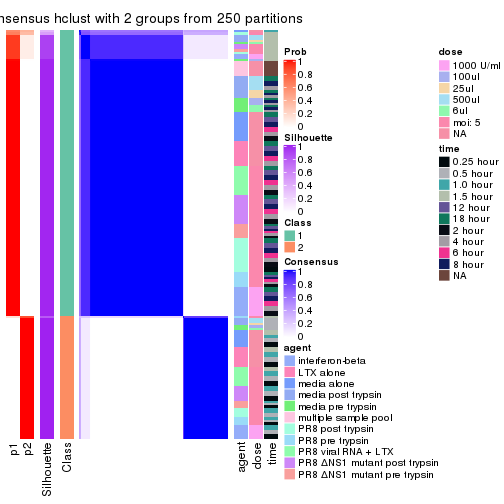
consensus_heatmap(res, k = 3)
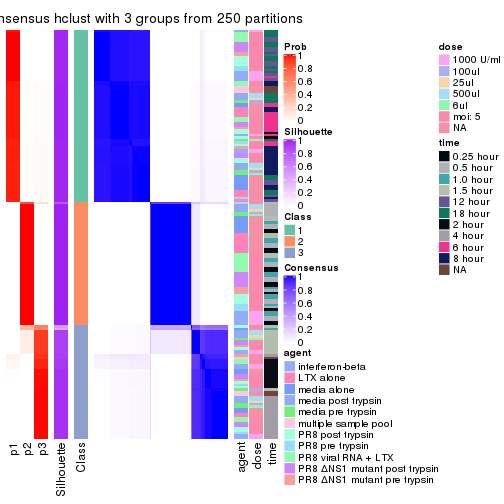
consensus_heatmap(res, k = 4)
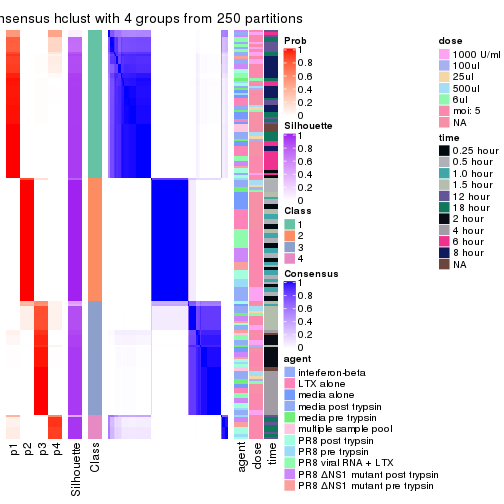
consensus_heatmap(res, k = 5)
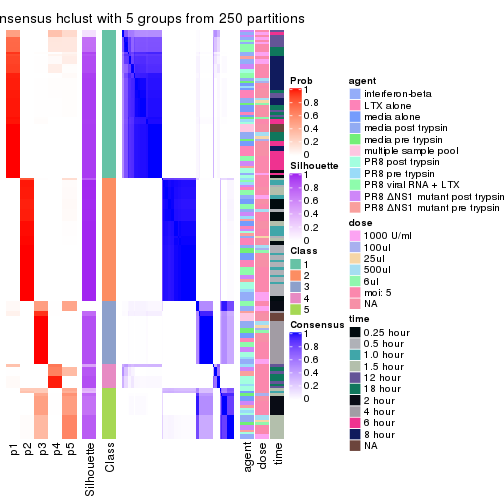
consensus_heatmap(res, k = 6)
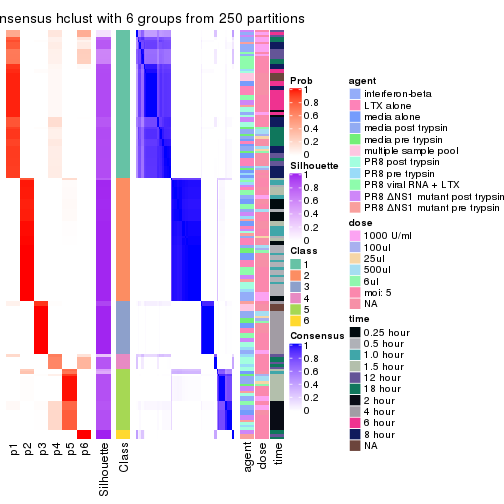
Heatmaps for the membership of samples in all partitions to see how consistent they are:
membership_heatmap(res, k = 2)
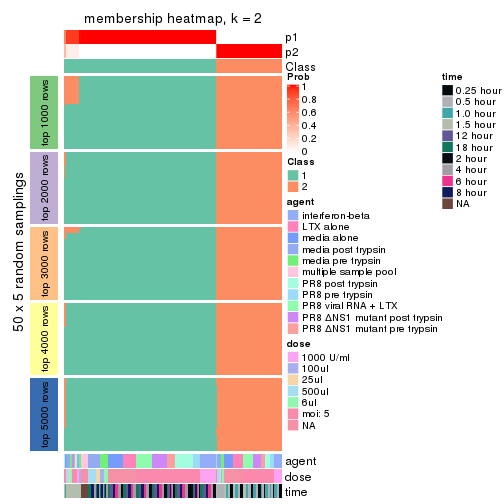
membership_heatmap(res, k = 3)
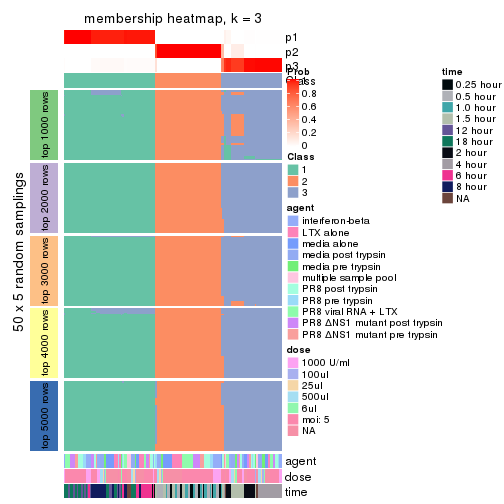
membership_heatmap(res, k = 4)
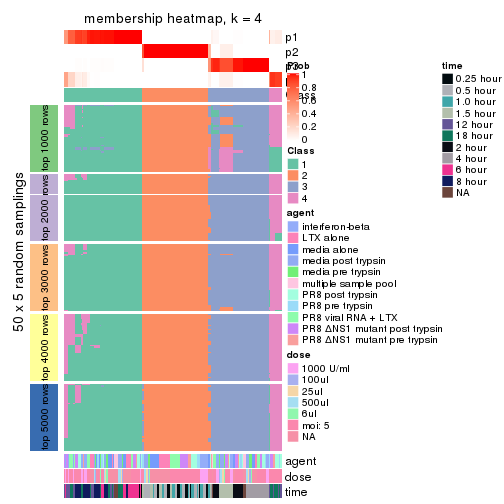
membership_heatmap(res, k = 5)
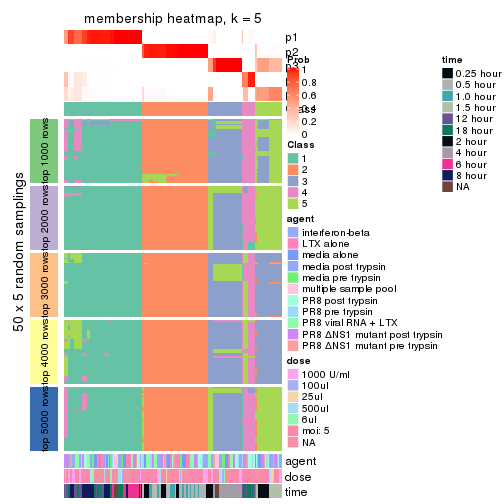
membership_heatmap(res, k = 6)
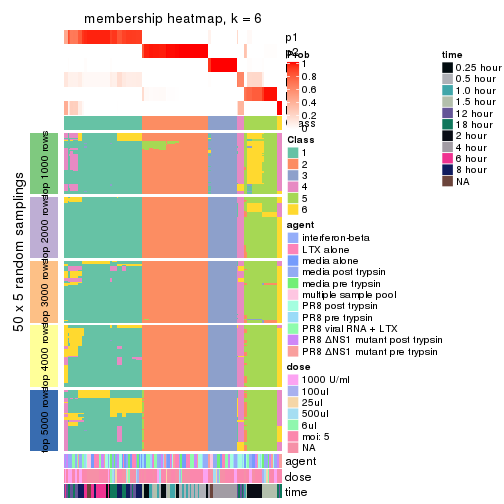
As soon as we have had the classes for columns, we can look for signatures which are significantly different between classes which can be candidate marks for certain classes. Following are the heatmaps for signatures.
Signature heatmaps where rows are scaled:
get_signatures(res, k = 2)
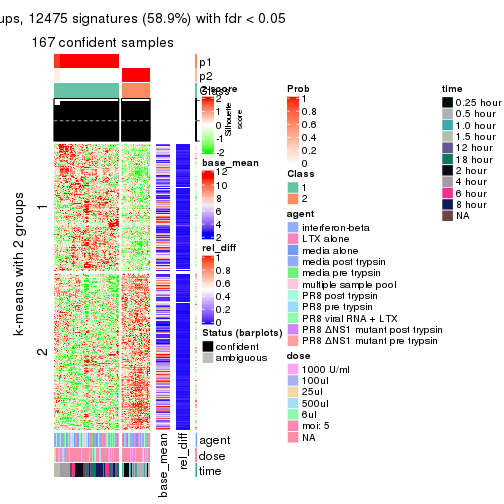
get_signatures(res, k = 3)
#> Error in mat[ceiling(1:nr/h_ratio), ceiling(1:nc/w_ratio), drop = FALSE]: subscript out of bounds
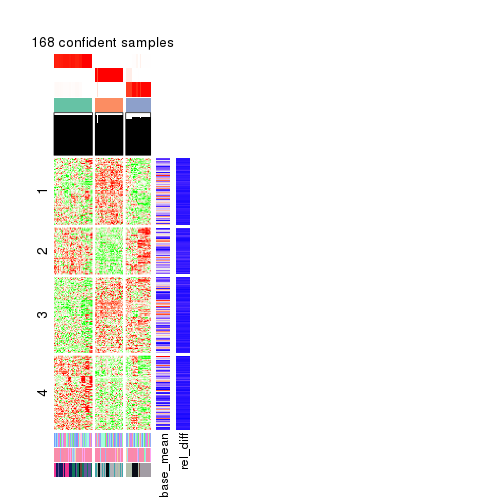
get_signatures(res, k = 4)
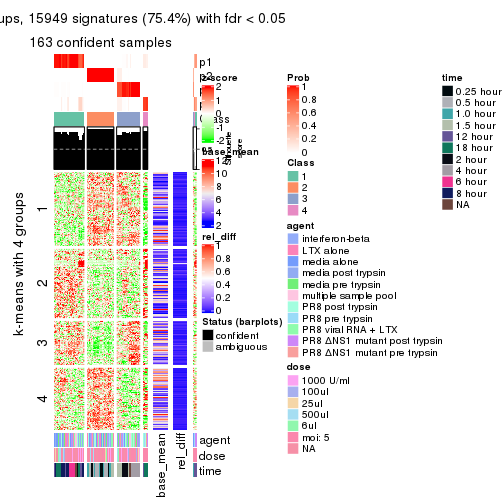
get_signatures(res, k = 5)
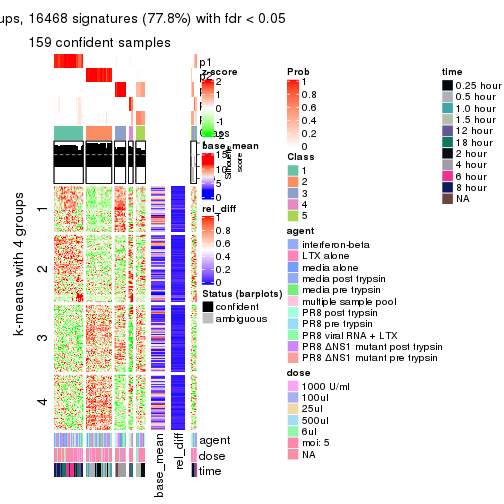
get_signatures(res, k = 6)
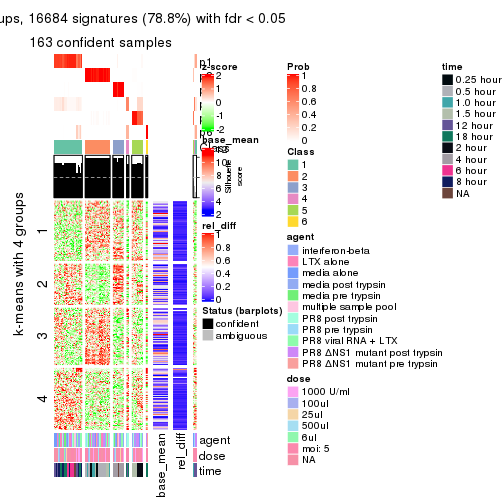
Signature heatmaps where rows are not scaled:
get_signatures(res, k = 2, scale_rows = FALSE)
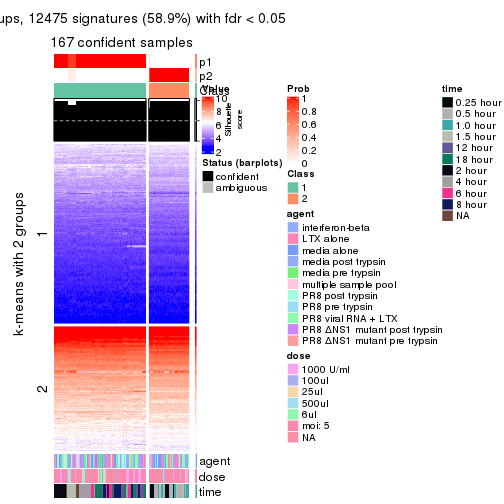
get_signatures(res, k = 3, scale_rows = FALSE)
#> Error in mat[ceiling(1:nr/h_ratio), ceiling(1:nc/w_ratio), drop = FALSE]: subscript out of bounds
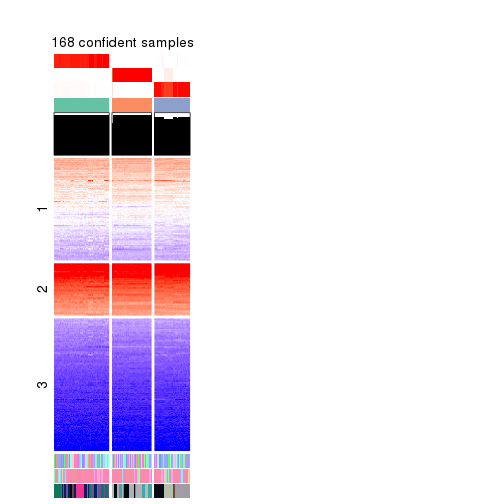
get_signatures(res, k = 4, scale_rows = FALSE)
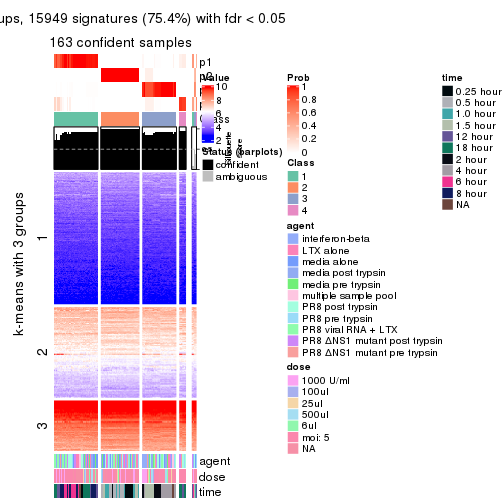
get_signatures(res, k = 5, scale_rows = FALSE)
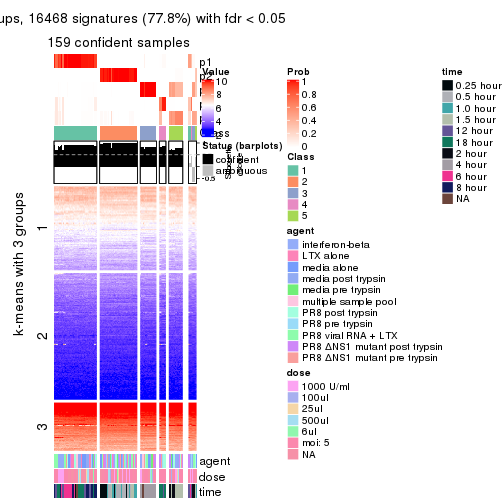
get_signatures(res, k = 6, scale_rows = FALSE)
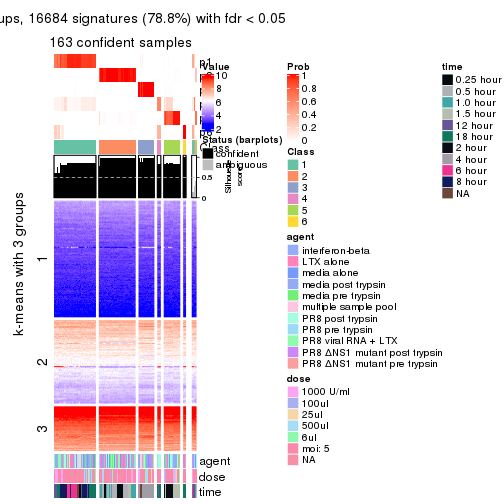
Compare the overlap of signatures from different k:
compare_signatures(res)
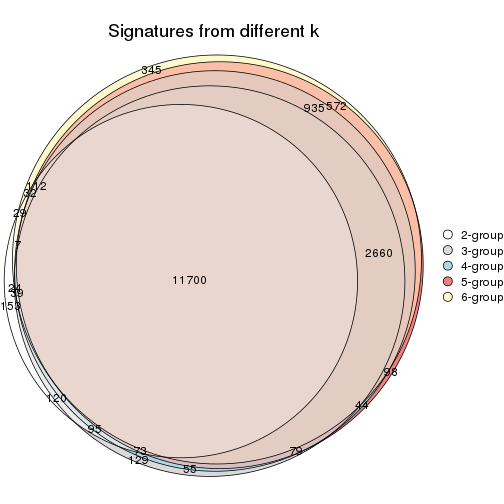
get_signature() returns a data frame invisibly. TO get the list of signatures, the function
call should be assigned to a variable explicitly. In following code, if plot argument is set
to FALSE, no heatmap is plotted while only the differential analysis is performed.
# code only for demonstration
tb = get_signature(res, k = ..., plot = FALSE)
An example of the output of tb is:
#> which_row fdr mean_1 mean_2 scaled_mean_1 scaled_mean_2 km
#> 1 38 0.042760348 8.373488 9.131774 -0.5533452 0.5164555 1
#> 2 40 0.018707592 7.106213 8.469186 -0.6173731 0.5762149 1
#> 3 55 0.019134737 10.221463 11.207825 -0.6159697 0.5749050 1
#> 4 59 0.006059896 5.921854 7.869574 -0.6899429 0.6439467 1
#> 5 60 0.018055526 8.928898 10.211722 -0.6204761 0.5791110 1
#> 6 98 0.009384629 15.714769 14.887706 0.6635654 -0.6193277 2
...
The columns in tb are:
which_row: row indices corresponding to the input matrix.fdr: FDR for the differential test. mean_x: The mean value in group x.scaled_mean_x: The mean value in group x after rows are scaled.km: Row groups if k-means clustering is applied to rows.UMAP plot which shows how samples are separated.
dimension_reduction(res, k = 2, method = "UMAP")
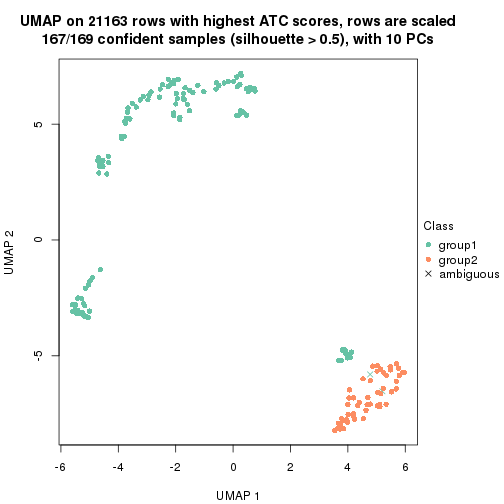
dimension_reduction(res, k = 3, method = "UMAP")
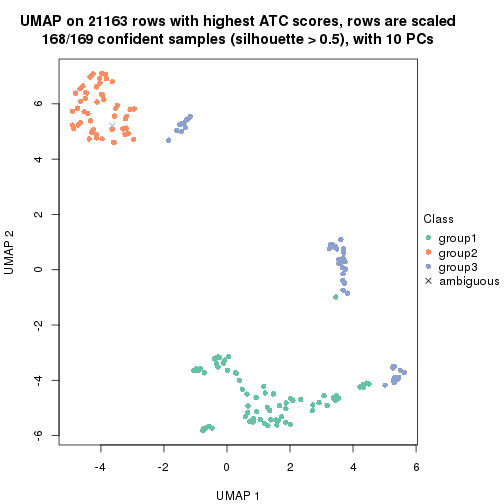
dimension_reduction(res, k = 4, method = "UMAP")
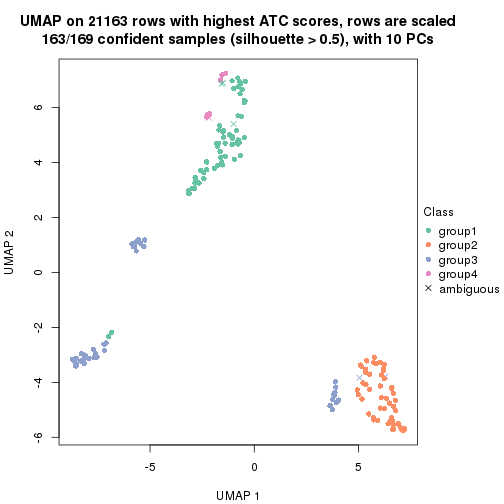
dimension_reduction(res, k = 5, method = "UMAP")
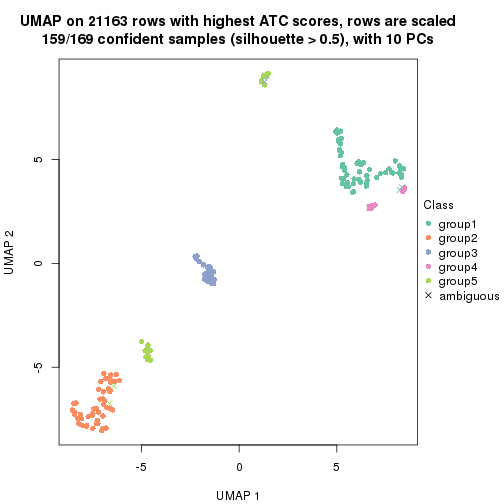
dimension_reduction(res, k = 6, method = "UMAP")
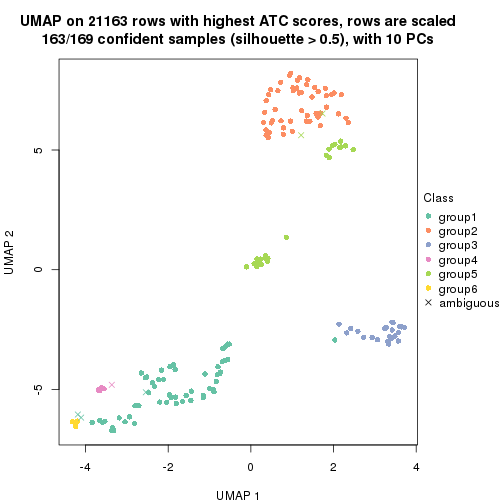
Following heatmap shows how subgroups are split when increasing k:
collect_classes(res)
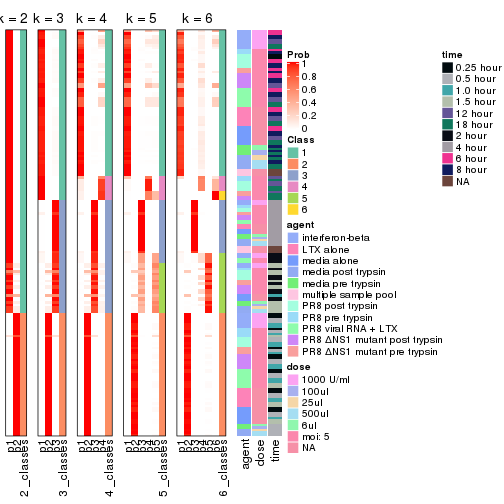
Test correlation between subgroups and known annotations. If the known annotation is numeric, one-way ANOVA test is applied, and if the known annotation is discrete, chi-squared contingency table test is applied.
test_to_known_factors(res)
#> n agent(p) dose(p) time(p) k
#> ATC:hclust 167 0.6267 0.942 7.59e-25 2
#> ATC:hclust 168 0.9275 0.991 4.45e-49 3
#> ATC:hclust 163 0.2796 0.608 5.96e-48 4
#> ATC:hclust 159 0.2858 0.786 1.56e-67 5
#> ATC:hclust 163 0.0307 0.933 3.98e-66 6
If matrix rows can be associated to genes, consider to use functional_enrichment(res,
...) to perform function enrichment for the signature genes. See this vignette for more detailed explanations.
The object with results only for a single top-value method and a single partition method can be extracted as:
res = res_list["ATC", "kmeans"]
# you can also extract it by
# res = res_list["ATC:kmeans"]
A summary of res and all the functions that can be applied to it:
res
#> A 'ConsensusPartition' object with k = 2, 3, 4, 5, 6.
#> On a matrix with 21163 rows and 169 columns.
#> Top rows (1000, 2000, 3000, 4000, 5000) are extracted by 'ATC' method.
#> Subgroups are detected by 'kmeans' method.
#> Performed in total 1250 partitions by row resampling.
#> Best k for subgroups seems to be 2.
#>
#> Following methods can be applied to this 'ConsensusPartition' object:
#> [1] "cola_report" "collect_classes" "collect_plots"
#> [4] "collect_stats" "colnames" "compare_signatures"
#> [7] "consensus_heatmap" "dimension_reduction" "functional_enrichment"
#> [10] "get_anno_col" "get_anno" "get_classes"
#> [13] "get_consensus" "get_matrix" "get_membership"
#> [16] "get_param" "get_signatures" "get_stats"
#> [19] "is_best_k" "is_stable_k" "membership_heatmap"
#> [22] "ncol" "nrow" "plot_ecdf"
#> [25] "rownames" "select_partition_number" "show"
#> [28] "suggest_best_k" "test_to_known_factors"
collect_plots() function collects all the plots made from res for all k (number of partitions)
into one single page to provide an easy and fast comparison between different k.
collect_plots(res)
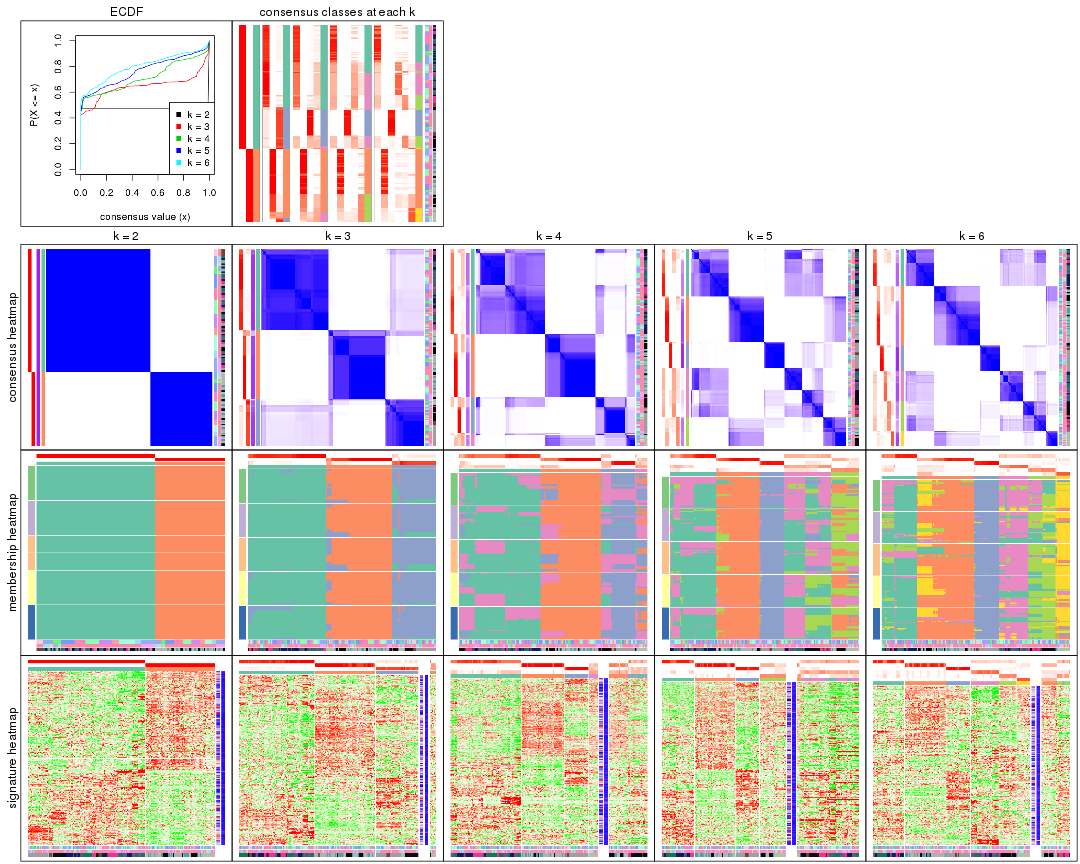
The plots are:
k and the heatmap of
predicted classes for each k.k.k.k.All the plots in panels can be made by individual functions and they are plotted later in this section.
select_partition_number() produces several plots showing different
statistics for choosing “optimized” k. There are following statistics:
k;k, the area increased is defined as \(A_k - A_{k-1}\).The detailed explanations of these statistics can be found in the cola vignette.
Generally speaking, lower PAC score, higher mean silhouette score or higher
concordance corresponds to better partition. Rand index and Jaccard index
measure how similar the current partition is compared to partition with k-1.
If they are too similar, we won't accept k is better than k-1.
select_partition_number(res)
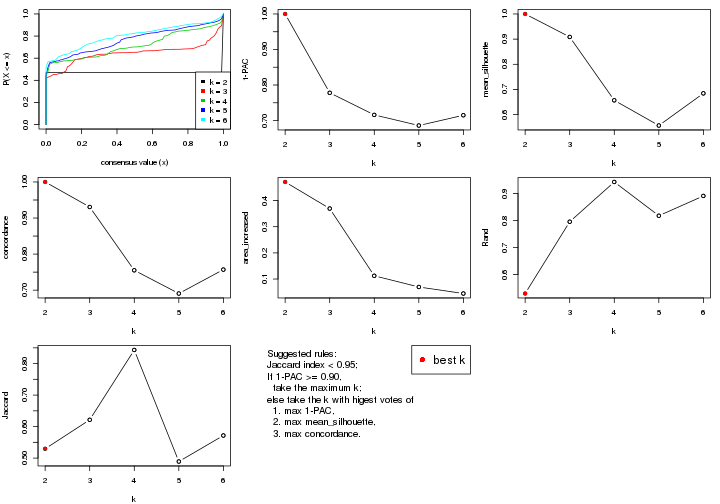
The numeric values for all these statistics can be obtained by get_stats().
get_stats(res)
#> k 1-PAC mean_silhouette concordance area_increased Rand Jaccard
#> 2 2 1.000 1.000 1.000 0.4709 0.530 0.530
#> 3 3 0.778 0.909 0.931 0.3694 0.796 0.622
#> 4 4 0.716 0.657 0.755 0.1124 0.943 0.843
#> 5 5 0.686 0.557 0.691 0.0697 0.818 0.489
#> 6 6 0.715 0.684 0.757 0.0447 0.891 0.572
suggest_best_k() suggests the best \(k\) based on these statistics. The rules are as follows:
suggest_best_k(res)
#> [1] 2
Following shows the table of the partitions (You need to click the show/hide
code output link to see it). The membership matrix (columns with name p*)
is inferred by
clue::cl_consensus()
function with the SE method. Basically the value in the membership matrix
represents the probability to belong to a certain group. The finall class
label for an item is determined with the group with highest probability it
belongs to.
In get_classes() function, the entropy is calculated from the membership
matrix and the silhouette score is calculated from the consensus matrix.
cbind(get_classes(res, k = 2), get_membership(res, k = 2))
#> class entropy silhouette p1 p2
#> GSM528681 2 0 1 0 1
#> GSM528682 2 0 1 0 1
#> GSM528683 2 0 1 0 1
#> GSM528684 2 0 1 0 1
#> GSM528687 2 0 1 0 1
#> GSM528688 2 0 1 0 1
#> GSM528685 2 0 1 0 1
#> GSM528686 2 0 1 0 1
#> GSM528693 1 0 1 1 0
#> GSM528694 1 0 1 1 0
#> GSM528695 1 0 1 1 0
#> GSM528696 1 0 1 1 0
#> GSM528697 1 0 1 1 0
#> GSM528698 1 0 1 1 0
#> GSM528699 1 0 1 1 0
#> GSM528700 1 0 1 1 0
#> GSM528689 1 0 1 1 0
#> GSM528690 1 0 1 1 0
#> GSM528691 1 0 1 1 0
#> GSM528692 1 0 1 1 0
#> GSM528779 2 0 1 0 1
#> GSM528780 2 0 1 0 1
#> GSM528782 2 0 1 0 1
#> GSM528781 2 0 1 0 1
#> GSM528785 1 0 1 1 0
#> GSM528786 1 0 1 1 0
#> GSM528787 1 0 1 1 0
#> GSM528788 1 0 1 1 0
#> GSM528783 1 0 1 1 0
#> GSM528784 1 0 1 1 0
#> GSM528759 1 0 1 1 0
#> GSM528760 1 0 1 1 0
#> GSM528761 2 0 1 0 1
#> GSM528762 2 0 1 0 1
#> GSM528765 2 0 1 0 1
#> GSM528766 2 0 1 0 1
#> GSM528763 2 0 1 0 1
#> GSM528764 2 0 1 0 1
#> GSM528771 1 0 1 1 0
#> GSM528772 1 0 1 1 0
#> GSM528773 1 0 1 1 0
#> GSM528774 1 0 1 1 0
#> GSM528775 1 0 1 1 0
#> GSM528776 1 0 1 1 0
#> GSM528777 1 0 1 1 0
#> GSM528778 1 0 1 1 0
#> GSM528767 1 0 1 1 0
#> GSM528768 1 0 1 1 0
#> GSM528769 1 0 1 1 0
#> GSM528770 1 0 1 1 0
#> GSM528671 2 0 1 0 1
#> GSM528672 2 0 1 0 1
#> GSM528674 2 0 1 0 1
#> GSM528673 2 0 1 0 1
#> GSM528677 1 0 1 1 0
#> GSM528678 1 0 1 1 0
#> GSM528679 1 0 1 1 0
#> GSM528680 1 0 1 1 0
#> GSM528675 1 0 1 1 0
#> GSM528676 1 0 1 1 0
#> GSM528651 2 0 1 0 1
#> GSM528652 2 0 1 0 1
#> GSM528653 2 0 1 0 1
#> GSM528654 2 0 1 0 1
#> GSM528657 2 0 1 0 1
#> GSM528658 2 0 1 0 1
#> GSM528655 2 0 1 0 1
#> GSM528656 2 0 1 0 1
#> GSM528663 1 0 1 1 0
#> GSM528664 1 0 1 1 0
#> GSM528665 1 0 1 1 0
#> GSM528666 1 0 1 1 0
#> GSM528667 1 0 1 1 0
#> GSM528668 1 0 1 1 0
#> GSM528669 1 0 1 1 0
#> GSM528670 1 0 1 1 0
#> GSM528659 1 0 1 1 0
#> GSM528660 1 0 1 1 0
#> GSM528661 1 0 1 1 0
#> GSM528662 1 0 1 1 0
#> GSM528701 2 0 1 0 1
#> GSM528702 2 0 1 0 1
#> GSM528703 2 0 1 0 1
#> GSM528704 2 0 1 0 1
#> GSM528707 2 0 1 0 1
#> GSM528708 2 0 1 0 1
#> GSM528705 2 0 1 0 1
#> GSM528706 2 0 1 0 1
#> GSM528713 1 0 1 1 0
#> GSM528714 1 0 1 1 0
#> GSM528715 1 0 1 1 0
#> GSM528716 1 0 1 1 0
#> GSM528717 1 0 1 1 0
#> GSM528718 1 0 1 1 0
#> GSM528719 1 0 1 1 0
#> GSM528720 1 0 1 1 0
#> GSM528709 1 0 1 1 0
#> GSM528710 1 0 1 1 0
#> GSM528711 1 0 1 1 0
#> GSM528712 1 0 1 1 0
#> GSM528721 2 0 1 0 1
#> GSM528722 2 0 1 0 1
#> GSM528723 2 0 1 0 1
#> GSM528724 2 0 1 0 1
#> GSM528727 2 0 1 0 1
#> GSM528728 2 0 1 0 1
#> GSM528725 2 0 1 0 1
#> GSM528726 2 0 1 0 1
#> GSM528733 1 0 1 1 0
#> GSM528734 1 0 1 1 0
#> GSM528735 1 0 1 1 0
#> GSM528736 1 0 1 1 0
#> GSM528737 1 0 1 1 0
#> GSM528738 1 0 1 1 0
#> GSM528729 1 0 1 1 0
#> GSM528730 1 0 1 1 0
#> GSM528731 1 0 1 1 0
#> GSM528732 1 0 1 1 0
#> GSM528739 2 0 1 0 1
#> GSM528740 2 0 1 0 1
#> GSM528741 2 0 1 0 1
#> GSM528742 2 0 1 0 1
#> GSM528745 2 0 1 0 1
#> GSM528746 2 0 1 0 1
#> GSM528743 2 0 1 0 1
#> GSM528744 2 0 1 0 1
#> GSM528751 1 0 1 1 0
#> GSM528752 1 0 1 1 0
#> GSM528753 1 0 1 1 0
#> GSM528754 1 0 1 1 0
#> GSM528755 1 0 1 1 0
#> GSM528756 1 0 1 1 0
#> GSM528757 1 0 1 1 0
#> GSM528758 1 0 1 1 0
#> GSM528747 1 0 1 1 0
#> GSM528748 1 0 1 1 0
#> GSM528749 1 0 1 1 0
#> GSM528750 1 0 1 1 0
#> GSM528640 2 0 1 0 1
#> GSM528641 2 0 1 0 1
#> GSM528643 1 0 1 1 0
#> GSM528644 1 0 1 1 0
#> GSM528642 1 0 1 1 0
#> GSM528620 2 0 1 0 1
#> GSM528621 1 0 1 1 0
#> GSM528623 1 0 1 1 0
#> GSM528624 1 0 1 1 0
#> GSM528622 1 0 1 1 0
#> GSM528625 2 0 1 0 1
#> GSM528626 2 0 1 0 1
#> GSM528628 1 0 1 1 0
#> GSM528629 1 0 1 1 0
#> GSM528627 1 0 1 1 0
#> GSM528630 2 0 1 0 1
#> GSM528631 2 0 1 0 1
#> GSM528632 2 0 1 0 1
#> GSM528633 2 0 1 0 1
#> GSM528636 1 0 1 1 0
#> GSM528637 1 0 1 1 0
#> GSM528638 1 0 1 1 0
#> GSM528639 1 0 1 1 0
#> GSM528634 1 0 1 1 0
#> GSM528635 1 0 1 1 0
#> GSM528645 1 0 1 1 0
#> GSM528646 1 0 1 1 0
#> GSM528647 1 0 1 1 0
#> GSM528648 1 0 1 1 0
#> GSM528649 1 0 1 1 0
#> GSM528650 1 0 1 1 0
cbind(get_classes(res, k = 3), get_membership(res, k = 3))
#> class entropy silhouette p1 p2 p3
#> GSM528681 2 0.0000 0.943 0.000 1.000 0.000
#> GSM528682 2 0.0000 0.943 0.000 1.000 0.000
#> GSM528683 2 0.0000 0.943 0.000 1.000 0.000
#> GSM528684 2 0.0000 0.943 0.000 1.000 0.000
#> GSM528687 2 0.2261 0.922 0.000 0.932 0.068
#> GSM528688 2 0.0424 0.941 0.000 0.992 0.008
#> GSM528685 2 0.2959 0.909 0.000 0.900 0.100
#> GSM528686 3 0.5968 0.182 0.000 0.364 0.636
#> GSM528693 3 0.2959 0.927 0.100 0.000 0.900
#> GSM528694 3 0.4654 0.852 0.208 0.000 0.792
#> GSM528695 3 0.3340 0.937 0.120 0.000 0.880
#> GSM528696 3 0.3340 0.937 0.120 0.000 0.880
#> GSM528697 1 0.0000 0.958 1.000 0.000 0.000
#> GSM528698 1 0.0000 0.958 1.000 0.000 0.000
#> GSM528699 1 0.1289 0.948 0.968 0.000 0.032
#> GSM528700 1 0.0237 0.957 0.996 0.000 0.004
#> GSM528689 1 0.0000 0.958 1.000 0.000 0.000
#> GSM528690 1 0.0237 0.957 0.996 0.000 0.004
#> GSM528691 1 0.0000 0.958 1.000 0.000 0.000
#> GSM528692 1 0.0000 0.958 1.000 0.000 0.000
#> GSM528779 2 0.2878 0.911 0.000 0.904 0.096
#> GSM528780 2 0.0000 0.943 0.000 1.000 0.000
#> GSM528782 2 0.0000 0.943 0.000 1.000 0.000
#> GSM528781 2 0.2878 0.911 0.000 0.904 0.096
#> GSM528785 1 0.4062 0.847 0.836 0.000 0.164
#> GSM528786 3 0.2165 0.909 0.064 0.000 0.936
#> GSM528787 3 0.5397 0.755 0.280 0.000 0.720
#> GSM528788 1 0.2448 0.944 0.924 0.000 0.076
#> GSM528783 1 0.0000 0.958 1.000 0.000 0.000
#> GSM528784 1 0.0000 0.958 1.000 0.000 0.000
#> GSM528759 1 0.5926 0.400 0.644 0.000 0.356
#> GSM528760 3 0.5291 0.773 0.268 0.000 0.732
#> GSM528761 2 0.0000 0.943 0.000 1.000 0.000
#> GSM528762 2 0.0000 0.943 0.000 1.000 0.000
#> GSM528765 2 0.0000 0.943 0.000 1.000 0.000
#> GSM528766 2 0.0000 0.943 0.000 1.000 0.000
#> GSM528763 2 0.3267 0.898 0.000 0.884 0.116
#> GSM528764 2 0.6280 0.381 0.000 0.540 0.460
#> GSM528771 3 0.2959 0.927 0.100 0.000 0.900
#> GSM528772 3 0.2959 0.927 0.100 0.000 0.900
#> GSM528773 3 0.3340 0.937 0.120 0.000 0.880
#> GSM528774 3 0.3340 0.937 0.120 0.000 0.880
#> GSM528775 1 0.4002 0.820 0.840 0.000 0.160
#> GSM528776 1 0.1289 0.958 0.968 0.000 0.032
#> GSM528777 1 0.1031 0.949 0.976 0.000 0.024
#> GSM528778 1 0.0747 0.953 0.984 0.000 0.016
#> GSM528767 1 0.0000 0.958 1.000 0.000 0.000
#> GSM528768 1 0.0000 0.958 1.000 0.000 0.000
#> GSM528769 1 0.0000 0.958 1.000 0.000 0.000
#> GSM528770 1 0.0000 0.958 1.000 0.000 0.000
#> GSM528671 2 0.2878 0.911 0.000 0.904 0.096
#> GSM528672 2 0.0000 0.943 0.000 1.000 0.000
#> GSM528674 2 0.0000 0.943 0.000 1.000 0.000
#> GSM528673 2 0.6280 0.381 0.000 0.540 0.460
#> GSM528677 3 0.2959 0.927 0.100 0.000 0.900
#> GSM528678 3 0.3340 0.937 0.120 0.000 0.880
#> GSM528679 1 0.1163 0.959 0.972 0.000 0.028
#> GSM528680 1 0.0237 0.957 0.996 0.000 0.004
#> GSM528675 1 0.0000 0.958 1.000 0.000 0.000
#> GSM528676 1 0.0000 0.958 1.000 0.000 0.000
#> GSM528651 2 0.2878 0.911 0.000 0.904 0.096
#> GSM528652 2 0.2878 0.911 0.000 0.904 0.096
#> GSM528653 2 0.0000 0.943 0.000 1.000 0.000
#> GSM528654 2 0.0000 0.943 0.000 1.000 0.000
#> GSM528657 2 0.0000 0.943 0.000 1.000 0.000
#> GSM528658 2 0.0000 0.943 0.000 1.000 0.000
#> GSM528655 2 0.6280 0.381 0.000 0.540 0.460
#> GSM528656 2 0.5835 0.620 0.000 0.660 0.340
#> GSM528663 3 0.2261 0.910 0.068 0.000 0.932
#> GSM528664 3 0.2261 0.910 0.068 0.000 0.932
#> GSM528665 3 0.3340 0.937 0.120 0.000 0.880
#> GSM528666 3 0.3340 0.937 0.120 0.000 0.880
#> GSM528667 1 0.1289 0.958 0.968 0.000 0.032
#> GSM528668 1 0.1289 0.958 0.968 0.000 0.032
#> GSM528669 1 0.1289 0.948 0.968 0.000 0.032
#> GSM528670 1 0.1964 0.953 0.944 0.000 0.056
#> GSM528659 1 0.0000 0.958 1.000 0.000 0.000
#> GSM528660 1 0.0000 0.958 1.000 0.000 0.000
#> GSM528661 1 0.0000 0.958 1.000 0.000 0.000
#> GSM528662 1 0.0000 0.958 1.000 0.000 0.000
#> GSM528701 2 0.2878 0.911 0.000 0.904 0.096
#> GSM528702 2 0.2878 0.911 0.000 0.904 0.096
#> GSM528703 2 0.0000 0.943 0.000 1.000 0.000
#> GSM528704 2 0.0000 0.943 0.000 1.000 0.000
#> GSM528707 2 0.0000 0.943 0.000 1.000 0.000
#> GSM528708 2 0.0000 0.943 0.000 1.000 0.000
#> GSM528705 2 0.0000 0.943 0.000 1.000 0.000
#> GSM528706 2 0.1753 0.928 0.000 0.952 0.048
#> GSM528713 3 0.4555 0.842 0.200 0.000 0.800
#> GSM528714 3 0.2959 0.927 0.100 0.000 0.900
#> GSM528715 3 0.3340 0.937 0.120 0.000 0.880
#> GSM528716 3 0.3340 0.937 0.120 0.000 0.880
#> GSM528717 1 0.1289 0.958 0.968 0.000 0.032
#> GSM528718 1 0.1289 0.958 0.968 0.000 0.032
#> GSM528719 1 0.0000 0.958 1.000 0.000 0.000
#> GSM528720 1 0.0000 0.958 1.000 0.000 0.000
#> GSM528709 1 0.0000 0.958 1.000 0.000 0.000
#> GSM528710 1 0.0000 0.958 1.000 0.000 0.000
#> GSM528711 1 0.0000 0.958 1.000 0.000 0.000
#> GSM528712 1 0.0000 0.958 1.000 0.000 0.000
#> GSM528721 2 0.0000 0.943 0.000 1.000 0.000
#> GSM528722 2 0.0000 0.943 0.000 1.000 0.000
#> GSM528723 2 0.0000 0.943 0.000 1.000 0.000
#> GSM528724 2 0.0000 0.943 0.000 1.000 0.000
#> GSM528727 2 0.0000 0.943 0.000 1.000 0.000
#> GSM528728 2 0.0000 0.943 0.000 1.000 0.000
#> GSM528725 2 0.2878 0.911 0.000 0.904 0.096
#> GSM528726 2 0.0000 0.943 0.000 1.000 0.000
#> GSM528733 3 0.3340 0.937 0.120 0.000 0.880
#> GSM528734 3 0.3340 0.937 0.120 0.000 0.880
#> GSM528735 1 0.2165 0.938 0.936 0.000 0.064
#> GSM528736 1 0.3752 0.843 0.856 0.000 0.144
#> GSM528737 1 0.1289 0.958 0.968 0.000 0.032
#> GSM528738 1 0.1289 0.958 0.968 0.000 0.032
#> GSM528729 1 0.1964 0.953 0.944 0.000 0.056
#> GSM528730 1 0.2165 0.950 0.936 0.000 0.064
#> GSM528731 1 0.1964 0.953 0.944 0.000 0.056
#> GSM528732 1 0.2448 0.944 0.924 0.000 0.076
#> GSM528739 2 0.2878 0.911 0.000 0.904 0.096
#> GSM528740 2 0.2878 0.911 0.000 0.904 0.096
#> GSM528741 2 0.0000 0.943 0.000 1.000 0.000
#> GSM528742 2 0.0000 0.943 0.000 1.000 0.000
#> GSM528745 2 0.2878 0.911 0.000 0.904 0.096
#> GSM528746 2 0.0000 0.943 0.000 1.000 0.000
#> GSM528743 2 0.0424 0.941 0.000 0.992 0.008
#> GSM528744 2 0.0000 0.943 0.000 1.000 0.000
#> GSM528751 3 0.4605 0.838 0.204 0.000 0.796
#> GSM528752 3 0.4605 0.838 0.204 0.000 0.796
#> GSM528753 3 0.3340 0.937 0.120 0.000 0.880
#> GSM528754 3 0.3340 0.937 0.120 0.000 0.880
#> GSM528755 1 0.1289 0.958 0.968 0.000 0.032
#> GSM528756 1 0.2165 0.938 0.936 0.000 0.064
#> GSM528757 1 0.2448 0.944 0.924 0.000 0.076
#> GSM528758 1 0.2448 0.944 0.924 0.000 0.076
#> GSM528747 1 0.1753 0.956 0.952 0.000 0.048
#> GSM528748 1 0.2448 0.944 0.924 0.000 0.076
#> GSM528749 1 0.1753 0.956 0.952 0.000 0.048
#> GSM528750 1 0.1753 0.956 0.952 0.000 0.048
#> GSM528640 2 0.0000 0.943 0.000 1.000 0.000
#> GSM528641 2 0.6299 0.339 0.000 0.524 0.476
#> GSM528643 3 0.3340 0.937 0.120 0.000 0.880
#> GSM528644 1 0.2448 0.944 0.924 0.000 0.076
#> GSM528642 1 0.1643 0.954 0.956 0.000 0.044
#> GSM528620 2 0.0000 0.943 0.000 1.000 0.000
#> GSM528621 3 0.0237 0.844 0.000 0.004 0.996
#> GSM528623 3 0.3340 0.937 0.120 0.000 0.880
#> GSM528624 1 0.2448 0.944 0.924 0.000 0.076
#> GSM528622 1 0.1289 0.958 0.968 0.000 0.032
#> GSM528625 2 0.0000 0.943 0.000 1.000 0.000
#> GSM528626 3 0.3267 0.722 0.000 0.116 0.884
#> GSM528628 3 0.3340 0.937 0.120 0.000 0.880
#> GSM528629 1 0.2448 0.944 0.924 0.000 0.076
#> GSM528627 1 0.1289 0.958 0.968 0.000 0.032
#> GSM528630 2 0.0000 0.943 0.000 1.000 0.000
#> GSM528631 2 0.2878 0.911 0.000 0.904 0.096
#> GSM528632 3 0.1529 0.808 0.000 0.040 0.960
#> GSM528633 3 0.1529 0.808 0.000 0.040 0.960
#> GSM528636 3 0.3340 0.937 0.120 0.000 0.880
#> GSM528637 3 0.3340 0.937 0.120 0.000 0.880
#> GSM528638 1 0.2448 0.944 0.924 0.000 0.076
#> GSM528639 1 0.2448 0.944 0.924 0.000 0.076
#> GSM528634 1 0.1289 0.958 0.968 0.000 0.032
#> GSM528635 1 0.1289 0.958 0.968 0.000 0.032
#> GSM528645 3 0.3340 0.937 0.120 0.000 0.880
#> GSM528646 3 0.3340 0.937 0.120 0.000 0.880
#> GSM528647 3 0.3340 0.937 0.120 0.000 0.880
#> GSM528648 1 0.1289 0.958 0.968 0.000 0.032
#> GSM528649 1 0.4062 0.814 0.836 0.000 0.164
#> GSM528650 1 0.1289 0.958 0.968 0.000 0.032
cbind(get_classes(res, k = 4), get_membership(res, k = 4))
#> class entropy silhouette p1 p2 p3 p4
#> GSM528681 2 0.0000 0.8349 0.000 1.000 0.000 0.000
#> GSM528682 2 0.0000 0.8349 0.000 1.000 0.000 0.000
#> GSM528683 2 0.0000 0.8349 0.000 1.000 0.000 0.000
#> GSM528684 2 0.0000 0.8349 0.000 1.000 0.000 0.000
#> GSM528687 2 0.4624 0.4688 0.000 0.660 0.000 0.340
#> GSM528688 2 0.1940 0.7891 0.000 0.924 0.000 0.076
#> GSM528685 2 0.4916 0.2129 0.000 0.576 0.000 0.424
#> GSM528686 4 0.7662 0.6679 0.000 0.344 0.220 0.436
#> GSM528693 3 0.7914 0.3642 0.312 0.000 0.356 0.332
#> GSM528694 3 0.7896 0.3281 0.336 0.000 0.368 0.296
#> GSM528695 3 0.0000 0.7342 0.000 0.000 1.000 0.000
#> GSM528696 3 0.0000 0.7342 0.000 0.000 1.000 0.000
#> GSM528697 1 0.4933 0.7124 0.688 0.000 0.016 0.296
#> GSM528698 1 0.4957 0.7122 0.684 0.000 0.016 0.300
#> GSM528699 1 0.4608 0.7170 0.692 0.000 0.004 0.304
#> GSM528700 1 0.4605 0.7076 0.664 0.000 0.000 0.336
#> GSM528689 1 0.4933 0.7124 0.688 0.000 0.016 0.296
#> GSM528690 1 0.4535 0.7123 0.704 0.000 0.004 0.292
#> GSM528691 1 0.4957 0.7118 0.684 0.000 0.016 0.300
#> GSM528692 1 0.4957 0.7118 0.684 0.000 0.016 0.300
#> GSM528779 2 0.4624 0.4688 0.000 0.660 0.000 0.340
#> GSM528780 2 0.0000 0.8349 0.000 1.000 0.000 0.000
#> GSM528782 2 0.0000 0.8349 0.000 1.000 0.000 0.000
#> GSM528781 2 0.4624 0.4688 0.000 0.660 0.000 0.340
#> GSM528785 1 0.5746 0.4271 0.612 0.000 0.040 0.348
#> GSM528786 3 0.0336 0.7254 0.008 0.000 0.992 0.000
#> GSM528787 3 0.7629 0.2983 0.392 0.000 0.404 0.204
#> GSM528788 1 0.2546 0.7385 0.900 0.000 0.008 0.092
#> GSM528783 1 0.4883 0.7151 0.696 0.000 0.016 0.288
#> GSM528784 1 0.4883 0.7151 0.696 0.000 0.016 0.288
#> GSM528759 1 0.7638 -0.0859 0.460 0.000 0.308 0.232
#> GSM528760 1 0.7603 -0.2200 0.436 0.000 0.360 0.204
#> GSM528761 2 0.0000 0.8349 0.000 1.000 0.000 0.000
#> GSM528762 2 0.0000 0.8349 0.000 1.000 0.000 0.000
#> GSM528765 2 0.0000 0.8349 0.000 1.000 0.000 0.000
#> GSM528766 2 0.0000 0.8349 0.000 1.000 0.000 0.000
#> GSM528763 2 0.4941 0.1646 0.000 0.564 0.000 0.436
#> GSM528764 4 0.7648 0.6635 0.000 0.348 0.216 0.436
#> GSM528771 3 0.7914 0.3642 0.312 0.000 0.356 0.332
#> GSM528772 3 0.7914 0.3642 0.312 0.000 0.356 0.332
#> GSM528773 3 0.0000 0.7342 0.000 0.000 1.000 0.000
#> GSM528774 3 0.0000 0.7342 0.000 0.000 1.000 0.000
#> GSM528775 1 0.6279 0.4408 0.664 0.000 0.156 0.180
#> GSM528776 1 0.1297 0.7563 0.964 0.000 0.020 0.016
#> GSM528777 1 0.2149 0.7523 0.912 0.000 0.000 0.088
#> GSM528778 1 0.2149 0.7523 0.912 0.000 0.000 0.088
#> GSM528767 1 0.4883 0.7151 0.696 0.000 0.016 0.288
#> GSM528768 1 0.4883 0.7151 0.696 0.000 0.016 0.288
#> GSM528769 1 0.4883 0.7151 0.696 0.000 0.016 0.288
#> GSM528770 1 0.4883 0.7151 0.696 0.000 0.016 0.288
#> GSM528671 2 0.4624 0.4688 0.000 0.660 0.000 0.340
#> GSM528672 2 0.0000 0.8349 0.000 1.000 0.000 0.000
#> GSM528674 2 0.0000 0.8349 0.000 1.000 0.000 0.000
#> GSM528673 4 0.7634 0.6558 0.000 0.352 0.212 0.436
#> GSM528677 3 0.7914 0.3642 0.312 0.000 0.356 0.332
#> GSM528678 3 0.1792 0.6970 0.000 0.000 0.932 0.068
#> GSM528679 1 0.1888 0.7583 0.940 0.000 0.016 0.044
#> GSM528680 1 0.4356 0.7142 0.708 0.000 0.000 0.292
#> GSM528675 1 0.4933 0.7124 0.688 0.000 0.016 0.296
#> GSM528676 1 0.4933 0.7124 0.688 0.000 0.016 0.296
#> GSM528651 2 0.4624 0.4688 0.000 0.660 0.000 0.340
#> GSM528652 2 0.4624 0.4688 0.000 0.660 0.000 0.340
#> GSM528653 2 0.0000 0.8349 0.000 1.000 0.000 0.000
#> GSM528654 2 0.0000 0.8349 0.000 1.000 0.000 0.000
#> GSM528657 2 0.0000 0.8349 0.000 1.000 0.000 0.000
#> GSM528658 2 0.0000 0.8349 0.000 1.000 0.000 0.000
#> GSM528655 4 0.7648 0.6635 0.000 0.348 0.216 0.436
#> GSM528656 4 0.7340 0.4983 0.000 0.408 0.156 0.436
#> GSM528663 3 0.7909 0.3618 0.304 0.000 0.356 0.340
#> GSM528664 3 0.7909 0.3618 0.304 0.000 0.356 0.340
#> GSM528665 3 0.0000 0.7342 0.000 0.000 1.000 0.000
#> GSM528666 3 0.0000 0.7342 0.000 0.000 1.000 0.000
#> GSM528667 1 0.1174 0.7569 0.968 0.000 0.020 0.012
#> GSM528668 1 0.1174 0.7569 0.968 0.000 0.020 0.012
#> GSM528669 1 0.2216 0.7417 0.908 0.000 0.000 0.092
#> GSM528670 1 0.1940 0.7476 0.924 0.000 0.000 0.076
#> GSM528659 1 0.4908 0.7123 0.692 0.000 0.016 0.292
#> GSM528660 1 0.4908 0.7123 0.692 0.000 0.016 0.292
#> GSM528661 1 0.4933 0.7124 0.688 0.000 0.016 0.296
#> GSM528662 1 0.4933 0.7124 0.688 0.000 0.016 0.296
#> GSM528701 2 0.4624 0.4688 0.000 0.660 0.000 0.340
#> GSM528702 2 0.4624 0.4688 0.000 0.660 0.000 0.340
#> GSM528703 2 0.0000 0.8349 0.000 1.000 0.000 0.000
#> GSM528704 2 0.0000 0.8349 0.000 1.000 0.000 0.000
#> GSM528707 2 0.0000 0.8349 0.000 1.000 0.000 0.000
#> GSM528708 2 0.0188 0.8330 0.000 0.996 0.000 0.004
#> GSM528705 2 0.1637 0.8008 0.000 0.940 0.000 0.060
#> GSM528706 2 0.4193 0.5765 0.000 0.732 0.000 0.268
#> GSM528713 4 0.7925 -0.4184 0.332 0.000 0.332 0.336
#> GSM528714 3 0.7914 0.3642 0.312 0.000 0.356 0.332
#> GSM528715 3 0.0000 0.7342 0.000 0.000 1.000 0.000
#> GSM528716 3 0.0000 0.7342 0.000 0.000 1.000 0.000
#> GSM528717 1 0.2174 0.7575 0.928 0.000 0.020 0.052
#> GSM528718 1 0.4204 0.6789 0.788 0.000 0.020 0.192
#> GSM528719 1 0.4957 0.7119 0.684 0.000 0.016 0.300
#> GSM528720 1 0.4957 0.7119 0.684 0.000 0.016 0.300
#> GSM528709 1 0.4933 0.7124 0.688 0.000 0.016 0.296
#> GSM528710 1 0.4933 0.7124 0.688 0.000 0.016 0.296
#> GSM528711 1 0.4933 0.7124 0.688 0.000 0.016 0.296
#> GSM528712 1 0.4933 0.7124 0.688 0.000 0.016 0.296
#> GSM528721 2 0.0000 0.8349 0.000 1.000 0.000 0.000
#> GSM528722 2 0.1557 0.8034 0.000 0.944 0.000 0.056
#> GSM528723 2 0.0000 0.8349 0.000 1.000 0.000 0.000
#> GSM528724 2 0.0000 0.8349 0.000 1.000 0.000 0.000
#> GSM528727 2 0.0000 0.8349 0.000 1.000 0.000 0.000
#> GSM528728 2 0.0000 0.8349 0.000 1.000 0.000 0.000
#> GSM528725 2 0.4624 0.4688 0.000 0.660 0.000 0.340
#> GSM528726 2 0.1022 0.8182 0.000 0.968 0.000 0.032
#> GSM528733 3 0.0000 0.7342 0.000 0.000 1.000 0.000
#> GSM528734 3 0.0000 0.7342 0.000 0.000 1.000 0.000
#> GSM528735 1 0.5186 0.5825 0.752 0.000 0.084 0.164
#> GSM528736 1 0.6121 0.4581 0.680 0.000 0.156 0.164
#> GSM528737 1 0.0895 0.7572 0.976 0.000 0.020 0.004
#> GSM528738 1 0.2174 0.7425 0.928 0.000 0.020 0.052
#> GSM528729 1 0.1867 0.7487 0.928 0.000 0.000 0.072
#> GSM528730 1 0.2401 0.7405 0.904 0.000 0.004 0.092
#> GSM528731 1 0.1940 0.7486 0.924 0.000 0.000 0.076
#> GSM528732 1 0.2480 0.7390 0.904 0.000 0.008 0.088
#> GSM528739 2 0.4624 0.4688 0.000 0.660 0.000 0.340
#> GSM528740 2 0.4624 0.4688 0.000 0.660 0.000 0.340
#> GSM528741 2 0.0000 0.8349 0.000 1.000 0.000 0.000
#> GSM528742 2 0.0000 0.8349 0.000 1.000 0.000 0.000
#> GSM528745 2 0.4817 0.3380 0.000 0.612 0.000 0.388
#> GSM528746 2 0.0000 0.8349 0.000 1.000 0.000 0.000
#> GSM528743 2 0.2530 0.7577 0.000 0.888 0.000 0.112
#> GSM528744 2 0.1211 0.8141 0.000 0.960 0.000 0.040
#> GSM528751 1 0.7885 -0.2658 0.372 0.000 0.288 0.340
#> GSM528752 1 0.7892 -0.2761 0.368 0.000 0.292 0.340
#> GSM528753 3 0.0000 0.7342 0.000 0.000 1.000 0.000
#> GSM528754 3 0.0000 0.7342 0.000 0.000 1.000 0.000
#> GSM528755 1 0.4375 0.6385 0.788 0.000 0.032 0.180
#> GSM528756 1 0.5355 0.5693 0.736 0.000 0.084 0.180
#> GSM528757 1 0.2546 0.7385 0.900 0.000 0.008 0.092
#> GSM528758 1 0.2546 0.7385 0.900 0.000 0.008 0.092
#> GSM528747 1 0.1557 0.7538 0.944 0.000 0.000 0.056
#> GSM528748 1 0.2480 0.7390 0.904 0.000 0.008 0.088
#> GSM528749 1 0.2198 0.7451 0.920 0.000 0.008 0.072
#> GSM528750 1 0.2125 0.7474 0.920 0.000 0.004 0.076
#> GSM528640 2 0.0000 0.8349 0.000 1.000 0.000 0.000
#> GSM528641 4 0.7634 0.6696 0.000 0.340 0.216 0.444
#> GSM528643 3 0.0000 0.7342 0.000 0.000 1.000 0.000
#> GSM528644 1 0.2480 0.7373 0.904 0.000 0.008 0.088
#> GSM528642 1 0.1284 0.7567 0.964 0.000 0.024 0.012
#> GSM528620 2 0.0000 0.8349 0.000 1.000 0.000 0.000
#> GSM528621 4 0.6461 0.2021 0.144 0.000 0.216 0.640
#> GSM528623 3 0.0000 0.7342 0.000 0.000 1.000 0.000
#> GSM528624 1 0.2546 0.7385 0.900 0.000 0.008 0.092
#> GSM528622 1 0.1042 0.7576 0.972 0.000 0.020 0.008
#> GSM528625 2 0.0000 0.8349 0.000 1.000 0.000 0.000
#> GSM528626 4 0.7694 0.6787 0.000 0.296 0.252 0.452
#> GSM528628 3 0.0000 0.7342 0.000 0.000 1.000 0.000
#> GSM528629 1 0.2480 0.7373 0.904 0.000 0.008 0.088
#> GSM528627 1 0.1297 0.7569 0.964 0.000 0.020 0.016
#> GSM528630 2 0.0000 0.8349 0.000 1.000 0.000 0.000
#> GSM528631 2 0.4624 0.4688 0.000 0.660 0.000 0.340
#> GSM528632 4 0.7621 0.6536 0.000 0.212 0.344 0.444
#> GSM528633 4 0.7599 0.6504 0.000 0.208 0.344 0.448
#> GSM528636 3 0.0000 0.7342 0.000 0.000 1.000 0.000
#> GSM528637 3 0.0000 0.7342 0.000 0.000 1.000 0.000
#> GSM528638 1 0.2546 0.7385 0.900 0.000 0.008 0.092
#> GSM528639 1 0.2480 0.7373 0.904 0.000 0.008 0.088
#> GSM528634 1 0.1297 0.7569 0.964 0.000 0.020 0.016
#> GSM528635 1 0.1174 0.7571 0.968 0.000 0.020 0.012
#> GSM528645 3 0.0000 0.7342 0.000 0.000 1.000 0.000
#> GSM528646 3 0.0000 0.7342 0.000 0.000 1.000 0.000
#> GSM528647 3 0.3444 0.6225 0.000 0.000 0.816 0.184
#> GSM528648 1 0.4182 0.6449 0.796 0.000 0.024 0.180
#> GSM528649 1 0.6397 0.4123 0.652 0.000 0.164 0.184
#> GSM528650 1 0.4079 0.6492 0.800 0.000 0.020 0.180
cbind(get_classes(res, k = 5), get_membership(res, k = 5))
#> class entropy silhouette p1 p2 p3 p4 p5
#> GSM528681 2 0.0290 0.8976 0.000 0.992 0.000 0.008 0.000
#> GSM528682 2 0.0290 0.8976 0.000 0.992 0.000 0.008 0.000
#> GSM528683 2 0.0290 0.8976 0.000 0.992 0.000 0.008 0.000
#> GSM528684 2 0.0000 0.8976 0.000 1.000 0.000 0.000 0.000
#> GSM528687 5 0.4273 0.5788 0.000 0.448 0.000 0.000 0.552
#> GSM528688 2 0.3508 0.5829 0.000 0.748 0.000 0.000 0.252
#> GSM528685 5 0.6000 0.6988 0.000 0.288 0.008 0.120 0.584
#> GSM528686 5 0.6936 0.7050 0.000 0.188 0.104 0.120 0.588
#> GSM528693 4 0.8046 0.2483 0.328 0.000 0.152 0.380 0.140
#> GSM528694 4 0.7703 0.2484 0.308 0.000 0.136 0.444 0.112
#> GSM528695 3 0.0566 0.9806 0.004 0.000 0.984 0.012 0.000
#> GSM528696 3 0.0566 0.9806 0.004 0.000 0.984 0.012 0.000
#> GSM528697 4 0.6456 0.0679 0.392 0.000 0.000 0.428 0.180
#> GSM528698 4 0.6107 0.0383 0.372 0.000 0.000 0.496 0.132
#> GSM528699 1 0.5641 0.2464 0.644 0.000 0.004 0.216 0.136
#> GSM528700 1 0.6096 0.0882 0.536 0.000 0.000 0.316 0.148
#> GSM528689 4 0.6408 0.0722 0.388 0.000 0.000 0.440 0.172
#> GSM528690 4 0.6458 0.0639 0.396 0.000 0.000 0.424 0.180
#> GSM528691 4 0.6312 0.0608 0.392 0.000 0.000 0.452 0.156
#> GSM528692 4 0.6334 0.0607 0.388 0.000 0.000 0.452 0.160
#> GSM528779 5 0.4227 0.6421 0.000 0.420 0.000 0.000 0.580
#> GSM528780 2 0.0290 0.8976 0.000 0.992 0.000 0.008 0.000
#> GSM528782 2 0.2329 0.8082 0.000 0.876 0.000 0.000 0.124
#> GSM528781 5 0.4219 0.6460 0.000 0.416 0.000 0.000 0.584
#> GSM528785 1 0.6771 -0.1784 0.460 0.000 0.024 0.376 0.140
#> GSM528786 3 0.0162 0.9734 0.004 0.000 0.996 0.000 0.000
#> GSM528787 4 0.6411 0.2136 0.316 0.000 0.132 0.536 0.016
#> GSM528788 1 0.0740 0.6574 0.980 0.000 0.008 0.004 0.008
#> GSM528783 1 0.5815 0.1254 0.508 0.000 0.000 0.396 0.096
#> GSM528784 1 0.6344 0.0100 0.440 0.000 0.000 0.400 0.160
#> GSM528759 4 0.6396 0.1840 0.400 0.000 0.120 0.468 0.012
#> GSM528760 4 0.6532 0.2114 0.328 0.000 0.132 0.520 0.020
#> GSM528761 2 0.0290 0.8976 0.000 0.992 0.000 0.008 0.000
#> GSM528762 2 0.0290 0.8976 0.000 0.992 0.000 0.008 0.000
#> GSM528765 2 0.0609 0.8893 0.000 0.980 0.000 0.000 0.020
#> GSM528766 2 0.0290 0.8976 0.000 0.992 0.000 0.008 0.000
#> GSM528763 5 0.5942 0.6997 0.000 0.284 0.008 0.116 0.592
#> GSM528764 5 0.6936 0.7050 0.000 0.188 0.104 0.120 0.588
#> GSM528771 4 0.8008 0.2451 0.340 0.000 0.140 0.376 0.144
#> GSM528772 4 0.8030 0.2466 0.336 0.000 0.144 0.376 0.144
#> GSM528773 3 0.0162 0.9734 0.004 0.000 0.996 0.000 0.000
#> GSM528774 3 0.0451 0.9816 0.004 0.000 0.988 0.008 0.000
#> GSM528775 4 0.5250 0.1255 0.404 0.000 0.040 0.552 0.004
#> GSM528776 1 0.3480 0.5345 0.752 0.000 0.000 0.248 0.000
#> GSM528777 1 0.1399 0.6451 0.952 0.000 0.000 0.028 0.020
#> GSM528778 1 0.1399 0.6451 0.952 0.000 0.000 0.028 0.020
#> GSM528767 1 0.6344 0.0100 0.440 0.000 0.000 0.400 0.160
#> GSM528768 1 0.6344 0.0100 0.440 0.000 0.000 0.400 0.160
#> GSM528769 1 0.6344 0.0100 0.440 0.000 0.000 0.400 0.160
#> GSM528770 1 0.6344 0.0100 0.440 0.000 0.000 0.400 0.160
#> GSM528671 5 0.4227 0.6421 0.000 0.420 0.000 0.000 0.580
#> GSM528672 2 0.0162 0.8970 0.000 0.996 0.000 0.000 0.004
#> GSM528674 2 0.2377 0.8047 0.000 0.872 0.000 0.000 0.128
#> GSM528673 5 0.6936 0.7050 0.000 0.188 0.104 0.120 0.588
#> GSM528677 4 0.8049 0.2470 0.332 0.000 0.152 0.376 0.140
#> GSM528678 3 0.1928 0.9188 0.004 0.000 0.920 0.072 0.004
#> GSM528679 1 0.3508 0.5323 0.748 0.000 0.000 0.252 0.000
#> GSM528680 4 0.6417 0.0592 0.404 0.000 0.000 0.424 0.172
#> GSM528675 4 0.6517 0.0658 0.392 0.000 0.000 0.416 0.192
#> GSM528676 4 0.6515 0.0698 0.388 0.000 0.000 0.420 0.192
#> GSM528651 5 0.4219 0.6460 0.000 0.416 0.000 0.000 0.584
#> GSM528652 5 0.4227 0.6421 0.000 0.420 0.000 0.000 0.580
#> GSM528653 2 0.0000 0.8976 0.000 1.000 0.000 0.000 0.000
#> GSM528654 2 0.2329 0.8082 0.000 0.876 0.000 0.000 0.124
#> GSM528657 2 0.2377 0.8047 0.000 0.872 0.000 0.000 0.128
#> GSM528658 2 0.0162 0.8970 0.000 0.996 0.000 0.000 0.004
#> GSM528655 5 0.6936 0.7050 0.000 0.188 0.104 0.120 0.588
#> GSM528656 5 0.6820 0.7071 0.000 0.212 0.080 0.120 0.588
#> GSM528663 4 0.8245 0.2451 0.288 0.000 0.152 0.372 0.188
#> GSM528664 4 0.8245 0.2451 0.288 0.000 0.152 0.372 0.188
#> GSM528665 3 0.0566 0.9806 0.004 0.000 0.984 0.012 0.000
#> GSM528666 3 0.0566 0.9806 0.004 0.000 0.984 0.012 0.000
#> GSM528667 1 0.3336 0.5539 0.772 0.000 0.000 0.228 0.000
#> GSM528668 1 0.3336 0.5539 0.772 0.000 0.000 0.228 0.000
#> GSM528669 1 0.0740 0.6581 0.980 0.000 0.004 0.008 0.008
#> GSM528670 1 0.0740 0.6581 0.980 0.000 0.004 0.008 0.008
#> GSM528659 4 0.6497 0.0664 0.392 0.000 0.000 0.420 0.188
#> GSM528660 4 0.6497 0.0664 0.392 0.000 0.000 0.420 0.188
#> GSM528661 4 0.6510 0.0754 0.380 0.000 0.000 0.428 0.192
#> GSM528662 4 0.6510 0.0754 0.380 0.000 0.000 0.428 0.192
#> GSM528701 5 0.4227 0.6421 0.000 0.420 0.000 0.000 0.580
#> GSM528702 5 0.4227 0.6421 0.000 0.420 0.000 0.000 0.580
#> GSM528703 2 0.0290 0.8976 0.000 0.992 0.000 0.008 0.000
#> GSM528704 2 0.0290 0.8976 0.000 0.992 0.000 0.008 0.000
#> GSM528707 2 0.0000 0.8976 0.000 1.000 0.000 0.000 0.000
#> GSM528708 2 0.2377 0.8045 0.000 0.872 0.000 0.000 0.128
#> GSM528705 2 0.3274 0.6586 0.000 0.780 0.000 0.000 0.220
#> GSM528706 2 0.4307 -0.4403 0.000 0.504 0.000 0.000 0.496
#> GSM528713 4 0.7962 0.2440 0.344 0.000 0.136 0.380 0.140
#> GSM528714 4 0.8049 0.2470 0.332 0.000 0.152 0.376 0.140
#> GSM528715 3 0.0451 0.9816 0.004 0.000 0.988 0.008 0.000
#> GSM528716 3 0.0451 0.9816 0.004 0.000 0.988 0.008 0.000
#> GSM528717 1 0.4235 0.2724 0.576 0.000 0.000 0.424 0.000
#> GSM528718 4 0.4242 0.0535 0.428 0.000 0.000 0.572 0.000
#> GSM528719 4 0.6066 0.0379 0.368 0.000 0.000 0.504 0.128
#> GSM528720 4 0.6066 0.0379 0.368 0.000 0.000 0.504 0.128
#> GSM528709 4 0.6411 0.0698 0.392 0.000 0.000 0.436 0.172
#> GSM528710 4 0.6458 0.0639 0.396 0.000 0.000 0.424 0.180
#> GSM528711 4 0.6408 0.0722 0.388 0.000 0.000 0.440 0.172
#> GSM528712 4 0.6408 0.0722 0.388 0.000 0.000 0.440 0.172
#> GSM528721 2 0.1043 0.8767 0.000 0.960 0.000 0.000 0.040
#> GSM528722 2 0.3177 0.6829 0.000 0.792 0.000 0.000 0.208
#> GSM528723 2 0.0290 0.8976 0.000 0.992 0.000 0.008 0.000
#> GSM528724 2 0.0290 0.8976 0.000 0.992 0.000 0.008 0.000
#> GSM528727 2 0.0162 0.8970 0.000 0.996 0.000 0.000 0.004
#> GSM528728 2 0.0000 0.8976 0.000 1.000 0.000 0.000 0.000
#> GSM528725 5 0.4235 0.6359 0.000 0.424 0.000 0.000 0.576
#> GSM528726 2 0.2773 0.7574 0.000 0.836 0.000 0.000 0.164
#> GSM528733 3 0.0451 0.9816 0.004 0.000 0.988 0.008 0.000
#> GSM528734 3 0.0451 0.9816 0.004 0.000 0.988 0.008 0.000
#> GSM528735 4 0.4793 0.0832 0.436 0.000 0.020 0.544 0.000
#> GSM528736 4 0.5131 0.1123 0.420 0.000 0.040 0.540 0.000
#> GSM528737 1 0.3242 0.5625 0.784 0.000 0.000 0.216 0.000
#> GSM528738 1 0.3913 0.4152 0.676 0.000 0.000 0.324 0.000
#> GSM528729 1 0.0451 0.6616 0.988 0.000 0.004 0.008 0.000
#> GSM528730 1 0.0613 0.6592 0.984 0.000 0.004 0.004 0.008
#> GSM528731 1 0.0486 0.6614 0.988 0.000 0.004 0.004 0.004
#> GSM528732 1 0.0981 0.6522 0.972 0.000 0.008 0.012 0.008
#> GSM528739 5 0.4227 0.6421 0.000 0.420 0.000 0.000 0.580
#> GSM528740 5 0.4227 0.6421 0.000 0.420 0.000 0.000 0.580
#> GSM528741 2 0.0290 0.8976 0.000 0.992 0.000 0.008 0.000
#> GSM528742 2 0.0290 0.8976 0.000 0.992 0.000 0.008 0.000
#> GSM528745 5 0.4726 0.6883 0.000 0.328 0.004 0.024 0.644
#> GSM528746 2 0.0000 0.8976 0.000 1.000 0.000 0.000 0.000
#> GSM528743 2 0.3913 0.3507 0.000 0.676 0.000 0.000 0.324
#> GSM528744 2 0.3109 0.6995 0.000 0.800 0.000 0.000 0.200
#> GSM528751 4 0.7862 0.2344 0.364 0.000 0.120 0.376 0.140
#> GSM528752 4 0.7861 0.2362 0.360 0.000 0.120 0.380 0.140
#> GSM528753 3 0.0451 0.9816 0.004 0.000 0.988 0.008 0.000
#> GSM528754 3 0.0451 0.9816 0.004 0.000 0.988 0.008 0.000
#> GSM528755 4 0.4415 0.0621 0.444 0.000 0.004 0.552 0.000
#> GSM528756 4 0.4781 0.0923 0.428 0.000 0.020 0.552 0.000
#> GSM528757 1 0.0740 0.6574 0.980 0.000 0.008 0.004 0.008
#> GSM528758 1 0.0740 0.6574 0.980 0.000 0.008 0.004 0.008
#> GSM528747 1 0.0771 0.6576 0.976 0.000 0.000 0.020 0.004
#> GSM528748 1 0.0740 0.6567 0.980 0.000 0.008 0.004 0.008
#> GSM528749 1 0.1026 0.6516 0.968 0.000 0.004 0.024 0.004
#> GSM528750 1 0.0486 0.6614 0.988 0.000 0.004 0.004 0.004
#> GSM528640 2 0.0000 0.8976 0.000 1.000 0.000 0.000 0.000
#> GSM528641 5 0.7056 0.7028 0.004 0.184 0.104 0.120 0.588
#> GSM528643 3 0.0451 0.9816 0.004 0.000 0.988 0.008 0.000
#> GSM528644 1 0.0867 0.6545 0.976 0.000 0.008 0.008 0.008
#> GSM528642 1 0.3509 0.5781 0.792 0.000 0.008 0.196 0.004
#> GSM528620 2 0.0290 0.8976 0.000 0.992 0.000 0.008 0.000
#> GSM528621 5 0.6052 0.4371 0.044 0.000 0.084 0.236 0.636
#> GSM528623 3 0.0451 0.9816 0.004 0.000 0.988 0.008 0.000
#> GSM528624 1 0.0740 0.6574 0.980 0.000 0.008 0.004 0.008
#> GSM528622 1 0.3366 0.5644 0.784 0.000 0.000 0.212 0.004
#> GSM528625 2 0.0162 0.8970 0.000 0.996 0.000 0.000 0.004
#> GSM528626 5 0.7092 0.6945 0.004 0.172 0.116 0.120 0.588
#> GSM528628 3 0.0566 0.9806 0.004 0.000 0.984 0.012 0.000
#> GSM528629 1 0.0740 0.6566 0.980 0.000 0.008 0.004 0.008
#> GSM528627 1 0.3491 0.5537 0.768 0.000 0.000 0.228 0.004
#> GSM528630 2 0.0162 0.8977 0.000 0.996 0.000 0.004 0.000
#> GSM528631 5 0.4219 0.6460 0.000 0.416 0.000 0.000 0.584
#> GSM528632 5 0.7115 0.6543 0.004 0.128 0.160 0.120 0.588
#> GSM528633 5 0.7115 0.6543 0.004 0.128 0.160 0.120 0.588
#> GSM528636 3 0.0451 0.9816 0.004 0.000 0.988 0.008 0.000
#> GSM528637 3 0.0451 0.9816 0.004 0.000 0.988 0.008 0.000
#> GSM528638 1 0.0740 0.6574 0.980 0.000 0.008 0.004 0.008
#> GSM528639 1 0.0867 0.6545 0.976 0.000 0.008 0.008 0.008
#> GSM528634 1 0.3491 0.5537 0.768 0.000 0.000 0.228 0.004
#> GSM528635 1 0.3266 0.5729 0.796 0.000 0.000 0.200 0.004
#> GSM528645 3 0.0451 0.9816 0.004 0.000 0.988 0.008 0.000
#> GSM528646 3 0.0451 0.9816 0.004 0.000 0.988 0.008 0.000
#> GSM528647 3 0.4141 0.6801 0.000 0.000 0.728 0.248 0.024
#> GSM528648 4 0.4283 0.0487 0.456 0.000 0.000 0.544 0.000
#> GSM528649 4 0.5258 0.1229 0.408 0.000 0.040 0.548 0.004
#> GSM528650 4 0.4283 0.0487 0.456 0.000 0.000 0.544 0.000
cbind(get_classes(res, k = 6), get_membership(res, k = 6))
#> class entropy silhouette p1 p2 p3 p4 p5 p6
#> GSM528681 2 0.0713 0.728 0.000 0.972 0.000 0.000 0.028 0.000
#> GSM528682 2 0.0713 0.728 0.000 0.972 0.000 0.000 0.028 0.000
#> GSM528683 2 0.0547 0.729 0.000 0.980 0.000 0.000 0.020 0.000
#> GSM528684 2 0.0405 0.730 0.000 0.988 0.000 0.004 0.008 0.000
#> GSM528687 2 0.6977 0.120 0.000 0.384 0.000 0.156 0.096 0.364
#> GSM528688 2 0.5523 0.602 0.000 0.672 0.000 0.132 0.096 0.100
#> GSM528685 6 0.2730 0.840 0.000 0.192 0.000 0.000 0.000 0.808
#> GSM528686 6 0.3527 0.910 0.008 0.132 0.052 0.000 0.000 0.808
#> GSM528693 5 0.5971 0.628 0.180 0.000 0.064 0.000 0.608 0.148
#> GSM528694 5 0.5275 0.625 0.132 0.000 0.064 0.004 0.700 0.100
#> GSM528695 3 0.0405 0.975 0.000 0.000 0.988 0.008 0.004 0.000
#> GSM528696 3 0.0405 0.975 0.000 0.000 0.988 0.008 0.004 0.000
#> GSM528697 4 0.3342 0.872 0.228 0.000 0.000 0.760 0.012 0.000
#> GSM528698 4 0.5388 0.653 0.196 0.000 0.000 0.604 0.196 0.004
#> GSM528699 1 0.4120 -0.371 0.524 0.000 0.004 0.468 0.004 0.000
#> GSM528700 4 0.3695 0.682 0.376 0.000 0.000 0.624 0.000 0.000
#> GSM528689 4 0.3052 0.873 0.216 0.000 0.000 0.780 0.004 0.000
#> GSM528690 4 0.2883 0.873 0.212 0.000 0.000 0.788 0.000 0.000
#> GSM528691 4 0.3892 0.852 0.212 0.000 0.000 0.740 0.048 0.000
#> GSM528692 4 0.4091 0.850 0.212 0.000 0.000 0.732 0.052 0.004
#> GSM528779 2 0.6966 0.120 0.000 0.384 0.000 0.160 0.092 0.364
#> GSM528780 2 0.0858 0.727 0.000 0.968 0.000 0.004 0.028 0.000
#> GSM528782 2 0.3828 0.679 0.000 0.776 0.000 0.124 0.100 0.000
#> GSM528781 2 0.7039 0.108 0.000 0.380 0.000 0.136 0.120 0.364
#> GSM528785 5 0.5466 0.592 0.240 0.000 0.008 0.000 0.596 0.156
#> GSM528786 3 0.0870 0.969 0.000 0.000 0.972 0.012 0.012 0.004
#> GSM528787 5 0.6251 0.540 0.256 0.000 0.064 0.104 0.568 0.008
#> GSM528788 1 0.0862 0.774 0.972 0.000 0.008 0.016 0.004 0.000
#> GSM528783 4 0.6033 0.607 0.364 0.000 0.000 0.492 0.040 0.104
#> GSM528784 4 0.5688 0.788 0.260 0.000 0.000 0.600 0.044 0.096
#> GSM528759 5 0.5767 0.538 0.292 0.000 0.060 0.060 0.584 0.004
#> GSM528760 5 0.5759 0.549 0.264 0.000 0.064 0.076 0.596 0.000
#> GSM528761 2 0.0858 0.727 0.000 0.968 0.000 0.004 0.028 0.000
#> GSM528762 2 0.0713 0.728 0.000 0.972 0.000 0.000 0.028 0.000
#> GSM528765 2 0.2058 0.722 0.000 0.908 0.000 0.056 0.036 0.000
#> GSM528766 2 0.0858 0.727 0.000 0.968 0.000 0.004 0.028 0.000
#> GSM528763 6 0.3264 0.842 0.008 0.184 0.000 0.012 0.000 0.796
#> GSM528764 6 0.3527 0.910 0.008 0.132 0.052 0.000 0.000 0.808
#> GSM528771 5 0.6062 0.625 0.180 0.000 0.064 0.000 0.596 0.160
#> GSM528772 5 0.6062 0.625 0.180 0.000 0.064 0.000 0.596 0.160
#> GSM528773 3 0.0870 0.969 0.000 0.000 0.972 0.012 0.012 0.004
#> GSM528774 3 0.0870 0.969 0.000 0.000 0.972 0.012 0.012 0.004
#> GSM528775 5 0.5857 0.492 0.312 0.000 0.020 0.120 0.544 0.004
#> GSM528776 1 0.5134 0.473 0.628 0.000 0.000 0.128 0.240 0.004
#> GSM528777 1 0.1718 0.745 0.936 0.000 0.000 0.020 0.024 0.020
#> GSM528778 1 0.1718 0.745 0.936 0.000 0.000 0.020 0.024 0.020
#> GSM528767 4 0.5688 0.788 0.260 0.000 0.000 0.600 0.044 0.096
#> GSM528768 4 0.5688 0.788 0.260 0.000 0.000 0.600 0.044 0.096
#> GSM528769 4 0.5688 0.788 0.260 0.000 0.000 0.600 0.044 0.096
#> GSM528770 4 0.5688 0.788 0.260 0.000 0.000 0.600 0.044 0.096
#> GSM528671 2 0.7031 0.109 0.000 0.380 0.000 0.144 0.112 0.364
#> GSM528672 2 0.0806 0.731 0.000 0.972 0.000 0.020 0.008 0.000
#> GSM528674 2 0.3876 0.677 0.000 0.772 0.000 0.108 0.120 0.000
#> GSM528673 6 0.3457 0.908 0.004 0.136 0.052 0.000 0.000 0.808
#> GSM528677 5 0.6062 0.625 0.180 0.000 0.064 0.000 0.596 0.160
#> GSM528678 3 0.1578 0.940 0.000 0.000 0.936 0.012 0.048 0.004
#> GSM528679 1 0.5175 0.500 0.632 0.000 0.000 0.152 0.212 0.004
#> GSM528680 4 0.3217 0.873 0.224 0.000 0.000 0.768 0.008 0.000
#> GSM528675 4 0.3986 0.871 0.204 0.000 0.000 0.748 0.012 0.036
#> GSM528676 4 0.3986 0.871 0.204 0.000 0.000 0.748 0.012 0.036
#> GSM528651 2 0.7031 0.109 0.000 0.380 0.000 0.144 0.112 0.364
#> GSM528652 2 0.7039 0.108 0.000 0.380 0.000 0.136 0.120 0.364
#> GSM528653 2 0.0622 0.730 0.000 0.980 0.000 0.012 0.008 0.000
#> GSM528654 2 0.3828 0.679 0.000 0.776 0.000 0.124 0.100 0.000
#> GSM528657 2 0.3876 0.677 0.000 0.772 0.000 0.108 0.120 0.000
#> GSM528658 2 0.0806 0.731 0.000 0.972 0.000 0.020 0.008 0.000
#> GSM528655 6 0.3527 0.910 0.008 0.132 0.052 0.000 0.000 0.808
#> GSM528656 6 0.3409 0.902 0.004 0.144 0.044 0.000 0.000 0.808
#> GSM528663 5 0.6155 0.565 0.140 0.000 0.068 0.000 0.580 0.212
#> GSM528664 5 0.6138 0.567 0.144 0.000 0.064 0.000 0.580 0.212
#> GSM528665 3 0.0405 0.975 0.000 0.000 0.988 0.008 0.004 0.000
#> GSM528666 3 0.0405 0.975 0.000 0.000 0.988 0.008 0.004 0.000
#> GSM528667 1 0.4971 0.528 0.656 0.000 0.000 0.128 0.212 0.004
#> GSM528668 1 0.4971 0.528 0.656 0.000 0.000 0.128 0.212 0.004
#> GSM528669 1 0.0603 0.777 0.980 0.000 0.000 0.016 0.004 0.000
#> GSM528670 1 0.0603 0.777 0.980 0.000 0.000 0.016 0.004 0.000
#> GSM528659 4 0.3986 0.871 0.204 0.000 0.000 0.748 0.012 0.036
#> GSM528660 4 0.3986 0.871 0.204 0.000 0.000 0.748 0.012 0.036
#> GSM528661 4 0.3691 0.873 0.204 0.000 0.000 0.764 0.012 0.020
#> GSM528662 4 0.3661 0.873 0.200 0.000 0.000 0.768 0.012 0.020
#> GSM528701 2 0.6966 0.120 0.000 0.384 0.000 0.160 0.092 0.364
#> GSM528702 2 0.6966 0.120 0.000 0.384 0.000 0.160 0.092 0.364
#> GSM528703 2 0.0858 0.727 0.000 0.968 0.000 0.004 0.028 0.000
#> GSM528704 2 0.0713 0.728 0.000 0.972 0.000 0.000 0.028 0.000
#> GSM528707 2 0.0622 0.730 0.000 0.980 0.000 0.012 0.008 0.000
#> GSM528708 2 0.3968 0.677 0.000 0.772 0.000 0.124 0.100 0.004
#> GSM528705 2 0.5271 0.625 0.000 0.692 0.000 0.140 0.096 0.072
#> GSM528706 2 0.6828 0.282 0.000 0.460 0.000 0.152 0.092 0.296
#> GSM528713 5 0.5907 0.629 0.180 0.000 0.064 0.000 0.616 0.140
#> GSM528714 5 0.6062 0.625 0.180 0.000 0.064 0.000 0.596 0.160
#> GSM528715 3 0.0000 0.977 0.000 0.000 1.000 0.000 0.000 0.000
#> GSM528716 3 0.0000 0.977 0.000 0.000 1.000 0.000 0.000 0.000
#> GSM528717 5 0.5800 0.190 0.396 0.000 0.000 0.156 0.444 0.004
#> GSM528718 5 0.5684 0.411 0.324 0.000 0.000 0.156 0.516 0.004
#> GSM528719 4 0.5337 0.653 0.188 0.000 0.000 0.612 0.196 0.004
#> GSM528720 4 0.5337 0.653 0.188 0.000 0.000 0.612 0.196 0.004
#> GSM528709 4 0.3052 0.873 0.216 0.000 0.000 0.780 0.004 0.000
#> GSM528710 4 0.2883 0.873 0.212 0.000 0.000 0.788 0.000 0.000
#> GSM528711 4 0.3052 0.873 0.216 0.000 0.000 0.780 0.004 0.000
#> GSM528712 4 0.3052 0.873 0.216 0.000 0.000 0.780 0.004 0.000
#> GSM528721 2 0.1863 0.725 0.000 0.920 0.000 0.044 0.036 0.000
#> GSM528722 2 0.5184 0.632 0.000 0.692 0.000 0.160 0.092 0.056
#> GSM528723 2 0.0713 0.728 0.000 0.972 0.000 0.000 0.028 0.000
#> GSM528724 2 0.0713 0.728 0.000 0.972 0.000 0.000 0.028 0.000
#> GSM528727 2 0.0972 0.729 0.000 0.964 0.000 0.008 0.028 0.000
#> GSM528728 2 0.0520 0.730 0.000 0.984 0.000 0.008 0.008 0.000
#> GSM528725 2 0.6977 0.120 0.000 0.384 0.000 0.156 0.096 0.364
#> GSM528726 2 0.4645 0.658 0.000 0.740 0.000 0.120 0.104 0.036
#> GSM528733 3 0.0000 0.977 0.000 0.000 1.000 0.000 0.000 0.000
#> GSM528734 3 0.0000 0.977 0.000 0.000 1.000 0.000 0.000 0.000
#> GSM528735 5 0.5688 0.451 0.340 0.000 0.008 0.120 0.528 0.004
#> GSM528736 5 0.5903 0.473 0.328 0.000 0.020 0.120 0.528 0.004
#> GSM528737 1 0.4934 0.532 0.660 0.000 0.000 0.124 0.212 0.004
#> GSM528738 1 0.5333 0.319 0.576 0.000 0.000 0.120 0.300 0.004
#> GSM528729 1 0.0458 0.777 0.984 0.000 0.000 0.016 0.000 0.000
#> GSM528730 1 0.0603 0.777 0.980 0.000 0.004 0.016 0.000 0.000
#> GSM528731 1 0.0976 0.776 0.968 0.000 0.000 0.016 0.008 0.008
#> GSM528732 1 0.0924 0.769 0.972 0.000 0.008 0.004 0.008 0.008
#> GSM528739 2 0.6966 0.120 0.000 0.384 0.000 0.160 0.092 0.364
#> GSM528740 2 0.6966 0.120 0.000 0.384 0.000 0.160 0.092 0.364
#> GSM528741 2 0.0858 0.727 0.000 0.968 0.000 0.004 0.028 0.000
#> GSM528742 2 0.0858 0.727 0.000 0.968 0.000 0.004 0.028 0.000
#> GSM528745 6 0.6263 0.471 0.000 0.236 0.000 0.132 0.072 0.560
#> GSM528746 2 0.0000 0.730 0.000 1.000 0.000 0.000 0.000 0.000
#> GSM528743 2 0.6052 0.536 0.000 0.616 0.000 0.112 0.120 0.152
#> GSM528744 2 0.4997 0.642 0.000 0.716 0.000 0.108 0.120 0.056
#> GSM528751 5 0.6009 0.627 0.184 0.000 0.060 0.000 0.600 0.156
#> GSM528752 5 0.5947 0.628 0.184 0.000 0.060 0.000 0.608 0.148
#> GSM528753 3 0.0000 0.977 0.000 0.000 1.000 0.000 0.000 0.000
#> GSM528754 3 0.0000 0.977 0.000 0.000 1.000 0.000 0.000 0.000
#> GSM528755 5 0.5456 0.445 0.340 0.000 0.000 0.120 0.536 0.004
#> GSM528756 5 0.5667 0.463 0.332 0.000 0.008 0.120 0.536 0.004
#> GSM528757 1 0.0862 0.774 0.972 0.000 0.008 0.016 0.004 0.000
#> GSM528758 1 0.0862 0.774 0.972 0.000 0.008 0.016 0.004 0.000
#> GSM528747 1 0.1173 0.775 0.960 0.000 0.000 0.016 0.016 0.008
#> GSM528748 1 0.1235 0.774 0.960 0.000 0.008 0.016 0.008 0.008
#> GSM528749 1 0.0665 0.772 0.980 0.000 0.000 0.004 0.008 0.008
#> GSM528750 1 0.0976 0.776 0.968 0.000 0.000 0.016 0.008 0.008
#> GSM528640 2 0.0260 0.730 0.000 0.992 0.000 0.000 0.008 0.000
#> GSM528641 6 0.3527 0.910 0.008 0.132 0.052 0.000 0.000 0.808
#> GSM528643 3 0.0000 0.977 0.000 0.000 1.000 0.000 0.000 0.000
#> GSM528644 1 0.0912 0.774 0.972 0.000 0.008 0.012 0.004 0.004
#> GSM528642 1 0.4738 0.612 0.724 0.000 0.008 0.088 0.164 0.016
#> GSM528620 2 0.0692 0.729 0.000 0.976 0.000 0.004 0.020 0.000
#> GSM528621 6 0.2926 0.669 0.012 0.000 0.024 0.000 0.112 0.852
#> GSM528623 3 0.0000 0.977 0.000 0.000 1.000 0.000 0.000 0.000
#> GSM528624 1 0.0862 0.774 0.972 0.000 0.008 0.016 0.004 0.000
#> GSM528622 1 0.4981 0.566 0.680 0.000 0.000 0.116 0.188 0.016
#> GSM528625 2 0.0806 0.731 0.000 0.972 0.000 0.020 0.008 0.000
#> GSM528626 6 0.3564 0.905 0.008 0.124 0.060 0.000 0.000 0.808
#> GSM528628 3 0.0405 0.975 0.000 0.000 0.988 0.008 0.004 0.000
#> GSM528629 1 0.0912 0.774 0.972 0.000 0.008 0.012 0.004 0.004
#> GSM528627 1 0.5168 0.532 0.652 0.000 0.000 0.116 0.216 0.016
#> GSM528630 2 0.0692 0.730 0.000 0.976 0.000 0.004 0.020 0.000
#> GSM528631 2 0.7039 0.108 0.000 0.380 0.000 0.136 0.120 0.364
#> GSM528632 6 0.3626 0.878 0.008 0.096 0.088 0.000 0.000 0.808
#> GSM528633 6 0.3626 0.878 0.008 0.096 0.088 0.000 0.000 0.808
#> GSM528636 3 0.0000 0.977 0.000 0.000 1.000 0.000 0.000 0.000
#> GSM528637 3 0.0000 0.977 0.000 0.000 1.000 0.000 0.000 0.000
#> GSM528638 1 0.0862 0.774 0.972 0.000 0.008 0.016 0.004 0.000
#> GSM528639 1 0.0862 0.774 0.972 0.000 0.008 0.016 0.004 0.000
#> GSM528634 1 0.5272 0.521 0.644 0.000 0.000 0.116 0.220 0.020
#> GSM528635 1 0.4725 0.591 0.708 0.000 0.000 0.100 0.176 0.016
#> GSM528645 3 0.0870 0.969 0.000 0.000 0.972 0.012 0.012 0.004
#> GSM528646 3 0.0870 0.969 0.000 0.000 0.972 0.012 0.012 0.004
#> GSM528647 3 0.3481 0.692 0.000 0.000 0.756 0.012 0.228 0.004
#> GSM528648 5 0.5341 0.461 0.336 0.000 0.000 0.108 0.552 0.004
#> GSM528649 5 0.5738 0.500 0.308 0.000 0.020 0.108 0.560 0.004
#> GSM528650 5 0.5341 0.461 0.336 0.000 0.000 0.108 0.552 0.004
Heatmaps for the consensus matrix. It visualizes the probability of two samples to be in a same group.
consensus_heatmap(res, k = 2)
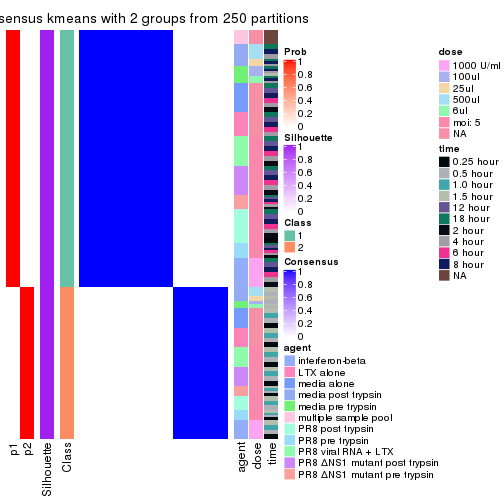
consensus_heatmap(res, k = 3)
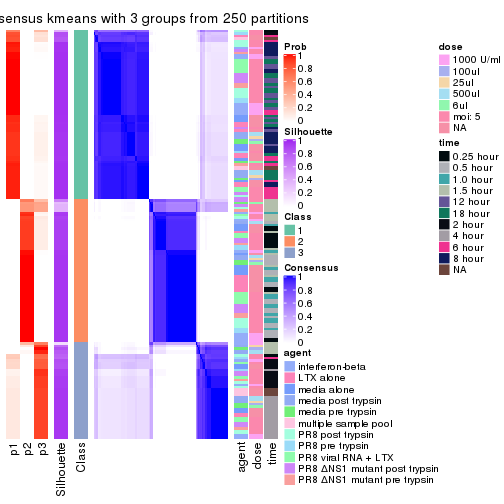
consensus_heatmap(res, k = 4)
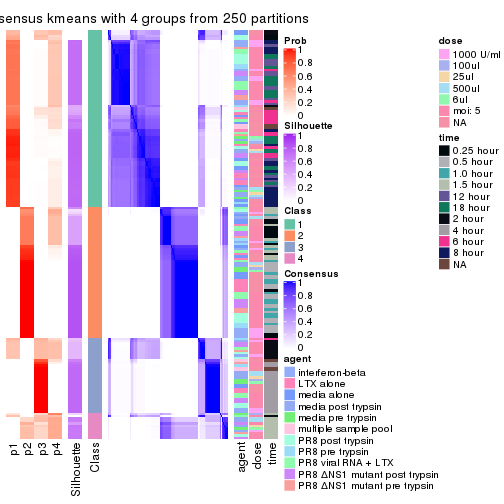
consensus_heatmap(res, k = 5)
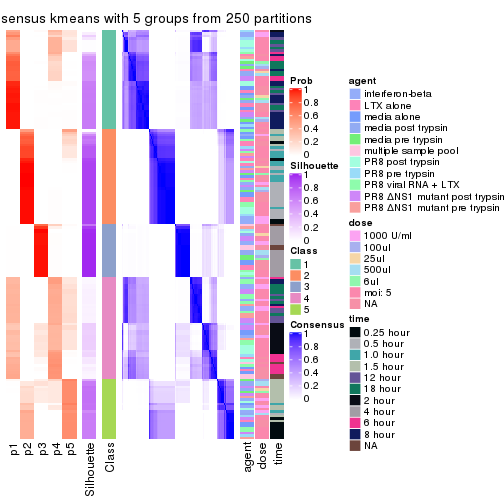
consensus_heatmap(res, k = 6)
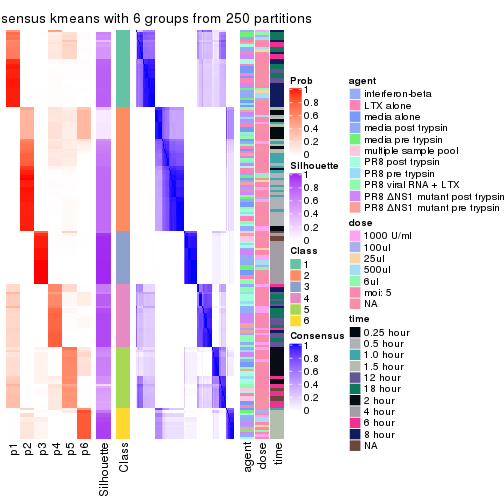
Heatmaps for the membership of samples in all partitions to see how consistent they are:
membership_heatmap(res, k = 2)
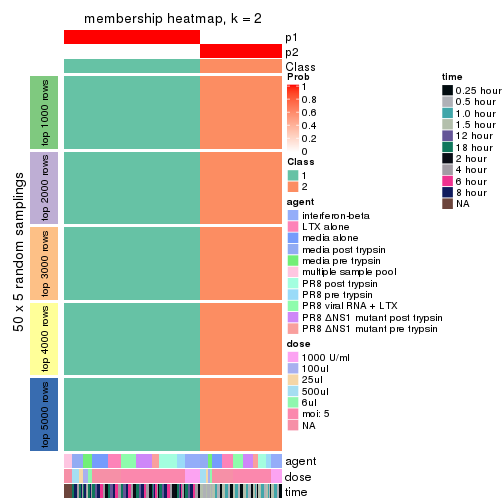
membership_heatmap(res, k = 3)
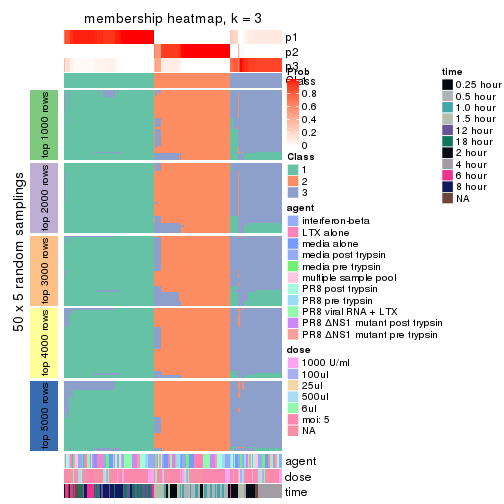
membership_heatmap(res, k = 4)
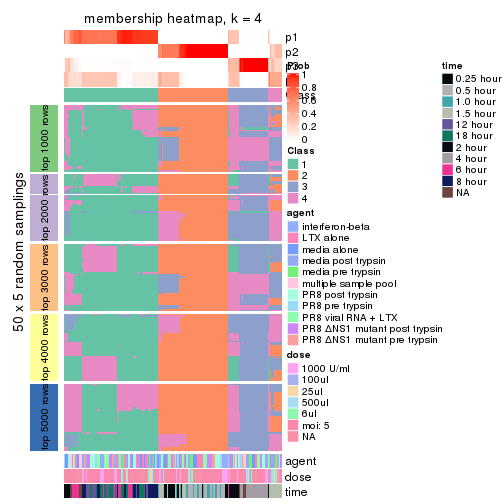
membership_heatmap(res, k = 5)
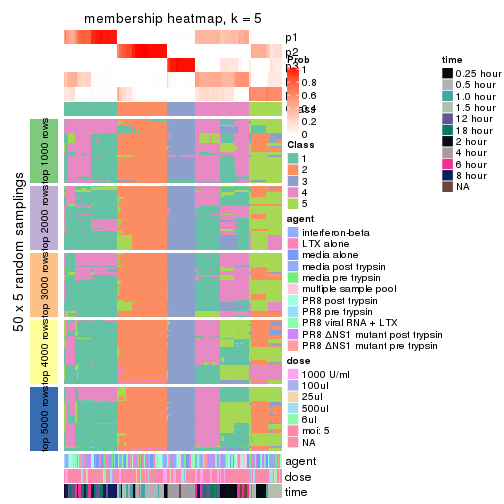
membership_heatmap(res, k = 6)
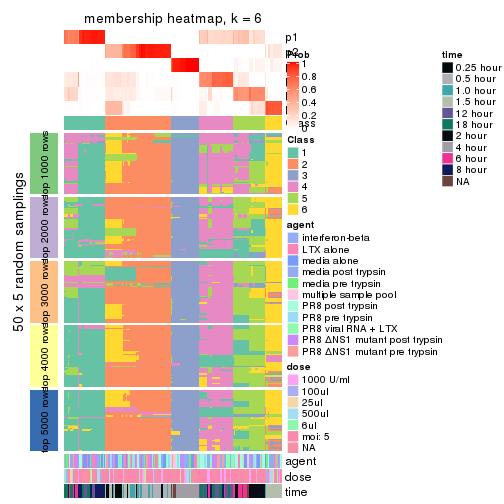
As soon as we have had the classes for columns, we can look for signatures which are significantly different between classes which can be candidate marks for certain classes. Following are the heatmaps for signatures.
Signature heatmaps where rows are scaled:
get_signatures(res, k = 2)
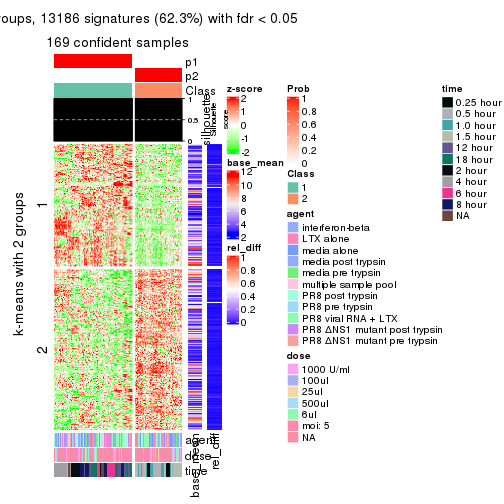
get_signatures(res, k = 3)
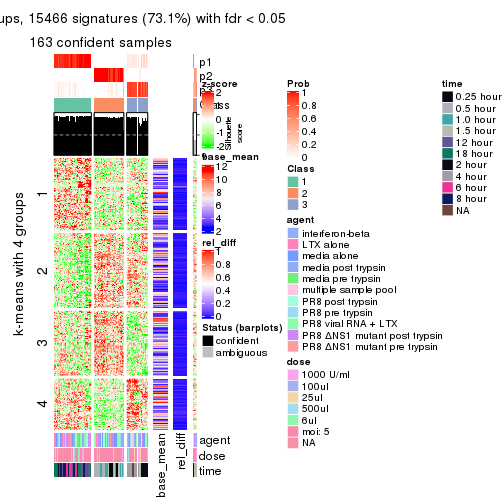
get_signatures(res, k = 4)
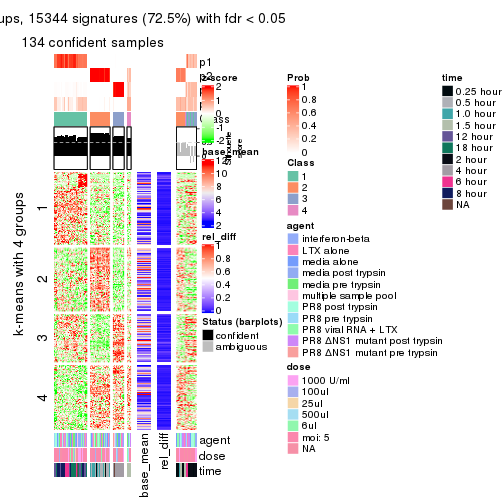
get_signatures(res, k = 5)
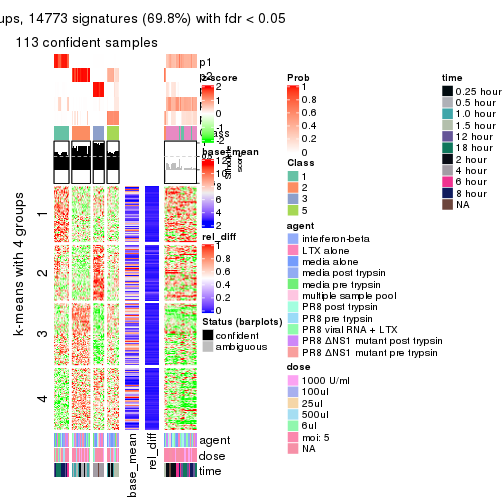
get_signatures(res, k = 6)
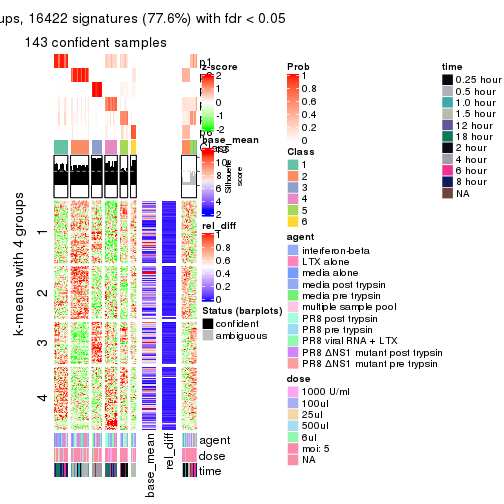
Signature heatmaps where rows are not scaled:
get_signatures(res, k = 2, scale_rows = FALSE)
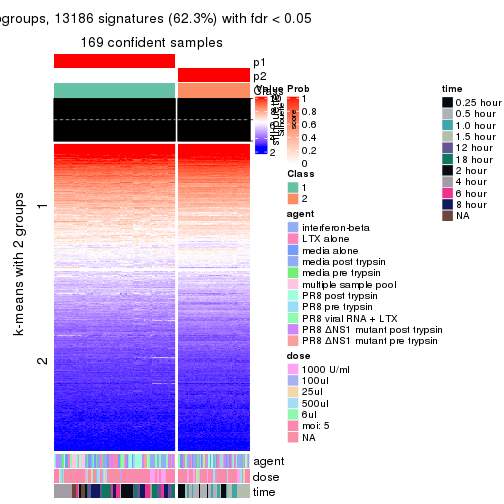
get_signatures(res, k = 3, scale_rows = FALSE)
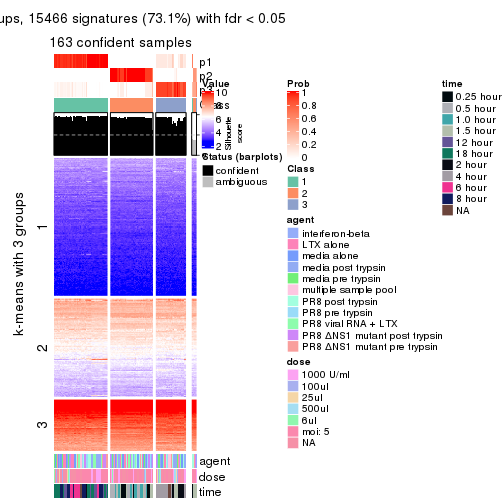
get_signatures(res, k = 4, scale_rows = FALSE)
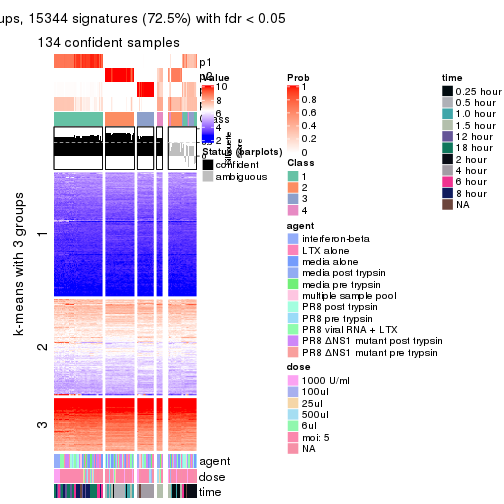
get_signatures(res, k = 5, scale_rows = FALSE)
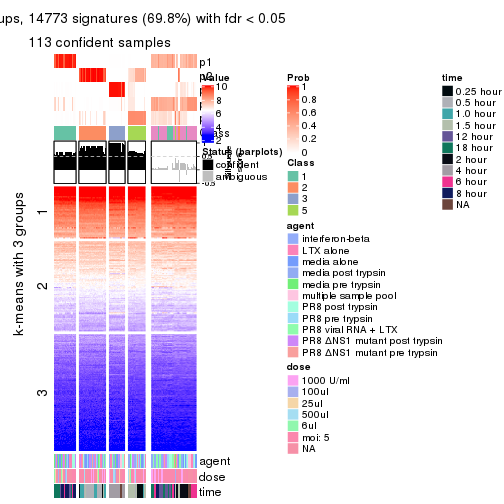
get_signatures(res, k = 6, scale_rows = FALSE)
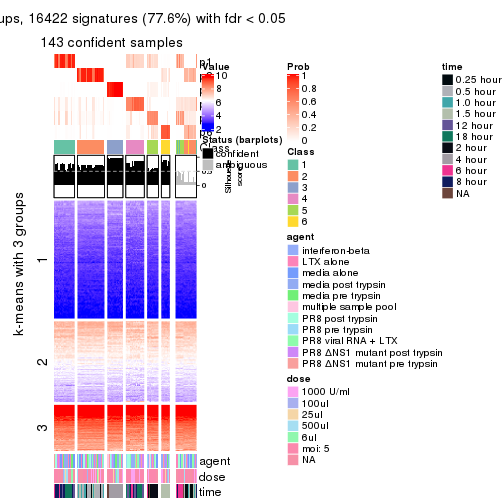
Compare the overlap of signatures from different k:
compare_signatures(res)
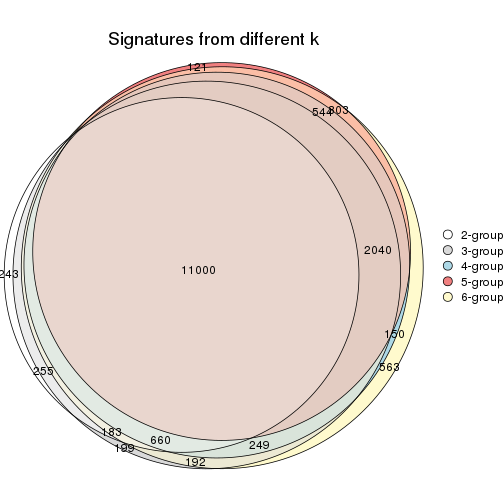
get_signature() returns a data frame invisibly. TO get the list of signatures, the function
call should be assigned to a variable explicitly. In following code, if plot argument is set
to FALSE, no heatmap is plotted while only the differential analysis is performed.
# code only for demonstration
tb = get_signature(res, k = ..., plot = FALSE)
An example of the output of tb is:
#> which_row fdr mean_1 mean_2 scaled_mean_1 scaled_mean_2 km
#> 1 38 0.042760348 8.373488 9.131774 -0.5533452 0.5164555 1
#> 2 40 0.018707592 7.106213 8.469186 -0.6173731 0.5762149 1
#> 3 55 0.019134737 10.221463 11.207825 -0.6159697 0.5749050 1
#> 4 59 0.006059896 5.921854 7.869574 -0.6899429 0.6439467 1
#> 5 60 0.018055526 8.928898 10.211722 -0.6204761 0.5791110 1
#> 6 98 0.009384629 15.714769 14.887706 0.6635654 -0.6193277 2
...
The columns in tb are:
which_row: row indices corresponding to the input matrix.fdr: FDR for the differential test. mean_x: The mean value in group x.scaled_mean_x: The mean value in group x after rows are scaled.km: Row groups if k-means clustering is applied to rows.UMAP plot which shows how samples are separated.
dimension_reduction(res, k = 2, method = "UMAP")
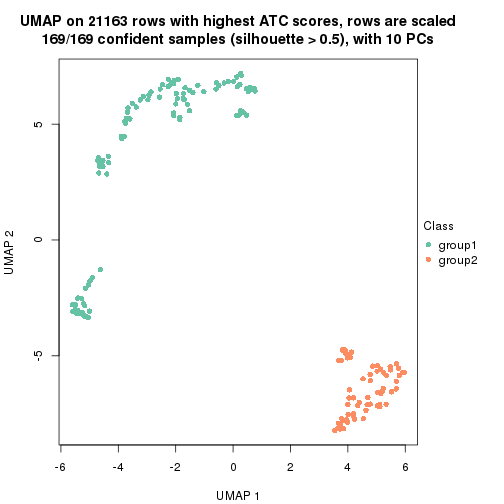
dimension_reduction(res, k = 3, method = "UMAP")
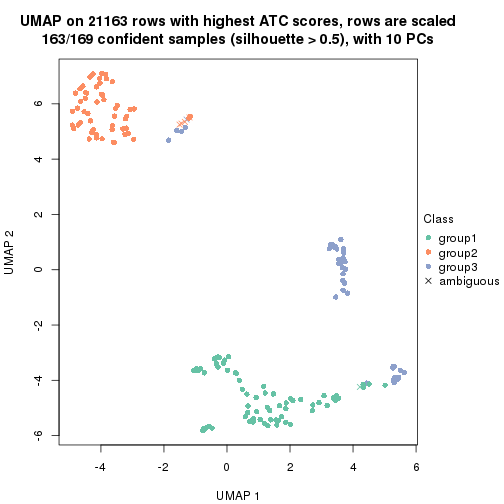
dimension_reduction(res, k = 4, method = "UMAP")
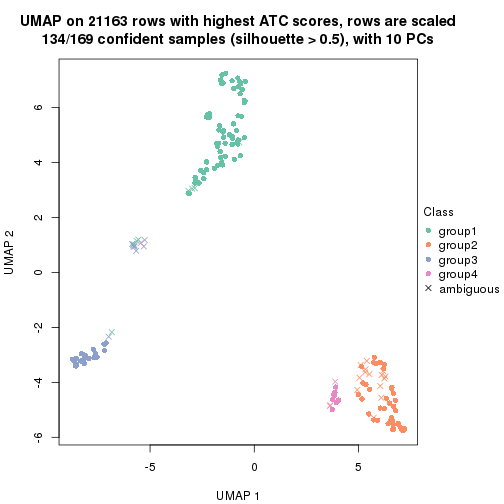
dimension_reduction(res, k = 5, method = "UMAP")
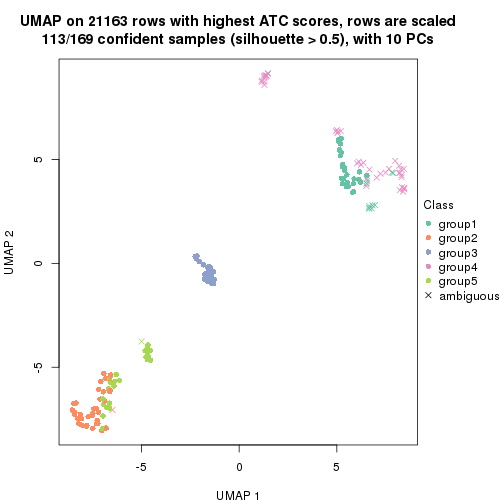
dimension_reduction(res, k = 6, method = "UMAP")
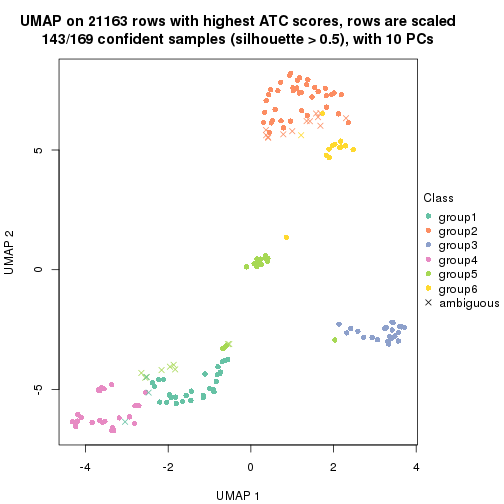
Following heatmap shows how subgroups are split when increasing k:
collect_classes(res)
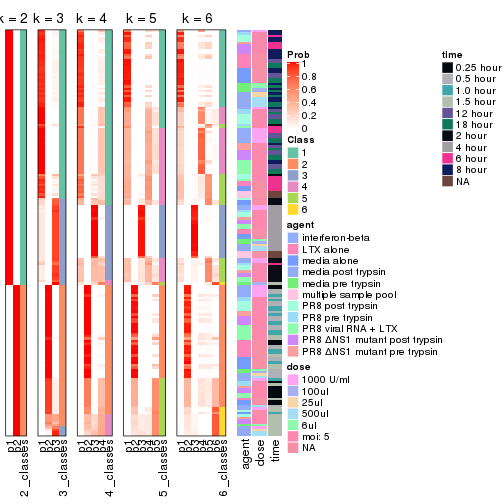
Test correlation between subgroups and known annotations. If the known annotation is numeric, one-way ANOVA test is applied, and if the known annotation is discrete, chi-squared contingency table test is applied.
test_to_known_factors(res)
#> n agent(p) dose(p) time(p) k
#> ATC:kmeans 169 0.8908 0.9925 1.01e-28 2
#> ATC:kmeans 163 0.9603 0.9827 3.71e-47 3
#> ATC:kmeans 134 0.8575 0.8093 6.91e-54 4
#> ATC:kmeans 113 0.3907 0.7810 1.22e-43 5
#> ATC:kmeans 143 0.0169 0.0172 1.05e-76 6
If matrix rows can be associated to genes, consider to use functional_enrichment(res,
...) to perform function enrichment for the signature genes. See this vignette for more detailed explanations.
The object with results only for a single top-value method and a single partition method can be extracted as:
res = res_list["ATC", "skmeans"]
# you can also extract it by
# res = res_list["ATC:skmeans"]
A summary of res and all the functions that can be applied to it:
res
#> A 'ConsensusPartition' object with k = 2, 3, 4, 5, 6.
#> On a matrix with 21163 rows and 169 columns.
#> Top rows (1000, 2000, 3000, 4000, 5000) are extracted by 'ATC' method.
#> Subgroups are detected by 'skmeans' method.
#> Performed in total 1250 partitions by row resampling.
#> Best k for subgroups seems to be 4.
#>
#> Following methods can be applied to this 'ConsensusPartition' object:
#> [1] "cola_report" "collect_classes" "collect_plots"
#> [4] "collect_stats" "colnames" "compare_signatures"
#> [7] "consensus_heatmap" "dimension_reduction" "functional_enrichment"
#> [10] "get_anno_col" "get_anno" "get_classes"
#> [13] "get_consensus" "get_matrix" "get_membership"
#> [16] "get_param" "get_signatures" "get_stats"
#> [19] "is_best_k" "is_stable_k" "membership_heatmap"
#> [22] "ncol" "nrow" "plot_ecdf"
#> [25] "rownames" "select_partition_number" "show"
#> [28] "suggest_best_k" "test_to_known_factors"
collect_plots() function collects all the plots made from res for all k (number of partitions)
into one single page to provide an easy and fast comparison between different k.
collect_plots(res)
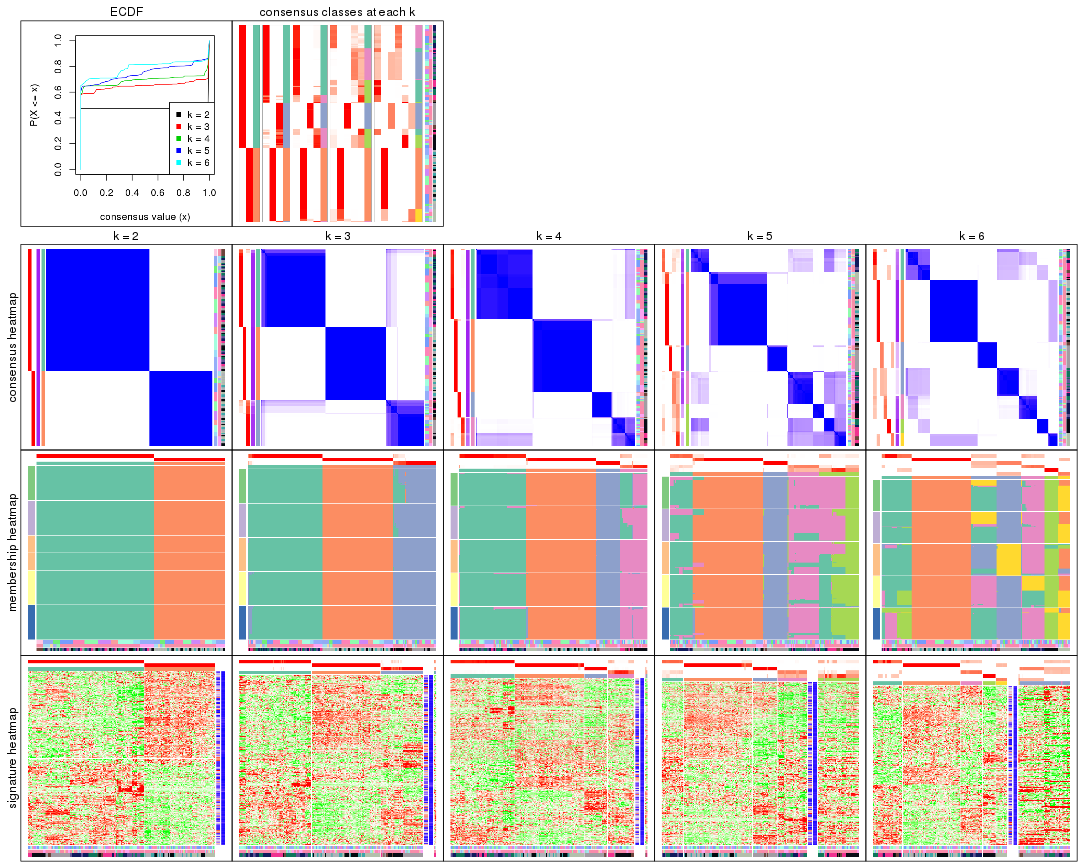
The plots are:
k and the heatmap of
predicted classes for each k.k.k.k.All the plots in panels can be made by individual functions and they are plotted later in this section.
select_partition_number() produces several plots showing different
statistics for choosing “optimized” k. There are following statistics:
k;k, the area increased is defined as \(A_k - A_{k-1}\).The detailed explanations of these statistics can be found in the cola vignette.
Generally speaking, lower PAC score, higher mean silhouette score or higher
concordance corresponds to better partition. Rand index and Jaccard index
measure how similar the current partition is compared to partition with k-1.
If they are too similar, we won't accept k is better than k-1.
select_partition_number(res)
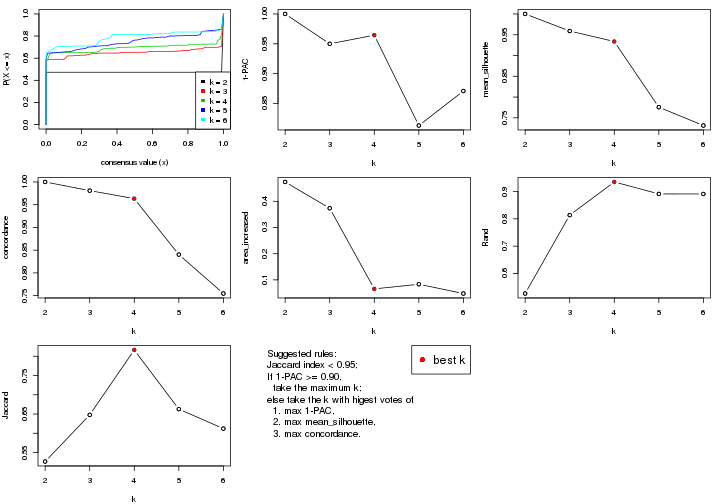
The numeric values for all these statistics can be obtained by get_stats().
get_stats(res)
#> k 1-PAC mean_silhouette concordance area_increased Rand Jaccard
#> 2 2 1.000 1.000 1.000 0.4739 0.527 0.527
#> 3 3 0.950 0.959 0.981 0.3735 0.814 0.648
#> 4 4 0.964 0.934 0.963 0.0656 0.935 0.816
#> 5 5 0.813 0.776 0.840 0.0832 0.891 0.663
#> 6 6 0.871 0.732 0.755 0.0478 0.891 0.612
suggest_best_k() suggests the best \(k\) based on these statistics. The rules are as follows:
suggest_best_k(res)
#> [1] 4
#> attr(,"optional")
#> [1] 2 3
There is also optional best \(k\) = 2 3 that is worth to check.
Following shows the table of the partitions (You need to click the show/hide
code output link to see it). The membership matrix (columns with name p*)
is inferred by
clue::cl_consensus()
function with the SE method. Basically the value in the membership matrix
represents the probability to belong to a certain group. The finall class
label for an item is determined with the group with highest probability it
belongs to.
In get_classes() function, the entropy is calculated from the membership
matrix and the silhouette score is calculated from the consensus matrix.
cbind(get_classes(res, k = 2), get_membership(res, k = 2))
#> class entropy silhouette p1 p2
#> GSM528681 2 0 1 0 1
#> GSM528682 2 0 1 0 1
#> GSM528683 2 0 1 0 1
#> GSM528684 2 0 1 0 1
#> GSM528687 2 0 1 0 1
#> GSM528688 2 0 1 0 1
#> GSM528685 2 0 1 0 1
#> GSM528686 2 0 1 0 1
#> GSM528693 1 0 1 1 0
#> GSM528694 1 0 1 1 0
#> GSM528695 1 0 1 1 0
#> GSM528696 1 0 1 1 0
#> GSM528697 1 0 1 1 0
#> GSM528698 1 0 1 1 0
#> GSM528699 1 0 1 1 0
#> GSM528700 1 0 1 1 0
#> GSM528689 1 0 1 1 0
#> GSM528690 1 0 1 1 0
#> GSM528691 1 0 1 1 0
#> GSM528692 1 0 1 1 0
#> GSM528779 2 0 1 0 1
#> GSM528780 2 0 1 0 1
#> GSM528782 2 0 1 0 1
#> GSM528781 2 0 1 0 1
#> GSM528785 1 0 1 1 0
#> GSM528786 1 0 1 1 0
#> GSM528787 1 0 1 1 0
#> GSM528788 1 0 1 1 0
#> GSM528783 1 0 1 1 0
#> GSM528784 1 0 1 1 0
#> GSM528759 1 0 1 1 0
#> GSM528760 1 0 1 1 0
#> GSM528761 2 0 1 0 1
#> GSM528762 2 0 1 0 1
#> GSM528765 2 0 1 0 1
#> GSM528766 2 0 1 0 1
#> GSM528763 2 0 1 0 1
#> GSM528764 2 0 1 0 1
#> GSM528771 1 0 1 1 0
#> GSM528772 1 0 1 1 0
#> GSM528773 1 0 1 1 0
#> GSM528774 1 0 1 1 0
#> GSM528775 1 0 1 1 0
#> GSM528776 1 0 1 1 0
#> GSM528777 1 0 1 1 0
#> GSM528778 1 0 1 1 0
#> GSM528767 1 0 1 1 0
#> GSM528768 1 0 1 1 0
#> GSM528769 1 0 1 1 0
#> GSM528770 1 0 1 1 0
#> GSM528671 2 0 1 0 1
#> GSM528672 2 0 1 0 1
#> GSM528674 2 0 1 0 1
#> GSM528673 2 0 1 0 1
#> GSM528677 1 0 1 1 0
#> GSM528678 1 0 1 1 0
#> GSM528679 1 0 1 1 0
#> GSM528680 1 0 1 1 0
#> GSM528675 1 0 1 1 0
#> GSM528676 1 0 1 1 0
#> GSM528651 2 0 1 0 1
#> GSM528652 2 0 1 0 1
#> GSM528653 2 0 1 0 1
#> GSM528654 2 0 1 0 1
#> GSM528657 2 0 1 0 1
#> GSM528658 2 0 1 0 1
#> GSM528655 2 0 1 0 1
#> GSM528656 2 0 1 0 1
#> GSM528663 1 0 1 1 0
#> GSM528664 1 0 1 1 0
#> GSM528665 1 0 1 1 0
#> GSM528666 1 0 1 1 0
#> GSM528667 1 0 1 1 0
#> GSM528668 1 0 1 1 0
#> GSM528669 1 0 1 1 0
#> GSM528670 1 0 1 1 0
#> GSM528659 1 0 1 1 0
#> GSM528660 1 0 1 1 0
#> GSM528661 1 0 1 1 0
#> GSM528662 1 0 1 1 0
#> GSM528701 2 0 1 0 1
#> GSM528702 2 0 1 0 1
#> GSM528703 2 0 1 0 1
#> GSM528704 2 0 1 0 1
#> GSM528707 2 0 1 0 1
#> GSM528708 2 0 1 0 1
#> GSM528705 2 0 1 0 1
#> GSM528706 2 0 1 0 1
#> GSM528713 1 0 1 1 0
#> GSM528714 1 0 1 1 0
#> GSM528715 1 0 1 1 0
#> GSM528716 1 0 1 1 0
#> GSM528717 1 0 1 1 0
#> GSM528718 1 0 1 1 0
#> GSM528719 1 0 1 1 0
#> GSM528720 1 0 1 1 0
#> GSM528709 1 0 1 1 0
#> GSM528710 1 0 1 1 0
#> GSM528711 1 0 1 1 0
#> GSM528712 1 0 1 1 0
#> GSM528721 2 0 1 0 1
#> GSM528722 2 0 1 0 1
#> GSM528723 2 0 1 0 1
#> GSM528724 2 0 1 0 1
#> GSM528727 2 0 1 0 1
#> GSM528728 2 0 1 0 1
#> GSM528725 2 0 1 0 1
#> GSM528726 2 0 1 0 1
#> GSM528733 1 0 1 1 0
#> GSM528734 1 0 1 1 0
#> GSM528735 1 0 1 1 0
#> GSM528736 1 0 1 1 0
#> GSM528737 1 0 1 1 0
#> GSM528738 1 0 1 1 0
#> GSM528729 1 0 1 1 0
#> GSM528730 1 0 1 1 0
#> GSM528731 1 0 1 1 0
#> GSM528732 1 0 1 1 0
#> GSM528739 2 0 1 0 1
#> GSM528740 2 0 1 0 1
#> GSM528741 2 0 1 0 1
#> GSM528742 2 0 1 0 1
#> GSM528745 2 0 1 0 1
#> GSM528746 2 0 1 0 1
#> GSM528743 2 0 1 0 1
#> GSM528744 2 0 1 0 1
#> GSM528751 1 0 1 1 0
#> GSM528752 1 0 1 1 0
#> GSM528753 1 0 1 1 0
#> GSM528754 1 0 1 1 0
#> GSM528755 1 0 1 1 0
#> GSM528756 1 0 1 1 0
#> GSM528757 1 0 1 1 0
#> GSM528758 1 0 1 1 0
#> GSM528747 1 0 1 1 0
#> GSM528748 1 0 1 1 0
#> GSM528749 1 0 1 1 0
#> GSM528750 1 0 1 1 0
#> GSM528640 2 0 1 0 1
#> GSM528641 2 0 1 0 1
#> GSM528643 1 0 1 1 0
#> GSM528644 1 0 1 1 0
#> GSM528642 1 0 1 1 0
#> GSM528620 2 0 1 0 1
#> GSM528621 2 0 1 0 1
#> GSM528623 1 0 1 1 0
#> GSM528624 1 0 1 1 0
#> GSM528622 1 0 1 1 0
#> GSM528625 2 0 1 0 1
#> GSM528626 2 0 1 0 1
#> GSM528628 1 0 1 1 0
#> GSM528629 1 0 1 1 0
#> GSM528627 1 0 1 1 0
#> GSM528630 2 0 1 0 1
#> GSM528631 2 0 1 0 1
#> GSM528632 2 0 1 0 1
#> GSM528633 2 0 1 0 1
#> GSM528636 1 0 1 1 0
#> GSM528637 1 0 1 1 0
#> GSM528638 1 0 1 1 0
#> GSM528639 1 0 1 1 0
#> GSM528634 1 0 1 1 0
#> GSM528635 1 0 1 1 0
#> GSM528645 1 0 1 1 0
#> GSM528646 1 0 1 1 0
#> GSM528647 1 0 1 1 0
#> GSM528648 1 0 1 1 0
#> GSM528649 1 0 1 1 0
#> GSM528650 1 0 1 1 0
cbind(get_classes(res, k = 3), get_membership(res, k = 3))
#> class entropy silhouette p1 p2 p3
#> GSM528681 2 0.0000 1.000 0.000 1.00 0.000
#> GSM528682 2 0.0000 1.000 0.000 1.00 0.000
#> GSM528683 2 0.0000 1.000 0.000 1.00 0.000
#> GSM528684 2 0.0000 1.000 0.000 1.00 0.000
#> GSM528687 2 0.0000 1.000 0.000 1.00 0.000
#> GSM528688 2 0.0000 1.000 0.000 1.00 0.000
#> GSM528685 2 0.0000 1.000 0.000 1.00 0.000
#> GSM528686 2 0.0000 1.000 0.000 1.00 0.000
#> GSM528693 3 0.0237 0.938 0.004 0.00 0.996
#> GSM528694 3 0.3116 0.879 0.108 0.00 0.892
#> GSM528695 3 0.0000 0.940 0.000 0.00 1.000
#> GSM528696 3 0.0000 0.940 0.000 0.00 1.000
#> GSM528697 1 0.0000 0.984 1.000 0.00 0.000
#> GSM528698 1 0.0000 0.984 1.000 0.00 0.000
#> GSM528699 1 0.0000 0.984 1.000 0.00 0.000
#> GSM528700 1 0.0000 0.984 1.000 0.00 0.000
#> GSM528689 1 0.0000 0.984 1.000 0.00 0.000
#> GSM528690 1 0.0000 0.984 1.000 0.00 0.000
#> GSM528691 1 0.0000 0.984 1.000 0.00 0.000
#> GSM528692 1 0.0000 0.984 1.000 0.00 0.000
#> GSM528779 2 0.0000 1.000 0.000 1.00 0.000
#> GSM528780 2 0.0000 1.000 0.000 1.00 0.000
#> GSM528782 2 0.0000 1.000 0.000 1.00 0.000
#> GSM528781 2 0.0000 1.000 0.000 1.00 0.000
#> GSM528785 1 0.3941 0.799 0.844 0.00 0.156
#> GSM528786 3 0.0000 0.940 0.000 0.00 1.000
#> GSM528787 3 0.3116 0.879 0.108 0.00 0.892
#> GSM528788 1 0.0000 0.984 1.000 0.00 0.000
#> GSM528783 1 0.0000 0.984 1.000 0.00 0.000
#> GSM528784 1 0.0000 0.984 1.000 0.00 0.000
#> GSM528759 3 0.4842 0.751 0.224 0.00 0.776
#> GSM528760 3 0.3192 0.876 0.112 0.00 0.888
#> GSM528761 2 0.0000 1.000 0.000 1.00 0.000
#> GSM528762 2 0.0000 1.000 0.000 1.00 0.000
#> GSM528765 2 0.0000 1.000 0.000 1.00 0.000
#> GSM528766 2 0.0000 1.000 0.000 1.00 0.000
#> GSM528763 2 0.0000 1.000 0.000 1.00 0.000
#> GSM528764 2 0.0000 1.000 0.000 1.00 0.000
#> GSM528771 3 0.3192 0.876 0.112 0.00 0.888
#> GSM528772 3 0.3116 0.879 0.108 0.00 0.892
#> GSM528773 3 0.0000 0.940 0.000 0.00 1.000
#> GSM528774 3 0.0000 0.940 0.000 0.00 1.000
#> GSM528775 3 0.6204 0.339 0.424 0.00 0.576
#> GSM528776 1 0.0000 0.984 1.000 0.00 0.000
#> GSM528777 1 0.0000 0.984 1.000 0.00 0.000
#> GSM528778 1 0.0000 0.984 1.000 0.00 0.000
#> GSM528767 1 0.0000 0.984 1.000 0.00 0.000
#> GSM528768 1 0.0000 0.984 1.000 0.00 0.000
#> GSM528769 1 0.0000 0.984 1.000 0.00 0.000
#> GSM528770 1 0.0000 0.984 1.000 0.00 0.000
#> GSM528671 2 0.0000 1.000 0.000 1.00 0.000
#> GSM528672 2 0.0000 1.000 0.000 1.00 0.000
#> GSM528674 2 0.0000 1.000 0.000 1.00 0.000
#> GSM528673 2 0.0000 1.000 0.000 1.00 0.000
#> GSM528677 3 0.0237 0.938 0.004 0.00 0.996
#> GSM528678 3 0.0000 0.940 0.000 0.00 1.000
#> GSM528679 1 0.0000 0.984 1.000 0.00 0.000
#> GSM528680 1 0.0000 0.984 1.000 0.00 0.000
#> GSM528675 1 0.0000 0.984 1.000 0.00 0.000
#> GSM528676 1 0.0000 0.984 1.000 0.00 0.000
#> GSM528651 2 0.0000 1.000 0.000 1.00 0.000
#> GSM528652 2 0.0000 1.000 0.000 1.00 0.000
#> GSM528653 2 0.0000 1.000 0.000 1.00 0.000
#> GSM528654 2 0.0000 1.000 0.000 1.00 0.000
#> GSM528657 2 0.0000 1.000 0.000 1.00 0.000
#> GSM528658 2 0.0000 1.000 0.000 1.00 0.000
#> GSM528655 2 0.0000 1.000 0.000 1.00 0.000
#> GSM528656 2 0.0000 1.000 0.000 1.00 0.000
#> GSM528663 3 0.0000 0.940 0.000 0.00 1.000
#> GSM528664 3 0.0000 0.940 0.000 0.00 1.000
#> GSM528665 3 0.0000 0.940 0.000 0.00 1.000
#> GSM528666 3 0.0000 0.940 0.000 0.00 1.000
#> GSM528667 1 0.0000 0.984 1.000 0.00 0.000
#> GSM528668 1 0.0000 0.984 1.000 0.00 0.000
#> GSM528669 1 0.0000 0.984 1.000 0.00 0.000
#> GSM528670 1 0.0000 0.984 1.000 0.00 0.000
#> GSM528659 1 0.0000 0.984 1.000 0.00 0.000
#> GSM528660 1 0.0000 0.984 1.000 0.00 0.000
#> GSM528661 1 0.0000 0.984 1.000 0.00 0.000
#> GSM528662 1 0.0000 0.984 1.000 0.00 0.000
#> GSM528701 2 0.0000 1.000 0.000 1.00 0.000
#> GSM528702 2 0.0000 1.000 0.000 1.00 0.000
#> GSM528703 2 0.0000 1.000 0.000 1.00 0.000
#> GSM528704 2 0.0000 1.000 0.000 1.00 0.000
#> GSM528707 2 0.0000 1.000 0.000 1.00 0.000
#> GSM528708 2 0.0000 1.000 0.000 1.00 0.000
#> GSM528705 2 0.0000 1.000 0.000 1.00 0.000
#> GSM528706 2 0.0000 1.000 0.000 1.00 0.000
#> GSM528713 3 0.3267 0.872 0.116 0.00 0.884
#> GSM528714 3 0.0000 0.940 0.000 0.00 1.000
#> GSM528715 3 0.0000 0.940 0.000 0.00 1.000
#> GSM528716 3 0.0000 0.940 0.000 0.00 1.000
#> GSM528717 1 0.0000 0.984 1.000 0.00 0.000
#> GSM528718 1 0.0000 0.984 1.000 0.00 0.000
#> GSM528719 1 0.0000 0.984 1.000 0.00 0.000
#> GSM528720 1 0.0000 0.984 1.000 0.00 0.000
#> GSM528709 1 0.0000 0.984 1.000 0.00 0.000
#> GSM528710 1 0.0000 0.984 1.000 0.00 0.000
#> GSM528711 1 0.0000 0.984 1.000 0.00 0.000
#> GSM528712 1 0.0000 0.984 1.000 0.00 0.000
#> GSM528721 2 0.0000 1.000 0.000 1.00 0.000
#> GSM528722 2 0.0000 1.000 0.000 1.00 0.000
#> GSM528723 2 0.0000 1.000 0.000 1.00 0.000
#> GSM528724 2 0.0000 1.000 0.000 1.00 0.000
#> GSM528727 2 0.0000 1.000 0.000 1.00 0.000
#> GSM528728 2 0.0000 1.000 0.000 1.00 0.000
#> GSM528725 2 0.0000 1.000 0.000 1.00 0.000
#> GSM528726 2 0.0000 1.000 0.000 1.00 0.000
#> GSM528733 3 0.0000 0.940 0.000 0.00 1.000
#> GSM528734 3 0.0000 0.940 0.000 0.00 1.000
#> GSM528735 1 0.4346 0.758 0.816 0.00 0.184
#> GSM528736 1 0.6215 0.171 0.572 0.00 0.428
#> GSM528737 1 0.0000 0.984 1.000 0.00 0.000
#> GSM528738 1 0.0000 0.984 1.000 0.00 0.000
#> GSM528729 1 0.0000 0.984 1.000 0.00 0.000
#> GSM528730 1 0.0000 0.984 1.000 0.00 0.000
#> GSM528731 1 0.0000 0.984 1.000 0.00 0.000
#> GSM528732 1 0.0000 0.984 1.000 0.00 0.000
#> GSM528739 2 0.0000 1.000 0.000 1.00 0.000
#> GSM528740 2 0.0000 1.000 0.000 1.00 0.000
#> GSM528741 2 0.0000 1.000 0.000 1.00 0.000
#> GSM528742 2 0.0000 1.000 0.000 1.00 0.000
#> GSM528745 2 0.0000 1.000 0.000 1.00 0.000
#> GSM528746 2 0.0000 1.000 0.000 1.00 0.000
#> GSM528743 2 0.0000 1.000 0.000 1.00 0.000
#> GSM528744 2 0.0000 1.000 0.000 1.00 0.000
#> GSM528751 3 0.5138 0.712 0.252 0.00 0.748
#> GSM528752 3 0.5138 0.712 0.252 0.00 0.748
#> GSM528753 3 0.0000 0.940 0.000 0.00 1.000
#> GSM528754 3 0.0000 0.940 0.000 0.00 1.000
#> GSM528755 1 0.1031 0.960 0.976 0.00 0.024
#> GSM528756 1 0.4346 0.758 0.816 0.00 0.184
#> GSM528757 1 0.0000 0.984 1.000 0.00 0.000
#> GSM528758 1 0.0000 0.984 1.000 0.00 0.000
#> GSM528747 1 0.0000 0.984 1.000 0.00 0.000
#> GSM528748 1 0.0000 0.984 1.000 0.00 0.000
#> GSM528749 1 0.0000 0.984 1.000 0.00 0.000
#> GSM528750 1 0.0000 0.984 1.000 0.00 0.000
#> GSM528640 2 0.0000 1.000 0.000 1.00 0.000
#> GSM528641 2 0.0000 1.000 0.000 1.00 0.000
#> GSM528643 3 0.0000 0.940 0.000 0.00 1.000
#> GSM528644 1 0.0000 0.984 1.000 0.00 0.000
#> GSM528642 1 0.0000 0.984 1.000 0.00 0.000
#> GSM528620 2 0.0000 1.000 0.000 1.00 0.000
#> GSM528621 3 0.3340 0.841 0.000 0.12 0.880
#> GSM528623 3 0.0000 0.940 0.000 0.00 1.000
#> GSM528624 1 0.0000 0.984 1.000 0.00 0.000
#> GSM528622 1 0.0000 0.984 1.000 0.00 0.000
#> GSM528625 2 0.0000 1.000 0.000 1.00 0.000
#> GSM528626 2 0.0000 1.000 0.000 1.00 0.000
#> GSM528628 3 0.0000 0.940 0.000 0.00 1.000
#> GSM528629 1 0.0000 0.984 1.000 0.00 0.000
#> GSM528627 1 0.0000 0.984 1.000 0.00 0.000
#> GSM528630 2 0.0000 1.000 0.000 1.00 0.000
#> GSM528631 2 0.0000 1.000 0.000 1.00 0.000
#> GSM528632 2 0.0000 1.000 0.000 1.00 0.000
#> GSM528633 2 0.0000 1.000 0.000 1.00 0.000
#> GSM528636 3 0.0000 0.940 0.000 0.00 1.000
#> GSM528637 3 0.0000 0.940 0.000 0.00 1.000
#> GSM528638 1 0.0000 0.984 1.000 0.00 0.000
#> GSM528639 1 0.0000 0.984 1.000 0.00 0.000
#> GSM528634 1 0.0000 0.984 1.000 0.00 0.000
#> GSM528635 1 0.0000 0.984 1.000 0.00 0.000
#> GSM528645 3 0.0000 0.940 0.000 0.00 1.000
#> GSM528646 3 0.0000 0.940 0.000 0.00 1.000
#> GSM528647 3 0.0000 0.940 0.000 0.00 1.000
#> GSM528648 1 0.0747 0.968 0.984 0.00 0.016
#> GSM528649 3 0.5431 0.659 0.284 0.00 0.716
#> GSM528650 1 0.0000 0.984 1.000 0.00 0.000
cbind(get_classes(res, k = 4), get_membership(res, k = 4))
#> class entropy silhouette p1 p2 p3 p4
#> GSM528681 2 0.0000 0.993 0.000 1.000 0.000 0.000
#> GSM528682 2 0.0000 0.993 0.000 1.000 0.000 0.000
#> GSM528683 2 0.0000 0.993 0.000 1.000 0.000 0.000
#> GSM528684 2 0.0000 0.993 0.000 1.000 0.000 0.000
#> GSM528687 2 0.0000 0.993 0.000 1.000 0.000 0.000
#> GSM528688 2 0.0000 0.993 0.000 1.000 0.000 0.000
#> GSM528685 2 0.0188 0.991 0.000 0.996 0.000 0.004
#> GSM528686 2 0.0188 0.991 0.000 0.996 0.000 0.004
#> GSM528693 4 0.1297 0.760 0.016 0.000 0.020 0.964
#> GSM528694 4 0.1174 0.765 0.020 0.000 0.012 0.968
#> GSM528695 3 0.0000 0.999 0.000 0.000 1.000 0.000
#> GSM528696 3 0.0000 0.999 0.000 0.000 1.000 0.000
#> GSM528697 1 0.0000 0.976 1.000 0.000 0.000 0.000
#> GSM528698 1 0.0000 0.976 1.000 0.000 0.000 0.000
#> GSM528699 1 0.0000 0.976 1.000 0.000 0.000 0.000
#> GSM528700 1 0.0000 0.976 1.000 0.000 0.000 0.000
#> GSM528689 1 0.0000 0.976 1.000 0.000 0.000 0.000
#> GSM528690 1 0.0000 0.976 1.000 0.000 0.000 0.000
#> GSM528691 1 0.0000 0.976 1.000 0.000 0.000 0.000
#> GSM528692 1 0.0000 0.976 1.000 0.000 0.000 0.000
#> GSM528779 2 0.0000 0.993 0.000 1.000 0.000 0.000
#> GSM528780 2 0.0000 0.993 0.000 1.000 0.000 0.000
#> GSM528782 2 0.0000 0.993 0.000 1.000 0.000 0.000
#> GSM528781 2 0.0000 0.993 0.000 1.000 0.000 0.000
#> GSM528785 4 0.0707 0.768 0.020 0.000 0.000 0.980
#> GSM528786 3 0.0000 0.999 0.000 0.000 1.000 0.000
#> GSM528787 4 0.4933 0.730 0.296 0.000 0.016 0.688
#> GSM528788 1 0.1022 0.972 0.968 0.000 0.000 0.032
#> GSM528783 1 0.0592 0.971 0.984 0.000 0.000 0.016
#> GSM528784 1 0.0000 0.976 1.000 0.000 0.000 0.000
#> GSM528759 4 0.4406 0.723 0.300 0.000 0.000 0.700
#> GSM528760 4 0.4331 0.732 0.288 0.000 0.000 0.712
#> GSM528761 2 0.0000 0.993 0.000 1.000 0.000 0.000
#> GSM528762 2 0.0000 0.993 0.000 1.000 0.000 0.000
#> GSM528765 2 0.0000 0.993 0.000 1.000 0.000 0.000
#> GSM528766 2 0.0000 0.993 0.000 1.000 0.000 0.000
#> GSM528763 2 0.0000 0.993 0.000 1.000 0.000 0.000
#> GSM528764 2 0.0188 0.991 0.000 0.996 0.000 0.004
#> GSM528771 4 0.1174 0.765 0.020 0.000 0.012 0.968
#> GSM528772 4 0.1174 0.765 0.020 0.000 0.012 0.968
#> GSM528773 3 0.0000 0.999 0.000 0.000 1.000 0.000
#> GSM528774 3 0.0000 0.999 0.000 0.000 1.000 0.000
#> GSM528775 4 0.4477 0.711 0.312 0.000 0.000 0.688
#> GSM528776 1 0.0592 0.974 0.984 0.000 0.000 0.016
#> GSM528777 1 0.0592 0.971 0.984 0.000 0.000 0.016
#> GSM528778 1 0.0592 0.971 0.984 0.000 0.000 0.016
#> GSM528767 1 0.0000 0.976 1.000 0.000 0.000 0.000
#> GSM528768 1 0.0000 0.976 1.000 0.000 0.000 0.000
#> GSM528769 1 0.0000 0.976 1.000 0.000 0.000 0.000
#> GSM528770 1 0.0000 0.976 1.000 0.000 0.000 0.000
#> GSM528671 2 0.0000 0.993 0.000 1.000 0.000 0.000
#> GSM528672 2 0.0000 0.993 0.000 1.000 0.000 0.000
#> GSM528674 2 0.0000 0.993 0.000 1.000 0.000 0.000
#> GSM528673 2 0.0188 0.991 0.000 0.996 0.000 0.004
#> GSM528677 4 0.1297 0.760 0.016 0.000 0.020 0.964
#> GSM528678 3 0.0592 0.983 0.000 0.000 0.984 0.016
#> GSM528679 1 0.0592 0.974 0.984 0.000 0.000 0.016
#> GSM528680 1 0.0000 0.976 1.000 0.000 0.000 0.000
#> GSM528675 1 0.0000 0.976 1.000 0.000 0.000 0.000
#> GSM528676 1 0.0000 0.976 1.000 0.000 0.000 0.000
#> GSM528651 2 0.0000 0.993 0.000 1.000 0.000 0.000
#> GSM528652 2 0.0000 0.993 0.000 1.000 0.000 0.000
#> GSM528653 2 0.0000 0.993 0.000 1.000 0.000 0.000
#> GSM528654 2 0.0000 0.993 0.000 1.000 0.000 0.000
#> GSM528657 2 0.0000 0.993 0.000 1.000 0.000 0.000
#> GSM528658 2 0.0000 0.993 0.000 1.000 0.000 0.000
#> GSM528655 2 0.0188 0.991 0.000 0.996 0.000 0.004
#> GSM528656 2 0.0188 0.991 0.000 0.996 0.000 0.004
#> GSM528663 4 0.1256 0.752 0.008 0.000 0.028 0.964
#> GSM528664 4 0.1284 0.756 0.012 0.000 0.024 0.964
#> GSM528665 3 0.0000 0.999 0.000 0.000 1.000 0.000
#> GSM528666 3 0.0000 0.999 0.000 0.000 1.000 0.000
#> GSM528667 1 0.0592 0.974 0.984 0.000 0.000 0.016
#> GSM528668 1 0.0592 0.974 0.984 0.000 0.000 0.016
#> GSM528669 1 0.0592 0.971 0.984 0.000 0.000 0.016
#> GSM528670 1 0.1022 0.972 0.968 0.000 0.000 0.032
#> GSM528659 1 0.0000 0.976 1.000 0.000 0.000 0.000
#> GSM528660 1 0.0000 0.976 1.000 0.000 0.000 0.000
#> GSM528661 1 0.0000 0.976 1.000 0.000 0.000 0.000
#> GSM528662 1 0.0000 0.976 1.000 0.000 0.000 0.000
#> GSM528701 2 0.0000 0.993 0.000 1.000 0.000 0.000
#> GSM528702 2 0.0000 0.993 0.000 1.000 0.000 0.000
#> GSM528703 2 0.0000 0.993 0.000 1.000 0.000 0.000
#> GSM528704 2 0.0000 0.993 0.000 1.000 0.000 0.000
#> GSM528707 2 0.0000 0.993 0.000 1.000 0.000 0.000
#> GSM528708 2 0.0000 0.993 0.000 1.000 0.000 0.000
#> GSM528705 2 0.0000 0.993 0.000 1.000 0.000 0.000
#> GSM528706 2 0.0000 0.993 0.000 1.000 0.000 0.000
#> GSM528713 4 0.0707 0.768 0.020 0.000 0.000 0.980
#> GSM528714 4 0.1297 0.760 0.016 0.000 0.020 0.964
#> GSM528715 3 0.0000 0.999 0.000 0.000 1.000 0.000
#> GSM528716 3 0.0000 0.999 0.000 0.000 1.000 0.000
#> GSM528717 1 0.0707 0.972 0.980 0.000 0.000 0.020
#> GSM528718 1 0.4994 -0.242 0.520 0.000 0.000 0.480
#> GSM528719 1 0.0000 0.976 1.000 0.000 0.000 0.000
#> GSM528720 1 0.0000 0.976 1.000 0.000 0.000 0.000
#> GSM528709 1 0.0000 0.976 1.000 0.000 0.000 0.000
#> GSM528710 1 0.0000 0.976 1.000 0.000 0.000 0.000
#> GSM528711 1 0.0000 0.976 1.000 0.000 0.000 0.000
#> GSM528712 1 0.0000 0.976 1.000 0.000 0.000 0.000
#> GSM528721 2 0.0000 0.993 0.000 1.000 0.000 0.000
#> GSM528722 2 0.0000 0.993 0.000 1.000 0.000 0.000
#> GSM528723 2 0.0000 0.993 0.000 1.000 0.000 0.000
#> GSM528724 2 0.0000 0.993 0.000 1.000 0.000 0.000
#> GSM528727 2 0.0000 0.993 0.000 1.000 0.000 0.000
#> GSM528728 2 0.0000 0.993 0.000 1.000 0.000 0.000
#> GSM528725 2 0.0000 0.993 0.000 1.000 0.000 0.000
#> GSM528726 2 0.0000 0.993 0.000 1.000 0.000 0.000
#> GSM528733 3 0.0000 0.999 0.000 0.000 1.000 0.000
#> GSM528734 3 0.0000 0.999 0.000 0.000 1.000 0.000
#> GSM528735 4 0.4866 0.548 0.404 0.000 0.000 0.596
#> GSM528736 4 0.4866 0.548 0.404 0.000 0.000 0.596
#> GSM528737 1 0.0592 0.974 0.984 0.000 0.000 0.016
#> GSM528738 1 0.0817 0.969 0.976 0.000 0.000 0.024
#> GSM528729 1 0.1022 0.972 0.968 0.000 0.000 0.032
#> GSM528730 1 0.1022 0.972 0.968 0.000 0.000 0.032
#> GSM528731 1 0.1022 0.972 0.968 0.000 0.000 0.032
#> GSM528732 1 0.1022 0.972 0.968 0.000 0.000 0.032
#> GSM528739 2 0.0000 0.993 0.000 1.000 0.000 0.000
#> GSM528740 2 0.0000 0.993 0.000 1.000 0.000 0.000
#> GSM528741 2 0.0000 0.993 0.000 1.000 0.000 0.000
#> GSM528742 2 0.0000 0.993 0.000 1.000 0.000 0.000
#> GSM528745 2 0.0000 0.993 0.000 1.000 0.000 0.000
#> GSM528746 2 0.0000 0.993 0.000 1.000 0.000 0.000
#> GSM528743 2 0.0000 0.993 0.000 1.000 0.000 0.000
#> GSM528744 2 0.0000 0.993 0.000 1.000 0.000 0.000
#> GSM528751 4 0.0707 0.768 0.020 0.000 0.000 0.980
#> GSM528752 4 0.0707 0.768 0.020 0.000 0.000 0.980
#> GSM528753 3 0.0000 0.999 0.000 0.000 1.000 0.000
#> GSM528754 3 0.0000 0.999 0.000 0.000 1.000 0.000
#> GSM528755 4 0.4624 0.670 0.340 0.000 0.000 0.660
#> GSM528756 4 0.4477 0.711 0.312 0.000 0.000 0.688
#> GSM528757 1 0.1022 0.972 0.968 0.000 0.000 0.032
#> GSM528758 1 0.1022 0.972 0.968 0.000 0.000 0.032
#> GSM528747 1 0.1022 0.972 0.968 0.000 0.000 0.032
#> GSM528748 1 0.1022 0.972 0.968 0.000 0.000 0.032
#> GSM528749 1 0.1022 0.972 0.968 0.000 0.000 0.032
#> GSM528750 1 0.1022 0.972 0.968 0.000 0.000 0.032
#> GSM528640 2 0.0000 0.993 0.000 1.000 0.000 0.000
#> GSM528641 2 0.0188 0.991 0.000 0.996 0.000 0.004
#> GSM528643 3 0.0000 0.999 0.000 0.000 1.000 0.000
#> GSM528644 1 0.1022 0.972 0.968 0.000 0.000 0.032
#> GSM528642 1 0.0592 0.974 0.984 0.000 0.000 0.016
#> GSM528620 2 0.0000 0.993 0.000 1.000 0.000 0.000
#> GSM528621 4 0.1610 0.734 0.000 0.016 0.032 0.952
#> GSM528623 3 0.0000 0.999 0.000 0.000 1.000 0.000
#> GSM528624 1 0.1022 0.972 0.968 0.000 0.000 0.032
#> GSM528622 1 0.0592 0.974 0.984 0.000 0.000 0.016
#> GSM528625 2 0.0000 0.993 0.000 1.000 0.000 0.000
#> GSM528626 2 0.0188 0.991 0.000 0.996 0.000 0.004
#> GSM528628 3 0.0000 0.999 0.000 0.000 1.000 0.000
#> GSM528629 1 0.1022 0.972 0.968 0.000 0.000 0.032
#> GSM528627 1 0.0592 0.974 0.984 0.000 0.000 0.016
#> GSM528630 2 0.0000 0.993 0.000 1.000 0.000 0.000
#> GSM528631 2 0.0000 0.993 0.000 1.000 0.000 0.000
#> GSM528632 2 0.3751 0.756 0.000 0.800 0.196 0.004
#> GSM528633 2 0.3710 0.762 0.000 0.804 0.192 0.004
#> GSM528636 3 0.0000 0.999 0.000 0.000 1.000 0.000
#> GSM528637 3 0.0000 0.999 0.000 0.000 1.000 0.000
#> GSM528638 1 0.1022 0.972 0.968 0.000 0.000 0.032
#> GSM528639 1 0.1022 0.972 0.968 0.000 0.000 0.032
#> GSM528634 1 0.0592 0.974 0.984 0.000 0.000 0.016
#> GSM528635 1 0.0592 0.974 0.984 0.000 0.000 0.016
#> GSM528645 3 0.0000 0.999 0.000 0.000 1.000 0.000
#> GSM528646 3 0.0000 0.999 0.000 0.000 1.000 0.000
#> GSM528647 4 0.4985 0.106 0.000 0.000 0.468 0.532
#> GSM528648 4 0.4454 0.716 0.308 0.000 0.000 0.692
#> GSM528649 4 0.4406 0.723 0.300 0.000 0.000 0.700
#> GSM528650 4 0.4454 0.716 0.308 0.000 0.000 0.692
cbind(get_classes(res, k = 5), get_membership(res, k = 5))
#> class entropy silhouette p1 p2 p3 p4 p5
#> GSM528681 2 0.000 0.9763 0.000 1.000 0.000 0.000 0.000
#> GSM528682 2 0.000 0.9763 0.000 1.000 0.000 0.000 0.000
#> GSM528683 2 0.000 0.9763 0.000 1.000 0.000 0.000 0.000
#> GSM528684 2 0.000 0.9763 0.000 1.000 0.000 0.000 0.000
#> GSM528687 2 0.000 0.9763 0.000 1.000 0.000 0.000 0.000
#> GSM528688 2 0.000 0.9763 0.000 1.000 0.000 0.000 0.000
#> GSM528685 2 0.249 0.8889 0.124 0.872 0.000 0.004 0.000
#> GSM528686 2 0.249 0.8889 0.124 0.872 0.000 0.004 0.000
#> GSM528693 5 0.603 0.4341 0.112 0.000 0.004 0.352 0.532
#> GSM528694 5 0.603 0.4341 0.112 0.000 0.004 0.352 0.532
#> GSM528695 3 0.000 0.9862 0.000 0.000 1.000 0.000 0.000
#> GSM528696 3 0.000 0.9862 0.000 0.000 1.000 0.000 0.000
#> GSM528697 4 0.405 0.9036 0.000 0.000 0.000 0.644 0.356
#> GSM528698 4 0.498 0.7370 0.028 0.000 0.000 0.504 0.468
#> GSM528699 4 0.477 0.8569 0.036 0.000 0.000 0.644 0.320
#> GSM528700 4 0.405 0.9036 0.000 0.000 0.000 0.644 0.356
#> GSM528689 4 0.406 0.9031 0.000 0.000 0.000 0.640 0.360
#> GSM528690 4 0.405 0.9036 0.000 0.000 0.000 0.644 0.356
#> GSM528691 4 0.428 0.7991 0.000 0.000 0.000 0.548 0.452
#> GSM528692 4 0.428 0.7991 0.000 0.000 0.000 0.548 0.452
#> GSM528779 2 0.000 0.9763 0.000 1.000 0.000 0.000 0.000
#> GSM528780 2 0.000 0.9763 0.000 1.000 0.000 0.000 0.000
#> GSM528782 2 0.000 0.9763 0.000 1.000 0.000 0.000 0.000
#> GSM528781 2 0.000 0.9763 0.000 1.000 0.000 0.000 0.000
#> GSM528785 5 0.588 0.4373 0.112 0.000 0.000 0.352 0.536
#> GSM528786 3 0.000 0.9862 0.000 0.000 1.000 0.000 0.000
#> GSM528787 5 0.125 0.3896 0.036 0.000 0.008 0.000 0.956
#> GSM528788 1 0.393 0.9106 0.764 0.000 0.000 0.208 0.028
#> GSM528783 4 0.472 0.8813 0.028 0.000 0.000 0.628 0.344
#> GSM528784 4 0.431 0.9011 0.008 0.000 0.000 0.636 0.356
#> GSM528759 5 0.120 0.3945 0.048 0.000 0.000 0.000 0.952
#> GSM528760 5 0.120 0.3945 0.048 0.000 0.000 0.000 0.952
#> GSM528761 2 0.000 0.9763 0.000 1.000 0.000 0.000 0.000
#> GSM528762 2 0.000 0.9763 0.000 1.000 0.000 0.000 0.000
#> GSM528765 2 0.000 0.9763 0.000 1.000 0.000 0.000 0.000
#> GSM528766 2 0.000 0.9763 0.000 1.000 0.000 0.000 0.000
#> GSM528763 2 0.000 0.9763 0.000 1.000 0.000 0.000 0.000
#> GSM528764 2 0.249 0.8889 0.124 0.872 0.000 0.004 0.000
#> GSM528771 5 0.589 0.4347 0.112 0.000 0.000 0.356 0.532
#> GSM528772 5 0.604 0.4315 0.112 0.000 0.004 0.356 0.528
#> GSM528773 3 0.000 0.9862 0.000 0.000 1.000 0.000 0.000
#> GSM528774 3 0.000 0.9862 0.000 0.000 1.000 0.000 0.000
#> GSM528775 5 0.120 0.3945 0.048 0.000 0.000 0.000 0.952
#> GSM528776 5 0.605 -0.0762 0.404 0.000 0.000 0.120 0.476
#> GSM528777 1 0.422 0.8558 0.716 0.000 0.000 0.260 0.024
#> GSM528778 1 0.422 0.8558 0.716 0.000 0.000 0.260 0.024
#> GSM528767 4 0.431 0.9011 0.008 0.000 0.000 0.636 0.356
#> GSM528768 4 0.431 0.9011 0.008 0.000 0.000 0.636 0.356
#> GSM528769 4 0.431 0.9011 0.008 0.000 0.000 0.636 0.356
#> GSM528770 4 0.431 0.9011 0.008 0.000 0.000 0.636 0.356
#> GSM528671 2 0.000 0.9763 0.000 1.000 0.000 0.000 0.000
#> GSM528672 2 0.000 0.9763 0.000 1.000 0.000 0.000 0.000
#> GSM528674 2 0.000 0.9763 0.000 1.000 0.000 0.000 0.000
#> GSM528673 2 0.249 0.8889 0.124 0.872 0.000 0.004 0.000
#> GSM528677 5 0.604 0.4315 0.112 0.000 0.004 0.356 0.528
#> GSM528678 3 0.029 0.9790 0.000 0.000 0.992 0.000 0.008
#> GSM528679 5 0.602 -0.0871 0.412 0.000 0.000 0.116 0.472
#> GSM528680 4 0.405 0.9036 0.000 0.000 0.000 0.644 0.356
#> GSM528675 4 0.405 0.9036 0.000 0.000 0.000 0.644 0.356
#> GSM528676 4 0.405 0.9036 0.000 0.000 0.000 0.644 0.356
#> GSM528651 2 0.000 0.9763 0.000 1.000 0.000 0.000 0.000
#> GSM528652 2 0.000 0.9763 0.000 1.000 0.000 0.000 0.000
#> GSM528653 2 0.000 0.9763 0.000 1.000 0.000 0.000 0.000
#> GSM528654 2 0.000 0.9763 0.000 1.000 0.000 0.000 0.000
#> GSM528657 2 0.000 0.9763 0.000 1.000 0.000 0.000 0.000
#> GSM528658 2 0.000 0.9763 0.000 1.000 0.000 0.000 0.000
#> GSM528655 2 0.249 0.8889 0.124 0.872 0.000 0.004 0.000
#> GSM528656 2 0.249 0.8889 0.124 0.872 0.000 0.004 0.000
#> GSM528663 5 0.604 0.4315 0.112 0.000 0.004 0.356 0.528
#> GSM528664 5 0.604 0.4315 0.112 0.000 0.004 0.356 0.528
#> GSM528665 3 0.000 0.9862 0.000 0.000 1.000 0.000 0.000
#> GSM528666 3 0.000 0.9862 0.000 0.000 1.000 0.000 0.000
#> GSM528667 5 0.602 -0.0871 0.412 0.000 0.000 0.116 0.472
#> GSM528668 5 0.602 -0.0871 0.412 0.000 0.000 0.116 0.472
#> GSM528669 1 0.422 0.8558 0.716 0.000 0.000 0.260 0.024
#> GSM528670 1 0.393 0.9106 0.764 0.000 0.000 0.208 0.028
#> GSM528659 4 0.405 0.9036 0.000 0.000 0.000 0.644 0.356
#> GSM528660 4 0.405 0.9036 0.000 0.000 0.000 0.644 0.356
#> GSM528661 4 0.406 0.9028 0.000 0.000 0.000 0.640 0.360
#> GSM528662 4 0.410 0.8955 0.000 0.000 0.000 0.628 0.372
#> GSM528701 2 0.000 0.9763 0.000 1.000 0.000 0.000 0.000
#> GSM528702 2 0.000 0.9763 0.000 1.000 0.000 0.000 0.000
#> GSM528703 2 0.000 0.9763 0.000 1.000 0.000 0.000 0.000
#> GSM528704 2 0.000 0.9763 0.000 1.000 0.000 0.000 0.000
#> GSM528707 2 0.000 0.9763 0.000 1.000 0.000 0.000 0.000
#> GSM528708 2 0.000 0.9763 0.000 1.000 0.000 0.000 0.000
#> GSM528705 2 0.000 0.9763 0.000 1.000 0.000 0.000 0.000
#> GSM528706 2 0.000 0.9763 0.000 1.000 0.000 0.000 0.000
#> GSM528713 5 0.588 0.4373 0.112 0.000 0.000 0.352 0.536
#> GSM528714 5 0.604 0.4315 0.112 0.000 0.004 0.356 0.528
#> GSM528715 3 0.000 0.9862 0.000 0.000 1.000 0.000 0.000
#> GSM528716 3 0.000 0.9862 0.000 0.000 1.000 0.000 0.000
#> GSM528717 5 0.497 -0.0592 0.104 0.000 0.000 0.192 0.704
#> GSM528718 5 0.245 0.3323 0.056 0.000 0.000 0.044 0.900
#> GSM528719 4 0.490 0.7431 0.024 0.000 0.000 0.508 0.468
#> GSM528720 4 0.498 0.7370 0.028 0.000 0.000 0.504 0.468
#> GSM528709 4 0.406 0.9031 0.000 0.000 0.000 0.640 0.360
#> GSM528710 4 0.405 0.9036 0.000 0.000 0.000 0.644 0.356
#> GSM528711 4 0.411 0.8921 0.000 0.000 0.000 0.624 0.376
#> GSM528712 4 0.411 0.8921 0.000 0.000 0.000 0.624 0.376
#> GSM528721 2 0.000 0.9763 0.000 1.000 0.000 0.000 0.000
#> GSM528722 2 0.000 0.9763 0.000 1.000 0.000 0.000 0.000
#> GSM528723 2 0.000 0.9763 0.000 1.000 0.000 0.000 0.000
#> GSM528724 2 0.000 0.9763 0.000 1.000 0.000 0.000 0.000
#> GSM528727 2 0.000 0.9763 0.000 1.000 0.000 0.000 0.000
#> GSM528728 2 0.000 0.9763 0.000 1.000 0.000 0.000 0.000
#> GSM528725 2 0.000 0.9763 0.000 1.000 0.000 0.000 0.000
#> GSM528726 2 0.000 0.9763 0.000 1.000 0.000 0.000 0.000
#> GSM528733 3 0.000 0.9862 0.000 0.000 1.000 0.000 0.000
#> GSM528734 3 0.000 0.9862 0.000 0.000 1.000 0.000 0.000
#> GSM528735 5 0.204 0.3629 0.056 0.000 0.000 0.024 0.920
#> GSM528736 5 0.204 0.3629 0.056 0.000 0.000 0.024 0.920
#> GSM528737 5 0.602 -0.0871 0.412 0.000 0.000 0.116 0.472
#> GSM528738 5 0.602 -0.0871 0.412 0.000 0.000 0.116 0.472
#> GSM528729 1 0.393 0.9106 0.764 0.000 0.000 0.208 0.028
#> GSM528730 1 0.393 0.9106 0.764 0.000 0.000 0.208 0.028
#> GSM528731 1 0.459 0.8737 0.748 0.000 0.000 0.124 0.128
#> GSM528732 1 0.473 0.8243 0.728 0.000 0.000 0.096 0.176
#> GSM528739 2 0.000 0.9763 0.000 1.000 0.000 0.000 0.000
#> GSM528740 2 0.000 0.9763 0.000 1.000 0.000 0.000 0.000
#> GSM528741 2 0.000 0.9763 0.000 1.000 0.000 0.000 0.000
#> GSM528742 2 0.000 0.9763 0.000 1.000 0.000 0.000 0.000
#> GSM528745 2 0.000 0.9763 0.000 1.000 0.000 0.000 0.000
#> GSM528746 2 0.000 0.9763 0.000 1.000 0.000 0.000 0.000
#> GSM528743 2 0.000 0.9763 0.000 1.000 0.000 0.000 0.000
#> GSM528744 2 0.000 0.9763 0.000 1.000 0.000 0.000 0.000
#> GSM528751 5 0.588 0.4373 0.112 0.000 0.000 0.352 0.536
#> GSM528752 5 0.588 0.4373 0.112 0.000 0.000 0.352 0.536
#> GSM528753 3 0.000 0.9862 0.000 0.000 1.000 0.000 0.000
#> GSM528754 3 0.000 0.9862 0.000 0.000 1.000 0.000 0.000
#> GSM528755 5 0.120 0.3945 0.048 0.000 0.000 0.000 0.952
#> GSM528756 5 0.120 0.3945 0.048 0.000 0.000 0.000 0.952
#> GSM528757 1 0.393 0.9106 0.764 0.000 0.000 0.208 0.028
#> GSM528758 1 0.393 0.9106 0.764 0.000 0.000 0.208 0.028
#> GSM528747 1 0.441 0.8812 0.764 0.000 0.000 0.124 0.112
#> GSM528748 1 0.439 0.8549 0.764 0.000 0.000 0.100 0.136
#> GSM528749 1 0.473 0.8243 0.728 0.000 0.000 0.096 0.176
#> GSM528750 1 0.475 0.8294 0.728 0.000 0.000 0.100 0.172
#> GSM528640 2 0.000 0.9763 0.000 1.000 0.000 0.000 0.000
#> GSM528641 2 0.249 0.8889 0.124 0.872 0.000 0.004 0.000
#> GSM528643 3 0.000 0.9862 0.000 0.000 1.000 0.000 0.000
#> GSM528644 1 0.441 0.8812 0.764 0.000 0.000 0.124 0.112
#> GSM528642 5 0.603 -0.0995 0.416 0.000 0.000 0.116 0.468
#> GSM528620 2 0.000 0.9763 0.000 1.000 0.000 0.000 0.000
#> GSM528621 4 0.823 -0.3988 0.236 0.004 0.100 0.332 0.328
#> GSM528623 3 0.000 0.9862 0.000 0.000 1.000 0.000 0.000
#> GSM528624 1 0.393 0.9106 0.764 0.000 0.000 0.208 0.028
#> GSM528622 5 0.602 -0.0871 0.412 0.000 0.000 0.116 0.472
#> GSM528625 2 0.000 0.9763 0.000 1.000 0.000 0.000 0.000
#> GSM528626 2 0.249 0.8889 0.124 0.872 0.000 0.004 0.000
#> GSM528628 3 0.000 0.9862 0.000 0.000 1.000 0.000 0.000
#> GSM528629 1 0.441 0.8812 0.764 0.000 0.000 0.124 0.112
#> GSM528627 5 0.602 -0.0871 0.412 0.000 0.000 0.116 0.472
#> GSM528630 2 0.000 0.9763 0.000 1.000 0.000 0.000 0.000
#> GSM528631 2 0.000 0.9763 0.000 1.000 0.000 0.000 0.000
#> GSM528632 2 0.531 0.6467 0.124 0.684 0.188 0.004 0.000
#> GSM528633 2 0.528 0.6534 0.124 0.688 0.184 0.004 0.000
#> GSM528636 3 0.000 0.9862 0.000 0.000 1.000 0.000 0.000
#> GSM528637 3 0.000 0.9862 0.000 0.000 1.000 0.000 0.000
#> GSM528638 1 0.393 0.9106 0.764 0.000 0.000 0.208 0.028
#> GSM528639 1 0.423 0.9037 0.764 0.000 0.000 0.176 0.060
#> GSM528634 5 0.602 -0.0871 0.412 0.000 0.000 0.116 0.472
#> GSM528635 5 0.602 -0.0871 0.412 0.000 0.000 0.116 0.472
#> GSM528645 3 0.000 0.9862 0.000 0.000 1.000 0.000 0.000
#> GSM528646 3 0.000 0.9862 0.000 0.000 1.000 0.000 0.000
#> GSM528647 3 0.364 0.6478 0.000 0.000 0.728 0.000 0.272
#> GSM528648 5 0.120 0.3945 0.048 0.000 0.000 0.000 0.952
#> GSM528649 5 0.120 0.3945 0.048 0.000 0.000 0.000 0.952
#> GSM528650 5 0.120 0.3945 0.048 0.000 0.000 0.000 0.952
cbind(get_classes(res, k = 6), get_membership(res, k = 6))
#> class entropy silhouette p1 p2 p3 p4 p5 p6
#> GSM528681 2 0.0000 1.000 0.000 1.000 0.000 0.000 0.000 0.000
#> GSM528682 2 0.0000 1.000 0.000 1.000 0.000 0.000 0.000 0.000
#> GSM528683 2 0.0000 1.000 0.000 1.000 0.000 0.000 0.000 0.000
#> GSM528684 2 0.0000 1.000 0.000 1.000 0.000 0.000 0.000 0.000
#> GSM528687 2 0.0000 1.000 0.000 1.000 0.000 0.000 0.000 0.000
#> GSM528688 2 0.0000 1.000 0.000 1.000 0.000 0.000 0.000 0.000
#> GSM528685 6 0.3659 0.928 0.000 0.364 0.000 0.000 0.000 0.636
#> GSM528686 6 0.3659 0.928 0.000 0.364 0.000 0.000 0.000 0.636
#> GSM528693 5 0.0000 1.000 0.000 0.000 0.000 0.000 1.000 0.000
#> GSM528694 5 0.0000 1.000 0.000 0.000 0.000 0.000 1.000 0.000
#> GSM528695 3 0.3659 0.383 0.000 0.000 0.636 0.000 0.000 0.364
#> GSM528696 3 0.3659 0.383 0.000 0.000 0.636 0.000 0.000 0.364
#> GSM528697 3 0.6116 0.199 0.304 0.000 0.364 0.332 0.000 0.000
#> GSM528698 1 0.3489 0.575 0.708 0.000 0.004 0.288 0.000 0.000
#> GSM528699 4 0.6052 -0.420 0.256 0.000 0.364 0.380 0.000 0.000
#> GSM528700 3 0.6116 0.199 0.304 0.000 0.364 0.332 0.000 0.000
#> GSM528689 3 0.6116 0.199 0.304 0.000 0.364 0.332 0.000 0.000
#> GSM528690 3 0.6116 0.199 0.304 0.000 0.364 0.332 0.000 0.000
#> GSM528691 3 0.6113 0.129 0.344 0.000 0.360 0.296 0.000 0.000
#> GSM528692 3 0.6113 0.129 0.344 0.000 0.360 0.296 0.000 0.000
#> GSM528779 2 0.0000 1.000 0.000 1.000 0.000 0.000 0.000 0.000
#> GSM528780 2 0.0000 1.000 0.000 1.000 0.000 0.000 0.000 0.000
#> GSM528782 2 0.0000 1.000 0.000 1.000 0.000 0.000 0.000 0.000
#> GSM528781 2 0.0000 1.000 0.000 1.000 0.000 0.000 0.000 0.000
#> GSM528785 5 0.0000 1.000 0.000 0.000 0.000 0.000 1.000 0.000
#> GSM528786 3 0.3659 0.383 0.000 0.000 0.636 0.000 0.000 0.364
#> GSM528787 1 0.3371 0.748 0.708 0.000 0.000 0.000 0.292 0.000
#> GSM528788 4 0.3371 0.902 0.292 0.000 0.000 0.708 0.000 0.000
#> GSM528783 3 0.6119 0.183 0.312 0.000 0.364 0.324 0.000 0.000
#> GSM528784 3 0.6118 0.196 0.308 0.000 0.364 0.328 0.000 0.000
#> GSM528759 1 0.3371 0.748 0.708 0.000 0.000 0.000 0.292 0.000
#> GSM528760 1 0.3371 0.748 0.708 0.000 0.000 0.000 0.292 0.000
#> GSM528761 2 0.0000 1.000 0.000 1.000 0.000 0.000 0.000 0.000
#> GSM528762 2 0.0000 1.000 0.000 1.000 0.000 0.000 0.000 0.000
#> GSM528765 2 0.0000 1.000 0.000 1.000 0.000 0.000 0.000 0.000
#> GSM528766 2 0.0000 1.000 0.000 1.000 0.000 0.000 0.000 0.000
#> GSM528763 2 0.0000 1.000 0.000 1.000 0.000 0.000 0.000 0.000
#> GSM528764 6 0.3659 0.928 0.000 0.364 0.000 0.000 0.000 0.636
#> GSM528771 5 0.0000 1.000 0.000 0.000 0.000 0.000 1.000 0.000
#> GSM528772 5 0.0000 1.000 0.000 0.000 0.000 0.000 1.000 0.000
#> GSM528773 3 0.3659 0.383 0.000 0.000 0.636 0.000 0.000 0.364
#> GSM528774 3 0.3659 0.383 0.000 0.000 0.636 0.000 0.000 0.364
#> GSM528775 1 0.3371 0.748 0.708 0.000 0.000 0.000 0.292 0.000
#> GSM528776 1 0.0291 0.723 0.992 0.000 0.000 0.004 0.004 0.000
#> GSM528777 4 0.3266 0.887 0.272 0.000 0.000 0.728 0.000 0.000
#> GSM528778 4 0.3266 0.887 0.272 0.000 0.000 0.728 0.000 0.000
#> GSM528767 3 0.6118 0.196 0.308 0.000 0.364 0.328 0.000 0.000
#> GSM528768 3 0.6118 0.196 0.308 0.000 0.364 0.328 0.000 0.000
#> GSM528769 3 0.6118 0.196 0.308 0.000 0.364 0.328 0.000 0.000
#> GSM528770 3 0.6118 0.196 0.308 0.000 0.364 0.328 0.000 0.000
#> GSM528671 2 0.0000 1.000 0.000 1.000 0.000 0.000 0.000 0.000
#> GSM528672 2 0.0000 1.000 0.000 1.000 0.000 0.000 0.000 0.000
#> GSM528674 2 0.0000 1.000 0.000 1.000 0.000 0.000 0.000 0.000
#> GSM528673 6 0.3659 0.928 0.000 0.364 0.000 0.000 0.000 0.636
#> GSM528677 5 0.0000 1.000 0.000 0.000 0.000 0.000 1.000 0.000
#> GSM528678 3 0.3659 0.383 0.000 0.000 0.636 0.000 0.000 0.364
#> GSM528679 1 0.0000 0.721 1.000 0.000 0.000 0.000 0.000 0.000
#> GSM528680 3 0.6116 0.199 0.304 0.000 0.364 0.332 0.000 0.000
#> GSM528675 3 0.6116 0.199 0.304 0.000 0.364 0.332 0.000 0.000
#> GSM528676 3 0.6116 0.199 0.304 0.000 0.364 0.332 0.000 0.000
#> GSM528651 2 0.0000 1.000 0.000 1.000 0.000 0.000 0.000 0.000
#> GSM528652 2 0.0000 1.000 0.000 1.000 0.000 0.000 0.000 0.000
#> GSM528653 2 0.0000 1.000 0.000 1.000 0.000 0.000 0.000 0.000
#> GSM528654 2 0.0000 1.000 0.000 1.000 0.000 0.000 0.000 0.000
#> GSM528657 2 0.0000 1.000 0.000 1.000 0.000 0.000 0.000 0.000
#> GSM528658 2 0.0000 1.000 0.000 1.000 0.000 0.000 0.000 0.000
#> GSM528655 6 0.3659 0.928 0.000 0.364 0.000 0.000 0.000 0.636
#> GSM528656 6 0.3659 0.928 0.000 0.364 0.000 0.000 0.000 0.636
#> GSM528663 5 0.0000 1.000 0.000 0.000 0.000 0.000 1.000 0.000
#> GSM528664 5 0.0000 1.000 0.000 0.000 0.000 0.000 1.000 0.000
#> GSM528665 3 0.3659 0.383 0.000 0.000 0.636 0.000 0.000 0.364
#> GSM528666 3 0.3659 0.383 0.000 0.000 0.636 0.000 0.000 0.364
#> GSM528667 1 0.0146 0.720 0.996 0.000 0.000 0.004 0.000 0.000
#> GSM528668 1 0.0146 0.720 0.996 0.000 0.000 0.004 0.000 0.000
#> GSM528669 4 0.3266 0.887 0.272 0.000 0.000 0.728 0.000 0.000
#> GSM528670 4 0.3371 0.902 0.292 0.000 0.000 0.708 0.000 0.000
#> GSM528659 3 0.6116 0.199 0.304 0.000 0.364 0.332 0.000 0.000
#> GSM528660 3 0.6116 0.199 0.304 0.000 0.364 0.332 0.000 0.000
#> GSM528661 3 0.6116 0.199 0.304 0.000 0.364 0.332 0.000 0.000
#> GSM528662 3 0.6118 0.194 0.308 0.000 0.364 0.328 0.000 0.000
#> GSM528701 2 0.0000 1.000 0.000 1.000 0.000 0.000 0.000 0.000
#> GSM528702 2 0.0000 1.000 0.000 1.000 0.000 0.000 0.000 0.000
#> GSM528703 2 0.0000 1.000 0.000 1.000 0.000 0.000 0.000 0.000
#> GSM528704 2 0.0000 1.000 0.000 1.000 0.000 0.000 0.000 0.000
#> GSM528707 2 0.0000 1.000 0.000 1.000 0.000 0.000 0.000 0.000
#> GSM528708 2 0.0000 1.000 0.000 1.000 0.000 0.000 0.000 0.000
#> GSM528705 2 0.0000 1.000 0.000 1.000 0.000 0.000 0.000 0.000
#> GSM528706 2 0.0000 1.000 0.000 1.000 0.000 0.000 0.000 0.000
#> GSM528713 5 0.0000 1.000 0.000 0.000 0.000 0.000 1.000 0.000
#> GSM528714 5 0.0000 1.000 0.000 0.000 0.000 0.000 1.000 0.000
#> GSM528715 3 0.3659 0.383 0.000 0.000 0.636 0.000 0.000 0.364
#> GSM528716 3 0.3659 0.383 0.000 0.000 0.636 0.000 0.000 0.364
#> GSM528717 1 0.3360 0.758 0.732 0.000 0.000 0.004 0.264 0.000
#> GSM528718 1 0.3266 0.754 0.728 0.000 0.000 0.000 0.272 0.000
#> GSM528719 1 0.3489 0.575 0.708 0.000 0.004 0.288 0.000 0.000
#> GSM528720 1 0.3489 0.575 0.708 0.000 0.004 0.288 0.000 0.000
#> GSM528709 3 0.6116 0.199 0.304 0.000 0.364 0.332 0.000 0.000
#> GSM528710 3 0.6116 0.199 0.304 0.000 0.364 0.332 0.000 0.000
#> GSM528711 3 0.6118 0.194 0.308 0.000 0.364 0.328 0.000 0.000
#> GSM528712 3 0.6118 0.194 0.308 0.000 0.364 0.328 0.000 0.000
#> GSM528721 2 0.0000 1.000 0.000 1.000 0.000 0.000 0.000 0.000
#> GSM528722 2 0.0000 1.000 0.000 1.000 0.000 0.000 0.000 0.000
#> GSM528723 2 0.0000 1.000 0.000 1.000 0.000 0.000 0.000 0.000
#> GSM528724 2 0.0000 1.000 0.000 1.000 0.000 0.000 0.000 0.000
#> GSM528727 2 0.0000 1.000 0.000 1.000 0.000 0.000 0.000 0.000
#> GSM528728 2 0.0000 1.000 0.000 1.000 0.000 0.000 0.000 0.000
#> GSM528725 2 0.0000 1.000 0.000 1.000 0.000 0.000 0.000 0.000
#> GSM528726 2 0.0000 1.000 0.000 1.000 0.000 0.000 0.000 0.000
#> GSM528733 3 0.3659 0.383 0.000 0.000 0.636 0.000 0.000 0.364
#> GSM528734 3 0.3659 0.383 0.000 0.000 0.636 0.000 0.000 0.364
#> GSM528735 1 0.3448 0.753 0.716 0.000 0.000 0.004 0.280 0.000
#> GSM528736 1 0.3426 0.755 0.720 0.000 0.000 0.004 0.276 0.000
#> GSM528737 1 0.0146 0.720 0.996 0.000 0.000 0.004 0.000 0.000
#> GSM528738 1 0.0146 0.720 0.996 0.000 0.000 0.004 0.000 0.000
#> GSM528729 4 0.3371 0.902 0.292 0.000 0.000 0.708 0.000 0.000
#> GSM528730 4 0.3371 0.902 0.292 0.000 0.000 0.708 0.000 0.000
#> GSM528731 4 0.3620 0.874 0.352 0.000 0.000 0.648 0.000 0.000
#> GSM528732 4 0.3789 0.807 0.416 0.000 0.000 0.584 0.000 0.000
#> GSM528739 2 0.0000 1.000 0.000 1.000 0.000 0.000 0.000 0.000
#> GSM528740 2 0.0000 1.000 0.000 1.000 0.000 0.000 0.000 0.000
#> GSM528741 2 0.0000 1.000 0.000 1.000 0.000 0.000 0.000 0.000
#> GSM528742 2 0.0000 1.000 0.000 1.000 0.000 0.000 0.000 0.000
#> GSM528745 2 0.0000 1.000 0.000 1.000 0.000 0.000 0.000 0.000
#> GSM528746 2 0.0000 1.000 0.000 1.000 0.000 0.000 0.000 0.000
#> GSM528743 2 0.0000 1.000 0.000 1.000 0.000 0.000 0.000 0.000
#> GSM528744 2 0.0000 1.000 0.000 1.000 0.000 0.000 0.000 0.000
#> GSM528751 5 0.0000 1.000 0.000 0.000 0.000 0.000 1.000 0.000
#> GSM528752 5 0.0000 1.000 0.000 0.000 0.000 0.000 1.000 0.000
#> GSM528753 3 0.3659 0.383 0.000 0.000 0.636 0.000 0.000 0.364
#> GSM528754 3 0.3659 0.383 0.000 0.000 0.636 0.000 0.000 0.364
#> GSM528755 1 0.3371 0.748 0.708 0.000 0.000 0.000 0.292 0.000
#> GSM528756 1 0.3371 0.748 0.708 0.000 0.000 0.000 0.292 0.000
#> GSM528757 4 0.3371 0.902 0.292 0.000 0.000 0.708 0.000 0.000
#> GSM528758 4 0.3371 0.902 0.292 0.000 0.000 0.708 0.000 0.000
#> GSM528747 4 0.3531 0.888 0.328 0.000 0.000 0.672 0.000 0.000
#> GSM528748 4 0.3563 0.881 0.336 0.000 0.000 0.664 0.000 0.000
#> GSM528749 4 0.3797 0.802 0.420 0.000 0.000 0.580 0.000 0.000
#> GSM528750 4 0.3789 0.807 0.416 0.000 0.000 0.584 0.000 0.000
#> GSM528640 2 0.0000 1.000 0.000 1.000 0.000 0.000 0.000 0.000
#> GSM528641 6 0.3659 0.928 0.000 0.364 0.000 0.000 0.000 0.636
#> GSM528643 3 0.3659 0.383 0.000 0.000 0.636 0.000 0.000 0.364
#> GSM528644 4 0.3515 0.890 0.324 0.000 0.000 0.676 0.000 0.000
#> GSM528642 1 0.0146 0.718 0.996 0.000 0.000 0.004 0.000 0.000
#> GSM528620 2 0.0000 1.000 0.000 1.000 0.000 0.000 0.000 0.000
#> GSM528621 6 0.3659 0.028 0.000 0.000 0.000 0.000 0.364 0.636
#> GSM528623 3 0.3659 0.383 0.000 0.000 0.636 0.000 0.000 0.364
#> GSM528624 4 0.3371 0.902 0.292 0.000 0.000 0.708 0.000 0.000
#> GSM528622 1 0.0146 0.718 0.996 0.000 0.000 0.004 0.000 0.000
#> GSM528625 2 0.0000 1.000 0.000 1.000 0.000 0.000 0.000 0.000
#> GSM528626 6 0.3659 0.928 0.000 0.364 0.000 0.000 0.000 0.636
#> GSM528628 3 0.3659 0.383 0.000 0.000 0.636 0.000 0.000 0.364
#> GSM528629 4 0.3515 0.890 0.324 0.000 0.000 0.676 0.000 0.000
#> GSM528627 1 0.0146 0.718 0.996 0.000 0.000 0.004 0.000 0.000
#> GSM528630 2 0.0000 1.000 0.000 1.000 0.000 0.000 0.000 0.000
#> GSM528631 2 0.0000 1.000 0.000 1.000 0.000 0.000 0.000 0.000
#> GSM528632 6 0.3563 0.904 0.000 0.336 0.000 0.000 0.000 0.664
#> GSM528633 6 0.3563 0.904 0.000 0.336 0.000 0.000 0.000 0.664
#> GSM528636 3 0.3659 0.383 0.000 0.000 0.636 0.000 0.000 0.364
#> GSM528637 3 0.3659 0.383 0.000 0.000 0.636 0.000 0.000 0.364
#> GSM528638 4 0.3371 0.902 0.292 0.000 0.000 0.708 0.000 0.000
#> GSM528639 4 0.3446 0.897 0.308 0.000 0.000 0.692 0.000 0.000
#> GSM528634 1 0.0146 0.718 0.996 0.000 0.000 0.004 0.000 0.000
#> GSM528635 1 0.0146 0.718 0.996 0.000 0.000 0.004 0.000 0.000
#> GSM528645 3 0.3659 0.383 0.000 0.000 0.636 0.000 0.000 0.364
#> GSM528646 3 0.3659 0.383 0.000 0.000 0.636 0.000 0.000 0.364
#> GSM528647 3 0.4493 0.348 0.000 0.000 0.596 0.000 0.040 0.364
#> GSM528648 1 0.3371 0.748 0.708 0.000 0.000 0.000 0.292 0.000
#> GSM528649 1 0.3371 0.748 0.708 0.000 0.000 0.000 0.292 0.000
#> GSM528650 1 0.3371 0.748 0.708 0.000 0.000 0.000 0.292 0.000
Heatmaps for the consensus matrix. It visualizes the probability of two samples to be in a same group.
consensus_heatmap(res, k = 2)
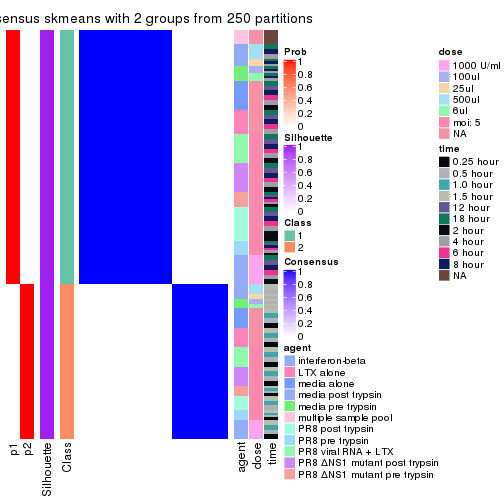
consensus_heatmap(res, k = 3)
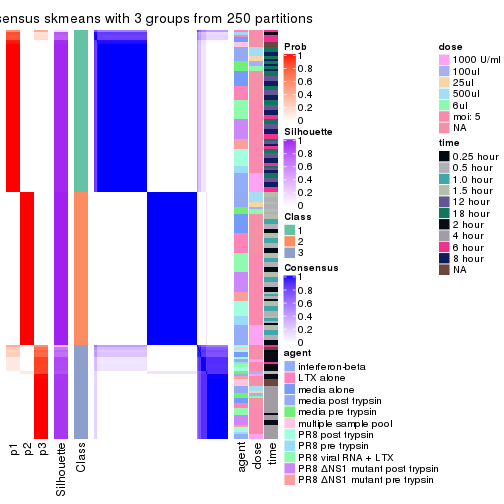
consensus_heatmap(res, k = 4)
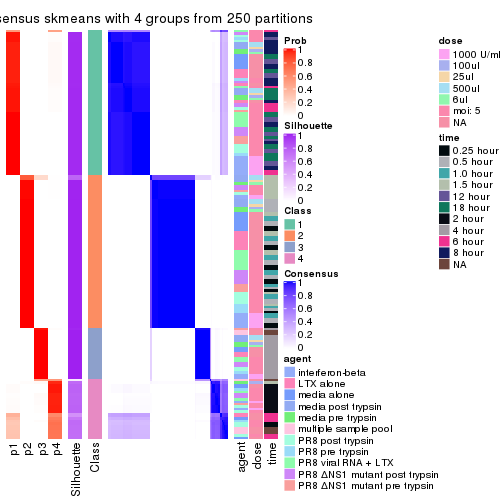
consensus_heatmap(res, k = 5)
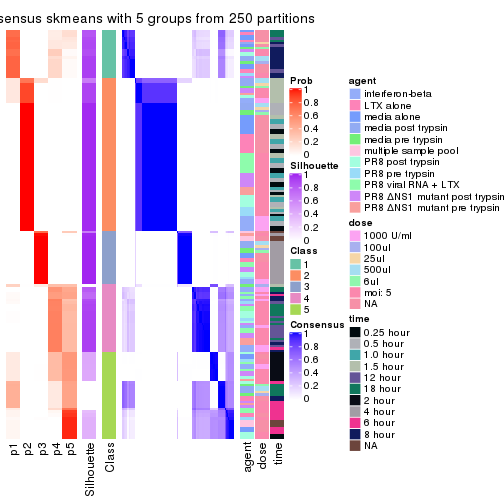
consensus_heatmap(res, k = 6)
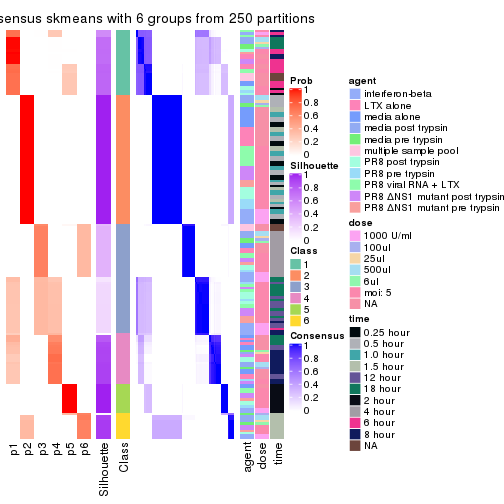
Heatmaps for the membership of samples in all partitions to see how consistent they are:
membership_heatmap(res, k = 2)
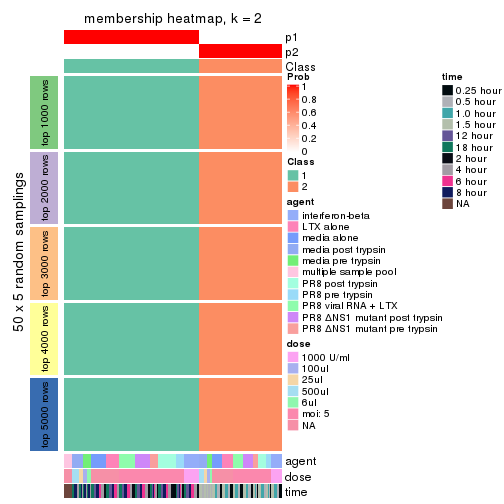
membership_heatmap(res, k = 3)
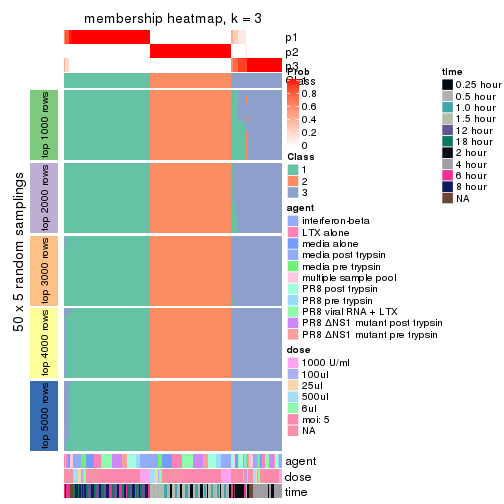
membership_heatmap(res, k = 4)
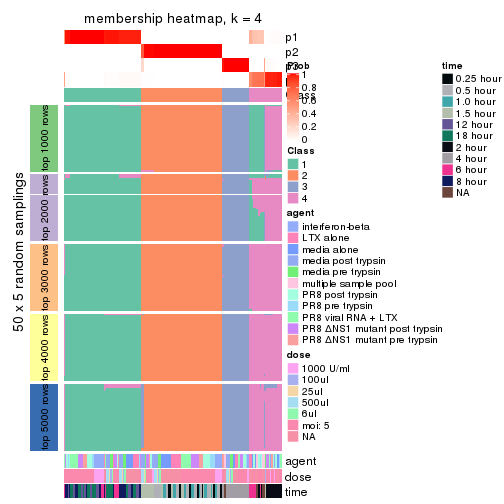
membership_heatmap(res, k = 5)
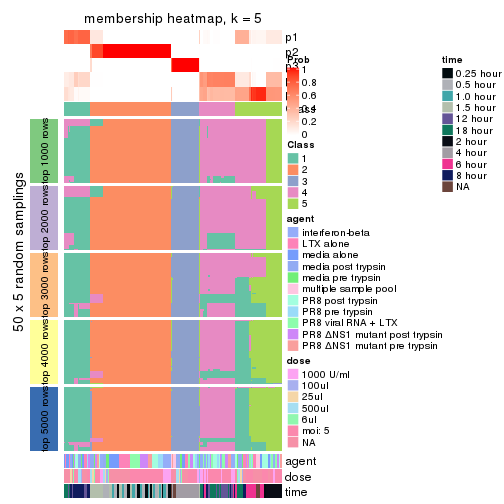
membership_heatmap(res, k = 6)
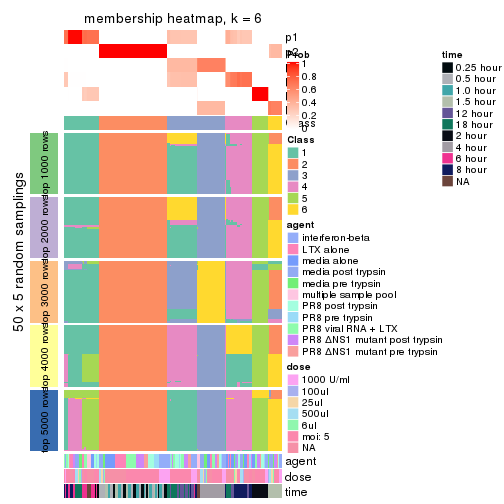
As soon as we have had the classes for columns, we can look for signatures which are significantly different between classes which can be candidate marks for certain classes. Following are the heatmaps for signatures.
Signature heatmaps where rows are scaled:
get_signatures(res, k = 2)
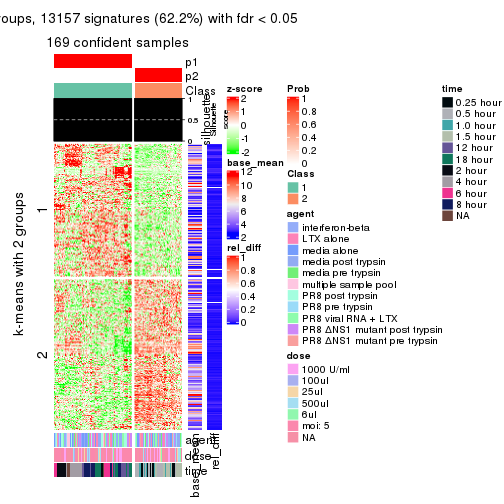
get_signatures(res, k = 3)
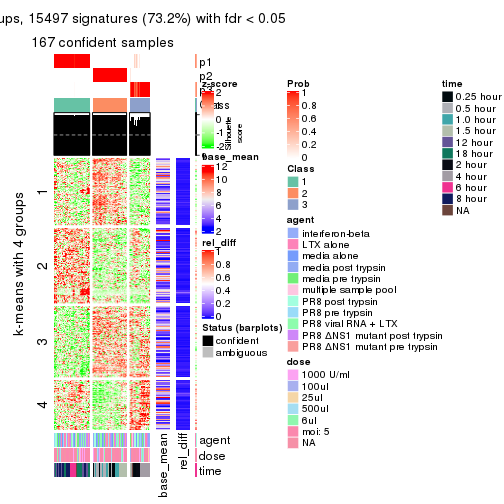
get_signatures(res, k = 4)
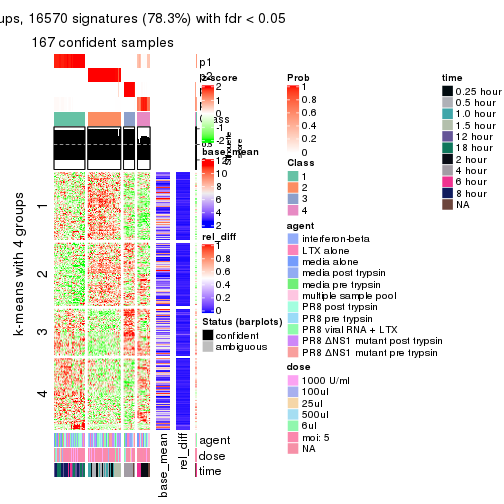
get_signatures(res, k = 5)
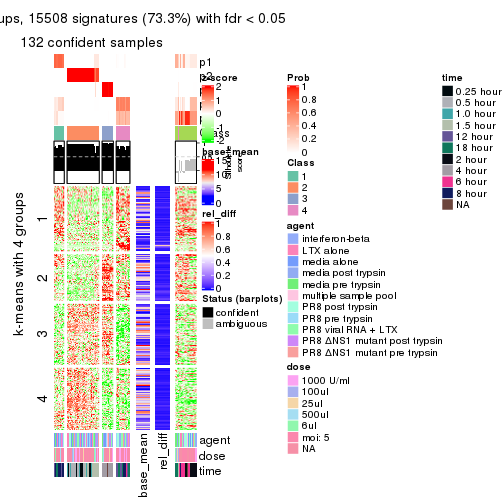
get_signatures(res, k = 6)
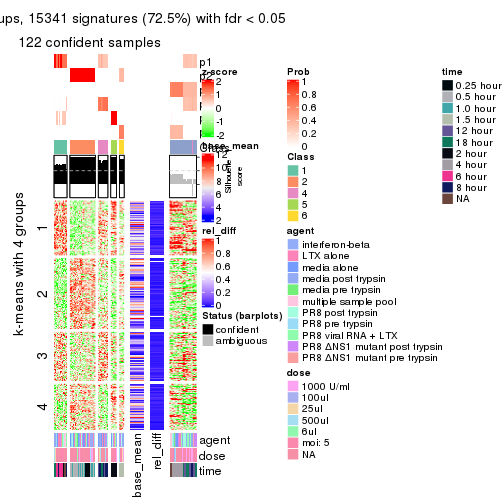
Signature heatmaps where rows are not scaled:
get_signatures(res, k = 2, scale_rows = FALSE)
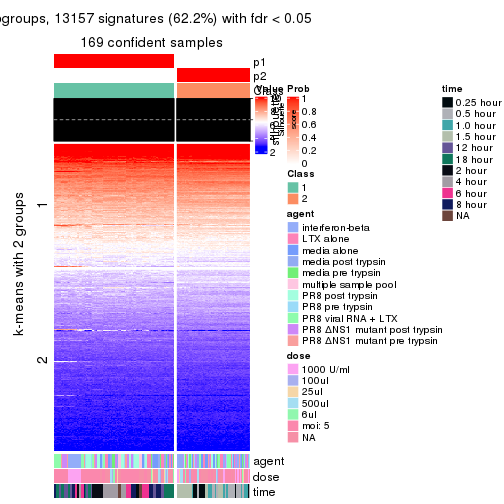
get_signatures(res, k = 3, scale_rows = FALSE)
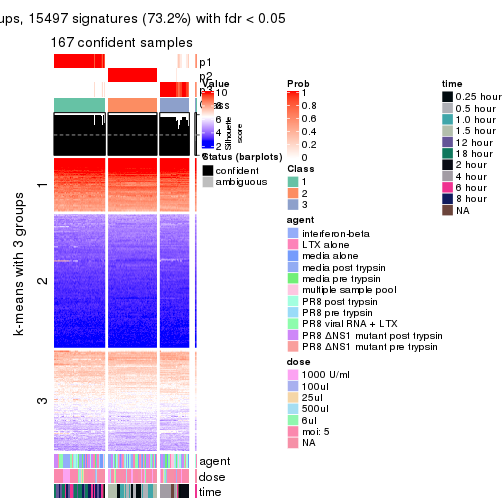
get_signatures(res, k = 4, scale_rows = FALSE)
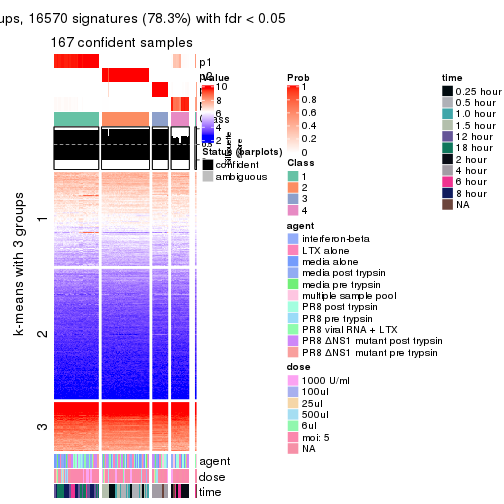
get_signatures(res, k = 5, scale_rows = FALSE)
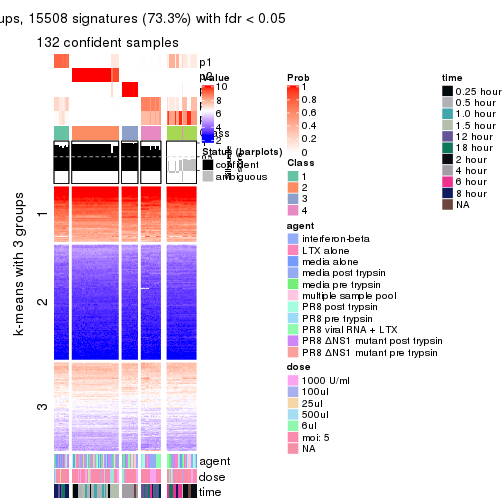
get_signatures(res, k = 6, scale_rows = FALSE)
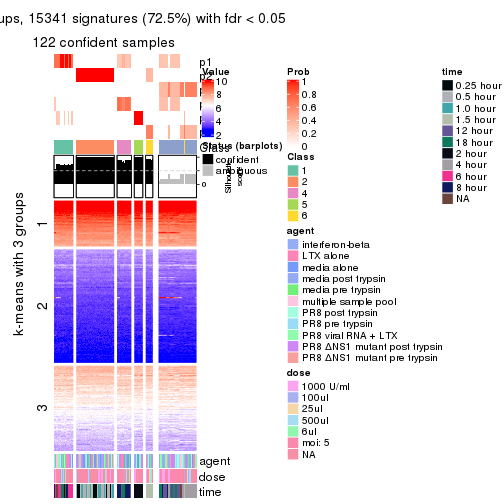
Compare the overlap of signatures from different k:
compare_signatures(res)
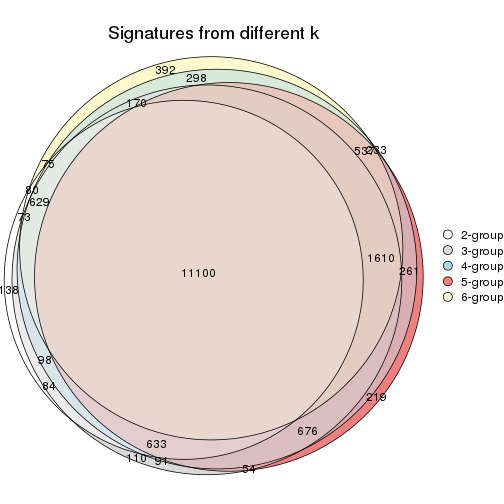
get_signature() returns a data frame invisibly. TO get the list of signatures, the function
call should be assigned to a variable explicitly. In following code, if plot argument is set
to FALSE, no heatmap is plotted while only the differential analysis is performed.
# code only for demonstration
tb = get_signature(res, k = ..., plot = FALSE)
An example of the output of tb is:
#> which_row fdr mean_1 mean_2 scaled_mean_1 scaled_mean_2 km
#> 1 38 0.042760348 8.373488 9.131774 -0.5533452 0.5164555 1
#> 2 40 0.018707592 7.106213 8.469186 -0.6173731 0.5762149 1
#> 3 55 0.019134737 10.221463 11.207825 -0.6159697 0.5749050 1
#> 4 59 0.006059896 5.921854 7.869574 -0.6899429 0.6439467 1
#> 5 60 0.018055526 8.928898 10.211722 -0.6204761 0.5791110 1
#> 6 98 0.009384629 15.714769 14.887706 0.6635654 -0.6193277 2
...
The columns in tb are:
which_row: row indices corresponding to the input matrix.fdr: FDR for the differential test. mean_x: The mean value in group x.scaled_mean_x: The mean value in group x after rows are scaled.km: Row groups if k-means clustering is applied to rows.UMAP plot which shows how samples are separated.
dimension_reduction(res, k = 2, method = "UMAP")
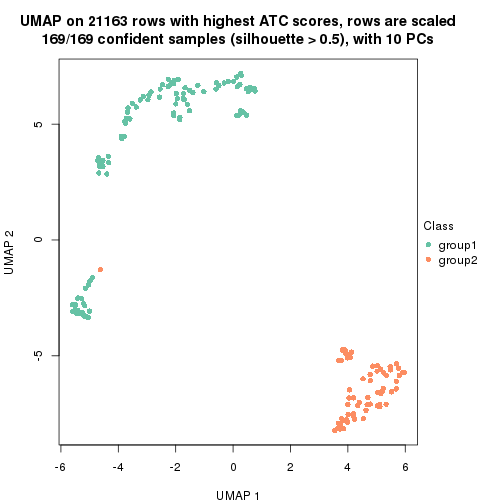
dimension_reduction(res, k = 3, method = "UMAP")
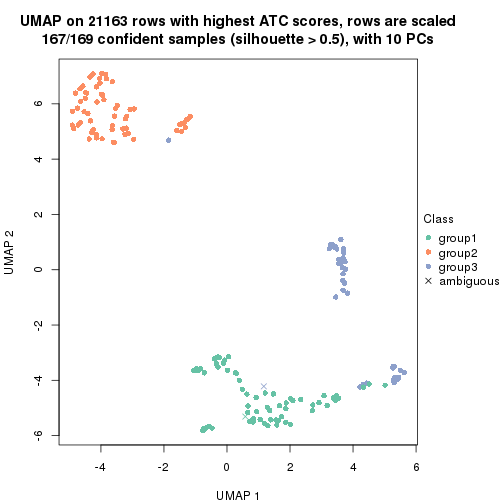
dimension_reduction(res, k = 4, method = "UMAP")
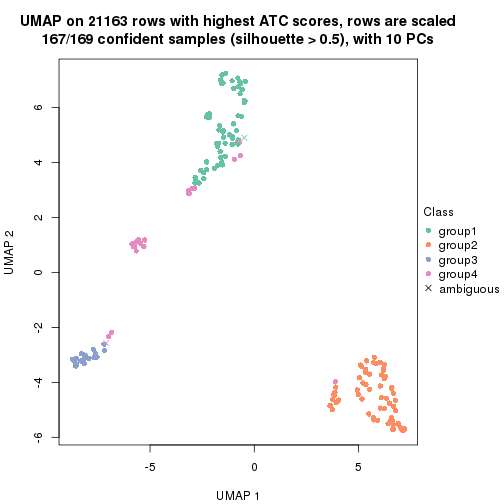
dimension_reduction(res, k = 5, method = "UMAP")
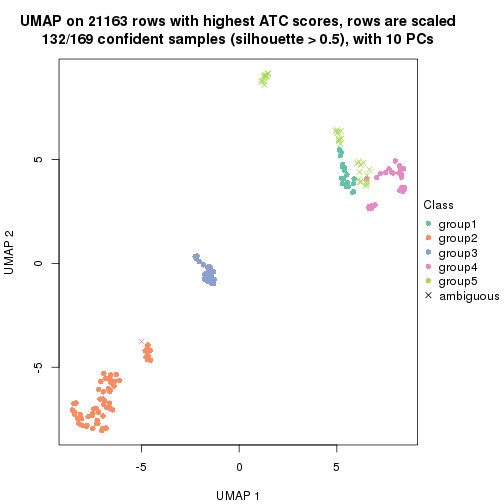
dimension_reduction(res, k = 6, method = "UMAP")
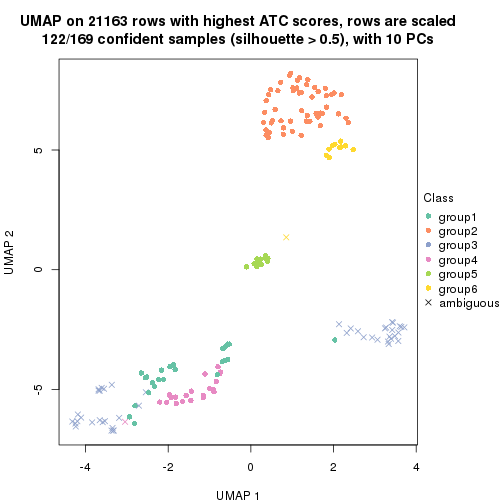
Following heatmap shows how subgroups are split when increasing k:
collect_classes(res)
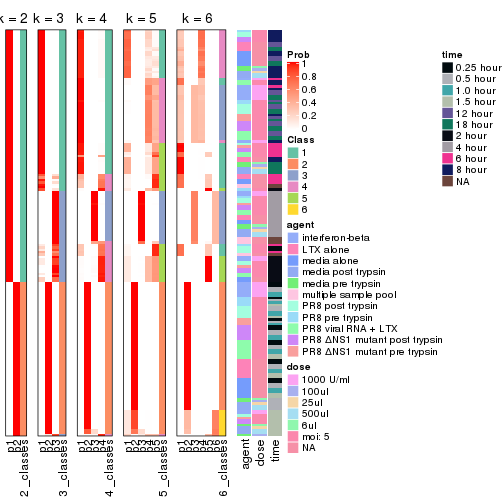
Test correlation between subgroups and known annotations. If the known annotation is numeric, one-way ANOVA test is applied, and if the known annotation is discrete, chi-squared contingency table test is applied.
test_to_known_factors(res)
#> n agent(p) dose(p) time(p) k
#> ATC:skmeans 169 0.90691 1.000 1.43e-29 2
#> ATC:skmeans 167 0.95762 1.000 1.87e-50 3
#> ATC:skmeans 167 0.82442 0.983 1.59e-71 4
#> ATC:skmeans 132 0.00783 0.017 7.76e-46 5
#> ATC:skmeans 122 0.30726 0.396 2.32e-54 6
If matrix rows can be associated to genes, consider to use functional_enrichment(res,
...) to perform function enrichment for the signature genes. See this vignette for more detailed explanations.
The object with results only for a single top-value method and a single partition method can be extracted as:
res = res_list["ATC", "pam"]
# you can also extract it by
# res = res_list["ATC:pam"]
A summary of res and all the functions that can be applied to it:
res
#> A 'ConsensusPartition' object with k = 2, 3, 4, 5, 6.
#> On a matrix with 21163 rows and 169 columns.
#> Top rows (1000, 2000, 3000, 4000, 5000) are extracted by 'ATC' method.
#> Subgroups are detected by 'pam' method.
#> Performed in total 1250 partitions by row resampling.
#> Best k for subgroups seems to be 2.
#>
#> Following methods can be applied to this 'ConsensusPartition' object:
#> [1] "cola_report" "collect_classes" "collect_plots"
#> [4] "collect_stats" "colnames" "compare_signatures"
#> [7] "consensus_heatmap" "dimension_reduction" "functional_enrichment"
#> [10] "get_anno_col" "get_anno" "get_classes"
#> [13] "get_consensus" "get_matrix" "get_membership"
#> [16] "get_param" "get_signatures" "get_stats"
#> [19] "is_best_k" "is_stable_k" "membership_heatmap"
#> [22] "ncol" "nrow" "plot_ecdf"
#> [25] "rownames" "select_partition_number" "show"
#> [28] "suggest_best_k" "test_to_known_factors"
collect_plots() function collects all the plots made from res for all k (number of partitions)
into one single page to provide an easy and fast comparison between different k.
collect_plots(res)
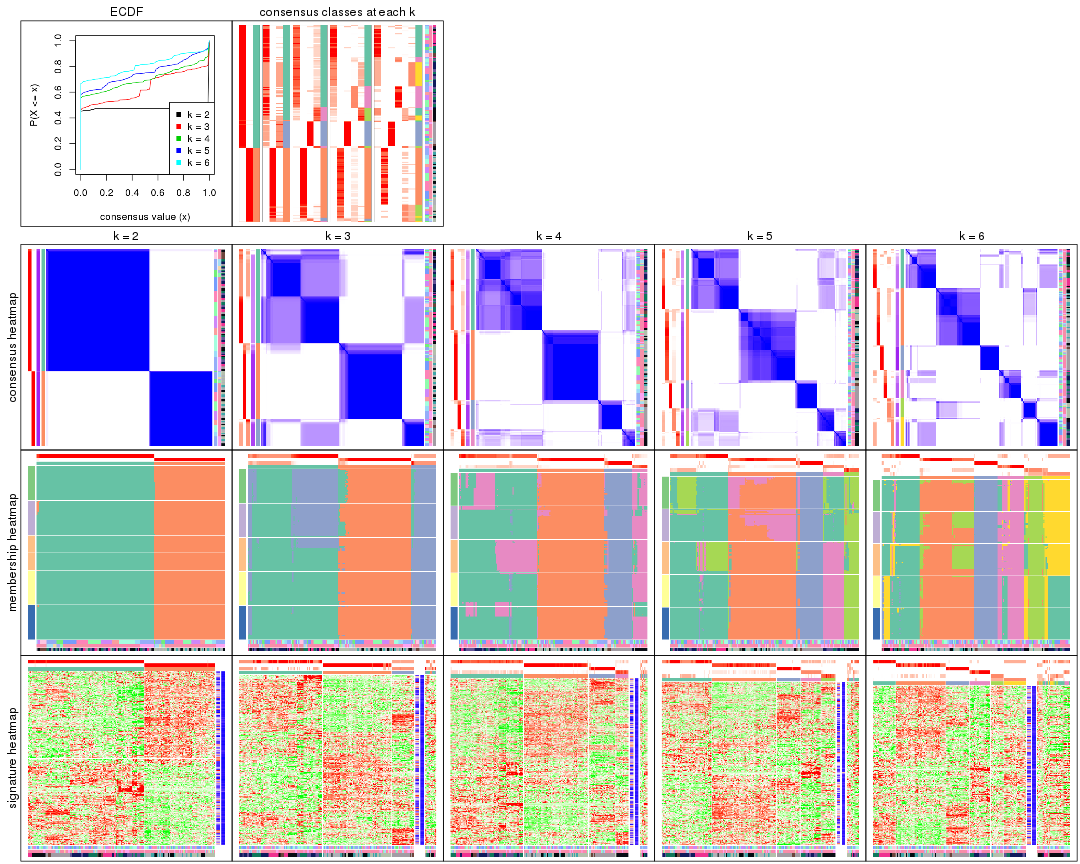
The plots are:
k and the heatmap of
predicted classes for each k.k.k.k.All the plots in panels can be made by individual functions and they are plotted later in this section.
select_partition_number() produces several plots showing different
statistics for choosing “optimized” k. There are following statistics:
k;k, the area increased is defined as \(A_k - A_{k-1}\).The detailed explanations of these statistics can be found in the cola vignette.
Generally speaking, lower PAC score, higher mean silhouette score or higher
concordance corresponds to better partition. Rand index and Jaccard index
measure how similar the current partition is compared to partition with k-1.
If they are too similar, we won't accept k is better than k-1.
select_partition_number(res)
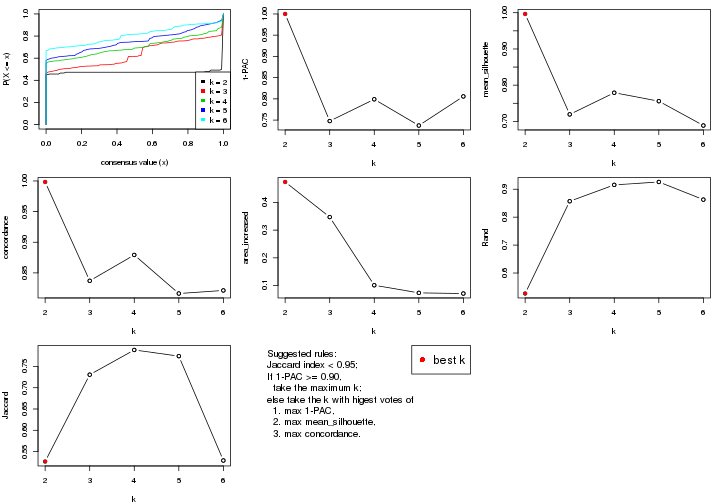
The numeric values for all these statistics can be obtained by get_stats().
get_stats(res)
#> k 1-PAC mean_silhouette concordance area_increased Rand Jaccard
#> 2 2 1.000 0.997 0.998 0.4740 0.527 0.527
#> 3 3 0.748 0.719 0.837 0.3472 0.857 0.731
#> 4 4 0.799 0.779 0.879 0.1008 0.916 0.789
#> 5 5 0.737 0.756 0.816 0.0733 0.926 0.774
#> 6 6 0.806 0.689 0.821 0.0709 0.863 0.529
suggest_best_k() suggests the best \(k\) based on these statistics. The rules are as follows:
suggest_best_k(res)
#> [1] 2
Following shows the table of the partitions (You need to click the show/hide
code output link to see it). The membership matrix (columns with name p*)
is inferred by
clue::cl_consensus()
function with the SE method. Basically the value in the membership matrix
represents the probability to belong to a certain group. The finall class
label for an item is determined with the group with highest probability it
belongs to.
In get_classes() function, the entropy is calculated from the membership
matrix and the silhouette score is calculated from the consensus matrix.
cbind(get_classes(res, k = 2), get_membership(res, k = 2))
#> class entropy silhouette p1 p2
#> GSM528681 2 0.0000 0.998 0.000 1.000
#> GSM528682 2 0.0000 0.998 0.000 1.000
#> GSM528683 2 0.0000 0.998 0.000 1.000
#> GSM528684 2 0.0000 0.998 0.000 1.000
#> GSM528687 2 0.0000 0.998 0.000 1.000
#> GSM528688 2 0.0000 0.998 0.000 1.000
#> GSM528685 2 0.0000 0.998 0.000 1.000
#> GSM528686 2 0.0000 0.998 0.000 1.000
#> GSM528693 1 0.0000 0.998 1.000 0.000
#> GSM528694 1 0.0000 0.998 1.000 0.000
#> GSM528695 1 0.0000 0.998 1.000 0.000
#> GSM528696 1 0.0000 0.998 1.000 0.000
#> GSM528697 1 0.0000 0.998 1.000 0.000
#> GSM528698 1 0.0000 0.998 1.000 0.000
#> GSM528699 1 0.0000 0.998 1.000 0.000
#> GSM528700 1 0.0000 0.998 1.000 0.000
#> GSM528689 1 0.0000 0.998 1.000 0.000
#> GSM528690 1 0.0000 0.998 1.000 0.000
#> GSM528691 1 0.0000 0.998 1.000 0.000
#> GSM528692 1 0.0000 0.998 1.000 0.000
#> GSM528779 2 0.0000 0.998 0.000 1.000
#> GSM528780 2 0.0000 0.998 0.000 1.000
#> GSM528782 2 0.0000 0.998 0.000 1.000
#> GSM528781 2 0.0000 0.998 0.000 1.000
#> GSM528785 1 0.0000 0.998 1.000 0.000
#> GSM528786 1 0.4022 0.914 0.920 0.080
#> GSM528787 1 0.0000 0.998 1.000 0.000
#> GSM528788 1 0.0000 0.998 1.000 0.000
#> GSM528783 1 0.0000 0.998 1.000 0.000
#> GSM528784 1 0.0000 0.998 1.000 0.000
#> GSM528759 1 0.0000 0.998 1.000 0.000
#> GSM528760 1 0.0000 0.998 1.000 0.000
#> GSM528761 2 0.0000 0.998 0.000 1.000
#> GSM528762 2 0.0000 0.998 0.000 1.000
#> GSM528765 2 0.0000 0.998 0.000 1.000
#> GSM528766 2 0.0000 0.998 0.000 1.000
#> GSM528763 2 0.0000 0.998 0.000 1.000
#> GSM528764 2 0.0000 0.998 0.000 1.000
#> GSM528771 1 0.0000 0.998 1.000 0.000
#> GSM528772 1 0.0000 0.998 1.000 0.000
#> GSM528773 1 0.0000 0.998 1.000 0.000
#> GSM528774 1 0.0000 0.998 1.000 0.000
#> GSM528775 1 0.0000 0.998 1.000 0.000
#> GSM528776 1 0.0000 0.998 1.000 0.000
#> GSM528777 1 0.0000 0.998 1.000 0.000
#> GSM528778 1 0.0000 0.998 1.000 0.000
#> GSM528767 1 0.0000 0.998 1.000 0.000
#> GSM528768 1 0.0000 0.998 1.000 0.000
#> GSM528769 1 0.0000 0.998 1.000 0.000
#> GSM528770 1 0.0000 0.998 1.000 0.000
#> GSM528671 2 0.0000 0.998 0.000 1.000
#> GSM528672 2 0.0000 0.998 0.000 1.000
#> GSM528674 2 0.0000 0.998 0.000 1.000
#> GSM528673 2 0.0000 0.998 0.000 1.000
#> GSM528677 1 0.0000 0.998 1.000 0.000
#> GSM528678 1 0.0000 0.998 1.000 0.000
#> GSM528679 1 0.0000 0.998 1.000 0.000
#> GSM528680 1 0.0000 0.998 1.000 0.000
#> GSM528675 1 0.0000 0.998 1.000 0.000
#> GSM528676 1 0.0000 0.998 1.000 0.000
#> GSM528651 2 0.0000 0.998 0.000 1.000
#> GSM528652 2 0.0000 0.998 0.000 1.000
#> GSM528653 2 0.0000 0.998 0.000 1.000
#> GSM528654 2 0.0000 0.998 0.000 1.000
#> GSM528657 2 0.0000 0.998 0.000 1.000
#> GSM528658 2 0.0000 0.998 0.000 1.000
#> GSM528655 2 0.0000 0.998 0.000 1.000
#> GSM528656 2 0.0000 0.998 0.000 1.000
#> GSM528663 1 0.0938 0.987 0.988 0.012
#> GSM528664 1 0.4022 0.914 0.920 0.080
#> GSM528665 1 0.0000 0.998 1.000 0.000
#> GSM528666 1 0.0000 0.998 1.000 0.000
#> GSM528667 1 0.0000 0.998 1.000 0.000
#> GSM528668 1 0.0000 0.998 1.000 0.000
#> GSM528669 1 0.0000 0.998 1.000 0.000
#> GSM528670 1 0.0000 0.998 1.000 0.000
#> GSM528659 1 0.0000 0.998 1.000 0.000
#> GSM528660 1 0.0000 0.998 1.000 0.000
#> GSM528661 1 0.0000 0.998 1.000 0.000
#> GSM528662 1 0.0000 0.998 1.000 0.000
#> GSM528701 2 0.0000 0.998 0.000 1.000
#> GSM528702 2 0.0000 0.998 0.000 1.000
#> GSM528703 2 0.0000 0.998 0.000 1.000
#> GSM528704 2 0.0000 0.998 0.000 1.000
#> GSM528707 2 0.0000 0.998 0.000 1.000
#> GSM528708 2 0.0000 0.998 0.000 1.000
#> GSM528705 2 0.0000 0.998 0.000 1.000
#> GSM528706 2 0.0000 0.998 0.000 1.000
#> GSM528713 1 0.0000 0.998 1.000 0.000
#> GSM528714 1 0.0000 0.998 1.000 0.000
#> GSM528715 1 0.0000 0.998 1.000 0.000
#> GSM528716 1 0.0000 0.998 1.000 0.000
#> GSM528717 1 0.0000 0.998 1.000 0.000
#> GSM528718 1 0.0000 0.998 1.000 0.000
#> GSM528719 1 0.0000 0.998 1.000 0.000
#> GSM528720 1 0.0000 0.998 1.000 0.000
#> GSM528709 1 0.0000 0.998 1.000 0.000
#> GSM528710 1 0.0000 0.998 1.000 0.000
#> GSM528711 1 0.0000 0.998 1.000 0.000
#> GSM528712 1 0.0000 0.998 1.000 0.000
#> GSM528721 2 0.0000 0.998 0.000 1.000
#> GSM528722 2 0.0000 0.998 0.000 1.000
#> GSM528723 2 0.0000 0.998 0.000 1.000
#> GSM528724 2 0.0000 0.998 0.000 1.000
#> GSM528727 2 0.0000 0.998 0.000 1.000
#> GSM528728 2 0.0000 0.998 0.000 1.000
#> GSM528725 2 0.0000 0.998 0.000 1.000
#> GSM528726 2 0.0000 0.998 0.000 1.000
#> GSM528733 1 0.0000 0.998 1.000 0.000
#> GSM528734 1 0.0000 0.998 1.000 0.000
#> GSM528735 1 0.0000 0.998 1.000 0.000
#> GSM528736 1 0.0000 0.998 1.000 0.000
#> GSM528737 1 0.0000 0.998 1.000 0.000
#> GSM528738 1 0.0000 0.998 1.000 0.000
#> GSM528729 1 0.0000 0.998 1.000 0.000
#> GSM528730 1 0.0000 0.998 1.000 0.000
#> GSM528731 1 0.0000 0.998 1.000 0.000
#> GSM528732 1 0.0000 0.998 1.000 0.000
#> GSM528739 2 0.0000 0.998 0.000 1.000
#> GSM528740 2 0.0000 0.998 0.000 1.000
#> GSM528741 2 0.0000 0.998 0.000 1.000
#> GSM528742 2 0.0000 0.998 0.000 1.000
#> GSM528745 2 0.0000 0.998 0.000 1.000
#> GSM528746 2 0.0000 0.998 0.000 1.000
#> GSM528743 2 0.0000 0.998 0.000 1.000
#> GSM528744 2 0.0000 0.998 0.000 1.000
#> GSM528751 1 0.0000 0.998 1.000 0.000
#> GSM528752 1 0.0000 0.998 1.000 0.000
#> GSM528753 1 0.0000 0.998 1.000 0.000
#> GSM528754 1 0.0000 0.998 1.000 0.000
#> GSM528755 1 0.0000 0.998 1.000 0.000
#> GSM528756 1 0.0000 0.998 1.000 0.000
#> GSM528757 1 0.0000 0.998 1.000 0.000
#> GSM528758 1 0.0000 0.998 1.000 0.000
#> GSM528747 1 0.0000 0.998 1.000 0.000
#> GSM528748 1 0.0000 0.998 1.000 0.000
#> GSM528749 1 0.0000 0.998 1.000 0.000
#> GSM528750 1 0.0000 0.998 1.000 0.000
#> GSM528640 2 0.0000 0.998 0.000 1.000
#> GSM528641 2 0.0000 0.998 0.000 1.000
#> GSM528643 1 0.0000 0.998 1.000 0.000
#> GSM528644 1 0.0000 0.998 1.000 0.000
#> GSM528642 1 0.0000 0.998 1.000 0.000
#> GSM528620 2 0.0000 0.998 0.000 1.000
#> GSM528621 2 0.4939 0.878 0.108 0.892
#> GSM528623 1 0.0000 0.998 1.000 0.000
#> GSM528624 1 0.0000 0.998 1.000 0.000
#> GSM528622 1 0.0000 0.998 1.000 0.000
#> GSM528625 2 0.0000 0.998 0.000 1.000
#> GSM528626 2 0.0000 0.998 0.000 1.000
#> GSM528628 1 0.0000 0.998 1.000 0.000
#> GSM528629 1 0.0000 0.998 1.000 0.000
#> GSM528627 1 0.0000 0.998 1.000 0.000
#> GSM528630 2 0.0000 0.998 0.000 1.000
#> GSM528631 2 0.0000 0.998 0.000 1.000
#> GSM528632 2 0.0000 0.998 0.000 1.000
#> GSM528633 2 0.0000 0.998 0.000 1.000
#> GSM528636 1 0.0000 0.998 1.000 0.000
#> GSM528637 1 0.0000 0.998 1.000 0.000
#> GSM528638 1 0.0000 0.998 1.000 0.000
#> GSM528639 1 0.0000 0.998 1.000 0.000
#> GSM528634 1 0.0000 0.998 1.000 0.000
#> GSM528635 1 0.0000 0.998 1.000 0.000
#> GSM528645 1 0.0000 0.998 1.000 0.000
#> GSM528646 1 0.0000 0.998 1.000 0.000
#> GSM528647 1 0.0000 0.998 1.000 0.000
#> GSM528648 1 0.0000 0.998 1.000 0.000
#> GSM528649 1 0.0000 0.998 1.000 0.000
#> GSM528650 1 0.0000 0.998 1.000 0.000
cbind(get_classes(res, k = 3), get_membership(res, k = 3))
#> class entropy silhouette p1 p2 p3
#> GSM528681 2 0.0000 0.956 0.000 1.000 0.000
#> GSM528682 2 0.0000 0.956 0.000 1.000 0.000
#> GSM528683 2 0.0000 0.956 0.000 1.000 0.000
#> GSM528684 2 0.0000 0.956 0.000 1.000 0.000
#> GSM528687 2 0.0000 0.956 0.000 1.000 0.000
#> GSM528688 2 0.0000 0.956 0.000 1.000 0.000
#> GSM528685 2 0.0000 0.956 0.000 1.000 0.000
#> GSM528686 2 0.2959 0.872 0.000 0.900 0.100
#> GSM528693 1 0.0000 0.602 1.000 0.000 0.000
#> GSM528694 1 0.0000 0.602 1.000 0.000 0.000
#> GSM528695 3 0.6280 0.899 0.460 0.000 0.540
#> GSM528696 3 0.6280 0.899 0.460 0.000 0.540
#> GSM528697 1 0.6280 0.613 0.540 0.000 0.460
#> GSM528698 1 0.0000 0.602 1.000 0.000 0.000
#> GSM528699 1 0.6280 0.613 0.540 0.000 0.460
#> GSM528700 1 0.6280 0.613 0.540 0.000 0.460
#> GSM528689 1 0.0592 0.603 0.988 0.000 0.012
#> GSM528690 1 0.6280 0.613 0.540 0.000 0.460
#> GSM528691 1 0.0000 0.602 1.000 0.000 0.000
#> GSM528692 1 0.6126 -0.637 0.600 0.000 0.400
#> GSM528779 2 0.0000 0.956 0.000 1.000 0.000
#> GSM528780 2 0.0000 0.956 0.000 1.000 0.000
#> GSM528782 2 0.0000 0.956 0.000 1.000 0.000
#> GSM528781 2 0.0000 0.956 0.000 1.000 0.000
#> GSM528785 1 0.6280 0.613 0.540 0.000 0.460
#> GSM528786 3 0.2261 0.382 0.068 0.000 0.932
#> GSM528787 1 0.5706 -0.417 0.680 0.000 0.320
#> GSM528788 1 0.6280 0.613 0.540 0.000 0.460
#> GSM528783 1 0.6008 0.614 0.628 0.000 0.372
#> GSM528784 1 0.0237 0.602 0.996 0.000 0.004
#> GSM528759 1 0.0000 0.602 1.000 0.000 0.000
#> GSM528760 1 0.0000 0.602 1.000 0.000 0.000
#> GSM528761 2 0.0000 0.956 0.000 1.000 0.000
#> GSM528762 2 0.0000 0.956 0.000 1.000 0.000
#> GSM528765 2 0.0000 0.956 0.000 1.000 0.000
#> GSM528766 2 0.0000 0.956 0.000 1.000 0.000
#> GSM528763 2 0.4291 0.792 0.000 0.820 0.180
#> GSM528764 2 0.0424 0.950 0.000 0.992 0.008
#> GSM528771 1 0.6180 0.610 0.584 0.000 0.416
#> GSM528772 1 0.4784 0.593 0.796 0.004 0.200
#> GSM528773 3 0.6280 0.899 0.460 0.000 0.540
#> GSM528774 3 0.6280 0.899 0.460 0.000 0.540
#> GSM528775 1 0.0000 0.602 1.000 0.000 0.000
#> GSM528776 1 0.0000 0.602 1.000 0.000 0.000
#> GSM528777 1 0.6280 0.613 0.540 0.000 0.460
#> GSM528778 1 0.6280 0.613 0.540 0.000 0.460
#> GSM528767 1 0.5327 0.612 0.728 0.000 0.272
#> GSM528768 1 0.0000 0.602 1.000 0.000 0.000
#> GSM528769 1 0.0892 0.603 0.980 0.000 0.020
#> GSM528770 1 0.0000 0.602 1.000 0.000 0.000
#> GSM528671 2 0.0000 0.956 0.000 1.000 0.000
#> GSM528672 2 0.0000 0.956 0.000 1.000 0.000
#> GSM528674 2 0.0000 0.956 0.000 1.000 0.000
#> GSM528673 2 0.0000 0.956 0.000 1.000 0.000
#> GSM528677 1 0.6299 -0.797 0.524 0.000 0.476
#> GSM528678 3 0.6280 0.899 0.460 0.000 0.540
#> GSM528679 1 0.0000 0.602 1.000 0.000 0.000
#> GSM528680 1 0.6280 0.613 0.540 0.000 0.460
#> GSM528675 1 0.5216 0.611 0.740 0.000 0.260
#> GSM528676 1 0.3038 0.607 0.896 0.000 0.104
#> GSM528651 2 0.0000 0.956 0.000 1.000 0.000
#> GSM528652 2 0.0000 0.956 0.000 1.000 0.000
#> GSM528653 2 0.0000 0.956 0.000 1.000 0.000
#> GSM528654 2 0.0000 0.956 0.000 1.000 0.000
#> GSM528657 2 0.0000 0.956 0.000 1.000 0.000
#> GSM528658 2 0.0000 0.956 0.000 1.000 0.000
#> GSM528655 2 0.3686 0.833 0.000 0.860 0.140
#> GSM528656 2 0.0000 0.956 0.000 1.000 0.000
#> GSM528663 3 0.4995 0.299 0.144 0.032 0.824
#> GSM528664 2 0.9428 0.164 0.176 0.428 0.396
#> GSM528665 3 0.6280 0.899 0.460 0.000 0.540
#> GSM528666 3 0.6280 0.899 0.460 0.000 0.540
#> GSM528667 1 0.0000 0.602 1.000 0.000 0.000
#> GSM528668 1 0.2261 0.604 0.932 0.000 0.068
#> GSM528669 1 0.6280 0.613 0.540 0.000 0.460
#> GSM528670 1 0.6280 0.613 0.540 0.000 0.460
#> GSM528659 1 0.6280 0.613 0.540 0.000 0.460
#> GSM528660 1 0.6280 0.613 0.540 0.000 0.460
#> GSM528661 1 0.0000 0.602 1.000 0.000 0.000
#> GSM528662 1 0.0000 0.602 1.000 0.000 0.000
#> GSM528701 2 0.0000 0.956 0.000 1.000 0.000
#> GSM528702 2 0.0000 0.956 0.000 1.000 0.000
#> GSM528703 2 0.0000 0.956 0.000 1.000 0.000
#> GSM528704 2 0.0000 0.956 0.000 1.000 0.000
#> GSM528707 2 0.0000 0.956 0.000 1.000 0.000
#> GSM528708 2 0.0000 0.956 0.000 1.000 0.000
#> GSM528705 2 0.0000 0.956 0.000 1.000 0.000
#> GSM528706 2 0.0000 0.956 0.000 1.000 0.000
#> GSM528713 1 0.0000 0.602 1.000 0.000 0.000
#> GSM528714 1 0.6299 -0.797 0.524 0.000 0.476
#> GSM528715 3 0.6079 0.810 0.388 0.000 0.612
#> GSM528716 3 0.6280 0.899 0.460 0.000 0.540
#> GSM528717 1 0.0000 0.602 1.000 0.000 0.000
#> GSM528718 1 0.0000 0.602 1.000 0.000 0.000
#> GSM528719 1 0.0000 0.602 1.000 0.000 0.000
#> GSM528720 1 0.0000 0.602 1.000 0.000 0.000
#> GSM528709 1 0.0000 0.602 1.000 0.000 0.000
#> GSM528710 1 0.6280 0.613 0.540 0.000 0.460
#> GSM528711 1 0.0000 0.602 1.000 0.000 0.000
#> GSM528712 1 0.0000 0.602 1.000 0.000 0.000
#> GSM528721 2 0.0000 0.956 0.000 1.000 0.000
#> GSM528722 2 0.0000 0.956 0.000 1.000 0.000
#> GSM528723 2 0.0000 0.956 0.000 1.000 0.000
#> GSM528724 2 0.0000 0.956 0.000 1.000 0.000
#> GSM528727 2 0.0000 0.956 0.000 1.000 0.000
#> GSM528728 2 0.0000 0.956 0.000 1.000 0.000
#> GSM528725 2 0.0000 0.956 0.000 1.000 0.000
#> GSM528726 2 0.0000 0.956 0.000 1.000 0.000
#> GSM528733 3 0.6280 0.899 0.460 0.000 0.540
#> GSM528734 3 0.6260 0.886 0.448 0.000 0.552
#> GSM528735 1 0.0000 0.602 1.000 0.000 0.000
#> GSM528736 1 0.0000 0.602 1.000 0.000 0.000
#> GSM528737 1 0.6280 0.613 0.540 0.000 0.460
#> GSM528738 1 0.5363 0.612 0.724 0.000 0.276
#> GSM528729 1 0.6280 0.613 0.540 0.000 0.460
#> GSM528730 1 0.6280 0.613 0.540 0.000 0.460
#> GSM528731 1 0.6280 0.613 0.540 0.000 0.460
#> GSM528732 1 0.6280 0.613 0.540 0.000 0.460
#> GSM528739 2 0.0000 0.956 0.000 1.000 0.000
#> GSM528740 2 0.0000 0.956 0.000 1.000 0.000
#> GSM528741 2 0.0000 0.956 0.000 1.000 0.000
#> GSM528742 2 0.0000 0.956 0.000 1.000 0.000
#> GSM528745 2 0.0000 0.956 0.000 1.000 0.000
#> GSM528746 2 0.0000 0.956 0.000 1.000 0.000
#> GSM528743 2 0.0000 0.956 0.000 1.000 0.000
#> GSM528744 2 0.0000 0.956 0.000 1.000 0.000
#> GSM528751 1 0.6225 0.611 0.568 0.000 0.432
#> GSM528752 1 0.0000 0.602 1.000 0.000 0.000
#> GSM528753 3 0.6280 0.899 0.460 0.000 0.540
#> GSM528754 3 0.6280 0.899 0.460 0.000 0.540
#> GSM528755 1 0.0000 0.602 1.000 0.000 0.000
#> GSM528756 1 0.0000 0.602 1.000 0.000 0.000
#> GSM528757 1 0.6280 0.613 0.540 0.000 0.460
#> GSM528758 1 0.6280 0.613 0.540 0.000 0.460
#> GSM528747 1 0.6280 0.613 0.540 0.000 0.460
#> GSM528748 1 0.6280 0.613 0.540 0.000 0.460
#> GSM528749 1 0.1289 0.604 0.968 0.000 0.032
#> GSM528750 1 0.6280 0.613 0.540 0.000 0.460
#> GSM528640 2 0.0000 0.956 0.000 1.000 0.000
#> GSM528641 2 0.5560 0.656 0.000 0.700 0.300
#> GSM528643 3 0.6280 0.899 0.460 0.000 0.540
#> GSM528644 1 0.6280 0.613 0.540 0.000 0.460
#> GSM528642 1 0.4235 0.159 0.824 0.000 0.176
#> GSM528620 2 0.0000 0.956 0.000 1.000 0.000
#> GSM528621 2 0.6468 0.458 0.004 0.552 0.444
#> GSM528623 3 0.6280 0.899 0.460 0.000 0.540
#> GSM528624 1 0.6280 0.613 0.540 0.000 0.460
#> GSM528622 1 0.0000 0.602 1.000 0.000 0.000
#> GSM528625 2 0.0000 0.956 0.000 1.000 0.000
#> GSM528626 2 0.5859 0.608 0.000 0.656 0.344
#> GSM528628 3 0.0000 0.299 0.000 0.000 1.000
#> GSM528629 1 0.6280 0.613 0.540 0.000 0.460
#> GSM528627 1 0.0000 0.602 1.000 0.000 0.000
#> GSM528630 2 0.0000 0.956 0.000 1.000 0.000
#> GSM528631 2 0.0000 0.956 0.000 1.000 0.000
#> GSM528632 2 0.5968 0.584 0.000 0.636 0.364
#> GSM528633 2 0.5948 0.589 0.000 0.640 0.360
#> GSM528636 3 0.6280 0.899 0.460 0.000 0.540
#> GSM528637 3 0.6280 0.899 0.460 0.000 0.540
#> GSM528638 1 0.6280 0.613 0.540 0.000 0.460
#> GSM528639 1 0.6280 0.613 0.540 0.000 0.460
#> GSM528634 1 0.0000 0.602 1.000 0.000 0.000
#> GSM528635 1 0.0000 0.602 1.000 0.000 0.000
#> GSM528645 3 0.6280 0.899 0.460 0.000 0.540
#> GSM528646 3 0.6280 0.899 0.460 0.000 0.540
#> GSM528647 3 0.6280 0.899 0.460 0.000 0.540
#> GSM528648 1 0.0000 0.602 1.000 0.000 0.000
#> GSM528649 1 0.0000 0.602 1.000 0.000 0.000
#> GSM528650 1 0.0000 0.602 1.000 0.000 0.000
cbind(get_classes(res, k = 4), get_membership(res, k = 4))
#> class entropy silhouette p1 p2 p3 p4
#> GSM528681 2 0.0000 0.979 0.000 1.000 0.000 0.000
#> GSM528682 2 0.0000 0.979 0.000 1.000 0.000 0.000
#> GSM528683 2 0.0000 0.979 0.000 1.000 0.000 0.000
#> GSM528684 2 0.0000 0.979 0.000 1.000 0.000 0.000
#> GSM528687 2 0.0000 0.979 0.000 1.000 0.000 0.000
#> GSM528688 2 0.0000 0.979 0.000 1.000 0.000 0.000
#> GSM528685 2 0.1118 0.954 0.000 0.964 0.000 0.036
#> GSM528686 2 0.4961 0.284 0.000 0.552 0.000 0.448
#> GSM528693 4 0.3356 0.718 0.176 0.000 0.000 0.824
#> GSM528694 4 0.4477 0.485 0.312 0.000 0.000 0.688
#> GSM528695 3 0.0000 0.925 0.000 0.000 1.000 0.000
#> GSM528696 3 0.0000 0.925 0.000 0.000 1.000 0.000
#> GSM528697 1 0.0336 0.676 0.992 0.000 0.000 0.008
#> GSM528698 1 0.4454 0.680 0.692 0.000 0.000 0.308
#> GSM528699 4 0.4977 0.245 0.460 0.000 0.000 0.540
#> GSM528700 1 0.4304 0.489 0.716 0.000 0.000 0.284
#> GSM528689 1 0.4406 0.687 0.700 0.000 0.000 0.300
#> GSM528690 1 0.3356 0.602 0.824 0.000 0.000 0.176
#> GSM528691 1 0.4454 0.680 0.692 0.000 0.000 0.308
#> GSM528692 1 0.7870 0.149 0.392 0.000 0.300 0.308
#> GSM528779 2 0.0000 0.979 0.000 1.000 0.000 0.000
#> GSM528780 2 0.0000 0.979 0.000 1.000 0.000 0.000
#> GSM528782 2 0.0000 0.979 0.000 1.000 0.000 0.000
#> GSM528781 2 0.0000 0.979 0.000 1.000 0.000 0.000
#> GSM528785 4 0.4643 0.625 0.344 0.000 0.000 0.656
#> GSM528786 3 0.0000 0.925 0.000 0.000 1.000 0.000
#> GSM528787 1 0.7267 0.322 0.540 0.000 0.212 0.248
#> GSM528788 1 0.3610 0.523 0.800 0.000 0.000 0.200
#> GSM528783 1 0.1792 0.663 0.932 0.000 0.000 0.068
#> GSM528784 1 0.4382 0.684 0.704 0.000 0.000 0.296
#> GSM528759 1 0.3837 0.704 0.776 0.000 0.000 0.224
#> GSM528760 1 0.3837 0.704 0.776 0.000 0.000 0.224
#> GSM528761 2 0.0000 0.979 0.000 1.000 0.000 0.000
#> GSM528762 2 0.0000 0.979 0.000 1.000 0.000 0.000
#> GSM528765 2 0.0000 0.979 0.000 1.000 0.000 0.000
#> GSM528766 2 0.0000 0.979 0.000 1.000 0.000 0.000
#> GSM528763 2 0.2737 0.875 0.008 0.888 0.000 0.104
#> GSM528764 2 0.1305 0.952 0.000 0.960 0.004 0.036
#> GSM528771 4 0.3649 0.737 0.204 0.000 0.000 0.796
#> GSM528772 4 0.2081 0.786 0.084 0.000 0.000 0.916
#> GSM528773 3 0.0000 0.925 0.000 0.000 1.000 0.000
#> GSM528774 3 0.0000 0.925 0.000 0.000 1.000 0.000
#> GSM528775 1 0.3837 0.704 0.776 0.000 0.000 0.224
#> GSM528776 1 0.3837 0.704 0.776 0.000 0.000 0.224
#> GSM528777 1 0.3610 0.523 0.800 0.000 0.000 0.200
#> GSM528778 1 0.2704 0.596 0.876 0.000 0.000 0.124
#> GSM528767 1 0.2081 0.656 0.916 0.000 0.000 0.084
#> GSM528768 1 0.4454 0.680 0.692 0.000 0.000 0.308
#> GSM528769 1 0.4040 0.691 0.752 0.000 0.000 0.248
#> GSM528770 1 0.4454 0.680 0.692 0.000 0.000 0.308
#> GSM528671 2 0.0000 0.979 0.000 1.000 0.000 0.000
#> GSM528672 2 0.0000 0.979 0.000 1.000 0.000 0.000
#> GSM528674 2 0.0000 0.979 0.000 1.000 0.000 0.000
#> GSM528673 2 0.1118 0.954 0.000 0.964 0.000 0.036
#> GSM528677 4 0.2266 0.787 0.084 0.000 0.004 0.912
#> GSM528678 3 0.0000 0.925 0.000 0.000 1.000 0.000
#> GSM528679 1 0.3837 0.704 0.776 0.000 0.000 0.224
#> GSM528680 1 0.3528 0.592 0.808 0.000 0.000 0.192
#> GSM528675 1 0.2081 0.656 0.916 0.000 0.000 0.084
#> GSM528676 1 0.3356 0.684 0.824 0.000 0.000 0.176
#> GSM528651 2 0.1022 0.957 0.000 0.968 0.000 0.032
#> GSM528652 2 0.0000 0.979 0.000 1.000 0.000 0.000
#> GSM528653 2 0.0000 0.979 0.000 1.000 0.000 0.000
#> GSM528654 2 0.0000 0.979 0.000 1.000 0.000 0.000
#> GSM528657 2 0.0000 0.979 0.000 1.000 0.000 0.000
#> GSM528658 2 0.0000 0.979 0.000 1.000 0.000 0.000
#> GSM528655 2 0.2714 0.870 0.004 0.884 0.000 0.112
#> GSM528656 2 0.1118 0.954 0.000 0.964 0.000 0.036
#> GSM528663 4 0.2408 0.789 0.104 0.000 0.000 0.896
#> GSM528664 4 0.2466 0.789 0.096 0.004 0.000 0.900
#> GSM528665 3 0.0000 0.925 0.000 0.000 1.000 0.000
#> GSM528666 3 0.0000 0.925 0.000 0.000 1.000 0.000
#> GSM528667 1 0.3764 0.706 0.784 0.000 0.000 0.216
#> GSM528668 1 0.0817 0.684 0.976 0.000 0.000 0.024
#> GSM528669 1 0.3610 0.523 0.800 0.000 0.000 0.200
#> GSM528670 1 0.3610 0.523 0.800 0.000 0.000 0.200
#> GSM528659 1 0.3311 0.605 0.828 0.000 0.000 0.172
#> GSM528660 1 0.2081 0.656 0.916 0.000 0.000 0.084
#> GSM528661 1 0.4454 0.680 0.692 0.000 0.000 0.308
#> GSM528662 1 0.4454 0.680 0.692 0.000 0.000 0.308
#> GSM528701 2 0.0592 0.968 0.000 0.984 0.000 0.016
#> GSM528702 2 0.0000 0.979 0.000 1.000 0.000 0.000
#> GSM528703 2 0.0000 0.979 0.000 1.000 0.000 0.000
#> GSM528704 2 0.0000 0.979 0.000 1.000 0.000 0.000
#> GSM528707 2 0.0000 0.979 0.000 1.000 0.000 0.000
#> GSM528708 2 0.0000 0.979 0.000 1.000 0.000 0.000
#> GSM528705 2 0.0000 0.979 0.000 1.000 0.000 0.000
#> GSM528706 2 0.0000 0.979 0.000 1.000 0.000 0.000
#> GSM528713 4 0.3688 0.673 0.208 0.000 0.000 0.792
#> GSM528714 4 0.2775 0.779 0.084 0.000 0.020 0.896
#> GSM528715 3 0.0000 0.925 0.000 0.000 1.000 0.000
#> GSM528716 3 0.0000 0.925 0.000 0.000 1.000 0.000
#> GSM528717 1 0.3837 0.704 0.776 0.000 0.000 0.224
#> GSM528718 1 0.3837 0.704 0.776 0.000 0.000 0.224
#> GSM528719 1 0.3873 0.704 0.772 0.000 0.000 0.228
#> GSM528720 1 0.3837 0.704 0.776 0.000 0.000 0.224
#> GSM528709 1 0.4356 0.686 0.708 0.000 0.000 0.292
#> GSM528710 1 0.2345 0.650 0.900 0.000 0.000 0.100
#> GSM528711 1 0.4454 0.680 0.692 0.000 0.000 0.308
#> GSM528712 1 0.4454 0.680 0.692 0.000 0.000 0.308
#> GSM528721 2 0.0000 0.979 0.000 1.000 0.000 0.000
#> GSM528722 2 0.0000 0.979 0.000 1.000 0.000 0.000
#> GSM528723 2 0.0000 0.979 0.000 1.000 0.000 0.000
#> GSM528724 2 0.0000 0.979 0.000 1.000 0.000 0.000
#> GSM528727 2 0.0000 0.979 0.000 1.000 0.000 0.000
#> GSM528728 2 0.0000 0.979 0.000 1.000 0.000 0.000
#> GSM528725 2 0.0000 0.979 0.000 1.000 0.000 0.000
#> GSM528726 2 0.0000 0.979 0.000 1.000 0.000 0.000
#> GSM528733 3 0.0000 0.925 0.000 0.000 1.000 0.000
#> GSM528734 3 0.0000 0.925 0.000 0.000 1.000 0.000
#> GSM528735 1 0.3837 0.704 0.776 0.000 0.000 0.224
#> GSM528736 1 0.3801 0.705 0.780 0.000 0.000 0.220
#> GSM528737 1 0.0000 0.675 1.000 0.000 0.000 0.000
#> GSM528738 1 0.0000 0.675 1.000 0.000 0.000 0.000
#> GSM528729 1 0.3610 0.523 0.800 0.000 0.000 0.200
#> GSM528730 1 0.3610 0.523 0.800 0.000 0.000 0.200
#> GSM528731 1 0.3610 0.523 0.800 0.000 0.000 0.200
#> GSM528732 1 0.3610 0.523 0.800 0.000 0.000 0.200
#> GSM528739 2 0.0000 0.979 0.000 1.000 0.000 0.000
#> GSM528740 2 0.0000 0.979 0.000 1.000 0.000 0.000
#> GSM528741 2 0.0000 0.979 0.000 1.000 0.000 0.000
#> GSM528742 2 0.0000 0.979 0.000 1.000 0.000 0.000
#> GSM528745 2 0.1118 0.954 0.000 0.964 0.000 0.036
#> GSM528746 2 0.0000 0.979 0.000 1.000 0.000 0.000
#> GSM528743 2 0.0000 0.979 0.000 1.000 0.000 0.000
#> GSM528744 2 0.0000 0.979 0.000 1.000 0.000 0.000
#> GSM528751 4 0.4356 0.682 0.292 0.000 0.000 0.708
#> GSM528752 4 0.2647 0.768 0.120 0.000 0.000 0.880
#> GSM528753 3 0.0000 0.925 0.000 0.000 1.000 0.000
#> GSM528754 3 0.0000 0.925 0.000 0.000 1.000 0.000
#> GSM528755 1 0.3837 0.704 0.776 0.000 0.000 0.224
#> GSM528756 1 0.3837 0.704 0.776 0.000 0.000 0.224
#> GSM528757 1 0.3610 0.523 0.800 0.000 0.000 0.200
#> GSM528758 1 0.3610 0.523 0.800 0.000 0.000 0.200
#> GSM528747 1 0.2469 0.607 0.892 0.000 0.000 0.108
#> GSM528748 1 0.3610 0.523 0.800 0.000 0.000 0.200
#> GSM528749 1 0.4103 0.689 0.744 0.000 0.000 0.256
#> GSM528750 1 0.1716 0.641 0.936 0.000 0.000 0.064
#> GSM528640 2 0.0000 0.979 0.000 1.000 0.000 0.000
#> GSM528641 2 0.7316 0.516 0.148 0.652 0.072 0.128
#> GSM528643 3 0.0000 0.925 0.000 0.000 1.000 0.000
#> GSM528644 1 0.3610 0.523 0.800 0.000 0.000 0.200
#> GSM528642 1 0.6646 0.505 0.620 0.000 0.156 0.224
#> GSM528620 2 0.0000 0.979 0.000 1.000 0.000 0.000
#> GSM528621 4 0.6127 0.554 0.148 0.156 0.004 0.692
#> GSM528623 3 0.0000 0.925 0.000 0.000 1.000 0.000
#> GSM528624 1 0.3610 0.523 0.800 0.000 0.000 0.200
#> GSM528622 1 0.3837 0.704 0.776 0.000 0.000 0.224
#> GSM528625 2 0.0000 0.979 0.000 1.000 0.000 0.000
#> GSM528626 3 0.9365 0.102 0.144 0.324 0.380 0.152
#> GSM528628 3 0.0000 0.925 0.000 0.000 1.000 0.000
#> GSM528629 1 0.3610 0.523 0.800 0.000 0.000 0.200
#> GSM528627 1 0.3837 0.704 0.776 0.000 0.000 0.224
#> GSM528630 2 0.0000 0.979 0.000 1.000 0.000 0.000
#> GSM528631 2 0.0817 0.963 0.000 0.976 0.000 0.024
#> GSM528632 3 0.5198 0.572 0.000 0.252 0.708 0.040
#> GSM528633 3 0.5113 0.575 0.000 0.252 0.712 0.036
#> GSM528636 3 0.0000 0.925 0.000 0.000 1.000 0.000
#> GSM528637 3 0.0000 0.925 0.000 0.000 1.000 0.000
#> GSM528638 1 0.3610 0.523 0.800 0.000 0.000 0.200
#> GSM528639 1 0.3610 0.523 0.800 0.000 0.000 0.200
#> GSM528634 1 0.3837 0.704 0.776 0.000 0.000 0.224
#> GSM528635 1 0.3801 0.705 0.780 0.000 0.000 0.220
#> GSM528645 3 0.0000 0.925 0.000 0.000 1.000 0.000
#> GSM528646 3 0.0000 0.925 0.000 0.000 1.000 0.000
#> GSM528647 3 0.3837 0.594 0.000 0.000 0.776 0.224
#> GSM528648 1 0.3837 0.704 0.776 0.000 0.000 0.224
#> GSM528649 1 0.3837 0.704 0.776 0.000 0.000 0.224
#> GSM528650 1 0.3837 0.704 0.776 0.000 0.000 0.224
cbind(get_classes(res, k = 5), get_membership(res, k = 5))
#> class entropy silhouette p1 p2 p3 p4 p5
#> GSM528681 2 0.2424 0.8665 0.000 0.868 0.000 0.132 0.000
#> GSM528682 2 0.2424 0.8665 0.000 0.868 0.000 0.132 0.000
#> GSM528683 2 0.2424 0.8665 0.000 0.868 0.000 0.132 0.000
#> GSM528684 2 0.2020 0.8729 0.000 0.900 0.000 0.100 0.000
#> GSM528687 2 0.0880 0.8733 0.000 0.968 0.000 0.032 0.000
#> GSM528688 2 0.0794 0.8743 0.000 0.972 0.000 0.028 0.000
#> GSM528685 2 0.3715 0.7176 0.000 0.736 0.000 0.260 0.004
#> GSM528686 2 0.6683 0.1074 0.000 0.432 0.000 0.260 0.308
#> GSM528693 5 0.3366 0.8465 0.232 0.000 0.000 0.000 0.768
#> GSM528694 5 0.4192 0.5423 0.404 0.000 0.000 0.000 0.596
#> GSM528695 3 0.0000 0.9297 0.000 0.000 1.000 0.000 0.000
#> GSM528696 3 0.0000 0.9297 0.000 0.000 1.000 0.000 0.000
#> GSM528697 1 0.4010 0.5763 0.796 0.000 0.000 0.116 0.088
#> GSM528698 1 0.3752 0.1234 0.708 0.000 0.000 0.292 0.000
#> GSM528699 4 0.4171 0.2106 0.000 0.000 0.000 0.604 0.396
#> GSM528700 4 0.5840 0.5901 0.164 0.000 0.000 0.604 0.232
#> GSM528689 4 0.4812 0.8776 0.372 0.000 0.000 0.600 0.028
#> GSM528690 4 0.5203 0.8446 0.332 0.000 0.000 0.608 0.060
#> GSM528691 4 0.4192 0.8799 0.404 0.000 0.000 0.596 0.000
#> GSM528692 4 0.5289 0.8120 0.340 0.000 0.064 0.596 0.000
#> GSM528779 2 0.1043 0.8709 0.000 0.960 0.000 0.040 0.000
#> GSM528780 2 0.2424 0.8665 0.000 0.868 0.000 0.132 0.000
#> GSM528782 2 0.0000 0.8783 0.000 1.000 0.000 0.000 0.000
#> GSM528781 2 0.0703 0.8752 0.000 0.976 0.000 0.024 0.000
#> GSM528785 5 0.0162 0.7047 0.004 0.000 0.000 0.000 0.996
#> GSM528786 3 0.0000 0.9297 0.000 0.000 1.000 0.000 0.000
#> GSM528787 1 0.5030 -0.0284 0.604 0.000 0.352 0.000 0.044
#> GSM528788 1 0.4464 0.6209 0.584 0.000 0.000 0.008 0.408
#> GSM528783 1 0.3388 0.6479 0.792 0.000 0.000 0.008 0.200
#> GSM528784 1 0.3010 0.5016 0.824 0.000 0.000 0.172 0.004
#> GSM528759 1 0.0000 0.6755 1.000 0.000 0.000 0.000 0.000
#> GSM528760 1 0.0000 0.6755 1.000 0.000 0.000 0.000 0.000
#> GSM528761 2 0.2424 0.8665 0.000 0.868 0.000 0.132 0.000
#> GSM528762 2 0.2424 0.8665 0.000 0.868 0.000 0.132 0.000
#> GSM528765 2 0.0794 0.8789 0.000 0.972 0.000 0.028 0.000
#> GSM528766 2 0.2424 0.8665 0.000 0.868 0.000 0.132 0.000
#> GSM528763 2 0.3715 0.7176 0.000 0.736 0.000 0.260 0.004
#> GSM528764 2 0.3715 0.7176 0.000 0.736 0.000 0.260 0.004
#> GSM528771 5 0.2020 0.8023 0.100 0.000 0.000 0.000 0.900
#> GSM528772 5 0.3177 0.8614 0.208 0.000 0.000 0.000 0.792
#> GSM528773 3 0.0000 0.9297 0.000 0.000 1.000 0.000 0.000
#> GSM528774 3 0.0000 0.9297 0.000 0.000 1.000 0.000 0.000
#> GSM528775 1 0.0000 0.6755 1.000 0.000 0.000 0.000 0.000
#> GSM528776 1 0.0000 0.6755 1.000 0.000 0.000 0.000 0.000
#> GSM528777 1 0.4464 0.6209 0.584 0.000 0.000 0.008 0.408
#> GSM528778 1 0.4046 0.6435 0.696 0.000 0.000 0.008 0.296
#> GSM528767 1 0.3687 0.4917 0.792 0.000 0.000 0.180 0.028
#> GSM528768 1 0.3612 0.2360 0.732 0.000 0.000 0.268 0.000
#> GSM528769 1 0.3086 0.4887 0.816 0.000 0.000 0.180 0.004
#> GSM528770 1 0.0290 0.6702 0.992 0.000 0.000 0.008 0.000
#> GSM528671 2 0.1430 0.8652 0.000 0.944 0.000 0.052 0.004
#> GSM528672 2 0.1908 0.8743 0.000 0.908 0.000 0.092 0.000
#> GSM528674 2 0.0000 0.8783 0.000 1.000 0.000 0.000 0.000
#> GSM528673 2 0.3715 0.7176 0.000 0.736 0.000 0.260 0.004
#> GSM528677 5 0.3177 0.8614 0.208 0.000 0.000 0.000 0.792
#> GSM528678 3 0.0000 0.9297 0.000 0.000 1.000 0.000 0.000
#> GSM528679 1 0.0000 0.6755 1.000 0.000 0.000 0.000 0.000
#> GSM528680 4 0.5930 0.6632 0.208 0.000 0.000 0.596 0.196
#> GSM528675 4 0.4746 0.8775 0.376 0.000 0.000 0.600 0.024
#> GSM528676 4 0.4321 0.8828 0.396 0.000 0.000 0.600 0.004
#> GSM528651 2 0.2124 0.8442 0.000 0.900 0.000 0.096 0.004
#> GSM528652 2 0.0794 0.8743 0.000 0.972 0.000 0.028 0.000
#> GSM528653 2 0.2230 0.8701 0.000 0.884 0.000 0.116 0.000
#> GSM528654 2 0.0794 0.8743 0.000 0.972 0.000 0.028 0.000
#> GSM528657 2 0.0000 0.8783 0.000 1.000 0.000 0.000 0.000
#> GSM528658 2 0.1965 0.8736 0.000 0.904 0.000 0.096 0.000
#> GSM528655 2 0.3715 0.7176 0.000 0.736 0.000 0.260 0.004
#> GSM528656 2 0.3715 0.7176 0.000 0.736 0.000 0.260 0.004
#> GSM528663 5 0.4031 0.8513 0.184 0.000 0.000 0.044 0.772
#> GSM528664 5 0.4101 0.8496 0.184 0.000 0.000 0.048 0.768
#> GSM528665 3 0.0000 0.9297 0.000 0.000 1.000 0.000 0.000
#> GSM528666 3 0.0000 0.9297 0.000 0.000 1.000 0.000 0.000
#> GSM528667 1 0.0162 0.6760 0.996 0.000 0.000 0.000 0.004
#> GSM528668 1 0.2929 0.6554 0.820 0.000 0.000 0.000 0.180
#> GSM528669 1 0.4464 0.6209 0.584 0.000 0.000 0.008 0.408
#> GSM528670 1 0.4464 0.6209 0.584 0.000 0.000 0.008 0.408
#> GSM528659 4 0.5203 0.8446 0.332 0.000 0.000 0.608 0.060
#> GSM528660 4 0.4746 0.8775 0.376 0.000 0.000 0.600 0.024
#> GSM528661 4 0.4182 0.8820 0.400 0.000 0.000 0.600 0.000
#> GSM528662 4 0.4182 0.8820 0.400 0.000 0.000 0.600 0.000
#> GSM528701 2 0.2286 0.8373 0.000 0.888 0.000 0.108 0.004
#> GSM528702 2 0.2124 0.8442 0.000 0.900 0.000 0.096 0.004
#> GSM528703 2 0.2424 0.8665 0.000 0.868 0.000 0.132 0.000
#> GSM528704 2 0.2424 0.8665 0.000 0.868 0.000 0.132 0.000
#> GSM528707 2 0.2280 0.8694 0.000 0.880 0.000 0.120 0.000
#> GSM528708 2 0.0794 0.8743 0.000 0.972 0.000 0.028 0.000
#> GSM528705 2 0.0404 0.8771 0.000 0.988 0.000 0.012 0.000
#> GSM528706 2 0.0794 0.8743 0.000 0.972 0.000 0.028 0.000
#> GSM528713 5 0.3424 0.8372 0.240 0.000 0.000 0.000 0.760
#> GSM528714 5 0.3333 0.8608 0.208 0.000 0.004 0.000 0.788
#> GSM528715 3 0.0000 0.9297 0.000 0.000 1.000 0.000 0.000
#> GSM528716 3 0.0000 0.9297 0.000 0.000 1.000 0.000 0.000
#> GSM528717 1 0.0000 0.6755 1.000 0.000 0.000 0.000 0.000
#> GSM528718 1 0.0000 0.6755 1.000 0.000 0.000 0.000 0.000
#> GSM528719 4 0.4201 0.8773 0.408 0.000 0.000 0.592 0.000
#> GSM528720 4 0.4201 0.8773 0.408 0.000 0.000 0.592 0.000
#> GSM528709 4 0.4321 0.8828 0.396 0.000 0.000 0.600 0.004
#> GSM528710 4 0.4722 0.8741 0.368 0.000 0.000 0.608 0.024
#> GSM528711 4 0.4182 0.8820 0.400 0.000 0.000 0.600 0.000
#> GSM528712 4 0.4321 0.8834 0.396 0.000 0.000 0.600 0.004
#> GSM528721 2 0.1732 0.8759 0.000 0.920 0.000 0.080 0.000
#> GSM528722 2 0.0794 0.8743 0.000 0.972 0.000 0.028 0.000
#> GSM528723 2 0.2424 0.8665 0.000 0.868 0.000 0.132 0.000
#> GSM528724 2 0.2424 0.8665 0.000 0.868 0.000 0.132 0.000
#> GSM528727 2 0.2424 0.8665 0.000 0.868 0.000 0.132 0.000
#> GSM528728 2 0.2424 0.8665 0.000 0.868 0.000 0.132 0.000
#> GSM528725 2 0.1965 0.8464 0.000 0.904 0.000 0.096 0.000
#> GSM528726 2 0.0000 0.8783 0.000 1.000 0.000 0.000 0.000
#> GSM528733 3 0.0000 0.9297 0.000 0.000 1.000 0.000 0.000
#> GSM528734 3 0.0000 0.9297 0.000 0.000 1.000 0.000 0.000
#> GSM528735 1 0.0000 0.6755 1.000 0.000 0.000 0.000 0.000
#> GSM528736 1 0.0000 0.6755 1.000 0.000 0.000 0.000 0.000
#> GSM528737 1 0.3143 0.6511 0.796 0.000 0.000 0.000 0.204
#> GSM528738 1 0.3143 0.6511 0.796 0.000 0.000 0.000 0.204
#> GSM528729 1 0.4464 0.6209 0.584 0.000 0.000 0.008 0.408
#> GSM528730 1 0.4464 0.6209 0.584 0.000 0.000 0.008 0.408
#> GSM528731 1 0.4464 0.6209 0.584 0.000 0.000 0.008 0.408
#> GSM528732 1 0.4464 0.6209 0.584 0.000 0.000 0.008 0.408
#> GSM528739 2 0.1965 0.8464 0.000 0.904 0.000 0.096 0.000
#> GSM528740 2 0.0963 0.8722 0.000 0.964 0.000 0.036 0.000
#> GSM528741 2 0.2424 0.8665 0.000 0.868 0.000 0.132 0.000
#> GSM528742 2 0.2424 0.8665 0.000 0.868 0.000 0.132 0.000
#> GSM528745 2 0.3715 0.7176 0.000 0.736 0.000 0.260 0.004
#> GSM528746 2 0.2424 0.8665 0.000 0.868 0.000 0.132 0.000
#> GSM528743 2 0.0000 0.8783 0.000 1.000 0.000 0.000 0.000
#> GSM528744 2 0.0000 0.8783 0.000 1.000 0.000 0.000 0.000
#> GSM528751 5 0.1270 0.7591 0.052 0.000 0.000 0.000 0.948
#> GSM528752 5 0.3177 0.8614 0.208 0.000 0.000 0.000 0.792
#> GSM528753 3 0.0000 0.9297 0.000 0.000 1.000 0.000 0.000
#> GSM528754 3 0.0000 0.9297 0.000 0.000 1.000 0.000 0.000
#> GSM528755 1 0.0000 0.6755 1.000 0.000 0.000 0.000 0.000
#> GSM528756 1 0.0000 0.6755 1.000 0.000 0.000 0.000 0.000
#> GSM528757 1 0.4464 0.6209 0.584 0.000 0.000 0.008 0.408
#> GSM528758 1 0.4464 0.6209 0.584 0.000 0.000 0.008 0.408
#> GSM528747 1 0.4367 0.6293 0.620 0.000 0.000 0.008 0.372
#> GSM528748 1 0.4464 0.6209 0.584 0.000 0.000 0.008 0.408
#> GSM528749 1 0.2017 0.6685 0.912 0.000 0.000 0.008 0.080
#> GSM528750 1 0.3612 0.6487 0.764 0.000 0.000 0.008 0.228
#> GSM528640 2 0.2424 0.8665 0.000 0.868 0.000 0.132 0.000
#> GSM528641 2 0.5641 0.5503 0.000 0.612 0.000 0.268 0.120
#> GSM528643 3 0.0000 0.9297 0.000 0.000 1.000 0.000 0.000
#> GSM528644 1 0.4464 0.6209 0.584 0.000 0.000 0.008 0.408
#> GSM528642 1 0.3452 0.3379 0.756 0.000 0.244 0.000 0.000
#> GSM528620 2 0.2424 0.8665 0.000 0.868 0.000 0.132 0.000
#> GSM528621 5 0.4850 0.5983 0.000 0.072 0.000 0.232 0.696
#> GSM528623 3 0.0000 0.9297 0.000 0.000 1.000 0.000 0.000
#> GSM528624 1 0.4464 0.6209 0.584 0.000 0.000 0.008 0.408
#> GSM528622 1 0.0000 0.6755 1.000 0.000 0.000 0.000 0.000
#> GSM528625 2 0.1608 0.8770 0.000 0.928 0.000 0.072 0.000
#> GSM528626 2 0.8079 0.1332 0.000 0.400 0.216 0.268 0.116
#> GSM528628 3 0.0000 0.9297 0.000 0.000 1.000 0.000 0.000
#> GSM528629 1 0.4464 0.6209 0.584 0.000 0.000 0.008 0.408
#> GSM528627 1 0.0000 0.6755 1.000 0.000 0.000 0.000 0.000
#> GSM528630 2 0.2424 0.8665 0.000 0.868 0.000 0.132 0.000
#> GSM528631 2 0.0703 0.8752 0.000 0.976 0.000 0.024 0.000
#> GSM528632 3 0.6839 0.2288 0.000 0.316 0.420 0.260 0.004
#> GSM528633 3 0.6839 0.2288 0.000 0.316 0.420 0.260 0.004
#> GSM528636 3 0.0000 0.9297 0.000 0.000 1.000 0.000 0.000
#> GSM528637 3 0.0000 0.9297 0.000 0.000 1.000 0.000 0.000
#> GSM528638 1 0.4464 0.6209 0.584 0.000 0.000 0.008 0.408
#> GSM528639 1 0.4464 0.6209 0.584 0.000 0.000 0.008 0.408
#> GSM528634 1 0.0000 0.6755 1.000 0.000 0.000 0.000 0.000
#> GSM528635 1 0.0162 0.6755 0.996 0.000 0.000 0.000 0.004
#> GSM528645 3 0.0000 0.9297 0.000 0.000 1.000 0.000 0.000
#> GSM528646 3 0.0000 0.9297 0.000 0.000 1.000 0.000 0.000
#> GSM528647 3 0.3143 0.6447 0.204 0.000 0.796 0.000 0.000
#> GSM528648 1 0.0000 0.6755 1.000 0.000 0.000 0.000 0.000
#> GSM528649 1 0.0000 0.6755 1.000 0.000 0.000 0.000 0.000
#> GSM528650 1 0.0000 0.6755 1.000 0.000 0.000 0.000 0.000
cbind(get_classes(res, k = 6), get_membership(res, k = 6))
#> class entropy silhouette p1 p2 p3 p4 p5 p6
#> GSM528681 2 0.0000 0.8129 0.000 1.000 0.000 0.000 0.000 0.000
#> GSM528682 2 0.0000 0.8129 0.000 1.000 0.000 0.000 0.000 0.000
#> GSM528683 2 0.0000 0.8129 0.000 1.000 0.000 0.000 0.000 0.000
#> GSM528684 2 0.1075 0.8148 0.000 0.952 0.000 0.000 0.048 0.000
#> GSM528687 2 0.3371 0.7626 0.000 0.708 0.000 0.000 0.292 0.000
#> GSM528688 2 0.3351 0.7660 0.000 0.712 0.000 0.000 0.288 0.000
#> GSM528685 5 0.3756 0.8273 0.000 0.000 0.000 0.000 0.600 0.400
#> GSM528686 5 0.3756 0.8273 0.000 0.000 0.000 0.000 0.600 0.400
#> GSM528693 1 0.4168 0.4500 0.584 0.000 0.000 0.000 0.400 0.016
#> GSM528694 1 0.4168 0.4500 0.584 0.000 0.000 0.000 0.400 0.016
#> GSM528695 3 0.0000 0.9901 0.000 0.000 1.000 0.000 0.000 0.000
#> GSM528696 3 0.0000 0.9901 0.000 0.000 1.000 0.000 0.000 0.000
#> GSM528697 4 0.5350 0.0349 0.416 0.000 0.000 0.476 0.000 0.108
#> GSM528698 1 0.3857 -0.1175 0.532 0.000 0.000 0.468 0.000 0.000
#> GSM528699 4 0.3221 0.6058 0.000 0.000 0.000 0.736 0.000 0.264
#> GSM528700 4 0.2969 0.6511 0.000 0.000 0.000 0.776 0.000 0.224
#> GSM528689 4 0.0000 0.7946 0.000 0.000 0.000 1.000 0.000 0.000
#> GSM528690 4 0.0000 0.7946 0.000 0.000 0.000 1.000 0.000 0.000
#> GSM528691 4 0.2969 0.6483 0.224 0.000 0.000 0.776 0.000 0.000
#> GSM528692 4 0.2969 0.6483 0.224 0.000 0.000 0.776 0.000 0.000
#> GSM528779 2 0.3390 0.7588 0.000 0.704 0.000 0.000 0.296 0.000
#> GSM528780 2 0.0000 0.8129 0.000 1.000 0.000 0.000 0.000 0.000
#> GSM528782 2 0.3309 0.7705 0.000 0.720 0.000 0.000 0.280 0.000
#> GSM528781 2 0.3351 0.7660 0.000 0.712 0.000 0.000 0.288 0.000
#> GSM528785 6 0.3756 0.3347 0.000 0.000 0.000 0.000 0.400 0.600
#> GSM528786 3 0.0000 0.9901 0.000 0.000 1.000 0.000 0.000 0.000
#> GSM528787 1 0.4760 0.3438 0.604 0.000 0.328 0.000 0.068 0.000
#> GSM528788 6 0.3789 0.7774 0.416 0.000 0.000 0.000 0.000 0.584
#> GSM528783 1 0.6011 -0.2969 0.416 0.000 0.000 0.336 0.000 0.248
#> GSM528784 4 0.3851 0.1955 0.460 0.000 0.000 0.540 0.000 0.000
#> GSM528759 1 0.0000 0.7187 1.000 0.000 0.000 0.000 0.000 0.000
#> GSM528760 1 0.0865 0.7052 0.964 0.000 0.000 0.000 0.036 0.000
#> GSM528761 2 0.0000 0.8129 0.000 1.000 0.000 0.000 0.000 0.000
#> GSM528762 2 0.0000 0.8129 0.000 1.000 0.000 0.000 0.000 0.000
#> GSM528765 2 0.3050 0.7778 0.000 0.764 0.000 0.000 0.236 0.000
#> GSM528766 2 0.0000 0.8129 0.000 1.000 0.000 0.000 0.000 0.000
#> GSM528763 5 0.3756 0.8273 0.000 0.000 0.000 0.000 0.600 0.400
#> GSM528764 5 0.3756 0.8273 0.000 0.000 0.000 0.000 0.600 0.400
#> GSM528771 6 0.5152 0.2073 0.084 0.000 0.000 0.000 0.448 0.468
#> GSM528772 5 0.5844 -0.2108 0.308 0.000 0.000 0.000 0.476 0.216
#> GSM528773 3 0.0000 0.9901 0.000 0.000 1.000 0.000 0.000 0.000
#> GSM528774 3 0.0000 0.9901 0.000 0.000 1.000 0.000 0.000 0.000
#> GSM528775 1 0.0146 0.7180 0.996 0.000 0.000 0.000 0.004 0.000
#> GSM528776 1 0.0000 0.7187 1.000 0.000 0.000 0.000 0.000 0.000
#> GSM528777 6 0.3789 0.7774 0.416 0.000 0.000 0.000 0.000 0.584
#> GSM528778 6 0.4116 0.7613 0.416 0.000 0.000 0.012 0.000 0.572
#> GSM528767 4 0.3923 0.2851 0.416 0.000 0.000 0.580 0.000 0.004
#> GSM528768 4 0.3531 0.4560 0.328 0.000 0.000 0.672 0.000 0.000
#> GSM528769 4 0.3804 0.2751 0.424 0.000 0.000 0.576 0.000 0.000
#> GSM528770 1 0.3309 0.3659 0.720 0.000 0.000 0.280 0.000 0.000
#> GSM528671 2 0.6075 0.0925 0.000 0.400 0.000 0.000 0.312 0.288
#> GSM528672 2 0.1141 0.8148 0.000 0.948 0.000 0.000 0.052 0.000
#> GSM528674 2 0.3309 0.7705 0.000 0.720 0.000 0.000 0.280 0.000
#> GSM528673 5 0.3756 0.8273 0.000 0.000 0.000 0.000 0.600 0.400
#> GSM528677 1 0.4453 0.4425 0.568 0.000 0.000 0.000 0.400 0.032
#> GSM528678 3 0.2454 0.7866 0.160 0.000 0.840 0.000 0.000 0.000
#> GSM528679 1 0.0000 0.7187 1.000 0.000 0.000 0.000 0.000 0.000
#> GSM528680 4 0.0547 0.7878 0.000 0.000 0.000 0.980 0.000 0.020
#> GSM528675 4 0.0000 0.7946 0.000 0.000 0.000 1.000 0.000 0.000
#> GSM528676 4 0.0000 0.7946 0.000 0.000 0.000 1.000 0.000 0.000
#> GSM528651 5 0.6124 0.1601 0.000 0.316 0.000 0.000 0.356 0.328
#> GSM528652 2 0.3351 0.7660 0.000 0.712 0.000 0.000 0.288 0.000
#> GSM528653 2 0.0790 0.8146 0.000 0.968 0.000 0.000 0.032 0.000
#> GSM528654 2 0.3351 0.7660 0.000 0.712 0.000 0.000 0.288 0.000
#> GSM528657 2 0.3309 0.7705 0.000 0.720 0.000 0.000 0.280 0.000
#> GSM528658 2 0.1141 0.8149 0.000 0.948 0.000 0.000 0.052 0.000
#> GSM528655 5 0.3756 0.8273 0.000 0.000 0.000 0.000 0.600 0.400
#> GSM528656 5 0.3756 0.8273 0.000 0.000 0.000 0.000 0.600 0.400
#> GSM528663 5 0.4704 0.1603 0.160 0.000 0.000 0.000 0.684 0.156
#> GSM528664 5 0.4506 0.1664 0.176 0.000 0.000 0.000 0.704 0.120
#> GSM528665 3 0.0000 0.9901 0.000 0.000 1.000 0.000 0.000 0.000
#> GSM528666 3 0.0000 0.9901 0.000 0.000 1.000 0.000 0.000 0.000
#> GSM528667 1 0.0146 0.7147 0.996 0.000 0.000 0.000 0.000 0.004
#> GSM528668 1 0.2730 0.3699 0.808 0.000 0.000 0.000 0.000 0.192
#> GSM528669 6 0.3789 0.7774 0.416 0.000 0.000 0.000 0.000 0.584
#> GSM528670 6 0.3789 0.7774 0.416 0.000 0.000 0.000 0.000 0.584
#> GSM528659 4 0.0000 0.7946 0.000 0.000 0.000 1.000 0.000 0.000
#> GSM528660 4 0.0000 0.7946 0.000 0.000 0.000 1.000 0.000 0.000
#> GSM528661 4 0.0000 0.7946 0.000 0.000 0.000 1.000 0.000 0.000
#> GSM528662 4 0.0000 0.7946 0.000 0.000 0.000 1.000 0.000 0.000
#> GSM528701 6 0.6120 -0.5768 0.000 0.304 0.000 0.000 0.344 0.352
#> GSM528702 2 0.6057 0.0789 0.000 0.396 0.000 0.000 0.340 0.264
#> GSM528703 2 0.0000 0.8129 0.000 1.000 0.000 0.000 0.000 0.000
#> GSM528704 2 0.0000 0.8129 0.000 1.000 0.000 0.000 0.000 0.000
#> GSM528707 2 0.0363 0.8141 0.000 0.988 0.000 0.000 0.012 0.000
#> GSM528708 2 0.3351 0.7660 0.000 0.712 0.000 0.000 0.288 0.000
#> GSM528705 2 0.3330 0.7683 0.000 0.716 0.000 0.000 0.284 0.000
#> GSM528706 2 0.3351 0.7660 0.000 0.712 0.000 0.000 0.288 0.000
#> GSM528713 1 0.4168 0.4500 0.584 0.000 0.000 0.000 0.400 0.016
#> GSM528714 1 0.4168 0.4500 0.584 0.000 0.000 0.000 0.400 0.016
#> GSM528715 3 0.0000 0.9901 0.000 0.000 1.000 0.000 0.000 0.000
#> GSM528716 3 0.0000 0.9901 0.000 0.000 1.000 0.000 0.000 0.000
#> GSM528717 1 0.0000 0.7187 1.000 0.000 0.000 0.000 0.000 0.000
#> GSM528718 1 0.0000 0.7187 1.000 0.000 0.000 0.000 0.000 0.000
#> GSM528719 4 0.2969 0.6483 0.224 0.000 0.000 0.776 0.000 0.000
#> GSM528720 4 0.2969 0.6483 0.224 0.000 0.000 0.776 0.000 0.000
#> GSM528709 4 0.0000 0.7946 0.000 0.000 0.000 1.000 0.000 0.000
#> GSM528710 4 0.0000 0.7946 0.000 0.000 0.000 1.000 0.000 0.000
#> GSM528711 4 0.0547 0.7888 0.020 0.000 0.000 0.980 0.000 0.000
#> GSM528712 4 0.0000 0.7946 0.000 0.000 0.000 1.000 0.000 0.000
#> GSM528721 2 0.1863 0.8099 0.000 0.896 0.000 0.000 0.104 0.000
#> GSM528722 2 0.3351 0.7660 0.000 0.712 0.000 0.000 0.288 0.000
#> GSM528723 2 0.0000 0.8129 0.000 1.000 0.000 0.000 0.000 0.000
#> GSM528724 2 0.0000 0.8129 0.000 1.000 0.000 0.000 0.000 0.000
#> GSM528727 2 0.0000 0.8129 0.000 1.000 0.000 0.000 0.000 0.000
#> GSM528728 2 0.0000 0.8129 0.000 1.000 0.000 0.000 0.000 0.000
#> GSM528725 2 0.5357 0.4911 0.000 0.536 0.000 0.000 0.340 0.124
#> GSM528726 2 0.3309 0.7705 0.000 0.720 0.000 0.000 0.280 0.000
#> GSM528733 3 0.0000 0.9901 0.000 0.000 1.000 0.000 0.000 0.000
#> GSM528734 3 0.0000 0.9901 0.000 0.000 1.000 0.000 0.000 0.000
#> GSM528735 1 0.0000 0.7187 1.000 0.000 0.000 0.000 0.000 0.000
#> GSM528736 1 0.0000 0.7187 1.000 0.000 0.000 0.000 0.000 0.000
#> GSM528737 6 0.3789 0.7774 0.416 0.000 0.000 0.000 0.000 0.584
#> GSM528738 1 0.3789 -0.4066 0.584 0.000 0.000 0.000 0.000 0.416
#> GSM528729 6 0.3789 0.7774 0.416 0.000 0.000 0.000 0.000 0.584
#> GSM528730 6 0.3789 0.7774 0.416 0.000 0.000 0.000 0.000 0.584
#> GSM528731 6 0.3789 0.7774 0.416 0.000 0.000 0.000 0.000 0.584
#> GSM528732 6 0.3789 0.7774 0.416 0.000 0.000 0.000 0.000 0.584
#> GSM528739 2 0.3578 0.7071 0.000 0.660 0.000 0.000 0.340 0.000
#> GSM528740 2 0.3371 0.7626 0.000 0.708 0.000 0.000 0.292 0.000
#> GSM528741 2 0.0000 0.8129 0.000 1.000 0.000 0.000 0.000 0.000
#> GSM528742 2 0.0000 0.8129 0.000 1.000 0.000 0.000 0.000 0.000
#> GSM528745 5 0.3756 0.8273 0.000 0.000 0.000 0.000 0.600 0.400
#> GSM528746 2 0.0000 0.8129 0.000 1.000 0.000 0.000 0.000 0.000
#> GSM528743 2 0.3309 0.7705 0.000 0.720 0.000 0.000 0.280 0.000
#> GSM528744 2 0.3309 0.7705 0.000 0.720 0.000 0.000 0.280 0.000
#> GSM528751 6 0.4634 0.2936 0.044 0.000 0.000 0.000 0.400 0.556
#> GSM528752 1 0.4453 0.4425 0.568 0.000 0.000 0.000 0.400 0.032
#> GSM528753 3 0.0000 0.9901 0.000 0.000 1.000 0.000 0.000 0.000
#> GSM528754 3 0.0000 0.9901 0.000 0.000 1.000 0.000 0.000 0.000
#> GSM528755 1 0.0000 0.7187 1.000 0.000 0.000 0.000 0.000 0.000
#> GSM528756 1 0.0000 0.7187 1.000 0.000 0.000 0.000 0.000 0.000
#> GSM528757 6 0.3789 0.7774 0.416 0.000 0.000 0.000 0.000 0.584
#> GSM528758 6 0.3789 0.7774 0.416 0.000 0.000 0.000 0.000 0.584
#> GSM528747 6 0.3789 0.7774 0.416 0.000 0.000 0.000 0.000 0.584
#> GSM528748 6 0.3789 0.7774 0.416 0.000 0.000 0.000 0.000 0.584
#> GSM528749 1 0.1075 0.6616 0.952 0.000 0.000 0.000 0.000 0.048
#> GSM528750 6 0.3789 0.7774 0.416 0.000 0.000 0.000 0.000 0.584
#> GSM528640 2 0.0000 0.8129 0.000 1.000 0.000 0.000 0.000 0.000
#> GSM528641 5 0.3756 0.8273 0.000 0.000 0.000 0.000 0.600 0.400
#> GSM528643 3 0.0000 0.9901 0.000 0.000 1.000 0.000 0.000 0.000
#> GSM528644 6 0.3789 0.7774 0.416 0.000 0.000 0.000 0.000 0.584
#> GSM528642 1 0.2340 0.6168 0.852 0.000 0.148 0.000 0.000 0.000
#> GSM528620 2 0.0000 0.8129 0.000 1.000 0.000 0.000 0.000 0.000
#> GSM528621 6 0.3867 -0.7344 0.000 0.000 0.000 0.000 0.488 0.512
#> GSM528623 3 0.0000 0.9901 0.000 0.000 1.000 0.000 0.000 0.000
#> GSM528624 6 0.3789 0.7774 0.416 0.000 0.000 0.000 0.000 0.584
#> GSM528622 1 0.0000 0.7187 1.000 0.000 0.000 0.000 0.000 0.000
#> GSM528625 2 0.1610 0.8127 0.000 0.916 0.000 0.000 0.084 0.000
#> GSM528626 5 0.3756 0.8273 0.000 0.000 0.000 0.000 0.600 0.400
#> GSM528628 3 0.0000 0.9901 0.000 0.000 1.000 0.000 0.000 0.000
#> GSM528629 6 0.3789 0.7774 0.416 0.000 0.000 0.000 0.000 0.584
#> GSM528627 1 0.0000 0.7187 1.000 0.000 0.000 0.000 0.000 0.000
#> GSM528630 2 0.0000 0.8129 0.000 1.000 0.000 0.000 0.000 0.000
#> GSM528631 2 0.3428 0.7519 0.000 0.696 0.000 0.000 0.304 0.000
#> GSM528632 5 0.3756 0.8273 0.000 0.000 0.000 0.000 0.600 0.400
#> GSM528633 5 0.3756 0.8273 0.000 0.000 0.000 0.000 0.600 0.400
#> GSM528636 3 0.0000 0.9901 0.000 0.000 1.000 0.000 0.000 0.000
#> GSM528637 3 0.0000 0.9901 0.000 0.000 1.000 0.000 0.000 0.000
#> GSM528638 6 0.3789 0.7774 0.416 0.000 0.000 0.000 0.000 0.584
#> GSM528639 6 0.3789 0.7774 0.416 0.000 0.000 0.000 0.000 0.584
#> GSM528634 1 0.0000 0.7187 1.000 0.000 0.000 0.000 0.000 0.000
#> GSM528635 1 0.0000 0.7187 1.000 0.000 0.000 0.000 0.000 0.000
#> GSM528645 3 0.0000 0.9901 0.000 0.000 1.000 0.000 0.000 0.000
#> GSM528646 3 0.0000 0.9901 0.000 0.000 1.000 0.000 0.000 0.000
#> GSM528647 1 0.3789 0.2024 0.584 0.000 0.416 0.000 0.000 0.000
#> GSM528648 1 0.0000 0.7187 1.000 0.000 0.000 0.000 0.000 0.000
#> GSM528649 1 0.0865 0.7052 0.964 0.000 0.000 0.000 0.036 0.000
#> GSM528650 1 0.0260 0.7168 0.992 0.000 0.000 0.000 0.008 0.000
Heatmaps for the consensus matrix. It visualizes the probability of two samples to be in a same group.
consensus_heatmap(res, k = 2)
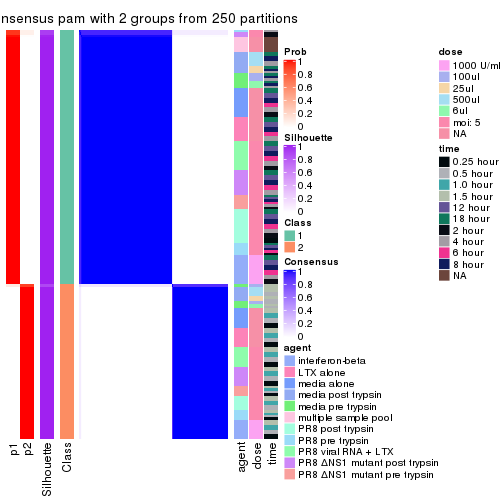
consensus_heatmap(res, k = 3)
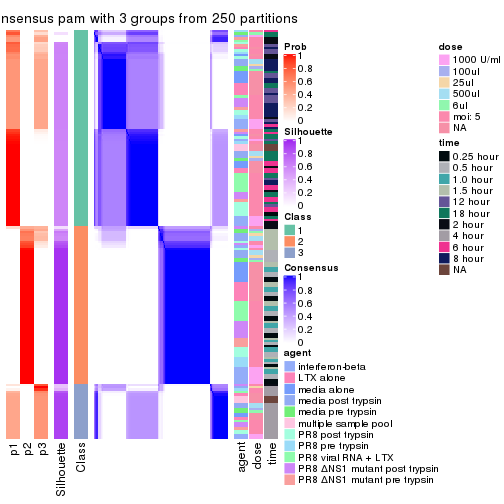
consensus_heatmap(res, k = 4)
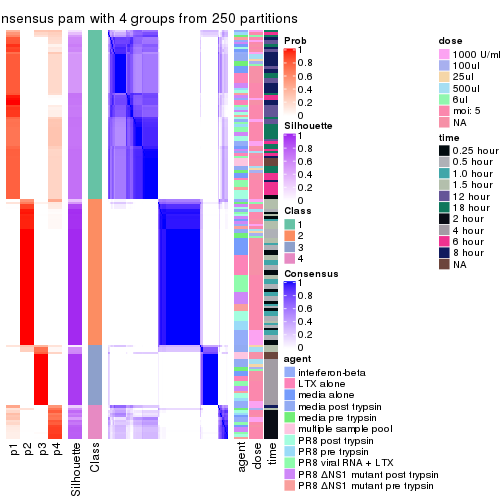
consensus_heatmap(res, k = 5)
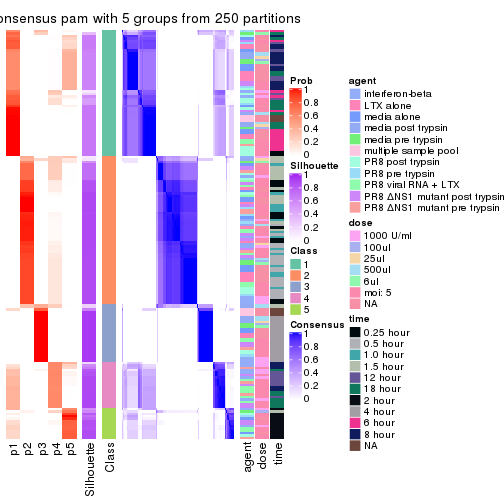
consensus_heatmap(res, k = 6)
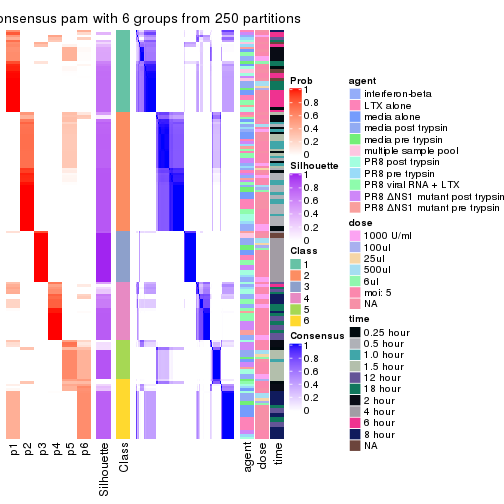
Heatmaps for the membership of samples in all partitions to see how consistent they are:
membership_heatmap(res, k = 2)
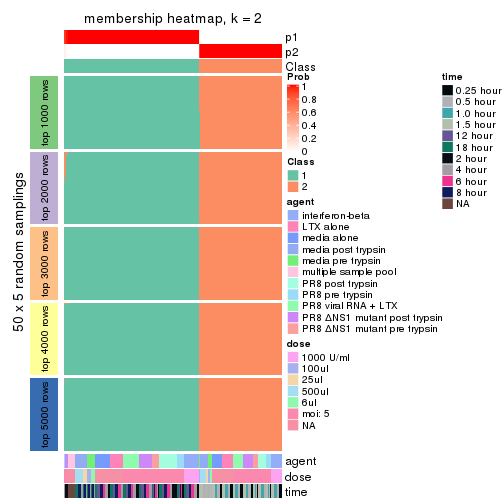
membership_heatmap(res, k = 3)
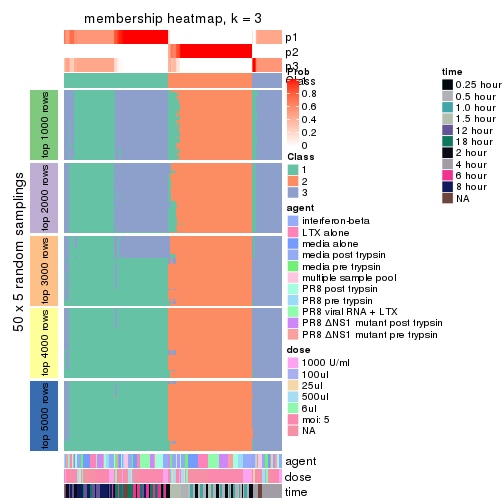
membership_heatmap(res, k = 4)
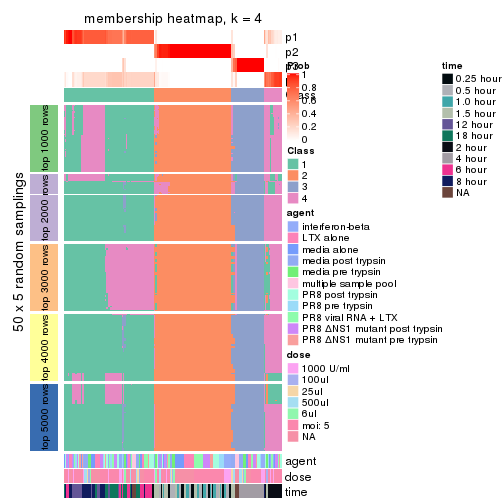
membership_heatmap(res, k = 5)
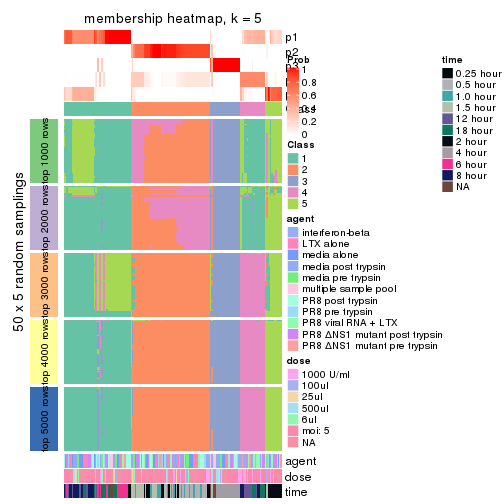
membership_heatmap(res, k = 6)
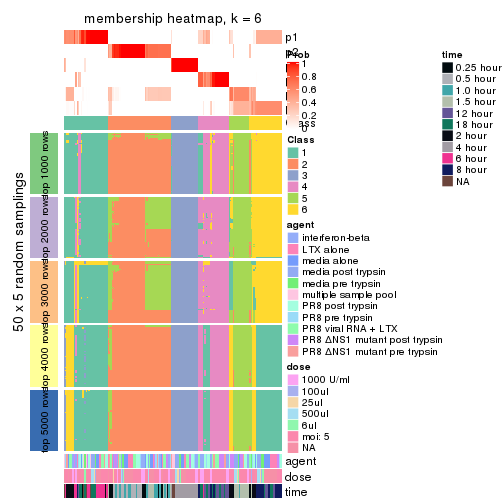
As soon as we have had the classes for columns, we can look for signatures which are significantly different between classes which can be candidate marks for certain classes. Following are the heatmaps for signatures.
Signature heatmaps where rows are scaled:
get_signatures(res, k = 2)
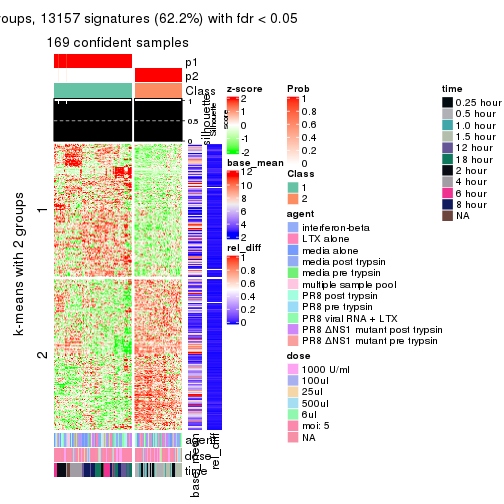
get_signatures(res, k = 3)
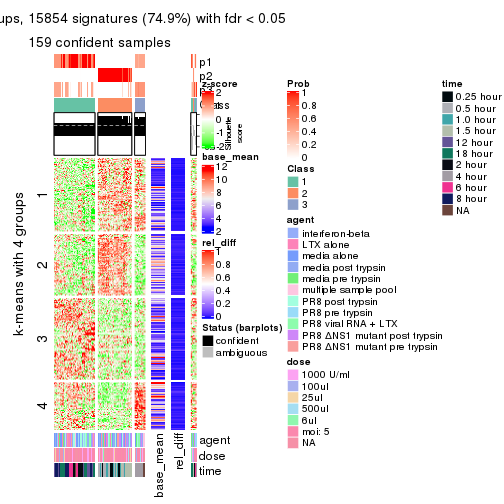
get_signatures(res, k = 4)
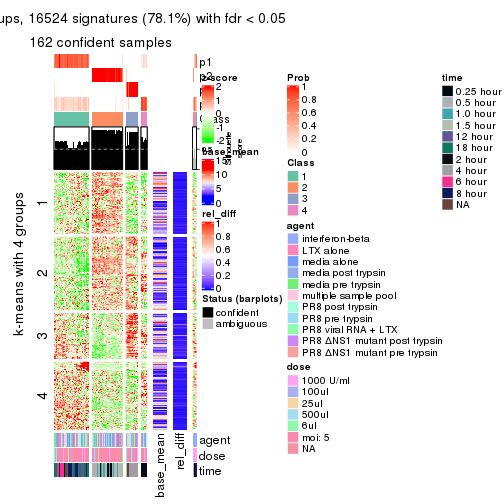
get_signatures(res, k = 5)
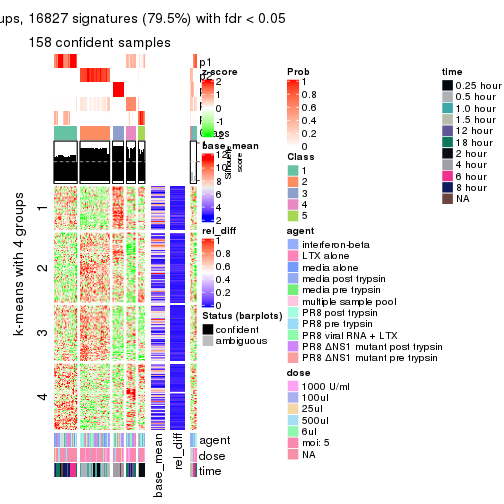
get_signatures(res, k = 6)
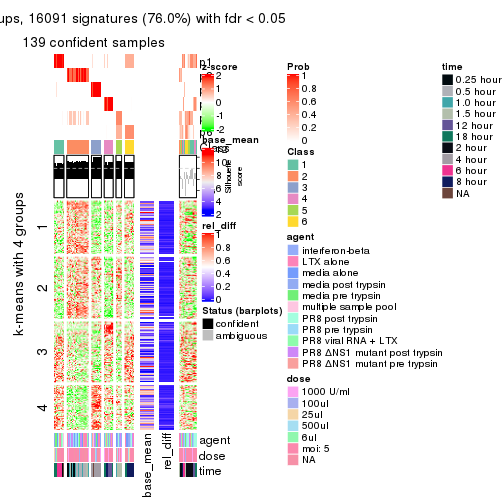
Signature heatmaps where rows are not scaled:
get_signatures(res, k = 2, scale_rows = FALSE)
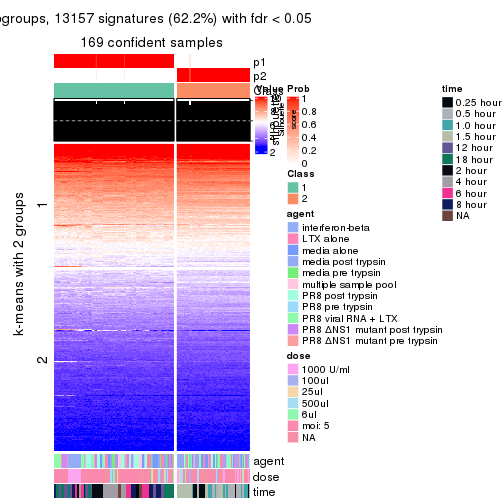
get_signatures(res, k = 3, scale_rows = FALSE)
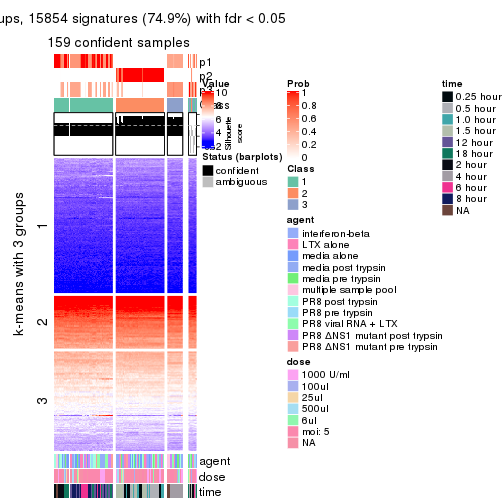
get_signatures(res, k = 4, scale_rows = FALSE)
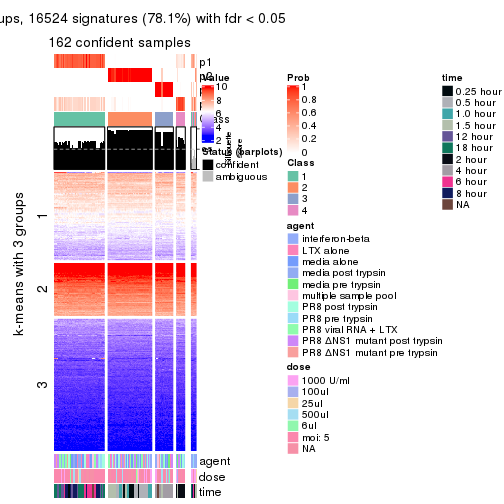
get_signatures(res, k = 5, scale_rows = FALSE)
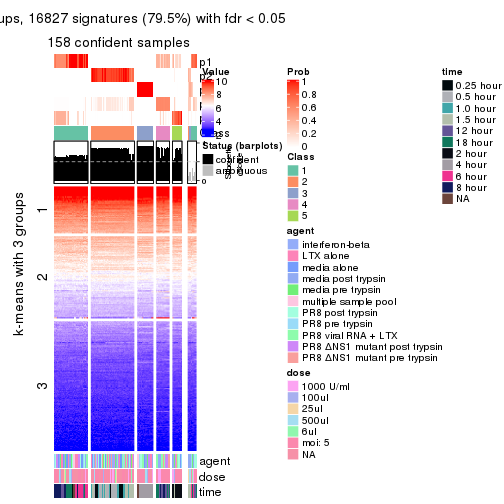
get_signatures(res, k = 6, scale_rows = FALSE)
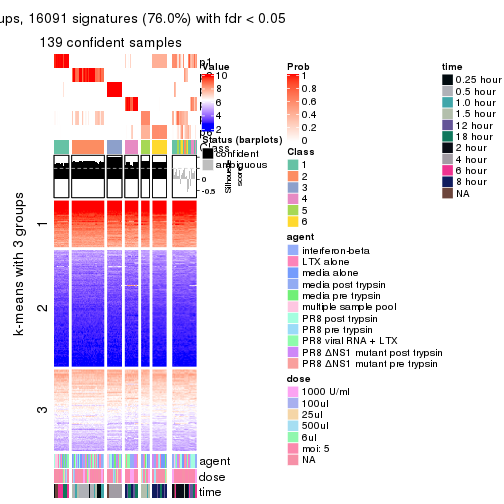
Compare the overlap of signatures from different k:
compare_signatures(res)
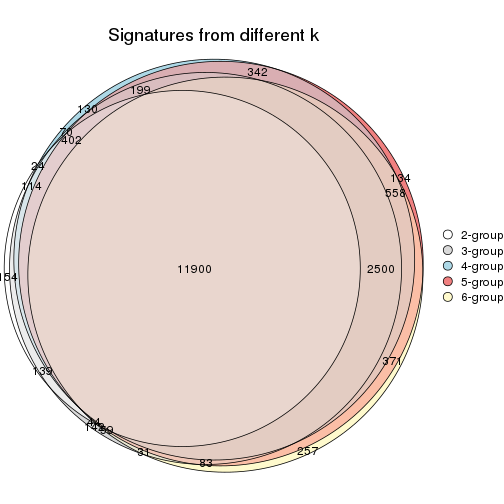
get_signature() returns a data frame invisibly. TO get the list of signatures, the function
call should be assigned to a variable explicitly. In following code, if plot argument is set
to FALSE, no heatmap is plotted while only the differential analysis is performed.
# code only for demonstration
tb = get_signature(res, k = ..., plot = FALSE)
An example of the output of tb is:
#> which_row fdr mean_1 mean_2 scaled_mean_1 scaled_mean_2 km
#> 1 38 0.042760348 8.373488 9.131774 -0.5533452 0.5164555 1
#> 2 40 0.018707592 7.106213 8.469186 -0.6173731 0.5762149 1
#> 3 55 0.019134737 10.221463 11.207825 -0.6159697 0.5749050 1
#> 4 59 0.006059896 5.921854 7.869574 -0.6899429 0.6439467 1
#> 5 60 0.018055526 8.928898 10.211722 -0.6204761 0.5791110 1
#> 6 98 0.009384629 15.714769 14.887706 0.6635654 -0.6193277 2
...
The columns in tb are:
which_row: row indices corresponding to the input matrix.fdr: FDR for the differential test. mean_x: The mean value in group x.scaled_mean_x: The mean value in group x after rows are scaled.km: Row groups if k-means clustering is applied to rows.UMAP plot which shows how samples are separated.
dimension_reduction(res, k = 2, method = "UMAP")
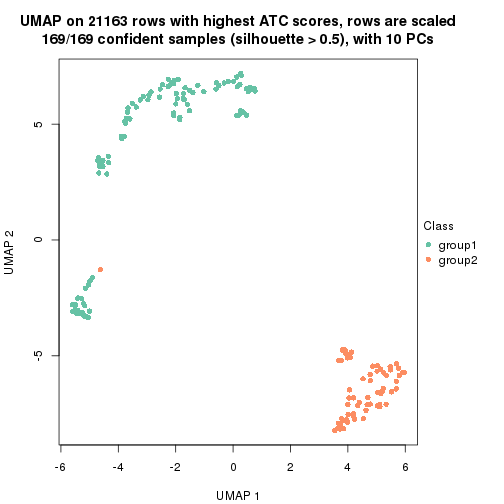
dimension_reduction(res, k = 3, method = "UMAP")
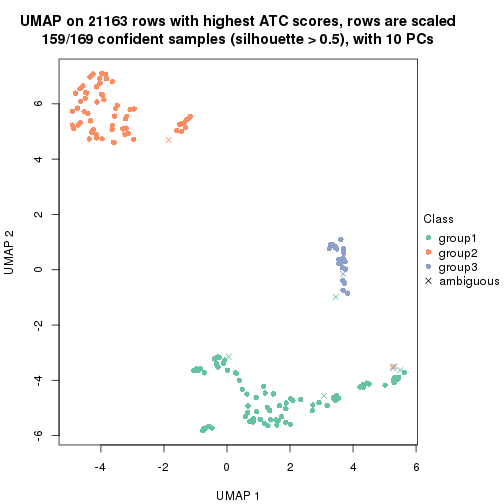
dimension_reduction(res, k = 4, method = "UMAP")
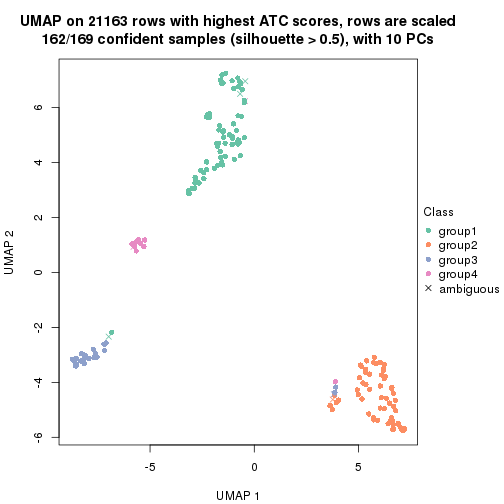
dimension_reduction(res, k = 5, method = "UMAP")
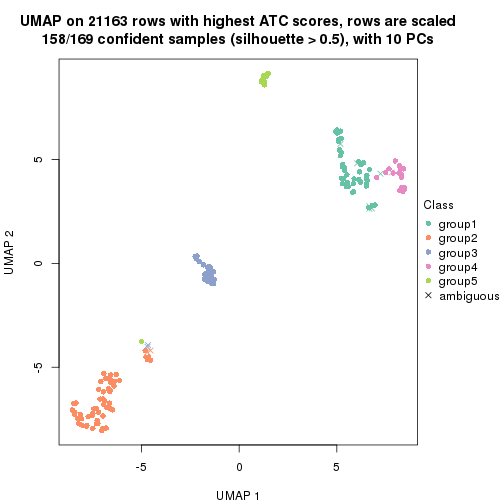
dimension_reduction(res, k = 6, method = "UMAP")
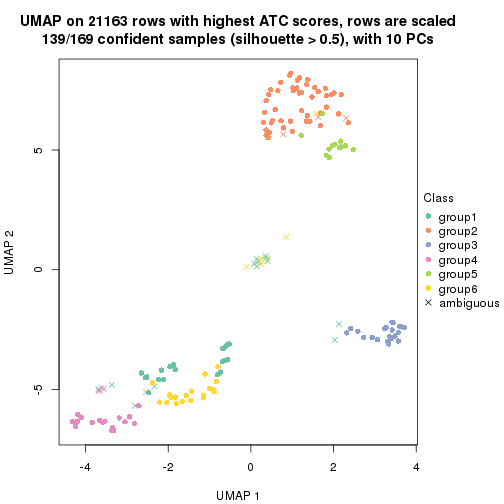
Following heatmap shows how subgroups are split when increasing k:
collect_classes(res)
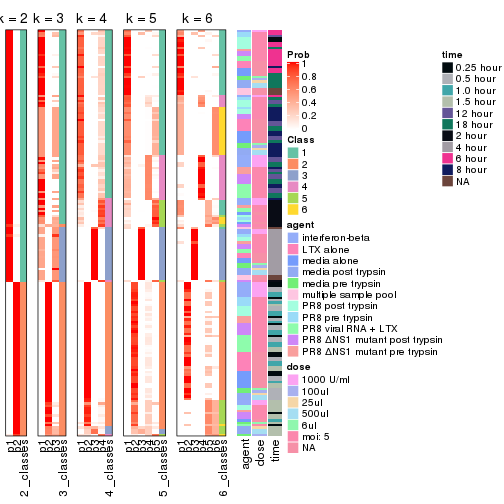
Test correlation between subgroups and known annotations. If the known annotation is numeric, one-way ANOVA test is applied, and if the known annotation is discrete, chi-squared contingency table test is applied.
test_to_known_factors(res)
#> n agent(p) dose(p) time(p) k
#> ATC:pam 169 0.9069 1.000 1.43e-29 2
#> ATC:pam 159 0.8520 0.980 8.38e-51 3
#> ATC:pam 162 0.9064 0.855 9.21e-73 4
#> ATC:pam 158 0.0632 0.154 2.35e-74 5
#> ATC:pam 139 0.0229 0.166 2.87e-65 6
If matrix rows can be associated to genes, consider to use functional_enrichment(res,
...) to perform function enrichment for the signature genes. See this vignette for more detailed explanations.
The object with results only for a single top-value method and a single partition method can be extracted as:
res = res_list["ATC", "mclust"]
# you can also extract it by
# res = res_list["ATC:mclust"]
A summary of res and all the functions that can be applied to it:
res
#> A 'ConsensusPartition' object with k = 2, 3, 4, 5, 6.
#> On a matrix with 21163 rows and 169 columns.
#> Top rows (1000, 2000, 3000, 4000, 5000) are extracted by 'ATC' method.
#> Subgroups are detected by 'mclust' method.
#> Performed in total 1250 partitions by row resampling.
#> Best k for subgroups seems to be 3.
#>
#> Following methods can be applied to this 'ConsensusPartition' object:
#> [1] "cola_report" "collect_classes" "collect_plots"
#> [4] "collect_stats" "colnames" "compare_signatures"
#> [7] "consensus_heatmap" "dimension_reduction" "functional_enrichment"
#> [10] "get_anno_col" "get_anno" "get_classes"
#> [13] "get_consensus" "get_matrix" "get_membership"
#> [16] "get_param" "get_signatures" "get_stats"
#> [19] "is_best_k" "is_stable_k" "membership_heatmap"
#> [22] "ncol" "nrow" "plot_ecdf"
#> [25] "rownames" "select_partition_number" "show"
#> [28] "suggest_best_k" "test_to_known_factors"
collect_plots() function collects all the plots made from res for all k (number of partitions)
into one single page to provide an easy and fast comparison between different k.
collect_plots(res)
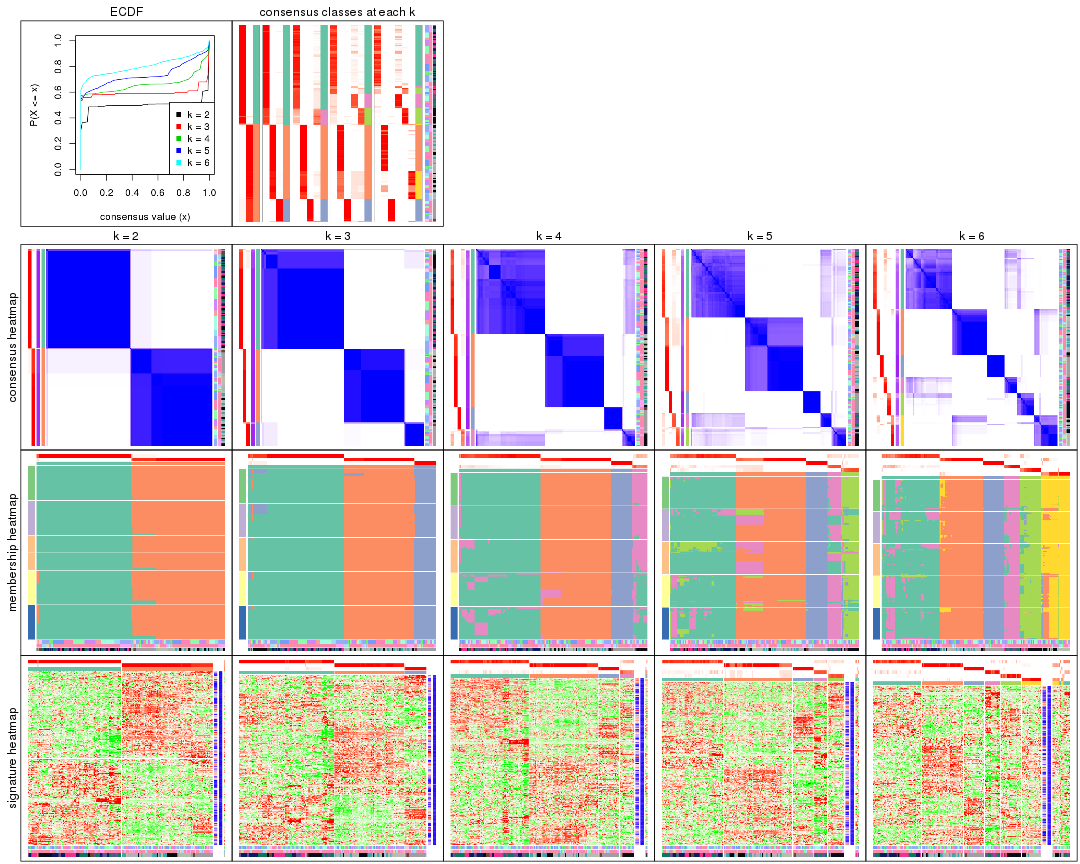
The plots are:
k and the heatmap of
predicted classes for each k.k.k.k.All the plots in panels can be made by individual functions and they are plotted later in this section.
select_partition_number() produces several plots showing different
statistics for choosing “optimized” k. There are following statistics:
k;k, the area increased is defined as \(A_k - A_{k-1}\).The detailed explanations of these statistics can be found in the cola vignette.
Generally speaking, lower PAC score, higher mean silhouette score or higher
concordance corresponds to better partition. Rand index and Jaccard index
measure how similar the current partition is compared to partition with k-1.
If they are too similar, we won't accept k is better than k-1.
select_partition_number(res)
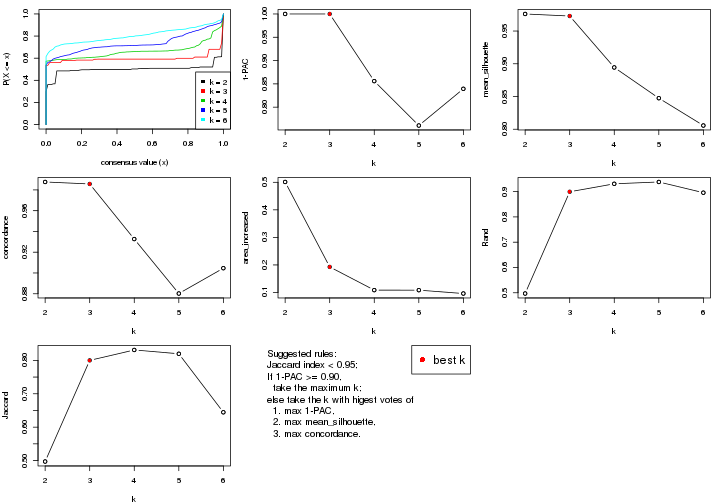
The numeric values for all these statistics can be obtained by get_stats().
get_stats(res)
#> k 1-PAC mean_silhouette concordance area_increased Rand Jaccard
#> 2 2 1.000 0.976 0.988 0.5012 0.497 0.497
#> 3 3 1.000 0.973 0.986 0.1928 0.899 0.800
#> 4 4 0.856 0.894 0.933 0.1086 0.931 0.831
#> 5 5 0.761 0.847 0.880 0.1084 0.938 0.820
#> 6 6 0.839 0.806 0.905 0.0962 0.896 0.644
suggest_best_k() suggests the best \(k\) based on these statistics. The rules are as follows:
suggest_best_k(res)
#> [1] 3
#> attr(,"optional")
#> [1] 2
There is also optional best \(k\) = 2 that is worth to check.
Following shows the table of the partitions (You need to click the show/hide
code output link to see it). The membership matrix (columns with name p*)
is inferred by
clue::cl_consensus()
function with the SE method. Basically the value in the membership matrix
represents the probability to belong to a certain group. The finall class
label for an item is determined with the group with highest probability it
belongs to.
In get_classes() function, the entropy is calculated from the membership
matrix and the silhouette score is calculated from the consensus matrix.
cbind(get_classes(res, k = 2), get_membership(res, k = 2))
#> class entropy silhouette p1 p2
#> GSM528681 2 0.0000 0.979 0.000 1.000
#> GSM528682 2 0.0000 0.979 0.000 1.000
#> GSM528683 2 0.0000 0.979 0.000 1.000
#> GSM528684 2 0.0000 0.979 0.000 1.000
#> GSM528687 2 0.0000 0.979 0.000 1.000
#> GSM528688 2 0.0000 0.979 0.000 1.000
#> GSM528685 2 0.0376 0.977 0.004 0.996
#> GSM528686 2 0.0376 0.977 0.004 0.996
#> GSM528693 1 0.0000 0.996 1.000 0.000
#> GSM528694 1 0.0000 0.996 1.000 0.000
#> GSM528695 2 0.3274 0.947 0.060 0.940
#> GSM528696 2 0.3274 0.947 0.060 0.940
#> GSM528697 1 0.0000 0.996 1.000 0.000
#> GSM528698 1 0.0000 0.996 1.000 0.000
#> GSM528699 1 0.0000 0.996 1.000 0.000
#> GSM528700 1 0.0000 0.996 1.000 0.000
#> GSM528689 1 0.0000 0.996 1.000 0.000
#> GSM528690 1 0.0000 0.996 1.000 0.000
#> GSM528691 1 0.0000 0.996 1.000 0.000
#> GSM528692 1 0.0000 0.996 1.000 0.000
#> GSM528779 2 0.0000 0.979 0.000 1.000
#> GSM528780 2 0.0000 0.979 0.000 1.000
#> GSM528782 2 0.0000 0.979 0.000 1.000
#> GSM528781 2 0.0376 0.977 0.004 0.996
#> GSM528785 1 0.0000 0.996 1.000 0.000
#> GSM528786 2 0.3274 0.947 0.060 0.940
#> GSM528787 1 0.0000 0.996 1.000 0.000
#> GSM528788 1 0.0000 0.996 1.000 0.000
#> GSM528783 1 0.0000 0.996 1.000 0.000
#> GSM528784 1 0.0000 0.996 1.000 0.000
#> GSM528759 1 0.0000 0.996 1.000 0.000
#> GSM528760 1 0.0000 0.996 1.000 0.000
#> GSM528761 2 0.0000 0.979 0.000 1.000
#> GSM528762 2 0.0000 0.979 0.000 1.000
#> GSM528765 2 0.0000 0.979 0.000 1.000
#> GSM528766 2 0.0000 0.979 0.000 1.000
#> GSM528763 2 0.0000 0.979 0.000 1.000
#> GSM528764 2 0.0376 0.977 0.004 0.996
#> GSM528771 1 0.0000 0.996 1.000 0.000
#> GSM528772 1 0.0000 0.996 1.000 0.000
#> GSM528773 2 0.3274 0.947 0.060 0.940
#> GSM528774 2 0.3274 0.947 0.060 0.940
#> GSM528775 1 0.0000 0.996 1.000 0.000
#> GSM528776 1 0.0000 0.996 1.000 0.000
#> GSM528777 1 0.0000 0.996 1.000 0.000
#> GSM528778 1 0.0000 0.996 1.000 0.000
#> GSM528767 1 0.0000 0.996 1.000 0.000
#> GSM528768 1 0.0000 0.996 1.000 0.000
#> GSM528769 1 0.0000 0.996 1.000 0.000
#> GSM528770 1 0.0000 0.996 1.000 0.000
#> GSM528671 2 0.0000 0.979 0.000 1.000
#> GSM528672 2 0.0000 0.979 0.000 1.000
#> GSM528674 2 0.0000 0.979 0.000 1.000
#> GSM528673 2 0.0376 0.977 0.004 0.996
#> GSM528677 1 0.0000 0.996 1.000 0.000
#> GSM528678 1 0.6973 0.761 0.812 0.188
#> GSM528679 1 0.0000 0.996 1.000 0.000
#> GSM528680 1 0.0000 0.996 1.000 0.000
#> GSM528675 1 0.0000 0.996 1.000 0.000
#> GSM528676 1 0.0000 0.996 1.000 0.000
#> GSM528651 2 0.0000 0.979 0.000 1.000
#> GSM528652 2 0.0000 0.979 0.000 1.000
#> GSM528653 2 0.0000 0.979 0.000 1.000
#> GSM528654 2 0.0000 0.979 0.000 1.000
#> GSM528657 2 0.0000 0.979 0.000 1.000
#> GSM528658 2 0.0000 0.979 0.000 1.000
#> GSM528655 2 0.0376 0.977 0.004 0.996
#> GSM528656 2 0.0376 0.977 0.004 0.996
#> GSM528663 1 0.0000 0.996 1.000 0.000
#> GSM528664 1 0.0000 0.996 1.000 0.000
#> GSM528665 2 0.3274 0.947 0.060 0.940
#> GSM528666 2 0.3274 0.947 0.060 0.940
#> GSM528667 1 0.0000 0.996 1.000 0.000
#> GSM528668 1 0.0000 0.996 1.000 0.000
#> GSM528669 1 0.0000 0.996 1.000 0.000
#> GSM528670 1 0.0000 0.996 1.000 0.000
#> GSM528659 1 0.0000 0.996 1.000 0.000
#> GSM528660 1 0.0000 0.996 1.000 0.000
#> GSM528661 1 0.0000 0.996 1.000 0.000
#> GSM528662 1 0.0000 0.996 1.000 0.000
#> GSM528701 2 0.0000 0.979 0.000 1.000
#> GSM528702 2 0.0000 0.979 0.000 1.000
#> GSM528703 2 0.0000 0.979 0.000 1.000
#> GSM528704 2 0.0000 0.979 0.000 1.000
#> GSM528707 2 0.0000 0.979 0.000 1.000
#> GSM528708 2 0.0000 0.979 0.000 1.000
#> GSM528705 2 0.0000 0.979 0.000 1.000
#> GSM528706 2 0.0000 0.979 0.000 1.000
#> GSM528713 1 0.0000 0.996 1.000 0.000
#> GSM528714 1 0.0000 0.996 1.000 0.000
#> GSM528715 2 0.3274 0.947 0.060 0.940
#> GSM528716 2 0.3274 0.947 0.060 0.940
#> GSM528717 1 0.0000 0.996 1.000 0.000
#> GSM528718 1 0.0000 0.996 1.000 0.000
#> GSM528719 1 0.0000 0.996 1.000 0.000
#> GSM528720 1 0.0000 0.996 1.000 0.000
#> GSM528709 1 0.0000 0.996 1.000 0.000
#> GSM528710 1 0.0000 0.996 1.000 0.000
#> GSM528711 1 0.0000 0.996 1.000 0.000
#> GSM528712 1 0.0000 0.996 1.000 0.000
#> GSM528721 2 0.0000 0.979 0.000 1.000
#> GSM528722 2 0.0000 0.979 0.000 1.000
#> GSM528723 2 0.0000 0.979 0.000 1.000
#> GSM528724 2 0.0000 0.979 0.000 1.000
#> GSM528727 2 0.0000 0.979 0.000 1.000
#> GSM528728 2 0.0000 0.979 0.000 1.000
#> GSM528725 2 0.0000 0.979 0.000 1.000
#> GSM528726 2 0.0000 0.979 0.000 1.000
#> GSM528733 2 0.3274 0.947 0.060 0.940
#> GSM528734 2 0.3274 0.947 0.060 0.940
#> GSM528735 1 0.0000 0.996 1.000 0.000
#> GSM528736 1 0.0000 0.996 1.000 0.000
#> GSM528737 1 0.0000 0.996 1.000 0.000
#> GSM528738 1 0.0000 0.996 1.000 0.000
#> GSM528729 1 0.0000 0.996 1.000 0.000
#> GSM528730 1 0.0000 0.996 1.000 0.000
#> GSM528731 1 0.0000 0.996 1.000 0.000
#> GSM528732 1 0.0000 0.996 1.000 0.000
#> GSM528739 2 0.0000 0.979 0.000 1.000
#> GSM528740 2 0.0000 0.979 0.000 1.000
#> GSM528741 2 0.0000 0.979 0.000 1.000
#> GSM528742 2 0.0000 0.979 0.000 1.000
#> GSM528745 2 0.0000 0.979 0.000 1.000
#> GSM528746 2 0.0000 0.979 0.000 1.000
#> GSM528743 2 0.0000 0.979 0.000 1.000
#> GSM528744 2 0.0000 0.979 0.000 1.000
#> GSM528751 1 0.0000 0.996 1.000 0.000
#> GSM528752 1 0.0000 0.996 1.000 0.000
#> GSM528753 2 0.3274 0.947 0.060 0.940
#> GSM528754 2 0.3274 0.947 0.060 0.940
#> GSM528755 1 0.0000 0.996 1.000 0.000
#> GSM528756 1 0.0000 0.996 1.000 0.000
#> GSM528757 1 0.0000 0.996 1.000 0.000
#> GSM528758 1 0.0000 0.996 1.000 0.000
#> GSM528747 1 0.0000 0.996 1.000 0.000
#> GSM528748 1 0.0000 0.996 1.000 0.000
#> GSM528749 1 0.0000 0.996 1.000 0.000
#> GSM528750 1 0.0000 0.996 1.000 0.000
#> GSM528640 2 0.0000 0.979 0.000 1.000
#> GSM528641 2 0.0376 0.977 0.004 0.996
#> GSM528643 2 0.3274 0.947 0.060 0.940
#> GSM528644 1 0.0000 0.996 1.000 0.000
#> GSM528642 1 0.0000 0.996 1.000 0.000
#> GSM528620 2 0.0000 0.979 0.000 1.000
#> GSM528621 2 0.9988 0.116 0.480 0.520
#> GSM528623 2 0.3274 0.947 0.060 0.940
#> GSM528624 1 0.0000 0.996 1.000 0.000
#> GSM528622 1 0.0000 0.996 1.000 0.000
#> GSM528625 2 0.0000 0.979 0.000 1.000
#> GSM528626 2 0.0376 0.977 0.004 0.996
#> GSM528628 2 0.3274 0.947 0.060 0.940
#> GSM528629 1 0.0000 0.996 1.000 0.000
#> GSM528627 1 0.0000 0.996 1.000 0.000
#> GSM528630 2 0.0000 0.979 0.000 1.000
#> GSM528631 2 0.0376 0.977 0.004 0.996
#> GSM528632 2 0.2423 0.959 0.040 0.960
#> GSM528633 2 0.0672 0.976 0.008 0.992
#> GSM528636 2 0.3274 0.947 0.060 0.940
#> GSM528637 2 0.3274 0.947 0.060 0.940
#> GSM528638 1 0.0000 0.996 1.000 0.000
#> GSM528639 1 0.0000 0.996 1.000 0.000
#> GSM528634 1 0.0000 0.996 1.000 0.000
#> GSM528635 1 0.0000 0.996 1.000 0.000
#> GSM528645 2 0.3274 0.947 0.060 0.940
#> GSM528646 2 0.3274 0.947 0.060 0.940
#> GSM528647 1 0.5629 0.843 0.868 0.132
#> GSM528648 1 0.0000 0.996 1.000 0.000
#> GSM528649 1 0.0000 0.996 1.000 0.000
#> GSM528650 1 0.0000 0.996 1.000 0.000
cbind(get_classes(res, k = 3), get_membership(res, k = 3))
#> class entropy silhouette p1 p2 p3
#> GSM528681 2 0.0000 0.994 0.000 1.000 0.000
#> GSM528682 2 0.0000 0.994 0.000 1.000 0.000
#> GSM528683 2 0.0000 0.994 0.000 1.000 0.000
#> GSM528684 2 0.0000 0.994 0.000 1.000 0.000
#> GSM528687 2 0.0000 0.994 0.000 1.000 0.000
#> GSM528688 2 0.0000 0.994 0.000 1.000 0.000
#> GSM528685 2 0.0892 0.985 0.000 0.980 0.020
#> GSM528686 2 0.0892 0.985 0.000 0.980 0.020
#> GSM528693 1 0.2625 0.918 0.916 0.000 0.084
#> GSM528694 1 0.2625 0.918 0.916 0.000 0.084
#> GSM528695 3 0.0000 0.985 0.000 0.000 1.000
#> GSM528696 3 0.0000 0.985 0.000 0.000 1.000
#> GSM528697 1 0.0000 0.978 1.000 0.000 0.000
#> GSM528698 1 0.0000 0.978 1.000 0.000 0.000
#> GSM528699 1 0.0000 0.978 1.000 0.000 0.000
#> GSM528700 1 0.0000 0.978 1.000 0.000 0.000
#> GSM528689 1 0.0000 0.978 1.000 0.000 0.000
#> GSM528690 1 0.0000 0.978 1.000 0.000 0.000
#> GSM528691 1 0.0000 0.978 1.000 0.000 0.000
#> GSM528692 1 0.2625 0.909 0.916 0.000 0.084
#> GSM528779 2 0.0892 0.985 0.000 0.980 0.020
#> GSM528780 2 0.0000 0.994 0.000 1.000 0.000
#> GSM528782 2 0.0000 0.994 0.000 1.000 0.000
#> GSM528781 2 0.0892 0.985 0.000 0.980 0.020
#> GSM528785 1 0.2625 0.918 0.916 0.000 0.084
#> GSM528786 3 0.5327 0.621 0.000 0.272 0.728
#> GSM528787 1 0.0000 0.978 1.000 0.000 0.000
#> GSM528788 1 0.0000 0.978 1.000 0.000 0.000
#> GSM528783 1 0.0000 0.978 1.000 0.000 0.000
#> GSM528784 1 0.0000 0.978 1.000 0.000 0.000
#> GSM528759 1 0.0000 0.978 1.000 0.000 0.000
#> GSM528760 1 0.0000 0.978 1.000 0.000 0.000
#> GSM528761 2 0.0000 0.994 0.000 1.000 0.000
#> GSM528762 2 0.0000 0.994 0.000 1.000 0.000
#> GSM528765 2 0.0000 0.994 0.000 1.000 0.000
#> GSM528766 2 0.0000 0.994 0.000 1.000 0.000
#> GSM528763 2 0.0892 0.985 0.000 0.980 0.020
#> GSM528764 2 0.0892 0.985 0.000 0.980 0.020
#> GSM528771 1 0.2625 0.918 0.916 0.000 0.084
#> GSM528772 1 0.2625 0.918 0.916 0.000 0.084
#> GSM528773 3 0.0000 0.985 0.000 0.000 1.000
#> GSM528774 3 0.0000 0.985 0.000 0.000 1.000
#> GSM528775 1 0.0000 0.978 1.000 0.000 0.000
#> GSM528776 1 0.0000 0.978 1.000 0.000 0.000
#> GSM528777 1 0.0000 0.978 1.000 0.000 0.000
#> GSM528778 1 0.0000 0.978 1.000 0.000 0.000
#> GSM528767 1 0.0000 0.978 1.000 0.000 0.000
#> GSM528768 1 0.0000 0.978 1.000 0.000 0.000
#> GSM528769 1 0.0000 0.978 1.000 0.000 0.000
#> GSM528770 1 0.0000 0.978 1.000 0.000 0.000
#> GSM528671 2 0.0000 0.994 0.000 1.000 0.000
#> GSM528672 2 0.0000 0.994 0.000 1.000 0.000
#> GSM528674 2 0.0000 0.994 0.000 1.000 0.000
#> GSM528673 2 0.0892 0.985 0.000 0.980 0.020
#> GSM528677 1 0.2625 0.918 0.916 0.000 0.084
#> GSM528678 1 0.4121 0.827 0.832 0.000 0.168
#> GSM528679 1 0.0000 0.978 1.000 0.000 0.000
#> GSM528680 1 0.0000 0.978 1.000 0.000 0.000
#> GSM528675 1 0.0000 0.978 1.000 0.000 0.000
#> GSM528676 1 0.0000 0.978 1.000 0.000 0.000
#> GSM528651 2 0.0892 0.985 0.000 0.980 0.020
#> GSM528652 2 0.0892 0.985 0.000 0.980 0.020
#> GSM528653 2 0.0000 0.994 0.000 1.000 0.000
#> GSM528654 2 0.0000 0.994 0.000 1.000 0.000
#> GSM528657 2 0.0000 0.994 0.000 1.000 0.000
#> GSM528658 2 0.0000 0.994 0.000 1.000 0.000
#> GSM528655 2 0.0892 0.985 0.000 0.980 0.020
#> GSM528656 2 0.0892 0.985 0.000 0.980 0.020
#> GSM528663 1 0.2625 0.918 0.916 0.000 0.084
#> GSM528664 1 0.2625 0.918 0.916 0.000 0.084
#> GSM528665 3 0.0000 0.985 0.000 0.000 1.000
#> GSM528666 3 0.0000 0.985 0.000 0.000 1.000
#> GSM528667 1 0.0000 0.978 1.000 0.000 0.000
#> GSM528668 1 0.0000 0.978 1.000 0.000 0.000
#> GSM528669 1 0.0000 0.978 1.000 0.000 0.000
#> GSM528670 1 0.0000 0.978 1.000 0.000 0.000
#> GSM528659 1 0.0000 0.978 1.000 0.000 0.000
#> GSM528660 1 0.0000 0.978 1.000 0.000 0.000
#> GSM528661 1 0.0000 0.978 1.000 0.000 0.000
#> GSM528662 1 0.0000 0.978 1.000 0.000 0.000
#> GSM528701 2 0.0892 0.985 0.000 0.980 0.020
#> GSM528702 2 0.0000 0.994 0.000 1.000 0.000
#> GSM528703 2 0.0000 0.994 0.000 1.000 0.000
#> GSM528704 2 0.0000 0.994 0.000 1.000 0.000
#> GSM528707 2 0.0000 0.994 0.000 1.000 0.000
#> GSM528708 2 0.0000 0.994 0.000 1.000 0.000
#> GSM528705 2 0.0000 0.994 0.000 1.000 0.000
#> GSM528706 2 0.0000 0.994 0.000 1.000 0.000
#> GSM528713 1 0.2625 0.918 0.916 0.000 0.084
#> GSM528714 1 0.2625 0.918 0.916 0.000 0.084
#> GSM528715 3 0.0000 0.985 0.000 0.000 1.000
#> GSM528716 3 0.0000 0.985 0.000 0.000 1.000
#> GSM528717 1 0.0000 0.978 1.000 0.000 0.000
#> GSM528718 1 0.0000 0.978 1.000 0.000 0.000
#> GSM528719 1 0.0000 0.978 1.000 0.000 0.000
#> GSM528720 1 0.0000 0.978 1.000 0.000 0.000
#> GSM528709 1 0.0000 0.978 1.000 0.000 0.000
#> GSM528710 1 0.0000 0.978 1.000 0.000 0.000
#> GSM528711 1 0.0000 0.978 1.000 0.000 0.000
#> GSM528712 1 0.0000 0.978 1.000 0.000 0.000
#> GSM528721 2 0.0000 0.994 0.000 1.000 0.000
#> GSM528722 2 0.0000 0.994 0.000 1.000 0.000
#> GSM528723 2 0.0000 0.994 0.000 1.000 0.000
#> GSM528724 2 0.0000 0.994 0.000 1.000 0.000
#> GSM528727 2 0.0000 0.994 0.000 1.000 0.000
#> GSM528728 2 0.0000 0.994 0.000 1.000 0.000
#> GSM528725 2 0.0000 0.994 0.000 1.000 0.000
#> GSM528726 2 0.0000 0.994 0.000 1.000 0.000
#> GSM528733 3 0.0000 0.985 0.000 0.000 1.000
#> GSM528734 3 0.0000 0.985 0.000 0.000 1.000
#> GSM528735 1 0.0000 0.978 1.000 0.000 0.000
#> GSM528736 1 0.0000 0.978 1.000 0.000 0.000
#> GSM528737 1 0.0000 0.978 1.000 0.000 0.000
#> GSM528738 1 0.0000 0.978 1.000 0.000 0.000
#> GSM528729 1 0.0000 0.978 1.000 0.000 0.000
#> GSM528730 1 0.0000 0.978 1.000 0.000 0.000
#> GSM528731 1 0.0000 0.978 1.000 0.000 0.000
#> GSM528732 1 0.0000 0.978 1.000 0.000 0.000
#> GSM528739 2 0.0000 0.994 0.000 1.000 0.000
#> GSM528740 2 0.0000 0.994 0.000 1.000 0.000
#> GSM528741 2 0.0000 0.994 0.000 1.000 0.000
#> GSM528742 2 0.0000 0.994 0.000 1.000 0.000
#> GSM528745 2 0.0892 0.985 0.000 0.980 0.020
#> GSM528746 2 0.0000 0.994 0.000 1.000 0.000
#> GSM528743 2 0.0000 0.994 0.000 1.000 0.000
#> GSM528744 2 0.0000 0.994 0.000 1.000 0.000
#> GSM528751 1 0.2625 0.918 0.916 0.000 0.084
#> GSM528752 1 0.2625 0.918 0.916 0.000 0.084
#> GSM528753 3 0.0000 0.985 0.000 0.000 1.000
#> GSM528754 3 0.0000 0.985 0.000 0.000 1.000
#> GSM528755 1 0.0000 0.978 1.000 0.000 0.000
#> GSM528756 1 0.0000 0.978 1.000 0.000 0.000
#> GSM528757 1 0.0000 0.978 1.000 0.000 0.000
#> GSM528758 1 0.0000 0.978 1.000 0.000 0.000
#> GSM528747 1 0.0000 0.978 1.000 0.000 0.000
#> GSM528748 1 0.0000 0.978 1.000 0.000 0.000
#> GSM528749 1 0.0000 0.978 1.000 0.000 0.000
#> GSM528750 1 0.0000 0.978 1.000 0.000 0.000
#> GSM528640 2 0.0000 0.994 0.000 1.000 0.000
#> GSM528641 2 0.0892 0.985 0.000 0.980 0.020
#> GSM528643 3 0.0000 0.985 0.000 0.000 1.000
#> GSM528644 1 0.0000 0.978 1.000 0.000 0.000
#> GSM528642 1 0.2625 0.909 0.916 0.000 0.084
#> GSM528620 2 0.0000 0.994 0.000 1.000 0.000
#> GSM528621 1 0.5480 0.626 0.732 0.264 0.004
#> GSM528623 3 0.0000 0.985 0.000 0.000 1.000
#> GSM528624 1 0.0000 0.978 1.000 0.000 0.000
#> GSM528622 1 0.0000 0.978 1.000 0.000 0.000
#> GSM528625 2 0.0000 0.994 0.000 1.000 0.000
#> GSM528626 2 0.0892 0.985 0.000 0.980 0.020
#> GSM528628 3 0.0000 0.985 0.000 0.000 1.000
#> GSM528629 1 0.0000 0.978 1.000 0.000 0.000
#> GSM528627 1 0.0000 0.978 1.000 0.000 0.000
#> GSM528630 2 0.0000 0.994 0.000 1.000 0.000
#> GSM528631 2 0.0892 0.985 0.000 0.980 0.020
#> GSM528632 2 0.0892 0.985 0.000 0.980 0.020
#> GSM528633 2 0.0892 0.985 0.000 0.980 0.020
#> GSM528636 3 0.0000 0.985 0.000 0.000 1.000
#> GSM528637 3 0.0000 0.985 0.000 0.000 1.000
#> GSM528638 1 0.0000 0.978 1.000 0.000 0.000
#> GSM528639 1 0.0000 0.978 1.000 0.000 0.000
#> GSM528634 1 0.0000 0.978 1.000 0.000 0.000
#> GSM528635 1 0.0000 0.978 1.000 0.000 0.000
#> GSM528645 3 0.0000 0.985 0.000 0.000 1.000
#> GSM528646 3 0.0000 0.985 0.000 0.000 1.000
#> GSM528647 1 0.4121 0.827 0.832 0.000 0.168
#> GSM528648 1 0.0000 0.978 1.000 0.000 0.000
#> GSM528649 1 0.0000 0.978 1.000 0.000 0.000
#> GSM528650 1 0.0000 0.978 1.000 0.000 0.000
cbind(get_classes(res, k = 4), get_membership(res, k = 4))
#> class entropy silhouette p1 p2 p3 p4
#> GSM528681 2 0.0000 0.9789 0.000 1.000 0.000 0.000
#> GSM528682 2 0.0000 0.9789 0.000 1.000 0.000 0.000
#> GSM528683 2 0.0000 0.9789 0.000 1.000 0.000 0.000
#> GSM528684 2 0.0000 0.9789 0.000 1.000 0.000 0.000
#> GSM528687 2 0.0000 0.9789 0.000 1.000 0.000 0.000
#> GSM528688 2 0.0000 0.9789 0.000 1.000 0.000 0.000
#> GSM528685 2 0.1792 0.9517 0.000 0.932 0.000 0.068
#> GSM528686 2 0.1792 0.9517 0.000 0.932 0.000 0.068
#> GSM528693 4 0.4955 0.6741 0.444 0.000 0.000 0.556
#> GSM528694 4 0.4888 0.7091 0.412 0.000 0.000 0.588
#> GSM528695 3 0.0000 0.9977 0.000 0.000 1.000 0.000
#> GSM528696 3 0.0000 0.9977 0.000 0.000 1.000 0.000
#> GSM528697 1 0.0000 0.9012 1.000 0.000 0.000 0.000
#> GSM528698 1 0.1302 0.8917 0.956 0.000 0.000 0.044
#> GSM528699 1 0.0707 0.9014 0.980 0.000 0.000 0.020
#> GSM528700 1 0.0707 0.9014 0.980 0.000 0.000 0.020
#> GSM528689 1 0.0000 0.9012 1.000 0.000 0.000 0.000
#> GSM528690 1 0.0469 0.9025 0.988 0.000 0.000 0.012
#> GSM528691 1 0.1211 0.8935 0.960 0.000 0.000 0.040
#> GSM528692 1 0.3266 0.7554 0.832 0.000 0.000 0.168
#> GSM528779 2 0.1792 0.9517 0.000 0.932 0.000 0.068
#> GSM528780 2 0.0000 0.9789 0.000 1.000 0.000 0.000
#> GSM528782 2 0.0000 0.9789 0.000 1.000 0.000 0.000
#> GSM528781 2 0.2868 0.8980 0.000 0.864 0.000 0.136
#> GSM528785 1 0.3975 0.5440 0.760 0.000 0.000 0.240
#> GSM528786 4 0.5735 -0.0713 0.000 0.032 0.392 0.576
#> GSM528787 1 0.3649 0.7230 0.796 0.000 0.000 0.204
#> GSM528788 1 0.0707 0.9014 0.980 0.000 0.000 0.020
#> GSM528783 1 0.2469 0.8252 0.892 0.000 0.000 0.108
#> GSM528784 1 0.2469 0.8252 0.892 0.000 0.000 0.108
#> GSM528759 1 0.2814 0.8000 0.868 0.000 0.000 0.132
#> GSM528760 1 0.3649 0.7230 0.796 0.000 0.000 0.204
#> GSM528761 2 0.0000 0.9789 0.000 1.000 0.000 0.000
#> GSM528762 2 0.0000 0.9789 0.000 1.000 0.000 0.000
#> GSM528765 2 0.0000 0.9789 0.000 1.000 0.000 0.000
#> GSM528766 2 0.0000 0.9789 0.000 1.000 0.000 0.000
#> GSM528763 2 0.1716 0.9535 0.000 0.936 0.000 0.064
#> GSM528764 2 0.1792 0.9517 0.000 0.932 0.000 0.068
#> GSM528771 4 0.4817 0.7860 0.388 0.000 0.000 0.612
#> GSM528772 4 0.4746 0.8027 0.368 0.000 0.000 0.632
#> GSM528773 3 0.0000 0.9977 0.000 0.000 1.000 0.000
#> GSM528774 3 0.0000 0.9977 0.000 0.000 1.000 0.000
#> GSM528775 1 0.2921 0.8111 0.860 0.000 0.000 0.140
#> GSM528776 1 0.1118 0.8951 0.964 0.000 0.000 0.036
#> GSM528777 1 0.0707 0.9014 0.980 0.000 0.000 0.020
#> GSM528778 1 0.0707 0.9014 0.980 0.000 0.000 0.020
#> GSM528767 1 0.2469 0.8252 0.892 0.000 0.000 0.108
#> GSM528768 1 0.2469 0.8252 0.892 0.000 0.000 0.108
#> GSM528769 1 0.2469 0.8252 0.892 0.000 0.000 0.108
#> GSM528770 1 0.2469 0.8252 0.892 0.000 0.000 0.108
#> GSM528671 2 0.1637 0.9552 0.000 0.940 0.000 0.060
#> GSM528672 2 0.0000 0.9789 0.000 1.000 0.000 0.000
#> GSM528674 2 0.0000 0.9789 0.000 1.000 0.000 0.000
#> GSM528673 2 0.1792 0.9517 0.000 0.932 0.000 0.068
#> GSM528677 4 0.4624 0.8156 0.340 0.000 0.000 0.660
#> GSM528678 4 0.3695 0.6599 0.156 0.000 0.016 0.828
#> GSM528679 1 0.1302 0.8917 0.956 0.000 0.000 0.044
#> GSM528680 1 0.0336 0.9020 0.992 0.000 0.000 0.008
#> GSM528675 1 0.2469 0.8252 0.892 0.000 0.000 0.108
#> GSM528676 1 0.2469 0.8252 0.892 0.000 0.000 0.108
#> GSM528651 2 0.1792 0.9517 0.000 0.932 0.000 0.068
#> GSM528652 2 0.1792 0.9517 0.000 0.932 0.000 0.068
#> GSM528653 2 0.0000 0.9789 0.000 1.000 0.000 0.000
#> GSM528654 2 0.0000 0.9789 0.000 1.000 0.000 0.000
#> GSM528657 2 0.0000 0.9789 0.000 1.000 0.000 0.000
#> GSM528658 2 0.0000 0.9789 0.000 1.000 0.000 0.000
#> GSM528655 2 0.1792 0.9517 0.000 0.932 0.000 0.068
#> GSM528656 2 0.1792 0.9517 0.000 0.932 0.000 0.068
#> GSM528663 4 0.4624 0.8156 0.340 0.000 0.000 0.660
#> GSM528664 4 0.4643 0.8147 0.344 0.000 0.000 0.656
#> GSM528665 3 0.0000 0.9977 0.000 0.000 1.000 0.000
#> GSM528666 3 0.0000 0.9977 0.000 0.000 1.000 0.000
#> GSM528667 1 0.0817 0.8995 0.976 0.000 0.000 0.024
#> GSM528668 1 0.0188 0.9013 0.996 0.000 0.000 0.004
#> GSM528669 1 0.0707 0.9014 0.980 0.000 0.000 0.020
#> GSM528670 1 0.0707 0.9014 0.980 0.000 0.000 0.020
#> GSM528659 1 0.2469 0.8252 0.892 0.000 0.000 0.108
#> GSM528660 1 0.2469 0.8252 0.892 0.000 0.000 0.108
#> GSM528661 1 0.2469 0.8252 0.892 0.000 0.000 0.108
#> GSM528662 1 0.0188 0.9013 0.996 0.000 0.000 0.004
#> GSM528701 2 0.1792 0.9517 0.000 0.932 0.000 0.068
#> GSM528702 2 0.0188 0.9777 0.000 0.996 0.000 0.004
#> GSM528703 2 0.0000 0.9789 0.000 1.000 0.000 0.000
#> GSM528704 2 0.0000 0.9789 0.000 1.000 0.000 0.000
#> GSM528707 2 0.0000 0.9789 0.000 1.000 0.000 0.000
#> GSM528708 2 0.0188 0.9777 0.000 0.996 0.000 0.004
#> GSM528705 2 0.0000 0.9789 0.000 1.000 0.000 0.000
#> GSM528706 2 0.0000 0.9789 0.000 1.000 0.000 0.000
#> GSM528713 4 0.4843 0.7757 0.396 0.000 0.000 0.604
#> GSM528714 4 0.4624 0.8156 0.340 0.000 0.000 0.660
#> GSM528715 3 0.0000 0.9977 0.000 0.000 1.000 0.000
#> GSM528716 3 0.0000 0.9977 0.000 0.000 1.000 0.000
#> GSM528717 1 0.1474 0.8876 0.948 0.000 0.000 0.052
#> GSM528718 1 0.1474 0.8876 0.948 0.000 0.000 0.052
#> GSM528719 1 0.1474 0.8876 0.948 0.000 0.000 0.052
#> GSM528720 1 0.1474 0.8876 0.948 0.000 0.000 0.052
#> GSM528709 1 0.0469 0.9022 0.988 0.000 0.000 0.012
#> GSM528710 1 0.2469 0.8252 0.892 0.000 0.000 0.108
#> GSM528711 1 0.0707 0.9005 0.980 0.000 0.000 0.020
#> GSM528712 1 0.1022 0.8962 0.968 0.000 0.000 0.032
#> GSM528721 2 0.0000 0.9789 0.000 1.000 0.000 0.000
#> GSM528722 2 0.0000 0.9789 0.000 1.000 0.000 0.000
#> GSM528723 2 0.0000 0.9789 0.000 1.000 0.000 0.000
#> GSM528724 2 0.0000 0.9789 0.000 1.000 0.000 0.000
#> GSM528727 2 0.0000 0.9789 0.000 1.000 0.000 0.000
#> GSM528728 2 0.0000 0.9789 0.000 1.000 0.000 0.000
#> GSM528725 2 0.0188 0.9777 0.000 0.996 0.000 0.004
#> GSM528726 2 0.0000 0.9789 0.000 1.000 0.000 0.000
#> GSM528733 3 0.0000 0.9977 0.000 0.000 1.000 0.000
#> GSM528734 3 0.0000 0.9977 0.000 0.000 1.000 0.000
#> GSM528735 1 0.2704 0.8307 0.876 0.000 0.000 0.124
#> GSM528736 1 0.3610 0.7296 0.800 0.000 0.000 0.200
#> GSM528737 1 0.0188 0.9013 0.996 0.000 0.000 0.004
#> GSM528738 1 0.0592 0.9009 0.984 0.000 0.000 0.016
#> GSM528729 1 0.0707 0.9014 0.980 0.000 0.000 0.020
#> GSM528730 1 0.0707 0.9014 0.980 0.000 0.000 0.020
#> GSM528731 1 0.0707 0.9014 0.980 0.000 0.000 0.020
#> GSM528732 1 0.0707 0.9014 0.980 0.000 0.000 0.020
#> GSM528739 2 0.0000 0.9789 0.000 1.000 0.000 0.000
#> GSM528740 2 0.0188 0.9777 0.000 0.996 0.000 0.004
#> GSM528741 2 0.0000 0.9789 0.000 1.000 0.000 0.000
#> GSM528742 2 0.0000 0.9789 0.000 1.000 0.000 0.000
#> GSM528745 2 0.1792 0.9517 0.000 0.932 0.000 0.068
#> GSM528746 2 0.0000 0.9789 0.000 1.000 0.000 0.000
#> GSM528743 2 0.0000 0.9789 0.000 1.000 0.000 0.000
#> GSM528744 2 0.0000 0.9789 0.000 1.000 0.000 0.000
#> GSM528751 1 0.4998 -0.5294 0.512 0.000 0.000 0.488
#> GSM528752 4 0.4817 0.7860 0.388 0.000 0.000 0.612
#> GSM528753 3 0.0000 0.9977 0.000 0.000 1.000 0.000
#> GSM528754 3 0.0000 0.9977 0.000 0.000 1.000 0.000
#> GSM528755 1 0.2408 0.8507 0.896 0.000 0.000 0.104
#> GSM528756 1 0.2647 0.8340 0.880 0.000 0.000 0.120
#> GSM528757 1 0.0707 0.9014 0.980 0.000 0.000 0.020
#> GSM528758 1 0.0707 0.9014 0.980 0.000 0.000 0.020
#> GSM528747 1 0.0707 0.9014 0.980 0.000 0.000 0.020
#> GSM528748 1 0.0707 0.9014 0.980 0.000 0.000 0.020
#> GSM528749 1 0.0707 0.9022 0.980 0.000 0.000 0.020
#> GSM528750 1 0.0707 0.9014 0.980 0.000 0.000 0.020
#> GSM528640 2 0.0000 0.9789 0.000 1.000 0.000 0.000
#> GSM528641 2 0.1792 0.9517 0.000 0.932 0.000 0.068
#> GSM528643 3 0.0000 0.9977 0.000 0.000 1.000 0.000
#> GSM528644 1 0.0707 0.9014 0.980 0.000 0.000 0.020
#> GSM528642 1 0.3266 0.7554 0.832 0.000 0.000 0.168
#> GSM528620 2 0.0000 0.9789 0.000 1.000 0.000 0.000
#> GSM528621 4 0.5462 0.6075 0.152 0.112 0.000 0.736
#> GSM528623 3 0.0000 0.9977 0.000 0.000 1.000 0.000
#> GSM528624 1 0.0707 0.9014 0.980 0.000 0.000 0.020
#> GSM528622 1 0.0188 0.9013 0.996 0.000 0.000 0.004
#> GSM528625 2 0.0000 0.9789 0.000 1.000 0.000 0.000
#> GSM528626 2 0.1792 0.9517 0.000 0.932 0.000 0.068
#> GSM528628 3 0.0000 0.9977 0.000 0.000 1.000 0.000
#> GSM528629 1 0.0707 0.9014 0.980 0.000 0.000 0.020
#> GSM528627 1 0.1302 0.8917 0.956 0.000 0.000 0.044
#> GSM528630 2 0.0000 0.9789 0.000 1.000 0.000 0.000
#> GSM528631 2 0.2868 0.8980 0.000 0.864 0.000 0.136
#> GSM528632 2 0.2216 0.9356 0.000 0.908 0.000 0.092
#> GSM528633 2 0.1792 0.9517 0.000 0.932 0.000 0.068
#> GSM528636 3 0.0000 0.9977 0.000 0.000 1.000 0.000
#> GSM528637 3 0.0000 0.9977 0.000 0.000 1.000 0.000
#> GSM528638 1 0.0707 0.9014 0.980 0.000 0.000 0.020
#> GSM528639 1 0.0707 0.9014 0.980 0.000 0.000 0.020
#> GSM528634 1 0.1867 0.8773 0.928 0.000 0.000 0.072
#> GSM528635 1 0.1867 0.8603 0.928 0.000 0.000 0.072
#> GSM528645 3 0.1211 0.9569 0.000 0.000 0.960 0.040
#> GSM528646 3 0.0000 0.9977 0.000 0.000 1.000 0.000
#> GSM528647 4 0.3695 0.6599 0.156 0.000 0.016 0.828
#> GSM528648 1 0.1867 0.8770 0.928 0.000 0.000 0.072
#> GSM528649 1 0.3486 0.7482 0.812 0.000 0.000 0.188
#> GSM528650 1 0.0921 0.8983 0.972 0.000 0.000 0.028
cbind(get_classes(res, k = 5), get_membership(res, k = 5))
#> class entropy silhouette p1 p2 p3 p4 p5
#> GSM528681 2 0.0000 0.889 0.000 1.000 0.000 0.000 0.000
#> GSM528682 2 0.0000 0.889 0.000 1.000 0.000 0.000 0.000
#> GSM528683 2 0.0000 0.889 0.000 1.000 0.000 0.000 0.000
#> GSM528684 2 0.0000 0.889 0.000 1.000 0.000 0.000 0.000
#> GSM528687 2 0.2278 0.866 0.000 0.908 0.000 0.060 0.032
#> GSM528688 2 0.0451 0.888 0.000 0.988 0.000 0.008 0.004
#> GSM528685 2 0.5237 0.777 0.000 0.684 0.000 0.156 0.160
#> GSM528686 2 0.5237 0.777 0.000 0.684 0.000 0.156 0.160
#> GSM528693 5 0.3010 0.832 0.172 0.000 0.000 0.004 0.824
#> GSM528694 5 0.3728 0.717 0.244 0.000 0.000 0.008 0.748
#> GSM528695 3 0.0000 0.998 0.000 0.000 1.000 0.000 0.000
#> GSM528696 3 0.0000 0.998 0.000 0.000 1.000 0.000 0.000
#> GSM528697 1 0.4074 0.510 0.636 0.000 0.000 0.364 0.000
#> GSM528698 1 0.2997 0.783 0.840 0.000 0.000 0.148 0.012
#> GSM528699 1 0.0963 0.859 0.964 0.000 0.000 0.036 0.000
#> GSM528700 1 0.1608 0.856 0.928 0.000 0.000 0.072 0.000
#> GSM528689 1 0.3143 0.748 0.796 0.000 0.000 0.204 0.000
#> GSM528690 1 0.4114 0.480 0.624 0.000 0.000 0.376 0.000
#> GSM528691 1 0.2732 0.779 0.840 0.000 0.000 0.160 0.000
#> GSM528692 1 0.4572 0.785 0.780 0.000 0.032 0.128 0.060
#> GSM528779 2 0.4929 0.797 0.000 0.716 0.000 0.148 0.136
#> GSM528780 2 0.0000 0.889 0.000 1.000 0.000 0.000 0.000
#> GSM528782 2 0.0162 0.889 0.000 0.996 0.000 0.000 0.004
#> GSM528781 2 0.5125 0.785 0.000 0.696 0.000 0.148 0.156
#> GSM528785 5 0.4342 0.684 0.232 0.000 0.000 0.040 0.728
#> GSM528786 5 0.6777 0.116 0.000 0.024 0.360 0.144 0.472
#> GSM528787 1 0.4779 0.313 0.588 0.000 0.000 0.024 0.388
#> GSM528788 1 0.1792 0.849 0.916 0.000 0.000 0.084 0.000
#> GSM528783 4 0.2891 0.943 0.176 0.000 0.000 0.824 0.000
#> GSM528784 4 0.2690 0.960 0.156 0.000 0.000 0.844 0.000
#> GSM528759 1 0.2193 0.839 0.912 0.000 0.000 0.028 0.060
#> GSM528760 1 0.2900 0.806 0.864 0.000 0.000 0.028 0.108
#> GSM528761 2 0.0000 0.889 0.000 1.000 0.000 0.000 0.000
#> GSM528762 2 0.0000 0.889 0.000 1.000 0.000 0.000 0.000
#> GSM528765 2 0.0000 0.889 0.000 1.000 0.000 0.000 0.000
#> GSM528766 2 0.0000 0.889 0.000 1.000 0.000 0.000 0.000
#> GSM528763 2 0.5049 0.790 0.000 0.704 0.000 0.148 0.148
#> GSM528764 2 0.5237 0.777 0.000 0.684 0.000 0.156 0.160
#> GSM528771 5 0.2536 0.864 0.128 0.000 0.000 0.004 0.868
#> GSM528772 5 0.2536 0.864 0.128 0.000 0.000 0.004 0.868
#> GSM528773 3 0.0000 0.998 0.000 0.000 1.000 0.000 0.000
#> GSM528774 3 0.0000 0.998 0.000 0.000 1.000 0.000 0.000
#> GSM528775 1 0.3445 0.779 0.824 0.000 0.000 0.036 0.140
#> GSM528776 1 0.0807 0.859 0.976 0.000 0.000 0.012 0.012
#> GSM528777 1 0.1851 0.847 0.912 0.000 0.000 0.088 0.000
#> GSM528778 1 0.2020 0.844 0.900 0.000 0.000 0.100 0.000
#> GSM528767 4 0.2732 0.958 0.160 0.000 0.000 0.840 0.000
#> GSM528768 4 0.2690 0.960 0.156 0.000 0.000 0.844 0.000
#> GSM528769 4 0.2690 0.960 0.156 0.000 0.000 0.844 0.000
#> GSM528770 4 0.2966 0.926 0.184 0.000 0.000 0.816 0.000
#> GSM528671 2 0.4617 0.811 0.000 0.744 0.000 0.148 0.108
#> GSM528672 2 0.0162 0.889 0.000 0.996 0.000 0.000 0.004
#> GSM528674 2 0.0162 0.889 0.000 0.996 0.000 0.000 0.004
#> GSM528673 2 0.5237 0.777 0.000 0.684 0.000 0.156 0.160
#> GSM528677 5 0.2488 0.865 0.124 0.000 0.000 0.004 0.872
#> GSM528678 5 0.4325 0.774 0.076 0.000 0.108 0.020 0.796
#> GSM528679 1 0.2753 0.799 0.856 0.000 0.000 0.136 0.008
#> GSM528680 1 0.3003 0.766 0.812 0.000 0.000 0.188 0.000
#> GSM528675 4 0.2690 0.960 0.156 0.000 0.000 0.844 0.000
#> GSM528676 4 0.2732 0.958 0.160 0.000 0.000 0.840 0.000
#> GSM528651 2 0.5087 0.787 0.000 0.700 0.000 0.148 0.152
#> GSM528652 2 0.5087 0.787 0.000 0.700 0.000 0.148 0.152
#> GSM528653 2 0.0000 0.889 0.000 1.000 0.000 0.000 0.000
#> GSM528654 2 0.0162 0.889 0.000 0.996 0.000 0.000 0.004
#> GSM528657 2 0.0000 0.889 0.000 1.000 0.000 0.000 0.000
#> GSM528658 2 0.0162 0.889 0.000 0.996 0.000 0.000 0.004
#> GSM528655 2 0.5237 0.777 0.000 0.684 0.000 0.156 0.160
#> GSM528656 2 0.5237 0.777 0.000 0.684 0.000 0.156 0.160
#> GSM528663 5 0.2488 0.865 0.124 0.000 0.000 0.004 0.872
#> GSM528664 5 0.2488 0.865 0.124 0.000 0.000 0.004 0.872
#> GSM528665 3 0.0000 0.998 0.000 0.000 1.000 0.000 0.000
#> GSM528666 3 0.0000 0.998 0.000 0.000 1.000 0.000 0.000
#> GSM528667 1 0.0963 0.861 0.964 0.000 0.000 0.036 0.000
#> GSM528668 1 0.0880 0.865 0.968 0.000 0.000 0.032 0.000
#> GSM528669 1 0.1792 0.849 0.916 0.000 0.000 0.084 0.000
#> GSM528670 1 0.1205 0.860 0.956 0.000 0.000 0.040 0.004
#> GSM528659 4 0.2690 0.960 0.156 0.000 0.000 0.844 0.000
#> GSM528660 4 0.2690 0.960 0.156 0.000 0.000 0.844 0.000
#> GSM528661 4 0.3949 0.681 0.332 0.000 0.000 0.668 0.000
#> GSM528662 1 0.3707 0.588 0.716 0.000 0.000 0.284 0.000
#> GSM528701 2 0.4889 0.799 0.000 0.720 0.000 0.144 0.136
#> GSM528702 2 0.4155 0.826 0.000 0.780 0.000 0.144 0.076
#> GSM528703 2 0.0000 0.889 0.000 1.000 0.000 0.000 0.000
#> GSM528704 2 0.0000 0.889 0.000 1.000 0.000 0.000 0.000
#> GSM528707 2 0.0000 0.889 0.000 1.000 0.000 0.000 0.000
#> GSM528708 2 0.4322 0.821 0.000 0.768 0.000 0.144 0.088
#> GSM528705 2 0.0324 0.889 0.000 0.992 0.000 0.004 0.004
#> GSM528706 2 0.0162 0.889 0.000 0.996 0.000 0.000 0.004
#> GSM528713 5 0.2629 0.863 0.136 0.000 0.000 0.004 0.860
#> GSM528714 5 0.2488 0.865 0.124 0.000 0.000 0.004 0.872
#> GSM528715 3 0.0000 0.998 0.000 0.000 1.000 0.000 0.000
#> GSM528716 3 0.0000 0.998 0.000 0.000 1.000 0.000 0.000
#> GSM528717 1 0.1701 0.856 0.936 0.000 0.000 0.048 0.016
#> GSM528718 1 0.1818 0.855 0.932 0.000 0.000 0.044 0.024
#> GSM528719 1 0.1469 0.857 0.948 0.000 0.000 0.036 0.016
#> GSM528720 1 0.2046 0.849 0.916 0.000 0.000 0.068 0.016
#> GSM528709 1 0.3983 0.511 0.660 0.000 0.000 0.340 0.000
#> GSM528710 4 0.3074 0.923 0.196 0.000 0.000 0.804 0.000
#> GSM528711 1 0.3837 0.587 0.692 0.000 0.000 0.308 0.000
#> GSM528712 1 0.3333 0.746 0.788 0.000 0.000 0.208 0.004
#> GSM528721 2 0.0162 0.889 0.000 0.996 0.000 0.000 0.004
#> GSM528722 2 0.0162 0.889 0.000 0.996 0.000 0.000 0.004
#> GSM528723 2 0.0000 0.889 0.000 1.000 0.000 0.000 0.000
#> GSM528724 2 0.0000 0.889 0.000 1.000 0.000 0.000 0.000
#> GSM528727 2 0.0000 0.889 0.000 1.000 0.000 0.000 0.000
#> GSM528728 2 0.0290 0.889 0.000 0.992 0.000 0.000 0.008
#> GSM528725 2 0.4322 0.821 0.000 0.768 0.000 0.144 0.088
#> GSM528726 2 0.0000 0.889 0.000 1.000 0.000 0.000 0.000
#> GSM528733 3 0.0000 0.998 0.000 0.000 1.000 0.000 0.000
#> GSM528734 3 0.0000 0.998 0.000 0.000 1.000 0.000 0.000
#> GSM528735 1 0.1877 0.841 0.924 0.000 0.000 0.012 0.064
#> GSM528736 1 0.2344 0.836 0.904 0.000 0.000 0.032 0.064
#> GSM528737 1 0.0771 0.862 0.976 0.000 0.000 0.020 0.004
#> GSM528738 1 0.0510 0.855 0.984 0.000 0.000 0.000 0.016
#> GSM528729 1 0.1792 0.849 0.916 0.000 0.000 0.084 0.000
#> GSM528730 1 0.1792 0.849 0.916 0.000 0.000 0.084 0.000
#> GSM528731 1 0.1792 0.849 0.916 0.000 0.000 0.084 0.000
#> GSM528732 1 0.1270 0.857 0.948 0.000 0.000 0.052 0.000
#> GSM528739 2 0.3906 0.833 0.000 0.800 0.000 0.132 0.068
#> GSM528740 2 0.4096 0.827 0.000 0.784 0.000 0.144 0.072
#> GSM528741 2 0.0000 0.889 0.000 1.000 0.000 0.000 0.000
#> GSM528742 2 0.0000 0.889 0.000 1.000 0.000 0.000 0.000
#> GSM528745 2 0.5087 0.787 0.000 0.700 0.000 0.148 0.152
#> GSM528746 2 0.0000 0.889 0.000 1.000 0.000 0.000 0.000
#> GSM528743 2 0.0000 0.889 0.000 1.000 0.000 0.000 0.000
#> GSM528744 2 0.0000 0.889 0.000 1.000 0.000 0.000 0.000
#> GSM528751 5 0.2719 0.859 0.144 0.000 0.000 0.004 0.852
#> GSM528752 5 0.2629 0.863 0.136 0.000 0.000 0.004 0.860
#> GSM528753 3 0.0000 0.998 0.000 0.000 1.000 0.000 0.000
#> GSM528754 3 0.0000 0.998 0.000 0.000 1.000 0.000 0.000
#> GSM528755 1 0.3445 0.780 0.824 0.000 0.000 0.036 0.140
#> GSM528756 1 0.3489 0.775 0.820 0.000 0.000 0.036 0.144
#> GSM528757 1 0.1792 0.849 0.916 0.000 0.000 0.084 0.000
#> GSM528758 1 0.1792 0.849 0.916 0.000 0.000 0.084 0.000
#> GSM528747 1 0.1043 0.860 0.960 0.000 0.000 0.040 0.000
#> GSM528748 1 0.1430 0.857 0.944 0.000 0.000 0.052 0.004
#> GSM528749 1 0.1357 0.857 0.948 0.000 0.000 0.048 0.004
#> GSM528750 1 0.1792 0.853 0.916 0.000 0.000 0.084 0.000
#> GSM528640 2 0.0000 0.889 0.000 1.000 0.000 0.000 0.000
#> GSM528641 2 0.5237 0.777 0.000 0.684 0.000 0.156 0.160
#> GSM528643 3 0.0000 0.998 0.000 0.000 1.000 0.000 0.000
#> GSM528644 1 0.2228 0.854 0.912 0.000 0.000 0.040 0.048
#> GSM528642 1 0.4553 0.786 0.788 0.000 0.040 0.108 0.064
#> GSM528620 2 0.0000 0.889 0.000 1.000 0.000 0.000 0.000
#> GSM528621 5 0.6555 0.515 0.060 0.144 0.000 0.180 0.616
#> GSM528623 3 0.0000 0.998 0.000 0.000 1.000 0.000 0.000
#> GSM528624 1 0.1792 0.849 0.916 0.000 0.000 0.084 0.000
#> GSM528622 1 0.1671 0.862 0.924 0.000 0.000 0.076 0.000
#> GSM528625 2 0.0162 0.889 0.000 0.996 0.000 0.000 0.004
#> GSM528626 2 0.5237 0.777 0.000 0.684 0.000 0.156 0.160
#> GSM528628 3 0.0000 0.998 0.000 0.000 1.000 0.000 0.000
#> GSM528629 1 0.1792 0.849 0.916 0.000 0.000 0.084 0.000
#> GSM528627 1 0.1364 0.859 0.952 0.000 0.000 0.036 0.012
#> GSM528630 2 0.0000 0.889 0.000 1.000 0.000 0.000 0.000
#> GSM528631 2 0.5125 0.785 0.000 0.696 0.000 0.148 0.156
#> GSM528632 2 0.5273 0.774 0.000 0.680 0.000 0.156 0.164
#> GSM528633 2 0.5237 0.777 0.000 0.684 0.000 0.156 0.160
#> GSM528636 3 0.0000 0.998 0.000 0.000 1.000 0.000 0.000
#> GSM528637 3 0.0000 0.998 0.000 0.000 1.000 0.000 0.000
#> GSM528638 1 0.1792 0.849 0.916 0.000 0.000 0.084 0.000
#> GSM528639 1 0.2228 0.854 0.912 0.000 0.000 0.040 0.048
#> GSM528634 1 0.1300 0.858 0.956 0.000 0.000 0.028 0.016
#> GSM528635 1 0.3269 0.830 0.848 0.000 0.000 0.096 0.056
#> GSM528645 3 0.0794 0.970 0.000 0.000 0.972 0.000 0.028
#> GSM528646 3 0.0000 0.998 0.000 0.000 1.000 0.000 0.000
#> GSM528647 5 0.4325 0.774 0.076 0.000 0.108 0.020 0.796
#> GSM528648 1 0.1117 0.859 0.964 0.000 0.000 0.016 0.020
#> GSM528649 1 0.2144 0.838 0.912 0.000 0.000 0.020 0.068
#> GSM528650 1 0.0671 0.855 0.980 0.000 0.000 0.004 0.016
cbind(get_classes(res, k = 6), get_membership(res, k = 6))
#> class entropy silhouette p1 p2 p3 p4 p5 p6
#> GSM528681 2 0.0000 0.960 0.000 1.000 0.000 0.000 0.000 0.000
#> GSM528682 2 0.0000 0.960 0.000 1.000 0.000 0.000 0.000 0.000
#> GSM528683 2 0.0000 0.960 0.000 1.000 0.000 0.000 0.000 0.000
#> GSM528684 2 0.0000 0.960 0.000 1.000 0.000 0.000 0.000 0.000
#> GSM528687 2 0.3684 0.304 0.000 0.628 0.000 0.000 0.000 0.372
#> GSM528688 2 0.2300 0.814 0.000 0.856 0.000 0.000 0.000 0.144
#> GSM528685 6 0.0000 0.804 0.000 0.000 0.000 0.000 0.000 1.000
#> GSM528686 6 0.0000 0.804 0.000 0.000 0.000 0.000 0.000 1.000
#> GSM528693 5 0.1219 0.852 0.048 0.000 0.000 0.004 0.948 0.000
#> GSM528694 5 0.0937 0.856 0.040 0.000 0.000 0.000 0.960 0.000
#> GSM528695 3 0.0000 0.999 0.000 0.000 1.000 0.000 0.000 0.000
#> GSM528696 3 0.0000 0.999 0.000 0.000 1.000 0.000 0.000 0.000
#> GSM528697 4 0.3409 0.554 0.300 0.000 0.000 0.700 0.000 0.000
#> GSM528698 1 0.3373 0.627 0.744 0.000 0.000 0.248 0.008 0.000
#> GSM528699 1 0.1753 0.823 0.912 0.000 0.000 0.084 0.004 0.000
#> GSM528700 1 0.1610 0.824 0.916 0.000 0.000 0.084 0.000 0.000
#> GSM528689 1 0.3774 0.403 0.592 0.000 0.000 0.408 0.000 0.000
#> GSM528690 4 0.3101 0.615 0.244 0.000 0.000 0.756 0.000 0.000
#> GSM528691 1 0.3741 0.511 0.672 0.000 0.000 0.320 0.008 0.000
#> GSM528692 1 0.3012 0.733 0.796 0.000 0.000 0.196 0.008 0.000
#> GSM528779 6 0.1075 0.810 0.000 0.048 0.000 0.000 0.000 0.952
#> GSM528780 2 0.0000 0.960 0.000 1.000 0.000 0.000 0.000 0.000
#> GSM528782 2 0.2854 0.711 0.000 0.792 0.000 0.000 0.000 0.208
#> GSM528781 6 0.1075 0.810 0.000 0.048 0.000 0.000 0.000 0.952
#> GSM528785 5 0.1341 0.847 0.024 0.000 0.000 0.028 0.948 0.000
#> GSM528786 6 0.4400 0.341 0.000 0.000 0.376 0.000 0.032 0.592
#> GSM528787 5 0.1563 0.843 0.056 0.000 0.000 0.012 0.932 0.000
#> GSM528788 1 0.3050 0.708 0.764 0.000 0.000 0.236 0.000 0.000
#> GSM528783 4 0.0937 0.892 0.040 0.000 0.000 0.960 0.000 0.000
#> GSM528784 4 0.0146 0.906 0.004 0.000 0.000 0.996 0.000 0.000
#> GSM528759 1 0.1168 0.825 0.956 0.000 0.000 0.016 0.028 0.000
#> GSM528760 5 0.3852 0.582 0.324 0.000 0.000 0.012 0.664 0.000
#> GSM528761 2 0.0000 0.960 0.000 1.000 0.000 0.000 0.000 0.000
#> GSM528762 2 0.0000 0.960 0.000 1.000 0.000 0.000 0.000 0.000
#> GSM528765 2 0.0000 0.960 0.000 1.000 0.000 0.000 0.000 0.000
#> GSM528766 2 0.0000 0.960 0.000 1.000 0.000 0.000 0.000 0.000
#> GSM528763 6 0.1141 0.808 0.000 0.052 0.000 0.000 0.000 0.948
#> GSM528764 6 0.0000 0.804 0.000 0.000 0.000 0.000 0.000 1.000
#> GSM528771 5 0.0146 0.862 0.000 0.000 0.000 0.004 0.996 0.000
#> GSM528772 5 0.0146 0.862 0.000 0.000 0.000 0.004 0.996 0.000
#> GSM528773 3 0.0000 0.999 0.000 0.000 1.000 0.000 0.000 0.000
#> GSM528774 3 0.0000 0.999 0.000 0.000 1.000 0.000 0.000 0.000
#> GSM528775 5 0.4131 0.514 0.356 0.000 0.000 0.020 0.624 0.000
#> GSM528776 1 0.0405 0.827 0.988 0.000 0.000 0.004 0.008 0.000
#> GSM528777 1 0.3647 0.509 0.640 0.000 0.000 0.360 0.000 0.000
#> GSM528778 1 0.3717 0.457 0.616 0.000 0.000 0.384 0.000 0.000
#> GSM528767 4 0.0146 0.906 0.004 0.000 0.000 0.996 0.000 0.000
#> GSM528768 4 0.0260 0.904 0.008 0.000 0.000 0.992 0.000 0.000
#> GSM528769 4 0.0146 0.906 0.004 0.000 0.000 0.996 0.000 0.000
#> GSM528770 4 0.0865 0.884 0.036 0.000 0.000 0.964 0.000 0.000
#> GSM528671 6 0.1444 0.799 0.000 0.072 0.000 0.000 0.000 0.928
#> GSM528672 2 0.0000 0.960 0.000 1.000 0.000 0.000 0.000 0.000
#> GSM528674 2 0.0000 0.960 0.000 1.000 0.000 0.000 0.000 0.000
#> GSM528673 6 0.0000 0.804 0.000 0.000 0.000 0.000 0.000 1.000
#> GSM528677 5 0.0000 0.862 0.000 0.000 0.000 0.000 1.000 0.000
#> GSM528678 5 0.2981 0.802 0.040 0.000 0.100 0.000 0.852 0.008
#> GSM528679 1 0.1958 0.800 0.896 0.000 0.000 0.100 0.004 0.000
#> GSM528680 1 0.3446 0.594 0.692 0.000 0.000 0.308 0.000 0.000
#> GSM528675 4 0.0146 0.906 0.004 0.000 0.000 0.996 0.000 0.000
#> GSM528676 4 0.0363 0.904 0.012 0.000 0.000 0.988 0.000 0.000
#> GSM528651 6 0.1075 0.810 0.000 0.048 0.000 0.000 0.000 0.952
#> GSM528652 6 0.1075 0.810 0.000 0.048 0.000 0.000 0.000 0.952
#> GSM528653 2 0.0000 0.960 0.000 1.000 0.000 0.000 0.000 0.000
#> GSM528654 2 0.0458 0.950 0.000 0.984 0.000 0.000 0.000 0.016
#> GSM528657 2 0.0000 0.960 0.000 1.000 0.000 0.000 0.000 0.000
#> GSM528658 2 0.0000 0.960 0.000 1.000 0.000 0.000 0.000 0.000
#> GSM528655 6 0.0000 0.804 0.000 0.000 0.000 0.000 0.000 1.000
#> GSM528656 6 0.0000 0.804 0.000 0.000 0.000 0.000 0.000 1.000
#> GSM528663 5 0.0000 0.862 0.000 0.000 0.000 0.000 1.000 0.000
#> GSM528664 5 0.0000 0.862 0.000 0.000 0.000 0.000 1.000 0.000
#> GSM528665 3 0.0000 0.999 0.000 0.000 1.000 0.000 0.000 0.000
#> GSM528666 3 0.0000 0.999 0.000 0.000 1.000 0.000 0.000 0.000
#> GSM528667 1 0.0692 0.827 0.976 0.000 0.000 0.020 0.004 0.000
#> GSM528668 1 0.0692 0.827 0.976 0.000 0.000 0.020 0.004 0.000
#> GSM528669 1 0.2454 0.785 0.840 0.000 0.000 0.160 0.000 0.000
#> GSM528670 1 0.1714 0.823 0.908 0.000 0.000 0.092 0.000 0.000
#> GSM528659 4 0.0146 0.906 0.004 0.000 0.000 0.996 0.000 0.000
#> GSM528660 4 0.0146 0.906 0.004 0.000 0.000 0.996 0.000 0.000
#> GSM528661 4 0.2664 0.777 0.184 0.000 0.000 0.816 0.000 0.000
#> GSM528662 1 0.3695 0.398 0.624 0.000 0.000 0.376 0.000 0.000
#> GSM528701 6 0.3659 0.487 0.000 0.364 0.000 0.000 0.000 0.636
#> GSM528702 6 0.3854 0.271 0.000 0.464 0.000 0.000 0.000 0.536
#> GSM528703 2 0.0000 0.960 0.000 1.000 0.000 0.000 0.000 0.000
#> GSM528704 2 0.0000 0.960 0.000 1.000 0.000 0.000 0.000 0.000
#> GSM528707 2 0.0000 0.960 0.000 1.000 0.000 0.000 0.000 0.000
#> GSM528708 6 0.3843 0.304 0.000 0.452 0.000 0.000 0.000 0.548
#> GSM528705 2 0.2300 0.815 0.000 0.856 0.000 0.000 0.000 0.144
#> GSM528706 2 0.1075 0.925 0.000 0.952 0.000 0.000 0.000 0.048
#> GSM528713 5 0.0291 0.863 0.004 0.000 0.000 0.004 0.992 0.000
#> GSM528714 5 0.0000 0.862 0.000 0.000 0.000 0.000 1.000 0.000
#> GSM528715 3 0.0000 0.999 0.000 0.000 1.000 0.000 0.000 0.000
#> GSM528716 3 0.0000 0.999 0.000 0.000 1.000 0.000 0.000 0.000
#> GSM528717 1 0.1398 0.822 0.940 0.000 0.000 0.052 0.008 0.000
#> GSM528718 1 0.2542 0.792 0.876 0.000 0.000 0.044 0.080 0.000
#> GSM528719 1 0.1245 0.825 0.952 0.000 0.000 0.032 0.016 0.000
#> GSM528720 1 0.2218 0.793 0.884 0.000 0.000 0.104 0.012 0.000
#> GSM528709 1 0.3843 0.297 0.548 0.000 0.000 0.452 0.000 0.000
#> GSM528710 4 0.1957 0.824 0.112 0.000 0.000 0.888 0.000 0.000
#> GSM528711 1 0.3817 0.336 0.568 0.000 0.000 0.432 0.000 0.000
#> GSM528712 1 0.3899 0.412 0.592 0.000 0.000 0.404 0.004 0.000
#> GSM528721 2 0.0000 0.960 0.000 1.000 0.000 0.000 0.000 0.000
#> GSM528722 2 0.1141 0.921 0.000 0.948 0.000 0.000 0.000 0.052
#> GSM528723 2 0.0000 0.960 0.000 1.000 0.000 0.000 0.000 0.000
#> GSM528724 2 0.0000 0.960 0.000 1.000 0.000 0.000 0.000 0.000
#> GSM528727 2 0.0000 0.960 0.000 1.000 0.000 0.000 0.000 0.000
#> GSM528728 2 0.2793 0.723 0.000 0.800 0.000 0.000 0.000 0.200
#> GSM528725 6 0.3828 0.334 0.000 0.440 0.000 0.000 0.000 0.560
#> GSM528726 2 0.0713 0.941 0.000 0.972 0.000 0.000 0.000 0.028
#> GSM528733 3 0.0000 0.999 0.000 0.000 1.000 0.000 0.000 0.000
#> GSM528734 3 0.0000 0.999 0.000 0.000 1.000 0.000 0.000 0.000
#> GSM528735 1 0.0820 0.826 0.972 0.000 0.000 0.012 0.016 0.000
#> GSM528736 1 0.1320 0.826 0.948 0.000 0.000 0.036 0.016 0.000
#> GSM528737 1 0.0508 0.827 0.984 0.000 0.000 0.012 0.004 0.000
#> GSM528738 1 0.0405 0.827 0.988 0.000 0.000 0.004 0.008 0.000
#> GSM528729 1 0.3390 0.623 0.704 0.000 0.000 0.296 0.000 0.000
#> GSM528730 1 0.2762 0.753 0.804 0.000 0.000 0.196 0.000 0.000
#> GSM528731 1 0.1610 0.823 0.916 0.000 0.000 0.084 0.000 0.000
#> GSM528732 1 0.1349 0.828 0.940 0.000 0.000 0.056 0.004 0.000
#> GSM528739 6 0.3868 0.165 0.000 0.496 0.000 0.000 0.000 0.504
#> GSM528740 6 0.3857 0.259 0.000 0.468 0.000 0.000 0.000 0.532
#> GSM528741 2 0.0000 0.960 0.000 1.000 0.000 0.000 0.000 0.000
#> GSM528742 2 0.0000 0.960 0.000 1.000 0.000 0.000 0.000 0.000
#> GSM528745 6 0.0937 0.810 0.000 0.040 0.000 0.000 0.000 0.960
#> GSM528746 2 0.0000 0.960 0.000 1.000 0.000 0.000 0.000 0.000
#> GSM528743 2 0.0790 0.938 0.000 0.968 0.000 0.000 0.000 0.032
#> GSM528744 2 0.0790 0.938 0.000 0.968 0.000 0.000 0.000 0.032
#> GSM528751 5 0.0692 0.859 0.004 0.000 0.000 0.020 0.976 0.000
#> GSM528752 5 0.0146 0.862 0.000 0.000 0.000 0.004 0.996 0.000
#> GSM528753 3 0.0000 0.999 0.000 0.000 1.000 0.000 0.000 0.000
#> GSM528754 3 0.0000 0.999 0.000 0.000 1.000 0.000 0.000 0.000
#> GSM528755 5 0.4144 0.504 0.360 0.000 0.000 0.020 0.620 0.000
#> GSM528756 5 0.4131 0.514 0.356 0.000 0.000 0.020 0.624 0.000
#> GSM528757 1 0.2416 0.787 0.844 0.000 0.000 0.156 0.000 0.000
#> GSM528758 1 0.1610 0.823 0.916 0.000 0.000 0.084 0.000 0.000
#> GSM528747 1 0.1610 0.824 0.916 0.000 0.000 0.084 0.000 0.000
#> GSM528748 1 0.1285 0.828 0.944 0.000 0.000 0.052 0.004 0.000
#> GSM528749 1 0.0777 0.828 0.972 0.000 0.000 0.024 0.004 0.000
#> GSM528750 1 0.3652 0.547 0.672 0.000 0.000 0.324 0.004 0.000
#> GSM528640 2 0.0000 0.960 0.000 1.000 0.000 0.000 0.000 0.000
#> GSM528641 6 0.0000 0.804 0.000 0.000 0.000 0.000 0.000 1.000
#> GSM528643 3 0.0000 0.999 0.000 0.000 1.000 0.000 0.000 0.000
#> GSM528644 1 0.1714 0.823 0.908 0.000 0.000 0.092 0.000 0.000
#> GSM528642 1 0.2768 0.771 0.832 0.000 0.000 0.156 0.012 0.000
#> GSM528620 2 0.0000 0.960 0.000 1.000 0.000 0.000 0.000 0.000
#> GSM528621 6 0.4314 0.170 0.000 0.000 0.000 0.020 0.444 0.536
#> GSM528623 3 0.0000 0.999 0.000 0.000 1.000 0.000 0.000 0.000
#> GSM528624 1 0.1663 0.822 0.912 0.000 0.000 0.088 0.000 0.000
#> GSM528622 1 0.0858 0.827 0.968 0.000 0.000 0.028 0.004 0.000
#> GSM528625 2 0.0000 0.960 0.000 1.000 0.000 0.000 0.000 0.000
#> GSM528626 6 0.0000 0.804 0.000 0.000 0.000 0.000 0.000 1.000
#> GSM528628 3 0.0000 0.999 0.000 0.000 1.000 0.000 0.000 0.000
#> GSM528629 1 0.1610 0.823 0.916 0.000 0.000 0.084 0.000 0.000
#> GSM528627 1 0.0692 0.827 0.976 0.000 0.000 0.020 0.004 0.000
#> GSM528630 2 0.0000 0.960 0.000 1.000 0.000 0.000 0.000 0.000
#> GSM528631 6 0.1075 0.810 0.000 0.048 0.000 0.000 0.000 0.952
#> GSM528632 6 0.0000 0.804 0.000 0.000 0.000 0.000 0.000 1.000
#> GSM528633 6 0.0000 0.804 0.000 0.000 0.000 0.000 0.000 1.000
#> GSM528636 3 0.0000 0.999 0.000 0.000 1.000 0.000 0.000 0.000
#> GSM528637 3 0.0000 0.999 0.000 0.000 1.000 0.000 0.000 0.000
#> GSM528638 1 0.1610 0.823 0.916 0.000 0.000 0.084 0.000 0.000
#> GSM528639 1 0.1970 0.824 0.900 0.000 0.000 0.092 0.008 0.000
#> GSM528634 1 0.0909 0.826 0.968 0.000 0.000 0.020 0.012 0.000
#> GSM528635 1 0.2442 0.784 0.852 0.000 0.000 0.144 0.004 0.000
#> GSM528645 3 0.0405 0.989 0.000 0.000 0.988 0.000 0.008 0.004
#> GSM528646 3 0.0000 0.999 0.000 0.000 1.000 0.000 0.000 0.000
#> GSM528647 5 0.2981 0.802 0.040 0.000 0.100 0.000 0.852 0.008
#> GSM528648 1 0.0725 0.826 0.976 0.000 0.000 0.012 0.012 0.000
#> GSM528649 1 0.3879 0.495 0.688 0.000 0.000 0.020 0.292 0.000
#> GSM528650 1 0.1471 0.809 0.932 0.000 0.000 0.004 0.064 0.000
Heatmaps for the consensus matrix. It visualizes the probability of two samples to be in a same group.
consensus_heatmap(res, k = 2)
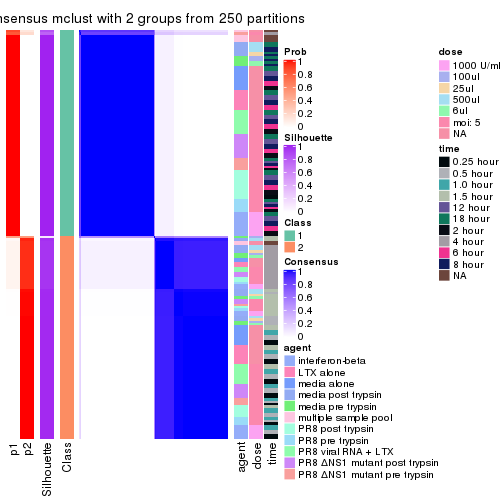
consensus_heatmap(res, k = 3)
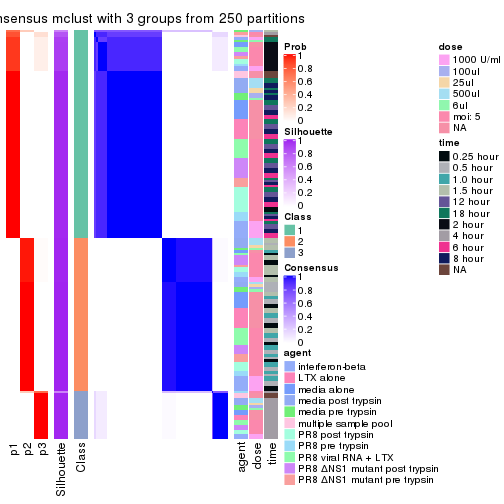
consensus_heatmap(res, k = 4)
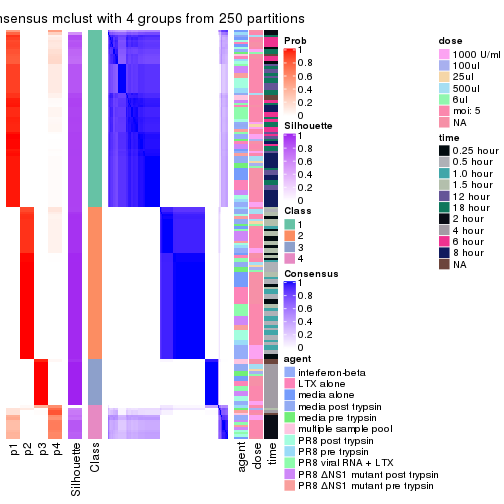
consensus_heatmap(res, k = 5)
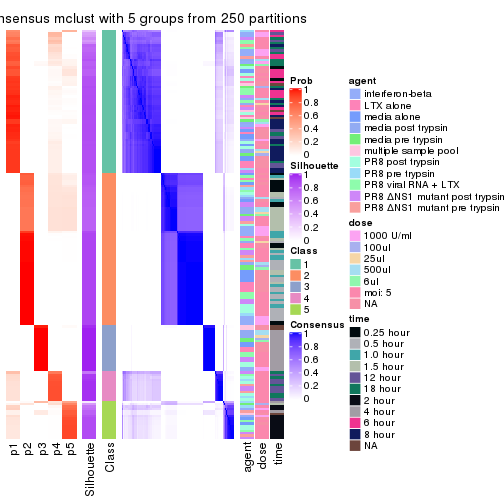
consensus_heatmap(res, k = 6)
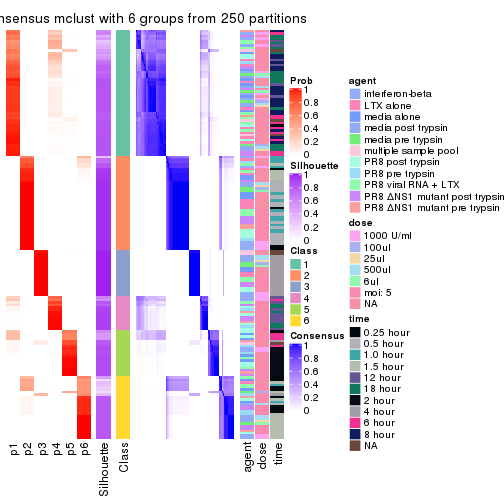
Heatmaps for the membership of samples in all partitions to see how consistent they are:
membership_heatmap(res, k = 2)
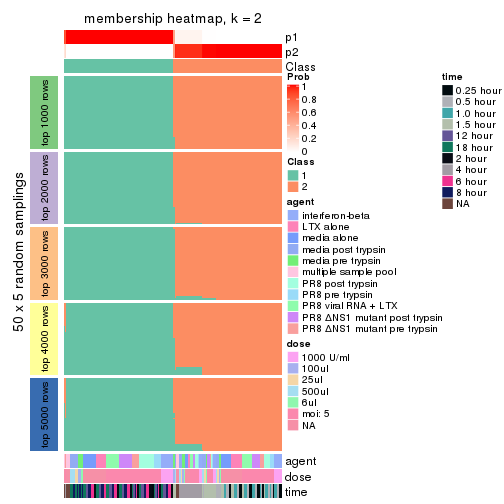
membership_heatmap(res, k = 3)
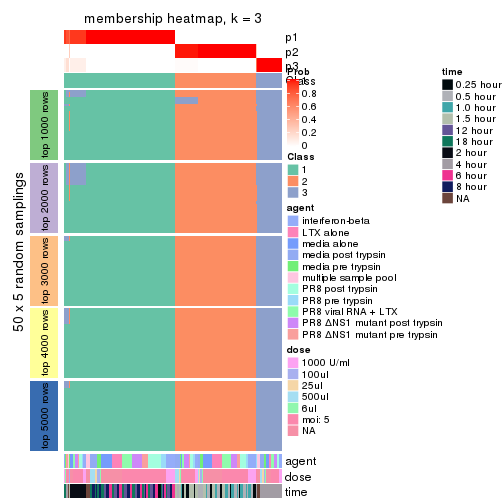
membership_heatmap(res, k = 4)
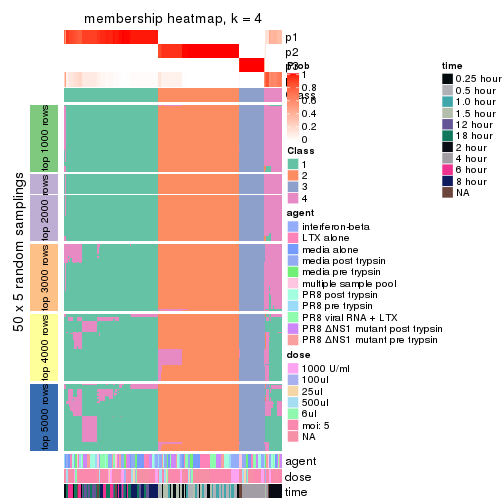
membership_heatmap(res, k = 5)
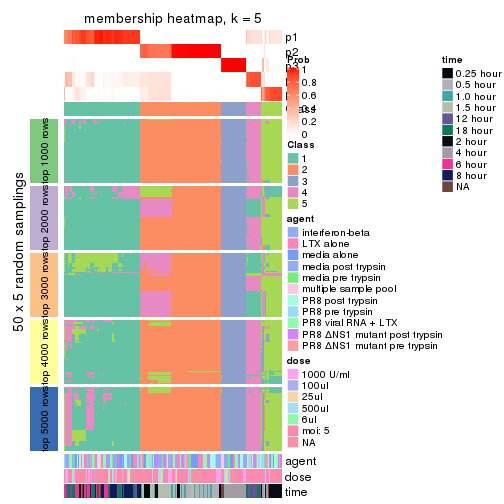
membership_heatmap(res, k = 6)
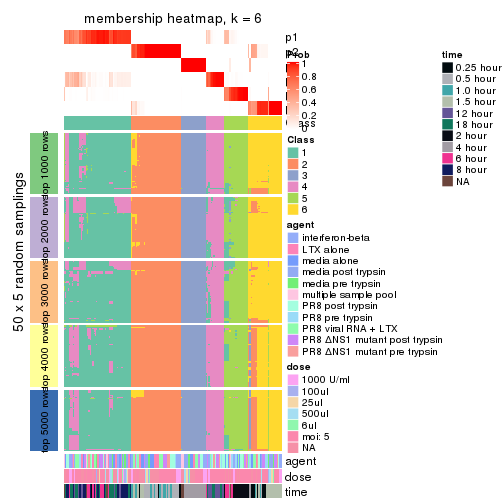
As soon as we have had the classes for columns, we can look for signatures which are significantly different between classes which can be candidate marks for certain classes. Following are the heatmaps for signatures.
Signature heatmaps where rows are scaled:
get_signatures(res, k = 2)
#> Error in mat[ceiling(1:nr/h_ratio), ceiling(1:nc/w_ratio), drop = FALSE]: subscript out of bounds
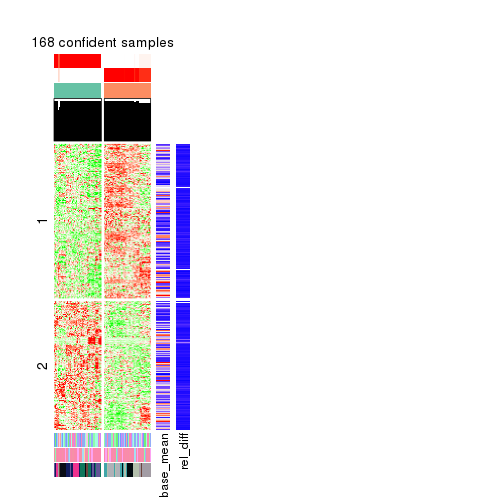
get_signatures(res, k = 3)
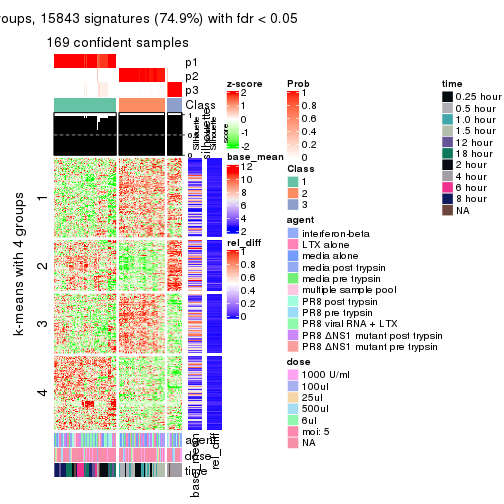
get_signatures(res, k = 4)
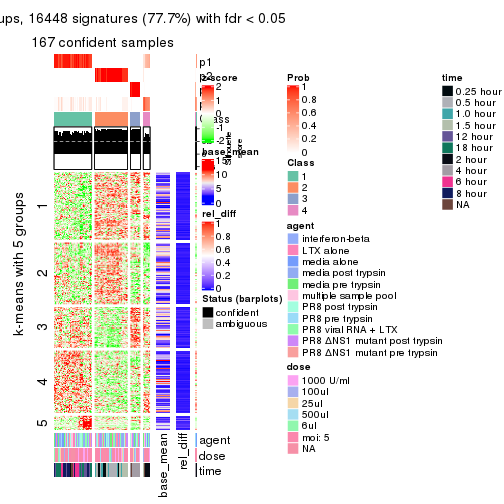
get_signatures(res, k = 5)
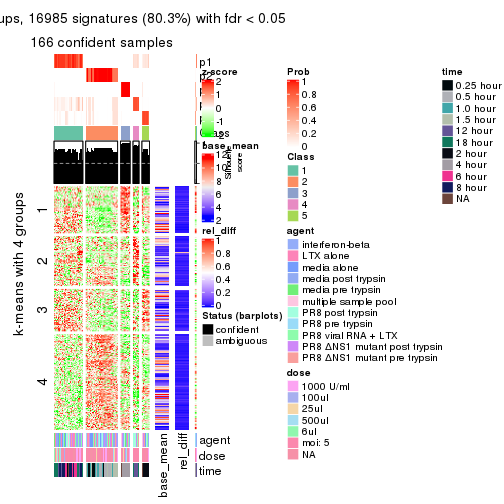
get_signatures(res, k = 6)
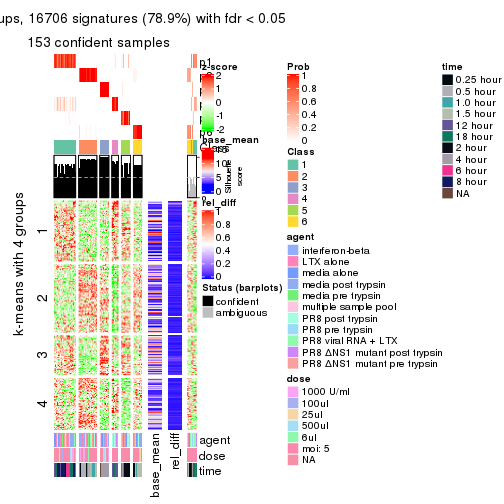
Signature heatmaps where rows are not scaled:
get_signatures(res, k = 2, scale_rows = FALSE)
#> Error in mat[ceiling(1:nr/h_ratio), ceiling(1:nc/w_ratio), drop = FALSE]: subscript out of bounds
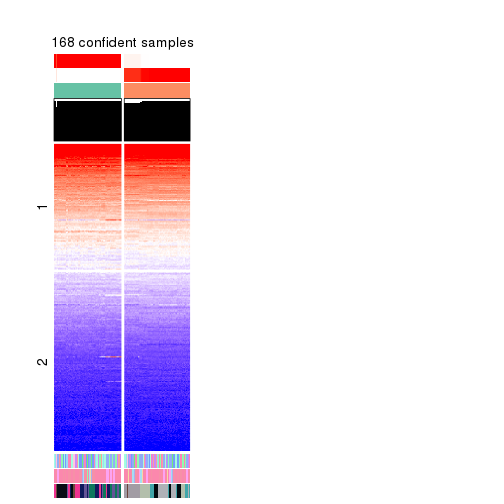
get_signatures(res, k = 3, scale_rows = FALSE)
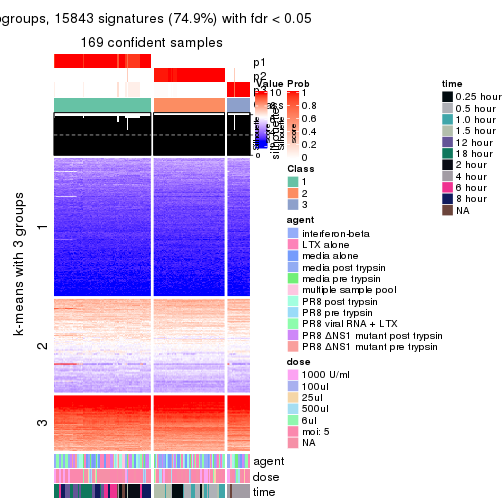
get_signatures(res, k = 4, scale_rows = FALSE)
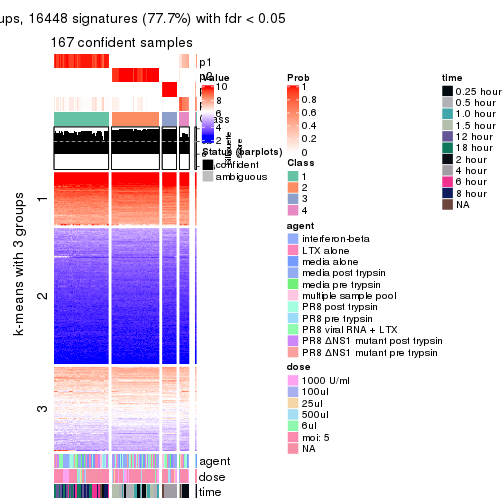
get_signatures(res, k = 5, scale_rows = FALSE)
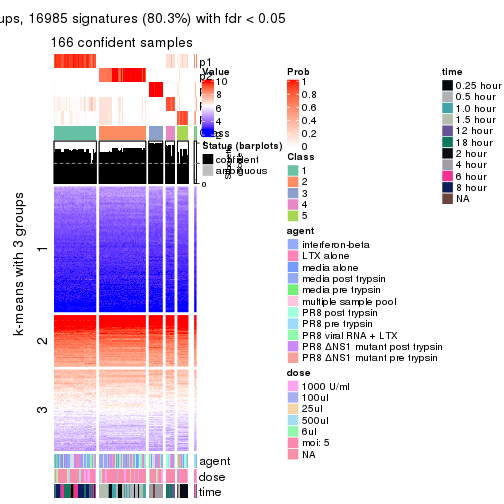
get_signatures(res, k = 6, scale_rows = FALSE)
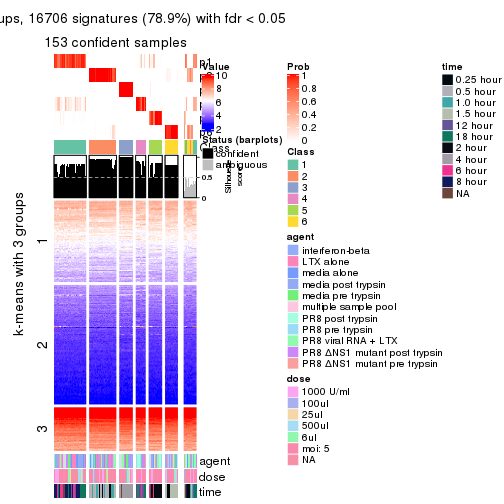
Compare the overlap of signatures from different k:
compare_signatures(res)
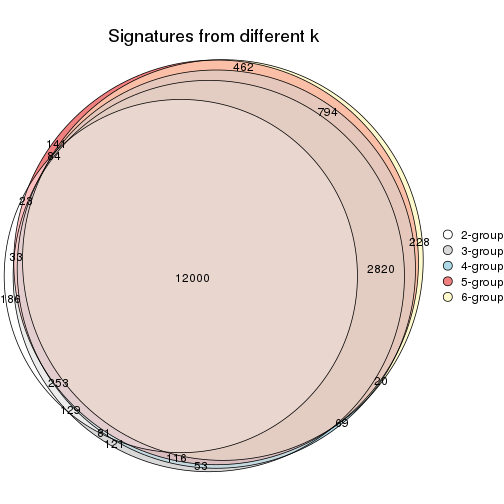
get_signature() returns a data frame invisibly. TO get the list of signatures, the function
call should be assigned to a variable explicitly. In following code, if plot argument is set
to FALSE, no heatmap is plotted while only the differential analysis is performed.
# code only for demonstration
tb = get_signature(res, k = ..., plot = FALSE)
An example of the output of tb is:
#> which_row fdr mean_1 mean_2 scaled_mean_1 scaled_mean_2 km
#> 1 38 0.042760348 8.373488 9.131774 -0.5533452 0.5164555 1
#> 2 40 0.018707592 7.106213 8.469186 -0.6173731 0.5762149 1
#> 3 55 0.019134737 10.221463 11.207825 -0.6159697 0.5749050 1
#> 4 59 0.006059896 5.921854 7.869574 -0.6899429 0.6439467 1
#> 5 60 0.018055526 8.928898 10.211722 -0.6204761 0.5791110 1
#> 6 98 0.009384629 15.714769 14.887706 0.6635654 -0.6193277 2
...
The columns in tb are:
which_row: row indices corresponding to the input matrix.fdr: FDR for the differential test. mean_x: The mean value in group x.scaled_mean_x: The mean value in group x after rows are scaled.km: Row groups if k-means clustering is applied to rows.UMAP plot which shows how samples are separated.
dimension_reduction(res, k = 2, method = "UMAP")
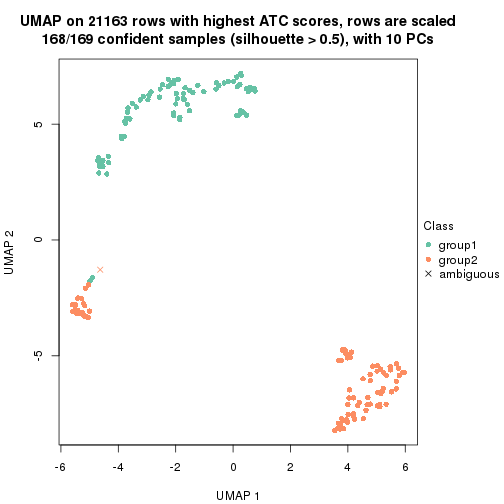
dimension_reduction(res, k = 3, method = "UMAP")
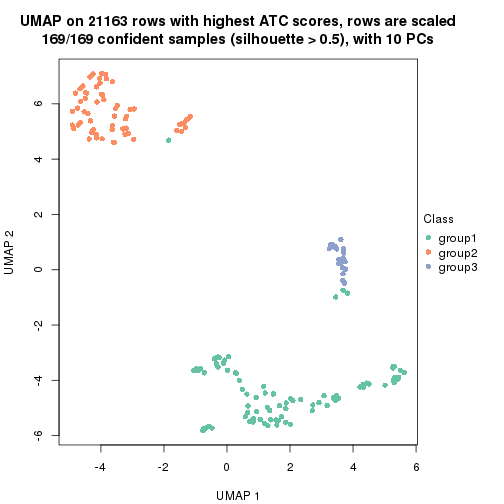
dimension_reduction(res, k = 4, method = "UMAP")
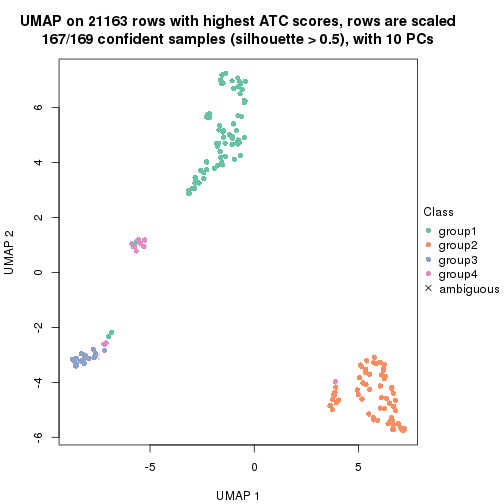
dimension_reduction(res, k = 5, method = "UMAP")
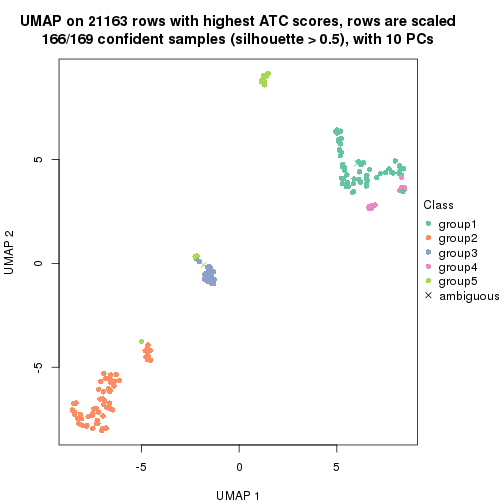
dimension_reduction(res, k = 6, method = "UMAP")
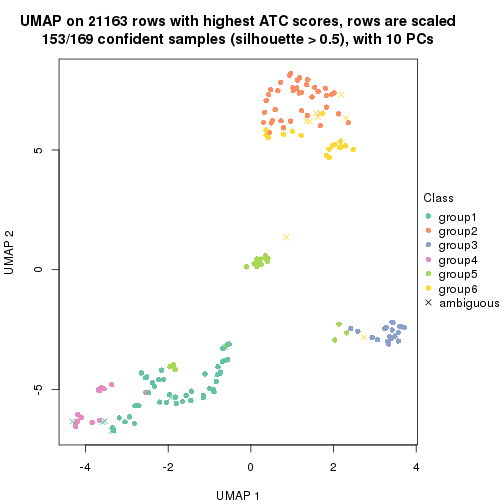
Following heatmap shows how subgroups are split when increasing k:
collect_classes(res)
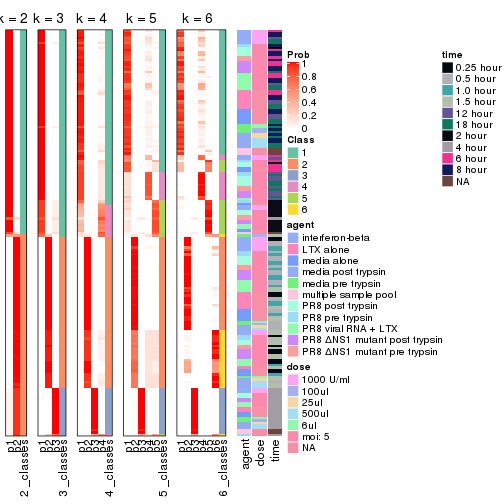
Test correlation between subgroups and known annotations. If the known annotation is numeric, one-way ANOVA test is applied, and if the known annotation is discrete, chi-squared contingency table test is applied.
test_to_known_factors(res)
#> n agent(p) dose(p) time(p) k
#> ATC:mclust 168 0.986 0.976 1.43e-27 2
#> ATC:mclust 169 0.973 0.992 3.35e-52 3
#> ATC:mclust 167 0.971 0.988 7.41e-70 4
#> ATC:mclust 166 0.610 0.539 3.89e-77 5
#> ATC:mclust 153 0.441 0.411 1.46e-73 6
If matrix rows can be associated to genes, consider to use functional_enrichment(res,
...) to perform function enrichment for the signature genes. See this vignette for more detailed explanations.
The object with results only for a single top-value method and a single partition method can be extracted as:
res = res_list["ATC", "NMF"]
# you can also extract it by
# res = res_list["ATC:NMF"]
A summary of res and all the functions that can be applied to it:
res
#> A 'ConsensusPartition' object with k = 2, 3, 4, 5, 6.
#> On a matrix with 21163 rows and 169 columns.
#> Top rows (1000, 2000, 3000, 4000, 5000) are extracted by 'ATC' method.
#> Subgroups are detected by 'NMF' method.
#> Performed in total 1250 partitions by row resampling.
#> Best k for subgroups seems to be 3.
#>
#> Following methods can be applied to this 'ConsensusPartition' object:
#> [1] "cola_report" "collect_classes" "collect_plots"
#> [4] "collect_stats" "colnames" "compare_signatures"
#> [7] "consensus_heatmap" "dimension_reduction" "functional_enrichment"
#> [10] "get_anno_col" "get_anno" "get_classes"
#> [13] "get_consensus" "get_matrix" "get_membership"
#> [16] "get_param" "get_signatures" "get_stats"
#> [19] "is_best_k" "is_stable_k" "membership_heatmap"
#> [22] "ncol" "nrow" "plot_ecdf"
#> [25] "rownames" "select_partition_number" "show"
#> [28] "suggest_best_k" "test_to_known_factors"
collect_plots() function collects all the plots made from res for all k (number of partitions)
into one single page to provide an easy and fast comparison between different k.
collect_plots(res)
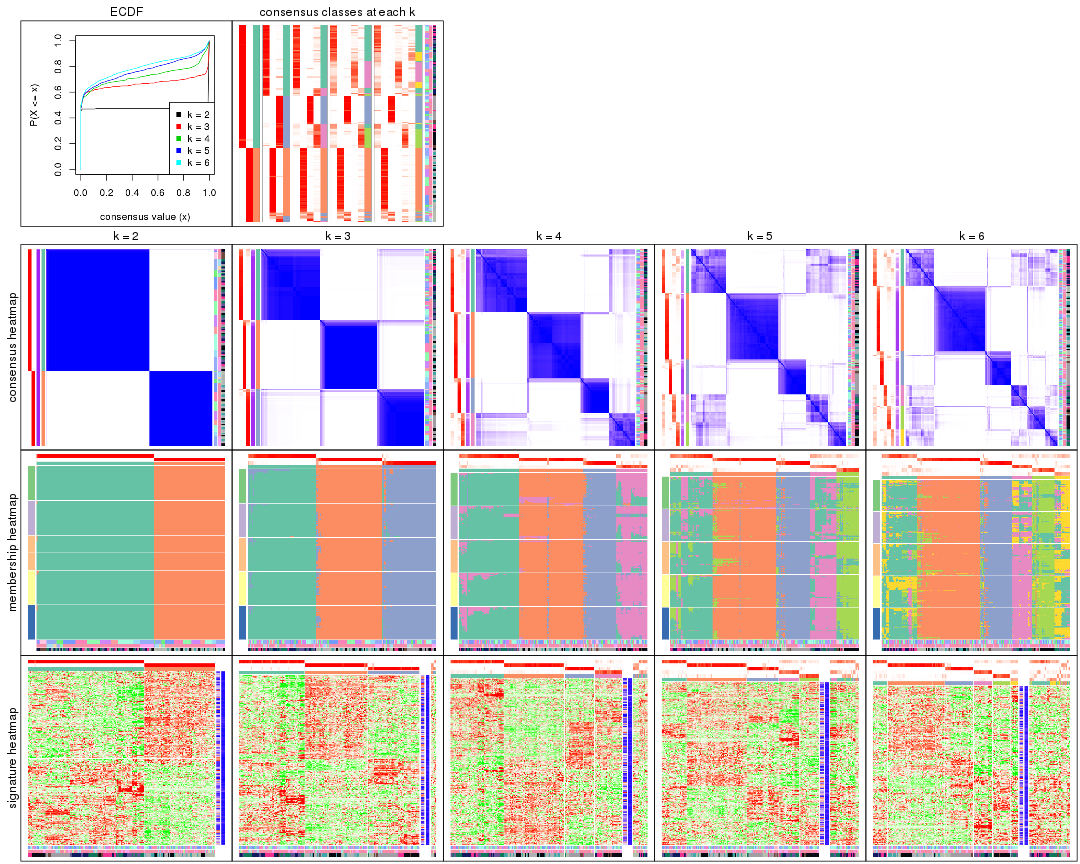
The plots are:
k and the heatmap of
predicted classes for each k.k.k.k.All the plots in panels can be made by individual functions and they are plotted later in this section.
select_partition_number() produces several plots showing different
statistics for choosing “optimized” k. There are following statistics:
k;k, the area increased is defined as \(A_k - A_{k-1}\).The detailed explanations of these statistics can be found in the cola vignette.
Generally speaking, lower PAC score, higher mean silhouette score or higher
concordance corresponds to better partition. Rand index and Jaccard index
measure how similar the current partition is compared to partition with k-1.
If they are too similar, we won't accept k is better than k-1.
select_partition_number(res)
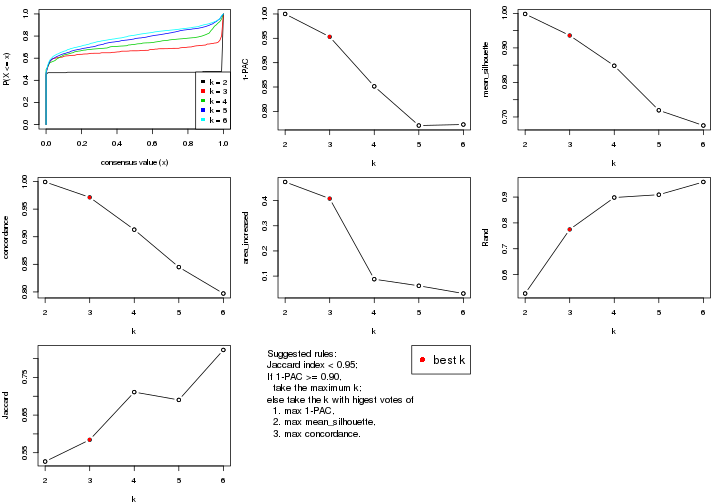
The numeric values for all these statistics can be obtained by get_stats().
get_stats(res)
#> k 1-PAC mean_silhouette concordance area_increased Rand Jaccard
#> 2 2 1.000 0.998 0.999 0.4743 0.527 0.527
#> 3 3 0.953 0.936 0.971 0.4080 0.775 0.584
#> 4 4 0.851 0.848 0.913 0.0875 0.898 0.711
#> 5 5 0.771 0.719 0.845 0.0614 0.909 0.690
#> 6 6 0.773 0.675 0.797 0.0307 0.958 0.823
suggest_best_k() suggests the best \(k\) based on these statistics. The rules are as follows:
suggest_best_k(res)
#> [1] 3
#> attr(,"optional")
#> [1] 2
There is also optional best \(k\) = 2 that is worth to check.
Following shows the table of the partitions (You need to click the show/hide
code output link to see it). The membership matrix (columns with name p*)
is inferred by
clue::cl_consensus()
function with the SE method. Basically the value in the membership matrix
represents the probability to belong to a certain group. The finall class
label for an item is determined with the group with highest probability it
belongs to.
In get_classes() function, the entropy is calculated from the membership
matrix and the silhouette score is calculated from the consensus matrix.
cbind(get_classes(res, k = 2), get_membership(res, k = 2))
#> class entropy silhouette p1 p2
#> GSM528681 2 0.0000 1.000 0.000 1.000
#> GSM528682 2 0.0000 1.000 0.000 1.000
#> GSM528683 2 0.0000 1.000 0.000 1.000
#> GSM528684 2 0.0000 1.000 0.000 1.000
#> GSM528687 2 0.0000 1.000 0.000 1.000
#> GSM528688 2 0.0000 1.000 0.000 1.000
#> GSM528685 2 0.0000 1.000 0.000 1.000
#> GSM528686 2 0.0000 1.000 0.000 1.000
#> GSM528693 1 0.0000 0.999 1.000 0.000
#> GSM528694 1 0.0000 0.999 1.000 0.000
#> GSM528695 1 0.0000 0.999 1.000 0.000
#> GSM528696 1 0.0000 0.999 1.000 0.000
#> GSM528697 1 0.0000 0.999 1.000 0.000
#> GSM528698 1 0.0000 0.999 1.000 0.000
#> GSM528699 1 0.0000 0.999 1.000 0.000
#> GSM528700 1 0.0000 0.999 1.000 0.000
#> GSM528689 1 0.0000 0.999 1.000 0.000
#> GSM528690 1 0.0000 0.999 1.000 0.000
#> GSM528691 1 0.0000 0.999 1.000 0.000
#> GSM528692 1 0.0000 0.999 1.000 0.000
#> GSM528779 2 0.0000 1.000 0.000 1.000
#> GSM528780 2 0.0000 1.000 0.000 1.000
#> GSM528782 2 0.0000 1.000 0.000 1.000
#> GSM528781 2 0.0000 1.000 0.000 1.000
#> GSM528785 1 0.0000 0.999 1.000 0.000
#> GSM528786 1 0.0000 0.999 1.000 0.000
#> GSM528787 1 0.0000 0.999 1.000 0.000
#> GSM528788 1 0.0000 0.999 1.000 0.000
#> GSM528783 1 0.0000 0.999 1.000 0.000
#> GSM528784 1 0.0000 0.999 1.000 0.000
#> GSM528759 1 0.0000 0.999 1.000 0.000
#> GSM528760 1 0.0000 0.999 1.000 0.000
#> GSM528761 2 0.0000 1.000 0.000 1.000
#> GSM528762 2 0.0000 1.000 0.000 1.000
#> GSM528765 2 0.0000 1.000 0.000 1.000
#> GSM528766 2 0.0000 1.000 0.000 1.000
#> GSM528763 2 0.0000 1.000 0.000 1.000
#> GSM528764 2 0.0000 1.000 0.000 1.000
#> GSM528771 1 0.0000 0.999 1.000 0.000
#> GSM528772 1 0.0000 0.999 1.000 0.000
#> GSM528773 1 0.0000 0.999 1.000 0.000
#> GSM528774 1 0.0000 0.999 1.000 0.000
#> GSM528775 1 0.0000 0.999 1.000 0.000
#> GSM528776 1 0.0000 0.999 1.000 0.000
#> GSM528777 1 0.0000 0.999 1.000 0.000
#> GSM528778 1 0.0000 0.999 1.000 0.000
#> GSM528767 1 0.0000 0.999 1.000 0.000
#> GSM528768 1 0.0000 0.999 1.000 0.000
#> GSM528769 1 0.0000 0.999 1.000 0.000
#> GSM528770 1 0.0000 0.999 1.000 0.000
#> GSM528671 2 0.0000 1.000 0.000 1.000
#> GSM528672 2 0.0000 1.000 0.000 1.000
#> GSM528674 2 0.0000 1.000 0.000 1.000
#> GSM528673 2 0.0000 1.000 0.000 1.000
#> GSM528677 1 0.0000 0.999 1.000 0.000
#> GSM528678 1 0.0000 0.999 1.000 0.000
#> GSM528679 1 0.0000 0.999 1.000 0.000
#> GSM528680 1 0.0000 0.999 1.000 0.000
#> GSM528675 1 0.0000 0.999 1.000 0.000
#> GSM528676 1 0.0000 0.999 1.000 0.000
#> GSM528651 2 0.0000 1.000 0.000 1.000
#> GSM528652 2 0.0000 1.000 0.000 1.000
#> GSM528653 2 0.0000 1.000 0.000 1.000
#> GSM528654 2 0.0000 1.000 0.000 1.000
#> GSM528657 2 0.0000 1.000 0.000 1.000
#> GSM528658 2 0.0000 1.000 0.000 1.000
#> GSM528655 2 0.0000 1.000 0.000 1.000
#> GSM528656 2 0.0000 1.000 0.000 1.000
#> GSM528663 1 0.0672 0.991 0.992 0.008
#> GSM528664 1 0.5178 0.869 0.884 0.116
#> GSM528665 1 0.0000 0.999 1.000 0.000
#> GSM528666 1 0.0000 0.999 1.000 0.000
#> GSM528667 1 0.0000 0.999 1.000 0.000
#> GSM528668 1 0.0000 0.999 1.000 0.000
#> GSM528669 1 0.0000 0.999 1.000 0.000
#> GSM528670 1 0.0000 0.999 1.000 0.000
#> GSM528659 1 0.0000 0.999 1.000 0.000
#> GSM528660 1 0.0000 0.999 1.000 0.000
#> GSM528661 1 0.0000 0.999 1.000 0.000
#> GSM528662 1 0.0000 0.999 1.000 0.000
#> GSM528701 2 0.0000 1.000 0.000 1.000
#> GSM528702 2 0.0000 1.000 0.000 1.000
#> GSM528703 2 0.0000 1.000 0.000 1.000
#> GSM528704 2 0.0000 1.000 0.000 1.000
#> GSM528707 2 0.0000 1.000 0.000 1.000
#> GSM528708 2 0.0000 1.000 0.000 1.000
#> GSM528705 2 0.0000 1.000 0.000 1.000
#> GSM528706 2 0.0000 1.000 0.000 1.000
#> GSM528713 1 0.0000 0.999 1.000 0.000
#> GSM528714 1 0.0000 0.999 1.000 0.000
#> GSM528715 1 0.0000 0.999 1.000 0.000
#> GSM528716 1 0.0000 0.999 1.000 0.000
#> GSM528717 1 0.0000 0.999 1.000 0.000
#> GSM528718 1 0.0000 0.999 1.000 0.000
#> GSM528719 1 0.0000 0.999 1.000 0.000
#> GSM528720 1 0.0000 0.999 1.000 0.000
#> GSM528709 1 0.0000 0.999 1.000 0.000
#> GSM528710 1 0.0000 0.999 1.000 0.000
#> GSM528711 1 0.0000 0.999 1.000 0.000
#> GSM528712 1 0.0000 0.999 1.000 0.000
#> GSM528721 2 0.0000 1.000 0.000 1.000
#> GSM528722 2 0.0000 1.000 0.000 1.000
#> GSM528723 2 0.0000 1.000 0.000 1.000
#> GSM528724 2 0.0000 1.000 0.000 1.000
#> GSM528727 2 0.0000 1.000 0.000 1.000
#> GSM528728 2 0.0000 1.000 0.000 1.000
#> GSM528725 2 0.0000 1.000 0.000 1.000
#> GSM528726 2 0.0000 1.000 0.000 1.000
#> GSM528733 1 0.0000 0.999 1.000 0.000
#> GSM528734 1 0.0000 0.999 1.000 0.000
#> GSM528735 1 0.0000 0.999 1.000 0.000
#> GSM528736 1 0.0000 0.999 1.000 0.000
#> GSM528737 1 0.0000 0.999 1.000 0.000
#> GSM528738 1 0.0000 0.999 1.000 0.000
#> GSM528729 1 0.0000 0.999 1.000 0.000
#> GSM528730 1 0.0000 0.999 1.000 0.000
#> GSM528731 1 0.0000 0.999 1.000 0.000
#> GSM528732 1 0.0000 0.999 1.000 0.000
#> GSM528739 2 0.0000 1.000 0.000 1.000
#> GSM528740 2 0.0000 1.000 0.000 1.000
#> GSM528741 2 0.0000 1.000 0.000 1.000
#> GSM528742 2 0.0000 1.000 0.000 1.000
#> GSM528745 2 0.0000 1.000 0.000 1.000
#> GSM528746 2 0.0000 1.000 0.000 1.000
#> GSM528743 2 0.0000 1.000 0.000 1.000
#> GSM528744 2 0.0000 1.000 0.000 1.000
#> GSM528751 1 0.0000 0.999 1.000 0.000
#> GSM528752 1 0.0000 0.999 1.000 0.000
#> GSM528753 1 0.0000 0.999 1.000 0.000
#> GSM528754 1 0.0000 0.999 1.000 0.000
#> GSM528755 1 0.0000 0.999 1.000 0.000
#> GSM528756 1 0.0000 0.999 1.000 0.000
#> GSM528757 1 0.0672 0.991 0.992 0.008
#> GSM528758 1 0.0000 0.999 1.000 0.000
#> GSM528747 1 0.0000 0.999 1.000 0.000
#> GSM528748 1 0.0000 0.999 1.000 0.000
#> GSM528749 1 0.0000 0.999 1.000 0.000
#> GSM528750 1 0.0000 0.999 1.000 0.000
#> GSM528640 2 0.0000 1.000 0.000 1.000
#> GSM528641 2 0.0000 1.000 0.000 1.000
#> GSM528643 1 0.0000 0.999 1.000 0.000
#> GSM528644 1 0.0000 0.999 1.000 0.000
#> GSM528642 1 0.0000 0.999 1.000 0.000
#> GSM528620 2 0.0000 1.000 0.000 1.000
#> GSM528621 2 0.0376 0.996 0.004 0.996
#> GSM528623 1 0.0000 0.999 1.000 0.000
#> GSM528624 1 0.0000 0.999 1.000 0.000
#> GSM528622 1 0.0000 0.999 1.000 0.000
#> GSM528625 2 0.0000 1.000 0.000 1.000
#> GSM528626 2 0.0000 1.000 0.000 1.000
#> GSM528628 1 0.0000 0.999 1.000 0.000
#> GSM528629 1 0.0000 0.999 1.000 0.000
#> GSM528627 1 0.0000 0.999 1.000 0.000
#> GSM528630 2 0.0000 1.000 0.000 1.000
#> GSM528631 2 0.0000 1.000 0.000 1.000
#> GSM528632 2 0.0000 1.000 0.000 1.000
#> GSM528633 2 0.0000 1.000 0.000 1.000
#> GSM528636 1 0.0000 0.999 1.000 0.000
#> GSM528637 1 0.0000 0.999 1.000 0.000
#> GSM528638 1 0.0000 0.999 1.000 0.000
#> GSM528639 1 0.0000 0.999 1.000 0.000
#> GSM528634 1 0.0000 0.999 1.000 0.000
#> GSM528635 1 0.0000 0.999 1.000 0.000
#> GSM528645 1 0.0000 0.999 1.000 0.000
#> GSM528646 1 0.0000 0.999 1.000 0.000
#> GSM528647 1 0.0000 0.999 1.000 0.000
#> GSM528648 1 0.0000 0.999 1.000 0.000
#> GSM528649 1 0.0000 0.999 1.000 0.000
#> GSM528650 1 0.0000 0.999 1.000 0.000
cbind(get_classes(res, k = 3), get_membership(res, k = 3))
#> class entropy silhouette p1 p2 p3
#> GSM528681 2 0.0000 0.975 0.000 1.000 0.000
#> GSM528682 2 0.0000 0.975 0.000 1.000 0.000
#> GSM528683 2 0.0000 0.975 0.000 1.000 0.000
#> GSM528684 2 0.0000 0.975 0.000 1.000 0.000
#> GSM528687 2 0.0000 0.975 0.000 1.000 0.000
#> GSM528688 2 0.0000 0.975 0.000 1.000 0.000
#> GSM528685 2 0.0237 0.971 0.000 0.996 0.004
#> GSM528686 3 0.5621 0.542 0.000 0.308 0.692
#> GSM528693 3 0.0000 0.966 0.000 0.000 1.000
#> GSM528694 3 0.0000 0.966 0.000 0.000 1.000
#> GSM528695 3 0.0000 0.966 0.000 0.000 1.000
#> GSM528696 3 0.0000 0.966 0.000 0.000 1.000
#> GSM528697 1 0.0592 0.970 0.988 0.000 0.012
#> GSM528698 1 0.1163 0.962 0.972 0.000 0.028
#> GSM528699 1 0.0592 0.970 0.988 0.000 0.012
#> GSM528700 1 0.0424 0.970 0.992 0.000 0.008
#> GSM528689 1 0.0592 0.970 0.988 0.000 0.012
#> GSM528690 1 0.0000 0.969 1.000 0.000 0.000
#> GSM528691 1 0.0592 0.970 0.988 0.000 0.012
#> GSM528692 1 0.3551 0.864 0.868 0.000 0.132
#> GSM528779 2 0.0000 0.975 0.000 1.000 0.000
#> GSM528780 2 0.0000 0.975 0.000 1.000 0.000
#> GSM528782 2 0.0000 0.975 0.000 1.000 0.000
#> GSM528781 2 0.0000 0.975 0.000 1.000 0.000
#> GSM528785 1 0.1163 0.962 0.972 0.000 0.028
#> GSM528786 3 0.0237 0.964 0.000 0.004 0.996
#> GSM528787 3 0.0000 0.966 0.000 0.000 1.000
#> GSM528788 1 0.0000 0.969 1.000 0.000 0.000
#> GSM528783 1 0.0000 0.969 1.000 0.000 0.000
#> GSM528784 1 0.0000 0.969 1.000 0.000 0.000
#> GSM528759 3 0.0237 0.964 0.004 0.000 0.996
#> GSM528760 3 0.0237 0.964 0.004 0.000 0.996
#> GSM528761 2 0.0000 0.975 0.000 1.000 0.000
#> GSM528762 2 0.0000 0.975 0.000 1.000 0.000
#> GSM528765 2 0.0000 0.975 0.000 1.000 0.000
#> GSM528766 2 0.0000 0.975 0.000 1.000 0.000
#> GSM528763 2 0.0000 0.975 0.000 1.000 0.000
#> GSM528764 2 0.6291 0.127 0.000 0.532 0.468
#> GSM528771 3 0.0000 0.966 0.000 0.000 1.000
#> GSM528772 3 0.0000 0.966 0.000 0.000 1.000
#> GSM528773 3 0.0000 0.966 0.000 0.000 1.000
#> GSM528774 3 0.0000 0.966 0.000 0.000 1.000
#> GSM528775 3 0.0237 0.964 0.004 0.000 0.996
#> GSM528776 1 0.1031 0.964 0.976 0.000 0.024
#> GSM528777 1 0.0000 0.969 1.000 0.000 0.000
#> GSM528778 1 0.0000 0.969 1.000 0.000 0.000
#> GSM528767 1 0.0000 0.969 1.000 0.000 0.000
#> GSM528768 1 0.0000 0.969 1.000 0.000 0.000
#> GSM528769 1 0.0000 0.969 1.000 0.000 0.000
#> GSM528770 1 0.0237 0.970 0.996 0.000 0.004
#> GSM528671 2 0.0000 0.975 0.000 1.000 0.000
#> GSM528672 2 0.0000 0.975 0.000 1.000 0.000
#> GSM528674 2 0.0000 0.975 0.000 1.000 0.000
#> GSM528673 2 0.6204 0.268 0.000 0.576 0.424
#> GSM528677 3 0.0000 0.966 0.000 0.000 1.000
#> GSM528678 3 0.0000 0.966 0.000 0.000 1.000
#> GSM528679 1 0.0892 0.966 0.980 0.000 0.020
#> GSM528680 1 0.0237 0.970 0.996 0.000 0.004
#> GSM528675 1 0.0237 0.970 0.996 0.000 0.004
#> GSM528676 1 0.0237 0.970 0.996 0.000 0.004
#> GSM528651 2 0.0000 0.975 0.000 1.000 0.000
#> GSM528652 2 0.0000 0.975 0.000 1.000 0.000
#> GSM528653 2 0.0000 0.975 0.000 1.000 0.000
#> GSM528654 2 0.0000 0.975 0.000 1.000 0.000
#> GSM528657 2 0.0000 0.975 0.000 1.000 0.000
#> GSM528658 2 0.0000 0.975 0.000 1.000 0.000
#> GSM528655 2 0.4178 0.785 0.000 0.828 0.172
#> GSM528656 2 0.5098 0.669 0.000 0.752 0.248
#> GSM528663 3 0.0237 0.964 0.000 0.004 0.996
#> GSM528664 3 0.0424 0.960 0.000 0.008 0.992
#> GSM528665 3 0.0000 0.966 0.000 0.000 1.000
#> GSM528666 3 0.0000 0.966 0.000 0.000 1.000
#> GSM528667 1 0.0892 0.966 0.980 0.000 0.020
#> GSM528668 1 0.0892 0.966 0.980 0.000 0.020
#> GSM528669 1 0.0237 0.967 0.996 0.004 0.000
#> GSM528670 1 0.0000 0.969 1.000 0.000 0.000
#> GSM528659 1 0.0000 0.969 1.000 0.000 0.000
#> GSM528660 1 0.0000 0.969 1.000 0.000 0.000
#> GSM528661 1 0.0592 0.970 0.988 0.000 0.012
#> GSM528662 1 0.0747 0.968 0.984 0.000 0.016
#> GSM528701 2 0.0000 0.975 0.000 1.000 0.000
#> GSM528702 2 0.0000 0.975 0.000 1.000 0.000
#> GSM528703 2 0.0000 0.975 0.000 1.000 0.000
#> GSM528704 2 0.0000 0.975 0.000 1.000 0.000
#> GSM528707 2 0.0000 0.975 0.000 1.000 0.000
#> GSM528708 2 0.0237 0.971 0.004 0.996 0.000
#> GSM528705 2 0.0000 0.975 0.000 1.000 0.000
#> GSM528706 2 0.0000 0.975 0.000 1.000 0.000
#> GSM528713 3 0.0000 0.966 0.000 0.000 1.000
#> GSM528714 3 0.0000 0.966 0.000 0.000 1.000
#> GSM528715 3 0.0000 0.966 0.000 0.000 1.000
#> GSM528716 3 0.0000 0.966 0.000 0.000 1.000
#> GSM528717 1 0.2165 0.932 0.936 0.000 0.064
#> GSM528718 1 0.5016 0.716 0.760 0.000 0.240
#> GSM528719 1 0.6192 0.326 0.580 0.000 0.420
#> GSM528720 1 0.1529 0.953 0.960 0.000 0.040
#> GSM528709 1 0.0237 0.970 0.996 0.000 0.004
#> GSM528710 1 0.0000 0.969 1.000 0.000 0.000
#> GSM528711 1 0.0592 0.970 0.988 0.000 0.012
#> GSM528712 1 0.0592 0.970 0.988 0.000 0.012
#> GSM528721 2 0.0000 0.975 0.000 1.000 0.000
#> GSM528722 2 0.0000 0.975 0.000 1.000 0.000
#> GSM528723 2 0.0000 0.975 0.000 1.000 0.000
#> GSM528724 2 0.0000 0.975 0.000 1.000 0.000
#> GSM528727 2 0.0000 0.975 0.000 1.000 0.000
#> GSM528728 2 0.0000 0.975 0.000 1.000 0.000
#> GSM528725 2 0.0000 0.975 0.000 1.000 0.000
#> GSM528726 2 0.0000 0.975 0.000 1.000 0.000
#> GSM528733 3 0.0000 0.966 0.000 0.000 1.000
#> GSM528734 3 0.0000 0.966 0.000 0.000 1.000
#> GSM528735 3 0.0237 0.964 0.004 0.000 0.996
#> GSM528736 3 0.0237 0.964 0.004 0.000 0.996
#> GSM528737 1 0.1163 0.962 0.972 0.000 0.028
#> GSM528738 1 0.4121 0.819 0.832 0.000 0.168
#> GSM528729 1 0.0000 0.969 1.000 0.000 0.000
#> GSM528730 1 0.0000 0.969 1.000 0.000 0.000
#> GSM528731 1 0.0000 0.969 1.000 0.000 0.000
#> GSM528732 1 0.0592 0.970 0.988 0.000 0.012
#> GSM528739 2 0.0000 0.975 0.000 1.000 0.000
#> GSM528740 2 0.0000 0.975 0.000 1.000 0.000
#> GSM528741 2 0.0000 0.975 0.000 1.000 0.000
#> GSM528742 2 0.0000 0.975 0.000 1.000 0.000
#> GSM528745 2 0.0000 0.975 0.000 1.000 0.000
#> GSM528746 2 0.0000 0.975 0.000 1.000 0.000
#> GSM528743 2 0.0000 0.975 0.000 1.000 0.000
#> GSM528744 2 0.0000 0.975 0.000 1.000 0.000
#> GSM528751 3 0.2878 0.878 0.096 0.000 0.904
#> GSM528752 3 0.0592 0.958 0.012 0.000 0.988
#> GSM528753 3 0.0000 0.966 0.000 0.000 1.000
#> GSM528754 3 0.0000 0.966 0.000 0.000 1.000
#> GSM528755 3 0.2537 0.895 0.080 0.000 0.920
#> GSM528756 3 0.1163 0.945 0.028 0.000 0.972
#> GSM528757 1 0.0237 0.967 0.996 0.004 0.000
#> GSM528758 1 0.0237 0.967 0.996 0.004 0.000
#> GSM528747 1 0.0000 0.969 1.000 0.000 0.000
#> GSM528748 1 0.0592 0.970 0.988 0.000 0.012
#> GSM528749 1 0.0592 0.970 0.988 0.000 0.012
#> GSM528750 1 0.0000 0.969 1.000 0.000 0.000
#> GSM528640 2 0.0000 0.975 0.000 1.000 0.000
#> GSM528641 2 0.2959 0.874 0.000 0.900 0.100
#> GSM528643 3 0.0000 0.966 0.000 0.000 1.000
#> GSM528644 1 0.0592 0.970 0.988 0.000 0.012
#> GSM528642 3 0.2878 0.878 0.096 0.000 0.904
#> GSM528620 2 0.0000 0.975 0.000 1.000 0.000
#> GSM528621 3 0.1031 0.947 0.000 0.024 0.976
#> GSM528623 3 0.0000 0.966 0.000 0.000 1.000
#> GSM528624 1 0.0000 0.969 1.000 0.000 0.000
#> GSM528622 1 0.0592 0.970 0.988 0.000 0.012
#> GSM528625 2 0.0000 0.975 0.000 1.000 0.000
#> GSM528626 3 0.5988 0.402 0.000 0.368 0.632
#> GSM528628 3 0.0000 0.966 0.000 0.000 1.000
#> GSM528629 1 0.0592 0.970 0.988 0.000 0.012
#> GSM528627 1 0.1163 0.962 0.972 0.000 0.028
#> GSM528630 2 0.0000 0.975 0.000 1.000 0.000
#> GSM528631 2 0.0000 0.975 0.000 1.000 0.000
#> GSM528632 3 0.1529 0.932 0.000 0.040 0.960
#> GSM528633 3 0.1860 0.921 0.000 0.052 0.948
#> GSM528636 3 0.0000 0.966 0.000 0.000 1.000
#> GSM528637 3 0.0000 0.966 0.000 0.000 1.000
#> GSM528638 1 0.0000 0.969 1.000 0.000 0.000
#> GSM528639 1 0.0424 0.970 0.992 0.000 0.008
#> GSM528634 1 0.4702 0.758 0.788 0.000 0.212
#> GSM528635 1 0.1163 0.962 0.972 0.000 0.028
#> GSM528645 3 0.0000 0.966 0.000 0.000 1.000
#> GSM528646 3 0.0000 0.966 0.000 0.000 1.000
#> GSM528647 3 0.0000 0.966 0.000 0.000 1.000
#> GSM528648 3 0.6095 0.322 0.392 0.000 0.608
#> GSM528649 3 0.0237 0.964 0.004 0.000 0.996
#> GSM528650 1 0.4121 0.820 0.832 0.000 0.168
cbind(get_classes(res, k = 4), get_membership(res, k = 4))
#> class entropy silhouette p1 p2 p3 p4
#> GSM528681 2 0.0336 0.95137 0.000 0.992 0.000 0.008
#> GSM528682 2 0.0000 0.95275 0.000 1.000 0.000 0.000
#> GSM528683 2 0.0000 0.95275 0.000 1.000 0.000 0.000
#> GSM528684 2 0.1557 0.94868 0.000 0.944 0.000 0.056
#> GSM528687 2 0.0336 0.95137 0.000 0.992 0.000 0.008
#> GSM528688 2 0.0469 0.95015 0.000 0.988 0.000 0.012
#> GSM528685 2 0.1938 0.94594 0.000 0.936 0.012 0.052
#> GSM528686 2 0.5294 0.00696 0.000 0.508 0.484 0.008
#> GSM528693 4 0.3598 0.78091 0.028 0.000 0.124 0.848
#> GSM528694 4 0.3383 0.82829 0.076 0.000 0.052 0.872
#> GSM528695 3 0.0000 0.92724 0.000 0.000 1.000 0.000
#> GSM528696 3 0.0000 0.92724 0.000 0.000 1.000 0.000
#> GSM528697 1 0.0592 0.89502 0.984 0.000 0.000 0.016
#> GSM528698 1 0.1867 0.89453 0.928 0.000 0.000 0.072
#> GSM528699 4 0.4992 0.16038 0.476 0.000 0.000 0.524
#> GSM528700 1 0.1118 0.90371 0.964 0.000 0.000 0.036
#> GSM528689 1 0.1211 0.90309 0.960 0.000 0.000 0.040
#> GSM528690 1 0.0188 0.90116 0.996 0.000 0.000 0.004
#> GSM528691 1 0.0592 0.90353 0.984 0.000 0.000 0.016
#> GSM528692 1 0.4957 0.50491 0.684 0.000 0.300 0.016
#> GSM528779 2 0.1716 0.94628 0.000 0.936 0.000 0.064
#> GSM528780 2 0.1389 0.95051 0.000 0.952 0.000 0.048
#> GSM528782 2 0.0592 0.94871 0.000 0.984 0.000 0.016
#> GSM528781 2 0.2814 0.89687 0.000 0.868 0.000 0.132
#> GSM528785 4 0.2216 0.82499 0.092 0.000 0.000 0.908
#> GSM528786 3 0.0000 0.92724 0.000 0.000 1.000 0.000
#> GSM528787 4 0.4697 0.50218 0.000 0.000 0.356 0.644
#> GSM528788 1 0.1302 0.90331 0.956 0.000 0.000 0.044
#> GSM528783 1 0.0592 0.89502 0.984 0.000 0.000 0.016
#> GSM528784 1 0.0592 0.89502 0.984 0.000 0.000 0.016
#> GSM528759 4 0.6022 0.68590 0.084 0.000 0.260 0.656
#> GSM528760 4 0.5321 0.71540 0.056 0.000 0.228 0.716
#> GSM528761 2 0.1716 0.94628 0.000 0.936 0.000 0.064
#> GSM528762 2 0.0188 0.95305 0.000 0.996 0.000 0.004
#> GSM528765 2 0.1716 0.94628 0.000 0.936 0.000 0.064
#> GSM528766 2 0.0188 0.95218 0.000 0.996 0.000 0.004
#> GSM528763 2 0.0592 0.95357 0.000 0.984 0.000 0.016
#> GSM528764 3 0.3123 0.75830 0.000 0.156 0.844 0.000
#> GSM528771 4 0.1640 0.80604 0.012 0.012 0.020 0.956
#> GSM528772 4 0.1617 0.80494 0.008 0.012 0.024 0.956
#> GSM528773 3 0.0000 0.92724 0.000 0.000 1.000 0.000
#> GSM528774 3 0.0000 0.92724 0.000 0.000 1.000 0.000
#> GSM528775 4 0.4300 0.82402 0.092 0.000 0.088 0.820
#> GSM528776 1 0.4746 0.44372 0.632 0.000 0.000 0.368
#> GSM528777 1 0.0921 0.90396 0.972 0.000 0.000 0.028
#> GSM528778 1 0.0592 0.90315 0.984 0.000 0.000 0.016
#> GSM528767 1 0.0592 0.89502 0.984 0.000 0.000 0.016
#> GSM528768 1 0.0592 0.89502 0.984 0.000 0.000 0.016
#> GSM528769 1 0.0592 0.89502 0.984 0.000 0.000 0.016
#> GSM528770 1 0.0592 0.89502 0.984 0.000 0.000 0.016
#> GSM528671 2 0.1637 0.94759 0.000 0.940 0.000 0.060
#> GSM528672 2 0.0469 0.95343 0.000 0.988 0.000 0.012
#> GSM528674 2 0.0817 0.95312 0.000 0.976 0.000 0.024
#> GSM528673 3 0.4977 0.14781 0.000 0.460 0.540 0.000
#> GSM528677 4 0.2186 0.79596 0.008 0.012 0.048 0.932
#> GSM528678 3 0.0921 0.90607 0.000 0.000 0.972 0.028
#> GSM528679 1 0.1637 0.90042 0.940 0.000 0.000 0.060
#> GSM528680 1 0.1940 0.89570 0.924 0.000 0.000 0.076
#> GSM528675 1 0.0592 0.89502 0.984 0.000 0.000 0.016
#> GSM528676 1 0.0592 0.89502 0.984 0.000 0.000 0.016
#> GSM528651 2 0.1940 0.94052 0.000 0.924 0.000 0.076
#> GSM528652 2 0.1940 0.94052 0.000 0.924 0.000 0.076
#> GSM528653 2 0.0336 0.95137 0.000 0.992 0.000 0.008
#> GSM528654 2 0.0336 0.95137 0.000 0.992 0.000 0.008
#> GSM528657 2 0.0817 0.95318 0.000 0.976 0.000 0.024
#> GSM528658 2 0.0336 0.95137 0.000 0.992 0.000 0.008
#> GSM528655 3 0.4643 0.47947 0.000 0.344 0.656 0.000
#> GSM528656 2 0.3279 0.87452 0.000 0.872 0.096 0.032
#> GSM528663 4 0.2222 0.78148 0.000 0.016 0.060 0.924
#> GSM528664 4 0.1975 0.78872 0.000 0.016 0.048 0.936
#> GSM528665 3 0.0188 0.92486 0.000 0.000 0.996 0.004
#> GSM528666 3 0.0000 0.92724 0.000 0.000 1.000 0.000
#> GSM528667 1 0.1557 0.90139 0.944 0.000 0.000 0.056
#> GSM528668 1 0.1302 0.90331 0.956 0.000 0.000 0.044
#> GSM528669 1 0.1474 0.90226 0.948 0.000 0.000 0.052
#> GSM528670 1 0.4679 0.48764 0.648 0.000 0.000 0.352
#> GSM528659 1 0.0592 0.89502 0.984 0.000 0.000 0.016
#> GSM528660 1 0.0592 0.89502 0.984 0.000 0.000 0.016
#> GSM528661 1 0.0592 0.89502 0.984 0.000 0.000 0.016
#> GSM528662 1 0.0376 0.90162 0.992 0.000 0.004 0.004
#> GSM528701 2 0.0469 0.95015 0.000 0.988 0.000 0.012
#> GSM528702 2 0.0336 0.95137 0.000 0.992 0.000 0.008
#> GSM528703 2 0.1389 0.95063 0.000 0.952 0.000 0.048
#> GSM528704 2 0.0188 0.95218 0.000 0.996 0.000 0.004
#> GSM528707 2 0.0592 0.94871 0.000 0.984 0.000 0.016
#> GSM528708 2 0.0592 0.94871 0.000 0.984 0.000 0.016
#> GSM528705 2 0.0336 0.95137 0.000 0.992 0.000 0.008
#> GSM528706 2 0.1637 0.94759 0.000 0.940 0.000 0.060
#> GSM528713 4 0.2730 0.82947 0.088 0.000 0.016 0.896
#> GSM528714 4 0.2365 0.78587 0.004 0.012 0.064 0.920
#> GSM528715 3 0.0000 0.92724 0.000 0.000 1.000 0.000
#> GSM528716 3 0.0000 0.92724 0.000 0.000 1.000 0.000
#> GSM528717 1 0.3668 0.78223 0.808 0.000 0.004 0.188
#> GSM528718 4 0.5444 0.33164 0.424 0.000 0.016 0.560
#> GSM528719 1 0.6686 0.46307 0.620 0.000 0.200 0.180
#> GSM528720 1 0.4382 0.59592 0.704 0.000 0.000 0.296
#> GSM528709 1 0.0469 0.90284 0.988 0.000 0.000 0.012
#> GSM528710 1 0.0000 0.90002 1.000 0.000 0.000 0.000
#> GSM528711 1 0.0336 0.90217 0.992 0.000 0.000 0.008
#> GSM528712 1 0.1302 0.90223 0.956 0.000 0.000 0.044
#> GSM528721 2 0.1389 0.95058 0.000 0.952 0.000 0.048
#> GSM528722 2 0.1389 0.95058 0.000 0.952 0.000 0.048
#> GSM528723 2 0.0336 0.95336 0.000 0.992 0.000 0.008
#> GSM528724 2 0.0000 0.95275 0.000 1.000 0.000 0.000
#> GSM528727 2 0.1557 0.94868 0.000 0.944 0.000 0.056
#> GSM528728 2 0.0592 0.94871 0.000 0.984 0.000 0.016
#> GSM528725 2 0.0469 0.95015 0.000 0.988 0.000 0.012
#> GSM528726 2 0.1716 0.94628 0.000 0.936 0.000 0.064
#> GSM528733 3 0.0000 0.92724 0.000 0.000 1.000 0.000
#> GSM528734 3 0.0000 0.92724 0.000 0.000 1.000 0.000
#> GSM528735 4 0.5708 0.77608 0.124 0.000 0.160 0.716
#> GSM528736 3 0.1022 0.90140 0.000 0.000 0.968 0.032
#> GSM528737 1 0.2149 0.89001 0.912 0.000 0.000 0.088
#> GSM528738 4 0.4905 0.48610 0.364 0.000 0.004 0.632
#> GSM528729 1 0.1557 0.90153 0.944 0.000 0.000 0.056
#> GSM528730 1 0.1302 0.90331 0.956 0.000 0.000 0.044
#> GSM528731 1 0.2149 0.89006 0.912 0.000 0.000 0.088
#> GSM528732 1 0.2589 0.87067 0.884 0.000 0.000 0.116
#> GSM528739 2 0.0336 0.95137 0.000 0.992 0.000 0.008
#> GSM528740 2 0.0469 0.95044 0.000 0.988 0.000 0.012
#> GSM528741 2 0.1637 0.94759 0.000 0.940 0.000 0.060
#> GSM528742 2 0.1302 0.95110 0.000 0.956 0.000 0.044
#> GSM528745 2 0.1716 0.94628 0.000 0.936 0.000 0.064
#> GSM528746 2 0.0188 0.95218 0.000 0.996 0.000 0.004
#> GSM528743 2 0.1716 0.94628 0.000 0.936 0.000 0.064
#> GSM528744 2 0.1716 0.94628 0.000 0.936 0.000 0.064
#> GSM528751 4 0.2011 0.82669 0.080 0.000 0.000 0.920
#> GSM528752 4 0.2546 0.82779 0.092 0.000 0.008 0.900
#> GSM528753 3 0.0000 0.92724 0.000 0.000 1.000 0.000
#> GSM528754 3 0.0000 0.92724 0.000 0.000 1.000 0.000
#> GSM528755 4 0.3743 0.80002 0.160 0.000 0.016 0.824
#> GSM528756 4 0.3757 0.80571 0.152 0.000 0.020 0.828
#> GSM528757 1 0.2216 0.88734 0.908 0.000 0.000 0.092
#> GSM528758 1 0.2973 0.84525 0.856 0.000 0.000 0.144
#> GSM528747 1 0.2530 0.87435 0.888 0.000 0.000 0.112
#> GSM528748 1 0.2760 0.86051 0.872 0.000 0.000 0.128
#> GSM528749 1 0.2469 0.87695 0.892 0.000 0.000 0.108
#> GSM528750 1 0.1211 0.90088 0.960 0.000 0.000 0.040
#> GSM528640 2 0.0000 0.95275 0.000 1.000 0.000 0.000
#> GSM528641 2 0.4981 0.10795 0.000 0.536 0.464 0.000
#> GSM528643 3 0.0000 0.92724 0.000 0.000 1.000 0.000
#> GSM528644 4 0.3528 0.76594 0.192 0.000 0.000 0.808
#> GSM528642 3 0.2021 0.86094 0.056 0.000 0.932 0.012
#> GSM528620 2 0.1637 0.94759 0.000 0.940 0.000 0.060
#> GSM528621 4 0.3037 0.75231 0.000 0.020 0.100 0.880
#> GSM528623 3 0.0000 0.92724 0.000 0.000 1.000 0.000
#> GSM528624 1 0.2281 0.88497 0.904 0.000 0.000 0.096
#> GSM528622 1 0.1022 0.90408 0.968 0.000 0.000 0.032
#> GSM528625 2 0.0469 0.95015 0.000 0.988 0.000 0.012
#> GSM528626 3 0.4713 0.44248 0.000 0.360 0.640 0.000
#> GSM528628 3 0.0188 0.92486 0.000 0.000 0.996 0.004
#> GSM528629 1 0.4843 0.36012 0.604 0.000 0.000 0.396
#> GSM528627 1 0.2345 0.88347 0.900 0.000 0.000 0.100
#> GSM528630 2 0.1637 0.94759 0.000 0.940 0.000 0.060
#> GSM528631 2 0.2408 0.92155 0.000 0.896 0.000 0.104
#> GSM528632 3 0.0779 0.91425 0.000 0.016 0.980 0.004
#> GSM528633 3 0.0469 0.91852 0.000 0.012 0.988 0.000
#> GSM528636 3 0.0000 0.92724 0.000 0.000 1.000 0.000
#> GSM528637 3 0.0000 0.92724 0.000 0.000 1.000 0.000
#> GSM528638 1 0.2081 0.89167 0.916 0.000 0.000 0.084
#> GSM528639 4 0.3801 0.73479 0.220 0.000 0.000 0.780
#> GSM528634 1 0.5186 0.46590 0.640 0.000 0.016 0.344
#> GSM528635 1 0.1677 0.89742 0.948 0.000 0.012 0.040
#> GSM528645 3 0.0000 0.92724 0.000 0.000 1.000 0.000
#> GSM528646 3 0.0000 0.92724 0.000 0.000 1.000 0.000
#> GSM528647 3 0.1389 0.88910 0.000 0.000 0.952 0.048
#> GSM528648 4 0.6041 0.56289 0.332 0.000 0.060 0.608
#> GSM528649 4 0.5080 0.79741 0.092 0.000 0.144 0.764
#> GSM528650 4 0.3123 0.79716 0.156 0.000 0.000 0.844
cbind(get_classes(res, k = 5), get_membership(res, k = 5))
#> class entropy silhouette p1 p2 p3 p4 p5
#> GSM528681 2 0.0579 0.94702 0.000 0.984 0.000 0.008 0.008
#> GSM528682 2 0.0579 0.94702 0.000 0.984 0.000 0.008 0.008
#> GSM528683 2 0.0451 0.94628 0.000 0.988 0.000 0.008 0.004
#> GSM528684 2 0.0798 0.94603 0.000 0.976 0.000 0.008 0.016
#> GSM528687 2 0.0451 0.94679 0.000 0.988 0.000 0.004 0.008
#> GSM528688 2 0.0324 0.94624 0.000 0.992 0.000 0.004 0.004
#> GSM528685 2 0.3106 0.88052 0.000 0.856 0.020 0.008 0.116
#> GSM528686 2 0.5953 0.49935 0.000 0.572 0.120 0.004 0.304
#> GSM528693 5 0.2450 0.81396 0.076 0.000 0.028 0.000 0.896
#> GSM528694 5 0.2929 0.81627 0.128 0.000 0.012 0.004 0.856
#> GSM528695 3 0.0162 0.90478 0.000 0.000 0.996 0.004 0.000
#> GSM528696 3 0.0162 0.90478 0.000 0.000 0.996 0.004 0.000
#> GSM528697 4 0.3336 0.66870 0.228 0.000 0.000 0.772 0.000
#> GSM528698 1 0.4430 -0.25682 0.540 0.000 0.000 0.456 0.004
#> GSM528699 4 0.4894 0.51438 0.352 0.000 0.000 0.612 0.036
#> GSM528700 4 0.4126 0.59938 0.380 0.000 0.000 0.620 0.000
#> GSM528689 4 0.4015 0.62690 0.348 0.000 0.000 0.652 0.000
#> GSM528690 4 0.3508 0.70226 0.252 0.000 0.000 0.748 0.000
#> GSM528691 4 0.3550 0.67130 0.236 0.000 0.000 0.760 0.004
#> GSM528692 4 0.4583 0.59335 0.096 0.000 0.144 0.756 0.004
#> GSM528779 2 0.1282 0.93855 0.000 0.952 0.000 0.004 0.044
#> GSM528780 2 0.0898 0.94575 0.000 0.972 0.000 0.008 0.020
#> GSM528782 2 0.0566 0.94535 0.000 0.984 0.000 0.004 0.012
#> GSM528781 2 0.4321 0.52741 0.000 0.600 0.000 0.004 0.396
#> GSM528785 5 0.2848 0.79870 0.156 0.004 0.000 0.000 0.840
#> GSM528786 3 0.0404 0.90130 0.000 0.000 0.988 0.000 0.012
#> GSM528787 5 0.6067 0.55273 0.164 0.000 0.276 0.000 0.560
#> GSM528788 1 0.1299 0.65991 0.960 0.020 0.000 0.012 0.008
#> GSM528783 1 0.4291 -0.16422 0.536 0.000 0.000 0.464 0.000
#> GSM528784 4 0.4249 0.35597 0.432 0.000 0.000 0.568 0.000
#> GSM528759 5 0.5755 0.54077 0.312 0.000 0.060 0.024 0.604
#> GSM528760 5 0.4335 0.76964 0.168 0.000 0.072 0.000 0.760
#> GSM528761 2 0.1502 0.93322 0.000 0.940 0.000 0.004 0.056
#> GSM528762 2 0.0579 0.94693 0.000 0.984 0.000 0.008 0.008
#> GSM528765 2 0.1357 0.93768 0.000 0.948 0.000 0.004 0.048
#> GSM528766 2 0.0324 0.94624 0.000 0.992 0.000 0.004 0.004
#> GSM528763 2 0.1549 0.93206 0.000 0.944 0.000 0.016 0.040
#> GSM528764 3 0.2471 0.77896 0.000 0.136 0.864 0.000 0.000
#> GSM528771 5 0.1764 0.80961 0.064 0.008 0.000 0.000 0.928
#> GSM528772 5 0.1768 0.81432 0.072 0.004 0.000 0.000 0.924
#> GSM528773 3 0.0000 0.90519 0.000 0.000 1.000 0.000 0.000
#> GSM528774 3 0.0000 0.90519 0.000 0.000 1.000 0.000 0.000
#> GSM528775 5 0.5512 0.26934 0.440 0.000 0.040 0.012 0.508
#> GSM528776 1 0.3819 0.56328 0.756 0.000 0.000 0.016 0.228
#> GSM528777 1 0.3935 0.46206 0.760 0.012 0.000 0.220 0.008
#> GSM528778 1 0.3809 0.41762 0.736 0.000 0.000 0.256 0.008
#> GSM528767 4 0.4305 0.23060 0.488 0.000 0.000 0.512 0.000
#> GSM528768 4 0.4306 0.23205 0.492 0.000 0.000 0.508 0.000
#> GSM528769 4 0.4242 0.36351 0.428 0.000 0.000 0.572 0.000
#> GSM528770 4 0.4161 0.42439 0.392 0.000 0.000 0.608 0.000
#> GSM528671 2 0.1124 0.94169 0.000 0.960 0.000 0.004 0.036
#> GSM528672 2 0.0324 0.94668 0.000 0.992 0.000 0.004 0.004
#> GSM528674 2 0.0324 0.94624 0.000 0.992 0.000 0.004 0.004
#> GSM528673 2 0.4978 0.00166 0.000 0.496 0.476 0.000 0.028
#> GSM528677 5 0.2352 0.82059 0.092 0.000 0.004 0.008 0.896
#> GSM528678 3 0.0510 0.89921 0.000 0.000 0.984 0.000 0.016
#> GSM528679 1 0.1626 0.66384 0.940 0.000 0.000 0.044 0.016
#> GSM528680 1 0.4555 0.13323 0.636 0.000 0.000 0.344 0.020
#> GSM528675 4 0.2424 0.69642 0.132 0.000 0.000 0.868 0.000
#> GSM528676 4 0.2583 0.69775 0.132 0.000 0.004 0.864 0.000
#> GSM528651 2 0.2068 0.91417 0.000 0.904 0.000 0.004 0.092
#> GSM528652 2 0.2179 0.90141 0.000 0.888 0.000 0.000 0.112
#> GSM528653 2 0.0451 0.94628 0.000 0.988 0.000 0.008 0.004
#> GSM528654 2 0.0451 0.94612 0.000 0.988 0.000 0.004 0.008
#> GSM528657 2 0.0566 0.94685 0.000 0.984 0.000 0.004 0.012
#> GSM528658 2 0.0290 0.94636 0.000 0.992 0.000 0.000 0.008
#> GSM528655 3 0.3730 0.59673 0.000 0.288 0.712 0.000 0.000
#> GSM528656 2 0.4539 0.74884 0.000 0.736 0.044 0.008 0.212
#> GSM528663 5 0.1618 0.79381 0.040 0.008 0.000 0.008 0.944
#> GSM528664 5 0.1412 0.79125 0.036 0.004 0.000 0.008 0.952
#> GSM528665 3 0.0162 0.90436 0.000 0.000 0.996 0.004 0.000
#> GSM528666 3 0.0162 0.90436 0.000 0.000 0.996 0.004 0.000
#> GSM528667 1 0.1764 0.65509 0.928 0.000 0.000 0.064 0.008
#> GSM528668 1 0.2068 0.63437 0.904 0.000 0.000 0.092 0.004
#> GSM528669 1 0.1894 0.64225 0.920 0.008 0.000 0.072 0.000
#> GSM528670 1 0.3596 0.60103 0.784 0.000 0.000 0.016 0.200
#> GSM528659 4 0.2561 0.69908 0.144 0.000 0.000 0.856 0.000
#> GSM528660 4 0.2605 0.70064 0.148 0.000 0.000 0.852 0.000
#> GSM528661 4 0.2629 0.69976 0.136 0.000 0.004 0.860 0.000
#> GSM528662 4 0.3143 0.70958 0.204 0.000 0.000 0.796 0.000
#> GSM528701 2 0.0566 0.94479 0.000 0.984 0.000 0.004 0.012
#> GSM528702 2 0.0566 0.94479 0.000 0.984 0.000 0.004 0.012
#> GSM528703 2 0.0992 0.94455 0.000 0.968 0.000 0.008 0.024
#> GSM528704 2 0.0579 0.94684 0.000 0.984 0.000 0.008 0.008
#> GSM528707 2 0.0324 0.94624 0.000 0.992 0.000 0.004 0.004
#> GSM528708 2 0.0727 0.94437 0.004 0.980 0.000 0.004 0.012
#> GSM528705 2 0.0693 0.94584 0.000 0.980 0.000 0.008 0.012
#> GSM528706 2 0.1571 0.93242 0.000 0.936 0.000 0.004 0.060
#> GSM528713 5 0.2424 0.81585 0.132 0.000 0.000 0.000 0.868
#> GSM528714 5 0.2177 0.81871 0.080 0.000 0.008 0.004 0.908
#> GSM528715 3 0.0162 0.90478 0.000 0.000 0.996 0.004 0.000
#> GSM528716 3 0.0162 0.90478 0.000 0.000 0.996 0.004 0.000
#> GSM528717 1 0.4808 0.51208 0.696 0.000 0.004 0.052 0.248
#> GSM528718 1 0.5489 0.20656 0.580 0.000 0.024 0.032 0.364
#> GSM528719 4 0.5975 0.50579 0.332 0.000 0.084 0.568 0.016
#> GSM528720 4 0.5177 0.30758 0.472 0.000 0.000 0.488 0.040
#> GSM528709 4 0.3966 0.63993 0.336 0.000 0.000 0.664 0.000
#> GSM528710 4 0.3452 0.70433 0.244 0.000 0.000 0.756 0.000
#> GSM528711 4 0.3452 0.68552 0.244 0.000 0.000 0.756 0.000
#> GSM528712 4 0.3783 0.65624 0.252 0.000 0.000 0.740 0.008
#> GSM528721 2 0.0290 0.94699 0.000 0.992 0.000 0.000 0.008
#> GSM528722 2 0.0290 0.94763 0.000 0.992 0.000 0.000 0.008
#> GSM528723 2 0.0579 0.94657 0.000 0.984 0.000 0.008 0.008
#> GSM528724 2 0.0162 0.94671 0.000 0.996 0.000 0.004 0.000
#> GSM528727 2 0.1041 0.94450 0.000 0.964 0.000 0.004 0.032
#> GSM528728 2 0.0566 0.94479 0.000 0.984 0.000 0.004 0.012
#> GSM528725 2 0.0566 0.94479 0.000 0.984 0.000 0.004 0.012
#> GSM528726 2 0.1956 0.92441 0.000 0.916 0.000 0.008 0.076
#> GSM528733 3 0.0162 0.90478 0.000 0.000 0.996 0.004 0.000
#> GSM528734 3 0.0162 0.90478 0.000 0.000 0.996 0.004 0.000
#> GSM528735 1 0.5324 0.13789 0.568 0.000 0.048 0.004 0.380
#> GSM528736 3 0.3394 0.73492 0.152 0.000 0.824 0.004 0.020
#> GSM528737 1 0.1195 0.66957 0.960 0.000 0.000 0.028 0.012
#> GSM528738 1 0.4181 0.39645 0.676 0.000 0.004 0.004 0.316
#> GSM528729 1 0.1041 0.66182 0.964 0.004 0.000 0.032 0.000
#> GSM528730 1 0.1282 0.66074 0.952 0.004 0.000 0.044 0.000
#> GSM528731 1 0.1768 0.64530 0.924 0.000 0.000 0.072 0.004
#> GSM528732 1 0.3276 0.64469 0.836 0.000 0.000 0.132 0.032
#> GSM528739 2 0.0566 0.94479 0.000 0.984 0.000 0.004 0.012
#> GSM528740 2 0.0566 0.94479 0.000 0.984 0.000 0.004 0.012
#> GSM528741 2 0.1082 0.94413 0.000 0.964 0.000 0.008 0.028
#> GSM528742 2 0.0798 0.94547 0.000 0.976 0.000 0.008 0.016
#> GSM528745 2 0.2011 0.91864 0.000 0.908 0.000 0.004 0.088
#> GSM528746 2 0.0324 0.94624 0.000 0.992 0.000 0.004 0.004
#> GSM528743 2 0.1831 0.92477 0.000 0.920 0.000 0.004 0.076
#> GSM528744 2 0.2068 0.91458 0.000 0.904 0.000 0.004 0.092
#> GSM528751 5 0.2338 0.82005 0.112 0.004 0.000 0.000 0.884
#> GSM528752 5 0.2424 0.81569 0.132 0.000 0.000 0.000 0.868
#> GSM528753 3 0.0000 0.90519 0.000 0.000 1.000 0.000 0.000
#> GSM528754 3 0.0000 0.90519 0.000 0.000 1.000 0.000 0.000
#> GSM528755 1 0.4874 -0.04413 0.528 0.000 0.004 0.016 0.452
#> GSM528756 1 0.5078 -0.11988 0.508 0.000 0.020 0.008 0.464
#> GSM528757 1 0.1117 0.66438 0.964 0.020 0.000 0.016 0.000
#> GSM528758 1 0.1739 0.67087 0.940 0.004 0.000 0.032 0.024
#> GSM528747 1 0.2300 0.66366 0.904 0.000 0.000 0.072 0.024
#> GSM528748 1 0.2864 0.64920 0.864 0.000 0.000 0.112 0.024
#> GSM528749 1 0.3123 0.61692 0.828 0.000 0.000 0.160 0.012
#> GSM528750 1 0.3885 0.42705 0.724 0.000 0.000 0.268 0.008
#> GSM528640 2 0.0451 0.94628 0.000 0.988 0.000 0.008 0.004
#> GSM528641 3 0.3949 0.51643 0.000 0.332 0.668 0.000 0.000
#> GSM528643 3 0.0000 0.90519 0.000 0.000 1.000 0.000 0.000
#> GSM528644 1 0.5218 0.36489 0.624 0.000 0.000 0.068 0.308
#> GSM528642 3 0.4417 0.67796 0.092 0.000 0.760 0.148 0.000
#> GSM528620 2 0.1251 0.94077 0.000 0.956 0.000 0.008 0.036
#> GSM528621 5 0.2484 0.74562 0.012 0.020 0.008 0.048 0.912
#> GSM528623 3 0.0000 0.90519 0.000 0.000 1.000 0.000 0.000
#> GSM528624 1 0.0740 0.67014 0.980 0.008 0.000 0.008 0.004
#> GSM528622 1 0.3550 0.46186 0.760 0.000 0.000 0.236 0.004
#> GSM528625 2 0.0579 0.94573 0.000 0.984 0.000 0.008 0.008
#> GSM528626 3 0.4743 0.27448 0.000 0.416 0.568 0.008 0.008
#> GSM528628 3 0.0000 0.90519 0.000 0.000 1.000 0.000 0.000
#> GSM528629 1 0.4057 0.63425 0.792 0.000 0.000 0.088 0.120
#> GSM528627 1 0.4281 0.61467 0.768 0.000 0.004 0.172 0.056
#> GSM528630 2 0.1121 0.93869 0.000 0.956 0.000 0.000 0.044
#> GSM528631 2 0.4066 0.65303 0.000 0.672 0.000 0.004 0.324
#> GSM528632 3 0.4323 0.69198 0.000 0.024 0.744 0.012 0.220
#> GSM528633 3 0.1690 0.87880 0.000 0.024 0.944 0.008 0.024
#> GSM528636 3 0.0000 0.90519 0.000 0.000 1.000 0.000 0.000
#> GSM528637 3 0.0000 0.90519 0.000 0.000 1.000 0.000 0.000
#> GSM528638 1 0.1106 0.66563 0.964 0.012 0.000 0.024 0.000
#> GSM528639 1 0.4668 0.30417 0.624 0.000 0.000 0.024 0.352
#> GSM528634 1 0.5192 0.60023 0.700 0.000 0.004 0.132 0.164
#> GSM528635 1 0.4890 0.36714 0.680 0.000 0.064 0.256 0.000
#> GSM528645 3 0.0566 0.90033 0.000 0.000 0.984 0.004 0.012
#> GSM528646 3 0.0451 0.90198 0.000 0.000 0.988 0.004 0.008
#> GSM528647 3 0.3814 0.62717 0.000 0.000 0.720 0.004 0.276
#> GSM528648 5 0.6269 0.30267 0.348 0.000 0.012 0.116 0.524
#> GSM528649 5 0.4623 0.62899 0.304 0.000 0.032 0.000 0.664
#> GSM528650 5 0.4354 0.50633 0.368 0.000 0.000 0.008 0.624
cbind(get_classes(res, k = 6), get_membership(res, k = 6))
#> class entropy silhouette p1 p2 p3 p4 p5 p6
#> GSM528681 2 0.0000 0.9415 0.000 1.000 0.000 0.000 0.000 0.000
#> GSM528682 2 0.0146 0.9418 0.000 0.996 0.000 0.000 0.000 0.004
#> GSM528683 2 0.0146 0.9418 0.000 0.996 0.000 0.000 0.004 0.000
#> GSM528684 2 0.0622 0.9412 0.000 0.980 0.000 0.000 0.012 0.008
#> GSM528687 2 0.0622 0.9415 0.000 0.980 0.000 0.000 0.008 0.012
#> GSM528688 2 0.0508 0.9418 0.000 0.984 0.000 0.000 0.004 0.012
#> GSM528685 2 0.4009 0.7885 0.000 0.764 0.004 0.004 0.168 0.060
#> GSM528686 2 0.6190 0.2394 0.000 0.460 0.080 0.000 0.392 0.068
#> GSM528693 5 0.2194 0.7667 0.096 0.004 0.004 0.000 0.892 0.004
#> GSM528694 5 0.2558 0.7608 0.156 0.000 0.000 0.000 0.840 0.004
#> GSM528695 3 0.0603 0.8723 0.000 0.000 0.980 0.016 0.000 0.004
#> GSM528696 3 0.0547 0.8721 0.000 0.000 0.980 0.020 0.000 0.000
#> GSM528697 4 0.4297 0.5859 0.176 0.000 0.000 0.724 0.000 0.100
#> GSM528698 1 0.4471 0.0583 0.532 0.000 0.000 0.444 0.008 0.016
#> GSM528699 4 0.4562 0.5929 0.296 0.000 0.000 0.648 0.004 0.052
#> GSM528700 4 0.3374 0.7477 0.208 0.000 0.000 0.772 0.000 0.020
#> GSM528689 4 0.3269 0.7689 0.184 0.000 0.000 0.792 0.000 0.024
#> GSM528690 4 0.2531 0.7969 0.132 0.000 0.000 0.856 0.000 0.012
#> GSM528691 4 0.4386 0.6962 0.092 0.000 0.000 0.708 0.000 0.200
#> GSM528692 4 0.5073 0.4996 0.036 0.000 0.036 0.604 0.000 0.324
#> GSM528779 2 0.1010 0.9369 0.000 0.960 0.000 0.000 0.036 0.004
#> GSM528780 2 0.0363 0.9414 0.000 0.988 0.000 0.000 0.012 0.000
#> GSM528782 2 0.0260 0.9411 0.000 0.992 0.000 0.000 0.000 0.008
#> GSM528781 5 0.4695 -0.1740 0.000 0.448 0.000 0.000 0.508 0.044
#> GSM528785 5 0.3756 0.6555 0.268 0.000 0.000 0.000 0.712 0.020
#> GSM528786 3 0.0291 0.8732 0.000 0.000 0.992 0.004 0.000 0.004
#> GSM528787 5 0.7066 0.2313 0.292 0.000 0.212 0.012 0.428 0.056
#> GSM528788 1 0.2829 0.4454 0.864 0.024 0.000 0.016 0.000 0.096
#> GSM528783 6 0.5692 0.5729 0.296 0.000 0.000 0.192 0.000 0.512
#> GSM528784 6 0.6014 0.5577 0.288 0.000 0.000 0.280 0.000 0.432
#> GSM528759 5 0.5116 0.5718 0.300 0.000 0.032 0.012 0.628 0.028
#> GSM528760 5 0.3231 0.7415 0.180 0.000 0.012 0.000 0.800 0.008
#> GSM528761 2 0.1049 0.9357 0.000 0.960 0.000 0.000 0.032 0.008
#> GSM528762 2 0.0000 0.9415 0.000 1.000 0.000 0.000 0.000 0.000
#> GSM528765 2 0.1682 0.9233 0.000 0.928 0.000 0.000 0.052 0.020
#> GSM528766 2 0.0291 0.9419 0.000 0.992 0.000 0.000 0.004 0.004
#> GSM528763 2 0.2982 0.8815 0.000 0.860 0.000 0.012 0.060 0.068
#> GSM528764 3 0.2288 0.7623 0.000 0.116 0.876 0.004 0.004 0.000
#> GSM528771 5 0.2255 0.7620 0.088 0.004 0.000 0.000 0.892 0.016
#> GSM528772 5 0.1700 0.7612 0.080 0.004 0.000 0.000 0.916 0.000
#> GSM528773 3 0.0291 0.8732 0.000 0.000 0.992 0.004 0.000 0.004
#> GSM528774 3 0.0146 0.8740 0.000 0.000 0.996 0.004 0.000 0.000
#> GSM528775 1 0.5883 0.2643 0.536 0.000 0.016 0.032 0.352 0.064
#> GSM528776 1 0.4259 0.5734 0.744 0.000 0.000 0.040 0.188 0.028
#> GSM528777 1 0.5498 -0.3419 0.536 0.008 0.000 0.112 0.000 0.344
#> GSM528778 1 0.5434 -0.2979 0.552 0.004 0.000 0.124 0.000 0.320
#> GSM528767 6 0.5943 0.5489 0.344 0.000 0.000 0.224 0.000 0.432
#> GSM528768 6 0.5976 0.5549 0.328 0.000 0.000 0.240 0.000 0.432
#> GSM528769 6 0.6040 0.5407 0.284 0.000 0.000 0.296 0.000 0.420
#> GSM528770 6 0.6057 0.5007 0.264 0.000 0.000 0.340 0.000 0.396
#> GSM528671 2 0.1257 0.9337 0.000 0.952 0.000 0.000 0.020 0.028
#> GSM528672 2 0.0291 0.9417 0.000 0.992 0.000 0.000 0.004 0.004
#> GSM528674 2 0.0603 0.9412 0.000 0.980 0.000 0.000 0.004 0.016
#> GSM528673 2 0.5611 0.1803 0.000 0.508 0.396 0.004 0.068 0.024
#> GSM528677 5 0.2339 0.7673 0.108 0.004 0.004 0.000 0.880 0.004
#> GSM528678 3 0.0291 0.8734 0.000 0.000 0.992 0.004 0.004 0.000
#> GSM528679 1 0.2743 0.5725 0.880 0.000 0.000 0.060 0.028 0.032
#> GSM528680 1 0.4989 0.3730 0.612 0.000 0.000 0.320 0.028 0.040
#> GSM528675 4 0.1863 0.7504 0.044 0.000 0.000 0.920 0.000 0.036
#> GSM528676 4 0.1549 0.7568 0.044 0.000 0.000 0.936 0.000 0.020
#> GSM528651 2 0.2218 0.8961 0.000 0.884 0.000 0.000 0.104 0.012
#> GSM528652 2 0.3053 0.8489 0.000 0.828 0.000 0.004 0.144 0.024
#> GSM528653 2 0.0260 0.9415 0.000 0.992 0.000 0.000 0.000 0.008
#> GSM528654 2 0.0146 0.9410 0.000 0.996 0.000 0.000 0.000 0.004
#> GSM528657 2 0.1320 0.9333 0.000 0.948 0.000 0.000 0.016 0.036
#> GSM528658 2 0.0405 0.9417 0.000 0.988 0.000 0.000 0.004 0.008
#> GSM528655 3 0.4118 0.5504 0.000 0.276 0.696 0.012 0.008 0.008
#> GSM528656 2 0.5059 0.5876 0.000 0.620 0.008 0.000 0.284 0.088
#> GSM528663 5 0.1623 0.7320 0.032 0.004 0.004 0.000 0.940 0.020
#> GSM528664 5 0.1080 0.7308 0.032 0.004 0.000 0.000 0.960 0.004
#> GSM528665 3 0.0260 0.8744 0.000 0.000 0.992 0.008 0.000 0.000
#> GSM528666 3 0.0363 0.8739 0.000 0.000 0.988 0.012 0.000 0.000
#> GSM528667 1 0.2714 0.5181 0.880 0.000 0.000 0.036 0.020 0.064
#> GSM528668 1 0.3191 0.4608 0.844 0.000 0.000 0.044 0.016 0.096
#> GSM528669 1 0.3147 0.4914 0.860 0.024 0.000 0.052 0.004 0.060
#> GSM528670 1 0.3577 0.5902 0.792 0.000 0.000 0.020 0.168 0.020
#> GSM528659 4 0.2134 0.7436 0.044 0.000 0.000 0.904 0.000 0.052
#> GSM528660 4 0.2070 0.7533 0.048 0.000 0.000 0.908 0.000 0.044
#> GSM528661 4 0.1333 0.7654 0.048 0.000 0.000 0.944 0.000 0.008
#> GSM528662 4 0.1663 0.7880 0.088 0.000 0.000 0.912 0.000 0.000
#> GSM528701 2 0.0363 0.9409 0.000 0.988 0.000 0.000 0.000 0.012
#> GSM528702 2 0.0622 0.9418 0.000 0.980 0.000 0.000 0.008 0.012
#> GSM528703 2 0.0622 0.9415 0.000 0.980 0.000 0.000 0.008 0.012
#> GSM528704 2 0.0458 0.9415 0.000 0.984 0.000 0.000 0.000 0.016
#> GSM528707 2 0.0260 0.9415 0.000 0.992 0.000 0.000 0.000 0.008
#> GSM528708 2 0.0622 0.9420 0.000 0.980 0.000 0.000 0.008 0.012
#> GSM528705 2 0.0909 0.9391 0.000 0.968 0.000 0.000 0.012 0.020
#> GSM528706 2 0.1890 0.9171 0.000 0.916 0.000 0.000 0.060 0.024
#> GSM528713 5 0.2378 0.7625 0.152 0.000 0.000 0.000 0.848 0.000
#> GSM528714 5 0.2292 0.7670 0.104 0.004 0.004 0.000 0.884 0.004
#> GSM528715 3 0.0547 0.8721 0.000 0.000 0.980 0.020 0.000 0.000
#> GSM528716 3 0.0547 0.8721 0.000 0.000 0.980 0.020 0.000 0.000
#> GSM528717 1 0.4752 0.5746 0.728 0.000 0.012 0.056 0.176 0.028
#> GSM528718 1 0.5406 0.4804 0.644 0.000 0.008 0.068 0.244 0.036
#> GSM528719 4 0.5009 0.6078 0.276 0.000 0.032 0.648 0.004 0.040
#> GSM528720 1 0.4800 -0.0494 0.492 0.000 0.000 0.468 0.024 0.016
#> GSM528709 4 0.3351 0.7812 0.160 0.000 0.000 0.800 0.000 0.040
#> GSM528710 4 0.2538 0.7990 0.124 0.000 0.000 0.860 0.000 0.016
#> GSM528711 4 0.3375 0.7842 0.096 0.000 0.000 0.816 0.000 0.088
#> GSM528712 4 0.3876 0.7644 0.108 0.000 0.000 0.772 0.000 0.120
#> GSM528721 2 0.0508 0.9423 0.000 0.984 0.000 0.000 0.012 0.004
#> GSM528722 2 0.0508 0.9420 0.000 0.984 0.000 0.000 0.012 0.004
#> GSM528723 2 0.0363 0.9419 0.000 0.988 0.000 0.000 0.000 0.012
#> GSM528724 2 0.0000 0.9415 0.000 1.000 0.000 0.000 0.000 0.000
#> GSM528727 2 0.1649 0.9257 0.000 0.932 0.000 0.000 0.036 0.032
#> GSM528728 2 0.0260 0.9411 0.000 0.992 0.000 0.000 0.000 0.008
#> GSM528725 2 0.0725 0.9410 0.000 0.976 0.000 0.000 0.012 0.012
#> GSM528726 2 0.1682 0.9235 0.000 0.928 0.000 0.000 0.052 0.020
#> GSM528733 3 0.0363 0.8739 0.000 0.000 0.988 0.012 0.000 0.000
#> GSM528734 3 0.0692 0.8708 0.000 0.000 0.976 0.020 0.000 0.004
#> GSM528735 1 0.5272 0.4075 0.636 0.000 0.048 0.024 0.276 0.016
#> GSM528736 3 0.5808 -0.1092 0.432 0.000 0.456 0.012 0.088 0.012
#> GSM528737 1 0.2805 0.5743 0.884 0.000 0.008 0.036 0.048 0.024
#> GSM528738 1 0.4153 0.5463 0.736 0.000 0.000 0.028 0.212 0.024
#> GSM528729 1 0.2112 0.4748 0.896 0.000 0.000 0.016 0.000 0.088
#> GSM528730 1 0.2553 0.5147 0.888 0.012 0.000 0.044 0.000 0.056
#> GSM528731 1 0.4550 0.0900 0.664 0.000 0.000 0.036 0.016 0.284
#> GSM528732 6 0.5603 0.3390 0.300 0.000 0.000 0.068 0.048 0.584
#> GSM528739 2 0.0508 0.9415 0.000 0.984 0.000 0.000 0.004 0.012
#> GSM528740 2 0.0458 0.9402 0.000 0.984 0.000 0.000 0.000 0.016
#> GSM528741 2 0.0547 0.9402 0.000 0.980 0.000 0.000 0.020 0.000
#> GSM528742 2 0.0520 0.9418 0.000 0.984 0.000 0.000 0.008 0.008
#> GSM528745 2 0.2633 0.8866 0.000 0.864 0.000 0.000 0.104 0.032
#> GSM528746 2 0.0000 0.9415 0.000 1.000 0.000 0.000 0.000 0.000
#> GSM528743 2 0.2712 0.8873 0.000 0.864 0.000 0.000 0.088 0.048
#> GSM528744 2 0.2282 0.9024 0.000 0.888 0.000 0.000 0.088 0.024
#> GSM528751 5 0.3104 0.7426 0.184 0.000 0.000 0.000 0.800 0.016
#> GSM528752 5 0.2527 0.7561 0.168 0.000 0.000 0.000 0.832 0.000
#> GSM528753 3 0.0146 0.8747 0.000 0.000 0.996 0.004 0.000 0.000
#> GSM528754 3 0.0000 0.8747 0.000 0.000 1.000 0.000 0.000 0.000
#> GSM528755 1 0.5136 0.3915 0.612 0.000 0.000 0.036 0.308 0.044
#> GSM528756 1 0.4964 0.3785 0.616 0.000 0.000 0.024 0.316 0.044
#> GSM528757 1 0.1700 0.5241 0.936 0.028 0.000 0.012 0.000 0.024
#> GSM528758 1 0.4188 0.5339 0.792 0.020 0.000 0.044 0.028 0.116
#> GSM528747 1 0.5658 -0.0316 0.464 0.000 0.000 0.064 0.036 0.436
#> GSM528748 6 0.5605 0.2972 0.296 0.000 0.004 0.068 0.040 0.592
#> GSM528749 6 0.4865 0.4256 0.276 0.000 0.000 0.044 0.028 0.652
#> GSM528750 6 0.5294 0.4956 0.436 0.000 0.000 0.100 0.000 0.464
#> GSM528640 2 0.0146 0.9410 0.000 0.996 0.000 0.000 0.000 0.004
#> GSM528641 3 0.3740 0.5885 0.000 0.252 0.728 0.012 0.000 0.008
#> GSM528643 3 0.0000 0.8747 0.000 0.000 1.000 0.000 0.000 0.000
#> GSM528644 1 0.5915 0.3540 0.540 0.000 0.000 0.044 0.096 0.320
#> GSM528642 6 0.6380 0.3316 0.092 0.000 0.224 0.092 0.012 0.580
#> GSM528620 2 0.0363 0.9414 0.000 0.988 0.000 0.000 0.012 0.000
#> GSM528621 5 0.2850 0.6415 0.000 0.016 0.016 0.000 0.856 0.112
#> GSM528623 3 0.0000 0.8747 0.000 0.000 1.000 0.000 0.000 0.000
#> GSM528624 1 0.1325 0.5524 0.956 0.012 0.000 0.016 0.004 0.012
#> GSM528622 1 0.5472 -0.5072 0.464 0.000 0.000 0.124 0.000 0.412
#> GSM528625 2 0.0146 0.9410 0.000 0.996 0.000 0.000 0.000 0.004
#> GSM528626 3 0.5211 0.1334 0.000 0.432 0.504 0.004 0.016 0.044
#> GSM528628 3 0.0458 0.8730 0.000 0.000 0.984 0.016 0.000 0.000
#> GSM528629 1 0.5807 0.2977 0.544 0.000 0.000 0.072 0.052 0.332
#> GSM528627 6 0.5671 0.3658 0.340 0.000 0.000 0.084 0.032 0.544
#> GSM528630 2 0.1082 0.9341 0.000 0.956 0.000 0.000 0.040 0.004
#> GSM528631 2 0.4609 0.4965 0.000 0.588 0.000 0.000 0.364 0.048
#> GSM528632 3 0.5171 0.5025 0.000 0.004 0.608 0.008 0.300 0.080
#> GSM528633 3 0.3516 0.7642 0.000 0.004 0.824 0.008 0.088 0.076
#> GSM528636 3 0.0000 0.8747 0.000 0.000 1.000 0.000 0.000 0.000
#> GSM528637 3 0.0000 0.8747 0.000 0.000 1.000 0.000 0.000 0.000
#> GSM528638 1 0.2925 0.5563 0.880 0.040 0.000 0.032 0.012 0.036
#> GSM528639 1 0.5338 0.5366 0.664 0.000 0.000 0.044 0.192 0.100
#> GSM528634 6 0.6094 0.2244 0.336 0.000 0.012 0.068 0.052 0.532
#> GSM528635 6 0.6062 0.5103 0.412 0.000 0.028 0.124 0.000 0.436
#> GSM528645 3 0.0692 0.8671 0.000 0.000 0.976 0.004 0.000 0.020
#> GSM528646 3 0.0405 0.8718 0.000 0.000 0.988 0.004 0.000 0.008
#> GSM528647 3 0.4524 0.3174 0.000 0.000 0.560 0.000 0.404 0.036
#> GSM528648 5 0.6225 0.3402 0.320 0.000 0.004 0.044 0.516 0.116
#> GSM528649 5 0.4025 0.5570 0.312 0.000 0.000 0.004 0.668 0.016
#> GSM528650 5 0.4158 0.3866 0.416 0.000 0.000 0.004 0.572 0.008
Heatmaps for the consensus matrix. It visualizes the probability of two samples to be in a same group.
consensus_heatmap(res, k = 2)
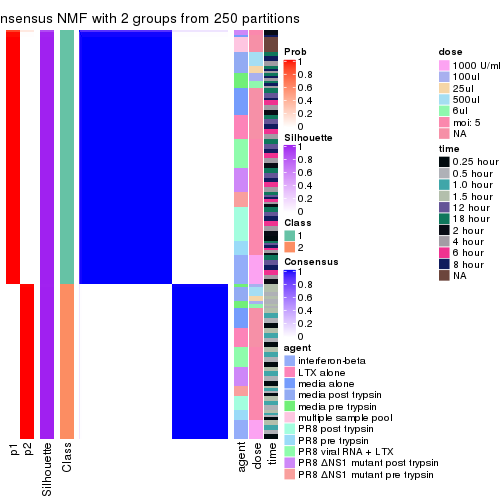
consensus_heatmap(res, k = 3)
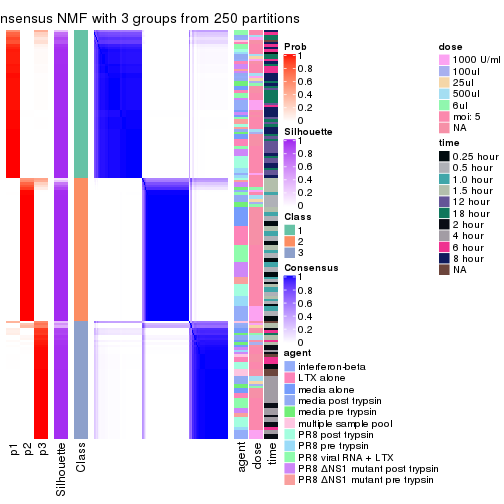
consensus_heatmap(res, k = 4)
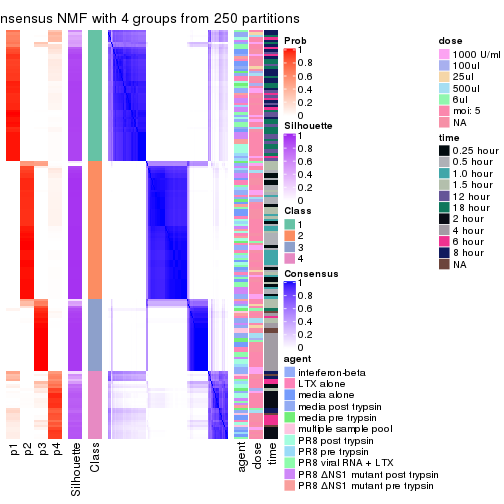
consensus_heatmap(res, k = 5)
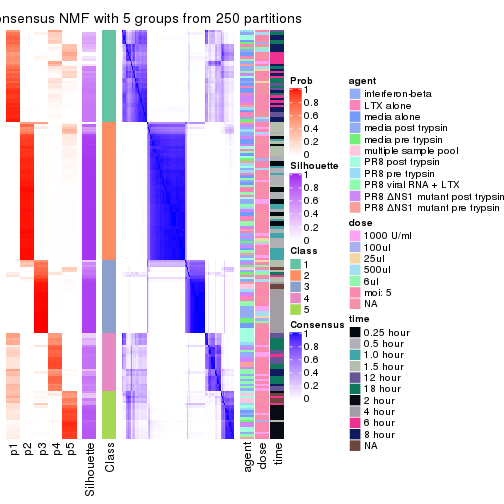
consensus_heatmap(res, k = 6)
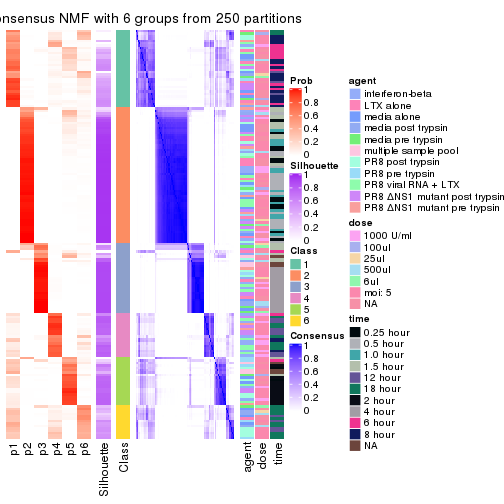
Heatmaps for the membership of samples in all partitions to see how consistent they are:
membership_heatmap(res, k = 2)
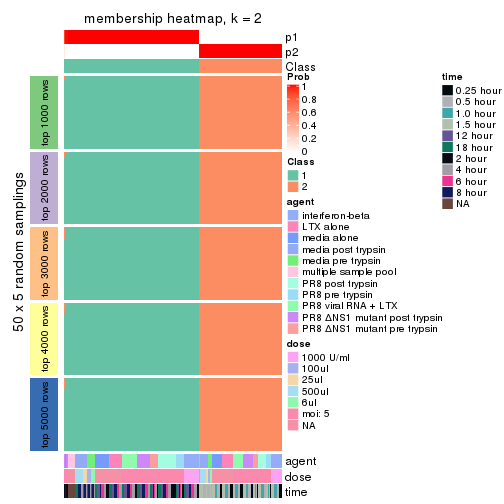
membership_heatmap(res, k = 3)
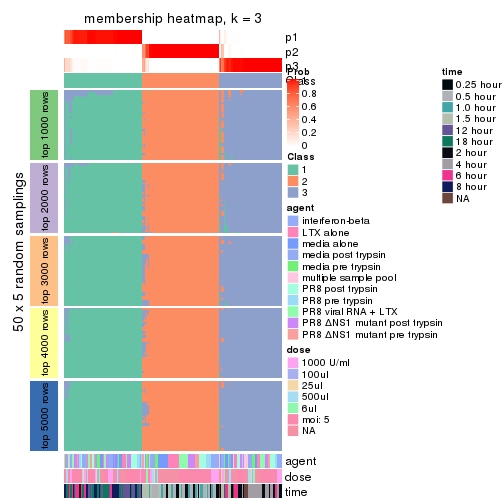
membership_heatmap(res, k = 4)
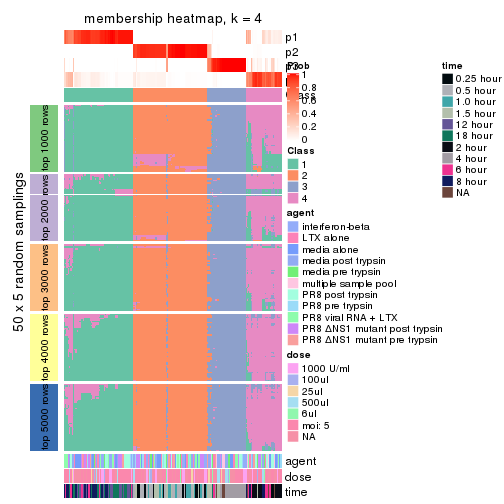
membership_heatmap(res, k = 5)
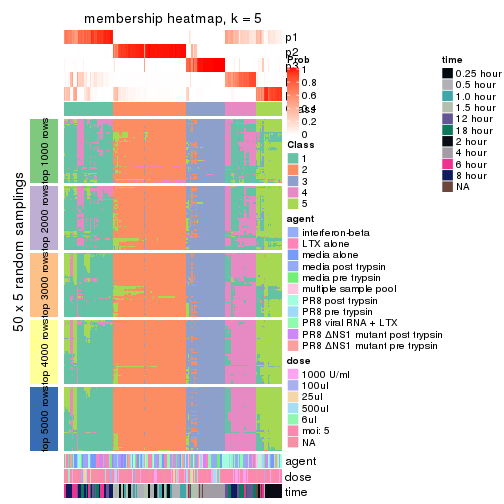
membership_heatmap(res, k = 6)
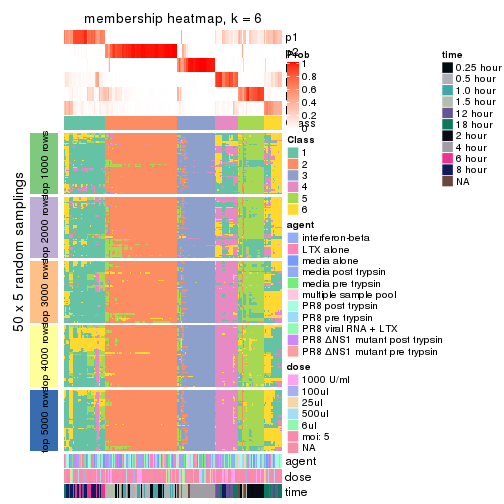
As soon as we have had the classes for columns, we can look for signatures which are significantly different between classes which can be candidate marks for certain classes. Following are the heatmaps for signatures.
Signature heatmaps where rows are scaled:
get_signatures(res, k = 2)
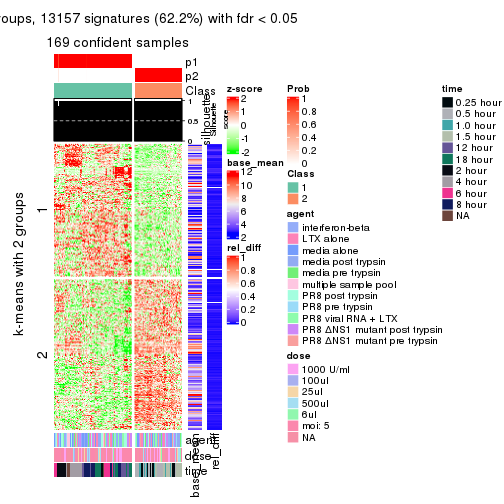
get_signatures(res, k = 3)
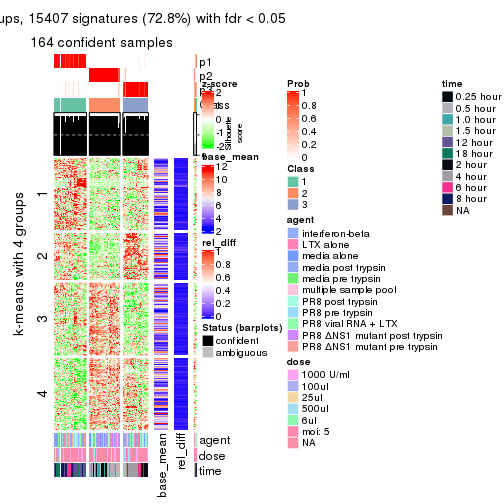
get_signatures(res, k = 4)
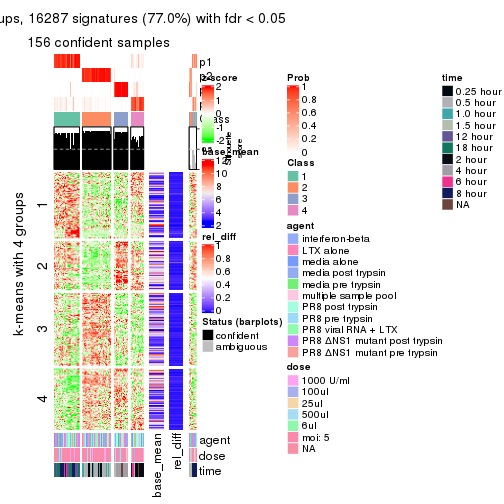
get_signatures(res, k = 5)
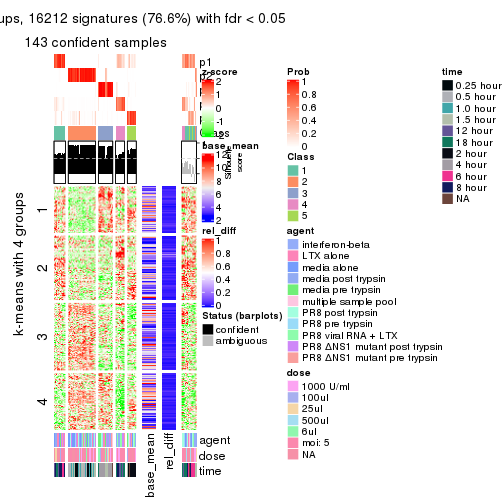
get_signatures(res, k = 6)
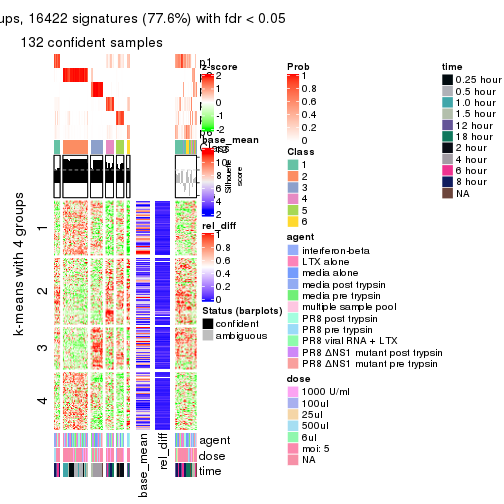
Signature heatmaps where rows are not scaled:
get_signatures(res, k = 2, scale_rows = FALSE)
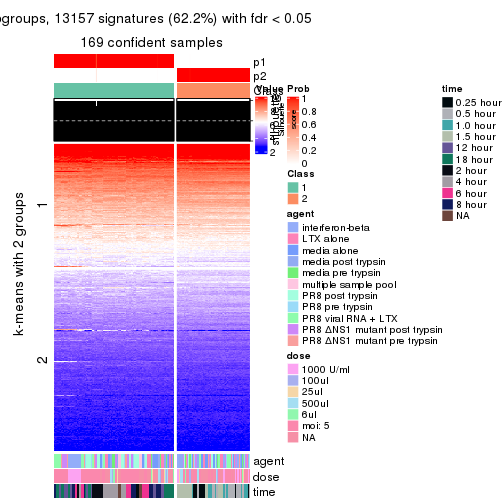
get_signatures(res, k = 3, scale_rows = FALSE)
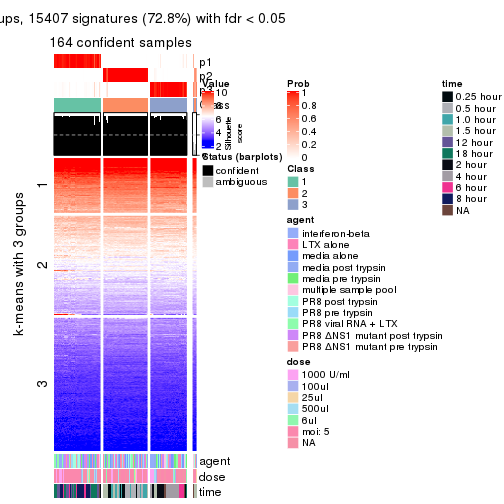
get_signatures(res, k = 4, scale_rows = FALSE)
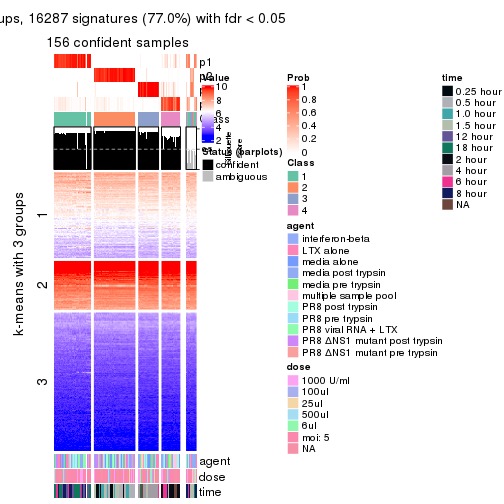
get_signatures(res, k = 5, scale_rows = FALSE)
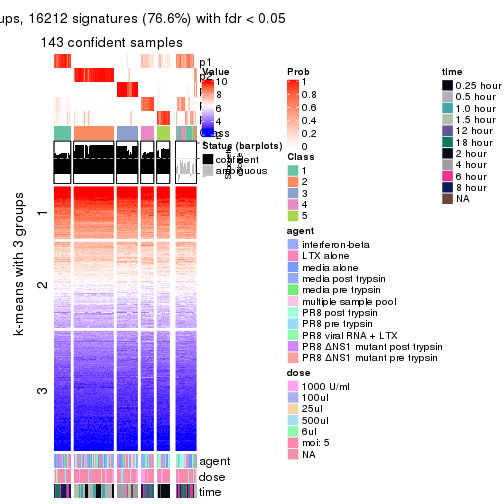
get_signatures(res, k = 6, scale_rows = FALSE)
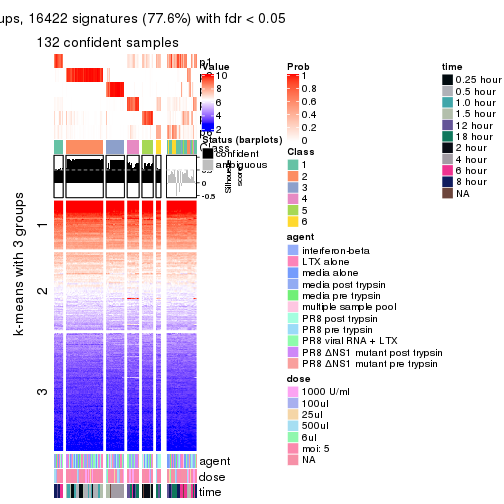
Compare the overlap of signatures from different k:
compare_signatures(res)
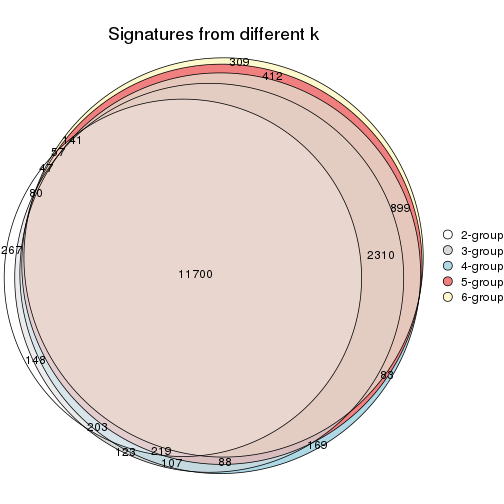
get_signature() returns a data frame invisibly. TO get the list of signatures, the function
call should be assigned to a variable explicitly. In following code, if plot argument is set
to FALSE, no heatmap is plotted while only the differential analysis is performed.
# code only for demonstration
tb = get_signature(res, k = ..., plot = FALSE)
An example of the output of tb is:
#> which_row fdr mean_1 mean_2 scaled_mean_1 scaled_mean_2 km
#> 1 38 0.042760348 8.373488 9.131774 -0.5533452 0.5164555 1
#> 2 40 0.018707592 7.106213 8.469186 -0.6173731 0.5762149 1
#> 3 55 0.019134737 10.221463 11.207825 -0.6159697 0.5749050 1
#> 4 59 0.006059896 5.921854 7.869574 -0.6899429 0.6439467 1
#> 5 60 0.018055526 8.928898 10.211722 -0.6204761 0.5791110 1
#> 6 98 0.009384629 15.714769 14.887706 0.6635654 -0.6193277 2
...
The columns in tb are:
which_row: row indices corresponding to the input matrix.fdr: FDR for the differential test. mean_x: The mean value in group x.scaled_mean_x: The mean value in group x after rows are scaled.km: Row groups if k-means clustering is applied to rows.UMAP plot which shows how samples are separated.
dimension_reduction(res, k = 2, method = "UMAP")
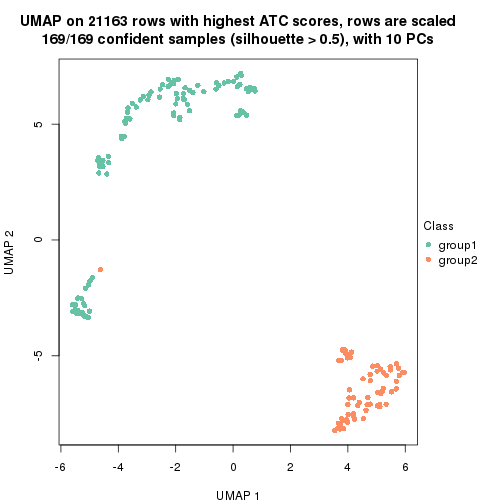
dimension_reduction(res, k = 3, method = "UMAP")
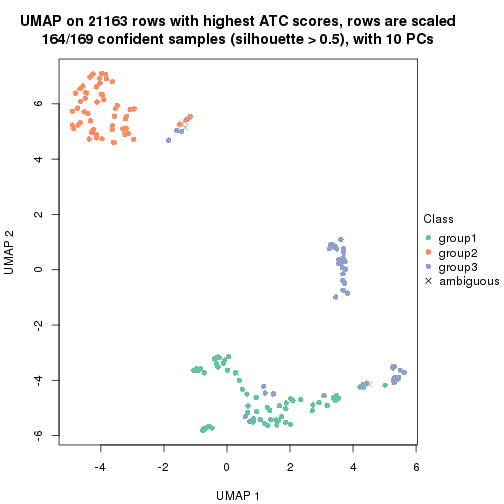
dimension_reduction(res, k = 4, method = "UMAP")
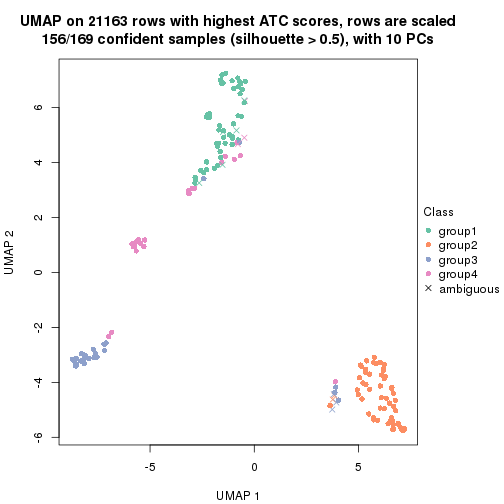
dimension_reduction(res, k = 5, method = "UMAP")
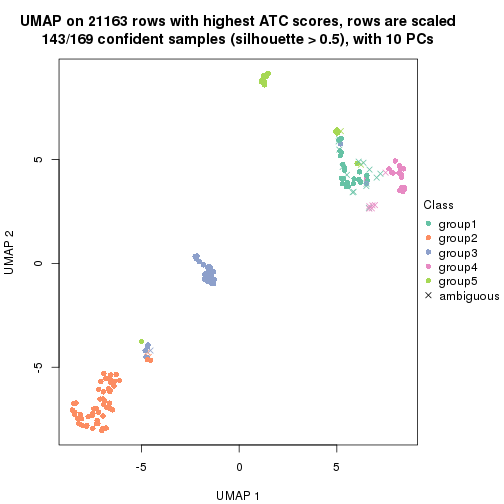
dimension_reduction(res, k = 6, method = "UMAP")
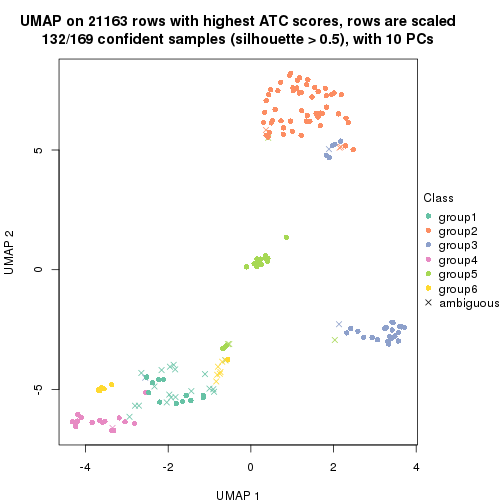
Following heatmap shows how subgroups are split when increasing k:
collect_classes(res)
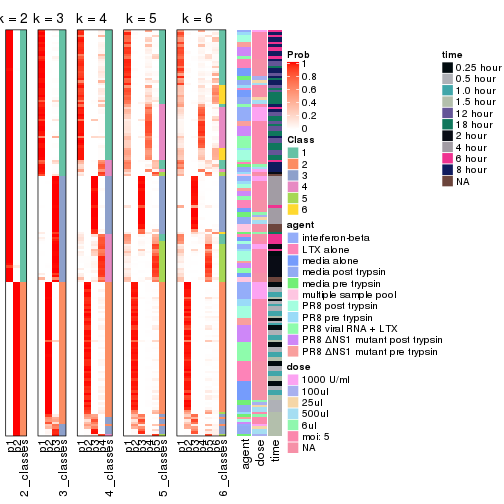
Test correlation between subgroups and known annotations. If the known annotation is numeric, one-way ANOVA test is applied, and if the known annotation is discrete, chi-squared contingency table test is applied.
test_to_known_factors(res)
#> n agent(p) dose(p) time(p) k
#> ATC:NMF 169 0.90691 0.99995 1.43e-29 2
#> ATC:NMF 164 0.88842 0.98032 1.06e-43 3
#> ATC:NMF 156 0.55316 0.76601 4.47e-56 4
#> ATC:NMF 143 0.00653 0.00781 1.54e-52 5
#> ATC:NMF 132 0.01291 0.09192 2.49e-58 6
If matrix rows can be associated to genes, consider to use functional_enrichment(res,
...) to perform function enrichment for the signature genes. See this vignette for more detailed explanations.
sessionInfo()
#> R version 3.6.0 (2019-04-26)
#> Platform: x86_64-pc-linux-gnu (64-bit)
#> Running under: CentOS Linux 7 (Core)
#>
#> Matrix products: default
#> BLAS: /usr/lib64/libblas.so.3.4.2
#> LAPACK: /usr/lib64/liblapack.so.3.4.2
#>
#> locale:
#> [1] LC_CTYPE=en_GB.UTF-8 LC_NUMERIC=C LC_TIME=en_GB.UTF-8
#> [4] LC_COLLATE=en_GB.UTF-8 LC_MONETARY=en_GB.UTF-8 LC_MESSAGES=en_GB.UTF-8
#> [7] LC_PAPER=en_GB.UTF-8 LC_NAME=C LC_ADDRESS=C
#> [10] LC_TELEPHONE=C LC_MEASUREMENT=en_GB.UTF-8 LC_IDENTIFICATION=C
#>
#> attached base packages:
#> [1] grid stats graphics grDevices utils datasets methods base
#>
#> other attached packages:
#> [1] genefilter_1.66.0 ComplexHeatmap_2.3.1 markdown_1.1 knitr_1.26
#> [5] GetoptLong_0.1.7 cola_1.3.2
#>
#> loaded via a namespace (and not attached):
#> [1] circlize_0.4.8 shape_1.4.4 xfun_0.11 slam_0.1-46
#> [5] lattice_0.20-38 splines_3.6.0 colorspace_1.4-1 vctrs_0.2.0
#> [9] stats4_3.6.0 blob_1.2.0 XML_3.98-1.20 survival_2.44-1.1
#> [13] rlang_0.4.2 pillar_1.4.2 DBI_1.0.0 BiocGenerics_0.30.0
#> [17] bit64_0.9-7 RColorBrewer_1.1-2 matrixStats_0.55.0 stringr_1.4.0
#> [21] GlobalOptions_0.1.1 evaluate_0.14 memoise_1.1.0 Biobase_2.44.0
#> [25] IRanges_2.18.3 parallel_3.6.0 AnnotationDbi_1.46.1 highr_0.8
#> [29] Rcpp_1.0.3 xtable_1.8-4 backports_1.1.5 S4Vectors_0.22.1
#> [33] annotate_1.62.0 skmeans_0.2-11 bit_1.1-14 microbenchmark_1.4-7
#> [37] brew_1.0-6 impute_1.58.0 rjson_0.2.20 png_0.1-7
#> [41] digest_0.6.23 stringi_1.4.3 polyclip_1.10-0 clue_0.3-57
#> [45] tools_3.6.0 bitops_1.0-6 magrittr_1.5 eulerr_6.0.0
#> [49] RCurl_1.95-4.12 RSQLite_2.1.4 tibble_2.1.3 cluster_2.1.0
#> [53] crayon_1.3.4 pkgconfig_2.0.3 zeallot_0.1.0 Matrix_1.2-17
#> [57] xml2_1.2.2 httr_1.4.1 R6_2.4.1 mclust_5.4.5
#> [61] compiler_3.6.0